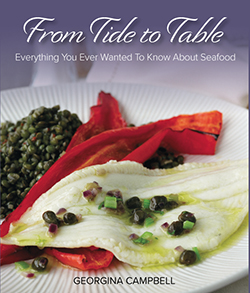Article RECIPES
Romantic Menu for Valentines Day
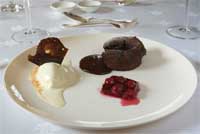
Although it may not feel like it with the seriously wintry weather we always seem to get at this time of year, St Bridget’s Day officially marks the beginning of our Irish spring – and, as Tennyson said, this is ‘when a young man’s fancy lightly turns to thoughts of love’.
And why not – with St Valentine’s Day giving the month a big romantic focus, the lengthening days, bulbs bravely emerging from the soil and birds beginning to twitter in the trees again, there is a feeling of the life cycle gradually gearing up for growth after the coldest winter we’ve experienced for years.
Which is all very cheering - so why not forget about the doom and gloom being predicted on all sides these days, get into the kitchen and rustle up something romantic for dinner…?
These dishes scale up well for a dinner party too.
 Oysters Sashimi-Style
Oysters Sashimi-Style
Renowned for their aphrodisiac qualities, oysters are an understandably popular choice on romantic menus - and this attractive dish is a great way to introduce them to anyone who may initially be a little wary. Featuring in our new seafood cookbook ‘From Tide To Table’ , the recipe comes from Kevin Dundon of Dunbrody Country House Hotel and Cookery School, County Wexford - a great place for a foodie and/or romantic short break, with a little learning built into the programme alongside delicious food and drink – and pampering in their spa too ....
Oysters are excellent at this time of year and they are not too difficult to open; it really is quite simple (see below), and an oyster knife is a good investment if you are planning to serve them regularly.
SERVES 2
6 Pacific/Gigas oysters
1/2 tbsp sesame seeds
about 115g/4oz coarse rock salt
3 tbsp dark soy sauce
finely grated rind and juice of 1 small lime
1/2 tbsp shredded root ginger
1 small spring onion, finely shredded
2 tbsp sesame oil
1 garlic clove, thinly sliced
Scrub the oyster shells then place one, wrapped in a clean tea towel on a firm surface with the flattest shell uppermost and the hinge pointing towards you. Gripping the oyster firmly, insert an oyster knife into the gap in the hinge and twist to snap the shells apart.
Slide the blade of the knife along the inside of the upper shell to sever the muscle that keeps the shells together. Lift the lid off the top shell, being careful not to spill any of the juices. Carefully clean away any bits of broken shell and finally run the knife under the oyster to loosen it from the shell. Repeat until all the oysters are opened, then arrange on a tray and keep in the fridge until you are ready to serve.
Heat a frying pan over a medium to low heat and add the sesame seeds. Cook for 3-4 minutes, stirring regularly until they are lightly toasted. Tip out of the pan onto a plate and set aside until needed.
To serve, arrange three oysters on a bed of rock salt on each serving plate. In a bowl, mix together the soy sauce with the lime rind and juice, then spoon over the oysters. Scatter the ginger, spring onions and reserved toasted sesame seeds on top. Leave to stand for 5 minutes to allow the flavours to develop.
Meanwhile, heat the sesame oil in the frying pan and sauté the garlic until it is golden and the sesame oil is nearly smoking. Drizzle over the oysters and serve immediately.
VARIATION
If using native oysters, it is best to serve them in the classic way: Put crushed ice onto the plates and then, if possible, small mounds of seaweed as it sets the oysters off so well. Arrange the opened oysters on top and have lemon wedges on hand. It is worth noting that about 15 minutes on ice is enough to chill the oyster without overdoing it.
Scallops on Crunchy Croûtes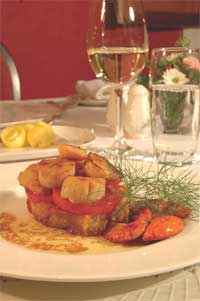
Shellfish and crustaceans, such as scallops and Dublin Bay prawns, may have wider appeal than oysters - they are also in peak season at the moment and really at their luscious best. Although frozen scallops may contain a disappointing amount of water, fresh scallops are succulent and naturally sweet, needing little more than a quick turn in a hot pan to make a delicious treat. When something more is needed, try this simple yet impressive dish, from Irish Country House Cooking – The Blue Book Collection , which makes a colourful starter or main course that is quick and easy to prepare.
SERVES 2 AS A MAIN COURSE, OR 4 AS A STARTER
4 medium vine-ripened tomatoes
2-3 cloves garlic, finely chopped
3 fl oz/75 ml extra virgin olive oil
4 fl oz /100ml best quality balsamic vinegar
salt, freshly ground pepper & a pinch of caster sugar
12 king scallops, shelled
Vienna loaf
Sprig of fennel or parsley to garnish
Slice the tomatoes and put into a bowl with the garlic, olive oil, balsamic vinegar and a light seasoning of salt, pepper and sugar, to marinate.
Trim the scallops, slice in half crossways and drain well on a wooden board.
Cut four 3/4 inch / 2 cm thick slices of bread from the Vienna loaf and remove the crusts. Lightly oil and brown on a griddle or under the grill to make four thick croûtes.
Heat the griddle again until very hot, lightly oil it and grill the scallops for 1-2 minutes, turning once. (Do not overcook or the scallops will lose their luscious texture and become rubbery.)
To serve: Lay the croûtes on two or four warmed plates. Remove the tomatoes from the marinade and lay them on top, then arrange the scallops on top of the tomatoes, with their corals to the side; taste the marinade and adjust the seasoning if necessary, then drizzle the over the top. Garnish with a sprig of fennel or parsley and serve immediately.
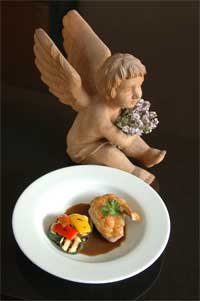 Roast breast of Guinea Hen with Char-grilled Vegetables and Tapenade Sauce
Roast breast of Guinea Hen with Char-grilled Vegetables and Tapenade Sauce
Guinea hen is not very often seen on menus and its slightly gamey flavour makes a more interesting dish than chicken – although chicken breasts could certainly be substituted in this recipe from the lovely Kilgraney House, County Carlow, which also features in Irish Country House Cooking. The tapenade given here is also quite an unusual recipe and well worth making; however, a good quality commercial tapenade could be used in the sauce instead if preferred.
Irish-grown peppers are now available all year, although the courgettes and aubergine would be imported in winter; if the accompaniment seems too summery, a simple vegetable such as buttered spinach would work well instead.
SERVES 4, but could easily be adapted to make a romantic main course for two.
For the guinea hen:
4 guinea fowl breasts, or chicken breasts, part-boned
1 tbsp/ 15 ml sunflower oil
1oz/ 25g unsalted butter
salt and freshly ground pepper
For the char-grilled vegetables
½ a red pepper, ½ an orange pepper and ½ a yellow pepper, de-seeded, cut into four strips
2 courgettes, washed, each topped, tailed and cut into six or eight slices
1 aubergine, washed, topped & tailed and sliced into eight
oil for grilling, as required
For the sauce:
1oz/ 25g/ ¼ stick unsalted butter
2 shallots, finely sliced
10 fl oz /300ml/ 11/3 cups red wine
10 fl oz /300ml/ 11/3 cups chicken stock
2 tbsp/30 ml/ 21/2 US tablespoons tapenade (see below)
For the tapenade:
2oz/50g tin of anchovies, drained
6oz/175g tinned black olives, drained and pitted
2oz /50g/1/3 cup approx capers, rinsed in water
4oz /100g tinned tuna in oil, drained
juice of ½ a lemon
1 sprig of thyme, stems removed
1 bay leaf
4 fl oz /120ml/ ½ cup olive oil
2 cloves garlic, crushed
1 tbsp brandy
First prepare the tapenade:
Place all the listed ingredients in a food processor and blend until smooth, then place in an airtight container. Make in advance and store in the fridge; keeps for up to a week.
To prepare the sauce:
Put the butter into a medium-sized saucepan and melt over moderate heat, then add the shallots and gently cook until golden. Add the wine and simmer to reduce until almost dry, then add the stock and simmer again until reduced by two-thirds. Stir in 2 tablespoons (30ml/21/2 US tablespoons) of the tapenade and bring to the boil. Strain into a clean saucepan and keep warm.
To prepare the vegetables:
Dry the aubergine slices on kitchen paper. Brush the prepared vegetables lightly with oil and place on a hot grill plate or heavy frying pan; cook until seared, then turn and cook until seared on the second side. Keep warm.
To cook the guinea fowl:
Preheat the oven to 230°C/450°F/Gas Mark 8
Season the breasts with salt and pepper.
Heat a large frying pan until hot, add the oil and butter. When the butter starts to foam, add the breasts, skin side up and cook for two minutes. Turn over and cook for a further three or four minutes until the skin is golden brown. Transfer to a warm oven-proof dish and place in the oven for two or three minutes.
Remove from the oven and allow to rest in a warm place for at least ten minutes. Return the breasts and vegetables to the oven for two minutes. Reheat sauce over a gentle heat.
To serve:
Divide the vegetables between four warmed plates. Spoon the sauce around the vegetables and place a guinea fowl breast next to the vegetables.
 Hot Chocolate Fondant
Hot Chocolate Fondant
This seriously more-ish hot chocolate cake dessert comes from John Kostuik, head chef at the lovely Rathsallagh House, Dunlavin, Co Wicklow, a romantic hideaway that is renowned for immaculate sourcing and simply delicious food. With its intense flavour, this should make about 10 portions, and John says they keep well in the freezer for about a week so you can use a couple for a romantic night in and save some for another evening when having friends in for supper.
100 gm / 4 oz best quality dark chocolate, eg Valrhona or Green & Black
85 gm / 31/2 oz butter
20 gm / 1 oz flour
70 gm/3 oz caster sugar
3 free range eggs.
Melt the chocolate and the butter separately, then turn into a mixing bowl and mix together.
Blend in the flour, then the sugar.
Add the eggs, one at a time, and mix gently until incorporated.
Leave the mixture for about 6 hours to allow it to set.
When ready to cook, preheat a warm oven, 170’C/ 325’F/gas mark 3.
Line 10 ring moulds with parchment paper, add enough of the chocolate mixture to fill each one two-thirds full, then bake in the preheated oven for about 9-12 minutes.
Start to check the cakes after 9 minutes - they are done when a firm crust has developed on top, but should be still runny on the inside.
Serve immediately.
Vanilla ice cream and a pretty, sharp-flavoured fruit garnish, such as raspberry or cranberry, make complementary accompaniments.
Irish Food Writers Guild Awards - Nothing But The Best!

 Every February the Irish Food Writers Guild (IFWG) announce their unique Awards of Excellence, which are presented to just three or four carefully selected top food producers at a special awards ceremony in Dublin.
Every February the Irish Food Writers Guild (IFWG) announce their unique Awards of Excellence, which are presented to just three or four carefully selected top food producers at a special awards ceremony in Dublin. Held at L'Ecrivain restaurant, this is a seriously hot ticket, attended by Ireland’s leading ‘foodies’ and media - who come to honour the winners and sample their products in a celebration lunch menu specially devised for the occasion by Michelin Star chef, Derry Clarke.
This year’s accolades were presented to the County Offaly Derryvilla Blueberry Farm for their excellent blueberries and innovative blueberry tonic and preserves; Marine Harvest Ireland for their superb Clare Island Organic Salmon; and the Berridge Family of Carrigbyrne Farmhouse Cheeses, County Wexford, for their excellent hand-crafted St Killian Irish Farmhouse Cheese. And this year the IFWG announced a new Environmental Award – also presented to Carrigbyrne Irish Farmhouse Cheese Company, in recognition of the innovative and wide-ranging exemplary practices in many areas of their business, both farming and cheese-making, which have a positive and enduring effect on the environment.
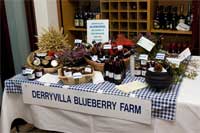 Now in its 15th year, the annual IFWG Awards honour outstanding Irish food producers for their exceptional produce, hard work and dedication to their craft. IFWG Food Awards are regarded within the industry as the most prestigious food awards in Ireland. They are unique in that the winners are chosen by the members of the Irish Food Writers Guild ‘in camera’, following a lengthy, year-long process.
Now in its 15th year, the annual IFWG Awards honour outstanding Irish food producers for their exceptional produce, hard work and dedication to their craft. IFWG Food Awards are regarded within the industry as the most prestigious food awards in Ireland. They are unique in that the winners are chosen by the members of the Irish Food Writers Guild ‘in camera’, following a lengthy, year-long process. There are no set categories, and no one can enter or be entered for an award. Rather every Guild member keeps their taste buds at the ready throughout the year and nominates products they believe are worthy of being honoured. Each of the Guild’s 30+ members is involved in the carefully considered selection process, and the winners do not even know they have been nominated until they are informed after a secret vote.
The products must be produced in Ireland and may be traditional or innovative; the product itself may be new to the market, but the producer must have been trading for at least three years. On occasion members also recognise an individual or an organisation which has contributed something exceptional towards promoting good food in Ireland.
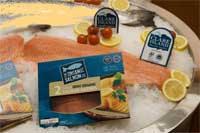 The awards were presented by Trevor Sargent T.D., Minister for Food and Horticulture, who said; “It is imperative that we recognise the hard work, expertise and dedication of Ireland’s indigenous food producers. These awards are a fitting celebration of some of our finest food producers and organisations and I commend all winners for the outstanding quality of their produce. We have an outstanding provenance in fine food in Ireland and it is my priority to ensure more and more of this food is available organically. It must be a near impossible task to select just a handful of winners each year. However, it is clear that these awards, chosen by such a distinguished panel, continually help to raise standards among food producers in Ireland,” stated the Minister.
The awards were presented by Trevor Sargent T.D., Minister for Food and Horticulture, who said; “It is imperative that we recognise the hard work, expertise and dedication of Ireland’s indigenous food producers. These awards are a fitting celebration of some of our finest food producers and organisations and I commend all winners for the outstanding quality of their produce. We have an outstanding provenance in fine food in Ireland and it is my priority to ensure more and more of this food is available organically. It must be a near impossible task to select just a handful of winners each year. However, it is clear that these awards, chosen by such a distinguished panel, continually help to raise standards among food producers in Ireland,” stated the Minister.WHY NOT TRY THE VERY BEST OF IRISH PRODUCE IN LEADING CHEF DERRY CLARKE’S SPECIALLY DEVISED RECIPES?
The recipes given here were all created by Derry Clarke, of acclaimed Dublin restaurant L'Ecrivain, for the Irish Food Writers Guild Food Awards 2009 – each year Derry is presented with a ‘mystery basket’ of award-winning ingredients, and he never fails to come up with imaginative and delicious dishes for the occasion.
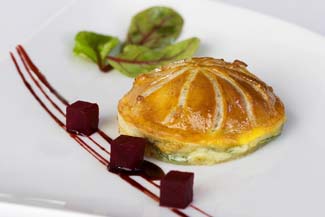
1. AWARD WINNER: CARRIGBYRNE ST KILLIAN
Made in County Wexford by the Berridge family since 1982, the camembert style Carrigbyrne St Killian is one of Ireland’s longest-established and best-loved farmhouse cheeses, and is easily recognised by its trademark hexagonal box- which is secure and light, making it an ideal gift purchase at airport shops.
Appreciated by cheese lovers for its consistent high quality, Carrigbyrne is one of the most widely available Irish farmhouse cheeses; always on sale in specialist shops and leading supermarkets in Ireland and the UK (Tesco, Dunnes, Superquinn, Supervalu, M&S, Waitrose) and also Metro in Germany - one of their strongest areas of growth.
RECIPE: Carrigbyrne St. Killian Farmhouse Cheese Pithivier
These tasty morsels are very versatile, making unusual bites to serve with drinks, or as a starter – and would also make a delicious savoury to finish off a good meal.
Click here for recipe
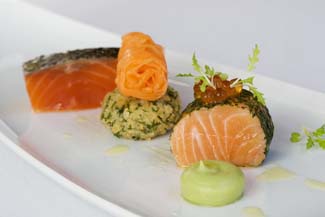
2. AWARD WINNER: CLARE ISLAND ORGANIC SALMON
Ireland’s Atlantic waters have the highest organic rating possible (AI) and Clare Island is six miles off the Mayo coast, in Clew Bay, where stormy conditions can last for days in winter, with waves over ten metres. The water quality and the strength of the tidal exchange are crucial to the excellence of Clare Island organic salmon, from the most exposed salmon farm in the world.
Renowned for its superb flavour, lean flesh and firm muscle texture, you’ll often see Clare Island salmon named on menus in leading restaurants, and it is used by the top fish smokers like Kinvara, Belvelly Smokehouse and Ummera, all previous IFWG Award winners.
It is currently available from Irish speciality shops (eg Cavistons of Dun Laoghaire, Beshoff’s in Howth, both County Dublin, and Clarke’s in Ballina, County Mayo) and the company is developing a range of pre-packed products.
*Further information and recipes for Clare Island Organic Salmon can also be found in our recently published cookbook, From Tide To Table (Epicure Press, €25), sponsored by Bord Iascaigh Mhara, the Irish Sea Fisheries Board.
RECIPE: Trio of Clare Island Organic Salmon With Avocado Cream & Caviar.
Click here for recipe
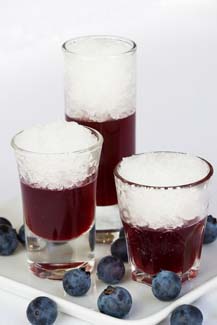 3. AWARD WINNER: DERRYVILLA BLUEBERRIES
3. AWARD WINNER: DERRYVILLA BLUEBERRIESThe American blueberries grown at Derryvilla Blueberry Farm are closely related to the native Irish fraughan or bilberry, a fruit associated with celebration, feasting and fertility. The cultivated berry is a juicy, versatile fruit, prized as a vitamin-rich food – and, in Ireland, it is grown on cutaway bog in County Offaly.
The history of Derryvilla Blueberry Farm involves a number of dedicated farming pioneers including, for the last five years, Nuala O’Donoghue who has been involved, in particular, with development of the innovative Blueberry Tonic and delicious blueberry preserves – both of which are out-sourced to other well-known artisan food producers. [Derrvilla Blueberries and products are available from selected retailers, including Nolans in Clontarf, Dublin 3, and Foxes in Mullingar?
RECIPE: Derryvilla Farm Blueberry Tonic Granita with Blueberry Jelly
Con Trass of The Apple Farm in Clonmel, County Tipperary, makes the blueberry tonic for Derryvilla Farm.
RECIPE: Baked Derryvilla Farm Blueberry Cheesecake
Irish-grown Derryvilla Farm blueberries can be used fresh in this classic dessert when they are in season (August-September). They can also be frozen, for use in made up dishes and as a sauce (coulis).
Click here for Blueberry Recipes
Easy Does It - Lovely Lamb Dishes for Spring
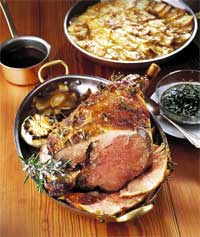
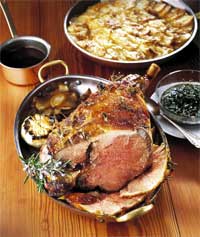 Georgina Campbell shares some seriously tasty Irish lamb recipes…
Georgina Campbell shares some seriously tasty Irish lamb recipes…Lamb is synonymous with spring, and has become one of the most popular Easter treats in recent years. New season Irish spring lamb is tiny and delicately flavoured - and commands a premium price; certainly a treat by any standards. But what you’re more likely to be cooking at this time of year, especially for a gathering of any size, will actually be hogget, which is a one year old lamb with plenty of meat on it and good-sized roasting joints.
These three very different recipes demonstrate the versatility of lamb well – and all would be best suited to the more mature lamb (hogget), which has plenty of flavour and lots of good eating on it.
Roast Leg of Lamb with Honey Orange Glaze and Port and Mint Dressing
This delicious Sunday roast takes very little effort and would also be ideal for a family gathering over Easter. Shoulder of lamb, which is especially tender and sweet-flavoured and makes a lovely roast, could be used instead for a smaller group of about 6 people.
Click for recipe
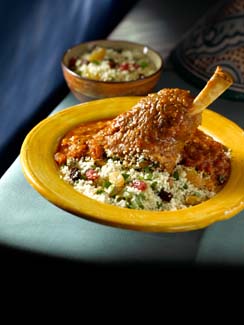 Moroccan Style Braised Lamb Shanks
Moroccan Style Braised Lamb ShanksThis aromatic version of a very popular dish is ideal for a busy day as it can be left to get on with its long slow cooking while you do other things – a making an easy and seriously delicious meal to come back tolater. The lamb can be covered in clingfilm and marinated in the fridge for up to 24 hours beforehand if you wish, to allow the spices to penetrate the meat and making a more strongly flavoured and fragrant dish. The accompanying couscous can be jazzed up with pistachio nuts and dried fruits, such as sultanas and raisins and a little chopped fresh flat-leaf parsley.
Click for recipe
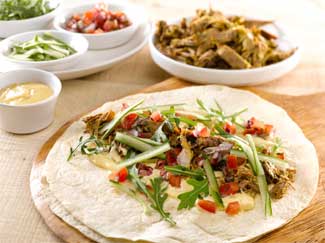 Slow Cooked Spiced Shoulder of Lamb Wraps with Roasted Garlic Aioli and Tomato Salsa
Slow Cooked Spiced Shoulder of Lamb Wraps with Roasted Garlic Aioli and Tomato SalsaThe longer you cook this shoulder of lamb the better so don’t worry if it gets an extra hour or so. If you use a boned shoulder you could reduce the cooking time by approximately an hour. The meat should be so tender that it is easily shredded with a fork. If you have some lamb and aioli left over, they will keep in the fridge for a couple of days.
Click for recipe
FOR ALL RECIPES CLICK HERE
Cookery Feature - Grow & Cook!
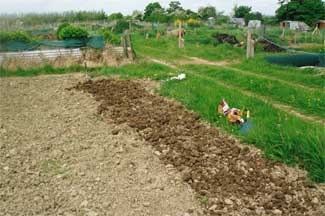
 A really encouraging thing is happening all over Ireland at the moment: growing-your-own is back in style. And, although there’s a touch of ‘Digging for Victory’ about the unlikely places that are being turned into productive gardens, it isn’t just about beating the recession or keeping costs down, but more to do with a return to reality and care about quality food and where it comes from – and, of course, the challenge of beating the slugs and snails, and everything the Irish weather can throw at us.
A really encouraging thing is happening all over Ireland at the moment: growing-your-own is back in style. And, although there’s a touch of ‘Digging for Victory’ about the unlikely places that are being turned into productive gardens, it isn’t just about beating the recession or keeping costs down, but more to do with a return to reality and care about quality food and where it comes from – and, of course, the challenge of beating the slugs and snails, and everything the Irish weather can throw at us. If you don’t believe it, the surging demand for allotments is testimony to the nation’s new taste for growing our own food (my son Bob is into his second year as an allotment holder, and will be telling us all about it – when he can find the time!) Waiting lists for allotments are long, alas, but you don’t need to have a big space (or a garden at all) to have the satisfaction of growing food for your own table.
We don’t have a big garden, but it’s amazing how much you can get just by setting aside a bit of space in an average suburban back garden – we have a Bramley apple tree, Conference pears grown against a wall and a couple of (sort of) espalier-trained eating apples; and as well as rhubarb, herbs and saladings, we always have runner beans (fantastic returns from a small space as long as they’re well fed and watered and have plenty of light; you can even get a kit for growing them on a balcony - and they’re pretty too), early broad beans, mangetout and French beans, plus tomatoes (easier than you think – and you can get outdoor trailing varieties to grow in hanging baskets), strawberries, courgettes and whatever else is the fancy of the season (Alpine strawberries, perhaps).
 Home grown potatoes are irresistible, but take up a lot of space in the ground – I grew a surprisingly big crop of earlies successfully in a half barrel last year and, having been given a commercial ‘potato barrel’ by Bob & his wife Laura for Christmas, am now trying a system that allows you to begin with just five seed potatoes – the aptly named ‘Epicure’ in our case - and earth them up in a vertical column; then (if it does what it says on the flatpack) it will be crammed full of new potatoes by mid summer.
Home grown potatoes are irresistible, but take up a lot of space in the ground – I grew a surprisingly big crop of earlies successfully in a half barrel last year and, having been given a commercial ‘potato barrel’ by Bob & his wife Laura for Christmas, am now trying a system that allows you to begin with just five seed potatoes – the aptly named ‘Epicure’ in our case - and earth them up in a vertical column; then (if it does what it says on the flatpack) it will be crammed full of new potatoes by mid summer. A big weakness for me is Jerusalem artichokes, which are members of the sunflower family and easily grow to 12 feet – not the best choice for a small garden, but we always find somewhere for them and what a treat they are through the winter.
Brassicas are generally too big and awkward for a small space, but I do love purple sprouting broccoli and, as it’s surprisingly difficult to find in the shops, it’s worth the effort – and not as mad as it sounds, as you don’t need to move the young plants into their final position until other crops have finished in the autumn, when space isn’t such an issue. But be warned – this hobby is addictive; once hooked you’ll never want a purely ornamental garden again!
The joy of it all really is that you can try things that aren’t easy to get in the shops – OK, not everyone has the space for asparagus bed, but imagine having a supply of proper seasonal asparagus instead of those universal spears that come from South America. Visiting the oldest son, Brian, in Geneva a while back, a vivid memory is of restaurants in the city offering ‘asparagus menus’ in spring – once tasted, never forgotten.
And then, most importantly - I’ve never been able to understand why small organic growers don’t make more of this – you can grow named varieties, and find the ones that are most reliable for your soil and aspect. And, of course, with the most flavour…
Seeking out the best gardening/seasonal cookery books can be addictive too – the classics will always earn their shelf space, and there are useful new books coming along all the time, including Allan Shepherd’s practical and encouraging The Organic Garden, Green and Easy (HarperCollins, stg£12.99) which is ideal for anyone who wants to garden (and shop at garden centres) ethically; the same principles apply to Grow and Cook (Gill& Macmillan, €24.99) by well known Irish husband-and-wife team Tom and Joahann Doorley, who are lucky enough to have an old walled garden in East Cork… And viewers who have been watching ethno-botanist James Wong’s ‘Grow Your Own Drugs’ (HarperCollins, £16.99), will know that, despite the dodgy title, this is an informative gardening/foraging/cooking guide to making the most of common garden and hedgerow plants to help with minor everyday ailments and beauty treatments.
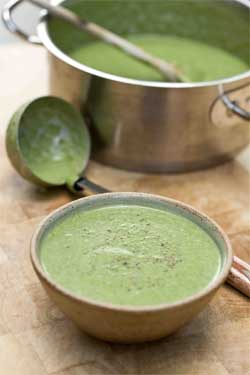 Nettle Soup & Nettle Pesto
Nettle Soup & Nettle PestoThis pretty spring soup from Grow Your Own Drugs is described as a ‘Restorative’, and it was traditional in Ireland for ‘cleansing the blood’ after the dark months of winter. Nettles (urtica dioica) are at their best in spring when the fresh young growth is tender, tasty and packed with nourishing vitamins, minerals and chlorophyll, helping to build up natural immunity and protect from infections after the winter You don’t have to grow nettles, of course, they do it very well all by themselves – and can safely be picked from clean hedgerows away from busy roads, and where they will not have been sprayed. While Nettle Pesto is another simple, tasty way to get the benefits of urtica dioica.
Click Here for Recipes
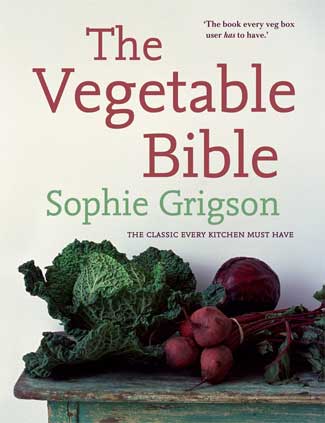 Broad Bean, Dill and Saffron Pilaff
Broad Bean, Dill and Saffron PilaffSophie Grigson has been championing vegetables throughout her food writing career (one of her early successes was Eat Your Greens). In this dish from The Vegetable Bible (HarperCollins, stg£15), shades of fresh spring green, yellow and white ‘look like Easter’. To get it at its best Pascal prettiness you do have to take a little time over preparing the broad beans, but Sophie assures us that they'll taste all the better for it. Early broad beans are ready in May-June, but you can make this at any time with frozen beans - like peas, they freeze exceptionally well. Serve as a light main dish, or as a side dish (in which case you don't really need the yoghurt).
Click here for recipe
 Poached Rhubarb with Stem Ginger Ice Cream
Poached Rhubarb with Stem Ginger Ice CreamFans of BBC’s Gardeners’ World will be familiar with Sarah Raven’s magnificent garden, and this remarkable gardener (who always seems to be immaculately dressed – in a skirt!) was also a guest tutor at Ballymaloe Cookery School earlier this year. The stunning seasonal Sarah Raven’s Garden Cookbook (Bloomsbury, £30) makes an ideal companion for her earlier book The Great Vegetable Plot, and will surely inspire the most jaded cook to grow and cook, or at least to shop in season. Tender early stems of rhubarb are perfect for this recipe, although it can be made all season; rhubarb is one of the easiest crops to grow and it’s well worth finding a corner where you can leave a clump to get on with it, with very little attention needed from you. Just a little treacly muscovado sugar is enough to retain the slight sourness to contrast with the sweet ice cream.
Click for recipe
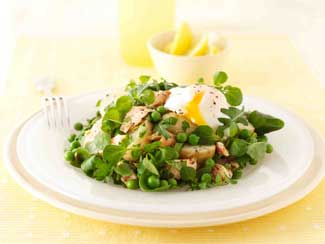 Warm Salad of New Potato, Pea and Trout with Poached Egg
Warm Salad of New Potato, Pea and Trout with Poached EggA lovely spring-into-summer warm salad to look forward to when you harvest your first crop of little new potatoes (very different from those all-year ‘baby’potatoes masquerading as ‘new’), and perhaps your own fresh peas (or mangetout), which are easily grown in small spaces if you choose dwarf varieties; out of season, frozen peas can be used instead as they freeze very well. American land cress is easily grown and can be used instead of watercress, if wished; likewise spinach beet (perpetual spinach) is easier to grow than true spinach.
Click for recipe
Cookery Feature - A Taste of Dublin
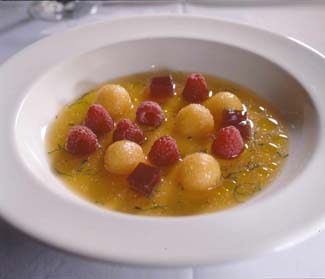
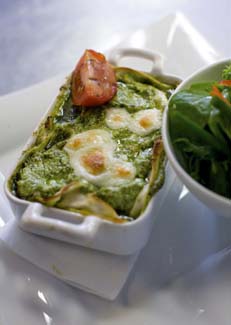 This month’s major culinary highlight is unquestionably the Taste of Dublin festival (11-14 June 09), held again this year at the lovely Iveagh Gardens on the south side of St Stephen’s Green; there is no lovelier place to be in fine weather – and how it has grown.
This month’s major culinary highlight is unquestionably the Taste of Dublin festival (11-14 June 09), held again this year at the lovely Iveagh Gardens on the south side of St Stephen’s Green; there is no lovelier place to be in fine weather – and how it has grown. What began modestly as a huddle of stalls at Dublin Castle a few years ago has developed into Dublin’s (perhaps Ireland’s) premier food and drink festival, with masses to interest and entertain anyone with so much as a passing interest in good food, wine and hospitality.
The original concept – tastings from leading restaurants for ticket holders – is still at the heart of it, and Dublin’s best is well-represented by a cross-section of establishments including the modern classics (Chapter One, L'Ecrivain, Bang Café), great bistro and gastropub style food (Roly’s Bistro, Ely), ethnics (China Sichuan, Jaipur), other speciality restaurants such as the King Sitric (seafood), and many others.
But, delicious as the tastings are sure to be (especially when washed down with a cooling glass from one of the many wine companies represented…), there’s much more to the event than that, with a huge amount going on all the time, including chef demos from a host of famous names such as Darina and Rachel Allen, Neven Maguire, Dylan McGrath, Oliver Dunne, Kevin Thornton and Antony Worrall Thompson, over a hundred artisan producers showcasing their products – and, of course, our own new dining and lifestyle club, The G Club by Georgina Campbell Guides.
Definitely the place to be over the second weekend of June.
As a taster, why not try some recipes from some of the chefs and restaurants taking part? Emphatically not the ‘restaurant’ dishes they are likely to be offering at the event, these are straightforward seasonal recipes for cooking at home which have been given to me at various times over the years or appear in their books.
 Melon & Raspberries with Cinnamon Jelly and Fresh Basil
Melon & Raspberries with Cinnamon Jelly and Fresh BasilThis pretty dish is one of those wonderfully versatile recipes that can be served as a starter or makes a refreshing way to round off a meal. It was given to me by Ross Lewis of Chapter One Restaurant and, while the port & cinnamon jelly would be extravagant for home use unless it’s a special occasion, the same principle could be applied using a less expensive wine - or fruit juice could be used instead, or you could simply omit the jelly. Wrap any unused jelly in clingfilm and store in the fridge for up 2 weeks.
Click here for recipe
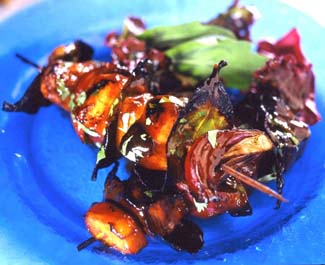 Brochettes of Chicken, Mango & Red Onion
Brochettes of Chicken, Mango & Red OnionAlso originating from Ross Lewis of Chapter One Restaurant, this is another straightforward recipe for the home cook. Ideal for summer, it can be char-grilled in the kitchen or cooked on the barbecue. The barbecue sauce keeps well and this recipe makes a good quantity – use as much as you need for the brochettes and store the remainder in a screw-top jar in the fridge, to use as required.
Click here for recipe
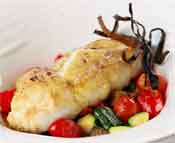 Baked Cod on Ratatouille with Curry Butter
Baked Cod on Ratatouille with Curry Butter Aidan MacManus of the King Sitric Fish Restaurant in Howth, County Dublin is one of the most experienced fish chefs in the country, and this dish – which is taken from the book From Tide To Table, published recently with the support of BIM - is typical of the food served at his striking harbourside establishment, and will be a lovely dish to enjoy through the summer as the ratatouille ingredients come into season. The amount of curry powder in the butter can be adjusted if the flavour proves too strong for family tastes.
Click here for recipe
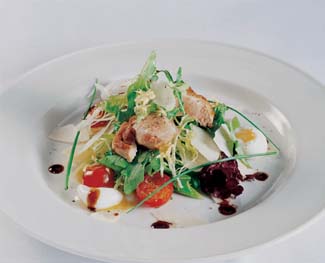 Summer Salad with Baby Leeks
Summer Salad with Baby LeeksThis pretty salad is adapted from a recipe in ‘Roly’s Bistro – The Restaurant And Its Food’ (Gill & Macmillan) and, if you grow your own vegetables, this is just the dish for some of your early salads and the thinnings from your leek crop, which can be used instead of buying expensive baby leeks.
At the restaurant, quail and quail eggs would be used, but home cooks can adapt it to use more everyday ingredients – chicken breast and chicken eggs will be just fine.
Click for recipe
Summer Seafood
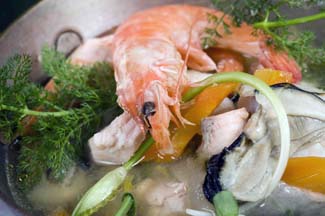
 Whether you’re in a smart seafood restaurant such as The King Sitric of Howth or O'Connors of Bantry, relaxing in a pub like Mary Ann's in Castletownshend – or in your own back garden, this is the perfect time of year to make the most of seafood from Irish coastal waters. Quickly cooked and easily served with accompaniments that can be prepared ahead, seafood is ideal for barbecues and summer salads and entertaining.
Whether you’re in a smart seafood restaurant such as The King Sitric of Howth or O'Connors of Bantry, relaxing in a pub like Mary Ann's in Castletownshend – or in your own back garden, this is the perfect time of year to make the most of seafood from Irish coastal waters. Quickly cooked and easily served with accompaniments that can be prepared ahead, seafood is ideal for barbecues and summer salads and entertaining.
But preparing seafood can seem daunting and, until recently, were no comprehensive cookbooks on specifically Irish fish and seafood. But cookbooks are like buses – for ages there’s nothing at all available on a particular topic, then all of a sudden two or three come along at once.
Following hot on the heels of our own recent ‘seafood bible’ From Tide To Table, for example, comes The Seafood Lover’s Cookbook (Estragon €15) by Martin Shanahan of the renowned Fishy Fishy restaurants and fish shop in Kinsale and author/publisher Sally McKenna, and also Clodagh McKenna’s Fresh From The Sea (Gill & Macmillan paperback, €19.99) to partner her new RTE TV series, which was produced and directed by David Hare with support from BIM. (As Daniel O’Connell once did, David travels to work from his beautiful home on the Ring of Kerry – check out the wonderfully remote Iskeroon at Caherdaniel on our website if you’d like to stay there.)
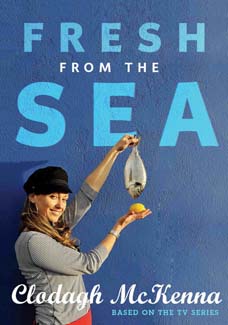 Fresh From The Sea is a lively, colourful and accessible book that will tempt many a reluctant fish cook into the kitchen – and, generously sprinkled with photographs of Clodagh as well as delicious Irish seafood, it is sure to be a hit with fans of her first book and TV series, Fresh From The Farmers Market. You’ll find shopping advice, ‘how to’ diagrams and lots of recipes using species fished in Irish waters to encourage home cooks to see fish and seafood as a quick and appealing option – also guidance on where and what to buy, plus profiles of key people and their businesses which adds depth to the seafood experience by giving an insight into Irish fishing/producing, processing and retailing.
Fresh From The Sea is a lively, colourful and accessible book that will tempt many a reluctant fish cook into the kitchen – and, generously sprinkled with photographs of Clodagh as well as delicious Irish seafood, it is sure to be a hit with fans of her first book and TV series, Fresh From The Farmers Market. You’ll find shopping advice, ‘how to’ diagrams and lots of recipes using species fished in Irish waters to encourage home cooks to see fish and seafood as a quick and appealing option – also guidance on where and what to buy, plus profiles of key people and their businesses which adds depth to the seafood experience by giving an insight into Irish fishing/producing, processing and retailing.
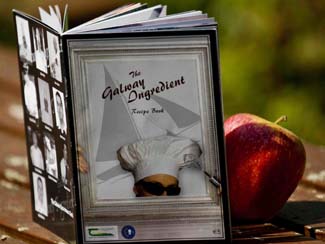 On a slightly different tack, over in the west, a small group of Euro-Toques chefs (members of the non-elitist international chefs’ organisation dedicated to safeguarding culinary heritage) got together to celebrate the food of the area - and the recent Volvo Ocean Race stopover - in a DIY recipe book, The Galway Ingredient (click for more).
On a slightly different tack, over in the west, a small group of Euro-Toques chefs (members of the non-elitist international chefs’ organisation dedicated to safeguarding culinary heritage) got together to celebrate the food of the area - and the recent Volvo Ocean Race stopover - in a DIY recipe book, The Galway Ingredient (click for more).
Teagasc gave some welcome support, but it was produced on a tight budget and the standard is a credit to those involved, notably Michael O’Meara (Oscars Bistro) who is as handy with a camera as a set of knives (www.foodandwinephotography.com), and editor Gerry Galvin.
 Gerry Galvin's Seafood Coddle (from The Galway Ingredient)
Gerry Galvin's Seafood Coddle (from The Galway Ingredient)
Gerry Galvin – original chef-patron of The Vintage in 1970’s Kinsale and later of the renowned Drimcong House Restaurant at Moycullen, Co Galway, food writer and Euro-Toques consultant chef – edited The Galway Ingredient recipe book and contributed several of his own famously straightforward recipes. “This dish is simplicity itself,” he says, “I have always liked broth/stock based, light fish soups and this one started in Drimcong many moons ago. I call it Coddle because of its comforting quality and it qualifies for the Coddle title because of its closeness to the traditional Dublin Coddle, albeit with fish/seafood rather than sausage and bacon. It is also so versatile - any fish will do.” Savoury rice is a good accompaniment.
Click for Recipe
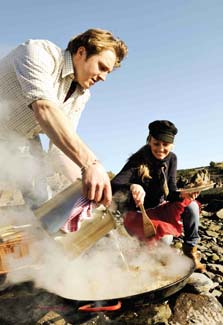 Seafood Paella by Clodagh McKenna
Seafood Paella by Clodagh McKenna
“A beautiful-looking, robust dish, paella is served all over Spain in many different forms, but its place of origin is Valencia,” says Clodagh McKenna in Fresh From The Sea. “The main ingredient is rice, typically short-grained calasparra rice grown in the mountains of the Spanish province of Murcia. A traditional paella pan is anything from seven inches to a yard across, with low sides about an inch and a half high that flare out slightly at the top and two large handles at the side.
The pans don’t come with a lid because paella is not cooked with a lid on. Usually made of carbon steel, they do require seasoning before cooking and will rust if they are left wet, so do wipe them with a coating of olive oil after cooking. The authentic way to cook paella is over an open barbecue with kindling wood, but it tastes just as good cooked well in a domestic kitchen."
Click for recipe

Clodagh McKenna’s Perfect Family Fish Pie
“I hope you will use this recipe a lot” says Clodagh, “As it doesn’t need many ingredients, is simple and fast to make and all the family will love it.”
Click for recipe

Hake Seared in a Sun-dried Tomato Tapenade
Clodagh uses hake for this recipe, but you can use any firm white round fish fillet.
Click for recipe
Lobster Fest - Big Treats, Great Value

 Ask around to see what’s regarded as the ultimate treat when dining out, and the chances are most people will say lobster – and the good news is that it’s so plentiful this summer that prices have come way, way down. So not only can you enjoy lobster more often in your favourite seafood restaurants, but it’s a real option for cooking at home or in your holiday kitchen too - and easily available from good fishmongers.
Ask around to see what’s regarded as the ultimate treat when dining out, and the chances are most people will say lobster – and the good news is that it’s so plentiful this summer that prices have come way, way down. So not only can you enjoy lobster more often in your favourite seafood restaurants, but it’s a real option for cooking at home or in your holiday kitchen too - and easily available from good fishmongers. Beshoff’s (01 8390766), on the West Pier in Howth for example, are offering it at a very reasonable price - about €19.95 per kilo at the time of writing (early August 09) and still going down).
The average size of lobster served in restaurants is around 1-11/4lb/500g, so your kilo of live lobster should be enough for two main course servings, or four starters – fantastic value!
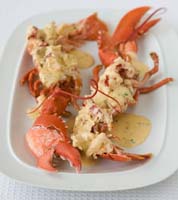 Lobster is the treat of the moment, so make the most of it – irresistible offers are on menus all round the coast, and even smart city restaurants like Richard Corrigan’s Bentleys are in on the act (€22 for a native half lobster). Beshoff’s also have a lobster sale in their restaurant, Ivans , with a good-sized lobster offered half a dozen ways at just €29.95 for the month of August – and, across Howth Harbour at the King Sitric , the lobster season sale is in full swing, with grilled/steamed lobster at €24 per lb/450g - and lobster dishes can even be included in their special 2-course €28 dinner menu at only €5/10 supplement (traditional lobster cocktail starter, for example, and classic main courses like Dublin Lawyer, Thermidor or lemon butter sauce).
Lobster is the treat of the moment, so make the most of it – irresistible offers are on menus all round the coast, and even smart city restaurants like Richard Corrigan’s Bentleys are in on the act (€22 for a native half lobster). Beshoff’s also have a lobster sale in their restaurant, Ivans , with a good-sized lobster offered half a dozen ways at just €29.95 for the month of August – and, across Howth Harbour at the King Sitric , the lobster season sale is in full swing, with grilled/steamed lobster at €24 per lb/450g - and lobster dishes can even be included in their special 2-course €28 dinner menu at only €5/10 supplement (traditional lobster cocktail starter, for example, and classic main courses like Dublin Lawyer, Thermidor or lemon butter sauce). Unless you buy it freshly cooked, lobster – like any other crustaceans or shellfish - must be bought live. They are then killed humanely in boiling water, or using a sharp knife; the two methods are described in the recipes below.
To Prepare the Cooked Lobster
1. Remove claws
2. Cut away underside shell
3. Remove flesh
4. Remove stomach and discard
5. Crack claws
6. Remove meat from claws
The prepared lobster meat is then ready to use in any made up dish and, for anyone avoiding sauces, can also be served very simply with salad, seasoning and a squeeze of lemon juice.
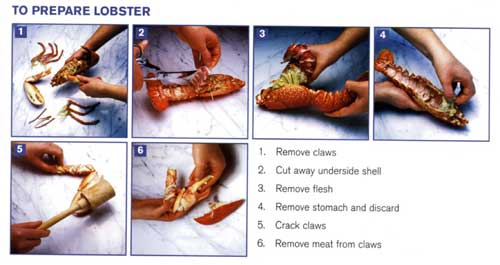
Lobster Dublin Lawyer & Variations
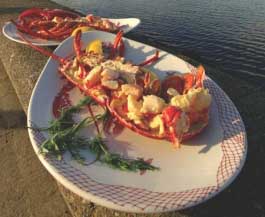 Lobsters don’t get fresher than the ones served by Aidan MacManus at The King Sitric in Howth, which are caught in Balscadden Bay just outside the restaurant.
Lobsters don’t get fresher than the ones served by Aidan MacManus at The King Sitric in Howth, which are caught in Balscadden Bay just outside the restaurant. Aidan’s cooking method is given here, together with some of the variations offered along with one of the most popular dishes, Dublin Lawyer – as it’s rich and full of whiskey, it doesn’t take too much imagination to guess how it got its name!
Click here for recipe
Lobster Salad with Lemon and Dill Mayonnaise
 This old favourite is from Trish O’Mahony who, together with her husband Fergus, owns Mary Ann’s Bar & Restaurant in Castletownshend, County Cork. This salad (and a crab variation) often makes an appearance on the daily blackboard specials in the bar, served with their famous home-made brown bread, and it never fails to draw compliments. The leftover lobster shells can be frozen and used for making lobster stock for soups.
This old favourite is from Trish O’Mahony who, together with her husband Fergus, owns Mary Ann’s Bar & Restaurant in Castletownshend, County Cork. This salad (and a crab variation) often makes an appearance on the daily blackboard specials in the bar, served with their famous home-made brown bread, and it never fails to draw compliments. The leftover lobster shells can be frozen and used for making lobster stock for soups. Click for recipe
Summer's End - Year's Beginning
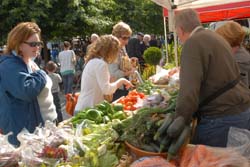
 So, it’s the end of the long summer holidays and back to school – which may sound a little sad, but the start of the new academic year is always an exciting time. It’s also a magical time for gardeners, who have the reward of harvesting (and eating) many of the crops grown this year - and the pleasure of plotting and planning for next season, as the endless cycle begins again. And, if we want our children to be healthy and happy, understand about good food and enjoy it (and life), we need to see more food grown in the place where they all spend so much time - schools.
So, it’s the end of the long summer holidays and back to school – which may sound a little sad, but the start of the new academic year is always an exciting time. It’s also a magical time for gardeners, who have the reward of harvesting (and eating) many of the crops grown this year - and the pleasure of plotting and planning for next season, as the endless cycle begins again. And, if we want our children to be healthy and happy, understand about good food and enjoy it (and life), we need to see more food grown in the place where they all spend so much time - schools. For inspiration and information on ‘Edible Education’ there’s no better place to look than to Alice Waters (of the iconic ‘Chez Panisse’ restaurant in Berkeley, California) who started the Edible Schoolyard movement well over a decade ago by ‘turning over long-abandoned soil at an urban middle school’ in the town. Her book Edible Schoolyard – A Universal Idea (Chronicle Books , hardback; £9.89 from amazon.co.uk) will be an inspiration to every parent and teacher who is aware that children need to know about good food. And, when it comes to the social benefits of such a system, the sky’s the limit.
For inspiration and information on ‘Edible Education’ there’s no better place to look than to Alice Waters (of the iconic ‘Chez Panisse’ restaurant in Berkeley, California) who started the Edible Schoolyard movement well over a decade ago by ‘turning over long-abandoned soil at an urban middle school’ in the town. Her book Edible Schoolyard – A Universal Idea (Chronicle Books , hardback; £9.89 from amazon.co.uk) will be an inspiration to every parent and teacher who is aware that children need to know about good food. And, when it comes to the social benefits of such a system, the sky’s the limit.The basic principles of ‘Edible Education’ are:
• Food is an Academic Subject
• Schools Provide Lunch for Every Child
• Schools Support Farms
• Children Learn by Doing
• Beauty is a Language
The children not only grow food crops in the school garden, but prepare and cook the produce as an integral (and complementary) part of their school curriculum, share it with other students and teachers - and tidy up afterwards!
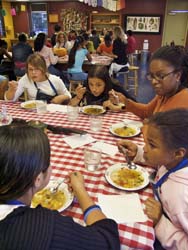 Students cook in groups of ten, using recipes designed to ‘introduce them to a variety of foods and keep many hands busy, working side by side with the pleasant tasks of chopping, mincing, peeling, shelling, measuring, mixing, and, of course, tasting.’ Everything they do is, by definition, seasonal – and the dishes cooked include some very familiar to children here, such as Potato Smash with Kale (sounds very like colcannon to me!)
Students cook in groups of ten, using recipes designed to ‘introduce them to a variety of foods and keep many hands busy, working side by side with the pleasant tasks of chopping, mincing, peeling, shelling, measuring, mixing, and, of course, tasting.’ Everything they do is, by definition, seasonal – and the dishes cooked include some very familiar to children here, such as Potato Smash with Kale (sounds very like colcannon to me!) We’re a long way behind in Ireland, of course, but fair play to Agri Aware and their Incredible Edibles Growing Challenge initiative, which sees a special kit containing growing bags, fruit and vegetable seeds, compost and educational resources landing on the doorstep of every primary school nationwide (almost 4,000).
It’s a follow-on from last year’s successful potato growing project, and Minister for Food, Trevor Sargent, is very supportive– an avid gardener himself, he even has his own website ‘intended for beginners who want to grow their own food, but just don’t know how to get started’.
 On a similar tack, ‘Grow your way out of the recession’ is one of the themes at this year’s Waterford Harvest Festival (11-13 September), hosted by Slow Food Ireland and Waterford City Council (loads of great events including a farmers’ market, 10am-4pm on Sunday 13th September). Especially interesting is the launch of Gro
On a similar tack, ‘Grow your way out of the recession’ is one of the themes at this year’s Waterford Harvest Festival (11-13 September), hosted by Slow Food Ireland and Waterford City Council (loads of great events including a farmers’ market, 10am-4pm on Sunday 13th September). Especially interesting is the launch of Gro w It Yourself (GIY) Ireland, a national not-for-profit organisation established by journalist and author Michael “Trading Places”, which aims to inspire people to grow their own food and give them the skills they need to do so successfully.
w It Yourself (GIY) Ireland, a national not-for-profit organisation established by journalist and author Michael “Trading Places”, which aims to inspire people to grow their own food and give them the skills they need to do so successfully. Michael Kelly is also mad about hens, saying “it’s perfectly feasible to keep a couple of hens in an urban or suburban garden and enjoy perfect, healthy, organic eggs for years to come”. Although keeping hens in back gardens is not perhaps universally appropriate, he’s the man to tell you how to get started if it appeals to you.
 GIY is something that anybody can do without fear of annoying the neighbours however, and the organisation has the support of Darina Allen, who will talk about the “lost art” of growing your own food at the launch of GIY Ireland on September 12th. “Getting people together in a GIY group is a brilliant idea,” she says. “It gives them a sense of camaraderie and shared experience in the joy of vegetable growing. But it also gives them the skills they need to grow successfully. Having a GIY group in every town in Ireland would mean that anyone who wants to grow their own will have a place to go where they can meet like-minded people and learn from them. That will be invaluable.”
GIY is something that anybody can do without fear of annoying the neighbours however, and the organisation has the support of Darina Allen, who will talk about the “lost art” of growing your own food at the launch of GIY Ireland on September 12th. “Getting people together in a GIY group is a brilliant idea,” she says. “It gives them a sense of camaraderie and shared experience in the joy of vegetable growing. But it also gives them the skills they need to grow successfully. Having a GIY group in every town in Ireland would mean that anyone who wants to grow their own will have a place to go where they can meet like-minded people and learn from them. That will be invaluable.” Speakers at the GIY Ireland launch which takes place in Waterford Institute of Technology on Saturday September 12 will include Joy Larkcom, Trevor Sargent, Darina Allen, Michael Kelly and Will Sutherland. There will also be a demonstration on cooking with sustainable fish by Fresh From the Sea author Clodagh McKenna and talks on allotments, community gardens, nutrition, seed-saving and permaculture.
Tickets which cost €35 include a seasonal dinner and are available to buy from www.GIYIreland.com
Ratatouille
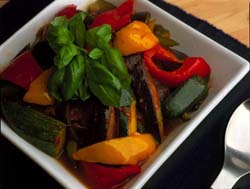 Late summer and early autumn is the perfect time of year to make this classic dish, when the ingredients are at the height of their natural season and full of flavour. It makes a great side dish with any simply cooked meat, poultry or fish, or can be served with crusty bread as a starter; although best served fresh it is also a useful way to deal with an over-supply of any of the ingredients (courgettes are most likely) as it can be frozen. Peperonata, a simpler cousin of ratatouille, is made without aubergines.
Late summer and early autumn is the perfect time of year to make this classic dish, when the ingredients are at the height of their natural season and full of flavour. It makes a great side dish with any simply cooked meat, poultry or fish, or can be served with crusty bread as a starter; although best served fresh it is also a useful way to deal with an over-supply of any of the ingredients (courgettes are most likely) as it can be frozen. Peperonata, a simpler cousin of ratatouille, is made without aubergines.Click for recipe
Potato & Bean Salad with Bacon
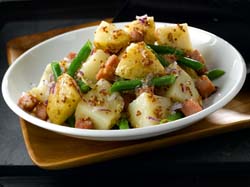 If cooked carefully to prevent them breaking up, new season Queens (many of which come from North County Dublin, eg Rush/Skerries) can be used for this delicious little dish, and they have great flavour; then later, when that great all-rounder the Rooster comes on stream, that will do nicely.
If cooked carefully to prevent them breaking up, new season Queens (many of which come from North County Dublin, eg Rush/Skerries) can be used for this delicious little dish, and they have great flavour; then later, when that great all-rounder the Rooster comes on stream, that will do nicely. French or runner beans are perfect – and the blanching process given here is also essential for freezing beans successfully, useful to know if you have to deal with a glut. Whether served warm or cold, it’s a great salad and can be served as a light main course or, with or without the bacon, as a starter.
Vegetarians could try replacing the bacon with cubes of an interesting farmhouse cheese – Mossfield organic, for example, a mature gouda made near Birr, Co Offaly; I picked some up at Peter Ward’s Country Choice shop in Nenagh last week, along with some local tomatoes and home-baked breads, and it’s only gorgeous.
Click for recipe
 Grilled Vegetables With Mozzarella
Grilled Vegetables With MozzarellaAn easy-peasy dish that uses much the same ingredients as ratatouille but also cherry tomatoes – ideal if you grow your own out of doors, as you’ll probably have masses of them at the moment – and it’s much quicker: just the job to serve with plenty of crusty bread for a colourful meal-in-a-hurry.
Grilling is suggested here, but if you have a range type cooker such as an Aga or Waterford Stanley, simply pop the oiled vegetables into the hot oven and they’ll ‘grill’ in a few minutes, allowing excess moisture in the vegetables to evaporate. Gorgeous fast food - for older children coming in hungry from school, perhaps; teenagers might like to make it themselves.
Click for recipe
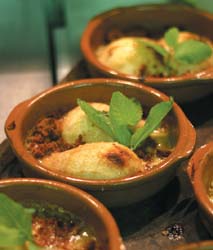 Paul Flynn's Baked Pears with Gingerbread and Cream
Paul Flynn's Baked Pears with Gingerbread and CreamWaterford is a very foodie destination these days, with the Waterford Harvest Festival on next weekend and, down the road in Dungarvan, Paul Flynn of The Tannery Restaurant & Cookery School (multi-award-winning at the recent Food & Wine Magazine Restaurant of the Year Awards, bagging Best Munster Chef & Restaurant among others) is a great supporter of the best seasonal local ingredients - and now proud owner of the Glanbia Garden.
Formerly derelict land behind the cookery school, it’s been cultivated with support from Glanbia, to supply home-grown produce for the cookery school and the restaurant. With Irish pears in season now, it’s perfect timing for this simply scrumptious autumnal dessert from Paul’s book Second Helpings (Collins Press, €30, hardback).
Click for recipe
Hallowe'en Treats
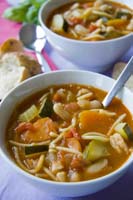
 Hallowe’en is coming up and the evenings are closing in nicely for the bonfire and sparklers – this month’s recipes are ideal for feeding family and friends the casual, hearty fare that you need when everyone is coming and going through the evening.
Hallowe’en is coming up and the evenings are closing in nicely for the bonfire and sparklers – this month’s recipes are ideal for feeding family and friends the casual, hearty fare that you need when everyone is coming and going through the evening. Tasty dishes – and a yummy way to use up the pumpkin flesh once you’ve hollowed it out. And we have some seriously spooky stuff that the kids can help with too – perfect for the mid-term break.
 Hearty Minestrone
Hearty MinestroneThis easy ‘meal in a soup bowl’ is from well known food blogger Donal Skehan’s excellent first book Good Mood Food (Mercier paperback, €19.99). Hailed by RTE as ‘Ireland’s answer to Jamie Oliver’, Donal’s enthusiasm for good, simple homecooked food is infectious - and this ‘perfect winter meal solution’ is typical of his healthy, down to earth approach.
Full of tasty vegetables, and filling thanks to the pasta, it would be just the job for feeding hungry folk at Hallowe’en. “I use wholewheat spaghetti, but feel tree to add other shapes like fusilli or pasta elbows instead,” says Donal “If you don't have any paprika, you can get a bit of spice by adding a dash of Tabasco sauce, or a good pinch of dried chilli flakes.”
Click for recipe
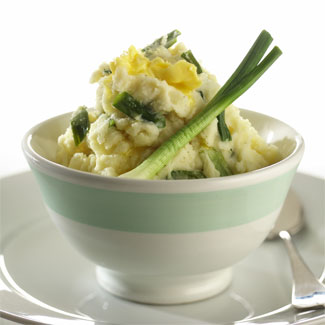 Colcannon
ColcannonHallowe’en has more traditional festive dishes associated with it than any other date in the Irish calendar – and Colcannon remains one of the most popular. Traditionally, at Hallowe’en, it should have a ring hidden in it – predicting marriage in the coming year for whoever finds it. The familiar old rhyme almost gives the recipe:
Did you ever eat Colcannon, made from lovely pickled cream??
With the greens and scallions mingled like a picture in a dream.?
Did you ever make a hole on top to hold the melting flake
Of the creamy, flavoured butter that your mother used to make
Did you ever eat and eat, afraid
You’d let the ring go past,
And like some old married ‘sprissman’
Would get it at the last?
Colcannon has turned up on many a fancy restaurant menu recently, as a side dish, and it makes a lovely wholesome family dish served simply with really good sausages – especially at Hallowe’en.
Click for recipe
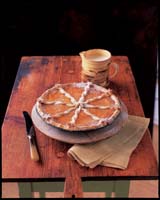 Spiced pumpkin & apple pie
Spiced pumpkin & apple pieOnce your pumpkin is hollowed out and lit up to spook the neighbourhood, you’ll have plenty of pumpkin flesh leftover – so why not try this recipe from Brian Glover’s great little book, Cooking with Pumpkins and Squash (Ryland Peters & Small, hardback, £9.99 in UK), with lovely photography Peter Cassidy. “This is not, I grant you, the usual pumpkin pie,” he says, “But much as I love the traditional version, I wanted to try something that had a lighter, slightly sharper flavour and adding a sour cooking apple did the trick.” Perfect for a crowd at Hallowe’en - serves 8–10
Click for recipe
Hallowe'en Cooking for the Kids

 We have some seriously spooky stuff that the kids can help with – perfect for the mid-term break. Not only will carrots help you see in the dark, but they can be made into great ‘Halloween x-ray vision’ party fare.
We have some seriously spooky stuff that the kids can help with – perfect for the mid-term break. Not only will carrots help you see in the dark, but they can be made into great ‘Halloween x-ray vision’ party fare.So why not get the kids to “give you a hand” creating Frankenstein Fingers from baby carrots, using flaked almonds as finger nails and assembling them into a pot of slimy green guacamole. Sheep’s eyes are a doddle too, simply top the sliced carrots with a blob of sour cream and then sliced grapes or olives and arrange the eyes in pairs on a serving plate.
Kids will love decorating Spooky Carrot Muffins with iced spiders, pumpkins and ghosts and they’ll be great for any trick or treaters too. Jacket potatoes with chilli lamb and carrot topping are another delicious party option for children and adults alike.
And they’re all dead easy to prepare.
Frankenstein Fingers and Sheeps’ Eyes
For a bit of Halloween fun, try these spooky ideas! They are quick and easy and get the kids eating veg too!
Click for recipe
 Halloween Carrot Muffins
Halloween Carrot MuffinsOlder children could make these on their own, with an adult just keeping an eye on things, or you can make the muffins up and let younger kids decorate them when they’ve cooled.
Writing icing is available from the bakery section in good supermarkets - for example, Superquinn have Dr Oetker Writing Icing at €4.62 for a pack 5 individual tubes of red, yellow, black, white and green icing and there’s also a Supercook range that should be easy to find. Kitchen Complements (www.kitchencomplements.ie) stock the Wilton range of writing icing and they also have various Hallowe’en themed cookie cutters etc.
You can also get instant royal icing, which you could colour up to match your own theme.
Click for recipe
The Big Bake
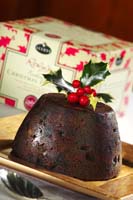 Christmas is coming and there’s nothing a good cook likes better than the orderly preparations that begin with making the puddings and rich fruit cakes – once they’re made and stored, there’s a sense of things being under control…This month’s recipes tie in with the new season cookbooks (see Book Reviews).
Christmas is coming and there’s nothing a good cook likes better than the orderly preparations that begin with making the puddings and rich fruit cakes – once they’re made and stored, there’s a sense of things being under control…This month’s recipes tie in with the new season cookbooks (see Book Reviews).  Roly's Christmas Pudding
Roly's Christmas PuddingAlthough not in the newly published Roly's Café & Bakery cookbook (see Book Reviews), this is one of many treats currently on the Christmas menu at Roly’s Café. The cookbook does, however, include some very pretty cupcakes – and a mean biscuit cake - either of which would make nice little Christmas presents. Makes 2 x 1lb puddings
Click for recipe
 Edward Hayden's Christmas cake
Edward Hayden's Christmas cakeDown at Dunbrody House, celebrity chef Kevin Dundon (author of the hugely successful Great Family Food), has Edward Hayden as his right hand man, and he too has written a successful book, Edward Entertains (€25 online, from his website).
This traditional recipe from the book is, he says “The nicest recipe for fruit cake that I have ever come across… adapted from a recipe given to me by my very good friend, Mary Woods. There are several stages to it (soaking fruit, lining the tin, making the cake, icing and decorating the cake)… it’s a great way of involving children in cooking and they can get a real sense of achievement in it.”
Click for recipe
Bûche de Noel
 The traditional rich fruit cake seems to be a love it or loathe it affair - personally I wouldn’t be without it, not so much for Christmas itself when there is so much other food around, but to brighten the dark days of January when the recent indulgence is but a distant dream.
The traditional rich fruit cake seems to be a love it or loathe it affair - personally I wouldn’t be without it, not so much for Christmas itself when there is so much other food around, but to brighten the dark days of January when the recent indulgence is but a distant dream. On a gloomy afternoon, a cup of tea and a slice of darkly juicy fruit cake is just heaven, such a lovely cosy feeling. Bûche de Noel makes a delicious Christmas alternative for those who don’t like rich fruit cake and, although it doesn’t keep like the cake, it makes a great dessert so it could also be offered instead of the plum pudding.
From Julie Duff’s book, Cakes From Around the World (Grub Street, paperback stg£14.99), this chocolate roulade is traditional to France and Quebec, to serve on Christmas Day. “Chestnut purée and fresh cream are blended together to fill and ice this delectable cake. It can then be decorated with a sprig of fresh holly and sprinkled with icing sugar 'snow'.”
Click for recipe
A Traditional Christmas Feast
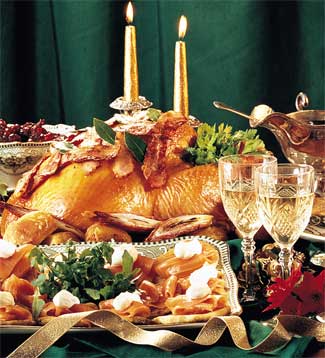
 Christmas Menu
Christmas Menu Spiced Beef (Bites or Starter - see below)
-
Traditional Roast Turkey & Accompaniments
Glazed Ham
Perfect Roast Potatoes
Greens with Shallots & Bacon
Jerusalem Artichokes
-
Plum Pudding
Iced Christmas Pudding
-
Home-made Truffles
A starter is hardly necessary before such a big meal but if you feel the occasion demands it, keep it very light and simple or - a better alternative perhaps - hand around nibbles with the drinks instead.
TURKEY
Traditionally, the turkey was always stuffed the night before, and it certainly makes Christmas morning easier, but health scares have led to official recommendations that the stuffing be prepared but not actually go into the bird until the morning.
This is probably unnecessary providing you make sure the bird is well cooked, but extra care is definitely advisable if you are using a frozen turkey: place it in a large dish at the bottom of your fridge (where juices cannot drip onto other foods) and make sure it is completely thawed before cooking; allow 48 hours for a small turkey, up to 3 days for a large one. If it is still very cold and you are in any doubt, cook the stuffing separately so that the heat can get right into the bird.
A meat thermometer will tell you when the centre is properly cooked, although testing with a skewer in the thickest part of the thigh is quite reliable: if the juices run clear, with no tinges of pink, the bird is cooked.
Hints to get the best from your turkey:
* Free-range organic is best, although it must be ordered well ahead. When choosing any fresh turkey, look for a broad-breasted bird which will give a high proportion of tender white meat. A flare of white up either side of the breast is a good sign, as this thin layer of fat will keep it moist during cooking.
* As a rough rule of thumb allow about 1 lb/450g per person when calculating the size of oven-ready turkey to buy; eg a medium bird about 12-14lb/5-6kg will be enough for 12-14 people. It is nice to have some leftovers for the next day, but remember that that ham and/or other trimmings will also be filling so don’t get an unnecessarily large turkey. Ask your butcher to give you the neck and giblets from if possible; remove from the body cavity before stuffing and use to make stock for a good gravy.
* Traditional forcemeat, flavoured with herbs and lemon, is hard to beat as a stuffing for both ends of the bird, although a simple lump of butter and a peeled onion is enough to give flavour in the body cavity. Any leftover stuffing can be made into balls, which are crisp and easy to serve separately. Do not pack stuffing too tightly, and weigh the turkey after stuffing in order to calculate the cooking time correctly. Allow 15-20 minutes per pound/450g (allow 10-15 minutes per pound for turkeys weighing over 16 lb).
* For a traditional roast, spread the turkey with soft butter, cover with bacon rashers and buttered paper, or a square of double thickness butter muslin (you can baste through the muslin). If using foil, remember that – like overloading the oven and frequently opening the door - close wrapping may slow down the cooking.
* On a meat thermometer, the bird is cooked when a temperature of 190ºF, 90ºC is reached.
* Allow the roast turkey to stand for at least 15 minutes before carving, so that the juices can settle and it will slice better. As long as the skin is not pierced, it will hold in the heat.
* Bacon rolls provide a good alternative to ham with hot turkey. The ham can then be cooked ahead and provide more variety at a meal of cold turkey and fresh vegetables and/or salads on St Stephen's Day. Cranberry sauce, bread sauce and a good gravy is all you need with hot turkey, but sweet pickled fruits such as peaches in brandy are delicious when it is served cold.
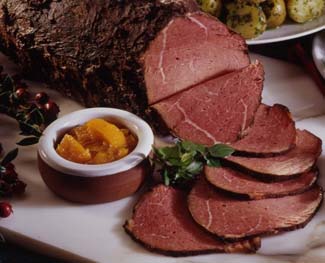 Quick Spiced Beef
Quick Spiced Beef This is a very useful standby to have prepared for use on Christmas Day for nibbles or as a starter - or keep it for after Christmas to serve with the side dishes given below as a meal, or as part of a party buffet selection. This quick and easy method leaves the joint nice and pink all the way through.
Serves at least 8:
2 kg/4 lb corned beef, silverside or tailend
1 tbsp. coarsely ground black pepper
2 tsp. ground ginger
1 tbsp. juniper berries, crushed
1 tbsp. coriander seeds, crushed
1 tsp. ground cloves
3 tsp. allspice
3 tbsp. dark brown sugar
2 bay leaves, crushed
1 small onion, finely chopped
250ml /1/2 pt Guinness
To Spice the beef: Mix all the spices and sugar well together plus the bay leaves and onion. Rub the mixture into the meat. Refrigerate for 3-4 days, turning and rubbing daily.
To Cook: Put the meat in a saucepan and just barely cover with cold water. Place a tight lid on the saucepan and bring to the boil. Reduce the heat and cook very gently for approximately 31/2 hours. For the last hour add the Guinness to the cooking liquid. When the joint is cooked allow it to cool in the liquid. Wrap in foil and keep in the fridge until required. Spiced beef will hold well in the fridge for approximately a week.
To Serve as a Starter: Slice the spiced beef very thinly and serve small portions, with a little soured cream flavoured with chives, garlic, finely grated orange rind and freshly ground black pepper.
To Serve as a Party Bite: Slice thinly and serve on brown bread with soured cream, horseradish, or this simple Apricot and Almond Chutney (also an attractive little gift when packed prettily in small jars; makes 1 litre/ 13/4 pints).
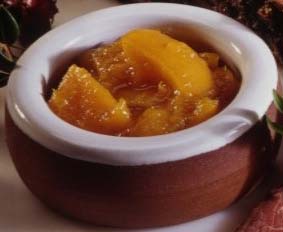 Apricot & Almond Chutney
Apricot & Almond Chutney450g /1 lb no soak dried apricots, chopped
225g/8 oz brown sugar
1 onion, chopped
500ml/scant 1 pint wine vinegar
1 cooking apple, chopped
2 tables. fresh root ginger, grated
1/2 tbsp. coriander seeds, toasted and crushed
75g /3 oz almonds, blanched and roughly chopped
Dash of Tabasco and salt
Mix all the ingredients in a large saucepan. Heat gently, stirring all the time, until the sugar has dissolved. Simmer for about an hour (don’t over cook). Spoon into warmed, sterilised jars and seal immediately. Improves with keeping.
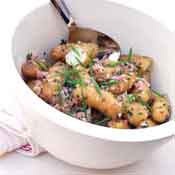 Warm potato salad with herb dressing
Warm potato salad with herb dressingThis delicious warm potato salad and the colourful orange salad below are ideal with the spiced beef, or with leftover turkey and ham on St Stephen’s Day. Scales up well for parties.
Serves about 6-8:
1kg/2lb baby potatoes, or any waxy type, cooked but still warm
Dressing:
3 tbsp. olive oil
1 tbsp. red wine vinegar
1 tbsp. chopped tarragon
1 tbsp. chopped parsley
2 cloves garlic chopped
1 tbsp whole grain mustard
salt and black pepper
Mix the dressing ingredients together and stir through the potatoes.
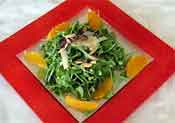 Orange and rocket salad
Orange and rocket salad A pretty and refreshing side dish - also ideal for richer meats such as goose or duck. You could make this into a light meal by including chunks of farmhouse cheese in the salad, and serving it with freshly baked soda bread.
Serves about 6-8:
2-3 oranges cut into segments
Rocket leaves
Red onion finely sliced
Dressing
3 tbsp olive oil
1 tbsp red wine vinegar
1 tsp Dijon mustard
Salt and black pepper
Mix the dressing ingredients together.
Toss the oranges, rocket leaves and onion together and mix with the dressing
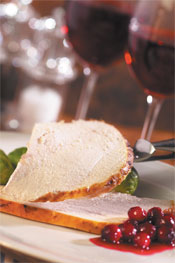 Roast Turkey with Traditional Parsley & Thyme Stuffing
Roast Turkey with Traditional Parsley & Thyme StuffingServes at least 8 on Christmas Day, and enough for a cold meal for St Stephen’s Day:
7 kg /14 lb turkey, oven ready
Salt, black pepper and a little flour
2 tbsp. softened butter
8 slices streaky bacon
Stuffing
450g / 1 lb bread, broken into pieces
6 tbsp. fresh parsley, chopped
2 tbsp. fresh thyme, chopped
1 medium onion, cut into quarters
Salt and black pepper
100-150g /4-6 oz butter, softened
To Make the Stuffing
Place the bread, parsley, thyme and onion in a food processor. Process until you have fine breadcrumbs and the onion is finely chopped. Remove to a bowl, season and mix in the butter.
To Stuff the Turkey
Loosen the skin at the neck end with your hands. Pack the stuffing in, pushing it up between the flesh and the skin, but not too tightly, because it will expand during cooking. Tuck the neck flap under the bird’s back and secure with a cocktail stick. Any remaining stuffing can be cooked in a covered baking dish with the turkey. Weigh the turkey, and calculate the cooking time. Allow 15-20 minutes per pound/450g (allow 10-15 minutes per pound for turkeys weighing over 16 lb). Place the turkey, breast side up, in an oiled roasting tin.
To Cook the Turkey
Set the oven at Gas Mark 7, 220°C (450°F).
Season the turkey with salt and pepper and dust with a little flour. Rub all over with the butter, then lay the bacon slices on the breast, overlapping each other. Cover the bacon with a piece of buttered greaseproof paper. This will keep the bacon in place. Wrap the turkey loosely in foil and roast in the preset oven. After the first half hour reduce the heat to Gas Mark 3, 170°C (325°F). Baste a couple of times during roasting. For the last half hour remove the tin foil.
To check if the turkey is cooked pierce the thickest part of the leg – the juices should run clear.
When the turkey is cooked remove from the oven, transfer to a large plate, reserve the cooking juices in the tin to make the gravy. Cover the turkey loosely with foil and allow to rest for half an hour in a warm place while you finish the ham and roast potatoes.
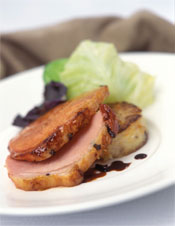 Loin of Bacon with an Irish Mist Glaze
Loin of Bacon with an Irish Mist GlazeThis recipe is adapted from the modern Irish cookbook ‘Full On Irish’ (EUR25, available directly from Dunbrody House) by Kevin Dundon , proprietor-chef at the lovely Dunbrody House Hotel at Arthurstown, Co Wexford.
In this beautiful book, Kevin Dundon visits the producers and suppliers who provide his kitchens with the finest foods the surrounding area has to offer: simply magic!
The loin of bacon is most often used for back rashers but it also makes a wonderful joint, perhaps served with potato cakes and cabbage cups, as given as an option here.
Most bacon now doesn't need to be soaked overnight, but it is probably worth checking with your butcher. Serves 4 as a main course with the potato cakes, or 8 when served with turkey and traditional trimmings:
900g/2lb loin of bacon
2 tbsp Irish Mist
4 tbsp honey
100ml/3 1/2 fl oz tablespoons cider
12 whole cloves
Seasoning: salt and freshly ground black pepper
Place the loin of bacon in a large pan and cover with cold water. Bring to the boil, then reduce the heat and simmer for 1 hour until completely tender.
Preheat the oven to 180ºC/350ºF/Gas 4. Place the Irish Mist in a pan with the honey and cider, then heat gently until dissolved. Remove the loin of bacon from the water and leave until cool enough to handle, then trim away the rind and excess fat. Slash the remaining thin layer of fat in a criss-cross pattern and stud with cloves.
Place the clove-studded loin of bacon in a small roasting tin and brush all over with the Irish Mist glaze, pouring any remainder around the joint. Bake for 15-20 minutes until completely heated through and well glazed, basting occasionally.
Remove the bacon from the oven and leave in a warm place for at least 10 minutes. Season to taste.
To serve, carve the bacon into slices and then drizzle around the remaining glaze left in the tin.
Perfect Roast Potatoes
The most important thing to remember for perfect potatoes is not to roast them too long in advance as they lose their crunch if you keep them waiting. Start by par-boiling the peeled potatoes for approx. 5-6 minutes, depending on size, so they are just softening but not breaking up. Drain well and set aside.
When ready to cook, heat some oil or fat from the turkey in a roasting tin or baking tray (when cooking separately, goose or duck fat is ideal). When it is very hot, add the potatoes and shake around to roughen the surface and distribute the fat.
Sprinkle with salt and roast in the hot oven (preheated to at least Gas Mark 6, 200°C, 400°F); allow half an hour.
Shallots, roasted with the potatoes, are also delicious.
 Jerusalem Artichokes are beautiful root vegetables and, while we will also have carrots and possibly parsnips on the Christmas table, these knobbly sweet-fleshed treats take pride of place. Although traditionally served in white sauce, this simpler recipe is less hassle on Christmas Day. Serves 6-8:
Jerusalem Artichokes are beautiful root vegetables and, while we will also have carrots and possibly parsnips on the Christmas table, these knobbly sweet-fleshed treats take pride of place. Although traditionally served in white sauce, this simpler recipe is less hassle on Christmas Day. Serves 6-8:11/2-2 lb/700-900g Jerusalem artichokes
Lemon juice or vinegar, as required
Salt
2 oz/50g unsalted butter
Seasoned flour (optional).
Peel the artichokes, dropping them straight into a bowl of water acidulated with a good dash of lemon juice or vinegar to prevent browning.
Cut up so that the pieces are matched for size, otherwise they will cook unevenly. Bring a large pan of salted water to the boil, drain the artichokes and boil them for about 5 minutes, or until just tender. Watch them carefully, as they break up easily.
Melt the butter in a roasting tin, coat the artichokes in the seasoned flour and roll them around in the butter then put into the oven (350'F, 180'F, Gas mark 4 approx.) for 20-30 minutes, or until golden brown.
Variation: You can take short cuts with this recipe, by omitting the flouring stage and using ordinary salted butter. If you keep a close eye on them, you can also speed them up by browning the artichokes at a higher temperature if convenient.
 Greens with Shallots & Bacon
Greens with Shallots & BaconSprouts are the traditional choice and given here, but this recipe could be used for other vegetables, including green beans, broccoli florets or even celery. The advantage is that they can be prepared ahead and popped into the oven to reheat while you’re getting everything else onto the table.
Serves 6-8:
1 kg /2 lb small-medium sized sprouts, trimmed
1 tbsp. oil
2 cloves garlic, chopped
1 onion or 2-3 shallots, sliced
3-4 slices of streaky bacon, chopped
Salt and black pepper
1-2 tbsp. stock from the ham
Trim the sprouts, cut a cross in the base of each one and blanch them for 2-3 minutes; drain well. Heat the oil, saut? the garlic, onions and bacon for 2-3 minutes and season. Add the mixture to the sprouts and pour the lot into a baking dish with the stock. Reheat in a hot oven for 10-15 minutes just before serving.
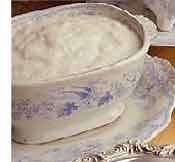 Bread Sauce - a very traditional accompaniment for the turkey. Can be prepared ahead and gently reheated, adding more milk or cream as required to correct the consistency.
Bread Sauce - a very traditional accompaniment for the turkey. Can be prepared ahead and gently reheated, adding more milk or cream as required to correct the consistency. l small onion
2 or 3 cloves
l small bay leaf
1/2 pint/300 ml milk
2 oz/50g soft white breadcrumbs
1/2 oz/12g butter
Salt and freshly ground black pepper
A pinch of grated nutmeg (optional)
l tablespoon cream or top of the milk.
Peel the onion, stick it with the cloves and put into a milk pan with the bay leaf and the milk. Bring it just to boiling point, then take the pan off the heat and leave it to infuse for 15 minutes. Strain and discard the onion and bayleaf.
Add the breadcrumbs and set the pan in a warm place or on a simmering mat over very low heat for about 1/2 hour until the breadcrumbs have soaked up the milk.
Add the butter, season with salt, pepper and the nutmeg if using, and stir until smooth. If it is too thin, simmer the sauce very gently for about 5 minutes, stirring frequently as it burns very easily; if it is too thick, adjust with extra milk as required.
Just before serving, stir in the cream.
Cranberry Sauce
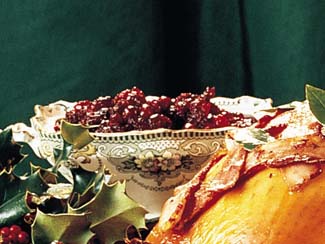
Very simple to make and far better than anything out of a jar. Make the day before. Serves 8:
1 packet x 325g (12 oz) cranberries
225g (8 oz) sugar
125ml (1/4 pt) water
Heat everything together gently until the sugar has dissolved, then simmer for 5-10 minutes. Cool and store in the fridge until required.
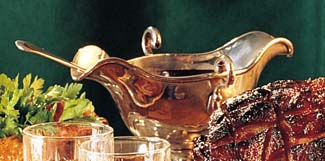 How to make Good Gravy
How to make Good GravyA well-flavoured stock is important so, a day ahead, place the giblets, with some onion slices and a bay leaf in a saucepan; season lightly, cover with water and simmer gently for 11/2-2 hours. Then strain and check seasoning.
After removing the turkey from the roasting tin, pour off most of the fat and leave behind the juices. Over a medium heat, stir in a heaped tablespoon of flour, or as much as the fat and juices can absorb.
Blend well and stir for a minute or two, to cook the starch. Blend in the stock and a dash of wine; simmer for 2-3 minutes, also adding in any vegetable stock until the gravy reaches the consistency you like.
A tablespoon of redcurrant jelly, or a splash of red wine or balsamic vinegar will also add to the flavour. Season to taste.
(Variation: I always cook a finely chopped onion in the juices before adding the flour, which improves the flavour even more; there is no need to strain them out.)
If you are having a traditional hot Plum Pudding, steam for a couple of hours before the meal. We usually have a choice of hot Rum Sauce (a sweet white sauce flavoured with navy rum) and Rum Butter (equal quantities of soft light brown sugar creamed with unsalted butter, then flavoured generously with rum).
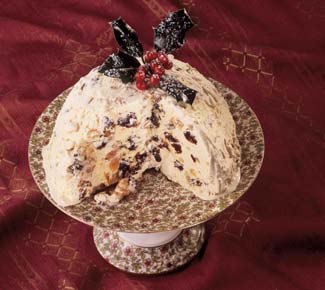 Christmas Ice Pudding can be made at the last minute if necessary - a delicious alternative to the traditional hot pudding.
Christmas Ice Pudding can be made at the last minute if necessary - a delicious alternative to the traditional hot pudding. Serves 6-8
100g/4 oz granulated sugar
125 ml/1/4 pint water
4 egg yolks
600 ml / 1 pint cream
1 tsp vanilla essence
500g/1 lb mixed dried fruit, eg raisins, currants, sultanas, chopped figs, apricots (soaked overnight in port, or similar)
100g/4 oz toasted almonds, chopped.
Put the sugar and water into a pan. Dissolve the sugar over a gentle heat, then boil steadily until it forms a syrup. Beat the egg yolks well, then carefully pour the syrup onto them. Continue to whisk to a thick mousse-like mixture. Whip the cream. Fold the cream and vanilla essence into the mousse with the fruit and nuts. Pour the lot into a pudding bowl and freeze.
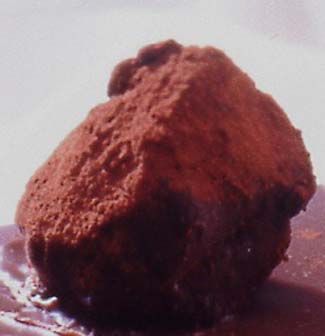 Chocolate Truffles
Chocolate Truffles Irish handmade chocolates are all the rage. Makes about 50:
200g/7 oz best quality dark chocolate (eg Valrhona, Celtic or Green & Black)
50g/2 oz butter
50 ml/2 fl oz cream
Unsweetened cocoa powder for dusting
Melt the chocolate over gentle heat, then stir in the butter. When all the butter has melted, add the cream. Transfer the chocolate mixture to a baking tray and chill.
Shape the truffles rapidly, spooning out the paste with a teaspoon and rolling into walnut-sized pieces with the palm of your hand. Drop them one by one into a bowl containing unsweetened cocoa, twisting the bowl to coat the truffles with cocoa. Store in a cool place.
Variations: Add a tablespoon of Irish whiskey, Irish cream liqueur or other similar flavouring when melting the chocolate. Chop 100g/4oz of dried fruit such as prunes and fold into the chocolate mixture before you transfer it to a tray.
Christmas Dinner - Timing Guide
Based on a medium-sized stuffed turkey about 14-15lb/6.5-6.75kg, covered with butter muslin or wrapped loosely in foil (see above), this is a rough guide to timing if serving at around 1 pm; adjust to suit your turkey size and preferred serving time:
The night before, remove turkey from fridge and leave it in a cool place overnight (eg the cold oven) to bring it to room temperature
8.00 Preheat the oven to 425F/220C/Gas 7
8.30 Put the turkey in to roast
9.00 Lower temperature to 325F/160/C/Gas 3 and cook for 3 1/2 hours
9.30 Put Christmas Pudding on to steam; check water regularly
10.30 Add finishing touches to table; prepare wines
11.15 Unwrap turkey, baste and continue cooking. Start potatoes (see above). Put plates and serving dishes to warm.
12.30 Put bacon rolls and cocktail sausages into the oven with the turkey, or cook under a hot grill. Keep warm
Make white sauce - rum or brandy - if using; keep warm. Whip cream, cover and store in fridge; cream flavoured with Baileys or brandy can be used instead of a hot sauce if preferred.
12.40 Test turkey with a skewer; if cooked, wrap in foil and rest for at least 20 minutes. Turn up oven temperature after removing the turkey and finish cooking the potatoes (see above). Make gravy.
Part-cook green vegetable; cook any other vegetables, eg carrots, drain and keep warm (reserve stock for gravy).
Reheat Bread Sauce, adding a little milk to thin if necessary.
12.50 Turn the Christmas Pudding onto a heated serving dish; cover with foil to keep warm until ready to serve.
Place turkey on a carving dish; if serving a large number, carve in the kitchen, transfer to a serving platter, cover and keep warm. Finish cooking green vegetable. Dish up, leaving the potatoes in the oven as long as possible so they will be crisp. (Arrange to have plenty of help for serving if the numbers are large.) Transfer any frozen dessert from freezer to fridge before sitting down.
1.00-1.15 Sit down and enjoy your Christmas Dinner!
Oat Cuisine

 No winter morning begins in our house without a bowl of porridge, enjoyed with Irish honey and a good splash of full cream milk - we make the porridge overnight, cooked on Low in an electric slow cooker (1 cup porridge to 3 of water, plus a good pinch of salt). It’s completely effortless, convenient for schoolchildren in a hurry and handy too if several people need to eat at different times.
No winter morning begins in our house without a bowl of porridge, enjoyed with Irish honey and a good splash of full cream milk - we make the porridge overnight, cooked on Low in an electric slow cooker (1 cup porridge to 3 of water, plus a good pinch of salt). It’s completely effortless, convenient for schoolchildren in a hurry and handy too if several people need to eat at different times. Porridge is the perfect health breakfast, providing warmth and slow-release energy throughout the morning – ideal for school children, and just about anyone really, especially if taken with a glass of fresh orange juice.
This is the perfect partner for porridge oats at breakfast, according to nutritionists, because the vitamin C in the juice helps the body to absorb the iron in oats. And – good news for dieters - breakfast eaters are less likely to be overweight, as it is less likely that you will snack on high calorie foods mid-morning or over-eat at lunchtime.
There are plenty of oats to choose from, but we like to support Irish products, and Flahavans is the one we’ve used for ages – either the flaked oats or pinhead (which needs proportionately more water than the flaked oats).
 This family-run business has been operating in Kilmacthomas, Co Waterford for over 200 years, spanning six generations, making it one of Ireland's longest-running family businesses. All of their standard oats are produced in Ireland, and they’re actively encouraging more Irish organic oat production to meet demand.
This family-run business has been operating in Kilmacthomas, Co Waterford for over 200 years, spanning six generations, making it one of Ireland's longest-running family businesses. All of their standard oats are produced in Ireland, and they’re actively encouraging more Irish organic oat production to meet demand. Over a million servings of Flahavan's porridge are consumed nationwide each week, so I’m told, and it is available in a variety of options including Progress, Organic and Real Fruit Porridge ranges and the convenient Quick Oats range, available in single serving pots, drum and the microwaveable sachets.
If overnight cooking doesn’t suit you, this quick 3-MINUTE PORRIDGE for 2 can be prepared on the hob or in the microwave. [Tip: Cooking time can be reduced by soaking the oats in the water overnight.]
Conventional Method: In a saucepan, stir 1 cup Flahavan’s Progress Oatlets into 2.5 cupfuls cold water/milk or mix of both.
Bring to the boil and cook briskly for 3 minutes. Flavour as desired and serve.
Microwave Method: In a deep bowl, stir 1 cup Flahavan’s Progress Oatlets into 2 cups of water. Place in microwave, but do not cover; cook on High for 2.5 - 3 minutes. The cooking time will depend on the power of the microwave (2.5 mins for 800w or 3 mins for 650w). Leave to stand for 1 minute, stir and serve.
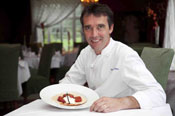 This winter Flahavan’s invited Kevin Dundon, celebrated proprietor chef of Dunbrody House Hotel, Arthurstown, Co Wexford to devise a ‘menu’ of Irish oat recipes, and these are the tempting ideas he came up with:
This winter Flahavan’s invited Kevin Dundon, celebrated proprietor chef of Dunbrody House Hotel, Arthurstown, Co Wexford to devise a ‘menu’ of Irish oat recipes, and these are the tempting ideas he came up with:Flahavan’s Creamy Porridge with Flambéed Plums, Orange Syrup & Crème Fraîche
Duncannon Fisherman’s Pie with Crumble Topping
Beef Casserole with Oatmeal Dumplings
Mixed Fruit Granola
Deep Filled Apple & Cranberry Crumble Pie
Slow Cooked Meals for Lovely Lazy Flavours
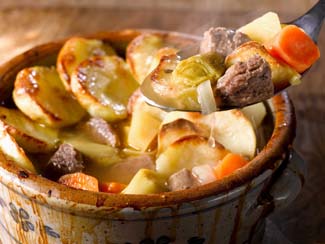
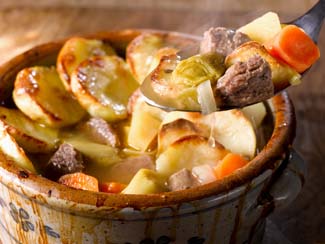 Fast food has come in for a right royal bashing lately and, with certain noble exceptions (stir-fries, for example), quite right too. The irony is that, in true tortoise and hare fashion, traditional slow cooking methods may actually be easier on your time than rushing to get a meal on the table in a hurry.
Fast food has come in for a right royal bashing lately and, with certain noble exceptions (stir-fries, for example), quite right too. The irony is that, in true tortoise and hare fashion, traditional slow cooking methods may actually be easier on your time than rushing to get a meal on the table in a hurry. Getting organised several hours ahead leaves you free to do other things while the dinner is gently cooking away – and, with slow cooking, you can use less expensive cuts of meat in slow roasts and casseroles that are meltingly tender and have loads more flavour than the pricey prime cuts.
Traditional dishes like Irish Stew and Beef & Guinness casserole make tasty comfort food that’s perfect for chilly days, but there’s plenty of variety using slow cooking methods, including great Sunday roasts that will give you a second meal for lunch next day; buying a bigger joint gives better value, and will cook better than smaller pieces of meat that may shrink and dry up too easily.
If you have an Aga or other range type cooker with a slow oven that’s ideal, otherwise you can use an electric slow cooker (which is very easy on the power bills) or any ordinary oven on a low setting.
Ask your local butcher about the best cuts to use for slow cooking, and look online for delivery services too, especially for free range pork, which is almost impossible to get in the shops. A fast-growing service that I’ve found reliable is Nigel Cobbe’s SimplySourced; they deliver nationwide.
Although free-range meats are perceived as expensive, online customers may be pleasantly surprised; you can choose boxed meats (casserole boxes from only €25) or create your own combination of cuts or right up to a full, bespoke butchered Saddleback pig! Just remember that rare breeds tend to be smaller (and more uneven in size) than mass produced animals – this should not be disappointing as they make up in flavour and texture anything they may lack in size.
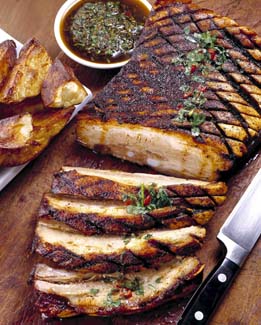 Paprika Spiced Pork Belly
Paprika Spiced Pork Belly Pork belly (also known as lap of pork) is currently trendy in restaurants, but tastes much better when cooked at home. It’s easy on the budget and is often the only cut available rind-on from butchers/supermarkets, who now tend to sell everything without the skin – so no delicious crackling.
Belly of pork makes brilliant crackling (and lots of it) and, although it may look fatty, much of the fat melts away during cooking to leave beautifully succulent meat.
This is a spicy dish, but the joint is also delicious cooked plain (ie simply scored and rubbed with a little salt) to serve traditionally with gravy, apple sauce and seasonal vegetables - an ideal candidate for a free-range roast.
Click here for recipe
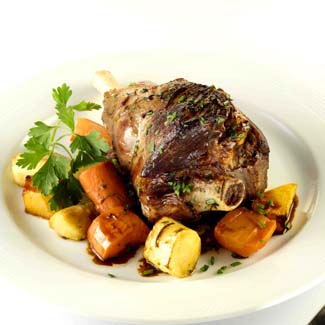 Lamb Shanks With Roast Root Vegetables
Lamb Shanks With Roast Root VegetablesThe ‘lamb’ we get at this time of year is actually hogget, ie one year old sheep – making it a bigger animal, of course, so roasting joints feed more mouths and all the meat is better value. Everybody loves shank of lamb and, although it’s one of the most popular dishes on menus, it’s easy and healthy to cook at home, as this recipe from Tim O’Sullivan of Renvyle House Hotel in Connemara explained in a recent IHF Happy Heart promotion.
Quantities are given for four, but lamb shanks vary in size and a large shank should serve two people. And it’s worth cooking extra shanks while you’re at it – any extras can be frozen together with their vegetables for a quick, hearty meal that you’ll be glad to come home to some cold evening.
Or, if you have leftover meat it can be used to make a tasty lunch the next day (see below).
Click for recipe
• LUNCH SUGGESTION:
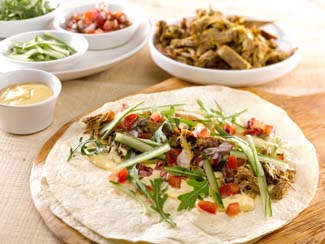 Lamb Wraps with Garlic Aoili & Tomato Salsa
Lamb Wraps with Garlic Aoili & Tomato SalsaYou could slow-cook a small shoulder of lamb, or an extra one or two lamb shanks, especially to make up these wraps with garlic aioli and tomato salsa, or you could use leftovers from the lamb shanks given above.
Either way, the meat should be so tender that it is easily shredded with a fork.
Click for recipe
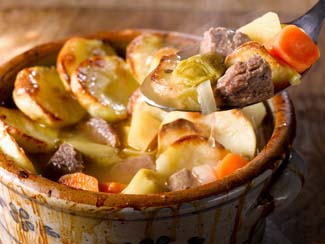 Lamb Hot-Pot
Lamb Hot-PotYou can use sweet-flavoured shoulder of lamb, gigot chops or inexpensive neck of lamb for this tasty stew, which makes a wholesome one-pot dinner for the whole family and needs only a fresh seasonal green vegetable to make it a completely balanced meal.
Click for recipe
Shop Smart, Cook Smart, Eat Smart
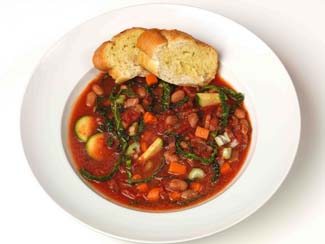
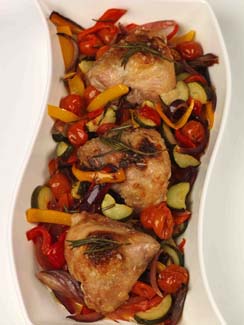 THE NHF* EAT SMART WEEK 19TH – 25TH APRIL 2010
THE NHF* EAT SMART WEEK 19TH – 25TH APRIL 2010With so many families now faced with reduced disposable income through wages cuts, redundancy and increased taxes, the Nutrition & Health Foundation (NHF) is asking people to see this as an opportunity to shop smart, cook smart and eat smart together, in order to establish a healthy diet for life for all the family - starting with Eat Smart Week (19th – 25th April).
Now in its fourth consecutive year, this innovative initiative from the NHF aims to show that healthy eating is achievable for everyone, regardless of their cooking experience.
This year, the NHF has teamed up with chef Rozanne Stevens, who has come up with 10 quick, nutritious and budget friendly one-pot wonders which can be made and enjoyed by everyone. Not everyone, male or female, knows how to cook, and many people are now faced with a new challenge of having to plan menus and find recipes the whole family will enjoy whilst on a restricted budget. Not only can this be challenging but also time consuming.
“With purse strings tightened, families have become more conscious of what they are spending on food every week,” says Dr Muireann Cullen, Manager of the Nutrition & Health Foundation. There is the temptation to buy what’s on special offer, rather than perhaps what’s best for nutrition.
Obesity levels are now at an all time high in Ireland with direct and indirect costs accounting for €4 billion** a year; it is imperative that people start to make the right choices when it comes to food shopping and eating.”
The tradition of planning ahead for cooking and shopping is something of a lost art now that most of us decide on our meals only the day before, or often on the same day. The most important factor influencing our choice of what to cook is the ingredients we have at home – and, of course, the amount of time we have available.
One-pot meals are an easy and time-efficient solution and, to illustrate how eating the smart way is not only sensible and vital, but also quick and fun, Rozanne has prepared ten ‘one-pot wonder ‘recipe suggestions. To make cooking at home as easy, accessible and affordable as possible, Rozanne has also prepared a freezer treasure list, a store-cupboard list and given her top ten tips.
Some sample recipes follow, together with a nutritional analysis for each one - you’ll find the full recipe collection and Rozanne’s Eat Smart Week lists and tips on the NHF website :
Hearty Tuscan Bean Soup
Easy Red Thai Fish Curry
Tray Baked Chicken and Mediterranean Vegetables
* The Nutrition & Health Foundation (NHF), is a multi-stakeholder partnership, involving industry, government, scientists, health professionals and other relevant stakeholders. It aims to provide consumers with evidence-based information about diet and physical activity and to promote healthy lifestyles.
**Report of the National Taskforce on Obesity (2005)]
Here Comes...Happy Heart Eat Out Month
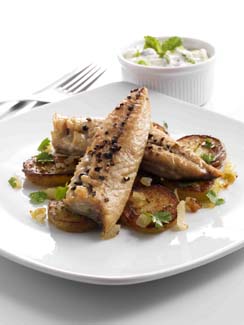 The Irish Heart Foundation, safefood and the HSE have joined together for this year’s Happy Heart Eat Out month, which runs in hundreds of participating restaurants, workplaces and communities across the length and breadth of the country throughout June.
The Irish Heart Foundation, safefood and the HSE have joined together for this year’s Happy Heart Eat Out month, which runs in hundreds of participating restaurants, workplaces and communities across the length and breadth of the country throughout June. Carrying the theme, ‘For a Happy Heart…Think Small’, the campaign hopes to raise awareness of portion sizes when eating out, in addition to encouraging people to choose healthy options from menus. A new Happy Heart Eat Out recipe booklet incorporating tasty and healthy recipes will be available in June, free of charge.
Participating restaurants, cafés and workplace canteens will be offering additional healthy options throughout June; plenty of fruit and vegetables and meals that are low in fat, sugar and salt and rich in fibre.
A well-balanced diet is very important for a healthy lifestyle, with portion size playing its role - smaller portion sizes are not only good for the waist, they are also good for the heart.
Well-known chefs that have contributed recipes include Kevin Dundon, Dunbrody House; Neven Maguire, MacNean House & Restaurant; Garrett Byrne, Campagne Restaurant and Oliver Dunne of Bon Appetit.
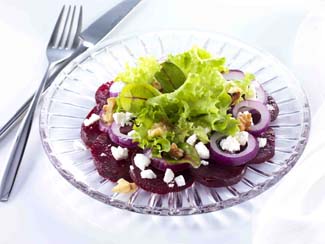 Beetroot, Red Onion and Feta Salad with Walnuts
Beetroot, Red Onion and Feta Salad with Walnuts This pretty recipe comes from Garrett Byrne, chef-proprietor of our Restaurant of the Year 2010, Campagne, in Kilkenny City. This dish is best served at room temperature.
Serves 4
Click for recipe
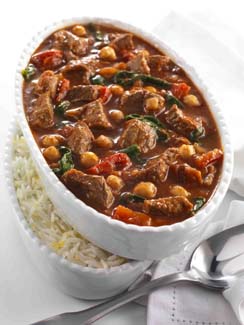 Cocido of Lamb
Cocido of LambThis attractive and economical casserole dish was devised for the Irish Heart Foundation by Roland Lambe of Darndale Community Training Centre, Dublin 17.
Chef’s Tip: If you find when cooking with a tomato based sauce that it is a little bitter, try adding some chunks of carrot during cooking, as it adds a natural sweetness. Alternatively roasted red peppers could be added at the end for extra flavour.
Serves 4
Click for recipe
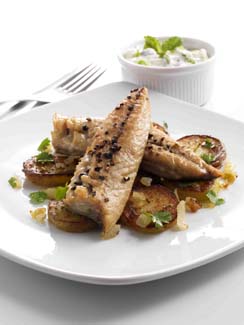 Grilled Mackerel Fillets with Indian Spiced Potatoes and Raita
Grilled Mackerel Fillets with Indian Spiced Potatoes and Raita Deirdre Connolly of the popular Dublin restaurant, Peploes, on St. Stephen’s Green created this unusual, gently spicy, mackerel starter.
Serves 4
Click for recipe
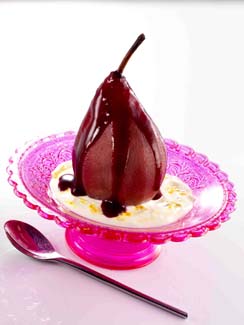 Spiced Poached Pears in Red Wine with Yoghurt
Spiced Poached Pears in Red Wine with YoghurtA colourful and healthy dessert with lots of flavour, from Julie Cox, of Beaufield Mews, Stillorgan, Co. Dublin.
Serves 4
Click for recipe
Guilt-Free Dining Out
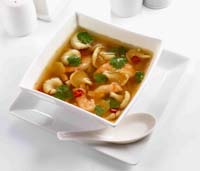
 Back by popular demand - we gave a taster of Happy Heart Eat Out Month in our last e-zine and there were so many requests for more that we said, sure, why not...
Back by popular demand - we gave a taster of Happy Heart Eat Out Month in our last e-zine and there were so many requests for more that we said, sure, why not...Small is beautiful when you’re dining out in June according to the Irish Heart Foundation (IHF), who have linked up with the HSE and safefood for this year’s Happy Heart Eat Out month. Running throughout June in hundreds of participating restaurants, workplaces and communities all over Ireland, the theme ‘For a Happy Heart...Think Small’ carries a simple message.
Eating healthily and well can be easy, colourful and fun when you’re enjoying a meal out, if you keep an eye on portion sizes – and that the delicious little dishes that are good for your waist are also good for your heart. To demonstrate the point, the IHF has collected tempting and very do-able recipes from some of Ireland’s favourite restaurants for a free recipe booklet, so you can cook them at home.
Top chefs who have contributed recipes include TV chefs like Neven Maguire of MacNean House & Restaurant and Kevin Dundon of Dunbrody Country House & Cookery School and other highly respected names including Garrett Byrne, of Kilkenny City’s leading restaurant, Campagne, and Oliver Dunne of the Michelin-starred restaurant, Bon Appétit in Malahide, Co Dublin.
Asked to come up with dishes with “plenty of fruit and vegetables and that are low in fat, sugar and salt and rich in fibre”, here are some more ‘that they made earlier’, for you to try for yourself at home.
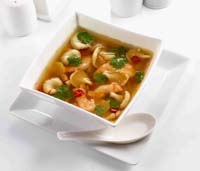 Tom Yaam Goong
Tom Yaam GoongThis traditional recipe for Spicy Prawn Soup with Thai Herbs comes from Chef Taweesak Trakoolwattana (Tao), of the popular Thai restaurant Saba, on Clarendon Street, Dublin 2.
Serves 4
Click here for recipe
 Chicken Skewers with Dried Fruit Couscous
Chicken Skewers with Dried Fruit CouscousThe Strawberry Tree at The Brooklodge Hotel & Wells Spa, Co. Wicklow is Ireland’s only certified organic restaurant. They lay great emphasis on the importance of quality ingredients and many of those suitable for producing in the Irish climate would be supplied from organic producers in the surrounding area.
Buying quality chicken is especially important and, when dining out, remember to ‘Just Ask, where it comes from if it’s not mentioned on the menu!
This aromatic, gently spicy recipe is from Tim Daly, chef at The Strawberry Tree.
Serves 4
Click here for recipe
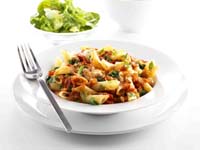 Rigatoni Pasta with Goats Cheese and Spinach Marinara
Rigatoni Pasta with Goats Cheese and Spinach MarinaraWineport Lodge is well known to viewers of RTE’s ‘The Restaurant’, as it has been the location for the show during the last few series of the programme. Beautifully located on the eastern shore of Lough Ree, near Athlone, Co. Westmeath, it is a gorgeous place for a real restaurant at other times and chef Cathal Moran makes sure that guests remember the dining experience as much as the view.
This tasty vegetarian dish is a home cooking suggestion from Wineport.
Serves 4
Click for recipe
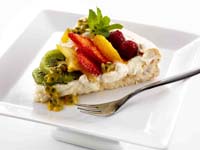 Exotic Fruit Pavlova
Exotic Fruit PavlovaPopular TV chef Neven Maguire is well known for his wonderful desserts. While simpler than the creations at his restaurant, MacNean House & Restaurant, at Blacklion, Co. Cavan, this colourful pavlova would be the highlight of any home cooked meal.
The meringue can be cooked the day before and kept in a cool place until needed – and the fruit selection can be varied according to the season, making this an all-year favourite.
Serves 4
Click for recipe
Tasty by Name, Tasty by Nature
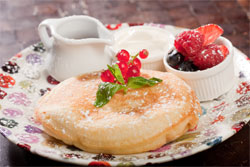
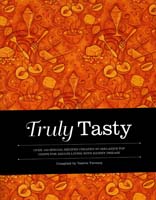 There has been great interest in the fabulous cookbook Truly Tasty (Atrium, hardback 332pp, original photography throughout; €19.95/£17.95), which was compiled by successful kidney transplant recipient, Valerie Twomey, as part of her ongoing campaign to promote organ donor awareness, with all royalties going to the Irish Kidney Association.
There has been great interest in the fabulous cookbook Truly Tasty (Atrium, hardback 332pp, original photography throughout; €19.95/£17.95), which was compiled by successful kidney transplant recipient, Valerie Twomey, as part of her ongoing campaign to promote organ donor awareness, with all royalties going to the Irish Kidney Association. And no wonder - who wouldn’t be glad of a bit of inspiration and guidance from the likes of Ross Lewis (Chapter One), Catherine Fulvio (Ballyknocken House & Cookery School), Derry Clarke (l'Ecrivain), Domini Kemp (Itsa4), Neven Maguire (MacNean House & Restaurant) and Rachel Allen, to mention only a few of the famous chefs who have each contributed recipes for a three-course meal to this unusual book.
But the response since we reviewed it recently shows just how many people are affected by kidney disease, either as patients or because someone in the family or a friend has to live within a special diet.
Over 30 top Irish chefs created special recipes for the book, which would make a great present for anyone living with kidney disease and includes dozens of tempting ideas both for everyday meals and for entertaining.
This extremely professional and handsomely produced book, edited by well known Irish Food Writers’ Guild member Lizzie Gore-Grimes and with beautiful food photography by Hugh McElveen, is backed up by a talented team, including Cork journalist Brian Moore, who interviewed every single chef for the book.
Used together as intended, the recipes allow kidney patients to escape from the usual limitations of the renal diet sheet, and individual dishes will seem quite normal for the ordinary cook too, making them ideal for entertaining without having to make a separate meal for a visiting (or resident) kidney patient.
And, judging by the quality of the book and the track record of the publisher, Atrium, Truly Tasty is set to become a classic – which would be extremely unusual for a special interest cookbook. Atrium, is an imprint of Cork University Press (www.corkuniversitypress.com), and they’re known for their carefully selected portfolio of cookbooks – all by outstanding authors.
They include Carmel Somers’ modern classic ‘Eat Good Things Every Day’, wonderful vegetarian books from both Denis Cotter of Café Paradiso and Eleanor Heffernan of Cornucopia; Paul Flynn’s highly original ‘The Tannery Cookbook: An Irish Adventure with Food’; and Dianne Curtin’s evocative stories of artisan food producers, ‘The Creators – The Individuals of Irish Food’.
What these gorgeous books all have in common, apart from excellent writing (and recipes that really work!), is beautiful photography and design, and top quality production standards, so what you get is books that you’ll enjoy for many years, and which make highly covetable gifts. So it should come as no surprise that Truly Tasty is both beautiful and highly practical– and in this case it is also truly unique.
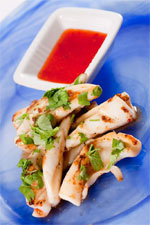 Fried Squid with Lime and Chilli Dressing
Fried Squid with Lime and Chilli DressingThis colourful Asian-inspired dish was adapted from a similar dish in my own book ‘From Tide To Table’ (out of print), and is very quick to prepare. It is important to cook the squid thoroughly for food safety, however be careful not to cook it for too long as it can become tough and chewy.
Click for recipe
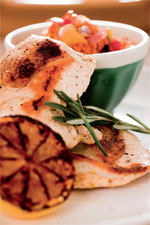 Tuscan Lemon Chicken with Provencal Couscous
Tuscan Lemon Chicken with Provencal Couscous This wonderfully summery dish comes from one of Ireland’s most original chefs, Paul Flynn, of the renowned restaurant and cookery school, The Tannery, in Dungarvan, West Waterford.
Click for recipe
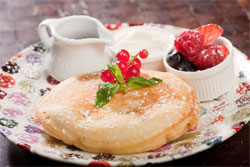 Fluffy American Pancakes with Mixed Berries & Yoghurt
Fluffy American Pancakes with Mixed Berries & Yoghurt These American pancakes are a bit like a light dropped scone or ‘pikelet’. The recipe is from a menu contributed to Truly Tasty by Peter Merrigan, head chef at Avoca Rathcoole, in County Dublin, who says, ”Remember cooking is all about enjoying yourself. Take your time, make mistakes – you can start again, but always use good ingredients.”
Click for recipe
Sea Harvest - Food For Free
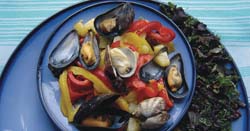
 With the nation’s foodie mindset already well tuned in to sustainable living – thousands of us started allotments this year, and no allotment is complete without its bijou chicken run – the next stage is to re-learn all the practical skills that our grandparents took for granted.
With the nation’s foodie mindset already well tuned in to sustainable living – thousands of us started allotments this year, and no allotment is complete without its bijou chicken run – the next stage is to re-learn all the practical skills that our grandparents took for granted. Darina Allen’s fantastic book Forgotten Skills of Cooking (Kyle Cathie, rrp €31.50) covers brilliantly all the jobs that would traditionally be done on a smallholding and in the domestic kitchen (with hundreds of recipes to match), and this mega-tome also includes a chapter on foraging which makes very interesting reading – although it’s a bit on the heavy side to bring with you!
If you’re having holidays anywhere on the coast, it could be even more fun if you set off on a mission to find out more about what edible plants grow near and in the sea – and how much free food you can put on your holiday table!
There are loads of books on ‘gastro-foraging’ these days, but the daddy of them all is Richard Mabey’s 1972 classic Food For Free which still available – and it’s currently on amazon.co.uk, from as little as £2.50 for a cute little book to fit a backpack. Mabey covers everything, including coastal plants and those that live ‘on the edge’ just above the tideline, like sea spinach and the keenly-sought samphire.
And then there is that other world – mysterious to many of us, but as familiar as the back garden to families living along the coast or on islands, who have grown up with the rhythm of the tides and the briney harvest that is revealed every twelve hours.
People like Sligo GP, Prannie Rhatigan, whose beautiful book Irish Seaweed Kitchen (€35) is the first comprehensive guide to harvesting, preparing and cooking Irish seaweeds, which she describes as “..a living treasure by the shore, more valuable by far than any golden coins that may lie buried beside it in the sand.”
And her book is a magnificent celebration of the beauty and riches of the Irish shoreline, with stunning photography, all the practical information you could want, lots of recipes and a light touch – there’s a sense of friends and family milling around, echoing the swirling seaweeds in the tide.
Ralph Waldo Emerson's definition of a weed as ‘a plant whose virtues have not yet been discovered’ is particularly true of seaweeds...
There are fifteen varieties of red, brown and green seaweed featured in The Irish Seaweed Kitchen, all detailed in a Glossary giving the (considerable) health benefits as well as culinary uses. And there is nothing ‘weird’ about any of them, as you’ll find out very quickly once they all become as familiar as carrageen already is to many cooks.
They can be used whole as a vegetable, or ground/flaked to use as a herb in cooking, or to sprinkle over food as a salt and/or pepper replacement. Dried or rehydrated seaweeds can also be eaten as a snack - duileasc was a favourite generations ago in Ireland, as nori/sleabhac is today in Japan – or as a recipe component.
Getting Going
To make the most of cooking with seaweed, Prannie recommends that a little planning will help people who have not previously used it in the kitchen.
• Start with easy to use seaweeds in simple recipes. Have a look at the seaweeds in the glossary/chart in the book, and perhaps add the following to your kitchen press:
• A pack of Alaria, a pack or jar of seaweed stock, ground nori, sheet nori, some sea spaghetti and kelp.
And if you can’t get down to the sea at the moment, Irish seaweed suppliers produce some really flavoursome mixes, worth checking out in your local health food store or deli. Prannie also includes a full list of Irish seaweed suppliers in the book, and web addresses for buying online.
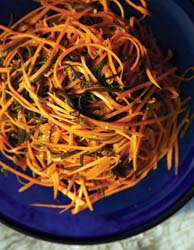 Carrot and Sea Spaghetti Salad
Carrot and Sea Spaghetti Salad Willowy sea spaghetti and delicate carrot strips combine with a sweet garlicky dressing to create this colourful salad. Easy to prepare, Prannie makes this salad regularly for demonstrations - it never fails to delight even first time seaweed tasters.
Seaweed used: sea spaghetti (very easy to recognise, the name says it all!)
Serves 4-6
Click for recipe
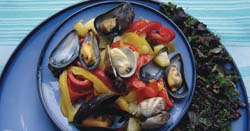 Potato Stir fry with Seaveg and Seafood
Potato Stir fry with Seaveg and SeafoodThe ultimate no fuss dinner - once the potatoes have been cooked (and sliced cooked day old potatoes also work well), the remainder of this delicious meal is quickly prepared in one pot. Can also be made vegetarian, without the seafood.
This recipe is from Manus McGonigle of Quality Sea Vegetables, Co Donegal, a seaweed harvester who enjoys the mix of seafood and seaweed readily available to him on the north west coast.
Seaweed Used: mixed Sea Vegetables
Serves 2
Click for recipe
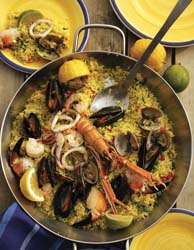 Seafood Paella
Seafood PaellaAlaria and sea spaghetti add the final layer of seafood flavour to this seafood dish, contributed by Donegal medics Paul and Bella Stewart.
Great for a special occasion and even more idyllic if you can cook it outdoors...
Seaweed Used: Alaria (the familiar wavy brown fronds, very widely available and used extensively in Irish Seaweed Kitchen) and sea spaghetti
Serves 4
Click for recipe
Go Organic!
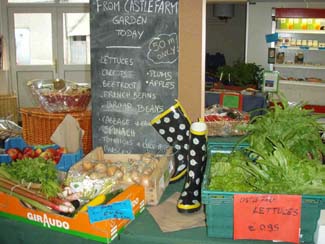
 Thinking back on it, it’s amazing how farming has changed in the last half century or so - for anyone growing up more than 50 or 60 years ago, organic farming was the norm; it didn’t need a label, it was just traditional farming.
Thinking back on it, it’s amazing how farming has changed in the last half century or so - for anyone growing up more than 50 or 60 years ago, organic farming was the norm; it didn’t need a label, it was just traditional farming. Then, after World War Two all that changed with the drive to increase yields dramatically and – crucially - to produce cheap food. Now we’re coming full cycle and seeing the damage that intensive production can bring with it, so good traditionally produced food (mainly, but not necessarily, ‘organic’) is regaining its well-deserved status.
Coming in out of the culinary wilderness at last, organic food is less a niche area these days: more people are producing organically in Ireland, and more consumers see it as a mainstream alternative when you care about the quality and provenance of what you’re putting into your mouth - and, especially, your children’s mouths.
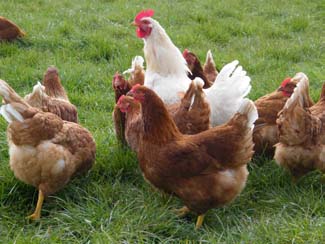 Something that’s harder to learn – given the economic climate and massive emphasis on low prices in all of our shops – is that quality has a value, so we must recognise that cheap food is a false economy, and unsustainable.
Something that’s harder to learn – given the economic climate and massive emphasis on low prices in all of our shops – is that quality has a value, so we must recognise that cheap food is a false economy, and unsustainable.We need to be prepared to spend more on food, to get quality and support local producers, but that should be seen as an investment – and lower health bills could well offset any extra food costs, with benefits such as reduced obesity levels putting less strain on the health system.
And we can also be more imaginative in the ingredients we choose, and make savings by opting for less expensive cuts of high quality food.
And, perfectly timed in early autumn when fresh seasonal Irish produce is at its most abundant, the annual National Organic Week celebrations have become a high point in the Irish foodie calendar.
Co-ordinated by Bord Bia (www.BordBia.ie/Organic_Week) and funded by the Department of Agriculture, Fisheries and Food, the week long campaign and promotional events runs aims to raise consumer awareness of organic food, how to recognise it when shopping and where to buy it.
 Event highlights during National Organic Week 2010 (13th-19th September) include a Darina Allen cookery demonstration promoting good value organic meat cuts in the Nano Nagle Centre, Ballygriffin, Co. Cork on Wednesday 15th.
Event highlights during National Organic Week 2010 (13th-19th September) include a Darina Allen cookery demonstration promoting good value organic meat cuts in the Nano Nagle Centre, Ballygriffin, Co. Cork on Wednesday 15th. And anyone considering setting up in organic production should head to Birr, Co. Offaly on Thursday 16th September, to attend Teagasc’s National Organic Conference entitled ‘Challenges and Opportunities for Organic Producers’.
Organic enthusiasts all over the country are organising events that make a great family day out. In the West over the weekend of 18th-19th September, for example, Beechlawn Organic Farm (www.beechlawnfarm.org) at Ballinasloe, Co. Galway is holding an Open Day; in the North-West, there’s a Garden Allotment Day and a Harvest Picnic at the beautiful Georgian country house Enniscoe House, at Castle Hill, Ballina, Co. Mayo - and, down in the South-West, there’s an Organic BBQ and activities at Milltown Organic Store and Market, Milltown, Co. Kerry.
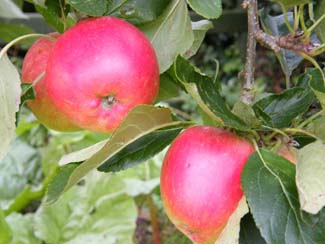 Nearer Dublin, a range of fantastic venues includes Castlefarm (www.castlefarmshop.ie) near Athy, Co. Kildare, where well known organic farmers Peter and Jenny Young will host a farm walk and vegetable harvesting day on Saturday 18th September, and they’re also cooking a spit roasted Castlefarm organic pig for lunch; then on Sunday19th there’s an afternoon farm walk (foraging for crab apples and learning about bees and honey), followed by a cookery demonstration – and lots of organic goodies to buy from the farm shop too, of course.
Nearer Dublin, a range of fantastic venues includes Castlefarm (www.castlefarmshop.ie) near Athy, Co. Kildare, where well known organic farmers Peter and Jenny Young will host a farm walk and vegetable harvesting day on Saturday 18th September, and they’re also cooking a spit roasted Castlefarm organic pig for lunch; then on Sunday19th there’s an afternoon farm walk (foraging for crab apples and learning about bees and honey), followed by a cookery demonstration – and lots of organic goodies to buy from the farm shop too, of course.Also on Sunday 19th September, Peter Ward from Country Choice, Nenagh , Co. Tipperary is organising the annual Blas an Fhomhair organic harvest lunch, a magnificent celebration of local organic produce with guest chef Hugo Arnold doing the honours.
Wherever you live, it’s all ‘go organic’ this month, so get out and enjoy it, buy some lovely seasonal organic produce – and then cook up something tasty for friends and family when you get home.
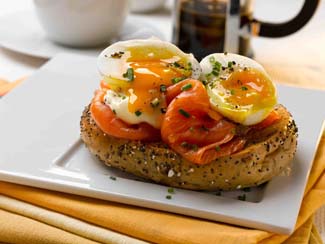 Soft Boiled Organic Eggs and Organic Smoked Salmon Bagels
Soft Boiled Organic Eggs and Organic Smoked Salmon BagelsIrish organic smoked salmon is farmed in the deep, strongly tidal waters off Clare Island in Co Mayo, and renowned for its flavour and muscular texture.
It goes perfectly with organic eggs – which are now becoming more widely available, as more organic producers go into poultry and egg production. If preferred, the salmon in these bagels could be replaced with slices of cooked ham - or try wilted spinach for a vegetarian alternative.
Serves 4
Click for recipe
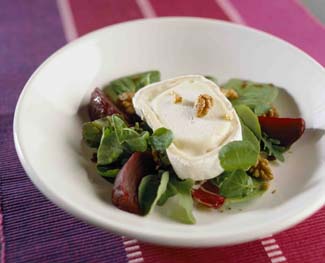 Beetroot, Goats' Cheese and Walnut Salad
Beetroot, Goats' Cheese and Walnut SaladThe simplicity of this pretty dish allows quality ingredients to speak for themselves: with its lovely delicate herbal flavours, St Tola goats’ cheese from Co Clare contrasts well with sweet and deeply coloured beetroot to make a deliciously subtle starter or light lunch.
Be careful to use fresh walnuts, as they spoil and take on a bitter flavour when stored for too long.
Serves 2-4
Click for recipe
 Greek-style Organic Lamb Kebabs with Yoghurt Dressing
Greek-style Organic Lamb Kebabs with Yoghurt DressingOrganic lamb benefits from the extra herbs and floral flavours that a natural farming system encourages – especially the late season lamb raised in mountainous areas, such as Connemara and Kerry, which is in season now.
Organic vegetables, herbs and yoghurt (eg Glenisk) are all now widely available, from farmers’ markets, specialist stores and good supermarkets. These kebabs would be delicious cooked either on the barbecue or under the grill.
Serves 4
Click for recipe
 Organic Apple Tart with Whiskey Flavoured Custard
Organic Apple Tart with Whiskey Flavoured CustardThis recipe is a classic favourite from that great Euro-Toques chef John Howard, formerly of Dublin’s celebrated restaurant Le Coq Hardi.
You won’t find Irish organic sugar for it, alas (although you could substitute organic Irish honey in the tart itself) but Billington’s is widely available, and I find it noticeably different from ‘ordinary’ sugar.
Organic Irish apples are in season and, together with the cream and eggs, should be easy to source, along with organic ice cream to serve with the tart – not sure about the whiskey!
Serves 4
Click for recipe
Cookery Feature - Ireland for Food Lovers
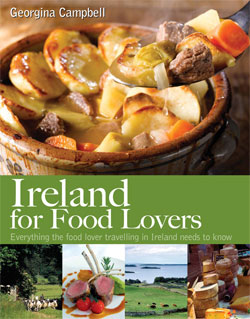
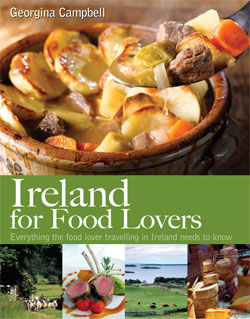 Visitors to Ireland often seek simple traditional food based on local ingredients, as it has a real sense of place - and, although this kind of food has been out of favour with many Irish residents in recent years (and therefore harder to find than it should be), it is now deservedly enjoying renewed popularity.
Visitors to Ireland often seek simple traditional food based on local ingredients, as it has a real sense of place - and, although this kind of food has been out of favour with many Irish residents in recent years (and therefore harder to find than it should be), it is now deservedly enjoying renewed popularity. Ireland for Food Lovers is not primarily a cookery book, but some recipes based on the foods of each region have been included for home cooks to enjoy. The recipes have been selected for simplicity and - although there are of course many excellent contemporary and international dishes to be enjoyed throughout Ireland - with a bias towards the homely and traditional.
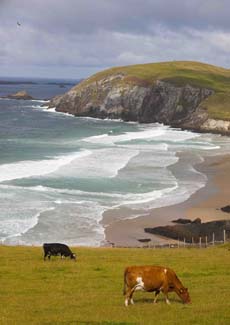 These are the kind of dishes that reflect the foods produced in Ireland over many generations, and that suit our weather and the changing seasons.
These are the kind of dishes that reflect the foods produced in Ireland over many generations, and that suit our weather and the changing seasons. Comfort food par excellence, traditional Irish dishes are perhaps at their best in the colder months, so trying these three dishes taken from the South-West, East and North regions could be a good excuse to spend more time in your cosy kitchen.
"What a lovely, lovely book! There should be a copy on show in every Irish embassy in the world...so comprehensive & so beautifully produced" Myrtle Allen
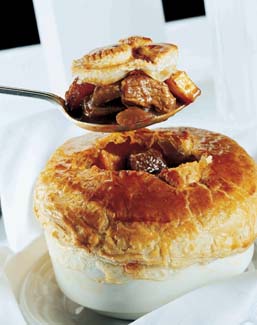 Kerry Lamb Pie
Kerry Lamb Pie The meats of any area are very much a product of the environment, and traditional Kerry black-faced mountain lamb reflects the rugged conditions and natural production methods of the area. It is a seasonal treat – the prized meat of these hardy, lean animals has the special flavours of the heather, wild herbs and grasses they feed on and is available late season (July-November approx).
Another particular speciality is the Blasket Island lamb. The product of the salt-sprayed heathery pastures of this small group of uninhabited, but much-visited, islands 3km/1.5m off Dingle peninsula (www.blasketislands.ie), the meat is comparable to the famous pré-salé (salt marsh) lamb of Normandy and Brittany, with yet an extra ‘je-ne-sais-quoi’; supplies are very limited, so catch it if you can when in the area.
This very modern take on the traditional Kerry pie is light years away from the original that inspired it, but very tasty nonetheless - and it was chosen to be included in Ireland for Food Lovers because it is true to the spirit of the original dish while having contemporary appeal. It is adapted from the cookbook Roly's Bistro, The Restaurant and Its Food (Gill & Macmillan), and has been a favourite dish at the perennially popular Dublin restaurant for many years.
Kerry lamb pies – or, more particularly, Dingle Pies – were modest little mutton pies, not unlike Cornish pasties; the shortcrust pastry was made with mutton fat and the pies were often boiled in mutton stock, rather like dumplings.
Today’s modern versions are lighter (and probably more palatable); Piog Pies, of Dingle, include a Kerry lamb & vegetable pie in their handmade range.
The filling for these pies could be made ahead and cooled, leaving only the pastry and oven baking to finish before serving.
Click for recipe
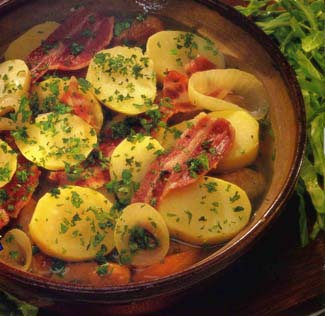 Dublin Coddle
Dublin Coddle Dublin is frequently hailed as a ‘vibrant young multicultural city’ - as, in many ways, it is and its recently settled multi-cultural population has brought unprecedented change (and variety) to its food - yet many visitors, and indeed residents, still wish to seek out the great traditional foods and drinks.
While street vendors hawking ‘cockles and mussels’ may be a thing of the past (or, at any rate, they have moved into the markets these days) unique dishes like Dublin Coddle (a simple stew of sausages, bacon, onion and potato) tell their own social history.
Although they have been out of favour in recent years, these specialities are still made and are now enjoying a revival of interest. Few of the specialist pork butchers that supplied the ingredients for Dublin Coddle and were so much a part of the city’s everyday life remain, alas, although many that do, such as J. Hick & Sons of Dun Laoghaire, are outstanding – and, of course, the ingredients are widely available from other butchers.
Said to be Dean Swift’s favourite meal, this traditional dish is every bit as comforting as it sounds; made on pay day or on Saturday nights, it is a very forgiving dish and always welcoming, whatever the time.
It combines two foods known since the earliest Irish literature - bacon and sausages - and, like all very simple dishes, success depends on the quality of the ingredients, so use the very best sausages you can find, and good dry-cured bacon.
The traditional version is a simple stew; this modern variation (“Campbell’s Coddle”) is made with the same ingredients but has a crispy topping.
Click for recipe
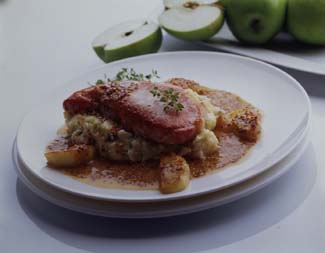 Bacon Chops with Apple & Cider Sauce
Bacon Chops with Apple & Cider Sauce Mention Fermanagh and the chances are that the response will be ‘Fermanagh black bacon’ – in a county famous for its pork, this special product made (and trade-marked) by Enniskillen butcher Pat O’Doherty has earned its place in the foodie hall of fame.
The O’Dohertys keep their own herd of free range Saddleback pigs on Inishcorkish Island on Upper Lough Erne, and the product is a great credit to both the standard of meat and the artisans who make it into unique dry-cured Fermanagh black bacon.
Visits to the island can be arranged by appointment, and the shop in Enniskillen is a must-visit too - a model Northern Ireland butchers.
Pork, apples and cider are traditional companions and make especially good partners for some of the great products of the region, including Armagh apples.
Pork chops could be used instead of the bacon chops suggested; either way it’s the kind of meal you don’t tire of – good, simple comfort food.
Click for recipe
Cookery Feature - Casual Festive Entertaining
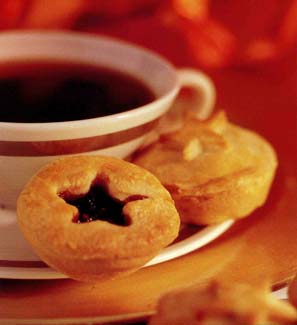
 Whether you’re planning to have people around for a drink or just like to be prepared for unexpected guests, everyone needs a few tasty standby dishes to hand at this time of year. We’ve all been to parties where the finger food falls apart and ends up down the front of your best dress, so what’s needed is something more robust that not only tastes good but is also easy to manage.
Whether you’re planning to have people around for a drink or just like to be prepared for unexpected guests, everyone needs a few tasty standby dishes to hand at this time of year. We’ve all been to parties where the finger food falls apart and ends up down the front of your best dress, so what’s needed is something more robust that not only tastes good but is also easy to manage. These tried and tested recipes are just the job – no hassle to prepare, no soggy crackers with stale toppings made up too far ahead (use bread instead where possible anyway – it’s more filling and provides better soakage).
These recipes are very versatile too, as most of them can be made in bite-size or meal size versions.
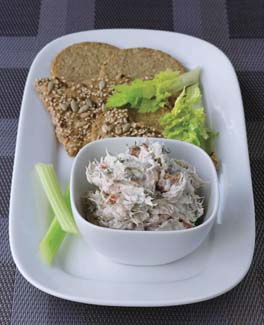 Smoked Mackerel Paté
Smoked Mackerel PatéSmoked fish is especially useful at Christmas and this economical paté is great as a starter, or for serving as a dip or canapés when entertaining. Smoked trout or hot smoked salmon can be used instead of smoked mackerel if preferred.
Serves 4-6 as a starter (or as a quick and easy snack served on hot toast), and makes enough for a fair-sized crowd when offered along with three or four other snacks.
450g/1lb smoked mackerel fillets
75g/3oz cream cheese
75g/3oz crème fraîche
1-2 tbsp creamed horseradish
dash of Tabasco sauce
juice of 1/2 lemon
salt and freshly ground black pepper
To Serve: celery sticks and selection of crackers and/or brown bread or melba toast
Remove the skin from the mackerel fillets and discard any bones, then break up the flesh into a bowl.
Add the cream cheese, crème fraîche, one tablespoon of the horseradish, the Tabasco and lemon juice.
Mix thoroughly until well combined, then taste and add the remaining horseradish, if liked. Season to taste and transfer to a serving bowl.
Set the bowl of smoked mackerel paté on a platter and add a selection of crackers and/or breads and celery sticks for guests to help themselves.
Can also be served as canapés, but don’t make them up too far ahead.
 Spiced Beef with Fruity Chutney
Spiced Beef with Fruity ChutneyTraditional spiced beef makes the perfect contrast to turkey and it’s great to have it on standby for quick meals (as part of a buffet with a choice of salads, perhaps) and substantial party snacks.
Spiced beef can be prepared at home but good butchers offer their own house versions; this makes a good investment at such a busy time, and the cooking is then very simple.
2½–3kg/3-4lb joint of spiced beef
Place the beef in a deep casserole dish as near to its size as possible.
Add 250ml/½ pt water and cover tightly.
Cook in a very low oven, Gas Mark /140°C/275°F for five hours.
Leave the joint to cool in its liquid for 2-3 hours and then remove and wrap it in tinfoil. Store in the fridge until you need it, and then slice thinly to serve with salads or make up into bite-size canapés using brown bread and a fruity chutney.
This Apricot and Almond Chutney is equally good served with spiced beef or a wedge of farmhouse cheese and brown bread - and, presented prettily with a handwritten label, it makes a lovely small gift too.
Makes 1 litre/ 13/4 pints
450g/1lb dried apricots, chopped (no-soak apricots are very convenient)
225g/8oz brown sugar
1 onion, chopped
500ml/18fl oz wine vinegar
1 cooking apple, chopped
2 tbsp fresh root ginger, grated
½ tbsp coriander seeds, toasted and crushed
75g/3 oz almonds, blanched and roughly chopped
Dash of Tabasco and salt
Mix all of the ingredients together in a large saucepan.
Heat gently, stirring all the time, until the sugar has dissolved, and then simmer for about an hour (don't overcook).
Spoon into warmed, sterilised jars and seal immediately.
Stored in a cool dark place, the chutney will improve with keeping.
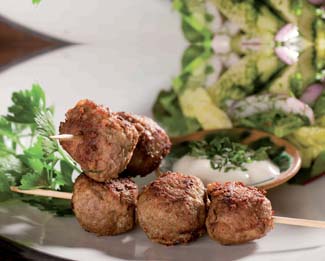 Spicy Lamb Meatballs
Spicy Lamb MeatballsLamb meatballs are always popular and this is another very versatile dish, equally suited to ‘proper meals’ or for serving in small portions as a party bite and offered with a dip, as given here.
This version was contributed to the charity cookbook ‘Zest’ (Irish Hospice Foundation) by Rachel Allen.
Makes 25-30 meatballs
450g/1lb minced lamb
1 level tsp ground cumin
1 level tsp ground coriander
3 green cardamom pods (split open and extract the seeds)
4 garlic cloves, crushed or grated
1 small egg, beaten
2 tbsp olive oil
A pinch/ 1⁄4 level tsp freshly ground black pepper
For The Mint Yoghurt
250g/9oz thick Greek yoghurt
1 level tbsp fresh/frozen mint, chopped
Juice of half a lemon
A pinch/ 1⁄4 level tsp, freshly ground black pepper
Preheat the oven to 230ºC/450ºF/Gas 8.
To make the meatballs, mix all the ingredients except the olive oil together.
With slightly wet hands, make little balls, slightly smaller than a walnut shell – about 2cm/3⁄4in diameter. (This amount should make 25–30).
Heat up the olive oil in a frying pan, add the meatballs and toss over high heat to brown, then transfer into a roasting tin and finish in the oven.
While the meatballs are cooking, blend all the Mint Yoghurt ingredients together to make a dip. Taste for seasoning and turn into a bowl for serving.
Spike the meatballs onto cocktail sticks and arrange on a platter; serve hot, with the dip on the side.
 Mince Pies are perhaps the most convenient of all the traditional Christmas foods, as they can be made up at any time and kept in the freezer, uncooked, to have hot from the oven at very short notice whenever you like.
Mince Pies are perhaps the most convenient of all the traditional Christmas foods, as they can be made up at any time and kept in the freezer, uncooked, to have hot from the oven at very short notice whenever you like. Short pastry is traditional and can be slightly sweetened, or you can use puff pastry if preferred. If using bought mincemeat, choose Irish if possible and buy the best you can afford; this recipe originally came from SuperValu, who are very supportive of Irish producers.
If using a commercial mincemeat it can be improved very simply by adding some finely chopped fresh apple to the mixture.
Standard tart tins make twelve to a sheet but you can get 24 hole non-stick mini tart tins that are ideal for mini mince pies and other finger food from Kitchen Complements on Chatham Street, Dublin 2; 01 677 0734 (or online from www.kitchencomplements.ie).
450g/1lb mincemeat
Pastry:
225g/8oz plain flour
125-175/g 4-6oz butter
pinch of salt
1 dessertspoon icing sugar
a little water to bind
Eggwash
Rub butter into dry ingredients until crumb-like.
Add the liquid, mix lightly to bind the mixture, then leave to rest.
On a floured work surface, roll pastry out until quite thin.
Cut out 7.5cm/3-inch rounds (for standard mince pies, half size for mini ones) and line into shallow bun trays.
Put a good teaspoon of mincemeat into each tin.
To decorate the tops (which can be slightly smaller than the bases), cut a star or tree shape into the pastry if you wish.
Dampen the edges and position the tops, sealing the edges by pressing with a fork or your fingers.
Brush with a little egg wash (beaten egg diluted with water) and bake at 180°C/350ºF for 30 minutes, or until crisp and golden brown. (Mini pies will take less time). Serve warm.
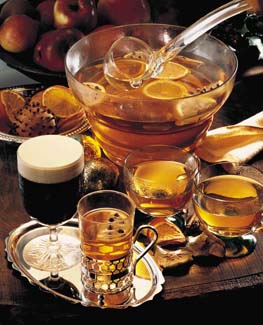 Mulled Cider is an economical alternative to mulled win for large numbers and many people prefer the lighter flavour. Unlike (most) wine, cider is made in Ireland so, while enjoying your party mull, you can also have the satisfaction of supporting Irish producers - and a non-alcoholic version can be made using natural Irish apple juice.
Mulled Cider is an economical alternative to mulled win for large numbers and many people prefer the lighter flavour. Unlike (most) wine, cider is made in Ireland so, while enjoying your party mull, you can also have the satisfaction of supporting Irish producers - and a non-alcoholic version can be made using natural Irish apple juice. Makes about 16-18 glasses.
l litre/ 13/4 pints apple juice
2 litres /4 pints medium sweet cider
2 lemons, sliced and studded with cloves
2 cinnamon sticks
Blend all the ingredients together in a saucepan. Heat through over a low heat and infuse for 15-20 minutes, without allowing to boil. Strain and serve hot.
Hint: If you have a slow cooker, use it to keep punches hot between servings.
Beer drinkers may well prefer Mulled Ale, which is also very easy to make, and can be made with one of the growing number of craft beers now produced in Ireland – and it’s especially handy for anyone who makes their own beer. For 3 mugs - multiply as required:
1 pint/600 ml mild beer (preferably draught)
Grated nutmeg
Pinch each of powdered allspice, ginger, cinnamon, coriander
Twist of lemon zest
1 tablespoon demerara sugar
1 tablespoon something to give it a kick, eg rum or brandy.
Bring the beer almost to boiling point, season with the spices and add the lemon and sugar. Stir to dissolve the sugar and, just before serving, add the spirit or fortified wine of your choice.
Treats for Your Sweet

 Our national love affair with chocolate continues apace. Now pretty much synonymous with indulgence at Christmas, Easter and Valentine’s Day, it seems that any excuse will do - and, in fairness, we have an exceptional choice of very high quality gift ranges to choose from: see Ireland For Food Lovers for details of over twenty of our top producers, many of whom can supply online.
Our national love affair with chocolate continues apace. Now pretty much synonymous with indulgence at Christmas, Easter and Valentine’s Day, it seems that any excuse will do - and, in fairness, we have an exceptional choice of very high quality gift ranges to choose from: see Ireland For Food Lovers for details of over twenty of our top producers, many of whom can supply online. And serious chocoholics should head for Dublin’s Merrion Hotel where a unique culinary extravaganza, ‘We Love Chocolate’ (11-20 Feb 2011) marks the launch of the hotel’s signature chocolate, handmade with fair trade organic 68.7% cocoa in asssociation with the world’s leading professional supplier of high-quality cocoa, Barry Callebaut. (Dirk Schonkeren of Helena Chocolates in Castlebar is Callebaut’s World Chocolate Ambassador for Ireland – see Ireland For Food Lovers for details.)
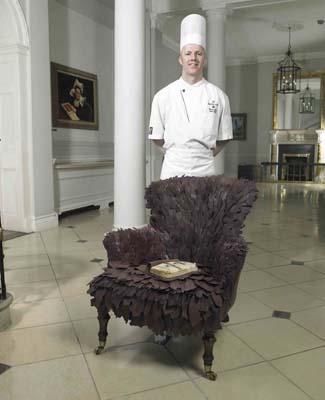 Executive Chef Ed Cooney and a team of chocolate artisans plan to thrill guests from the moment they arrive at The Merrion throughout the ten day ‘choctastic celebration’, and The Cellar Restaurant even offers a decadent four course chocolate inspired menu complete with Head Pastry Chef Paul Kelly’s luscious chocolate dessert. And they even have chocolate treatments on offer at the hotel’s Tethra Spa...
Executive Chef Ed Cooney and a team of chocolate artisans plan to thrill guests from the moment they arrive at The Merrion throughout the ten day ‘choctastic celebration’, and The Cellar Restaurant even offers a decadent four course chocolate inspired menu complete with Head Pastry Chef Paul Kelly’s luscious chocolate dessert. And they even have chocolate treatments on offer at the hotel’s Tethra Spa...But you don’t have to go anywhere, or spend a lot of money, to enjoy special chocolate treats – if it’s the thought that counts, why not invest a little time instead and create some treats for your sweet at home?
The following recipes are from baking specialists Dr. Oetker – an international operation with its headquarters in Germany, this fourth generation family business credits its success to their belief that “quality is the best recipe”.
They also have an Irish company based in Dublin, and small producers here may take inspiration from the fact that they started off with one product (baking powder) in 1891, and – thanks to quality that ‘guaranteed success every time’ – the home baking and baking ingredients are still at the core of business which has grown to include new brands and a range of innovative products.
***Heart-shaped cookware is available in Ireland from kitchen specialists, eg www.kitchencomplements.ie; www.kitchencookware.ie; www.kitchendresser.net; www.quirkykitchen.ie
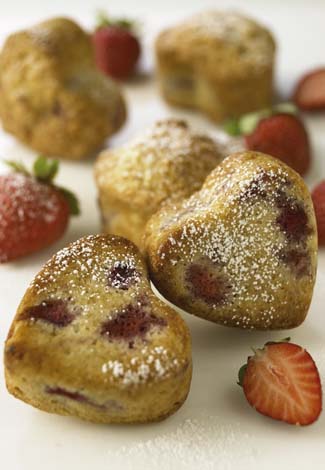 Strawberry Delight Muffins
Strawberry Delight MuffinsClick for recipe
 Mini Amaretto Chocolate Hearts
Mini Amaretto Chocolate HeartsClick for Recipe
Valentines Muffins
Click for recipe
Traditional Treats
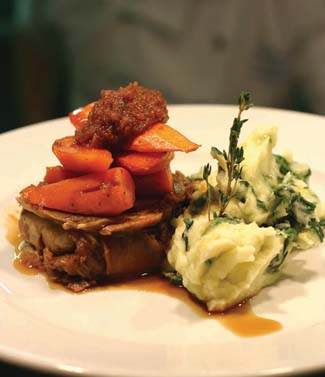 A recent correspondence with an American food writer has got me thinking about St Patrick’s Day traditions, both here in Ireland and across the pond.
A recent correspondence with an American food writer has got me thinking about St Patrick’s Day traditions, both here in Ireland and across the pond. It’s interesting that there’s a dish - corned beef and cabbage - universally cooked (but not universally enjoyed, so I hear) to celebrate the day in the USA, whereas here in Ireland we take a much more casual view with ‘anything traditional’ fitting the bill pretty well, whether it be bacon and cabbage, Irish stew, beef & Guinness, or a number of other old favourites.
Corned beef & cabbage has if anything fallen out of favour in Ireland in recent years, which is really a shame as, when well cooked (and well sourced from a good butcher), it can be really delicious – and not just for St Patrick’s Day, but at any time when the weather and the occasion demand comfort food. Slight variations can be an improvement and the version given here is a real winner.
And, with many more meals in several months’ time in mind, don’t forget that St Patrick’s Day is traditionally the day to plant the first potatoes! Even if you don’t have a garden you can grow a few in a tub or a grow-bag – and there’s nothing more satisfying (or delicious) than eating your own new potatoes in about 12 weeks’ time.
Corned Beef and Colcannon With Maple Roasted Carrots
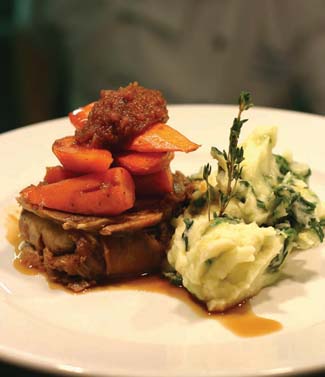 This recipe is from Paul Flynn’s cookbook, Second Helpings, Further Irish Adventures with Food (ISBN 1-903464-84-6).
This recipe is from Paul Flynn’s cookbook, Second Helpings, Further Irish Adventures with Food (ISBN 1-903464-84-6). Paul is proprietor-chef of the renowned restaurant and cookery school, The Tannery, in Dungarvan, Co Waterford, and has for many years been well known for his commitment to using local produce.
He makes this comforting dish in autumn and throughout the colder months – it’s ideal for a blustery March day and should certainly convert anyone who thinks they ‘don’t like corned beef’. Some lightly cooked spring cabbage would also be a welcome addition, as a side vegetable.
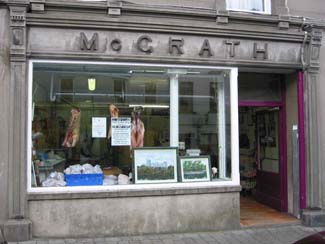 “Once September comes I reintroduce my standing order from Michael McGrath in Lismore,” says Paul, “His corned beef is the stuff of legend; all I have to do is boil it in water, removing the scum every now and then. Michael uses brisket. I find it has a very agreeable fat to meat ratio, which is essential with any cut of meat.
“Once September comes I reintroduce my standing order from Michael McGrath in Lismore,” says Paul, “His corned beef is the stuff of legend; all I have to do is boil it in water, removing the scum every now and then. Michael uses brisket. I find it has a very agreeable fat to meat ratio, which is essential with any cut of meat. Boil your beef earlier in the day and just reheat it in the juice when almost ready to eat. In the meantime, concentrate on your colcannon and roasting your carrots. The colcannon will be creamy enough so you won't need a sauce. A little English mustard or apple chutney will complete the dish.” (Paul’s recipe for Apple Chutney is given in Second Helpings.)
Click for more
Rhubarb Bread and Butter Pudding
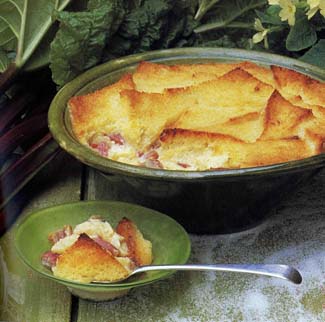 Although not officially classed as a fruit, rhubarb is usually seen as the first fruit of the Irish gardening year and is available (forced) from February onwards. It makes a pretty and deliciously refreshing late winter/early spring treat, and is then available throughout the summer, when it makes one of the easiest and most popular cottage garden ‘fruits’.
Although not officially classed as a fruit, rhubarb is usually seen as the first fruit of the Irish gardening year and is available (forced) from February onwards. It makes a pretty and deliciously refreshing late winter/early spring treat, and is then available throughout the summer, when it makes one of the easiest and most popular cottage garden ‘fruits’. This unusual hot dessert is from A Year at Ballymaloe Cookery School, by Darina Allen (ISBN 978-1-85626-709-0) of Ballymaloe House & Cookery School and it’s perfect for rhubarb, balancing its naturally sour flavour with the blandness of bread and the richness of dairy products as well as some necessary sugar.
Click for more
Home-Produced Treats

 Homegrown talent, quality & integrity were honoured at the 2011 Irish Food Writers’ Guild Food Awards - highlighting the vital work of small, independent Irish food producers, at a time when supporting home-grown industry is of the utmost importance.
Homegrown talent, quality & integrity were honoured at the 2011 Irish Food Writers’ Guild Food Awards - highlighting the vital work of small, independent Irish food producers, at a time when supporting home-grown industry is of the utmost importance.Those awarded for standards of excellence and for their exceptional contribution to Ireland’s reputation as a top food producing country were: Janet Drew for Janet’s Country Fayre Beetroot Blush (Wicklow); Brian and Lindy O’Hara for Coopershill House Irish Venison (Sligo); Pat O’Neill for O’Neill Foods’ Dry Cured Rashers, Bacon and Ham (Wexford), with a special Environmental Award going to John Flahavan of Flahavan's (Waterford).
In addition, artisan baking innovator, Derek O’Brien, head of the Baking Academy of Ireland and a former head of the Baking Department at DIT, was honoured with the Guild’s seldom-awarded Lifetime Achievement Award for his continuing dedication to passing on skills to the next generation and ensuring the survival of traditional craft baking in Ireland.
Now in its 17th year, the Irish Food Writers Guild (IFWG) Food Awards promote and reward the highest quality produce and have been described as the most important food awards in Ireland. The awards focus on recognising and rewarding indigenous, independent producers that are the lifeblood of the food industry in Ireland.
 The Guild warned against failure to support local producers, and IFWG Chairperson, Orla Broderick, said, “Now more than ever, we need to be supporting our local producers, many of whom are suffering as a result of rising costs; cheap, low quality imports and our contracted economy…If retailers fail to make room on the shelves for our indigenous producers and if we, as consumers, fail to support them, we will in a short space of time witness the demise of dozens of small and medium-sized producers, who will simply be squeezed out of business. This will affect not only Ireland’s food producing capabilities but will also have a significant impact on jobs.”
The Guild warned against failure to support local producers, and IFWG Chairperson, Orla Broderick, said, “Now more than ever, we need to be supporting our local producers, many of whom are suffering as a result of rising costs; cheap, low quality imports and our contracted economy…If retailers fail to make room on the shelves for our indigenous producers and if we, as consumers, fail to support them, we will in a short space of time witness the demise of dozens of small and medium-sized producers, who will simply be squeezed out of business. This will affect not only Ireland’s food producing capabilities but will also have a significant impact on jobs.”Outlining the selection process for the shortlist of award winners, Ms Broderick said: “We are not confined by the size of the company nor indeed product categories. What’s important and unique about these awards is that no food producer can enter for an award. No company ever even knows that it is being considered for an award until the judging is complete and we make contact with the winners. Our criteria is strict but straightforward - the products, traditional or innovative, must be produced in Ireland and the main ingredients must be home produced.”
The IFWG Food Awards were presented by one of Ireland’s best known chefs, Darina Allen. Darina commented, “Ireland is one of Europe's largest dairy and beef exporters, and home to several world-class firms and hundreds of food artisans. All this comes at a time when the global demand for food is projected to increase by 70% over the next 40 years. The affluent world is demanding locally grown, non-polluting, traceable, transparent food, exactly what we in Ireland can produce. Thus, recognising the opportunities for Ireland Inc., we need to encourage the brightest and best to pursue a career in all aspects of food production, distribution and marketing to drive the Irish food industry into the future.”
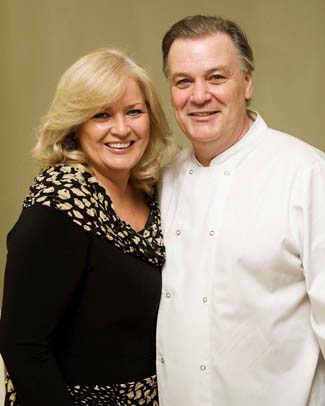 The IFWG Awards are supported by Bord Bia and, following each year’s presentations, Derry and Sallyanne Clarke host a lunch for guests at their acclaimed Dublin restaurant, L'Ecrivain.
The IFWG Awards are supported by Bord Bia and, following each year’s presentations, Derry and Sallyanne Clarke host a lunch for guests at their acclaimed Dublin restaurant, L'Ecrivain. Following the judging, Derry is given details of the award winning products and he then creates a bespoke menu of dishes designed to showcase each product. Recipes for the dishes served at the 2011 IFWG Food Awards lunch are given below.
RECIPES CREATED BY DERRY CLARKE FOR THE IRISH FOOD WRITERS’ GUILD AWARDS 2011
Whiskey cured smoked salmon with Janet’s Country Fayre Beetroot Blush and citrus mayonnaise
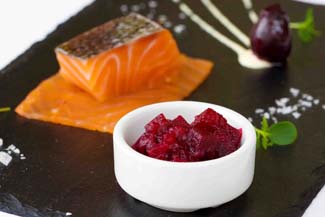 Serves 4
Serves 4Click for recipe
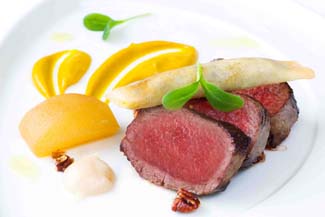 Coopershill House Irish Venison loin with pumpkin purée and a black pudding filo cigar
Coopershill House Irish Venison loin with pumpkin purée and a black pudding filo cigarServes 4
Click for recipe
Flahavans mille feuilles flapjacks with lemon cream
 Serves 4
Serves 4Click for recipe
A Taste of Mayo's Gourmet Greenway
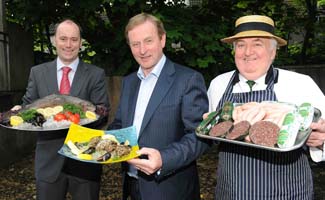
 As Lucy Madden mentions in this month’s Insider View, the magnificent Great Western Greenway in Co Mayo opened in 2010.
As Lucy Madden mentions in this month’s Insider View, the magnificent Great Western Greenway in Co Mayo opened in 2010. The longest off-road walking and cycling trail in Ireland, it meanders 17.5km along the line of the famous Newport/Mulranny Railway, which closed in 1937. Its route runs from the back of Mulranny Park Hotel (formerly the railway hotel) to Newport, and it’s a wonderful outdoor experience.
Mulranny Park Hotel and several food producers in the Mulranny/Newport/Achill area have devised a food trail, the "Gourmet Greenway", to showcase the wonderful artisan food producers located near to and along the route of the Great Western Greenway.
To launch this wonderful intiative, The Mulranny Park Hotel recently hosted a showcase 'Meet the Producers' dinner, with Head Chef, Ollie O'Regan, featuring the food of these producers, who also attended the dinner.
These enterprising food producers - who are amongst the best in Ireland - are Jerry Hasset (Keem Bay Fish Products), Sean Kelly (of the renowned Kelly’s Butchers in Newport), Michael Flanagan (Achill Island Turbot, Ireland's only turbot farm), Andrew Pelham Burn (Carrowholly Cheese, Westport), Tom Dougherty (Curran Blue Trout Farm in Mulranny, Ireland’s only organically sea farmed trout) and Padraig Gannon (Croagh Patrick Seafoods, Newport).
The restoration of this former railway hotel in 2005 and the recreation of the disused Great Western Railway line into the Greenway is a great example of the regeneration of local heritage. Under the Gourmet Greenway banner, local producers will now use the Greenway as a catalyst for wider local regeneration, notably the promotion of local businesses and the provenance of the excellent local foods, and to encourage more visitors to a non-traditional destination.
Visits to each producer can be arranged with prior notice and a pocket-sized Gourmet Greenway guide featuring a map, information and contact details for each producer – including GPS coordinates – is available through various tourism offices, at the premises of each Gourmet Greenway producer and at Mulranny Park Hotel. A pdf version is also available on www.mulrannyparkhotel.ie. This handy guide will encourage visitors to visit, sample and purchase the fare of the local food producers and build this gastro experience into their planned outdoor activities in an area of unrivalled beauty.
 Taoiseach, Enda Kenny, welcomed the launch of the Gourmet Greenway food trail in his home county, commenting, “I strongly welcome the Trojan efforts of the Gourmet Greenway Food Trail initiative currently underway in County Mayo. This is just one of the many benefits arising from the creation of the Greenway on the former railway and how it may be used to increase tourism as well as providing a boost to local businesses.”
Taoiseach, Enda Kenny, welcomed the launch of the Gourmet Greenway food trail in his home county, commenting, “I strongly welcome the Trojan efforts of the Gourmet Greenway Food Trail initiative currently underway in County Mayo. This is just one of the many benefits arising from the creation of the Greenway on the former railway and how it may be used to increase tourism as well as providing a boost to local businesses.”RECIPES:
A trio of fish dishes, reflecting the strong emphasis on local seafood on the Great Western ‘Gourmet Greenway’ trail, and the area in general.
Wild salmon with sorrel sauce
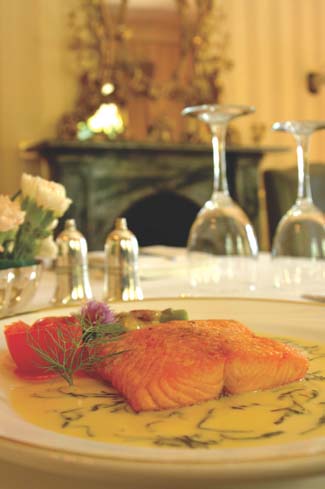 Food lovers planning to take in a visit to the riverside town of Newport when exploring the "Gourmet Greenway" food trail would enjoy dinner - and perhaps an overnight stay - at the beautiful Newport House, which is acclaimed for its fishing, genuine hospitality and excellent simple cooking by long serving chef John Gavin.
Food lovers planning to take in a visit to the riverside town of Newport when exploring the "Gourmet Greenway" food trail would enjoy dinner - and perhaps an overnight stay - at the beautiful Newport House, which is acclaimed for its fishing, genuine hospitality and excellent simple cooking by long serving chef John Gavin. He has created a distinctive cuisine based on fresh produce from their own fishery, garden and farm; fruit, vegetables and herbs come from a walled kitchen garden that has been worked since 1720, and fresh fish in the restaurant includes their own wild salmon and also a wide variety of sea fish from Achill Island. Home smoked salmon is a speciality.
This lovely Newport House dish comes from Irish Country House Cooking (Epicure Press, €25); it brings together a classic combination of ingredients that are in season together in the Irish countryside and rivers.
Serves 4
Click for recipe
Turbot or Brill in Tarragon and Soured Cream Sauce
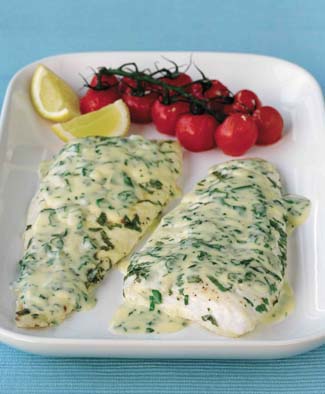 Turbot and brill are interchangeable for cooking purposes and both are extremely good fish; turbot is now available farmed by Achill Island Turbot (details from Ireland For Food Lovers, Epicure Press, and www.achillislandturbot.ie).
Turbot and brill are interchangeable for cooking purposes and both are extremely good fish; turbot is now available farmed by Achill Island Turbot (details from Ireland For Food Lovers, Epicure Press, and www.achillislandturbot.ie). As with all flat fish, choose larger fish if possible, so that you get nice chunky fillets. It is quite difficult to distinguish a large brill from turbot but running your finger over the skin will soon tell you which is which, as turbot have little lumps on their skin.
This attractive dish from the award-winning book From Tide To Table (Epicure Press, out of print) is simple, light and summery.
Click for recipe
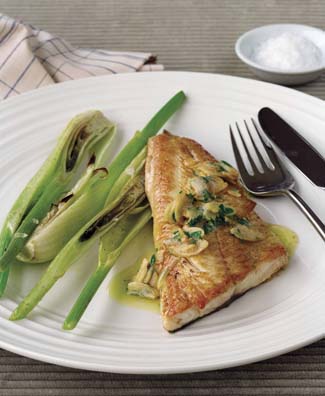 Trout, Salmon or Charr with Lemon Butter and Flaked Almonds
Trout, Salmon or Charr with Lemon Butter and Flaked AlmondsThis simple, classic dish from From Tide To Table (Epicure press, out of print) is good with flat fish and any of the salmon family - salmon, trout (sea or river trout) or arctic charr.
SERVES 4
Click for recipe
New Season Irish Lamb
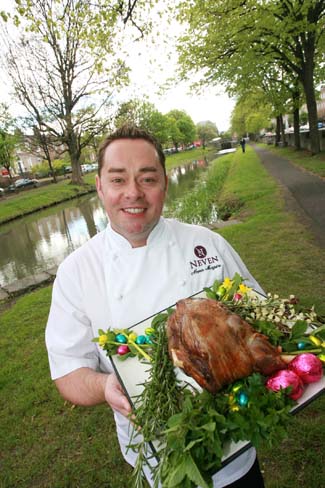
 In recent times, new season spring lamb has become traditional at Easter in Ireland, but it is a much better buy in summer when it has had more time to grow larger (making it more suitable for family meals) and to develop more flavour.
In recent times, new season spring lamb has become traditional at Easter in Ireland, but it is a much better buy in summer when it has had more time to grow larger (making it more suitable for family meals) and to develop more flavour.Bord Bia recently launched a series of interactive video demonstrations featuring top chef Neven Maguire, and a also new range of tasty Irish lamb recipes (available on www.bordbia.ie). Teresa Brophy, Ireland Market Manager, Bord Bia commented, “Lamb is a hugely popular dish in Ireland and new season lamb is both delicious and easy to cook. In a recent Bord Bia consumer study 51% of those surveyed said lamb was the tastiest of all meats and we hope that the interactive videos with Neven Maguire will make meal preparations even more fun!”
Those following the growing public recognition of the importance of food production to Ireland’s economic recovery may be interested to know that Ireland’s lamb sector, including food service, is valued at approximately €290 million with annual exports of €163 million to 25 markets around the world. France remains the most important market accounting for 19,000 tonnes, almost half of Ireland’s total lamb exports.
And it is encouraging to hear that the Bord Bia Lamb Quality Assurance scheme, originally launched in May 2007, has now grown to 8,300 members.
Meanwhile, most of us cooking at home simply choose lamb because it is so tasty and versatile – and it combines beautifully with new season vegetables and herbs, notably new potatoes, peas and mint…
RECIPES:
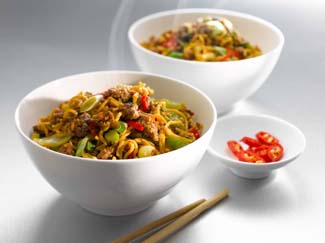 Minced Lamb with Pak Choy and Chillies
Minced Lamb with Pak Choy and ChilliesQuick and easy to prepare, you can have this tasty dish on the table in fifteen minutes flat.
Serves: 4
Click for recipe
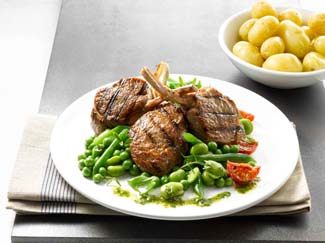 Lamb Cutlets with Fresh Herb Dressing
Lamb Cutlets with Fresh Herb DressingLamb cutlets, lamb chops or leg steaks are equally nice for this fresh-flavoured dish, which takes under half an hour to prepare and cook.
Serves 4
Click for recipe
 Greek-style Lamb Kebabs
Greek-style Lamb KebabsAnother quick recipe, with great summery flavours. Delicious cooked either on the barbecue or under the grill.
Serves 4
Click for recipe
It's Summer Time & The Cookin' is Easy
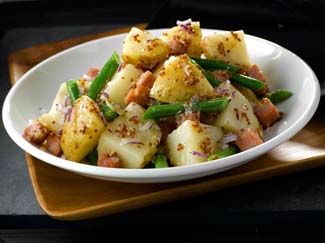
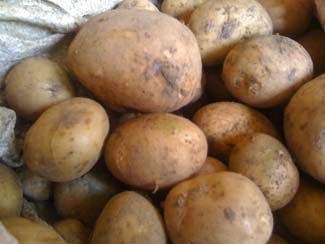 New season vegetables make healthy eating a pleasure, and they’re quick and easy to cook too, in simple dishes that allow their fresh flavours to take centre stage.
New season vegetables make healthy eating a pleasure, and they’re quick and easy to cook too, in simple dishes that allow their fresh flavours to take centre stage.The food that Ireland is associated with throughout the world is of course the potato and the varieties grown commercially range from earlies including Home Guard, which need to be eaten as soon as possible after harvesting and are ideal for salads as well as hot dishes; second earlies such as the much loved British Queen (rarely given its correct name, but known variously as ‘Dublin’, ‘Rush’ or whatever, depending where it’s grown); and main crops including the versatile and very popular red-skinned Rooster and older varieties like Kerrs Pink and the ultra floury Golden Wonder.
Although the popularity of international dishes which use rice or pasta as the main carbohydrate has led to some decline in potato consumption in recent years there seems to have been a revival of interest, both in traditional cooking and in more innovative dishes.
Potatoes are by far the most important crop retailed in Ireland, where we grow over 11,200 hectares commercially – and heaven knows how much in gardens and allotments all over the country. Counties, Meath, Dublin, Louth, Donegal and Cork are the largest potato growing counties, while counties Carlow, Kilkenny, Offaly and Kildare are also good growing areas.
And potato lovers will be pleased to find that a new website devoted to our favourite source of energy, Potato.ie, was recently launched by the Irish Potato Federation in association with Bord Bia. Describing potatoes as “Ireland’s ‘Feel Good Food’ ”, Lorcan Bourke of Bord Bia said (as if we needed reminding) that “they are tasty, healthy, convenient - and represent value for money.” Time to get cookin’ so.
Salad of New Potatoes and Smoked Salmon with a Dill & Mustard Dressing
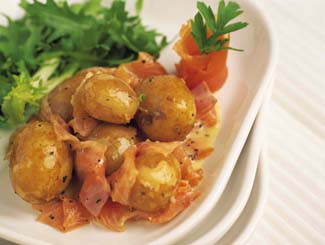 Use earlies such as Home Guard or Premier (or carefully cooked small second earlies) for this handy dish, which makes a great 'all in one' lunch or could be served as a help yourself starter at a barbecue or other al fresco meal. The sauce can be kept for a week in the fridge and actually tastes even better a day old, as the dill flavour is more pronounced.
Use earlies such as Home Guard or Premier (or carefully cooked small second earlies) for this handy dish, which makes a great 'all in one' lunch or could be served as a help yourself starter at a barbecue or other al fresco meal. The sauce can be kept for a week in the fridge and actually tastes even better a day old, as the dill flavour is more pronounced.Click for recipe
Potato & Bean Salad with Bacon
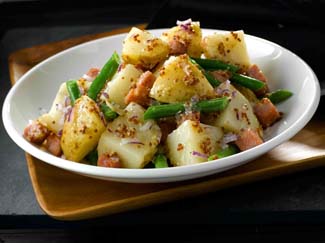 If cooked carefully to prevent them breaking up, new season Queens (many of which come from North County Dublin, eg Rush/Skerries) can be used for this delicious little dish, and they have great flavour; then later, when that great all-rounder the Rooster comes on stream, that will do nicely.
If cooked carefully to prevent them breaking up, new season Queens (many of which come from North County Dublin, eg Rush/Skerries) can be used for this delicious little dish, and they have great flavour; then later, when that great all-rounder the Rooster comes on stream, that will do nicely. French or runner beans are perfect – and the blanching process given here is also essential for freezing beans successfully, useful to know if you have to deal with a glut.
Whether served warm or cold, it’s a great salad and can be served as a light main course or, with or without the bacon, as a starter. Vegetarians could try replacing the bacon with cubes of an interesting farmhouse cheese – Mossfield organic, for example, a mature gouda made near Birr, Co Offaly.
Click for recipe
Grilled Vegetables With Mozzarella
.jpg) An easy-peasy dish that uses much the same ingredients as ratatouille but also cherry tomatoes – ideal if you grow your own out of doors, as you’ll probably have masses of them coming along at the moment – and it’s much quicker to make than ratatouille: just the job to serve with plenty of crusty bread for a colourful meal-in-a-hurry.
An easy-peasy dish that uses much the same ingredients as ratatouille but also cherry tomatoes – ideal if you grow your own out of doors, as you’ll probably have masses of them coming along at the moment – and it’s much quicker to make than ratatouille: just the job to serve with plenty of crusty bread for a colourful meal-in-a-hurry. Grilling is suggested here, but if you have a range type cooker such as an Aga or Waterford Stanley, simply pop the oiled vegetables into the hot oven and they’ll ‘grill’ in a few minutes, allowing excess moisture in the vegetables to evaporate.
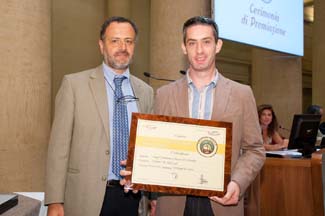 As an alternative to the mozzarella, why not try the Greek Style variety in the St Tola organic range from Siobhan Ni Ghairbhith’s Inagh Farmhouse Cheeses, made in Ennistymon Co Clare - who have just added to their collection of awards by collecting a Silver Medal at the prestigious Premio Roma awards in Rome, for their mature organic goat’s cheese log.
As an alternative to the mozzarella, why not try the Greek Style variety in the St Tola organic range from Siobhan Ni Ghairbhith’s Inagh Farmhouse Cheeses, made in Ennistymon Co Clare - who have just added to their collection of awards by collecting a Silver Medal at the prestigious Premio Roma awards in Rome, for their mature organic goat’s cheese log. Click for recipe
Elderflower & Lime Cheesecake
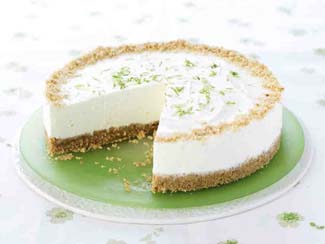 Elderflower grows prolifically in Ireland and I keep an eye out for elderflower cordial on my travels – diluted with water it makes a lovely summer drink and is made by some small producers, mainly in Co Cork - eg Ballymaloe House and Ballymaloe Cookery School; Longueville House, Mallow; Blairscove, Durrus; and Ballyvolane House, Fermoy – who also have it in their West Waterford business, O’Brien Chop House in the Heritage Town of Lismore, where they mix it with sparkling water to make a delicious and refreshing non-alcoholic cocktail.
Elderflower grows prolifically in Ireland and I keep an eye out for elderflower cordial on my travels – diluted with water it makes a lovely summer drink and is made by some small producers, mainly in Co Cork - eg Ballymaloe House and Ballymaloe Cookery School; Longueville House, Mallow; Blairscove, Durrus; and Ballyvolane House, Fermoy – who also have it in their West Waterford business, O’Brien Chop House in the Heritage Town of Lismore, where they mix it with sparkling water to make a delicious and refreshing non-alcoholic cocktail. But no Irish producer is yet making it on a commercial scale unfortunately, so the one you are most likely to find in shops is from the UK producer, Belvoir Fruit Farms - who also promote their products as ingredients in desserts such as this unusual cheesecake.
Click for recipe
Late Summer Tea Party
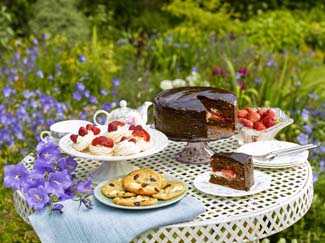
 Gardens are really beautiful at the moment and, as the days are getting noticeably shorter, this is the time to celebrate late summer with a tea party to remember.
Gardens are really beautiful at the moment and, as the days are getting noticeably shorter, this is the time to celebrate late summer with a tea party to remember. Pick a lazy sunny afternoon and invite family or special friends to enjoy a treat that they will remember with pleasure when the autumn starts to bite.
For more great recipes to enjoy throughout the year and nutrition tips visit www.eggs.ie.
Macadamia and Cranberry Cookies
 The cookie dough freezes really well and can be cooked from frozen. See below.
The cookie dough freezes really well and can be cooked from frozen. See below. Click for recipe
Meringue Nests
 Can be made ahead and stored in an airtight container until needed; they will keep well providing they are completely dried out and have been allowed to cool thoroughly before packing. Free range eggs, preferably organic, produce better volume.
Can be made ahead and stored in an airtight container until needed; they will keep well providing they are completely dried out and have been allowed to cool thoroughly before packing. Free range eggs, preferably organic, produce better volume. Click for recipe
Chocolate Cake with Summer Berries
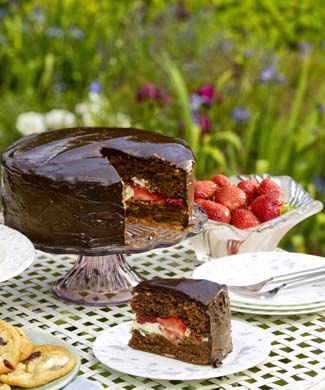 Makes a 20cm/8 inch sandwich cake, serving about 8-10
Makes a 20cm/8 inch sandwich cake, serving about 8-10 Click for recipe
Deep Flavoured Dishes for Dark Days
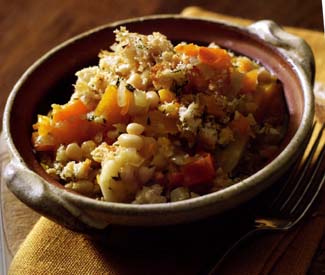 The short days of November and December are brightened by festivals, and also the abundance of wonderful seasonal produce that we have at our disposal – fruit, vegetables and foraged foods, also game to add to our usual range of meats.
The short days of November and December are brightened by festivals, and also the abundance of wonderful seasonal produce that we have at our disposal – fruit, vegetables and foraged foods, also game to add to our usual range of meats. Colder weather and longer hours of darkness call for comforting, deeply flavoured dishes, so we should count ourselves lucky and enjoy these good things while they’re at their best.
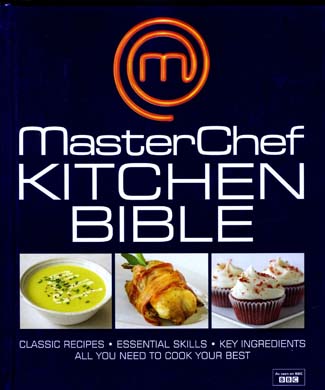 Loin Of Venison With Celeriac Purée
Loin Of Venison With Celeriac PuréeIf advice is needed on any aspect of cookery – including game – the MasterChef Kitchen Bible (Dorling Kindersley, hardback, £26/€30) is a good port of call, and would make a fine gift for any of the reputed 9 million viewers of the BBC show.
The book gives advice on all aspects of running a kitchen, from choosing the best ingredients to buying the best ingredients, and includes 150 MasterChef skills classes covering essential techniques and cooking methods – and 100 modern classic recipes, all of them achievably impressive. This example comes from 2010 finalist, Alex Rushmer.
preparation time: 20 minutes
cooking time: 1 hour 30 minutes
Serves 4
Click for recipe
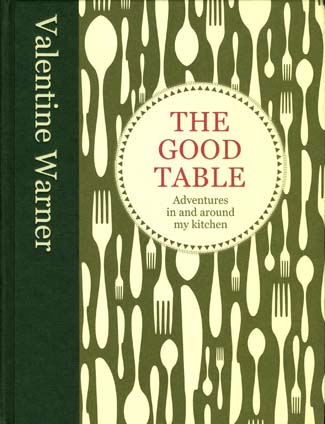 Mallard & Cabbage
Mallard & CabbageFans of the hearty, down-to-earth British TV foodie Valentine Warner will be pleased to see his latest book, The Good Table (Mitchell Beazley, hardback, stg £20).
As usual with this likeable chef, you get much more than a book of recipes; he describes this particular collection as ‘my heart on plate’ and it’s an interestingly personal book, also very practical and with plenty of background information along with the typically gutsy recipes - many of them, like the example here, with a strong local country flavour, plus a sprinkling inspired by sunnier destinations.
“This is one of my favourite dishes... I'm happy to see that mallards are appearing more commonly in good butchers and some more adventurous supermarket branches. During the shooting season, I like to stockpile them in the freezer, as every one I sit down to reinforces my fear of running out. I recommend that you serve half a bird per person because they do not have as much meat as might at first appear (although I must admit that I can eat a whole one with ease). After you've tried a mallard, you'll never look upon the village pond in the same way...”
Click for recipe
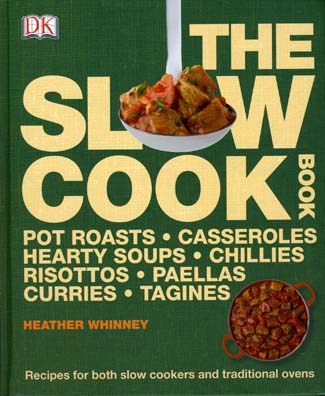 Pumpkin and Parsnip Cassoulet
Pumpkin and Parsnip CassouletRecession may be painful but it also brings many benefits, including a return to more cost-conscious cooking – both in terms of the ingredients used, and the cooking methods.
It’s good to see slow cooking backing style and The Slow Cook Book by Heather Whinney (Dorling Kindersley, hardback, £16.99/€20) is a timely and comprehensive guide. The range of 200 recipes is excellent – the kind of dishes that make you want to dive into the kitchen and get going - and instructions are given both for electric slow cookers (of which sales are currently soaring) and ordinary ovens/ranges.
This seasonal example is a lighter vegetarian version of the traditional meaty cassoulet, featuring creamy haricot beans and a crispy, herby breadcrumb and parmesan cheese topping.
Serves 4-6 (Freeze Up To 3 Months; Healthy)
Click for recipe
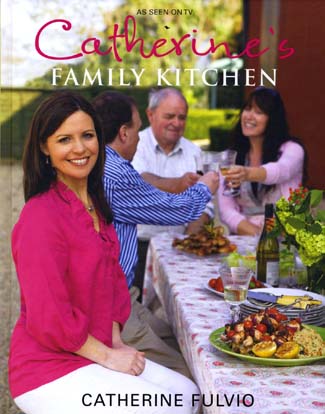 Apricot, Date and Guinness Slices with Guinness Cream Sauce
Apricot, Date and Guinness Slices with Guinness Cream SauceThis is the season when we all love to bake, and the delightful Catherine Fulvio’s take on the traditional sticky toffee pudding recipe should be very popular, adding ‘a truly Irish dimension with the addition of the Guinness’. Catherine says that “We make this in our cookery school to great applause, though we find that the measurements of Guinness can be a bit heavy handed!”
It’s from her lovely new book, Catherine’s Family Kitchen (Gill & Macmillan, hardback, €22.99), based on the RTE series which, although filmed at home in Wicklow, seems to have been blessed with some Italian sunshine.
Makes 9 squares
Click for recipe
Time to Stir Again
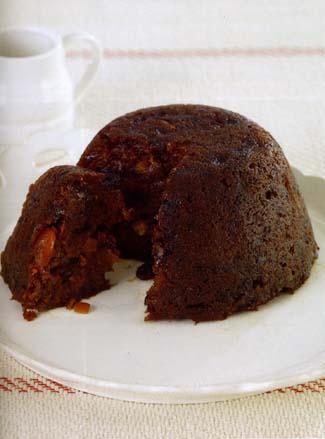
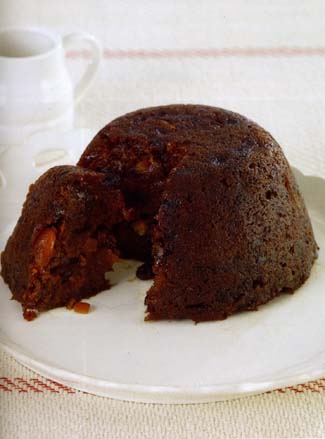 If you enjoy the traditional Christmas preparations and haven’t got started yet, it’s time to think about the puddings and cakes – although the long maturing time favoured by our grandmothers isn’t strictly necessary, anything with dried fruit in it benefits from a month or two in a cool dark place before the big day.
If you enjoy the traditional Christmas preparations and haven’t got started yet, it’s time to think about the puddings and cakes – although the long maturing time favoured by our grandmothers isn’t strictly necessary, anything with dried fruit in it benefits from a month or two in a cool dark place before the big day. For best results, use the highest quality ingredients you can find. Speciality shops worth seeking out for top quality baking ingredients include The Gourmet Shop, Highfield Road, Rathgar, Dublin 6 and, of course, Peter and Mary Ward’s Country Choice in Nenagh, Co Tipperary.
Plum Pudding
 A whole new generation is taking up the deeply satisfying activity of home baking at the moment and a good gift for any aspiring baker would be this weighty tome, Step-by-Step Baking (Dorling Kindersley, hardback, €25).
A whole new generation is taking up the deeply satisfying activity of home baking at the moment and a good gift for any aspiring baker would be this weighty tome, Step-by-Step Baking (Dorling Kindersley, hardback, €25). A comprehensive reference, with lots of luscious photographs, it offers ‘350 baking recipes for every occasion’ and a wealth of how-to information too. Their version of the classic Christmas pudding (named plum pudding because it contains prunes) uses butter instead of the traditional beef suet.
Click for recipe
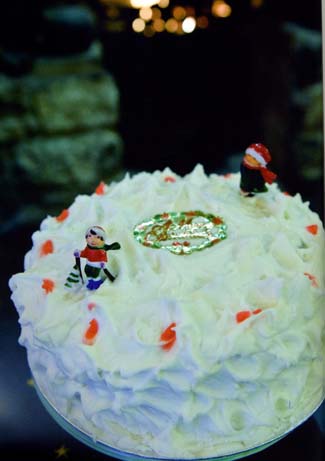 Jim’s Kitchen Christmas Cake
Jim’s Kitchen Christmas CakeOne rainy Monday last April, I called into Jim’s Kitchen in Portlaoise and bought Jim Tynan’s two cookbooks – Jim’s Kitchen and Jim’s Kitchen 2 – from this wonderful shop and restaurant.
A place renowned for its friendliness, lovely homely food – and, especially, great Christmas baking and speciality ingredients, it was a bit quieter than it used to be (isn’t everywhere), but everything seemed much the same as usual.
Yet, on Saturday 7th May, Jim closed the doors for the last time. The foodie world is still in shock – and hoping that, in time, Jim’s Kitchen will re-open once again. Meanwhile, here is one of their range of Christmas cakes, from the first book.
Click for recipe
Christmas Compendium
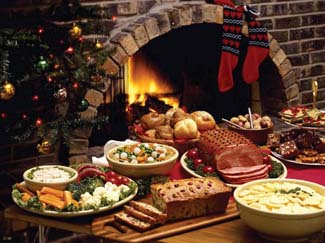
 Ideas from events and establishments around the country - Georgina Campbell
Ideas from events and establishments around the country - Georgina Campbell The festive season is in full swing and Christmas offers an escape from the everyday state of doom and gloom, so many establishments and companies have suggested ideas to help us make the most of it and enjoy every minute.
Some hotels have come up with ingenious offerings, including The Pins Bakery at The Twelve Hotel in Bearna, Galway, who will prepare and cook a delicious Christmas dinner for you – turkey, ham and all the trimmings – which you can pick up from them on Christmas Eve for effortless service to family and friends on Christmas Day! (Last orders 21st December.) They also offer alternatives that are ideal for small numbers (eg turkey and ham hock wellington dinner with all the trimmings for 2 or 4 people, €38/€68); starters, desserts and matching wines are available too, and they sell extras like mulled wine, stuffing and cranberry sauces, onion marmalades, preserves, organic chocolates etc for your own table, or for stocking fillers or hampers.
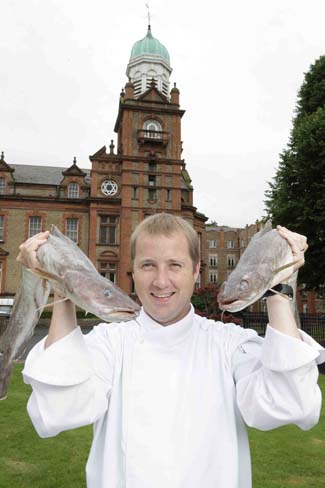 Alternatively, for people in Dublin who would like to go out for Christmas dinner, Bewley’s Hotel Ballsbridge have devised a menu that celebrates Irish produce and takes into account the sustainability of ingredients and welfare of animals, in line with the ‘Kitchen’ initiative which was launched by Moran and Bewley’s Hotel Group last year, to provide a new range of options for those concerned with the provenance of their food.
Alternatively, for people in Dublin who would like to go out for Christmas dinner, Bewley’s Hotel Ballsbridge have devised a menu that celebrates Irish produce and takes into account the sustainability of ingredients and welfare of animals, in line with the ‘Kitchen’ initiative which was launched by Moran and Bewley’s Hotel Group last year, to provide a new range of options for those concerned with the provenance of their food. 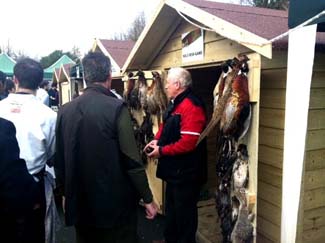 And good ideas for Christmas have come from some of the many recent food events. Wild&Slow2011, a memorable and inspiring educational two-day event, was held at BrookLodge Hotel, Co Wicklow in November. It was a big success, with over 1,100 guests signing up and attending work shops and demonstrations, over 2,800 enjoying the Street Market (at which a highlight was seeing hanging game in the feather once more, at Mick Healy’s Wild Irish Game stall (www.wildirishgame.ie) and nearly 200 people enjoyed Ireland’s first ever, complete Wild Foods Dinner (well, except for the potatoes!).
And good ideas for Christmas have come from some of the many recent food events. Wild&Slow2011, a memorable and inspiring educational two-day event, was held at BrookLodge Hotel, Co Wicklow in November. It was a big success, with over 1,100 guests signing up and attending work shops and demonstrations, over 2,800 enjoying the Street Market (at which a highlight was seeing hanging game in the feather once more, at Mick Healy’s Wild Irish Game stall (www.wildirishgame.ie) and nearly 200 people enjoyed Ireland’s first ever, complete Wild Foods Dinner (well, except for the potatoes!). 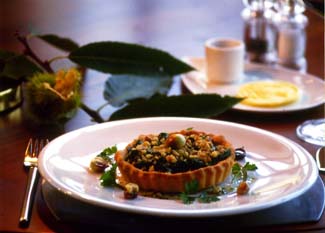 Spinach and roast chestnut tartlet
Spinach and roast chestnut tartlet This recipe was part of an organic BrookLodge Christmas menu devised for the Irish Independent some years ago, and it makes a delicious festive starter or could be used as light main course for lunch or supper. Quantities given for the pastry make more than is required, so wrap in cling film and keep in the fridge to use in another tart or pie.
Serves 4
Click for recipe
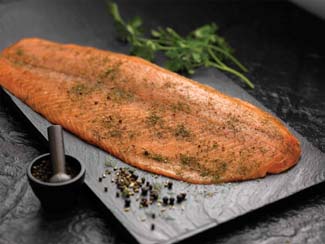 STARTER: SMOKED SALMON
STARTER: SMOKED SALMONAs the classic instant Christmas starter (or pre-dinner nibble), smoked salmon is hard to beat – providing it’s really good quality. We are fortunate to have a wide choice of excellent producers in Ireland, who use a combination of wild salmon in season (in very limited quantities) and the superb organic salmon that is farmed in tidal waters off the rugged West coast, and then create their own individualistic smoking and curing styles.
Highly respected long-established names include Sally Barnes’ Woodcock Smokery and Ummera Smokehouse in West Cork; Burren Smokehouse, Connemara Smokehouse, Kinvara and Clarkes in the West and North-West, and Glenarm Salmon in Northern Ireland.
Another is the Benoit family’s Kenmare salmon company Kenmare Select (see photo) which is less familiar because, until now, it has mainly been exported to leading hotels and restaurants abroad.
But all that is changing as they now have an ‘online boutique’ on their website www.kenmare-select.com and their unusual products are proving winners at competitions such as the Blas na hEireann, Irish Food Awards, held in Dingle each October, and the UK’s Great Taste Awards - most recently their organic smoked Irish salmon with a hint of seaweed (‘a twist on the Nordic gravlax recipe’) took Gold at the 2011 Blas na hEireann awards.
Kenmare Select is available in several styles and in whole sides, sliced or unsliced and, unusually, the preferred serving style is also unique, as it is traditionally served in thick, vertically cut slices, so that the full range of flavours in each piece can be fully appreciated.
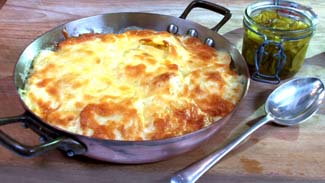 SMOKED SALMON DAUPHINOISE
SMOKED SALMON DAUPHINOISEPrime smoked salmon makes a hassle-free starter or salad, but the less appealing pieces and offcuts can also be delicious in cooking.
If you’re looking for recipe ideas, check out the new recipe website www.cookwithavonmore.ie which currently features over 130 recipes - including Christmas cooking ideas from several chefs, and a full range of starters, soups, sauces, main courses, and desserts – and promotes the message of using Irish ingredients for better quality.
The site, which is designed to evolve and grow as new material is regularly added, also has a new online food video channel embedded within it and the first programme, features three easy-to-prepare recipes presented by Paul Flynn of The Tannery Restaurant & Cookery School – including this tempting Smoked Salmon Dauphinoise which, like all of Paul Flynn’s cooking, is as down to earth as it is delicious.
The amount of smoked salmon needed is not large because, as Paul points out in the video, the strong flavour permeates the dish very easily and you don’t want it to be overpowering.
Serves 4 as a light meal to serve with a side salad.
Click for recipe
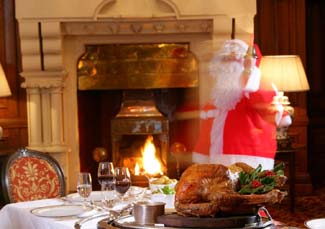 TURKEY: Maple Syrup Glazed Turkey Crown with Cranberry Stuffing
TURKEY: Maple Syrup Glazed Turkey Crown with Cranberry Stuffing For many Christmas would not be complete without the traditional turkey, and anyone lucky enough to be spending Christmas at Ashford Castle this year will have the privilege of enjoying Chef Stefan Matz’s interpretation of the festive favourites in one of the finest restaurants in Ireland.
Alternatively, those of us who are up for a bit of a challenge could try cooking his recipe at home…The turkey is marinated in a ‘brine’, and the gravy is based on a stock that takes several hours to make, so allow plenty of time for this in advance of cooking the turkey crown.
A 2.7kg/6lb turkey crown serves 6-8
Click for recipe
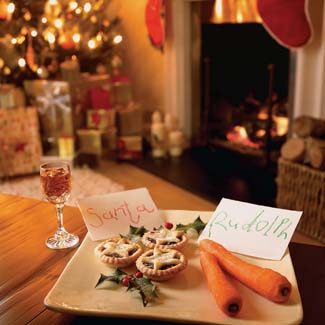 VEGETABLES & FRUIT are the unsung heroes of the festive season, saving us from ourselves when we eat too many rich foods. Excellent side vegetables served at the Dunraven Arms Hotel in Adare Co Limerick on a recent break were Irish, except for (nicely cooked) green beans; I did wonder where the local green vegetables had disappeared to, but – unusually – the imaginatively presented parsnips and carrots were a talking point and made me think about special occasion recipes for root vegetables.
VEGETABLES & FRUIT are the unsung heroes of the festive season, saving us from ourselves when we eat too many rich foods. Excellent side vegetables served at the Dunraven Arms Hotel in Adare Co Limerick on a recent break were Irish, except for (nicely cooked) green beans; I did wonder where the local green vegetables had disappeared to, but – unusually – the imaginatively presented parsnips and carrots were a talking point and made me think about special occasion recipes for root vegetables. This appealing recipe is easy to make; it comes from a UK agency dedicated to promoting carrots and I do wish we had something similar here. (More on this in the New Year.)
Chardonnay Glazed Carrots with Chive Butter
Click for recipe
DESSERT:
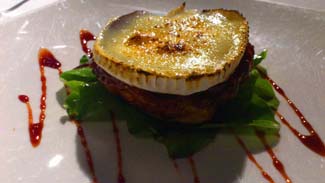 Fig Tart Tatin with Goat Cheese & Mulled Wine Syrup
Fig Tart Tatin with Goat Cheese & Mulled Wine SyrupIf you’re looking for a festive alternative to the traditional plum pudding, this unusual hot dessert from Eden Restaurant in Dublin’s Temple Bar could be the answer – and it looks after the cheese course too.
It’s part of an imaginative (and, at just €42 for three courses, keenly priced) Christmas menu offered at the restaurant this year, which includes longtime favourite dishes like Eden Smokies and Castletownbere Crab Salad as well as festive main courses such as Fillet of Wild Irish Venison with braised red cabbage and a port and juniper jus.
Click for recipe
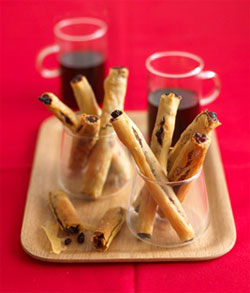 Mincemeat Treats
Mincemeat Treats After an exceptionally filling main course, many people don’t really want a dessert on Christmas Day at all and mince pies can be heavy, but it’s nice to have a little taste of Christmas with your after dinner coffee.
These unseasonably diet-conscious little treats from chef and former editor of Good Food magazine, Emma Lewis, are from a set of ten new recipes devised for Canderel and will suit those who consciously try to avoid too much fat or sugar, even at Christmas (others may opt to use real butter, at least). They can be dipped in whipped cream, served with vanilla ice-cream and served as party nibble with a glass of mulled wine.
Click for recipe
BRUNCH:
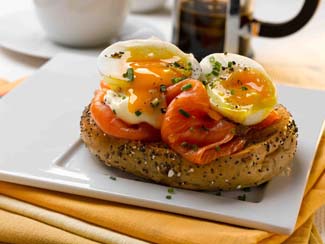 Soft Boiled Eggs And Smoked Salmon Bagels
Soft Boiled Eggs And Smoked Salmon Bagels Whether for brunch, lunch or a light supper, this Bord Bia recipe is just the kind of easy ‘between’ meal that’s needed over Christmas when unusually large meals tend to be followed by a long gap.
If you have smoked salmon in the house it is ideal for these bagels, but it could be replaced with slices of cooked ham; or try wilted spinach for a vegetarian alternative.
Click for recipe
Not Just for Breakfast - Great Ways with Irish Oats

 One of the great unsung heroes of the Irish food scene, oats are widely grown, inexpensive, nutritious and extremely versatile. And, while there’s much more to oats than breakfast (see recipes below), they make pretty much the perfect start to the day.
One of the great unsung heroes of the Irish food scene, oats are widely grown, inexpensive, nutritious and extremely versatile. And, while there’s much more to oats than breakfast (see recipes below), they make pretty much the perfect start to the day.
Porridge is their most obvious winter use, although it actually makes a great all-year breakfast especially if you make it the easy way, in a slow cooker or in the bottom oven of a range-type cooker such as an Aga. We make our porridge overnight, cooked on Low in an electric slow cooker (1 cup of porridge oats to 3 of water, plus a good pinch of salt), and it’s no trouble at all. It’s extremely convenient too, as it’s ready for the earliest riser, instantly available and can be served at different times for members of a household have varying breakfast times.
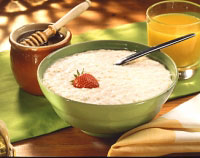 Most of us enjoy a glass of fresh orange juice in the morning and perhaps that’s not by chance - it’s the ideal accompaniment for porridge, according to nutritionists, because the vitamin C in the juice helps the body to absorb the iron in oats. Porridge is always worth eating just because it’s delicious (especially with a spoon of Irish honey and some creamy milk added - and perhaps even a drop of whiskey at the weekend…)
Most of us enjoy a glass of fresh orange juice in the morning and perhaps that’s not by chance - it’s the ideal accompaniment for porridge, according to nutritionists, because the vitamin C in the juice helps the body to absorb the iron in oats. Porridge is always worth eating just because it’s delicious (especially with a spoon of Irish honey and some creamy milk added - and perhaps even a drop of whiskey at the weekend…)
But its secret weapon is that, unlike most breakfast cereals, it provides instant warmth followed by slow-release energy throughout the morning – removing the temptation to snack on high calorie foods mid-morning or over-eat at lunchtime (hence the fact that people who eat a good breakfast are less likely to be overweight than those who skip it).
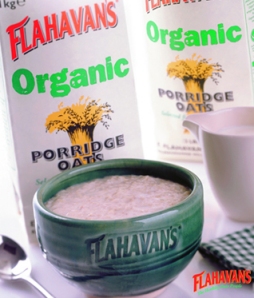 Oats are an important crop in Ireland and, although there are also good imported brands to choose from, we always support Irish growers and producers if possible - especially when there’s an organic option as there is with Flahavan’s, which is the one we’ve bought for ages.
Oats are an important crop in Ireland and, although there are also good imported brands to choose from, we always support Irish growers and producers if possible - especially when there’s an organic option as there is with Flahavan’s, which is the one we’ve bought for ages.
Flahavan’s is one of Ireland's longest-running family businesses and has been operating in Kilmacthomas, Co Waterford for over 200 years, spanning six generations, but they’re a very forward-looking company and they’ve won awards to beat the band.
As well as awards to the company itself – examples include the Irish Food Writers’ Guild Environmental Award and a Bord Bia Domestic Success Award - a long list of accolades gives recognition to the innovative range of products that has made a basic commodity very appealing to consumers of all ages - over a million servings of Flahavan’s oats are consumed nationwide each week apparently, and that’s probably because they’re available in such a variety of options (including microwaveable sachets and single servings pots) as well as the traditional packs.
The Flahavan’s marketing strategy also has broad appeal, with a strong emphasis on recipes that demonstrate the versatility of oats as an ingredient.
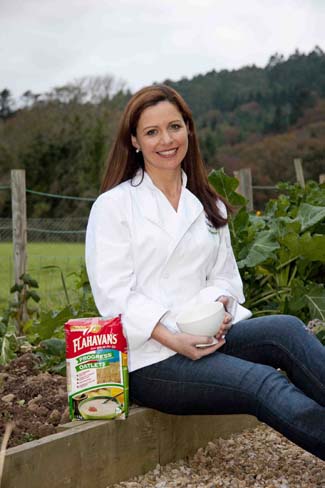 Handy booklets giving the late Mary Flahavan’s excellent Simple Oat Recipes are supplied free with certain packs; there’s a range, including a number of ways to make the perfect porridge, on their website www.flahavans.com; and they have commissioned recipes from several celebrity chefs including Kevin Dundon of Dunbrody Country House and Catherine Fulvio, the popular television personality, cookbook author and owner of award-winning Ballyknocken House and Cookery School in Co Wicklow (a former Georgina Campbell Farmhouse of the Year), who gave Flahavan’s five of her favourite easy-to-prepare recipes demonstrating that “Irish oats are not just for breakfast”.
Handy booklets giving the late Mary Flahavan’s excellent Simple Oat Recipes are supplied free with certain packs; there’s a range, including a number of ways to make the perfect porridge, on their website www.flahavans.com; and they have commissioned recipes from several celebrity chefs including Kevin Dundon of Dunbrody Country House and Catherine Fulvio, the popular television personality, cookbook author and owner of award-winning Ballyknocken House and Cookery School in Co Wicklow (a former Georgina Campbell Farmhouse of the Year), who gave Flahavan’s five of her favourite easy-to-prepare recipes demonstrating that “Irish oats are not just for breakfast”.
RECIPES:
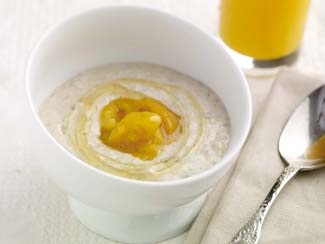 EASY 3-MINUTE PORRIDGE
EASY 3-MINUTE PORRIDGE
This quick porridge for 2 can be prepared on the hob or in the microwave.
Click for recipe
CATHERINE FULVIO’S FAVOURITE OAT RECIPES:
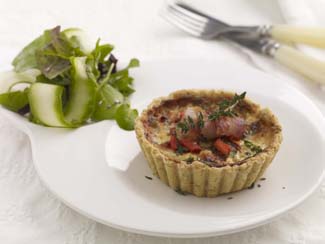 Sundried Tomato, Roasted Red Pepper and Chive Tartlets with Oatmeal Pastry
Sundried Tomato, Roasted Red Pepper and Chive Tartlets with Oatmeal Pastry
“My family loves these – we take them on picnics and to the beach. They are great with a rocket, spinach and walnut salad.” Makes 6
Click for recipe
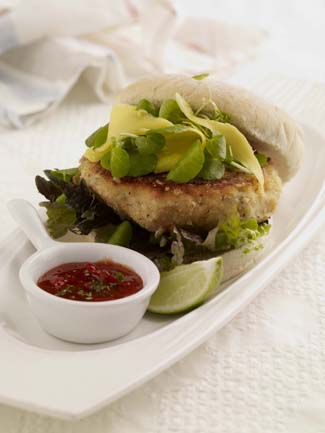
“Adding the oats to the crumb gives these cakes a great extra crunch and of course loads of goodness, perfect for a hearty family meal.”
Serves 4
Click for recipe
 Oaty Blueberry Muffins with Ginger and Pear Frosting
Oaty Blueberry Muffins with Ginger and Pear Frosting
“This is a great recipe to impress when the girls are coming around for an afternoon chat. That said, my children love to bake these with me too. The blueberries give them the added extra goodness.”
Makes 16 depending on the size of your muffin cases
Click for recipe
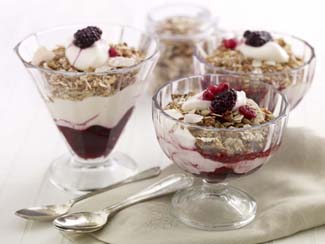 Granola Crunch
Granola Crunch
“We serve this for breakfast at our farmhouse and are amazed at the requests for the recipe.”
Serves 6
Click for recipe
Pancakes Galore
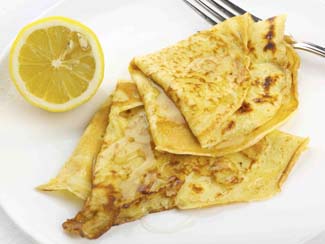
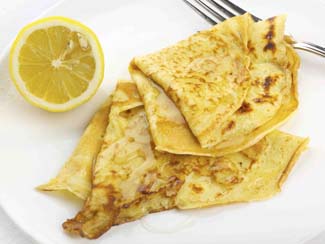 The countdown to Easter begins on 21st February, which is Shrove Tuesday or, in the cooks’ lexicon, Pancake Day. As it’s the day before the first day of Lent (Ash Wednesday), it was traditionally a day for using up the foods that weren’t allowed during the fasting period of Lent, notably eggs.
The countdown to Easter begins on 21st February, which is Shrove Tuesday or, in the cooks’ lexicon, Pancake Day. As it’s the day before the first day of Lent (Ash Wednesday), it was traditionally a day for using up the foods that weren’t allowed during the fasting period of Lent, notably eggs. While there may less of us fasting during Lent these days, everybody loves pancakes and there’s no shortage of people happy to have a bit of fun making them – and maybe tossing them, with varying degrees of success – on Pancake Day.
According to Bord Bia it’s the day when egg sales peak in Ireland, which is ironic when you remember that it’s the day when we are supposed to be using up stocks of food that we have in the house and that won’t keep until the end of Lent...
It will all be good fun on the day anyway and, to celebrate, the website eggs.ie features a range of Pancake recipes to suit every taste and budget. There is also a series of easy to follow video recipes by Catherine Fulvio for sweet and savoury pancakes on the website – and a reminder to use Bord Bia Quality Assured Eggs.
Because we associate them so much with Pancake Day, it’s easy to forget that the pancake is one of those universal dishes that occur in various forms in diverse cultures all over the world. And, while the traditional Irish pancake with lemon and sugar will always be a favourite, pancakes are very versatile and can be used as the foundation for a whole range of sweet and savoury dishes, whether for a snack, a dessert or as a main meal – and not just on Pancake Tuesday.
Basic Pancakes
Like all very simple dishes, the important thing is to get the basic techniques right: a good, heavy cast-iron pan is best, it must be preheated and very hot before any fat is added and the best fat is a hard block white cooking fat such as Frytex, which you smear over the pan very quickly to make a thin film of hot fat just before adding the batter. Otherwise use a little oil - but not butter - which burns at high temperatures.
Keep the batter in a jug beside the hob and use a ladle - the first pancake is always a bit of a mess, but once the pan is seasoned it will work a treat and you very quickly learn to judge exactly the amount of batter needed to swirl around the pan and just reach the edges.
Click for recipe
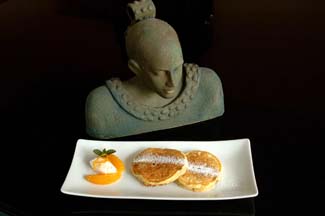 Orange and Raisin Pancakes with Crème Fraiche and Orange and Cardamom Salad
Orange and Raisin Pancakes with Crème Fraiche and Orange and Cardamom SaladDrop scones – also known as Scotch pancakes, or sometimes pikelets – are a smaller, thicker kind of pancake and they’re very versatile. They can be sweet or savoury and they’re often served warm for tea, spread with butter and honey or jam, or as an accompaniment to sweet and savoury dishes.
These unusual breakfast pancakes from Kilgraney House at Bagenalstown, Co Carlow are more like a drop scone than a traditional pancake; the recipe comes from Irish Country House Cooking, The Blue Book Recipe Collection.
Click for recipe
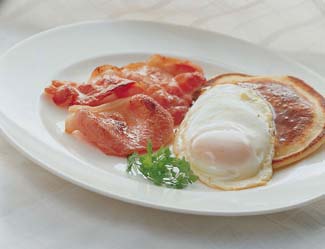 Fried Eggs, Potato Pancakes and Bacon
Fried Eggs, Potato Pancakes and BaconThese potato pancakes are a cross between a potato cake and a pancake and they’re very versatile. They are understandably popular in a wide range of dishes - here they’re given with a mini-fry, but they’re great used in the same way as the Northern Irish potato bread for all versions of the traditional cooked breakfast. And they’re delicious just served warm with a knob of butter, too. A larger version popular in the north-west, especially Leitrim, is ‘boxty in the pan’; made with a thinner batter, it turns out more like a regular pancake and can be used as a wrap.
Click for recipe
Best of Irish Breads & Baking
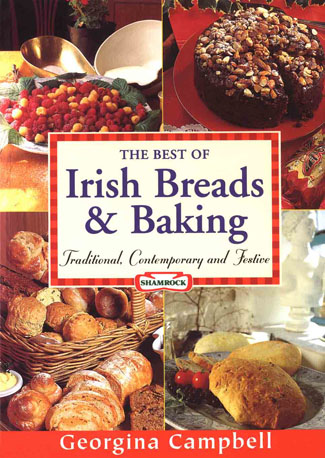
 Home baking has settled so comfortably back into our collective psyche that it’s hard to believe it ever went away - and also back, by popular demand, is our vintage cookbook, The Best of Irish Breads & Baking (Epicure Press paperback, €15) which has just been reprinted and is available once again, from bookshops and directly from us online.
Home baking has settled so comfortably back into our collective psyche that it’s hard to believe it ever went away - and also back, by popular demand, is our vintage cookbook, The Best of Irish Breads & Baking (Epicure Press paperback, €15) which has just been reprinted and is available once again, from bookshops and directly from us online.This popular book gives a wide range of clearly explained and reliable recipes in eight categories covering everything from traditional soda breads, scones and griddle baking to speciality breads, cakes and biscuits to festive fare and special occasions.
But, with recipes carefully chosen to illustrate the fascinating history of the Irish breadmaking tradition, it’s more than just a recipe book. Beginner bakers will it easy to use, with lots of practical information and advice, and even the most experienced cook should find some new recipes to try – perhaps taken from one of the many country houses, restaurants, hotels and pubs that were persuaded to share their specialities.
Some have closed since publication in the mid ‘90s, but they’ll never be forgotten while their recipes live on and give enjoyment.
RECIPES:
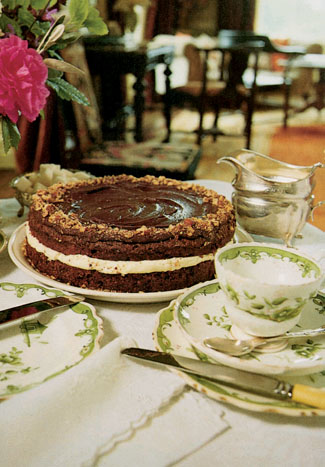 Chocolate Hazelnut Cake
Chocolate Hazelnut CakeThis scrumptious cake - as made by Susan Kellett at the wonderful Enniscoe House, near Ballina, Co Mayo - is more of a gateau than a cake and well suited to serving with a cake fork with coffee, or as a dessert.
Try it, perhaps, as an alternative to the traditional simnel cake for Easter, it will go down well with those who aren’t keen on fruit cakes.
Click for recipe
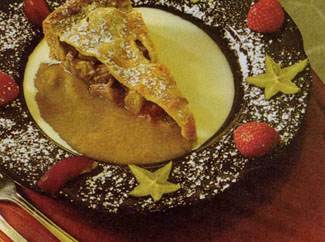 Rhubarb & Cinnamon Tart
Rhubarb & Cinnamon TartAt Cashel House Hotel, in Connemara, they take pride in producing as much as possible for their own table. Rhubarb flourishes mightily, so this delicious Rhubarb & Cinnamon Tart is often on the menu – and it is particularly prized in sping.
The subtle background of almonds in the pastry and the tang of orange zest in the filling complement each other delectably, but ease of preparation is an equally powerful persuader for the cook, as the pastry case does not need to be pre-baked.
Click for recipe
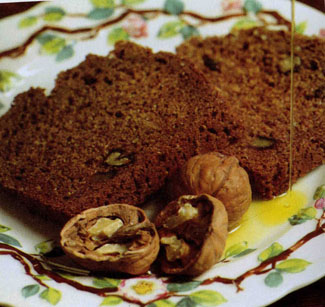 Walnut Bread
Walnut BreadThe range of breads included in The Best of Irish Breads and Baking is wide, and includes many variations on both soda bread and yeast breads. This speciality Walnut Bread is a longstanding favourite at Dan Mullane's famous restaurant, The Mustard Seed, at his country house hotel Echo Lodge, near Adare, Co Limerick.
It is an interesting bread, containing an impressive array of ingredients for both texture and flavour - and firmly in the soda bread tradition.
Click for recipe
Nothing But the Best - Derry Clarkes Winning Recipes for the Irish Food Writers Guild Awards
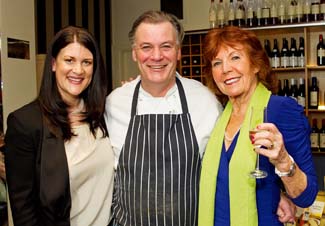
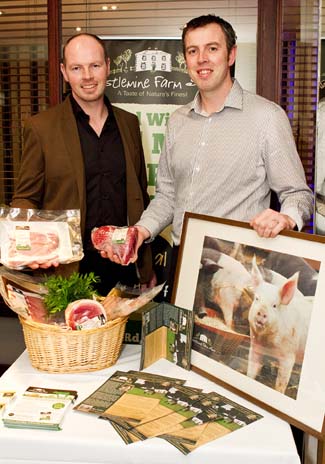 Artisan producers are the unsung heroes of the food industry in Ireland, but need support from the commercial sector to ensure their survival. This was the view of Myrtle Allen, one of the pioneers of the movement to promote locally produced Irish food, who addressed guests at the Irish Food Writer’s Guild Food annual awards last month (March 2012). The Irish Food Awards, of which five were presented at a ceremony attended by The Minister for Agriculture, Marine and Food, are recognised as the most important and impartial of their kind in Ireland.
Artisan producers are the unsung heroes of the food industry in Ireland, but need support from the commercial sector to ensure their survival. This was the view of Myrtle Allen, one of the pioneers of the movement to promote locally produced Irish food, who addressed guests at the Irish Food Writer’s Guild Food annual awards last month (March 2012). The Irish Food Awards, of which five were presented at a ceremony attended by The Minister for Agriculture, Marine and Food, are recognised as the most important and impartial of their kind in Ireland. From happy pigs to placid cows – the five award winners represent a wide range of enterprises. Those awarded for standards of excellence and for their exceptional contribution to Ireland’s reputation as a top food-producing country were; Castlemine Farm for Castlemine Farm Free Range Pork (Roscommon); Patrick & Carol Rooney for Derrycamma Farm Rapeseed Oil (Louth) and David Tiernan for Glebe Brethan Cheese (Louth).
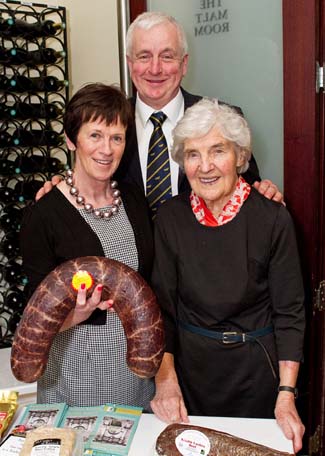 In addition, McCarthy’s of Kanturk, Cork, was presented with a special award for the family’s notable contribution to Irish food and renowned fruit grower and active chairman of the Irish Apple Growers Association, Con Traas of The Apple Farm in Tipperary was honoured with the Guild’s Lifetime Achievement Award.
In addition, McCarthy’s of Kanturk, Cork, was presented with a special award for the family’s notable contribution to Irish food and renowned fruit grower and active chairman of the Irish Apple Growers Association, Con Traas of The Apple Farm in Tipperary was honoured with the Guild’s Lifetime Achievement Award. Now in its 18th year, the Irish Food Writers’ Guild (IFWG) Food Awards reward and promote producers of the highest quality food, Myrtle Allen, honorary life member of the Guild, asserted “The importance of these awards cannot be overstated as they allow us to recognise people at the coalface of the food sector in Ireland. We are all fortunate and privileged beneficiaries of these people’s devotion to producing fantastic food. Collectively, the winners make a significant contribution to the Irish economy, developing innovative and enterprising ways of working and providing both direct and indirect employment."
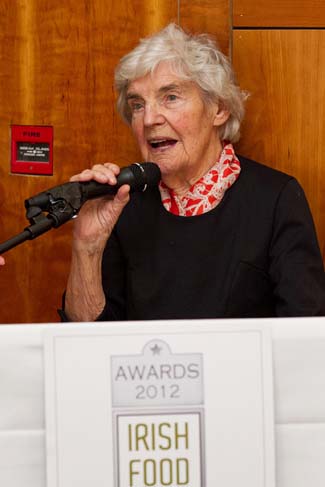 "However, there is a serious anomaly in that we have some of the highest quality produce in the world and yet, it is often a challenge to find something as simple as an Irish apple in our shops. Why is this? If we don’t support and buy Irish, we will ultimately witness the demise of the small to medium-sized local producer, to the benefit of imported and sometimes, sub standard substitutes. We cannot let this happen and I am appealing to all stakeholders, including retailers, to recognise their responsibilities in supporting home grown industry.”
"However, there is a serious anomaly in that we have some of the highest quality produce in the world and yet, it is often a challenge to find something as simple as an Irish apple in our shops. Why is this? If we don’t support and buy Irish, we will ultimately witness the demise of the small to medium-sized local producer, to the benefit of imported and sometimes, sub standard substitutes. We cannot let this happen and I am appealing to all stakeholders, including retailers, to recognise their responsibilities in supporting home grown industry.” Minster for Agriculture, Marine and Food, Simon Coveney TD, who was guest of honour at the event applauded the work of the members of the Irish Food Writers Guild “Through these awards you are highlighting the challenging work of small independent Irish food producers, at a time when supporting home-grown industry is critical,” he said. “There is now a new appetite for buying home grown produce. By informing and promoting the high quality of our own food through your columns you are opening up new outlets throughout the country for local food producers and assisting the better established to forge new trade links in new markets,” he concluded.
Minster for Agriculture, Marine and Food, Simon Coveney TD, who was guest of honour at the event applauded the work of the members of the Irish Food Writers Guild “Through these awards you are highlighting the challenging work of small independent Irish food producers, at a time when supporting home-grown industry is critical,” he said. “There is now a new appetite for buying home grown produce. By informing and promoting the high quality of our own food through your columns you are opening up new outlets throughout the country for local food producers and assisting the better established to forge new trade links in new markets,” he concluded. 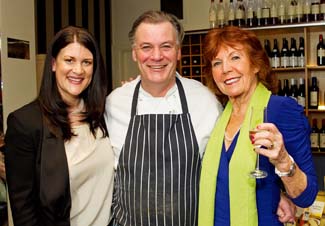 Chairperson of the Irish Food Writers’ Guild, Orla Broderick explained the awards selection process: “These awards are quite unique in that no producer can nominate themselves; nominations are submitted exclusively by Guild members. Indeed, no company ever even knows that it is being considered for an award. The size of the company or the product category are of no relevance to the selection process but what is important, is that the products are produced in Ireland with the main ingredient being home produced.”
Chairperson of the Irish Food Writers’ Guild, Orla Broderick explained the awards selection process: “These awards are quite unique in that no producer can nominate themselves; nominations are submitted exclusively by Guild members. Indeed, no company ever even knows that it is being considered for an award. The size of the company or the product category are of no relevance to the selection process but what is important, is that the products are produced in Ireland with the main ingredient being home produced.” Ms Broderick concluded by thanking Bord Bia for its continued support of the Awards and the work it does for the industry both in Ireland and abroad.
The awards took place at Michelin-starred restaurant, L'Ecrivain, where Derry Clarke created a magnificent lunch incorporating all of the award-winning products – and he was kind enough to share some of the recipes for us to make at home.
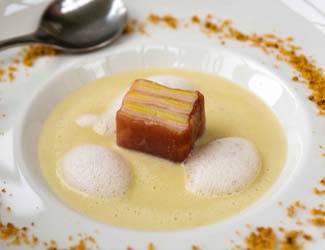 CREAM OF ONION SOUP WITH GLEBE BRETHAN CHEESE AND POTATO TERRINE
CREAM OF ONION SOUP WITH GLEBE BRETHAN CHEESE AND POTATO TERRINEMakes 4 servings.
• 3 large Spanish onions, peeled
• 1 clove garlic
• 50g butter
• Sprig of thyme
• 1 litre vegetable or chicken stock
• Terrine: 150g dry cured ham, thinly sliced
• 250g potato, thinly sliced *
• 250g Glebe Brethan cheese, thinly sliced
Prepare terrine the day before soup is to be served.
Line the terrine dish with cling film, then line completely with thinly sliced ham, leaving some overhang.
Cook potato slices in a little water until just tender, about 6 minutes, then drain.
Place alternating layers of sliced potato and Glebe Brethan cheese in terrine, filling to a depth of about 4cm. Cover top of terrine with overhanging ham, with extra if needed.
Place a weight on top and leave overnight to set.
To make the soup, finely slice the onion and garlic and sauté in a pot with the butter and thyme until soft but not coloured.
Cover with stock, bring to the boil, then reduce heat and simmer for 10-15 minutes or until onion is tender. Purée soup in blender, taste and correct seasoning and return to pot.
To serve, turn out terrine, remove cling film and cut into squares. Place in centre of a wide soup plate and ladle hot soup around. Garnish with buttermilk foam and crumbs of crispy ham if wished.
*Non-floury type potato such as Rooster or Maris Piper recommended.
~~~~~~~~~~~~~~~~~~~~~~~~~~~~~~~
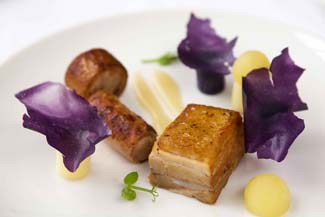 HONEY GLAZED CASTLEMINE FARM FREE RANGE PORK BELLY CONFIT
HONEY GLAZED CASTLEMINE FARM FREE RANGE PORK BELLY CONFITServes 4
• 800g Castlemine Farm Free Range boned pork belly, trimmed of excess fat
• 120g sea salt
• 1tbsp thyme leaves
• 2 bay leaves, crumbled
• 500ml duck fat
• 3 tbsp honey
Rub pork belly with sea salt, thyme and bay leaves, pressing it into all sides.
Marinate overnight in a deep covered earthenware container in the fridge.
Remove from marinade next day, wash the meat and pat dry with kitchen paper.
Preheat oven to 150°C/300°F/gas mark 2.
Melt duck fat, pour it over the pork belly and roast meat for two and a half hours.
Remove pork belly from the duck fat and place between two baking trays.
Lay a heavy weight on top to flatten the confit and leave to cool.
To serve, preheat oven to 180°C/350°F/gas mark 4.
Cut pork into 4 equal portions.
Heat a dry frying pan and seal the confit, skin side down, in the pan for 3-4 minutes.
Then place in roasting tin skin side up, brush with honey again and roast in the oven for 5 minutes; pre-heat grill to medium; brush the pork with honey again and grill for 1-2 minutes to finish.
~~~~~~~~~~~~~~~~~~~~~~~~~~~~~~~
CON TRAAS’ APPLE FARM APPLE CRUMBLE TART WITH SPICY GINGERBREAD CREME ANGLAIS AND CONNEMARA WHISKEY ICE CREAM
6 tart cases, baked blind
Apple compote:
• 6 Apple Farm apples, peeled, cored and sliced
• 200g brown sugar
• 1tsp ground ginger
• 1tsp ground cinnamon
• 1 vanilla pod, seeded
Frangipan:
• 250g butter
• 250g sugar
• 200g beaten egg
• 25g flour
• 250g ground almonds
Crumble:
• 200g sugar
• 100g butter
• 100g flour
• 100g ground almonds
To make compote, place apples, sugar, spices and vanilla in saucepan and cook on low heat, stirring continuously until apples are soft. Set aside to cool.
For frangipan, beat butter and sugar in food mixer until soft.
Gradually beat in egg, then add flour and ground almonds; beat until smooth.
Spoon layer of frangipan to half fill tart cases and bake at 160°C/325°F/gas mark 3 for 15 minutes.
To serve, fill cases to top with apple compote and finish with crumble topping. Heat through in oven and serve hot with whiskey ice cream and crème anglaise.
Recipes created by Derry Clarke, L’Ecrivain, for The Irish Food Writers’ Guild Food Awards 2012
Irish Traditional Cooking
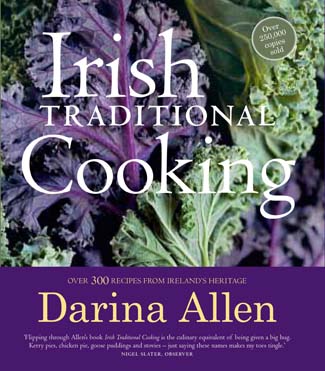
 What is Irish cuisine – or is there any such a thing at all? There’s been a lot of talk about it in recent years and the idea has often been scornfully dismissed, as too has the concept of associating Ireland with good food at all - until recently at least.
What is Irish cuisine – or is there any such a thing at all? There’s been a lot of talk about it in recent years and the idea has often been scornfully dismissed, as too has the concept of associating Ireland with good food at all - until recently at least.It’s true that the word ‘cuisine’ does not sit comfortably with the things we do best in Ireland but, as Irish food ambassadors like Darina Allen and her mother-in-law Myrtle have been saying for many decades now, we do have a great culinary heritage.
Based on the finest raw ingredients in the world (and getting better all the time as traditional farming methods are valued highly once again, and consumers demand more seasonal local produce), the Irish culinary tradition is essentially good home cooking, without frills or pretensions, and all the better for that. Coming from the land and seas around us, it suits our climate and is as much an expression of Irish culture as our music, literature or myths and legends.
As Colman Andrews said in the Introduction to his beautiful book The Country Cooking of Ireland (Chronicle Books, $50; with Foreword by Darina Allen), “There is a sense in which all Irish cooking – at least the good stuff, the real thing – is country cooking.” Darina Allen’s Irish Traditional Cooking (Gill & Macmillan, hardback, 336pp; €27.99) tells a similar story – vividly, and from a much more personal perspective – and, while it has been available for nearly twenty years now, this new extended edition with over 100 new recipes will introduce a fresh generation to the joy of preparing and eating simple traditional food with local connections.
Interspersed with historical background notes, little comments attached to recipes handed down for generations, and the occasional dish that’s just for the record (it’s unlikely anyone would cook roast thrush again, for example), the main body of this book covers appealing and very do-able recipes that are just right for today and also give us a fascinating insight into a gentler-paced everyday life that was so recently familiar.
Some recipes are a little nostalgic, and that suits the retro mood of the times (plenty of good bakes to serve on that mismatched china) and, as well as providing endless ideas for great everyday (and some high day) food to cook at home, there is plenty to interest professional cooks too.
Visitors to Ireland often complain about the international style of the food they are offered here – every chef should have a copy of Irish Traditional Cooking, and use it to death until it becomes dog-eared and spattered with the ingredients of many good meals.
There is food for thought here for every type of restaurant; pubs, especially, will find many, many good dishes that will charm customers and send them happy on their way – and, perhaps, with a refreshingly different view of Irish food.
And that is clearly what Darina herself would like the book to achieve: when asked to comment on the new edition she said, "I hope that Irish Traditional Cooking will encourage chefs to put at least one traditional Irish dish on the their menu every week and to serve Irish food proudly. It's an endless challenge for tourists to find a nice bowl of coddle or Irish stew and anything that sounds vaguely traditional - a definite opportunity for many restaurants, cafés and pubs and there's so much there."
RECIPES from Irish Traditional Cooking:
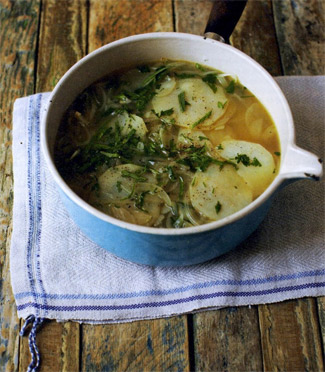 Potato, Onion and Lovage Soup
Potato, Onion and Lovage SoupLucy Madden from Hilton Park in Co. Monaghan, one of Ireland’s most charming country house hotels, made this delicious soup for me from the organically grown vegetables in her garden. [Lucy Madden is the author of ‘The Potato Year’, with a potato recipe for every day of the year. Although currently unavailable, a reprint is planned – contact her at Hilton Park (lucy@hiltonpark.ie) for an update.]
Serves 6
10–25g (½–1oz) butter
225g (8oz) onions, very thinly sliced
350g (12oz) potatoes, thinly sliced
salt and freshly ground pepper
1.2 litres (2 pints) good homemade
chicken or vegetable stock
a large handful of lovage leaves
Garnish
lovage and parsley
Melt the butter in a heavy-bottomed saucepan on a low heat, add the onions and potatoes, season with salt and freshly ground pepper and sweat until soft but not coloured.
Add the stock and boil for 5 minutes. Snip the lovage leaves into thin strips with scissors. Put 3 tablespoons into the soup and cook for a further 10 minutes.
Serve with a sprinkling of snipped lovage and a little chopped fresh parsley.
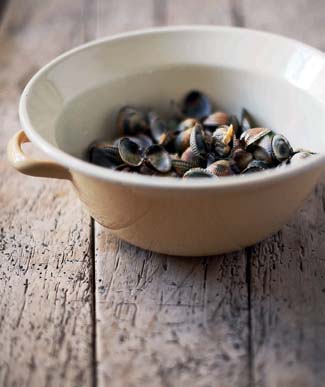 Cockles with Melted Butter
Cockles with Melted Butter Cockles have formed part of the Irish diet since earliest times. Archaeological remains have been found at early historic sites such as Oughtymore, Co. Derry, Park Cave, Co. Antrim and Potters’ Cave, Co. Antrim.
Cockles formed the mainstay of the diet along the coastal regions during the great potato Famine of 1845. The Congested District Board Records also tell of how cockle gathering was widespread around Donegal on the eve of the Great Famine.
Wash the cockles in several changes of cold water to remove the sand and grit from the shells. put into a saucepan or frying pan, cover and cook over a medium heat. They open in just a few minutes and are best eaten straight from the shells, just dipped in melted butter.
Eat with loyts of crusty brown bread. The cockle liquid is also delicious. Cockles are also delectable with a bowl of homemade mayonnaise.
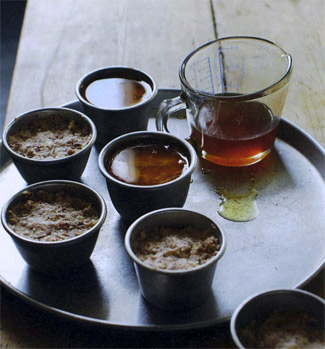 Potted Meats
Potted MeatsTasty potted meats were another way of using up little scraps of the leftover Sunday joint. In the days of the pestle and mortar this was a labour-intensive business, but nowadays delicious potted meats and fish can be made in seconds using a food processor.
Spices were traditionally used for potted meat, but I also find some fresh herbs, for example parsley, chives and thyme leaves, can be a delicious addition. Chicken, ham, beef and game all make successful potted meats.
Serves 6
110g (4oz) cooked meat
30–50g (1–2oz) butter, cut into cubes
30g (1oz) jellied meat juices, if available
salt and freshly ground pepper
spices e.g. freshly ground nutmeg,
mace, allspice or juniper berries, depending on the meat
clarified butter
Remove any fat and gristle from the meat. Chop the meat finely and pound to a paste. Alternatively, put into a food processor and whizz for a few seconds.
Add the cubed butter, meat juices, salt, freshly ground pepper and spice. Whizz for a further few seconds, taste and add seasoning until you are happy with the flavour.
Pack the meat into little pots or ramekins and pour a layer of clarified butter over the top to exclude the air. These will keep for a week to 10 days in the fridge.
Serve with hot buttered toast.
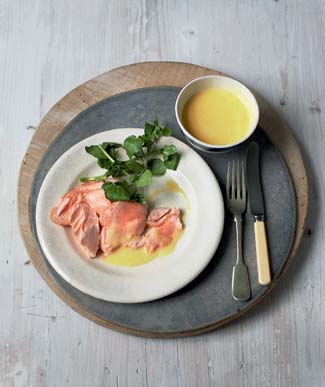 Poached Salmon with Irish Butter Sauce
Poached Salmon with Irish Butter SauceFor maximum flavour, we cook the salmon in the time-honoured way, by poaching it gently in well-salted boiling water. Better still, use sea water if you are close to the coast.
Serves 8
1.1kg (2½lb) centre cut of fresh salmon
water
salt
Irish butter sauce:
2 egg yolks
1 dessertspoon cold water
110g (4oz) butter, diced
1 teaspoon approx. lemon juice
Garnish
sprigs of flat parsley or watercress
The proportion of salt to water is very important. We use one rounded tablespoon of salt to every 1.2 litres (40fl oz) of water. Although the fish or piece of fish should be just covered with water, the aim is to use the minimum amount of water to preserve the maximum flavour, so therefore one should use a saucepan that will fit the fish exactly. An oval cast-iron saucepan is usually perfect.
Half fill the pan with measured salted water and bring to the boil. Put in the piece of fish, just covering with water, and bring back to the boil. Simmer gently for 20 minutes.
Turn off the heat, allow the fish to sit in the water. Serve within 15–20 minutes.
Meanwhile make the Irish butter sauce. Put the egg yolks into a heavy-bottomed stainless-steel saucepan on a very low heat. Add the cold water and whisk thoroughly.
Add the butter bit by bit, whisking all the time. As soon as one piece melts, add the next. The mixture will gradually thicken, but if it shows signs of becoming too thick or ‘scrambling’ slightly, remove from the heat immediately and add a little cold water if necessary. Do not leave the pan or stop whisking until the sauce is made. Finally add the lemon juice to taste. Pour into a bowl and keep warm over hot, but not boiling, water.
To serve, lift the cooked salmon carefully from the poaching liquid. Peel off the skin gently. Garnish with sprigs of parsley or watercress. Serve with the Irish butter sauce.
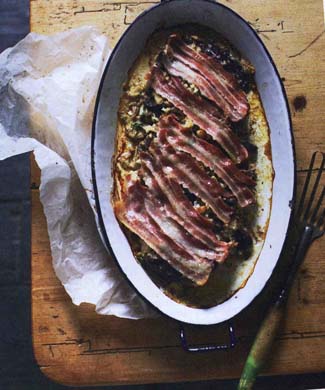 Baked Liver and Bacon
Baked Liver and BaconThis dish was taught in the school cookery classes for many years, until the 1960s at least, and makes a very tasty supper dish. Here is Lily O’Reilly’s recipe from her 1940s notebook.
Serves 2–4
225g (8oz) sheep’s liver
4 streaky bacon rashers
175–225ml (6–8fl oz) homemade stock
Stuffing
2 tablespoons breadcrumbs
1 teaspoon chopped parsley
1 teaspoon chopped onion
pinch of mixed dried herbs
(fresh herbs may of course be substituted)
1 dessertspoon chopped suet (butter or margarine may be substituted)
salt and freshly ground pepper
stock or milk, to moisten
To make the stuffing, put the breadcrumbs, parsley, onion and herbs into a bowl. Add the suet, pepper and salt, and moisten with a little stock or milk.
Cut the liver into strips about 1cm (½in) thick, wash in cold water and dry. Place in a greased baking dish and place the stuffing over the top.
Remove the rind from the bacon, thin out with a knife and put on top of the stuffing. Pour on the stock, cover with a greased paper and bake in a moderate oven, 180ºC/350ºF/gas mark 4 for about 30 minutes.
When cooked, lift on to a hot dish and pour a little of the sauce around.
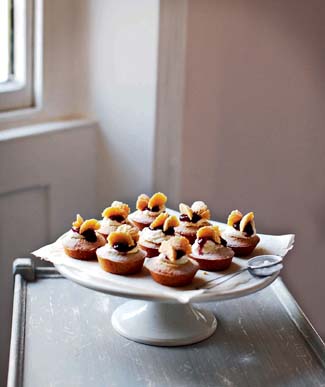 Butterfly Buns
Butterfly BunsPretty little buns like these are often the first recipe that children attempt and they are still as adorable as ever. First follow the recipe for Queen Cakes below (Darina includes this in a section on “Queen Cakes and Other Dainties”), then make them into butterfly buns.
Makes 12
110g (4oz) butter
110g (4oz) caster sugar
2 eggs, free-range if possible
vanilla extract, orange or lemon rind
140g (5oz) flour
¾ teaspoon baking powder
1 tablespoon milk or water
Cream the butter until really soft. Add the sugar and beat until white and creamy, either with your hand, as many of our ancestors did, or with a wooden spoon. Beat the eggs and flavouring and add gradually to the creamed butter and sugar.
Beat well. If preferred, the eggs may be broken and beaten into the mixture one at a time. A little sieved flour may be added between each addition of egg, if liked.
Stir in the remainder of the flour mixed with the baking powder, adding a little water or milk if necessary for a dropping consistency. Put the mixture in spoonfuls into well greased patty tins and bake for about 20 minutes at 200ºC/400ºF/gas mark 6–7.
Cool on a wire rack.
To make the Butterfly Buns: Cut the tops off each of the baked queen cakes. Cut these pieces in half and set aside. Put a little home-made raspberry jam and a blob of cream on to the bottom part of the cake.
Replace the 2 little pieces, arranging them like butterfly wings. Dredge with icing sugar.
Serve on a pretty plate.
Seafood Special
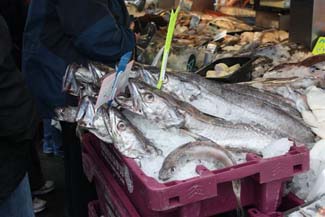
 Once the summer begins to kick in the annual drift towards the seaside starts too, so fish and seafood soon take pride of place on menus and home dinner tables alike.
Once the summer begins to kick in the annual drift towards the seaside starts too, so fish and seafood soon take pride of place on menus and home dinner tables alike.There are great goings-on in the world of seafood at the moment and, although the underlying reasons for a lot of the activity may be alarming – global warming, over fishing, depleted stocks of many species – it is heartening to see attention focused on finding solutions.
The Slow Fish campaign organised by the Slow Food movement has been working on the problem for many years through their awareness-raising biennial Slow Fish Fair in Genoa and many projects designed to support responsible artisanal fishing communities.
Similarly Euro-Toques International, the European chefs’ and cooks’ organisation dedicated to promoting local sourcing and protecting culinary heritage, is proactive in its support of responsible fishing.
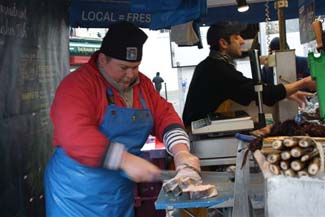 Together with members of the Alliance For Common Fisheries Policy Reform, Euro-Toques International organised a debate on the future of seafood supply with EU Commissioner for Fisheries and Maritime Affairs Maria Damanaki, on 25th April 2012 at the European Seafood Exposition, the world’s largest seafood trade event.
Together with members of the Alliance For Common Fisheries Policy Reform, Euro-Toques International organised a debate on the future of seafood supply with EU Commissioner for Fisheries and Maritime Affairs Maria Damanaki, on 25th April 2012 at the European Seafood Exposition, the world’s largest seafood trade event.During the debate, the Alliance For Common Fisheries Policy Reform urged European decision-makers to address the current lack of governance by ending the short-term decisions that regulate fishing from year to year and by using EU funds effectively.
Speaking on behalf of the Alliance, Evan Doyle of Euro-Toques Ireland said: “Chefs don’t want fish to become a rare delicacy. The wild fish on our plates could disappear if the EU misses this year’s opportunity to reform the Common Fisheries Policy and put its fisheries on the road to recovery and sustainable management.” Furthermore he underlined the key roles that Chefs can play vis-à-vis consumers to help them choose the right fish when they are cooking at home or when they are in a restaurant.
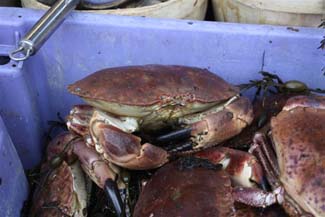 But it’s not only international organisations that can make a difference, and it’s especially encouraging to see how passionately committed individuals can make a real contribution. Here in Ireland, for example, Stephane Griesbach, of Gannet Fishmongers in Galway, has been toiling over a new website, which “is intended to be a comprehensive source of information about fish and the fish industry both for the public and for participants in the various aspects of the industry”.
But it’s not only international organisations that can make a difference, and it’s especially encouraging to see how passionately committed individuals can make a real contribution. Here in Ireland, for example, Stephane Griesbach, of Gannet Fishmongers in Galway, has been toiling over a new website, which “is intended to be a comprehensive source of information about fish and the fish industry both for the public and for participants in the various aspects of the industry”. Although still a work in progress, this selfless task is already a remarkable achievement, listing nationwide sales outlets and providing an extraordinary range of detailed and educational information - as you can see in the introductions to the recipes below, which are inspired by the list of ‘Your Top 8 Fish’; Stephane starts it off somewhat mischievously with Wolf Fish, which is actually pretty rare, but it’s a great attention grabber!
As Stephane Griesbach points out, “Cod has become the benchmark of the fish world”. It has also become one of the world’s most controversial fish, and is widely regarded as an endangered species. However, Stephane points out that it is not endangered everywhere.
“Some areas in Europe have very healthy cod stocks while others are under serious pressure. Cod populations around Ireland are very low in the north Donegal area and in the Irish sea. However the stocks of cod in the Celtic sea, south of Ireland, are so healthy that the 2012 quota was increased by nearly 75%.”
So, although it may not always be easy to know exactly where it is coming from, the message is to “Eat more Cod, eat Cork's Cod" - and looking out for the Responsible Irish Fishing logo would be a good start.
Then there are the fishermen themselves, people like Frank Fleming of Responsible Irish Fish, who have worked tirelessly to introduce a label that guarantees high standards of handling and storage; quality; provenance; and responsibility.
The Responsible Irish Fish label assists vessel owners to achieve certification for their fish/shellfish, to develop a brand to allow Irish Fishermen differentiate their products in the market place and to promote Irish fish caught in a responsible manner - all aims which will benefit the fishing community and the consumer equally, making the label well worth seeking out.
A recent story that marks a very interesting development in the story of Irish fishing is from the fishing family Dorans of Howth, who have been in the seafood industry for over half a century but who sold the last of their fishing boats in the mid ‘90s.
After a gap of well over a decade, they’ve just bought the 18 metre Celtic Fisher, which will now supply not only their shop and wholesale customers, but also their two West Pier restaurants in Howth, The Oar House and Octopussy’s with Dublin Bay Prawns (langoustines) and ultra fresh fish. What’s more you can even order your fresh seafood while the Celtic Fisher is at sea and have it delivered to the door the day after landing: “Follow the Celtic Fisher on DoransHowth facebook page or on Twitter @Doransfishhowth …Followers will be able to track the vessel via AIS.COM. When informed of the landing time, log onto Doran’s home delivery website and place your order! Simple.” Simply amazing, actually.
RECIPES:
Some recipes are given on the new website, www.fishmongers.ie but the range so far is limited and they aren’t illustrated. So why not try some recipes from our cookbook, From Tide To Table - the selection ties in with some of Stephane Griesbach’s ‘Top 8 Fish’.
BLACK POLLOCK is listed third of ‘Top 8 Fish’ on Stephane Griesbach’s new website, www.fishmongers.ie – yet, he points out, “very few people will claim to have tried it despite that fact that almost everyone has eaten it in its smoked form, when sold as smoked coley”.
As for all the fish listed, he gives a lot of information: the Irish, Latin and common names; any similar fish; where it comes from; cuts available at the fresh fish counter; typical value (cheap, mid price, expensive – in this case ‘cheap’); sustainability and stock abundance (in this case, eat frequently; alternatives are eat in moderation; and over fished – enjoy as a once off).
Seasonality; eating qualities (texture, flavour, oily or not, bone content); recommended cooking methods; and complementary flavours are also given, to assist with saucing and accompaniments – an enormous amount of information on each fish, presented in neat, easily understood charts. And that is just from one small section of this extraordinarily informative website.
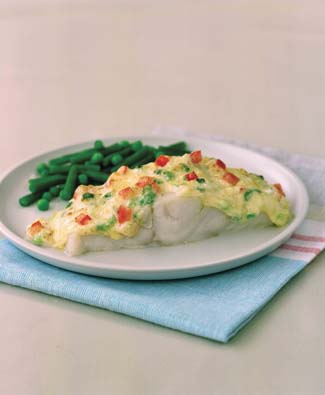 Cheesy-Grilled Pollock
Cheesy-Grilled Pollock Pollock is cheap and plentiful so why not try it in this easy dish with a ‘cupboard standby’ topping that’s perfect for children and adults alike. The time it takes the fish will depend on the thickness of the fillet: it is important to cook it until just opaque and flaking.
To check that it is cooked, gently prod the thickest part of the fish with the point of a knife and the flakes should separate easily. Red Cheddar cheese may be used, if preferred, and will give a more deeply coloured topping.
Serves 4
2 ripe tomatoes
150g/5oz mature Cheddar cheese
4 spring onions, trimmed and finely chopped
4 tbsp mayonnaise
2 tbsp plain flour
4 x 150g/5oz pollock fillets, skinned and boned
sunflower oil, for greasing
knob unsalted butter
salt and freshly ground black pepper
To Serve: buttered green beans and peas
Cut the tomatoes in half and remove the seeds, then finely dice the flesh and place in a bowl. Finely dice the cheese and add to the bowl with the spring onions, then just bind with the mayonnaise. Season to taste.
Preheat the grill to high. Arrange the pollock fillets on a lightly oiled, sturdy baking sheet and season lightly, then grill for 4-6 minutes until almost tender. This will depend on the thickness of the fillet.
Quickly spread the mayonnaise mixture on top and flash under the grill for another 2 minutes or until the cheese is bubbling and golden. Arrange on warmed plates with the buttered green beans and peas to serve.
VARIATION: Other white fish such as haddock, cod, whiting or hake may be substituted.
HAKE: Hake is another fish that is abundant and well priced – and, as much of the Irish catch goes to Spain, where it is highly prized, where better to look for inspiration when cooking it.
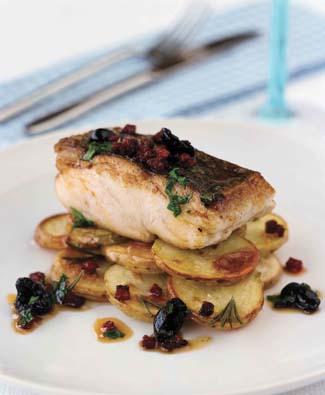 Crispy Hake with Chorizo and Black Olive Dressing
Crispy Hake with Chorizo and Black Olive DressingThis hake dish is packed full of Mediterranean flavours, and needs nothing more to accompany it than a tasty potato side and a green salad – and maybe a well-chilled glass of crisp white wine. This recipe also works well with cod or haddock.
Serves 4
2 tbsp olive oil
4 x 175g/6oz hake fillets, skin on and boned
25g/1oz butter
100g/4oz raw chorizo, skinned and cubed
100g/4oz good quality black olives, stones removed
1 tbsp chopped fresh flat-leaf parsley
good squeeze of lemon juice
salt and freshly ground black pepper
Serving suggestion: crispy potato slices with rosemary & garlic
Heat half of the olive oil in a large heavy-based frying pan and add the hake fillets, skin side down. Cook for a minute or two until the skin is just beginning to crisp, then add little knobs of the butter to the pan around each piece of fish and continue to cook for another minute or so until the skin is nicely crisp.
Turn the hake fillets over and cook for a further 3-4 minutes until cooked through. This will depend on the thickness of the fillets. Transfer the cooked hake fillets to a warm plate and keep warm while you make the dressing.
Add the remaining tablespoon of olive oil to the frying pan and then tip in the chorizo. Sauté for 3-4 minutes until sizzling and the chorizo has just begun to release its oil. Remove from the heat and add the olives, parsley and lemon juice. Swirl the pan around until the dressing is nicely combined and season to taste.
Arrange piles of potato slices on warmed plates and top each one with a piece of hake, skin side up. Drizzle around the chorizo and black olive dressing to serve.
Summer Lamb
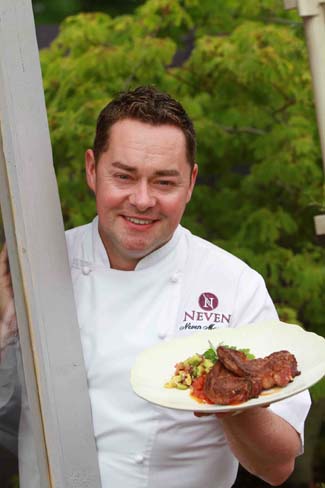
 Lamb may be synonymous with spring but, while tender, the small joints that make it to the Easter table are not a patch on the fuller-flavoured (and better value) meat that comes onto the market later in the season.
Lamb may be synonymous with spring but, while tender, the small joints that make it to the Easter table are not a patch on the fuller-flavoured (and better value) meat that comes onto the market later in the season.The size, texture and flavour of lamb varies depending on the breed and how it has been raised. Broadly this divides into the large lowland lamb and mountain lamb from areas such as Connemara, Kerry and West Waterford, which is just coming into season now and is smaller and leaner, with a distinctive herbal flavour.
Some lamb especially worth seeking out is sold under a regional branding, such as Connemara Hill Lamb ; Comeragh Mountain Lamb ; and Ring of Kerry Quality Lamb (www.ringofkerryqualitylamb.ie). Lamb from the Blasket Islands and Dingle Peninsula (likened to the speciality pré salé much coveted by the French) is available in limited quantities in season, notably from speciality butcher Jerry Kennedy Butchers in Dingle town, a third generation business with the distinction of having sold bacon and mutton to one of the area’s most famous sons, Antarctic explorer Tom Crean - whose pub The South Pole Inn, is still in business in nearby Annascaul.
According to Bord Bia, recent research has shown that over half of Irish consumers believe that lamb is the tastiest of all of the meats and, to show how easy it is to cook, their summer lamb campaign includes video demonstrations of Neven Maguire cooking some tasty lamb dishes as well as step by step instructions for a range of simple but appealing lamb recipes. The campaign also encourages shoppers to buy this versatile meat with the Bord Bia Quality Mark “to ensure it has been produced to Bord Bia’s highest standards and to know where it comes from”.
Choosing Irish lamb is an easy and enjoyable way to support local business and it seems that a lot of us are doing just that. Commenting in June, James Murphy, Chairman, IFA Sheep Committee said “Recent Kantar research has shown very positive results for lamb sales, with 66% of households buying lamb on a regular basis. Shoppers are also spending over €100 million on lamb which is an increase of 8% compared with this time last year and with summer a key period for lamb sales we are confident that this trend will continue”.
Teresa Brophy, Ireland Markets Manager, Bord Bia, points out that “Lamb is the perfect meat for quick and simple summer recipe ideas. It is ideal for the barbecue and so is a favourite summer time meal with friends and family. We are encouraging consumers to consider all of the ways in which lamb can be cooked and prepared and to enjoy its unique taste, which is said to come about as a result of rainfall which makes the grass sweeter”.
If it’s all down to the rain, this year must be a bumper one for lamb - better get that barbecue under cover!
RECIPES:
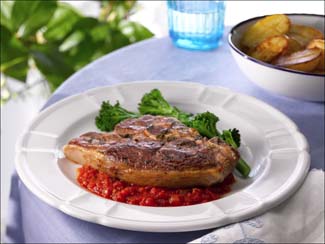 Lamb Chops with Tomato and Smoked Paprika Sauce
Lamb Chops with Tomato and Smoked Paprika SauceDon’t be put off by the fact that this dish involves a marinade, it is actually very quick and easy to make. The sauce would also be delicious with lamb cutlets or lamb steaks. Serves 4
4 sideloin lamb chops, well trimmed
Marinade:
A little olive oil
2 tbsp/30ml chopped fresh oregano leaves or flat leaf parsley
A little salt and freshly ground black pepper
Tomato and Smoked Paprika Sauce
2 tbsp/30ml olive oil
1 large onion, finely chopped
3 cloves garlic, crushed
2 tsp/10ml smoked paprika
400g tin of chopped tomatoes
1 tbsp/15ml chopped fresh oregano leaves or flat leaf parsley
1 tbsp/15ml tomato purée
1 tsp/5ml sugar
To serve: Steamed Broccoli and mashed or sautéed potatoes
First, make a marinade by combining the olive oil, oregano leaves, salt and pepper. Brush this mixture over both sides of the lamb chops. Leave to marinate while you make the sauce.
To make the sauce: Heat the oil in a medium sized frying pan, add in the onion and fry over a gentle heat for about 5 minutes until softened. Then add in the garlic, paprika, chopped tomatoes, herbs, tomato purée, sugar and a little salt and pepper. Bring to the boil then reduce the heat and simmer gently for ten minutes until the sauce thickens. Taste and add more seasoning if necessary.
To cook the chops: Heat the barbecue, grill or frying pan and cook for 3-4 minutes on each side until cooked to your liking. Allow the chops to rest for a minute or two before serving.
Serve: with the Tomato and Smoked Paprika Sauce, steamed broccoli and mashed or sautéed potatoes.
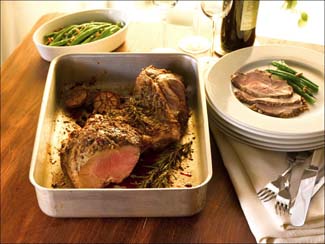 Butterfly Leg of Lamb with Anchovy and Rosemary Topping
Butterfly Leg of Lamb with Anchovy and Rosemary ToppingThis is an appealing dish for a get-together of family or friends and, although it needs to be started the day before, the actual cooking is simple and quite quick. The anchovies melt away in the cooking, but add great flavour to the topping. Serves 8
1 leg of lamb, 5½-6½ lb/2½-3kg, boned, well trimmed and butterflied
Topping:
4 cloves garlic, crushed
2oz/50g tin of anchovies
8-10 sprigs of rosemary
4 tbsp/60ml olive oil
Freshly ground black pepper
Dash of wine or water
To serve: Green beans tossed with toasted pinenuts and roast or gratin potatoes
To make the topping: Place the garlic, anchovies, leaves from 6 of the rosemary sprigs, olive oil and black pepper in a mini processor and whiz to combine. You can do this with a mortar and pestle if you prefer – mix the garlic and anchovies first, then chop the rosemary leaves finely and add them in along with the olive oil and pepper.
To prepare the lamb: Place the lamb in a large non-metallic dish and rub the mixture all over it. Cover with clingfilm and set aside for 2 hours to allow the flavours to combine. Overnight in the fridge is even better.
To cook: If the lamb has been chilled overnight, bring it back to room temperature. Preheat the oven to Gas Mark 7, 220°C (450°F). Then place it skin side up, in a large roasting tin. Scatter the reserved rosemary sprigs over the top. Roast the lamb for 10 minutes, then turn, reduce the temperature to Gas Mark 4, 180°C (350°F) and continue to roast for another 35 minutes. The lamb will be cooked medium at this stage. Remove from the oven, transfer to a carving board, cover loosely with foil and allow to rest for 10 minutes before carving.
To serve: Add a dash of wine or water to the juices left in the pan. Boil up and serve with the sliced lamb, roast or gratin potatoes and green beans tossed with toasted pinenuts.
The lamb videos and recipes available from www.bordbia.ie/summerlamb include:
· Lamb Chops with Tomato and Smoked Paprika Sauce
· Butterfly Leg of Lamb with Anchovy and Rosemary Topping
· Lamb Casserole with Cinnamon and Courgettes
· Lamb Burgers with Spicy Soured Cream Dressing
· Greek Style Lamb Kebabs with Yoghurt Dressing
· Lamb Cutlets with Fresh Herb Dressing
· Barbecue Lamb Steaks with Spicy Tarragon and Shallot Butter
Preserving Nature's Bounty
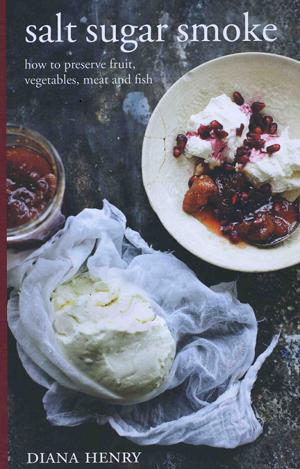
 It may not have been the best of summers but there’s a pleasing seasonal abundance of most foods nevertheless. And there’s even an over-abundance of some, particularly tunnel-grown crops, presenting the annual challenge to time and ingenuity if you want to avoid waste and enjoy them over the coming months.
It may not have been the best of summers but there’s a pleasing seasonal abundance of most foods nevertheless. And there’s even an over-abundance of some, particularly tunnel-grown crops, presenting the annual challenge to time and ingenuity if you want to avoid waste and enjoy them over the coming months.
No worries, inspiration is at hand. If you have Diana Henry’s great 2010 book Food from Plenty it’s time to take it out again for a good browse - and fans will fall on her new book with glee, as Salt Sugar Smoke (Mitchell Beazley hardback 272pp, stg£20) is another real treasure.
Originally from Northern Ireland, Diana Henry is one of Britain’s most highly regarded food writers and, although now based in London, Irish traditions remain central to her work and mingle comfortably those of other cultures – so, for example, you’ll find the homely runny ‘soft-set’ raspberry jam of her childhood here, sitting happily alongside more sophisticated specialities such as greengage and gewürztraminer jam from France and the fresh-flavoured Swedish ‘nearly’ jam, which doesn’t contain enough sugar for a set.
But, as the (brilliant) title implies, there’s much more to this book than jam making or sugar-based preserves, and many people will find the focus on smoking and salting especially interesting. As always, Diana takes the mystery out of processes that can seem intimidating – smoking fish and meats, pickling, preparing potted meats and cured fish, preserving fruits and vegetables in alcohol or oil, making cordials; all of these are an exciting challenge for any keen cook and, thanks to detailed instructions which explain fully what to expect at every stage, Salt Sugar Smoke will give you the confidence to have a go.
Many of the recipes are ideal for everyday use, but there are plenty of ideas for entertaining too: “It’s a real thrill to be able to hot-smoke six fillets of salmon and have them looking burnished and beautiful ready to serve with roast beetroot and horseradish sauce as soon as your friends arrive for supper.”
Best of all, perhaps, Salt Sugar Smoke is a great source of ideas for original gifts. In recession, it’s the small treats we allow ourselves that make the difference and this is just the ticket to cheer everyone up, whether you’re making and giving or the lucky recipient of one of these delicious conserves.
As Diana says herself, “One of the constituents of a good life is the ability to find pleasure in small things. A good jam for your toast in the morning. A chutney that is made from the apples you gathered last autumn. Cutting salt beef that you’ve made and can feed a dozen friends.”
She’s right, and this is certainly a book that I’ll come back to time and again myself, for inspiration and darn good read.
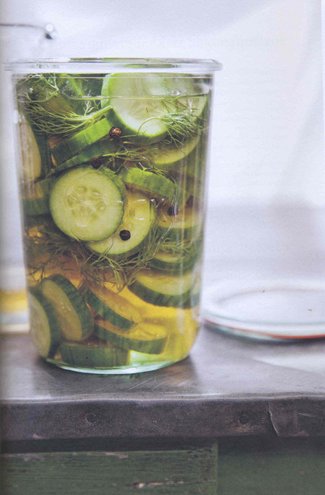 SCANDINAVIAN PICKLED CUCUMBER
SCANDINAVIAN PICKLED CUCUMBER
Sweet-sour, crisp and fragrant with dill, this is how Scandinavian pickled cucumber should be.
Fills 1 x 1 litre (1¾ pint) jar
juice of 1 lemon
450ml (16fl oz) white wine vinegar
200g (7oz) granulated sugar
1 tsp salt
10 black peppercorns
4 pickling cucumbers, cut into ¾ cm (¼ in) thick slices, plus more to fill
leaves from 4 large sprigs of dill, pulled from the stalks in large fronds
1 Put all the ingredients, except the cucumbers and dill, into a saucepan and bring to a boil, stirring a little to help the sugar dissolve. Leave to cool completely.
2 Pack the cucumbers into a sterilised jar, adding dill as you go. Pour the vinegar solution in, making sure the cucumbers are submerged. Cover with a vinegar-proof lid. Keep somewhere dark and cool. The cucumbers will sink in the vinegar solution so, the next day, add more cucumbers to the vinegar and seal. Once opened, refrigerate. Use within two months.
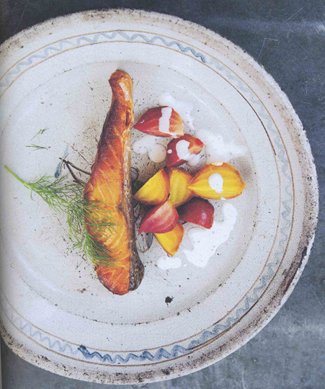 HOT OAK-SMOKED SALMON
HOT OAK-SMOKED SALMON
This is a one of the most straightforward recipes for hot-smoking. There are no added flavourings, just salt, sugar and smoke.
A stove-top smoker is used for this recipe but if you don't have one you can use a wok (see below).
Serves 4
4 salmon fillets of an even medium thickness (about 150g/5oz each)
about 50g (1 ½ oz) fine sea salt
2 tbsp soft light brown sugar
1 tbsp oak sawdust or shavings
1 Mix the salt with the sugar and sprinkle it evenly on the fish fillets. Refrigerate for 10 minutes (thick steaks can take up to 30 minutes). Rinse the fish under running water, then pat dry and return to the refrigerator for three hours so the salt can permeate better.
2 Put the sawdust or shavings in the base of a stove-top smoker and insert the drip tray (the little tray underneath the rack that comes with the smoker). Line the drip tray with foil (it makes for easier cleaning, you can just throw the foil away). Put the wire rack on top, arrange the fish on the rack (leaving room around each fillet), then slide the lid on.
3 Set the smoker over a medium heat. As soon as wisps of smoke start to appear, or you can smell the smoke, reduce the heat to low and smoke the fillets for about 30 minutes.
4 Turn the heat off and wait until you can't see any more smoky wisps, then open the smoker and check that the fish is cooked through. It should be opaque and not at all glassy looking. If it isn't quite cooked through, you can put the heat on again or you can finish off by steaming. You can eat this straight away or wrap it in cling film and, once cool, refrigerate for up to two days. If you want to serve it later and have it hot you can reheat it, wrapped in foil, in a medium oven.
To hot-smoke using a wok: put 1 tbsp hardwood sawdust in the bottom. Line the wok with foil and put a metal rack inside. Put the food to be smoked onto the rack, leaving space in between if you are smoking several pieces so the smoke can circulate. Cover tightly with a lid and put on your extractor fan. Set the wok over medium heat. Within a couple of minutes you will smell the smoke and see the first wisps. When this happens, reduce the heat to low and leave the food to hot-smoke. Check after the allotted time and continue to smoke if the food isn’t cooked through, or alternatively you can finish the cooking by roasting or frying.
How To Use: “I usually go the Scandi route with this, serving with roast beetroot (a mixture of crimson and golden beets if you can get them) drizzled with buttermilk, and warm waxy potatoes tossed with dill. Swedes also cook hot-smoked salmon in a gratin with cream and spinach (cook the spinach and squeeze out the moisture, then chop and season).”
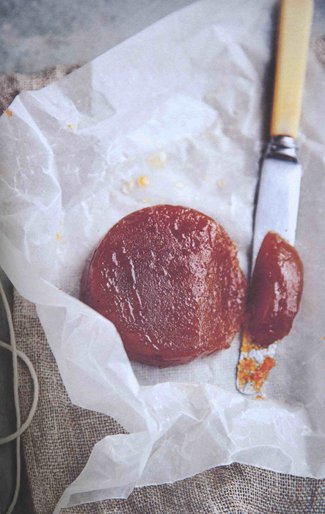 QUINCE CHEESE
QUINCE CHEESE
“Membrillo, or quince cheese, requires some patience but it is so worth it. You can now buy it in delis and some supermarkets, where you will find it called by its Spanish name.”
Makes about 1kg (2lb 4oz)
1kg (2lb 4oz) quinces
about 900g (2 lb) granulated sugar
glycerine or flavourless oil, for the moulds
food-grade paraffin wax, to seal (optional)
1 Wash the quinces, removing the little black bit at the base and rubbing off any downy covering. Chop them and put them in a heavy-based saucepan or preserving pan with enough water to cover. Bring to a simmer and cook until completely soft and pulpy. It will take about 35 minutes.
2 Push the pulp through a nylon sieve into a clean bowl. When you have sieved it all, measure it. Put the puree into a heavy-based pan and, for every 450ml (16fl oz) of puree add 450g(1lb) of sugar. Bring very gently to a boil, stirring until the sugar has dissolved.
3 Reduce the heat and simmer very gently for 1-1½ hours, until it is really thick; be careful as it can spit like a volcano. You need it to be so thick that, when you scrape your spoon across the bottom of the pan, it leaves a clear channel before closing up again. It also starts to come away from the sides of the pan as you stir, forming a thick mass.
4 Brush straight-sided moulds, such as ramekins, or small decorative moulds, with glycerine or flavourless oil. This will help you unmould the quince cheese. Pour the mixture into the moulds. Cover with a waxed paper disc, or pour over some melted food-grade paraffin wax. (Stockists are given in the book; most have websites. If you use the paraffin wax, leave the quince cheese to set a bit before pouring it on.)
5 If you want to give this as a present, or want your moulds back, you can unmould it and wrap in greaseproof paper or baking parchment, then tie with string. Properly wrapped, it keeps for a year in the cupboard or refrigerator. I find it stays moister in the refrigerator, but gets a bit sticky.
and also...
DAMSON CHEESE
Make as for quince cheese, using 1 kg (2lb 4oz) of damsons (you can't stone them as the stones won't budge until the damsons are cooked. The stones come out when you sieve the fruit). Measure the resulting purée.
Add 450g (1lb) of granulated sugar for every 600ml (1 pint) of purée.
The resulting cheese is a glorious dark purple colour which is lovely with cheeses (especially blue cheeses), patés and roast lamb or pork.
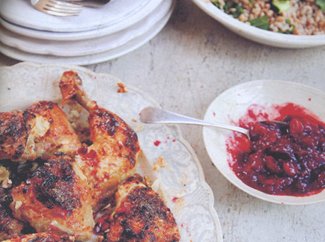 GEORGIAN PLUM SAUCE
GEORGIAN PLUM SAUCE
“I included a recipe for Georgian plum sauce in my first book, Crazy Water, Pickled Lemons, but this is slightly spicier and the addition of wine vinegar means it keeps longer. It's a little sweeter than the traditional Georgian version, but I prefer it not too tart. As it's one of my favourite sauces I don't feel bad about offering it again. Its uses go beyond Georgian food.”
Fills 1x225g (8oz) jar
500g (1lb 2oz) plums, halved and stoned
25g (scant 1oz) soft light brown sugar, or to taste
good pinch of salt
50ml (2 fl oz) red wine vinegar
3 garlic cloves, crushed
2 tsp hot Hungarian paprika
Juice of ½ lemon, or to taste
2 tbsp chopped mint
3 tbsp chopped coriander
1 Put all the ingredients for the sauce, except the lemon juice and the herbs, into a saucepan and add 50ml (2 fl oz) of water. Bring to a boil, stirring a little to help the sugar dissolve, then reduce the heat and simmer tor about 30 minutes, until the mixture is quite jammy and the plums are soft.
3 Puree the mixture (or it you prefer it rougher you can leave it as it is). Stir in the lemon (taste to see if you would like more lemon or sugar, then adjust it accordingly), then the herbs. Put into a sterilised jar and seal with a vinegar-proof lid. Cool, then refrigerate. It will last for a month.
How To Use: “In Georgia this is served with tabaka, a dish of chicken that is flattened and fried under a weight. The other traditional Georgian use is to mix it with kidney beans (they should be well seasoned, add more of the herbs used in the sauce and crushed garlic, too) to serve as part of a spread of zakuski (details given in the book). It's also very good with lamb kebabs or spicy roast lamb, and with ports.
My favourite use for plum sauce, though, is to serve it with chicken - whole or jointed - which I've marinated in. a mixture of plain yogurt or buttermilk, crushed garlic, cayenne pepper, lemon, salt and pepper for 24 hours. Make sure your chicken is covered in the marinade, and turn it a couple of times while it's marinating.
Shake off the excess marinade and roast the chicken, then scatter it with walnuts chopped with raw garlic and coriander or parsley. Pomegranate seeds look lovely sprinkled over it too.
Serve with bulgar wheat or spelt on the side, with plenty of the plum sauce.”
Cook Like Neven
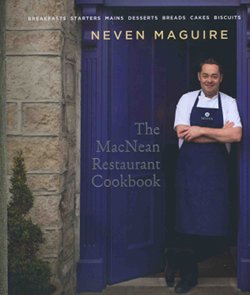
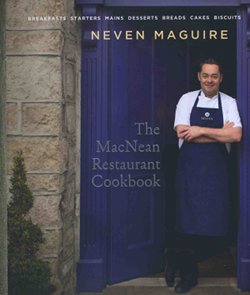 Neven Maguire has a special place in Irish food and in the hearts of Irish food lovers, and it is well earned. Whether through the family business, MacNean House & Restaurant in Blacklion, Co Cavan, his TV and competition work (including representing Ireland at the Bocuse d’Or in 2001), or the many events and individuals he has supported down the years, he has done many great services to Irish food – perhaps most notably through his dedication to his own area and the best of local seasonal produce, which (despite the fact that he is still a young man) he has vigorously supported for many years.
Neven Maguire has a special place in Irish food and in the hearts of Irish food lovers, and it is well earned. Whether through the family business, MacNean House & Restaurant in Blacklion, Co Cavan, his TV and competition work (including representing Ireland at the Bocuse d’Or in 2001), or the many events and individuals he has supported down the years, he has done many great services to Irish food – perhaps most notably through his dedication to his own area and the best of local seasonal produce, which (despite the fact that he is still a young man) he has vigorously supported for many years.
I’ve lost count of the number of cookbooks Neven has produced, but his exceptional ability to think like a domestic cook as well as a professional chef is one of the secrets of his success when demonstrating and it’s a constant trait that has always made his recipes very accessible. Even in his new book, The MacNean Restaurant Cookbook (Gill & Macmillan hardback, €24.99), which is a handsome hardback, this still applies.
Published to celebrate 30 years of outstanding cooking at MacNean Restaurant and as a tribute to his Mum Vera, who died shortly before the launch, this may be a restaurant book – and yes, the signature dishes are all there – but even in the most complex and sophisticated dishes there are elements that the home cook can attempt with confidence. It’s a reference that you would certainly enjoy using for a special occasion, and some sections – notably the excellent chapter on Breakfast, which begins the book on such a down to earth tone, and the final one on Breads, Cakes and Biscuits – could soon become well-thumbed pages in any household.
As in the restaurant itself, teamwork from a range of talented people is the secret of this beautiful book’s success: in addition to contributions from the MacNean kitchen brigade (who provided the cheffy bells and whistles that lift presentation into the fine dining class), Sharon Hearne-Smith’s assured food styling and Joanne Murphy’s superb photography create impressive visual impact, while compiler Orla Broderick and editor Kristin Jensen ensured that the text was accurate and crystal clear, making it surprisingly easy to follow.
Bringing the whole story together, a foreword by food writer Ross Golden-Bannon details the restaurant’s history and the many challenges and milestones along the way. All this, together with evocative photography of the restaurant itself, the people who created it - and those who regularly recreate it - make this fine book a great souvenir for those who have experienced visiting MacNean, and the ideal introduction for those who still have it on their wish list. The perfect gift.
RECIPES: The sample recipes given below are based on those selected from the book by Neven, for what he modestly called a ‘three course meal’ at the launch – which was, of course, a stunning gala dinner. Elements of any of these dishes could be chosen to cook at home and, although there are numerous ‘sub-recipes’ given in the book, most of these are optional garnishes and in no way essential to the success of the main item.
Where an unusual ingredient is called for, a more familiar one can usually be substituted; eg agar agar powder is a setting agent – a vegetable gelatine - so, if difficult to source, it could be replaced with ordinary gelatine.
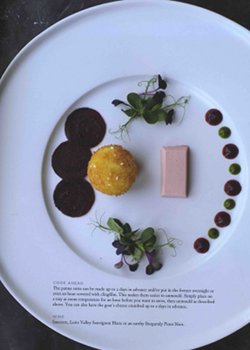 Crispy Goat's Cheese with Beetroot Panna Cotta
Crispy Goat's Cheese with Beetroot Panna Cotta
If you prefer to bake the goat's cheese, simply cook it in an oven preheated to 180°C (350°F/gas mark 4) for another 5-10 minutes, until warmed through and soft. As you can see in the photo, we use a rectangular silicone mould to make the panna cottas in, which are available from good catering shops or online. Ours are 5cm (2 in) long on the top of the mould and 2.5cm (1 in) wide.
Serves 4
25g (1oz) fresh white breadcrumbs
l tbsp finely chopped fresh flat-leaf parsley
l tsp toasted pine nuts, finely chopped
1 tsp sesame seeds
sea salt and freshly ground black pepper
1 egg
25g (loz) plain flour
150g (5oz) log of Corleggy or Ryefield goat's cheese, cut into 4 slices
groundnut oil, for deep-frying
12 slices beetroot carpaccio (recipe supplied)
basil purée (recipe supplied), to serve
fresh affilia cress, to garnish
fresh pea shoots, to garnish
fresh mixed micro salad, to garnish
For the beetroot panna cotta:
225g (8oz) raw beetroot
1 tbsp agar agar powder (vegetable gelatine; from specialist shops or online)
300ml (1/2 pint) cream
100g (4oz) soft goat's cheese (no rind)
sea salt and freshly ground black pepper
To make the beetroot panna cotta, place the beetroot in a pan, cover with water and bring to the boil over a medium heat. Reduce the heat, cover with a lid and simmer for 30-40 minutes, until completely tender when pierced with a knife. Drain and leave to cool, then peel and roughly chop the flesh. Place in a food processor and blend to a purée - you'll need 50g (2oz) for the panna cotta; place the rest in a small squeezy bottle to use as a garnish.
Dissolve the agar agar in 4 tablespoons of cold water in a small pan, whisking continuously. Bring it to the boil, then reduce the heat and simmer for 1 minute, until dissolved. Remove from the heat and leave to cool a little.
Place the cream in a heavy-based pan and bring to the boil, then remove from the heat. Whisk the cooled agar agar mixture into the cream. Stir in 50g (2oz) of the beetroot purée, then beat in the goat's cheese until evenly combined.
Season to taste and place in 4 x 120ml (4 fl oz) dariole moulds that are base-lined with parchment paper. Leave in the fridge for 2-3 hours to set, or you can make them the day before and leave overnight.
To prepare the crispy goat's cheese, mix the breadcrumbs with the parsley, chopped nuts and sesame seeds in a shallow dish. Season to taste. In a separate dish, beat the egg and season lightly. Season the flour and place in another shallow dish.
Lightly coat the goat's cheese in the seasoned flour, then dip each slice into the beaten egg, gently shaking off any excess. Place in the breadcrumb mixture so that it is completely coated. Place on a flat tray lined with parchment paper in the fridge for at least 30 minutes (or overnight covered with clingfilm is fine) to firm up.
Preheat the oven to 180°C (350°F/gas mark 4).
Heat the oil in a deep-sided pan or deep-fat fryer to 180°C (350°F) and cook the breaded goat's cheese for 1-2 minutes, until golden brown. Carefully remove from the oil and transfer to a plate lined with kitchen paper to drain off any excess oil. Arrange on a baking sheet and place in the oven for another 3-4 minutes, until heated through but still holding their shape.
To serve, dip the panna cotta moulds in just-boiled water for 5-10 seconds, then carefully invert the panna cotta onto the plates. Add 3 slices of the beetroot carpaccio to each plate. Put a dot of the beetroot puree on the plate to prevent the crispy goat's cheese from slipping, then place on top. Garnish with the rest of the beetroot puree and the basil purée. Scatter over the affilia cress, pea shoots and mixed micro salad.
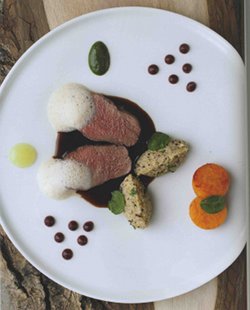 Loin of Venison with Quinoa and Spinach
Loin of Venison with Quinoa and Spinach
We use one-year-old deer from Finnebrogue, which is always tender but never very strong in taste. It's popular with customers, as it's considered a lean and healthy option, which is why I've chosen to serve it with some quinoa, this nutty flavoured superfood is the most complete protein of any grain and a fantastic source of magnesium.
Serves 4
4 x 100g (4oz) venison loins, well trimmed
sea salt and freshly ground black pepper
1 tbsp rapeseed oil
1 tsp softened butter
12 spinach leaves
quinoa (recipe supplied), to serve
beetroot puree (recipe supplied), to serve
spinach puree (recipe supplied), to serve
8 sweet potato fondants (recipe supplied), to serve
apple gel (recipe supplied), to garnish
mushroom foam (recipe supplied), to garnish
Preheat the oven to 180°C (350°F/gas mark 4).
Season the venison all over. Heat a large ovenproof frying pan until very hot. Add the oil until smoking and then cook the venison loins for 2 minutes on each side, until browned. Add the butter to the venison and allow to melt, then transfer to the oven and cook for another 6-8 minutes for medium, turning once (leave it a little longer if you prefer your meat more well done). Remove from the oven and keep warm while leaving to rest for at least 5 minutes, then carve each one in half lengthways.
Meanwhile, using a straight-sided cutter, stamp out 2.5cm (1 in) circles from the spinach and set aside until needed.
To serve, shape quenelles of the quinoa on each warmed plate. Add the beetroot and spinach purees with the sweet potato fondants. Add the spinach circles and then arrange the venison on top. Add the apple gel and spoon over the mushroom foam.
WINE
Barolo or Barbaresco, made from Nebbiolo grapes in north-west Italy, are great partners with venison. A good-quality Tempranillo wine from northern Spain would also work well.
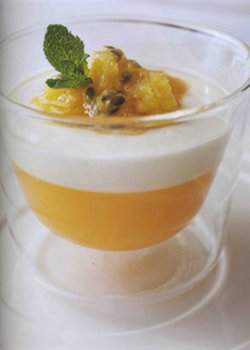 Passion Fruit and Orange Jelly with Vanilla Yoghurt and Granita
Passion Fruit and Orange Jelly with Vanilla Yoghurt and Granita
A refreshing palate cleanser in the restaurant. But equally good as a dessert served with a yoghurt ice cream - you can't beat jelly and ice cream. If you're serving them as a pre-dessert, put 50ml (2fl oz) of the jelly into 75ml (3fl oz) shot glasses. Feel free to experiment with other flavours, such as cranberry and orange, apple and vanilla or mango.
The granita can be flavoured with ginger beer, raspberry coulis or strawberry coulis and champagne. The passion fruit coulis is available in good cook shops or online in pouches and has an excellent shelf life if it hasn't been opened.
Serves 4
For the passion fruit and orange jelly:
3 gelatine leaves
300ml (1/2 pint) freshly squeezed orange juice
150ml (1/4 pint) passion fruit coulis (shop bought)
25g (1oz) caster sugar
For the passion fruit granita:
250g (9 oz) passion fruit coulis (shop bought)
125g (4½ oz) caster sugar
For the vanilla yoghurt:
200g (7oz) plain natural yoghurt
1 vanilla pod, half in half and seeds scraped out
passion fruit seeds, to decorate
fresh tiny mint sprigs, to decorate
To prepare the jelly, place the gelatine leaves in a bowl and cover with cold water. Set aside for 10 minutes to soften.
Place the orange juice in a pan with the passion fruit coulis and sugar. Bring to the boil, then take the soaked gelatine out of the water and gently squeeze dry. Add to the orange and passion fruit mixture and stir until the gelatine is completely dissolved. Set aside to cool.
Pour the cooled jelly into 4 x 200ml (7fl oz) glasses, leaving a 2.5cm (1in) space at the top. Place in the fridge to set for at least 2 hours, or overnight is best.
To make the passion fruit granita, place the passion fruit coulis, sugar and 100ml (3½ fl oz) water in a pan and bring gently to the boil to dissolve the sugar. Remove the passion fruit mixture from the heat and pass through a sieve into a rigid plastic container.
Leave to cool completely, then place in the freezer. Whisk or stir the granita every 20 minutes to break up the ice crystals until the granita is set. This will take 2-3 hours in total.
To make the vanilla yoghurt, mix together the yoghurt and vanilla in a bowl, then transfer to a squeezy bottle. Chill until needed.
To serve, add a layer of the yoghurt on top of the set jelly and spoon some passion fruit granita on top of each one. Decorate with the passion fruit seeds and mint sprigs.
COOK AHEAD
The jellies can be made 2 days in advance and the granita will keep in the freezer for 4-5 days. The yoghurt can also be flavoured 2 days in advance.
Quick & Easy Christmas Baking - Some Retro Favourites
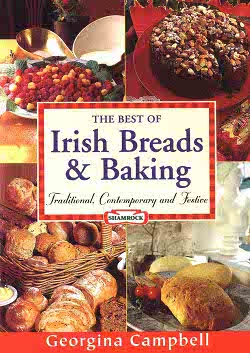
.jpg) Georgina Campbell
Georgina Campbell
Even if you’re very pressed for time coming up to Christmas, cooking a few bits and pieces is very satisfying, gets you into the festive mood - and it makes the house smell lovely too. And it needn’t take a huge amount of time either, as these tried and trusted recipes show – they’re all from that old favourite, my 1996 book The Best of Irish Breads & Baking, which is still in print (€15) and I use it all the time.
Nothing could be simpler than my easy all-in-one Quick Christmas Cake, it’s my fall-back any time a fruit cake is needed in a hurry and appears with variations all year round. Try it once and you’ll be converted.
To make it really special upgrade the ingredients to include top-of-the-range fruits – muscatel raisins for example, and whole glace fruit – from speciality food shops like Peter & Mary Ward’s Country Choice (Nenagh; also at Limerick Milk Market). And, by the way, quality glacé fruit like theirs makes great petits fours, either served simply or with the slices/slivers dipped in melted chocolate...
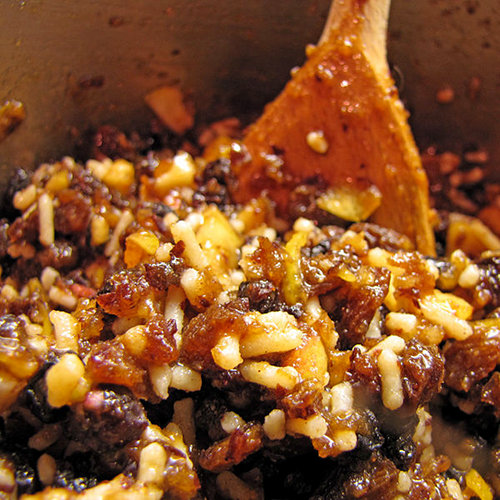 Mincemeat is not only for Christmas, it’s a finger-licking’ good ingredient for a myriad of winter bakes and puddings, so keep a jar handy to enjoy throughout the colder months. It’s very quick to make, involves no cooking, is ready to use in a fortnight or less and can easily be dressed up in jars with pretty tops on to include in a DIY hamper, or take along as a party present.
Mincemeat is not only for Christmas, it’s a finger-licking’ good ingredient for a myriad of winter bakes and puddings, so keep a jar handy to enjoy throughout the colder months. It’s very quick to make, involves no cooking, is ready to use in a fortnight or less and can easily be dressed up in jars with pretty tops on to include in a DIY hamper, or take along as a party present.
This spicy Mincemeat with Irish Whiskey is not too sweet and has a good tang. It will sometimes keep perfectly for a year, but mincemeat is really a short-term preserve - if you want to keep it longer than two or three months, freeze it.
Makes about 8 lb/3.6 Kg.
3 lb/1.4 kg mixed dried fruit (best quality): sultanas, raisins, currants
8 oz/225g mixed peel, (preferably use whole peel, chopped)
4 oz/100g glace cherries, chopped (optional)
1 lb/450g dark muscovado sugar
1 lb/450g cooking apples, eg Bramleys, peeled and finely chopped
8 oz/225g finely chopped suet, or vegetable suet
4 oz/100g almonds, blanched and slivered
11/2 tsp grated nutmeg
1 tsp ground allspice
1/2 tsp each ground cinnamon and cloves
Finely grated rind and juice of 2 juicy lemons (washed)
8 fl oz/225 ml Irish whiskey.
Mix all ingredients together in a large mixing bowl, cover with a tea towel and leave in a cool place for 24 hours, stirring occasionally. Mix well again before packing into clean, dry jars - preferably screw-top so that jars can be inverted occasionally to distribute the juices evenly. Seal and store in a cool dark place for about 2 weeks before use, inverting the jars from time to time if they are securely sealed. Any mincemeat left after Christmas will keep better if a little extra whiskey is added to the top of each jar.
Mincemeat Tarts with Streusel Topping are lighter than traditional mince pies and very attractive. Use quick Magimix Pastry (below) or One-Stage Fork Pastry (another from a range of easy pastries given in The Best of Irish Breads & Baking), both make a smooth sweetened pastry which is easy to handle and cooks to a light, crisp golden-brown. Egg whites left over from the Magimix pastry can be used to make icing, or meringues, or the mini macaroons given below.
Makes 24
1 quantity sweet short pastry (see below)
About l lb/450g mincemeat
Streusel Topping:
1 oz/25g plain flour
2 oz/50g light muscavado sugar
1 oz/50g butter.
Icing sugar to decorate.
First make up a batch of this simple Magimix sweet pastry: sift 12 oz/350g flour and a pinch of salt into the bowl of a food processor, add 8 oz/225g cubed butter and process for about 15 seconds until the mixture looks like breadcrumbs.
Add 3 egg yolks and 3 oz/75g caster or icing sugar and process for another 20 seconds or until the pastry clings together and forms a ball. Knead lightly to form a smooth dough; wrap the ball in clingfilm and chill for 30 minutes before use. (Keeps for several days in the fridge and freezes well.)
While the pastry is resting, prepare the streusel topping by rubbing the butter into the flour and sugar to form a crumb-like texture. Set aside.
Preheat a hot oven, 425'F/220'C/ Gas mark 7.
Roll out the pastry to about 1/8" / 0.3 cm thick. Stamp out 24 bases, using a 31/2"/8.9 cm round fluted cutter. Use these to line the bases of 24 bun tins, then place about a teaspoonful of mincemeat in each one - be careful not to overfill, especially if the mincemeat is very juicy. (Any leftover pastry can be re-used; freeze if necessary.)
Sprinkle with the streusel mixture and bake immediately in a preheated for about 20 minutes, or until the pastry is a light golden-brown and the streusel is nice and crunchy. Using a round-bladed knife, ease the tarts from the tins and onto a rack. Dust with icing sugar and serve warm with chilled whipped cream, or rum or brandy butter.
 For an attractive alternative to individual mince pies, try this Mincemeat Lattice Pie - and not just for Christmas, it could be ideal in the New Year. With its zesty citrus flavoured filling it makes an excellent hot dessert, whether made with the almond pastry base given below, or the quick Magimix mix pastry given above.
For an attractive alternative to individual mince pies, try this Mincemeat Lattice Pie - and not just for Christmas, it could be ideal in the New Year. With its zesty citrus flavoured filling it makes an excellent hot dessert, whether made with the almond pastry base given below, or the quick Magimix mix pastry given above.
If you’re in a hurry and have a lattice pastry cutter, use that for the topping instead of cutting the pastry strips by hand.
Serves 8-10.
Almond Pastry:
10 oz/275g plain flour
2 oz/50g ground almonds
6 oz/175g butter
3 oz/75g icing sugar
Finely grated zest of 1/2 washed lemon
Yolk of l large egg, lightly beaten
l coffee spoon (2.5ml) natural almond essence (or to taste)
3 tablespoons very cold water
l tablespoon lemon juice
Filling:
About l lb/450g home-made mincemeat
2 oz/50g ground almonds
Finely grated zest of 1/2 washed lemon
Lemon juice (see method, below)
l egg white, beaten lightly, to glaze
2 tablespoons Cointreau or Grand Marnier
Caster sugar to sprinkle over
First make the pastry: put the flour, ground almonds and roughly chopped butter into the bowl of a food processor and process for a few seconds until the mixture looks like coarse breadcrumbs. Add the sugar and finely grated lemon zest.
Mix egg yolk, almond essence, chilled water and lemon juice. Add most of it and continue to process, until the mixture forms a ball around the centre of the chopping knife, adding the rest of the liquid if necessary.
Remove the pastry, wrap in clingfilm and leave in the fridge for at least 10 minutes before rolling.
Meanwhile, preheat a fairly hot oven, 400'F/200'C/gas mark 6.
Mix together the mincemeat, ground almonds, grated lemon zest, whatever lemon juice remains from the pastry and the Cointreau or Grand Marnier. Put this mixture aside, while rolling out the pastry to line a 9"-10"/22-25 cm fluted flan ring or a tart tin with a removable base.
Re-roll the remaining pastry and cut into long thin strips. Spread the prepared mincemeat mixture over the base of the flan and arrange the strips of pastry in a lattice pattern on top.
Brush the pastry with lightly whisked egg white and sprinkle with a little caster sugar, then bake in the preheated oven for about 30 minutes, or until the pastry is crisp and brown.
Served hot with chilled whipped cream (flavoured, perhaps, with a little orange flower water), or rum or brandy butter.
 Christmas Biscuits
Christmas Biscuits
Not a bit like the sophisticated multi-coloured French paired ‘macarons’ which are all the rage at the moment, these simple old-fashioned Macaroons are easy to make and have lots of chewy texture as well as natural flavour. They can be made the usual medium size, to serve with tea or as an accompaniment to cold sweets or ices, or made smaller to use as petits fours. Intensify the flavouring by replacing the vanilla with almond essence and adding a dash of Amaretto liqueur if you like.
Makes about 2 dozen large size, or 4 dozen little petits fours:
Rice paper
4 oz/100g ground almonds
6 oz/175g caster sugar
2 egg whites
l tablespoon rice flour, cornflour or arrowroot
1/2 teaspoon vanilla extract (optional)
Split almonds to decorate.
Line two large or three medium baking trays with rice paper.
Preheat a moderately hot oven, 375'F, 190'C, Gas mark 5.
Mix the almonds and sugar, then add the unbeaten egg whites and cream the mixture very thoroughly together with a wooden spoon. Add the rice flour (or cornflour, or arrowroot) and flavouring and mix well.
Either, fill the mixture into a forcing bag fitted with a 1/2"/1 cm plain nozzle and pipe into rounds about 2"/5 cm across. Or, alternatively, use a teaspoon to pile small mounds of the mixture onto the rice paper and spread out neatly.
Press a split almond or half a glacé cherry into the centre of each macaroon, then bake in the preheated oven for 15-20 minutes or until lightly browned, risen and slightly cracked. Cut the rice paper to fit around each macaroon and cool on a wire rack. When cold, store in an airtight tin.
These pretty seasonal Star Biscuits can be made in varying sizes, and with small star cut-outs in the larger sizes, and then decorated as suggested below. Like the macaroons, they make pretty little petits fours or, if attractively packed, a charming small gift.
4 oz/100g butter
4 oz/100g caster sugar
1 egg yolk
1/2 tsp vanilla essence
5 oz/150g plain flour
2 oz/50g ground almonds
1/2 tsp mixed spice
Preheat a moderate oven, 350'F/180'C/Gas mark 4. Select a number of star-shaped biscuit cutters (or other shapes) in various sizes.
Cream the butter and sugar together until pale, then beat in the egg yolk and vanilla essence until light and fluffy. Mix the dry ingredients together and blend in to the creamed mixture to make a stiff dough.
Turn onto a floured worktop and knead lightly into shape, then roll out to about 1/4"/0.6 cm thickness and cut out shapes as you wish.
Place the biscuits on greased baking trays and bake in the preheated oven for 12-15 minutes, or until the biscuits are a light golden brown.
Cool on wire racks. When cold, decorate with coloured glace cherries, nuts, silver balls or simply with a light sprinkling of icing sugar "snow".
Comfort Cooking from Cork's English Market
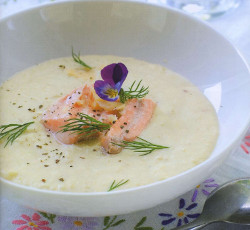
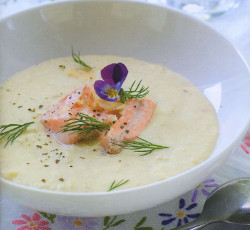 January is synonymous with comfort food - and where better to look for ideas when the weather turns chilly than Ireland’s great old traditional dishes? You’ll find these a-plenty in Michelle Horgan’s book ‘Recipes From The English Market’ (Atrium, €25).
January is synonymous with comfort food - and where better to look for ideas when the weather turns chilly than Ireland’s great old traditional dishes? You’ll find these a-plenty in Michelle Horgan’s book ‘Recipes From The English Market’ (Atrium, €25).
William’s Seafood Chowder
There are several fish stalls at The English Market, this recipe comes from William Martin, of Stall 41.
“What could be more welcoming on a cold winter's day than a delicious bowl of freshly-made chowder? William recommends that you serve this unforgettable chowder with a large slice of brown bread.”
50g/2oz butter
1 large onion, sliced
4 rashers of smoked bacon, chopped up small
250ml/9fl oz whole milk
200ml/7fi oz single cream
300ml/ ½ pint fish stock
1 large potato, peeled and cut into cubes
450g/llb Williams seafood mix
l00g/3-4 oz spinach, shredded
salt and freshly ground black pepper
2 tbsp chopped parsley to garnish
crusty bread, to serve
Melt the butter in a trying pan over a low heat. Add the onion and fry for 8-10 minutes, until very soft but not coloured. Add the bacon and cook for 5 more minutes.
Add the milk, cream, stock and potatoes. Bring to the boil, then reduce to a simmer for 10 minutes.
Add William’s seafood mix and cover the pan. Simmer for 8-10 minutes, until the fish is completely cooked through.
Add the spinach and season to taste with salt and freshly ground black pepper.
Pour into bowls, sprinkle a little chopped parsley on top and serve with crusty bread.
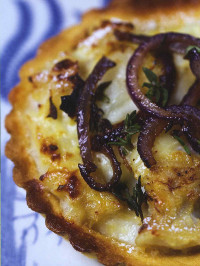 Tartlets of O'ReiIlys Tripe and Drisheen with Caramelised Red Onion
Tartlets of O'ReiIlys Tripe and Drisheen with Caramelised Red Onion
A favourite of many Irish people, this is a traditional tripe and drisheen recipe with a modern twist. Great to serve as a 'nibble' with drinks, or as an innovative starter.
[Note: Drisheen is a Cork variation on traditional black (blood) pudding; it is produced by the O’Reilly family].
Makes 12 tartlets
For the tartlets
275g/10oz plain flour
150g/5oz margarine or butter
pinch of salt
cold water to bind the flour and butter mixture into a dough
Place the flour in a large bowl and add the margarine, cut into cubes. Rub the margarine into the flour until it resembles fine breadcrumbs. Slowly add the cold water, a little at a time, stirring the mixture as you do so. When you have added enough water the flour mixture will form a ball of dough.
Knead the dough on a floured board or table and roll it out until it is thin enough to line the bottom of a queen cake tin or tartlet cases which have already been buttered.
Cut each tartlet out of the rolled-out pastry with a 5cm/2in in pastry cutter or a glass turned upside down and place each tartlet into the bun mould.
Cover each tartlet with a little greaseproof paper and fill with baking beans or a little uncooked rice. This will ensure that the pastry is covered and weighed down so that it cannot brown or bubble up. This process is known as 'baking blind'.
Cook for approximately 10-12 minutes in the centre of the oven until just cooked. Take out and leave to cool.
For the tripe and sauce filling
300g/11 oz ox tripe, cut into bite-sized pieces
salt and ground black pepper
200g/7oz creme fraiche
1 red onion, peeled and sliced
small bunch of parsley, finely chopped
½ tsp celery seed
Bring a pot of water to the boil, add the tripe and allow to simmer for 20 minutes. Drain the water and then add the creme fraiche and half of the sliced onion. Fry the other sliced onion in a little oil until it is caramelised nd put it aside to use as a garnish. Allow the chopped onion and crème fraiche to simmer for a few minutes.
Add salt and ground black pepper and some celery seed if you wish for extra flavour. If you feel that the sauce is a little too thick, add a little milk to make it more liquid. Finally, add a little drisheen chopped into bitesized pieces to the sauce and leave to simmer for a couple of minutes until thoroughly heated.
To assemble the tartlet, put a spoonful of tripe and drisheen mixture into each pastry case. Top with caramelised red onion and a sprinkle of chopped parsley.
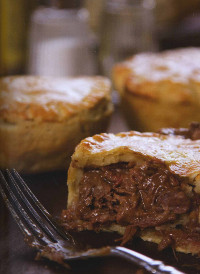 Pauline Noonan's Skirts and Kidney Pies
Pauline Noonan's Skirts and Kidney Pies
“Very delicious pies - one is never enough. Ideally, start this recipe one day in advance.”
[Note: Skirt is a cut of beef from the lower belly, now rarely found outside the English Market.]
Makes approximately 10 pies
For the pastry
275g/10oz plain flour
150g/5oz margarine
1 egg, beaten
enough cold water to bind the dough
pinch of salt and pepper
Sieve the flour and salt and pepper into a mixing bowl. Rub in the margarine with your fingertips until the mixture resembles fine breadcrumbs. Mix in the beaten egg with a knife, followed by the cold water, a little at a time, until the mixture forms a dough.
Cover with clingfilm and place in the fridge until needed.
For the skirts and kidney
450g/l lb skirts
1 kidney (some people prefer to use only ½ a kidney)
a little oil for frying
1 onion, chopped
2 cloves of garlic, crushed
½ tsp ground cumin
½ tsp ground coriander
½ tsp tomato puree
300ml / ½ pint chicken stock
Cut the skirts into bite-sized pieces with a pair of kitchen scissors (scissors seem to work better than a knife in this case). With a knife, chop the kidney into small pieces also.
In a little oil, fry the onion and garlic for a couple of minutes, then add skirts and kidneys quickly followed by the cumin, coriander and tomato puree. Stir well and allow to cook until all the meat is sealed, then add the chicken stock.
Bring the pot to the boil and then reduce to a simmer, cover the pot with a tight-fitting lid and continue to cook for 2½ -3 hours.
A Trio of Classics with Irish Meats
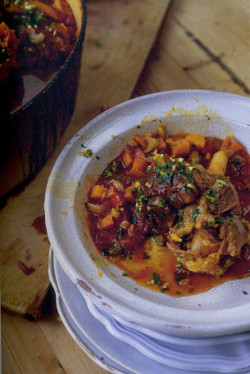
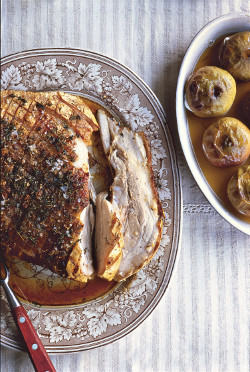 This time of year is always deceptive, the days are getting longer and everybody starts talking about spring but it’s often the coldest time of all. What’s needed in the kitchen is recipes for some fine big meals with plenty of good Irish meat and vegetables to keep out the cold.
This time of year is always deceptive, the days are getting longer and everybody starts talking about spring but it’s often the coldest time of all. What’s needed in the kitchen is recipes for some fine big meals with plenty of good Irish meat and vegetables to keep out the cold.
So I’ve gone back to a favourite book, Diana Henry’s Food From Plenty for this month’s recipes. Few food writers can match Diana Henry’s down to earth talent and, although she’s based in the UK and best known for her column in the Daily Telegraph, I always think it’s down to her Irish roots.
Great for satisfying family meals, or having friends around, these are also just the kind of simple, hearty dishes we should be able to find in pubs but rarely do.
Thyme-roasted belly of pork with baked apples
“Pork belly has everything going for it. It can be roasted with a crispy crackling or braised to produce tender, melting mouthfuls. And it's cheap.” So says Diana Henry and who can disagree - it’s my favourite cut and it makes the best roast pork of all, far better in my view than the much more expensive (and too lean) loin. The layers of fat in the belly (or ‘lap’) of pork melt during cooking, basting the layers of lean meat (and your roast potatoes) all the while, and the generous amount of crackling is every pork lovers dream come true.
So why is it that, with a few honourable exceptions (Henry Stone comes to mind), Irish chefs can’t cook belly of pork?
Every time I order it in a restaurant it’s more in hope than expectation - and almost invariably it’s a huge disappointment: dry, fussy and presented in prissy little squares with none of its natural simplicity or the wonderful contrast between sweetly succulent meat and crunchy crackling. Move over lads - if you can’t do it right, leave it to the home cooks...
Buy free range pork if at all possible, it makes a big difference to flavour, texture and cooking qualities. Although we need more, there are some good free range pork producers/suppliers, including Caherbeg Free Range Food, Co Cork; Burren Free Range Pork, Kilfenora; Crowes Farm, Tipperary; Rigneys Farm, Co Limerick; Castlemine Farm, Co Roscommon and even Ballymaloe Cookery School, Co Cork.
Serves 8
1.8kg (4lb) thick end of pork belly, rind scored (ask your butcher for the last 6 ribs)
leaves from 1 small bunch of thyme
fine flaked sea salt
freshly ground black pepper
8 smallish eating apples, preferably with tawny or russet skin
200ml (7fl oz) dry cider, white wine or apple juice
50g ( ½ oz) soft light brown sugar
juice of 1/2 lemon
1 Preheat the oven to 220°C/425°F/gas mark 7. Lay the joint, skin side up, in a roasting tin. Rub the thyme leaves and salt and pepper into the skin. Be generous with the salt as this gives crisp crackling. Roast for 30 minutes.
2 Run a knife horizonally round the middle of each apple and put in a baking dish. Heat the cider and sugar gently until the sugar dissolves. Bring just to the boil, add the lemon juice and pour over the apples. Reduce the oven temperature to 180°C/350°F/gas mark 4. Put the apples in the oven and roast them alongside the pork for a further hour (but do check the apples before then: they should be tender yet not collapsing).
3 Test the pork (a joint this size will take up to two hours): the juices should run clear when the meat is pierced. If the crackling isn't crispy enough, increase the oven temperature to 220°C/425°F/gas mark 7 and check again after 5 minutes. Allow to rest before serving each person some meat and crackling, a baked apple and its juices.
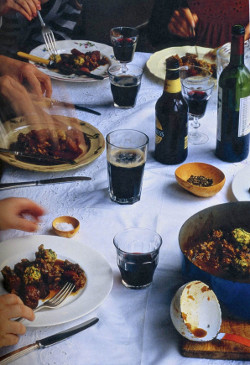 Beef and carrots in stout with parsley and horseradish dumplings
Beef and carrots in stout with parsley and horseradish dumplings
“The stout mellows in the oven to a lovely deep, chocolatey flavour,” says Diana Henry also commenting “You don't need potatoes, making this dish very cook-friendly. Buttered cabbage is delicious with it.”
A few baked potatoes wouldn’t go amiss all the same.
Serves 4-6
FOR THE BEEF
3 tbsp groundnut or sunflower oil
1kg (21b 4oz) braising beef, in large chunks
350g (12oz) carrots, sliced
300g (l0½ oz) leeks, sliced
50g (l¾ oz) pearl barley
1 x 330ml bottle stout
salt and pepper
FOR THE DUMPLINGS
½ onion, very finely chopped
15g (½oz) butter
4 tbsp finely chopped parsley
80g (2½ oz) breadcrumbs
1 large egg
3 generous tbsp creamed horseradish
1 Preheat the oven to 160°C/325°F/gas mark 3. Heat 2 tbsp of the oil in a heavy flameproof casserole and brown the meat in batches. Remove and set aside. Add the remaining oil to the pan and fry the vegetables until lightly coloured, then tip in the barley.
2 Add the stout and stir to deglaze the pan. Pour in 750ml (1¼ pints) water, return the meat and season. Bring to the boil, reduce the heat, cover and put in the oven for 2 hours. Check to make sure the casserole hasn't become dry; add more water if needed.
3 Make the dumplings: saute the onion in the butter, put into a bowl and add the remaining ingredients. Bring the mixture together and form into 12 little golf-ball-sized dumplings. The mixture will be rather loose, but persevere. Dot the dumplings on top of the beef. Cook, covered, for 20 minutes, then uncover and cook for another 10 minutes.
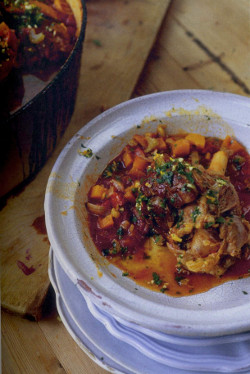 Braised lamb shanks with gremolata
Braised lamb shanks with gremolata
“Lamb shanks aren't as cheap as they were but are still good value and great reheated, so can be eaten over a couple of meals. You'll have to take whatever size shanks the butcher has, which makes cooking times difficult to specify. Just cook them gently until the meat is parting from the bone. The timings here are for the weight of shanks given; if yours are smaller, check to see when they're ready.”
Serves 8
FOR THE SHANKS
8 Iamb shanks, about 400g (14oz) each
salt and pepper
5 tbsp olive oil
2 onions, chopped
8 carrots, chopped
4 celery sticks, chopped
3 x 400g cans tomatoes in thick juice
600ml (1 pint) dry white wine
several rosemary sprigs
2 bay leaves
3 strips orange zest
FOR THE GREMOLATA
finely grated zest of 1 unwaxed orange
4 garlic cloves, very finely chopped
about 4 tbsp finely chopped flat leaf parsley
1 Preheat the oven to 150°C/300°F/gas mark
2. Remove the fat covering the lamb with a sharp knife. Season the meat. Heat the oil in a large flameproof casserole and brown the lamb, in two batches, on all sides. Set aside. Add the vegetables to the bcasserole and cook until the onions are soft but not coloured. Add the tomatoes, wine and flavourings and bring to the boil. Return the shanks and put in the oven with the lid on for 3-3½ hours, or until the meat is coming away from the bone
3. Remove the lamb and reduce the liquid by boiling until quite thick. Meanwhile, make the gremolata by mixing the ingredients together. Sprinkle over the shanks and serve.
Trust & Innovation - Two Key Ingredients in Great Irish Food

 Trust has become one of the most important ingredients in food production in Ireland today, according to the Irish Food Writers’ Guild (IFWG). “If we can’t have full faith in what is on the label, the reputation of the food sector in Ireland could be seriously jeopardised,” said Chairperson of the IFWG Myles McWeeney, who was speaking at the Guild’s annual Food Awards which took place recently, in Dublin.
Trust has become one of the most important ingredients in food production in Ireland today, according to the Irish Food Writers’ Guild (IFWG). “If we can’t have full faith in what is on the label, the reputation of the food sector in Ireland could be seriously jeopardised,” said Chairperson of the IFWG Myles McWeeney, who was speaking at the Guild’s annual Food Awards which took place recently, in Dublin.
“But the good news is that when you buy from indigenous, Irish producers, you can be assured that their products are fully traceable, that the raw materials will have travelled a relatively short distance and often, that the product is as a result of cooperation between different local producers.
“It is these wonderful artisan producers that the Irish Food Writers’ Guild Food Awards celebrate and honour and they are truly deserving of the highest recognition,” said Myles. “Thankfully, in terms of artisan food produce, the future of the food industry is in great hands. Each of today’s award-winners in their own way represents the can-do spirit of innovation that characterises this dynamic sector.”
Six Irish food companies were presented with a much-coveted IFWG Food Award at a ceremony and industry celebration at l’Ecrivain restaurant, attended by Ireland’s leading ‘foodies’.
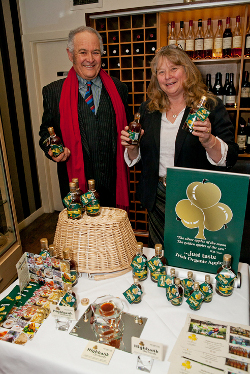 From fresh cheese made from buffalo milk and crackers packed with character, to seeds and syrup and PGI designated lamb, the winners represent the very best of Irish and were awarded for their outstanding produce and important contribution to helping retain Ireland’s reputation, at home and abroad.
From fresh cheese made from buffalo milk and crackers packed with character, to seeds and syrup and PGI designated lamb, the winners represent the very best of Irish and were awarded for their outstanding produce and important contribution to helping retain Ireland’s reputation, at home and abroad.
The 2013 winners are Rod & Julie Calder-Potts, Highbank Orchards (Co Kilkenny) for Highbank Orchard Syrup; Toby Simmonds, Toons Bridge Dairy (Co Cork) for Toons Bridge Dairy Buffalo Mozzarella Cheese and Connemara Hill Lamb Ltd., (Co Galway). A joint award was presented to Sheridans Cheesemongers (Co Meath) and Cookies of Character (Co Cork) for their range of cheese crackers.
An environmental award was presented to Co Clare-based Irish Seed Savers Association, for its dedicated work in preserving native varieties of fruit and vegetables.
Myles McWeeney continued, “Today is a celebration of the finest Irish food and wonderful artisan producers. However, as a food writers’ guild, we have a duty to acknowledge recent issues relating to the contamination of processed meat products and we urge immediate action on labelling and transparency, not just in Ireland but right across the EU.
“We welcome the Irish government’s recent response, but we have to act now to protect the hard-earned reputation of the majority of food companies, large and small, in what is one of Ireland’s most important export industries.”
NOTE - Now in its 19th year, The IFWG Food Awards is one of Ireland’s most enduring and respected awards events in Ireland. The Judging Process:
• No company or individual can enter themselves for these awards.
• Every member of the Guild is invited to nominate products they believe are worthy of an award.
• The products must be produced in Ireland and the main ingredient must be home-grown or produced.
• The producer must be trading for at least three years.
• Products are bought and paid for and a formal tasting meeting takes place where members vote, using proportional representation.
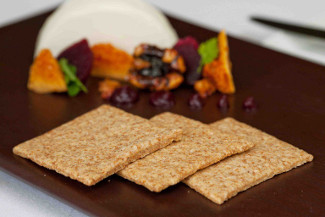 MENU & RECIPES: As has become the custom in recent years, Derry Clarke devised a superb menu based on the Irish Food Writers’ Guild award-winning products, which was served to the lucky guests attending the awards ceremony at L’Ecrivain.
MENU & RECIPES: As has become the custom in recent years, Derry Clarke devised a superb menu based on the Irish Food Writers’ Guild award-winning products, which was served to the lucky guests attending the awards ceremony at L’Ecrivain.
IRISH FOOD WRITERS’ GUILD FOOD AWARDS 2013
Lunch Menu
Toons Bridge Buffalo Mozzarella
Bavarois, Pressed Ratatouille, Basil Aioli
*~*~*~*~*~*~*~*~*~*~*~*
Tasting of Connemara Hill Lamb
Roast Leg and Rack, Braised Shoulder Pastilla,
Kidney and Sweetbread Tortellini, Buttery Greens, Smoked Bacon
*~*~*~*~*~*~*~*~*~*~*~*
Sheridans Crackers from Cookies of Character
Selection of previous IFWG award-winning Irish cheeses:
Glebe Brethan, St Killian, Wicklow Blue, Lavistown, Mossfield
*~*~*~*~*~*~*~*~*~*~*~*
High Bank Orchard
Apple and Elderflower Trifle, Apple Syrup
*~*~*~*~*~*~*~*~*~*~*~*
Tea / Coffee & Petits Fours
All recipes serve 4 and are courtesy of Derry Clarke of l’Ecrivain restaurant, Dublin.
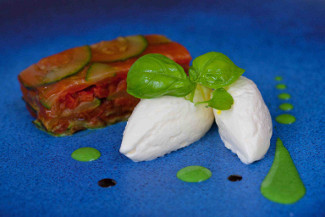 STARTER: Toons Bridge Buffalo Mozzarella Bavarois, Pressed Ratatouille, Basil Aioli
STARTER: Toons Bridge Buffalo Mozzarella Bavarois, Pressed Ratatouille, Basil Aioli
For the Basil Aioli
3 large egg yolks
½ lemon, juiced
1 large bunch basil
1 teaspoon Dijon mustard
5ml white wine vinegar
150ml olive oil
salt and pepper, to taste
1. Place the yolks, lemon juice, basil, mustard and vinegar in a food processor and blend until the basil is puréed and the mix is of a creamy consistency.
2. While still blending, slowly pour in the olive oil until the mixture emulsifies and holds a figure of eight. Season to taste and set aside or refrigerate until ready to serve.
For the Pressed Ratatouille Terrine
10ml olive oil
1 red onion, diced
1 red pepper diced
1 garlic clove
1 sprig thyme
½ courgette, diced
½ aubergine, diced
1 teaspoon tomato paste
10ml balsamic vinegar
30ml red wine
20g sugar
200g chopped tomatoes, puréed
salt and pepper
4 leaves of gelatine, soaked
1 courgette, cut into wafer-thin discs
1. Pour the olive oil into a pre-heated medium-sized pot and when hot, add the onion, red pepper, garlic and thyme and sweat until soft but not coloured. Add the courgette and aubergine and sweat for another few minutes.
2. Add the tomato paste and cook for two minutes before pouring in the vinegar, wine and sugar. Reduce to a glaze, add the tomatoes and reduce by half. Remove the sprig of thyme. Dissolve the pre-soaked gelatine in the hot ratatouille mix and season to taste.
3. Line an oiled terrine mould or bread tin with cling film and carefully place the discs of courgette on the bottom so they resemble fish scales. Pour in the ratatouille mix, tapping the mould to remove air bubbles and leveling with a palette knife. Finish with another layer of courgette discs and refrigerate to set.
4. Once set, cut the terrine to required size and set aside for plating.
For the Toons Bridge Buffalo Mozzarella Bavarois
100ml milk
1 sprig thyme
50ml semi-whipped cream
1 ball Toons Bridge buffalo mozzarella
salt and pepper
1. Combine the milk, the thyme and the cheese in a pot, bring to a simmer, remove from the heat and leave to infuse.
2. Place in a blender and pulse until smooth. Pass the liquid through a fine sieve and leave to cool.
3. Fold in the semi-whipped cream, season to taste and refrigerate until ready to use.
To serve: Place a slice of terrine off-centre on each plate. Put two quenelles of bavarois to the side of the terrine and surround with a few dots of aioli. Serve at room temperature.
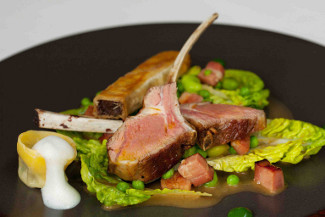 MAIN COURSE: Tasting of Connemara Hill Lamb
MAIN COURSE: Tasting of Connemara Hill Lamb
For the Braised Lamb Pastilla
1kg piece of lamb shoulder, trimmed
2 sticks celery, chopped
1 carrot, chopped
1 onion, peeled and chopped
1 garlic clove, peeled and crushed
1 sprig rosemary
1 sprig thyme
1 bay leaf
200ml chicken stock
100ml red wine
1 teaspoon tomato paste
4 squares of feuilles de brick pastry or filo pastry
1. Season the lamb shoulder with salt and freshly ground black pepper. In a large saucepan over a high heat, heat a little vegetable oil and seal the lamb brown on all sides.
2. Add the celery, carrot, onion and garlic, stir and reduce heat to low. Add the rosemary, thyme, bay leaf, stock, red wine and tomato past. Simmer gently for 1½ hours until meat is tender. Remove from heat and leave the meat to cool in its liquid.
3. Once cold, remove lamb and shred the meat into a bowl. Puree the carrot, celery, onion and a little of the cooking liquid and add to the shredded lamb. Mix and press into a terrine mould lined with cling film, put weight on top and leave to set overnight in the fridge.
4. The following day, turn out the terrine and cut into rectangles. Brush the sheets of pastry with butter and roll the lamb in them. In a medium pan with a little vegetable oil, brown the pastry-wrapped parcels on all sides.
For the rack of lamb
1 rack of lamb, French-trimmed
Salt and freshly ground black pepper
1. Preheat oven to 200ºC. Season the rack with salt and pepper and seal on both sides in a hot pan with a little oil.
2. Transfer to preheated oven for five to six minutes for pink or up to 12–15 minutes for well done.
3. Remove from oven, rest for 10 minutes and slice cutlets just before serving.
For the Buttery Greens
150ml chicken stock
75g butter
150g fresh or frozen peas, blanched and refreshed
150g broad beans, blanched and refreshed
150g diced cured bacon, blanched in boiling water and sautéed in a hot pan
4 heads baby gem lettuce leaves, washed
1 bunch chopped mint
1. Heat the chicken stock in a saucepan, add the butter and when melted, add peas, broad beans, bacon and baby gem.
2. Season to taste, add the chopped mint and set aside somewhere warm until ready to serve.
For the Pasta Dough
500g flour, sifted
3 eggs
6 egg yolks
Pinch of salt
1 tablespoon olive oil
1. Place the flour in a food processor. Add the eggs and egg yolks and process until the dough just starts to form a ball. Add the salt and olive oil and combine.
2. On a lightly floured work surface, knead the dough by hand for five minutes until smooth, adding more flour if it sticks. Wrap the dough in cling film and rest in a cool place for 1–2 hours.
3. When ready to use, roll out the dough with a pasta machine into thin sheets.
For the Kidney and Sweetbreads Tortellini
30g butter
100g lamb kidneys, trimmed and diced
100g lamb sweetbreads, blanched in boiling water and refreshed
100g mushrooms, finely chopped
1 small onion, peeled and diced
1 garlic clove, crushed
½ lemon, juiced
4 sheets of fresh pasta dough, rolled out thinly
1. Heat a frying pan with butter and a little vegetable oil, add kidneys and sweetbreads and cook for 20 seconds. Add mushrooms, onion and garlic and cook for another minute before adding lemon juice. Season to taste, remove from pan and set aside to cool.
2. Once cool, place a dessertspoon of mixture into the centre of each sheet of pasta, brush edges with egg wash and seal into tortellini or ravioli shapes. Set aside until ready to serve.
3. Just before serving, poach in simmering seasoned water for one minute.
To serve: Divide the buttered greens between four plates. Carve the rack of lamb into eight cutlets, place two on each plate, add the pastilla and tortellini and serve.
CHEESE COURSE
Sheridan’s Crackers from Cookies of Character
Served with a selection of previous IFWG award-winning Irish cheeses:
Glebe Brethan, St Killian, Wicklow Blue, Lavistown, Mossfield
Wild Food Comes In From The Cold
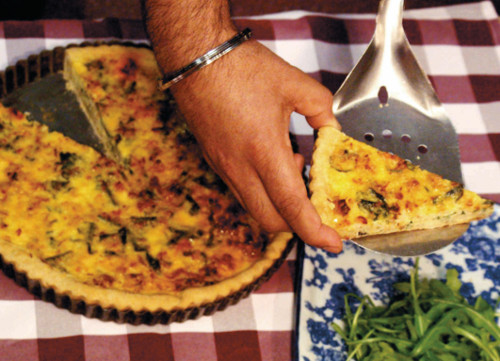
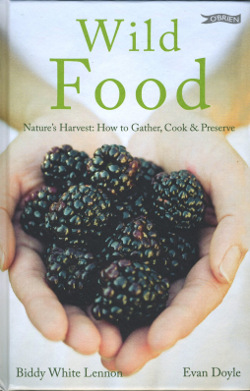 Georgina Campbell
Georgina Campbell
In last month’s review of Biddy White Lennon and Evan Doyle’s book Wild Food Natures Harvest: How to Gather, Cook and Preserve (O’Brien Press), I promised to give some of the recipes in April when (it seemed reasonable to suppose) the countryside would have lost its bleak late winter look and be in the full spring mode that tempts us all to venture out and explore.
Which all goes to show how wrong you can be. Nature has played another of her tricks, reminding us yet again that we would do well to heed her warnings. But, even though it’s so far been such a severely cold spring, the longer daylight hours mean there is a surprising amount of growth and plenty of things out there for the picking - and not only in the wild, as many edible plants are growing under our noses and generally considered a nuisance, as ‘weeds’ in the garden.
Take the nettle, for example. This perennial herb is, as Biddy says, ‘a weed in the wrong place, a versatile and tasty food in the right place’ and nettles were enjoyed and used as a spring tonic in Ireland from ancient times. She explains (in images and words) what the plant looks like, how to pick them - and only to pick the good bits, ie the tender young leaves - how to prepare them, the traditional uses, and even how to preserve them, which includes drying them to use as a herbal tea and making them into beer and wine.
Each wild food gets a similarly comprehensive run down, and the range of season is given too - in this case February to August. Some of the traditional uses for nettles are the same as for spinach or spinach beet, as in this spring soup.
As the recipes given below come from Ireland’s only certified organic restaurant, The Strawberry Tree, organic ingredients are specified.
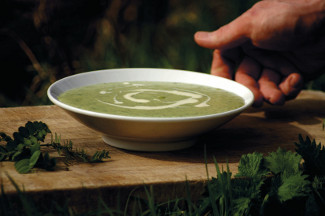 WILD NETTLE AND POTATO SOUP
WILD NETTLE AND POTATO SOUP
Season: February-August
WHAT YOU GET Is a perfect transition from the heavy winter-warmer style soups to the lighter style of summer! Flavoured with the last of the winter leeks, thickened with fabulous floury old spuds and combined with the first taste of spring with the baby wild nettles and the hint of wild garlic, this is a perfect early spring soup
WHAT GOES IN
100g wild nettle leaves, picked carefully!
10g wild garlic leaves
350g old organic potatoes, roughly chopped
1 large organic onion sliced
1 stick of organic celery, chopped roughly
1 organic leek, sliced
2 bay leaves
1 litre organic vegetable stock
50ml organic cream
Organic olive oil, sea salt, black pepper and ground nutmeg
A little wild garlic pesto or cream, and a little nutmeg
HOW IT GOES
In a large pot, heat oil and simmer onions, celery and bay leaves together until soft. Add the leeks and cook for a few minutes, season lightly with the sea salt, black pepper and the ground nutmeg and then add in the potatoes. Stir everything together and in the vegetable stock.
Bring to the boil, then simmer until the potatoes are soft. When the potatoes are cooked, add in the wild nettles and wild garlic, cook for a few minutes, remove from the heat and blitz in processor until smooth.
HOW TO FINISH
Pour soup purée back into the pot; add cream to a pleasing consistency, reheat and season with sea salt and black pepper as desired. Serve with a swirl of wild garlic pesto or cream topped with ground nutmeg.
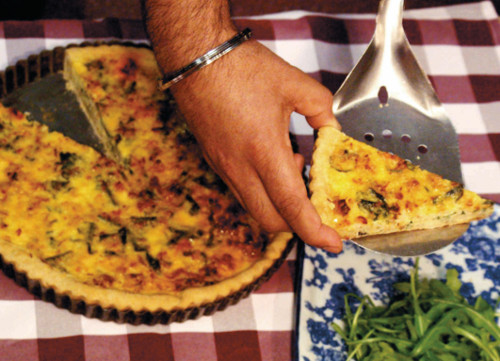 WILD SEA BEET AND WILD CRAB TART
WILD SEA BEET AND WILD CRAB TART
Season: March-November
WHAT YOU GET Is a quiche-style seafood pie that oozes the sea and that can be served cold, warm or hot, all the way through the summer. We like to serve it warm, with a baby leaf salad and mayonnaise baby new potatoes.
WHAT GOES IN
Two handfuls of sea beet, stalks removed, leaves washed, roughly chopped
300g fresh wild crabmeat
1 organic onion, finely chopped
2 garlic cloves, crushed and chopped
1 red chilli, de-seeded and finely chopped
1 bunch coriander, roughly chopped
Juice of one lemon
50g Parmesan, grated
250ml organic cream
4 organic egg yolks, plus 1 whole egg
Sea salt and pepper
Organic olive oil
Your favourite recipe for savoury pastry, blind baked in a 20-22cm tart dish
HOW IT GOES
In a large frying pan, fry onions until soft. Then add chilli, garlic and fry for a few more minutes. Add the sea beet, and when soft, toss in the crabmeat. Fry together and mix thoroughly, then add the coriander, lemon juice and Parmesan.
Lightly beat together the egg and cream and season.
HOW TO FINISH
Spoon the sea beet mixture into your baked tart case. Pour over your egg and cream. Bake, for 30-40 minutes at 140°C, or until set.
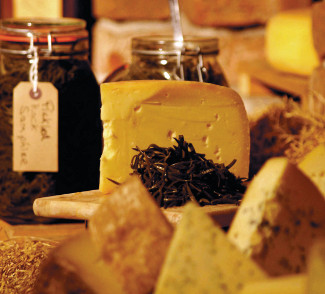 PICKLED WILD ROCK SAMPHIRE
PICKLED WILD ROCK SAMPHIRE
Season: March-November
Samphire is found at the upper end of seashores with rock outcrops or shingle, and colonises dry stone seawalls. At The Strawberry Tree restaurant they find that “pickled samphire works well with all shellfish, but it is also perfect to keep for when flatfish are caught after September. It is also a treat with honky-heady Irish blue cheese or really well-matured Irish hard cheeses and, finally, is a cool pickle that works really well with slow-cooked winter Irish Hill Hogget.” (ie mature, one year old lamb).
WHAT GOES IN
500g wild rock samphire
300g organic caster sugar
Small organic onion, sliced finely
1 organic celery stick, chopped finely
2 organic bay leaves
½ tsp organic pink peppercorns
½ tsp organic fennel seeds
1 tsp organic mustard seeds
½ organic red chilli – chopped finely
Zest of 1 lemon
500ml organic red wine vinegar
HOW IT GOES
Twice wash the wild rock samphire and set aside in a large container. In a large pot, place sugar, onion, celery, bay, seeds, chilli, lemon zest and pour over the vinegar. Put on the heat and stir until everything is mixed. Bring to boil and then simmer for a few minutes. Let cool a bit, then pour the pickle over the rock samphire in the large container.
HOW TO FINISH
Pack the warm rock samphire into sterilised Kilner jars, then pour in the strained pickle, filling the jar right to the top. Put the lids back on and it will keep up to 3 months in a cool, dark place.
*** For more about foraged food and wild food recipes, see this month’s Darina Allen Column, and also In Season.
At Home with Hake
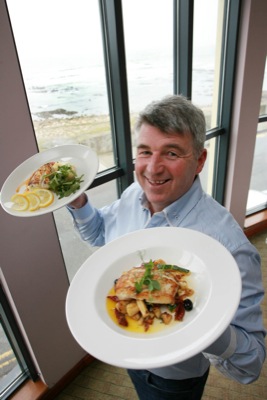
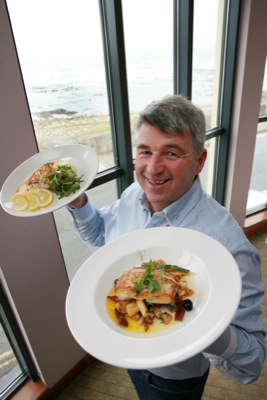 It seems an incredible amount of money but, according to recent figures from Bord Bia, Irish shoppers spent €3.5 million on fresh hake last year – which is a staggering an increase of 83% on 2011. But they also discovered that 42% of people who love eating fish when dining out don’t have the confidence to prepare it at home.
It seems an incredible amount of money but, according to recent figures from Bord Bia, Irish shoppers spent €3.5 million on fresh hake last year – which is a staggering an increase of 83% on 2011. But they also discovered that 42% of people who love eating fish when dining out don’t have the confidence to prepare it at home.
Enter our piscine knight in shining armour, Martin ‘Mad About Fish’ Shanahan, who has come up with a new collection of tasty hake recipes to inspire the nation at meal times.
The following examples give the flavour, and you’ll find more at www.bordbia.ie/fish along with tips for buying, storing and cooking fish.
Poached Hake with Mustard and Honey Dressing
We all know the health benefits associated with eating fish. This hake recipe is simple to cook, is low in fat and tastes great. (Cooking time 30 minutes)
Serves 4
Ingredients
4 hake fillets, about 175g each, skinned and boned
½ lemon cut into slices
Bunch of parsley
1 tablesp. black peppercorns
Salt
4 medium leeks, trimmed and sliced
2 carrots, peeled, cut into half lengthways and then into discs
Mustard and Honey Dressing:
1 tablesp. wholegrain mustard
3 tablesp. honey
3 tablesp. white wine vinegar
A little salt and pepper
100ml olive oil, extra virgin if available
Juice of ½ lemon
1 tablesp. chives, chopped
First make the dressing: Place the mustard, honey, white wine vinegar and a little salt and in a bowl. Whisk in the olive oil, lemon juice and chives. Taste for seasoning. Set aside.
To poach the hake: Pour approximately 200ml water into a shallow frying pan which is big enough to fit the hake fillets in a layer. You will need enough to cover the fish. Add in the lemon slices, sprigs of parsley, black peppercorns and a little salt. Bring to the boil. Reduce the heat and gently slide in the hake fillets. Simmer for 10 minutes.
Meanwhile, in a separate saucepan, heat some water, add the sliced carrots and salt and pepper. Cook for 2-3 minutes. Add the leeks and continue to cook for another couple of minutes until the vegetables are tender. Drain well.
To serve: Gently remove the fish from the water and drain on kitchen paper. Divide the vegetables between four warmed plates, place a fillet of hake on top and spoon over the dressing
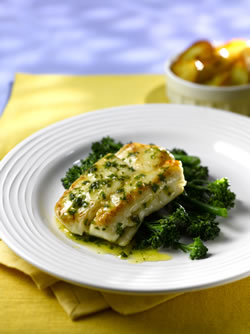 Pan-fried Hake with Lemon and Herb Butter Sauce
Pan-fried Hake with Lemon and Herb Butter Sauce
Of course this recipe is great with just parsley but experiment with a combination of soft fragrant herbs sauce as parsley, chives and tarragon or chervil depending on what’s available. Steamed broccoli and sautéed new potatoes would be good accompaniments.
Serves 4
Ingredients
4 x 175g hake fillets, skin on and boned
1 tablesp. olive oil
Salt and freshly ground pepper
50g butter
½ lemon, pips removed
1 tablesp. chopped mixed herbs (parsley, chives and tarragon)
To Cook
Heat the olive oil in a large frying pan and add the seasoned hake fillets, skin side down. Cook for a couple of minutes until the skin is just beginning to crisp, then add little knobs of butter to the pan around each hake fillet and cook for another couple of minutes until the skin is crisp.
Turn the hake fillets over and cook for another 3-4 minutes until cooked through. This will depend on the thickness of the fillets. Transfer to warmed plates while you make the sauce.
Add the rest of the butter to the frying pan and allow it to gently melt over a moderate heat. When it has melted, add a squeeze of lemon juice and the herbs, swirling to combine. Season to taste. Spoon this sauce over the hake fillets and serve with steamed broccoli and some sautéed new potatoes.
Tips: Above all be careful not to overcook the fish. To check, gently prod the thickest part of the fish with a small knife. If it is cooked, the flesh will look opaque and the flakes will separate easily. If it isn’t done yet, it will still have the translucent look of raw fish.
Other fish you could use: Whiting, haddock or trout fillets
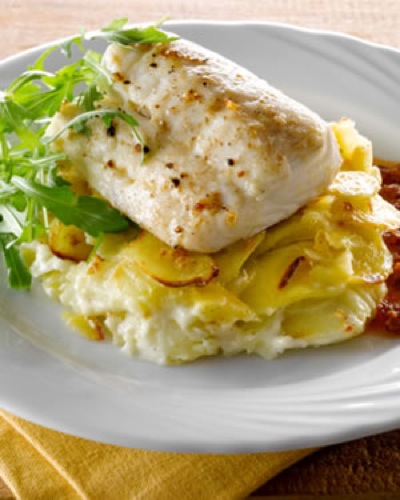 Grilled Hake with Garlic Potatoes and Sun-Dried Tomato Dressing
Grilled Hake with Garlic Potatoes and Sun-Dried Tomato Dressing
This is the perfect dish for a Saturday night dinner with friends and it couldn't be easier to prepare. (Cooking time, 1 hour)
Serves 4
Ingredients
4 hake fillets, about 175g each, skinned and boned
25g butter, softened
Garlic Potatoes:
900g potatoes, peeled and thinly sliced
150ml milk
300ml light cream
2 garlic cloves, peeled and sliced
A little grated nutmeg
Salt and freshly ground black pepper
Sundried Tomato Dressing:
100g semi sundried tomatoes
2 tablespoons pine nuts, toasted
1 clove garlic, peeled and chopped
8 tablesp. olive oil
Juice of ½ lemon
Salt and pepper to taste
Preheat the oven to Gas Mark 4, 180°C/fan 160°C (350°F).
Put the potatoes, milk, cream, garlic, nutmeg and a little salt and pepper in a large saucepan and bring to the boil. Reduce the heat and simmer for 3 minutes, stirring regularly.
Remove from the heat and transfer the potatoes and sauce to an ovenproof baking dish. Cover with foil and bake for 40 minutes. Remove the foil and bake for a further 15 minutes until the top is golden.
To cook the hake: Preheat the grill to hot. Place the fish, flesh side up, on a baking sheet which has been lined with foil and oiled, brush with a little softened butter and season with salt and pepper. Grill for about 8-10 minutes until the fish flakes easily.
Meanwhile place all the ingredients for the Sundried Tomato Dressing in a food processor and whizz until puréed.
To serve: Place a spoonful of garlic potatoes in the centre of the plate, top with the grilled hake and drizzle over some Sun-Dried Tomato Dressing. Garnish with the wild rocket salad.
Cookery Feature - First Find Your Spring Chicken...
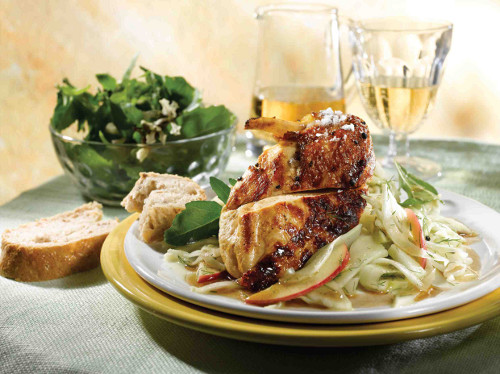
Georgina Campbell
Chicken is - for many reasons - one of the best examples of the disconnect that exists between the food on our plates and its origins. All of our foods have their natural season but we’re so used thinking of chicken as an all-year product that seasonality doesn’t come into it any more.
It may not have the relevance that it once did but, when you think about, it all birds reproduce in spring and those fluffy chicks we associate with Easter are ready for the table in about 12-14 weeks if traditionally reared.
So high summer is a very good time to ask your local butcher for traditionally reared free range spring chicken (organic if possible). Enjoy it simply roasted and served with the traditional accompaniments (hard to beat), spit-roast over a barbecue or perhaps in one of these favourite recipes from Bord Bia - not new, but they’re lovely tasty dishes and colourful for summer.
 Chicken Breast with Fennel and Rocket Salad
Chicken Breast with Fennel and Rocket Salad
Simple and special - takes only about half an hour to prepare and the salad can be prepared ahead. You might try using Irish rapeseed oil instead of the olive oil in the marinade.
Serves 4
4 chicken breasts, skin on
Juice of 1 lemon
1 tablesp. olive oil
Salt and black pepper
Fennel Salad
2 fennel bulbs, sliced thinly as possible
2 tablesp. olive oil
Juice of 1 lemon
1 tablesp. good quality mustard
Handful rocket leaves per person
To serve: Drizzle of olive oil, balsamic vinegar and black pepper
Set oven Gas Mark 4, 180°C, 350°F.
An hour or two ahead, if possible, place the chicken breasts in a shallow dish. Pour over the lemon juice, olive oil and seasoning.
Prepare the salad – put the sliced fennel in a large bowl, in another small bowl mix the olive oil, lemon juice and mustard together, taste for seasoning. Mix the fennel and dressing together – set aside.
Seal the chicken breasts on a hot pan until well browned. Then finish cooking in the oven for 10-15 minutes.
To serve: Slice the chicken, serve with a mound of the salad and the rocket leaves on top. Drizzle with a little olive oil and balsamic vinegar and a little black pepper.
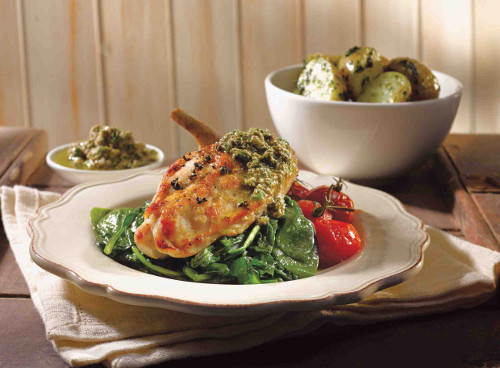 Pan-Fried Chicken with Walnut & Lemon Dressing
Pan-Fried Chicken with Walnut & Lemon Dressing
Easy to prepare and with good flavours, this might make a rather special mid week meal.
Serves 4
4 chicken breasts, skin on
Salt pepper and lemon juice
Dressing
100g walnuts
2-3 cloves garlic
Juice of a lemon
1 teasp. ground cumin
2 tablesp. coriander, chopped
125ml olive oil
Salt pepper and sugar to taste
4 scallions, chopped
To Cook
Season the chicken with salt, pepper and lemon juice. Set aside.
Set the oven to Gas Mark 4, 180°C, 350°F.
Toast the walnuts in a dry pan, then tip them into the processor with the other dressing ingredients. Whiz for a few seconds. Taste for seasoning, leave in the fridge until ready to serve.
Heat a pan or black grill pan. Cook the chicken skin side down for 4-5 minutes to get a delicious crisp skin. Turn over and cook for another 2-3 minutes. Finish the cooking for another 10-15 minutes in the hot oven.
Very good served with spinach, a few new potatoes and a spoonful of the dressing on top.
Any leftover dressing will last for a week in the refrigerator.
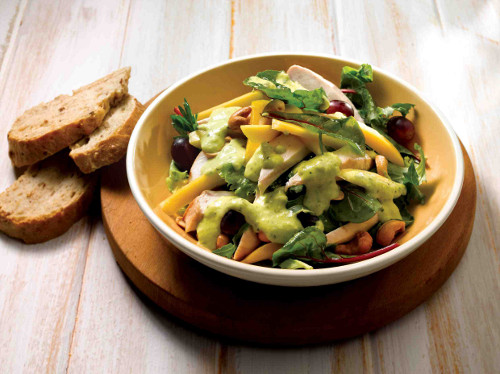 Warm Chicken Salad with Cashew Nuts and Mango Dressing
Warm Chicken Salad with Cashew Nuts and Mango Dressing
Ideally, roast a whole chicken with lots of garlic cloves, a few sprigs of rosemary, lemon wedges stuffed into the cavity and seasoned with salt, black pepper and cayenne pepper. Cook until the juices run clear.
Then an hour or two later, take the meat off the bone and make the salad. If you haven’t time to roast a chicken then you can just grill a few chicken breasts, slice them up and make the salad.
Serves 4
4 chicken breasts, cooked and sliced
Handful salad leaves per person
1 mango, sliced
Handful seedless black grapes
50g cashew nuts
Dressing
1 mango, peeled and chopped
3-4 scallions, chopped
Handful of basil leaves
1 tablesp. rice vinegar
4 tablesp. olive oil
Salt, black pepper and a pinch of sugar
To cook
Start with the dressing, put all the dressing ingredients in the processor, give it a quick whiz, taste for seasoning.
Coat the salad leaves in a little of the dressing, arrange the leaves on individual plates or in one large bowl. Add the sliced mango, grapes, nuts and chicken. Drizzle over the dressing and serve with some good crusty bread.
Cookery Feature - Wild & In Season Now
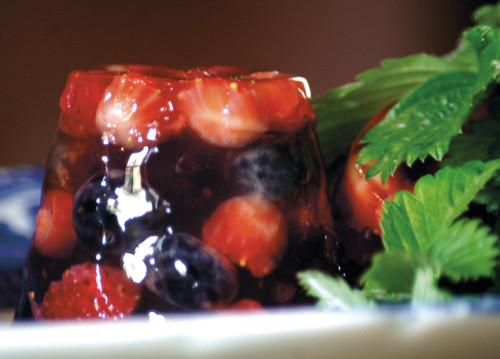
Georgina Campbell
It’s a great time to look for wild fruit in the hedgerows and heathland - finding wild strawberries to pick and enjoy while you amble along quiet laneways in sunny areas is the stuff that summer holidays are made of, and it’s also well worth seeking out some bilberries before the birds get them. Wherever heathers thrive, there’s a chance you’ll find bilberries too.
We think of fungi as an autumn crop, and so they are - but some varieties such as chanterelles start to come into season in late summer, so keep an eye open for these colourful and very tasty mushrooms when walking in woodlands.
As promised earlier in the year, we are featuring some more recipes based on wild foods in season, from Biddy White Lennon and Evan Doyle’s book Wild Food – Nature’s Harvest: How to Gather, Cook & Preserve. (Published by The O’Brien Press; from good bookshops nationwide, €16.99/£14.99.)
 WILD STRAWBERRY, BILBERRY, BLACKBERRY AND ROSE WATER JELLY
WILD STRAWBERRY, BILBERRY, BLACKBERRY AND ROSE WATER JELLY
Wild Strawberry in season from June-Late September
WHAT GOES IN
1 handful wild strawberries
2 handfuls wild bilberries
2 handfuls wild blackberries
750ml water
400g organic sugar
½ vanilla pod
5 leaves of gelatine
4–5 drops of rose water
250ml organic sparkling white wine
HOW IT GOES
Place the water and sugar into a saucepan with the half vanilla pod, split. Bring slowly to boil to dissolve the sugar. Soak the gelatine leaves in a bowl of cold of water. Add gelatine into hot liquid and stir until you are sure gelatine is fully dissolved through the liquid. Whisk rose water drops into the liquid and add the white wine.
Use a large mould, just as your grandmother did, for placing in the centre of the table. Or, use individual dariole moulds or coffee cups or whatever shape you like. Place a layer of the wild strawberries in the bottom of mould and just cover with the jelly liquid. Allow this layer to set in fridge. Keep the remainder of the liquid jelly warm. When set, add another layer of berries. This time using all three types of berries (wild strawberries, wild bilberries and wild blackberries). Repeat layering process until mould is full.
HOW TO FINISH
Allow to set in fridge. To turn out, dip jelly mould into hot water for a few seconds and turn out onto serving dish.
WHAT YOU GET
Is an adult jelly of summer fruits that will transport you back! This jelly pays homage to the illusive and hard to harvest wild strawberry. That’s why it has pride of place for the first spoon at the top of the mould when it is inverted. We feel that the rose water adds to the deep perfume taste of this fabulous wild fruit.
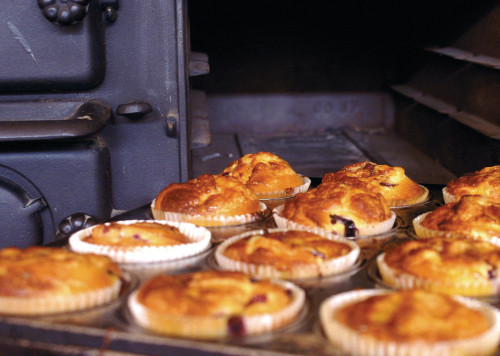 WILD BILBERRY CHEESECAKE MUFFINS
WILD BILBERRY CHEESECAKE MUFFINS
Wild Bilberry in season from late July-August
WHAT GOES IN
Muffin mix:
225ml organic milk
75g cold unsalted organic butter, cut into chunks
2 organic eggs
225g organic plain flour
125g organic sugar
2 tsp baking powder
Pinch of sea salt
100g fresh wild bilberries, washed
Cheesecake mix:
150g organic soft cream cheese
160g organic sugar
1 organic egg
Vanilla seeds and pulp from ½ vanilla pod
HOW IT GOES
Pop paper muffin cases into 12-cup muffin tin.
For the cheesecake mixture, combine the cheese, sugar, egg and vanilla pulp and set aside.
For the muffins, put the milk and butter in a small pot and heat slightly, stir until the butter is melted. Take off the heat and let cool down, then beat in the eggs. In a bowl, mix the flour, sugar, salt and baking powder together, pour in the milk-butter mix and work it until well combined. Gently fold the berries into the mixture.
Spoon the muffin mix into the prepared muffin cases and top this up with 2 tsp of the cheesecake mix. Then with a metal skewer or thin knife, swirl this mixture right to the base of the paper cases.
Bake the muffins for about 20 minutes between 180°C and 200°C. Allow them cool for 10 minutes in the tin before taking them out.
WHAT YOU GET
A lighter muffin with the cheesecake that really suits the fresh summer taste of wild bilberries. If you can resist them straight out of the oven, re-warm before serving with some good strong coffee, perfect.
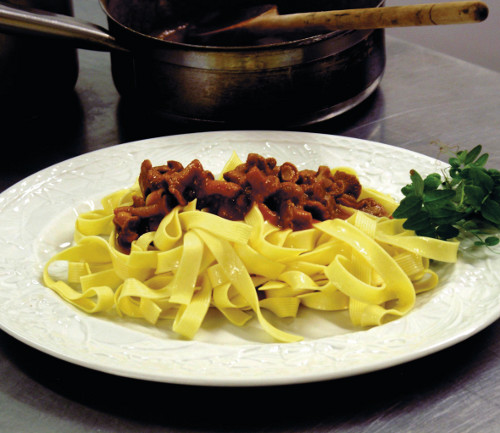 WILD CHANTERELLE GOULASH
WILD CHANTERELLE GOULASH
Wild Chanterelle in season from July-November
WHAT GOES IN
1kg wild chanterelles
2 organic onions, finely diced
2 organic red peppers, diced
100g organic streaky bacon or pancetta, diced
1 organic garlic clove, finely chopped
2 tbsp organic tomato purée
1 rounded tbsp sweet paprika powder
300ml organic vegetable or chicken stock
A splash of organic white wine vinegar
50ml organic cream
½ bunch parsley, chopped
Organic crème fraiche
Sea salt and black pepper
Organic rapeseed oil for frying
HOW IT GOES
Brush or wash the chanterelles very quickly under running water, pat dry.
Heat some oil in a pan and fry the mushrooms quickly, put in a sieve set over a bowl and save the poured-off liquid.
Fry the diced onions over medium heat until golden, add the peppers, garlic and bacon and fry for another 5 minutes. Reduce the heat, put the tomato purée in and stir well, avoid burning the purée. Add the paprika powder and then deglaze it with the vinegar.
Pour the stock and the saved liquid from frying the chanterelles and cook it gently for 15−20 minutes. Add the cream, season with salt and pepper and blitz in a processor.
Strain through a sieve into a pot. Put the chanterelles back in the sauce and cook for a few more minutes.
HOW TO FINISH
Fold in the chopped parsley and season to taste. Garnish with, or fold in, a dollop of crème fraiche
WHAT YOU GET
Is a summer-special goulash with all the flavour of the chanterelle. Perfect served as its original decreed, with bread dumplings, or maybe with pasta or rice instead. As a supper with friends or even a TV snack. Just spoon over a slice of fresh grilled bread, and enjoy.
Cookery Feature - Use Your Loaf
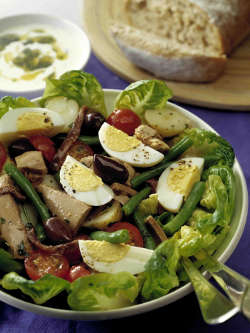
 Georgina Campbell
Georgina Campbell
The Gathering is one thing - the sort of get togethers that are pre-planned and organised to within an inch of their lives - but there’s no time like high summer for ‘unexpected guests’ to turn up on the doorstep looking hungry.
This is when ordinary everyday groceries and freezer staples come into their own. With fridge basics like cheese and eggs; store cupboard items such as canned tomatoes, pulses and fish; a freezer stocked with a few meats (a roasting joint or chicken, rashers and sausages, some casserole cuts), a couple of packs of smoked fish and shellfish, frozen pastry, breads and fruits all things are possible.
Along with fresh seasonal fruit & veg, they are quick and easy to transform into tasty meals for hungry friends.
Nicoise Salad
It’s hard to beat eggs when you need a quick and easy meal in a hurry and if you have some tinned tuna and anchovies in the larder this Nicoise Salad makes a main course for four or starters for eight in 15 minutes flat. Serve plated, or in one large salad bowl.
500g (1 lb 2oz) small potatoes, boiled and chopped
225g (8 oz) green beans, lightly boiled
200g can tuna, flaked
12 cherry tomatoes cut in half
4 eggs, boiled for 10 minutes, cooled in cold water and peeled
A handful of black olives
4 anchovy fillets cut in half lengthways
1 cos lettuce or mixed leaves
Dressing:
3 tbsp. sunflower oil
1 tbsp. wine vinegar
1 tbsp. Dijon mustard
Salt and pepper
2 tbsp. mayonnaise
1 tbsp. basil, finely chopped
Mix the oil, vinegar, mustard and seasoning together.
To assemble the salad, place the potatoes, green beans, tuna, tomatoes and leaves in a large bowl, mix with half the dressing, divide between four large or eight small plates.
Cut the eggs in four and divide between the plates, along with the black olives. Mix the remaining dressing with the mayonnaise and the basil.
Drizzle the dressing over and top with the anchovy strips. Serve with crusty bread.
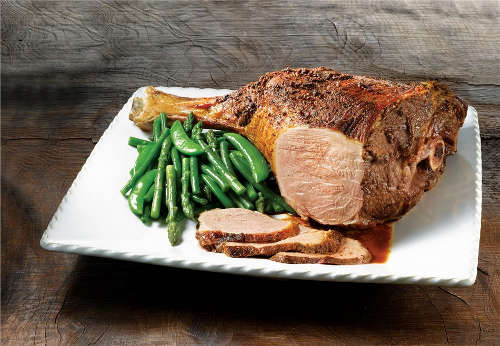 Roast Leg of Lamb with Spicy Topping
Roast Leg of Lamb with Spicy Topping
Roasts are not just for Sunday - juicy roast meat or poultry is perfect for a crowd at any time and this spicy Bord Bia variation on traditional roast lamb suits dinner at least as well as lunch.
Cooking time is about an hour and a half, so the cook has time to mingle with guests while it’s in the oven.
Start a day ahead, if possible - mix the spice mixture and rub over the lamb, leave in the fridge overnight.
Serves: 10-12
1 good-sized leg of lamb approx. 2 ½kgs
Salt and freshly-ground black pepper
Spice Mixture Ingredients:
1 tbsp. ground turmeric
1 tbsp. ground cumin
Half teasp. chilli flakes
1 tsp. cayenne
1 tsp. ground ginger
Half teasp. cinnamon
1 lemon, rind and juice
1 tbsp. honey
1 tbsp. chopped ginger
Heat the oven to Gas Mark 5, 190°C (375°F).
Remove the lamb from the fridge 20-30 minutes before cooking to allow it to come to room temperature.
Place the lamb in a roasting tin, season, then place – uncovered - in the oven and roast for 1¼ hours. The lamb will be cooked medium at this stage. (Roast some potatoes and red onions alongside the lamb for the last 50 minutes.)
Remove from the oven, wrap loosely in foil and allow to rest for 15 minutes before carving.
Meanwhile, steam a mixture of green vegetables such as beans, mange tout and asparagus. Season with a little salt and black pepper and stir through a little softened butter. Serve the sliced meat and vegetables together with the roasting juices.
Variation: Use the same topping on butterflied leg of lamb and barbecue for 40 minutes.
Bread - ordinary or artisan, depending on your preference and availability - is always great standby and it’s well worth keeping several different types in the freezer for meals in a hurry.
And that was the message from Irish Pride when they launched their new Slimsters low calorie range recently - cleverly timed to coincide with The Gathering, they commissioned food writer Marilyn Bright to devise a range of recipes demonstrating the versatility of bread, including this Salsa Piccante, a zesty Italian style sauce combining sunny Mediterranean flavours; gives a lift to chicken, fish or vegetables and no cooking required.
125g fresh breadcrumbs using any bread of your choice
4 anchovy fillets (from a tin)
1 clove garlic - chopped
2 tbsp parsley - chopped
1 tbsp capers
50g pinenuts
5 tbsp wine vinegar
100ml extra virgin olive oil
225g fresh ripe tomatoes, seeded and chopped
salt, pepper.
Combine anchovies, garlic, parsley, capers and pine nuts in a food processor and blend to a coarse paste. Add breadcrumbs, vinegar and olive oil and blend until well mixed.
Finally stir in chopped tomatoes and blend very briefl¬y to retain the slightly coarse texture.
Season to taste and serve with hot or cold foods.
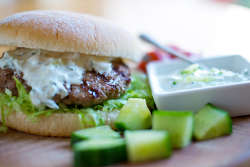 Greek Style Lamb Burgers with Floury Baps
Greek Style Lamb Burgers with Floury Baps
A good burger is always welcome and lamb is especially flavoursome, especially when served with a refreshing tzatziki sauce.
450g lean minced lamb
1tbsp chopped fresh herbs, eg rosemary, thyme and oregano
1 or 2 cloves of garlic, crushed
juice of ½ lemon
salt, freshly ground black pepper.
Tzatziki Sauce:
½ cucumber - deseeded and grated
125ml Greek style natural yogurt
1 clove garlic - crushed
2 tsp ¬finely chopped fresh mint
2 tsp white wine vinegar, pinch of salt.
Combine the lamb with fresh herbs, garlic and lemon juice. Season to taste, form into burgers, and refrigerate until ready to cook.
Make the sauce by combining all listed ingredients.
Grill or pan fry burgers until done and serve on Floury Baps with tzatziki sauce and salad leaves.
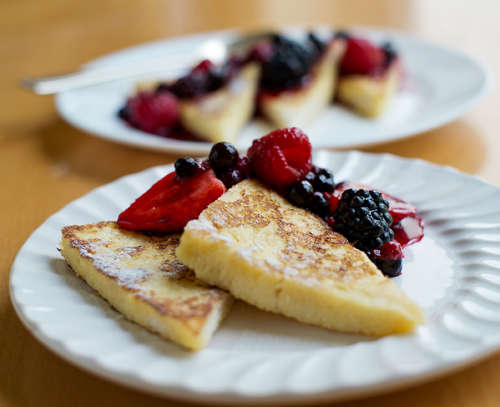 French toast with summer berries
French toast with summer berries
This breakfast or brunch favourite doubles as a quick dessert when dressed up with fresh or frozen berries. Day-old thick sliced pan is perfect for this.
Serves 4.
6 slices day-old toasting bread
2 eggs
200ml milk
1 tbsp sugar
1/2 tsp vanilla essence (optional)
Butter and oil to fry
2 cups fresh or frozen berries
icing sugar to garnish
Trim crusts and cut bread into quarters. Beat together the eggs, milk, sugar and vanilla if using.
Dip each slice into the mixture. Heat a little butter and oil in a large frying pan and fry dipped bread on both sides until golden. Transfer to warm serving plates and garnish with berries and sprinkling of icing sugar.
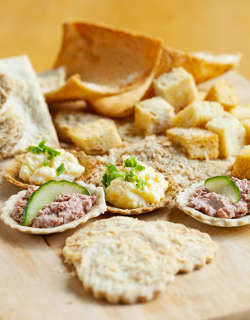 USING YOUR LOAF
USING YOUR LOAF
There’s no need to waste any bit of your favourite loaf as everything from crusts to unused ends has dozens of uses for crafty cooks.
Breadcrumbs
Crusts, loaf ends and trimmings can be processed and frozen fresh for up to 3 months, ready to use for stuffings, toppings for baked dishes or in recipes for meatloaf or burgers.
For long-keeping dry breadcrumbs, spread processed breadcrumbs on a baking tray and dry in a low oven. Completely dried, these can be stored in an air tight tin for a few weeks.
Croutons
Crisp croutons for soups and salads can be pan-fried or oven-baked to give them their crunch. Use a serrated bread knife to cut bread into cubes. Fry in a little butter or good olive oil, stirring constantly over a medium heat until golden brown.
For baking croutons, brush bread lightly with melted butter or olive oil before cutting into cubes. Spread on a baking tray and bake in a medium oven, 180ºC/350ºF for about 15 minutes, until croutons are crisp and golden.
Melba Toast
Professional looking melba toast thins to accompany soups and creamy dips are easy to make in advance. Lightly toast sliced bread, then use a serrated br ead knife to remove crusts. Run the blade between the toasted surfaces and then dry them out in a moderate oven until completely crisp and curled up.
Quick Crispbreads
Trim crusts from sliced bread, then roll out with a rolling pin. Cut into fingers or other shapes, place on a baking tray and brush lightly with melted butter or good oil. Bake in a moderate to low oven until golden brown. Vary crispbreads with toppings of parmesan cheese, finely chopped herbs or sesame seeds sprinkled on before baking.
Canapé Bases
Use a biscuit cutter to cut rounds from sliced bread. Press into shallow tartlet or muffin tins. Brush with a little oil or melted butter and bake in a moderate oven until crisp and golden. Brush with a little oil or melted butter.
Cookery Feature - Tastes of Autumn
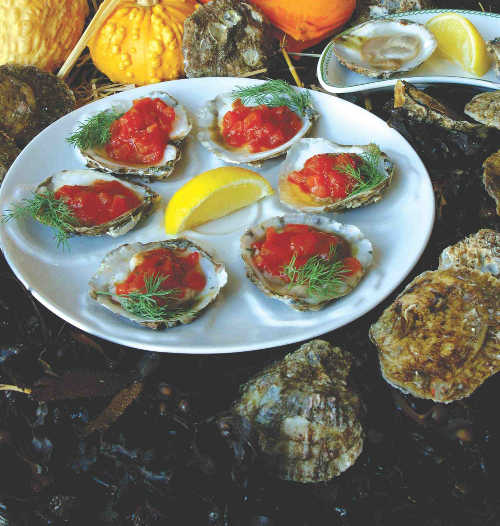
 Georgina Campbell
Georgina Campbell
With autumn comes the harvest, and so many treats to be enjoyed. This miscellany of seasonal dishes is from Irish Country House Cooking, The Blue Book Recipe Collection - inspiration perhaps for some relaxing travel while the country is at its best.
OYSTERS BLOODY MARY
Our native flat oysters have just come into season again after their summer break and many fans look forward to enjoying them ‘au naturel’ in the colder months (all of those with an ‘r’ in them). For those who enjoy trying something different, this recipe is from the King Sitric Fish Restaurant and Accommodation, at the head of the East Pier in Howth, Co Dublin, where Aidan MacManus uses native west coast oysters for this dish whenever possible. However rock oysters - which are farmed not far away in Carlingford Lough - can also be used; when using rock oysters, select them as small as possible.
Serves 1 as a light main course, 2 as a starter
12 oysters
6 tomatoes
1 tbsp / 11/4 US tablespoons of vodka
a dash of Tabasco
a double dash of Worcestershire sauce
the juice of half a lemon
1 red chilli pepper, chopped
a little cucumber, skinned and seeded
First make the Bloody Mary: Blanch the tomatoes, then skin them and discard the pulp. Finely dice two of the tomatoes and leave aside.
Put the rest in a liquidiser with the vodka, Tabasco and Worcestershire sauce, lemon juice and the red chilli pepper. Liquidise. Take the diced tomatoes and add an equal amount of diced, seeded and skinned cucumber. Add to the juice and refrigerate until required.
To prepare the oysters: Using an oyster knife, carefully open the oysters over a bowl to catch the juices. Loosen and turn the oyster in its shell, then strain any juices and return to their shells. Cover with about a tablespoon of the Blood Mary sauce and chill for about 30 minutes.
To serve: Arrange the oysters by the half dozen, on oyster plates if available. Serve with a wedge of lemon, and offer some freshly baked brown bread on the side.
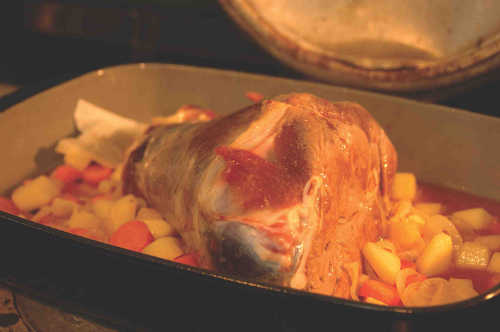 POT ROAST VENISON IN RED WINE
POT ROAST VENISON IN RED WINE
Coopershill House is a fine granite mansion at the centre of a beautiful 500 acre estate of farm and woodland at Riverstown, in Co Sligo. The O’Hara family have lived here since 1774 and, as well as welcoming guests to their wonderfully comfortable home, they are as well known these days for their excellent farmed Coopershill Venison.
The tender, lean meat from young fallow deer under two years old, it can be purchased from the house, in selected (mainly local) shops and online. Guests often have the opportunity to enjoy it for dinner and this tasty pot roast is ideal for gentle slow cooking. It is also suitable for wild venison, which begins to come into season in September.
Serves 6-8
1 leg venison (farmed or wild), about 4lb / 2kg
2oz / 60g / 4 US tablespoons vegetable oil
2 onions, sliced
1 small turnip, chopped
8oz / 225g / 2 cups carrots, chopped
bouquet garni
6 juniper berries
8oz / 225 ml / 1 cup good stock, either beef or chicken
Juice of a lemon
1 tbsp brown sugar
1 tbsp tomato purée
For the sauce:
1-2 tsp arrowroot, or cornflour, slaked in a little water
1 tbsp / 11/4 US tablespoons redcurrant jelly
4fl oz / 125ml / ½ cup full-bodied red wine
Preheat a moderate oven, 300°F / 150°C / gas mark 2
Heat a little oil in a flameproof casserole and brown the venison all over in it. Remove and set aside while making a bed of the onions, chopped root vegetables, bouquet garni and juniper berries, then replace the joint on top.
Mix the stock with the lemon, brown sugar, and tomato purée and use as much as is needed to half cover the joint. Cover securely and cook slowly in the oven. If it is farmed venison allow 20 minutes to the lb/450g, and 20 minutes over for medium cooked, or 10 minutes to the lb/450g plus 10 minutes over for pinker meat. Wild venison, unless very young, may need to be cooked for 30 minutes to the lb/450g.
When cooked to your liking, drain off the pan juices, cover the venison and keep it warm. Blend a little of the hot liquid into the arrowroot then add to the rest of the pan juices, along with the redcurrant jelly and the wine, and bring to the boil. Simmer for about 10 minutes, until the sauce clears and thickens.
Carve the joint and serve with braised red cabbage, green beans and roast or mashed potatoes.
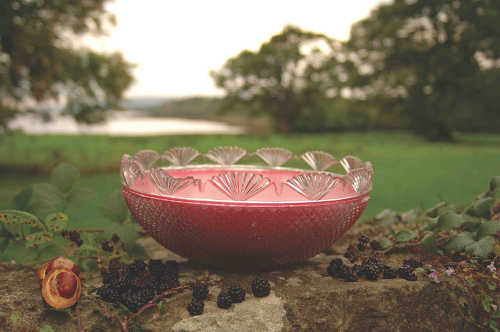 BELLE ISLE BLACKBERRY MOUSSE
BELLE ISLE BLACKBERRY MOUSSE
It’s a fantastic year for wild blackberries, which are exceptionally abundant and can traditionally be picked until Michaelmas (29th September) when ‘the devil spits on them’. This dessert has the most wonderful colour and flavour, and is a favourite at Belle Isle Castle which dates back to the 17th century and is magically situated at Lisbellaw, Co Fermanagh, on one of eleven islands owned by the Duke of Abercorn on Upper Lough Erne.
Blackberries are there for the taking and they freeze well - simply spread out on a plastic tray and transfer to bags when frozen. This mousse loses none of its flavour when using frozen fruit.
Serves 4-6
1lb / 450g / 2 cups blackberries, fresh or frozen and defrosted
juice of a small lemon, strained
4oz / 100g / 1/2 cup caster sugar
3 tbsp / 4 US tablespoons cold water
1/2oz / 15g powdered gelatine
1/4pt / 150ml / 3/4 cup double cream
2 egg whites
To serve:
1/4pt / 150ml / 3/4 cup single cream
a few sprigs of mint
a few raw blackberries
Wash and pick over the blackberries and place in a saucepan with the strained lemon juice and the sugar. Place over a low heat, cover and simmer gently for about 10 minutes.
Meanwhile, put the water in a basin, sprinkle in the gelatine and leave to soak for 5 minutes. Draw the pan off the heat, add the soaked gelatine and stir until dissolved.
Pass the fruit and juice through a nylon sieve, into a large basin. Rub as much of the fruit through as possible and discard the pips left in the sieve. Set the purée aside until cool and beginning to set.
Beat the egg whites until stiff, and lightly whip the cream.
Using a metal soon, gently fold the cream and the egg whites into the purée until well blended, losing as little volume as possible.
Pour the mixture into a serving dish or into individual serving bowls. Chill until set.
Serve garnished with a few whole blackberries and a sprig of mint, and offer a little extra pouring cream.
Cookery Feature - A Seasonal Miscellany
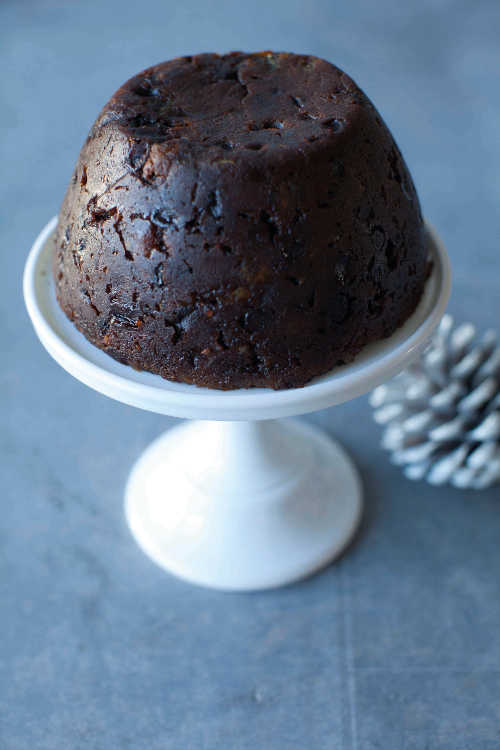
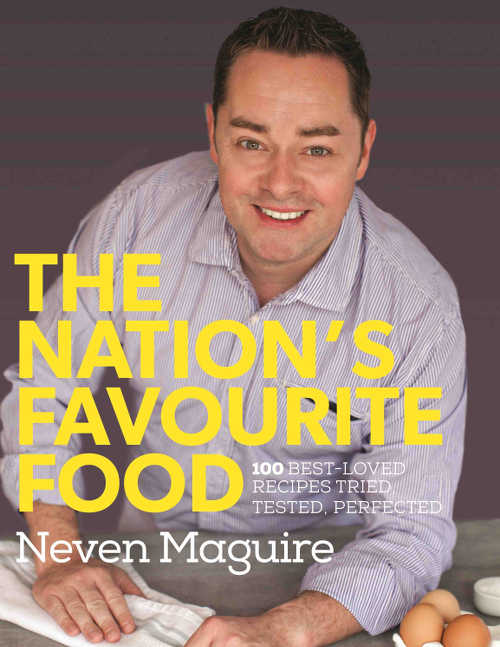 With Christmas just around the corner, preparations are coming into full swing and kitchens everywhere will be a hive of activity in the coming weeks. This miscellany of seasonal dishes is from some of the best new cookbooks - and there are ideas a-plenty among them to make this Christmas a very special food celebration, both on the day itself and throughout the festive season.
With Christmas just around the corner, preparations are coming into full swing and kitchens everywhere will be a hive of activity in the coming weeks. This miscellany of seasonal dishes is from some of the best new cookbooks - and there are ideas a-plenty among them to make this Christmas a very special food celebration, both on the day itself and throughout the festive season.
Neven Maguire’s new book The Nation's Favourite Food (Gill & Macmillan hardback, €22.99; from bookshops and online from gillmacmillanbooks.ie) is a collection of his own favourite recipes and, down to earth as always, Neven has included a great range of eminently do-able dishes for all times and occasions, with a chapter dedicated to Christmas.
Auntie Maureen’s Plum Pudding is one of his classics and, as it really benefits from a few weeks maturing time, try to get it made as soon as possible. “Nothing beats the flavour of homemade Christmas pudding,” says Neven. “I love it hot or cold, with lashings of cream, but brandy and rum crème analgaise is even more special. I always look forward to it. A big thank you to Auntie Maureen for sharing her recipe”.

Makes 2 x 1.2 litre (2 pint) puddings
50g (2oz) plain flour
½ tsp ground mixed spice
½ tsp ground cloves
¼ tsp ground nutmeg
225g (8oz) sultanas
175g (6oz) fresh white breadcrumbs
175g (6oz) butter, melted, extra for greasing
175g (6oz) light muscovado sugar
175g (6oz) raisins
50g (2oz) currants
50g (2oz) candied mixed peel
50g (2oz) blanched almonds, chopped
½ apple, peeled, cored and diced
½ small carrot, grated
finely grated rind and juice of 1 lemon
2 eggs, lightly beaten
300ml (½ pint) stout
fresh redcurrant sprigs, to decorate (optional)
icing sugar, for dusting (optional)
To serve: brandy and rum crème anglaise (optional)
Sift together the flour, mixed spice, cloves and nutmeg. Add the sultanas, breadcrumbs, melted butter, sugar, raisins, currants, mixed peel, almonds, apple, carrot and the lemon rind and juice and mix until well combined.
Gradually add the beaten eggs, stirring constantly, followed by the stout. Mix everything thoroughly and cover with a clean tea towel, then leave in a cool place overnight.
Grease 2 x 1.2 litre (2 pint) pudding bowls and fill with the fruit mixture. Cover with a double thickness of greaseproof paper and tin foil, then tie tightly under the rim with string. Store in a cool, dry place for up to 4 months.
To cook, preheat the oven to 150°C (300°F/gas mark 2) and stand each pudding basin in a large cake tin three-quarters full of boiling water. Cook for 6–8 hours (or you can steam them for 6 hours in the usual way). Allow the puddings to cool, then re-cover with clean greaseproof paper. Again, store in a cool, dry place.
On Christmas Day, re-cover with new greaseproof paper and foil. Steam for 2–3 hours, until completely cooked through and tender. Decorate with redcurrant sprigs and a light dusting of icing sugar, if liked.
To serve, cut the plum pudding into slices and arrange on serving plates. Have a separate jug of brandy and rum crème anglaise (a recipe is given in the book) so that everyone can help themselves.
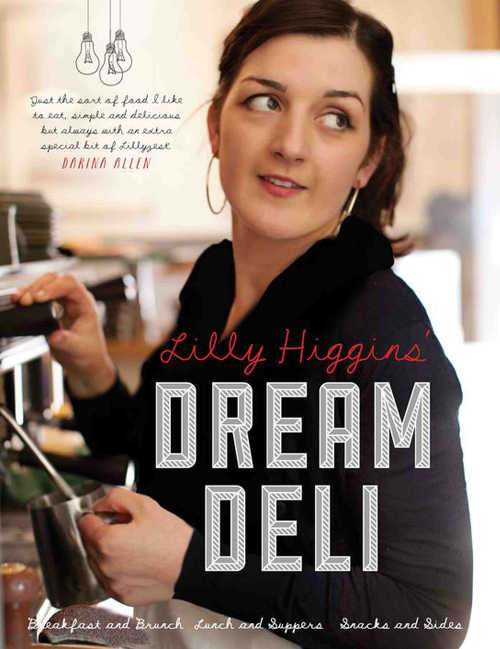 Popular blogger and Sunday Business Post columnist, Lilly Higgins’s new book Lilly’s Dream Deli (Gill & Macmillan €22.99; from bookshops and online from gillmacmillanbooks.ie) shares the recipes that will one day be on the menu of the café that she dreams of opening….An eclectic collection that is sure to please her many fans, it includes plenty of variations on favourites and some fresh ideas. These unusual vegetable crisps, for example, would be a welcome addition to the party nibbles repertoire and a great talking point to warm up the party.
Popular blogger and Sunday Business Post columnist, Lilly Higgins’s new book Lilly’s Dream Deli (Gill & Macmillan €22.99; from bookshops and online from gillmacmillanbooks.ie) shares the recipes that will one day be on the menu of the café that she dreams of opening….An eclectic collection that is sure to please her many fans, it includes plenty of variations on favourites and some fresh ideas. These unusual vegetable crisps, for example, would be a welcome addition to the party nibbles repertoire and a great talking point to warm up the party.
Root Vegetable Crisps
6–7 root vegetables (carrot, turnip, celeriac, beetroot, parsnip, potato, sweet potato)
sunflower oil
salt, to taste
Wash and peel the vegetables. Slice as thinly as possible using a sharp knife or a mandolin. Dry the vegetable slices using kitchen paper. The drier they are, the better they’ll fry.
Pour the sunflower oil into a large, high-sided pot until it’s about 10cm deep. Heat the oil until it reaches about 180°C. You can test it by dropping a vegetable slice in and checking if it sizzles.
Working in batches, add in a single layer of vegetable slices and fry for about 3 minutes, or until they turn slightly darker in colour.
Remove from the oil and drain on kitchen paper. Sprinkle with salt to taste.
Baked Kale Chips
200g kale
1 tbsp olive oil
sea salt, to taste
1 Preheat the oven to 150°C.
2 Rinse and dry the kale, then remove the tough stems. Cut the leaves into large pieces, toss with olive oil in a bowl and sprinkle with salt. Arrange in 1 layer on a large baking tray. Bake for 20 minutes, until crisp. Transfer to a wire rack to cool.
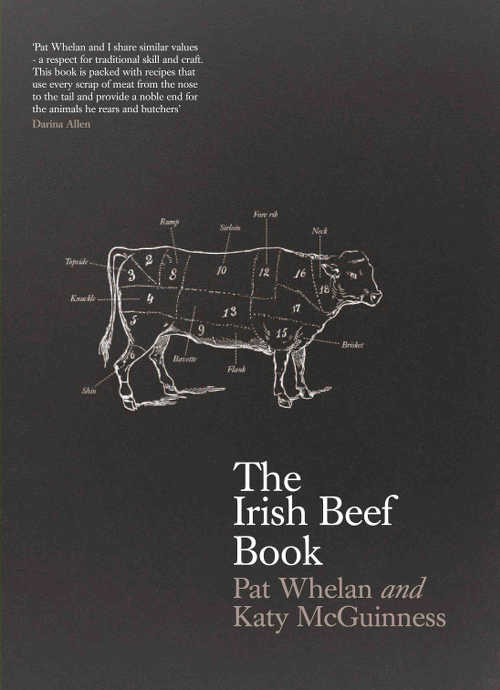 While turkey usually takes centre stage at Christmas, there’s nothing to beat beef - either as an alternative, or to provide variety at other meals during the festive season. The Irish Beef Book (Gill & Macmillan, hardback €24.99; from bookshops and online from gillmacmillanbooks.ie), a collaboration between the well known butcher Pat Whelan and food writer Katy McGuinness, offers plenty of ideas and will interest beef lovers who simply enjoy a good read as well as cooks.
While turkey usually takes centre stage at Christmas, there’s nothing to beat beef - either as an alternative, or to provide variety at other meals during the festive season. The Irish Beef Book (Gill & Macmillan, hardback €24.99; from bookshops and online from gillmacmillanbooks.ie), a collaboration between the well known butcher Pat Whelan and food writer Katy McGuinness, offers plenty of ideas and will interest beef lovers who simply enjoy a good read as well as cooks.
An appealing mixture of Pat Whelan’s information on all things relating to Irish beef and butchery, Katy McGuinness’s wide ranging recipes and Joanne Murphy’s darkly moody imagery, its many tempting dishes include this earthy celebration of winter: Beetroot, Jerusalem Artichoke and Skirt Steak Salad with Toasted Hazelnuts and Mixed Leaves, Tarragon Dressing
“If you have leftover rare roast beef, particularly topside, this is a lovely way to use it up, rather than cooking steak especially. Jerusalem artichokes are in season in the winter months, but if you can’t find them, use celeriac or even roasted carrots instead. You can roast the beetroot and artichokes ahead of time.”
Serves 4
600 g skirt steak
5 tablespoons extra virgin olive oil or Irish rapeseed oil
8 cloves garlic, smashed
8 stalks tarragon
8 medium-sized beetroots, scrubbed
3 tablespoons balsamic vinegar
flaky sea salt
500 g Jerusalem artichokes, peeled
freshly ground black pepper
150 g hazelnuts, toasted and the skins rubbed off
200 g mixed salad leaves
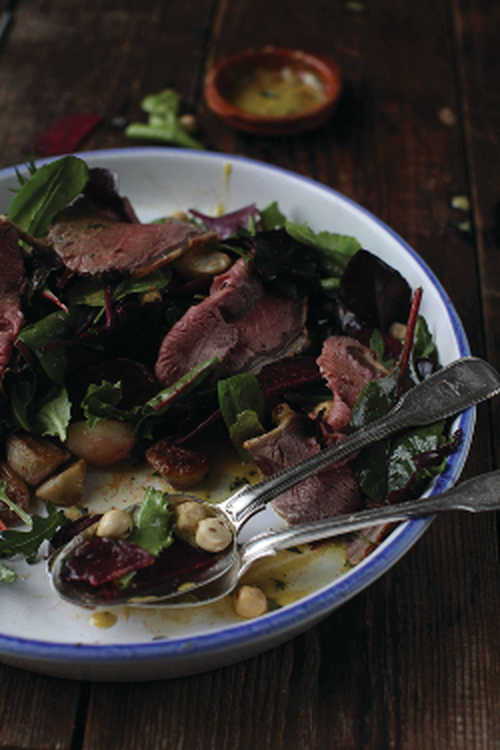 for the dressing:
for the dressing:
1 tablespoon Dijon mustard
2 tablespoons white wine vinegar
5 tablespoons extra virgin olive or Irish rapeseed oil
3 tablespoons finely chopped tarragon leaves
Preheat the oven to 200° C/fan 180° C/gas mark 7.
Mix 2 tablespoons of the oil with the garlic cloves and tarragon in a bowl. Add the steak, cover in clingfilm and leave to marinate in the fridge for a couple of hours.
Trim the beetroot, cut into quarters and toss with a couple of tablespoons of oil and the balsamic vinegar. Place in a roasting dish and sprinkle with flaky sea salt.
Cut the artichokes into chunks, toss with a tablespoon of oil and sprinkle with salt. Place in another roasting dish in the oven.
Keep an eye on the beetroots and artichokes while they are roasting: you want them to be tender and starting to caramelise, which will take about an hour.
Make the dressing by whisking together the mustard, white wine vinegar and oil. Add the chopped tarragon.
Season the steak with flaky sea salt and freshly ground black pepper and sear in a ridged griddle pan over a high heat for about 3 minutes on each side. Cover with foil and leave to rest for 10 minutes while you assemble the salad.
Combine the beetroot, Jerusalem artichokes, leaves and hazelnuts. Slice the steak against the grain and add to the salad. Add the dressing and toss.
Cookery Feature - Alternative Christmas Recipes
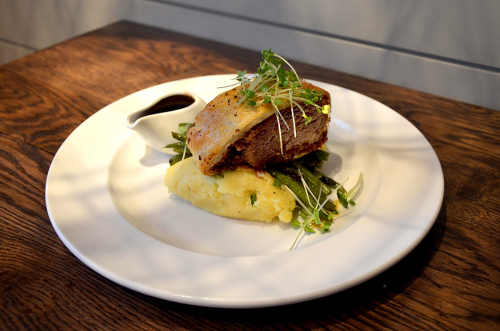
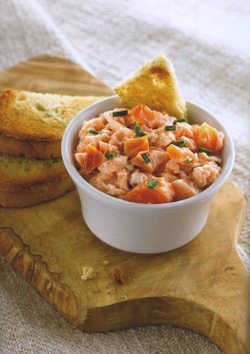 Georgina Campbell
Georgina Campbell
Some alternative recipes for Christmas or any other special dinner. Vegetarians can also visit www.veggiechristmas.org for the Vegetarian Society’s range of appealing meat-free dishes from around the world.
STARTERS
The enduring popularity of smoked salmon confirms its reputation as the perfect starter and these two beautifully simple dishes from from Mairin Ui Chomain’s new book Celebrating Irish Salmon (Artisan House, €20) offer two styles, while being equally convenient for advance preparation. Wine suggestions are made for each recipe in the book.
Rustic Potted Salmon
serves 6
450 g / 1 lb cooked fresh salmon, finely flaked
225 g / 8oz smoked salmon, finely chopped
2 teaspoons crème fraiche
4 teaspoons creamed horseradish
2 lemons, juice only
2 teaspoons chives, roughly chopped
salt and pepper
By hand, fold all the ingredients together except salt and pepper.
Ensure you keep the texture rough. Taste and season as required.
Cover and chill for at least 2 hours.
Serve with toasted sourdough bread.
Suggested wine: Verdejo, Tortora, Spain. This has all the citrus flavours and mineral complexities required to compete with the horseradish component of this rustic pâté.
Smoked Salmon Pâté
serves 4
225 g / 8 oz smoked salmon
2 teaspoons horseradish, ready prepared
1 lemon, zest and juice
50 g / 2 oz soft cheese
pinch black pepper
Salad
225 g / 8 oz finely sliced cucumber, de-seeded
1 tablespoon chopped dill
1 tablespoon caster sugar
1 tablespoon white wine vinegar.
Blend the first five ingredients and chill well
Mix the four salad ingredients and chill until serving.
Slice the pâté and serve on salad bed, or on Melba toast with salad to accompany.
Suggested wine: Vinho Verde, Espigueiro, Muros Antigos, Portugal. Soft pear and apple fruits are gentle and light for the delicate pâté and sweetish cucumber. A light spritz on the palate leaves you ready for more.
 MAIN COURSE
MAIN COURSE
Beef Wellington With Horseradish Mash, Sautéed Green Beans And Red Wine Jus.
This classic main course is from Leona Robinson, Head Chef at one of Cork city’s most exciting restaurants, Electric on the South Mall.
serves 8
For the Beef Wellington:
1 whole beef fillet, trimmed and seared
1 large sheet of puff pastry
100g chicken liver paté
100g duxelle (sautéed mixture of chopped mushrooms, onions & shallots)
Spread the paté out over the sheet of puff pastry and spread the duxelle out evenly over the paté.
Place the fillet at the edge of the pastry and roll from one side to the other ensuring it is a tight wrap.
Seal the ends by pressing the excess pastry together, egg wash the surface of the pastry (ie brush with a mixture of lightly beaten egg and water).
To cook: At Electric they cook the wellington in individual portions ie, cut a slice roughly around 7oz, place on an oiled baking tray and cook in a very hot preheated oven for 15 minutes.
Alternatively it can be cooked in one piece. Lay the pastry parcel on an oiled baking tray, brush with remaining egg wash, score pastry lightly in diagonal lines with a sharp knife and put into the very hot oven (preheated to 475ºF /240º/gas mark 9), immediately reducing to 425°F/210º/gas mark 7.
After 10 minutes, reduce the heat again to 400°F/200º/gas mark 6 and cook for a further 20-25 minutes, until a meat thermometer reads 135°F/60ºC (medium rare).
Rest on a carving board for 10 minutes before serving.
Meanwhile prepare the vegetables and jus.
For the Horseradish Mash
2kg potatoes, peeled
½ lb butter
300mls cream
2tbsps horseradish cream
Seasoning.
Steam the potatoes until soft
Bring the cream and butter to the boil
Put the potatoes through a mouli
Add the cream mixture along with the horseradish cream and seasoning to taste.
For the green beans
1kg green beans
A good knob of butter
Seasoning.
Steam the green beans for 3-4 minutes
Refresh in cold water
To serve: panfry in the butter with the seasoning.
For the red wine jus
1litre beef stock
1 litre red wine
Seasoning
2 tbsp Worcestershire sauce
1 tbsp red currant jelly.
To make the jus, put the stock and wine into a pot and bring to the boil
Reduce to a simmer and let simmer until reduced by half, when it should be a little thicker. Add the redcurrant jelly, Worcestershire sauce and seasoning to taste.
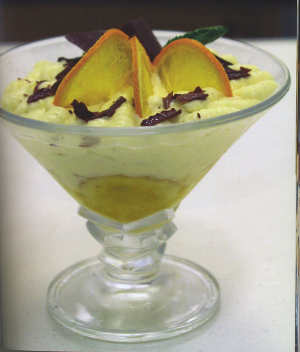 DESSERTS
DESSERTS
An appealing dessert that could make a lighter alternative to the traditional Christmas sweet dishes is this Coppa Filo, or “Grandmama Filo's glass cup” contributed to Marco Roccasalvo’s second Campo de’ Fiori Cookbook Buon Appetito by his friend Marina Manna.
Edited by Lizzie Gore-Grimes and with photography by Harry Weir, this lovely friendly book from the owner-chef of the deservedly popular restaurant Campo de’ Fiori, in Bray, is available online from www.campodefiori.ie; price €20,with €1 from each sale going to the charity the Irish Institute of Clinical Neuroscience (IICN) to fund brain research.
Marina tells me, "My earliest food memories are linked to my dearly beloved grandmother Filomena, mother of my equally dearly beloved mother. When I was a child, I often went to visit my grandparents on a Saturday and I would stay over in their Roman apartment until Sunday. One of my favourite pastimes was hanging around the kitchen with my grandma, a real master of the kitchen. My passion for food comes from her. Back in the day, we are talking over 40 years ago now, recipes were relatively easy and were made with fresh ingredients full of flavour. Being self-taught, I think I still have the same attitude in the kitchen, aiming for high quality and simple techniques. The recipe that follows is simple and easy to prepare and if you use first class ingredients and add a dash of love, you're guaranteed to succeed."
Serves 6
For the creme patissiere
500ml whole milk
125g cream
120g sugar
½ vanilla pod, cut in half lengthways
125g egg yolks
35g cornstarch
For the base
2 large bananas
2 tbsp orange liqueur such as Aurum or Cointreau
For the cream
200g cream
10g sugar
For the candied peel
1 orange
3tbsp sugar
For the garnish
50g dark chocolate flakes, optional
Method
To prepare the creme patissiere, use a stainless steel heavy-bottomed pan; add in the milk, cream, 60g sugar and vanilla pod and bring up to the boil.
Beat the egg yolks with the remaining 60g of sugar and sift in the cornstarch. Pour in the hot milk and stir quickly as you go.
Pour everything back into your stainless steel pot and bring back up to the boil again. Then reduce and simmer for a couple of minutes. Pour the pastry cream into a stainless steel bowl, cover with clingfilm and leave to cool, then refrigerate.
To prepare the base, cut the bananas into rondelles, place them in a bowl, pour over the orange liqueur and leave to rest, covered, in the refrigerator.
To prepare the candied peel, peel the orange carefully, avoiding the white pith which is bitter, and then cut the peel into thin strips.
Place a non-stick saucepan over a medium heat and add 3 tablespoons of sugar and 1 tablespoon of water, mix to combine and then add the orange peel and cook until the orange peel is candied. When ready place on oven paper to cool.
When the pastry cream (creme patissiere) and candied orange peel are cool, whip the cream with the sugar an gently fold the whipped cream into the creme patissiere.
You can now assemble your dessert. I generally use a glass cup. Start with some bananas at the bottom, the layer of creme patissiere.
Garnish with candied orange and place in the refrigerator until you are ready to serve.
To finish, sprinkle over with some dark chocolate flakes.
 Strawberry Kirsch Cake
Strawberry Kirsch Cake
This luscious confection from Barberstown Castle, Co. Kildare was a guest recipe in my vintage cookbook, The Best of Irish Breads & Baking (Epicure Press paperback, €15).
Very versatile, it works equally well as a dessert or to serve with tea or coffee, and the fruits used can be varied as available. With a festive topping it would make a lovely Christmas alternative for people who don’t like rich fruit cakes and plum puddings. If making the sponge cake from scratch it would be easier to scale down to an 8” or 9” tin size.
1 x 10-inch/25cm basic sponge cake
1 x 10"/25 cm loose-based cake tin
8 oz/225g sweet flan pastry (see below)
2 oz/50g strawberry jam, preferably home-made
25 strawberries
flaked almonds, toasted and lightly crushed, to decorate
Kirsch Whipped Cream (see below)
On the morning before required for serving at dinner, bake or buy the sponge cake and make this Sweet Flan Pastry. This is the classic hand-made method, but it could also be made in a food processor.
9 oz/250g/heaped 2 cups plain (all-purpose) flour
41/2 oz/125g butter
21/2 oz/60g caster sugar
1 egg or 2 yolks, beaten
2 tsp lemon juice (or water)
Weigh ingredients accurately. Sift the flour into a bowl. Cut butter into small pieces and rub lightly into the flour, incorporating as much air as possible. Add the sugar and mix well.
Make a well in the centre, then add the beaten egg and lemon juice. Mix with a knife until the dough clings together. Chill.
Before assembly, prepare the Kirsch Whipped Cream
3 egg yolks
15 oz/425g caster sugar
1 pint/600 ml cream, whipped
3 leaves gelatine (or 1 sachet powdered gelatine)
4 ½ fl oz/120 ml dry white wine
1 fl oz/25 ml/I US tbsp kirsch
Whisk the egg yolks and sugar until light and fluffy. Fold in the whipped cream. In a small pan, soften the gelatine in the white wine and add the kirsch. Then heat gently to dissolve.
Put a little of the cream and egg yolk mixture into a small bowl or jug and quickly mix the gelatine mixture into it.
Then, working fast, mix this into the rest of the whipped yolks and cream.
Use as required to layer with the sponge cake and strawberries, as described.
To assemble:
Preheat a fairly hot oven, 375°F/190°C/gas mark 5.
Roll the prepared pastry out thinly, to about 1/3 mm thick, and use to line the base of the cake tin. Bake blind in the preheated oven for 10 minutes. Allow to cool, then spread the jam on top.
Cut the sponge into three layers and place one on top of the jam. Set a few of the strawberries aside for decoration. Slice the rest and arrange about half of them on the first layer of sponge.
Spread about a quarter of the kirsch cream over the strawberries. Repeat with another layer of sponge, strawberries and kirsch cream. Then put the third layer of sponge on top and leave to set for 2 hours.
To serve, decorate the top and sides with the remaining whipped sweetened cream. Coat the sides with toasted almonds and decorate the top with the reserved strawberries.
Cookery Feature - Free-From Food
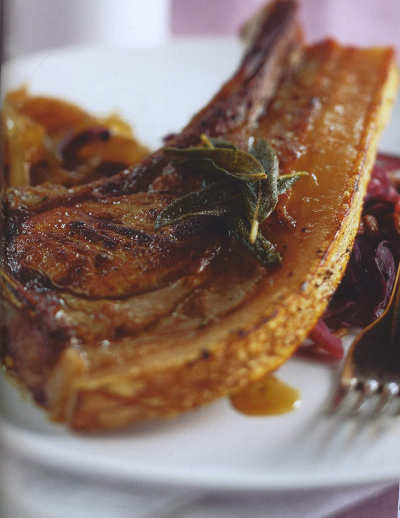
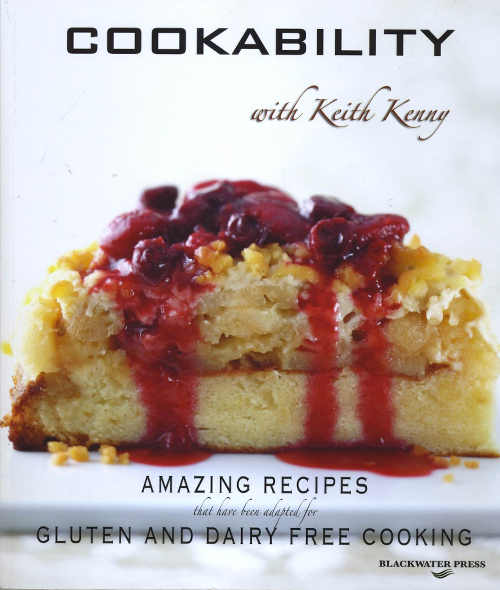 Georgina Campbell
Georgina Campbell
‘Free-from’ foods have never been more in demand than now and the term covers everything from specific exclusion of additives such as the infamous E numbers or just keeping it simple, and cooking with fresh, natural ingredients (a wise policy) to the more complicated issue of dealing with particular health problems.
And, while New Year dietary resolutions for many of us may just involve eating more sensibly and hoping to lose a few pounds, for a growing number a more urgent issue is to find ways to deal with food intolerance.
Whether coeliac disease is becoming increasingly prevalent or it’s just that diagnosis has improved, there’s a growing demand for gluten free foods in particular.
We even have our first gluten free restaurant, The Gluten Free Kitchen Company in Tralee, which - like O’Connell’s Restaurant in Donnybrook, (which was way ahead of the posse in catering to the needs of coeliacs), is popular with everyone, not just customers with gluten intolerance.
Similarly, responding to the fact that keeping salt levels low is a major issue for people like himself with heart problems, the ‘No Salt Chef’ Brian McDermott opened Ireland’s first salt-free cookery school last summer, in Moville, Co Donegal, where he demonstrates that subtle use of herbs and spices can bring out the flavour in natural ingredients at least as effectively as adding salt.
Another chef, Keith Kenny of La Banca Restaurant in Lucan, discovered a whole new way of cooking because his wife, Melanie, is dairy and gluten intolerant - and this, plus the fact that he was constantly adapting popular dishes in the restaurant for special dietary requirements, led him to write a book, COOKABILITY with Keith Kenny, Amazing Recipes that have been adapted for Gluten and Dairy Free Cooking. Published by Blackwater Press it costs €20 and is available from bookshops and La Banca Restaurant, Lucan, with royalties going to the Irish Cancer Society.
Working with nutrition expert Erika Doolan, who also worked with Dylan McGrath on the raw food menu at his Rustic Stone restaurant, ensured that meals in Keith’s book are not only gluten- and dairy-free, but also nutritionally balanced.
Aside from coeliacs, thousands of others - such as people with Crohn’s Disease and Irritable Bowel Syndrome (IBS) - also need to avoid certain foods including wheat and dairy, so this down to earth book of healthy and appetising dishes will be a welcome find for many.
SEASONAL SAMPLE RECIPES:
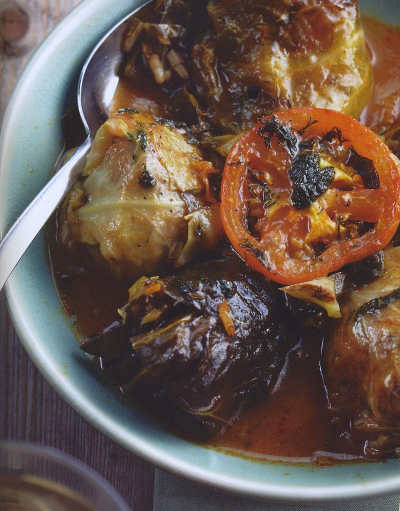 Stuffed Cabbage Leaves in a Tomato and Basil Sauce
Stuffed Cabbage Leaves in a Tomato and Basil Sauce
(A tasty vegetarian main course that could be varied by using other herbs when fresh basil is out of season. GC.)
(Serves Four)
Ingredients:
1 head of Savoy cabbage, remove leaves and wash
2 tbsp. of vinegar
100g of long grain rice
2 carrots, peeled and diced
3 cloves of garlic, diced
2 mixed bell peppers, diced
2 sticks of celery, diced
3 tomatoes, sliced
100 ml of white wine (optional)
3 tbsp. of olive oil
1 leek, diced
2 red onions, diced
1 courgette, diced
Bunch of flat leaf parsley, roughly chopped
Bunch of basil, roughly chopped
1 bunch of fresh thyme
500 ml of vegetable stock
2 tins of chopped tomatoes
Salt and pepper
Method
Put a large pan on a high heat add 1.25 litres of water and the vinegar, bringing to the boil before adding the cabbage leaves. Blanch for 4-5 mins until soft, remove and cool under cold water and leave aside until later.
Put a deep pan or pot on a med to high heat and add the olive oil. When hot, add in 2 cloves of garlic, red onion, celery, courgette, carrots, leek, peppers and rice and sweat off for 4-5 mins.
Add in 3-4 sprigs of thyme and the wine, simmering for another 2-3 mins. Season with salt and pepper and pour in 300ml of vegetable stock. Cook for another 5 mins before removing from heat and leaving to cool.
Place 1 cabbage leaf on a plate and add 1-2 tbsp. of the mix onto the centre of the leaf. Roll into a cone shape and do this with all the leaves and the remaining mix.
When you have all the leaves stuffed put the chopped tomatoes in a large pot with mixed herbs, garlic and the rest of the vegetable stock.
Then place all the stuffed cabbage leaves in a circular pattern into the pot, coating each one with the sauce, add sliced tomatoes and cover the pot and place on a low heat for 35 mins.
 Crispy Pork Cutlet with Braised Sultana, Apple, Red Cabbage and Sweet Onion Cider Sauce
Crispy Pork Cutlet with Braised Sultana, Apple, Red Cabbage and Sweet Onion Cider Sauce
Pork is much tastier with the crispy skin on and you are more likely to find rind-on pork at your local butcher rather than a supermarket.
GC
(Serves Four)
Ingredients:
4 x 220g pork cutlets with rind on
3 tbsp. of rapeseed or sunflower oil
Salt and pepper
½ head red cabbage, thinly sliced or shredded
50g of sultanas
2 eating apples, cored and diced skin on
Juice of 1 lemon
2 tbsp. of brown sugar
2 tbsp. of white wine vinegar
3 medium sized onions, peeled and sliced
1 bunch of fresh sage
250ml of chicken/vegetable stock
1 x 330ml bottle of cider
Method:
Make sure the skin on the pork cutlets is dry and rub salt and pepper into it. Put a large pan on a medium heat, add the oil and place the cutlets on their edge skin side in the oil. Cook for 10-12 mins until the skin is brown and crispy, then cook on either side for 4-5 mins. Remove from the pan, place on a warm plate and leave to rest.
Turn up the pan to a high heat. Throw in 6-8 sage leaves and cook for 1-2 mins until crispy. Remove and place on kitchen paper. These are really tasty and make a great garnish.
Using the same pan, add in the onion and cider and season with salt and pepper. Cook until the cider has reduced and has made the onions wonderfully sweet.
While the pork is cooking, place a pot on a medium heat and add half the stock, sultanas, red cabbage, white wine vinegar and brown sugar. Leave to simmer and stir well until the liquid has reduced by half, then add the rest of the stock and cook until reduced.
When the cabbage is just at dente, mix in the apple and lemon juice and remove from the heat, covering with a lid until required.
To serve, place a good helping of the red cabbage on the centre of plate, place the cutlet on top and garnish with the crispy sage leaves and the sweet onion sauce on the side.
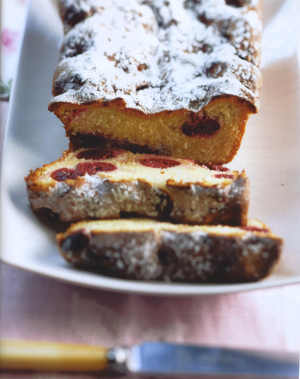 Cherry Vanilla Sponge
Cherry Vanilla Sponge
[Desserts and baking are often particularly challenging for anyone with gluten and dairy intolerance, so recipes like this are especially welcome. GC]
(Serves Four to Six)
Ingredients:
500ml tin of pitted cherries or 200g of fresh cherries deseeded
4 large eggs
4 tbsp. of vegetable oil
1 tbsp. of cold water
4 tbsp. of castor sugar
½ tsp. of gluten-free baking powder
4 heaped tbsp. of gluten-free flour
1 vanilla pod (cut the pod horizontally and with the tip of your knife scrape out the vanilla)
To make use of the pod, mix it with some sugar and store in an airtight jar.
Baking tin size 24 cm long 14 cm wide 7 cm deep
Method:
Preheat the oven to 180°C, Gas mark 4.
Separate the eggs and put the white of the egg into a clean mixing bowl and whisk for 3-4 mins until semi stiff. While still whisking, add 1 tbsp. of sugar at a time and stir briskly until stiff like meringue and place into another bowl until later.
Wash out your mixing bowl and add the egg yolks with the oil, cold water, flour, vanilla and baking powder, mixing on a medium to high speed for 4-5 mins until stiff.
Blend the two mixes together slowly in a large bowl using a wooden spoon or spatula until they reach a smooth creamy texture.
Brush the tin very lightly with oil and fill with the half the mixture, then add your cherries before topping with the rest of the mixture.
Place in the oven for 25-30 mins. To check if it is cooked, simply push a cocktail stick or skewer into the centre sponge and if it comes out dry it is cooked.
Remove from oven and let cool before dusting with icing sugar.
Cookery Feature - Master It With Rory O'Connell

 Rory O’Connell has long been one of my favourite chefs, and he was our Chef of the Year in 2002. Although not as well known to the general public as his sister Darina, he co-founded the Ballymaloe Cookery School (where he still teaches as well as giving bespoke classes at his own farmhouse home nearby), and his many achievements include a memorable ten year stint as head chef at Ballymaloe House - where he originally trained, under the guidance of that other great teacher, Myrtle Allen.
Rory O’Connell has long been one of my favourite chefs, and he was our Chef of the Year in 2002. Although not as well known to the general public as his sister Darina, he co-founded the Ballymaloe Cookery School (where he still teaches as well as giving bespoke classes at his own farmhouse home nearby), and his many achievements include a memorable ten year stint as head chef at Ballymaloe House - where he originally trained, under the guidance of that other great teacher, Myrtle Allen.
‘Shop well - eat well’ is the motto of this creative, down to earth and yet and meticulous chef, and his book ‘Master It, How to cook today’ (Fourth Estate, hardback, 562pp; photography Laura Hynd; £25/€30 approx) is a fulsome expression of those values, while also offering a practical hands on cookery course which guarantees success if his instructions - which are much more than mere recipes - are accurately followed.
With this book beside you, you will feel as if the master himself is in the kitchen, explaining and demonstrating each ingredient and each dish. It is a singularly unhurried work - you would be hard pushed to find a recipe of less than three pages (which explains the extent of this chunky book), but that is not because it is complicated, or unnecessarily wordy, but because Rory thinks of everything that you should know before beginning, and during every stage of, each dish.
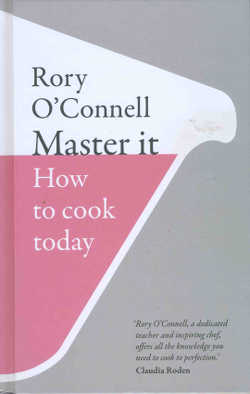 Many of the recipes are classical - although often with Rory’s own improvements - but, unlike so many cookbooks on the market today, this is an original work and a reassuring companion.
Many of the recipes are classical - although often with Rory’s own improvements - but, unlike so many cookbooks on the market today, this is an original work and a reassuring companion.
One has the sense of the great love Rory feels for his ingredients - especially, perhaps, vegetables and garden produce generally - and the enjoyment and satisfaction he feels in every stage of the cooking process, even down to “ticking things off your list as you go, a simple pleasure that I enjoy greatly”, and laying out the measured ingredients in orderly little bowls.
“This not a ‘chuck it in and see how it goes’ book,” he says, “…Food is too precious and expensive for that sort of game of chance. So many times, I have witnessed the wide-eyed amazement and delight of a cook who, when finally cajoled into reading, weighing, heating and timing a set of ingredients, has produced a dish that has previously eluded them.”
A glorious celebration of the treasure that is good food, and an infallible guide to the techniques necessary for confident and successful cooking, this is one of the great kitchen companions.
RECIPES: Fish fillets baked 'au gratin'
Keys to success
• Measure all the ingredients accurately, so as to ensure the correct amount of sauce and flavourings for the amount of fish being cooked.
• The cooked gratin should be a rich golden colour and bubbling hot when ready to be served.
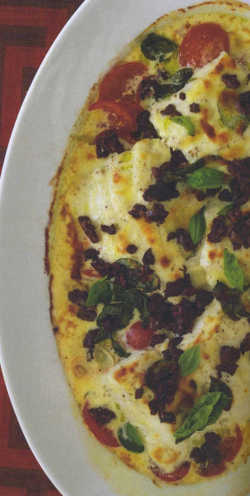 Gratin of hake with tomatoes, basil, olives and Parmesan
Gratin of hake with tomatoes, basil, olives and Parmesan
The firm texture of hake is perfect for this dish, although cod, pollock and salmon are also good here. Really ripe tomatoes are essential to add sweetness and depth of flavour to the sauce.
The final addition to the dish of the strong-tasting chopped olive and basil pulls the flavours together.
The cooked gratin should arrive at the table bubbling hot, with a rich golden colour.
The ingredients
• Hake is a firm-textured, white-fleshed fish with great flavour. Freshness, as ever, is the key to a delicious result.
• Fat, black and briny Kalamata olives are the preferred choice for this dish.
Serves 4
1 teaspoons olive oil, plus 2 tablespoons
600g ripe tomatoes, peeled and sliced 5mm thick
Maldon sea salt and freshly ground black pepper
1 large clove of garlic, peeled and very thinly sliced
4 x 50g pieces of hake fillet, skin removed
10 basil leaves
100ml regular or double cream
50g Parmesan
16 fat black olives, such as Kalamata, stones removed and finely chopped
8 small basil leaves, for serving
Preheat the oven to 180°C/350°F/gas 4.
Rub an ovenproof gratin dish with the z teaspoons of olive oil. Place the sliced tomatoes in the dish and season with salt and pepper.
Sprinkle with the sliced garlic. Lay the pieces offish on next. Tear the basil leaves and scatter over the fish.
Whisk the cream and Parmesan together and season to taste with salt and pepper. Spoon the cream directly over the fish.
The dish can now be cooked immediately or covered and refrigerated for up to 2 hours. To cook, place in the preheated oven and bake 10-15 minutes, until the fish is just cooked through and the tomatoes have become a bubbling light sauce with a golden hue.
Mix the chopped olives with the remaining 2 tablespoons of olive oil and drizzle over the dish.
Scatter the small basil leaves over and serve.
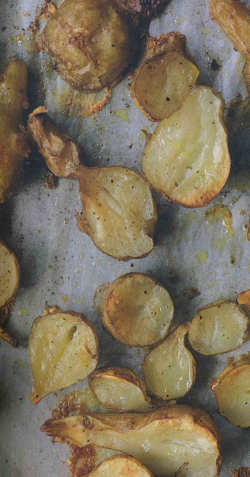 Roast Jerusalem artichokes
Roast Jerusalem artichokes
Jerusalem artichokes are a wonderful winter vegetable. In appearance they are somewhat similar to potatoes, but with knobbly bits which are tedious to peel.
They make an excellent soup and puree, and pair particularly well with shellfish, especially mussels and scallops. They are also great with pork, duck, goose, pheasant and venison.
Here they are simply roasted with olive oil, salt and pepper. The olive oil can be replaced with duck, goose or pork fat. I strongly advise using a sheet of baking parchment under the artichokes when roasting, as otherwise the crispy cooked skin will stick to the roasting pan and will not end up on your plate, which is where you want that golden deliciousness.
The ingredients
• The artichokes when really freshly harvested do not have to be peeled. This is ideal, because most of the vitamins are just under the skin, but if they are a couple of days old, you will definitely have to make that slightly purgatorial journey. 'Offer it up', as the saying goes, and if you don't know what that expression means, just disregard my rantings as those of an older generation.
• The artichokes have a tendency to cook unevenly, so test several pieces when determining whether they are ready.
• The choice of fat here is yours, but whichever you choose, use just enough to glaze the vegetables lightly.
Serves 4
8 artichokes, allowing 2 artichokes per person
2 tablespoons olive oil or duck, pork or goose fat
Maldon sea salt and freshly ground black pepper
Preheat the oven to 200°C/400°F/gas 6.
Scrub and if necessary peel the artichokes and cut each one in half lengthways. Dry with a tea towel and place in a bowl. Add the oil or fat and toss well. Season with salt and pepper.
Line a baking tray with baking parchment and arrange the artichokes in a single layer and if possible not touching, as this encourages the skins to colour and caramelise.
Place in the preheated oven and roast for 30-50 minutes, until the vegetables are tender and very well coloured. The tips can be as dark as hazelnut skins. If the artichokes are not colouring properly, turn up the oven by 20° for the last 10 minutes of cooking.
By now they will not look pretty in the conventional sense of the word, but it is amazing when something tastes good how one's eye looks at these things in a different way.
Serve immediately.
Variation: Roast Jerusalem artichokes with roast hazelnuts and rocket leaves
Prepare the artichokes as above. Add 2 tablespoons of roasted, skinned and chopped hazelnuts to the cooked artichokes, then fold in a handful of rocker leaves and allow to wilt into the hot cooked vegetables.
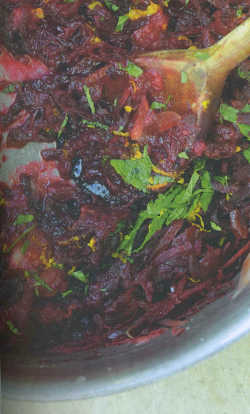 Beetroot, red onion, orange and mint compote
Beetroot, red onion, orange and mint compote
This compote is delicious served as a vegetable accompaniment to a plain roast duck or pork. I also serve it with homemade sausages or pork burgers and it is delicious on hot, olive-oil-grilled bread, which has been buttered with a soft goat's cheese.
The ingredients
• Ruby, golden or Chioggia beets will do here.
• The sour Bramley cooking apple works well with the beetroot, and collapses to a fluff when cooked.
Serves 6-8
4 tablespoons olive oil
100g red onions, peeled and thinly sliced
450g ruby beetroot, peeled and coarsely grated
450g Bramley cooking apples, peeled, cored and cut into quarters
Maldon sea salt and freshly ground black pepper
Zest and juice of 1/2 an orange
2 tablespoons chopped mint
1 tablespoon red wine vinegar or lemon juice
Heat 2 tablespoons of the olive oil in a stainless steel saucepan. Add the sliced onions and toss in the oil. Cover with greaseproof paper and a tight-fitting saucepan lid and sweat on a low heat for about 10 minutes, or until the onions have softened.
Add the beetroot and the apples and mix well. Season with salt and pepper and continue cooking, covered as before, on a low heat until the apples collapse and the beetroot softens somewhat. This takes about 10 minutes.
Add the orange zest and juice and the chopped mint. Mix well and correct the seasoning, adding a little red wine vinegar or lemon juice
to taste. The compote can be put aside to be reheated later or indeed can be served at room temperature.
Reheat on a gentle heat, adding a tablespoon of water if it is inclined to stick to the pan. Finally, drizzle with the remaining olive oil and serve.
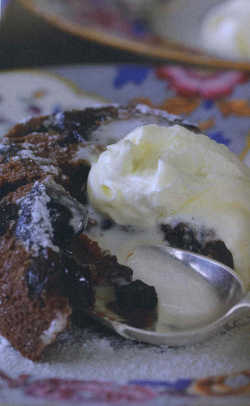 Chocolate, prune and Armagnac puddings with chocolate sauce
Chocolate, prune and Armagnac puddings with chocolate sauce
These puddings are delicious and without doubt made for chocolate lovers. Although not molten in the centre, they are soft and yielding.
The combination of ingredients is a classic one but has timeless appeal. The cooked puddings will sit happily in a warm oven for at least an hour before serving, and indeed could be made ahead of time, allowed to cool and reheated in a bain-marie in a warm oven.
The prunes in the recipe can be replaced with cherries, a delicious variation, in which case I would soak. them in kirsch. Cognac can replace the slightly dryer Armagnac with the prunes.
The pudding can be cooked in a large dish, or in individual ramekins or even teacups.
The ingredients
• Best-quality chocolate, 62% cocoa solids, is best for this pudding. I use Valrhona.
• Prunes vary in quality, so look out for juicy-looking ones with their stones still in. I get the ones known as Agen prunes, grown in the Aquitaine region in the south-west of France. The same variety is grown successfully in California as well.
• Armagnac, a brandy from the Armagnac region, which is close to Aquitaine, is dryer than the brandy from Cognac and seems to have
an affinity with the flavour of the prunes, though either will do.
• Cream of tartar, or tartaric acid, adds stability to the beaten egg whites, resulting in a more luscious texture in the cooked pudding.
Serves 10
THE PRUNES
225g prunes, weighed after removing the stones
4 tablespoons Armagnac or brandy
THE PUDDING
150g best-quality chocolate, 62% cocoa solids
150g unsalted butter
l50ml warm water
110g caster sugar
1 teaspoon vanilla extract
4 eggs
110g plain white flour
Pinch of cream of tartar
TO SERVE
A dusting of icing sugar
Softly whipped cream
Put the prunes into a bowl with the brandy and leave to soak overnight.
Preheat the oven to zoo°C/40o°F/gas 6 and get ready either a 2 litre ovenproof pie or gratin dish, or ten 200ml ramekins or teacups of a
similar volume.
If you plan to serve the individual puddings unmoulded from their containers, you will need to paint them with melted butter before adding the mixture. You will also need a roasting tin about 4cm deep, large enough to accommodate the ramekins or dish.
Cut the chocolate into small pieces and put it into a Pyrex bowl with the butter. Place over a saucepan of cold water, making sure the bottom of the bowl does not touch the water. Place on a low heat - don't let the water do more than simmer.
While the chocolate is melting, tear or chop the Armagnac-soaked prunes into smaller pieces, about 1cm, and either divide them between the ramekins or spread them over the base of the large dish. If there is some Armagnac that has not soaked into the prunes, save it for adding to the cream later.
When the chocolate is nearly melted, remove the bowl from the saucepan and stir with a flexible rubber spatula to blend the chocolate with the butter. Add the water, sugar and vanilla and mix with a whisk until smooth.
Separate the eggs, placing the whites in a spotlessly clean bowl for whisking later. Whisk the yolks into the chocolate mixture, followed by the sieved flour.
Whisk the egg whites with a pinch of cream of tartar until holding soft but definite peaks. Do not allow them to over-whip and take on a grainy appearance.
Stir a quarter of the egg white into the chocolate mixture and fold in the remainder with a heavy flexible spatula, making sure no lumps of egg white remain unblended.
Divide the mixture between the ramekins, or put it all into the one dish, and immediately place in the roasting tin. Pour boiling water into the tin, to come halfway up the sides of the ramekins or dish.
Cook in the oven for 10 minutes, then lower the temperature to 160°C/325°F/gas 3 for a further 10 minutes if using individual dishes or a further 10 minutes for a large dish. The puddings will appear cooked on top but will feel a little soft and molten in the centre.
Remove the roasting tin carefully from the oven and allow the puddings to sit for at least 10 minutes before serving.
The individual puddings can be turned out on to warmed plates for serving. The large dish can be brought to the table as it is.
Regardless, I dust the puddings with a little sieved icing sugar just before serving.
Pass softly whipped cream separately. I sometimes serve chocolate sauce with these as well.
Cookery Feature - Winning Ways
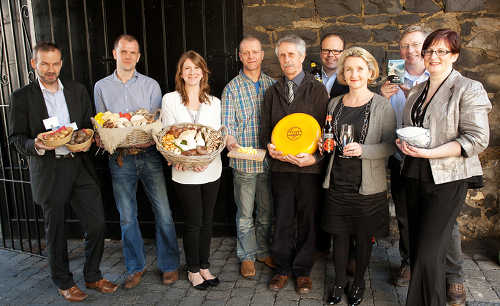
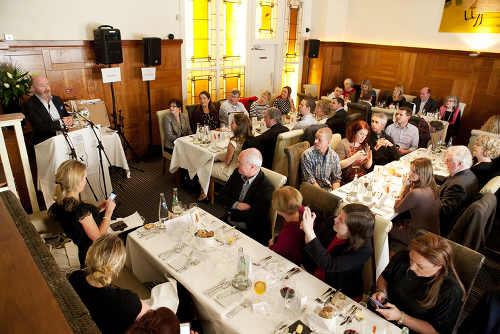 Irish Food Writers’ Guild President, Georgina Campbell, shares some of the stunning recipes created by Derry Clarke for the annual lunch held at L’Ecrivain to celebrate the winning foods and people at the Guild’s Food Awards (photos by Paul Sherwood, www.sherwood.ie)
Irish Food Writers’ Guild President, Georgina Campbell, shares some of the stunning recipes created by Derry Clarke for the annual lunch held at L’Ecrivain to celebrate the winning foods and people at the Guild’s Food Awards (photos by Paul Sherwood, www.sherwood.ie)
Running since 1992, The Irish Food Writers’ Guild Awards are a keenly anticipated highlight in the culinary calendar. The simple criteria - Award winning products must be Irish and of truly excellent quality - and the ethical selection system remain unchanged.
They are nominated by Guild members who take a full role in choosing the short list and, at a tasting meeting (in which products are bought and paid for, without the knowledge of producers), cast their votes using the PR system.
This year, encouraged by the development of artisan cider and beer production, the Guild introduced a new award for Irish produced drink.
 The winning food products this year are the Ballyhoura Mountain Mushroom Range, Coolea Mature Farmhouse Cheese, and Irish Atlantic Sea Salt and the inaugural Irish Drink Award goes to Stonewell Cider - all, as it happens, from County Cork - while Responsible Irish Fish receive the Environmental Award and recognition is also given to the Heritage Irish Potato Collection.
The winning food products this year are the Ballyhoura Mountain Mushroom Range, Coolea Mature Farmhouse Cheese, and Irish Atlantic Sea Salt and the inaugural Irish Drink Award goes to Stonewell Cider - all, as it happens, from County Cork - while Responsible Irish Fish receive the Environmental Award and recognition is also given to the Heritage Irish Potato Collection.
A special Lifetime Achievement Award was also given to much-loved fellow member, Myrtle Allen, for her immense contribution to Irish food over the last fifty years, and to mark her 90th birthday.
RECIPES created for the Irish Food Writers’ Guild Food Awards 2014 by chefs Derry Clarke and Michael Hunter of l’Ecrivain Restaurant, Baggot Street, Dublin 2.
*Note for home cooks - don’t be discouraged by the cheffy presentation of these beautiful dishes, the following recipes are very do-able thanks to focused cook-friendly editing by Guild Secretary Aoife Carrigy (holymackerel.ie)
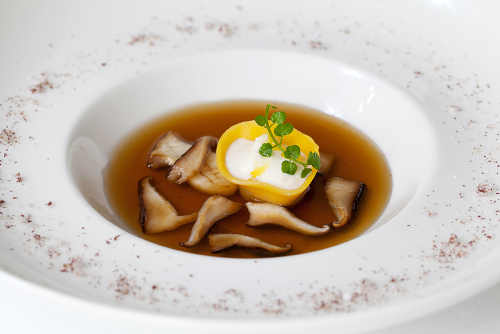 Ballyhoura Mountain Mushroom consommé with Coolea cheese tortellini
Ballyhoura Mountain Mushroom consommé with Coolea cheese tortellini
Serves 4
This elegant consommé dish pairs the deep flavours of Ballyhoura Mountain Mushrooms with the tangy notes of Coolea cheese. For a more intense pairing, look for the Mature Coolea cheese with its caramel character.
for the consommé
200g assorted Ballyhoura Mountain Mushrooms, cleaned and sliced
200g smoked bacon
1 litre water
3–4 egg whites
for the pasta
500g flour, sifted
3 eggs
6 egg yolks
pinch of salt
1 tbsp olive oil
for the tortellini
200g Coolea cheese, rolled into 4 small golf ball-sized balls
1 egg, beaten
to serve
200g Ballyhoura Mountain Mushrooms, cleaned
rapeseed oil
a little lemon juice
freshly ground Irish Atlantic Sea Salt and black pepper
To make the consommé, add the sliced Ballyhoura mushrooms, smoked bacon and water to a large heavy-based pot and bring to the boil. Reduce the heat and leave to simmer for two hours. Strain and chill the liquid. When cool, add the egg whites to the liquid and heat over a low heat. The egg whites will rise to the top of the pot taking all the impurities with them. Carefully strain the liquid through a muslin cloth and you will be left with a beautiful clear consommé.
To make the pasta, place the flour in a food processor. Add the eggs and egg yolks and process until the dough starts to form a ball. Next add the salt and olive oil and combine. Shake a little flour on a work surface and knead the ball of dough by hand for five minutes or until it becomes smooth, adding more flour if it sticks. Wrap the dough in clingfilm and leave it to rest in a cool place for one to two hours.
To make the tortellini, roll the pasta dough through a pasta machine set to the thinnest setting. Cut out four circles of pasta about 6cm in diameter, place cheese in centre of each of the pasta circles, brush around the edges of the disk with beaten egg and fold in half. Press the edges well to seal, ensuring that there are no air pockets or tears.
Take each semi-circle in your hand and curl the two tips of the straight edge around your index finger pressing well to seal. Then turn up the two edges to form a shape like the brim of a hat. Cook the tortellini in boiling salted water for two minutes.
To serve, slice the remaining mushrooms and toss in a hot pan with a little oil. Season and add a little lemon juice and strain on a kitchen towel. Divide the mushrooms between four warmed soup bowls, pour over the consommé and then place a tortellini in the centre of each bowl. Sprinkle a little Irish Atlantic Sea Salt and cracked pepper around the rim of the each bowl and serve while hot.
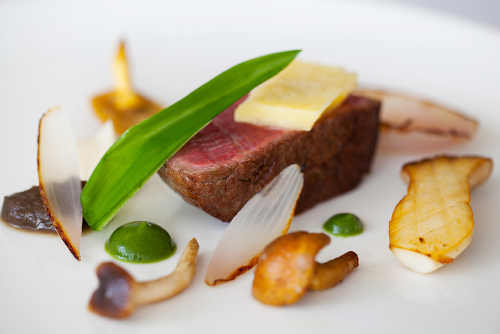 Dry-aged beef, Ballyhoura Mountain Mushrooms, Coolea cheese, parsley purée, wild garlic
Dry-aged beef, Ballyhoura Mountain Mushrooms, Coolea cheese, parsley purée, wild garlic
Serves 4
Lucy Deegan and Mark Cribben of Ballyhoura Mountain Mushrooms grow and harvest an extraordinary range of cultivated and wild mushrooms in Co. Cork, where Coolea cheese is also produced.
This simple dish showcases both alongside some quality dry-aged Irish beef.
for the beef
2 fillet dry-aged Irish steaks
freshly ground Irish Atlantic Sea Salt and black pepper
for the mushrooms
300g assorted Ballyhoura Mountain Mushrooms, cleaned
freshly ground Irish Atlantic Sea Salt and black pepper
1 tbsp Worcestershire sauce
for the parsley purée
200g fresh flat-leaf parsley
30ml olive oil
for the wild garlic
handful wild garlic, washed
1 tbsp butter
freshly ground Irish Atlantic Sea Salt and black pepper
to serve
4 generous slices Coolea cheese
Season the steaks and sear on a very hot pan, making sure to brown all sides. Cook medium-rare and leave to rest for at least five minutes.
Heat a clean pan, add a little rapeseed oil and toss the mushrooms for two minutes. Season and add a tablespoon of Worcestershire sauce. Transfer to kitchen towel.
Remove the parsley leaves from the stalks. Place the stalks in a pot of boiling water for two minutes. Add the leaves and cook for a further two minutes. Remove from the heat and transfer to a bowl of iced water. Drain and blend in a food processor with the olive oil until smooth. Finally pass through a sieve.
Toss the wild garlic in a hot pan with the butter, season and sauté for 10-15 seconds.
To serve, cut the steaks in half. Place a slice of Coolea cheese on each piece of beef. Dot the plate with parsley purée and scatter the sautéed wild garlic over the beef
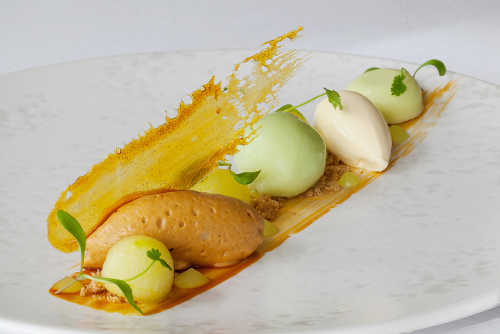 Irish Atlantic Sea Salt & caramel mousse with Stonewell apple cider sorbet
Irish Atlantic Sea Salt & caramel mousse with Stonewell apple cider sorbet
Serves 4
Craft ciders have been making a comeback and Derry Clarke showcases Stonewell’s tangy flavours by contrasting with a sweet and salty mousse in this contemporary Irish dessert.
for the sorbet
250g sugar
125g water
1 tsp glucose syrup
juice from 1 lemon
150g pressed apple juice
1 x 500ml bottle of Stonewell Dry Irish Cider
for the caramel
500g caster sugar
75g unsalted butter
1½ tsp Irish Atlantic sea salt
3½ leaves of gelatine (soaked) or 4g agar
250g cream
for the mousse
100g caster sugar
100g icing sugar
100g egg white
500g lightly whipped cream
to serve
clotted cream, optional
cinnamon crumble, optional
To make the apple cider sorbet, bring the water, sugar and glucose syrup to the boil, turn down heat and simmer for three minutes. Remove from heat and then add the remaining ingredients. Leave to cool. Once cooled, place into an ice cream churner and churn according to manufacturer’s instructions.
To make the caramel, heat a heavy bottomed pan over a medium heat and slowly pour in enough sugar to just cover the base of the pan. When the sugar changes to an amber colour, slowly add more, mixing gently as you go. Continue in this way until you have added all the sugar and a rich dark caramel colour has been achieved.
Remove pan from heat. Add the butter and the Irish Atlantic Sea Salt. Stir to dissolve. Add the cream gradually, taking care as the caramel is very hot and may spit. Once all the ingredients are mixed together, add the soaked gelatine or whisk the agar into the mixture. Set aside to cool.
To make the meringue mix for the mousse, beat the egg whites in a spotlessly clean bowl until soft peaks form when the whisk is removed. Add the sugar in one tablespoon at a time, whisking constantly, until all the sugar is incorporated and stiff peaks form. (If you prefer to cook the egg whites you can use an Italian meringue recipe as the base for this mousse.)
Once the caramel mixture has cooled, fold it into the meringue and then fold in the cream. Leave to set in the fridge until ready to serve.
Serve on a chilled plate. Arrange a quenelle of caramel mousse in the centre of the plate and place spheres of sorbet to sit alongside the mousse. Add a quenelle of clotted cream and sprinkle with cinnamon crumble, if using.
All recipes created for the Irish Food Writers’ Guild Food Awards 2014 by chefs Derry Clarke and Michael Hunter of l’Ecrivain Restaurant, Baggot Street, Dublin 2.
Cookery Feature - Easter Feasting
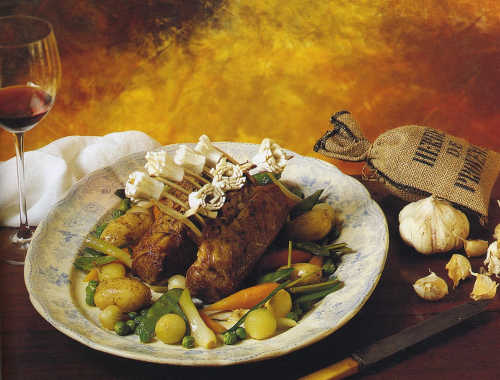
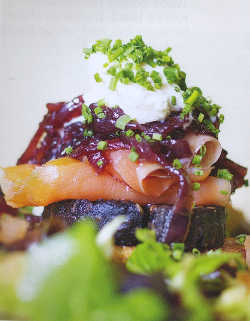 Georgina Campbell
Georgina Campbell
Why not push out the boat this year and indulge in some Irish spring lamb for a special Easter meal? Although I generally prefer to wait until the roasting joints are bigger, more flavoursome (and better value) later in the year, a very late Easter brings more choice of local foods as the season is more advanced - and, while very wet, the mild winter and early spring has allowed good growth recently and there may also be more early vegetables than usual to enjoy.
This month’s recipes combine to make a menu with a pleasing mixture of old and new traditions.
STARTER:
Achill Island organic smoked salmon with Kelly's black pudding, red onion marmalade and creme fraiche, with warm boxty
Fish and black pudding make a time honoured combination, as in this appealing and simple recipe from the Kelly’s of Newport book, The Proof is in the Pudding, supplied by Euro-Toques chef Frankie Mallon, of the popular Westport restaurant An Port Mór.
Frankie has a natural respect for seasonal foods and was among the first to showcase the best in an area that is now hailed as one of Ireland’s most interesting food regions.
4 pieces of boxty (see below)
400g of smoked salmon
400g of black pudding
400g of red onion marmalade
100ml of creme fraiche
50g of chopped chives
mixed salad leaves
Place the boxty in the centre of a serving dish. Pan fry the black pudding for 2 minutes on each side and place on top of the boxty
Place the smoked salmon on the black pudding. Warm the red onion marmalade in a small pan and place a tablespoon on top of the smoked salmon.
Mix the creme fraiche with the chopped chives and spoon on top of the red onion marmalade. Dress the salad leaves with a little vinaigrette and arrange around the plate and serve.
*Boxty is a potato speciality of north-west Ireland and is made in-house at An Port Mor; this recipe for boxty pancakes ("boxty on the pan") is from The Best of Irish Breads & Baking. The quantities are only a starting point as the recipe is endlessly variable - the milk and flour can be adjusted depending on how thin you like your pancake and cooked mashed potato can also be included, but enough milk must always be added to form a dropping consistency. This quantity will make more than enough for the smoked salmon starter above but any left over can be used another time - delicious with free range rashers for breakfast.
Makes about 4 pancakes, depending on the size of pan used.
l lb/450g potatoes
About 1/4 pint/150 ml milk
2-3 oz/50-75g flour
Salt to taste.
Peel and chop the potatoes, then process in a blender or food processor until the potato is thoroughly liquidised. Add flour and enough milk to give a dropping consistency. Season to taste with salt.
Heat a little butter or dripping on a griddle or cast-iron frying pan. Pour about a quarter of the mixture onto the pan - if the consistency is correct it will spread evenly over the pan. Cook over moderate heat for about 5 minutes on each side, depending on the thickness of the cake.
 MAIN COURSE:
MAIN COURSE:
Guard of Honour with Button Onions and Spring Vegetables
An updated classic from Meals For All Seasons. Apart from poultry, lamb is the most traditional festive meat for Easter and a dramatic presentation such as this is perfect to herald the change of season.
My father used to plant potatoes in the green house at Christmas for the Easter feast, and they were always the most delicious of the year.
Serves 6-8
2 fair ends of lamb (8 cutlets each)
Sea salt & freshly ground black pepper
2 oz/50g white fat or dripping
2 lb/900g button onions or shallots
2 lb/900g peas or mangetout
½ teaspoon caster sugar
2 lb/900g young carrots
New potatoes to accompany (if available)
Get the butcher to chine the joints and remove the fat and skin from the top 2"/5 cm of the rib bones. Preheat a moderate oven, 350°F. 180°C, Gas mark 4.
Arrange the two joints, skin side outwards, with the cutlet bones interlacing the top like a guard of honour. Tie with cotton string between every two or three cutlets and sprinkle with salt and pepper. Wrap foil around the cutlet bones to prevent them from charring. Weigh the joint and calculate the cooking time, allowing 20 minutes per lb/450g and 20 minutes over.
Melt the lard or dripping in a roasting tin, add the meat and put in the centre of the oven.
Meanwhile, peel the onions or shallots: put them into a large pan of boiling water, bring back up to the boil and blanch for about 30 seconds; at the sink, tip into a colander and cool under the cold tap, then trim the stalk and root and slip off the skins with your fingers, like peeling tomatoes.
Leave the onions or shallots whole and add to a fresh pan of lightly salted boiling water; cover and simmer for 20 minutes, then drain and keep hot.
Put the peas or topped and tailed mangetout into a pan with the sugar and barely enough water to cover. Bring to the boil, simmer until just tender, then drain and mix with the onions.
Likewise, scrape the carrots and trim, leaving a little of the green stalk on. Put into a pan with a little water and cook until just tender, then drain and mix with the other vegetables.
When the joint is cooked, remove from the roasting tin, string and foil and dress each bone with a cutlet frill. Pour of fat from the roasting tin and either make a thickened gravy, or pan juices and any sediment and serve them in a sauce boat.
Arrange the vegetables around the meat and serve with the gravy, mint jelly and potatoes — if you can get new potatoes grown under glass Easter, they are a real treat, otherwise a garlicky Potato Gratin is a delicious alternative.
Variation: Guard of Honour can also be served as a stuffed roast by filling the cavity with any suitable stuffing mixture which will stretch the meat a little for hungry diners. The same recipe can be also be adapted to make a simpler Rack of Lamb.
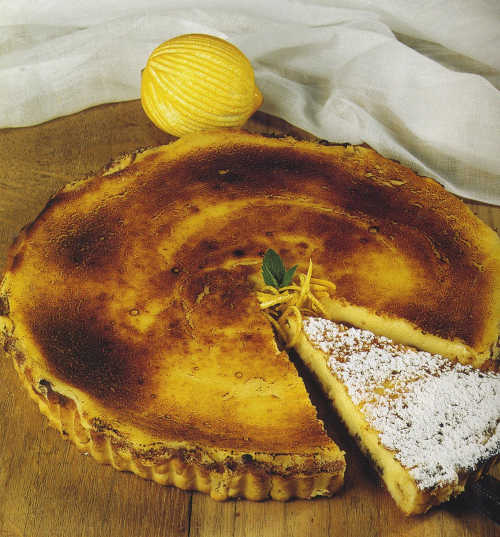 DESSERT:
DESSERT:
Tangy Lemon Tart (Tarte au Citron)
This makes a lovely dinner party dessert at any time of year but, with its golden colour and zingy flavour, it is perfect for an Easter meal. Although rich, this is a particularly easy version as the shell does not need to be pre-baked before filling and the filling is simple to make. Like other tarts, it is best eaten on the day of making, but it can be prepared ahead and gently re-warmed.
Serves 8-10
Pastry:
7oz/200g plain flour
Pinch of salt
4oz/l00g butter, preferably unsalted, at room temperature
2 level tablespoons caster sugar
1 small egg, lightly beaten
A little very cold water, if necessary
Filling:
2 large, juicy lemons
2 large eggs or 4 yolks
4 oz/l00g caster sugar
2 oz/50g ground almonds
4 oz/l00g butter, preferably unsalted, well softened
¼ pint/150 ml double cream
Icing sugar for dusting.
Sift the flour and salt into a mixing bowl or processor, cut in the butter and rub in/process to make a mixture like fine breadcrumbs. Using a fork if making by hand, work in the sugar, the lightly beaten egg and, if necessary, a little very cold water to make a smooth dough.
Roll into a ball, wrap in clingfilm and chill for an hour before use, if possible.
When ready to cook, roll fairly thinly and use to line a 10"/25 cm loose-bottomed tin. Prick the base lightly with a fork and leave in the fridge while you prepare the filling.
Preheat a very moderate oven, 325°F, 170°C, Gas mark 3.
Grate the zest from one of the lemons; squeeze the juice from both and strain. Using an electric mixer if possible, whisk together the eggs and sugar until very light and fluffy, add the ground almonds, the softened butter, the cream, lemon juice and zest.
Whisk together gently until the mixture is smooth and creamy, but take care not to overbeat as it may curdle. Pour into the pastry case and bake in the preheated oven for about 40 minutes, or until the filling is set and a light golden brown.
Serve warm or cold, dusted with icing sugar.
If you have some berries from last summer left in the freezer this is the ideal time to use them up, as a berry compote pairs nicely with this - along with some chilled and slightly sweetened whipped cream on the side.
And to round off your meal? What else but some gorgeous Irish handmade chocolates or an Easter egg with your coffee.
Cookery Feature - Eggs - Not Just for Breakfast!
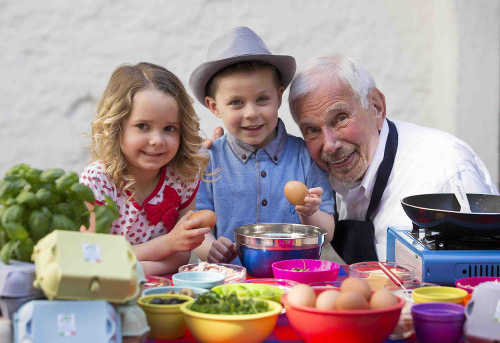
 Time was, before the advent of year-round everything in the food world, that eggs were associated with spring - and especially Easter, of course. Maybe something of that instinctive seasonality remains, as it still seems an ideal time to think about eggs.
Time was, before the advent of year-round everything in the food world, that eggs were associated with spring - and especially Easter, of course. Maybe something of that instinctive seasonality remains, as it still seems an ideal time to think about eggs.
The folk at Bord Bia seem to agree anyway, as they have issued a timely reminder that eggs can be for lunch and dinner, and not just for breakfast. They even have the help of the ‘Incredible Egg Man’ himself, renowned New York chef Howard Helmer, who came to Dublin to support the campaign by promoting the versatility and nutritional benefits of eating eggs as part of a balanced diet.
New York chef Helmer is the world’s fastest omelette maker, holding two Guinness World Records for his spellbinding high-speed cookery. A lover of all things egg related, Howard can cook up a whopping 427 omelettes in just 30 minutes!
In 2006, he became the world’s fastest omelette flipper (the omelette staying intact throughout 32 flips in a minute), as well as making the fastest single omelette from eggshell to plate (49 seconds). Having spent years perfecting his speciality, Howard believes that by following his techniques a kitchen novice can make the perfect omelette in just 40-60 seconds.
According to a Bord Bia study carried out in October 2013, our consumption of eggs for main meals has increased significantly with, for example, 37% of 25-45 year olds now eating eggs for their main evening meal - an increase of 17% since 2011.
There’s still plenty of room for improvement though. The study found that “85% of those questioned consume eggs at home at least once a week (up 5% since 2011); with 68% enjoying eggs at least 2-3 times per week” . That’s a long way from the daily consumption of eggs that was once so familiar and summed up in the ‘go to work on an egg’ campaign.
Thanks to the fact that eggs were demonised as being unhealthy for years, we have lost the habit of treasuring this natural convenience food, the versatile power pack of nutrition that sits waiting patiently in the fridge until we decide to rustle up a delicious quick meal with it.
Speaking about his first trip to Ireland to promote eggs on behalf of Bord Bia, Howard commented, “Talk about culinary art...an omelette is a blank canvas that can be painted however you like: with all manner of vegetables, protein foods, sweets, savouries, everything nutritious. How versatile is that?"
Helmer has spent the last 45 years travelling the world educating the masses on the nutritional benefits of eggs and demonstrating how versatile they are. He has made appearances on Oprah and Good Morning America and in 2011 was invited to do a demonstration at the White House for a session called "play with your food". For his dedication to teaching his simple omelette cooking skills, in 2011 the International Egg Commission named him “Egg Person of the Year Worldwide.”
Eggs form part of a healthy diet; they are versatile, don't take long to cook and are great value. With just a few eggs you have the makings of a feast of family favourites, from scrambled eggs to omelettes, quiches, tarts and frittatas; there is something to suit every palate.
Would you ever want to be without a dozen in your fridge?
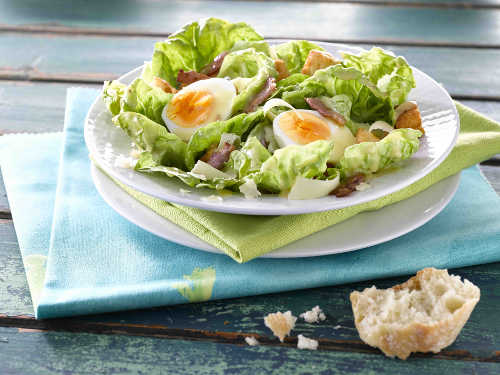 RECIPES: Caesar Salad with Soft Boiled Eggs and Bacon
RECIPES: Caesar Salad with Soft Boiled Eggs and Bacon
Who doesn’t love a good Caesar salad? One taste of this and you’ll be wondering why you never had eggs in it before now! A great twist on a classic.
Serves 4
Time: 15 minutes
1 tablesp. olive oil
3 slices of white or brown bread, cut into cubes
4 smoked rashers, diced
4 Bord Bia Quality Assured eggs for boiling
2 baby gem lettuce, leaves washed and dried
Mature Cheddar Cheese for grating
Dressing
1 whole egg
2 anchovies, finely chopped
1 teasp. Dijon-style mustard
Juice of ½ a lime
1 clove of garlic, crushed
100mls olive oil
Salt and freshly ground black pepper
Heat the oil in a frying pan. Add the cubes of bread and fry until golden, set aside. In the same pan add the rashers and cook until crispy, set aside.
To cook the eggs: Put the eggs in a saucepan and cover with cold water. Bring to the boil and cook for 3-6 minutes depending on how you want your eggs cooked - soft boiled or hard boiled. Remove from the saucepan and put into a bowl of cold water, then when cold enough to handle peel and set aside.
For the dressing: Place the egg, chopped anchovies, mustard, lime juice and garlic in a food processor. Whiz to combine. You can do this by hand if you prefer. Slowly add the oil a few drops at a time, while continuing to whiz until the mixture thickens, taste and season. The dressing should have the consistency of unwhipped cream. If it is too thick, add a teaspoon of warm water.
Roughly tear the lettuce and place in a large mixing bowl. Add 4-5 tablespoons of the dressing and toss well to coat. Add the croutons and bacon and toss again. Cut the boiled eggs into quarters.
Divide the salad into four serving bowls and top with boiled egg quarters. Grate on some cheese and serve immediately.
Any leftover Caesar dressing should be stored in the fridge. It will keep for 1-2 days.
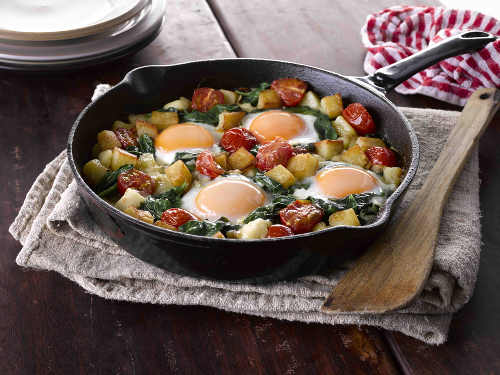 Diced Potatoes with Spinach and Eggs
Diced Potatoes with Spinach and Eggs
This is a great main course. The potatoes make it good and hearty. Add whatever farmhouse cheese takes your fancy and you’ll realise just how good eggs can be.
Serves: 4
Time: 45 minutes
4 large potatoes, peeled and cut into 3cm cubes
½ tablesp. oil
Knob of butter
1 onion, thinly sliced
Salt and freshly ground black pepper
250g spinach, washed, dried and chopped
12 cherry tomatoes, cut in half
4 large Bord Bia Quality Assured eggs
100-150g soft cheese
To serve: crusty bread
Place the potatoes in a saucepan with salted water and bring to the boil. Reduce to simmer and cook until tender. This will take about 6 minutes. Drain.
Meanwhile heat a large frying pan. Add the oil and butter. When the butter has melted add in the onion and fry until softened, about 8 minutes. Add the potatoes, season and cook until golden. Fold in the spinach and cook until wilted. Toss the tomatoes on top.
Remove from the heat and make 4 dips in the potato mixture. Crack an egg into each dip. Breakup the cheese and dot it around the eggs. Cover and return to a medium heat. Cook until the eggs are done to your liking, about 6 minutes.
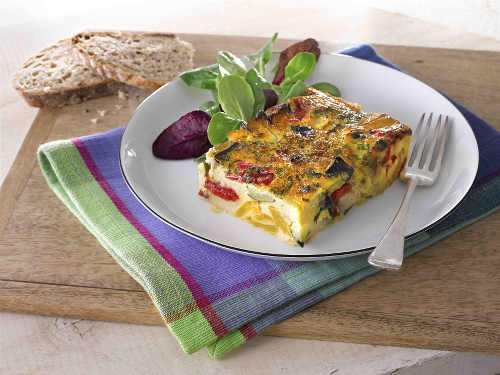 Baked Frittata with Roasted Vegetables
Baked Frittata with Roasted Vegetables
This easy week day dinner is perfect. Include whatever combination of veg you like to make this your new favourite frittata recipe!
Serves: 4-6
Time: 1 hour
1 medium red pepper, cut into 3cm pieces
1 medium yellow pepper, cut into 3cm pieces
1 small aubergine, cut into 3cm pieces
1 medium onion, cut into wedges, roughly 6/8 from each onion
1 courgette, cut into 3cm pieces
1 medium potato, peeled and cut into 3cm cubes
2 garlic cloves, peeled and chopped
1 tablespoon rapeseed oil
Salt and freshly ground black pepper
8 Bord Bia Quality Assured eggs
100mls milk
50g good quality hard cheese, grated
Handful of fresh parsley, chopped
To serve: Green salad and crusty bread
Preheat oven to Gas Mark 6, 200°C (400?F).
Place the prepared peppers, aubergine, onion, courgette, potato and garlic in a bowl and mix with a tablespoon oil. Season with a little salt and black pepper and then spread in a single layer in a roasting tray and roast for 15-20 minutes.
Line an ovenproof baking dish (6cm deep, 20cm x 20cm), with baking parchment.
Transfer the vegetables to the prepared dish. Reduce oven to Gas Mark 4, 180°C (350?F). Whisk the eggs and milk together in a jug. Add ? of the cheese and the parsley. Season with a little salt and black pepper then pour the egg mixture over the vegetables. Shake the dish gently to allow the egg to spread to the base, sprinkle over the remaining cheese.
Bake the frittata for 20 minutes or until top is golden and the centre is set. Let it rest for a couple of minutes before cutting into squares and serving with some salad and crusty bread.
Georgina Campbell's Cookery Feature - Cooking with a Legend
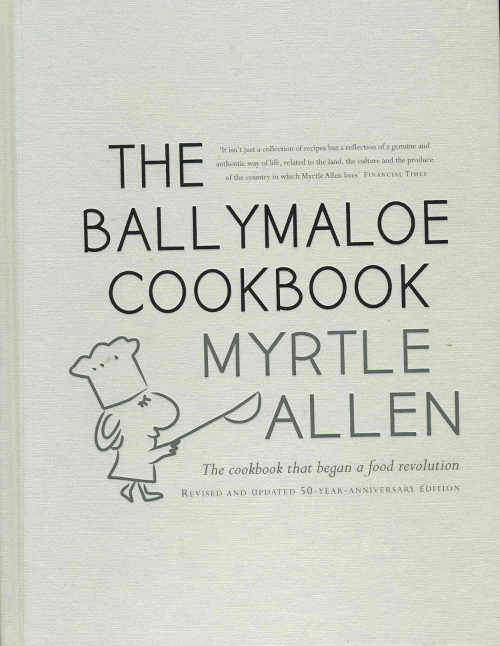
 Side by side on my desk are two books: the first edition of The Ballymaloe Cookbook by Myrtle Allen, published in 1977 by Agri Books - publishers of the Irish Farmers’ Journal, where many of Myrtle’s articles and recipes appeared - and the new, revised and updated edition The Ballymaloe Cookbook, The Cookbook that Began a Food Revolution, by Myrtle Allen (Gill & Macmillan, hardback, €27.99), which was published in May 2014 to celebrate Myrtle Allen’s 90th birthday and the 50th anniversary of her Ballymaloe restaurant, The Yeats Room.
Side by side on my desk are two books: the first edition of The Ballymaloe Cookbook by Myrtle Allen, published in 1977 by Agri Books - publishers of the Irish Farmers’ Journal, where many of Myrtle’s articles and recipes appeared - and the new, revised and updated edition The Ballymaloe Cookbook, The Cookbook that Began a Food Revolution, by Myrtle Allen (Gill & Macmillan, hardback, €27.99), which was published in May 2014 to celebrate Myrtle Allen’s 90th birthday and the 50th anniversary of her Ballymaloe restaurant, The Yeats Room.
Modest in size and extent, there are just 175 pages in the original book and no colour photographs, although each chapter begins with a black and white photo - mainly rural, and with a wistful tone even in those days - and, as well as occasional diagrams (carrageen moss, for example - no the ‘new foragers’ did not invent it - or how to make an ice bowl), the text is sprinkled with the witty line drawings by Mel Calman that so perfectly reflect Myrtle Allen’s inimitable way of saying the sometimes surprising things that needed to be said.
Insightful and full of practical wisdom, it is an all-time favourite of mine and one of the few always kept to hand for over 35 years.
 The new edition lends due gravitas to the original, setting it in context and - through carefully extended recipe content, colour photography (by Joanne Murphy and others) and rather more information about Myrtle and Ballymaloe - respectfully introducing it to a new generation of admirers.
The new edition lends due gravitas to the original, setting it in context and - through carefully extended recipe content, colour photography (by Joanne Murphy and others) and rather more information about Myrtle and Ballymaloe - respectfully introducing it to a new generation of admirers.
It may not be the same book as the 1977 edition - but, like an old house that has been sensitively extended, it has retained the essential quality of the original while growing into a larger and, perhaps, even more useful production.
The directness of Myrtle’s voice is as powerful as ever and, far from being just ‘a collection of recipes’, The Ballymaloe Cookbook is about pleasurable learning, and its central message on food quality and sourcing remains even mores relevant today than when it was first published.
That said, the recipes themselves are terrific, and it’s a great read too. And, Myrtle being a natural teacher, even the inexperienced cook will be rewarded by success when cooking from this classic.
It should be on every wedding list - and, if every secondary school could introduce its teenage students to The Ballymaloe Cookbook (together with hands on cooking), the health and wellbeing of the nation would be assured.
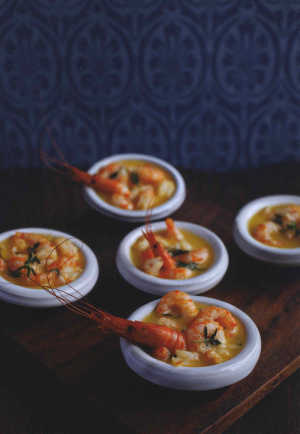 Potted Shrimps or Lobster
Potted Shrimps or Lobster
“A fish pate or potted fish makes a wonderfully easy lunch or supper dish.
Packed into tiny individual pots, a selection of any three makes a stunning dinner party starter. They are not suitable for picnics unless packed in a chilled container, as the butter goes soft.”
Serves 4 as a first course
½ clove garlic, salt and pepper, 60-85g (2-3oz, 4-6 tablespoons) butter, 1 teaspoon thyme leaves, 110g (4oz) shelled shrimps or diced lobster meat, 1-2 teaspoons lemon juice
Crush the garlic to a paste with a little salt. Bring the butter to the boil with the thyme leaves and garlic.
Add the shrimps or lobster and simmer together for 3-5 minutes. Season carefully with salt and pepper and 1 or 2 teaspoons of lemon juice.
Pack into pots and run more melted butter over the top.
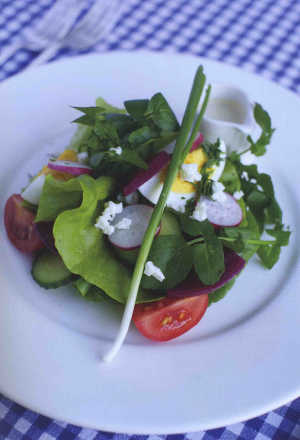 Traditional Salad
Traditional Salad
“The traditional salad was and still is standard fare for Sunday evening suppers. It accompanied cold meat, probably left over from the midday joint. No dressing goes better with it than Lydia Strangman’s, sister of my husband’s elderly farming partner, an unmarried Quaker lady of strict principles, who spent her life painting and making a beautiful garden.”
Arrange lettuce leaves like a rose in a deep bowl - biggest leaves on the outside, small leaves in the centre. Scatter some or all of the following between the leaves; quartered hard-boiled eggs, quartered tomatoes, slices f cooked beetroot, slices of cucumber, cress, watercress, mustard leaves.
Serve with Lydia’s cream dressing (below).
Lydia's Cream Dressing
“Oil was not considered as a food in the average Irish household during the first half of the last century. There was always a small glass bttle of rancid olive oil in our house, but it was kept in the medicine cupboard and used for sunburn. Cream dressings were served with salads.”
2 eggs, 1 tablespoon soft brown sugar, 1 level teaspoon dry mustard, pinch of salt, 60-120 ml (2-4 fl oz, ¼-½cup) cream, 1 tablespoon brown malt vinegar.
Hard boil the eggs. Bring a small saucepan of water to the boil. Gently slide in the eggs and hoil tor 10 minutes (12 if they are very fresh).
Strain off the hot water and cover with cold water. Peel when cold.
Cut the eggs in half and sieve the yolks into a bowl. Add the sugar, the mustard and a pinch of salt.
Blend the cream and the vinegar. Chop the egg whites and add some to the sauce. Keep the rest to scatter over the salad.
Cover the dressing until needed.
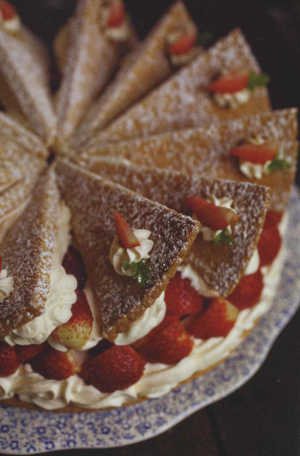 Strawberry Shortcake
Strawberry Shortcake
“The shortcake mixture makes a good biscuit to go with morning coffee or fruit fools. It was first made for us by one of my children's friends when I decided to let them all loose in the kitchen on a wet Sunday afternoon. No wonder that I so firmly believe in having children in the kitchen, except at certain moments!”
serves 6
110g (4oz, 1½ cups) unsalted butter, 170g (6oz, 1¼ cups) plain flour, 55g (2oz, ¼ cup) caster sugar, 250ml (8fl oz, 1 cup) sweetened whipped cream, 225g (8oz) strawberries, 1 teaspoon icing sugar
To make shortcake, rub the butter into the flour and add the sugar. Gather the mixture together and knead well.
Roll into two circles approx. 18cm (7in) in diameter and 5mm (¼ in) thick.
Bake in a moderate oven, l80°C/350°F/gas 4, until pale brown, 15 minutes approx.
Remove and cool on a rack.
One circle should be marked with a knife into wedges while still warm, to aid cutting the cake later.
Sandwich with sweetened whipped cream and halved strawberries.
Sieve icing sugar over top.
Variation: Jane's Biscuits
Make the pastry as above and roll out as for shortcake. Cut with a 6cm (2½in) round cutter or heart-shaped cutter and bake as directed.
Comber Potatoes - Cookery Feature from Georgina Campbell
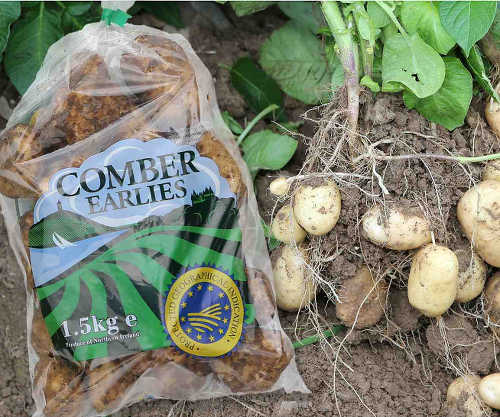
 Ireland’s answer to the famed Jersey Royal early potato from the Channel Islands, Comber Earlies are this island’s flagship potato and one of only a small handful of products here to have the right to use the blue and yellow EU PGI ('Protected Geographical Indication') logo.
Ireland’s answer to the famed Jersey Royal early potato from the Channel Islands, Comber Earlies are this island’s flagship potato and one of only a small handful of products here to have the right to use the blue and yellow EU PGI ('Protected Geographical Indication') logo.
It’s a recognition that should be applied to far more Irish foods but, as chairman of the Comber Earlies Growers Co-Op, Richard Orr, and his co-campaigners know all too well, takes not just a unique product but also patience and determination to achieve.
So what’s so special about the Comber Earlies? Well, the answer lies in the soil and, especially, the microclimate of the Comber area, which is sheltered by the Mournes and the Ards Peninsula and protected from frost by the salt waters of nearby Strangford Lough, allowing for an earlier harvest than other potato-growing areas and a sweet, nutty flavour that is common to the varieties grown in the area.
These include modern varieties like Accord and Casa Blanca as well as old favourites such as Homeguard and Dunluce, and it is the growing and early harvesting in this particular area of Co Down that makes them unique, rather than the variety.
Only potatoes harvested in May, June and July may be marketed as New Season Comber Potatoes or Comber Earlies; they can be round or oval according to variety but, being harvested young, they will be quite small and have the thin, flaky ‘new potato’ skin that is typical of potatoes that are lifted while the foliage is growing strongly.
Later varieties harvested after the foliage has died back (or been removed) have more robust skin which makes them be less susceptible to damage and to keep better, and it’s important to remember that earlies are for immediate use.
These are the sort of spuds you would dig in your garden and take straight into the kitchen for dinner to enjoy their summery flavour that night, so 24 hours from farm to fork is the farmers’ aim.
Like all new potatoes, they’re a dish fit for a king when cooked simply - steamed or boiled lightly in water or milk and water, with a sprig of mint - and served with a good knob of butter and a sprinkling of sea salt.
But, needless to say, the chefs of Northern Ireland have other ideas, as proved by demonstrations at the Comber Potato Festival in June, which was attended by a great range of inspiring chefs including Danny Miller from The Poacher’s Pocket nearby at Lisbane; Will Brown of The Old Schoolhouse Inn, Comber; Fritz Machala of Sugarcane Bistro, Comber; BBC Radio Ulster chef, Paula McIntyre; Carl Johansson of James Street South Bar and Grill, Belfast; and Colin McCreedy, of La Mon Hotel & Country Club, near Belfast.
Further information:
RECIPES from the Comber Potato Festival, June 2014:
 Lobster and Comber Potato Salad With Crispy Bacon & Tarragon
Lobster and Comber Potato Salad With Crispy Bacon & Tarragon
This lovely simple dish is from Carl Johannson of the very popular James Street South Bar and Grill in Belfast. It is quick and easy to make if the lobster has been prepared ahead of assembly.
Serves 4
Ingredients:
Flesh of a freshly cooked 2lb lobster (boiled for 8 minutes)
Smoked pancetta
1kg baby Comber potatoes
100g mini capers
100g sliced shallots
50g chopped fresh tarragon
2 cups mayonnaise, preferably homemade
Garnish: fresh watercress
1. Bake the pancetta until crispy.
2. Boil the Comber potatoes in salted water until tender then drain.
3. Mix together the Comber potatoes, capers, shallots and tarragon with two cups of mayonnaise.
4. Place into a clean serving bowl and arrange the lobster, pancetta and watercress on top.
 Peter Hannan’s Himalayan Salt Aged Sirloin With Warm Comber Potato Scallion & Horseradish Salad.
Peter Hannan’s Himalayan Salt Aged Sirloin With Warm Comber Potato Scallion & Horseradish Salad.
This beautifully understated dish is from Danny Miller at The Poacher’s Pocket, Lisbane - and, like all simple dishes, success depends on quality ingredients and skilful cooking.
Peter Hannan’s famous steaks, from his unique Himalayan salt aging chamber in Moira, are perfectly complemented by the warm Comber potato salad.
Serves 4
2 x 12oz Peter Hannan’s salt aged sirloins
500g Comber potatoes cooked and kept warm
6 tablespoons good mayonnaise
1 tablespoon good horseradish
1 bunch scallions 1 bag watercress
1 x pickled red onion
1. Season the sirloins on both sides and cook on a hot pan for 2 minutes either side (for rare) and leave to rest.
2. Mix mayonnaise and horseradish together and combine with sliced Comber potatoes and scallions. Check seasoning and place on serving plate.
3. Slice the steak and place around potato salad. Drizzle over any juices from the steak.
4. Garnish with watercress and pickled red onion.
Comber Earlies with Roast Garlic & Rosemary
A lovely versatile side dish from Colin McCreedy of the La Mon Hotel & Country Club, near Belfast.
Serves 4:
Ingredients:
12 Comber Earlies (equal in size)
Butter and olive oil, as required
2 cloves of garlic, sliced
4 sprigs of rosemary
Salt & pepper
Sea salt flakes, to serve
1. Scrub and wash the Comber Earlies. Boil in salted water for 20-25 minutes or until tender, then drain and keep warm.
2. Place a pan on a medium-high heat, add a good knob of butter, a drizzle of olive oil, the sliced garlic and sprigs of rosemary; season and sauté for 1 minute.
3. Add the Comber Potatoes to the pan, coat with the butter mixture and cook for 4-5 minutes to roast and crispen the skin. Take care to keep rolling potatoes in the pan to brown them evenly and prevent burning.
4. Sprinkle lightly with sea salt flakes and serve.
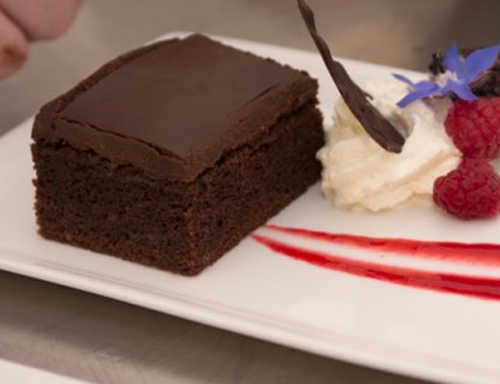 Comber Potato & Chocolate Fudge Cake
Comber Potato & Chocolate Fudge Cake
Although mainly used in main courses and side dishes, potatoes are extremely versatile as an ingredient and especially valuable for adding moisture and texture to baking and desserts, in a similar way to ground almonds. This more-ish dessert is from Colin McCreedy of La Mon Hotel.
Serves: 4-6
Ingredients:
200g Comber Potatoes, mashed
125g butter
4 tablespoons of cream
100g dark chocolate
350g caster sugar
2 tablespoon cocoa powder
5 egg yolks
1½ teaspoon baking soda
4 tablespoon hot water
200g plain flour
2 teaspoon baking powder
5 egg whites
Topping:
250g dark chocolate
185ml whipping cream
Preheat a moderate oven, 160ºC.
1. Put the mashed potatoes, butter, cream, dark chocolate, caster sugar and cocoa powder into a large heatproof bowl.
2. Place the bowl over a pan of boiling water, and then leave for 5-10 minutes to melt together.
3. When the ingredients have melted, use a wooden spoon to mix them and combine thoroughly together.
4. Remove from the heat and beat in the egg yolks.
5. Add the baking soda to the hot water, then whisk into the chocolate mixture.
6. Gradually fold in the sifted flour and baking powder, to make a smooth batter.
7. Using an electric mixer, whisk the egg whites in a clean bowl, then carefully fold into the cake batter in 3 stages.
8. Pour onto a baking tray or a cake tin lined with parchment paper and bake in the preheated oven for 45-50 minutes, or until firm and springy to the touch.
9. While the cake is baking, make the topping: Break up the dark chocolate into smaller pieces and place in a medium sized bowl. Boil the cream and pour onto the broken chocolate pieces, whisk well to combine with the melted chocolate, creating a smooth glossy ganache topping. Set to one side until required.
10. Remove the fudge cake from the oven leave to cool in its baking tray/cake tin to keep its shape.
11. When cold, peel the paper from bottom of the fudge cake, turn right side up and coat with the prepared chocolate ganache topping.
12. Leave to set, and then cut into portions and enjoy at room temperature or served warm with your favourite ice-cream.
No Kidding! Goat Meat Makes It Onto Irish Menus At Last

 The goat is the most widely used farm animal in the world for its milk, the cheese and its meat - yet, astonishingly, we hardly use it at all here, except for cheese.
The goat is the most widely used farm animal in the world for its milk, the cheese and its meat - yet, astonishingly, we hardly use it at all here, except for cheese.
It really is the invisible meat. A quick check through a couple of dozen of the most likely cookbooks in my collection revealed only one or two passing references and no actual recipes at all, and online searches which initially looked promising first churned out masses of recipes using goat cheese instead of the meat requested.
But all that is about to change here, as a number of leading restaurants are beginning to put goat dishes on their menus and goat dairy farmers are seeing a new market emerging for their male kids.
Siobhan ni Ghairbhith, of St Tola Irish Goat Cheese in Co Clare, is Ireland’s most energetic goat ambassador, having won endless accolades for the St Tola range of cheese over a quarter of a century and constantly introduced new ideas to raise the profile of Irish goats.
Very aware of the growing interest in food tourism as well as artisan produce, St Tola is a leading member of the Burren Food Trail and has recently opened an Economusée on site, allowing visitors to get a taste of what the farm and cheesehouse is all about without booking the full tour. (This French / Canadian programme, facilitated in Ireland by Teagasc, aims to help craft and artisan food producers to open up small working museums.)
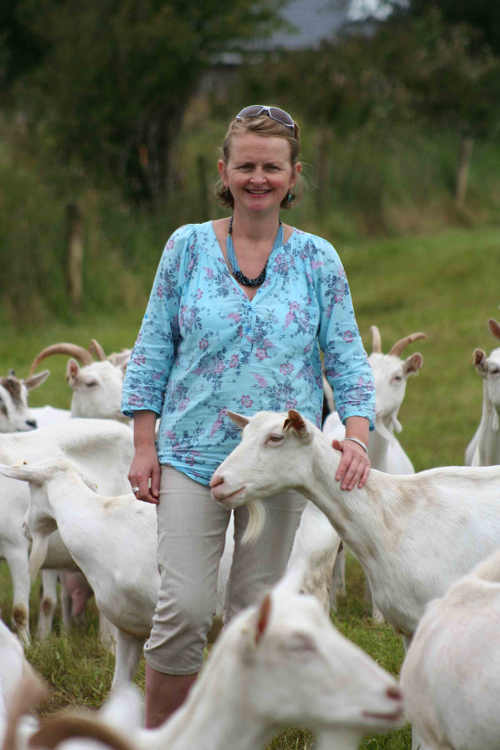 Siobhan ni Ghairbhith and the team at St Tola feel that it’s a shame that goat meat has a poor image. So what’s the problem? “There is some perception that goat or kid meat will be very strong but this is not true. For example Irish lamb has a strong flavour, but even adult goat meat does not taste as strong as lamb (and certainly not like mutton!) There is also still some association that the goat is the poor man’s cow... In this area, there was once a tradition of having kid meat at Easter, a tradition that has died out but that we hope will be revived in the future.”
Siobhan ni Ghairbhith and the team at St Tola feel that it’s a shame that goat meat has a poor image. So what’s the problem? “There is some perception that goat or kid meat will be very strong but this is not true. For example Irish lamb has a strong flavour, but even adult goat meat does not taste as strong as lamb (and certainly not like mutton!) There is also still some association that the goat is the poor man’s cow... In this area, there was once a tradition of having kid meat at Easter, a tradition that has died out but that we hope will be revived in the future.”
They also point out that it’s a very healthy meat - “only 3% fat in goat meat and, as it does not marble throughout the meat, the fat is very easy to trim. This is as opposed to 21% in lamb, quite a difference”. It’s versatile too, and can be substituted in many recipes where lamb or beef is usually called for although, being so low in fat, kid meat is usually best slow cooked: “think of lovely Caribbean Goat Curry...mmm!”
In Ireland most goats are farmed for their milk and cheesemaking, and St Tola is currently the main supplier of meat. “We are delighted to have some outlet for the male kids, this is always a problem in the dairy industry. The season for the meat runs from April to October.
Our kids are reared for a minimum of 12 weeks before slaughter. This is to give them a chance to fatten up a bit: as they are dairy breeds they don't put muscle on as fast as a breed kept specifically for meat (much like the difference between a Friesian cow and an Aberdeen Angus).”
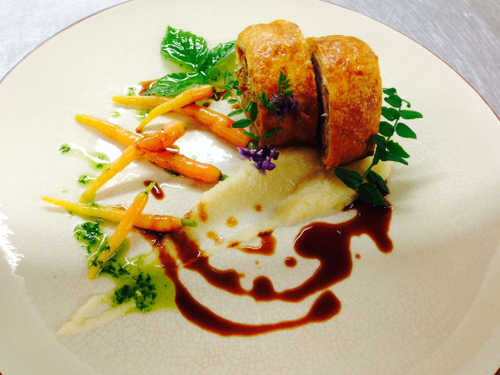 Perhaps not surprisingly, Evan Doyle of The BrookLodge Hotel, Co Wicklow was one of the first to spot the potential of Irish goat meat and St Tola kid meat is on chef Tim Daly’s menus all the time when it’s in season.
Perhaps not surprisingly, Evan Doyle of The BrookLodge Hotel, Co Wicklow was one of the first to spot the potential of Irish goat meat and St Tola kid meat is on chef Tim Daly’s menus all the time when it’s in season.
One of Tim’s favourite dishes - and a very elegant one in the fine dining category - is slow cooked goat in puff pastry (a sort of ‘goat wellington’), which he serves with baby carrots, celeriac purée and a little wild garlic.
In Dublin last month, Chef Philip Mahon of The Fitzwilliam Hotel created - and personally introduced - a whole menu around various cuts of goat meat, goat cheese and foraged/seasonal accompaniments for a Citron Supper Club to celebrate the restaurant’s refurb, using goat sourced from Dundrum. Co.Tipperary. Although intended as a one off, it went down a treat and may well be the first of many.
The chef at Dromoland Castle, David McCann, is also a fan and not only runs "specials" at the Castle but he’s also making it a key player on the menu at the new Shannigans gastro pub bar at The Inn at Dromoland, next door.
“In August, when the weather is kind, we will be doing St Tola goat kebabs, and billy burgers with pineapple and tomato salsa. Later we will move to the traditional curry, and braised dishes using cumin, coriander etc. We also love trying out traditional dishes using goat as a replacement meat, moussaka, cottage pie, meat balls and salads, all on daily specials.”
Another huge fan of goat meat is Ross Quinn, of Vasco Dine Wine Deli & Eco Adventure at Fanore in West Clare: “Goat is probably our biggest seller apart from fish and seafood. It has become enormously popular from the slow introduction we had with it almost six years ago. We source our meat from two locations - the Jeuken family organic farm behind Father Ted's house (Glenquin Farm) and from Siobhan at St. Tola.
The Jeuken's offer a special type of kid that is bred for meat whereas the St. Tola kids are bred for milk and then can be better used for hotpots, pies, stews and curries. They both produce wonderful meat. We normally only use the female kids until we start running out in late summer, and then we begin to use the stronger tasting meat from the male kids.”
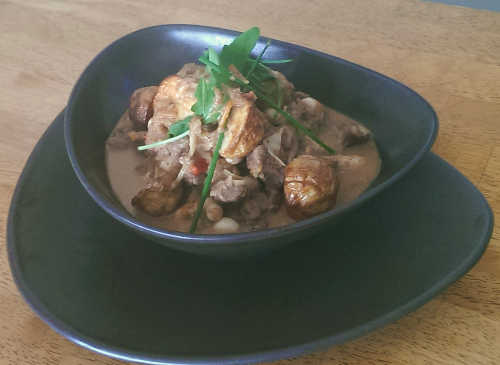 “As we move through the year we change our dishes considerably and, in particular, how we use the meat,” explains Ross. “In early spring and summer we do very little apart from sprinkle the cutlets with sea salt and olive oil and grill quickly for 2 minutes either side, serving them with baby roast potatoes, wild garlic tzatziki and a salad. In early summer we begin to marinate the meat cutlets in coriander, soy, mint, cider vinegar, sesame oil, ginger & honey before grilling them and serving them with a dressing (as above), spiced couscous and a summer slaw. Now, in mid to late summer and into early autumn, we use lots of the shoulder meat for Caribbean style curries with coconut, allspice berries, coriander and cloves. We also have a great dish with slow-braised shoulder marinated in garlic and rosemary with borlotti beans (see recipe below). Another favourite as the meat develops stronger flavours is to cook it ever so slowly with chanterelles, blackcurrants, red wine and juniper berries, serving with steamed cabbage and baked potatoes.”
“As we move through the year we change our dishes considerably and, in particular, how we use the meat,” explains Ross. “In early spring and summer we do very little apart from sprinkle the cutlets with sea salt and olive oil and grill quickly for 2 minutes either side, serving them with baby roast potatoes, wild garlic tzatziki and a salad. In early summer we begin to marinate the meat cutlets in coriander, soy, mint, cider vinegar, sesame oil, ginger & honey before grilling them and serving them with a dressing (as above), spiced couscous and a summer slaw. Now, in mid to late summer and into early autumn, we use lots of the shoulder meat for Caribbean style curries with coconut, allspice berries, coriander and cloves. We also have a great dish with slow-braised shoulder marinated in garlic and rosemary with borlotti beans (see recipe below). Another favourite as the meat develops stronger flavours is to cook it ever so slowly with chanterelles, blackcurrants, red wine and juniper berries, serving with steamed cabbage and baked potatoes.”
And that’s not all: “Our deli at Vasco sells a very popular sandwich based on slow-braised kid goat, apricot and ginger chutney and St. Tola Goat's cheese and our gourmet pie company, Connemara Pies, is also currently developing a pie for market, which we hope will join the rest of our range in being sold across Europe.”
WHERE TO BUY GOAT MEAT:
O'Tooles Master Butchers (www.otoolesbutchers.com) in Dublin are selling goat meat in season, and a local farmer sells goat meat (not supplied by St Tola) at the Saturday Farmers’ Market at Harrys of Bridgend, Co Donegal.
In Northern Ireland, the Cole family’s Broughgammon Farm (www.broughgammon.co.uk), near Ballycastle, Co Antrim, rear goats for meat (‘cabrito’) along with several other interesting products, including free range rose veal and hand harvested seaweeds. They operate a farm shop (Wed-Sun 10-5), and offer postal sales throughout Ireland; an online shop is planned for next year.
RECIPES:
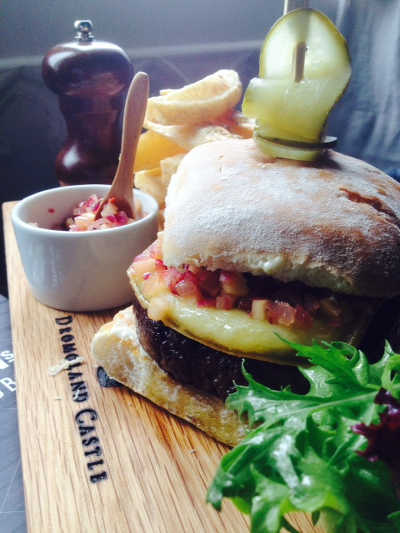
Serves 4
For the flavoured butter
50g butter
8 crushed green peppercorns
pinch of chopped parsley / sage,
1 clove garlic, crushed
Soften the butter (do not melt) add all the ingredients and mix well. Place on greaseproof paper and roll into a cylinder 1-2 cm in diameter, refrigerate. When firm, slice into discs.
For the burgers
600g minced kid goat (it’s all very tender)
zest of 1 lime, or to taste
seasoning, a pinch of each: sea salt, ground cumin, paprika & pepper
Lightly season the mince and mix in the zest. Separate into four 150g balls of mince.
Using a ring or pastry cutter, mould half of each ball into the ring place a piece of prepared butter in the centre and cover with the other half of minced venison, mould into a burger shape. Repeat for the remainder of the minced kid.
To cook the burgers, shallow fry in Irish rape seed oil for 3 minutes on each side. Please keep medium rare for kid goat is very dry when cooked well done.
If you will only eat well done meat replace 150g of mince with the same quantity of minced pork and cook burgers through.
For the salsa (best if made 1 hour in advance)
100mls cider vinegar
2tsp brown sugar
dash of soy sauce
2 red onion finely diced
1 red chilli finely diced (seeds removed)
1 peeled granny smith apple, diced finely
dash of rape seed oil
drop of toasted sesame seed oil
drop of lime juice
In a saucepan, heat the vinegar and sugar, reduce to make a light syrup and remove from the heat.
Next add the soy sauce, then the onion, chilli and apple, mix well. Finish the salsa with the rape seed oil and sesame oil and finally the lime juice, correct the seasoning. Leave to rest at room temperature.
To finish
4 burger buns, good quality Irish (ideally Waterford blaas)
4tsp quality mayonnaise
1tsp prepared horseradish sauce
4 slices of Saint Brigid cheese (semi-soft, made in Fermoy by Frank and Gudrun Shinnick; distributed by Sheridans)
Cut the buns in half and toast.
Mix the mayo and horseradish together and spread on the toasted buns.
Place the Billy Burgers on the base bun, add the cheese next and melt, next add the salsa and then the top bun.
To serve: Skewer with your favourite pickles and serve with hand cut chips and mixed green salad.
Slow-cooked Burren Organic Kid Goat with Borlotti Beans and Rosemary is one of the most popular goat dishes served at Vasco Dine Wine Deli & Eco Adventure, Fanore, Co Clare.
Serves 4 - 6
Ingredients
1 onion diced
1 stick celery sliced thinly
4 garlic cloves, finely chopped
800g trimmed & diced kid goat shoulder
handful of flour
2 large sprigs of rosemary finely chopped
2 small grated carrots
200g borlotti beans (soaked overnight)
1 bottle of Stonewell cider (from Kinsale, Co Cork)
1 litre chicken stock
600g of baby salad potatoes
sea salt, cracked black pepper
flat-leaf parsley
• Cook the onion and celery until soft in a little Irish rapeseed oil on the hob, in an ovenproof pot.
• Add the garlic for 30 seconds and remove to another bowl.
• Dust the meat with flour and brown the meat in a little oil in the pot.
• Add the onion mix back in, together with the rosemary, carrots and beans, and stir through.
• On a medium heat, add the cider and reduce it down by about half.
• Add the chicken stock and put a tight fitting lid on the pot.
• Place it in the oven and cook gently at 150ºC for 1 hour. Add a little more stock if it is drying out.
• Skim off the excess fat at this stage & then add the baby potatoes to the pot and continue cooking for a further 30 minutes until the meat is very soft but not stringy.
• Add salt and cracked black pepper to taste.
• Ladle into bowls, sprinkle with parsley and serve with a green salad and some crusty bread to mop up the juices.
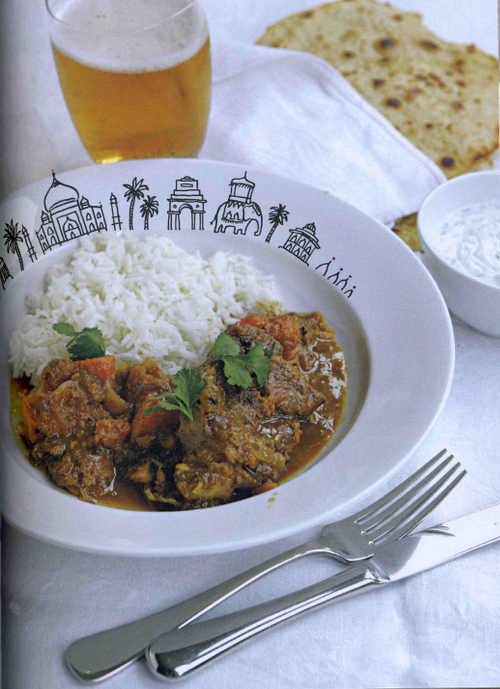 Many recipes for lamb and beef are easily adaptable for goat meat. This Lamb and squash curry from Hugh Fearnley-Whittingstall’s excellent River Cottage Every Day (Bloomsbury, hardback) would make a good start.
Many recipes for lamb and beef are easily adaptable for goat meat. This Lamb and squash curry from Hugh Fearnley-Whittingstall’s excellent River Cottage Every Day (Bloomsbury, hardback) would make a good start.
“Slow simmering renders the meat meltingly tender, while adding a jar of chutney is a great shortcut to creating real depth of flavour. Use a good, spicy, fruity chutney - if it's home-made, all the better. I have no qualms about using a good-quality ready-made curry powder or masala in a recipe like this, but including some freshly ground cumin and coriander certainly enhances the flavour.”
Serves 6-8
Ingredients
1 teaspoon cumin seeds
1 teaspoon coriander seeds
1.5kg shoulder (or neck) of lamb, trimmed of excess fat and cut into 4cm cubes
3 tablespoons rapeseed or sunflower oil
1 onion, sliced
2 garlic cloves, chopped
6cm piece of fresh ginger, grated
3-6 teaspoons medium- hot curry powder, to taste
500g jar of chutney
1 bay leaf
Water or stock to cover
About 750g butternut or Crown Prince squash, peeled and cut into 3cm cubes
Cayenne pepper (optional)
A handful of coriander sprigs (optional)
Sea salt and freshly ground black pepper
If you have time, lightly toast the cumin and coriander seeds together in a dry frying pan for a minute or so, until fragrant. Then grind them finely using a pestle and mortar or spice grinder. Season the meat with the ground spice mix, a little salt and black pepper.
Heat 2 tablespoons of the oil in a large, heavy-based frying pan, add the seasoned meat and cook over a medium-high heat until browned all over. Don't overcrowd the pan - you will probably need to do this in batches. Transfer the browned meat to a large, heavy-based saucepan, using a slotted spoon.
Heat the remaining oil in the frying pan and add the onion, garlic, ginger and curry powder. Saute for 4-5 minutes, until softened.
Tip the spiced onion mixture into the pan with the meat, then add the chutney, bay leaf and enough water or stock just to cover. Bring to the boil, reduce the heat and simmer very gently, uncovered, for 1 hour.
Add the squash and cook for a further 1 hour, until the lamb is very tender. Adjust the seasoning, if required - if you want a hotter curry, you could add a good pinch of cayenne. Serve with flatbreads and/or rice, and a scattering of coriander if you like.
Cookery Feature - Armagh Bramley Apples
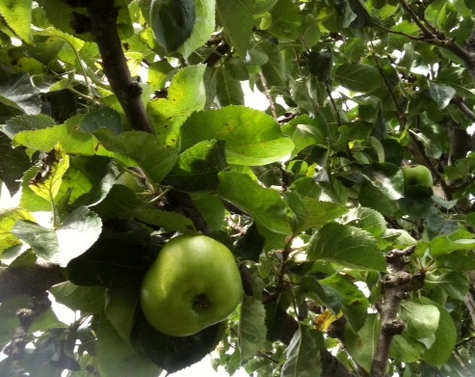

The special qualities of the Bramley’s Seedling have made it the most popular cooking apple in Britain and Ireland - and those grown in Northern Ireland’s ‘Orchard County’ are extra special: Armagh Bramley Apples are among a very small number of Irish products to have gained the European Commission for PGI (Protected Geographical Indication) status - the other two in Northern Ireland are Lough Neagh Eels and Comber Early Potatoes.
It is one of Ireland’s latest fruit crops, harvested up to the end of October. However, there was plenty of fruit ready to pick in early September this year, in time for the Armagh Bramley Apple Festival held in Armagh City on Saturday 6th September, to celebrate the apple and its special status.
“Basically, what the PGI Quality Mark means is that no other Bramley apple has quite the same attributes as one from the Diocese of Armagh, thanks to the distinctive climate and environmental conditions of the region in which they are grown and the way they are nurtured,” say the organisers. “Our Armagh Bramley Apples are a bit bigger than most, have a flatter top and bottom, are solid green in colour with a reddish blush, are more robust for a longer shelf-life, and, perhaps most importantly as a culinary apple, they have a delectable tangy flavour and maintain that taste and their texture when cooked.”
From the grower’s viewpoint, the Bramley is disease and pest tolerant, producing a good crop of large apples in most years. The apples are hard, have good flavour and keep well so they can be sold over a long period. When it comes to the all important cooking and eating qualities, cooks find the large size convenient for preparation and their natural sharpness is a great quality too, balancing the sweetness of pastry and any added sugar, while the fruit acids help break down the apple during cooking so that it ‘falls’ to produce a unique fluffy purée.
Armagh, ‘The Orchard County’, has a history of apple growing that goes back ‘forever’. St Patrick, the early monasteries, and William of Orange are among the many with historical references linking apples – and cider – to the area, and there are many folk customs associated with apples, especially at Hallowe’en.
Nowadays most of the commercial Armagh Bramley crop is prepared for apple sauce and bakery, and the rest is retailed whole or juiced. Interestingly, however, although they are grown specifically for cooking and they are quite sharp, the Bramley’s flavour is delicious and anyone without a very sweet tooth is likely to enjoy them raw too, especially after some time in storage when the natural sugars have developed and mellowed the flavour.
The Loughgall Manor Estate and Country Park (Main Street, Loughgall, Armagh BT61 8HZ; between Portadown and Armagh via the B77), is in the heart of the apple growing area. It has a walled garden containing a fascinating Heritage Orchard with a collection of 130 native Irish apple varieties established by The Armagh Orchard Trust; the research centre, Agrifood & Biosciences Institute (AFBI) is also on the property (+44 (0)28 90 255636; www.afbini.gov.uk).
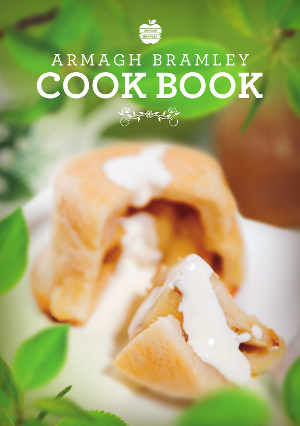 Aside from their historical importance, old varieties are of interest because they flourished before chemical treatment for pests and diseases was the norm, so they tend to have natural resistance to diseases such as scab – and their flowering habits make them less vulnerable to late frosts, providing quality fruit over longer harvesting periods.
Aside from their historical importance, old varieties are of interest because they flourished before chemical treatment for pests and diseases was the norm, so they tend to have natural resistance to diseases such as scab – and their flowering habits make them less vulnerable to late frosts, providing quality fruit over longer harvesting periods.
The original tree was planted over 200 years ago, and trees dating from around that time still stand in commercial orchards in Ireland today - so, next time you enjoy a juicy Armagh Bramley apple pie or a big baked Armagh Bramley apple, it may be interesting to reflect that the apple could have come from a tree over a century old.
An Armagh Bramley Cook Book was launched at the 2014 Armagh Bramley Apple Festival and is available to download without charge from www.armaghbramley.com where there is also more information on more on Armagh Bramley Apples (PGI). Here’s a taster of the recipes submitted by well known Northern Irish chefs and enthusiastic local cooks.
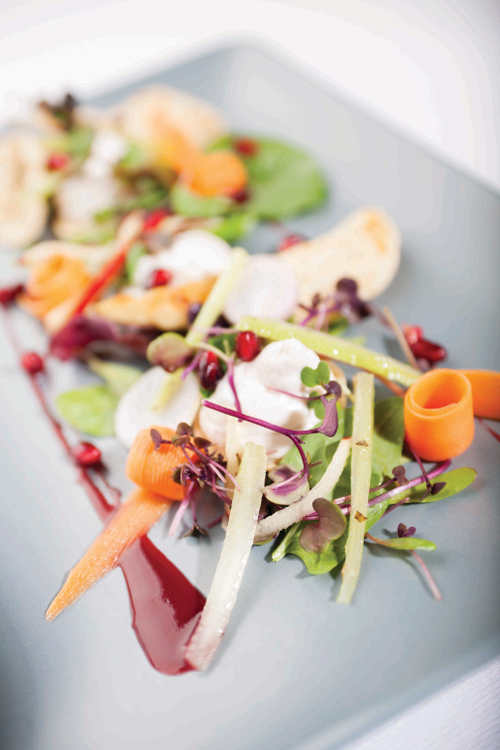 STARTER: Whipped Goat’s Cheese Mousse, Bramley Apple & Celery Chutney, Dressed Leaves, Crisp Flat Bread
STARTER: Whipped Goat’s Cheese Mousse, Bramley Apple & Celery Chutney, Dressed Leaves, Crisp Flat Bread
Recipe supplied by: Uluru Restaurant – Dean Coppard
Ingredients
200g skinless goat’s cheese
100ml whipping cream
2 Bramley apples
2 sticks of celery
100g caster sugar
50g butter
One bag watercress
4 pitta bread
Sea salt and cracked black pepper
Method
For the vinaigrette, place broken up goat’s cheese into a mixer and beat with the cream until smooth, place into a piping bag, cut the apple into thin slices then slice again to create matchsticks of apples, peel the celery and slice finely to match the size of the apple.
To make the chutney place the apple and celery in a heavy bottom pan and mix the butter and the sugar through to create a jam consistency, set aside.
Cut the pitta bread into desired shape, then char grill and place in the oven until crispy.
To assemble place the toast on the plate then pipe the mousse onto the bread, then arrange the chutney around the toast, toss the leaves in the vinaigrette and garnish the plate, season to taste.
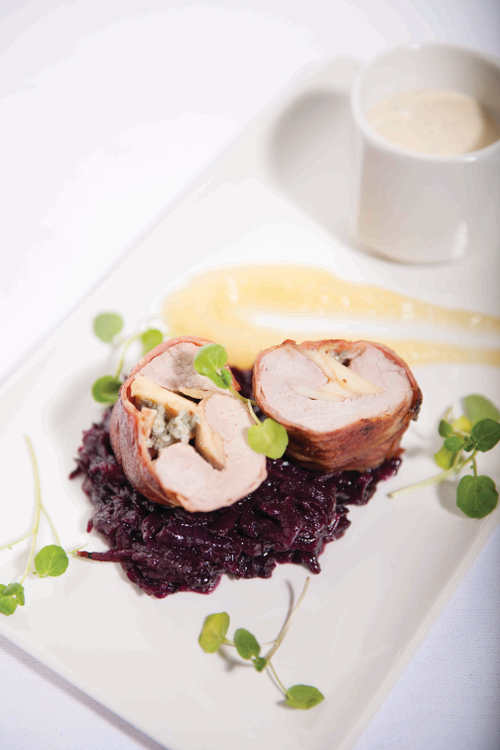 MAIN COURSE: Stuffed Pork Fillet with Blue Cheese & Armagh Bramley Apple wrapped in Parma Ham with a Co. Armagh & Mustard Cream Sauce
MAIN COURSE: Stuffed Pork Fillet with Blue Cheese & Armagh Bramley Apple wrapped in Parma Ham with a Co. Armagh & Mustard Cream Sauce
Recipe supplied by: Groucho’s Café Bar – Mervyn Steenson
Ingredients
2 pork fillets
Olive oil
3 Bramley apples
500g blue cheese
8 slices Parma ham
Salt and pepper
For the sauce:
1 onion
1 bottle of dry
Co. Armagh cider
2 tbsp cider vinegar
3 tbsp wholegrain mustard
1 chicken stock cube
½ pint of double cream
Salt and pepper
Method
1. Preheat oven to 190?C / 375?F / Gas 5. Cut a lengthways slit in each pork fillet to make a pocket. Fill each pocket with apple and cheese but don’t overfill. Wrap each fillet in Parma ham completely, using 4 slices per fillet. Cut each fillet in half.
2. Heat a large frying pan with some olive oil, add the wrapped pork fillet and cook until lightly browned all over, turning occasionally. Then transfer to a baking tray and roast for 10 to 15 minutes until cooked, remove from oven and allow resting for 5 minutes.
3. Cut each fillet in two and serve on a bed of braised red cabbage with champ.
For the sauce:
Finely chop the onions, fry in a knob of butter until soft, add bottle of the cider and cook until reduced by half. Add your chicken stock, wholegrain mustard and cider vinegar and cook for 10 minutes then add cream, salt and pepper. Cook for a further 5 minutes to thicken and serve with the stuffed pork.
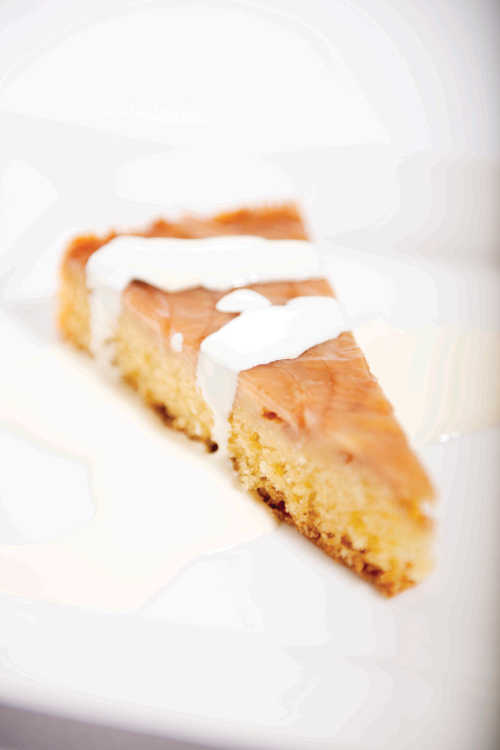 DESSERT: Armagh Bramley Apple Upside down Cake
DESSERT: Armagh Bramley Apple Upside down Cake
Recipe supplied by: Yellow Door Deli
Ingredients:
400g butter
400g self raising flour
750g sugar
4 whole free range eggs
1 large red eating apple
1 large Bramley cooking apple
Caramel sauce:
250g caster sugar
50g water
60g butter
120ml cream
Method
1. Butter and line a 10” /25cm cake ring.
2. Cut the eating apple in half down the centre then thinly slice in half moon shapes, place decoratively on the base of a 10” cake ring.
3. Stew the cooking apple and add 100g sugar to sweeten, and place a layer on top of the eating apples, pour the caramel sauce on and even out.
4. Cream the butter and remaining sugar until light and fluffy, add in the eggs and flour in two lots, mix well until combined.
5. Place the sponge mix on top of the apple and caramel and bake in the oven at 165?C for 30 to 35 minutes.
6. When cooked pour a splash of Bramley apple juice over the sponge and turn out onto a plate.
7. Can be served hot or cold but best served straight away with a homemade vanilla ice cream.
For the caramel sauce:
Heat 250g sugar and 50ml water in a heavy saucepan to 135?C (dark caramel colour), add 60g butter and 120ml cream and combine, whisk vigorously and set aside.
Cookery Feature - Fantastic Farm Food

 Georgina Campbell
Georgina Campbell
I have long been an admirer of the Ferguson family and have often cited their West Cork farm, Gubbeen, as a shining example of sustainable farming and quality food production in Ireland.
And now we have Giana Ferguson’s wonderful book, inviting us in to this extraordinary family home and its related businesses - the farm, run by Giana’s husband Tom and now in its sixth generation of family stewardship; the dairy, where Giana’s famous Gubbeen cheeses are made; the smokehouse, where their son Fingal produces all kinds of good things including his superb range of salamis; and the biodynamically worked acre of kitchen garden, where their daughter Clovisse produces beautiful vegetables, salads and herbs for restaurants, markets and lunches that she prepares for group visits to the farm.
In Giana’s own words: “Our formula is simple: the grass grows to feed the herd, their milk comes into the dairy where we make the cheese, and the by-product, the whey, is fed to the pigs that provide the meat for our son Fingal’s charcuterie.
Clovisse, our daughter, has been the gardener and herb grower…and is now a cook and developer of food products from our farm…How this family works and how Gubbeen manages to produce foods that are now finding their way all over the world is a fun, if rather exhausting, story. It starts in the land the Fergusons have worked for several hundred years and is the excuse for these pages, these recipes and these ideas that Tom, Fingal, Clovisse and I have developed.”
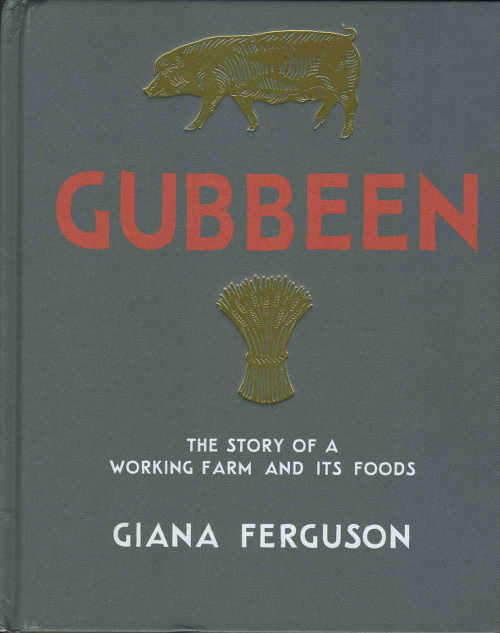 The book has clearly been a labour of love for Giana - and also for Tom, Fingal and Clovisse, who all make enormously enjoyable and insightful contributions. Tom’s chapter on Farming Gubbeen has a particular resonance for me, bringing back vivid childhood memories of a remarkably similar farm and way of life in Cornwall - we even had ‘our’ lighthouse, Godrevy in St Ives Bay, just as they have the Fastnet. I admire his steadfast belief in stewardship, resistance to dependence on new global markets, and the brave decision taken by the couple to farm for food, not commodities - which, thanks to their vision, hard work and creativity, has become such a well earned success and provided a viable way of life for generations to come.
The book has clearly been a labour of love for Giana - and also for Tom, Fingal and Clovisse, who all make enormously enjoyable and insightful contributions. Tom’s chapter on Farming Gubbeen has a particular resonance for me, bringing back vivid childhood memories of a remarkably similar farm and way of life in Cornwall - we even had ‘our’ lighthouse, Godrevy in St Ives Bay, just as they have the Fastnet. I admire his steadfast belief in stewardship, resistance to dependence on new global markets, and the brave decision taken by the couple to farm for food, not commodities - which, thanks to their vision, hard work and creativity, has become such a well earned success and provided a viable way of life for generations to come.
And then there are the recipes, which are also a true expression of their philosophy and way of life. Unlike so many others, each of the Gubbeen recipes has an original and deliciously meaningful contribution to make to our enjoyment and knowledge of food.
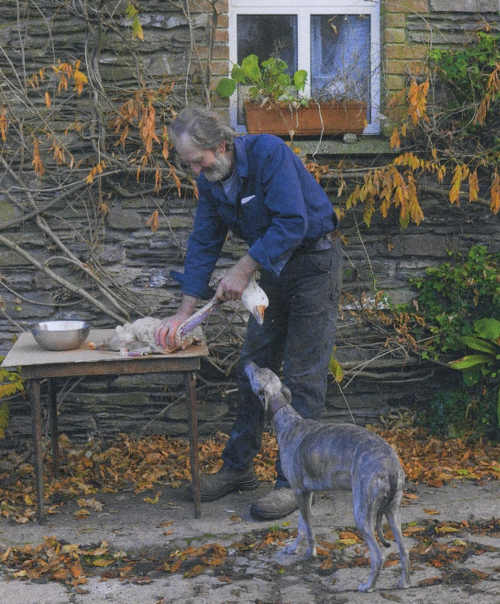 The selection below is especially relevant for the Christmas period - the goose would make a wonderful alternative festive meal for a smaller family; the Gubbeen cheese & chorizo potato cake with wilted chard is the perfect wholesome dish for a busy day - and the onion soup would be just the business when you’re fed up with fancy food (New Year, perhaps).
The selection below is especially relevant for the Christmas period - the goose would make a wonderful alternative festive meal for a smaller family; the Gubbeen cheese & chorizo potato cake with wilted chard is the perfect wholesome dish for a busy day - and the onion soup would be just the business when you’re fed up with fancy food (New Year, perhaps).
I love the simple variation from tradition - breaking up the bread topping so you don’t have a great big unmanageable layer of cheesy bread to fight through, before reaching the soup. Simply gorgeous, and so nourishing too.
I can’t commend this groundbreaking book highly enough. Visionary, inspiring and practical, there should be a copy in every school in the country - and, in every home where good food matters, it should take pride of place on the kitchen bookshelf.
Gubbeen, The Story of a Working Farm and Its Foods by Giana Ferguson, photography by Andy Sewell (Kyle Books, hard back €25)
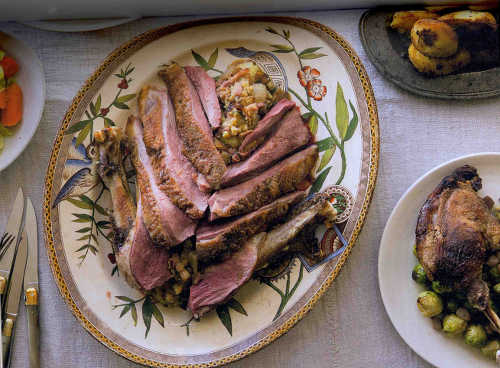 RECIPES: Roast Crown of Goose
RECIPES: Roast Crown of Goose
Goose will always be a celebration dish - the bird itself is large and its meat is very rich, so it lends itself to feeding a big table full of family.
The reason for removing the legs is that they always overcook and dry out; here you have the perfectly roasted breast and you can use the legs to make a delicious confit another day. Use the stuffing given below.
SERVES 5-6
Equipment: Digital temperature probe
1 crown of goose (about 4kg)
Salt
First prepare the Goose Stuffing (see below), and use to fill the goose cavity.
Preheat the oven to 110°C/gas mark ¼
Prick the goose skin all over with a needle. Sprinkle salt over the skin and rub it in. Place the goose, skin-side down, in a large frying pan or roasting tray and start to render the fat by cooking over a low to medium heat.
The goose will start to cook in its own fat, but if the heat is too high this won't happen and the skin will burn. You're looking for an even golden colour all over, so do move the bird around the pan to achieve this.
Place the browned crown on a rack in a roasting tin and transfer to the oven. Roast for up to 2 hours before probing with the thermometer. How long the goose will take to cook depends on the performance of each individual oven, the weight of your bird and what temperature the crown is when it goes into the oven - a digital temperature probe is essential for this method.
Probe the breast at its fattest point, stopping when you think you've reached the middle spot between the bone and the skin. If you estimate the breast is 4cm at its fattest aim to take the reading from a depth of 2cm. If the probe reads 55-56°G, it's ready. At this point remove the bird from the oven, cover and allow to rest for at least 15 minutes before carving.
Serve with Brussels sprouts and Proper Roast Potatoes.
Goose Stuffing
This is a traditional West Cork stuffing for the Christmas goose. It really complements goose as the potatoes soak up some of the wonderful fat from this rich bird. It is simple and, like many great simple dishes, it is authentic. The sage and thyme travel through the potatoes and lift the whole roast to another level.
SERVES 8
450g floury potatoes, cut into even-sized pieces
1 tablespoon olive oil
2 onions, chopped
Large bunch of fresh sage
6-8 sprigs of fresh thyme
Salt and freshly ground black pepper
Par-boil the potatoes for 10 minutes, then drain.
Meanwhile, heat the olive oil in a large pan and sauté the onions until transparent, not browned. Chop some of the sage leaves and add to the pan (keep the rest of bunch as it goes into the
cavity). Season the goose cavity.
Chop the potatoes, which should still be firm, until semi-mashed, and mix in the onions and chopped sage. Season well. Push the remainder of the bunch of sage and the thyme to the back of the goose cavity. Put in the potato stuffing, leaving a good amount of air space at the top of the cavity, which acts like an oven, while the stuffing is a sort of sponge for the goose juices
and some of its lovely fat too.
 Onion Soup
Onion Soup
There is a reason why onion soup is a classic: it has a perfect flavour and it is extremely nourishing. Our addition to this lovely dish is to break the bread croutons into nice random pieces, rather than cut slices, and have lots of runny Gubbeen cheese rolling off them, which makes this very good indeed.
To get the best results from this dish use a cast-iron pan with a lid such as a Le Creuset casserole.
SERVES 4
50g unsalted butter
6 large onions, thinly sliced
1 teaspoon sea salt
1 tablespoon Mushroom Ketchup (see page 39) or sherry vinegar
1 litre beef or chicken stock
100ml brandy - more if you're in the mood
For the croutons
Handful of day-old bread, torn into bite-sized pieces
1 teaspoon mild olive oil
80g Gubbeen cheese, sliced
Preheat the oven to 200°G/gas mark 6.
Set your pan over a low heat. Heat the butter until it starts to bubble, add the onions and the salt, cover with the lid and gently steam. Remove the lid when the onions are tender and increase the heat gradually to medium, stirring until the onions turn a pleasing brown colour.
Add the Mushroom Ketchup (or sherry vinegar), pour in the stock a little at a time and work any caramelised bits from the base of the pan into the soup.
To make the croutons, toss the bread in the olive oil to coat very lightly and bake in the oven on a tray lined with parchment paper until golden. Place the cheese on top of the croutons for a minute or two until just melted.
Stir the brandy into the soup and check the seasoning. Scoop the cheesy croutons on top of the soup, and serve in the pot from the middle of the table.
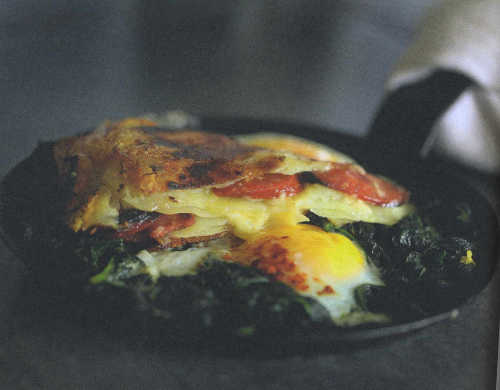 Gubbeen Cheese & Chorizo Potato Cake with Wilted Chard
Gubbeen Cheese & Chorizo Potato Cake with Wilted Chard
Having a wonderful café so near us in Durrus is a blessing. Carmel Somers is a genuine menu genius; she has a huge knowledge of flavours and comes up with natural and delicious combinations, which makes a trip to The Good Things Café such a treat; it's an education each time we go. Carmel uses sea cabbage, which grows on the strand in front of her cafe, but we always use chard.
SERVES 2
Splash of olive oil, plus extra for frying
Knob of butter
500g peeled potatoes
l00g smoked Gubbeen cheese, grated
l00g Gubbeen chorizo, sliced
2 big handfuls of chard
4 free-range eggs
Salt and freshly ground black pepper
Preheat the oven to 200°C/gas mark 6.
Heat a 20cm ovenproof frying pan on a medium heat, then melt together a good splash of oil and a knob of butter, coating the bottom and the sides of the pan with the mixture. Pour off any excess fat and keep in a bowl until later.
Lower the heat and start slicing the potatoes - they need to be very thin, but not so thin that you don't get a complete slice.
Layer the potatoes in the pan in a clockwise direction, starting from the outside and working your way into the middle, making sure you are spreading them evenly leaving no gaps. Season with salt and pepper about every third layer,
When you have layered half the potato, top with the cheese and chorizo, then continue layering the potatoes. You want to finish with a nice thick cake, so there is a contrast of crisp and soft potato. Add another potato if you think it's needed!
Brush the top with the reserved oil mixture, place in the middle of the oven and bake for 20-30 minutes until the potatoes are soft when tested with a knife.
If the top of the cake is not nice and brown, flip the cake out onto a plate or chopping board, slide back, topside down, into the pan and either return to the oven or cook on the hob on a medium heat for a few minutes.
In the meantime, cook the chard in boiling water and drain well. Heat some olive oil in a frying pan and fry the eggs.
Turn out the cake onto a plate or chopping board, cut into wedges and serve with the chard and fried eggs.
Georgina Campbell's Cookery Feature - Darina Allen's Simply Delicious Christmas
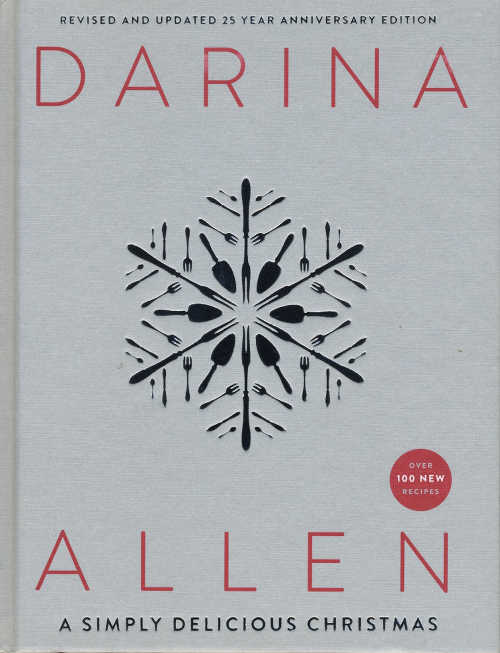
 Twenty five years on and the original recipes in Darina Allen’s A Simply Delicious Christmas (Gill & Macmillan, hardback €27.99) still seem as fresh and relevant as ever, but this handsome celebratory edition also includes over a hundred new recipes and many of these are a gentle seasonal reflection of our changing tastes in food.
Twenty five years on and the original recipes in Darina Allen’s A Simply Delicious Christmas (Gill & Macmillan, hardback €27.99) still seem as fresh and relevant as ever, but this handsome celebratory edition also includes over a hundred new recipes and many of these are a gentle seasonal reflection of our changing tastes in food.
All the old favourites that we don’t want to mess with are there, but the difference in this edition is the huge amount of choice. There must be ten ways of cooking turkey, for example, and I’m especially taken with ‘Christmas Dinner on a Dish’, which serves about 30 and seems to be the perfect solution to the age old problem where the cook never gets to enjoy the party, especially as it can even be prepared a week ahead and frozen.
There are plenty of alternative roasts and a terrific range of vegetables and salads. Just thinking about the traditional feast makes me long for light, juicy, colourful dishes and here they are.
You’ll find super starters like salads of Ruby grapefruit, pomegranate and shredded mint, or Watercress, blood orange and Toonsbridge mozzarella, for example and a beautiful Gravlax with cucumber ribbons and mustard and dill mayonnaise.
And, along with traditional puddings, mince pies and trifles to beat the band, there are soothing, refreshing desserts like frosted tangerines, intriguing Turkish delight and rosewater ice cream and a big soothing bowl of Christmas fruit salad.
Then there are edible gifts, traditional sweetmeats and ideas for every possible eventuality on the day and throughout the festive holiday. Younger readers accustomed to expecting an image with every recipe may be surprised that so many do not have photos - just as well as it’s already a big book, running to 362 pages, but in any case the recipes are very clear and reading them without visual prompts activates the imagination, which is always fun.
The recipes given below could make a lovely alternative Christmas dinner for a small adult group who don’t want to take the traditional turkey route, and quantities would easily scale up to feed eight.
RECIPES
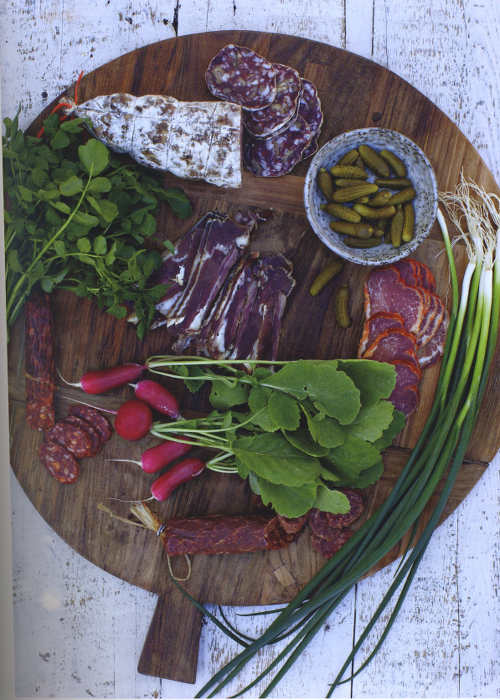 A Plate of Irish Charcuterie and Cured Meats
A Plate of Irish Charcuterie and Cured Meats
One of my favourite easy entertaining tricks is to serve a selection of Irish artisan charcuterie from inspired producers like Fingal Ferguson from Schull, West Cork, James McGeough from Oughterard, Co. Galway, Jack McCarthy from Kanturk, Co. Cork, Patrick Mulcahy from Ballinwillin, Mitchelstown, Co. Cork, and Matthew Conroy from Woodside Farm, Leamlara, Co. Cork. The quality is so wonderful that I'm always bursting with pride as I serve it.
A selection of cured meats:
air-dried smoked Connemara lamb
smoked venison
Gubbeen prosciutto and chorizo
Woodside Farm salami and chorizo
Dunmanus Castle beef salami
pepper and caraway salami
Three Castle pastrami
West Cork kassler
brawn
A selection of:
crusty country breads, sourdough bread, yeast bread and Irish soda bread
tiny gherkins or cornichons
fresh radishes, just trimmed but with some green leaf attached
a good green salad of garden lettuce and salad leaves
Arrange the meats, potted meats and the accompaniments on a large platter, open a good bottle of red and tuck in!
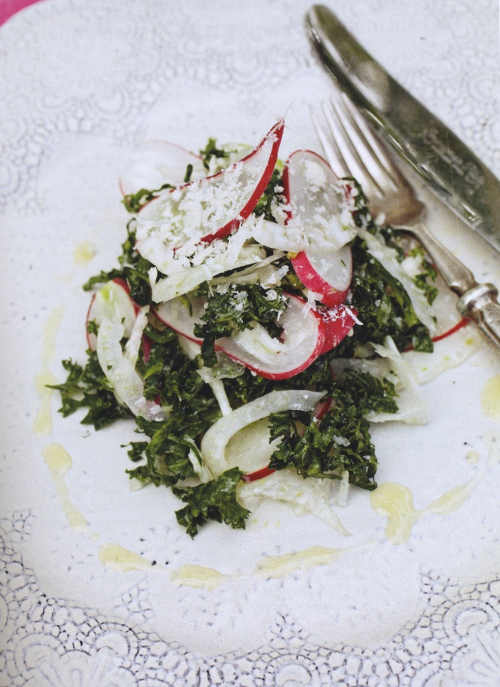 Kale, Fennel, Radish and Parmesan Salad
Kale, Fennel, Radish and Parmesan Salad
So delicious and fresh tasting - the perfect salad for the festive season.
110g (4oz) fennel, thinly sliced
8 radishes (preferably French Breakfast), thinly sliced at
a long angle
150g (5oz) green curly kale, stalks included
3 tablespoons extra virgin olive oil
1 tablespoon lemon juice
4 tablespoons grated Parmesan cheese
salt and freshly ground pepper
Serves 4 as a starter
Keep the sliced fennel and radishes in iced water for at least 5 minutes. Drain well. Remove the stalks from the kale and shred the leaves very finely (discard the stalk).
Put the kale, drained fennel and radishes into a bowl. Drizzle with the extra virgin olive oil and lemon juice. Grate on some Parmesan with a slivery microplane. Season with salt and freshly ground pepper. Toss, taste and serve.
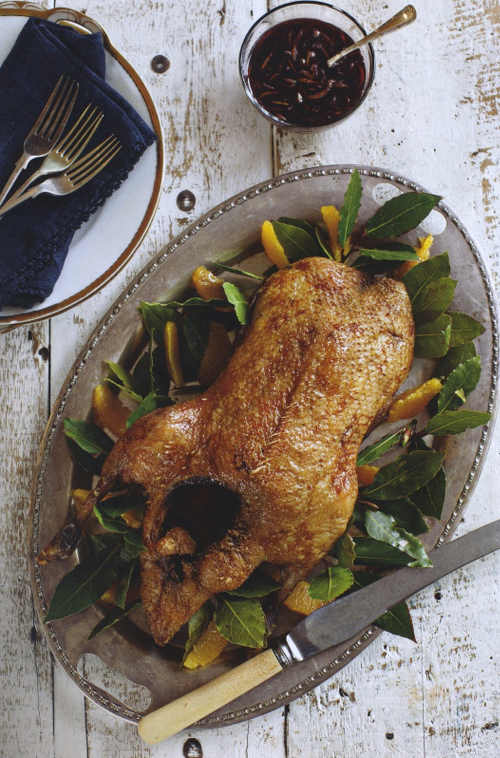 Roast Duck with Orange
Roast Duck with Orange
Labour intensive and expensive, but well worth the effort. This is Rory O'Connell's version of the classic duck with orange
3 brightly coloured organic oranges
1 x 1.8kg (4lb) free-range duck
salt and freshly ground pepper
Sauce
3 tablespoons granulated sugar
70ml (2½ fl oz) red wine vinegar
300ml (½ pint) chicken or duck stock
110ml (4 fl oz) port
70ml (2½ fl oz) red wine
½-1 tablespoon Grand Marnier
a few drops of lemon juice
Garnish
sprigs of watercress or parsley
Serves 4
Preheat the oven to 220°C/425°F/gas mark 7.
Scrub the oranges. Peel the zest from 2 oranges with a swivel top peeler and cut two-thirds into fine julienne strips. Blanch and refresh, (save the skinless oranges.)
Season the duck cavity and the skin with salt and freshly ground pepper. Put the remaining one-third of the orange peel into the cavity and transfer the duck to the hot oven.
Cook for 30 minutes, then reduce the temperature to 180°C/350°F/gas mark 4. Continue to roast for a farther 30-45 minutes. Pour off the duck fat and save for roast potatoes.
While the duck is roasting, make a sweet and sour caramel. Boil the sugar and vinegar over a moderately high heat for several minutes, until the mixture has turned into a rich chestnut brown-coloured syrup. Remove from the heat immediately and pour in 150ml (¼ pint) of the stock.
Simmer for a minute, stirring to dissolve the caramel, then add the rest of the stock, port, wine and the juice of 1 orange. Simmer until the sauce is clear and lightly thickened, then add the orange liqueur little by little. Add the orange julienne.
Taste, correct the seasoning and sharpen with lemon juice if necessary. Leave aside. The sauce may be prepared to this point several hours in advance. Cut the 2 remaining oranges into neat skinless segments and reserve for garnishing the duck.
When the duck is cooked, allow it to rest in a warm oven for at least 10 minutes before carving. Carve neatly and arrange on a serving dish or individual plates. Garnish with the orange segments.
Spoon some of the sauce over the duck and serve the rest separately in a sauce boat. Garnish with sprigs of watercress or parsley.
 Bramley Apple Snow
Bramley Apple Snow
This is a simple old-fashioned pudding that we absolutely love. It's great with shortbread biscuits or even ladyfingers. It seems particularly appropriate around Christmas.
Serves 6
450g (llb) Bramley's Seedling cooking apples
50g (2oz) approx. sugar
1-2 dessertspoons wafer
1 egg whites, preferably free-range and organic
To serve
Jersey cream
soft brown sugar
shortbread biscuits or ladyfingers (boudoir biscuits)
Peel and core the apples, cut into chunks and put into a saucepan.
Add the sugar and water, cover and cook on a gentle heat, stirring every now and then, until the apples dissolve into a fluff. Rub through a nylon sieve or liquidise. Bramley apples can be very sour at the beginning of the season, so taste and add a little more sugar if it seems too tart.
Whisk the egg whites until stiffly whipped, then fold in gently.
Pour into a pretty glass bowl, pop into the refrigerator and serve well chilled with cream, soft brown sugar and shortbread or ladyfingers.
NOTE: The egg yolks may be used for homemade lemon curd.
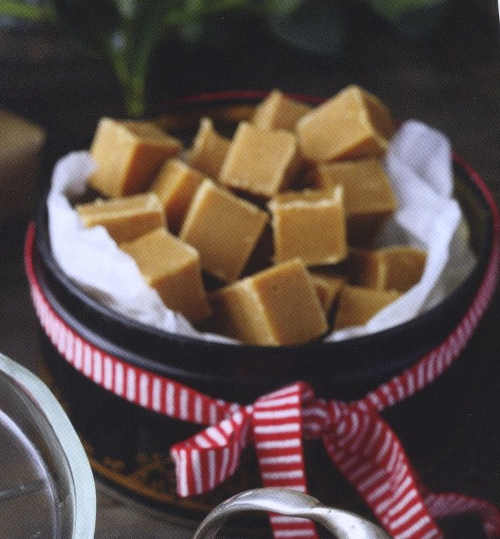 Ballymaloe Fudge
Ballymaloe Fudge
Every time I eat a piece of Fudge, I remember Ivan Alien, my father-in-law - he loved fudge.
225g (8oz) butter
700g (1½ lb) caster sugar
1 x 410g (l4oz) can evaporated milk
200ml (7fl oz) water
1 teaspoon pure vanilla extract
Makes 96 pieces
Melt the butter in a heavy-bottomed saucepan over a low heat. Add the sugar, evaporated milk, water and vanilla extract and stir with a whisk until the sugar is dissolved. Turn up the heat to a simmer and stir constantly until it reaches the soft ball stage - 113°C (235 °F) - which will take approx. 45 minutes.
To test, put some of the fudge in a bowl of cold water - it's ready when a smooth, soft ball forms. When it's ready, pull it off the heat. Stir vigorously until it thickens and reaches the required
consistency: thick and sandy.
Sit the base of the saucepan into a sink of cold water to stop the cooking. Line a 23cm x 33cm (9in x 13in)
Swiss roll tin with parchment or silicone paper and pour in the fudge mixture. Smooth the surface with a spatula. Allow to cool and then cut into squares before it gets completely cold.
Eunice Power - Alternative Christmas Cakes

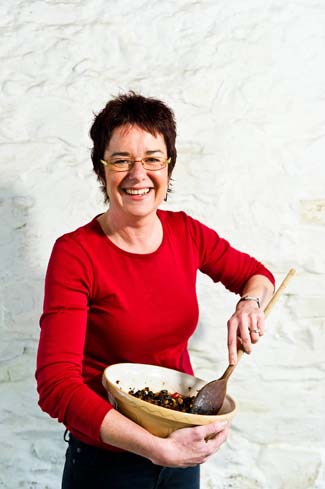 I am really fond of making Christmas cakes and look forward to making them each year. There is something immensely comforting about the aroma of warm spices in the kitchen while the cake is baking. I have lovely childhood memories of helping my mum decorate the Christmas cake.
I am really fond of making Christmas cakes and look forward to making them each year. There is something immensely comforting about the aroma of warm spices in the kitchen while the cake is baking. I have lovely childhood memories of helping my mum decorate the Christmas cake.
Steeped in such yuletide nostalgia, I recently asked my eldest son (14) if he had any special memories of Christmas baking and food, involving me, needless to say. He thought for a while and replied “Nah!” I am hoping his response says more about the modern teenager than my merit as a mother.
Could it be that I have over-exposed my children to the whole ritual and rarity of preparing seasonal food, causing their memories of that warm fuzziness to blank? And when is it too late to start manufacturing memories for one’s children? All these questions are playing on my mind as I frantically type!
Personally I love traditional Christmas cake but not everybody feels the same about it. My children favour chocolate cake – even though they don’t seem to remember the art of making or decorating it!
How you decide to decorate your Christmas cake makes all the difference between something ordinary and a festive, show-stopping spectacle. I recently saw a cake which had battery operated LED lights embedded in the icing – the mind boggles. For the purists among you, my traditional Christmas cake recipe is available on www.irishtimes.com
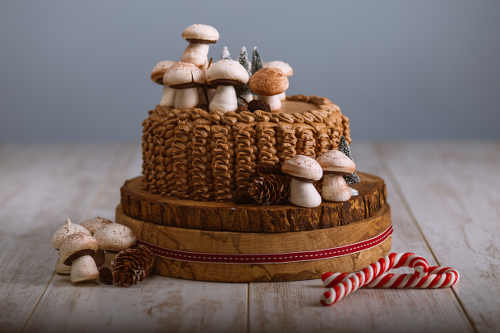 Chocolate Fudge Cake
Chocolate Fudge Cake
I am often asked for a foolproof chocolate recipe and here it is. This ticks all the boxes - moist, great flavour, and easy to make.
For the cake
2oz/50g cocoa powder
4oz/110g butter
4floz/110ml oil
8floz/225ml water
12oz/350g sugar
8oz/225g self-raising flour
2 eggs
4 floz/110ml milk
½ teaspoon bread soda
Chocolate Swiss Meringue
9 egg whites
600g granulated sugar
600g butter, softened but cool
1 teaspoon vanilla extract
330g melted chocolate (I use 55% cocoa)
Preheat the oven to 150C/300F/Gas Mark 2
Grease and line an 8inch/20cm cake tin with parchment paper.
Put the cocoa, butter, oil and water into a wide saucepan and bring it to the boil.
Remove from the heat and then stir in the sugar and flour. Beat together the eggs with the milk and bread soda and then add this mixture to the saucepan.
Pour this into the prepared cake tin and bake for 1¼ hours
Allow the cake to cool and then turn it out onto a wire tray and allow to cool for a few hours
Meanwhile make the Swiss meringue...
Place the egg whites and sugar in a large metal or glass bowl. Set the bowl over a pot of simmering water, and whisk, continuously, until the sugar has completely dissolved and the mixture looks opaque.
Remove the bowl from the heat, add vanilla extract, and whip on high speed until completely cooled.
Whip in the butter, a tablespoon at a time, until thick and fluffy. If it begins to look curdled, continue to whip until it comes back together, before adding in remaining butter.
Fold in the melted chocolate.
If the egg whites and/or the butter are slightly too warm, the buttercream may not thicken properly. This can be easily remedied by placing it in the refrigerator for 20-30 minutes, then whipping.
To assemble
Divide the cake into three evenly sized layers. Line an 8 inch tin with cling film, place one layer of cake in the bottom of the tin, spread a thick layer of the icing over this layer, put the second layer of cake on top and repeat with the icing, and put the final layer on top of this. Cover with the cling film and pop into the fridge for 30 minutes to set.
Remove from the fridge, take out of the tin and remove the cling film. Cover the cake with a thin coating of icing then using a ruffle nozzle, pipe the icing on the sides of the cake.
Once the cake is decorated put in the fridge for 3 minutes or so to set.
Decorate with Meringue mushrooms. This cake will keep for at least a week.
Meringue mushrooms
These are a cinch to make.
Makes 12
2 large egg whites – older ones are better
150g castor sugar
Teaspoon of cocoa powder
100g plain chocolate
Pre heat the oven to 130ºC. Line two baking sheets with parchment paper and set aside.
In a clean dry bowl, preferable stainless steel or glass, whisk the egg whites and sugar together at full speed until the mixture forms stiff dry peaks – this will take 8-10 minutes.
Put a round nozzle about 10mm wide on a piping bag and fill the bag with the meringue mixture. For the stems, press out a tiny bit of meringue onto one of the trays, then pull the bag straight up. Do not worry about making all of the pieces exactly the same. The mushrooms will look more natural if the pieces are different sizes.
To pipe the mushroom caps: squeeze out round mounds of meringue onto the other baking tray. Pull the bag off to the side to avoid making peaks on the top. Place the cocoa powder in a fine-mesh sieve and lightly dust it over the stems and caps then blow on the cocoa powder vigorously to blur it and give the mushrooms a realistic look. Bake for 1 hour and then turn off the oven, allowing the meringues to cool in the oven.
When cooled the stems are attached to the caps using a little melted chocolate to 'glue' them together. The stems may need to be trimmed so use a sharp knife to cut the tip off each stem to create a flat surface.
Photography: Shane O Neill www.aspectphotography.net
Food Styling: Leona Humphreys www.onefineplate.com
------------
More recipes from Eunice Power are available on www.eunicepower.com
Room reservations can be made on www.powersfield.com - hope to see you in Dungarvan during the year.
------------
 Eunice Power is a professional chef with over twenty years experience in the hospitality business. She runs Powersfield House in Dungarvan County Waterford, which is our B&B of the Year for 2012 and also the winner of the Best B&B Breakfast. Her philosophy is to use fresh, seasonal, locally produced food, sourced organically where possible.
Eunice Power is a professional chef with over twenty years experience in the hospitality business. She runs Powersfield House in Dungarvan County Waterford, which is our B&B of the Year for 2012 and also the winner of the Best B&B Breakfast. Her philosophy is to use fresh, seasonal, locally produced food, sourced organically where possible.
Eunice has a successful outside catering company, writes about food (she is the author of an excellent cookery book written for local company Waterford Stanley) and teaches at Paul Flynn’s Tannery Cooking School, where her enthusiasm and zest for a life filled with good food are given free rein."
Georgina Campbell's Cookery Feature - Let's Hear It For The Spud
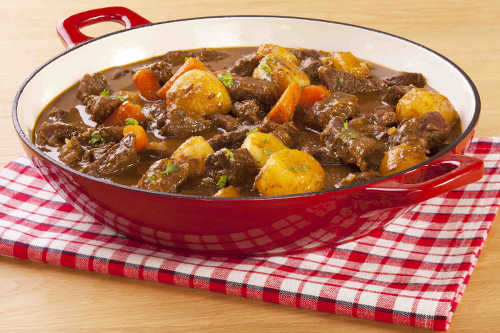
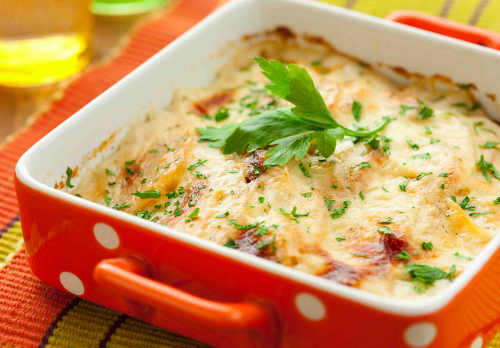 What could be more comforting in the cold, dark days of late winter than hearty dishes based on the nation’s favourite vegetable, the spud. Or any dish with a lovely big, steaming baked potato on the side? Okay, strictly speaking it’s a tuber rather than a vegetable, but we all think of it and cook it like a vegetable.
What could be more comforting in the cold, dark days of late winter than hearty dishes based on the nation’s favourite vegetable, the spud. Or any dish with a lovely big, steaming baked potato on the side? Okay, strictly speaking it’s a tuber rather than a vegetable, but we all think of it and cook it like a vegetable.
It’s so much a part of Irish life that it’s strange to think we all went on a bit of a wobbler a few years ago, forgetting our loyalty to the spud in our enthusiasm for international flavours and the convenience of rice and pasta. But, much as well all enjoy a wider variety of foods and flavours now, we have come around to according the potato more respect once again.
Concerned potato growers should take a bow for this, especially the Keogh family of north Co Dublin who have been so active in reactivating the national love affair with the spud - and helped transform the potato from being a mere commodity to a valued product. They instigated the first National Potato Day, in 2012 - including a call to have the potato named our National Vegetable - and, supported by Bord Bia, this is now an annual event including farm visits, tastings and competitions run by the Irish Potato Federation (est 1973), of which Keoghs are among the twelve members.
And, according to Bord Bia, not only do nearly all Irish households buy potatoes (96.6% in 2014, or 1.6 million households) but it’s not just traditional potato dishes that are finding favour with the public: www.potato.ie has details of the nation’s ‘Magnificent Seven’, a list of the seven most downloaded potato dishes from the site. Much-loved traditional potato recipes enjoyed by generations of Irish people are featured alongside easy-to-prepare contemporary and international dishes, including Lebanese spiced potatoes and potato and onion pakoras.
Here are a few of the more traditional potato dishes from the ‘Magnificent Seven’ - they will cheer the chilliest day.
 Rich and Hearty Beef & Potato Stew
Rich and Hearty Beef & Potato Stew
Preparation time: 20 minutes
Cooking Time: 2 hours
Serves: 4
Ingredients
1 tablespoon olive oil
2 tablespoon plain flour
1kg beef cut into 4cm chunks
Salt & pepper to taste
30g unsalted butter
2 medium onions diced
750g potatoes, peeled and cut into chunks
2 carrots, diced
150g turnip, peeled & diced
500ml beef stock
500ml red wine
2 sprigs of thyme
2 cloves of garlic, crushed
1 bay leaf
Method
In a large ovenproof dish, heat a tablespoon of the olive oil.
Place the flour in a shallow bowl. Season the beef with salt and pepper dip in the flour, shaking off any excess.
Add half the meat to the casserole dish and cook over a medium high heat until brown, turning until chunks are sealed.
Transfer the meat to a bowl and repeat the process using the remaining tablespoon of oil.
Remove the meat and melt the butter in the casserole dish. Add the onions, potatoes, carrots and turnip and cook over a low heat, stirring occasionally, until the onion is softened.
Add the wine and bring to a boil, stirring to remove any sticky pieces on the bottom of the casserole dish. Pour in the stock and bring to a boil. Re-add the browned meat and juices along with the thyme, garlic and bay leaf. Cover and simmer over a low heat until the meat is tender, about 1½–2 hours.
Remove the lid for about 15- 20 minutes towards the end and turn up the heat slightly to allow to simmer if you feel the sauce needs to reduce and thicken.
Remove thyme and bay leaf before serving in a bowl. Best eaten with a spoon.
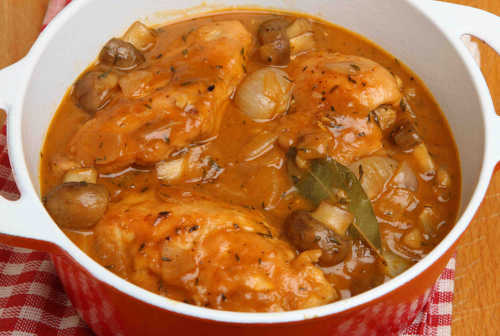 Chicken Chasseur & Mashed Potatoes
Chicken Chasseur & Mashed Potatoes
Preparation time: 30 minutes
Cooking Time: 1 hour
Serves: 4
Ingredients
For the chicken
salt and freshly ground pepper to taste
50g plain flour
2 tbsp olive/vegetable oil
1.5kg chicken (approx four breasts or 8 thigh/leg pieces)
110g butter
175g small/button mushrooms
150g shallots quartered (or onions)
40g castor sugar
175ml dry white wine
350ml chicken stock
3 tbsp tomato purée
small handful fresh tarragon chopped
2 tomatoes, peeled & chopped
2 tbsp fresh parsley finely chopped
For the mashed potatoes:
1kg potatoes peeled, cut into chunks
110g butter
110ml milk
salt and freshly ground pepper to season
Method
Season the chicken with salt & pepper and coat with flour
Fry the chicken pieces skin-side down in olive oil for 1-2 minutes until golden-brown, then turn and fry on the other side.
Heat another frying pan over a medium heat and add half the butter. When the butter is bubbling add the button mushrooms and fry until golden. Add them to the chicken, which should be in a deeper pan/casserole dish.
Add the remaining butter to the pan used to fry the mushrooms then add the shallots/onions and the caster sugar and fry for 2-3 minutes until the shallots/onions are cooked and caramelised.
Add the wine and bring to the boil.
Pour this mixture over the chicken, then add the stock, tomato purée and tarragon. Bring to the boil, then reduce the heat to simmer for 45 minutes to one hour, or until the chicken is completely cooked through and the sauce has reduced and thickened slightly.
Add the tomatoes, flatleaf parsley and more chopped tarragon and season, to taste, with salt and freshly ground black pepper.
To serve, place two pieces of chicken or a whole breast onto each plate. Pour more sauce over chicken and serve with delicious mashed potatoes.
 Potato & Turnip Gratin
Potato & Turnip Gratin
Preparation time: 25 minutes
Cooking Time: 45 minutes
Serves: 4-6
Ingredients
300ml milk
350ml double cream
6/8 sprigs thyme/rosemary, or mixture of both
Black pepper
350g turnips
350g potatoes
Salt
Butter
100g cheese, gruyere style or other hard cheese of your choice
Method
Pour the milk and cream into a saucepan and add thyme/rosemary and some black pepper. Bring to just under the boil and then remove from the heat. Leave aside for around half an hour. Strain through a fine sieve and discard the herbs.
Slice the peeled turnips and potatoes into rounds, not too thin, and par boil for about 4 minutes. Pat dry.
Butter a casserole dish and arrange the vegetable slices in an overlapping fashion in the baking dish, alternating them and seasoning with salt and pepper as you go to taste.
Add a little butter as you go along. Pour the cream over the top (it should almost cover the vegetables). More cream can be added if necessary. Pat down and sprinkle the grated cheese on top.
Bake in the oven at 180C (160C Fan assisted oven) until the vegetables are tender, about 40 minutes.
Georgina Campbell's Cookery Feature - Passionate About Pork
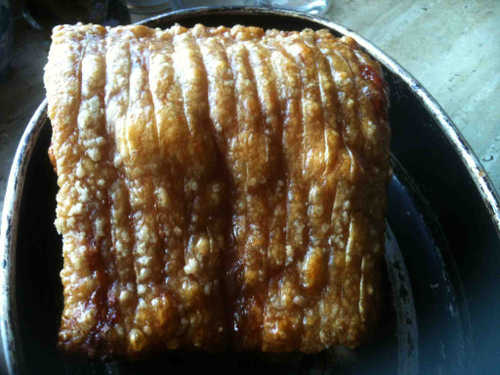
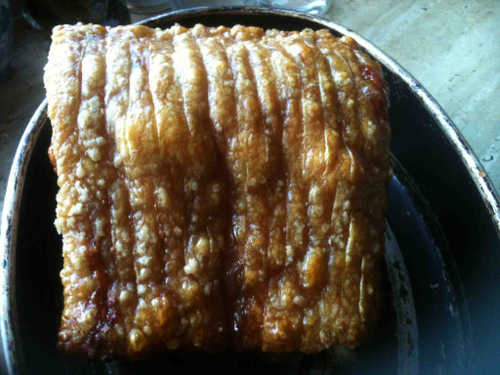 Pork is one of our most traditional and most versatile foods and, while the introduction of refrigeration made a big change to attitudes as fresh pork was no longer seen as being ’just for winter’, there is something wonderfully comforting about it and many of the great pork dishes seem to have a secret ingredient that brings warmth to the chilliest of days.
Pork is one of our most traditional and most versatile foods and, while the introduction of refrigeration made a big change to attitudes as fresh pork was no longer seen as being ’just for winter’, there is something wonderfully comforting about it and many of the great pork dishes seem to have a secret ingredient that brings warmth to the chilliest of days.
In the old days, every home cook knew that pork couldn’t be beaten for ease of preparation, taste and versatility and a recent Bord Bia Quality Assured pork campaign has highlighted just that, with the introduction of a new range of pork recipes for everyday and weekend meals on the Bord Bia website.
Interestingly, although ‘more contemporary cooking methods’ have broadened the appeal of this timeless meat, their research also shows that traditional cooking methods and recipes such as roast pork with apple sauce (66%) and pork in marinade (63%) are still top choices for Irish consumers when it comes to preparing pork dishes.
The most popular pork cuts with Irish consumers are pork chops (44% of sales), pork joints (22% of sales) and pork steak (18% of sales) and 59% of those surveyed eat pork at least once a week. 82% also stated that it is important to them that products carry the Bord Bia Quality Assurance mark so that they know their food has been produced to Bord Bia quality standards and can be traced back to the farm.
For the benefit of both consumers and producers, traceability - and honest labelling - is essential for all foods, and especially for those like pork and chicken which are under threat from price wars and cheap imports, so the Quality Assured mark is a reassurance.
Buying from a butcher you trust is also important, especially as that may lead you to small production - free range and perhaps also organic - pork, which will have all the flavour of yesteryear, along with excellent cooking qualities such as the irresistible crackling that for many (myself included) is pretty much the main point of a pork roast.
Interest in small production pork is growing, with a surprising number of people going back to the old practice of ‘keeping a pig’. Many who have one or two pigs, or who are thinking of keeping them, attend the popular Pig in a Day courses run by enterprising butchers such as McCarthy’s of Kanturk (see Special Irish Foods & The People Who Produce Them for details of their courses).
It’s all part of a wider movement towards wanting to know more about where our food comes from and what happens to it before it reaches our kitchens. Hopefully, gaining a better understanding of the processes involved in producing quality food will help shoppers to see that good food cannot be produced cheaply - and that hard earned money is better spent on sustainably produced foods than at the doctors. Better to buy less of the best and enjoy it all the more.
RECIPES - a few dishes from the new Bord Bia pork recipe collection (www.bordbia.ie).
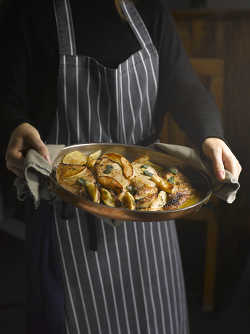 Pork with Apple and Ginger
Pork with Apple and Ginger
The apple, ginger and sage are a slight variation on traditional flavour combinations in this aromatic dish. Served with colcannon and roast vegetables, it takes about 45 minutes and makes a tasty midweek meal.
Serves 4
1 tablesp. oil
4 Quality Assured Bord Bia pork chops, well trimmed
Salt and black pepper
2 eating apples, peeled, cored and sliced
Juice of half a lemon
1 tablesp. honey
2 teasp. fresh root ginger, grated
4 sage leaves, chopped
A few knobs of butter
To Serve: Colcannon and roasted parsnips and carrots.
Preheat the oven to Gas Mark 4, 180?C (350?F).
Heat the oil in a frying pan.
Season the chops with salt and pepper and add them to the pan. Brown for 2 minutes on each side then remove from the pan to an ovenproof baking dish. Add a knob of butter to the same frying pan, add the apple slices and cook for a minute.
Mix the lemon juice, honey, ginger and sage together in a small bowl then add it to the frying pan. Simmer for a minute or two, then pour over and around the pork chops.
Cover the dish and place in the preheated oven for 40 minutes.
Serve with colcannon and roasted parsnips and carrots, which can be cooked in the oven with pork.
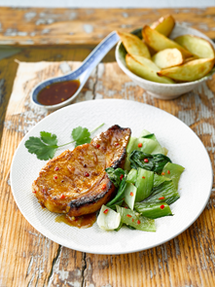 Grilled Pork Chops with Stir-fried Pak Choi
Grilled Pork Chops with Stir-fried Pak Choi
This recipe can be on the table in half an hour, making a quick and tasty family meal. The pak choi makes an ideal partner for the oriental flavours although other green vegetables could also be used, as available. Serves: 4
4 Quality Assured Bord Bia pork chops, well trimmed
Salt and freshly ground black pepper
Marinade
4 tablesp. hoisin sauce
2 tablesp. sesame oil
2 tablesp. honey
½ teasp. Chinese five spice powder
1 garlic clove, peeled and crushed
3cm piece of root ginger, finely grated
Juice of 1 lemon
½ chilli, deseeded and chopped
Stir-fry Pak Choi
4 pak choi
1 tablesp. rapeseed oil
1 garlic clove, peeled and crushed
½ chilli, deseeded and chopped
Combine all the marinade ingredients. Place the chops in a dish and pour over half of the marinade. Keep the rest to serve with the cooked chops. Allow to marinate for as long as you can but even 15 minutes would be fine.
Preheat the grill and cook the chops for 3-4 minutes on each side, depending on how thick they are.
Meanwhile heat the rapeseed oil in a wok or large frying pan. Roughly chop the pak choi leaves and stalks into strips. Add to the hot oil along with the garlic and chilli and stir-fry for 2 minutes. Season with salt and freshly ground black pepper.
Serve the chops with a little of the reserved marinade spooned over along with the stir-fried pak choi and potato wedges.
 Rack of Pork with Smoked Paprika and Sage
Rack of Pork with Smoked Paprika and Sage
Best as a weekend treat, this variation on traditional roast pork with crispy crackling and apple sauce has a bit of a twist. It’s best started the day before if possible.
Serves 8
1 x 2kg Quality Assured Bord Bia rack of pork, chine bone removed and skin scored in fine lines for easy carving
2 garlic cloves, peeled and crushed
2 tablesp. smoked paprika
2 teasp. fresh sage leaves, chopped
2 onions, roughly chopped
2 carrots, roughly chopped
2 sticks of celery, chopped
Salt and freshly ground black pepper
1 tablesp. flour
600mls stock or water
Apple and Blueberry Sauce
2 large Bramley apples, peeled, cored and chopped
100g blueberries
Knob of butter
1 tablesp. sugar
To Serve: Potatoes roasted with winter vegetables
A day ahead if possible mix together the garlic, smoked paprika and sage. Spread the mixture over the pork and set aside in the fridge overnight.
Heat the oven to Gas Mark 6, 200°C (400°F).
Place the pork in a roasting tin and season with a little salt. Put the onions, carrots and celery around the pork. This will add extra flavour and colour to the gravy.
Place the joint in the oven and allow to cook for 50 minutes per kg. After the first 15 minutes reduce the heat to Gas Mark 5, 180°C (350°F). To be absolutely accurate use a meat thermometer. The crackling should be golden and crispy at this stage.
Peel and chop potatoes and a selection of vegetables such as carrots, parsnips, white turnip and red onion. Place in a large bowl and drizzle with olive oil and season with salt and pepper. Transfer to a roasting tin, place in the oven and cook for 20-30 minutes until tender.
When the meat is cooked, remove from the oven. Transfer the meat to a chopping board, cover loosely with tin foil and allow to rest for 20 minutes. Discard the vegetables that were cooked alongside the roast
To make the Apple and Blueberry Sauce, place the apples, blueberries, butter, sugar and a tablespoon water in a small saucepan. Bring to the boil then reduce the heat and cook over a low heat for 10-15 minutes, stirring occasionally, until very soft. Taste before serving and add a little more sugar if needed.
To make the gravy: stir the flour into the juices in the roasting tin. Place over a medium heat and continue stirring with a wooden spoon. Gradually add in the stock or water and stir until it thickens.
Taste and season. Pour through a sieve into a gravy boat.
To serve, slice the pork and serve with the roasted vegetables, gravy and Apple and Blueberry Sauce.
Georgina Campbell's Cookery Feature - Provenance and Authenticity - Celebrating Ireland's finest food products
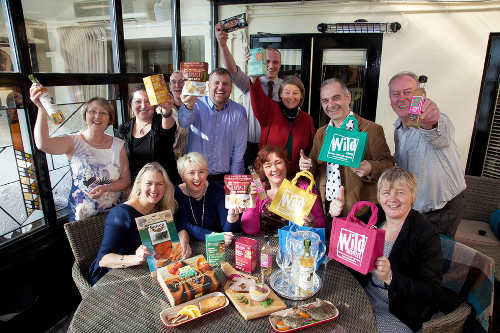
 Now in its 21st year, the annual Irish Food Writers’ Guild (IFWG) Food Awards recognise homegrown producers, organisations or individuals, whilst also celebrating the heroes who have devoted – and are continuing to devote – their lives to supporting and promoting Irish food
Now in its 21st year, the annual Irish Food Writers’ Guild (IFWG) Food Awards recognise homegrown producers, organisations or individuals, whilst also celebrating the heroes who have devoted – and are continuing to devote – their lives to supporting and promoting Irish food
Food provenance and authenticity were top of the agenda at this year’s Irish Food Writers’ Guild Food Awards, as seven food producers were honoured for the high standard and impeccable quality of their products, as well as for their unwavering dedication, devotion and commitment to quality Irish food. Special mention was also given to the producers who embraced sustainable practices and techniques.
Lizzie Gore-Grimes, Chairperson of the IFWG said, “The origin of food and drink products is becoming an increasingly important and influential factor for consumers; more and more we are seeing ‘local’ and ‘homemade’ as key factors in their decision-making process. What’s more, as the consumers’ knowledge and interest in food provenance grows, so too does the need for complete transparency on the part of the producer. The stronger the story behind the brand and the more that is known about its origin, the greater the connection between the consumer and the product.
 “All of our winners are flying the flag for food provenance this year. They come to the market with products that are real, authentic and bursting with honest-to-goodness quality. The quiet success of these seven winners is in no small part due to the richness of their produce, the strength of their story and the passion of the people behind them. What may initially have started as a labour of love for our award recipients is now reaping rewards today. All of our winners are wonderful ambassadors for Irish food, and I am certain that they will remain key players in maintaining Ireland’s enviable reputation on an international stage.”
“All of our winners are flying the flag for food provenance this year. They come to the market with products that are real, authentic and bursting with honest-to-goodness quality. The quiet success of these seven winners is in no small part due to the richness of their produce, the strength of their story and the passion of the people behind them. What may initially have started as a labour of love for our award recipients is now reaping rewards today. All of our winners are wonderful ambassadors for Irish food, and I am certain that they will remain key players in maintaining Ireland’s enviable reputation on an international stage.”
The IFWG Food Awards are considered the most prestigious of their type in Ireland and are unique in that the members of the Guild are the sole nominating and decision-making body. The Judging Process is scrupulously fair: Products (which must be produced in Ireland and the main ingredient must be Irish) are bought and paid for anonymously and a formal tasting meeting takes place where members vote, using proportional representation.
The Guild presented seven awards at an event 4th March 2015 that was attended by some of the biggest names in Irish food and hosted at the much-celebrated l’Ecrivain Restaurant, where Derry Clarke and his team created a wonderful menu to showcase the winning products and celebrate the people who make them.
The 2015 IFWG Food Award winners are: Cork’s On the Pig’s Back, Skeaghanore Farm Fresh Ducks from Ballydehob and Wexford’s Wild About Foods. A special Irish Drink Award was presented to Richmount Elderflower Cordial from Co Longford, while Foods of Athenry claimed the Guild’s Environmental Award, with the judges recognising the integrity of the production methods in their Free From product range.
Birgitta Curtin of Burren Smokehouse was honoured for her notable contribution to Irish food, while Veronica Molloy of Crossogue Preserves won the Lifetime Achievement Award for her dedication to growing on the home farm and the consistent innovation of her range of artisan Irish preserves over 40 years.
The Awards are supported by Bord Bia, which was commended by the Guild for its tireless support of the Irish food industry both in Ireland and abroad. For further information, including citations, visit www.irishfoodwritersguild.ie.
Derry Clarke’s stunning menu comprised:
• Sage Gnocchi with Wild About Nettle Pesto Cream and Garlic Purée
• The Burren Smokehouse Seaweed-Marinated Smoked Salmon and Hot-Smoked Salmon with Honey, Lemon and Dill with Wild About Ginger Beets and Pickled Cucumber
• Richmount Elderflower Granita
• On the Pig’s Back Duck and Orange Terrine, Duck Liver Paté, Foods of Athenry Wholemeal Crackers, Candied Walnut and Rhubarb
• Skeaghanore Duck Breast and Confit with Carrot and Apple
• Goat’s Cheese Mousse and Foods of Athenry Crackers, Crossogue Quince and Chilli Jelly, Glazed Fig
• Crossogue Irish Coffee Curd Mousse with Feuilletine and Gold Leaf served with Crossogue Lemon Curd Ice Cream
RECIPES, created for the Irish Food Writers’ Guild Food Awards 2015 by chef Derry Clarke of l’Ecrivain Restaurant, Baggot Street, Dublin 2.
(for full recipe collection visit www.irishfoodwritersguild.ie)
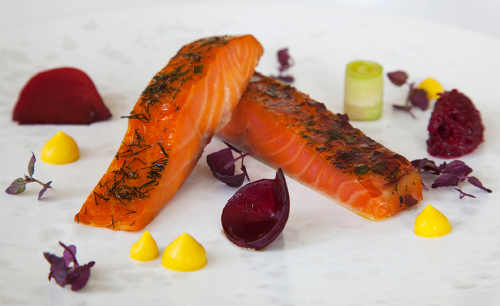 THE BURREN SMOKEHOUSE PLATE
THE BURREN SMOKEHOUSE PLATE
Burren Smokehouse Salmon, Wild About Ginger Beets, Pickled Cucumber, Beetroot Purée
Serves 4
400g Burren Smokehouse hot smoked salmon
400g Burren Smokehouse marinated smoked salmon
for the pickled cucumber
500ml tarragon vinegar
300g brown sugar
1 tsp turmeric
1 tbsp coriander seeds
1 star anise
2 tbsp fennel seeds
1 shallot, peeled and finely sliced
1kg cucumber, deseeded and diced
1 red pepper, deseeded and cut into thin strips
1 chilli, deseeded and cut into thin strips
10g salt
for the beetroot purée
4 large beetroots
1 tsp grated fresh horseradish
100ml balsamic vinegar
2 tsp brown sugar
To make the pickled cucumber, put the vinegar, sugar, star anise, turmeric, coriander, fennel and shallot in a heavy-based saucepan and simmer for about 45 minutes. Pass through a fine sieve. Put the cucumber, red pepper and chilli into a bowl, sprinkle with salt, cover with cling film and marinate in the fridge for 2 hours. Rinse the cucumber in water and pat dry.
Add the cucumber to the pickle and cook for 30-40 minutes until it’s almost dry and has the consistency of jam (it should run off a spoon in a syrupy stream). Be careful, as, once the liquid starts to reach a syrupy consistency it will turn into hard caramel very quickly.
To make the beetroot purée, preheat the oven to 160°C. Wrap beets in tin foil and bake in the oven for 1 hour or until tender. Leave to cool and peel. Chop the beetroots and place in a saucepan, add vinegar, sugar and horseradish and simmer gently for 10 minutes. Season, strain and blend in food processor until smooth, add some of the liquid back in if the purée is too thick.
To serve, thinly slice the marinated smoked salmon and hot smoked salmon. Place on a cold plate. Serve with Wild About Ginger Beets and pickled cucumber and beetroot purée
 ON THE PIG’S BACK DUCK TERRINE & DUCK LIVER PATE, FOODS OF ATHENRY CRACKERS, CANDIED WALNUT, RHUBARB
ON THE PIG’S BACK DUCK TERRINE & DUCK LIVER PATE, FOODS OF ATHENRY CRACKERS, CANDIED WALNUT, RHUBARB
Serves 4
for the terrine
400g On The Pig’s Back duck terrine
for the candied walnuts
12 whole walnuts
200g sugar
sprinkle of sea salt
for the poached rhubarb
500g sugar
500ml water
1 star anise
1 tbsp grated ginger
1 vanilla pod
zest of 1 orange
3 sticks of rhubarb, cut into 5 pieces each
for the paté
60cm sausage casing, from your local butcher
1 tub On The Pig’s Back duck live paté
300g rhubarb liquor, from above
10g balsamic vinegar
3g agar agar
To make the candied walnuts, place walnuts and sugar in a pot and bring up to 108°C (using a thermometer). Strain on to a rubber mat or baking paper and allow to cool slightly. Deep fry the nuts at 180°C until shiny and caramel coloured. Place on a tray and sprinkle with salt.
To make the poached rhubarb, combine everything, except the rhubarb, in a pot and bring to the boil, then reduce to a simmer for 5 minutes and add in the rhubarb. Simmer until tender. Remove rhubarb and keep the liquor. Choose eight of the nicest looking pieces of rhubarb for presentation on the plate.
To prepare the paté, allow it to come up to room temperature. Combine the rhubarb liquor, vinegar and agar agar in a pot and bring to boil. Pour onto a small flat tray, moving the tray to make a sheet of gel. While this cools, use a rubber spatula to put the paté in a piping bag. Tie the sausage casing at one end and pipe pate in the open end. Hang it in the fridge to set. Remove casing from the paté and place on the gel, cutting to fit if necessary. Roll it tightly and carefully using a knife to cut it, leaving as little overlap as possible.
To serve, slice the terrine into desired portion sizes about 30 minutes before use to allow it to come to room temperature. Serve a portion of the terrine alongside a slice of the rhubarb-coated paté and garnish with candied walnuts and poached rhubarb.
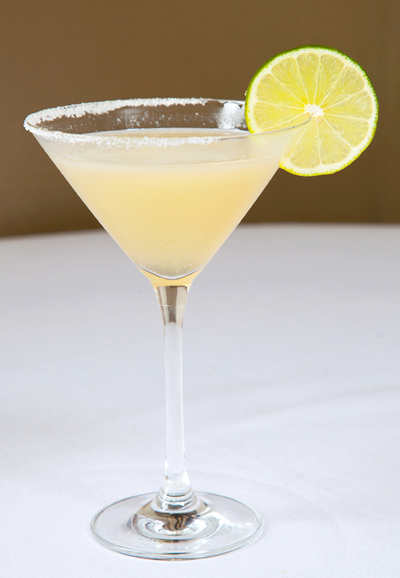 RICHMOUNT ELDERFLOWER GRANITA
RICHMOUNT ELDERFLOWER GRANITA
300ml Richmount Elderflower Cordial
300ml water
Mix the cordial and water together and place in the freezer. When set, scrape the surface with a fork and place the scrapings into a glass.
SKEAGHANORE DUCK BREAST, CONFIT LEG, CARROT PURÉE, PICKLED APPLE, STAR ANISE JUS
Serves 4
for the pickled apple
50ml Mickey Finns apple liquor
25ml water
75g sugar
75g white wine vinegar
1 granny smith apple, peeled
for the carrot purée
1 tbsp vegetable oil
10 large carrots, 5 juiced and 5 finely sliced
25g salted butter
salt and pepper
for the duck
2 Skeaghanore duck breasts
1 tbsp chopped fresh thyme
1 tbsp star anise
50g butter
2 Skeaghanore confit duck legs
To make the pickled apple, combine all the ingredients, except the apple, in a pot and bring to the boil, then allow to cool. Using a melon baller, scoop out the apple flesh and pour pickle on top. Set aside for service.
To make the carrot purée, heat a saucepan, add the oil and sliced carrots and fry for two minutes, making sure not to burn. Add the carrot juice, reduce the heat and cover. Cook until carrots become almost mushy, then blend in a food processor with the butter for 3 minutes. pass through a fine sieve and season with salt and pepper.
To prepare the duck breasts, preheat the oven to 180°C/160°C (fan). Score the skin of the duck breasts with a sharp knife and season well with salt and pepper. Heat a non-stick frying pan and place the duck breasts in, skin-side down. Fry for 6-7 minutes, then turn and add the thyme, star anise and butter. Allow this to melt, basting the duck with the juices. In a separate pan, sear the duck legs briefly on all sides, then transfer the duck legs and breasts to a roasting tin and finish in the oven for 5-6 minutes (for pink meat) or 10-12 minutes for well done meat.
To serve, slice the buck breast and divide the duck legs in two at the knuckle (to serve a half leg per person). Make a bed of carrot purée and place the duck leg on top. Drape the sliced breast over the leg and garnish with pickled apple.
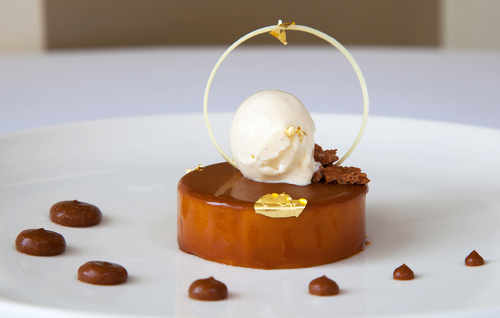 CROSSOGUE IRISH COFFEE CURD MOUSSE, FEUILLETINE, CROSSOGUE LEMON CURD ICE CREAM
CROSSOGUE IRISH COFFEE CURD MOUSSE, FEUILLETINE, CROSSOGUE LEMON CURD ICE CREAM
Makes 14-16 (the extra will freeze well)
for the lemon curd ice cream
500g milk
500g cream
3 vanilla pods
30g honey
180g egg yolk
170g caster sugar
2 tbsp Crossogue Lemon Curd
for the crème anglaise
300ml cream
100ml milk
1 vanilla pod, halved lengthways
4 egg yolks
80g caster sugar
2 tbsp Crossogue Coffee Curd
splash coffee essence
for assembly
100g feuilletine
60g white chocolate
300g cream, whipped
To make the lemon curd ice cream, heat the milk, cream, vanilla and honey in a pot. In a separate bowl, whisk the egg yolks and sugar in a bowl. Just before the milk and cream begin to boil, pour half of the milk mix over the eggs and whisk. Transfer all back into the pot and heat to 80°C. Then take off the heat and stir in the lemon curd. Churn and freeze.
To make the crème anglaise, bring the cream, milk and vanilla pod to the boil in a large saucepan. Meanwhile, whisk the egg yolks and caster sugar in a heatproof bowl over a large saucepan of simmering water until the mixture is pale and creamy. When the cream/vanilla mixture starts to boil, pour it slowly over the egg and sugar mixture, whisking all the time.
Transfer the mixture back into the saucepan the cream was heated in and continue cooking on a gentle heat until the custard coats the back of a wooden spoon. Pass the custard through a sieve. Scrape the seeds from the vanilla pod into the custard and discard the empty pod. Add the coffee essence and Crossogue Coffee Curd into the custard and mix to combine. Leave to cool.
To assemble, melt the white chocolate and mix with the feuilletine, roll out between two sheets of parchment and cut to the size of your moulds. Fold the whipped cream into the crème anglaise mix, pour into moulds and stick the feuilletine base to them. Transfer to the freezer to set.
Georgina Campbell's Cookery Feature - Recipes from The Lettercollum Kitchen Project
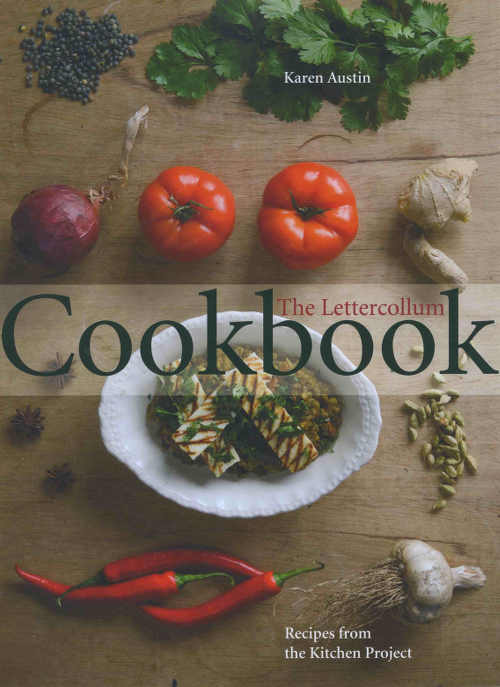
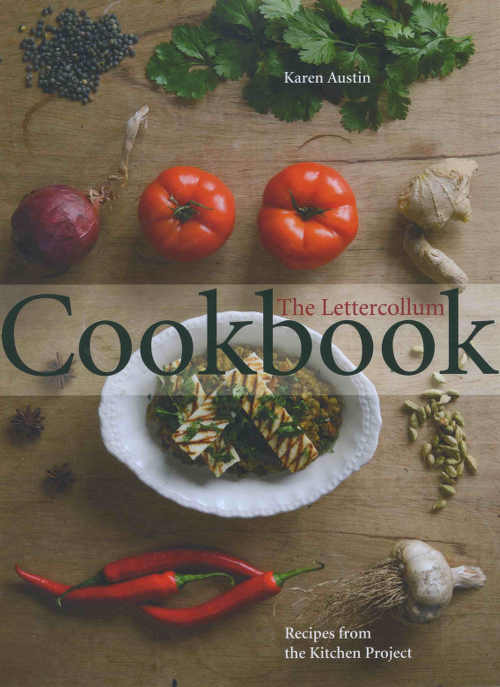 Georgina Campbell
Georgina Campbell
A popular West Cork destination for food lovers and a delightful find for visitors to the town, The Lettercollum Kitchen Project in Clonakilty is the latest phase in a wonderful food journey that began in the 80s.
On the cusp of the new decade, Con McLoughlin and Karen Austin were part of a group that bought the run down Lettercollum House at Timoleague, lived in the old property as a commune, then ran it as a hostel and eventually as a ‘proper B&B’ - always with the produce of its organically run Victorian walled garden at its heart, and especially in the later phase when their beautiful produce and good cooking was in such demand that they operated a restaurant here. I remember it well - and the twinge of sadness when it closed and the old house was put up for sale. But selling the ‘big house’ was just the beginning of a new stage in the journey, as Con and Karen stayed on in a converted stable block - and kept the walled garden.
And so, the Kitchen Project shop and delicatessen in Clonakilty was born, to make best use of their bountiful organic produce and provide a living. As Karen puts it in her new cookbook, “It was good to have a day job and it also gave us the opportunity to travel again. We did miss the creativity of putting food on plates, but this was remedied by our taking group of Irish people to Spain and France to teach them how to cook.”
It has turned out a pretty perfect solution really, with a delicious range of deli and baked products (including gluten free) on sale in the shop for all to enjoy, and cookery classes offered in their own kitchen.
The story is told evocatively by Karen in her book - where she also shares many of the most popular recipes used in the business, which take inspiration from all over the world and are all very suitable for home cooking. They are manly vegetarian but include some fish recipes, some with ‘a hint of chorizo’ - and some wonderful desserts.
The Lettercollum Cookbook by Karen Austin (photography by Arna Run Runasdottir; Onstream hardback; 175pp, €21). Available from bookshops and online from lettercollum.ie
RECIPES:
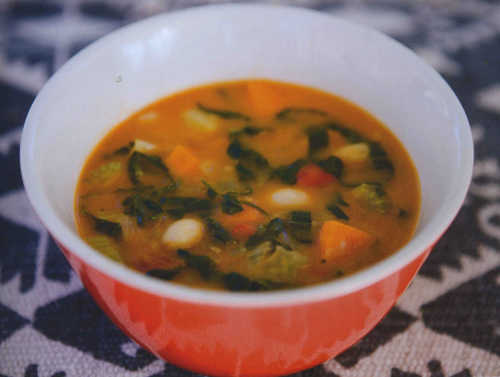 Spring Minestrone Soup
Spring Minestrone Soup
When I was a kid the only minestrone soup I knew came out of a tin; it was a tomato soup with well-cooked cubes of potato, carrot and peas. When I travelled to Italy I discovered that Italian minestrone and tinned minestrone are barely related. Tomatoes are in fact a small part of this soup and the recipe is infinitely variable.
We use whatever seasonal vegetables we have to hand which might include a couple of ripe tomatoes but not always. I think there are two secrets to good minestrone. One is the addition of Parmesan rinds, which give a great depth of flavour - meat eaters might disagree and prefer some fried pancetta or streaky bacon but either will enhance the soup.
The other important factor is to gently sauté all the vegetables together before adding the stock. This helps each vegetable to taste sweeter and more intense. It's a great recipe for a hearty lunch or a lazy dinner and in our house it gets the Parmesan rinds out of the fridge where they would otherwise loll about indefinitely.
1 onion
25g butter
2 tbsp olive oil
2 stalks celery
1 bulb fennel
Parmesan rinds (optional)
1 leek
1 large carrot
1 large potato
2 large, ripe tomatoes, diced
sprig fresh rosemary
7-8 green cabbage leaves
1 litre vegetable or chicken stock
handful cooked cannellini beans
salt and pepper
Parmesan cheese
Serves 4-6
Peel and chop the onion. Heat a large saucepan, add the butter and olive oil, then the chopped onion. Cook on a high heat for a couple of minutes, then turn down the heat and cook gently with the lid off.
Cut the celery and fennel lengthwise and chop into 1-2cm dice. Add to the onions.
Add the Parmesan rinds, if using, and give everything a good stir.
Add the following vegetables to the pot as you chop them, stirring after each addition: the leek, cut lengthwise and rinsed under the tap to get rid of any soil, then chopped into 1cm pieces; the carrot, peeled and chopped into 1 cm dice; the potato, peeled and cut into 1-2cm dice.
Shred the cabbage and add. Cook until the cabbage has wilted down - a few minutes.
Add the stock. Cook for 15 minutes.
Add the cannellini beans and cook for a further 10 minutes.
Season with salt and pepper.
If you have used Parmesan rinds fish them out before serving and discard.
If the soup is too thick, loosen it up with a little stock or water.
Serve with freshly grated Parmesan cheese
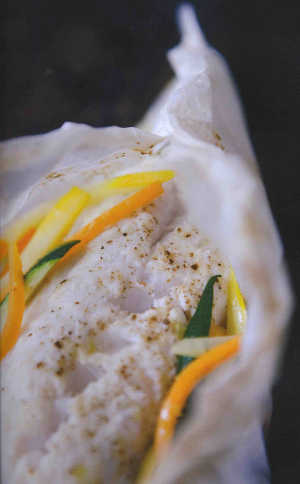 Fish en Papillote (Fish in Parchment)
Fish en Papillote (Fish in Parchment)
Fish cooked in a parcel, in this instance on a bed of vegetables, is tasty, healthy and easy to prepare. The vegetables are cut into matchsticks, gently cooked in a little butter and dressed with ginger. The fish sits on top of the vegetables, enclosed in a paper parcel and cooks in its own juices. Ask your fishmonger to give you plump steaks from the top end of the fish rather than skinny pieces from the tail.
Serves 4
600g chunky fish (hake, cod, salmon or ling)
1 carrot
1 onion
1 leek
1 small courgette
25g butter
25g piece fresh ginger
salt and pepper
lemon juice
Cut the fish into four portion sizes and remove any stray bones.
Peel the carrot and onion and wash the leek and courgette. Cut the onion in half and slice thinly. Cut the carrot, leek and courgettes into thin slices lengthways and then into matchsticks.
Melt the butter in a frying pan and add the vegetables. Season with a little salt and pepper and toss around to coat well. Once you can hear the vegetables cooking, turn the heat to medium, then cook gently for a few minutes, until they have softened.
Grate the ginger without peeling on the coarse side of the grater. Gather the ginger into your hands and squeeze the juice over the vegetables. Discard the ginger. Check the seasoning then put the vegetables aside to cool.
Using a large dinner plate or something similar cut a circle of parchment paper for the fish. Place a small mound of vegetables just off-centre and the fish on top. Season the fish with salt and pepper and a little squeeze of lemon juice.
Carefully close the parcel by bringing the sides together and double folding to make a sealed parcel, twisting the edges together as you go. Put on a baking tray and either leave in the fridge until needed or place into a preheated oven, 180°C (350°F), Gas Mark 4. Cook for 12-15 minutes.
Put the parcel on a plate and serve with twists of lemon.
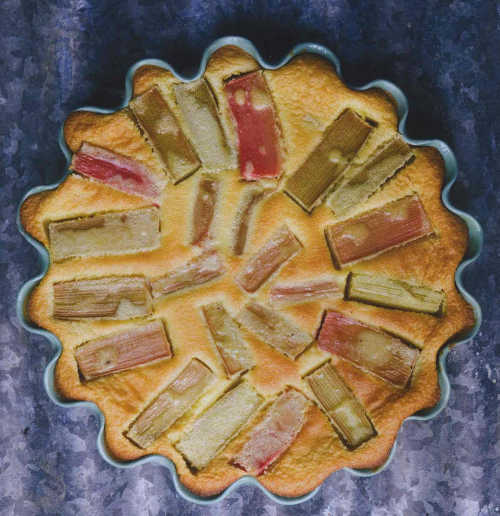 Rhubarb Clafoutis
Rhubarb Clafoutis
When the new season rhubarb is available this is an impressively simple dessert to make. A variation on the French classic, to be a true clafoutis it would need to be baked with cherries but if we stuck to that we wouldn't get to eat many clafoutis as in Ireland cherries are pretty scarce.
This is a batter-based custard baked in the oven. Easy peasy. No pastry or anything complicated, just whisk the ingredients together and pour over roasted or poached fruit and pop in the oven.
It makes a great dessert and if you take the time to arrange the fruit on top it looks quite elegant.
The clafoutis can be baked in any ovenproof dish or baking tin, ideally 20-24cm in diameter. For individual portions use buttered ramekins.
6 stalks rhubarb
170g caster sugar
4 large eggs
50g white flour (or polenta if you want gluten-free)
50g ground almonds
250ml cream
1 tsp vanilla extract
15g butter to grease dish
Serves 4-6
Preheat the oven to 180°C (350°F), Gas Mark 4.
Wash the rhubarb and cut into 5cm lengths. Toss in about 20g of the sugar and put onto a baking tray.
Bake in the oven for 12 minutes. The rhubarb should be sweating at this stage with the juices beginning to run.
Crack the eggs into a bowl then add the remaining sugar, flour and ground almonds. Whisk to a smooth paste.
Put the cream into a small saucepan with the vanilla and bring to the boil.
Whisk the cream into the egg mix.
Rub a baking dish with butter and pour in two-thirds of the mix. Arrange the rhubarb on top and drizzle over the remaining batter.
Bake in the oven for 35-40 minutes. Check after 30 minutes just in case your oven is particularly hot. The clafoutis is cooked when it is set and golden all over.
Serve at room temperature with whipped cream on the side.
Georgina Campbell's Cookery Feature - Celebrating Vegetables
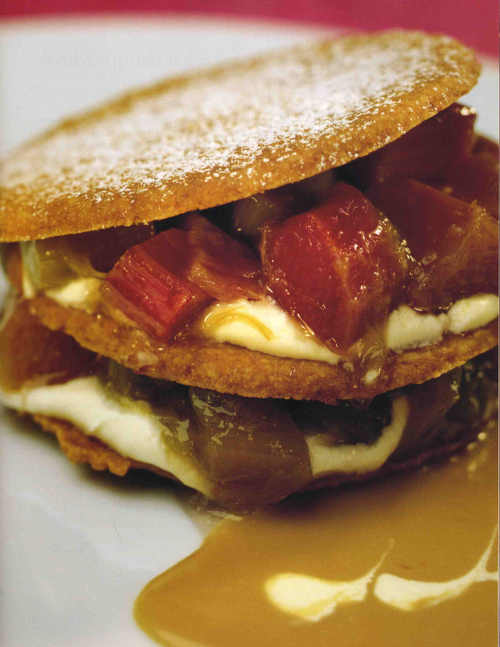
Georgina Campbell
The UK’s National Vegetarian Week is scheduled for 18th-24th May and - while the nearest equivalent in Ireland is World Vegetarian Day in October, which is marked by the Vegetarian Society in Dublin - this is a good time to celebrate the health-giving qualities, versatility and downright deliciousness of vegetables.
Mainstream medical thinking is finally coming around to the idea that favouring plant based foods over meats is a wise choice for better health and, while I am not a vegetarian, this seems to make perfect sense to me.
I’ve always loved vegetables and, as a family, we eat far more than most and enjoy growing as much as possible too. My father was a mixed farmer and market gardener, so working with the season’s crops comes naturally and our meals revolve around seasonal vegetables, salads and fruit as a matter of course.
We enjoy at least a couple of virtually meat-free meals a week too - and, when travelling and ‘dining for Ireland’ for the Guide, it can be very restful to the system to opt for vegetarian dishes for a day.
Luckily, the vegetarian and almost-vegetarian options offered in Irish restaurants have improved dramatically of late - largely due to the growing popularity of restaurant vegetable gardens, the influence of the hugely successful GIY movement (www.giyinternational.org), and a newly fashionable international awareness of the potential of vegetables - so creative vegetable-led dishes have become mainstream choices and are much more widely available to please local diners and refresh jaded travellers alike.
Recently, there has also been a sharp increase of interest in vegan cooking, with far more vegan dishes highlighted on menus - and every indication that this more extreme form of vegetarianism is going mainstream too.
Our new love affair with vegetables has to be good for the health and wellbeing of the nation - and, providing it goes hand in hand with a new appreciation of the value of vegetables, and a willingness to pay a fair amount for quality locally produced food, it will be good for our growers too.
References: Information to help you find your inner vegetarian is available from the Vegetarian Society of Ireland (www.vegetarian.ie) and the Vegan Society (www.vegan.ie)
RECIPES:
Denis Cotter, owner-chef of the famed Café Paradiso in Cork, pioneered seriously creative vegetarian cooking - essentially ‘fine dining without the fuss’ - in Ireland when he opened his delightful little restaurant on Lancaster Quay in 1993, and it remains a place of pilgrimage for people who love great food that ‘just happens to be vegetarian’.
Dubliners are also licking their lips in anticipation of an ‘almost vegetarian’ sister restaurant that is to open in the capital later this year. These recipes - selected from his Café Paradiso cookbooks for their seasonality and relative simplicity - show just how beautiful, varied and utterly delicious vegetarian food can be.
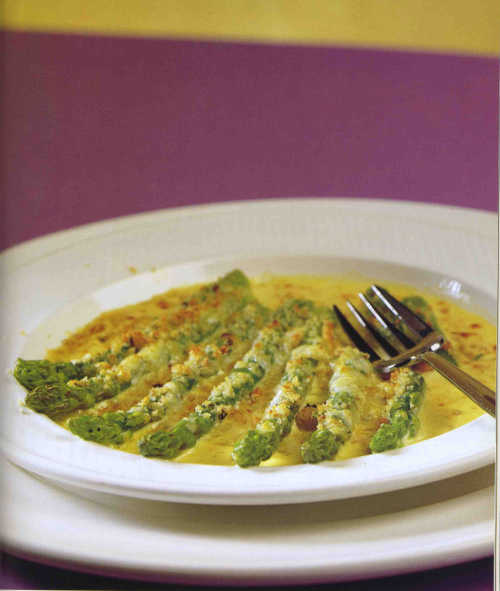 Asparagus and Gabriel cheese gratin
Asparagus and Gabriel cheese gratin
“I like asparagus roasted, grilled, warm in salads or dunked in mayonnaise, and all the other ways it likes to be done, but this is my favourite asparagus dish and the first one I reach for when the season starts. There are strong flavours here, so balance is important, which is why I like to do each plate separately. Too much of the cream sauce can drown the asparagus, too much of the crumble will spoil the texture as well as the flavour, and even the balance in the crumble is variable. The perfect gratin will have just enough sauce to be absorbed by the asparagus and the crumble, which is scattered loosely, but generously, over the plate. If you see someone scooping it up with their finger or licking the plate, you've miscalculated, but obviously not too badly.”
[Note: The famously tangy West Cork thermophilic cheese Gabriel is no longer available, but another hard cheese of character can be used instead.]
FOR FOUR:
• 16-20 asparagus spears
• 1 onion, quartered
• 4 whole garlic cloves
• 50mIs white wine
• 150mls cream
• 1 tsp strong prepared mustard
• salt and pepper
• 60g breadcrumbs
• 40g Gabriel, or other tangy hard cheese
• 1 dessertspoon butter
Snap the tough ends off the asparagus, wash them and save them. Cook the asparagus tips in boiling water for a few minutes - they should be just short of tender - then cool them.
Now put the ends into a pot with the onion and garlic, the wine and about 300mls of the asparagus water. Bring it to the boil and keep at a lively simmer for about 15 minutes.
Strain off the vegetables and return the stock to the pan. You should have 150mls left at most; if there is more, simply boil it for a few minutes more to reduce the volume.
Then pour in the cream and mustard, and cook the sauce at a rolling boil until you have about 200mls of a fairly thick pouring sauce. Season cautiously with salt and pepper.
Make a crumble by combining the crumbs and cheese and stirring in the butter, which should be softened almost to the point of melting, and some seasoning. Now you have two choices, depending on your facilities and ambitions: (a) arrange the asparagus in an oven dish with the cream poured over, sprinkle a generous but not blanketing amount of the crumble over that, and place the dish under a hot grill until the crumble browns and the cheese begins to melt; or (b) arrange individual portions on plates and grill. I prefer the second, it only takes a minute for each plate and gives you much more control over the amount of sauce on each portion.
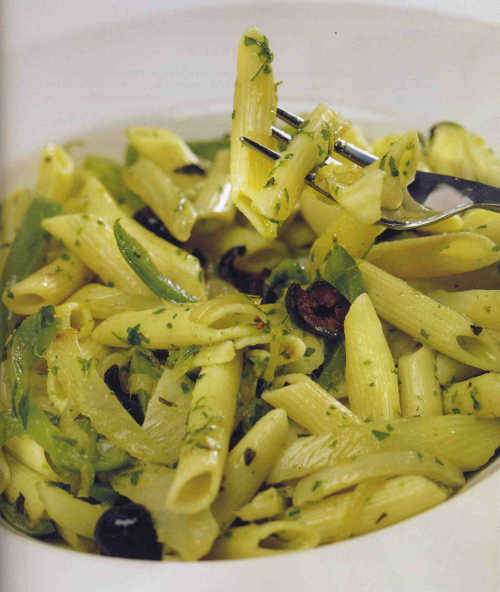 Penne with fennel, green peppers, olives and roasted garlic-parsley oil
Penne with fennel, green peppers, olives and roasted garlic-parsley oil
“While I would generally go along with the idea that the best thing to go with pasta is whatever you've got in the cupboard, a bottle of wine and an appetite, this is one of those specific recipes. I've tried (and eaten happily) other vegetables with this sauce, but there is no denying that this lot were made for each other. The recipe for the garlic-parsley oil makes about 500mls, enough for at least ten people, but it's hard to make less unless you've got miniature kitchen equipment. It will keep well in the fridge for a week or so.”
FOR FOUR:
• 16 cloves garlic
• 300mls olive oil
• 2 large handfuls, about 80-l00g, parsley
• salt and pepper
• 450g dried penne pasta
• 1 fennel bulb
• 2 green peppers
• 12-16 black olives, stoned and halved
First make the oil. Make two or more times the recipe if you've got the ingredients. Separate the garlic cloves from each other, toss them in a little olive oil and roast them in a low to moderate oven until they are soft and lightly browned. The garlic should now be easy to squeeze from its skin.
Put it in a food processor with the parsley and blend to a fairly fine pulp. Pour in the olive oil and blend to get an oil of slightly thick pouring consistency. Season with salt and pepper.
Boil a large pot of water for the pasta, then start cooking the vegetables. Cut the fennel in half lengthways, then again into quarters. Chop these pieces crossways into thin slices.
In a heavy pan, warm a little olive oil and cook the fennel gently for about five minutes, then chop the green pepper in the same way and add it to the pan. Continue cooking gently, stirring often, for another five minutes until the vegetables are tender but not soft. Add the olives and cook for just one minute more.
Meanwhile cook the pasta in the water, drain it and return it to the pot. Stir in the vegetables and four tablespoons of the garlic-parsley oil and warm it through.
Before serving, test for seasoning and flavour, you may want to add more of the oil. A hard, mature sheep's cheese, grated or shaved, is brilliant with this, though parmesan is more than good enough.
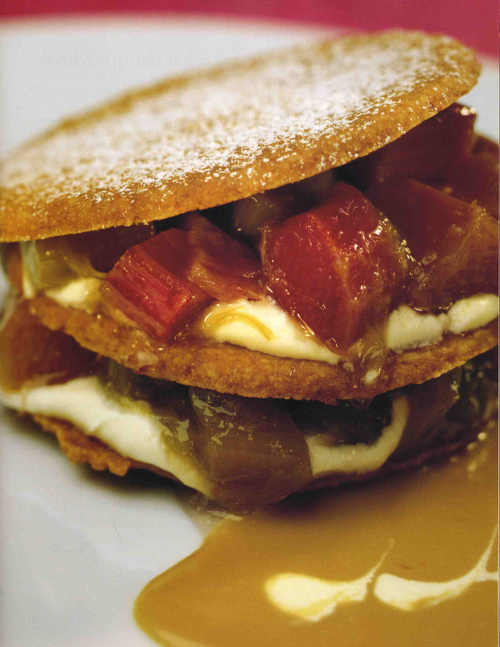 Rhubarb shortbread with butterscotch sauce
Rhubarb shortbread with butterscotch sauce
“The challenge in a restaurant when dealing with the season's finest fruit is to present it at its simple best while making a dish interesting enough to take people's minds off the chocolate. Some fruits carry the extra burden of being loved and hated equally, and rhubarb is right up there with blackcurrants and gooseberries in that context. Given that only rhubarb lovers will order any dish with rhubarb, it is essential that it then has enough rhubarb to satisfy them, while still being pretty, interesting, etc etc. This recipe is one of those attempts to pull off that juggling feat. The serious rhubarb person will, however, be satisfied only by a large steaming bowl of stewed rhubarb or a mountain of rhubarb crumble. The rhubarb and biscuits can be done a day or more ahead, but make sure the rhubarb is at room temperature when you serve it.”
FOR FOUR:
• 1 large bundle of rhubarb sticks
• 300g caster sugar
• l00g unsalted butter
• 150g plain flour
• rind of ½ orange
• l00g light muscovado sugar
• 50g unsalted butter
• 500mls single or double cream
• icing sugar, to serve
Chop the rhubarb into pieces of about 15mm long. Cook these very gently with 250g of sugar and one tablespoon of water until the rhubarb is just tender - it makes the world of difference it the rhubarb pieces don't totally disintegrate. Carefully transfer the rhubarb to a bowl to cool.
Preheat the oven to 375°F (Gas Mark 5). Cream the butter and 50g of sugar until fluffy, then beat in the flour and orange rind.
Wrap this dough and chill it for 30 minutes, then roll it to about 5mm thickness and cut out round biscuits of about 8cm diameter. You will need three per person.
Bake the biscuits on an oven tray covered with baking parchment for 20-25 minutes. They should be pale brown but not quite crisp - they will crisp fully as they cool.
To make the butterscotch sauce, put the muscovado sugar, unsalted butter and 300mls of the cream into a pan, bring it slowly to a boil, then boil it for two minutes. Leave the sauce to cool to room temperature before using it. Whisk the remaining 200mls of cream until softly whipped.
Place a shortbread biscuit on each plate, spread a layer of cream on it, then pile on a generous tablespoon of rhubarb. Put another biscuit on that, then more cream and rhubarb, then a third biscuit. A light dusting of icing sugar finishes it off nicely.
Pour a stream of the butterscotch sauce around the biscuits. Obviously a fork won't pass easily through that lot, so I tend to lean the third biscuit half- off the construction to make it easy for people who are nervous about demolishing pretty plates of food. But that's a restaurant thing and your guests won't be like that, will they?
Georgina Campbell's Cookery Feature - Chicken: Fillets Not the Only Meat
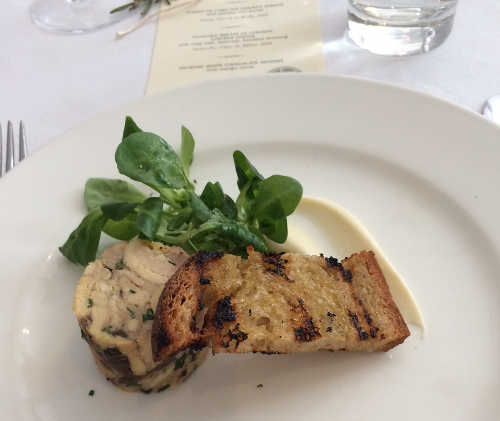
 Georgina Campbell
Georgina Campbell
How often do you eat chicken? It is by far the most popular meat in Ireland, accounting for about a third of the nation’s total meat consumption, so the chances are you eat it several times a week. And the demand for chicken breast fillets in Ireland is extraordinarily high compared to other parts of Europe.
At a special ‘chicken lunch’ held recently at Dublin’s Fallon & Byrne restaurant by Ireland’s longest established chicken producer, Manor Farm (est 1775), their MD Vincent Carton said that in Ireland we eat 10 chicken breasts for every chicken leg eaten - and, although they have a healthy export market sending other cuts abroad, especially to Scandinavia, it is a trend they would like to reverse.
Research carried out by the company found that over 40% of adults under 35 have never cooked a whole chicken, which is a pretty shocking reflection on our life skills teaching record in Ireland. If you are one of those people who have never had the pleasure of serving up roast chicken to an admiring audience, just try Diana Henry’s deliciously simple modern recipe below and you will be hooked for life.
As any good shopper knows, buying a whole bird or other cuts of the chicken offers much better value than chicken fillets which, although admittedly convenient, also have less flavour than other parts of the bird. And, as well as giving more for your money, buying whole chickens, or different cuts, opens up the possibility of making a whole range of more interesting dishes.
 And then there is the question of where the chicken comes from, and how it was raised. The lunch at Fallon & Byrne was held to coincide with the long awaited changes to labelling laws, which should end the confusion of whether or not foods with ‘Irish sounding names’ are actually Irish.
And then there is the question of where the chicken comes from, and how it was raised. The lunch at Fallon & Byrne was held to coincide with the long awaited changes to labelling laws, which should end the confusion of whether or not foods with ‘Irish sounding names’ are actually Irish.
Mandatory country of origin labelling across chicken and other poultry was introduced on April 1st 2015 - although, as guest speaker Ross Golden Bannon pointed out, the country of origin information on labels is allowed to be so small that it is almost impossible to read
However, as MD Vincent Carton pointed out, “Ireland can only be listed as country of origin if the meat in question has been born, bred and slaughtered in Ireland. If any one of these variables takes place elsewhere, it must be stated on the label.
This marks a very positive change for the consumer and for the survival of the entire poultry sector in Ireland”. As this family-owned Cavan company is celebrating 240 years in business this year, they should know bit about survival.
In an ideal world, many of us would choose to eat only free range and organic poultry and we have many excellent small to medium sized businesses producing chicken to the highest standards - examples like Margaret McDonnell's certified organic farm in Kildare, Bertram and Celine Salter’s Carlow Free Range, and Ronan Byrne’s The Friendly Farmer in Athenry all come to mind.
But in reality the majority of shoppers are not willing to pay the necessary premium for the highest quality, so it is vital to ensure that large scale production is as good as it can be. Last year’s scare about a bacteria called campylobacter that was found to be present intwo-thirds of the UK’s chicken meat prompted Slow Food to urge the public to question the true cost of cheap food (as indeed many of us do here, on a regular basis), and even though transparency about country of origin is an important advance, there is certainly no cause for complacency.
Educating shoppers about the real advantages of quality food (better taste and better health to name but two) is the only way forward, and it’s best to start them young. Slow Food Ireland is doing great work in this area; school gardens and poultry have been successfully introduced in East Cork, and the Four Rivers Convivium is also working hard at their Hens For Schools project for schools in the South-East.
 Meanwhile, back in Dublin, the idea of a lunch menu revolving entirely around chicken may not immediately appeal, but Fallon & Byrne’s Head Chef, Tom Meenaghan, rose to the challenge. His very delicious all-chicken menu (see below) was ingeniously devised to showcase lesser known cuts from Manor Farm’s premium free-range and cornfed ranges, which account for about 10% of their total production of between 800,000 and 820,000 chickens.
Meanwhile, back in Dublin, the idea of a lunch menu revolving entirely around chicken may not immediately appeal, but Fallon & Byrne’s Head Chef, Tom Meenaghan, rose to the challenge. His very delicious all-chicken menu (see below) was ingeniously devised to showcase lesser known cuts from Manor Farm’s premium free-range and cornfed ranges, which account for about 10% of their total production of between 800,000 and 820,000 chickens.
In due course they plan to have all of the recipes on their website, meanwhile some of them are given below. While a little cheffy for some cooks, they are not too difficult if you take the time and any one of them could be an impressive element in a meal when entertaining.
And the dessert is bound to end any gathering on a high, as it is not only seriously moreish but entertaining as well.
RECIPES:
Everyone should know how to roast a chicken and this appealing recipe from Diana Henry’s latest book, A Bird in the Hand Roast - Chicken Recipes for Every Day & Every Mood (Mitchell Beazley, hardback, £20) will be more attractive to many cooks than the traditional roast chicken with roast potatoes and two veg.
Any book by Diana Henry deserves a place on the kitchen bookshelf and perhaps this one most of all, as it demonstrates the enormous versatility of this most popular of foods in dishes that use whole chickens and a wide variety of cuts.
 Chicken With Dill And Leeks
Chicken With Dill And Leeks
Simple, satisfying and perfect for Sunday lunch: whole roast chicken infused with dill and lemon, cooked with waxy potatoes
You might think this recipe comes from Scandinavia – land of dill lovers – but in fact it was inspired by a dish I had in Turkey, where whole fish were cooked on a bed of potatoes and dill (and a little raki). This is a very comforting dish, but light and spring-like at the same time. Serve it with roast tomatoes or a carrot purée.
SERVES 8
INGREDIENTS
2kg chicken
10g dill
75g unsalted butter, slightly softened
1 lemon
500g waxy potatoes, peeled
4 leeks
400ml chicken stock
3-4 tbsp dry vermouth
4 tbsp crème fraiche (optional)
METHOD
Preheat the oven to 200°C/gas mark 6. Remove the coarser stems from the dill and set them aside. Roughly chop the remaining light, leafy part. Mash the butter with half the chopped dill.
Carefully lift the skin of the chicken breast and legs and push about half the butter under. Spread the remaining butter over the bird and season. Put in a roasting tin or a flame- and ovenproof dish. Squeeze the lemon over, then put the shells into the cavity of the bird with the dill stalks. Truss the chicken, if you like. Roast for 20 minutes.
Slice the potatoes to the thickness of a pound coin. Trim the leeks, discarding most of the dark-green tops. Chop into 4cm lengths and wash thoroughly.
Take the chicken out of the oven and put the potatoes and leeks around it, coating them in the juices. Season. Pour the boiling stock on to the vegetables with the vermouth.
Reduce the temperature to 180°C/gas mark 4 and return the bird to the oven for one hour. The potatoes will become tender and the cooking liquid will reduce significantly. If the vegetables haven’t absorbed all the liquid, remove the chicken to a warmed platter and insulate with foil to keep it warm.
Set the roasting tin on the hob and boil until the liquid mostly disappears. Add the crème fraiche, if using. Heat this through – it doesn’t have to be completely mixed into the vegetables. Check for seasoning.
Put the bird back on top of the vegetables, throw on the rest of the chopped dill and serve.
 MENU
MENU
created by Tom Meenaghan, Fallon & Byrne, for Manor Park
CHICKEN CONSOMMÉ AND CHICKEN LOLLIPOP
***
CONFIT OF CHICKEN TERRINE
***
POACHED BREAST OF CHICKEN , CHICKEN OYSTER, WITH CRISP KALE, BEETROOT, HAZELNUT DRESSING
***
VALRHONA WHITE CHOCOLATE MOUSSE WITH MANGO CAVIAR
FIRST Buy 2 whole free range chickens & prepare for the entire menu to serve four:
Ask your butcher to remove the legs, and the wings. Separate each wing by cutting in two. Keep the part of the wing that is closest to the breast. Cut out the chicken ‘oyster’. Keep the breast skin on and ask your butcher to chop the rest of the bones up.
OR, instead of using whole chickens, ask your butcher for 4 legs and 4 chicken breasts complete with skin and wing bone.
STARTER: Confit Of Chicken Terrine with Parsley Root Purée
Serves 4
Ingredients
4 free range chicken legs
2 tablespoons sea salt
1 garlic clove, crushed
Sprig thyme chopped
Sprig rosemary chopped
1 star anise crushed
1 red onion, about 120g
1 tablespoon olive oil
1 teaspoon brown sugar
1 teaspoon balsamic vinegar
600 ml duck fat
Freshly ground pepper
Salt
10g flatleaf parsley chopped
10g chives chopped
Method
Rub the chicken legs all over with the sea salt, garlic, thyme, rosemary and star anise. Layer In deep dish or plastic container, cover with cling film. Place in refrigerator overnight and then wash chicken legs under cold running water, removing all salt; dry with kitchen paper
Red Onion: Peel onion, cut in half, slice thinly. In a heated saucepan add oil and onion, cook for two minutes. Add the sugar, vinegar, salt and pepper. Cook for 4 minutes; remove and cool down.
Place the chicken legs in a saucepan, cover with duck fat, bring to a simmer and then turn down to the lowest heat; note time. Cook for one hour from time of turning the heat down.
Remove legs, place on a wire rack, leave to cool for 15 minutes. Carefully remove the skin, and pull away the meat from the bone; try not to break the meat up too much. Fold in a tablespoon of the duck fat, twist of pepper, chopped herbs and onion. Taste for seasoning, add a little salt if required.
On a work surface, lay down cling film about the size of an A4 sheet of paper. Place the chicken mixture in a cylinder shape at the bottom end of cling film. closest to you. Roll the cling film away from you, as tightly as you can to make a sausage shape. Twist the ends of the cling film, place in fridge to chill for about 4 hours.
Parsley Root Purée
300g parsley root
250ml milk
20ml water
Sprig thyme
Clove garlic
1 bay leaf
Pinch salt and pepper
Wash and peel, parsley root, cut into approx 2 cm cubes; add all ingredients together in a saucepan,bring to boil. Remove any froth with a spoon, turn down heat to a simmer and cook for 10 minutes or until tender. Strain , but keep the cooking liquor. Remove the bay leaf, garlic and thyme. In a food processor or blender blitz to a fine purée, adding the cooking liquor to loosen the mixture.
To serve: Cut the terrine into 2cm circles; remove cling film. Put a table spoon of root purée on each serving plate. With the back of the spoon, drag the purée towards you. Serve with grilled sour dough bread and lambs lettuce or salad of your choice.
MAIN COURSE: Poached Breast Of Chicken and Chicken Oyster, With Crisp Kale, Beetroot, Hazelnut Dressing
Serves 4
Ingredients
4 chicken breasts
1 tablespoon table salt
500ml chicken stock, home made or good quality bought
400g curly kale, washed
Pinch table salt
150g golden beet root
150g purple beet root
1 tablespoon honey
4 tablespoon orange juice
1 egg
1 tablespoon milk
20g breadcrumbs
60g hazelnuts roasted, rubbed to remove skins, and crushed
4 tablespoons olive oil
1 tablespoon cider vinegar
Half teaspoon Dijon mustard
Chicken: Remove the little fillets from the breast of chicken (use for the consommé, if making). Dissolve the salt in the chicken stock, pour over the chicken breast cover refrigerate overnight
When you are ready to cook chicken: Remove chicken from the liquid, place onto a piece of cling film. Roll up into a cylinder shape, tie at both ends. In a medium saucepan, cover chicken with cold water; bring to boil, simmer for 15 minutes.
Remove from water. Allow to rest for 5 minutes. Remove cling film and carefully peel the skin away from the chicken.
Kale: Remove any centre stalks from the leaf. In a preheated oven at 100º C, place kale on a baking tray. Dry the kale in oven for one hour, or until completely crisp. Remove from oven and season with a pinch of salt. Set aside.
Beetroot: Wash beetroot and wrap in tin foil. Roast in preheated oven at 180ºC for 45 to 50 minutes. Leave to cool, then peel and cut into 2cm squares. To reheat: in a small saucepan add the honey and orange juice. Bring to boil and add beetroot. Heat through.
Hazelnut dressing: Roast the hazelnuts in a pre heated oven at 180ºC for approx 10 minutes. Cool, rub off skins and crush lightly. In a small saucepan, add the olive oil, cider vinegar, Dijon mustard, hazelnuts and a twist of pepper. Heat up gently.
Chicken oyster: Place the chicken oysters between two pieces of cling film. Lightly flatten with the back of a knife. Dust both sides with flour and dip into beaten egg mixed with the milk. Remove and breadcrumb and deep fry or shallow fry in pan for 2 to 3 minutes. Season with salt and pepper.
To serve: For presentation, take a small slice from each end of the chicken, then cut chicken in half; place into centre of plate one piece standing upwards, topped with the chicken oyster. On the left hand side put a spoon full of mashed potato (optional ) and top with the crisp kale surrounded by the hazelnut dressing. On the right hand side, arrange 5 squares of beetroot with a little drizzle of the honey and beet root .
DESSERT: VALRHONA WHITE CHOCOLATE MOUSSE WITH MANGO CAVIAR
Serves 4
Ingredients
2g or 2 leaf gelatine
170g Valrhona white chocolate, or other good quality white chocolate
5g sugar
100g milk
Zest of one lemon
200g single cream
Method
Soak the gelatine in cold water 15 minutes
Melt chocolate with sugar in a bain marie
Boil milk with lemon zest
Strain milk, add gelatine and pour over chocolate
With a hand blender pour in cream
Pour into egg cups.
Garnish with finely chopped mango and fresh mint.
Georgina Campbell's Cookery Feature - Why not Meet the Cheesemakers this Summer?

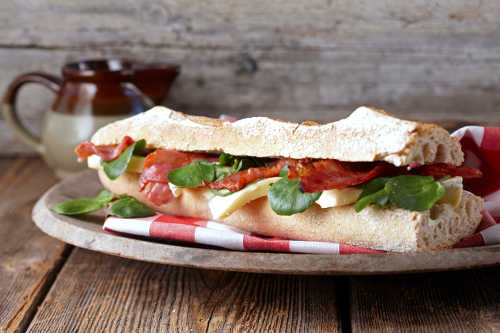 Georgina Campbell
Georgina Campbell
Bord Bia has been very supportive of cheesemakers, and of small producers generally, and through the EU-funded Discover Farmhouse Cheese programme, they are currently encouraging us to make handmade cheeses part of our everyday shopping, both for raw or ‘cheeseboard’ use, and to use in cooking.
Best of all for cheese lovers, the Discover Farmhouse Cheese campaign offers free farm visits to famous producers like Cashel Blue in Co Tipperary and Burren Gold (which is made at Aillwee Cave in Co Clare) throughout the summer and early autumn. All you have to do is to book your place online.
Mere mention of cheese in Ireland can send the mind spinning back to a time when homemade bread was somehow inferior to a sliced pan, and the cheese in the sandwich was most likely to sold in plastic packs of square processed slices. Then the early stirrings of a changing food scene began in the 1960s and 70s when a number of apparently unconnected events added up to a seismic shift.
Most famously, Myrtle and Ivan Allen opened their restaurant at Ballymaloe House and, equally significantly although less well known, they and a number of likeminded country house owners then banded together to establish the Irish Country Houses & Restaurants Association, now The Blue Book.
One of them was Cashel House Hotel in Connemara, where Kay and the late Dermot McEvilly famously hosted President de Gaulle and his wife in 1969, for a fortnight of the Irish holiday that first put this country on the map for food-loving continental tourists.
Then the ‘70s brought other dramatic developments that were to have far reaching effects. When Veronica Steele started making the iconic Milleens cheese from the milk of a one-horned cow called Brisket on a West Cork farm, in 1978, little could she have known that she was kick starting a farmhouse cheese making revolution that would eventually see small producers all over Ireland making a huge variety of highly individual cheeses on their farms - and that this would provide the foundation for the host of other small food production success stories that are now the cornerstone of our national recovery.
It’s extraordinary to think that that such small, everyday activities - beginning with people just getting on with it and finding ways to get by - can have such a profound influence for change.
Today there are more than 50 artisan cheese makers producing over 150 kinds of cheese on their farms. And summer with its lush green grass is peak production time, so this is not only the ideal time to seek out some of the cheeses that are best enjoyed young and fresh, but also a great time to visit producers to see the cheese making process, hear the stories, taste the cheeses and buy them at source.
Farmhouse cheese is one of the most versatile cooking ingredients imaginable, especially when you consider the range of styles and variety of flavours available. Made from the milk of cows (and buffalo!), sheep and goats to produce everything from a soft and mildly flavoured white goats cheese to a piquant blue, or hard and nutty mature cheeses, there is a farmhouse cheese to please every taste and suit every kind of meal and occasion from soups, salads and baking to tarts, pizza and simply good old bread and cheese.
What could be more delicious than a chunk of well made farmhouse cheese with freshly baked brown soda bread and a dollop of homemade chutney…? And don’t forget that other simple pleasure, grated cheese sprinkled over hot vegetables.
Even though they’re having a fashion moment in high-end restaurants, vegetables are still the Cinderella of foods and it’s time to see them for the stars of health and deliciousness that they really are. They are beginning to come into their own, but they deserve to be appreciated much more - which includes paying a realistic price for our veg in the shops.
Most of us are never going to lose our appetite for meat, but eating more vegetables is good for all and some people and organisations are doing a great job to encourage us, including GIY of course, and The Organic Centre (www.theorganiccentre.ie) in Co Leitrim, which is another fantastic place to visit with all kinds of things going on, including cookery demos. If you’re nearby on July 12th, Neven Maguire will be featuring his favourite vegetable recipe 'Roasted vegetables on rice' (courgettes, peppers, aubergines, tomatoes and onions…) at their Garden Party cooking demonstration. There’s lots else on offer at various times, and the website is always well worth checking out.
RECIPES:
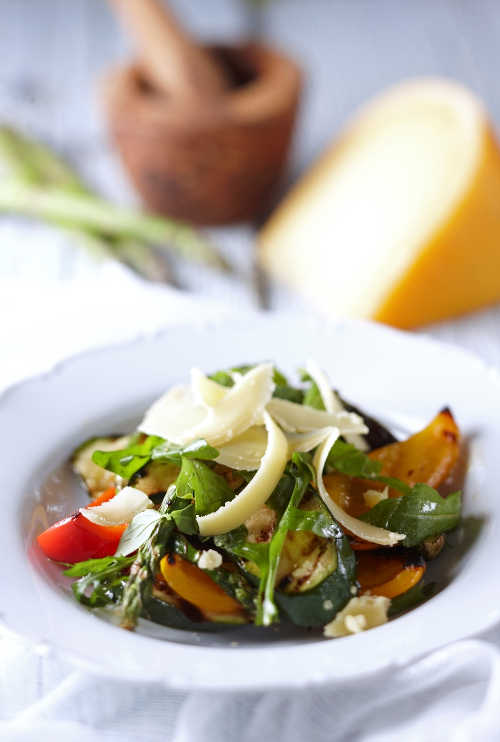 Chargrilled Vegetable Salad with Mature Farmhouse Gouda
Chargrilled Vegetable Salad with Mature Farmhouse Gouda
You don’t have to be a vegetarian to enjoy this delicious barbecue salad. You could up the ante with more local ingredients, eg by using your favourite Irish rapeseed oil instead of olive oil, and replacing traditional imported balsamic with Llewellyn's excellent Irish balsamic cider vinegar
1 red pepper, deseeded and quartered
1 yellow pepper, deseeded and quartered
10-15 asparagus spears
1 courgette, sliced diagonally into 1cm thick discs
1 tbsp olive oil
2 tbsp good quality oil, extra virgin olive or Irish rapeseed
15g rocket or flat leaf parsley, leaves chopped
10g fresh basil, leaves
Salt and freshly cracked black pepper
50g mature farmhouse Gouda shavings e.g. Coolea
½ tsp balsamic vinegar, eg Irish balsamic cider vinegar
Heat the barbecue until it is very hot.
Grill the peppers, skin side down until the outer skin is blackened and blistered. Place in a bowl, cover immediately with cling film and leave for 20 minutes (the cling film will trap the steam and loosen the skins). Peel the peppers, discarding the skin and slice lengthways into 3-4 long strips (the strips will be deliciously soft and sweet).
Snap off the hard woody ends from each asparagus spear (if necessary).
Brush the asparagus and courgettes with oil and season with salt and pepper. Grill for approximately 5-10 minutes, turning halfway through cooking until slightly charred on the outside. Cut the asparagus spears in half.
Combine all the warm vegetables in a bowl and toss in the oil and balsamic.
To serve, combine the chargrilled vegetables with the rocket, basil and shavings of mature farmhouse Gouda.
 Scones with Sage & Farmhouse Blue Cheese
Scones with Sage & Farmhouse Blue Cheese
You could vary the herb flavour in these moreish savoury scones, by using rosemary, marjoram or mixed Mediterranean herbs instead of sage, for example
Serves 6
450g / 1lb plain flour
2 tsp cream of tartar
1 tsp bread soda
1 tsp salt
A little freshly ground black pepper
A few sage leaves chopped
Pinch of cayenne pepper
225g / 8oz farmhouse blue cheese e.g. a firm Cashel Blue
1 egg
300ml / ½ pint natural yoghurt or buttermilk
1 egg whisked with a dash of milk for glaze
Mixed sesame seeds for sprinkling on top of scones
Preheat the oven to 210ºC / 425ºF / Gas Mark 7.
Mix the flour, cream of tartar, bread soda, salt and pepper, sage, and cayenne pepper in a bowl. Crumble or cut the cheese into small pieces and add to the dry ingredients with the egg and yoghurt or buttermilk. Mix to a soft dough.
Turn out onto a floured surface. Pat or roll out to about 2.5cm / 1 inch think and cut into scones with a floured 6cm / 2 ½ inch scone cutter. Place on a greased baking tray. Brush with whisked egg mixture and sprinkle with mixed sesame seeds.
Place in oven at 210ºC / 425ºF / Gas Mark 7 for 10 minutes. Reduce the temperature to 180ºC / 350ºF / Gas Mark 4 for 5-10 minutes. Cool on a wire rack. Serve with soup or simply as a snack topped with homemade chutney.
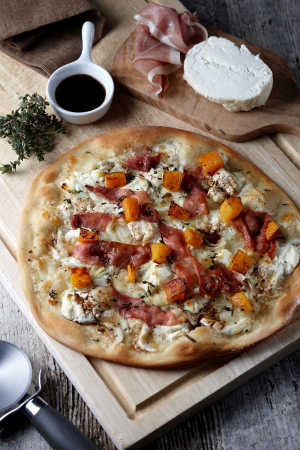 Butternut Squash & Goats Cheese Pizza with Prosciutto & Aged Balsamic
Butternut Squash & Goats Cheese Pizza with Prosciutto & Aged Balsamic
Serves 2
Pizza dough, as below
Flesh of half a small butternut squash
1 tbsp quality olive or Irish rapeseed oil, plus more for drizzling
Salt and freshly ground black pepper
1 small garlic clove, minced
½ small onion, thinly sliced
6 slices prosciutto or Irish equivalent, torn into 1-inch/2.5cm pieces
2 tsp freshly chopped sage or thyme, or to taste
¼ cup sliced or torn mozzarella, eg Toonsbridge
50g/2 oz goats cheese, crumbled, eg St Tola
1 tbsp balsamic vinegar for drizzling, eg Llewellyn’s Irish balsamic cider vinegar
Place a pizza stone in the lower third of your oven and preheat oven to Gas Mark 6, 200oC (400oF). Allow the pizza stone to preheat for at least 30 minutes.
Meanwhile, prepare pizza dough, as below, and prepare the squash.
Cube the squash, toss in oil, season with salt and pepper and bake in the heating oven, for 15 minutes or until tender.
Once the pizza stone is heated, turn the dough onto a lightly floured work surface and roll out thinly to make one large or two medium bases. A pizza peel is really useful. If unavailable, use a rimless or inverted baking sheet (so it slides off easily). Dust with corn meal or flour before placing the dough on so it doesn’t stick.
In a small bowl, combine 1 tbsp olive oil with minced garlic. Brush the base with the oil and garlic mixture and add the thinly sliced onion, prosciutto and chopped herbs.
Sprinkle the mozzarella, goats cheese and baked squash around. Bake in a very hot oven, approx 215ºC, on the pizza stone or upturned baking tray, for 10-12 minutes or until the pizza is crisp and nicely browned and the topping is cooked.
Drizzle lightly with the balsamic vinegar and serve.
Dough for the Pizza base:
300g strong bread flour
1 tsp quick action dried yeast
1 tsp salt
200 ml warm water
1 tbsp olive/rapeseed oil, plus extra for drizzling
In a large bowl, thoroughly mix the flour the yeast and salt.
Make a well in the centre, pour in the warm water and a tablespoon of oil and bring together with a wooden spoon to make a soft, fairly wet dough.
Turn onto a lightly floured surface and knead for 5 minutes until smooth (or do this in a mixer with a dough hook attachment). Cover with a tea towel and set aside to rise if wished, but this is not essential for a thin crust.
Roll out thinly to make one large or two medium pizza bases, as required.
 Farmhouse Baguette with Blue Cheese & Bacon
Farmhouse Baguette with Blue Cheese & Bacon
A quick and tasty snack for two
1 artisan baguette or sourdough loaf
2 tbsp mayonnaise
2 handfuls of watercress or mixed baby leaves
175g / 6oz mature blue cheese, eg Cashel Blue, cut in slices
6 slices of streaky bacon, grilled and roughly cut
Halve and split the baguette, or cut four slices from the sourdough loaf.
Layer each base with mayonnaise, leaves, farmhouse blue cheese and streaky bacon.
Add the top, press down well and enjoy with a glass of Irish apple juice, cider or craft beer.
For more summer recipes farmhouse with cheese, visit www.discoverfarmhousecheese.ie/recipes/
Georgina Campbell's Cookery Feature - Simple Summer Seafood
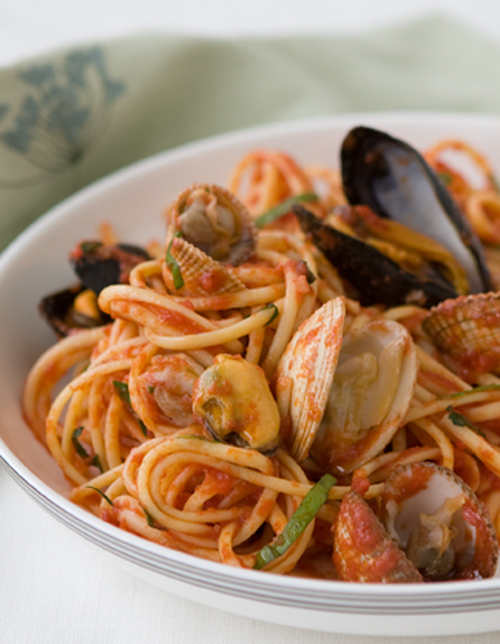
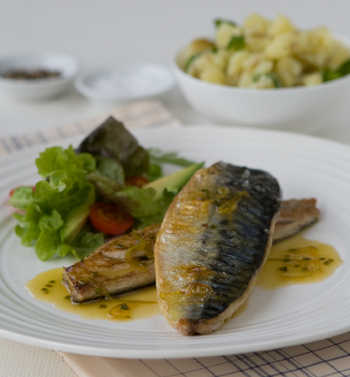 Georgina Campbell
Georgina Campbell
Summer by the seaside means lots of fresh fish and seafood - and fortunately the best way to treat good seafood is simply, so these recipes are perfect for those summer evenings when you just want something easy and tasty.
Whether at home or away, pasta is especially handy for summer cooking and, like fish, it cooks quickly, so there are two great pasta dishes here - and most of the ingredients will already be in your kitchen, otherwise they are easy to find.
All recipes are from our fish cookbook ‘From Tide To Table’ (which is currently out of print - but not for long, we hope!)
Mackerel with Citrus Dressing
Mackerel is the ultimate summer holiday fish, and this is a simple - but still a bit special - way to cook this healthy oil-rich fish that is naturally low in saturated fat, full of vitamins and minerals, and an excellent source of essential Omega-3 fats. You could also use herring fillets for this recipe. Serves 4.
8 mackerel fillets
4 tbsp freshly squeezed orange juice
2 tbs fresh lemon juice
2 tbsp fresh lime juice
4 tbsp olive oil
1 tbsp snipped fresh chives or flat-leaf parsley
salt and freshly ground black pepper
Preheat the grill. Arrange the mackerel on the grill rack skin side up and cook under a medium heat for 5-7 minutes, or until cooked through. Some fillets of mackerel may be thicker than others, the thicker the piece of fish the longer it will take to cook. If necessary, turn once during cooking.
Whisk the orange, lemon and lime juice together in a small bowl with the olive oil and chives or parsley. Arrange the cooked mackerel fillets on warmed plates and drizzle over the citrus dressing. Serve with a lightly dressed salad and crushed new potatoes.
 Smoked Salmon Tagliatelle with Parmesan Cream
Smoked Salmon Tagliatelle with Parmesan Cream
For such a simple dish, this turns out very stylishly, and smoked salmon makes a great convenience ingredient. There is a general rule that you should never add Parmesan to a fish-based pasta dish, but this recipe is an exception to the rule. Serves 4-6
350g/12oz tagliatelle
225g/8oz sliced smoked salmon
4 tbsp torn fresh basil plus extra to garnish
300ml/1/2 pint double cream
6 tbsp freshly grated Parmesan
sea salt and freshly ground black pepper
Cook the tagliatelle in a huge pan of boiling salted water - the bigger the pan the less chance of sticking - give it a stir occasionally! This can take between 8-13 minutes from boiling - check with the packet instructions, as they vary.
Cut the smoked salmon into long strips and mix with the basil. Pour the cream into a pan and bring to the boil, then boil for 1 minute until thickening; stir in 4 tablespoons of the Parmesan and season with pepper.
Drain the pasta and toss with the Parmesan cream, finally fold in the smoked salmon and basil mixture until nicely combined. Divide among warmed wide rimmed bowls and garnish with the basil to serve.
 Crab Cakes with Coriander and Chilli
Crab Cakes with Coriander and Chilli
These crab cakes are really delicious and very easy to prepare. There really is no alternative to crab meat but do try to use white meat sourced from a good fishmonger that is in largish chunks rather than lots of little pieces. Or, if you have access to fresh crabs, you can of course cook them yourself. Variation, for a more traditional flavour: Omit the chilli, use parsley instead of coriander and serve with a simple tomato sauce or mayonnaise.
Serves 4
225g/8oz white crab meat, thawed if frozen
50g/2oz spring onions, trimmed and finely chopped
50g/2oz mayonnaise
75g/3oz fresh white breadcrumbs
1 small egg, lightly beaten
1 tbsp chopped fresh coriander
1 small red chilli, seeded and finely chopped
2 tbsp sunflower oil salt and freshly ground black pepper
Red Pepper & Chilli Relish (optional):
2 tbsp olive oil
1 red pepper, halved seeded and chopped
2 red onions, chopped
3 red chillies, seeded
2 tsp sugar
2 tomatoes, skinned and chopped
First make the Red Pepper & Chilli Relish (Makes about 300ml/1/2 pint)
Heat the olive oil in a heavy-based pan. Add the red pepper, red onions and chillies and cook over a low heat for 30 minutes until the vegetables are completely tender but not coloured, stirring regularly.
Sprinkle the sugar over the vegetable mixture and add the tomatoes, then simmer for another 10 minutes until slightly reduced and thickened. Leave to cool and then blend in a food processor or with a hand-blender, to make a thick purée. Season to taste and place in a sterilised jar. Store in the fridge for up to a week, and use as required.
To make the Crab Cakes: Place the crab meat in a bowl with the spring onions, mayonnaise, breadcrumbs, egg, coriander and chilli. Season to taste and mix gently until well combined. Divide the mixture into eight and then shape into crab cakes.
Heat the oil in a heavy-based frying pan. Add the crab cakes and cook for 3-4 minutes on each side until heated through and golden brown. Arrange the crab cakes on plates with some lightly dressed green salad and a good dollop of the red pepper and chilli relish to serve.
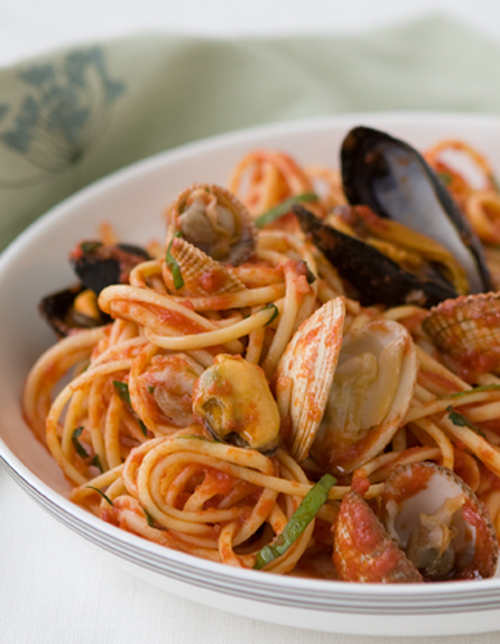 Summer Seafood Linguine Marinara
Summer Seafood Linguine Marinara
An important part of this simple yet very tasty dish is getting the pasta just right, as the slight hardness of the pasta against the soft shellfish is what makes it so special.
Serves 4
1.75kg/4lb mixed shellfish (mussels, clams and/or cockles), cleaned
4 tbsp dry white wine
350g/12oz linguine
4 tbsp olive oil
2 garlic cloves, very finely chopped
1 red chilli, seeded and finely chopped
300ml/ ½ pint passata rustica (crushed tomatoes)
2 tbsp torn fresh basil
2 tbsp chopped fresh flat-leaf parsley
salt and freshly ground black pepper
Place the mussels, clams and cockles in a pan with a lid and pour over the wine. Cover tightly and cook over a high heat for a few minutes, shaking the pan occasionally until all the shellfish have opened - discard any that do not. Strain through a sieve, reserving 150ml/1/4 pint of the cooking liquor, and leaving behind any grit.
Meanwhile, twirl the linguine into a pan of boiling salted water; stir once and then cook for 10-12 minutes until al dente, or according to instructions on the packet.
Heat the oil in a heavy-based frying pan and add the garlic and chilli, then sauté for about 20 seconds. Pour in the passata and add the reserved cooking liquor. Bring to a gentle simmer and then stir in the cooked shellfish with basil and parsley. Season to taste and allow to just warm through.
Rinse the pasta under cold running water and drain well. Return to the pan, then pour in the seafood sauce and fold together until well combined. Divide among warmed pasta bowls and serve at once.
Georgina Campbell's Cookery Feature - Love Your Loaf
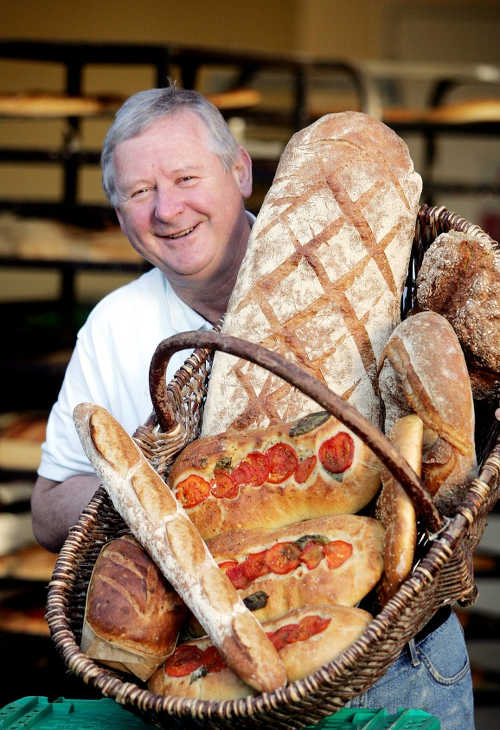
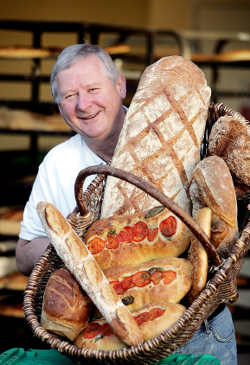 There’s never a bad time to think about the quality of staple food, but this is one of the best when it comes to bread and baking.
There’s never a bad time to think about the quality of staple food, but this is one of the best when it comes to bread and baking.
With the new school year comes the challenge of the daily lunch box, for a start - and one of the best ways to keep it wholesome and interesting is by varying the types of breads that inevitably play an important part in the mix.
Mindful of the squashed sandwiches that so often come back home in school bags, and perfectly timed to help parents to put together healthy and appealing lunches that children will actually eat, Irish Food Writers’ Guild members Lizzie Gore-Grimes and Caroline Hennessy have put together a brilliant piece on school lunch boxes - What’s In Your Lunchbox is available on the Guild website. It’s a fantastic resource with lots of ideas, including a wide selection of online recipes and plenty of things that kids can have fun doing themselves.
It’s not all about bread of course - far from it - but it ties in nicely with National Bread Week which runs from 4th to 10th October; visit www.nationalbreadweek.ie for information all about bread as well as details of participating bakers.
This celebration of our daily loaf is a timely reminder of how good ordinary everyday Irish foods can be, and especially our great baking tradition with its wide variety of breads - some say it’s the best in the world and, with the growing popularity of breads that are new to Ireland, like sourdough, it’s becoming more interesting all the time.
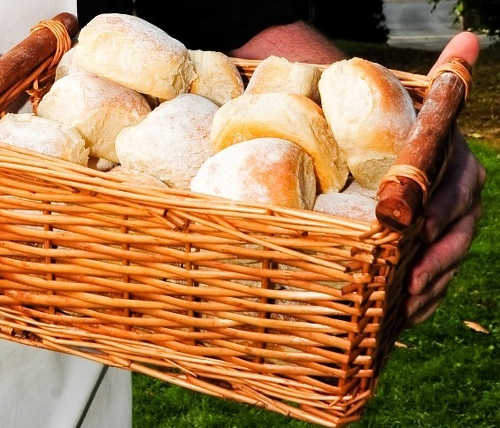 Who would have thought even twenty years ago that the Waterford Blaa would gain European recognition with PGI designation (protected geographical indication), that yeast bread (not part of our own mainstream baking tradition at all) would become part of every home cook’s repertoire, or that sourdough would become the bread of choice in smart cafés and restaurants up and down the country. Declan Ryan of Arbutus Breads in Cork was one of the first to work with sourdoughs, now he’s renowned for his fantastic range of breads - and many other have followed his lead.
Who would have thought even twenty years ago that the Waterford Blaa would gain European recognition with PGI designation (protected geographical indication), that yeast bread (not part of our own mainstream baking tradition at all) would become part of every home cook’s repertoire, or that sourdough would become the bread of choice in smart cafés and restaurants up and down the country. Declan Ryan of Arbutus Breads in Cork was one of the first to work with sourdoughs, now he’s renowned for his fantastic range of breads - and many other have followed his lead.
National Bread Week is organised by FCBA (Flour Confectionery and Bakers Association) and it’s designed to remind us of the versatility of bread and to dispel some of the health myths about bread.
For example, according to dietitian Dr Mary McCreery, “…. many of the facts quoted about bread are based on American bread which is completely different in its composition, particularly its sugar content, to the healthier style Irish bread. Contrary to popular belief bread is good for us – providing protein, folic acid and many nutrients such as dietary fibre, vitamins and minerals.”
So this is a great opportunity to support your local craft baker, enjoy the wonderful simple foods that they produce - and to get into the kitchen and let the therapeutic power of baking do its thing!
RECIPES:
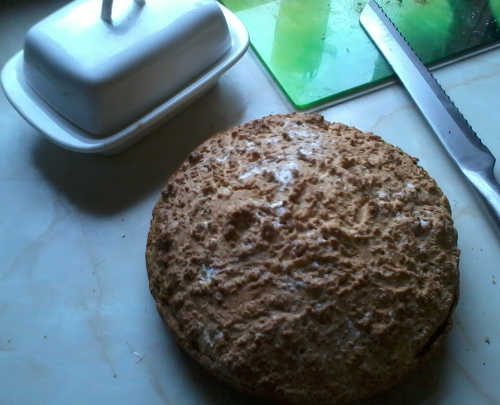 National Bread Week is sponsored by Bord Bia and supported by Rachel Allen, who is urging us all to celebrate Irish bread at home with the whole family. There is a strong tradition of breadmaking in Ireland and, as she says, its versatility makes it ideal for any meal – be it breakfast, lunch or dinner - and it has a firm place as part of a healthy balanced diet. [Follow @loveyourloaf on Twitter/Like us at www.facebook.com/nationalbreadweek]
National Bread Week is sponsored by Bord Bia and supported by Rachel Allen, who is urging us all to celebrate Irish bread at home with the whole family. There is a strong tradition of breadmaking in Ireland and, as she says, its versatility makes it ideal for any meal – be it breakfast, lunch or dinner - and it has a firm place as part of a healthy balanced diet. [Follow @loveyourloaf on Twitter/Like us at www.facebook.com/nationalbreadweek]
Baking is my favourite side of cooking and it’s always been the most enjoyable section of any book that I’ve been involved in - and Granny Nixon's Wheaten Loaf is the most popular of all the variations on brown bread that I’ve come across.
It’s a light brown loaf from the North of Ireland made regularly by my mother-in-law, who handed it on to me. It features in The Best of Irish Breads & Baking (the image was sent by a reader, Jennifer Buscher, who bought it last year and baked the loaf as soon as the book arrived!) and I often find it in restaurants around the country, sometimes credited, sometimes not - it’s very recognisable.
It makes an unusual even-textured loaf with a thin, crisp crust and is one of the quickest to prepare as the wet mixture is simply poured into the tins for baking. It's dead easy and a good loaf by any standards: it's moist, cuts well and keeps surprisingly well for a fat-free soda bread.
Makes two 7"/18 cm round loaves.
12 oz/350g fairly fine wholemeal flour
12 oz/350g plain flour
1 level tablespoonful sugar
2 level teaspoons baking soda
1/2 teaspoon salt
1 pint/600 ml buttermilk.
Preheat a fairly hot oven, 400'F/200'C/Gas mark 6. Grease two 7"/18 cm sandwich tins. Weigh the dry ingredients into a bowl and mix well, then add the buttermilk and mix thoroughly to make a very wet mixture. Pour the mixture into the prepared tins and bake near the top of the oven for about half an hour. When cooked the loaves will shrink slightly from their tins, turn out easily and be crisp on the base. Cool on a wire rack, wrapping lightly in a clean tea towel if you like a softer crust.
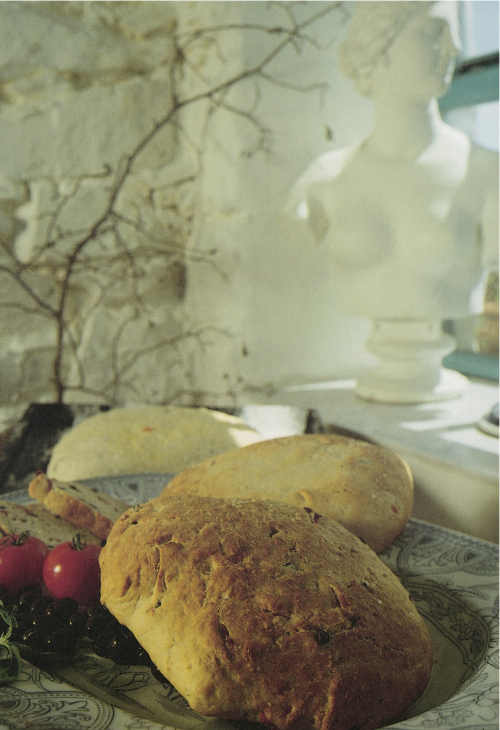 Rathsallagh Tomato & Cheese Bread from Rathsallagh House, Co Wicklow is another recipe given in The Best of Irish Breads & Baking.
Rathsallagh Tomato & Cheese Bread from Rathsallagh House, Co Wicklow is another recipe given in The Best of Irish Breads & Baking.
Kay O’Flynn's variation on yeast bread is baked in loaf tins and is distinctly Mediterranean in character. Interestingly, ‘easy-blend' yeast is used and the mixture is only kneaded once, but when the dough is in the tins they are put into oiled polythene bags and left at ordinary room temperature.
This much slower method of rising the dough compensates for a reduced amount of kneading (and realtively small quantity of yeast for the weight of flour) and allows the gluten in the flour longer to develop, so producing a better texture. The more slowly yeast works on dough, the better the bread will be.
Makes two 1 lb/450g loaves.
1½ lb/700g strong white flour
1 dessertspoon salt
1 sachet easy-blend dried yeast
5 oz/150g hard cheese, grated
9tbsp/135ml olive oil
13 fl oz/ 375ml warm water
3 tbsp/45ml tomato purée
Pinch of cayenne pepper
3 cloves garlic, crushed
2 oz/50g black olives, stoned and chopped.
Sift the flour into a large bowl and mix in the salt and yeast, then add the grated cheese. Mix the olive oil, water, tomato puree, crushed garlic and cayenne together and add to the flour mixture.
Mix with a wooden spoon to make a firm dough, then turn out onto a lightly floured work surface and knead for about 5 minutes until the dough feels elastic.
Oil two 1 lb/450g loaf tins, divide the dough between the two tins, put them into polythene bags and leave to rise in a draught-free place at room temperature for about 4 hours.
Preheat a hot oven, 450'F/220'C/Gas mark 8. When the dough has doubled in size, stud the tops of the loaves gently with the chopped olives.
Bake in the preheated oven for 10 minutes, then reduce the temperature to 400'F/200'C/Gas mark 6 for another 20 minutes. Turn onto a wire rack to cool.
Variation: Top the loaves with 2 thinly sliced tomatoes and reserve a little of the grated cheese to sprinkle over.
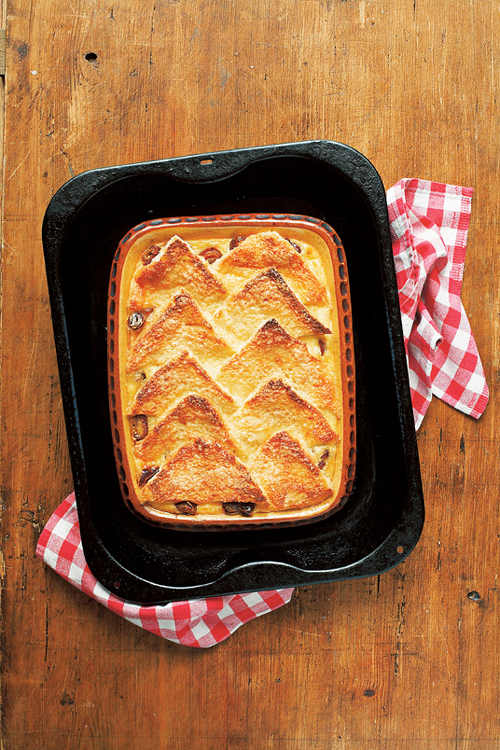 Rachel Allen’s Bread and Butter Pudding
Rachel Allen’s Bread and Butter Pudding
Rachel Allen has plenty of bread recipes at her fingertips, but she points out that bread can also be an excellent ingredient (think brown bread ice cream perhaps…)
“This is one of the older nursery puddings that has enjoyed a terrific revival, but initially it was just a way of using up leftover bread, made with just milk and a scattering of dried fruit,” she says. “But there’s nothing frugal about this recipe – it’s got lots of fruit in it and a generous proportion of cream to milk. When people taste it, they just go ‘Wow!’
I know it has a lot of cream in it, but don’t skimp – just don’t eat it every day! We play around with this formula and continue to come up with more and more delicious combinations, depending on what’s in season and what we have around; see below for some of them.”
Serves 6-8
Ingredients and equipment
• 12 slices good-quality white bread, crusts removed
• 50g butter, preferably unsalted
• 1⁄2 teaspoon freshly grated nutmeg, cinnamon or mixed spice
• 200g plump raisins or sultanas
• 450ml cream
• 225ml milk
• 4 large organic eggs, lightly beaten
• 1 teaspoon pure vanilla extract
• 110g sugar plus 1 tablespoon for sprinkling
• Pinch of salt
1 x 20.5cm square ovenproof pottery or china dish
Method
1. Butter the bread and arrange 4 slices, buttered side down, in one layer in the buttered dish.
2. Sprinkle the bread with half the spice and half the raisins, then arrange another layer of bread, buttered side down, over the raisins, and sprinkle the remaining nutmeg and raisins on top.
3. Cover the raisins with the remaining bread, again, buttered side down.
4. In a bowl whisk together the cream, milk, eggs, vanilla extract, sugar and the pinch of salt.
5. Pour the mixture through a fine sieve over the bread.
6. Sprinkle the tablespoonful of sugar over the top and let the mixture stand, loosely covered, at room temperature for at least 1 hour or chill overnight.
7. Preheat the oven to 180°C/350°F/Gas Mark 4.
8. Place the pudding in a bain-marie and pour in enough water to come half way up the sides of the baking dish. Bake the pudding in the middle of the oven for about 1 hour or until the top is crisp and golden. Serve the pudding warm with some softly whipped cream.
Georgina Campbell's Cookery Feature - Celebrating the Classics
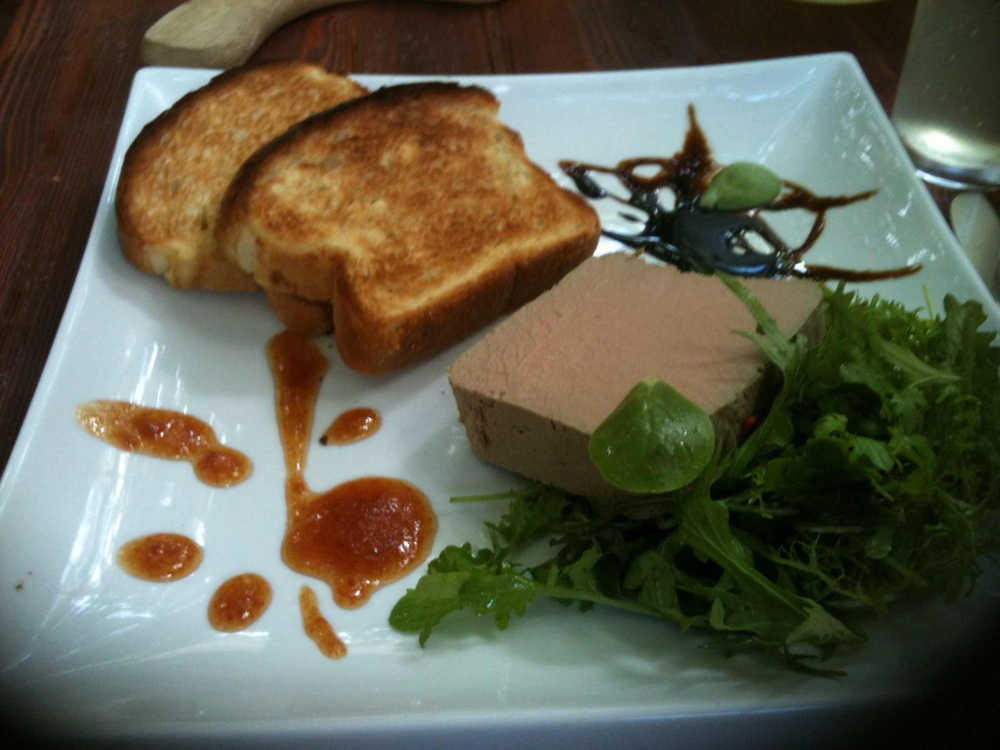
 As new places open, food fashions come and go, and new products flood the market, the pages of the Irish food story are turning with ever increasing speed - and, while the phenomenon is quite rightly a point of great pride, it also tends to make us look back and reassess the value of what has gone before.
As new places open, food fashions come and go, and new products flood the market, the pages of the Irish food story are turning with ever increasing speed - and, while the phenomenon is quite rightly a point of great pride, it also tends to make us look back and reassess the value of what has gone before.
More and more often I find myself actively appreciating the foods, people and businesses that have laid the foundation for the good things we enjoy today. It’s a feeling that is increasingly reflected in our annual Awards, and it seems to be becoming a trend - it was a strong theme at the inaugural Food On The Edge Symposium in Galway last month, for example, which may have surprised delegates who were expecting it to be all about the future.
Where would we be without all those dedicated producers, hoteliers, restaurateurs and chefs who have been there for the long haul. A place like the fifth generation Hunter’s Hotel, in Co Wicklow, for example, is a pearl beyond price and every visit is a joy; nothing ever changes, thank goodness, and they just get on quietly doing the job pretty much as it has always been done.
Throughout Ireland there are countless places with a similar philosophy and we need to treasure them. Some have been celebrating special anniversaries this year - having opened in 1950, Beaufield Mews is an amazing 65, and, while not many can challenge that, there are lots of lovely places that have been around a long time and survived the recession. Ely and Pearl Brasserie have both made unique contributions to Dublin’s restaurant scene for fifteen years, for example, and Rinuccini has made Kilkenny a more exciting dining destination for a quarter of a century.
These and others like them also take enormous pride in cooking the wonderful ingredients that we are so lucky to have in Ireland, often in the classical and traditional - or updated traditional - dishes that never go out of style. Here are just a few to try.
RECIPES: Macreddin Village Duck Liver Parfait
You wouldn’t think so from his youthful demeanour (a trait shared with Patrick Guilbaud) but Evan Doyle’s restaurant at BrookLodge, The Strawberry Tree - which is still Ireland’s only certified organic restaurant - predates the hotel’s 1999 opening by a good few years, going back to its origins in Killarney in the’80s.
Evan’s contribution to Irish food, and that of the team he has built around him, is extraordinary. The wild, seasonal and organic philosophy has held true from the start, and was decades ahead of the current trend. Everything to do with food and drink at BrookLodge is a unique combination of respect for tradition and openness to the future.
A regular treat in the hotel’s lovely Orchard Café, this gorgeous parfait combines tradition, simplicity and attention to detail. “A full fat, creamy and silky smooth Parfait, that’s just perfect to spread over the sweetness of a hot toasted brioche. Accompany it with the tartness of some wild Crab Apple Jelly or Rose Hip Jelly, a handful of baby leaves from Richard Mee’s or Denis Healy’s farms and now you’re ready to invite your friends round for a special lunch… that they will remember!”
400g fresh organic duck livers, sinews removed
500ml organic milk
100ml Orchard Café homemade wine or Madeira
100ml port
60g shallots finely chopped
2 sprigs of thyme
1 garlic clove, peeled and crushed
50ml cognac
5 organic eggs
400g unsalted butter, melted
organic black pepper, Achill Island sea salt
Soak the livers in the milk and add 500ml water with 2tsp salt in a shallow dish for one hour. Rinse & drain well.
Put the wine, port, shallots, thyme, garlic & cognac in a saucepan, bring to the boil and reduce by one-third.
Place the livers and the contents of the pan in a food processor and blitz, adding the eggs one at a time until the texture is silky smooth. Gradually add the melted butter and season. Line a terrine tin, with greaseproof paper or cling film.
Pass the mixture through a sieve into a large bowl and then pour into the terrine tin, cover with greaseproof.
Place the terrine in a deep baking tray and pour boiling water until it reaches two-thirds of the way up the side of the terrine tin. Place the tray in a preheated oven at 130’C and cook for 50 to 60 minutes.
When the parfait is cooked, remove the terrine tin & leave to cool for about 30 minutes. Place in a fridge overnight.
To Serve: Dip the terrine tin into a tray of boiling water to loosen the parfait. Then tip-over the parfait onto a suitable plate and slice with a hot knife. Serve with toasted brioche, seasonal leaves and a tart fruit jelly.
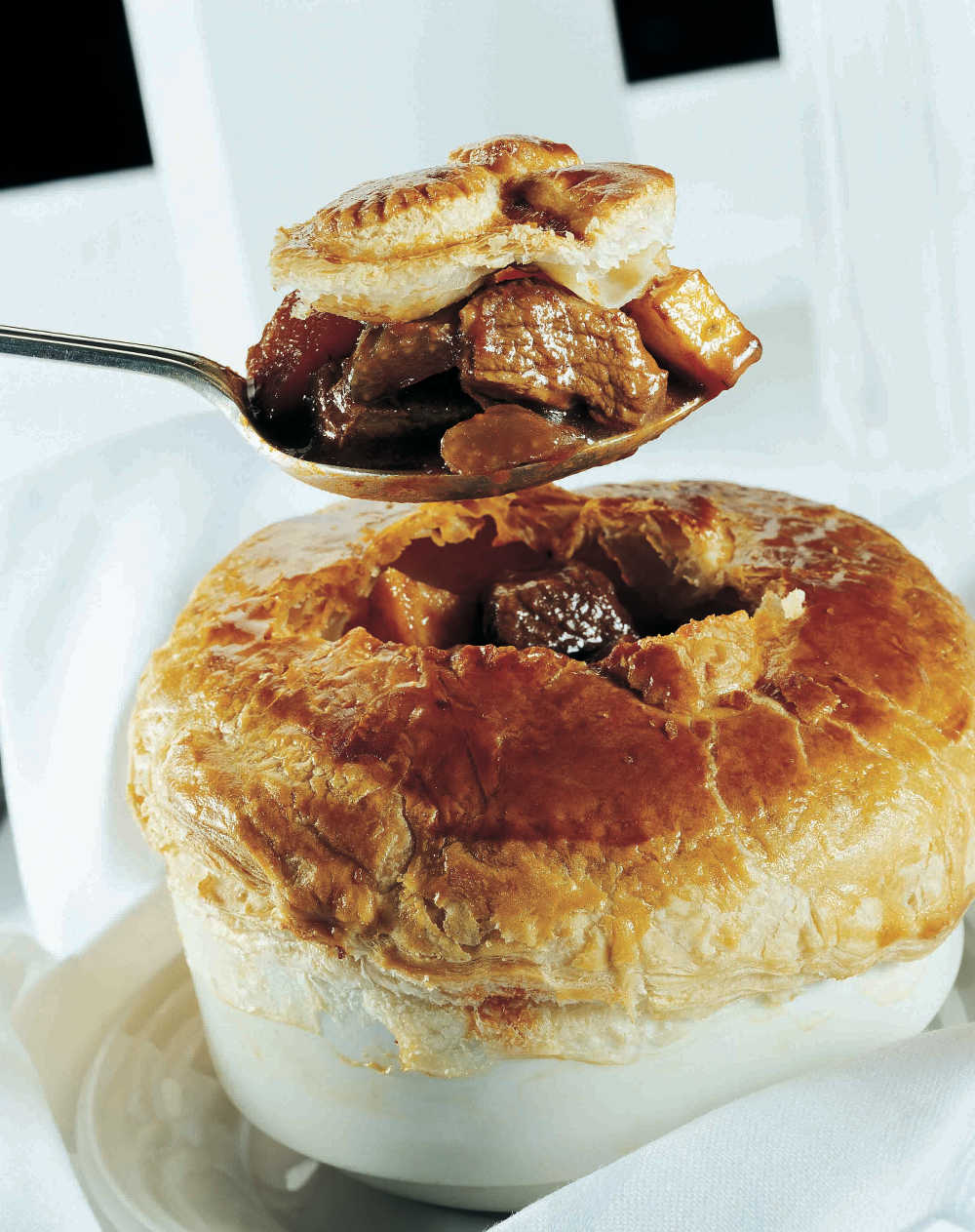 Kerry Lamb Pie
Kerry Lamb Pie
A favourite Ballsbridge destination since 1992, Roly’s Bistro always had upbeat traditional food at its heart, something we were reminded of this summer, when they held a dinner “celebrating the best of Roly’s Classics - from its famous Kerry Lamb Pie, the delicious Dublin Bay Prawn Cocktail, the firm favourite Fish & Chips, to the stunning array of excellent meats and fresh seafood…”.
And, adapted from the cookbook Roly’s Bistro, The Restaurant and Its Food (Gill & Macmillan), this is their very modern take on the traditional Kerry pie. It may be light years away from the original that inspired it, but it’s very tasty nonetheless and is more appealing to today’s diner.
Kerry lamb pies – or, more particularly, Dingle Pies – were modest little mutton pies, not unlike Cornish pasties; the shortcrust pastry was made with mutton fat and the pies were often boiled in mutton stock, rather like dumplings.
Although you will still occasionally find something in the spirit of the original (at Dingle Cookery School, for example, where Traditional Irish Cookery classes are regularly held), today’s modern versions are, like the Roly’s pie, lighter - and probably more palatable too.
The filling for these pies could be made ahead and cooled, leaving only the pastry and oven baking to finish before serving.
Serves 4
10 button mushrooms
2 onions
2 carrots
4 sticks celery
750g/1 lb 9oz diced leg of lamb
1 dessertspoon tomato purée
700 ml/1¼pt good chicken stock
1 teaspoon gravy browning
200ml /7 floz white wine
bouquet garni
4 saucer-sized discs puff pastry, to cover four oven-proof soup bowls
15g / ½oz butter
1 large or two small parsnips, diced and broasted in butter
1 egg, beaten
Salt and freshly-ground black pepper
Cut mushrooms in half and sauté in a little oil for about 10 minutes.
Prepare the vegetables and chop into chunky pieces.
Seal the lamb in a hot saucepan with a little oil, and then season with salt and pepper and cook gently for 4-5 minutes. Add the onion, carrot and celery and cook with the lamb for a further 5 minutes.
Add tomato purée and cook for a further 2-3 minutes, then pour in the chicken stock, gravy browning and white wine. Bring to the boil and simmer gently for about an hour until tender.
Towards the end of the cooking time, add the bouquet garni and the cooked button mushrooms.
Pre-heat the oven to 200°C/400°F/Gas 6.
Roll out the pastry discs, making them slightly bigger than serving bowl.
Pan-fry the parsnips in some butter until tender. Ladle the lamb pie filling into the bowls, top with parsnips and cover with the pastry.
Brush with beaten egg and bake for 20 minutes, until pastry is golden brown. Serve immediately, with seasonal vegetables on the side.
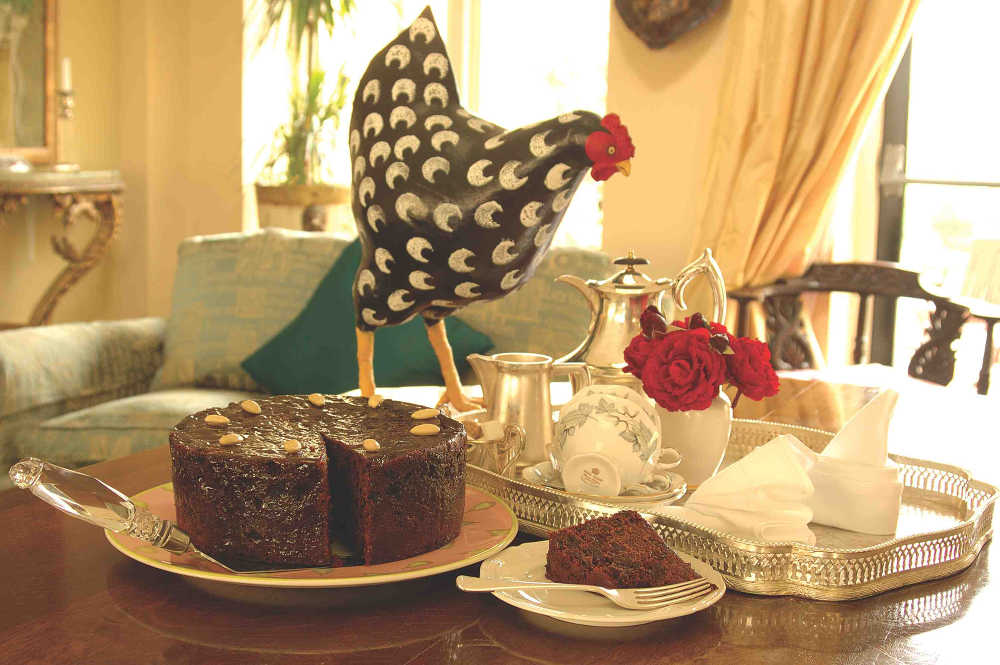 The Mustard Seed Porter Cake
The Mustard Seed Porter Cake
Dan Mullane’s beautiful Co Limerick country house and restaurant, The Mustard Seed, has wowed admiring guests for thirty years. It started out as a restaurant in nearby Adare in 1985, then moved to its present home at Echo Lodge in Ballingarry ten years later.
Like all the best places, the secret of its success lies in the combination of things that stay the same - the genuine hospitality, comfort, commitment to using the best local foods in season - and constant improvement which, in this case, includes exceptional dedication to the gardens, both ornamental and productive.
The cooking at The Mustard Seed is modern Irish, but there are plenty of traditional treats too, including some delicious breakfast specialities and great baking - like this porter cake, which is served on arrival to guests staying overnight, or as ‘an afternoon indulgence’. Porter is a lighter form of stout that was once very popular, but bottled stout does very well as an alternative in baking.
Makes one 8 inch / 20cm cake
1 lb/450g white flour
1 pinch of salt
1 tsp baking powder
8oz/225g soft brown sugar
½ tsp nutmeg, freshly grated
½ tsp mixed spice
8oz/225g butter, diced
8oz/225g sultanas
8oz/ 225g currants
2oz/50g chopped candied peel
2oz /50g crystallised cherries
1/2 pint / 300ml stout (eg Guinness)
2 medium eggs, lightly beaten
Preheat a moderate oven, 350°F / 180°C / gas mark 4.
Line the base and sides of a deep 8-inch / 20 cm cake tin with baking parchment.
Sieve the flour, salt and baking powder into a bowl. Add the sugar, nutmeg and spices. Rub in the butter (by hand, or with a mixer).
Add the fruit. Combine the stout and beaten egg, then pour into the cake mixture and mix well.
Turn into the lined tin and bake in the preheated oven for about 2½ hours, or until the cake is nicely browned and feels springy to the touch.
Cool in the tin, then remove the baking parchment and store in an airtight container to use as required.
Georgina Campbell's Cookery Feature - Christmas Cooking by The Book
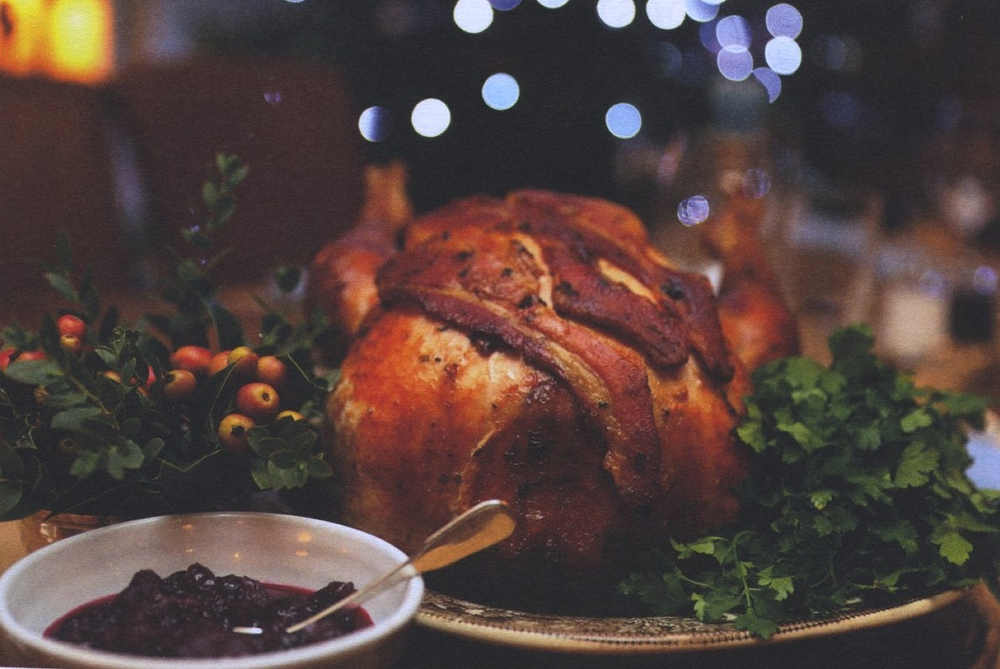
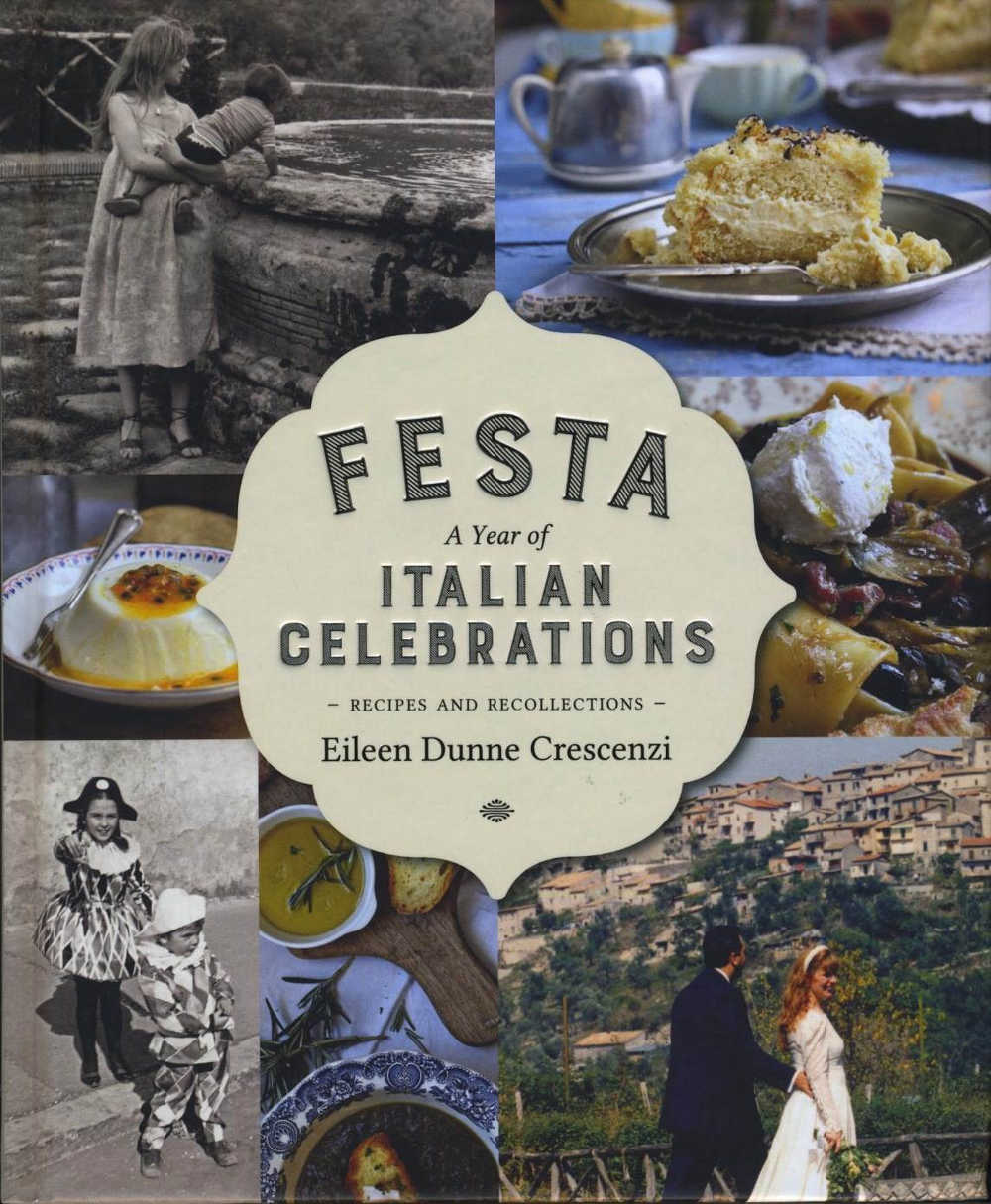
Christmas is coming and the cooking is getting complicated - or maybe not.
If you’re looking for ways to simplify the annual feast without losing the sense of tradition that makes it so special, why not try the menu below, which is taken from some of this autumn’s best new cookery books and offers light starter and dessert options and a sensibly straightforward rendition of the indispensable roast turkey.
First though, in time honoured tradition, there is some baking to be done - and who better to advise than Eileen Dunne Crescenzi, who gives this lovely Italian Christmas cake, Pandolce, in her delightful (and highly practical) book Festa, A Year of Italian Celebrations (Gill & Macmillan hardback, €24.99).
It’s one of my favourite new books and would make a terrific present for anyone (including yourself) who has a grá for things Italian, can’t resist the temptations offered at the much-loved Irish restaurants that Eileen and her husband Stefano run - or who simply enjoys a romping good read, as it is as much a memoir of happy time spent in Italy as a festive food book. Highly recommended.
 Pandolce
Pandolce
“Pandolce (sweet bread) is a homely alternative to the traditional shop-bought panettone cake. I have adjusted the recipe a little to make it more orange, sweet and, dare I say it, delicious. Incorporating good-quality chocolate drops adds a touch of decadence.”
Serves 12
250g butter, softened
250g caster sugar
2 free-range or organic eggs, beaten
zest and juice of 1 orange zest and juice of 1 lemon
500g self-raising flour
1 level teaspoon baking powder
400g mix of sultanas and raisins
25g candied fruit
25g pine nuts
25g roughly crushed hazelnuts, walnuts or pistachios
2level teaspoons ground cinnamon
1 level teaspoon grated nutmeg
For the glaze:
200g caster sugar
zest and juice of 2 oranges
Preheat the oven to 175°C. Grease a 23cm springform baking tin.
Cream the butter and sugar until it's light and fluffy. Add the eggs one at a time, mixing well to incorporate them each time. Mix in the orange and lemon juice and zest, then stir in the flour and baking powder. Add the raisins and sultanas, candied fruit, nuts, cinnamon and nutmeg. Mix well to a creamy consistency. Pour the batter into the greased baking tin.
Bake in the oven for 1 hour, until a skewer inserted in the centre comes out clean. Leave to rest for 10 minutes before releasing the cake from the tin. Leave to cool on a wire rack.
To make the glaze, place the sugar, orange zest and juice in a small saucepan. Bring up to a simmer and cook for 10 minutes over a low heat, until the sugar has dissolved and the syrup has thickened. Pour over the cake.
xxxxxxxxxxx
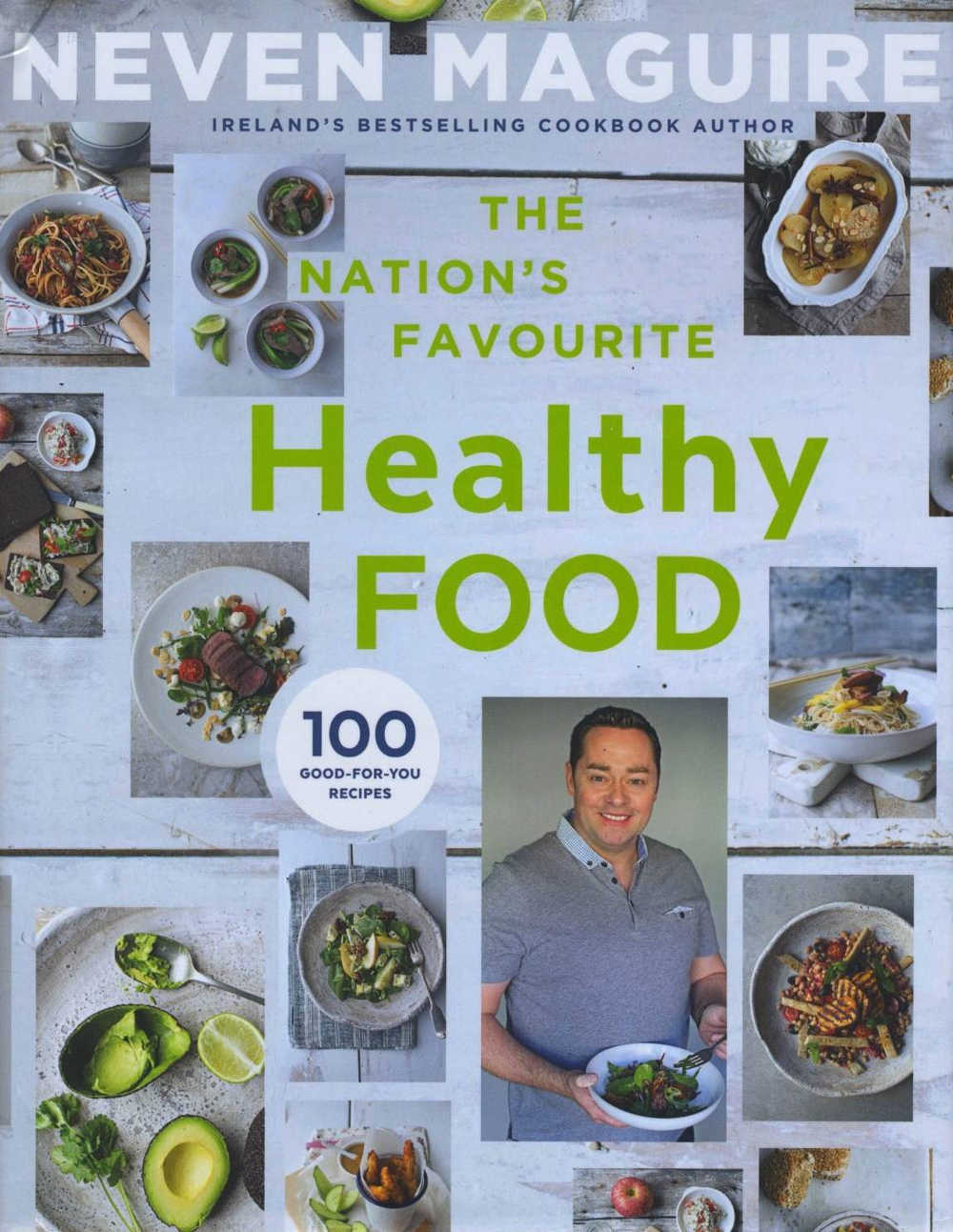 Not too many months go by without a new book by Neven Maguire appearing in the bookshops, and this time he offers 100 Good-For-You Recipes in The Nation’s Favourite Healthy Food (Gill & Macmillan hardback, €22.99).
Not too many months go by without a new book by Neven Maguire appearing in the bookshops, and this time he offers 100 Good-For-You Recipes in The Nation’s Favourite Healthy Food (Gill & Macmillan hardback, €22.99).
The wide-ranging contents include everything from Juices, Soups and Saintly Snacks to Low Carb Lunches, Takeaway My Way, Free From dishes and those all-important Lunchboxes and Kids’ Favourites.
All the main meat, fish and poultry ingredients are well covered and, while the most important message about healthy food is that it’s the everyday habits that really count, there’s no harm in introducing one or two light and healthy courses into the year’s biggest feast.
Most of us will enjoy the meal far more if there is less of it, and lightening up the starter and dessert could make a big difference. There’s no need to dump that delicious plum pudding, but it is nice to have a choice.
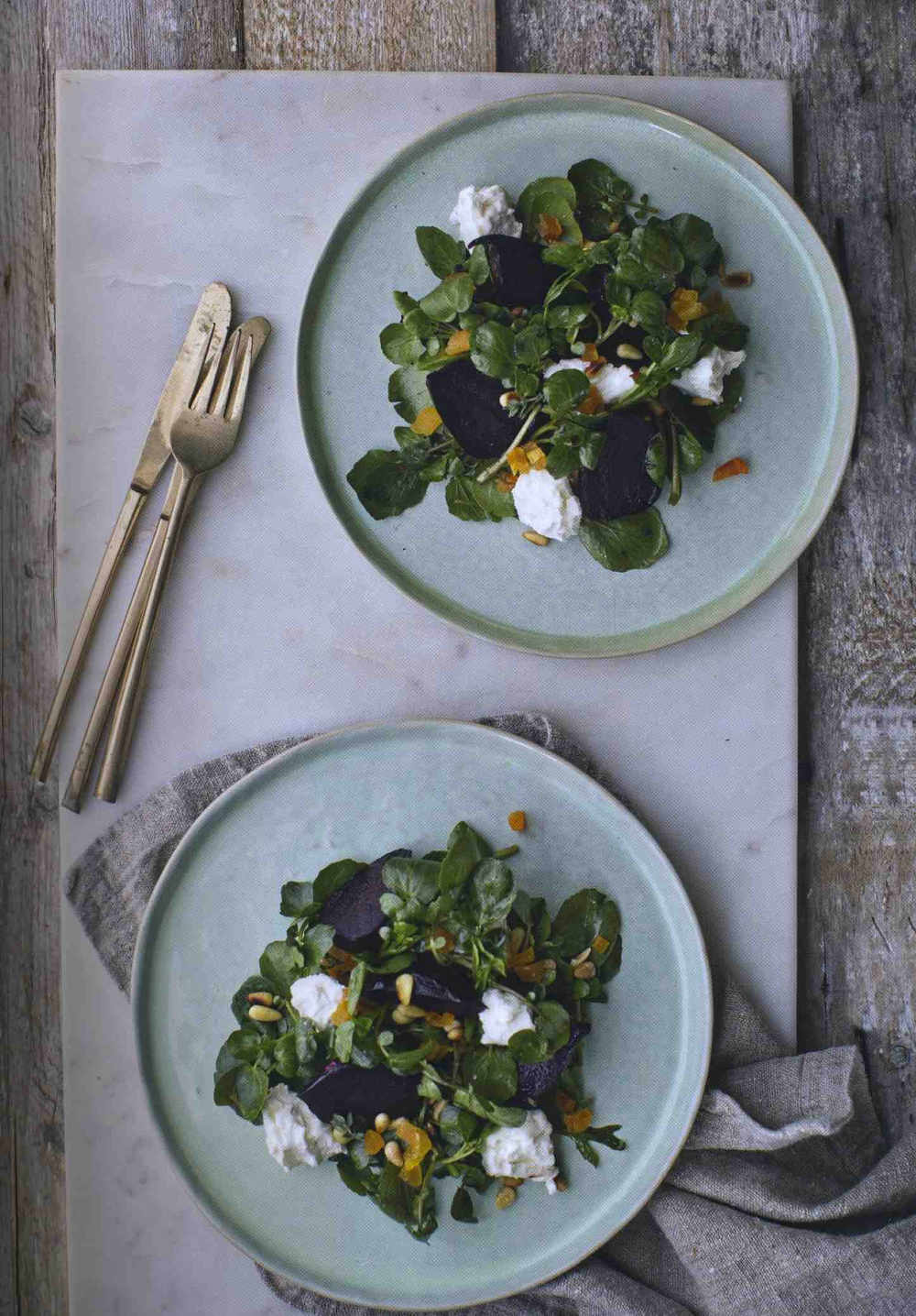 Roasted Beetroot, Feta and Watercress Salad
Roasted Beetroot, Feta and Watercress Salad
“You could use a jar or vac-pack of cooked baby beetroot, but the ones you roast yourself are so much more delicious and even better a day later, when the flavours have developed. Watercress works so well with beetroot, but you could use rocket or a mixture of leaves from a bag, such as watercress, spinach and rocket.”
Scale up the ingredients as required if serving as a starter for a large gathering
Serve 4-6
100g (40z) watercress
100 (4oz) feta cheese, crumbled
50g (2oz) ready to eat dried apricots, finely diced
2 tbsp toasted pine nuts
Roasted Beetroot:
500g (1lb 2oz) small raw beetroot, peeled
1 tbsp clear honey
2 tsp balsamic vinegar
Dressing:
1 tbsp sunflower oil
1 tbsp olive oil
1tbsp good quality sherry vinegar
1 tbsp clear honey
½ small red chilli, seeded and finely diced
sea salt & freshly ground black pepper
Preheat the oven to 200°C (400ºF/gas mark 6).
Cut each beetroot in half or into quarters until they are all evenly sized. Whisk together the olive oil, honey, balsamic vinegar and thyme, drizzle over the beetroots and season to taste.
Toss until all the beetroot is thoroughly coated. Roast for 40-45 minutes, until cooked through and glazed. Leave at room temperature to cool.
Put all the dressing ingredients in a screw-topped jar and season with salt and pepper, then shake until emulsified.
Arrange the watercress on plates or use one large platter. Sprinkle over the cooked baby beetroots, feta, apricots and pine nuts. Just before serving, drizzle over the dressing.
xxxxxxxxx
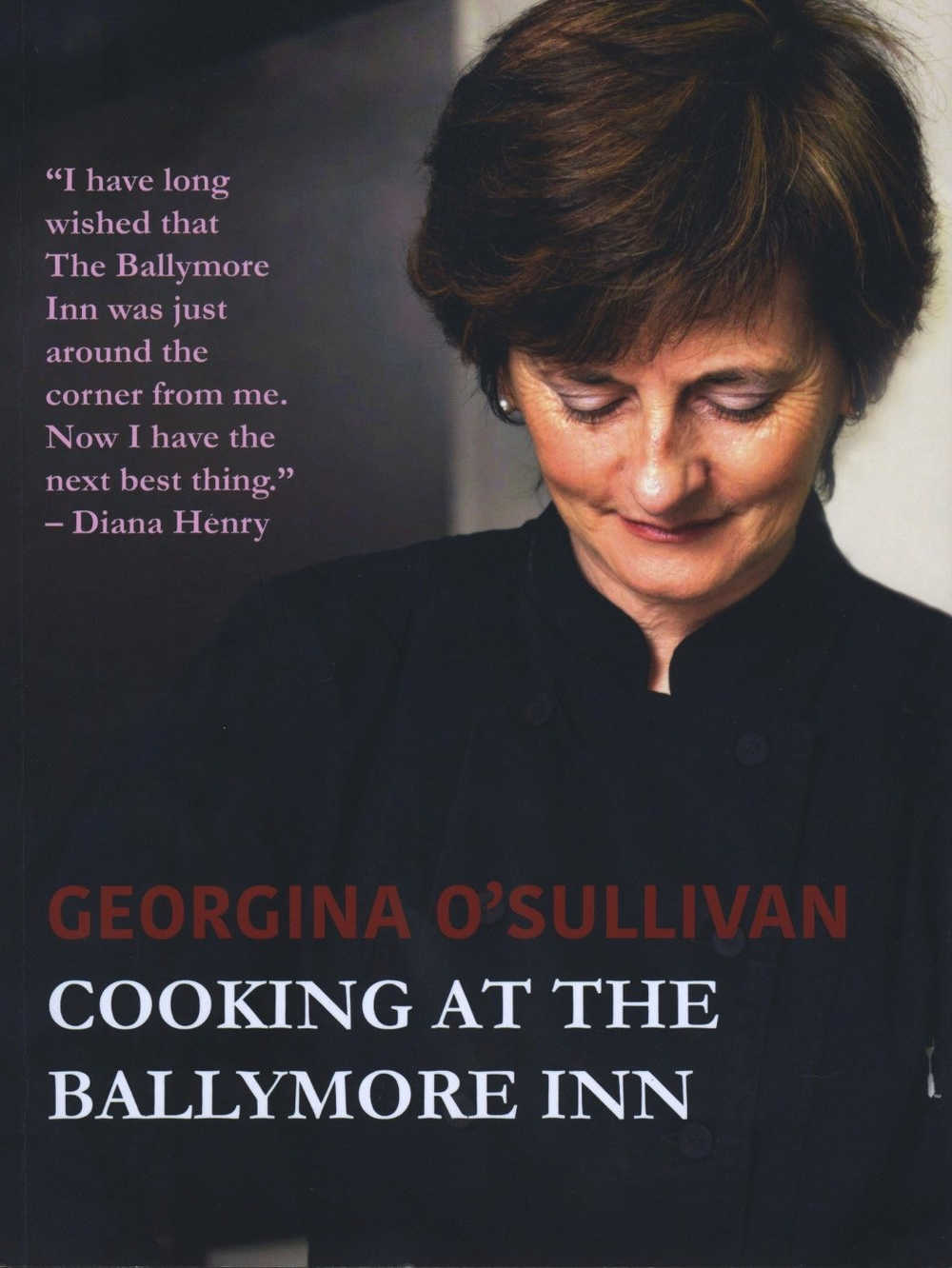 Legendary former head of the Cookery Centre at Bord Bia, Georgina O’Sullivan earned a national following for her imaginative yet no nonsense recipes (often accompanied by superb images by Walter Pfeiffer) and trail blazing commitment to using the best local ingredients.
Legendary former head of the Cookery Centre at Bord Bia, Georgina O’Sullivan earned a national following for her imaginative yet no nonsense recipes (often accompanied by superb images by Walter Pfeiffer) and trail blazing commitment to using the best local ingredients.
Since then she and her husband Barry have attracted a growing army of fans to their Co Kildare café-bar, The Ballymore Inn, and, unsurprisingly, customers have long been pleading for a cookbook.
And now, to celebrate their 20th anniversary, it is here. Cooking At The Ballymore Inn (Estragon Press, paperback; €20 + p&p www.ballymoreinn.com/book-offer) will make a lot of people happy.
Summing up the philosophy that has made her one of Ireland’s most admired cooks, Georgina says “My love affair with food started many years ago in my grandmother’s kitchen in Ballyvaughan, County Clare. There I learned that the foundation of any great dish is carefully selected ingredients infused with imaginative simplicity. I have carried this belief through my career and it continues to ring true in the kitchen of The Ballymore Inn today.”
Fortunately for home cooks, that also carries through to mean straightforward do-able recipes, and one of Georgina’s particular talents is to write recipes that leave nothing out - and even include plenty of hints and tips - yet are always succint. (The Christmas turkey recipe below is a good example.)
And what a well-earned compliment for her to have an endorsement from the like-minded and much-celebrated food writer, Diana Henry, on the cover. (Feted at the UK Guild of Food Writers’ awards this year, Diana received both the Cookery Journalist of the Year and Cookery Book of the Year Awards, the latter for A Change of Appetite; Mitchell Beazley.) The Ballymore Inn was also one of a very small number of Irish pubs chosen a few years ago for inclusion in Diana’s excellent Gastropub Cookbooks.

Georgina O’Sullivan’s Christmas Turkey With Lemon & Thyme Stuffing
“The festive bird is not nearly as difficult as it might seem. First, choose the best quality turkey you can find — the best weight is 5-6kg for 10-12 servings, plus leftovers. Calculate the cooking time at 15 minutes per 450g (lb) and 15 minutes over but, best of all, use a digital probe to check that the meat in the centre of the breast or thigh joint (not the bone) has reached 75°C. Buy the probe when you buy the bird! Then leave it to rest, covered with foil and a towel, for up to an hour. The stuffing can be made a day or two ahead and kept in the fridge - don’t stuff the turkey until you are ready to cook and don’t wash the turkey.”
Serves 10-12
5-6kg turkey
large roasting tin
250g butter, room temperature
8-10 streaky rashers
lemon & thyme stuffing
I80g butter, room temperature
1 large onion, finely chopped
2 lemons
300g soft breadcrumbs
5-6 tablespoons flat-leaf parsley, chopped
1 tablespoon thyme, chopped
salt & black pepper
gravy
glasses of red wine 250ml chicken stock
tablespoons redcurrant jelly generous knob of butter
salt & black pepper
To make the stuffing, melt a tablespoon of the butter in a medium pan and sauté the onion gently for a few minutes but don't colour. Grate the zest of both lemons then juice just one. In a large bowl mix the breadcrumbs with the onion, zest and lemon juice, parsley and thyme. Add the remaining butter and mix thoroughly, season well. Set aside until you are ready to roast the turkey.
Set the oven to Gas 4/180°C. Sit the turkey on the roasting tray, put the stuffing in the cavity, but keep a couple of tablespoons back for the neck cavity. Sew it up or use skewers to seal the stuffing inside. Spread the butter over the breasts and cover with the streaky bacon, then cover the turkey with foil and place in the preheated oven.
It is worth basting the turkey with the cooking juices every 45 minutes. A glass of wine can be added for the last hour; remove the foil also at this point to ensure the skin browns well. Check the temperature of the turkey is 75 °C, then remove from the oven and leave to rest for an hour.
To make the gravy, to the remaining pan juices, add the other glass of wine and boil up, stirring well to gather up the caramelised bits. Add in the stock and redcurrant jelly then simmer gently until well dissolved. Check the seasoning and strain into a smaller pan or gravy boat for serving.
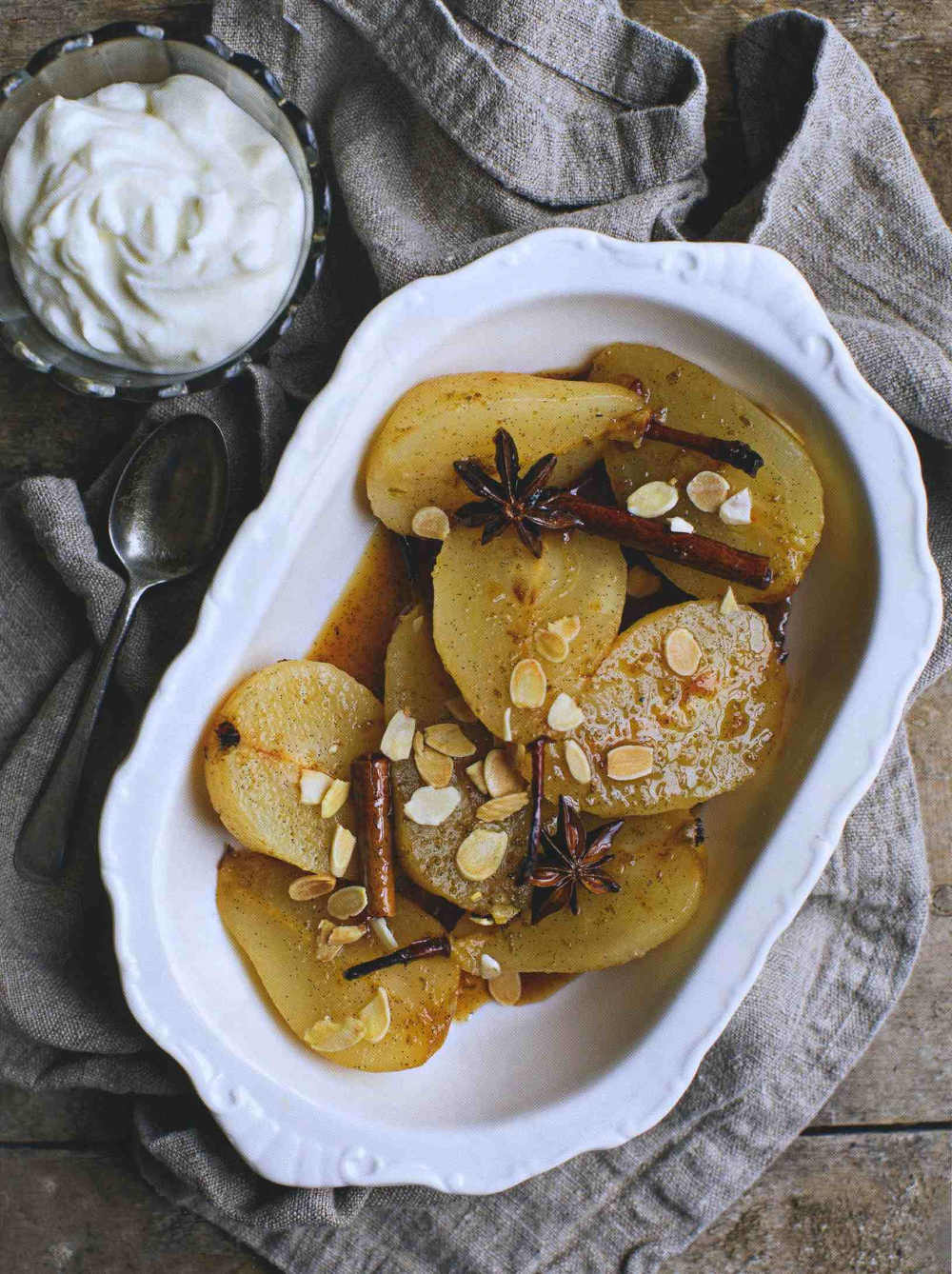 Spiced Poached Pears with Creme Fraiche and Toasted Almonds
Spiced Poached Pears with Creme Fraiche and Toasted Almonds
Another healthy dish from Neven Maguire’s new book, The Nation’s Favourite Healthy Food, to round off the meal.
“This delightful dessert will revive even the most jaded palate. The pears improve with keeping, making this an excellent dessert for entertaining. Choose fruit that is perfectly ripe but still quite firm so the flesh doesn't go mushy while you are preparing them.”
Like the starter salad, this dish can easily be scaled up for larger numbers.
Serves 4
2 tbsp honey
4 firm, ripe pears
2 tbsp toasted flaked almonds
l00g(4oz) creme fraiche
Place the apple juice in a deep-sided pan with a lid (the pan needs to be just large enough to hold the pears in an upright position). Add the lime juice and rind, star anise, cinnamon stick, vanilla pod and honey. Bring to the boil, then reduce the heat and simmer gently for a few minutes to allow the flavours to infuse.
Meanwhile, peel the pears, leaving the stalks attached. Add them to the pan, standing them in an upright position. Cover with the lid and simmer gently for 20-25 minutes, until the pears are tender, basting them from time to time with the liquid. Remove from the heat and leave to cool in the syrup. The cooking time will depend on the ripeness of the pears.
Using a slotted spoon, transfer the pears to a dish and set aside. Reduce the cooking juices by half to a more syrupy consistency. This will take 8-12 minutes. Strain into a jug and leave to cool.
To serve, carefully cut each pear in half so that you don't spoil their beautiful shape. Place the pear halves on a serving platter and drizzle over the spiced syrup. Scatter over the toasted flaked almonds and serve with a separate bowl of creme fraiche.
Georgina Campbell's Cookery Feature - Down to Earth Cooking
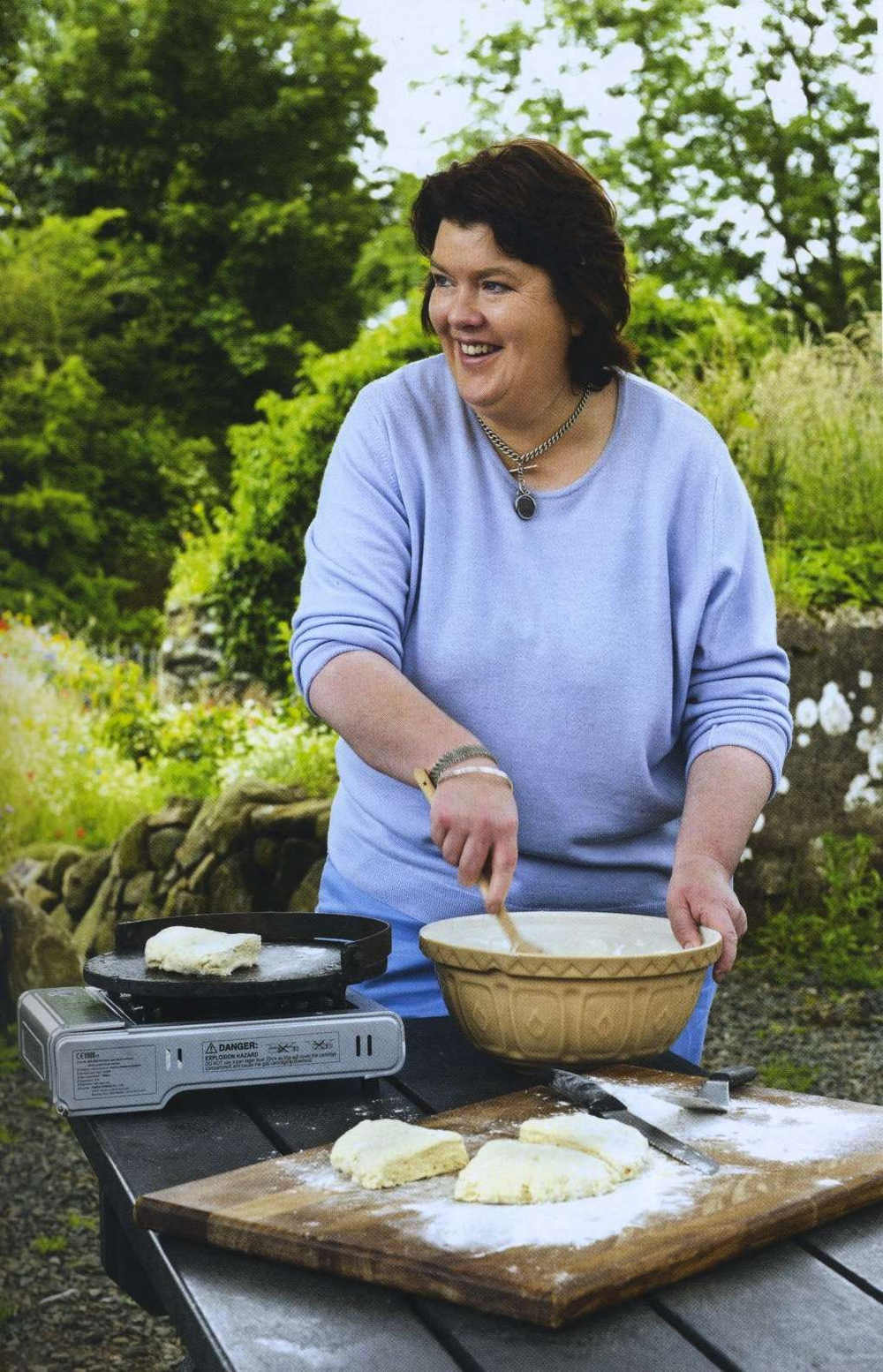
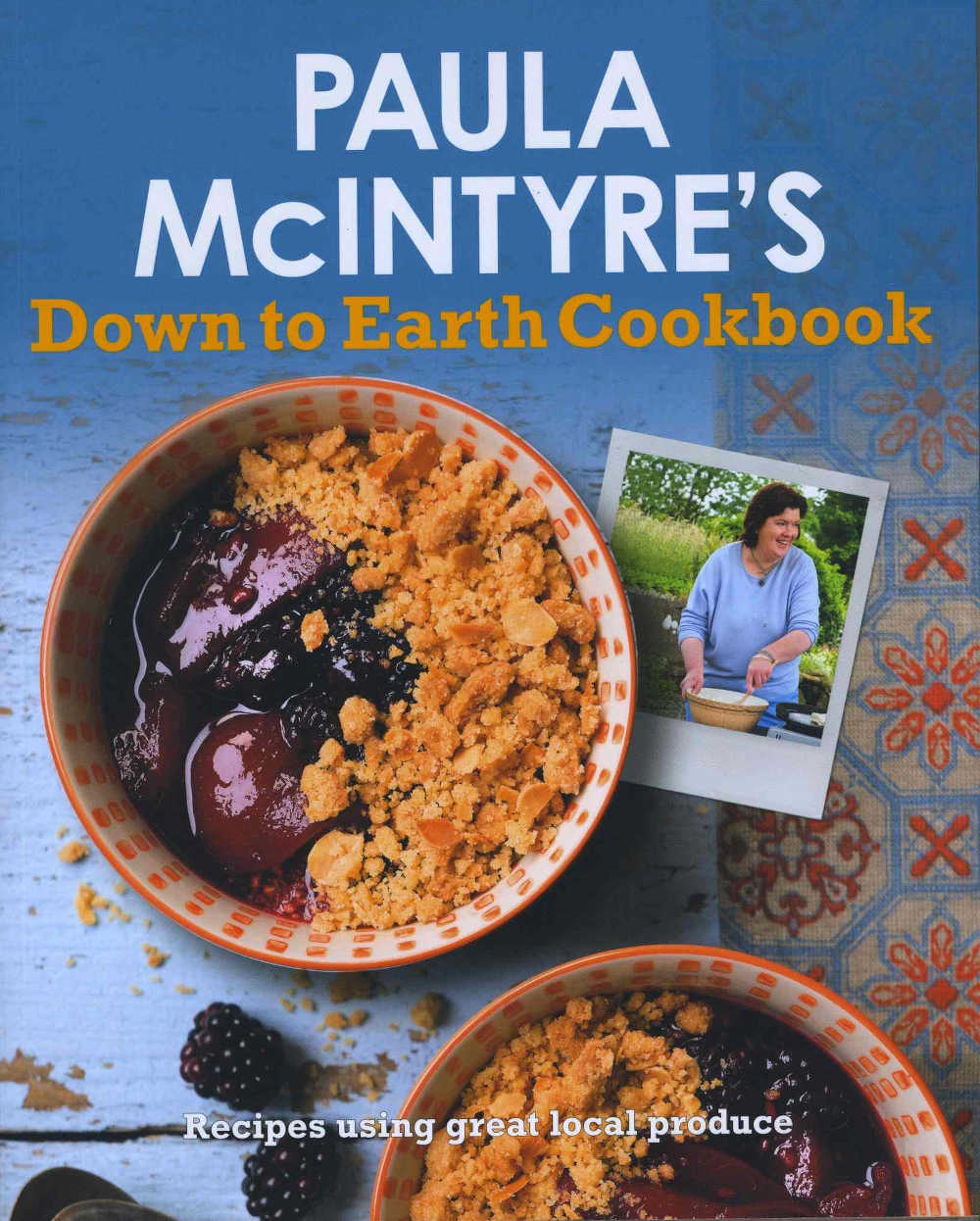 Georgina Campbell
Georgina Campbell
Who better to kick off 2016 - the NI Year of Food and Drink - than Northern Ireland’s best loved food writer, Paula McIntyre, disseminator of good sense on John Toal’s Saturday Magazine programme on BBC Radio Ulster and much else besides. Through her timely and aptly-named Down To Earth Cookbook (Colourpoint, £9.99), a curious newcomer would get a very good feeling for the distinctive flavour of the region’s food - and the nature of its cooks.
And what is it about North Antrim, I wonder, that it has produced such extraordinary female chefs - to take just three examples, I noticed with interest the other day that Paula McIntyre, Trish Deseine and the high-flying yet delightfully down to earth Clare Smyth MBE (Chef Patron at London’s Restaurant Gordon Ramsay) all come from small farming communities ‘up there’, and almost within a cockerel’s call of each other at that. Which says a great deal about the quality of both the ingredients and the cooking in their childhood kitchens.
Much will be said and written about the food of Northern Ireland in the coming year and praise is well deserved. It really is a place apart. I knew that from the moment I arrived at Aldergrove airport as a student many moons ago, to see the famous hares leaping all over the grass - they featured recently on Countryfile, and it was lovely to hear that they are still entertaining passengers today.
On the food front in those days, there may not have been the ‘choice’ that we have today but the sheer quality of easily available ingredients allowed us to eat simply yet very well - terrific breads, fresh vegetables and meats, especially great pork products, and, as an occasional treat, superb beef from Sinnamons of Donegall Pass.
Wooden boxes overflowing with wonderful earthy vegetables also played starring roles - and the best treats were conveyed, it must be acknowledged, by the gentleman caller, and now husband of several decades. Food was definitely the way to this woman’s heart, and the cooking of it to his.
Despite the huge changes in shopping (and eating out), the essence of that local food quality remains true today, for the careful shopper at least, and there are many specialities that other regions would give anything for.
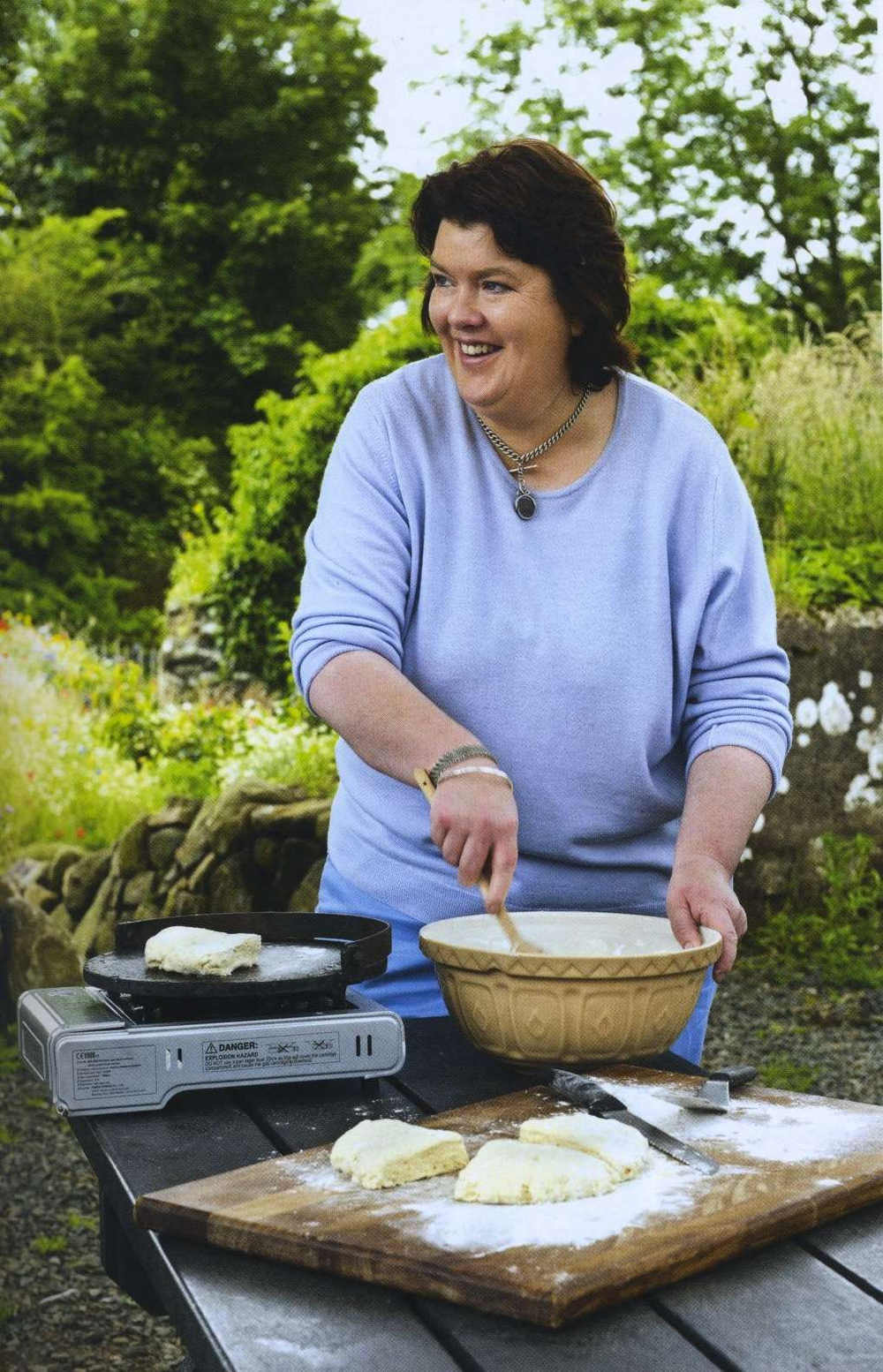 The baking tradition in Northern Ireland is still very strong and ‘different’ (see Paula’s soda farls, below), and the region’s superb produce includes specialities like Lough Neagh Eels (see recipe below- which is fancy, but a simpler alternative is suggested), Comber Earlies and Armagh Bramley Apples, all of which have been awarded Protected Geographic Indication (PGI) status by the European Commission.
The baking tradition in Northern Ireland is still very strong and ‘different’ (see Paula’s soda farls, below), and the region’s superb produce includes specialities like Lough Neagh Eels (see recipe below- which is fancy, but a simpler alternative is suggested), Comber Earlies and Armagh Bramley Apples, all of which have been awarded Protected Geographic Indication (PGI) status by the European Commission.
And, while the pork butcher may be a thing of the past, alas, world class meats are produced here - one has only to think of the Glenarm Shorthorns, Dexter and even Irish Moiled beef (the latter from Pheasants’ Hill Farm, Co Down), or a village like Moira, where you can find leading meat suppliers like McCartneys and Hannan’s just yards from each other, to understand the sheer quality and pride that underlies the exciting recent developments in Northern Ireland’s food culture.
Fish too - just visit St George’s Market on a Saturday to see a display of beautiful sea fish that would be hard to match anywhere in Ireland - and then of course there are the specialities such as salmon (notably organically farmed at Glenarm, excellent both fresh and smoked), prawns (langoustine) and hand dived scallops from Strangford Lough...
Even herbs and flavourings have their own distinction in the North: ‘soup celery’, for example, is mentioned by Paula in her recipes below. Like a cross between celery and parsley, it is grown for its strongly flavoured leaves and is a commonly used ingredient in Northern Ireland, yet little known elsewhere.
How fortunate that we are only at the start of Northern Ireland’s Year of Food & Drink - there is so much more of interest to explore.
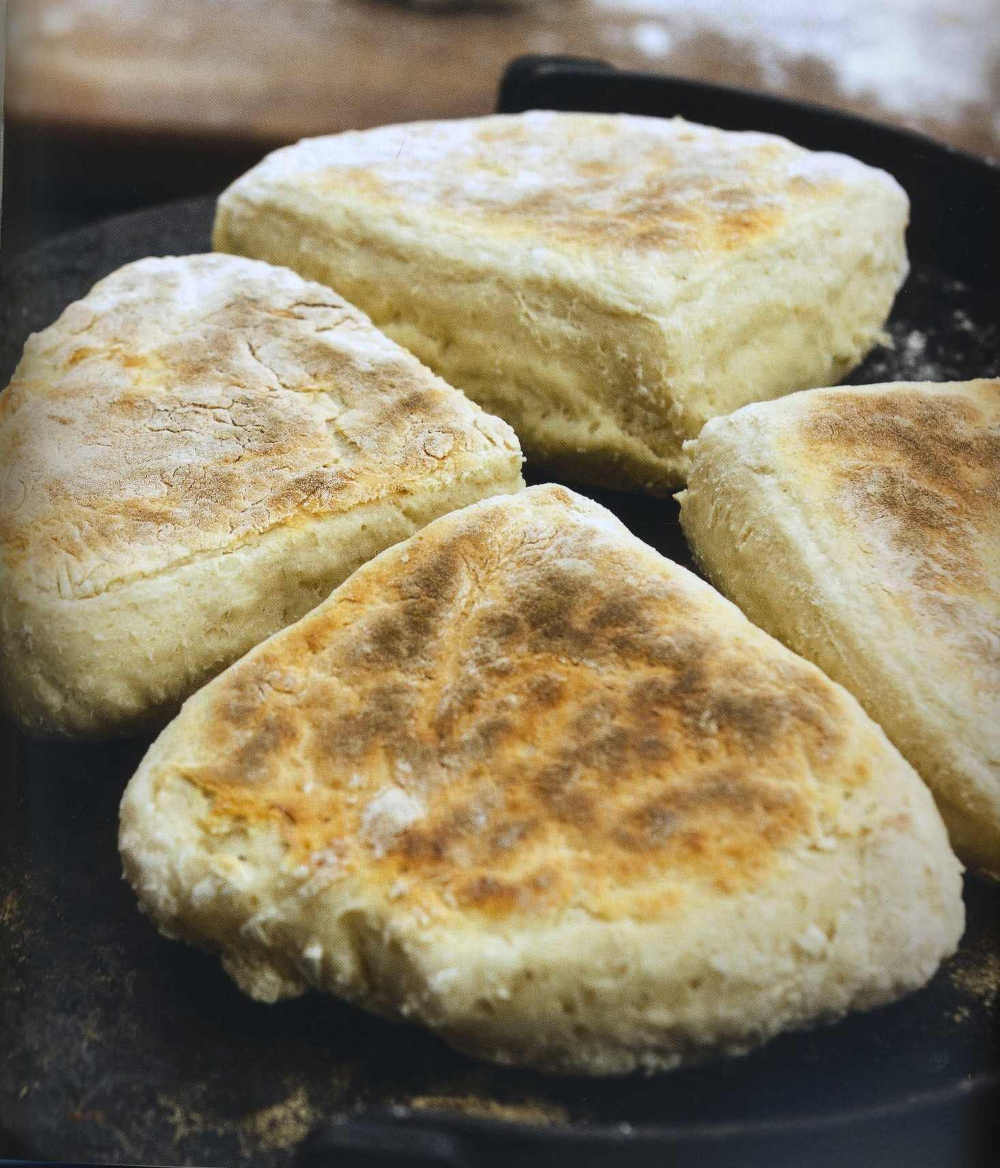 PAULA MACINTYRE’S Down to Earth Cookbook RECIPES:
PAULA MACINTYRE’S Down to Earth Cookbook RECIPES:
Treacle soda farls
“Sticky, tar-like treacle adds rich, sweet and bitter notes to baking. Ginger cake would not have the same appeal without the addition of treacle and by the same token it adds so much to a traditional soda farl. Farls are deep rooted in our bread culture in Northern Ireland. You won't find this indigenous staple anywhere else except here. The recipe is simple, taking plain flour, salt and baking soda, and mixing with buttermilk to a soft dough.
It is then gently coaxed into a flat round, cut into quarters and cooked gently on a griddle. Adding some treacle gives the bread a splendid amber glow and a tangy, honey like taste.”
INGREDIENTS
350g self raising soda bread flour
pinch salt
1 tablespoon treacle
325ml buttermilk
METHOD
Mix the flour and salt in a bowl and make a well in the centre.
Whisk the treacle and buttermilk together and pour into the well.
Mix to a soft dough and place on a floured surface. Knead gently into a ball and flatten to 2cm thick.
Cut into 4 or cut in half and then cut each half in 4 for a more compact soda.
Leave for 5 minutes while you heat up your griddle or a couple of frying pans (it's important the farls have room to spread slightly) to medium heat.
Add the farls and leave for 4 minutes. Flip over and cook for roughly the same on the other side - when they sound hollow when you tap them, they're ready.
Cool slightly on a wire rack, split open and spread with butter and jam.
They're also really good with some smoked or fresh poached salmon.
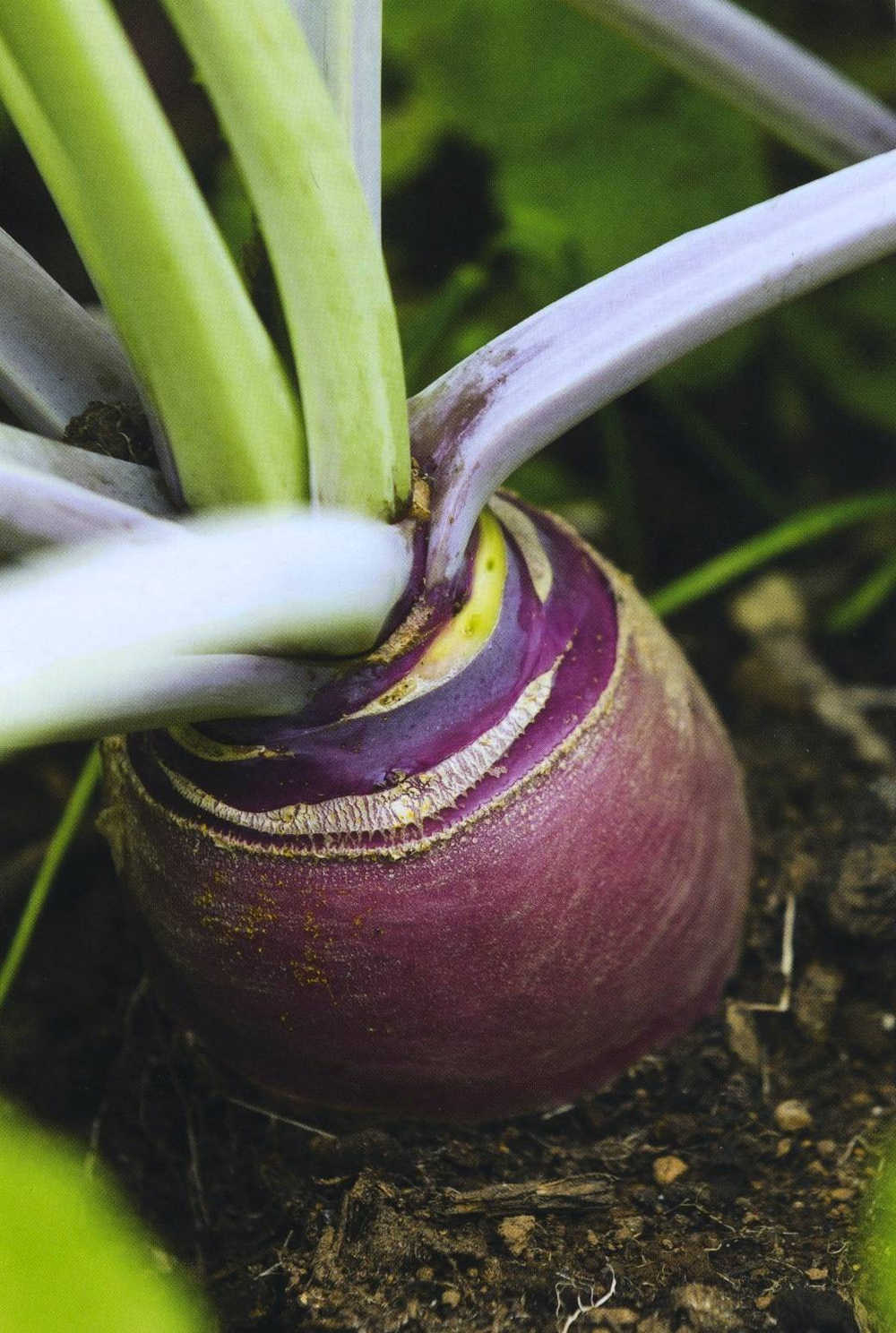 Cider braised turnip with crispy bacon
Cider braised turnip with crispy bacon
I love that Down to Earth Cooking begins with vegetables and fruit, the more obvious meats and poultry only coming in at Chapter Three. And, “Call me shallow but I tend to judge people on their feelings about turnips!” says Paula in her introduction to this simple, delicious dish. “They're an emotive vegetable that some people just don't get. A steaming pan of turnip, plunged into crispy bacon with onion, butter and a few grinds of fresh black pepper is in my top 5 favourite dishes. My treat tea when I was growing up was always butcher's beef sausages, turnip and mash. It reminds me of home, my mum Rae and my late Granny Kathleen - food with soul can and should do that.
Turnip and cider are natural culinary bedfellows and this recipe is for turnip braised with cider and topped with crispy bacon. The sweet turnip is lightly cooked with onion and thyme in butter first, then cooked slowly with cider and stock. The bacon adds a crisp texture and salty note.”
1 tablespoon rapeseed oil
25g butter
1 medium turnip, peeled, quartered and cut into 2cm dice
2 small onions, peeled and chopped
few sprigs fresh thyme
200ml chicken stock
250ml local cider
fresh ground pepper to taste
6 rashers streaky bacon
handful chopped parsley
Heat the oil and butter in a casserole pot over medium heat and add the turnip.
Cook until starting to colour and add the thyme and onions.
Cook until the onions are golden and add the stock and cider.
Cover with a lid and gently simmer for about 30 minutes until the turnips are soft.
Meanwhile place the bacon on a baking tray and cook in a 180°C oven until crisp. Pat dry and chop.
Remove the lid and boil to reduce the liquid to sauce coating consistency.
Season with black pepper, toss in the parsley and scatter over the bacon.
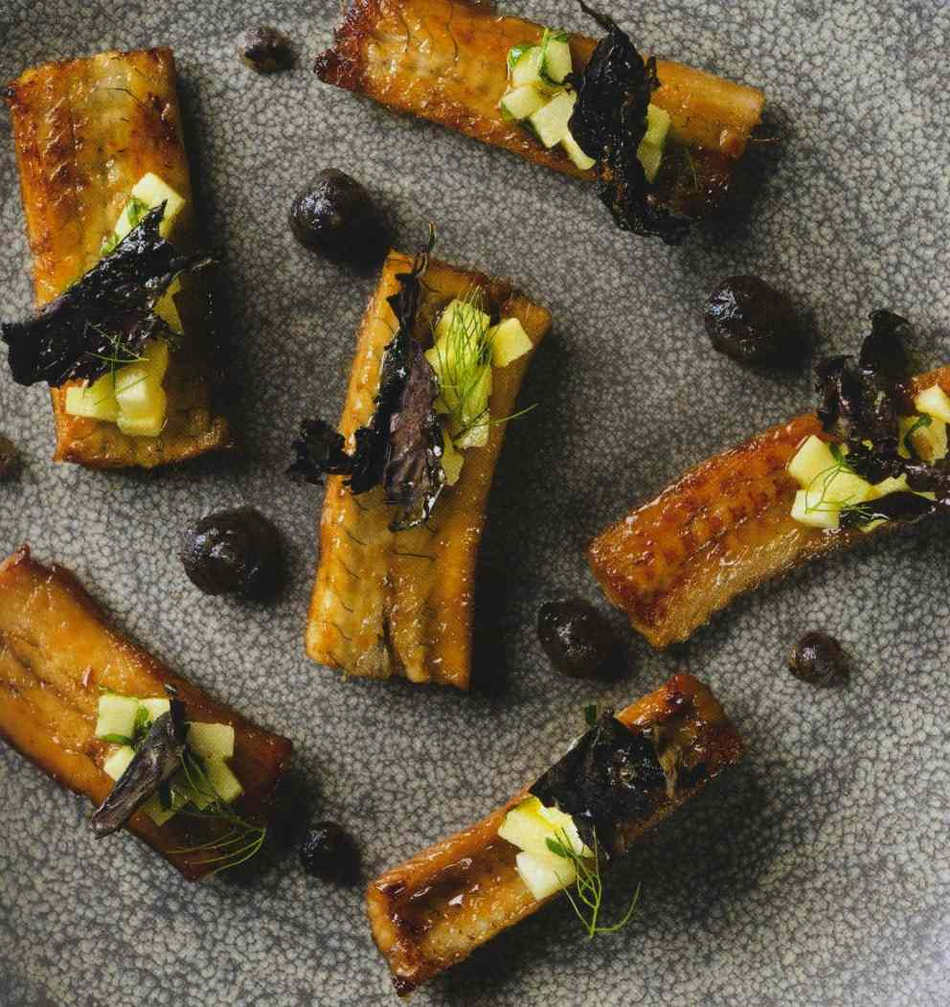 Cider glazed eels with apple and dulse butter, crystallised dulse, and apple and soup celery dressing
Cider glazed eels with apple and dulse butter, crystallised dulse, and apple and soup celery dressing
It is ironic that eel fishing has been banned south of the border since 2009, yet Lough Neagh eel is feted with the approval of the European Commission which awarded it Protected Geographic Indication (PGI) status in 2011; European eel stocks, which are a source of great mystery, have apparently recovered unexpectedly well since the drastic conservation measure was introduced, so traditional eel fishers in the south must now be hoping for some kind of repeal, however conditional.
We certainly enjoy seeking it out in the Lough Neagh area when researching our ‘Taste of the Waterways’ guide, which we produce in partnership with Waterways Ireland. “When I cook eel, despite initial misgivings, most people are converted.” says Paula. “The snakey image doesn't do much for its popularity but, once you get over that, the beautiful soft flesh with earthy notes is wonderful. You can buy smoked eels readily now but for fresh silver eel you need to get it from the source at the Fisherman's Cooperative at Toomebridge in County Derry. They'll provide them gutted and you just need to cut them into thumb length pieces. Around the lough shore, eel is still eaten as part of a 'supper' with fried onions and soda farl. My recipe includes apple and dulse, and is one that I cooked at a slow food banquet for 200 people in Bristol in 2015, as part of the Food Connections festival in the city. BBC Radio 4 producer and presenter Dan Saladino hosted the event and is now a champion for this uniquely northern Irish delicacy. The eel and dulse combination even managed to convert a couple of vegetarians.
The sweet apple butter with salty dulse, sweet crisp dulse for texture and the tart apple and savoury soup celery is a perfect combination.
Serve with some warm farls.
* One tip - cook the eels outside - their oil is quite the pungent thing! Or you could use smoked eel instead - just flash them in a hot pan for 10 seconds and glaze.”
Apple and dulse butter
INGREDIENTS
500g peeled, chopped and cored Armagh cooking apple
175g soft brown sugar
pinch ground clove
1 tablespoon dulse, finely chopped
METHOD
Place the apples in a pan with the sugar and the clove.
Bring to the boil and simmer gently until the apples are soft.
Blend and fold in the dulse.
Crystallised dulse
INGREDIENTS
handful dried dulse
brown lemonade
METHOD
Line a baking tray with parchment paper and set the oven to its lowest setting - preferably around 100°C. Place about 50ml of brown lemonade in an atomiser. Spray over the dulse. If you don't have an atomiser, just brush the dulse with the lemonade. Place in the oven until crisp - about 1 hour.
Apple and soup celery dressing
INGREDIENTS
1 teaspoon Dijon mustard
1 teaspoon honey
25ml cider vinegar
75ml local rapeseed oil
½ medium Armagh cooking apple
2 tablespoons picked soup celery leaves
salt to taste
METHOD
Place the mustard in a bowl and whisk in the honey and vinegar.
Whisk in the oil in a steady stream and then check for seasoning.
Peel the apple and cut into quarters.
Core the apple and slice thinly.
Cut each slice into matchsticks (pile them up to do this as it's quicker) then cut into small dice.
Add to the dressing and toss around.
Shred the soup celery leaves as finely as possible and fold into the dressing.
Place the eel onto a platter, drizzle over the dressing and garnish with the apple butter and dulse.
Serve with soda farls, buttered liberally.
Georgina Campbell's Cookery Feature - A Taste of Mayo
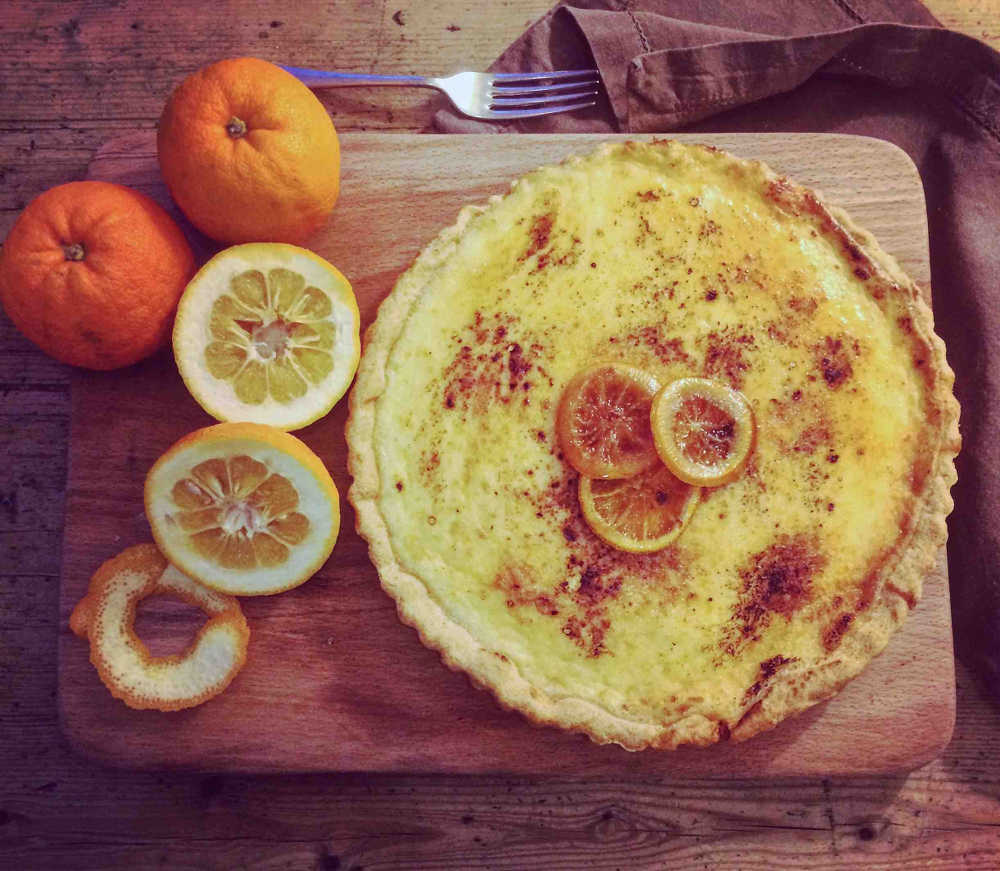
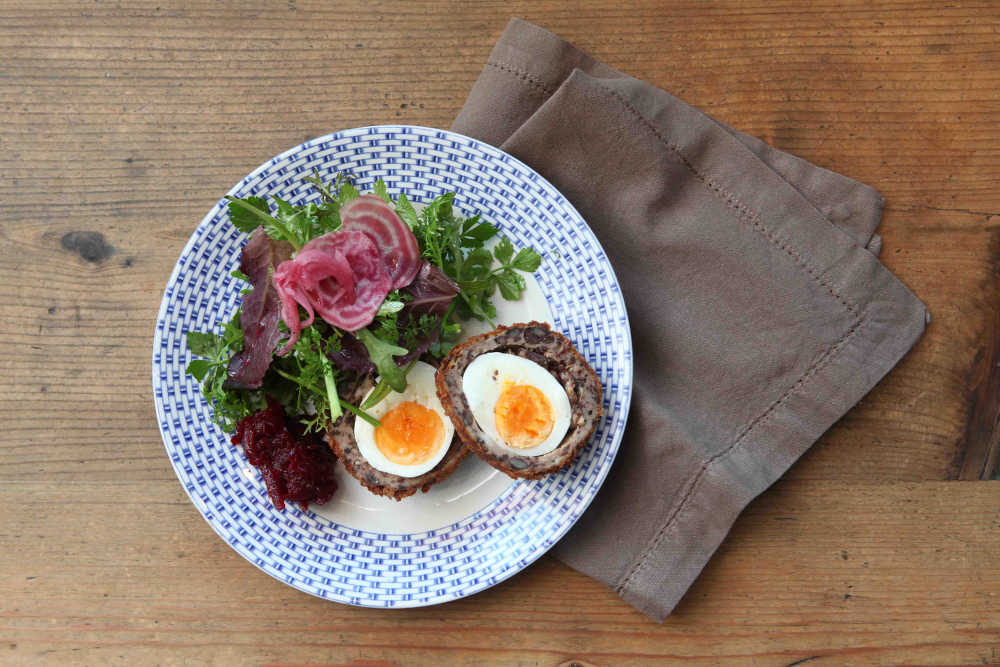 County Mayo has become a favourite destination for food lovers from all over the country thanks to people like the McMahon family of the hugely popular Café Rua on New Antrim Street in Castlebar (established in1995 by Ann McMahon) and its younger sister Rua café, deli and bakery on Spencer Street, which opened in 2007 and is now run by Ann’s children, Aran and Colleen.
County Mayo has become a favourite destination for food lovers from all over the country thanks to people like the McMahon family of the hugely popular Café Rua on New Antrim Street in Castlebar (established in1995 by Ann McMahon) and its younger sister Rua café, deli and bakery on Spencer Street, which opened in 2007 and is now run by Ann’s children, Aran and Colleen.
Along with deliciously simple, wholesome cooking, shouting about their great local produce is what they do best so it should come as no surprise to their many fans that they were recently selected as the Bord Bia ‘Just Ask’ Restaurant of the Year 2016, given in recognition of their support of Mayo food and drink suppliers.
In celebration, here are just a few of their favourite recipes to cook at home - or try at Rua, next time you’re in Castlebar.
Mayo ‘Scotch’ Egg with De Burca’s Cumberland sausages, Kelly’s Black pudding and Claremorris free range eggs
Made with renowned De Burca’s sausage meat and deliciously seasoned with spices and herbs, this is a perfect hot dish for chilly days, or to use cold for picnics. Makes 4
6 free range eggs
400g sausage meat – (De Burca’s Cumberland sausages are suggested)
130g black pudding, crumbled/broken into small pieces (Rua use Kelly’s puddings)
1 tbsp Dijon mustard
Splash of milk
100g flour
100g breadcrumbs
Vegetable oil, to cook
Put four of the eggs into a pan, cover with cold water and bring to the boil. Turn down the heat and simmer for 5 minutes, then put straight into a large bowl of iced water for at least 10 minutes.
Put the meat, black pudding and mustard into a bowl - you’ll need to add very little seasoning as the sausage meat will already contain salt. Mix well with your hands. Divide into four.
Beat the remaining two raw eggs together in a bowl with a splash of milk. Put the flour in a second bowl and season, then tip the breadcrumbs into a third bowl. Arrange in an assembly line (flour, egg-wash, breadcrumbs).
Carefully peel the four boiled eggs. Lightly flour an egg, pat out a quarter of the meat mixture on a lightly floured board and carefully encase the egg. Repeat the process for each egg. Finally, dip each meat-covered egg in flour, then eggwash, then breadcrumbs.
Fill a deep saucepan pan one third full of vegetable oil, and heat to 170ºC (or when a crumb of bread sizzles and turns golden, but does not burn, when dropped in it). Keep the heat under the oil moderate throughout cooking, so crumbs achieve nice dark golden colour, yet meat is cooked thoroughly. Cook the eggs two at a time, for eight minutes, until crisp and golden, then drain on kitchen paper before serving.
Serve with some well-dressed leaves and pickles. In the Rua café it is served with their own house beetroot relish, but it would also work well with a good apple or tomato chutney.
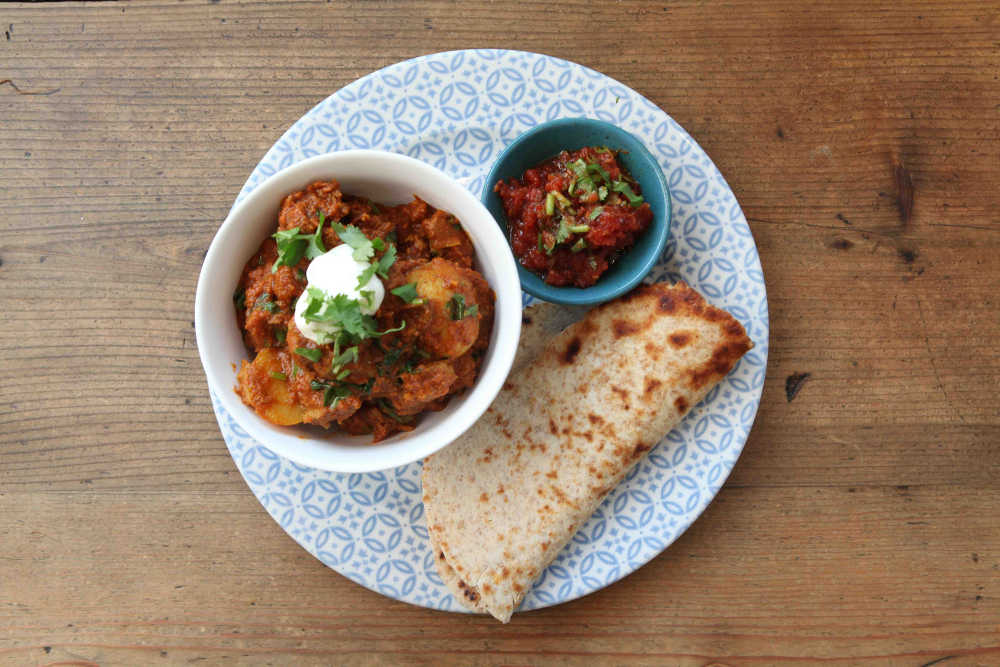 Castlemine Farm Lamb and Potato curry
Castlemine Farm Lamb and Potato curry
Keen promoters of local suppliers, make this fragrant and wholesome curry using renowned Castlemine Farm lamb from Co Roscommon; Bord Bia recommend sourcing lamb with the Quality Assurance mark.
Serves 4-6
1 onion
3 cloves garlic
A thumb sized piece of ginger, grated
1-2 red chillies, deseeded and finely chopped
2 tablespoons of oil
½ tablespoon turmeric
½ tablespoon ground coriander
1 tablespoon garam masala
½ tablespoon cumin powder
1 tablespoon curry powder (Hot)
1 kg diced lamb shoulder
400g tin of chopped tomatoes
300 ml chicken stock
3 medium potatoes, quartered
½ bunch fresh coriander chopped
Make a paste by blitzing the onion, garlic, chillies, ginger and spices with a tablespoon of the oil.
Heat the remaining oil and butter in a large heavy based pan and fry the paste on a low heat for about 8 minutes.
Add the lamb, then fry for a couple of minutes until the meat has changed colour - it doesn’t have to be browned.
Stir in the chopped tomatoes and 300ml of chicken stock to cover most of the lamb. Turn the heat down to a simmer, and cook gently for 1-1½ hours (adding potatoes after about 30-40 minutes). When finished the lamb should be very tender and the sauce should be rich and thick.
Finish by stirring in some yoghurt or coconut milk, and the fresh coriander.
At Rua they serve this curry with some ‘Velvet Cloud’ sheep’s milk yoghurt from Claremorris, Co. Mayo, their own warm flatbreads and chilli and coriander relish.
 Seville Orange Tart
Seville Orange Tart
An attractive seasonal alternative to the classic lemon tart made with the leftover marmalade oranges, which have only a short season in January-February.
Serves 6-8
For the pastry:
250g plain flour
50g icing sugar
A pinch of salt
125g cold butter (cubed)
1 large free range egg
1 tbsp cold milk
Tart Filling:
5 large eggs
200g caster sugar
Zest of 1 Seville orange
Juice of 2 Seville orange
150ml cream
1 loose-bottomed fluted tart tin, 21cm diameter x 2.5cm deep.
Rub the flour, sugar and salt together with the cold butter by hand, until the mixture has the consistency of breadcrumbs.
Add the beaten egg and milk and bring the mixture together with a wooden spoon. Do not over mix. ?Wrap in cling film and allow to rest in the fridge for 30 minutes.
Meanwhile, prepare the filling (Step 3) and preheat the oven to 200ºC/180ºC fan/gas 6.
When the pastry has rested, lightly flour a work surface and roll out the pastry to 2-3mm thick, to fit the 21cm tart tin.
Line the pastry case with baking paper, then the pastry and fill with baking beans or rice. Bake on the hot baking sheet for 10-15 minutes.
Remove the beans and paper, return to the oven and bake for 5 minutes until the pastry is golden. Brush the pastry with the beaten egg and return to the oven for 1 minute. Remove and leave to cool a little.
To make the filling, hand whisk the eggs and sugar together until all the sugar is completely dissolved. Add juice and zest and mix again.
Finally add the cream and fold gently into the egg mixture. Pour the mixture into the case. Try not to over whisk.
Reduce heat to 150ºC/130ºC fan/gas 2, and bake for 15-20 minutes, or until set with a slight wobble in the centre. This will set further as the tart cools.
Allow the tart to cool for 1 hour before serving. Dust with icing sugar to serve or alternatively sprinkle with granulated sugar and bruleé with a blow torch, taking care not to burn the pastry.
Georgina Campbell's Cookery Feature - Winning Ways
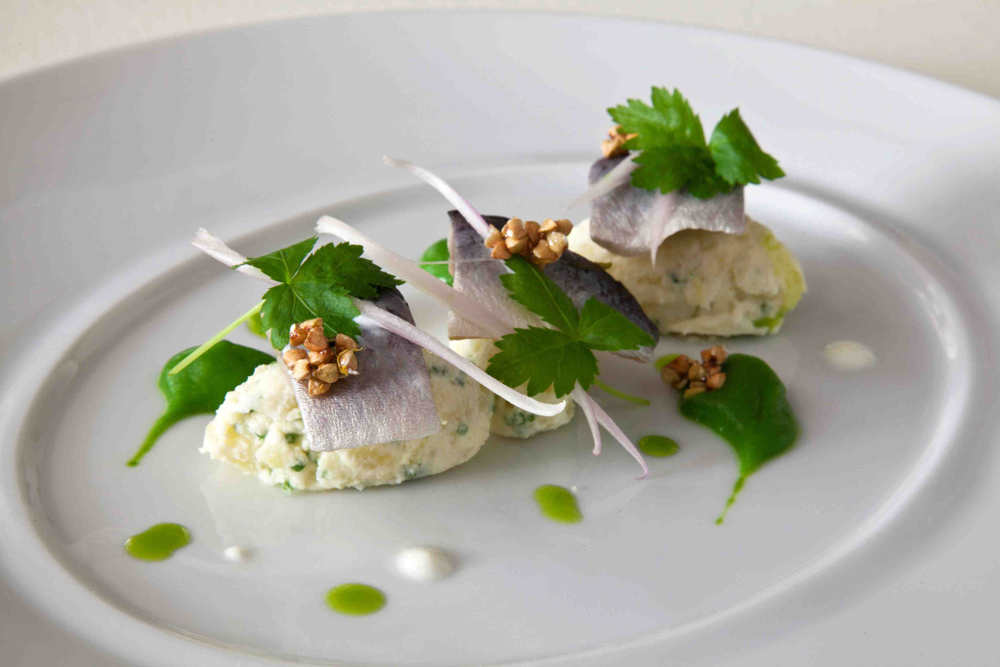
A Hymn to Rural Ireland - Special Dishes Created to Showcase the 2016 Irish Food Writers’ Guild Awards
Georgina Campbell
A hymn to rural Ireland - that just about sums up the Irish Food Writers’ Guild Food Awards 2016, which are dominated this year by dedicated producers in the midlands and the stunningly good food and drink that they create. Now in their 22nd year of celebrating indigenous food, the Awards were announced at a showcase lunch at Dublin’s Restaurant Patrick Guilbaud on 2nd March.
The 2016 food product winners are Sharon and Gordon Greene’s Wild Irish Foragers & Preservers, Co Offaly, for their full range of products; Kirsti O’Kelly’s Silver Darlings, Co Limerick, for their pickled herrings; and Ralph Haslam’s Mossfield Organic Farm, Co Offaly for their organic milk.
In addition, Cuilan Loughnane’s White Gypsy Brewery, Co Tipperary, received the Irish Drink Award for their Russian Imperial Stout, while Joe Fitzmaurice of Riot Rye Bakehouse and Bread School, Co Tipperary, was presented with a Special Contribution to Irish Food Award, and this year’s Environmental Award went to Rod and Julie Calder-Potts’s Highbank Organic Orchards, Co Kilkenny.
Commenting at the Awards, Guild chairperson Aoife Carrigy said, “As a nation, our focus should be on the abundance of wonderful produce available throughout Ireland that is being made available to consumers by passionate producers who take a sustainable approach to food and food innovation, whether by re-embracing traditional approaches to age-old food sources such as milk, apples or wild berries, or by applying a modern perspective to traditional foods such as Irish fish, stout or bread. What’s really interesting about this year’s winners is that they are representative of the new energy that is emerging from the midlands for food and drink. All six have been selected for the high standard and impeccable quality of their produce, together with their dedication and commitment to Irish food. As an organisation that is devoted to being a voice for better eating, we have been shining a spotlight on the best of the best for over 20 years and this year it’s the turn of the midlands to shine.”
The Guild’s Award, which are supported by Bord Bia, are uniquely ethical in that no company or individual can enter themselves - Guild members nominate products, businesses or people they believe are worthy of an award - and all products nominated must not only be produced in Ireland (and by a producer who has been trading for at least three years) but the main ingredient must be Irish grown or produced. Products are bought and paid for anonymously by members and a formal tasting meeting takes place where members vote, using proportional representation.
Another unusual aspect of the IFWG Awards is that there are no product categories, so the range of winning products and their county of origin can vary enormously from year to year - hence County Cork sweeping the board in 2014 (with, as it happens, another strong showing in 2015), and the totally different mainly midlands representation this year.
Although it is in no way part of the criteria, the products and people nominated tend to present a snapshot of best practice in areas that are of public concern - seen this year, for example, in the sustainable practices of all winners (three of whom are organic producers) and the focus on real bread and superb milk, excellent basic foods that illustrate perfectly the difference between the mass produced and the artisan product. The exceptional quality of the winning products and dedication of the producers will inspire and energise likeminded people throughout Ireland - and confirm the value of aiming for nothing less than the highest possible standards.
For full details on these, and all award winners back to 1994, visit: www.irishfoodwritersguild.ie/food-awards.html
The Awards lunch was devised by Guillaume Lebrun, executive head chef at Restaurant Patrick Guilbaud, who ingeniously incorporated the winning produce into this special menu, which was paired with wines kindly provided by Liberty Wines. The recipes were edited by Guild Secretary Kristin Jensen
• Salad of Silver Darlings Irish Herring, Potato, Green Leek Purée and Toasted Buckwheat
• Grilled Irish Hereford Sirloin, Brandy Bay Oyster Cream and White Gypsy Russian Imperial Stout
• Mossfield Organic Farm Milk Pudding, Wild Irish Foragers Spring Nettle Syrup and Caramelised Walnuts
• Riot Rye Bakehouse Borodinsky Sourdough Ice Cream with Malted Chocolate Ganache and Malt Bread Tuile
 Salad of Silver Darlings Irish Herring, Potato, Green Leek Purée and Toasted Buckwheat
Salad of Silver Darlings Irish Herring, Potato, Green Leek Purée and Toasted Buckwheat
Serves 4
100g buckwheat groats
200g baby potatoes
200g natural yogurt, plus extra to garnish
chopped fresh chives
freshly squeezed lemon juice, to taste
1 shallot, finely sliced
200g Silver Darlings Irish Herring with Fennel and Tarragon
fresh flat-leaf parsley leaves, to garnish
For the green leek purée:
knob of butter
2 leeks, green part only, finely sliced
salt and freshly ground black pepper
Preheat the oven to 160°C. Scatter the buckwheat on a baking tray and toast in the oven for 5 minutes.
To make the green leek purée, melt the butter in a small pan and sweat the leeks. Season with salt and pepper, then blend in a liquidiser until smooth. Chill in the fridge until required.
Boil the baby potatoes until they are cooked through and tender. Drain well and return briefly to the pan to dry them out, then transfer to a bowl and gently crush them. Fold in the yogurt, some chopped chives and a squeeze of lemon juice, but be careful not to overwork the potato salad.
To serve, arrange three small quenelles of the potato salad on a cold plate and add dots of the leek purée and yogurt. Place a sliver of shallot on top of each quenelle, then add a piece of herring. Garnish with a parsley leaf and the toasted buckwheat.
Recipe created for the Irish Food Writers’ Guild Food Awards 2016 by executive chef Guillaume Lebrun of Restaurant Patrick Guilbaud, Upper Merrion Street, Dublin 2
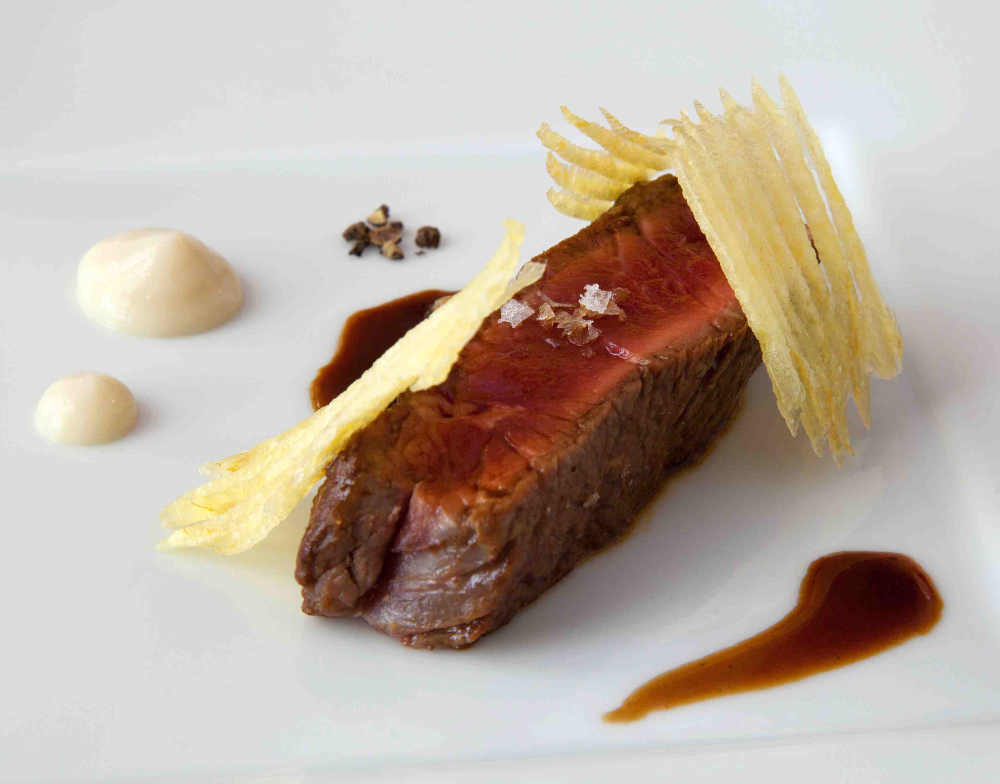 Grilled Irish Hereford Sirloin, Brandy Bay Oyster Cream and White Gypsy Russian Imperial Stout
Grilled Irish Hereford Sirloin, Brandy Bay Oyster Cream and White Gypsy Russian Imperial Stout
Serves 4
4 x 150g Hereford sirloin steaks
olive oil, for cooking
salt and freshly ground black pepper
waffle-cut potato crisps, to garnish
For the Brandy Bay oyster cream:
1 Brandy Bay (or other Irish) oyster
300ml fresh cream
splash of balsamic vinegar
salt and freshly ground black pepper
For the stout sauce:
750ml White Gypsy Russian Imperial Stout
500ml beef stock
1 tsp cornflour
1 marrow bone, split (ask your butcher to do this for you)
To make the sauce, pour the stout and beef stock into a pan. Bring to the boil and reduce by two-thirds. Dissolve the cornflour in a small bowl with a little water and mix together to form a thin paste, then whisk it into the sauce a little at a time until you have achieved your desired consistency. Finely dice the marrow and stir it into the sauce. Keep warm.
To make the oyster cream, place all the ingredients in a blender and blitz until smooth.
Heat a dry, heavy-based chargrill pan or skillet over a high heat. Brush both sides of the steaks with a little oil and season generously with salt and pepper. When the pan is smoking hot, put in the steaks. Cook a 2cm-thick sirloin steak for 2 minutes per side for medium rare. Remove from the pan and let the steaks rest for at least 5 minutes.
To serve, put the steak on a warmed plate. Spoon over some of the stout sauce and pipe dollops of the oyster cream on the plate. Garnish with the waffle-cut crisps.
Recipe created for the Irish Food Writers’ Guild Food Awards 2016 by executive chef Guillaume Lebrun of Restaurant Patrick Guilbaud, Upper Merrion Street, Dublin 2
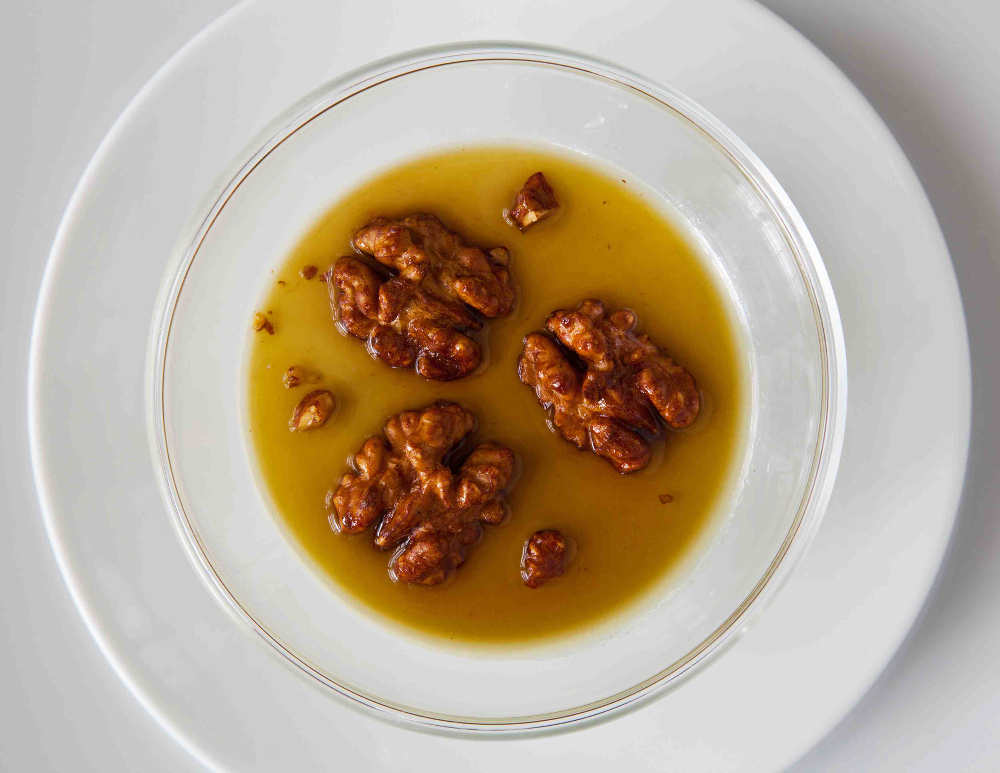 Mossfield Organic Farm Milk Pudding, Wild Irish Foragers Spring Nettle Syrup and Caramelised Walnuts
Mossfield Organic Farm Milk Pudding, Wild Irish Foragers Spring Nettle Syrup and Caramelised Walnuts
Serves 4
For the milk pudding:
3 leaves of gelatine
250ml milk
250ml cream
20g caster sugar
For the caramelised walnuts:
100g walnuts halves
100g caster sugar
To serve:
4 tbsp Wild Irish Foragers Spring Nettle Syrup
To make the milk pudding, soak the gelatine leaves in a small bowl of cold water for 10 minutes.
Meanwhile, bring the milk, cream and sugar to the boil in a medium-sized saucepan. Immediately remove from the heat and set aside to cool for 5 minutes, then squeeze out the gelatine leaves and whisk into the hot milk to dissolve. Divide between four serving glasses and chill in the fridge for at least 4 hours or overnight.
To make the caramelised walnuts, preheat the oven to 180°C. Scatter the walnuts on a baking tray and toast in the oven for 5–7 minutes, taking care not to let them burn.
Place the sugar in a saucepan over a low heat and leave to slowly caramelise without stirring. When the sugar reaches a medium to dark brown caramel, add the walnuts to the pan and swirl to combine. Pour the walnuts onto a tray lined with non-sticking baking paper and leave to cool.
To serve, pour 1 tablespoon of the nettle syrup over each pudding so that it forms a thin layer on top, then decorate with caramelised walnuts.
Recipe created for the Irish Food Writers’ Guild Food Awards 2016 by executive chef Guillaume Lebrun of Restaurant Patrick Guilbaud, Upper Merrion Street, Dublin 2
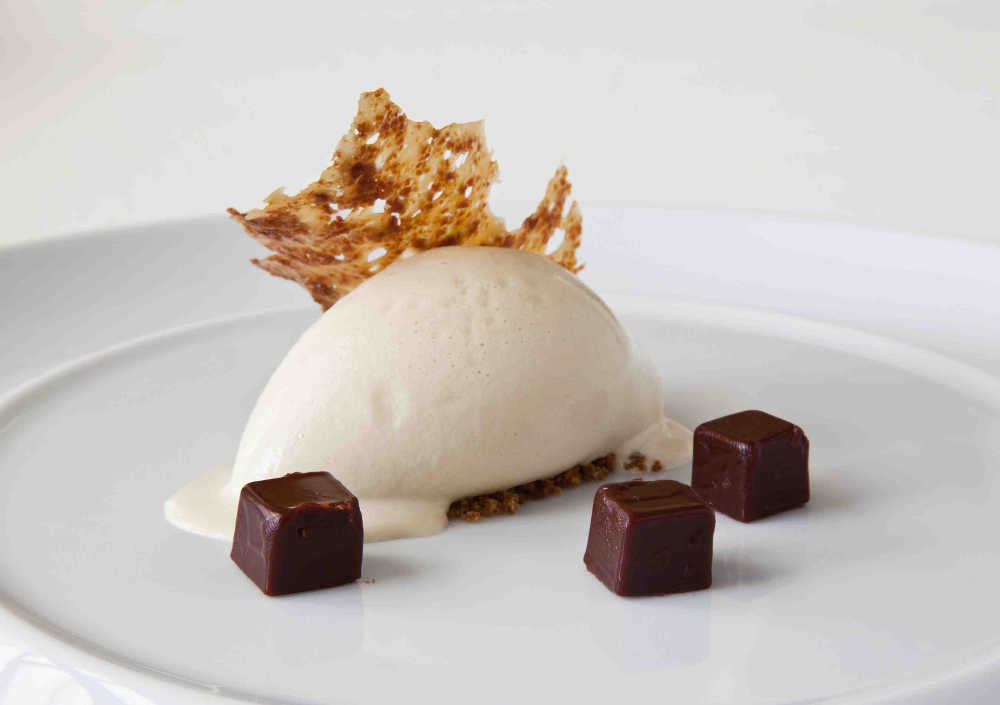 Riot Rye Bakehouse Borodinsky Sourdough Ice Cream with Malted Chocolate Ganache and Malt Bread Tuile
Riot Rye Bakehouse Borodinsky Sourdough Ice Cream with Malted Chocolate Ganache and Malt Bread Tuile
Serves 4–6
For the ice cream:
12 egg yolks
80g caster sugar
500ml milk
500ml cream
1 loaf of Riot Rye Borodinsky sourdough bread, torn into pieces
5g fresh yeast
For the malted chocolate ganache:
265g dark chocolate, chopped
265g milk chocolate, chopped
250ml cream
150g honey
20g Horlicks malted milk powder
150g butter, cubed
For the malt bread tuile:
200g malt bread
30g caster sugar
30ml milk
40g butter
10g plain flour
To make the ice cream, whisk the egg yolks and sugar in a large heatproof bowl until well combined. Bring the milk and cream to the boil in a medium-sized saucepan. When the milk comes to a boil, slowly pour it into the egg mixture, whisking all the time. Pour the custard back into the pan and reduce the heat to low. Whisk until the custard thickens and coats the back of a wooden spoon.
Remove from the heat and stir in the sourdough pieces and yeast. Transfer to a bowl, cover with cling film and leave to infuse overnight in the fridge.
The next day, pass the custard through a fine-mesh sieve into a clean container. Churn in an ice cream machine and freeze.
To make the ganache, put the chopped chocolate in a medium-sized heatproof bowl. Heat the cream, honey and Horlicks in a saucepan over a medium heat until it comes to the boil. Pour the hot cream over the chocolate and whisk until it is completely melted. Whisk in the butter until it has melted and the ganache is smooth. Pour into a container and chill in the fridge for at least 4 hours, until firm.
To make the tuile biscuits, preheat the oven to 180°C. Line a baking tray with non-stick baking paper.
Place the bread in a food processor and whizz into crumbs. Place the butter, sugar and milk in a medium-sized saucepan and bring to the boil. Slowly add the flour and breadcrumbs. Remove from the heat and allow to cool slightly, then place tablespoonfuls on the lined tray, spaced well apart, and spread out the dough slightly. Bake for 5 minutes. When the biscuits are cool enough to handle but still warm, drape them over a rolling pin to give them a nicely rounded shape. Allow to cool and set.
To serve, dice the ganache into small cubes. Place a quenelle of ice cream on a cold plate and set a few cubes of ganache alongside. Decorate with a tuile biscuit.
Recipe created for the Irish Food Writers’ Guild Food Awards 2016 by executive chef Guillaume Lebrun of Restaurant Patrick Guilbaud, Upper Merrion Street, Dublin 2
Georgina Campbell's Cookery Feature - Up the Ante in Your Cooking with Beer & Cider
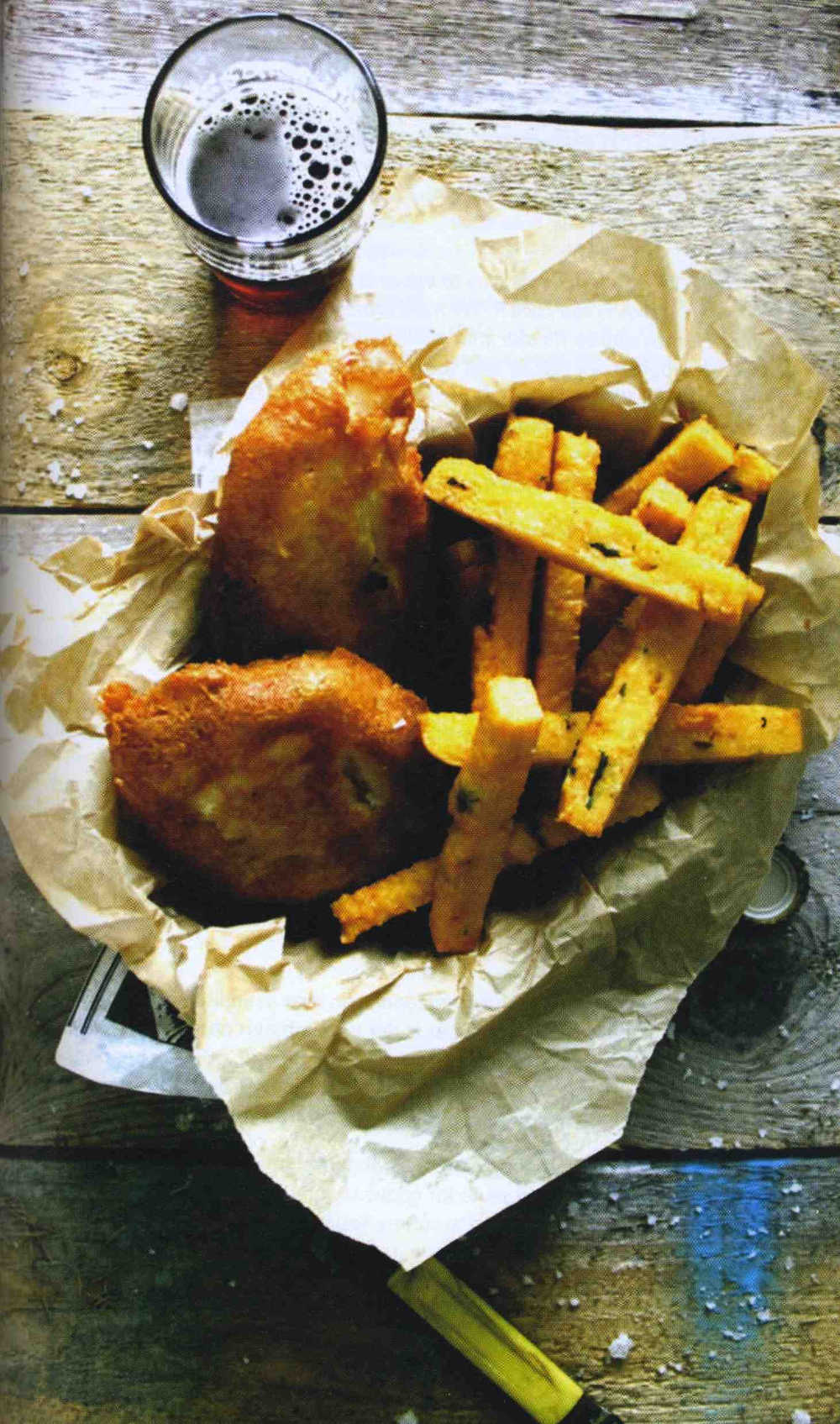
 Craft drinks production is growing at such a dizzying speed that it seems that every place in Ireland now has at least one local speciality beer or cider to its name - and perhaps a gin, whiskey, vodka or poitín too.
Craft drinks production is growing at such a dizzying speed that it seems that every place in Ireland now has at least one local speciality beer or cider to its name - and perhaps a gin, whiskey, vodka or poitín too.
While, as is to be expected, some are better than others, the best will earn recognition and thrive. In addition, the surrounding creativity, production and employment is giving a terrific boost to local communities and making the ideal complement to the vibrant speciality food sector that is now central to our everyday lives - and our shopping habits.
As this new drinks sector grows, it’s interesting to see innovative developments emerging. An especially welcome one is the pride that some of the leading cider producers are showing in their product, by using classy design and different shaped bottles to underline the quality of the contents and encourage shoppers to think of it in the same way as wine - to be shared at the table, as an accompaniment to good food.
Similarly, we could all be thinking a lot more creatively about the ways in which craft drinks can be used in cooking. Used well, to complement our great local foods, they can be instrumental in developing a more varied yet clearly defined sense of place in the dishes that we’re offering to visitors to every area of the country.
Here at the Guide, we’re just starting another season of touring the country, ‘dining for Ireland’. This year, as usual, we’ll visit every county in Ireland at least once and it would be lovely to find some more creative menus with real local flavours, especially in pubs and casual dining situations where menus are so often disappointingly the same from one end of the country to the other.
The recipes below are taken from Caroline Hennessy and Kristin Jensen’s super book Sláinte, The Complete Guide to Irish Craft Beer and Cider (New Island, €19.99), which has a chapter on cooking with beer and cider.
Some of the recipes are a little long, but that’s because they’ve thought of everything, so the less experienced cook can have a go without having to second-guess the instructions (or the results).
The ideas may not all be new (in my own books going back to the early’90s I made a point of using Irish drinks, especially cider, in recipes like these), but they have been reworked to have particular relevance to today’s craft drinks scene and the great range of recipes given should be an inspiration to cooks and chefs throughout the country. They can easily be adapted, or simply used as a starting point for other dishes that could, one day, become local specialities.
Wouldn’t it be great to settle into a cosy bar or a characterful café and have something like this deliciously simple Cheddar, Chive and Red Ale Bread served with a sensationally seasonal bowl of soup? Or the steaming bowl of mussels, with a good Irish craft cider giving a tasty twist on the classic combination? The Beef, Beer and Blue Cheese Pot Pies would be perfect pub fare, and Imen McDonnell’s variation on fish&chips should give plenty to think about.
The possibilities are endless - and Sláinte is a very good place to begin.
RECIPES:
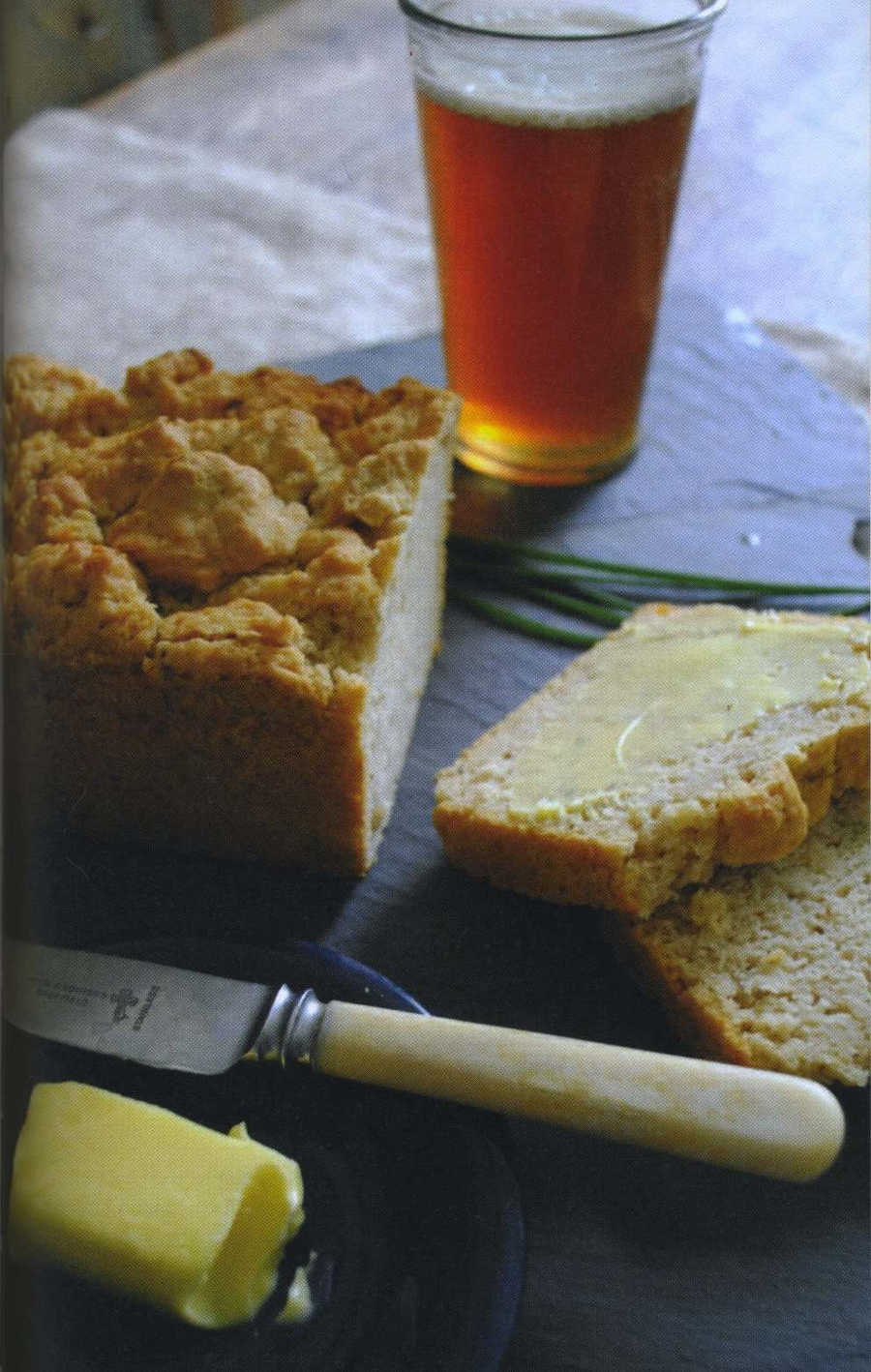 Cheddar, Chive and Red Ale Bread
Cheddar, Chive and Red Ale Bread
Makes 1 x 450gloaf
“A cheese and beer bread is only as good as the ingredients. This version uses a well-flavoured mature farmhouse Cheddar, like Hegarty's, Coolattin (Supreme Champion at the 2015 Irish Cheese Awards) or Mount Callan, along with a red ale from 5 Lamps Brewing, O'Hara's or try Porterhouse stout (or even a medium-dry cider). Other variations to play around with are blue cheese and sage; or try goat's cheese, pale ale and thyme.”
50g butter, plus extra for greasing
50g strong Cheddar cheese
350g plain flour
1 tablespoon baking powder
1 teaspoon salt
1 teaspoon granulated sugar
handful of finely chopped fresh chives
330ml red ale
Preheat the oven to 190°C (170°C fan). Thoroughly butter and flour the base and sides of a 450g loaf tin.
Melt the butter, grate the cheese and set both aside.
Sift the flour, baking powder and salt into a large bowl. Add the grated cheese, sugar and chives. Mix thoroughly and make a well in the centre; Pour in the ale and stir gently, until just combined.
Scrape into the loaf tin, pour over the melted butter and cook in the oven for 50-60 minutes, until well browned. Slip it out of the tin - if the loaf is ready, the base will sound hollow when you tap it with your knuckles. If not, return it to the oven without the tin for 5 more minutes.
Cool on a wire rack - if you can resist! - before cutting and serving with bowls of chunky lentil soup.
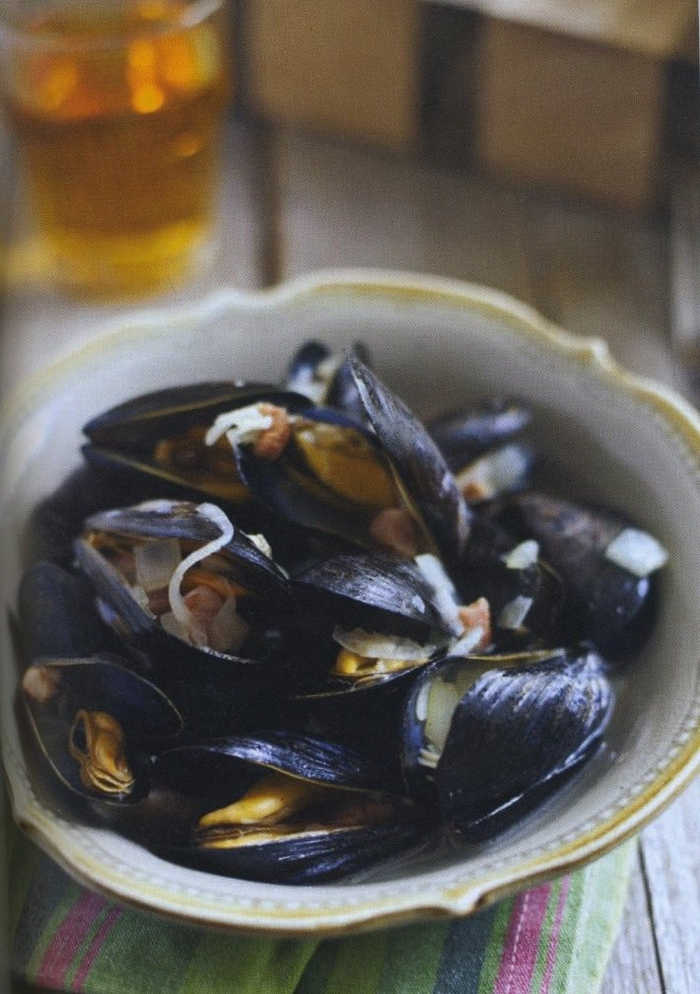 Mussels with Bacon and Irish Cider
Mussels with Bacon and Irish Cider
Serves 4
“TV cook and author Donal Skehan says that mussels have a reputation for being difficult, but this is just not true. In reality, the hardest part is washing them. Place them in cold water (they should close - if they don't, throw them away). Scrub any dirt off the surface of the mussels and remove the beard with a small knife. If you can get this done, you won't have any trouble. They take minutes to cook, so they are the perfect little starter. Serve the pot straight to the table from the stove and serve large spoonfuls of the cooked, steaming mussels onto guests' plates. Make sure to serve with some chunky bread to mop up the juices.”
200g pancetta pieces or diced bacon
knob of butter
1 medium onion, finely chopped
3 garlic cloves, crushed
400ml medium or sweet cider
1.5kg mussels, washed and beards removed
4 tablespoons cream
handful of chopped fresh parsley
sea salt and freshly ground black pepper
crusty bread, to serve
Discard any mussels that are open before cooking and any that stay closed after cooking.
Place a large pot over a high heat and brown the pancetta pieces until just golden and sizzling. Reduce the heat to medium, add in the knob of butter and allow it to melt. Add the chopped onion and cook gently for about 5 minutes, covered, until soft but not browned. Stir in the garlic and cook, uncovered, for 1 minute more.
Pour in the cider and allow it to bubble away for a few minutes so that the flavours mingle together. Add in the mussels, cover the pot with a lid and allow them to steam for about 4 minutes, until they open. Give the pot a good shake once or twice during the cooking time.
Remove from the heat, stir in the cream and parsley and season with se salt and ground black pepper. Serve with some crusty bread to mop up the salty, cidery liquid.
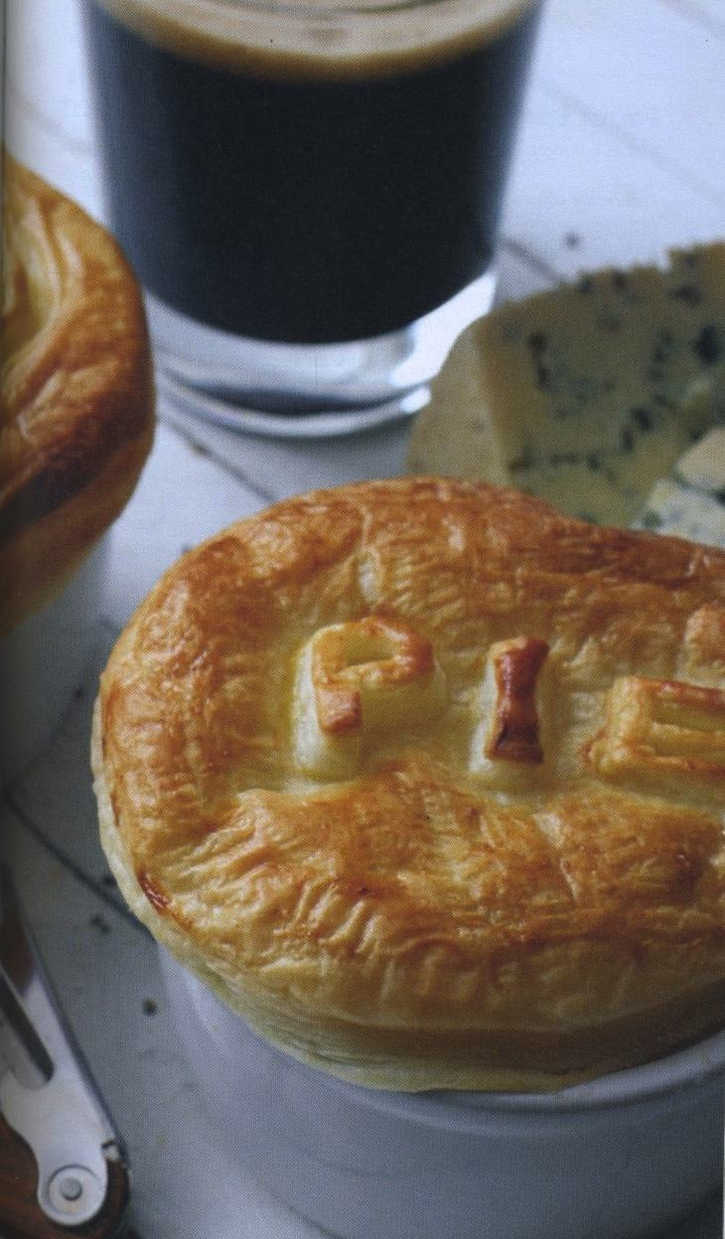 Beef, Beer and Blue Cheese Pot Pies
Beef, Beer and Blue Cheese Pot Pies
Serves 4-6
“There is nothing wrong with a classic beef and stout stew, but what if you upped the ante on the stout and added some blue cheese too? And what if you capped it with a flaky puff pastry lid and called it a pot pie instead? Now you're talking.”
l kg stewing beef (such as shin or cheek), cut into bite-sized pieces
salt and freshly ground black pepper
3 tablespoons plain flour
rapeseed or olive oil
2 red onions, chopped
2 carrots, peeled and chopped
3 garlic cloves, chopped
1 teaspoon chopped fresh thyme leaves (or l teaspoon dried thyme)
500ml stout
125g crumbled blue cheese
1 sheet of ready-rolled puff pastry
1 egg, beaten
Preheat the oven to 130°C.
Put the beef in a large bowl and sprinkle over 1 teaspoon of salt and plenty of freshly ground black pepper. Add the flour and toss the beef in it until it all has a light dusting.
Heat some rapeseed or olive oil in a large ovenproof casserole and brown the beef in batches over a medium-high heat, making sure not to crowd the pot or the meat won't brown properly. Add more oil in between batches if needed. Remove the beef from the pot and set aside.
Add another splash of oil to the pot, then add the onions and carrots along with a pinch of salt so that the onions don't brown. Cover the pot and cook for 10-15 minutes, stirring occasionally, until the vegetables are soft but not browned. Add the garlic, thyme and a generous seasoning of salt and pepper and cook for 1 or 2 minutes more.
Pour in the stout, scraping up any browned bits that have stuck to the bottom of the pot. Return the beef to the pot and bring up to a lively simmer, then cover and put in the oven for 3-4 hours (or simmer on the stovetop on a low heat with the lid on), stirring a few times.
You will know it's done when the beef easily falls apart when you prod it with a fork and the stout has reduced right down - it's a pot pie filling, not a stew, so you want it to be nice and thick. Stir in the cheese, then taste it and adjust the seasoning if necessary.
Raise the temperature to190º. Place one large ovenproof pie dish or individual dishes or ramekins onto a baking tray just in case any filling bubbles up and over the sides; then spoon the stew into the dish(es).
Roll out the pastry a little on a lightly floured counter top, then cut to fit the top of the dish. Rub the edge of the dish with a little water or some of the beaten egg to help the pastry stick in place, then place the pastry lid on top. Brush the pastry with the beaten egg (not too much or the pastry won’t rise properly), then cook in the oven for 20-30 minutes, until the pastry has risen and is golden.
Allow to stand for 10 minutes before digging in.
 Irish Ale-Battered Fish with Chickpea Chips and Lemon Aioli
Irish Ale-Battered Fish with Chickpea Chips and Lemon Aioli
Serves 4-6
“Imen McDonnell was working in television production in America when an Irish farmer on holidays unexpectedly swept her off her feet. She married him, and she now lives on his family farm in Co. Limerick and has made a name for herself in the Irish food scene. Imen writes the Farmette blog and a weekly column for Irish Country Living, directed and produced the short film Small Green Fields about Irish food, and her first cookbook The Farmette Cookbook: Recipes and Adventures from My Life on an Irish Farm came out in the autumn of 2015 (See Darina Allen’s column this month for further details).
We love her fresh twists on Irish classics, like this version of fish and chips, but with an Irish craft ale batter and chickpea chips instead of the usual potato. This makes a lot of chips, depending on how thinly you cut them, so you could probably get away with halving the recipe and still have plenty for four greedy adults.
As for the beer, the more flavourful the ale is, the more flavourful the beer batter will be. Good ones to try are O'Hara's Irish Pale Ale or even Helvick Gold from Dungarvan Brewing.”
For the beer-battered fish:
225g self-raising flour
1 egg, lightly whisked
375ml chilled pale ale
salt and freshly ground black pepper
vegetable oil, to deep-fry
8 x 120g white fish fillets (such as cod or hake)
lemon wedges, to serve
For the chickpea chips:
425g gram flour (aka chickpea flour, available at natural food stores)
170g medium-ground maize meal (cornmeal), plus extra for dusting
2 garlic cloves, finely grated
2 tablespoons coarse salt?
zest of 2 lemons
large handful of fresh parsley, finely chopped
1 tablespoon finely chopped fresh rosemary
vegetable oil, for frying
For the lemon aioli:
150g mayonnaise
1 garlic clove, minced
3 tablespoons lemon juice
½ teaspoon lemon zest
sea salt and freshly ground black pepper, to taste
First, make the chickpea chips. Combine the gram flour, maize meal, garlic, salt and 1.6 litres of cold water in a stainless steel pot over a high heat. Whisk gently to prevent it from sticking on the bottom, but don't over-whisk it or the final product will 'souffle' and fall.
Once the mixture begins to thicken and bubble (after about 3-4 minutes), reduce the heat to medium and switch to a rubber spatula. Stir in the lemon zest, parsley and rosemary and continue stirring to prevent it from sticking. When the mixture pulls away from the sides of the pot and is becoming hard to stir (after about 6-8 minutes), transfer it to a rimmed Swiss roll tray lined with non-stick parchment paper and spread it out evenly. If it is too thick to spread with the spatula, let it cool just enough so that you can touch it, then run your hands under the tap and press it out evenly with your damp palms. Cover with a sheet of plastic wrap and top with another baking tray. Refrigerate for 4 hours, until completely cold and set.
Carefully remove the slab from the tray by gently lifting the bottom layer of parchment paper onto a cutting board. Remove the plastic wrap, then cut into chips about 8cm long.
Add a few centimetres of vegetable oil to a large saucepan. Heat the oil to 190°C over a high heat - when the oil is ready, a cube of bread dropped into if will turn golden brown in 10 seconds. Lower the heat to medium, toss the chips lightly in some extra maize meal and deep-fry them in small batches until crispy, about 2 minutes per side. Remove and drain on a plate lined with kitchen paper and keep warm.
To make the lemon aioli, simply mix all the ingredients together in a medium bowl.
To prepare the fish, place the flour in a bowl. Add the egg and stir to combine. Gradually whisk in the beer until the batter is smooth, then season with salt and pepper. Cover and place in the fridge for 30 minutes to rest.
Add enough vegetable oil to a large saucepan to reach a depth of about 4cm, or enough oil so that it reaches at least halfway up the sides of the fish fillets. Heat the oil to 190°C over a high heat - when the oil is ready a cube of bread dropped into it will turn golden brown in 10 seconds.
Dip 2 pieces of fish into the batter to coat them and quickly slide them into the hot oil before too much batter drips away. Deep-fry for 3-4 minute on each side, until golden brown, crispy and cooked through. Don't be tempted to move the fish around in the pan during that time or the batter might slide off.
Transfer to a plate lined with kitchen paper. Repeat in 3 more batches with the remaining fish and batter, reheating the oil between batches.
Serve the fish with the chickpea chips and the lemon aioli as a dipping sauce and lemon wedges on the side.
Sláinte!
Georgina Campbell's Cookery Feature - Place on a Plate
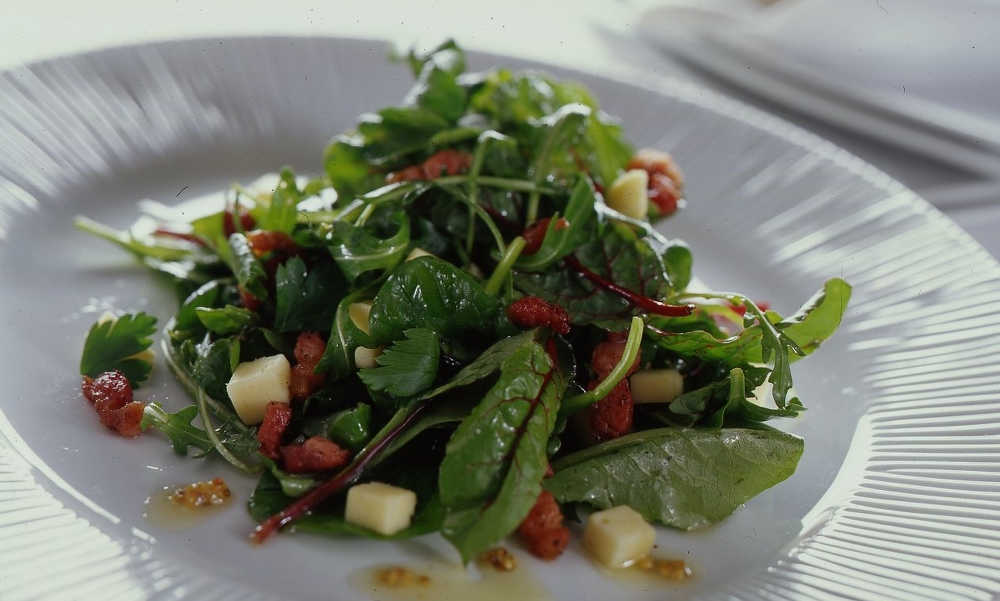
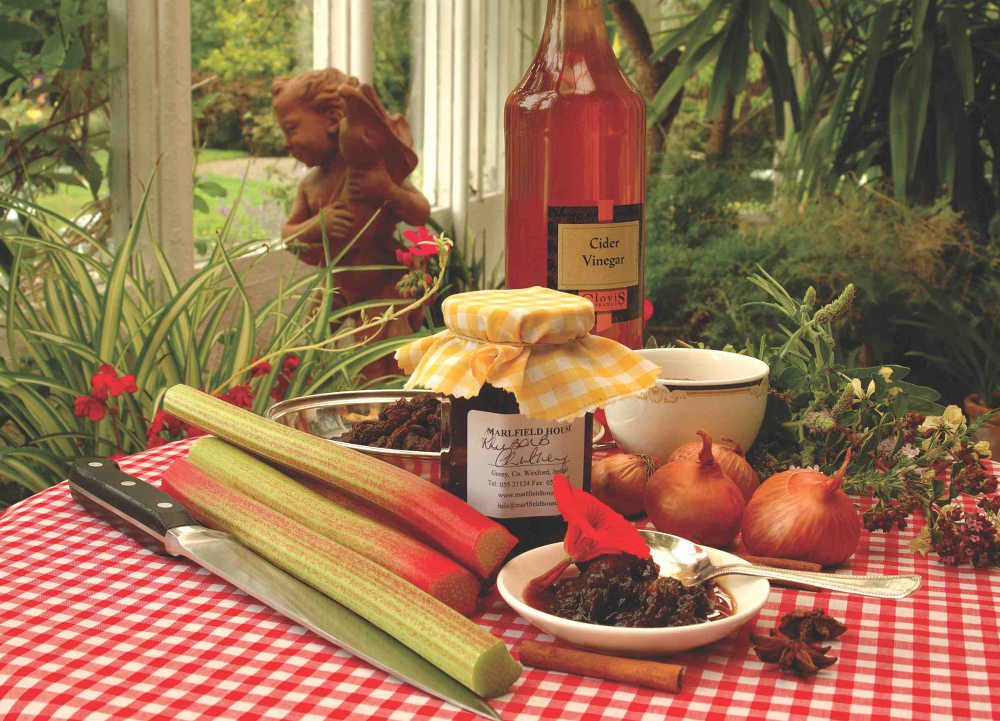 Could 2016 be the year when we finally earn our stripes as ‘the food island’? There are still plenty of bad meals to be found in Ireland and foods that don’t deserve the name, but in many ways things have improved dramatically in recent years and there’s a sense of sea change in the air.
Could 2016 be the year when we finally earn our stripes as ‘the food island’? There are still plenty of bad meals to be found in Ireland and foods that don’t deserve the name, but in many ways things have improved dramatically in recent years and there’s a sense of sea change in the air.
Food tourism may be a new concept to many mainstream travellers, but it’s seriously big business internationally and our tourism authorities have not been slow to recognise its potential. Just a few years ago it would have been hard to see a place for Ireland in this market but, although this country is very much a newbie in the field, the hard work that so many people have been putting in for decades is finally paying off and all the signs are that the time is right for a big push.
Of those already seen as food destinations, France almost seems too obvious to mention, but the Nordic countries and other European destinations like Italy and Spain have seen huge benefits since making it onto the culinary hotlist, and many others around the world are reaping similar benefits. Irish food lovers living abroad can be frustrated by the dated but lingering image of Ireland as place of ‘corned beef and cabbage’, but that should be about to change as a number of initiatives come together to make a real international impact.
The work done on the ground for many years by organisations like Euro-Toques Ireland (www.euro-toques.ie) and Slow Food Ireland (slowfoodireland.com) is paying off, and the success of ambitious events like the annual Kerrygold Ballymaloe Literary Festival of Food and Wine in Co Cork, and Galway’s newer Food On The Edge has helped spread the message to influential chefs, food writers and other opinion makers internationally - so word of Ireland’s increasingly confident food culture is getting about in circles where good food opens doors.
Culinary holidays such as the bespoke tours organised by Texas-based Rachel Gaffney and the range of breaks recently announced by Good Food Ireland are attracting a discerning clientele and, at the more accessible level that will be of interest to a wide range of visitors, there is an ever-growing choice of activities including food festivals, markets, guided city walking tours and food trails - an impressive recent addition is The Sligo Food Trail.
Not all of these initiatives are equally good but, at their best - the deservedly acclaimed Burren Food Trail , for example - they are world leaders and will attract visitors with a serious interest in food, its landscape and sustainability. This is great news for us all, and particularly for rural Ireland.
So many individuals and organisations have been quietly working away for years and now there is a sense of the dots joining up, beginning to create a cohesive ‘Irish food scene’ where regional differences are celebrated. It is a joy to travel around and see the changes each year, and must be wonderful for visitors to discover.
You don’t have to be a ‘food tourist’ to enjoy the places where the best food is to be found, but demand from discerning visitors who are travelling to a country principally (or even exclusively) to experience the food culture is a great catalyst for raising standards, from which everyone will benefit - and especially the producers, whose hard work is being recognised as never before.
These new ‘food tourists’ or ‘culinary visitors’ don’t just want to see Ireland, they want to meet the producers, visit the markets, eat in the restaurants that showcase local foods and stay in the hotels, country houses, farmhouses and B&Bs that convey a real sense of place.
Watching Rick Stein in his search for the best food in Bordeaux recently, I was struck by the way he kept coming back to the lasting value of the traditional and the simple. Innovation, excitement and competition between chefs all play a leading role in creating exceptional experiences, and they do us all proud. But there is a lesson in Rick Stein’s comments - that we should never lose sight of the value of simple goodness. The real flavour of a country is not always found in obvious places.
The following recipes were all selected for my book, Ireland for Food Lovers which was published in 2011 but still has relevance. It was the first - and remains Ireland’s only - region-by-region guide to the best local foods and where to find and enjoy them, whether to buy or to sample in pubs, restaurants and food-focused accommodation.
Each regional section includes suggestions for ways to use some of its special foods at home - which, in many cases (as below), means simple, do-able recipes from some of the recommended restaurants, country houses, cookery schools and individuals who have made a difference to Ireland’s emerging food culture.
RECIPES:
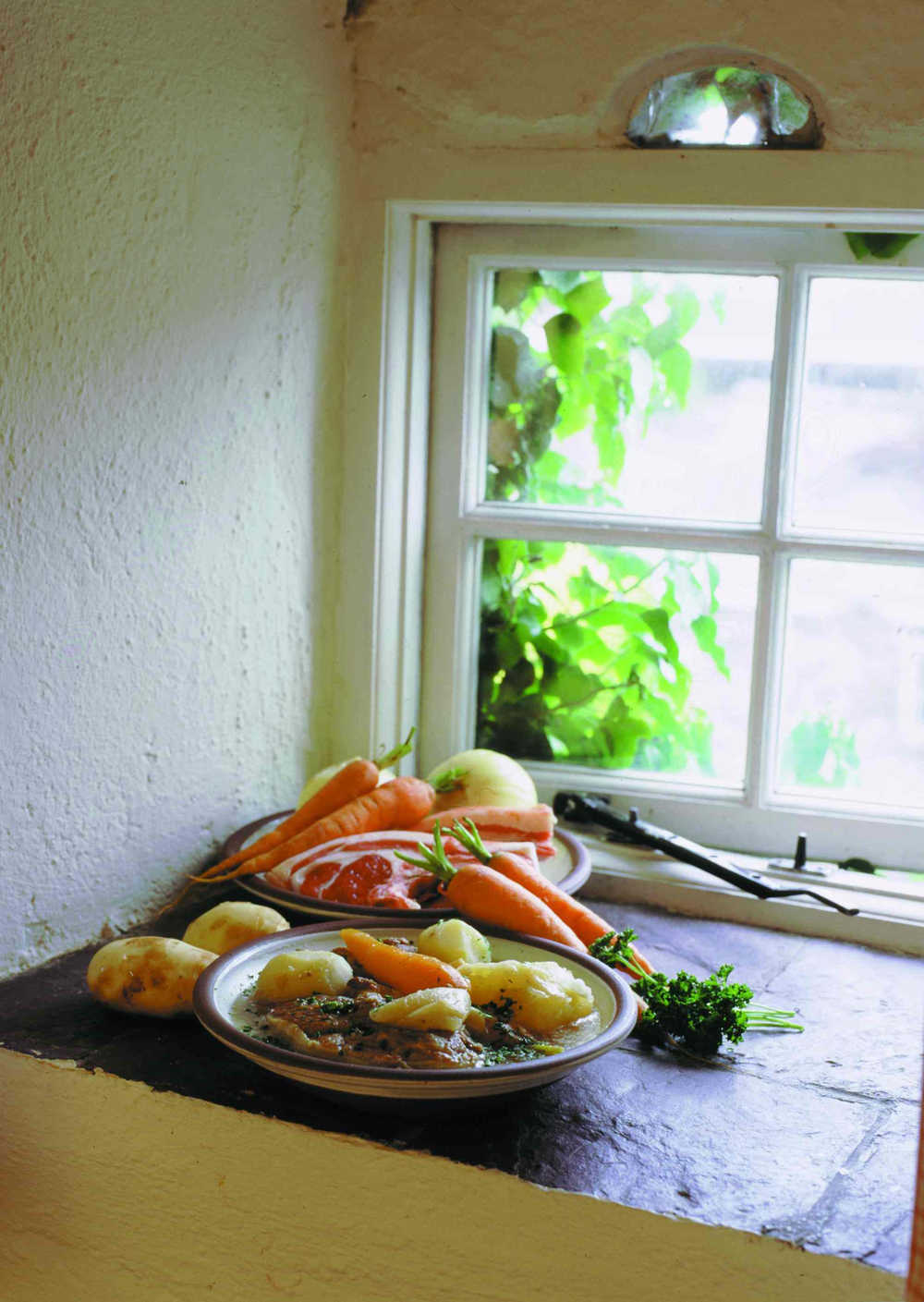 Ballymaloe Irish Stew
Ballymaloe Irish Stew
Irish Stew can be a truly great dish. A perfect example of the difference between memorable and mediocre, like all simple dishes it stands or falls on the quality of its ingredients. Done right, it’s an ideal dish for visitors. It reflects the agriculture of this country, suits the climate perfectly and is an anytime kind of meal for visitors on the move.
There are dozens of versions, most of which have more or less the same basic ingredients, but many of them take short cuts with the traditional method and the cuts of meat used.
This version featured in Myrtle Allen’s original Ballymaloe Cookbook (1977) and, while it is by no means the shortest, it makes a good starting point for anyone who wants to understand what a ‘real’ Irish stew is before deciding which shortcuts, if any, can be made without compromising on the quality of the finished dish.
Regarding the great debate that once taxed cooks’ minds as to whether or not an Irish Stew should have carrots in it (any such debate nowadays would be far more wide-ranging, alas), Mrs Allen explains that ‘it is common practice to include them in the south’.
Although it is enjoying a revival in Britain and there are tentative signs of a comeback here, mutton is not widely available nowadays, so ask your butcher for hogget (one year old lamb), which can be used instead; adjust the cooking time according to the choice of meat - which may be taken off the bones before serving if preferred.
There is no shame in adaptation of simple country dishes like this one, that has always been the way, but it’s wise to tread carefully when making changes.
Modern versions of Irish Stew are often made with boneless meats, for example, but the flavour is diminished.
Serves 4
For the mutton or lamb stock (see alternative; also note below*):
1.3kg/2lb mutton or lamb bones
Peelings from carrots and trimmings from other vegetables, such as onion tops
Sprigs of fresh herbs, such as thyme and marjoram
To make the optional drippings:
100g/4oz mutton or lamb fat (OR 3 tbsp unsalted butter, lard or bacon fat, melted)
For the stew:
1.3kg/3lb mutton neck chops or shoulder lamb chops, bone in
4 carrots (about 225g/8oz total), peeled and quartered
4 onions (about 350g/12 oz total), peeled and quartered
1/2 tsp salt
1/4 tsp freshly ground black pepper
4-6 small potatoes (about 450g/1lb total)
15g/1/2 oz butter 1 tbsp chopped parsley leaves
1 tbsp snipped fresh chives
600ml/1 pint reserved stock (or water and a good quality stock concentrate).
To make the fresh lamb stock: Put the bones, vegetable peelings and trimmings, and herbs into a saucepan, and add enough cold water to cover them by 5cm/2”. Bring to the boil, then lower the heat and gently simmer the mixture, partially covered, for about 2 hours. Strain and skim the fat. Reserve 600ml/1 pint of the stock for the stew.
To make the optional drippings: Chop the fat into small pieces and fry it over fairly low heat in a heavy pan until it is rendered. Reserve 45ml/3 tablespoons for the stew.
To make the stew: Heat the reserved drippings in a heavy saucepan and brown the chops in it, in batches. Do not crowd the meat. Add the carrots, onions, salt (see note*), pepper and the 600ml/1 pint reserved stock.
Peel the potatoes and put them on top.
Simmer the stew gently for 11/2 to 2 hours, or until the meat is tender. Using a slotted spoon, transfer the meat (boned, if you wish) and vegetables to individual bowls. Skim the fat from the cooking liquor, then taste and correct seasonings as necessary. Swirl in the butter, parsley and chives and ladle the sauce over the meat and vegetables.
[*Note: If commercial stock is used to replace the lamb stock, the 1/2 teaspoon salt should be omitted.]
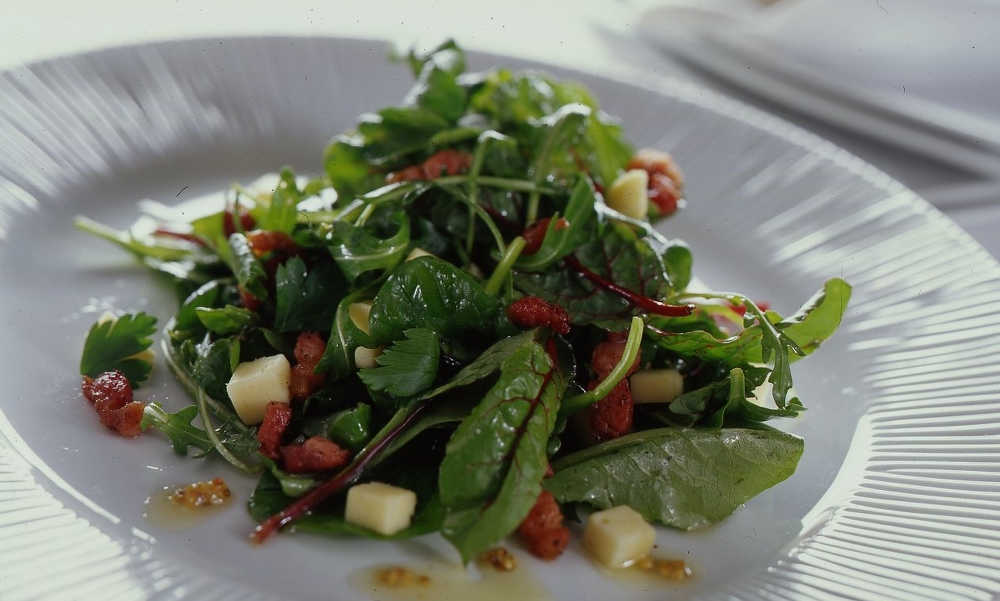 Warm Salad of Gubbeen Cheese and Bacon
Warm Salad of Gubbeen Cheese and Bacon
This gorgeous, no-gimmick salad is a favourite of one of Ireland’s most highly esteemed chefs, Rory O’Connell, who co-founded Ballymaloe Cookery School with his sister, Darina Allen, in 1983 but has only recently become a household name thanks to the success of his book ‘Master It’ (André Simon Award, 2013) and current cookery programmes.
Alongside a distinguished teaching career, he has cooked in many famous kitchens, including 10 years at Ballymaloe House, and is known for a pure, simple and utterly delicious style that highlights the quality of seasonal and artisan ingredients.
Serves 6
15ml/1tbsp olive oil
350g/12oz streaky Gubbeen bacon
6 handfuls of mixed green leaves, washed and dried
65g/2oz Gubbeen cheese, cubed
Dressing:
45ml/3tbsp sunflower oil
45ml/3tbsp olive oil
5m/1tsp Irish wholegrain mustard
30ml/2 tbsp David Llewellyn’s Fruit and Vine Cider Vinegar, or other Irish natural cider vinegar
Salt, freshly ground pepper and sugar to season.
Heat a frying pan and add a little olive oil. Cut the bacon into lardons.
When the oil is smoking, add the lardons of bacon and fry until crisp. While the bacon is cooking, put all the ingredients for the dressing in a bowl and whisk with a fork.
Toss the leaves in the dressing and divide between six hot plates. The leaves should be just glistening with the dressing.
Sprinkle the cubes of cheese around the leaves and finally the bacon straight from the pan.
 Marlfield Rhubarb Chutney
Marlfield Rhubarb Chutney
Marlfield House (www.marlfieldhouse.com) is a fine Regency period mansion just outside Gorey in Co Wexford and, in the hospitable hands of the Bowe family, it makes an exceptional small hotel which food lovers will especially enjoy.
Carefully tended kitchen gardens supply much of the fresh fruit, vegetables and herbs required by the house, and guests enjoy going to see for themselves the good things that will later feature at dinner - which is served in an elegant dining room with period-style conservatory overlooking the beautiful gardens or, these days, in the delightful new informal restaurant, The Duck, which borders right onto the kitchen garden.
This chutney is a versatile accompaniment for many foods. One suggestion is to serve it with cheese fritters which could be either a first course or an end of meal savoury, and at Marlfield would made with one of the excellent brie- or camembert-style cheeses produced in the region.
1lb/450g rhubarb, trimmed and sliced
12oz/350g onions, peeled and sliced
6oz/175g raisins
13oz/375g brown sugar
3/4 pint/450ml Irish cider vinegar
3 tsp salt
1 tsp ground cinnamon
1 tsp ground ginger
1/2 tsp ground cloves
a pinch of cayenne pepper
Put all of the listed ingredients into a stainless steel preserving pan and set over a low heat. Stir with a wooden spoon until the sugar has completely dissolved, then bring to the boil.
Stirring frequently, simmer over gentle heat for two hours, or until the chutney has reduced and thickened.
Spoon the chutney into warmed sterilised jars.
Best kept in a cool dark place for 1 month before using
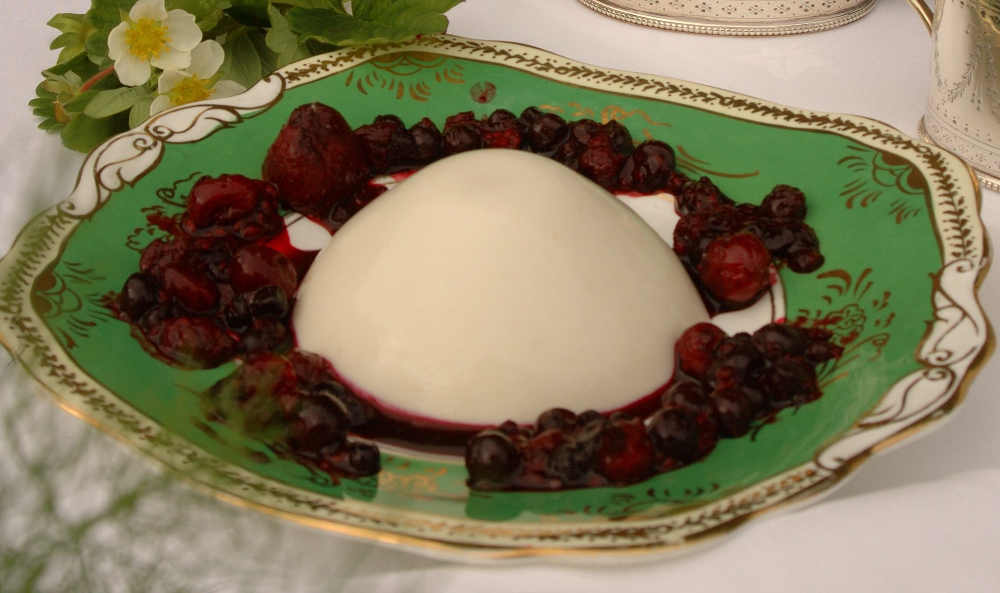 Carrageen Moss with a Compote of Garden Berries
Carrageen Moss with a Compote of Garden Berries
This recipe comes from Rathmullan House (www.rathmullanhouse.com) on the Fanad Peninsula in Co Donegal, where carrageen moss is a very plentiful seaweed.
After decades of declining use, sea vegetables are of course very much back in favour and feature prominently in many contemporary dishes in progressive restaurants - which may well include Rathmullan House’s own main restaurant, now aptly named The Cook & Gardener, where the best home produced and local Donegal foods have been proudly showcased since the 1960s.
But this lovely, simple dish (often known as ‘carrageen pudding’) is a traditional Irish way of using carrageen as a setting agent, and it is equally at home among the desserts at dinner, or on the renowned breakfast buffet served at Rathmullan each morning.
Poached seasonal fruits make the perfect partner - this compote is made with soft fruit from the beautiful organic walled garden at Rathmullan House.
Serves 4
10g/ ½ oz dried carrageen moss
30m/ ½ tbsp sugar
1 egg, preferably free range
1.8 litres/3 pints milk
Compote:
100g/4 oz (total weight) seasonal mixture of berries, eg gooseberries, strawberries, raspberries, blackberries, blackcurrants, blueberries, or loganberries
100ml/4fl oz cold water
20ml/2 dsp caster sugar
To make the carrageen pudding: Soften the carrageen in cold water; this also helps to wash it. Strain.Mix the sugar and egg together and set aside.
In a saucepan, bring the milk to boiling point then, after shaking off all the excess water, add the carrageen. Stir gently, then turn down the heat to a simmer, and cook, stirring occasionally, for 15 minutes. Whisk in the egg and sugar mixture.
Remove from the stove and strain into a clean bowl. Pour into a serving bowl (or into individual dishes), cool and place in the fridge to set for at least 30-45 minutes.
To prepare the compote: Put the sugar and water into a saucepan; heat to dissolve the sugar, then bring to the boil. Add the berries and reduce the heat to very low, then cook for about 10 minutes. Pour into a serving dish and allow to cool.
To serve: Arrange the compote and carrageen moss to complement each other, and serve.
Georgina Campbell's Cookery Feature - Middle Eastern Vegetarian Cooking
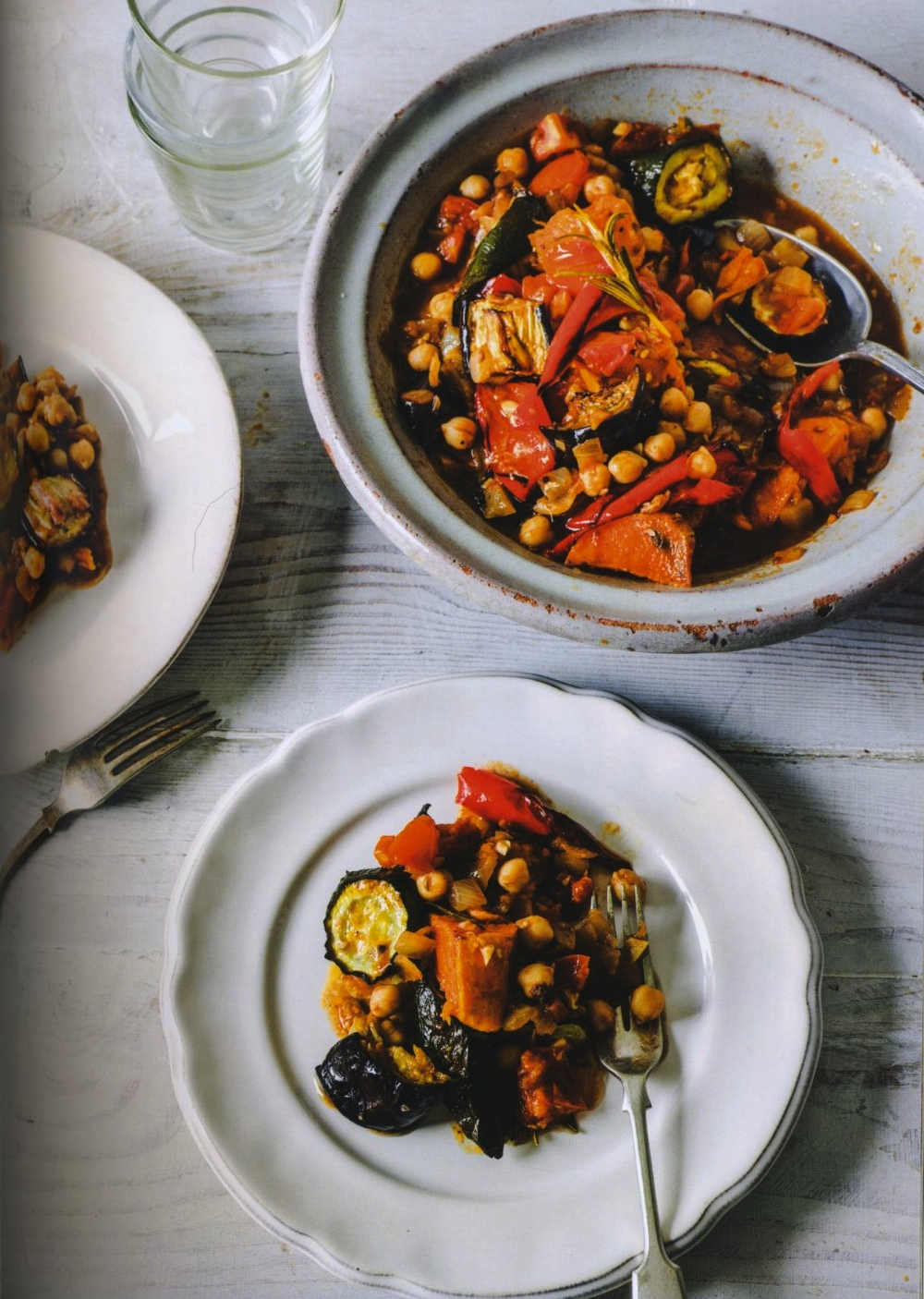
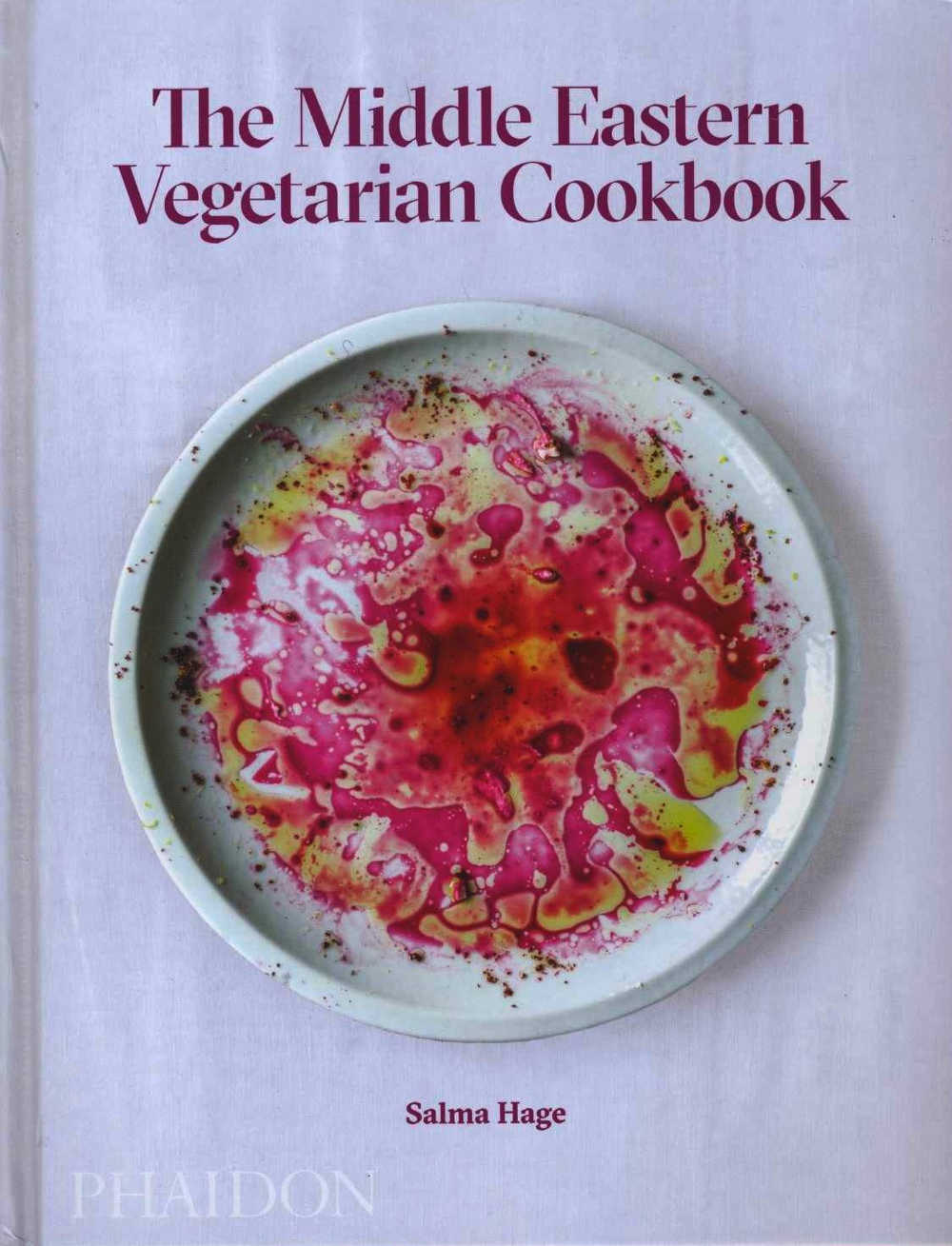 Vegetarian or not, many of us are now choosing to eat less meat (‘less but better’, perhaps) and more plant-based protein. Aside from the health and environmental arguments, one of the great advantages for the cook is that is that it opens up a whole new way of thinking about cooking.
Vegetarian or not, many of us are now choosing to eat less meat (‘less but better’, perhaps) and more plant-based protein. Aside from the health and environmental arguments, one of the great advantages for the cook is that is that it opens up a whole new way of thinking about cooking.
Freed from the habit of considering vegetables and pulses as secondary to meat, we can take pleasure in exploring the rich diversity of cuisines where vegetarian food has long been the norm - and, with its aromatic flavours, unpretentiousness and casual mezze-style dining, Middle Eastern cuisine is especially appealing and offers many ideas that can work very well with contemporary home cooking and entertaining.
A great guide to have beside you on this enjoyable journey would be Salma Hage, a Lebanese housewife and grandmother whose long experience of family cooking and feeding large numbers comes across in the direct style of her books, The Lebanese Kitchen (2012) and The Middle Eastern Vegetarian Cookbook, published this year.
The familiar vegetables, salads and fruits common to the Mediterranean countries are all here, with a touch of the exotic provided by ingredients such as the beautiful jewel-like pomegranate, floral flavours (orange flower, rosewater) and aromatic spices that appear in many dishes - notably the Lebanese 7-spice seasoning mixture (see below) that is so widely used that it is pretty much ‘the taste of Lebanon’.
Using affordable and easily obtained ingredients, the 140 or so recipes often have vegan and/or coeliac versions given and cover every conceivable occasion from breakfast to parties - the flexible mezze approach of Middle Eastern cooking works especially well when catering for a crowd.
You’ll find versions of all the best known dishes such as Baba Ganoush, Falafel, and Tabbouleh along with less familiar ones such as the Lebanese ratatouille know as Msa'aa (see below), the refreshing drinks and salads that are such a pleasure when visiting the region, and beautiful desserts such as Pistachio meringues with rose cream and Strawberry-rose sorbet…
Many of the vegetable recipes would make great side dishes alongside more conventional main courses (chefs please note!) and there are lots of appealing ways to use pulses and grains.
If this is sustainable eating, then it is no hardship. The sheer deliciousness of the cuisine is what’s really appealing about this book - helped along by the beautiful, simply styled photography.
RECIPES from The Middle Eastern Vegetarian Cookbook by Salma Hage, with photography by Liz & Max Haarala Hamilton. (Phaidon, £24.95.)
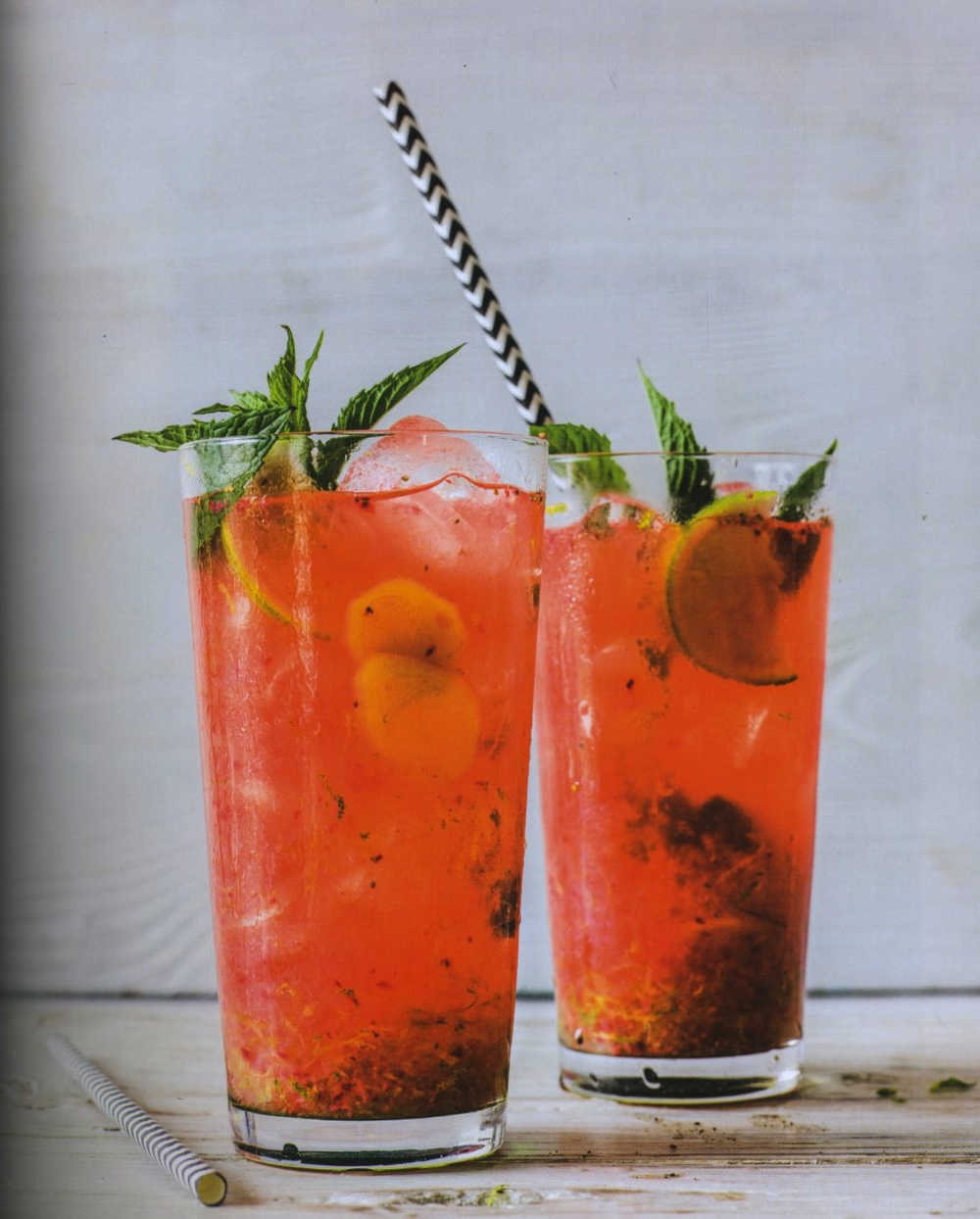
Ginger, strawberry, and mint limeade
This twist on lemonade is flavoursome and delicious—I always enjoy its incredible aroma. The bite of fresh ginger is balanced by a hint of fresh mint. It's a perfect thirst-quencher on a hot summer's day.
Preparation time: 20 minutes + 1½ hours steeping time Serves: 4-6
zest and juice of 6 limes
zest and juice of 2 lemons
2-3 tablespoons honey
2-inch/5-cm piece fresh ginger, peeled and sliced
20 mint leaves, plus extra to serve
10 strawberries, hulled and sliced
plenty of ice, to serve
lime wedges, to serve
Put the citrus zests and juice into a heat-proof pitcher (jug). Add 2 tablespoons honey, the ginger, and mint leaves and pour in 4¼ cups (34 fl oz/1 litre) of boiling water. Set aside and let steep and cool completely, which will take about 1½ hours.
In a blender, purée the strawberries.
Once the steeped mixture is cold, combine with the strawberries, sweeten with more honey, if desired, then strain and serve over ice with fresh mint leaves and lime wedges.
[Vegan] Replace the honey with superfine (caster) sugar.
Lebanese 7-spice seasoning
This is a classic spice-blend recipe that I have been using for many years, but many Lebanese families have their own version of this 7-spice blend. Just a teaspoon of it really lifts so many dishes.
For me, this seasoning captures the taste of Lebanese food and it is a flavour that I find I miss if I don't have it for a while, or if I am travelling abroad.
It only takes a few minutes to prepare once you have all the ingredients together, and you can scale up the ratios to make larger quantities, though the following recipe provides a good amount to start out with.
Preparation time: 5 minutes
Makes: about 1¾ cups (6 oz/175 g)
5 tablespoons ground allspice
3½ tablespoons pepper
3½ tablespoons ground cinnamon
5 tablespoons ground cloves
4 tablespoons grated nutmeg
4 tablespoons ground fenugreek
4 tablespoons ground ginger
Mix all the ingredients together thoroughly and store in an airtight container.
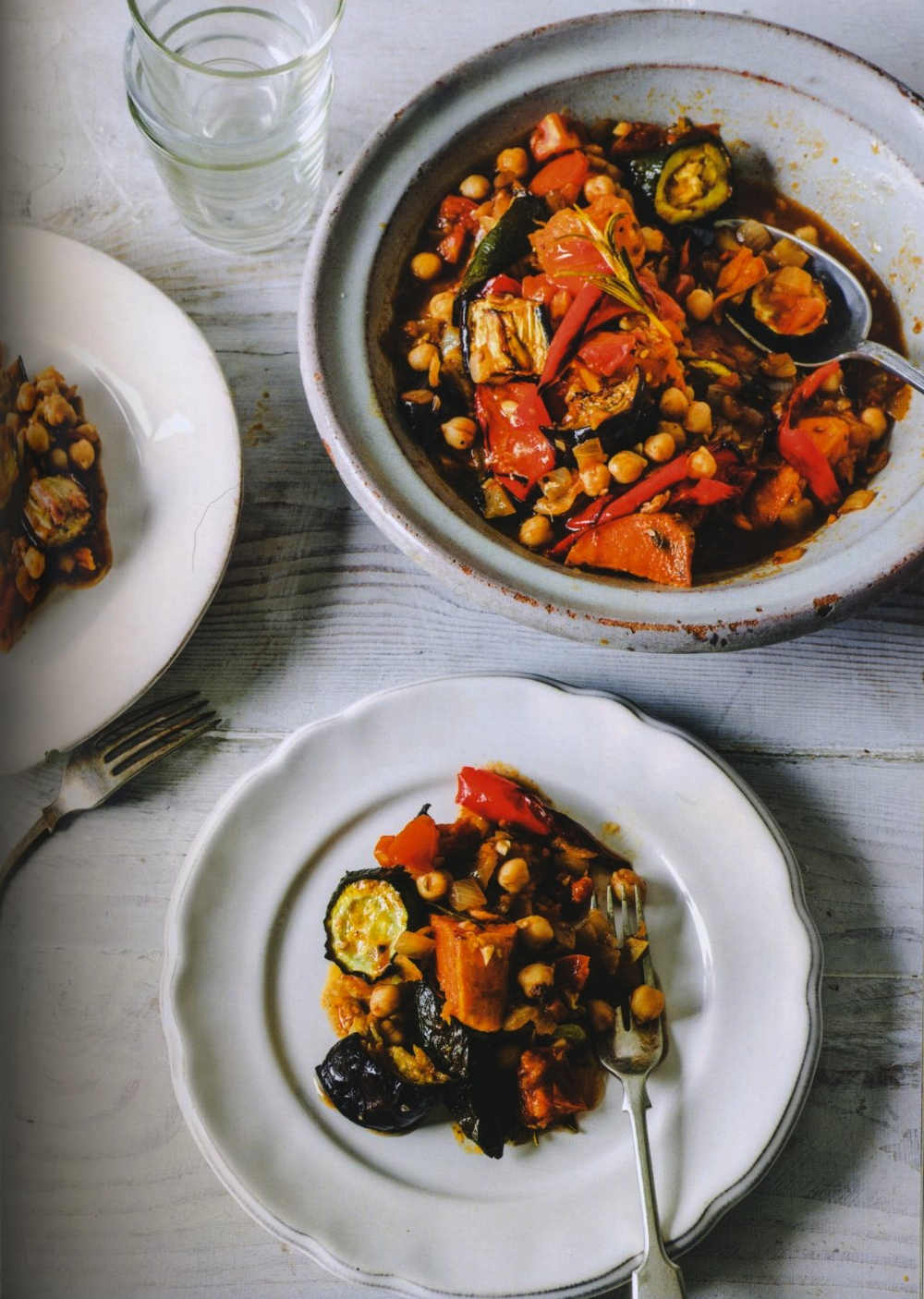
Msa'aa
I'd describe this dish as a kind of Lebanese ratatouille. It is warm and sustaining, and one that people often request when they're coming to dinner. Traditionally, it is served slightly cooled, and is sublime when served over hot rice.
Preparation time: 15 minutes
Cooking time: 1 hour - 1 hour 30 minutes
Serves: 4
Preheat the oven to 400ºF/200°C/Gas Mark 6.
2 sweet potatoes, peeled and chopped into 2-inch/5-cm chunks
2 zucchini (courgettes), chopped into 1-inch/2.5-cm pieces
4 tablespoons olive oil
2 eggplants (aubergines), chopped into 1-2-inch/2.5-5-cm chunks
1 red bell pepper, seeded and chopped into 1½-inch/4-cm chunks
2 onions, finely chopped
7 garlic cloves, finely chopped
1 teaspoon Lebanese 7-Spice Seasoning (see above)
1 teaspoon ground cumin
1 sprig thyme or rosemary
6 tomatoes, coarsely chopped
1 (14-oz/400-g) can chickpeas, drained
scant ½ cup (3½ fl oz/ 100 ml) vegetable broth (stock)
1 tablespoon balsamic vinegar
sea salt and pepper
brown rice, to serve (optional)
Arrange the sweet potato and zucchini (courgette) chunks in a large roasting pan with 2 tablespoons olive oil and season with sea salt and pepper. Toss well, then roast for 10 minutes.
Add the eggplant (aubergine) and bell pepper to the pan and roast, stirring occasionally, for another 15 minutes.
Heat the remaining 2 tablespoons olive oil in a skillet or frying pan over medium heat, add the onions and garlic, and gently cook for 5 minutes, or until softened. Add the spices and the thyme or rosemary and cook for another minute. Add the tomatoes, chickpeas, vegetable broth (stock), and balsamic vinegar and cook for 10 minutes.
Take the pan of roasted vegetables out of the oven and add the sauce from the pan. Stir to combine in the roasting pan.
Wrap the top of the pan in aluminium foil (be sure to wear oven mitts [gloves], because the pan will be hot). Return to the oven and roast for another 20 minutes, stirring occasionally to let the vegetables to soak up the sauce.
Remove the foil, stir, and return to the oven to cook for another 20 minutes.
Remove from the oven, stir again, and let cool for a few minutes. Remove the thyme or rosemary sprig and serve piled on top of hot brown rice, if desired.
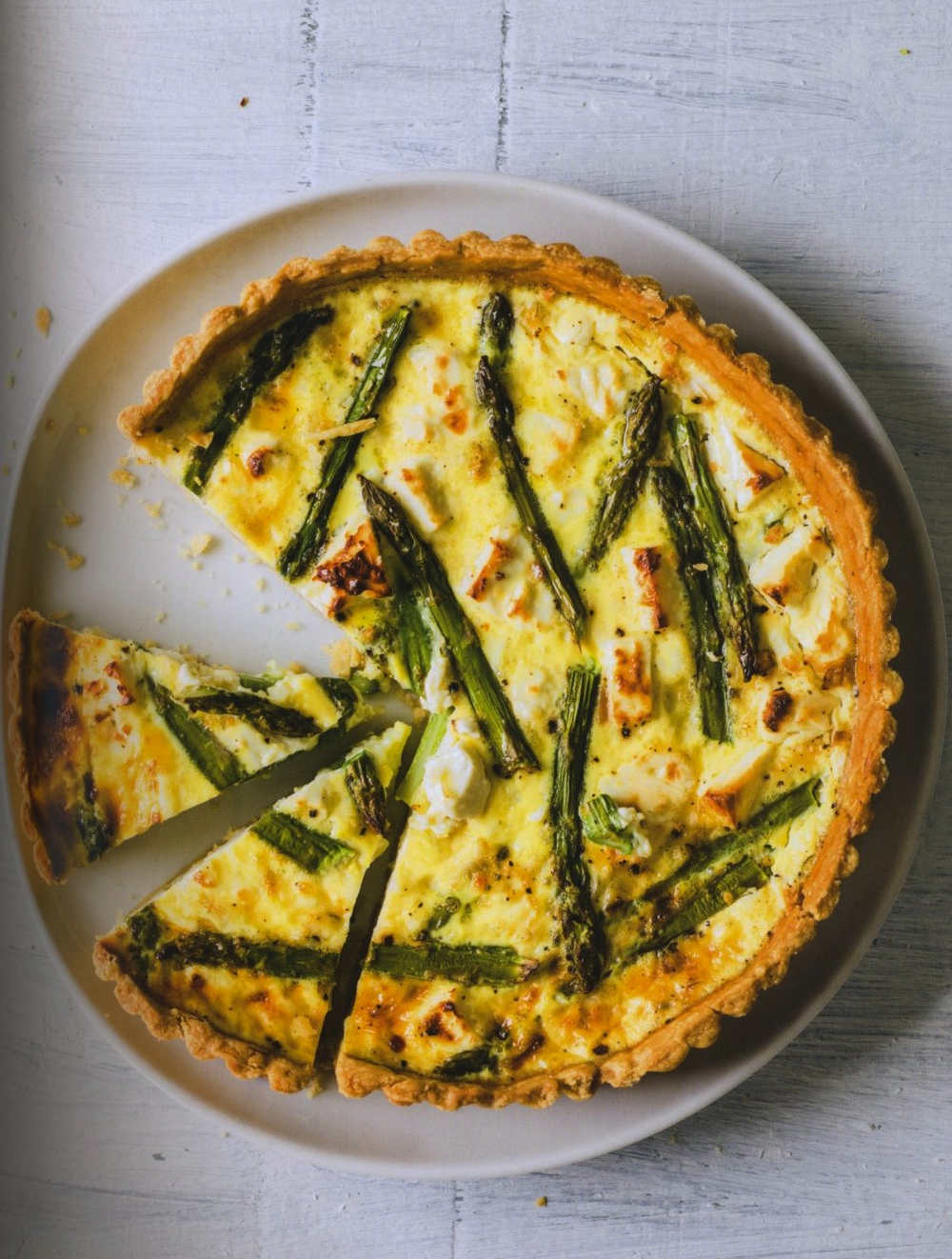
Asparagus and feta quiche
Every so often the French influence appears in our cooking in Lebanon, and nowhere more so than in this classic quiche.
Preparation time: 20 minutes + 30 minutes chilling
Cooking time: 25-30 minutes
Serves: 8
FOR THE PASTRY DOUGH
2 ½ cups (11oz/300g) all-purpose (plain) flour, plus extra for dusting
1 stick plus 1 tablespoon (5 oz/150 g) unsalted butter, cubed, plus extra for greasing
FOR THE FILLING
1 cup (4½ oz/125 g) asparagus tips
1 teaspoon olive oil
onion, finely chopped
garlic cloves, crushed
3½ oz/100 g feta cheese, crumbled
3 extra large (UK: large)?eggs, lightly beaten
1¼ cups (10½ fl oz/ 300 ml) crème fraiche
2 tablespoons fresh ?mint, finely chopped
salt and pepper
To make the pastry dough, put the flour and butter into a large bowl and rub them together with your fingertips until the mixture resembles fine crumbs. Add 4 tablespoons of chilled water and use a blunt kitchen knife to bring the dough together. Then use your hands to shape it into a smooth ball. Turn the dough out onto a floured surface and knead gently and briefly. Wrap in plastic wrap (clingfilm) and chill for 30 minutes.
Preheat the oven to 3750F/190°C/Gas Mark 5 and grease a 9-inch/25-cm fluted tart pan with a removable base.
Roll the chilled dough out on a lightly floured surface, then carefully transfer to the prepared pan, pressing it into the sides and trimming and discarding the edges. Prick the dough with a fork and line with parchment (baking) paper and pie weights (baking beans). Sit the pan on a baking sheet and bake blind for 12 minutes. Remove the paper and beans and bake for another 10 minutes, or until lightly golden.
To make the filling, first blanch the asparagus tips briefly in boiling water. Drain and rinse under cold water, then pat dry and set aside.
Heat the oil in a skillet or frying pan and sauté the onion until soft but not browned. Sauté the garlic and fry for 1 minute. Spread the onions and garlic over the pastry, then add the asparagus tips and feta cheese.
Whisk together the eggs and crème fraiche, add the mint, and season well with salt and pepper. Pour into the pastry shell (case), then return to the oven and bake for 25-30 minutes, or until the filling is golden and just set. Remove from the oven and let set, then slice and serve while still hot.
[Coeliac: Replace the all-purpose (plain) flour with gluten-free flour.]
Georgina Campbell's Cookery Feature - No-Cook Cooking!
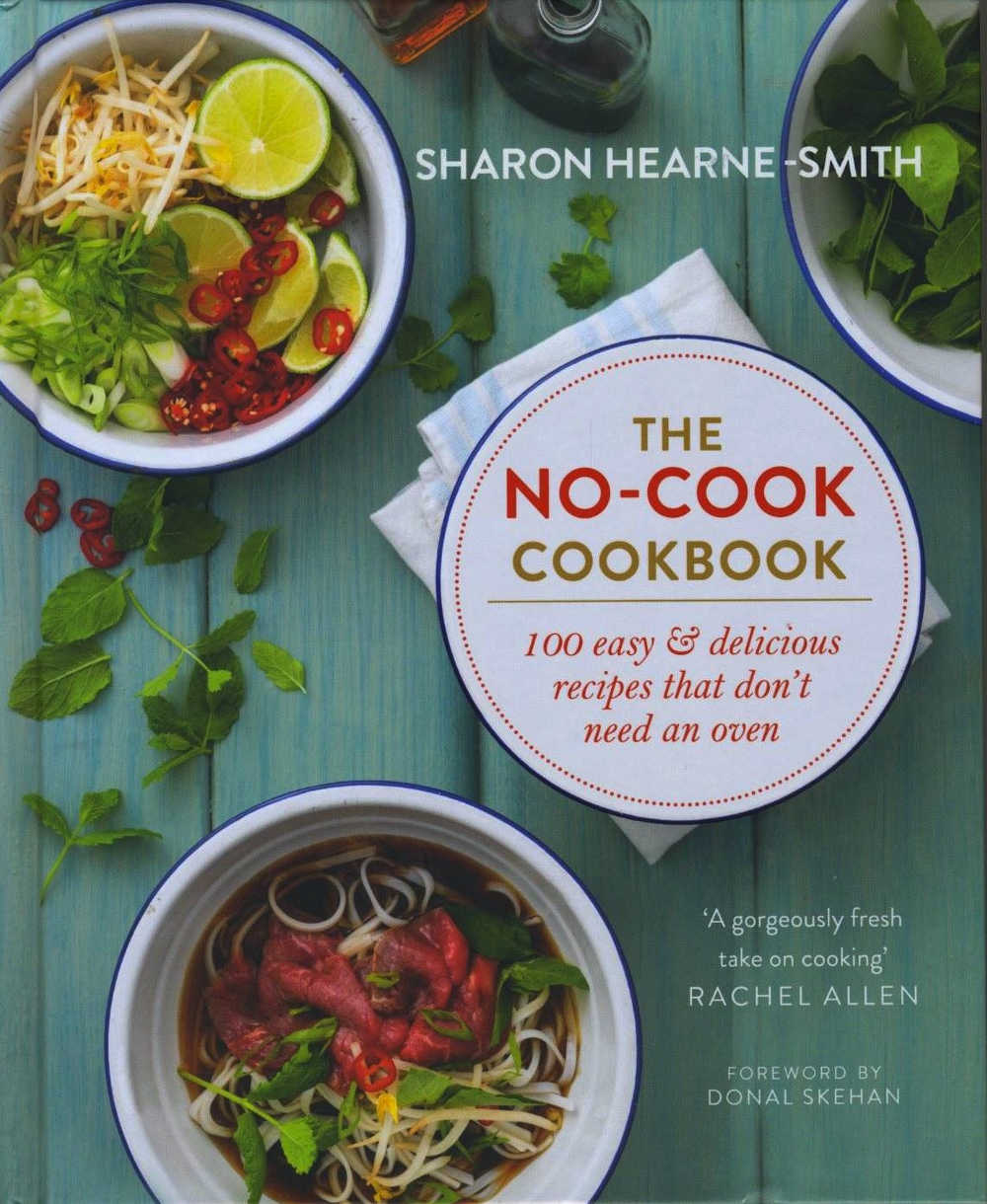
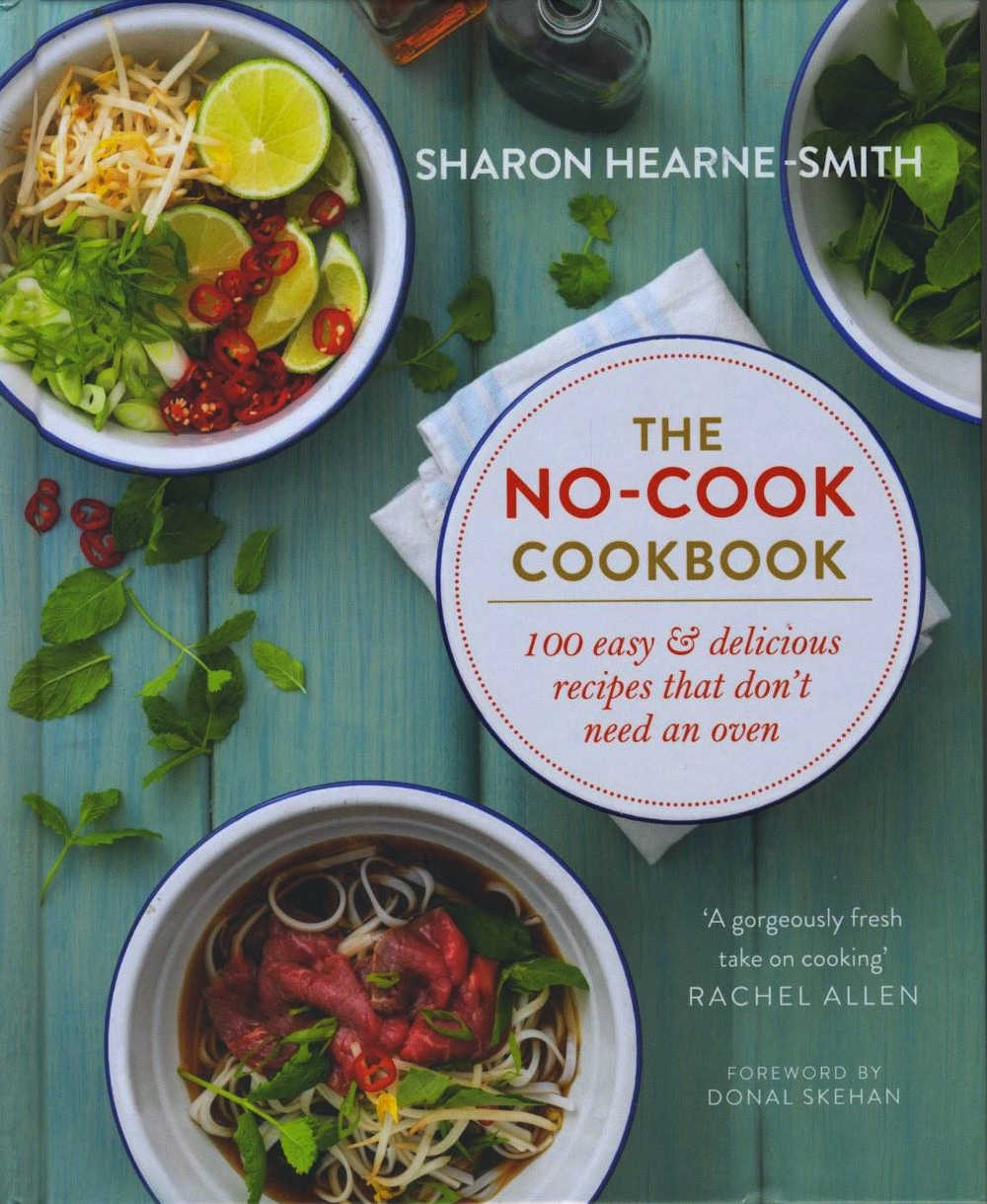 Following on the success of her first book, No-Bake Baking, it was only a matter of time before the impossibly talented and retro-stylish Sharon Hearne-Smith topped it with an even better one, and the time has come - enter The No-Cook Cookbook (Quercus Books, €24.99/£20.00; also available in Kindle, £13.99; Foreword by Donal Skehan).
Following on the success of her first book, No-Bake Baking, it was only a matter of time before the impossibly talented and retro-stylish Sharon Hearne-Smith topped it with an even better one, and the time has come - enter The No-Cook Cookbook (Quercus Books, €24.99/£20.00; also available in Kindle, £13.99; Foreword by Donal Skehan).
In lesser hands this is exactly the kind of book that many of us would be wary of, given all the short cuts and pre-prepared ingredients that go with the territory. But Sharon - who is a member of the Irish Food Writers’ Guild and lives in Dublin with her husband and their little girls, Pearl and Poppy - has nearly two decades of experience of ghost writing, recipe testing and food styling for high-profile cookbooks, food magazines and TV cookery programmes.
And that knowledge and experience shows, in gimmick-free recipes based on wholesome fresh ingredients that she somehow transforms into beautiful, nutritious and noticeably healthy dishes.
The short cuts taken often involve substituting high calorie conventional ingredients with fresh, low calorie and often gluten-free alternatives - the ribbons of courgette that are used instead of pasta in the ravioli dish below, for example.
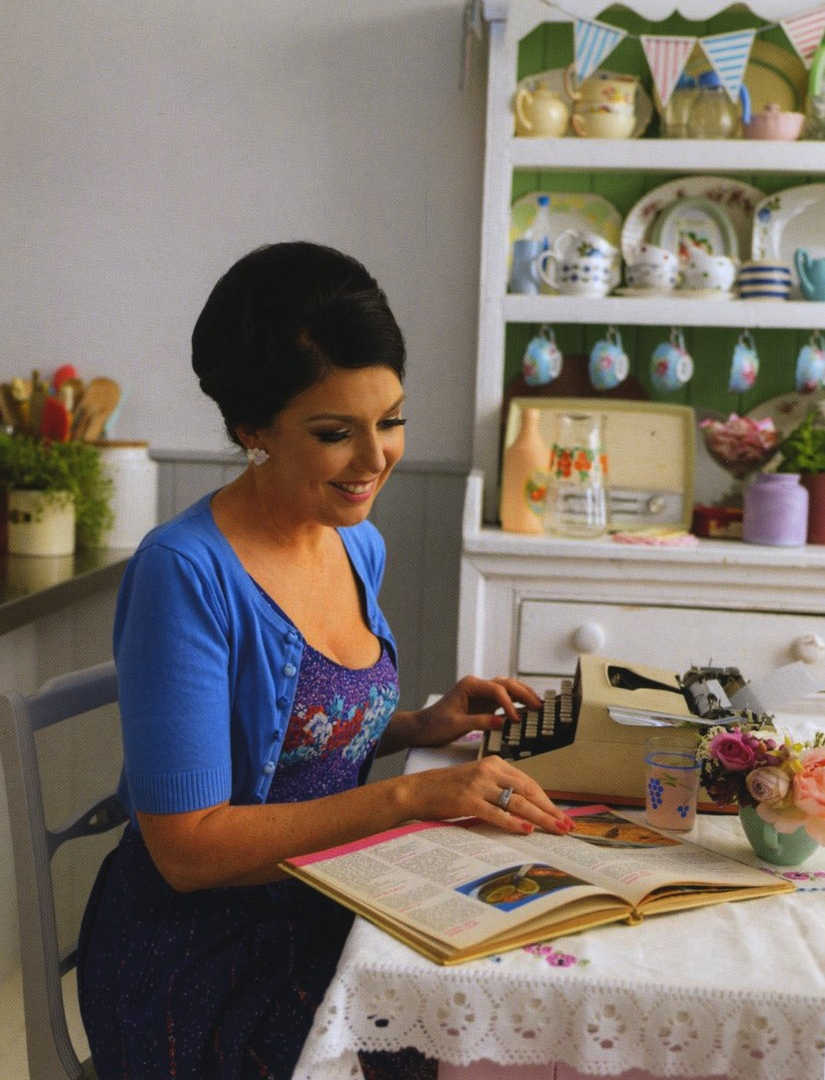
There are 100 recipe in the book, and the range of dishes is wide, covering all meals (even entertaining) and everything from snacks and (very pretty) canapés, to soups, cheats’ pizza, easy sushi and ceviche, and variations on many other familiar dishes. The salads are especially appealing, as might be expected, and the vegetarian dishes are a real strength.
Sharon’s No-Cook Pantry guide gives handy checklists that will make life a lot easier, also suggestions for Useful Kit (notably several types of blender, and mandolin/slicers) and No-Cook Menu Ideas for everything from picnics to garden parties and even Christmas classics (yes, seriously).
Surprisingly, perhaps, not all dishes are cold - kitchen allies like boiling water and hot stock play their part in this but it’s an ideal book for summer (keeping the kitchen cool is one of the advantages cited). Many of the recipes are ideal for picnics - and also for packed lunches, which will come in very handy for family members heading off to school or work.
Fun and practical, no-cook cooking could become a hobby with Sharon Hearne-Smith at your side.
RECIPES:
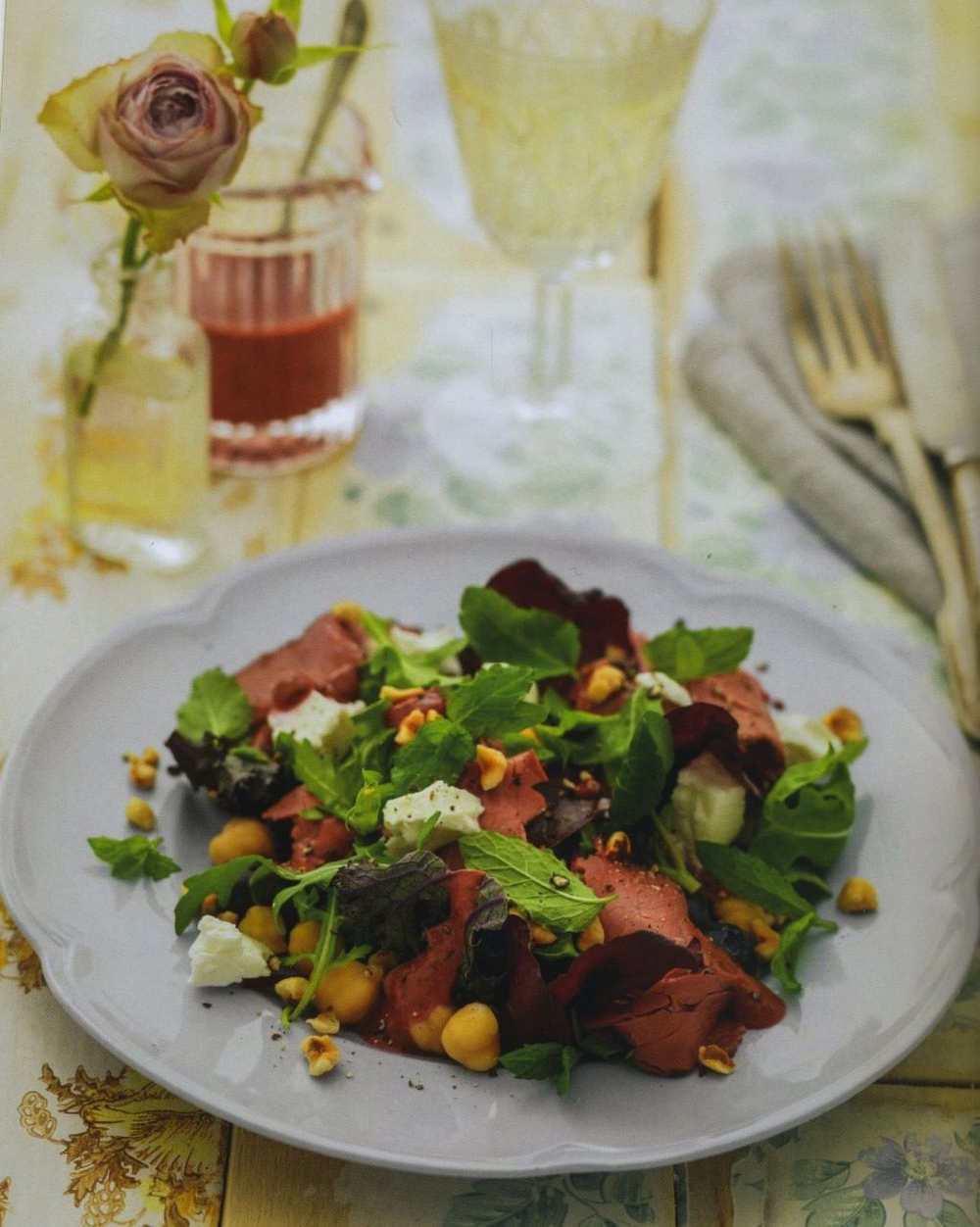
BEEF, BLUEBERRY & FETA SALAD
Combining beef and blueberries in a salad might sound unusual, but they make a surprisingly happy couple. The vinegar in the dressing cuts through the sweetness of the fruit, while the distinctive taste of feta pulls everything together. Try to source good-quality beef slices that are nice and pink - the meat in the photo is spiced beef. Speaking of happy couples, this is a great starter for a romantic meal or dinner party - just increase the quantities if you've got guests. If not eating straight away, keep the dressing separate until ready to serve.
SERVES 2
125g blueberries
2 tbsp extra virgin olive oil
1 tbsp redcurrant jelly
1 tsp red wine vinegar
1 x 215g can chickpeas
75g mixed salad leaves
Small handful of fresh
mint leaves 25g roasted hazelnuts,
roughly chopped 125g cooked beef slices l00g feta cheese
Sea salt and freshly ground black pepper
ESSENTIAL KIT:
Mini-blender
Place half the blueberries in a mini-blender with the oil, redcurrant jelly and vinegar. Blitz until as smooth as possible. Season to taste.
Drain and rinse the chickpeas and place them in a large bowl with the remaining blueberries, the salad leaves, mint and hazelnuts. Chop or tear the beef into bite-sized pieces if necessary and add to the bowl. Give everything a good toss.
Divide between serving plates or bowls and crumble the feta cheese on top. Drizzle with the dressing and serve immediately.
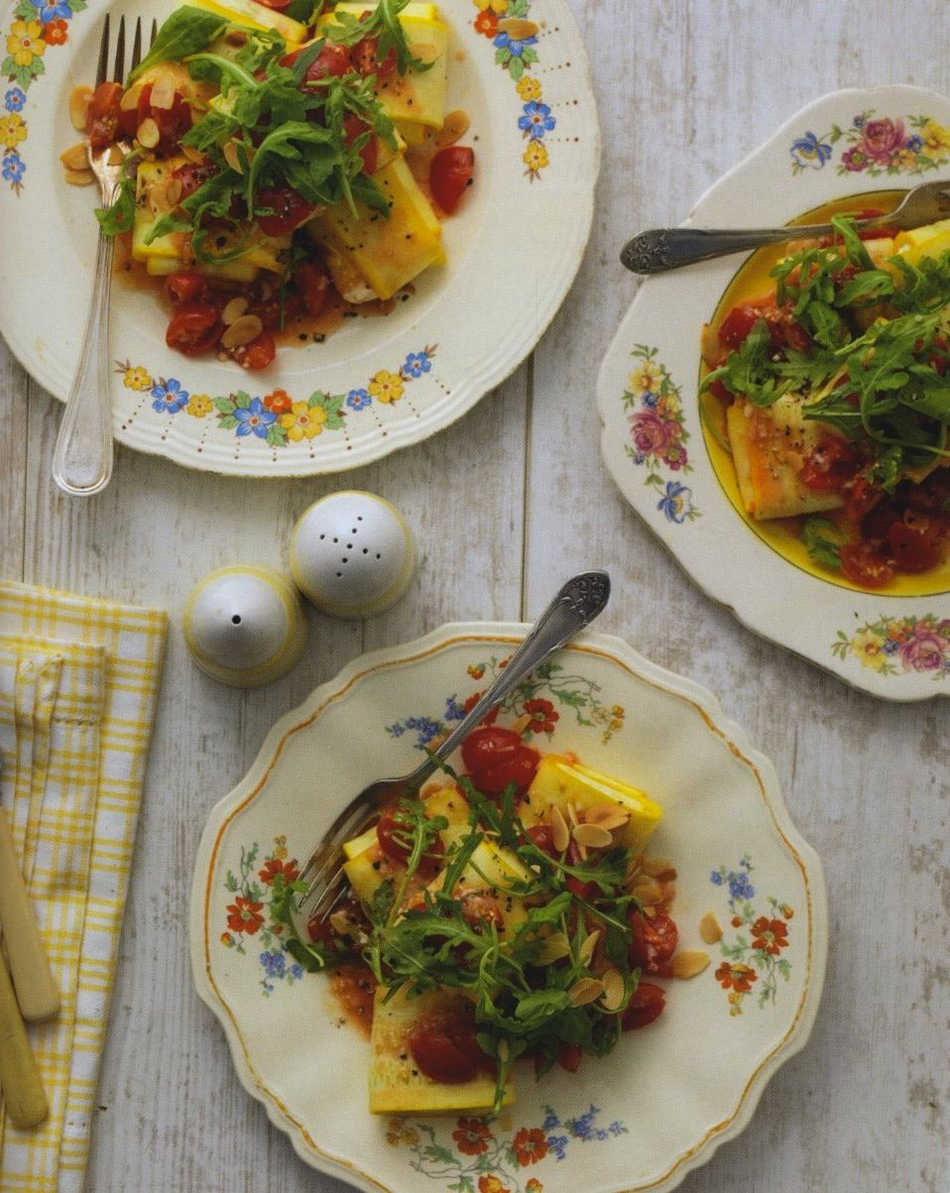
RICOTTA & ALMOND COURGETTE RAVIOLI with crushed tomato sauce
Because this easy no-cook version of ravioli is made from courgettes, it is gluten-free as well as very low-carb. Yellow courgettes are ideal if you want your ravioli to resemble the real thing, but regular green courgettes work perfectly well. It is important to make the courgette strips as thin as possible so that they stay in shape when folded. You can use ground almonds in the filling if you prefer, but it really is worth going to the effort of blitzing toasted flaked almonds for the extra flavour they bring to the dish.
SERVES 4
2 large courgettes, preferably yellow
25ml extra virgin olive oil
l00g toasted flaked almonds
250g ricotta
50g vegetarian cheese, finely grated
Small handful of fresh basil leaves, finely sliced
75g wild rocket
Sea salt and finely ground black pepper
TOMATO SALSA:
3tbsp extra virgin olive oil
1 tsp red wine vinegar
1 shallot, peeled
1 garlic clove, peeled
300g vine-ripened cherry tomatoes, quartered
Large handful of fresh basil leaves, finely sliced
ESSENTIAL KIT:
Mandolin (or vegetable peeler)
Potato masher
Mini-blender
Slice the courgettes into long thin ribbons using a mandolin or vegetable peeler. You need 40 strips in total, at least 12.5cm long. Any trimmings can be used in a stir-fry, soup or salad. Toss the ribbons in a bowl with the oil until evenly coated, and set aside to soften while you prepare everything else.
For the salsa, place the oil and vinegar in a medium bowl. Finely chop the shallot and garlic, add to the bowl and whisk everything together. Season to taste, then toss the cherry tomatoes through. Using a potato masher, roughly mash them up a little so the juices squish out, making a sauce but leaving lots of texture.Finally, stir in the basil. Set aside while you prepare the filling.
Blitz 75g of the flaked almonds in a mini-blender to give fine crumbs. Tip into a medium bowl and add the ricotta, hard cheese and basil. Stir together well and season to taste. This can be made up to two days ahead.
Lay two pieces of courgette criss-crossed over each other on a clean board. Spoon a tablespoon (about 15g) of the ricotta mixture in the centre. Wrap the two ends of the bottom piece of courgette over the filling, followed by the other two ends to enclose. Turn the parcel over so it is seam-side down.
Repeat to make 20 in total, arranging 5 on each serving plate as you go. If making in advance, place them on a large tray lined with nonstick baking paper. These can be made up to two days ahead.
When ready to serve, spoon the tomato salsa over the 'ravioli'. Pile some rocket leaves on top, scatter with the remaining toasted flaked almonds and finish with a twist of pepper.
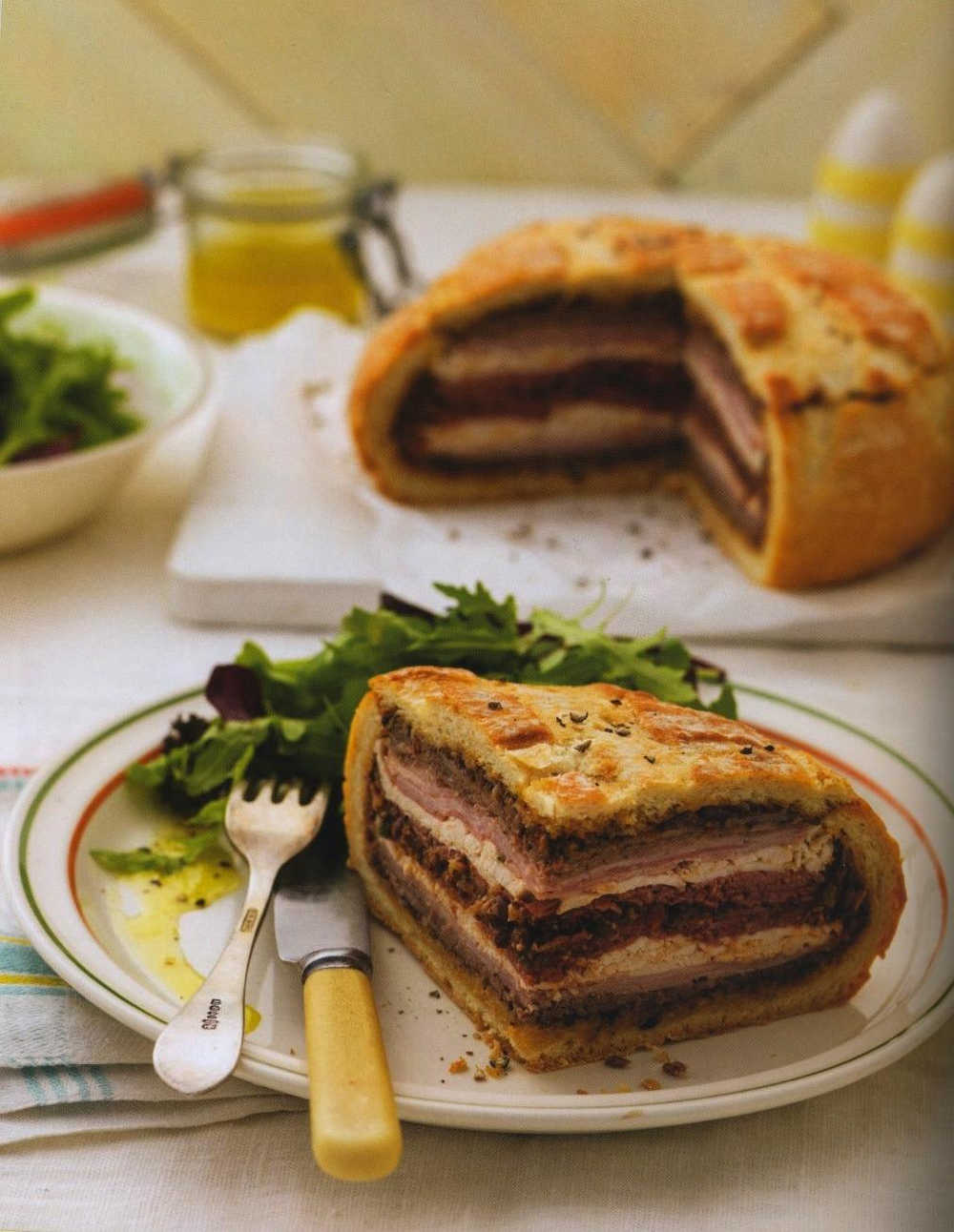
MEAT 'LOAF' with olive salsa
This is based on a New Orleans classic, the muffuletta, which is a sandwich traditionally filled with layers of deli meats, salami and cheese. This version is the ultimate meat feast, perfect for a picnic sandwich or a hearty work lunch. Use any cooked cold meats or salami that you like or have left over in the fridge.
SERVES 4
1 round, white bread loaf (about 500g, 8cm high and 18cm in diameter) 150g each of cooked beef, ham and turkey slices
150g pastrami
Sea salt and freshly ground black pepper
OLIVE SALSA:
75g pitted black olives
75g pitted green olives
50g sun-dried tomatoes (from a jar)
50ml extra virgin olive oil
1 tbsp red wine vinegar
50g cornichons, chopped
1 large garlic clove, peeled and roughly chopped
Small handful of fresh basil
SALAD:
4 tbsp extra virgin olive oil
Juice of ½ lemon
1 tsp Dijon mustard
¼ tsp clear honey, (optional)
75g mixed salad leaves
12 cornichons, to serve
ESSENTIAL KIT:
Food processor
Small tray/wooden board
About 4 full cans of food to act as weights
To make the salsa, place the olives, sun-dried tomatoes, oil and vinegar in a food processor. Add the cornichons, garlic and basil leaves. Give everything a quick blitz so it is roughly chopped. Season to taste (the olives will probably make it salty enough). This can be made up to one week in advance and kept covered in the fridge.
Carefully slice the top off the loaf of bread (about a 2cm-thick piece). Pull the bread out from inside the loaf and the lid, leaving walls about lem thick. [The discarded bread can be used for breadcrumbs (recipes in the book give suggested uses), or saved for the ducks!]
Spread two thirds of the olive salsa all around the inside and the underside of the lid.
Trim any fat or sinew from the meat slices. Arrange half of the beef slices all along the bottom of the loaf, followed by half of the ham, turkey and pastrami. Spread the remaining salsa out evenly on top and then repeat the layers, this time working backwards with the pastrami first, turkey, ham and beef.
Pop the lid back on and wrap it really tightly with cling film. Chill in the fridge for at least 3 hours or overnight, with something heavy on top like a small tray or wooden board with some food cans on top as weights.
When ready to serve, remove the cling film, cut into four wedges and arrange on serving plates.
Put the olive oil, lemon juice and mustard for the dressing in a small screw-top jar. Secure the lid and shake vigorously. Season to taste and add the honey for a little sweetness, if you like.
Arrange the salad leaves beside the meat loaf, drizzle with the dressing, add a twist of pepper and serve with a few cornichons.
Georgina Campbell's Cookery Feature - Savouring Kilkenny
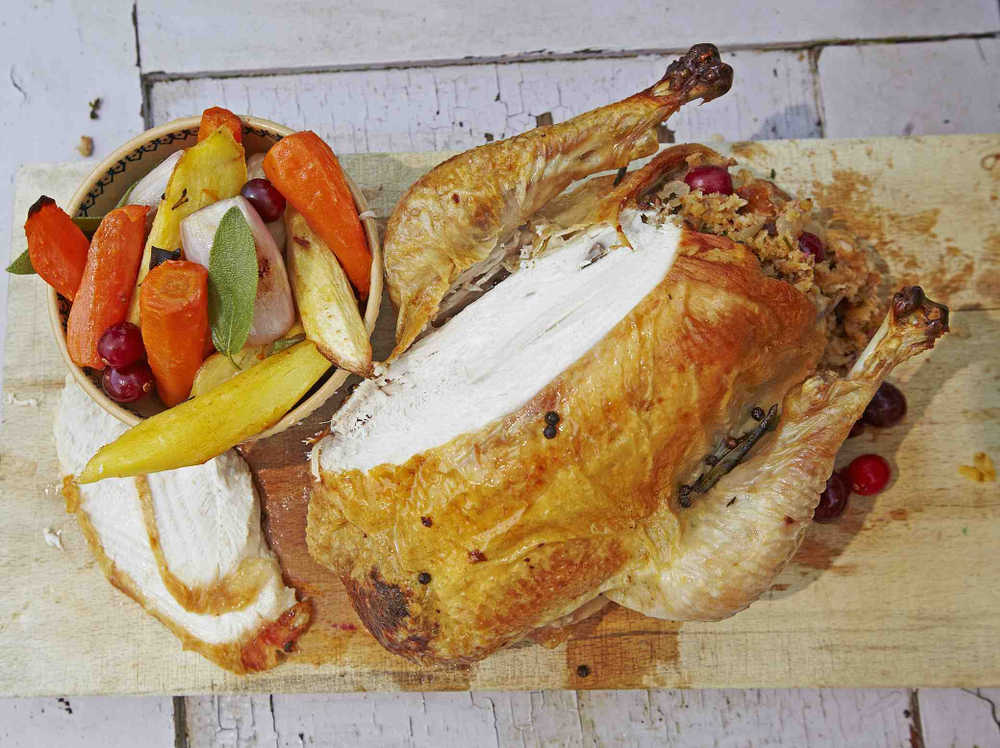
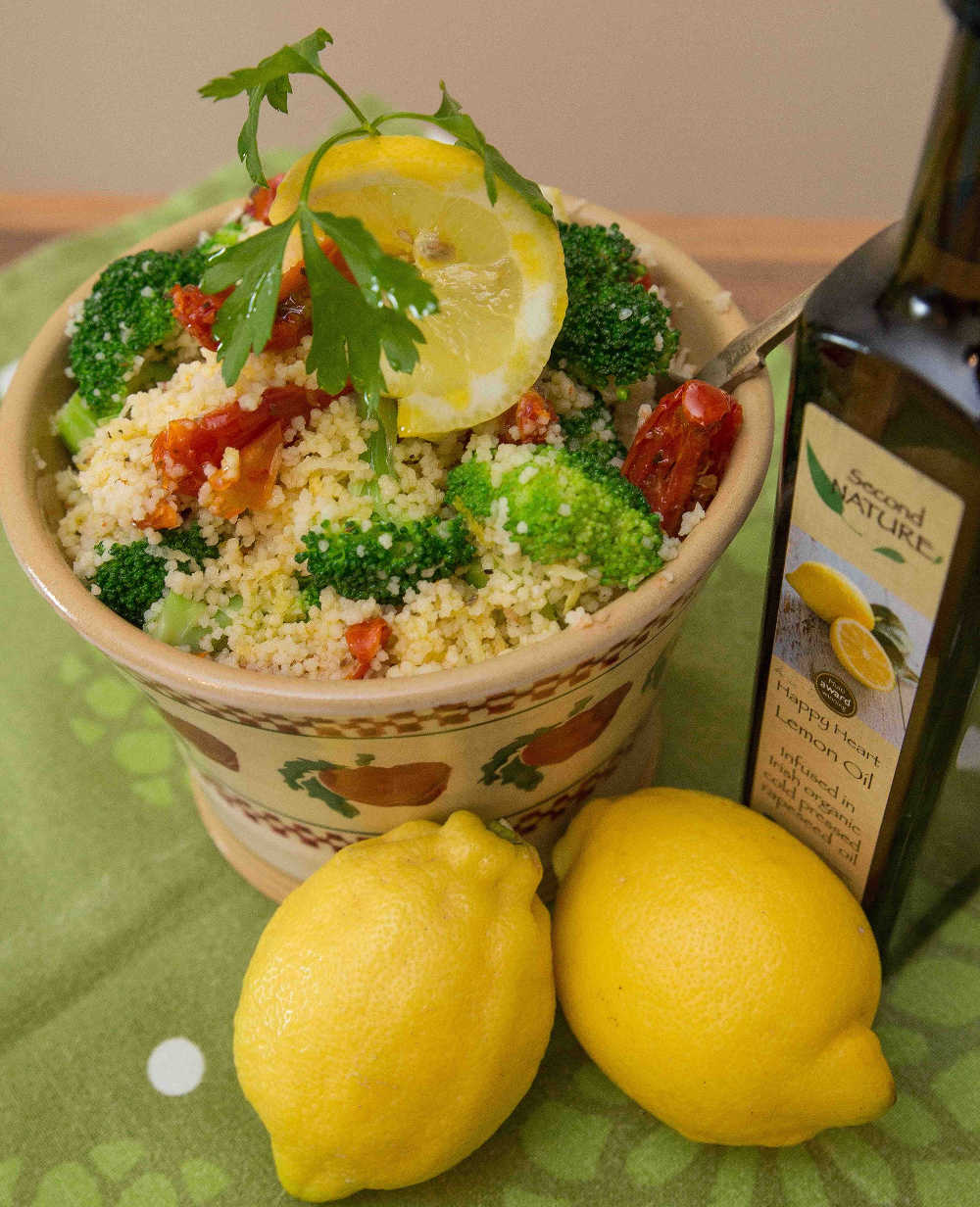
“Cooking, Cocktails and Comedy” is the promise at Savour Kilkenny 2016: in celebration of a decade of ‘delicious dining and demos’ this year’s Festival of Food takes place over the October bank holiday weekend (October 28th-31st), and it’s the biggest yet.
Highlights include Jason Byrne presenting ‘Comedy and Cocktails’; a packed children’s programme with special screenings of favourite food films at Kilkenny Castle; Global Kitchen – the best of world cuisine cooked in Kilkenny; and the very popular Craft Beer and Distillers Pavilion, a mini ‘Oktoberfest’, with DJ and artisan street food.
And this year Savour Kilkenny has come up with the brilliant idea of teaming up with Gill Books to feature demonstrations by some of their most popular authors, including Darina Allen (‘Cooking for Christmas’) and her brother Rory O’Connell, Domini Kemp and Patricia Daly (The Ketogenic Kitchen), plus Paula Mee and Kate O’Brien (‘Your Middle Years’). Susan Jane White, Rosanna Davison and Eileen Dunne Crescenzi will also be there, along with TV Chefs Edward Hayden and Stuart O’Keeffe.
Another excellent intitiative is a Pop-Up Café. And this is no ordinary café: introduced as part of the Gill Books partnership, it’s a place where people can have books by demonstrating authors signed, and the good things enjoyed - including Badger & Dodo coffee, local baked treats and desserts - will be served by young people who are currently unemployed and have been selected for training via Kilkenny LEADER.
Having been trained especially for the event by Anne Neary of Ryeland House Cookery School in Kilkenny, the hope is that this training and experience will lead to full-time employment in the hospitality sector. A great idea, and one that could be successfully applied elsewhere.
Most events are free, details from: savourkilkenny.com
RECIPES:
The popular Kilkenny chef Edward Hayden (http://www.edwardentertains.com/) has been involved with Savour Kilkenny Food Festival since its beginnings ten years ago, and he is an avid supporter of local producers and good home cooking, saying that
“Tasty wholesome home cooking is a genre that continues to reinvent itself in the culinary world and this is one of the main themes to this year’s Savour Kilkenny Food Festival. As chefs and home cooking enthusiasts we are spoiled in the Kilkenny area with the vast array of high end products being supplied by our local food producers, and show-casing such products and their producers is a large part of our festival weekend.”
To whet our appetites for savouring Kilkenny, Edward has compiled some recipes using some of those special local ingredients, including:
Mary Walsh’s Chicken (www.kilkennyfreerange.com)
Lavistown Sausages (www.lavistownhouse.ie)
Anne Neary’s Eggs (www.ryelandhousecookery.com)
Breda McDonald Country Butter (www.ica.ie)
Mileeven Honey (www.mileeven.com)
Kitty Colchester Oils (www.secondnatureoil.com)
Highbank Orchard Apple Syrup (www.highbankorchards.com)
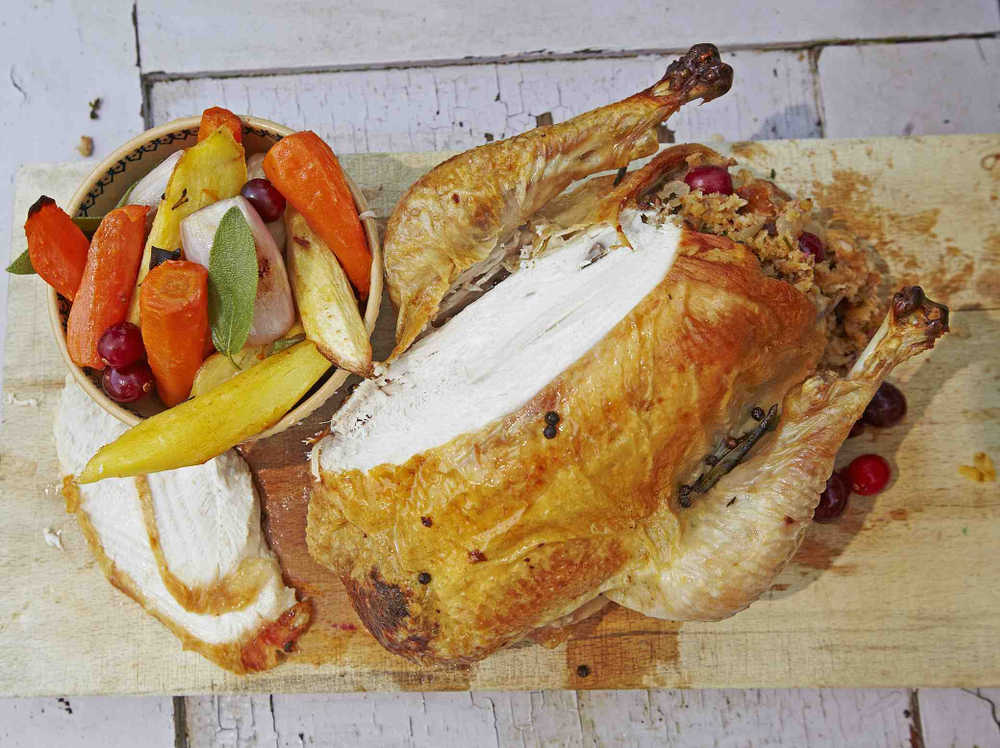
Edward Hayden’s Whole Roasted Chicken with Sausage Meat Stuffing, Glazed Winter Vegetables
Serves 4
There has been a great return to wholesome home cooking of late and, for some, a roast dinner can be still one of the most demanding culinary challenges. Not so with this simple recipe which is sure to impress your family and friends. As a tasty alternative, use this stuffing in pork steaks or even chicken breasts wrapped in bacon.
1 large whole free range chicken (Mary Walsh Free Range Chicken Kilkenny)
4-5 sprigs of thyme
Seasoning
1oz/25g butter, melted
Sausage Meat Stuffing:
3oz/75g butter
1 medium sized onion, diced roughly
Approx 4-5 sprigs thyme, woody stems removed
2 tablespoons freshly chopped parsley
7oz/200g Lavistown sausage meat
7oz/200g soft white breadcrumbs
First make the sausage meat stuffing. Melt the butter in a medium sized saucepan and add to that the diced onion together with the thyme leaves and cook over a very low heat for 5-6 minutes until they have softened completely.
Mix in the freshly chopped parsley and also the soft white breadcrumbs. Season this mixture lightly. Allow to cool. When the mixture is completely cool combine, in a large bowl, with the sausage meat.
Preheat the oven to 200C/400F/Gas Mark 6.
Line the cavity of the chicken with some parchment paper and then stuff the cavity with the cold stuffing and secure the flap with a cocktail stick. Place the chicken on a roasting tray. Sprinkle a little bit of salt and cracked black pepper over the skin. Add the thyme sprigs to the tray at this stage and brush the entire chicken with the melted butter.
Transfer the chicken to the oven and roast for 25-30 minutes. At this stage reduce the temperature of the oven (170C/325F/Gas Mark 3) and cook for a further hour or until the flesh (particularly on the leg and thigh) feels tender and the juices run clear when the chicken pierced at the deepest point. (Or test with a meat thermometer which, when inserted into the deepest part of the thigh without touching bone, should reach 165F/75ºC.)
Glazed Vegetables:
4 carrots, peeled and cut into chunks
3 parsnips, peeled and cut into chunks
2 red onions, peeled & cut into wedges
1 tablespoon rapeseed oil
1 tablespoon honey
Seasoning
Preheat the oven to 170C/325F/Gas Mark 3
Place the chunks of carrots & parsnips into a large saucepan of cold water and bring to the boil. Simmer for 8-10 minutes and then strain off the water. Place the blanched carrots and parsnips onto a flat baking tray with the wedges of red onion and then drizzle with the rapeseed oil and the honey and then season lightly with salt and pepper. Place in the oven and roast for 20 minutes until cooked through

Edward Hayden’s Lemon & Broccoli CousCous
Serves 8
A very refreshing salad.
1 head broccoli, broken into spears
7oz/200g couscous
14floz/400ml boiling water
Zest and juice of 1 lemon
3oz/75g sun dried tomatoes
3 tablespoons Second Nature rapeseed oil
Flat leaf parsley to garnish.
Begin by bringing a large saucepan of water to the boil. Add in the broccoli spears and cook for 60-70 seconds until beginning to soften. Transfer into a large colander and run under cold running water, until completely cooled.
Dry well with kitchen paper.
Put the couscous into a large mixing bowl and cover completely with boiling water. Leave to stand for 10 minutes and then fluff it up with a fork.
Allow the couscous to cool down at this stage for approximately 20-30 minutes
Add the lemon zest and juice and refreshed broccoli. Season well. Mix in the sundried tomatoes and oil.
Mix the salad until it is thoroughly combined, and season to taste. Garnish with sliced lemon and flat leaf parsley.
Chill until required.
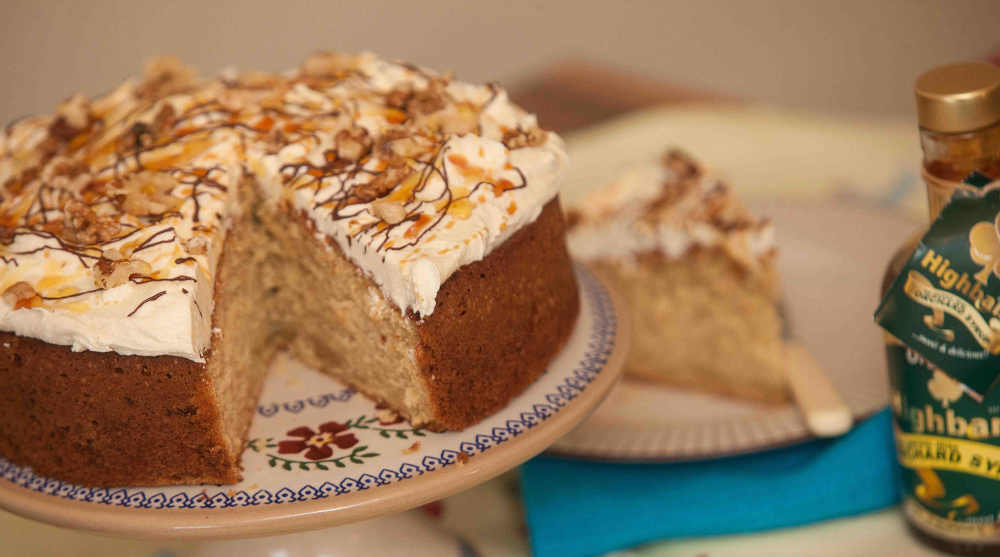
Edward Hayden’s Toffee Apple Cake
Serves 8
This is a great special occasion cake and is delicious to serve warm, without the icing, but with lashings and lashings of butterscotch sauce.
8oz/225g butter
8oz/225g Demerara sugar
4 large eggs
1 tablespoon golden syrup
8oz/225g plain flour
1 teaspoon of baking powder
1 medium sized cooking apple, grated
Icing:
3oz/75g softened butter
6oz/175g icing sugar
Garnish:
Melted chocolate
Chopped walnuts
Highbank Orchard Apple Syrup or honey
Preheat the oven to 180C/350F/Gas Mark 4
Grease and line an 8-inch deep cake tin with some parchment paper.
In a large mixing bowl cream the butter with the Demerara sugar until light and fluffy. Gradually add in the eggs and golden syrup. Sift the plain flour with the baking powder and slowly incorporate it into the butter and egg mixture. Gently mix in the grated apple and mix thoroughly.
Transfer the mixture into the previously prepared cake tin and bake for 45-55 minutes until the cake is cooked or until a skewer inserted into the centre comes out clean. I normally reduce the temperature to 150C/300F/Gas Mark 2 after the first 20-25 minutes, but as ovens vary it is important to test with the skewer before taking it out.
Allow to cool in the tin and then invert onto a wire tray and allow to cool.
Meanwhile make the butter icing. Cream together the softened butter with the icing sugar until light and fluffy and then spread on top of the cake.
To decorate drizzle the cake with some melted chocolate and some apple syrup or honey and garnish with some roughly chopped walnuts
Top Tip:
If you wish to make the butterscotch sauce to accompany this then, in a large saucepan, melt 3oz/75g butter with 3oz/75g brown sugar and 3 dessertspoons of golden syrup. Bring this mixture to the boil and add 9floz/250ml cream. Continue to stir and boil for 2-3 minutes. Allow to cool completely. Use as required.
Cookery Feature - Dee Laffan Shares a Taste of Fermanagh


Lough Erne Resort in County Fermanagh is a place that has long been on my list of must-visit spots in Ireland - now happily checked off the list following a fascinating press trip.
The drive up to Lough Erne from Dublin is through stunningly scenic countryside, passing through county Cavan – Ireland’s own lake district. Surprisingly, the trip is less than two-and-a-half hours yet, when you arrive, you feel as if you have transported away to another world. It is picturesque, quiet and truly peaceful.
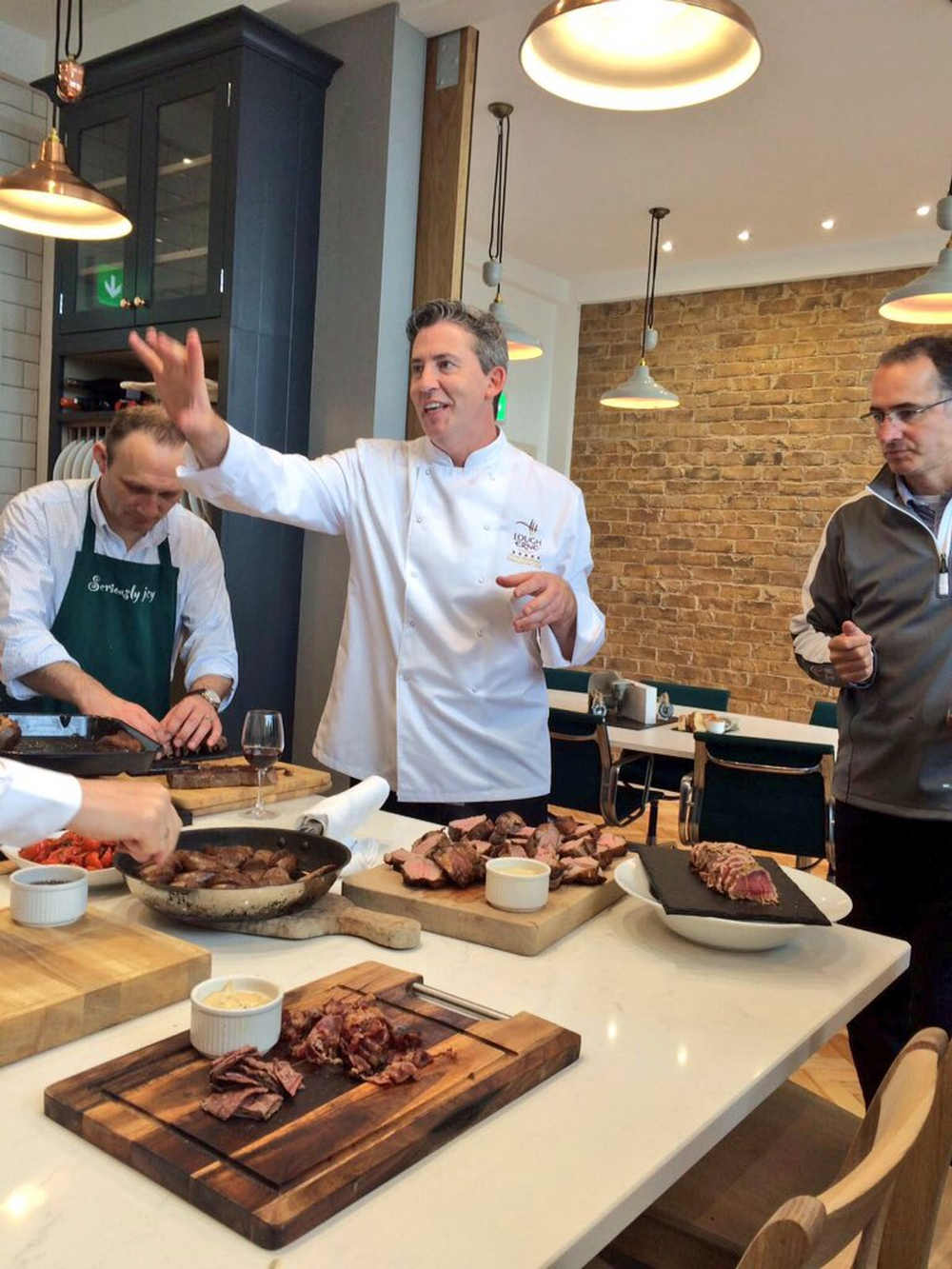
Famed as the venue for the G8 summit in 2013, Lough Erne Resort and Spa is reminiscent of a Disney castle perched on the shores, with turreted loughside lodges, a picturesque lake-filled landscape and two championship golf courses. One of the most fun things we did on our trip was to take a golf buggy drive across the resort to the 9th hole tee beside the lake. In a wooden cabin, there is a small café – a rest stop for a cuppa break if you will – for golfers on their way around the course. A brilliant idea.
The resort is renowned for luxury, which of course comes at a price, but it is also practical for families, even if travelling on a budget, as the 2-3 bedroom Loughside Lodges have a kitchen area as well as excellent accommodation and a communal sitting room and dining room. But dining (formally or informally) in the hotel is not to be missed as Executive Head Chef Noel McMeel’s (pictured right) menus highlight the best of local produce and top-quality Irish ingredients
During our trip some of the wonderful Northern Irish producers that Noel works with were showcased, including: Seriously Juicy of Newtownbutler, Co. Fermanagh; Kettyle Irish Foods of Lisnaskea, Co. Fermanagh (where we enjoyed a visit to see their special beef ageing process); Ruby Blue Spirits of Lisburn; Yardsman Lager, Belfast; MacIvors Cider, from Co. Armagh; and Islander Rathlin Kelp, from Rathlin Island, Co. Antrim.
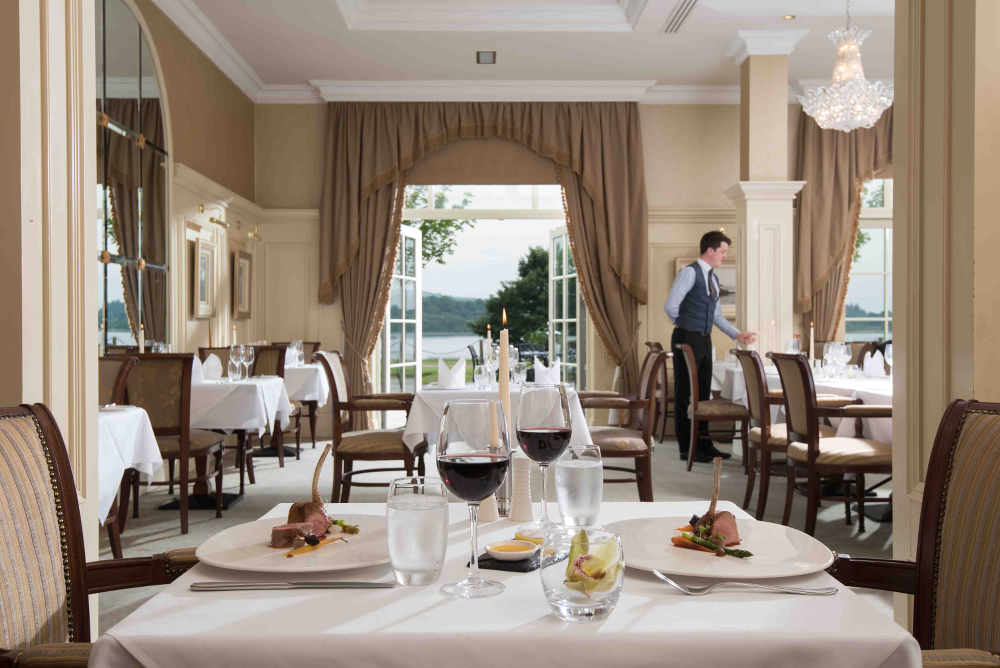
Noel is a true ambassador for local produce and has dedicated his career to one simple goal: finding, preparing and serving fresh food in season. He believes that in Northern Ireland, and especially Fermanagh, they are fortunate to have some of the finest ingredients at their fingertips and privileged to be in a position to work with a diverse array of superb raw material. Noel’s passion for food and his energetic personality shine through in all his achievements, from finding the best local suppliers to inspiring his team of chefs.
Below, Noel shares the recipes for a few of the dishes that he enjoys creating for guests at Lough Erne Resort, so you can sample a taste of Northern Ireland at home.
RECIPES:
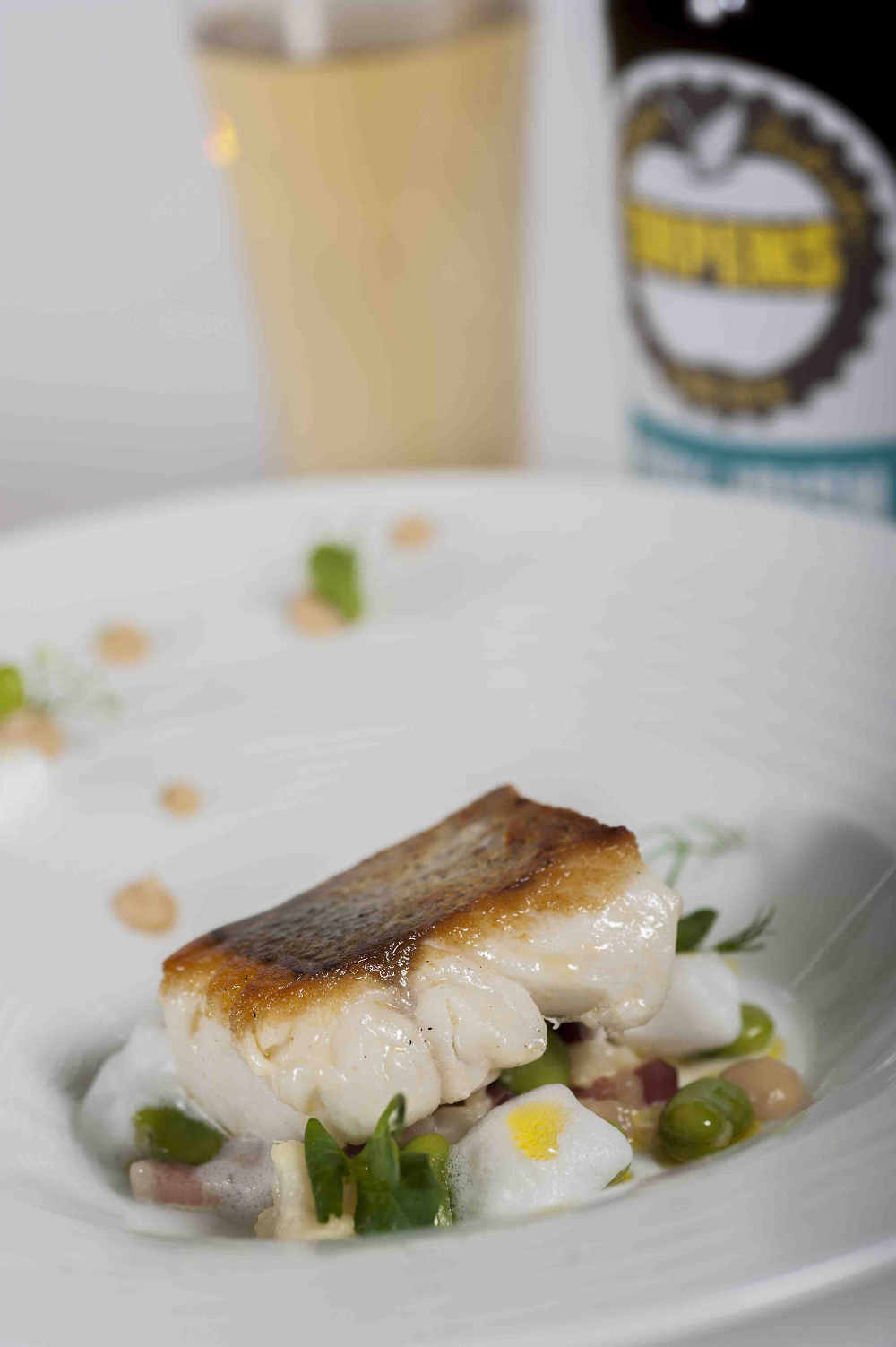
Noel McMeel’s Pan Seared Fillet of Irish Hake, Roast Cauliflower Purée, Broad Beans, Bacon Lardons & Vanilla Foam
Serves 4, with extra bacon lardons and vanilla foam available for other dishes
Ingredients
2 large hake fillets
2 x small heads cauliflower
250g unsalted butter
1 pint/600ml cream
100g broad beans
seasoning
rapeseed oil
1 kg cured bacon
10ml cider
1 vanilla pod
½ lemon juice
½ pt/300ml milk
sugar and salt to taste
Method
- Season the fillet of hake and pan-fry, skin-side-down, for 2-3 minutes, then place into an oven preheated at 180°C and cook for approx 7-8 minutes.
- Break the cauliflower into small pieces and place in a saucepan with butter and cook till tender and lightly coloured. When cooked, drain off the excess liquid and blend for two minutes.
- Add the cream until the consistency is smooth and season.
- Pod the beans and blanch in hot boiling water for one minute. Drain and turn into a bowl; dress with oil and season.
- Slice the bacon into small strips and fry in a pan until light brown.
- Place the cider in a saucepan and reduce by half. Place the reduction, vanilla, lemon juice and milk into a saucepan and leave for 10 minutes to infuse. Season and foam it with a small stick blender.
To serve: Place a spoonful of purée in the middle of the plate, add the fish portions, then the beans and dress with the foam.
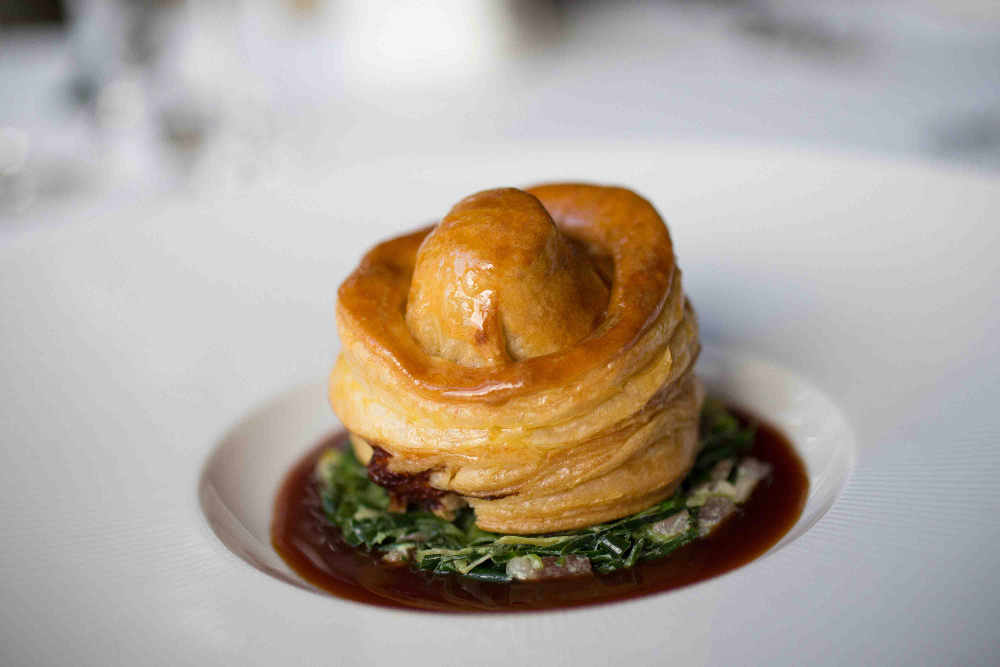
Noel McMeel's Rabbit Pithivier
Makes 6
Ingredients
1 rabbit, oven ready
250ml chicken stock
100ml white wine
100ml verjuice (a commercial acidic fruit juice product)
1 carrot
½ leek
1 medium onion
5 cloves garlic
2 bay leaves
10 peppercorns
3 sheets ready made puff pastry
Method
Cut off legs and section the rest of the rabbit into four pieces. Braise in chicken stock, white wine, verjuice, a combination of carrot, leek, onion, garlic, bay leaf and peppercorns at 150°C.
Take the rabbit saddles out when tender and the rest out when falling off the bone (about four hours). Shred rabbit and reduce braising liquid by simmering, uncovered, until thick.
Fold the sauce through the shredded rabbit and season.
Refrigerate for 1-2 hours.
For the Pithivier (pies), split the mix into six equal portions. Roll out the puff pastry and cut out five rings with a 10cm diameter cutter. Then cut out another five rings with a 12-13cm diameter cutter.
On the small rings, put the rabbit mix in the centre and then cover with the larger ring of pastry and seal the edges.
Place in the fridge for one hour to rest.
When ready to cook, brush with the egg wash and score the top, or just leave it plain
Bake in an oven preheated at 160°C for 15-20 minutes until golden brown.
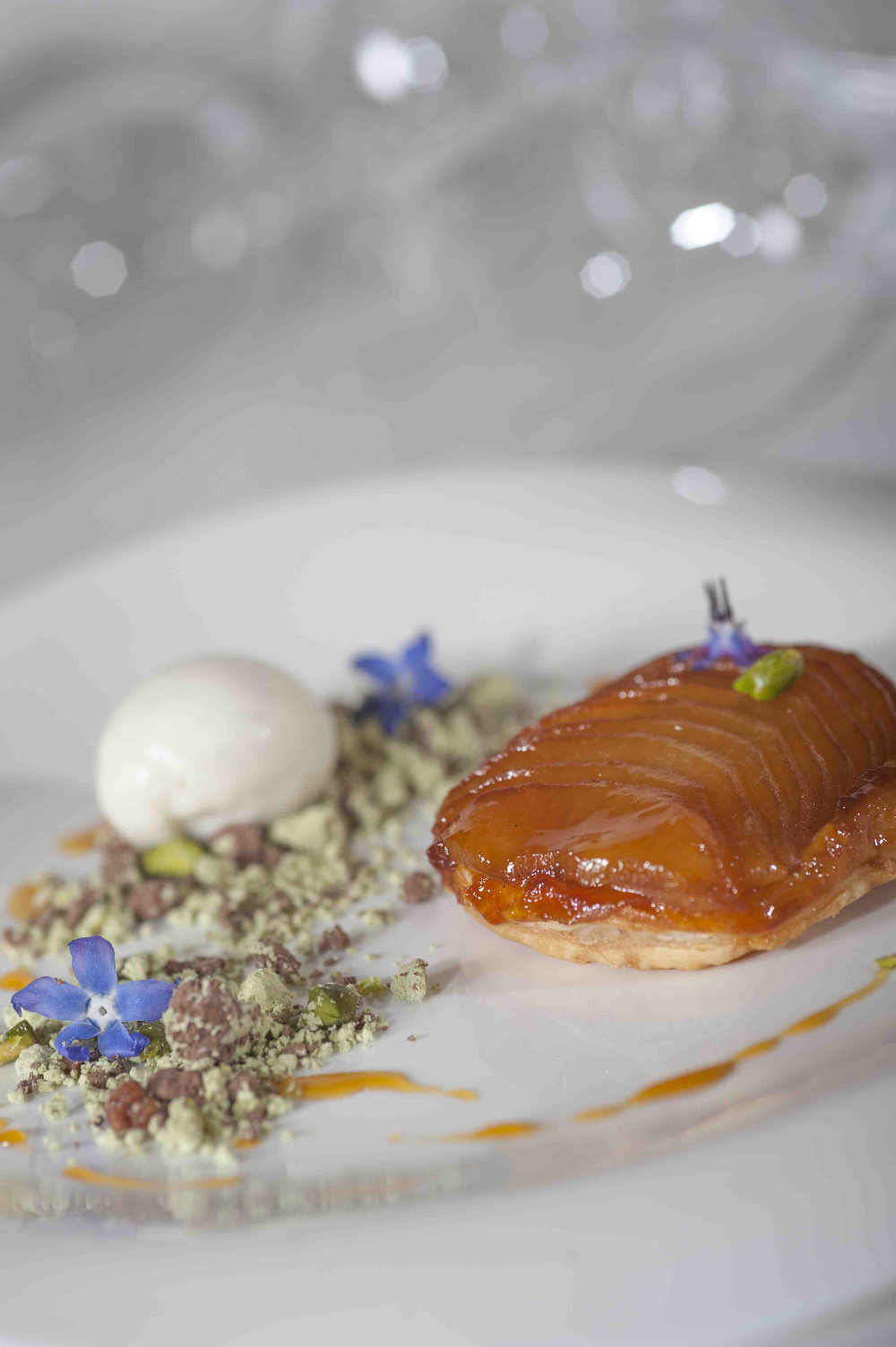
Noel McMeel's Irish Cider Poached Apple Tart Tatin, Cinnamon Ice Cream, Pistachio Soil
Tip: Home cooks will be able to simplify the method (eg there is no need to cook apple in a vac bag in a water bath, just cook gently so it keeps its shape)
makes 8 tarts, with extra ice cream to spare
Ingredients
1 pt/600ml cider
1 pt/600ml water
1 vanilla
8 lime leaves
200g sugar
8 star anise
4 apples
100g caramel syrup
8 puff pastry disks
For the cinnamon ice cream:
1 pt/600ml milk
1 pt/600ml cream
1 vanilla pod
3 cinnamon sticks
209g egg yolks
168g sugar
for the pistachio soil:
100g white chocolate
pistachio paste to taste
30g chopped pistachios
malto dextrin (artificial sugar/polysaccharide)
Place all the main ingredients into a saucepan apart from the apple and bring to the boil.
Peel and core the apple and cut it in half. Place into vac pac bags with infused liquid. Cook in a water bath at 64°C for 45 minutes.
Remove from bag and cut across the apple place the apple into pre-lined mould with the syrup on the bottom.
Place the puff pastry disk on top and bake in an oven preheated at 190°C for 17 minutes.
Remove from the oven, turn out and serve.
For the ice cream: Place the milk, cream, vanilla and cinnamon in a saucepan and bring to the simmer. In a mixing bowl, whisk the yolks and sugar till light and fluffy. Add the infused mix to the yolks and return to the heat and cook gently, stirring, until thickened. Allow to cool overnight before churning the mix in an ice cream machine.
For the pistachio soil, melt the white chocolate and add in the paste. Combine with malto dextrin until a soil like texture is achieved. Then add in the chopped pistachios. Serve as pictured.
----
Dee Laffan is a freelance food writer and editor. Formerly editor of Easy Food magazine, she has written for the Irish Independent and Sunday Independent. She is a proud supporter of Irish producers and their products, and takes part in judging for food competitions including Blas na hÉireann and the Great Taste Awards. She is a member of the Irish Food Writers' Guild and secretary for Slow Food Dublin. Twitter @deelaffan
Georgina Campbell's Cookery Feature - Celebrating Rainbow Trout 'The Forgotten Fish'
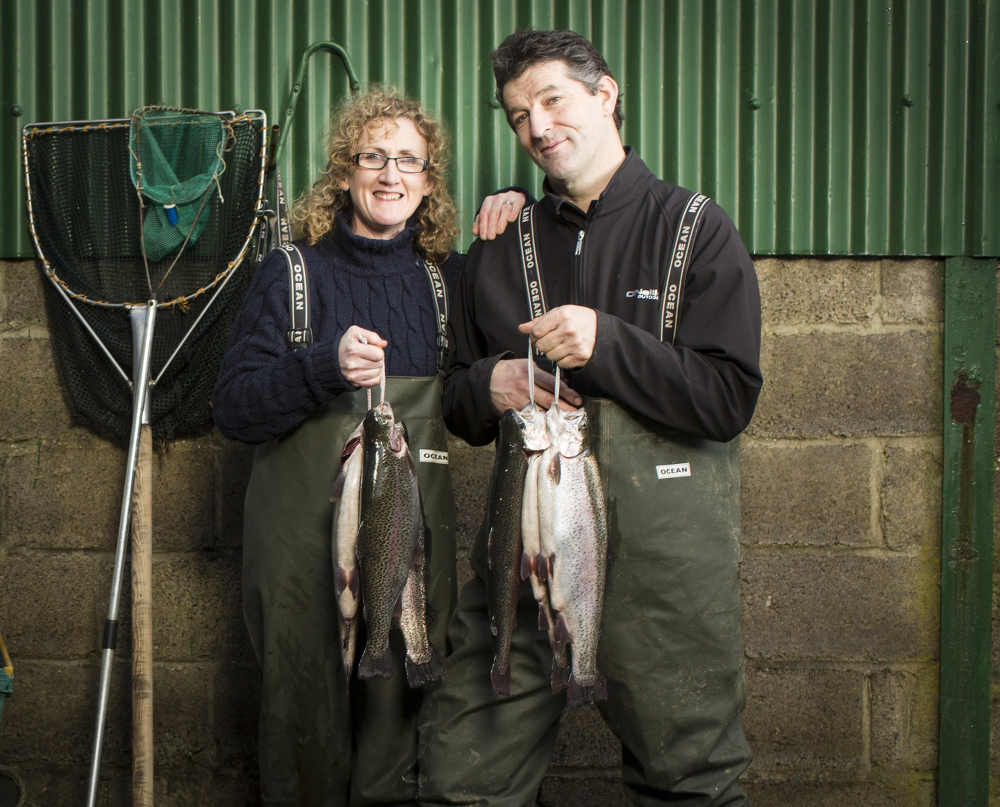

The indomitable Margaret ‘Mags’ Kirwan - who, with her husband, Ger, runs Goatsbridge Trout Farm in Thomastown, Co Kilkenny - has never been short of ideas. The idea of using their rainbow trout to produce Ireland’s only caviar is a recent, and very successful, example of the way she thinks - and she’s been at it again, this time with a charity cookbook, ‘Fishwives’, that was completed just in time to launch in Kilkenny Castle last month, at the Savour Kilkenny Food Festival.
Celebrating rainbow trout, ‘the forgotten fish’, this aptly named book features the recipes of 78 women - the ‘fishwives’ - and all of the proceeds are going to a charity that is very close to her family’s heart, Hospice Africa Uganda (www.hospiceafrica.or.ug), which works to ensure a peaceful and dignified end of life for thousands in Africa.
Women from the world of politics, entertainment, business and food were invited to contribute a favourite fish recipe, preferably trout - and, although there are a few other fish and seafood dishes included, almost all contributors rose to the challenge and made rainbow trout the main ingredient in these deliciously do-able dishes. Surprisingly, there is virtually no overlap and this unique collection of recipes succeeds brilliantly in demonstrating how versatile rainbow trout is in a very wide range of dishes.
The contributing ‘fishwives’ are equally varied, ranging from public figures like former Tanaiste Mary Harney, to inspiring local women such as Julie Calder-Potts of Highbank Organic Orchard and Anne Neary of Ryeland House Cookery School, and chefs, food writers and bloggers from all over Ireland.
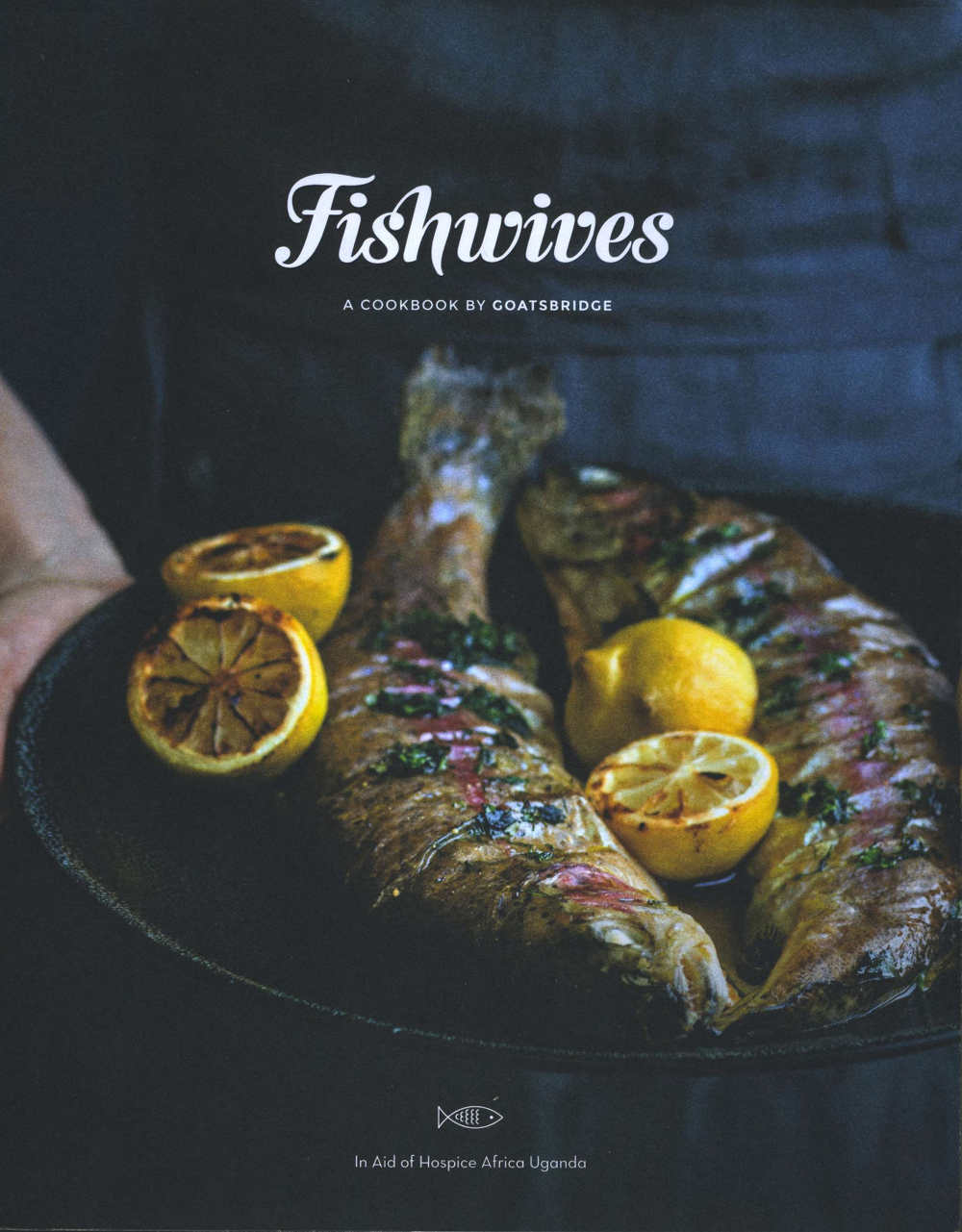
Arranged alphabetically, the contents begin conveniently with Darina Allen, and go on to include many of Ireland’s most influential food lovers ranging from people like Irish Food Writers’ Guild Chairwoman Aoife Carrigy and Helen Carroll of RTE’s ‘Ear to the Ground’ to the newly appointed Chief Executive of Bord Bia, Tara McCarthy.
Mags Kirwan’s four sisters, Miriam, Louise, Joanne and Cathy, all contributed recipes too - and it was Miriam (Donohoe), who volunteered with Hospice Africa Uganda in Kampala for eight months this year, thus providing the inspiration for this book, which also includes a fish pie recipe from the founder of Hospice Africa Uganda, 81-year-old Nobel Peace Prize nominee Dr. Anne Merriman, who travelled from Uganda especially for the event.
Thanks to Slater Design in Dublin, ‘Fishwives’ is not an only interesting and exceptionally useful way to support a worthy cause but also a very attractive, professionally produced and eminently giftworthy book. Mags Kirwan said she expects ‘at least one copy to be under every Christmas tree in Ireland’ this year, which should make the Christmas shopping a lot simpler. But it’s bound to be a sell out - so be sure to get your order in early.
Fishwives – A Cookbook By Goatsbridge; paperback, with original photography by Joanne Murphy; price €20. Available online from Goatsbridge at www.goatsbridgetrout.ie and in selected shops and outlets nationwide.
RECIPES:

Smoked Trout with Poached Eggs & Hollandaise Sauce
An appealing recipe using cold smoked trout, from Anne Neary of Ryeland House Cookery School, Co Kilkenny.
2 servings
100g cold smoked trout
4 free-range eggs
¼ fennel bulb, sliced
Salt and cracked black pepper
125g/5oz butter
2 free-range egg yolks
Salt
½ tbsp white wine vinegar
½ lemon
2 large slices of sourdough bread, toasted
First make the hollandaise sauce. Very slowly melt the butter in a pot over a low heat. Once fully melted, pour off the golden butter fat into a separate saucepan leaving the milky proteins behind. Keep the melted butter warm while you heat a pot of water until simmering.
Place the egg yolks, a pinch of salt, and vinegar in a bowl (large enough to fit over the pot of water) and whisk together until combined. Place on top of the simmering water and continue to whisk until the yolks thicken (this should take three to five minutes).
Take off the heat and add the melted butter, in a slow trickle, while whisking continuously. The sauce will gradually become thick and creamy. Finish with a squeeze of lemon. Cover and keep warm while you poach your eggs.
Bring a small saucepan of water to the boil. Reduce the heat and swirl the water with a whisk. Crack one egg into a small bowl and gentle slide into the whirlpool of water; quickly repeat with the remaining three eggs (at this stage the water should be bubbling very gently). Cook for approximately three minutes.
To serve, divide the cold smoked trout between two warm plates of buttered toast. Top each pile of trout with two poached eggs and spoon over the hollandaise sauce. Garnish with some thinly sliced fennel if you wish and season with cracked black pepper.
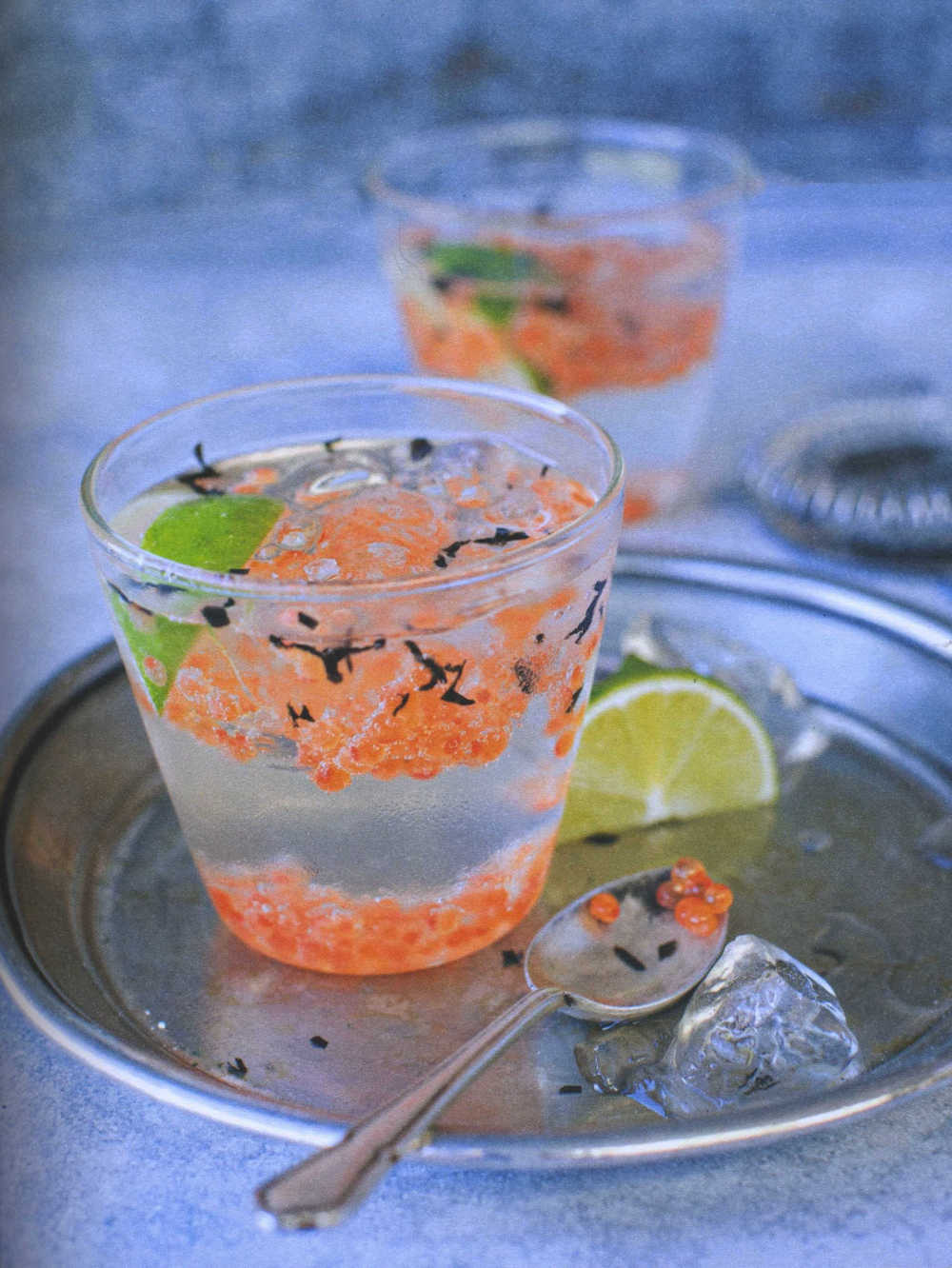
Black & Amber Gin & Tonic
One of the most original recipes in ‘Fishwives’, Julie Calder-Potts of Highbank Organic Orchard combines one of their own products - the unique single estate Highbank Crystal Gin - with Ireland’s only caviar, which is produced by Goatsbridge Trout Farm.
1 serving
1 heaped tsp. Goatsbridge trout caviar
Dried nori seaweed
35ml Highbank Crystal Gin
70ml fever tree tonic
Lime wedges (optional)
In a brandy balloon glass, place the Goatsbridge Trout Caviar.
Add a small sprinkling of nori seaweed and some crushed ice.
Pour over the gin and stir. Top with the tonic water and serve with a spoon on the side for eating the gin infused caviar.
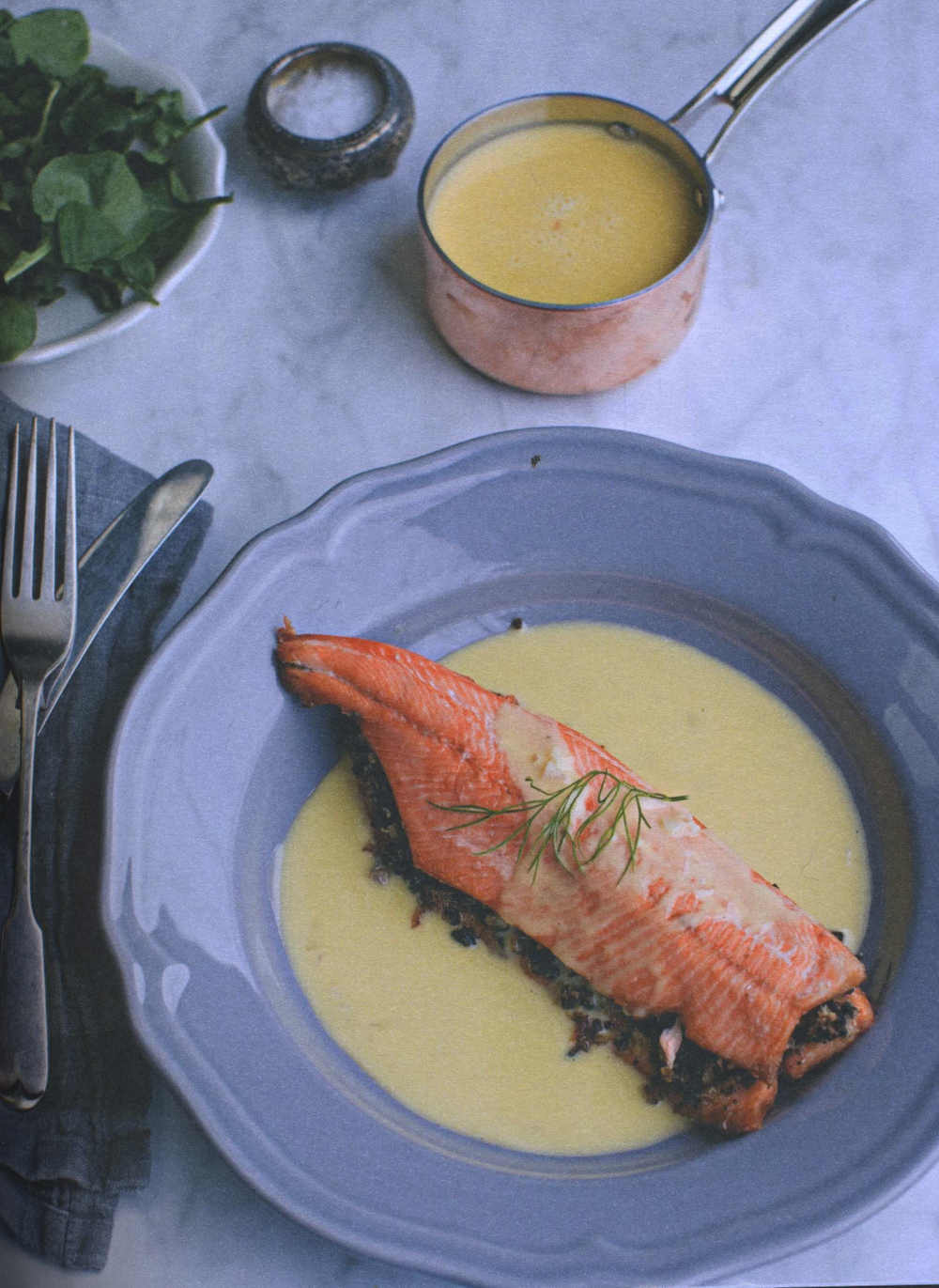
Trout with Inch House Black Pudding & Beurre Blanc
The black pudding hand made by Nora Egan at Inch House, Co Tipperary, is based on a traditional recipe handed down by her mother and as her daughter, Mairin Byrne, shows in this lovely recipe, it associates very successfully with baked trout.
2 servings
4 small trout fillets
50g/2oz butter, softened
Small bunch fresh basil, finely chopped
300g/12oz Inch House black pudding
125g/5oz breadcrumbs
2 shallots, finely diced
3 tbsp. white wine vinegar
300m//10.5fl oz cream
300g//2oz butter, cubed
1 lemon, quartered
Preheat the oven to 180°C/350°F/gas mark 4. Take two fillets and place, skin side down, on an oiled oven-proof dish or tray. Blend the butter and basil together and dot on top of the trout flesh; spread gently.
Crumble the black pudding into the breadcrumbs (use a food processor if you wish) and scatter over the buttered fillets. Place the other fillets on top, flesh side up, and bake for 15 minutes.
While the fish is cooking, make your beurre blanc. Combine the shallots and white wine vinegar in a pot and bring to the boil over a medium heat. Simmer for three minutes until reduced by a third. Next, add the cream and slowly bring to the boil. Take off the heat and add a third of the butter while whisking constantly. Continue to add the butter, a small cube at a time, until the sauce thickens (always stand over the sauce as it can separate).
Serve immediately with the sauce and fresh lemon.
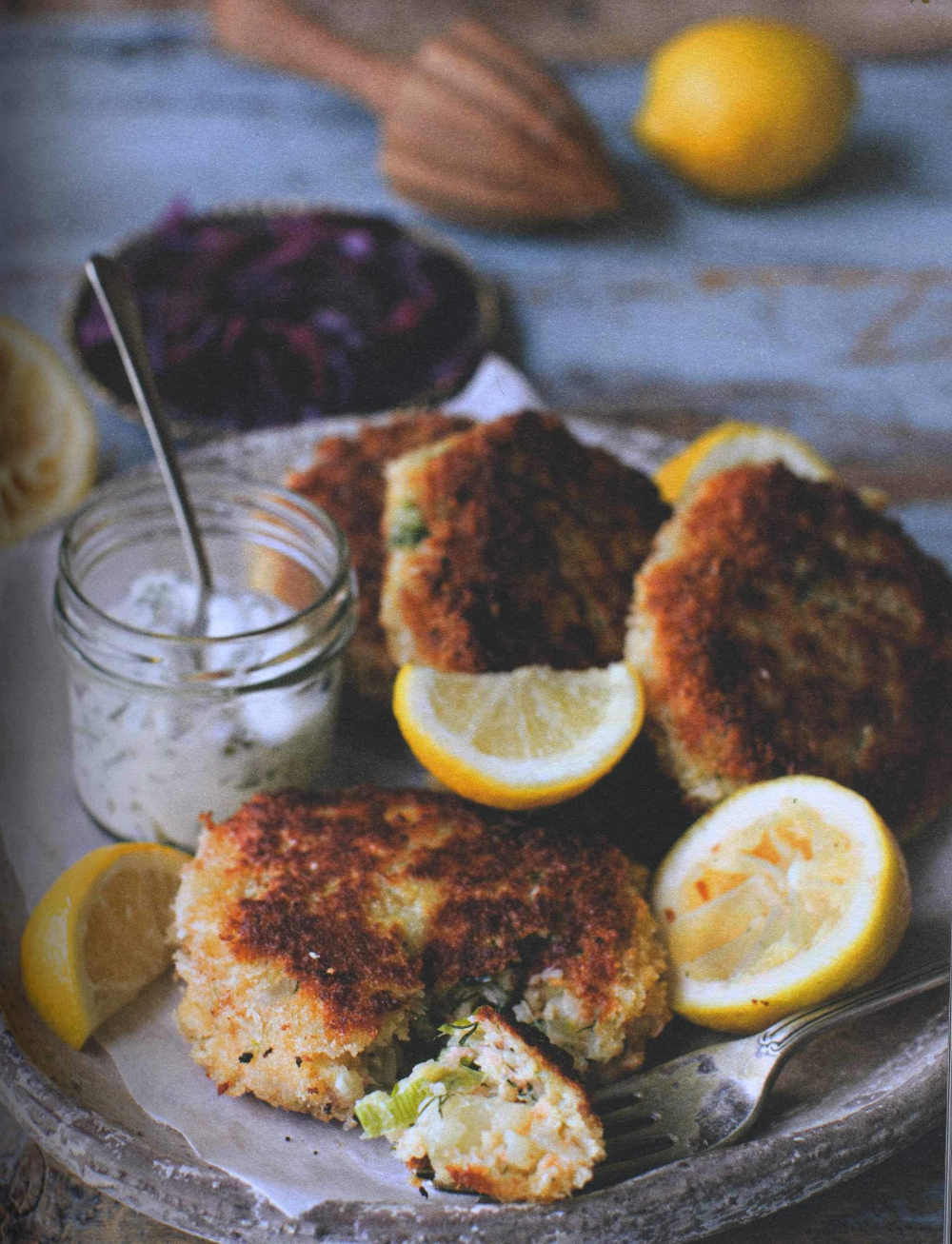
Gluten-Free Herby Smoked Trout Fish Cakes
Tracy Hamilton travelled down to the ‘Fishwives’ launch in Kilkenny Castle from Co Down where, together with her husband Martin and their sons, they grow and process the vegetables sold under the innovative Mash Direct brand. Hot smoked trout is the key ingredient in her gluten-free take on the ever-popular fish cake.
5 Servings
1 kg/2.2lbs baby new potatoes
20g/0.8oz butter
Olive oil
2 garlic cloves, crushed
Large bunch spring onions, chopped
Small handful fresh dill, finely chopped
1 unwaxed lemon, zest
Sea salt and black pepper
1 hot smoked trout side, roughly chopped
1 tbsp gluten-free flour
2 eggs, beaten
Gluten-free breadcrumbs
Gluten-free flour, for dusting
Steam potatoes in their skins until tender, around 20 minutes. Place butter and a drizzle of olive oil in a pan over a medium heat and allow to melt. When slightly bubbling, add the crushed garlic and sweat until translucent but not brown. Add the sliced spring onions and dill and toss until coated in the garlic butter; remove from the heat and add the zest of the lemon and season to taste.
Once the potatoes are cooked, allow to cool and remove the skins by scraping with the back of a butter knife. Place the potatoes in a large bowl and crush roughly with a fork. Add the trout, the lemon zest, herb-butter mix and flour. Stir gently until all the ingredients are well mixed.
Form handfuls (150g/6oz of the mixture) into circular cakes, ten in total. Refrigerate the cakes for about 15 minutes and heat a deep fat fryer to 190°C/375°F.
While the cakes are chilling, set out a shallow bowl of flour (for dusting), a shallow bowl of the beaten eggs, and a shallow dish of crumbs. Remove the cakes from the fridge. Dust the cakes in flour, then dip them into the egg, allowing excess liquid to drip off, and then coat in the gluten-free crumb. Fry in batches cooking for six to nine minutes (depending on the thickness of the cakes) until heated through.
Serve and enjoy - a good accompanying side dish would be Mash Direct red cabbage and beetroot as its sweet/sour flavour profile would complement the smokiness of the cake.
Georgina Campbell's Cookery Feature - A Vegetarian Christmas
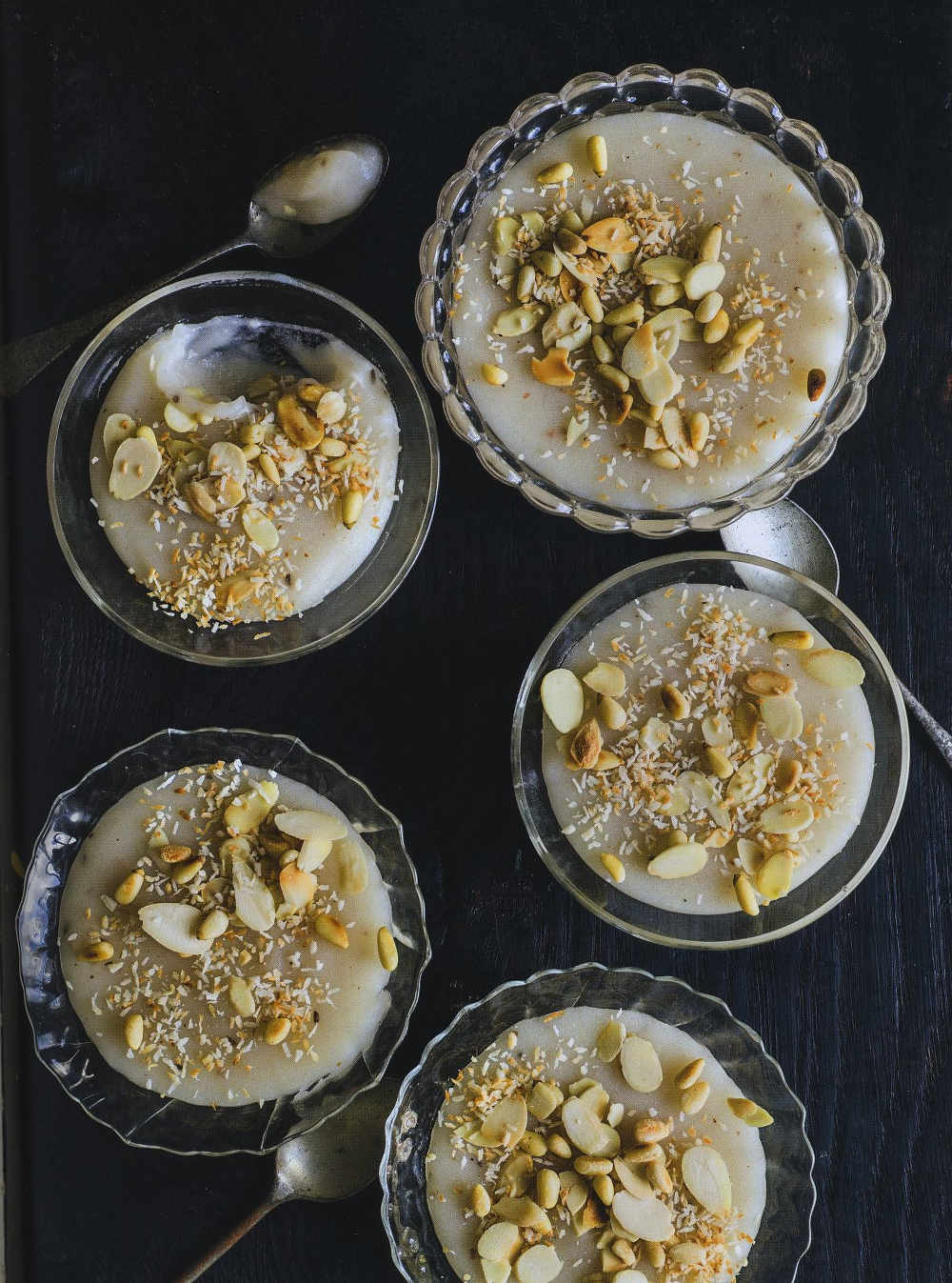
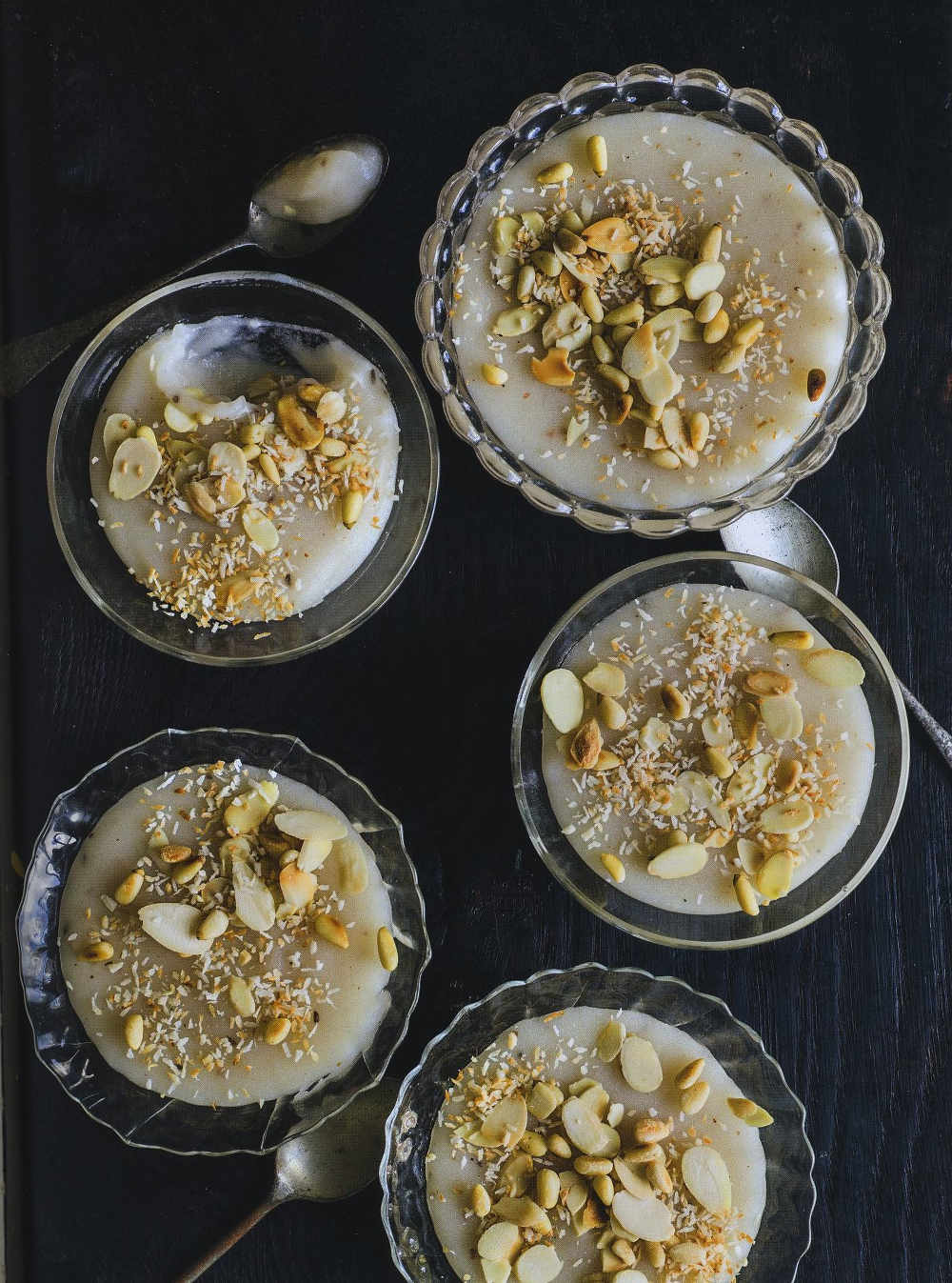
For every traditionalist who loves the ritual of the turkey, ham, plum pudding and mince pies at Christmas, there is probably another who - for cultural, religious or dietary reasons - celebrates festive occasions differently.
Vegetarians and vegans are no longer the small minority that they once were and, even in families where the turkey still takes centre stage at Christmas, there’s a good chance there will be a diner in the group who marches to a different drummer.
Whether you want to have a completely meat-free meal, or simply offer some choice, deliciously aromatic Middle Eastern dishes could be the answer. Earlier this year I enjoyed discovering The Middle Eastern Vegetarian Cookbook by Salma Hage (Phaidon, £24.95) and it is a valuable reference for its wide range of appealingly simple dishes and reassuring voice of experience. All of the dishes are vegetarian, of course, but many are also vegan and most are suitable for coeliacs too, so they tick a lot of dietary boxes.
This is not a Middle Eastern meal - the much-loved Baba ganoush given below, for example, is only one of a major chapter devoted to the dips and mezzes that are central to the Middle Eastern way of eating - but these tasty and gimmick-free recipes should be well received by all.
There are little cultural links to our more familiar festive traditions - the cranberries in the spicy rice dish, for example - and the dessert has special relevance as it is also often served on Christmas Eve to celebrate the birth of Christ.
And, aside from the main event, these are also the sort of dishes that could be very welcome after the excesses of a traditional Christmas, when the system needs a rest. Either way, Middle Eastern cooking is well worth considering as part of the festive plan.
RECIPES:
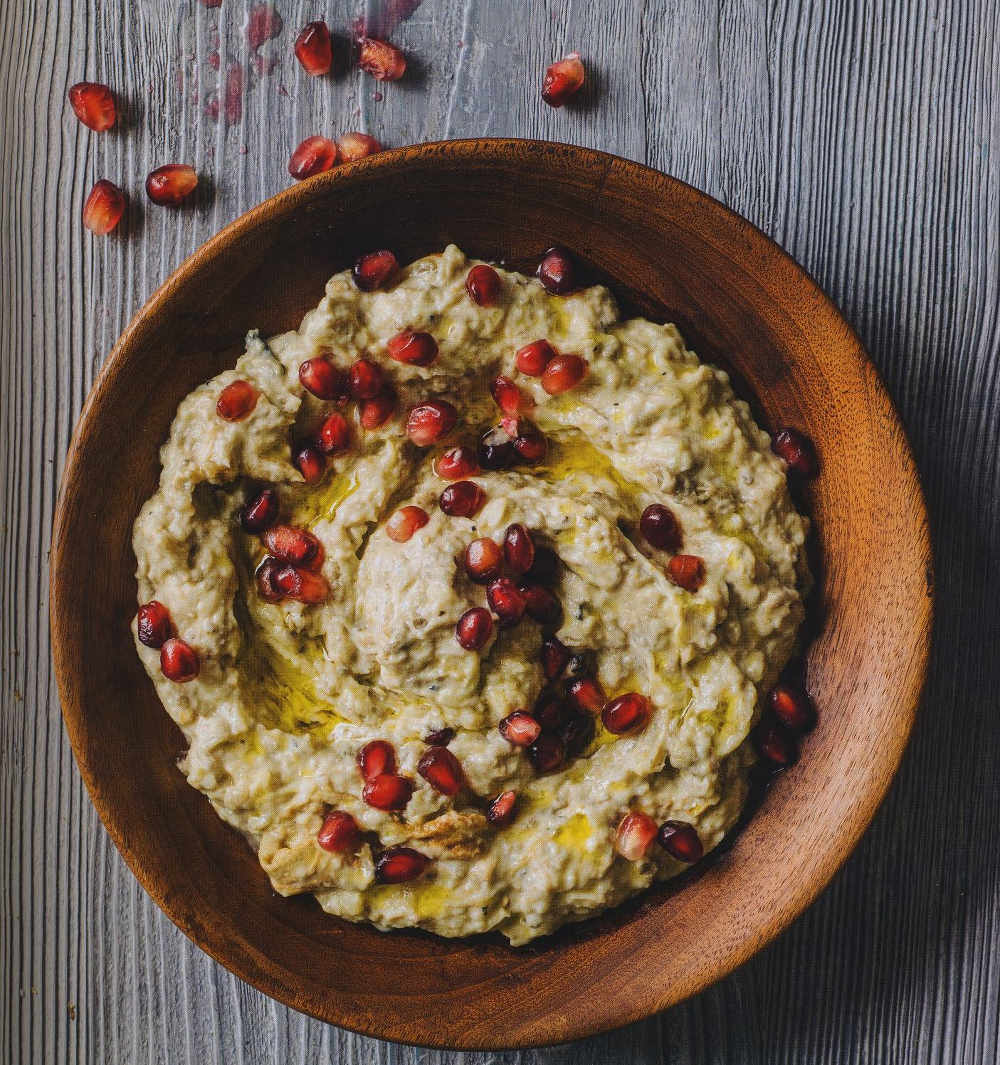
Baba ganoush
Creamy, garlicky, and addictive, it is no wonder that baba ganoush is famous around the globe. For the perfect accompaniment, carefully toast some Pita Bread directly over a low gas flame of your stove and use to dip them in.
Preparation time: 10 minutes + cooling time Cooking time: 30-45 minutes Serves: 4-6
3 eggplants (aubergines)
2 small cloves garlic
2 tablespoons Tahini (see below)
juice of 1/2 lemon
1 tablespoon olive oil
handful pomegranate seeds, for sprinkling
salt and pepper
FOR THE TAHINI:
2 cups (9oz/250g toasted seasame seeds
1 teaspoon sea salt
1/2 - 2/3 cup (4-5 fl oz/120-150ml) olive oil, depending on taste
First make the tajhini. Blend the seeds and half of the oil in a food processor, and gradually add in the remaining oil or to taste. Keep in a screw-top jar in the refrigerator to use as required for up to a month.
Preheat the oven to 400°F/200°C/Gas Mark 6.
Put the eggplants (aubergines) onto a baking sheet, prick them all over with a fork then roast in the oven for 30-45 minutes, until soft. Once cool enough to handle, peel the skin off and discard. Set the flesh aside to cool completely.
Put the garlic into a mortar with a little salt and crush with pestle, then add the tahini and lemon juice and mix well.
When the eggplant flesh is cool, chop it finely, transfer to a bowl and add the garlic-tahini mixture. Season well and thoroughly combine all the ingredients. Place on a serving plate, then drizzle with olive oil and sprinkle on the pomegranate seeds.
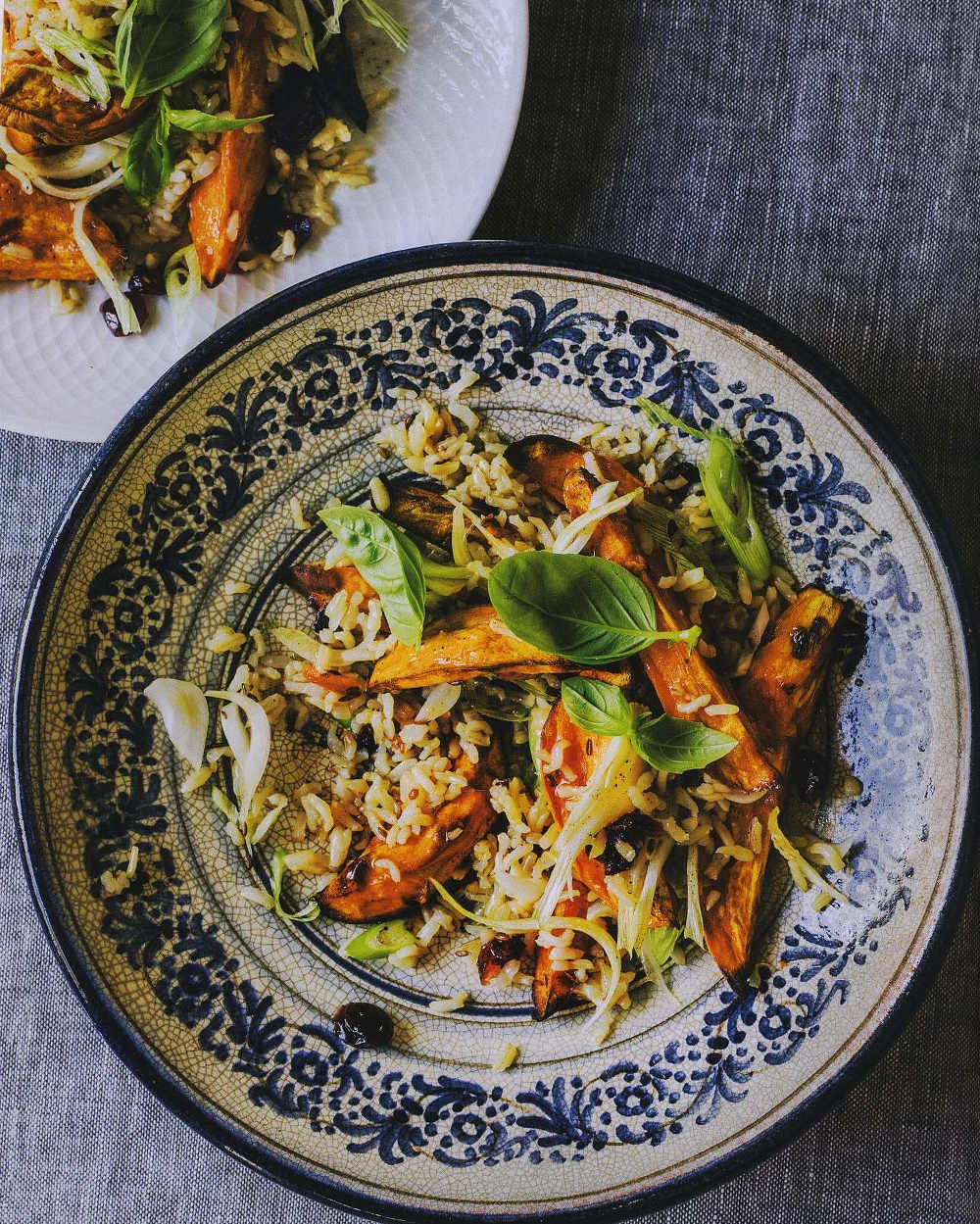
Roasted sweet potato and cranberry spicy rice
Lemon juice, 7-spice, and good olive oil make a zesty dressing for this sweet potato dish. The dried cranberries and pomegranate seeds add freshness too, lifting the ingredients to more than the sum of their parts .The 7-spice blend is a classic Lebanese seasoning mix; just a teaspoon of it really lifts so many dishes.
Preparation time: 15 minutes Cooking time: 20 minutes
Serves: 4
Preheat the oven to 375°F/190°C/Gas Mark 5.
4 sweet potatoes, peeled and cut into wedges
1-2 tablespoons olive oil
1 teaspoon cumin seeds
1/2 cup (3 1/2 oz/100 g) long-grain brown rice, washed
l teaspoon ground cumin
2 large handfuls dried cranberries
1 handful fresh pomegranate seeds (optional)
4 scallions (spring onions), sliced
handful basil leaves
salt and pepper
FOR THE DRESSING
juice of 1 lemon
4 tablespoons olive oil
1 teaspoon Lebanese 7-Spice Seasoning
salt and pepper
FOR THE LEBANESE 7-SPICE SEASONING
5 tablespoons ground allspice
3½ tablespoons pepper
3½ tablespoons ground cinnamon
5 tablespoons ground cloves
4 tablespoons grated nutmeg
4 tablespoons ground fenugreek
4 tablespoons ground ginger
First make the Lebanese 7-Spice Seasoning mixture: Mix all the ingredients together thoroughly and store in an airtight container to use as required. [Makes: about 1¾ cups (6 oz/175 g)]
Put the sweet potato wedges into a large bowl and toss with the olive oil, cumin seeds, salt, and pepper. Spread them out to a baking sheet and roast in the preheated oven for 20-25 minutes, or until soft and slightly charred on the edges.
Meanwhile, bring 1 cup (9 fl oz/250 ml) salted water to boil and add the rice and cumin. Cover and return to a boil. Reduce to a medium heat and let simmer for about 30 minutes, or until the rice is tender but retains a little bite. Add more water if necessary.
Mix together the ingredients for the dressing.
Toss the hot rice well with the dressing, cranberries, and pomegranate seeds, if using. Stir in the roasted sweet potatoes gently to avoid breaking them up too much. Top with the scallions and basil and season to taste.
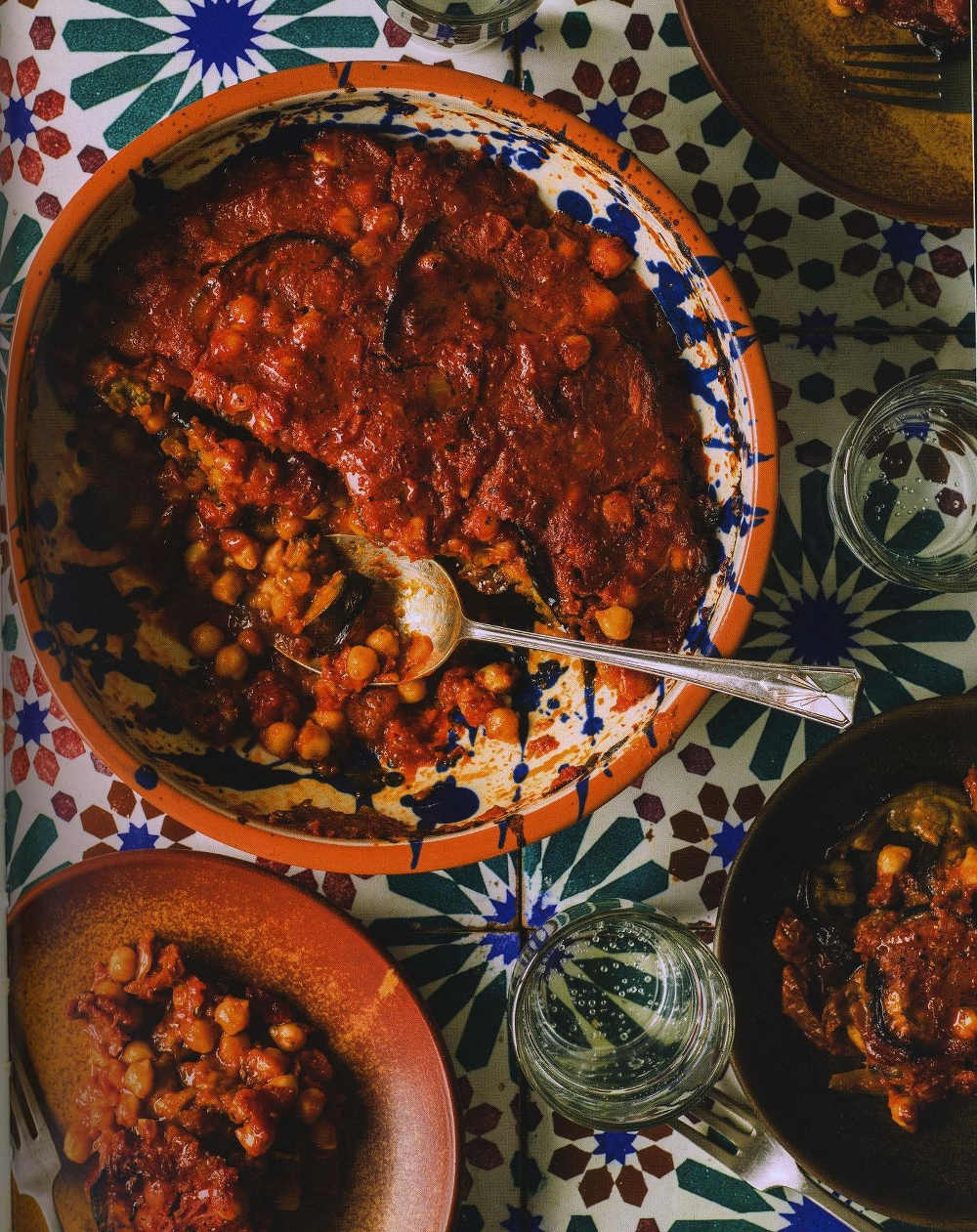
Lebanese vegan moussaka
Every country and every region has their own version of this much-loved dish. This wholesome casserole (called maghmour) is a traditional Lebanese way of using simply eggplant, tomato sauce, and chickpeas.
Preparation time: 40 minutes Cooking time: 50 minutes
Serves: 4
Preheat the oven to 4OO0F/200°C/Gas Mark 6.
2 large eggplants (aubergines)
4 tablespoons gluten-free flour
2 teaspoons Lebanese
7-Spice Seasoning (see above)
2 tablespoons extra-virgin olive oil
2 (14-oz/400g) cans chickpeas, drained
salt and pepper
FOR THE TOMATO SAUCE
2 tablespoons olive oil
1 onion, finely chopped
4 cloves garlic, finely chopped
1 teaspoon ground cumin
1 bay leaf
6 large tomatoes, finely chopped
7 sun-dried tomatoes, preserved in oil
2 tablespoons Tomato Paste (purée)
1 (14 oz/400g) can diced or chopped tomatoes
1 teaspoon unsweetened pomegranate molasses
juice of 1/2 a lemon
salt and pepper
Slice the eggplants (aubergines) into 1/2-inch/1-cm discs. Mix the flour, spices, and a pinch of salt and pepper on a large plate. Dab each side of the eggplant discs in the flour and spice mix so they are lightly coated.
Lay them on a lined baking sheet, drizzle over the olive oil, and bake in the oven for about 10 minutes. Turn, then bake for another 10 minutes, or until crisp. Remove and cool.
In the meantime, make the tomato sauce. Heat the oil in a large skillet or frying pan over medium heat and sauté the onion for 2 minutes. Add the garlic and cook for 1 minute, then add the cumin and bay leaf and cook for another 1-2 minutes. Add the fresh chopped tomatoes, stir, and cook for 3 minutes.
Add the sun-dried tomatoes, tomato paste (purée), can of diced tomatoes, one-quarter of the can filled with water, pomegranate molasses, and lemon juice and cook for another 20-30 minutes, stirring occasionally until you have a thick, rich, reduced sauce.
Season with salt and pepper. Turn off the heat and set aside. Remove the bay leaf.
Layer the eggplant discs, tomato sauce, and chickpeas in a deep baking pan and repeat until you have used all of your ingredients (3-4 layers, ideally finished with layer of tomato sauce). Bake in the oven for 40 minutes. Set aside to cool.
This really is a dish best served at room temperature when all the flavours are at their best.

Meghli
Traditionally, this Lebanese rice pudding is made to celebrate the birth of a baby and served to all friends and family visiting the newborn in the first few days of his or her life. I can remember making it when my brothers and sisters were born. It is also often served on Christmas Eve to celebrate the birth of Christ.
Preparation time: 10 minutes + 2 hours resting and 2 hours chilling time
Cooking time: 40 minutes
Serves: 6
¾ cup (4 oz/120 g) rice flour (ground rice)
1 teaspoon ground cinnamon
2 teaspoons ground star anise
2 teaspoons ground caraway seeds
½ cup (3½ oz/100 g) granulated sugar
2 teaspoons rosewater
pistachios, pine nuts, flaked almonds, and dessicated coconut, to serve
Measure out 1 2/ 3 cups (14 fl oz/400 ml) cold water in a large bowl, add the flour and stir well. Set aside for 2 hours.
Pour 4½ cups (1¾ pints/1 litre) water into a large saucepan and bring to a boil over high heat. Carefully pour the flour-water mixture into the boiling water and stir well with a wooden spoon.
Reduce the heat to medium and gradually add the spices and sugar, stirring often, to prevent the mixture from sticking. Cook for 25-30 minutes, stirring frequently, until it thickens. Add the rosewater and mix well.
Use a ladle to divide the mixture between 6 small coffee cups or glasses. Sprinkle the pistachios, pine nuts, coconut, and flaked almonds on the top of each one.
Set aside to cool and then chill in the refrigerator for 2 hours, or until set, before serving.
Georgina Campbell's Cookery Feature - New Image for Northern Irish Food
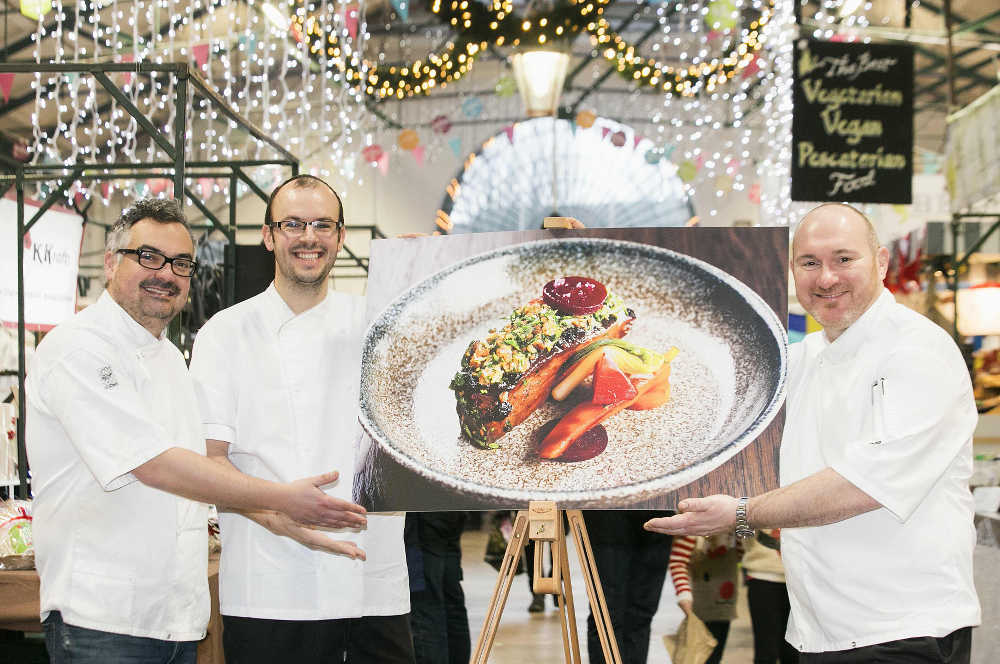

Thanks to its inspiring leaders, brilliant calendar of events throughout the year and enthusiastic support from producers, chefs ad the general public, Northern Ireland’s Year of Food and Drink 2016 was a huge success - and the legacy lives on.
A number of imaginative initiatives are keeping up the momentum and one - unveiled just before Christmas at Belfast’s St George’s Market - was the creation of a new signature dish for Northern Ireland, to showcase the great range and quality of local ingredients available, and demonstrate the way that chefs are using them in contemporary cooking that gives a respectful nod to tradition.
Rounding off the year in style, Tourism NI tasked four of the region’s most respected chefs to create ‘Northern Ireland’s New Signature Dish’. Known as the ‘cooking collective’ (and all well known to followers of the Guide), the four who created the final three dishes are Niall McKenna of James Street South in Belfast; Ian Orr of Browns Restaurant and Ardtara House in Derry-Londonderry; Kelan McMichael of Bull and Ram in Ballynahinch; and Chris McGowan of Wine and Brine in County Armagh - no better men, and they had a lot of fun coming up with a shortlist of three dishes showcasing a diverse range of ingredients from across Northern Ireland.
The three shortlisted dishes - ‘Born and Braised’, ‘Jowled Eel’ and ‘Buttermilked Lamb’ - were put to a public vote, with the beef dish ‘Born and Braised’ eventually taking the title Northern Ireland’s New Signature Dish. Look out for the winning dish (and probably the other two as well) on restaurant menus across Northern Ireland - or have a go at cooking them at home.
RECIPES
Ingredients used in the dishes have been sourced from Northern Ireland food and drink producers and suppliers. Wild garlic is usually available from late January onwards and must be washed before use; Comber Early Potatoes come into season in early summer.
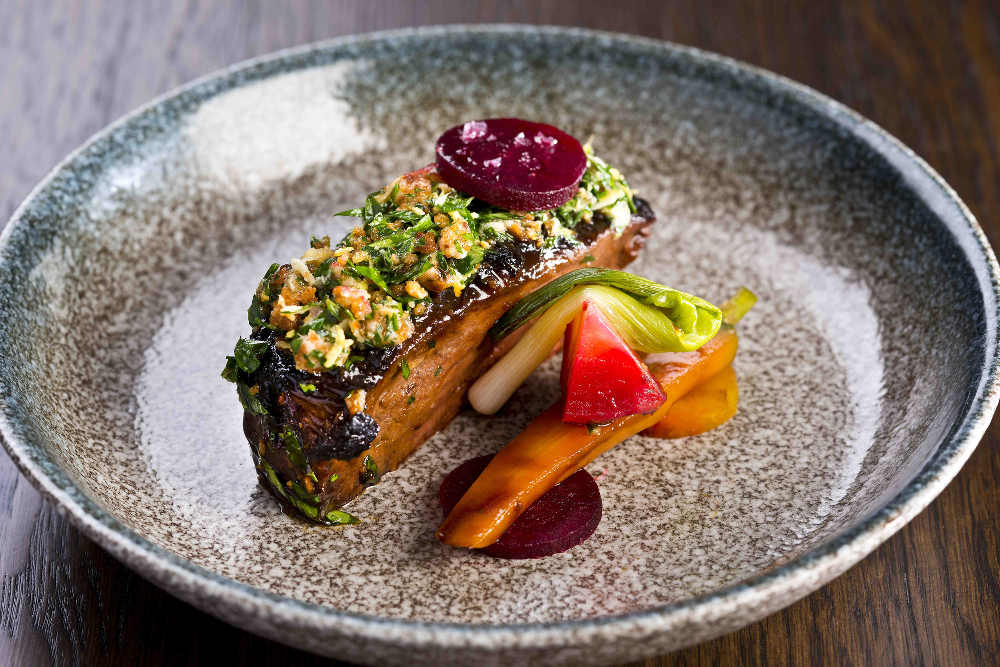 NORTHERN IRELAND’S NEW SIGNATURE DISH: Born and Braised
NORTHERN IRELAND’S NEW SIGNATURE DISH: Born and Braised
Shin of Northern Irish beef served with beetroot and bone marrow gremolata (Serves 4-6)
INGREDIENTS
The brine:
4 litres water
400g salt
150g sugar
400ml black treacle (supermarket)
3 bay leaves (farm shop)
4 cloves garlic (or use wild garlic; can be foraged in various locations and is a seasonal product available late winter early spring)
25g pickling spices (farm shops, delicatessens)
250g honey (any good farm shop)
The beef:
3-4kg Peter Hannan’s shin of beef (bone in) (Hannan Meats in Moira available at the Meat Merchant shop in Moira and local butchers. A local butcher could also order it in)
3 carrots (local farm shop)
1 onion (Milgro in Limavady)
2 celery sticks (farm shop)
1 leek (Roy Lyttle leeks)
2 bulbs garlic cut in half (or use wild garlic; can be foraged in various locations such as Cave Hill)
500ml Northern Irish artisan Dark Ale, such as Belfast Black (Whitewater Brewery in Kilkeel)
300ml Comber honey (Ballystockart Honey, Comber, any local farm shop)
250ml red wine vinegar (can be purchased in local delicatessens)
50g salt
Beetroots:
8 beetroots (any good farm shop)
200ml red wine vinegar (Arcadia Delicatessen in Belfast)
40g sugar
20g salt
2 litres water
Bone marrow gremolata:
Zest of 2 lemons (local fruit and vegetable shops)
40g grated horseradish (delicatessens and farm shops)
20g table celery or fresh parsley chopped finely (local fruit and vegetable shops)
400g Peter Hannan’s bone marrow, cooked and diced (available at the Meat Merchant shop at Hannan Meats in Moira, or order from local butchers)
400g croutons
4 cloves garlic, chopped (or use wild garlic; can be foraged in various locations such as Cave Hill)
20ml Broighter Gold rapeseed oil (Harnett Oil)
METHOD
For the brine:
Bring the water, salt, sugar, black treacle, bay leaves, garlic, pickling spices and honey to the boil and then leave to cool.
For the beef:
Add the shin of beef to the brine and leave for 24 hours.
Remove the beef from the brine and discard the brine.
Seal the beef all over on the hob and then place it in a deep roasting dish.
Slice the carrots, onion, celery, leek and sauté the vegetables along with the 2 bulbs of garlic until caramelised. Once caramelised, add to the roasting dish with the beef. Pour the ale, honey, red wine vinegar and salt over the beef. Cover the beef with water, place greaseproof paper on top and then cover with tin foil.
Cook in a preheated oven (140º C) for 4 hours.
After cooking, remove the beef. Pass the remaining stock from the roasting dish through a sieve into a pan. Heat this stock on the hob until syrupy. Season as required and pour over the beef shin.
For the beetroots:
Clean the beetroots under cold water, then place into a pot. Add the red wine vinegar, sugar, salt and water and boil for 15 minutes. Leave the beetroots to cool in the water. When cool, peel the beetroots and set aside.
For the bone marrow gremolata:
Mix the lemon zest, grated horseradish, table celery, cooked and diced bone marrow, croutons, diced garlic and rapeseed oil together.
To finish the dish, place the beef onto a serving dish. Add the beetroots and put into the oven (180º C) for 10 minutes to glaze. Add the bone marrow to the serving dish and serve.
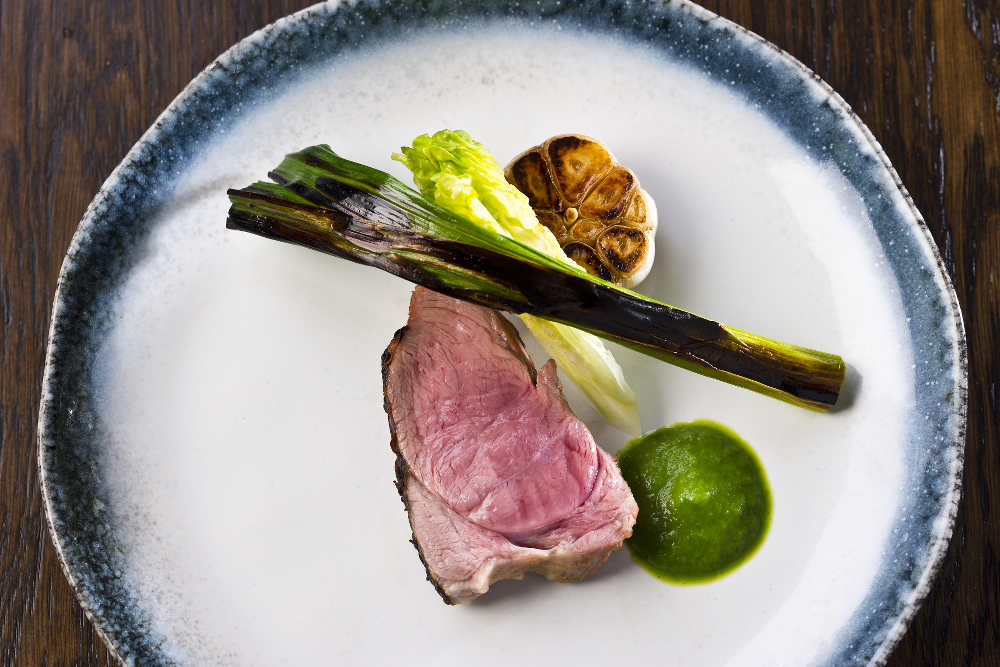
Buttermilked Lamb
INGREDIENTS
2 kg leg of lamb (Glenarm Organic Beef and Lamb, Glenarm / Hannan Meats, Moira / O'Kane Meats Ltd, Claudy, and local butchers)
1/2 bunch rosemary (Local farm shop)
3 cloves garlic, peeled and crushed (Local farm shop)
1 pint buttermilk (Dale Farm in supermarket)
Salt/pepper
Wild garlic (you can forage for wild garlic in various locations across NI such as Downhill Demesne. This is a seasonal product usually available late winter/early spring and must be washed before use)
METHOD
Chop the rosemary and place in a bowl with the garlic salt/pepper. Shred the wild garlic and add to the bowl. Pour over the buttermilk and rub the mixture into the lamb.
Place in a container and cover with cling film. Leave in the fridge for 24 hours. Bring the lamb out of the fridge 2 hours before cooking.
Preheat your oven to 180ºC. In a heavy based pan, caramelise the lamb on all sides for approximately 6 minutes and place in the oven on a preheated tray and cook for 14 minutes then remove and leave to rest for 15 minutes and serve.
This joint works well on the barbecue in the summer.
WILD GARLIC PURÉE
1 bunch wild garlic (you can forage for wild garlic in various locations across NI such as Downhill Demesne)
1tsp mustard. (local grocery stores or delicatessens)
1/2 bunch mint (Helen’s Bay Organic or any good farm shop)
Salt/pepper
150ml rapeseed oil (Broighter Gold, Limavady, or Harnett’s Oils)
METHOD
Blanch the wild garlic in boiling salted water then refresh in iced water. Drain and squeeze out excess water and place in a blender with the mustard and mint then gradually add the oil. Season to taste then serve alongside the lamb.
Perfect with steamed Comber Early potatoes (available at various locations including Farmer’s Markets)
Seaweed Butter (Abernethy Butter stockists)
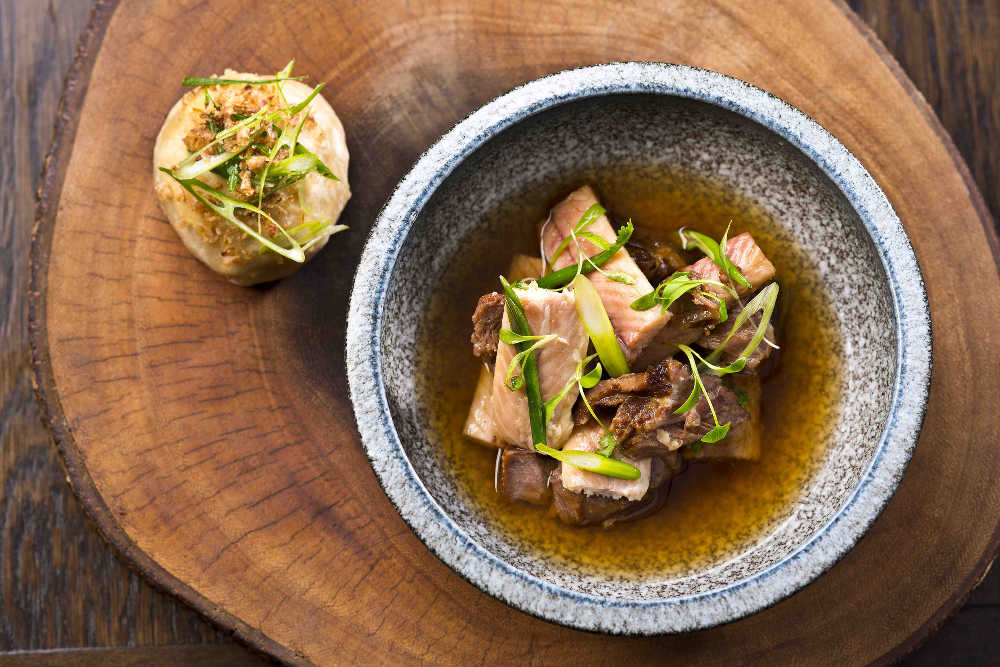
Jowled Eel Recipe & Buttermilk Bun
INGREDIENTS
150g smoked eel (Lough Neagh Fisherman’s Co-operative in Toomebridge/Creightons)
300g pork cheek (The Meat Merchant, Moira, or order from good butchers)
1 litre chicken stock (Carol’s stock market or local deli)
200g chicken wings (local butchers and Moy Park)
1 large onion, sliced (Milgro in Limavady)
1 garlic cloves, chopped (or wild garlic; can be found in various locations such as Clare Glen, Co. Armagh. This is a season product available late winter and early spring)
1 leek, sliced Roy Lyttle leeks
2 sticks of celery, saving any celery leaf for garnish (local fruit and vegetable shops and supermarkets/ farm shop)
1tsp thyme, (farm shop)
50g seaweed, kelp/dulse, (St George’s market/farm shop)
1 bunch spring onions, (local independent stockists of Roy Lyttle Limited)
50g butter (Donnybrewer butter/Dromona)
Salt/pepper
METHOD
In a roasting pan, caramelise the chicken wings in the oven at 180ºC until golden brown.
Then in a heavy based pan, season and caramelise the pork cheek and then remove and leave to one side. In the same pan caramelise the onion with the garlic, leek, celery, thyme, parsley, add the chicken wings and chicken stock, bring to the boil then reduce the heat.
Cook it for 1 hr then pass through a sieve and pour over the cheeks. Braise for 1 hour then leave to cool in the stock.
To serve place 1 cheek in each warm serving bowl, dice the smoked eel into 2cm cubes and place in the bowls. Add the trimmings to the braising liquor, slice the spring onions and place on top.
Heat the braising liquid and pour over the eel and cheek and serve. You can use pork belly if you can't get cheek for this recipe.
BUTTERMILK BUN Makes approx 12 x 50g buns
350g strong flour (Andrews Flour)
15 g dried yeast
250ml buttermilk (Dale Farm)
20g sugar.
25g salt.
1tsp baking powder
1tbsp rapeseed oil (Broighter Gold or Harnetts Oil)
METHOD
Combine all dry ingredients except the baking powder into a mixing bowl and gradually add the buttermilk to make a bread-like dough.
Cover with cling film and prove for 1 hour, or until it is double in size then knock back by hand.
Add the baking powder and knead for 2/3 minutes. Roll by hand roughly 50 gram balls and place on an oiled baking sheet cover and prove for 40mins.
Line a bamboo steamer with parchment paper and steam the buns for 7 minutes and serve straight away. Note: they freeze really well.
For more about Northern Ireland’s New Signature Dish log on to www.discovernorthernireland.com; see also Discover NI Facebook, Twitter and Instagram pages, hashtag #SignatureDishNI.
Georgina Campbell's Cookery Feature - Celebrating Family, Tradition and Ireland's Food Legacy at 2017 IFWG Awards
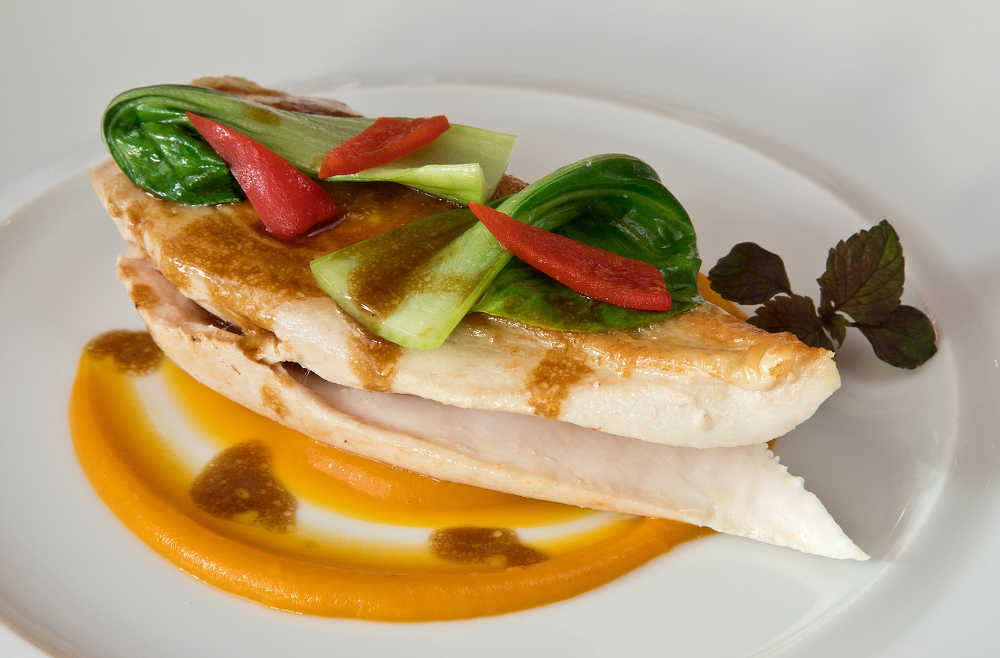
Since 1993, the Irish Food Writers’ Guild (IFWG) Food Awards have celebrated Ireland’s food producers and organisations, recognising those behind the great Irish produce that is integral to Ireland’s growing reputation in food and drink, both at home and abroad.
The passing down of recipes and traditional farming and production methods from generation to generation have been instrumental in helping Ireland’s food legacy to endure, according to IFWG Chairperson, Aoife Carrigy.
Speaking at the 2017 awards ceremony in Dublin recently, she said, “The positive influence that previous generations have had on today’s Irish food sector has emerged as a common defining characteristic in the winners of this year’s IFWG Food Awards.”
Marked with a lunch at Ireland’s benchmark dining destination, Restaurant Patrick Guilbaud, each of the winning products was worked into a wonderful celebratory menu devised and prepared for the occasion by chef and co-owner Guillaume Lebrun.
Six IFWG award winners were announced, together with the Guild’s first posthumous award for Oliver Hughes, a pioneer of the Irish craft beer and distilling revolution.
The 2017 IFWG Food Award winners are The Friendly Farmer for his pasture-reared chickens, Ummera Irish Smokehouse for Ummera Smoked Silver Hill Duck Breast and Cuinneog for Irish Farmhouse Country Butter and Natural Buttermilk. Bertha’s Revenge Irish Milk Gin received this year’s Irish Drink Award and Mags Kirwan of Goatsbridge Trout Farm was presented with a Special Contribution to Irish Food Award. The 2017 Environmental Award went to The Little Milk Company for its innovative approach to fostering sustainable family farms. The family of Oliver Hughes, the pioneering founder of the Dingle Distillery and The Porterhouse accepted his posthumous award.
The IFWG Food Awards are unique. No one can enter themselves or their product into the awards and no company knows it has been nominated or shortlisted for an award. The Guild is the sole nominating and decision-making body and wishes to thanks Bord Bia for its support of the awards and its tireless work on the home and export markets on behalf of the Irish food industry.
ABOUT THE WINNERS
Food Award: The Friendly Farmer: Ronan Byrne, Co. Galway
Irish chicken farmers are struggling to hold their own against imported chicken, which is often raised and produced under less than ideal circumstances. Since establishing himself in 2007 as ‘The Friendly Farmer’, Ronan Byrne has shown that there is a strong local demand for high quality Irish chicken from both chefs and general consumers.
Having studied Agri-business and Marketing, worked in finance, marketing and promotions and managed a large dairy farm in Poland, Ronan returned to Athenry determined to find a way to make a sustainable full-time living out of his family’s small mixed farm. He now produces 115 hubbard chickens a week, using a grass-based system that ensures easy outdoor access for the flock. He also rears free-range pigs, beef cattle and other seasonal poultry (turkeys, geese and ducks)’ and has recently developed an on-site abattoir, with the financial support and mentorship of Galway’s Local Enterprise Board.
The Friendly Farmer chickens are available at their pop-up farm shop in the weekly Moycullen and Galway markets as well as being found on many of the best menus in Galway city and county.
Food Award: Ummera Irish Smokehouse for Ummera Smoked Silver Hill Duck Breast: Anthony Creswell, Co. Cork
At Ummera’s custom-built smokehouse, Anthony Creswell draws on four decades of smoking experience. His father Keith began smoking salmon caught in local West Cork rivers back in the 1970s, with Anthony taking over the running of the business in 1998.
In 2007, Ummera won an Irish Food Writers’ Guild Award for its wonderful smoked eel. The range of smoked products also includes Irish organically reared smoked salmon as well as smoked chicken, smoked dry-cured bacon and a recently developed smoked picanha (a premium Brazilian cut of beef with a protective layer of fat).
In 2009, Anthony began experimenting with hot-smoked duck breast and within a year had won not just 3 Star Gold Awards at the 2010 Great Taste Awards but also the Golden Fork for the best Irish Speciality Food of the year. The duck is sourced from another Guild award-winner, Silver Hill Farm in Co Monaghan where the Steele family have developed their own unique hybrid breed.
Anthony favours Silver Hill duck for its tenderness, delicate flavour and its generous layer of fat that helps to keep the hot-smoked breast moist. The result is a delicious and versatile ready-to-use product that is the combined creation of two exemplary Irish food producers.
Food Award: Cuinneog for Irish Farmhouse Country Butter and Natural Buttermilk: Breda Butler, Co. Mayo
In response to local demand for a flavour that was in danger of disappearing, and armed with a wooden cuinneog (churn) and creamery cans, Tom and Sheila Butler began making this proper country butter in their Co Mayo family kitchen in 1990.
Today their daughter Breda Butler runs the family business, supplying their fermented lactic butter and its by-product of natural buttermilk to supermarkets and speciality food shops nationwide.
The lightly salted butter gets its distinctive colour, creamy texture and complex, long-lasting flavour from the traditional production process, which takes four days from start to finish. The cream is slowly heated and fermented, then churned in the traditional way after which the buttermilk is separated. The butter is then shaped, cut and wrapped by hand.
Cuinneog are no stranger to awards, having been recognised by Euro-Toques in 2010 and won 3 gold stars in the Great Taste Awards 2015, when the county butter was listed in the Top 50 Foods. The Irish Food Writers’ Guild is delighted to honour these two exemplary traditional Irish food products.
Special contribution to Irish Food: Mag Kirwan of Goatsbridge Trout Farm, Co. Kilkenny
Mag is best known for the excellent rainbow trout that she and her husband Ger produce at Goatsbridge, their second-generation Kilkenny fish farm. As well as their fresh trout, these tireless innovators produce cold-smoked and barbecued trout sides, a smoked trout paté and a convenient and delicious tinned smoked trout, all under their ‘Eat Trout’ retail brand. Their unique Goatsbridge trout caviar also graces many of the best Irish menus.
Mag is an active promoter of local food, with a strong involvement in Kilkenny Food Trail’s pioneering food tourism offer (including their own Goatsbridge Farm Visitor Centre) and in Taste Kilkenny, a group of local producers committed to collective cooperative marketing.
Mag is also a leading figure in sustainable fresh water aquaculture. Goatsbridge was the first fish farm to sign up to Bord Bia’s Origin Green programme, and is committed to sustainable water and energy usage and to social sustainability.
A recent initiative saw Mag launch Fishwives at Savour Kilkenny in October 2016. Featuring fish recipes gathered from women in Ireland and Uganda from diverse backgrounds and professions, the self-published cookbook was funded by Goatsbridge Trout with the aim of raising €40,000 for Hospice Africa Uganda, as well as encouraging Irish people to eat more fish.
Mag is commended by the Irish Food Writers Guild for the energy and commitment that she brings to the promotion of Irish food and Irish fish in particular.
Irish Drink Award: Bertha’s Revenge Irish Milk Gin: Justin Green and Anthony Jackson, Co. Cork
This highly original craft gin is produced by Justin Green of Ballyvolane House together with his old school friend and business partner, Antony Jackson.
Where most Irish gins use imported grain-based alcohol, Bertha’s Revenge is distilled with whey alcohol sourced from the local Carbery dairy plant and derived from cow’s milk produced by Co. Cork dairy farmers.
Using specially developed yeasts to ferment the milk sugars in the whey, Carbery first brew and then double distill the whey in large column stills. Justin and Anthony distill the 96% proof whey alcohol a third time in their custom-made 125 litre copper stills along with their chosen botanicals. These include coriander, bitter orange, cardamom, cumin and clove as well as foraged local botanicals such as alexanders, elderflower and sweet woodruff.
The result is an aromatic and warmly spiced gin that has won local and international acclaim since it was launched in 2015. Bertha’s Revenge is now exported to the UK, mainland Europe and even South Korea, and to the US later this year.
This truly Irish gin continues the strong field-to-fork tradition that has long been at the heart of Ballyvolane House, which is one of Ireland’s best-loved country houses. www.ballyvolanespirits.ie
Environmental Award: The Little Milk Company, Co Waterford
Lifetime Achievement Award: Posthumously awarded to Oliver Hughes
Several decades ahead of our recent Irish craft beer revolution, Oliver Hughes was co-founder of one of the first small independent Irish breweries. Together with Liam Lahart – who was his cousin, business partner and lifelong friend – Oliver opened Harty's in Blessington, Co Wicklow in 1983 and later Dempsey's in Inchicore.
A decade later, they succeeded in developing not just a range of unique Irish craft beers, but also a loyal consumer base for those beers through the Porterhouse brew pub, first in Dublin’s Temple Bar, and later in London, New York and elsewhere in Dublin. Today the Porterhouse Group also operates Lillie’s Bordello and The Porthouse tapas bars.
Later, Oliver had the vision to create Dingle Distillery in what was the first purpose-built distillery to open in Ireland in 200 years. Production of their whiskey began in 2012, with first batches of Dingle Single Malt bottled in 2016. They also produce a vodka and a distinctive gin distilled with local botanicals such as rowan berry, bog myrtle and heather.
Oliver Hughes passed away in July 2016 at the young age of 57, leaving behind his wife Helen, son Eliott and daughter Holly as well as many more family and friends. He is greatly missed by the Irish food and drink community, who remember his infectious energy, fearless vision, considerable generosity and passion for life with continued respect and sincere gratitude.
The judging process
· No company or individual can enter themselves for these awards.
· Every member of the Guild is invited to nominate products they believe are worthy of an award.
· The products must be produced in Ireland and the main ingredient must be Irish grown or produced.
· The producer must be trading for at least three years.
· Products are bought and paid for and a formal tasting meeting takes place where members vote, using proportional representation.
THE AWARDS MENU
Devised by Guillaume Lebrun, executive chef /owner at Restaurant Patrick Guilbaud, the menu was paired with wines kindly provided by Liberty Wines.
· Goatsbridge Cold Smoked Trout with Bertha’s Revenge Gin and Tonic Foam and Pickled Ginger
· Salad of Ummera Smoked Silver Hill Duck Breast with Beetroot and Horseradish
· The Friendly Farmer Pasture-Reared Chicken with Lemon Viennoise and Sweet Potato Purée
· Cuinneog Buttermilk Ice Cream with Pear and White Chocolate Café au Lait
· The Little Milk Company Cheese Board
RECIPES: FEATURING PRODUCE FROM THE WINNERS OF THE 2017 IFWG FOOD AWARDS
Recipes all created for the Irish Food Writers’ Guild Food Awards 2017 by executive chef/owner Guillaume Lebrun of Restaurant Patrick Guilbaud, Upper Merrion Street, Dublin 2.
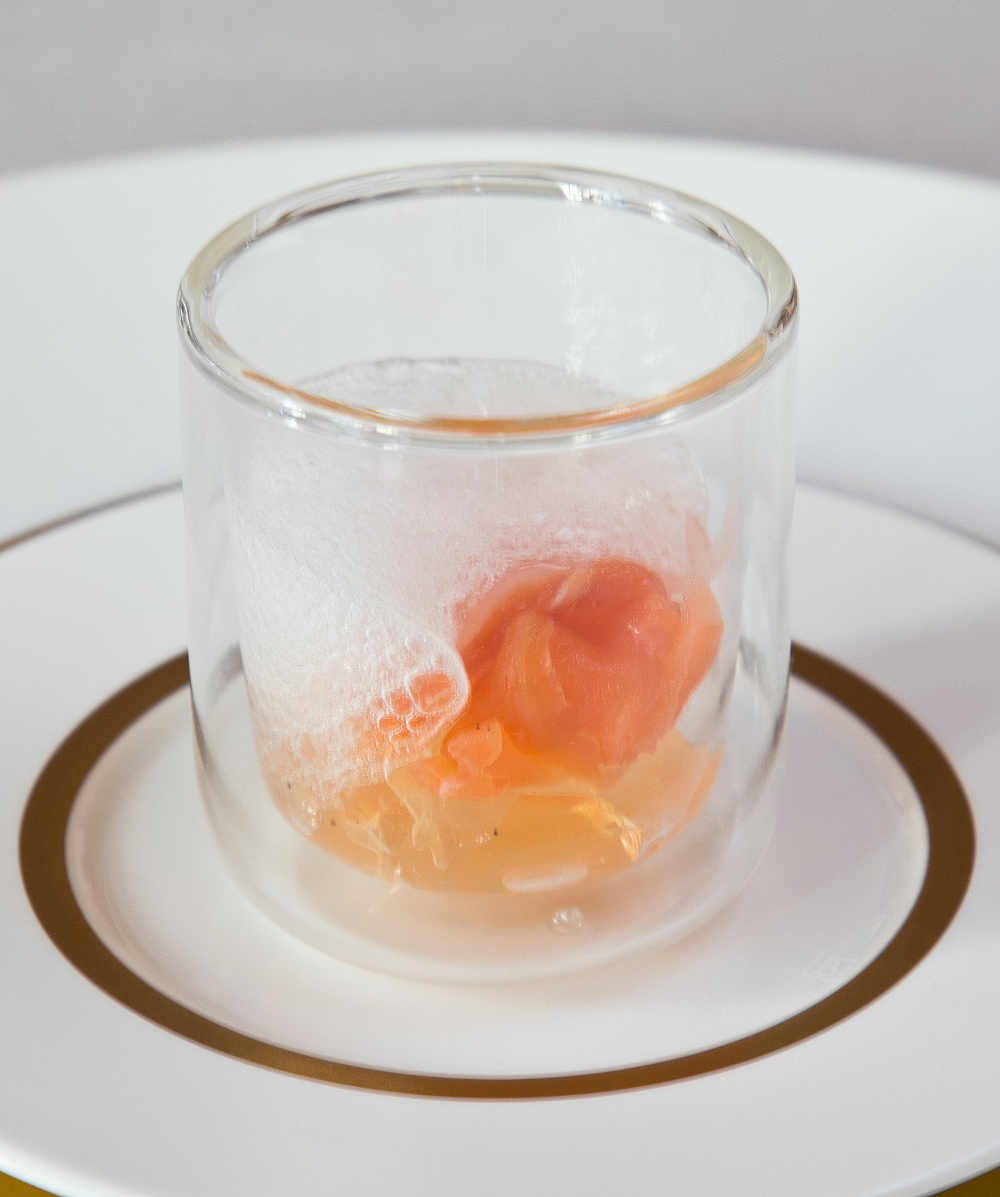
Goatsbridge Cold Smoked Trout with Bertha’s Revenge Gin and Tonic Foam and Pickled Ginger
Serves 8
For the tomato jelly:
3 leaves of gelatine
500g ripe plum tomatoes
salt and freshly ground black pepper
pinch of caster sugar
dash of Tabasco sauce
For the gin and tonic foam:
2 leaves of gelatine
400ml tonic water
0.5g agar agar (gelling agent)
100ml Bertha’s Revenge Irish Milk Gin
To assemble:
1 large piece of Goatsbridge Cold Smoked Trout, cut into bite-sized pieces pickled ginger, cut into bite-sized pieces
To make the tomato jelly, soak the leaves of gelatine in a bowl of cold water for about 5 minutes. Blend the tomatoes in a food processor, then pass through a fine muslin cloth. Season the tomato water with salt, pepper, sugar and Tabasco sauce. Gently warm the tomato water, then add the hydrated gelatine. Leave to set.
To make the gin and tonic foam, soak the leaves of gelatine in a bowl of cold water for about 5 minutes. Boil the tonic water briefly with the agar agar. Remove from the heat and add the hydrated gelatine and the gin. Leave to cool, then place in a cream siphon charged with one carbon dioxide canister.
To assemble, place 1 tablespoon of the tomato jelly in a small cup or shot glass. Add one or two small pieces of smoked trout, then one small piece of pickled ginger. Finish with the gin and tonic foam and serve straight away.
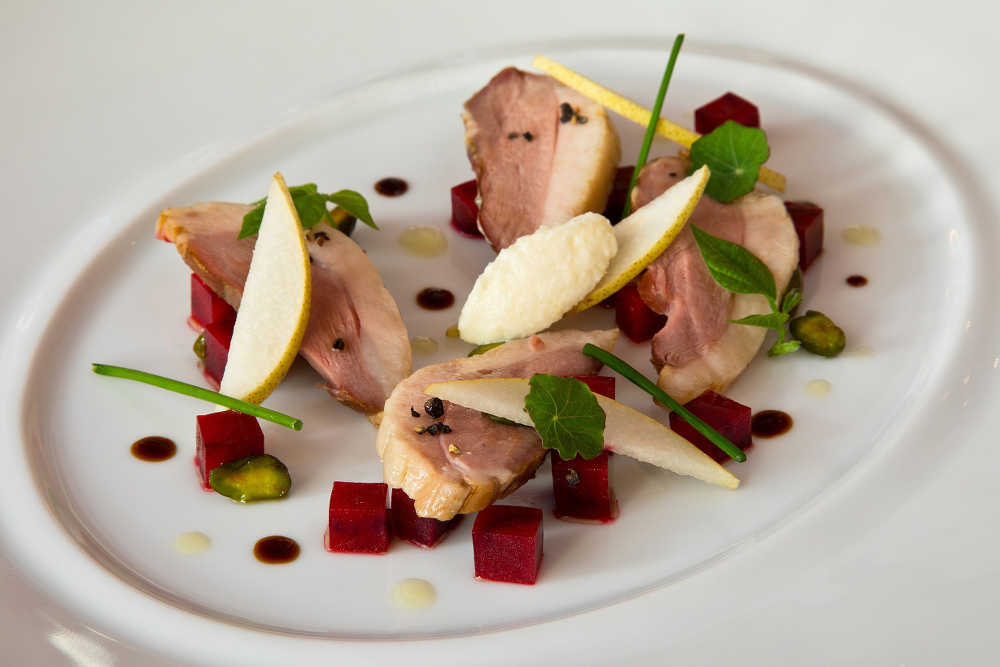
Salad of Ummera Smoked Silver Hill Duck Breast with Beetroot and Horseradish
Serves 4
4 cooked beetroots, cut into small cubes
olive oil
Cabernet Sauvignon vinegar (or other red wine vinegar)
salt and freshly ground black pepper
4 Ummera Smoked Silver Hill Duck Breasts, thinly sliced
2 ripe pears, cored and thinly sliced
prepared horseradish sauce, to serve
pistachios, to garnish
micro herbs, to garnish
Dress the cooked cubed beetroot in a little olive oil and Cabernet Sauvignon vinegar and season with salt and pepper.
To serve, place the beetroot on a cold plate and add a few dots of olive oil and vinegar. Neatly arrange the thinly sliced smoked duck and pears on top. Finish with a small quenelle of horseradish sauce and garnish with a few halved pistachios, micro herbs and a little coarsely ground black pepper.
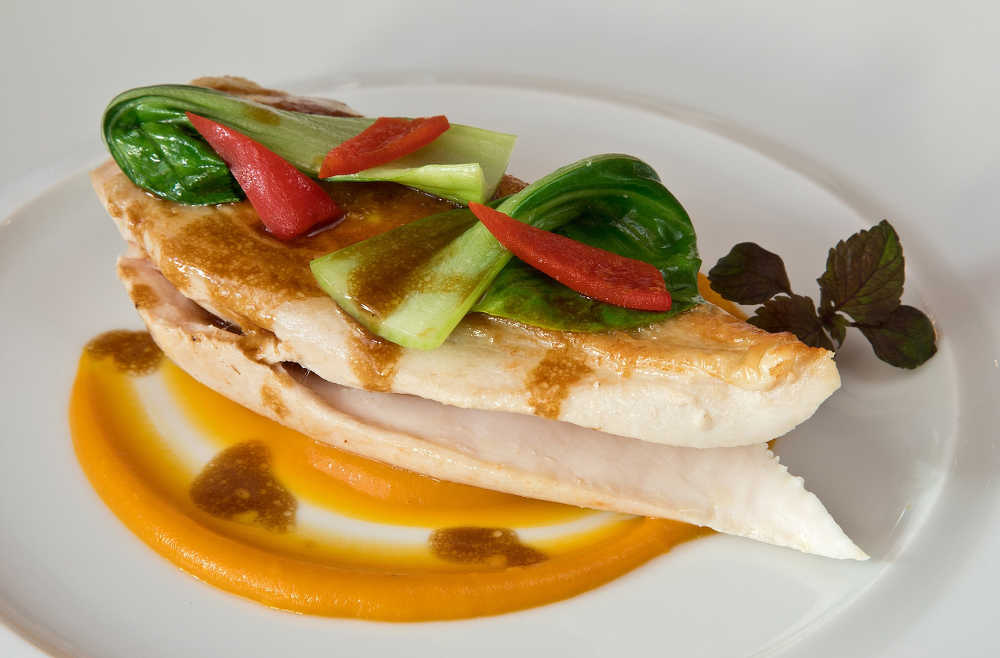
The Friendly Farmer Pasture-Reared Chicken with Lemon Viennoise and Sweet Potato Purée
Serves 4
1 x Friendly Farmer pasture-reared whole small chicken
For the sweet potato purée:
rock salt
6 sweet potatoes
100g butter, diced
salt and freshly ground black pepper
For the lemon viennoise:
500g fresh white breadcrumbs
400g butter, diced
70g grated Parmesan
2 egg yolks
zest of 3 lemons
pinch of saffron powder
To serve:
wilted pak choi
roast red pepper
roast chicken jus
Preheat the oven to 230°C.
Pour a thick layer of rock salt in a baking tray. Scrub the unpeeled sweet potatoes well, then pat them dry and nestle them into the bed of salt. Cover the tray with foil and roast in the oven for about 1 hour, until the potatoes are tender when pierced with the tip of a knife.
When the potatoes are cool enough to handle, split them open and scoop the flesh into a Thermomix or food processor along with the butter and salt and pepper to taste. Blend to a smooth purée and keep warm.
Reduce the oven temperature to 180°C.
To make the lemon viennoise, simply mix all the ingredients together in a food processor.
Remove the legs and wishbone from the chicken so that you’re left with just the crown. Stuff the lemon viennoise under the skin, then place the chicken on a large baking tray. Roast in the oven for 20 minutes, until completely cooked through. Set aside to rest for about 10 minutes before carving.
Serve the carved chicken on top of a spoonful of sweet potato purée. Finish with wilted pak choi and a few small strips of roast red pepper and drizzle with roast chicken jus.
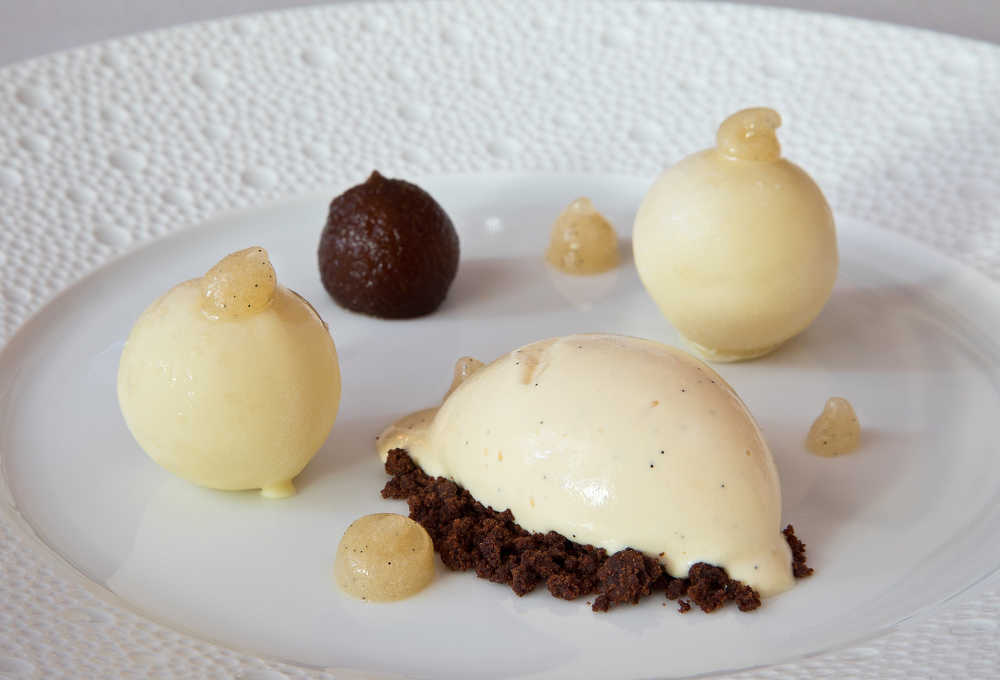
Cuinneog Buttermilk Ice Cream with Pear and White Chocolate Café au Lait
Serves 12
For the ice cream:
2 litres Cuinneog Buttermilk
450g egg yolks
360g caster sugar
1 vanilla bean, split in half lengthways and seeds scraped out
For the pear sorbet:
1kg pear purée
360g caster sugar
10ml Poire Williams eau de vie
1 vanilla bean, split in half lengthways and seeds scraped out
100g white chocolate, melted
For the marinated pears:
2 ripe pears
100ml freshly brewed espresso, cooled
To serve:
chocolate biscuits, crushed
To make the ice cream, bring the milk to the boil in a large saucepan, then immediately remove from the heat. Mix the egg yolks, sugar and vanilla seeds together in a large heatproof bowl. Pour over the scalded milk and whisk to combine. Allow to cool, then churn in an ice cream machine according to the manufacturer’s instructions and freeze.
To make the pear sorbet, place the pear purée and all sugar in a large saucepan and bring to the boil, then remove from the heat and add the Poire Williams and vanilla seeds. Allow to cool, then churn most of it (save a little for decorating the finished dish) in an ice cream machine according to the manufacturer’s instructions and freeze.
When the sorbet has frozen solid, break the chocolate into pieces and place in a heatproof bowl set over a pan of simmering water, making sure the bottom of the bowl doesn’t touch the water. Scoop the sorbet into 20g balls and dip them in the melted white chocolate, then place back in the freezer until needed.
Peel and core the pears and use a Parisienne scoop to make balls. Pour the cooled espresso into a bowl and add the pears. Allow to marinate for at least a few hours or overnight.
Serve a quenelle of ice cream on a spoonful of crushed chocolate biscuits with balls of the pear sorbet, marinated pears and dots of the remaining pear purée alongside.
Georgina Campbell's Cookery Feature - A Taste of Spring
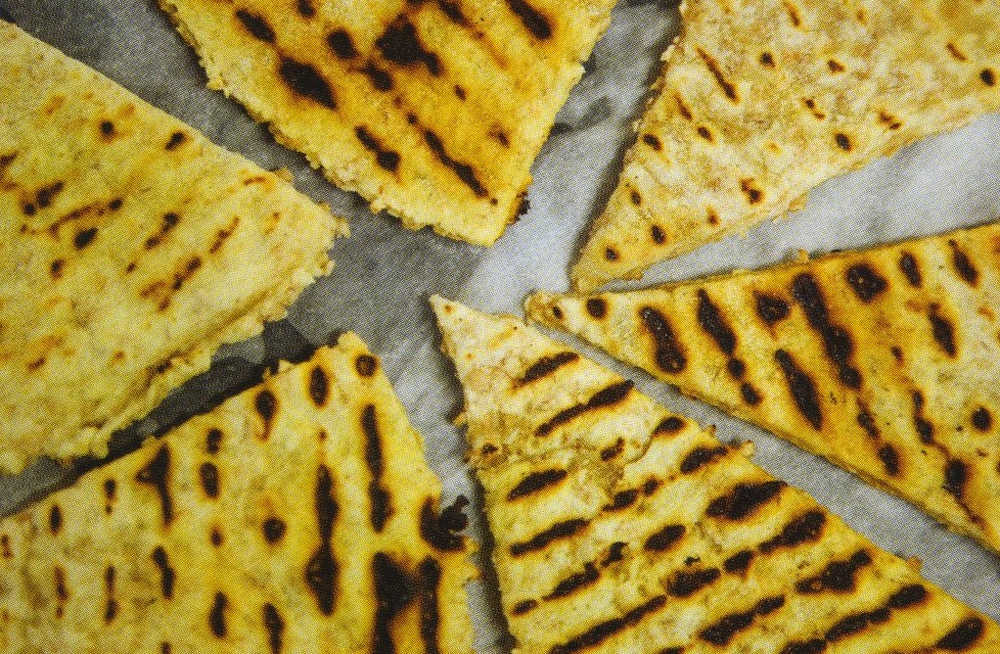
The arrival of April, and Easter, brings a change of tone in the kitchen. Here are a few suggestions for some aromatic recipes that can be served as sharing dishes and suit the longer, brighter days - and, perhaps, a little casual entertaining.
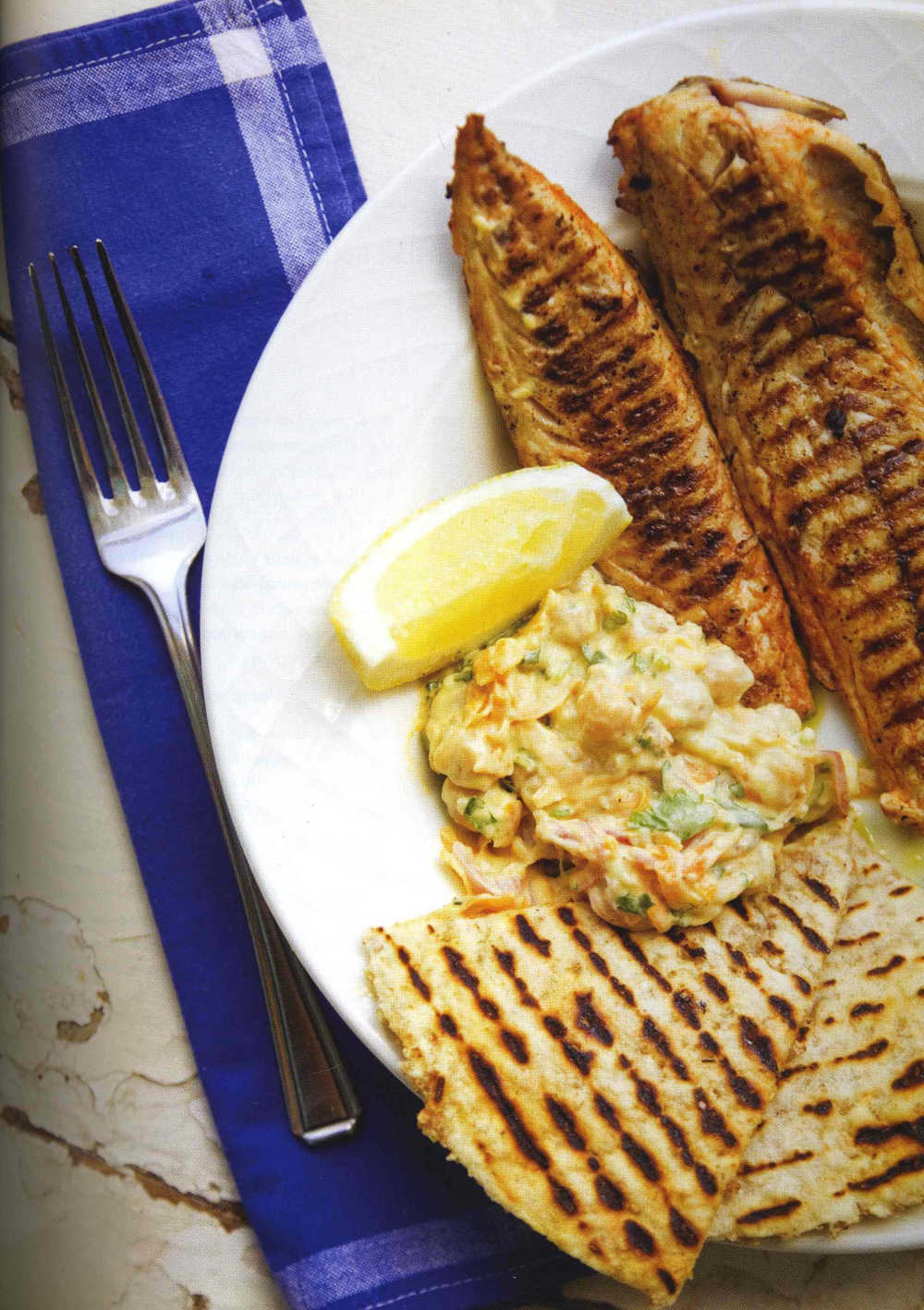
Moroccan-Spiced Mackerel
This is from Northern Irish chef Paula McIntyre’s popular book, A Kitchen Year (Gill & Macmillan, 2008). The recipe introduction is pure Paula: “My favourite way of eating mackerel is straight off the boat (preferably caught myself) and simply grilled on a barbecue with a squeeze of lemon. Doing this on a cold April day isn’t feasible, but pairing mackerel with sunny Moroccan flavours is. Throw in a spicy; sweet carrot salad with creamy chickpeas and crisp flathread (see below) and who needs summer?”
Serves 4
8 mackerel fillets, pin boned
Spice blend:
10 cardamom pods
2 teaspoons coriander seeds
2 teaspoons fennel seeds
2 teaspoons cumin seeds
zest of 1 orange
1 teaspoon smoked paprika
4 tablespoons olive oil
Crack the cardamoms to release the seeds. Place the cardamom seeds with the other seeds in a mortar and pestle or coffee grinder and process to a fine powder. (Set aside half this mixture for the carrot salad below, if making, otherwise store in a screw top jar to use again.) Combine the remaining spices with the orange zest, smoked paprika and olive oil. Rub all over the mackerel and set aside for 1 hour.
To cook the mackerel, heat a griddle pan or frying pan until smoking hot. (Alternatively, weather permitting, light the barbecue.) Season the mackerel with salt on both sides and place, skin side down, on the pan. Cook for 2 minutes, or until you can actually see the mackerel cooking up the sides. Flip over and cook for 2 minutes on the other side. Serve immediately.
Spiced Carrot and Chickpea Salad
This salad is ideal with the Moroccan-spiced Mackerel, above, but also works well with salmon and grilled chicken.
4 tabespoons olive oil
2 large carrots, peeled and grated
Half of the spice mixture given above for the mackerel
2 cloves garlic, crushed
1 tablespoon finely grated ginger
1 tablespoon sesame seeds
2 lemons
100 ml mayonnaise
100 ml natural yoghurt
1 x 400g tin chickpeas, drained
1 red onion peeled and finely sliced
handful fresh coriander, chopped roughly
Heat the oil in a large frying pan over a high heat. When hot, add the carrots and cook until golden.
Add the ground spice mixture, garlic and ginger to the carrots and cook for 1 minute. Set aside in a bowl.
Clean out the pan, heat until smoking and dry toast the sesame seeds in the pan until they start to pop. Set aside.
Cut the lemons in half and brush with oil on the cut side. Heat the pan until smoking hot and cook the lemons, flesh side down, until golden, about 1 minute. Squeeze the juice into a bowl and whisk in the mayonnaise and yoghurt. Toss this dressing into the carrot mixture and add the sesame seeds, chickpeas, red onion and coriander.
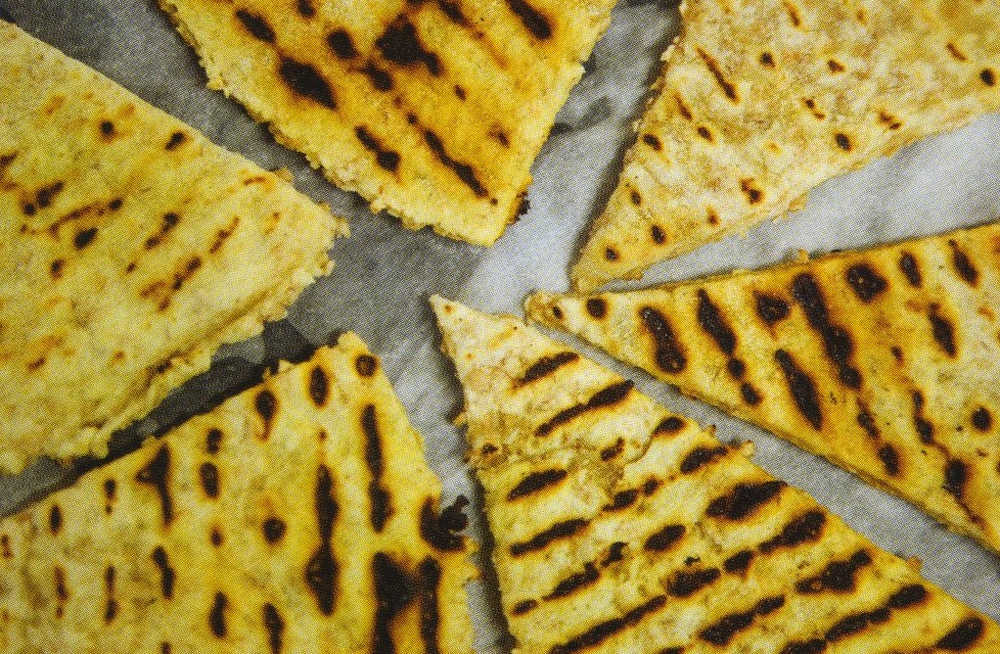
Flatbread
These crispy flatbreads are the perfect contrast to the soft mackerel and the spiced carrot salad.
150 g plain flour
125 g wholemeal flour
1 teaspoon salt
1 tablespoon natural yoghurt
1 tablespoon olive oil
100 ml water
Place the flours and salt in a bowl. In a separate bowl, whisk the yoghurt, oil and water together and mix to a dough with the flour mix. Wrap in cling film and chill for 20 minutes.
Divide the dough into 8 pieces. Roll each piece in a ball and roll on a lightly floured surface into a 2-mm thick round (don’t worry about perfect circles, this is a rustic bread). Heat a griddle or frying pan over a medium-high heat and add a prepared flatbread. When the surface starts to bubble, turn over and cook for 30 seconds on the other side. Repeat with the other breads and stack them as you go.
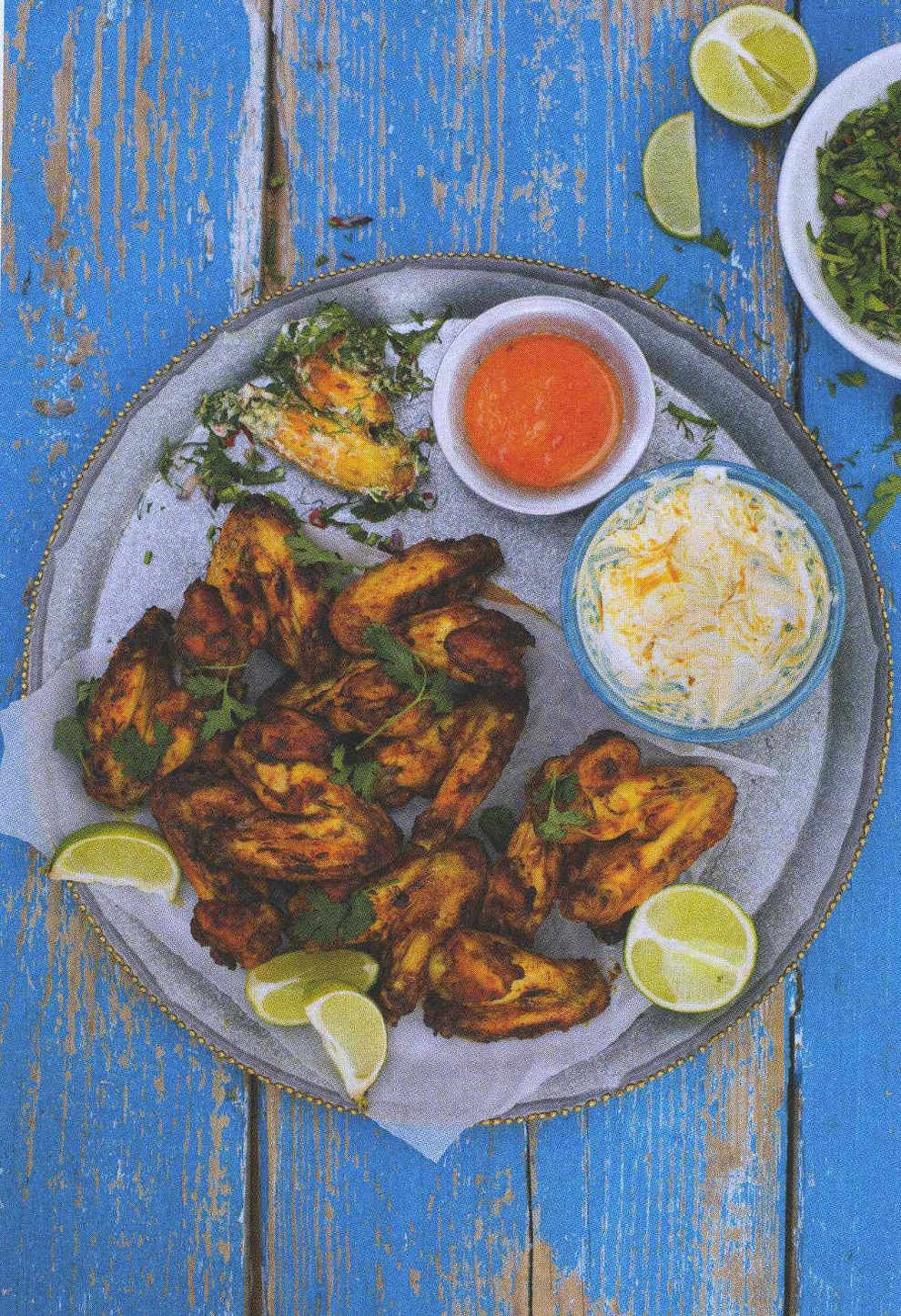
Roast chicken wings with dipping sauces and herbs
An enjoyable brunch in Brother Hubbard recently sent me scurrying back to take a fresh look at Ballymaloe-trained co-owner Garrett Fitzgerald’s Brother Hubbard Cookbook and its cornucopia of aromatic Middle-Eastern and Southern Mediterranean inspired dishes.
“Chicken wings are a bit of a secret shame for me,” Garrett confesses. “They are an addictive snack to have any evening, but I generally feel quite guilty about them, as they are too often deep-fried and served with a very buttery, oily and surprisingly sugary sauce.
So we decided to have a go at making them just a little healthier without compromising on flavour. The fact that they eliminate a lot of that guilty feeling just adds so much more to the experience! This is actually one of the dishes I'm most proud of.
I hope you will see why when you taste it. These are very easy to make, and with the yogurt and herbs they are really quite a delight and far better for you than the typical wing, so please do make them as suggested below, with the sauces recommended, for the full effect.”
I can totally endorse the idea of roasting chicken wings - buy good big free range ones from producers such as Bertram and Celine Salter’s Carlow Foods, or The Friendly Farmer in Athenry, and you’ll be surprised how much tasty eating there is on them.
Serves 2-3 people as a substantial meal with some salad or 4 as a decent starter
l kg chicken wings
3 garlic cloves, crushed
juice of ½ lemon
2 tsp ground cumin
2 tsp sweet or smoked paprika
1 tsp ground turmeric
1 tsp olive oil
salt and freshly ground black pepper
To serve:
l00g in total mixed soft fresh herbs (a mixture of at least 3 or ideally all of the following: coriander, flat-leaf parsley, mint, lovage and/or dill)
6 dessertspoons thick Greek yogurt
squeeze of lemon
4-5 tbsp hot sauce (a recipe is given; or use Tabasco ‘or any hot sauce that takes your fancy’)
When buying your wings, they are often sold as a full joint with the wing tip attached. If you get them like this, it's very easy to prepare them as follows. Straighten out the wing and just cut down through the joint or 'elbow' - it should be easy enough to cut through. On the wing section, trim off the wing tip.
Next, marinate your chicken wings by placing them in a big bowl with half the crushed garlic and the lemon juice, cumin, paprika, turmeric, oil and some seasoning. Toss them around well and leave to marinate for at least 1 hour or several hours or overnight if you have the time (for a longer marinade, pop them in the fridge, covered). When ready, preheat the oven to 180°C. Tip the wings out onto a lined roasting tin in a single layer and pop in the oven for 20 minutes.
While that's all happening, prepare your herbs by chopping the stalks very finely (except the mint) and placing them in a bowl, then chop the leaves quite finely and add them to the bowl too. (If you fancy it, some very finely chopped fresh chilli and/or very finely diced red onion would be sensational added to this mix.)
Make your yogurt dipping sauce by folding the remaining garlic puree, seasoning and a dash of lemon juice into the yogurt - don't overmix. Taste and adjust any of the components as you feel necessary. It should be lovely and creamy while also having a nice punch of lemon and garlic to it.
Take the chicken wings out of the oven and turn up the heat to 220°C. Toss them in a decent amount of the hot sauce and return to the oven for the final blast to get them nicely browned and a little crisp and charred on the outside - 5-10 minutes should do it. You can do this under a very hot grill or on a hot frying pan if you prefer, turning once they are nicely browned and repeating on the other side.
To serve, put the yogurt sauce in a bowl with a dash of hot sauce stirred through it. Put the finely chopped herbs in a separate bowl. Serve these on the side, dipping the wings into the yogurt and then the herbs as you eat! Having more hot sauce available on the side too would be appreciated by some people, I'm sure.
Serve with finger bowls of warm water with a slice of lemon in each and a good few napkins, and wash down with some crisp white wine or a cold beer.
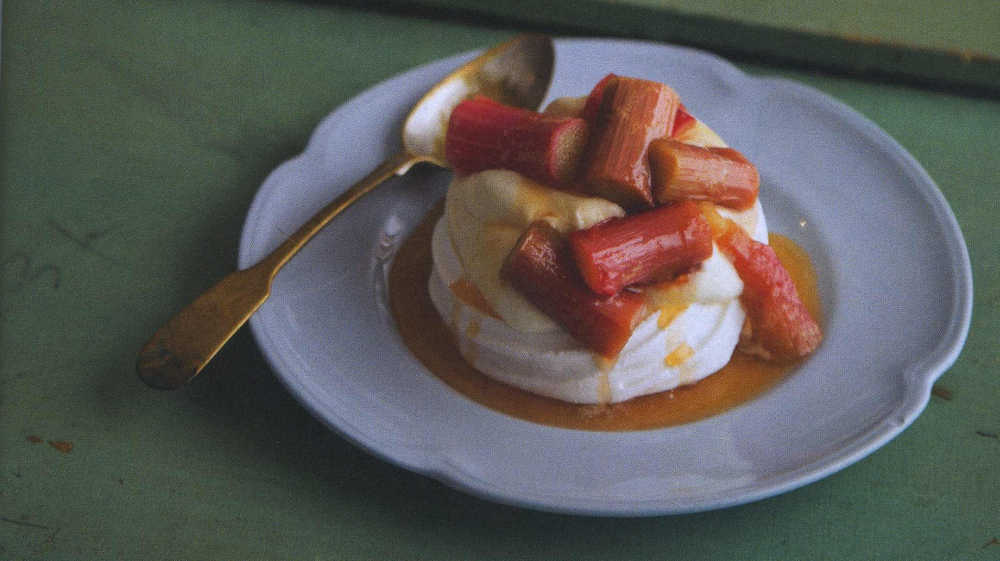
Rhubarb & Orange Meringues
Using Anne Marie Walsh’s Tipperary Kitchen Marvellous Meringues made in Holycross - see my ‘trip to South Tipperary’ in the new edition of the SuperValu magazine Fresh - this is a pretty and very easy dessert for spring and early summer.
The sweetness of the meringue nests offsets the natural tartness of the rhubarb, and thickening the juices a little with arrowroot makes a glossy, translucent sauce.
Rhubarb and orange make a natural partnership, but you could substitute extra water for the orange juice if preferred.
Serves 6 -12
Ingredients
125g/4oz caster sugar
150ml/¼ pint water
150ml/¼ pint orange juice
1 bunch pink rhubarb, trimmed & cut into approx 2.5cm/1” lengths
1 tsp/5ml arrowroot
1 dsp/10ml cold water
2 packs x 6 meringue nests (such as The Tipperary Kitchen Marvellous Meringues)
250ml/8 fl oz fresh cream, whipped
Crystallised orange zest to decorate (optional).
Method
In a shallow stainless steel saucepan, dissolve the sugar in the water over low heat and then add the orange juice.
Bring up to the boil, add half of the prepared rhubarb and simmer over gentle heat for about 5 minutes, until just tender but holding its shape.
Using a slotted spoon, remove carefully and transfer to a shallow bowl. Repeat with the second half of the rhubarb.
Blend the arrowroot and the cold water, stir into the warm syrup and bring up to boiling point; cook gently, stirring, until the mixture clears and thickens.
Add this sauce to the bowl of rhubarb, mix gently and leave to cool.
When ready to serve, place the meringue nests on a serving plate, or lay one or two meringues on individual dessert plates. Place a spoonful of whipped cream in each meringue nest, arrange some rhubarb pieces and sauce on top and around the nests, and finally sprinkle with crystallised orange zest, if using.
Serve any remaining rhubarb and cream separately - or, if you have any broken meringues, use them to make up a simple ‘Rhubarb Mess’.
Georgina Campbell's Cookery Feature - Grow & Cook
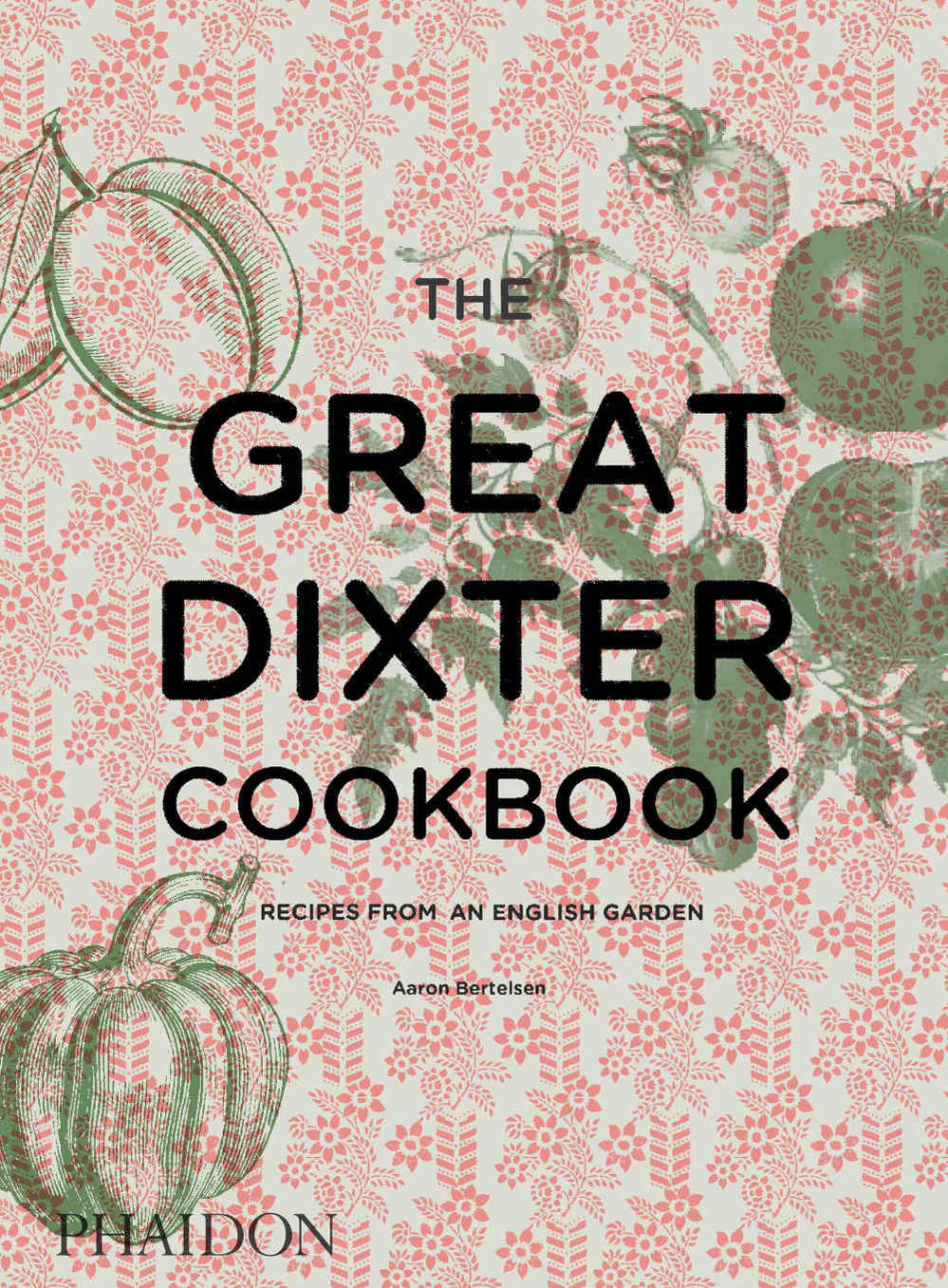
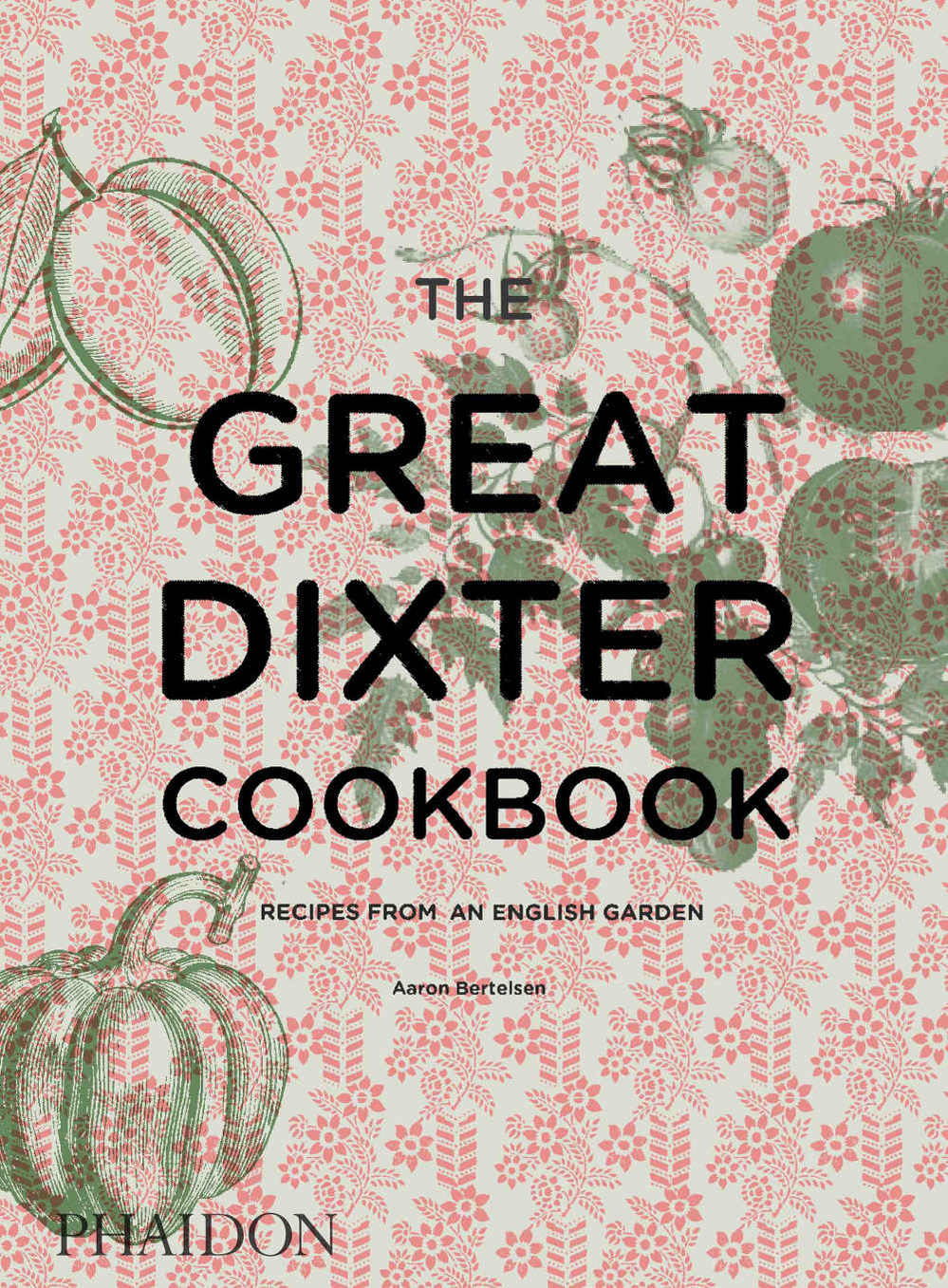
As we head into early summer - loveliest of seasons for gardens, whether your own or others to visit - there’s no better time to remember the late great Christopher Lloyd, gardener and garden writer extraordinaire.
His books are inspiring yet full of common sense and they read like novels, and his home - Great Dixter, on the borders of Kent and Sussex - was designed by Edwin Lutyens, who also designed most of the gardens that were the love of Lloyd’s life and remain one of Britain’s favourite gardens.
Although best known for their magical, densely planted floral displays, there has always been a practical side to this lovely spot, so food production has its rightful place here too. Lloyd himself was a self-taught home cook and a number of own recipes have recently been published for the first time in the Great Dixter Cookbook (Phaidon, €29.95) a beautiful hardback written by the vegetable gardener and resident cook at Great Dixter, Aaron Bertelsen.
And, although there is no hint of it in the title, this is also a gardening book and, for many readers, an especially enjoyable feature will be the first and last sections, which are all about growing for the kitchen. And this is practical stuff for hands-on gardeners.
At the front, there’s a seasonal grower’s guide with favourite varieties, key dates and common problems all covered for a wide variety of produce, for example, and there’s a lot more at the back, including a glossary and guidance on basics like digging, composting and feeding, sowing and planting, watering, staking, pruning and harvesting.
So, definitely not ‘just’ a cookbook - but a very good cookbook nonetheless. Continuing the welcome theme of “Honest, simple cooking” that was so close to Christopher Lloyd’s heart, Bertelsen celebrates the seasons in the garden and the kitchen through his collection of over seventy recipes.
Ranging from the homely and traditional - such as Chicken and Leek Pie, Slow-Cooked Shoulder of Lamb, Apple Crumble and Beetroot Chutney - to more unusual and contemporary dishes, they all come with meaningful introductions that give them context in the ongoing story of Great Dixter.
Whether looking for inspiration or practical advice, every lover of good food and gardening will find it here.
RECIPES:
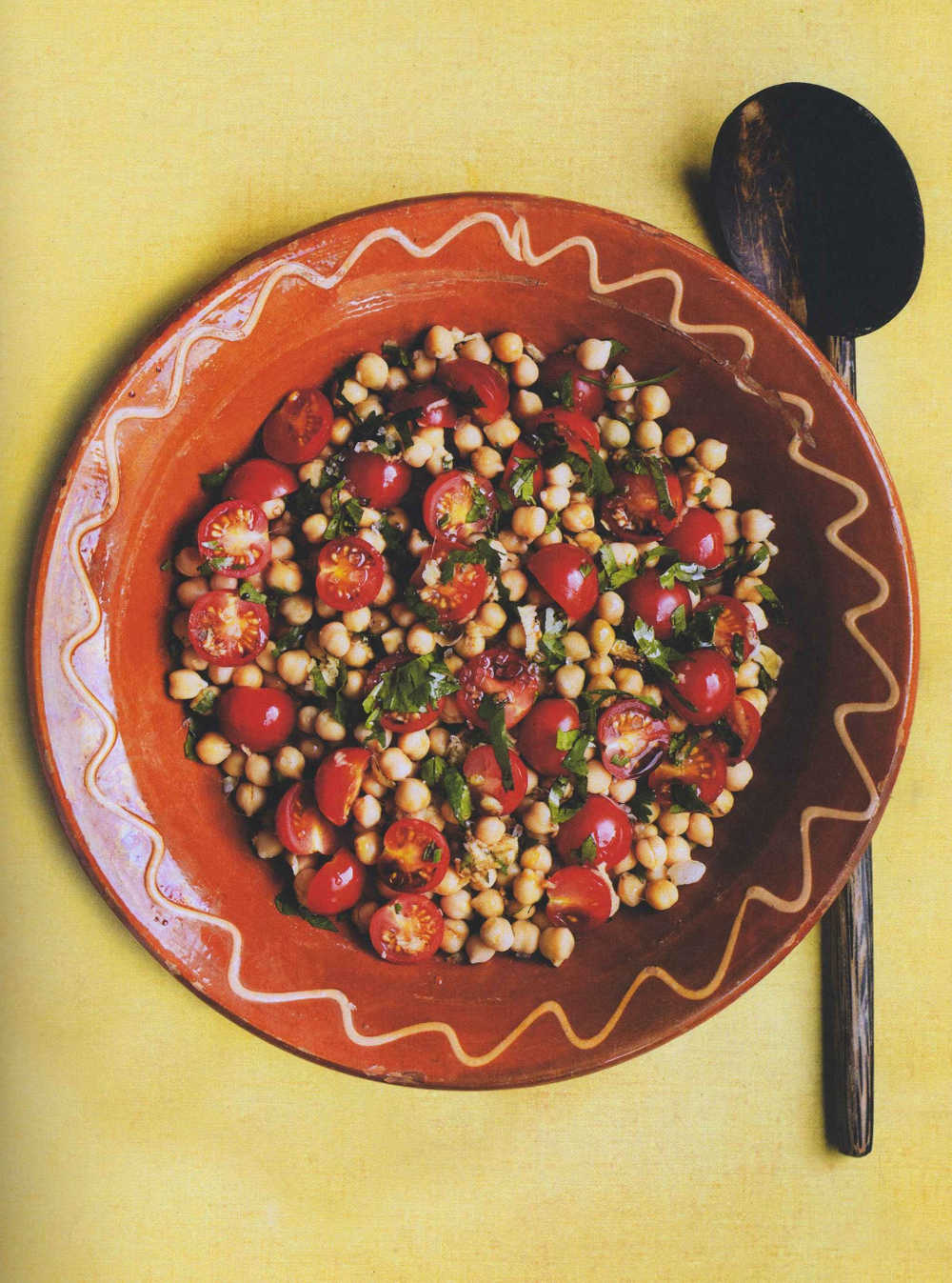
Chickpea and Tomato Salad
Serves 3-4 as a light lunch, or 6 as a side dish
This recipe comes from my friend Ellie, who helps me in both the garden and kitchen. I still remember the first time I had this salad. I was so struck by the levels of different flavour it had, I made her give me the recipe before we even got up from the table. The great thing about salads like this is that they can be eaten either as a light lunch or alongside something more substantial, such as a grilled (broiled) lamb chop or baked chicken thighs. Coriander (cilantro) grows very well at Great Dixter, but is one of those plants that wants to run to seed as soon as it can. You need to keep on top of the picking, and this recipe is a perfect way to use up a good lot of the herb.
2 x 400-g/14-oz cans chickpeas, drained and rinsed
16 cherry tomatoes, cut in half good handful chopped coriander (cilantro) or flat-leaf parsley
7.5-cm/3-inch piece of fresh ginger, peeled and grated?
4 teaspoons balsamic vinegar
3 tablespoons olive oil
salt and pepper
Pat the chickpeas dry with paper towels. Put into a bowl, then add all the other ingredients. Mix well and let sit a while to let the flavours meld. Mix again before serving.
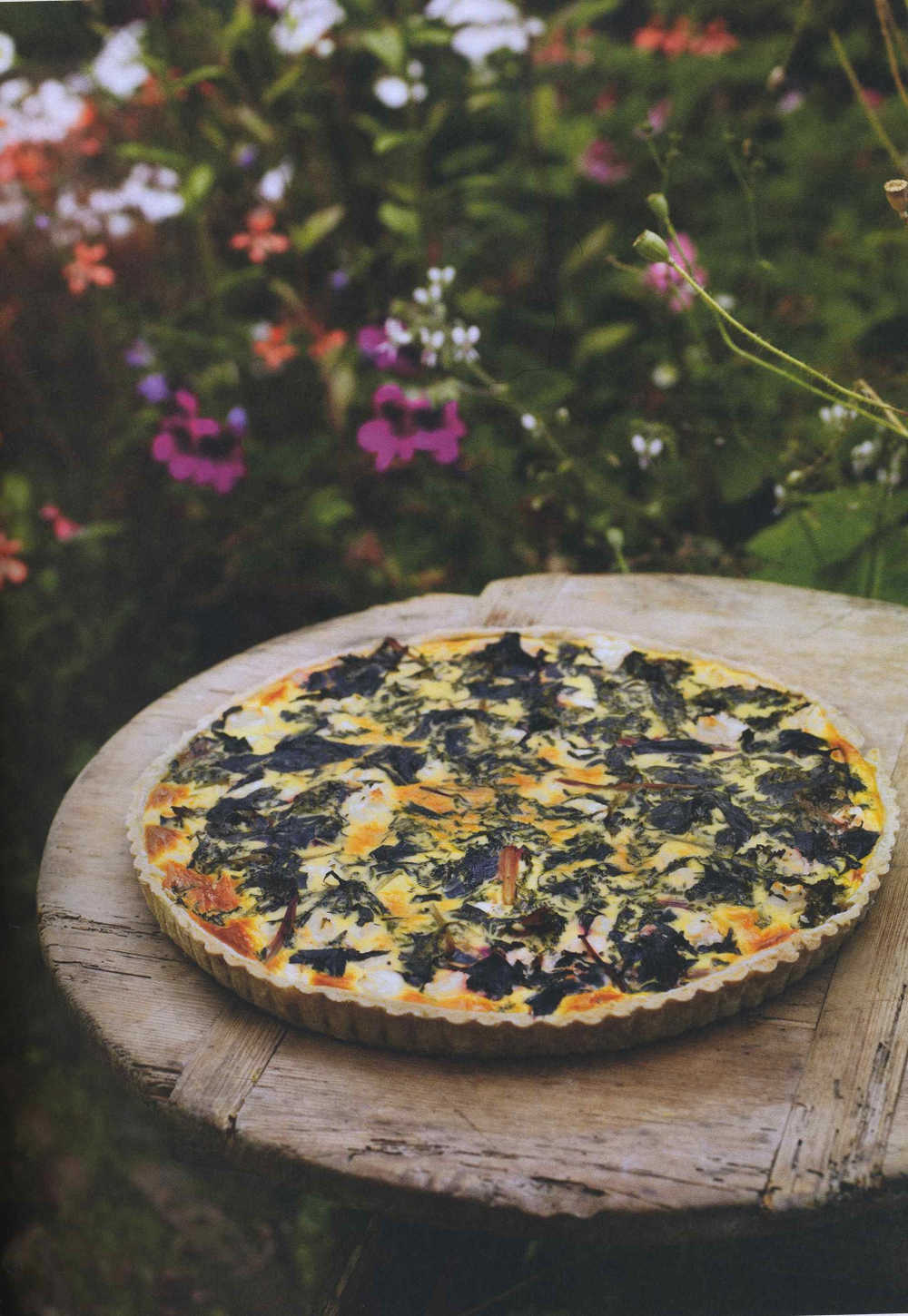
Beet Top And Feta Tart
Serves 8
Once I mastered pastry-making, there was no stopping me, and any meal became an excuse to make a tart. As?time went on, I started looking for new ingredients to mix together. Beet tops (greens) are often ready in the spring before the spinach and chard, which is what gave me the inspiration for this tart. They have a nutty, earthy flavour and are also good eaten on their own as a steamed or boiled vegetable. I love this tart so much that I cook and freeze the leaves for those times we do not have any.
oil or butter, for greasing?
1 x12 oz/350g quantity chilled Shortcrust Pastry (12oz/350g flour, 6 oz/175g butter etc)
flour, for dusting?
beet tops (greens) from 8 plants, rinsed and chopped?
175 g/6 oz feta cheese, diced or crumbled?
300 ml/10 oz (11⁄4 cups) crème fraiche
3 eggs
100 ml/31/2 fl oz (scant 1⁄2 cup) milk
salt and pepper
Preheat the oven to 180°C/350°F/Gas Mark 4, placing an oven rack in the lower part of it. Grease a 30-cm/12-inch loose-bottom tart pan.
Roll out the pastry (dough) on a lightly floured work surface until it is large enough to line your tart pan.
Put the beet tops (greens) into a pan with just the water that clings to them after washing. Cover with a lid, cook over?low heat for about 5 minutes until wilted. Let cool, then drain and spread over the bottom of the pastry case (shell). Sprinkle with the feta.
Put the crème fraiche, eggs and milk into a bowl and beat together. Pour this mixture into the pastry case and season with salt and pepper. Place on a baking sheet and bake for 40–45 minutes until just set.
Take the tart out of the oven and carefully slip off the outer ring, leaving the tart sitting on the base. Return to the oven on the baking sheet for another 5–10 minutes so that the sides get really crisp.
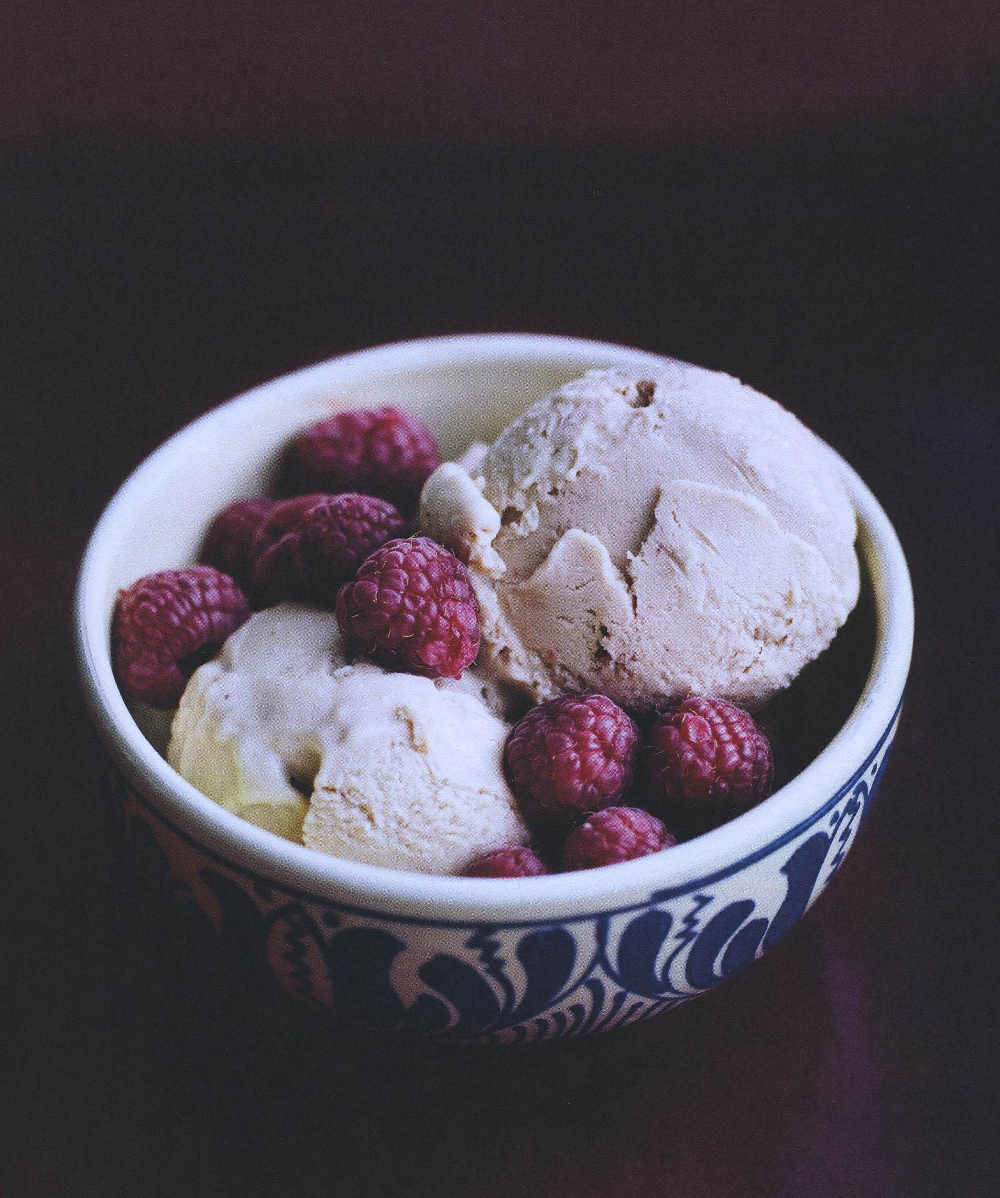
Raspberry Ice-Cream
Serves 4–6
Home-grown raspberries have such a good flavour that they’re great to eat just as they are, but a number of my friends make it clear when they come to visit that fruit alone does not constitute a proper pudding. This ice-cream is the perfect solution. As it can be made in advance, it gives you more time with your guests – and it uses up any surplus fruit from the garden.
250 g/9 oz (2 cups) raspberries,
plus extra to serve
225 g/8 oz (1 cup) caster (superfine) sugar
2 eggs, plus 4 egg yolks (save the whites for another dish)
600 ml/1 pint double (heavy) cream
Put the raspberries and 2 tablespoons of the sugar into a small pan. Cook over medium heat until the sugar dissolves, keeping your eye on it the whole time. Simmer for about 5 minutes until thickened, then push through a fine-mesh sieve into a bowl, discarding the seeds.
Put the eggs, yolks and remaining sugar into a heatproof bowl and whisk briefly to combine. Place the bowl over a pan of simmering water, making sure it does not actually touch the water, and whisk for 3–4 minutes, until the mixture is thick and pale and has doubled in volume. Take off the heat and continue whisking until the mixture is cool (about 3 minutes).
Whip the cream in a separate bowl until it forms soft peaks. Fold it gently into the cool egg mixture until just combined. Pour into a shallow freezer-proof container or dish. Gently swirl the raspberry coulis through the mixture, cover with clingfilm (plastic wrap) or a lid and freeze for 3 hours.
Remove and beat with a fork to break up the ice crystals, then return to the freezer for another 3 hours.
For easier serving, allow the ice-cream to soften slightly at room temperature for about 10 minutes. Scoop into bowls and serve, topped with extra raspberries.
Georgina Campbell's Cookery Feature - Celebrating Cheese
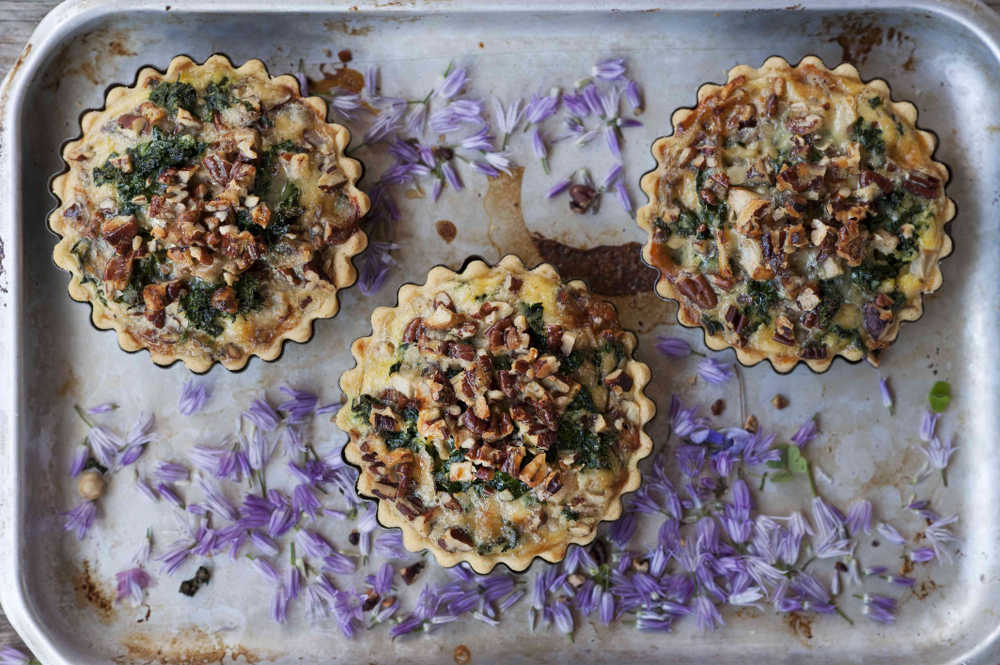
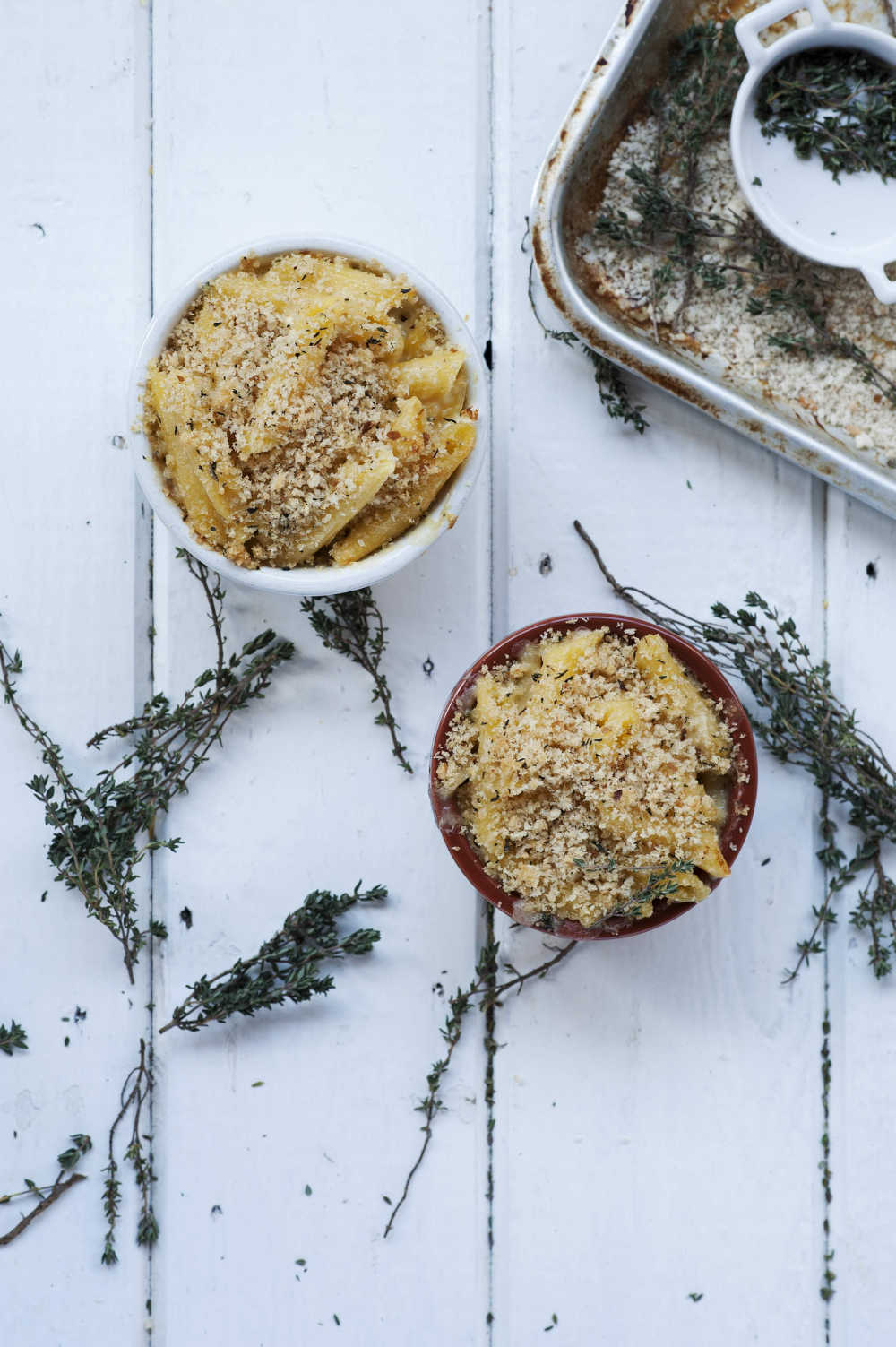
National Cheese Week took place earlier this month and, with it, came The National Dairy Council’s announcement of the six finalists in their Cheese up your Life recipe competition.
The competition attracted a large volume of entries across two categories - ‘Culinary Student’ and ‘Passionate Cooks and Foodies’ - and was judged by a trio of experts: Irish Chef and writer Clodagh McKenna; Former Irish Olympian and Fit Foodie Derval O’Rourke; and Vanessa Greenwood of Cooks Academy.
They were impressed by the high standard and diversity of entries, commenting: “It was really great to see amateur cooks creating delicious recipes using a wide range of Irish and European cheeses and really demonstrating the diverse versatility and great taste of cheese”.
First prize in the Culinary Student category went to Hanna Mathe, who is studying Culinary Arts at Waterford Institute of Technology, for her delicious Blue Cheese, Kale and Pecan Tart, whilst amateur chef Róisín Gallagher won first prize in the Passionate Cooks and Foodies category for her innovative take on a classic lasagne, the Cheesy Bean Lasagne.
Recipes from the other four finalists were also innovative. Donna Hennessey, a food writer and blogger from Cork, created a delicious snack of Haloumi Fries served with a spicy yoghurt dressing and fresh pomegranates, while Elke O’Mahony also from Cork created a delicious and unique Cauliflower Cheddar & Walnut Tart.
Using three different types of Irish farmhouse cheese, Co Louth food writer and cookbook editor Kristin Jensen’s delicious Irish Farmhouse Mac and Cheese packed a punch, while sisters Gráinne and Shauna Moggan from Dublin combined fish and cheese in their scrumptious Cheesy Fish Smokies.
RECIPES:
Blue Cheese, Kale and Pecan Tart
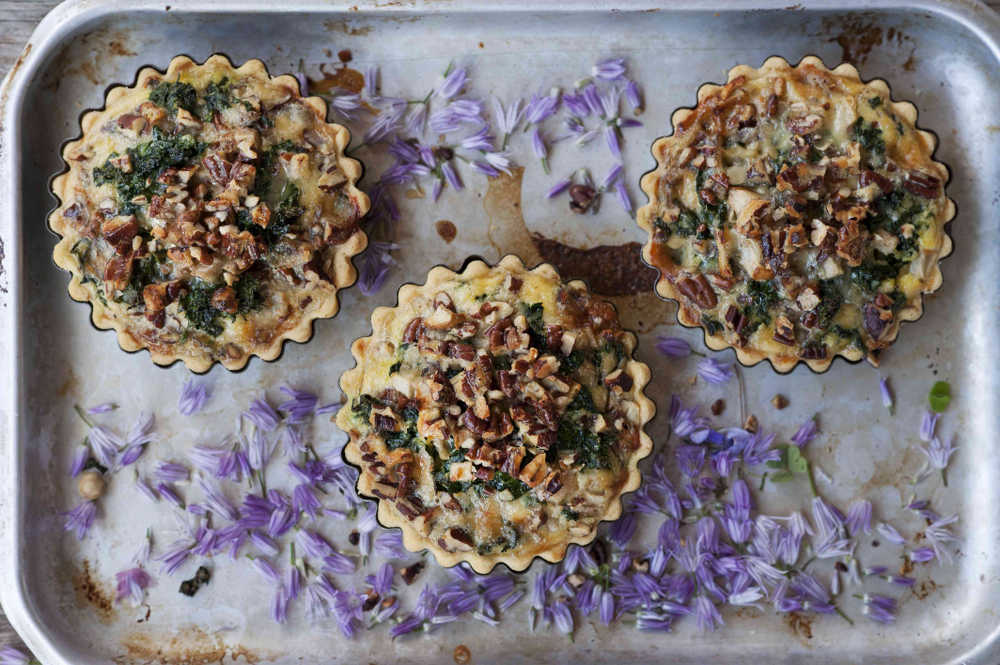
First prize in the Culinary Student category, created by Hanna Mathe, Waterford
“This is a delightful dish with an explosion of flavours with every bite. Not only is it aesthetically pleasing with vibrant colours but has a perfect balance of sweet, bitter, sour and savoury; the cheese, pecans and pear are a wonderful combination of opposites in flavour, completed by the crunchy texture of the kale and creaminess of the custard.”
Prep Time: 45 mins
Total Time: 180 mins
Servings: 8
Ingredients:
For the shortcrust pastry
200g plain flour
100g butter, chilled & cubed
35ml of cold water
pinch of sugar
For the custard
1 whole egg
1 egg yolk
150ml cream
1 tbsp caster sugar
For the filling
150g kale, roughly chopped and washed
75g pecans, roughly chopped
1 small pear, cubed
100g Cashel Blue cheese, cubed
1 tsp coconut oil
1 tsp butter
maple syrup to taste.
Method:
1. Put flour, pinch of sugar and cubed butter into a food processor and process until the mixture resembles breadcrumbs.
2. Gradually add the cold water until the dough just about comes together.
3. Remove from food processor, wrap dough in cling film and chill in fridge for 15 minutes.
4. Make a cartouche of greaseproof paper, roughly 8-10 cm bigger than your tart tin.
5. Remove dough from fridge. On a floured surface, begin "ridging" the pastry disc; holding rolling pin in both hands, loosely tap over the entire surface of the pastry once or twice, turning it at a 90 degree angle and repeating the same process until it has at least doubled in size.
6. Once doubled in size, using short, sharp strokes of the rolling pin roll the pastry out to a thickness of 3mm, turning it while rolling(If pastry is cracking around the edges, stop rolling and seal the cracks with your fingertips). Ensure pastry isn't overworked.
7. Carefully wrap the pastry once or twice around the rolling pin and place it over the tart tin. Lift overhanging pastry up a little, encouraging the pastry inside to fit snugly.
8. Using a piece of overhanging pastry, push the pastry in the tin well into the corners. Using a rolling pin, cut through the pastry and remove overhanging bits from the tin.
9. Insert cartouche and baking beans and chill the pastry for at least 30 minutes in the refrigerator.
10. Preheat oven to 200°C / gas mark 6 and blind bake pastry for 20 minutes.
11. Reduce oven temperature to 180°C / gas mark 4, remove baking beans from pastry and bake for a further 10- 15 minutes (to create a protective layer between pastry and wet filling , brush with lightly beaten egg white). Remove from the oven and cool.
12. Make custard by whisking the egg, the yolk and 1 tbsp sugar together. Heat the cream by bringing to a simmer, remove from heat and, using an electric mixer add to the egg mixture.
13. Return custard to the stove and on low heat (should be between 75-85°C), using a wooden spoon stir continuously until it coats the back of the spoon and dragging your finger along the spoon the trail remains intact. Ensure low heat so custard doesn't curdle.
14. Sauté the kale in the teaspoon of butter and coconut oil and set aside to cool.
15. When all your ingredients have cooled, begin filling the tart case by starting with a layer of blue cheese on the bottom, followed by kale, pear and pecans and more cheese. Repeat process until all fillings are used up.
16. Pour custard over the tart evenly and drizzle with maple syrup to taste.
17. Bake in a 180°C / gas mark 4 oven for 45 minutes to an hour, or until the custard has set and the pecans have toasted (Cover tart with tinfoil 20-25 minutes into baking and return to oven).
18. Remove from oven and cool before slicing.
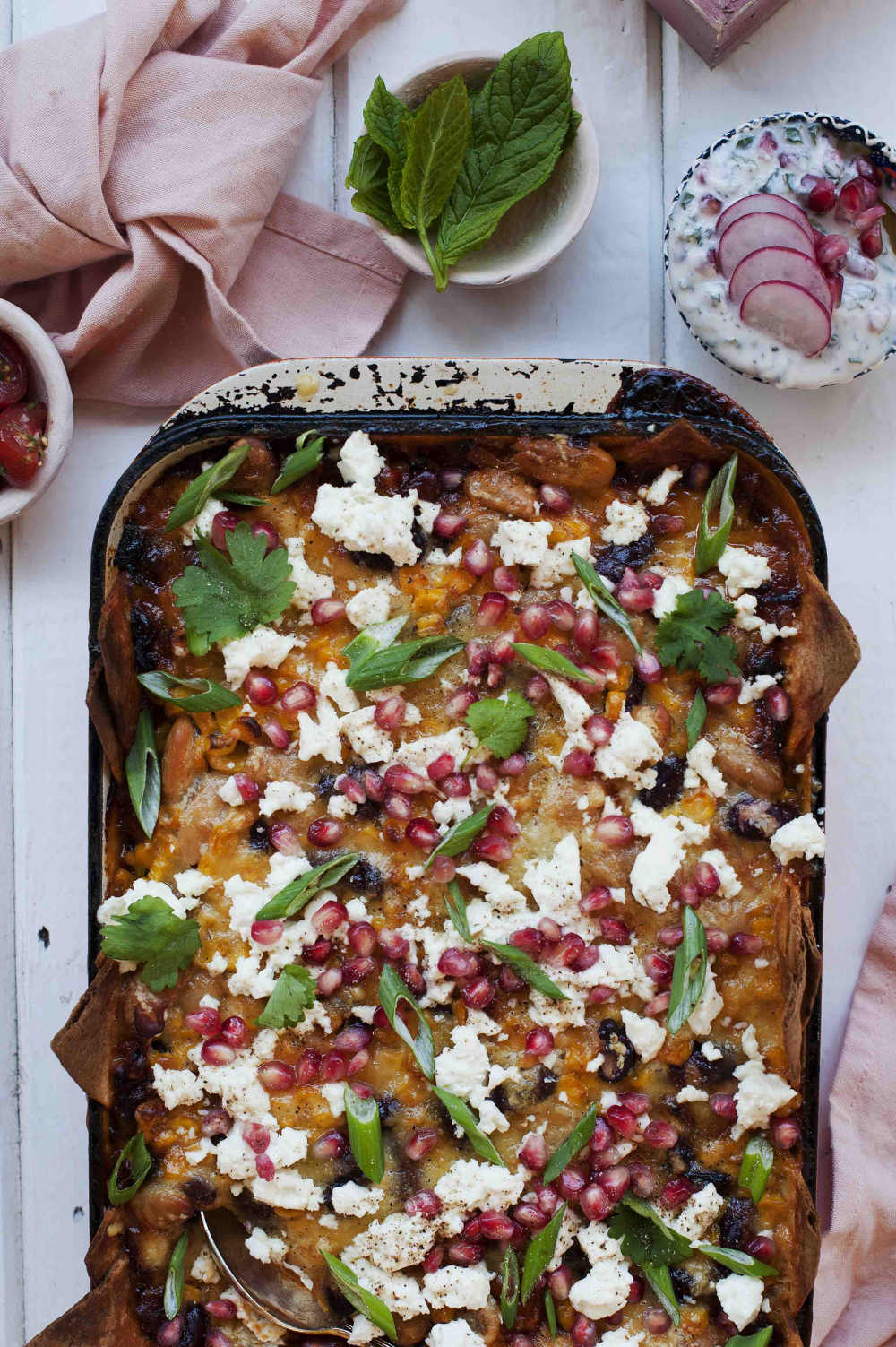
Cheesy Bean Lasagne
First prize in the Passionate Cooks and Foodies category, created by Róisín Gallagher, Dublin
This dish is extremely tasty, easy to make, nutritious and filling. It is a great midweek meal and any leftovers can be eaten for lunch the following day and almost taste better as the flavours really develop.
Prep Time: 30 mins
Total Time: 60 mins
Servings: 6-8
Ingredients:
For the tomato sauce
1 tbsp rapeseed oil
1 red onion, finely diced (peeled and chopped)
2 cloves of garlic, finely chopped
1 red pepper, deseeded and chopped
2 red chilli, finely chopped (including seeds)
3 tbsps fresh coriander including stalks, finely chopped
1 tbsp tomato puree
2 tins chopped tomatoes
1 tsp sugar
100g baby spinach
250ml water
freshly ground pepper
For the filling
1 400g tin red kidney beans, drained
1 400g haricot beans, drained
2 250g tins sweetcorn kernels, drained
200g mature Irish cheddar cheese, grated
50g feta cheese, crumbled
4½ soft tortilla wraps, cut into quarters
For tomato salsa
small punnet of cherry tomatoes, quartered
2 cloves garlic, crushed
1 tbsp olive oil
juice of ½ lime
2 tbsp fresh coriander
salt and pepper
Method:
- Preheat the oven to 200°C / gas mark 6.
- To make the tomato sauce, heat the rapeseed oil in a large frying pan and fry the garlic cloves, red onion, pepper and chilli.
- Cook gently for 15 minutes until soft; then add the chopped coriander stalks and season with black pepper.
- Add the tinned tomatoes and baby spinach allow to simmer gently until the sauce thickens if the sauce becomes too dry loosen it out with some water.
- To make the filling, mix the drained beans and sweetcorn in a bowl. Add most of the grated cheese, reserving some to sprinkle on the top at the end, and mix together.
- Start to assemble the lasagne by spreading about a third of the tomato sauce at the bottom your ovenproof dish, then layer on 6 tortilla quarters so that they cover the sauce and overlap slightly.
- Add a third of the beans and cheese mixture. Repeat this step 3 times.
- To finish, add the last layer of beans and cheese, nearly all of the remaining tomato sauce and cover with the last 6 tortilla quarters. Spread the very last bit of salsa over the tortillas and sprinkle with the remaining cheese.
- Cook in the oven for 30 minutes, and let it rest for 10 minutes before serving.
- While, the lasagne is cooking, prepare your tomato salsa and guacamole by combining all of your ingredients.
- To serve, sprinkle over the crumbled feta cheese, sprinkle of pomegranate seeds and lots of fresh coriander.
- Optional Serving Suggestions: Tomato Salsa, Guacamole, Natural Yogurt, Corn on the Cob, Limes and toasted sunflower seeds.

Irish Farmhouse Mac and Cheese
A recipe using different types of Irish farmhouse cheese, created by finalist Kristin Jensen, Louth.
“Mac and cheese is the ultimate comfort food and crowd pleaser. This one gets an Irish twist by using not one, not two, but three different farmhouse cheeses for a creamy, well-balanced dish that's packed full of flavour.”
Prep Time: 15 mins
Total Time: 35 mins
Servings: 6
Ingredients:
500g penne or macaroni
50g butter
4 tbsp plain flour
750ml milk
1 tsp chopped fresh thyme
1 tsp Dijon mustard
freshly ground black pepper
225g 18-month-old Coolea cheese (Gruyère or Comté would also work well), grated
175g Derg, Hegarty’s or Mount Callan Cheddar cheese, grated
100g Cooleeney Brie-style cheese (mild version) or Bellingham Blue cheese, crumbled (for more robust flavour).
For the herb breadcrumb topping
25g butter
150g fresh white breadcrumbs
1 tsp chopped fresh thyme
salt and freshly ground black pepper
Method:
1. Preheat the oven to 180°C / gas mark 4.
2. Cook the pasta in a large pot of boiling salted water according to the packet instructions. Drain and set aside.
3. Meanwhile, melt the butter in a large pot (one that’s big enough to take all the pasta later on), then add the flour. Whisk it together to form a paste and cook this roux for 2–3 minutes over a medium heat, until it’s golden brown. Add in a little milk and whisk to combine, then gradually pour in the rest of the milk, whisking constantly. Simmer until the white sauce is smooth and has thickened slightly, which should take about 5 minutes, stirring regularly to make sure it doesn’t catch on the bottom of the pot. Stir in the thyme, mustard and a generous grinding of black pepper (skip the salt here because the cheese has a lot), then add the cheeses. Stir until the cheese has all melted and the sauce is smooth again. Remove from the heat and add in the drained, cooked pasta, stirring until all the pasta is coated with the sauce. Transfer the pasta to one large baking dish, individual gratin dishes or large ramekins.
4. To make the herb breadcrumb topping, melt the butter in a frying pan set over a medium heat. Add the breadcrumbs and stir until they’re all coated with the butter, then add the thyme and season with salt and pepper. Fry for about 5 minutes, stirring occasionally, until the breadcrumbs are golden brown. Remove from the heat.
5. Place the dish(es) on a baking tray to make it easier to transfer everything to the oven and to catch any spills that might bubble over, then sprinkle the breadcrumbs on top. Bake in the oven for 15–20 minutes, until the pasta is piping hot and the breadcrumbs are crispy. Serve straightaway. This is best eaten on the day it’s made.
Georgina Campbell's Cookery Feature - Vegetable Based Cuisine
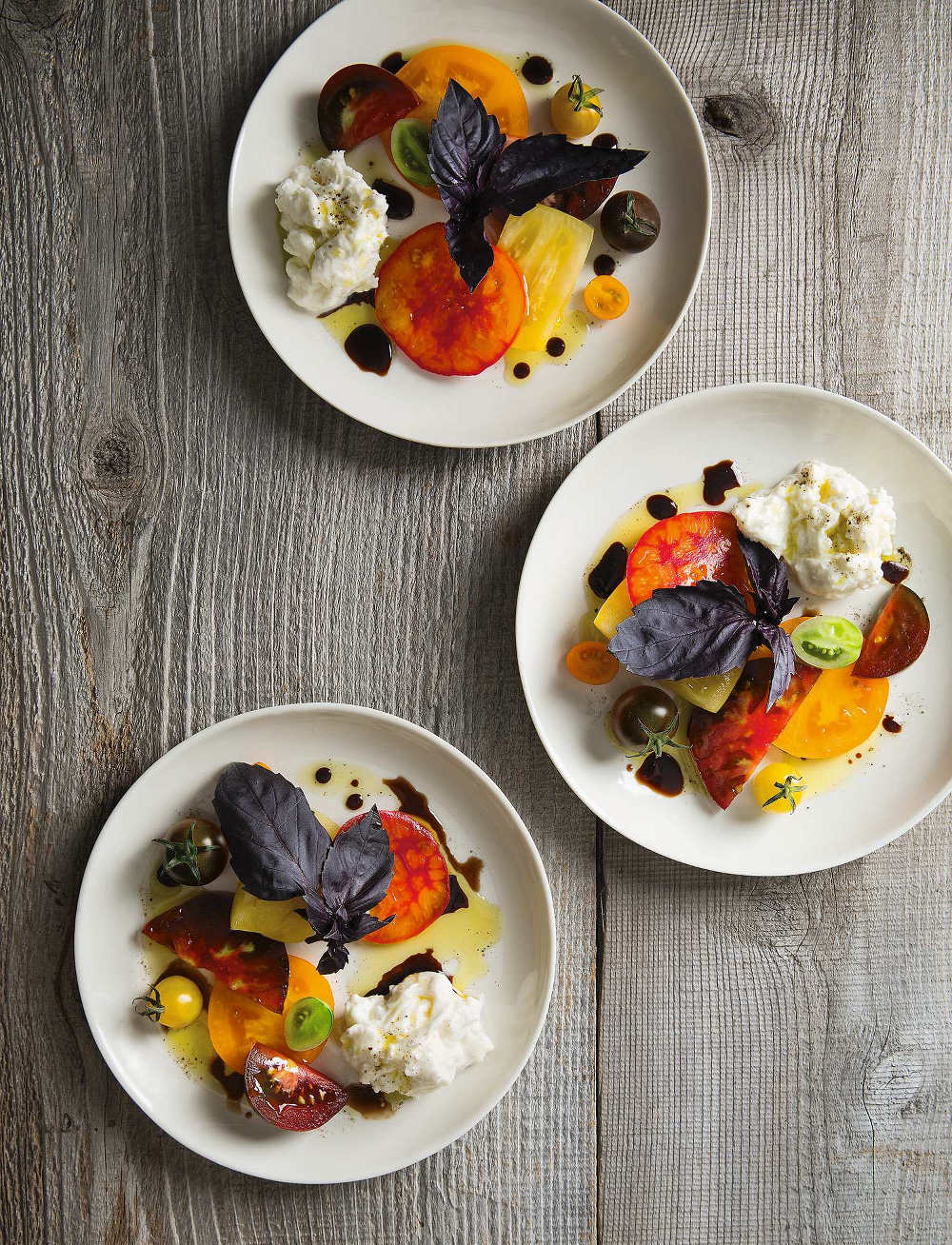
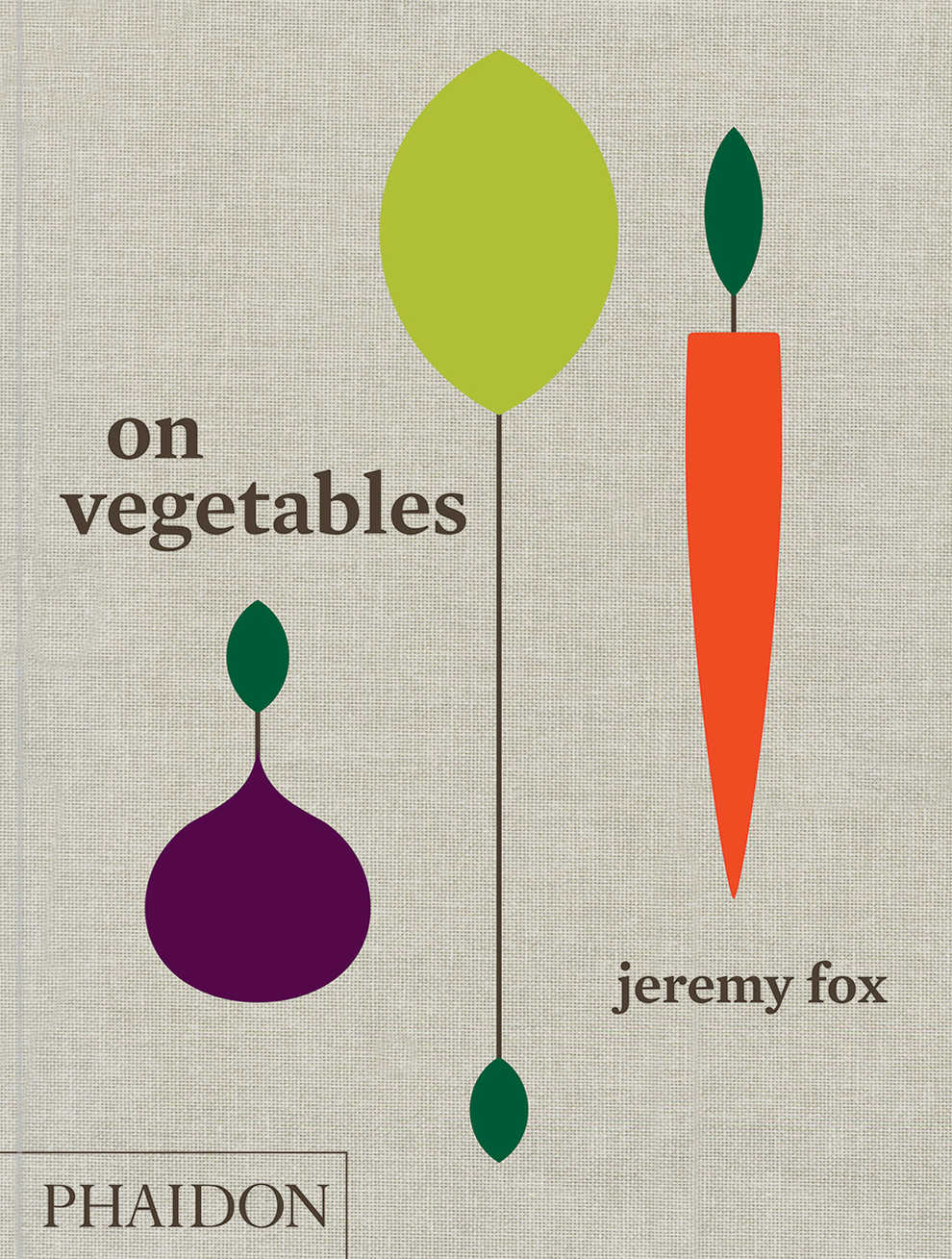
Although vegetables have only come into the culinary spotlight relatively recently, it’s hard to recall a time when they were inevitably relegated to the supporting cast, as ‘sides’ and many of our most creative chefs now make no bones about giving them the starring roles.
The ultimate compliment, by non-vegetarians, is to say that ‘you wouldn’t miss the meat’ and, while that may seem condescending to those whose philosophy embraces the sustainability of a vegecentric world, it rings true for mainstream diners.
In Ireland, the pioneer was, of course, Dennis Cotter of Cork’s Café Paradiso who, since 1993, has enchanted diners of all persuasions with his beautiful and wonderfully flavoursome modern vegetarian cooking, much of it based on the produce from nearby Gort na Nain Farm.
And anyone familiar with Dennis Cotter’s philosophy will also have some understanding of the culinary mindset of the esteemed Californian chef, Jeremy Fox of Rustic Canyon and Ester’s Wine Shop & Bar, whose much anticipated book On Vegetables: Modern Recipes for the Home Kitchen, written with Noah Galuten, has recently been published by Phaidon (£29.95). Jeremy Fox is not a vegetarian, however (‘I eat steak. I cook pigs’ trotters on a regular basis…’), but he believes that plants also deserve our full attention.
Described in the press release as “The perfect cookbook to inspire those with a passion for beautiful vegetable-based cuisine, looking to create quality recipes at home”, On Vegetables “gives us a glimpse into the mind of a one-of-a-kind chef, the simple pleasures of being in the kitchen and the enriching power of food” and, through its 160 recipes (including his signature dishes), showcases the extraordinary variety of textures and flavours that can be achieved by cooking with vegetables.
Central to the book is Fox’s early experience at his ‘Ubuntu’ restaurant in Napa Valley, which opened quietly in 2008 but almost immediately became a sensation due to an early New York Times review that led him on an extraordinary personal and professional roller coaster and eventually to its closure in 2012. This story - the fame, the fall, the struggle with anxiety and ADD, and the journey to recovery - is part of the book, and addresses the pressures faced by many top chefs. But through his love of food and cooking, Fox managed to ‘unite his food and his brain’ and began cooking for himself with vision, clarity and joy.
Regaining his passion in the kitchen led him to Rustic Canyon and later on to Ester’s Wine Shop & Bar to further refine his vegetable-driven cuisine. Jeremy and the restaurants are now thriving; having the energy to concentrate more on the kitchen, suppliers and his team, Jeremy recognises that ‘his food, rather than himself, is much better suited to being in the spotlight’.
With all this background to absorb, On Vegetables is not an easy book, but - although time consuming (and that is the point) the recipes are not especially difficult and it will be rewarding to those who enjoy giving the time to a job well done. It is reminiscent, in some ways, of Rory O’Connell’s Master It, with everything done from scratch and no short cuts allowed.
Organised alphabetically by vegetable, the recipes are specially designed to change the way you approach vegetarian cooking by placing them at the heart of every dish. Some ingredients may be unfamiliar to European readers but On Vegetables has the added interest of portraits and essays about the farmers with whom Fox works closely and the rich diversity of Californian produce.
Beautifully illustrated with 150 images of Fox’s strikingly crafted dishes and atmospherics, this would be a wonderful gift for the serious food lover - which may quite possibly be yourself.
RECIPES from: On Vegetables by Jeremy Fox published by Phaidon, photography by Rick Poon
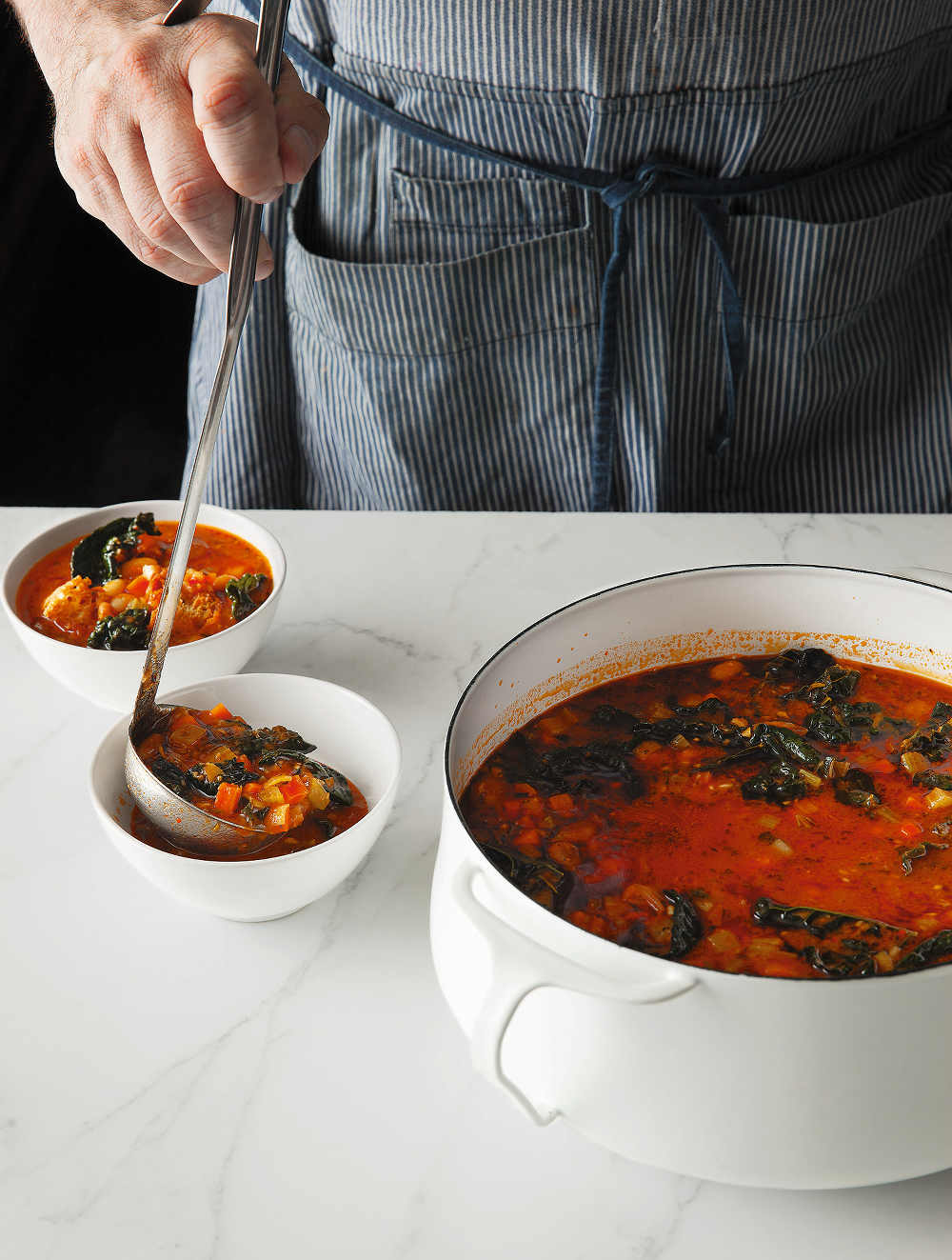
Rustic yellow eye bean stew, torn bread
During the tougher times at Manresa, before the restaurant gained critical esteem, we tried our version of a bar menu, called the “Patio Menu,” which focused on straightforward dishes, and this stew came out of that effort. I kept refining the stew over time, and I eventually found a specific bean that I really loved: Rancho Gordo Yellow Eye Bean.
The bean held its shape, but stayed creamy and didn’t burst or overcook. The stew became really popular at Ubuntu and eventually people would come in just to order it. Brothy and garlicky—one of the heartier things on the menu—it’s one of only a handful of dishes that I never get tired of making and eating.
Note: Give yourself a one-day lead time for this recipe, as you’ll need to soak the beans overnight. You can also start cooking the stew while the beans are cooking. If the beans aren’t ready in time, just turn the heat off on the stew and wait for the beans to catch up. After picking the rosemary leaves, keep the stems to use in conjunction with the mirepoix when cooking the beans.
Should you be unable to find yellow eye beans (Rancho Gordo being my favorite source), any dried bean you like will work just fine
serves 6 to 8
yellow eye beans
stripped rosemary stems
2 celery stalks
1 carrot, halved lengthwise
1 leek, halved lengthwise, tough green parts trimmed off
stems from 1 bunch flat-leaf parsley
1 head garlic, halved horizontally
1 pound (455g) dried yellow eye beans, soaked overnight
kosher salt
yellow eye bean stew
1 cup (240ml) extra-virgin olive oil, plus more as needed
8 ounces (225g) diced carrots
kosher salt
8 ounces (225g) diced celery
8 ounces (225g) diced leeks (white and light green parts only; save the tougher green tops for another use, such as vegetable stock)
1 bunch hearty greens like kale or collard greens, ribs removed and roughly chopped
1/2 cup (200g) chopped garlic (germ removed)
3/4 cup (60g) chopped fresh rosemary leaves
1 teaspoon chili flakes
1 cup (255g) tomato paste (purée)
to serve
about 1 pound (455 g) crusty bread, torn into bite-size pieces
extra-virgin olive oil
kosher salt
Make the yellow eye beans
Pick the leaves off the rosemary sprigs and set the leaves aside for the stew. Take the rosemary stems and, using kitchen twine, tie them into a bundle with the celery, carrot, and leek.
In a double layer of cheesecloth, combine the parsley stems and garlic halves and tie up to make a sachet. Place the beans, aromatics bundle, and sachet in a large pot and cover with 12 cups (2.8 liters) of water.
Bring to a simmer over medium heat, reduce the heat to low, and cook the beans just below a simmer, uncovered and skimming off any foam that rises to the top, until they have a creamy texture but are not falling apart. Depending on the freshness of the beans, this could take anywhere from 45 minutes to 21/2 hours.
Remove and discard the bundle and sachet and season the beans with salt until the broth tastes good by itself. Remove the pot from the heat and set the beans and cooking liquid aside until you’re ready to make the stew.
You could let the beans cool to room temperature and then refrigerate until you’re ready to make the stew.
Make the yellow eye bean stew
In a large pot, warm the olive oil over medium heat. Add the carrots first (they will take the longest), season with salt, and cook, stirring occasionally, for 5 minutes. Add the celery, leeks, and greens and season with salt. Allow them to cook down, stirring, for about 5 minutes.
Add the chopped garlic, rosemary, and chili flakes—you want the garlic to become fragrant but not browned. Add the tomato paste and stir thoroughly to combine. Cook for about 2 minutes, allowing the tomato paste to toast. At this point, all of the vegetables should be cooked through but still have a bite. Taste them to make sure, and if they have too much bite, let them go a little longer.
Add the cooked beans, along with their liquid, and bring the pot to a simmer. Taste and adjust the seasoning. Remove from the heat.
To serve
Toss the bread with a touch of olive oil and season with salt. Toast over medium heat in a large sautée pan until crispy on the edges, 3 to 5 minutes. Ladle the stew into bowls, and then follow with the toasted bread. Finish with a drizzle of olive oil.

Tomato Raw Bar
A tomato raw bar—which is a bit loose as far as recipes go and asks for a little creativity on your end—is a fun way to serve tomatoes while highlighting their delicious simplicity. Just as many varieties of oysters pique people’s curiosity, tomatoes deserve equal attention. Jeff Dawson, the head farmer at Ubuntu, used to grow over thirty different varietals of tomatoes for me, some of which—such as Copia, Sharon’s Surprise, and Foxheart (which he named after me)—he even bred himself.
serves 4
2 pounds (900 g) tomatoes, many varieties, cored
1 pound (455 g) burrata cheese
3 to 4 tablespoons extra-virgin olive oil
flaky sea salt
cracked black pepper
2 tablespoons saba
basil leaves, for garnish
Cut the tomatoes into various shapes and sizes—have fun with it. You can even take an apple corer and cut out some funky little tube shapes.
Divide the tomatoes across plates and place a generous dollop of burrata alongside. Drizzle with olive oil and season with flaky sea salt and cracked pepper. To finish, garnish with the saba and basil.
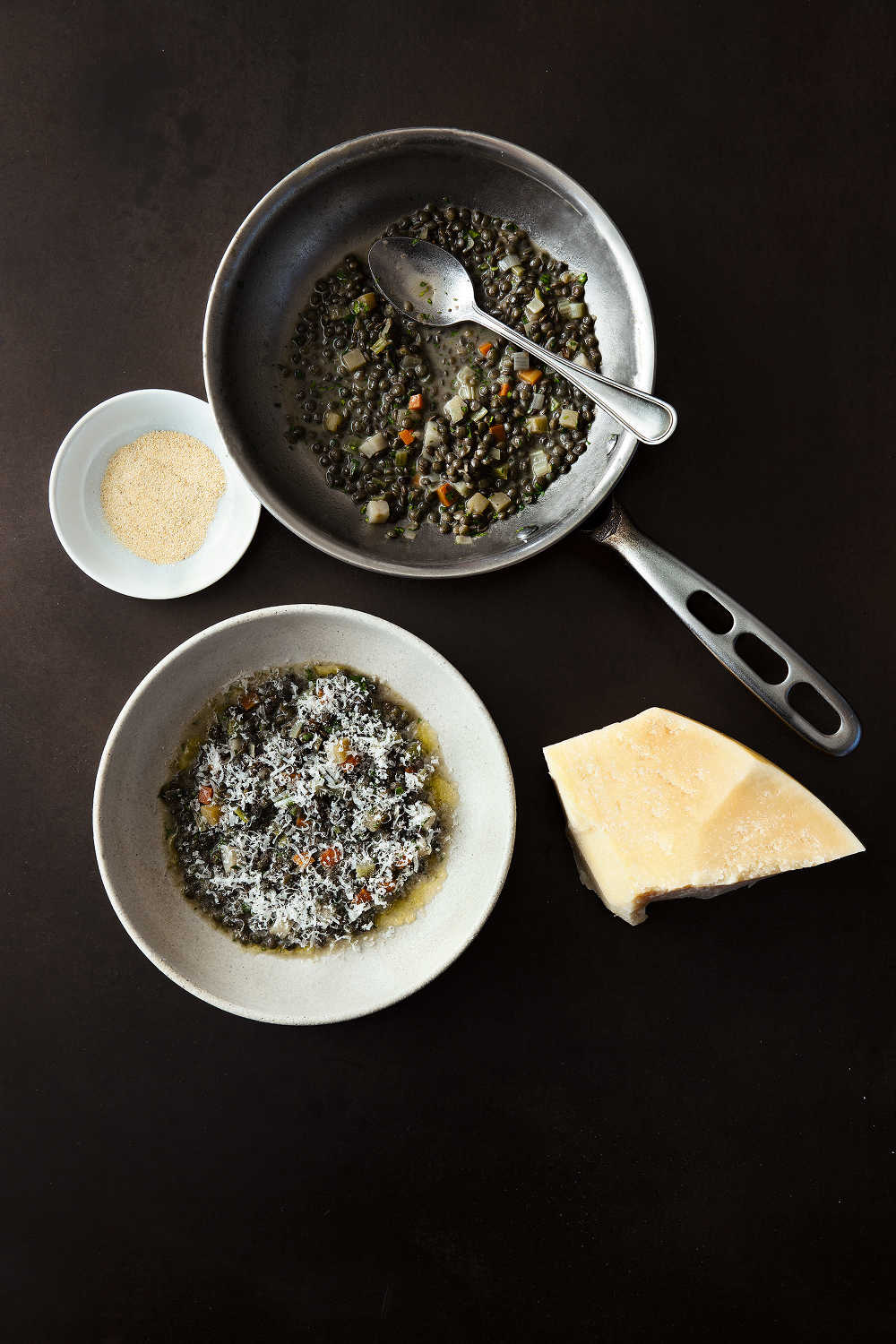
Lentils, garlic & parmesan
My mom didn’t cook a lot, but one thing she did “cook” was canned Progresso lentil soup with a ton of garlic powder and canned Kraft Parmesan cheese. Those things thickened it into a gloppy, grainy sort of mass, but I loved it anyway. I feel that a lot of what drives a chef is nostalgia, and a desire to re-create poignant food memories from their lives. As unsophisticated as this is, it’s a deeply ingrained food memory for me. Here is my grown-up version of the canned lentil soup of my childhood.
Note: The homemade garlic powder must be made in advance, as it takes about 2 days to dehydrate.
serves 4 to 6
1 pound (455 g) green or black lentils, rinsed and picked over
4 ounces (115 g) finely diced carrots
4 ounces (115 g) finely diced celery
4 ounces (115 g) finely diced leeks, white and light green parts only
4 ounces (115 g) finely diced celery root (celeriac)
4 ounces (115 g) finely diced rutabaga (swede)
kosher salt
2 tablespoons (30 g) unsalted butter
2 tablespoons chopped flat-leaf parsley
1 cup (60 g) grated parmigiano-reggiano cheese
1 to 2 tablespoons Garlic Powder, to taste
extra-virgin olive oil, for serving
In a large pot, combine the lentils and 6 cups (1.5 liters) water. Bring to a light simmer over medium-high heat and cook the lentils for 20 minutes, skimming off any foam that floats to the surface.
Add the carrots, celery, leeks, celery root, and rutabaga. Season with a little salt—just not too much, as it will continue to cook down.
Cook the soup, uncovered, until the lentils and vegetables are tender, 15 to 20 minutes. Taste and adjust seasoning as needed. Stir in the butter and parsley until incorporated.
To serve, ladle the soup into bowls. Sprinkle with freshly grated Parmiganio, garlic powder, and a few drops of olive oil.
garlic powder
Yes, you can easily buy this seasoning, but there is something about edible powder made in a giant industrial factory that makes me decidedly uncomfortable. Also: if you buy really good garlic, guess what? It makes really good garlic powder.
makes about 1/2 cup (72 g)
2 cups (200 g) sliced garlic cloves, germ intact
Arrange the garlic in a single layer on a dehydrator tray and dehydrate at 135°F (57°C) for 48 hours, until completely dry.
Grind in batches in your spice grinder until you have a fine powder.
Store in an airtight container at room temperature for up to 3 months.
Georgina Campbell's Cookery Feature - Neven Maguire's Perfect Irish Christmas
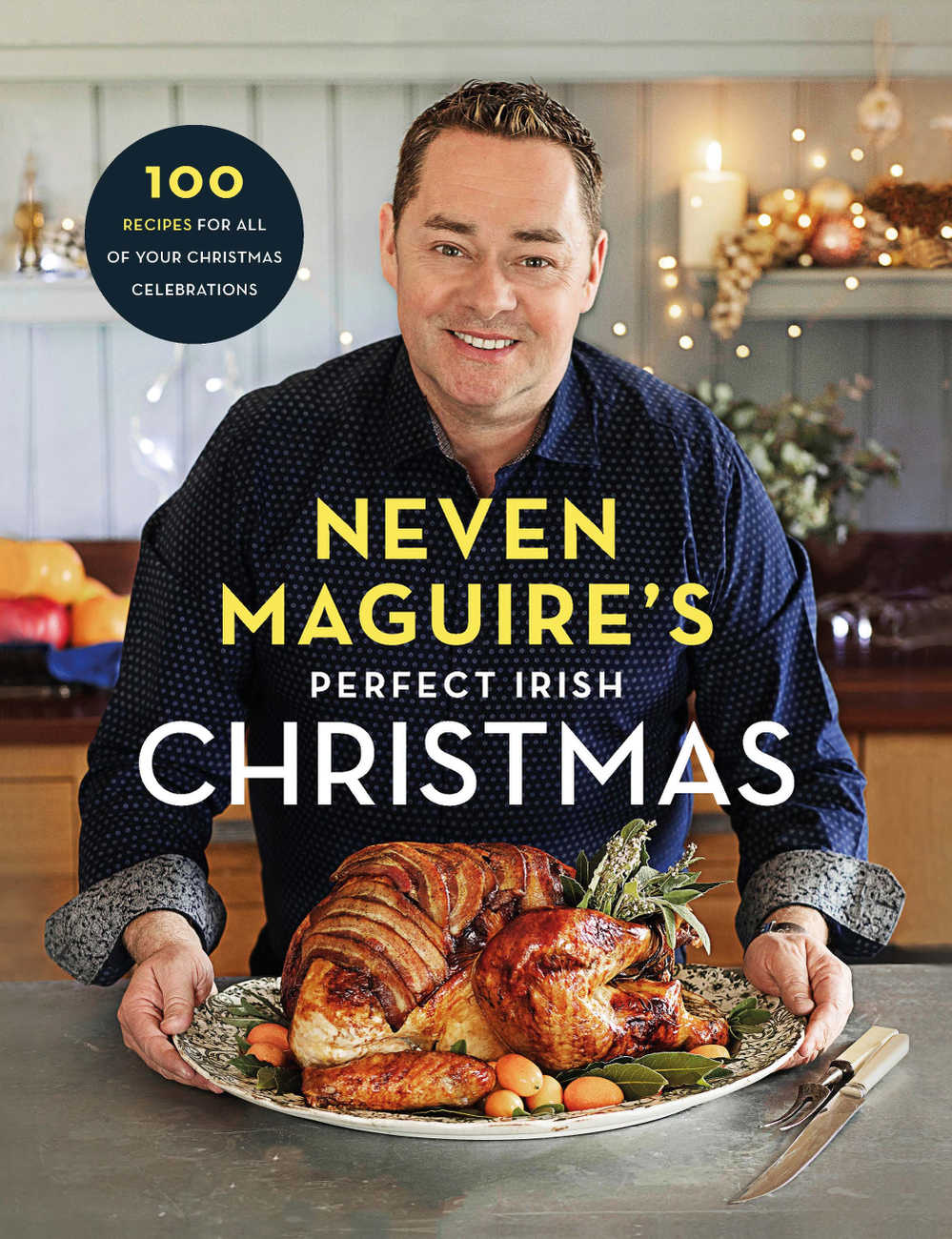
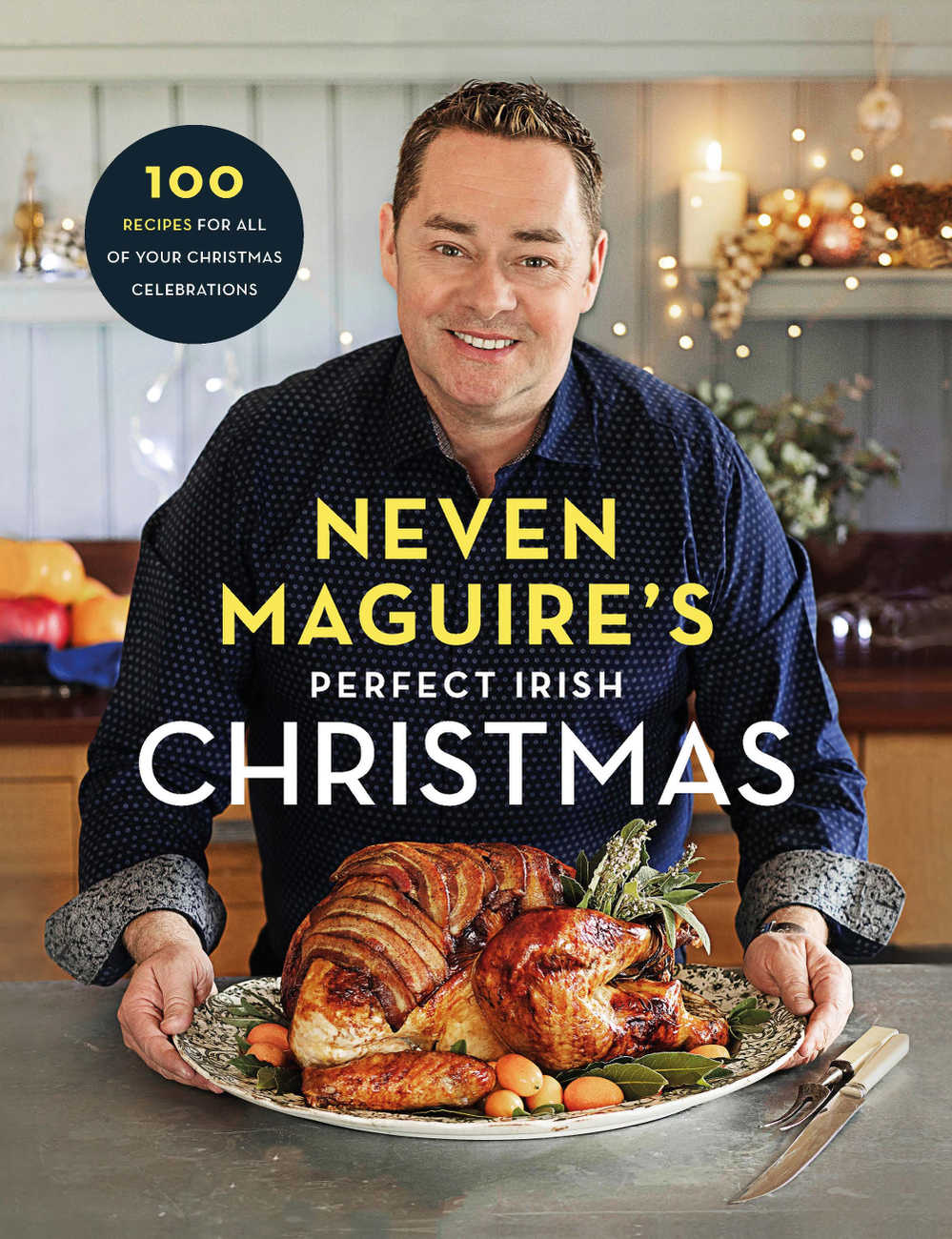
Neven Maguire’s Perfect Irish Christmas is published by Gill Books, price €22.99.
A new book from Neven always causes a stampede in the book shops and this one, in particular, is destined to be a classic. All the Christmas essentials are there, with everything for the ‘big dinner’ set out reassuringly clearly for confident reference - and plenty of options on the traditional dishes, including all the accompaniments, and alternatives for those who want to do something different.
The turkey causes the most worry - don’t panic, just follow Neven’s calm step-by-step guide below - but it isn’t actually the most challenging thing about cooking the traditional Christmas dinner for a crowd.
It’s all the sides and bits and pieces that can be most challenging, especially in a small kitchen, and Neven has plenty of ideas to make life easier. For example, although the perfect roast potatoes and other vegetables and side dishes are given in the book, there are also suggestions for alternatives that are easier to manage for large numbers.
I especially like the Celeriac & Sweet Potato Boulangère and the Braised Red Cabbage with Pomegranate recipes, given below, because they are forgiving dishes and take a lot of the last-minute stress out of cooking the vegetables.
The boulangère is an interesting dish - a good variation on the usual spuds, and a great deal easier on the cook than roast potatoes. Similarly, sprouts may be more traditional, but red cabbage is the one brassica vegetable that can be cooked ahead and it’s very festive with its pretty pomegranate garnish.
Most people like to have a proper starter on Christmas Day, but I’ve always felt that nibbles handed with drinks beforehand are much better, and party recipes like Neven’s Blinis with Smoked Salmon are perfect for that, or any other get together over the Christmas period - one of the best things about this book is that it covers the whole festive season - and with 100 recipes to choose from, there are plenty of delicious and very do-able dishes for every conceivable occasion. All round a great reference, and really reliable as ever.
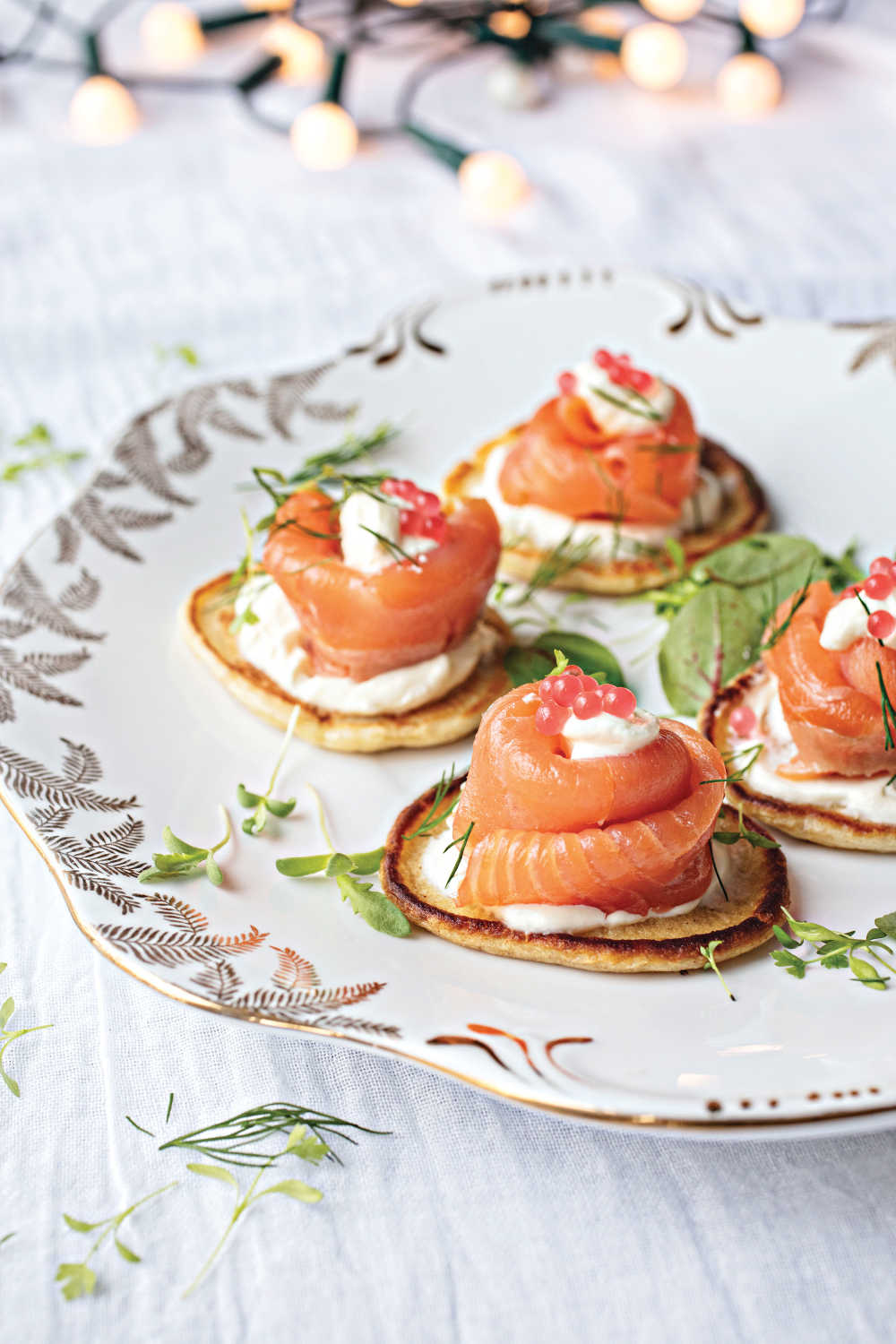
Blinis with Smoked Salmon
Blinis are originally from Russia and are perfect topped with sour cream, smoked salmon, dill and whatever caviar you can afford! Of course, if you don’t have time to make your own, most supermarkets stock a range of ready-made cocktail-sized blinis, particularly during the festive season.
Makes 30 – 40
225g (8oz) smoked salmon slices
200ml (7fl oz) sour cream
1–2 tbsp chopped fresh dill
fresh micro herbs, to garnish
salmon caviar, to serve (optional)
For the blinis:
175g (6oz) plain flour
50g (2oz) buckwheat flour
1 tsp fine sea salt
1 x 7g sachet of fast-action dried yeast
225ml (8fl oz) milk
200ml (7fl oz) crème fraîche
2 large eggs, separated
groundnut oil, for greasing
40g (1½oz) butter
1 First make the blinis. Sift the flours into a large bowl and add the salt and yeast. Heat the milk and crème fraîche to lukewarm in a medium pan. Whisk in the egg yolks, then add the flour mixture. Mix into a dough, then transfer to an oiled bowl and cover with cling film. Leave to rise for 1 hour in a warm place, until doubled in size.
2 When the dough has doubled in size, whisk the egg whites in a separate bowl, then fold them into the dough and leave to rise for another hour.
3 When you’re ready to cook the blinis, heat a large non-stick frying pan or flat griddle pan over a medium heat and smear with a little of the butter. Ladle tablespoons of the blini mix into the pan, then add another heaped teaspoonful to each one to make the middle thicker. Turn when firm and cook until lightly brown. Leave to cool on a wire rack.
4 Pile up the slices of smoked salmon into a stack (or you could shape into rosettes if you prefer). Using a very sharp knife, cut across the stack to make thin strips. Smear a little of the sour cream on each blini and arrange the smoked salmon on top. Add a tiny dollop of the sour cream to each one and garnish with the dill and micro herbs and a little caviar (if
using). Serve at once.
Roast Turkey with Streaky Bacon
This is the easiest way to roast a turkey, and fortunately, for many people it’s also the best. Forget about having the time to brine it or trying to turn it over while it cooks – this method is absolutely foolproof.
Serves 10 – 12
1 x 4.5–5.4kg (10–12lb) oven-ready turkey (preferably free-range), at room temperature
1 quantity stuffing (optional)
100g (4oz) butter, softened
15–18 rindless streaky bacon rashers
sea salt and freshly ground black pepper
small bunch of fresh herbs (to include parsley, sage and bay leaves), to garnish
1 Preheat the oven to 190°C (375°F/gas mark 5).
2 Turn the turkey breast side up and pack the neck cavity loosely with stuffing (if using), then tie the top of the drumsticks together with string. Smear with most of the butter and season generously, then place the bacon over the breasts to cover them completely. Weigh the turkey to calculate the required cooking time, allowing 20 minutes per 450g (1lb) plus 20 minutes extra.
3 Lay a large sheet of foil lengthways over a large roasting tin, leaving enough at each end to wrap over the turkey, then lightly butter the foil. Repeat with another sheet of foil, but this time laying it across the tin. Place the stuffed turkey in the centre of the foil, breast side up, then wrap loosely to enclose but still allowing air to circulate around the turkey.
4 Put in the oven and cook according to your calculated cooking time, carefully unwrapping and basting the turkey every 40 minutes. For the final hour, fold back and remove the foil, keeping the ends of the drumsticks still covered in foil to prevent them from burning. Baste well and return to the oven. The turkey should be a rich, dark brown colour. To make sure it’s cooked, insert a fine skewer into the thickest part of the thigh – the juices should run clear, but if they are still pink, return the turkey to the oven and check again every 15 minutes, until you are happy that the turkey is cooked right through. Remove from the oven and transfer to a serving platter. Cover with foil and leave to rest in a warm place for 10 minutes (up to 30 minutes is fine).
5 To serve, garnish the turkey with the bunch of herbs in the neck cavity and bring to the table. Carve into slices and arrange on warmed plates with all the trimmings.
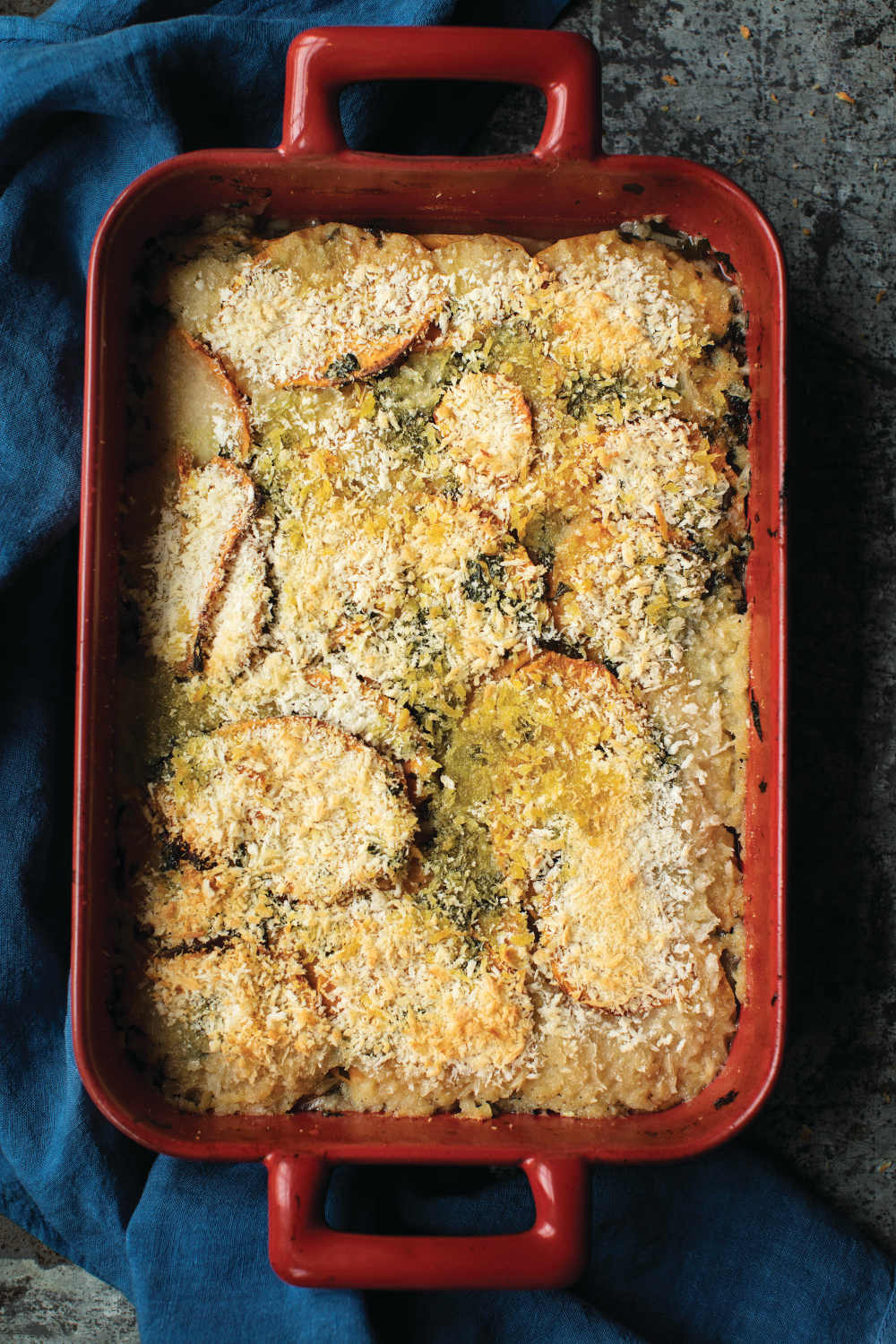
Celeriac & Sweet Potato Boulangère
This hassle-free dish is perfect for the Christmas table. The layered up celeriac, sweet potatoes and onions absorb all the stock. It can be made in advance and left to cool completely before covering with cling film and storing in the fridge for up to three days before you want to use it. Reheat covered with tin foil in a preheated oven set to 180°C (350°F/gas mark 4) for 30 minutes, until piping hot.
Serves 8 – 10
2 tbsp rapeseed oil, plus extra for greasing
3 onions, thinly sliced (on a mandolin is best)
3 garlic cloves, thinly sliced
2 tbsp roughly chopped fresh flatleaf parsley
1 tbsp chopped fresh mixed herbs (use a mixture of sage, rosemary
and thyme)
1kg (2¼lb) sweet potatoes, peeled and thinly sliced (on a mandolin is
best)
1 large celeriac, peeled and thinly sliced (on a mandolin is best)
900ml (1½ pints) chicken or vegetable stock
50g (2oz) butter, diced
25g (1oz) stale white breadcrumbs (sourdough is best)
sea salt and freshly ground black pepper
1 Preheat the oven to 200°C (400°F/gas mark 6).
2 Heat the oil in a frying pan set over a medium heat, then sauté the onions, garlic and herbs for 10 minutes, until soft and lightly golden. Season to taste.
3 Layer the sweet potatoes in a large baking dish with the onions and celeriac. Season each layer as you go and finish with an attractive overlapping layer of the sweet potatoes. Pour over the stock and top with knobs of butter.
4 Rub some foil with oil and place it over the dish, oil side down, and seal tightly. Bake in the oven for 45 minutes, then remove the foil and press the potatoes down with a fish slice. Scatter over the breadcrumbs and bake for another 15–20 minutes, until golden. Serve at once or leave to cool completely before covering and storing in the fridge until needed
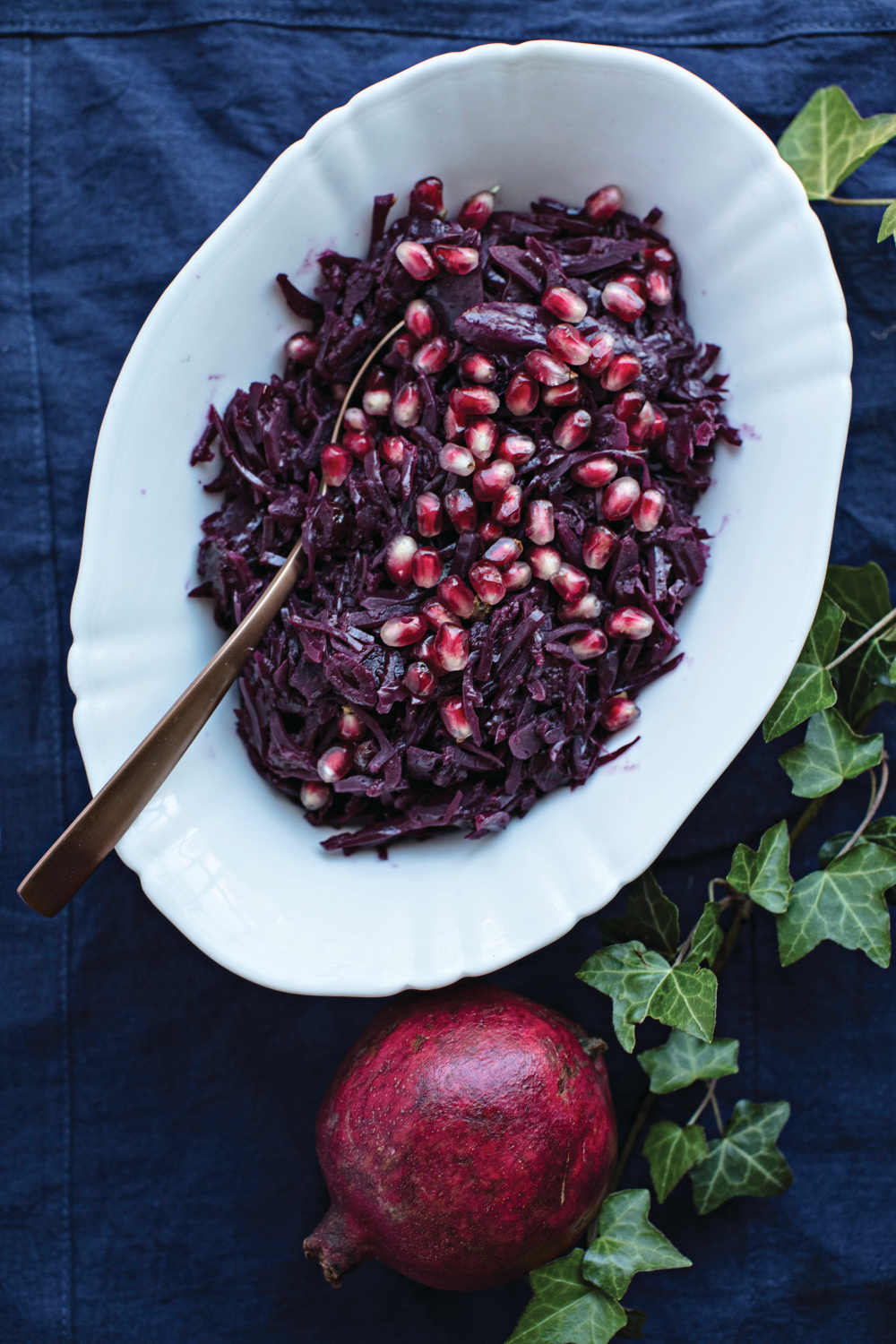
Braised Red Cabbage with Pomegranate
This is an ideal vegetable to prepare in advance and is excellent with turkey, ham or goose. It will keep for up to a week in the fridge covered with cling film in a non-metallic bowl. It also freezes very well – simply pop into medium-sized freezer bags and leave to thaw out before reheating gently, either on the hob or in a casserole dish with a lid in the oven.
Serves 8 – 10
4 tbsp duck or goose fat (from a jar or left over from a roast) or 2 tbsp
rapeseed oil
1 red cabbage, trimmed, cored and finely shredded
2 red onions, thinly sliced
1 large Bramley cooking apple, peeled, cored and grated
100g (4oz) dried cranberries
300ml (½ pint) red wine
300ml (½ pint) pomegranate juice
6 tbsp redcurrant jelly
4 tbsp red wine vinegar
1 tsp mixed spice
½ tsp ground cinnamon
½ tsp ground ginger
good pinch of ground cloves
sea salt and freshly ground black pepper
pomegranate seeds, to garnish (optional)
1 Melt the duck or goose fat in a very large heavy-based pan set over a medium heat, then tip in the red cabbage and onions. Sauté over a medium-high heat for about 5 minutes, until just beginning to soften.
2 Stir in the apple and cranberries, then add the red wine, pomegranate juice, redcurrant jelly, red wine vinegar and spices. Season to taste. Bring to the boil, stirring occasionally, then reduce the heat and simmer for about 1 hour, stirring every 20 minutes, until the cabbage is meltingly tender.
Transfer to a warmed dish and garnish with pomegranateseeds (if using) to serve.

Vera’s Sherry Trifle
This is one dessert that I can clearly remember from my childhood – it probably even enticed me to be a chef. My mum always made this for special occasions and I just loved helping, especially with the cleaning of the bowls… Now I like to decorate the top with pomegranate seeds to make it sparkle like jewels.
Serves 6
200g (7oz) Madeira cake, broken into pieces
300ml (½ pint) cream
toasted flaked almonds, to decorate
pomegranate seeds, to decorate
spun sugar, to decorate (optional)
For the custard:
300ml (½ pint) milk
100ml (3½fl oz) cream
½ vanilla pod, split in half lengthways and seeds scraped out
5 egg yolks
4 tbsp caster sugar
2 tsp cornflour
For the fruit:
100ml (3½fl oz) sweet sherry
100g (4oz) caster sugar
½ vanilla pod, split in half
lengthways and seeds scraped out
1 x 500g (18oz) bag of frozen fruits of the forest
1 To make the custard, put the milk, cream and vanilla pod and seeds in a heavy-based pan set over a gentle heat and cook until it nearly reaches the boil – but don’t allow to boil.
Meanwhile, put the egg yolks, sugar and cornflour in a large bowl and whisk together until pale and thickened.
2 Remove the hot milk and cream mixture from the heat and slowly whisk it into the egg mixture through a fine sieve until smooth. Discard the vanilla pod and pour back into the pan, then set over a gentle heat. Cook, without allowing it to boil, until the custard coats the back of a wooden spoon, stirring continuously. Remove from the heat and leave to cool, covered with a piece of cling film pressed directly on the surface of the custard to prevent a skin from forming on top.
3 Meanwhile, prepare the fruit. Put the sherry in a large pan with the sugar and vanilla seeds and bring to the boil. Reduce the heat and simmer for 4–5 minutes, until syrupy, stirring occasionally. Stir in the frozen fruits of the forest and set aside until cooled, stirring occasionally. The fruits should defrost naturally in the hot syrup but still hold their shape.
4 Scatter the Madeira cake over the base of a 1.5 litre (2½ pint) glass serving bowl. Spoon over the fruit and cover with the cooled custard. Chill for 1 hour, until the custard sets a little firmer, or up to 24 hours is fine.
5 When ready to serve, whip the cream in a bowl until you have achieved soft peaks. Put spoonfuls on top of the custard, then gently spread with a palette knife or the back of a spoon to cover the custard completely (or you can use a piping bag). Sprinkle over the toasted flaked almonds and pomegranate seeds and decorate with some spun sugar if liked, then place straight on the table to serve.
Georgina Campbell's Cookery Feature - Starring Role for Cheese
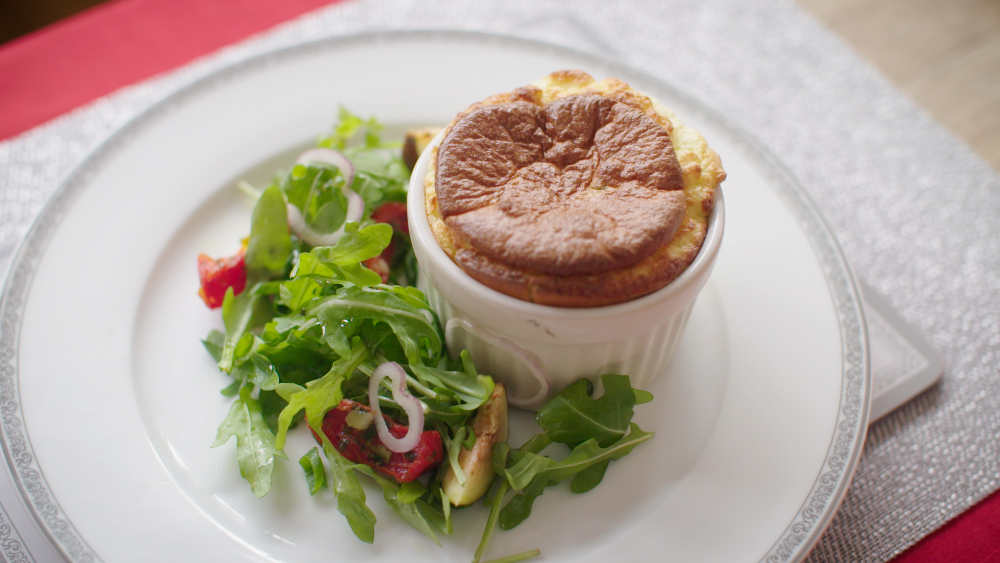
These tasty recipes were created for the National Dairy Council by Vanessa Greenwood of Cooks Academy Cookery School, Dublin, with the aim of celebrating the best of Irish and European cheese at Christmas.
But cheese is a brilliant (and convenient) ingredient at any time and what makes these recipes especially appealing is that they are such a refreshing contrast to the traditional Christmas fare - and they’re just great versatile dishes for any time, perhaps especially in winter.
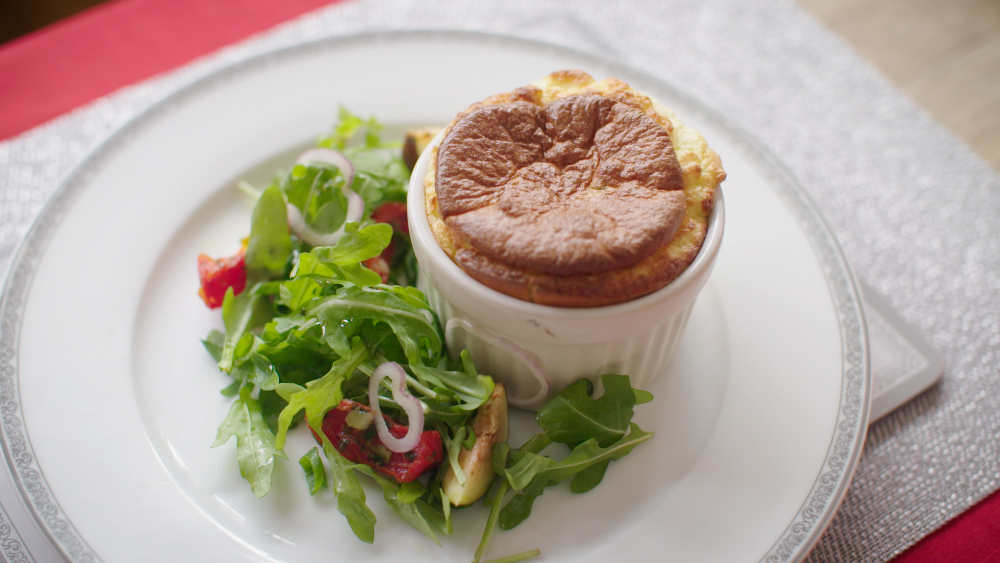
Cheddar Cheese and Courgette Soufflés
Soufflés are much easier to make than their reputation suggests - but you do need to have your diners in situ when they’re ready, as they will sink if kept hanging around. This makes a tasty hot starter for six or a light lunch or supper dish for four - and, as courgettes are out of season, squash might be a better alternative in winter.
Serves 4-6
Ingredients
1 large courgette (or equivalent squash flesh)
50g butter (divided into 25g and 25g)
25g plain flour
250ml milk
100g mature cheddar Cheese, grated
pinch cayenne pepper
4 medium eggs, separated into yolks and whites
salt and white pepper
Method
1. Preheat oven to 200°C fan oven. Grease 4 large ramekins (or 6 medium size ones) with melted butter and lightly dust insides with a little flour.
2. In a medium heavy based saucepan, melt 25g butter (add a dash of oil if necessary) and sauté the grated courgettes, season and when nicely coloured, remove from the pan. Set aside and wipe out the pan.
3. Melt the remaining 25g butter in a saucepan and stir in the flour to make a roux, cook for 1 minute. Slowly add the milk, continually stirring to avoid any lumps forming and once all the milk has been added, allow the sauce to come to a simmer (stir vigorously so it doesn't catch on the bottom of the saucepan) until it coats the back of a spoon. Mix in the grated cheddar and cayenne. Taste and season, then slowly stir in the egg yolks and courgettes.
4. Lastly, in a spotlessly clean bowl, whisk the egg whites with a pinch of salt to stiff peaks. First stir a large spoonful of egg white into the sauce mixture to loosen it, before gently folding in the rest of the egg white mixture (without knocking out too much air).
5. Fill the ramekins to just below the rim (note: once the soufflés are in the ramekins, they can be made a few hours in advance and chilled until ready to bake).
6. Bake in the centre of the preheated oven at 200°C for 15 minutes. Serve immediately.
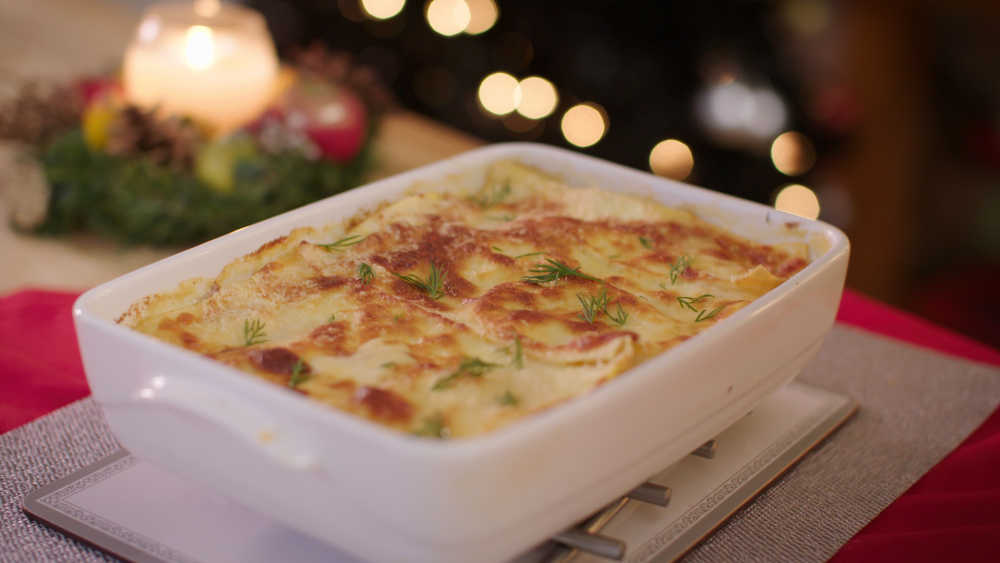
Luxury Seafood Lasagne
A good homely seafood dish, such as a fish pie or seafood lasagne, is always a great standby - a good call for a crowd at any time of year, it’s especially welcome in winter as an antidote to the amount of meat and poultry that the festive season usually entails. Don’t be put off by the long ingredients list as the cooking and assembly is quite straightforward - but it is worth making a decent quantity while you’re at it. Fresh Irish prawns could be used to replace the imported prawns, or you could make up the weight using other fresh local fish.
Serves 6
Ingredients
1 tbsp olive oil
2 banana shallots, peeled and diced small
1 stick celery, diced
1 garlic, crushed
1 bay leaf
4 large mushrooms, peeled, sliced
100ml white wine
50g butter
50g plain flour
500ml fish stock
½ tsp paprika
1 tsp worcestershire sauce
5 drops tabasco sauce
½ lemon zest and juice
200ml cream (divided into 100ml + 100ml)
1 roasted red pepper (from a jar, drained, sliced)
15g fresh dill, leaves
2 tbsp capers
250g mixed fish (hake, smoked haddock), skinned and cut into chunks
300g raw, peeled and deveined tiger prawns
8-9 sheets fresh lasagne (alternatively, use par-cooked dried lasagne sheets)
100g grated mozzarella
30g parmesan cheese, grated
salt and white pepper, to season
1. Heat olive oil in a wide heavy based pan and sweat the shallots, celery, garlic, bay leaf and mushrooms. Add wine, simmer to reduce by half. Add 50g butter, then stir in the flour for 1 min.
2. Gradually stir in the fish stock to make a smooth thickened sauce, then pour in the cream. Season with salt, pepper, lemon juice and zest to your taste. Discard the bay leaf.
3. Just before cooking, bring the sauce to a simmer and add the fish for 2 minutes to par cook.
4. Grease a lasagne dish with butter, then place a layer of fresh lasagne sheets on the base. Spoon half of the fish mixture on top, then scatter over grated mozzarella. Cover with a sheet of lasagne, then repeat with a second layer of fish mixture and mozzarella cheese.
5. Cover with the final layer of lasagne and top with the remaining cream and parmesan cheese.
6. Transfer the lasagne to an oven preheated to 190°C fan and cook for 30 minutes until bubbling and the top is crisp and golden.

Caramelised Shallot Tatin with Blue Cheese
This savoury take on the famous dessert is fun as a starter or light meal, and it’s easy enough to make if you’re using frozen puff pastry - look out for an ‘all-butter’ product.
Serves 4 as a starter
Ingredients
1 tbsp olive oil
100g black pudding, cubed
50g butter (and extra olive oil if needed)
150g banana shallots
2 sprig thyme
30ml sherry vinegar
30ml port (or red wine)
1 tbsp demerara brown sugar
1 apple
25cm circular sheet puff pastry
1 egg, beaten, to glaze
75g fresh rocket leaves drizzled with olive oil
120g blue cheese, cubed
3-4 semi sundried tomatoes (optional garnish)
salt and freshly cracked black pepper
Method:
1. In a medium ovenproof frying pan, fry the black pudding in oil for 5 minutes to crisp it, then remove from the pan and set aside.
2. Peel and halve the shallots lengthways (reserve 1 shallot for garnishing). Wipe out the pan, heat the butter (and a little extra oil if necessary) and without stirring brown the shallots for 5 min on both sides, season. Add thyme, port, vinegar and sugar and boil for approx 3-5 minutes to reduce the liquid and slightly caramelise (without burning), then remove the pan from the heat, allow the pan to cool before adding the pastry.
3. To assemble for baking: Preheat oven to 220°C. Peel, core and cube the apple and scatter it and the black pudding over the onion base, remove the thyme stalks. Cover with the puff pastry lid and tuck it down into the sides. Brush with beaten egg.
4. Transfer the pan to the oven and bake at 220°C for 25-30 minutes or until the pastry is risen and golden in colour.
5. To avoid a burn from any pan juices, use caution when you upturn the tatin. Hold a plate upside down over the frying pan and in one swift motion, upturn the tart onto the plate. Serve warm with lightly dressed rocket leaves, sliced shallot, blue cheese (and semi sundried tomato if using).
Georgina Campbell's Cookery Feature - Beef Up Your Kitchen Bookshelf
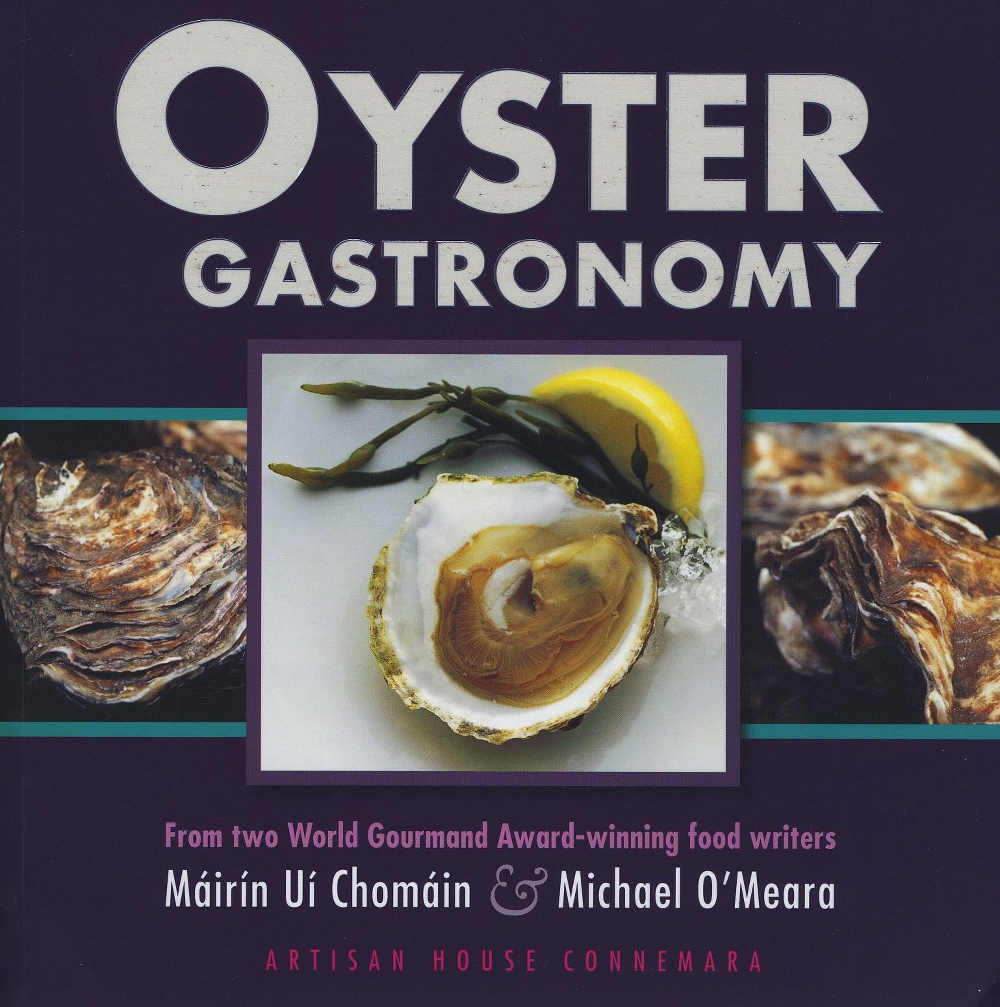

There’s always a rush to the bookshops coming up to Christmas, but this is a calmer time to add to our collections - especially if we’re lucky enough to have book vouchers to use. You can never have too many good books about food, and - like the ones that this month’s recipes come from - the best ones can inspire us to travel and get the full experience too.
The Connemara publishers Artisan House, for example, came up with a brilliant idea as their Oyster Gastronomy (paperback, €15) combines the talents of two of their best known authors, Mairin Ui Chomain (author of a number of titles, including the original Irish Oyster Cuisine, published by A&A Farmar), and Michael O’Meara (Sea Gastronomy: Fish & Shellfish of the North Atlantic).
Between them they have produced a lovely collection of accessible recipes ranging from homely dishes that would make great pub grub such as Oyster Casserole or Oyster and Stout Beef Pie (see below) to sophisticated Seaweed Steamed Oysters with Japanese-style Dressing or Roasted Oysters with Zingy and Sweet Quince Jelly.
And the photography is shared between two masters too - Michael O’Meara himself, who is well known for his excellent seafood photography, and the late Walter Pfeiffer, long renowned as one of Ireland’s top food photographers, who contributed to Mairin’s original Irish Oyster Cuisine.
Then there are the background pieces - the informative Introduction by BIM’s Richard Donnelly, the profiles of some of Ireland’s best known producers of both native and gigas (Pacific) oysters, the sauces and accompaniments - and Betty Murphy’s beverage notes too.
Running to just 128 pages, this is not a major tome - but it is surprisingly comprehensive and makes an interesting read as well as an inspiring reference that will make you want see this fascinating food in its natural, and very beautiful, environment.
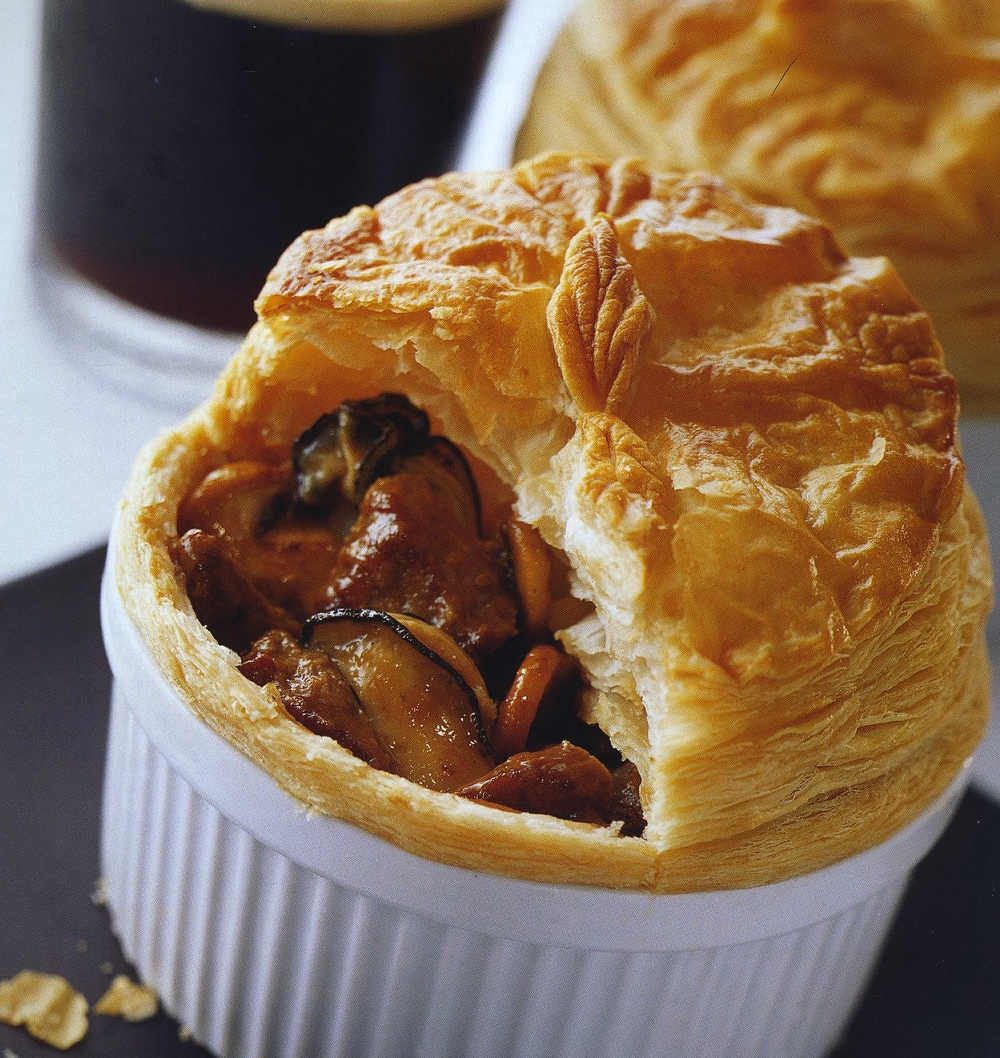
Recipe: Oyster and Stout beef pie
Serves 4
12 oysters, shells removed, juices strained and reserved
2 tablespoons plain flour
salt
black pepper, freshly ground
675g rib beef, cubed
2 tablespoons sunflower oil
1-2 onions, finely chopped
225 g mushrooms, chopped 450 ml stout
1 tablespoon Worcestershire sauce
210g ready-made puff pastry
Method
Season the flour with salt and pepper. Toss the beef in the flour. Heat the oil in a large, heavy frying pan. Once the oil is hot, add the beef to the pan a little at a time and seal. (Be careful not to overcrowd the pan as this will only create a stewing process.)
Remove the beef from the pan. Fry the onions and mushrooms until soft and then return the meat to the pan.
Add the stout, Worcestershire sauce and oyster juices and season with salt and pepper. Mix well, cover and simmer until the meat is tender (about 1½ hours).
Remove from the heat and allow to cool completely. Add the oysters.
Preheat the oven to 200 °C / 400 °F / gas mark 6.
Grease a deep pie dish. Pour the mixture into the pie dish.
Cover with the pastry, leaving a slight overhang around the edge of the dish. Crimp the edges firmly and cut an air vent in the centre of the pastry.
Bake in the centre of the oven for 15 minutes.
Reduce the heat to 180 °C / 350 °F / gas mark 4 and bake for a further 30 minutes until the meat is heated through. Serve while hot.
xxxxxxxxxx
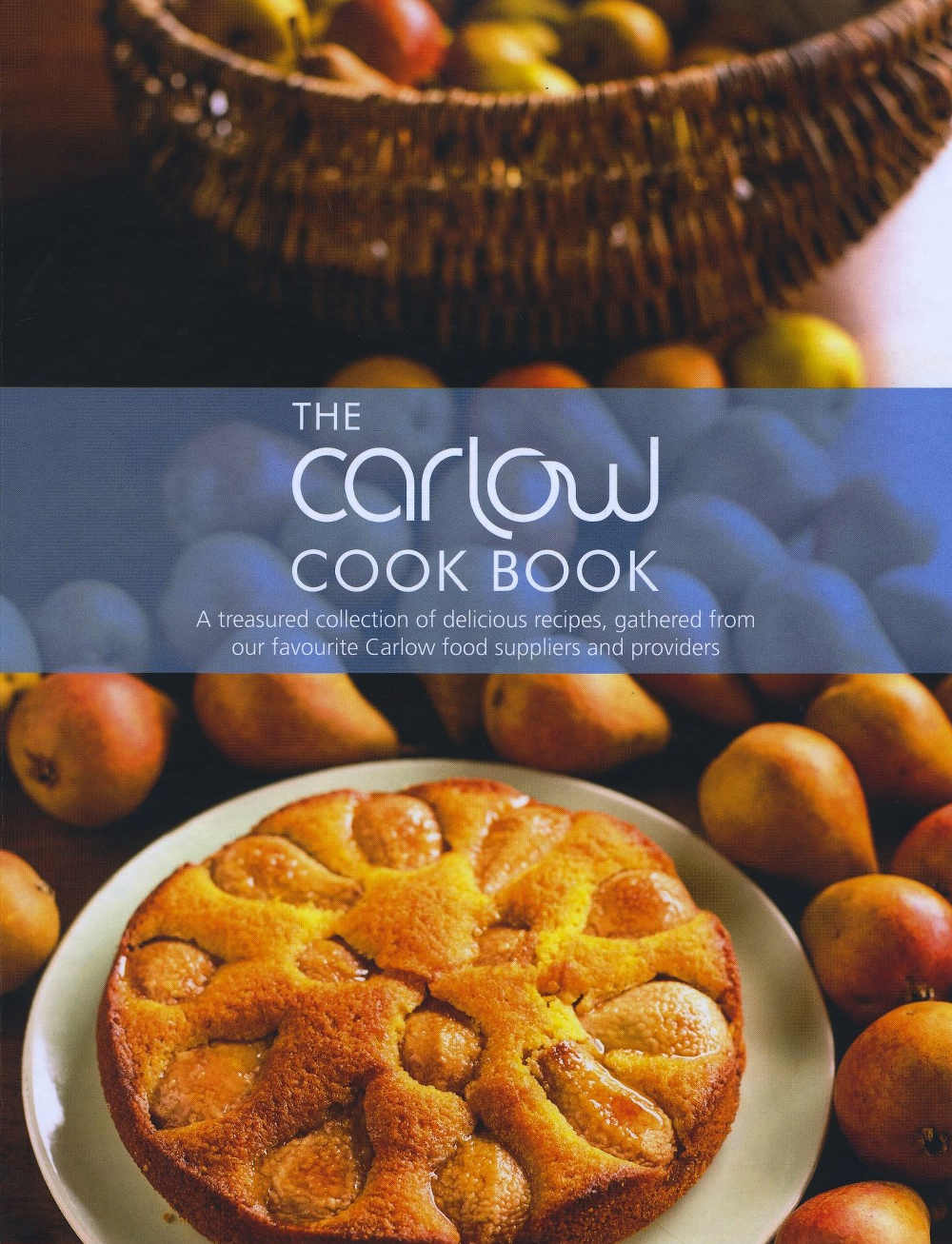
From a book inspired by and produced in the West of Ireland on the Wild Atlantic Way, to one celebrating the heart of Ireland’s Ancient East: The Carlow Cook Book (hardback, €12.50) is published by Carlow Tourism with the support of a number of agencies including Carlow County Council, and edited by Irish Food Writers’ Guild member, Anne Marie Carroll, who - along with James Fennell of Burtown House (renowned for his ‘Vanishing Ireland’ series, with author Turtle Bunbury), Joe Keogh Photography and Rory Moore Photography - also contributed to the imagery.
Bringing together the excellent and very diverse food and drink producers and suppliers of this lovely fertile county and the wide ranging restaurants, cafés, pubs and hotels that transform them into delicious dishes, this is a book with real heart.
And, while the recipes are supplied by a large number of contributors - using products ranging from organic eggs, jams and cheddar cheese to snails, chocolate and craft beer, gin and whiskey - every one has been tested by Anne Marie.
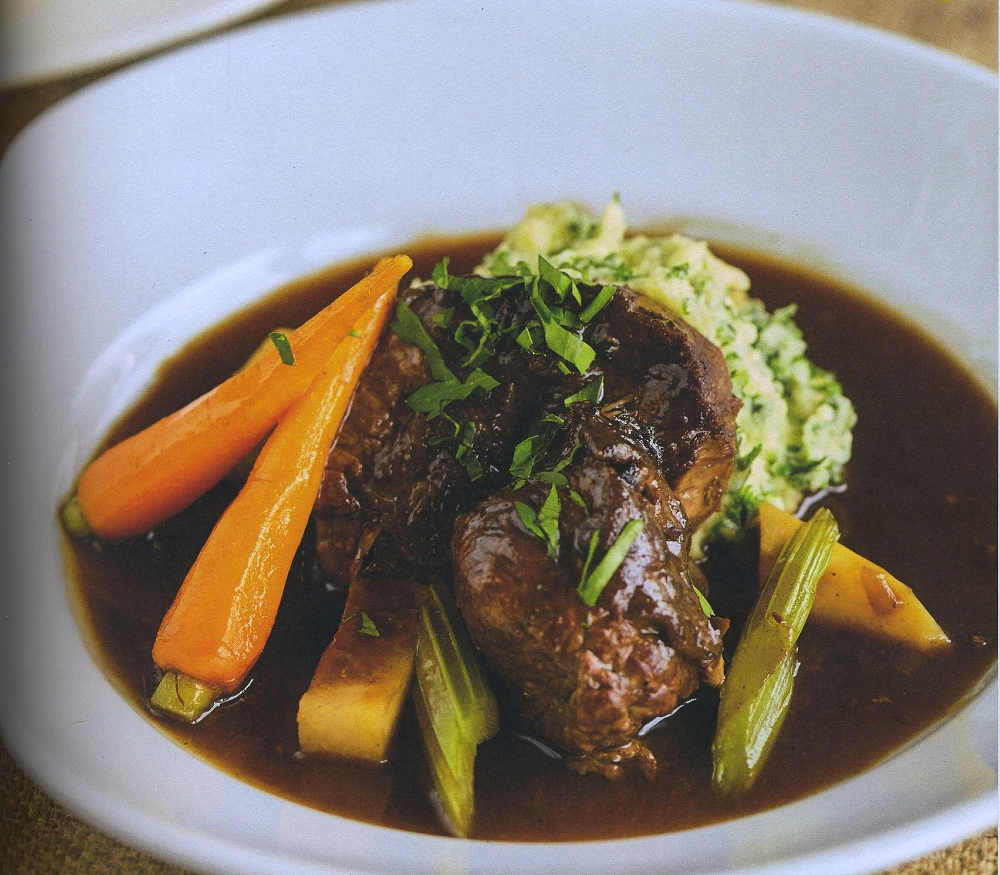
Recipe: Braised Beef Cheek & O’Hara’s Stout Casserole
This recipe comes from Lennons @VISUAL, the stylishly casual café-restaurant at the wonderful contemporary gallery, exhibition space and venue that is the cultural heart of Carlow Town.
Run by Ross Byrne since VISUAL opened, the restaurant is on the lower ground floor - overlooking the cathedral and with plenty of outdoor dining space for warm weather, it’s a great place to enjoy seasonal food (and drink) that is deeply rooted in the area.
4 beef cheeks, trimmed (ask your butcher nicely and he will do this for you)
Sea salt
Freshly ground black pepper
2 tbsp The Soul of Crete olive oil
50g plain flour
1 medium onion, peeled and finely chopped
500ml (a full bottle) O'Hara's stout
500ml beef stock
2 bay leaves
4 sprigs thyme
4 sticks celery, chopped into finger length pieces
3 carrots, peeled and cut into thirds
2 turnip, chopped into large chunks
Flat leaf parsley, chopped
to prep
Begin by preparing the beef. A day before you intend to serve, season the beef cheeks with salt and pepper, cover tightly and refrigerate for 24 hours. This step is not essential if you are pushed for time, but it ensures an even seasoning throughout the meat.
to cook
Preheat the oven to 180°C (160°C fan).
Remove the beef cheeks from the fridge and heat the oil on high in a heavy frying pan.
Toss the beef cheeks in flour and when the oil is hot, lay them in the pan and sear on all sides.
Once seared transfer the cheeks to a casserole dish that has a tight fitting lid.
In the same frying pan, add the onion and fry over a moderate heat until caramelised. Pour in the O'Hara's stout and stir. Let the liquid reduce by about half and then pour into the casserole dish.
Add the beef stock, bay leaves and thyme and bring to the boil. Put the lid on the casserole dish and place in the oven for 2 hours.
After 2 hours add the carrots, celery and turnip and return to the oven for 1 additional hour. Stir occasionally during cooking, adding a little water if there is too much evaporation.
Cook until the vegetables are softened and glazed and the beef cheeks are very tender.
Top with the chopped parsley and serve immediately with colcannon made with scallions and curly kale.
Suppliers: Fruit and vegetables from Carlow Farmers' Market, Carlow Town; Clonmore Meats, Clonmore, Co. Carlow; Sheehan's Pork and Bacon, Bennekerry, Co. Carlow; Carlow Brewing Company, Bagenalstown, Co. Carlow; Walsh Whiskey Distillery, Royal Oak, Bagenalstown, Co. Carlow. Carlow Farmhouse Cheese, Fenagh, Co. Carlow. For a full list of all suppliers please visit http://carlowtourism.com/
xxxxxxxxxx
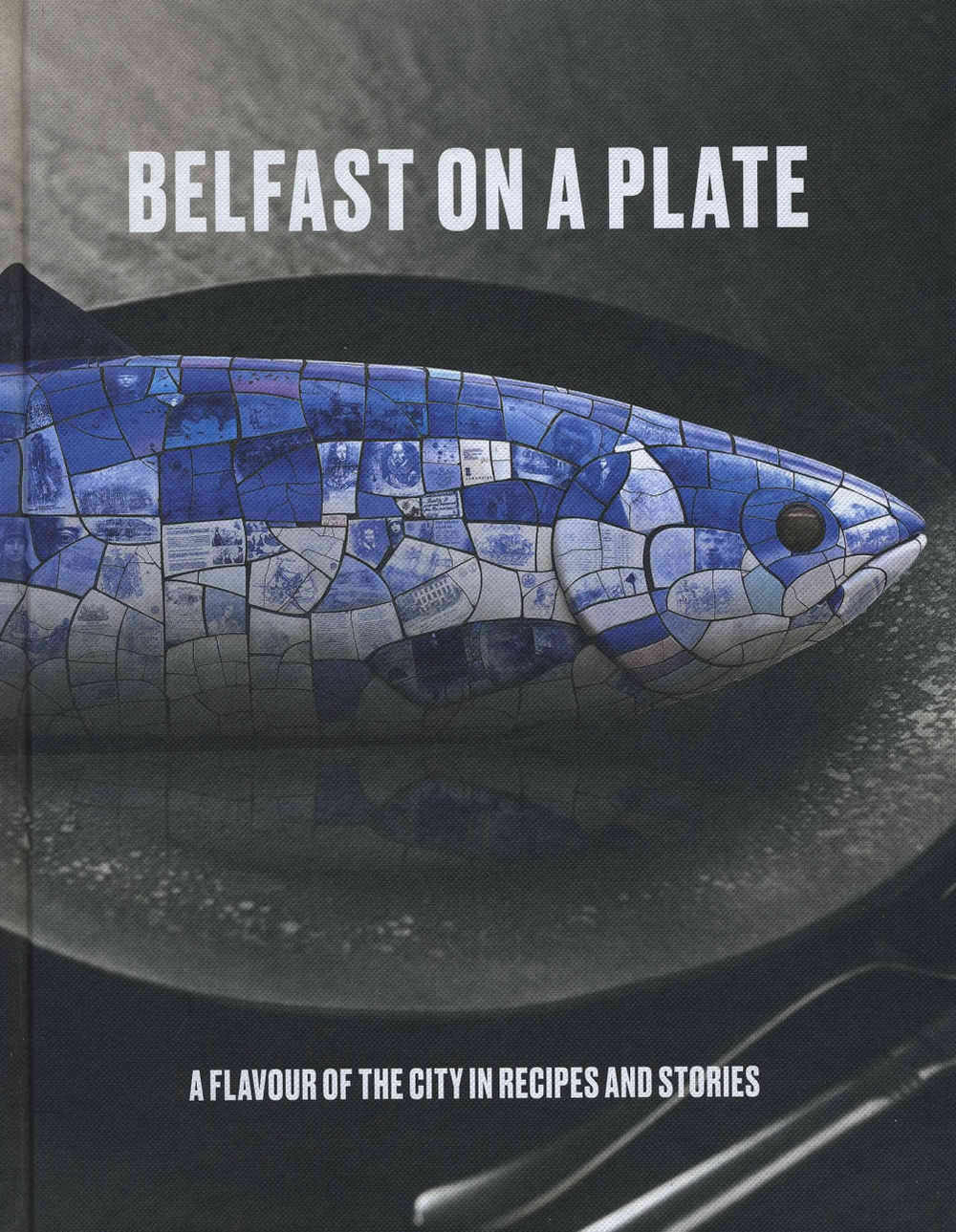
Heading north, photographer David Pauley and Joanna Branniff’s Belfast On A Plate (www.belfastonaplate.com £25) is a celebration of the northern capital’s culinary coming of age.
Subtitled A Flavour of the City in Recipes and Stories - and featuring 20 of Belfast’s top restaurants, the people who have created them and the food they serve with such pride - it ‘describes the culinary journeys of the talented chefs and restaurateurs behind Belfast's gastronomic revolution’ and, through the stories and recipes of great restaurants like Deanes At Queens, Deanes Eipic, General Merchants, Hadskis, Home, James Street South, Mourne Seafood Bar, Ox, Saphyre, Shu, The Ginger Bistro, The Merchant Hotel, and The Muddlers Club, this beautifully produced book vividly illustrates the talent, diversity and energy of the city.
And, as Northern Ireland’s original media chef, Paul Rankin, says “…Belfast is in the top three provincial food cities in the UK and it's been up there for quite some time”. And it’s pretty well up there when compared to cities down south too - what a culinary gem this small island has become.

Recipe: Zingy Beef With A Salad Of Watercress, Mint, Mango And Peanuts
This super warm salad comes from Simon McCance at his ever-popular city centre restaurant, The Ginger Bistro.
Serves 1
Core Ingredients
4 oz sirloin steak, trimmed
1 tsp olive oil
salt
black pepper
Dressing
1 garlic clove
a piece of pickled ginger
fresh chopped chilli to taste
1 dessertspoon light soy sauce
juice and zest 1 lime
Salad
handful of watercress
2 scallions
5-6 mint leaves
½ mango, peeled and sliced
To Serve
10-20 peanuts
Method
1. For the Dressing, chop garlic, pickled ginger and chilli, mix together with lime zest to form a paste. Stir in soy and lime juice.
2. To make the Salad, mix watercress, scallions, mint and mango in a large bowl.
3. Lightly oil the steak and season. Cook in a very hot pan or barbecue to your liking, rest before carving into slices.
Assembly
Dress the salad, add beef and mix together. Arrange on a serving plate and sprinkle with peanuts.
Georgina Campbell's Cookery Feature - Delicious Donegal Dishes
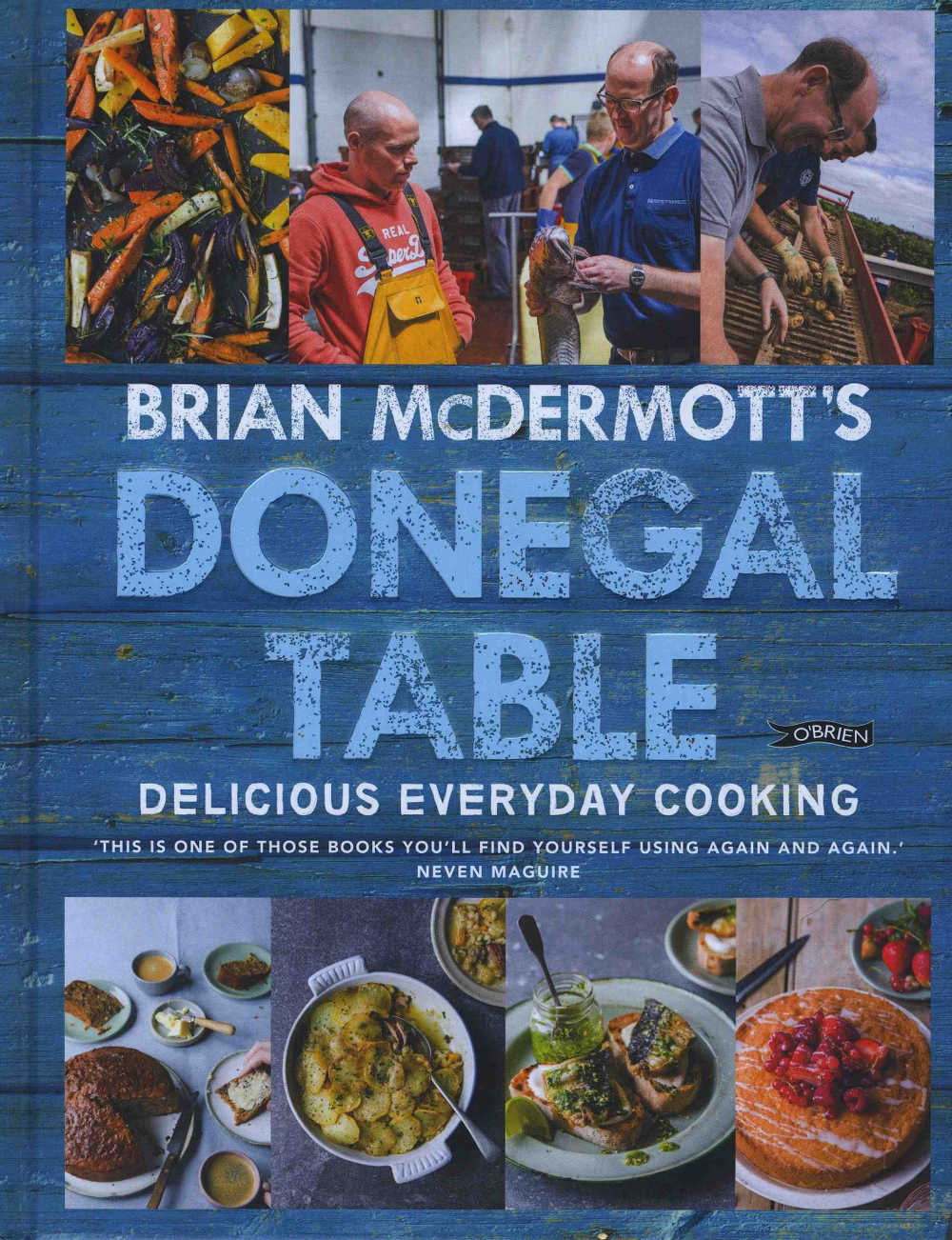
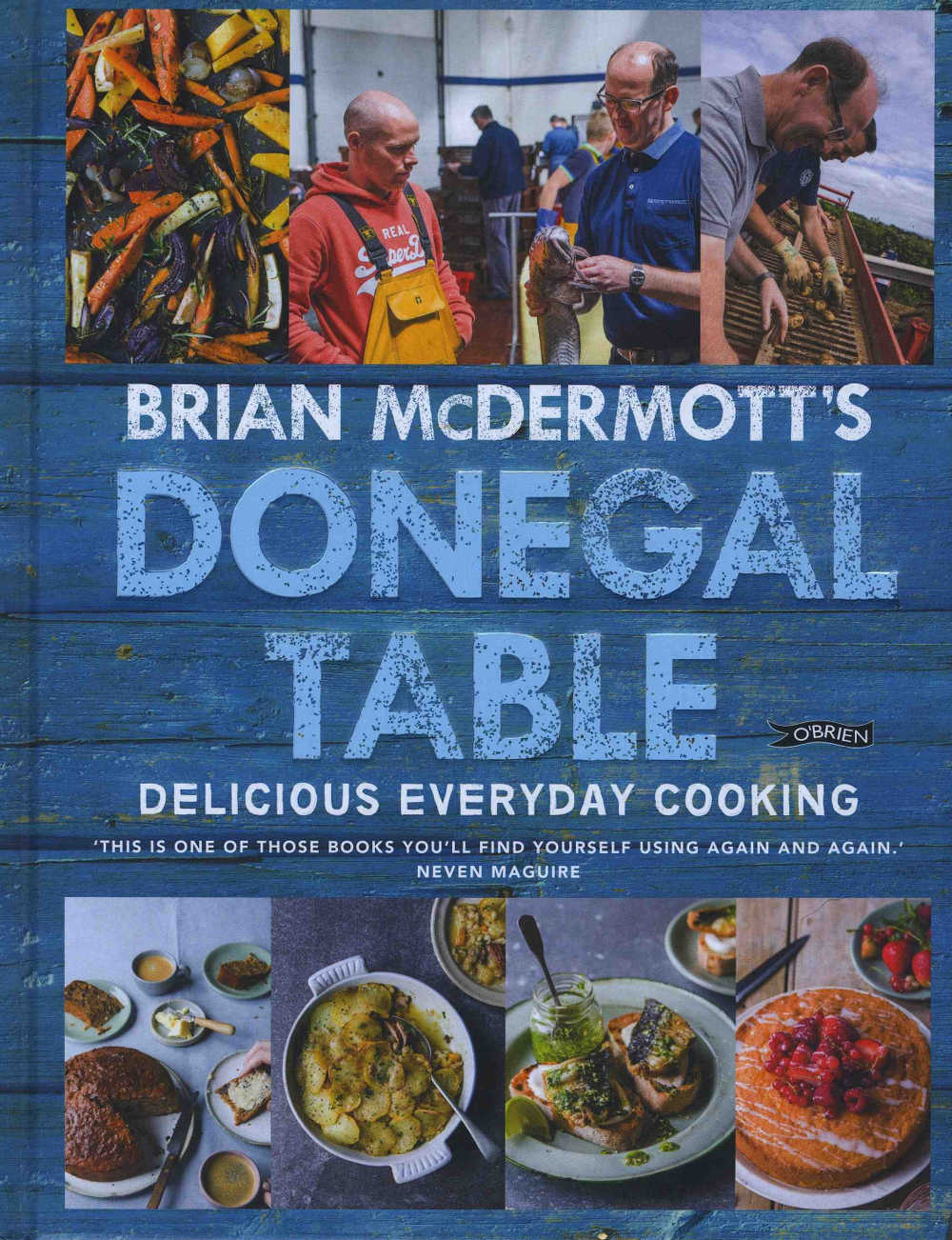
Donegal has gained a reputation as one of the coolest places on earth of late, but there are plenty of people who have known that all along - and that includes the well known chef and teacher, Brian McDermott, who lives and runs his cookery school on the beautiful Inishowen Peninsula.
After leaving the catering industry at the age of thirty three due to a heart condition, he focused on healthy cooking in the community and quickly earned national fame as ‘The No Salt Chef’ - which is not the theme of his new book, Brian McDermott's Donegal Table Delicious Everyday Cooking (O’BrienPress, hardback, €19.99 /£17.99) but the health-giving properties of the ‘good honest food’ that his mother cooked for a family of twelve are clearly an inspiration.
Whether Brian is demonstrating at food events or festivals, on TV or in his own cookery school, his cooking is proudly based on the seasonal produce of the North-West of Ireland that he is always keen to promote for its quality and diversity - and the many images of Donegal, and Brian, his suppliers and his family, convey a warm and welcoming sense of place and community.
Donegal Table is an appealing, practical book packed with tempting versions of the easy and affordable dishes that we all enjoy sharing with family and friends, this is - in the words of Brian’s friend Neven Maguire, '… one of those books you'll find yourself using again and again'.
A real book for real cooks, in other words - tasty rustic dishes like Wild Atlantic Way Fish Pie, Mammy’s Irish Stew and Early Summer Tart (‘My Best Veggie Dinner'), for example, a whole chapter on spuds and lovely baking: lucky daughters, Niamh and Aoife, on the days when Dad’s just baked an After-School Jam Sponge. Magic.
RECIPES to try:
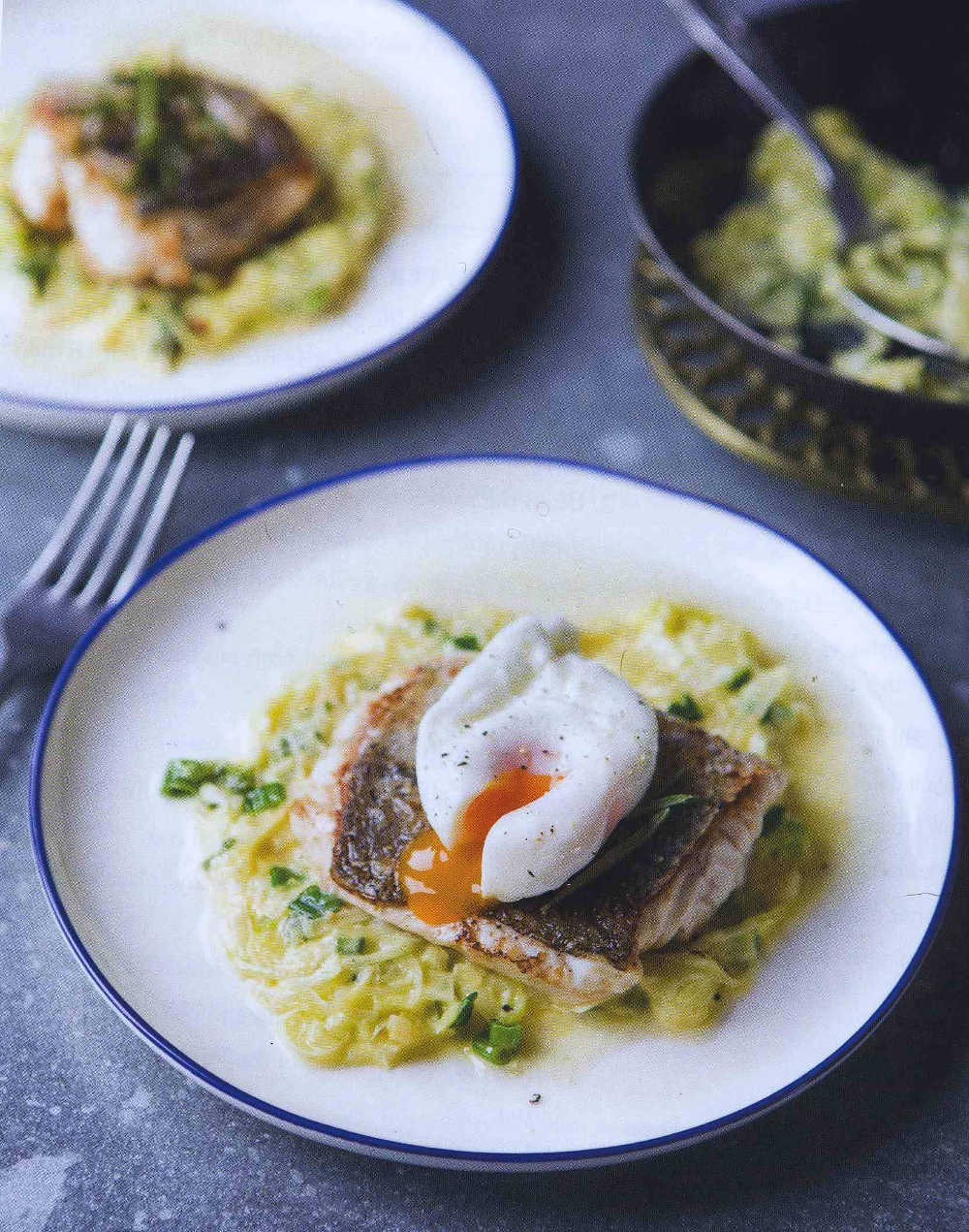
Pan-Fried Hake with Rosemary, Leeks and a Runny Poached Egg
If you want more fish in your diet then hake is an excellent choice, as it's easy to cook, soft in texture and has far fewer bones than any other fish. It was rarely eaten years ago, but it's now one of my top fish choices.
SERVES 4
Drizzle of rapeseed oil
40g butter
600g fresh hake fillets
sprigs of rosemary
freshly ground black pepper
1 lemon
½ leek, sliced
½ onion, sliced
1 clove of garlic, crushed
100ml cream
4 free range eggs
Heat a frying pan and add a drizzle of rapeseed oil and half the butter. Place the hake in the pan, skin-side down, and cook for 2 minutes. Add the sprigs of rosemary.
Turn the hake over, season with black pepper and add the zest of the lemon. Cook on medium heat for 4 minutes, then transfer the fish to a warm tray.
Using the same pan, add the rest of the butter, followed by the leek, onion and garlic. Reduce the heat and sweat for 2-3 minutes. Add the cream and allow it to warm through. Season with freshly ground black pepper,
While the leeks are sweating, heat some water in a saucepan until light bubbles appear, as in a glass of lemonade. Crack and gently drop the eggs into the water and cook for about 2 minutes, ensuring you retain a soft runny egg.
Serve the hake on top of the vegetables and place the poached egg on top. Sprinkle with some more pepper.
BRIAN’S TIP - Try replacing the hake with cod, haddock or turbot
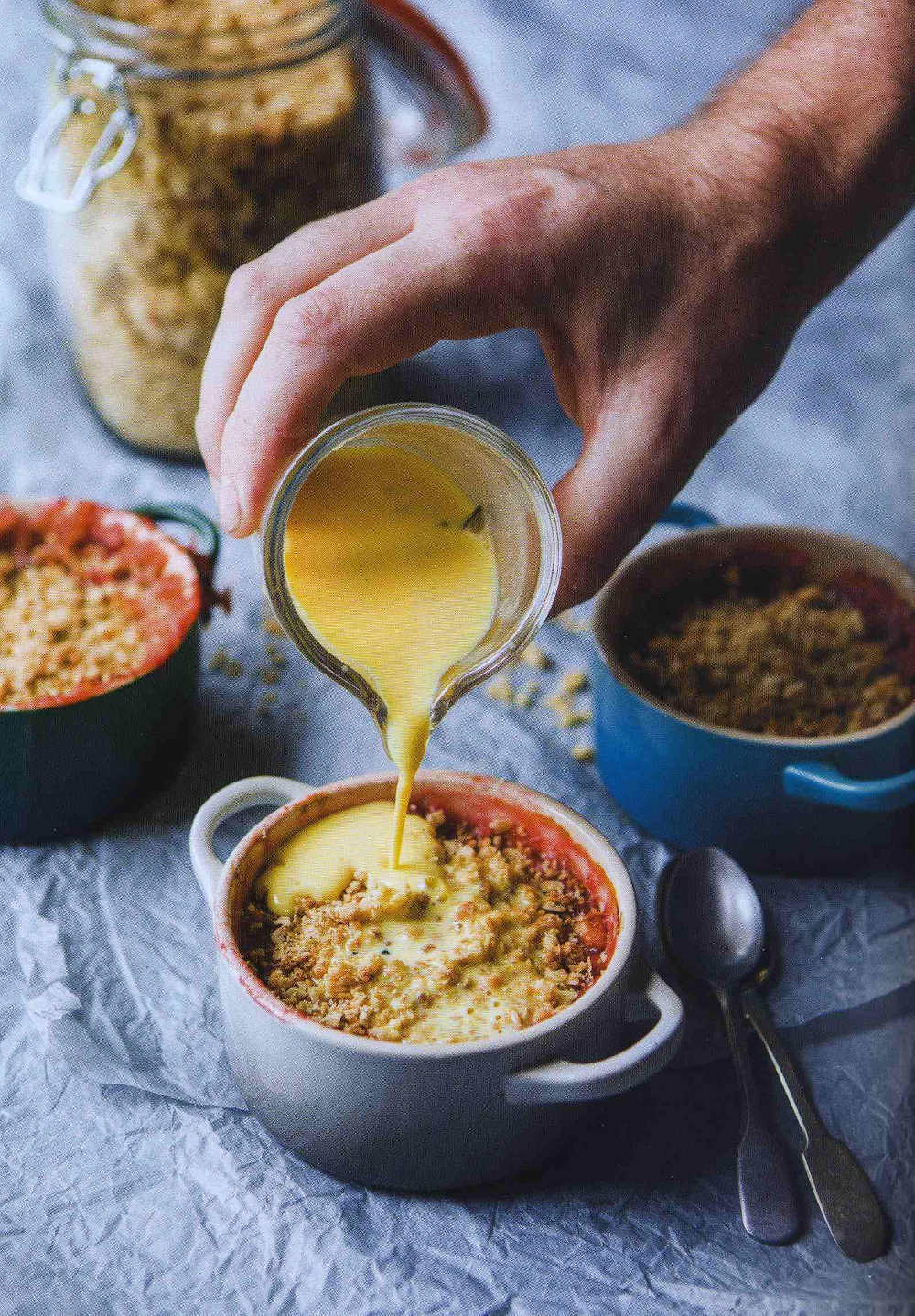
Garden Rhubarb Crumble
I only started growing my own rhubarb a few years ago, but it's well worth it. From a four foot-square plot I can get enough rhubarb to last me all year. I freeze it, stew it and even make jam with it. I love to be able to eat my own rhubarb even when there's snow on the ground outside.
SERVES 4
150g self-raising flour
50g light brown sugar
100g butter, softened
150g porridge oats
500g rhubarb, washed and cut into chunks
100 g caster sugar
1 vanilla pod
Preheat the oven to 200°C/400°F/Gas Mark 6.
For the crumble, mix the flour and brown sugar together and rub in the softened butter until you have a sandy, crumbly texture. Add the porridge oats and gently mix.
Spread the crumble out on a tray and bake for 20 minutes until golden brown, stirring halfway through. Set aside to cool.
For the rhubarb, simply add it to a pot with the caster sugar and the seeds from the vanilla pod - or use a few drops of good quality vanilla extract.
Stew the rhubarb by simmering it for about 15 minutes. Allow to cool slightly.
Divide the rhubarb between four 8cm round dishes. Scatter the crumble on top and place in the oven for 10 minutes. Serve piping hot
BRIAN'S TIP - You have to serve this with custard and ice-cream, mmm...
Georgina Campbell's Cookery Feature - Ireland's Green Larder
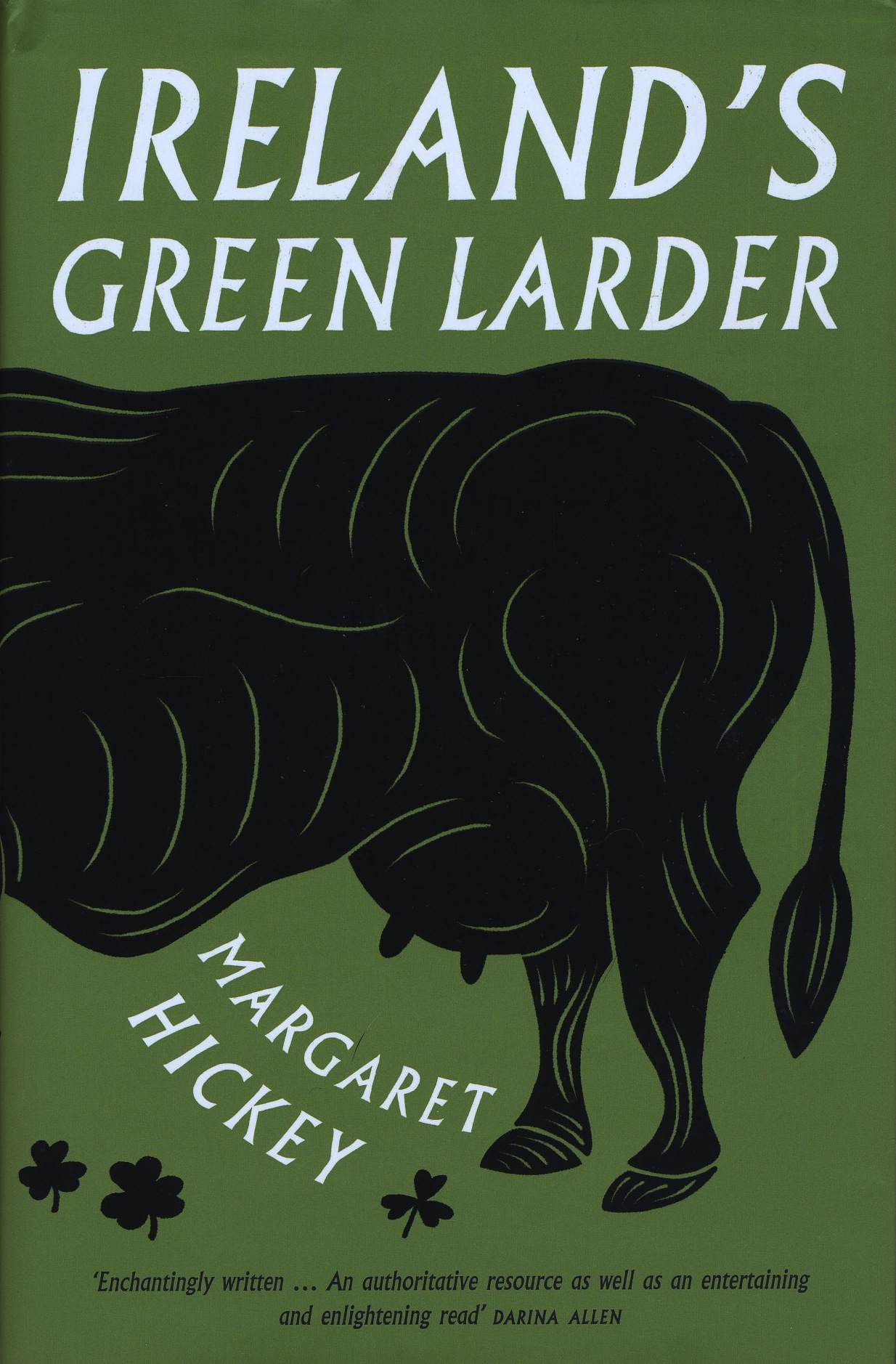

“Tell me what you eat and I will tell you what you are” (Jean-Anthelme Brillat-Savarin) is a telling choice for the first of many well-chosen quotations in Margaret Hickey’s new book, Ireland's Green Larder (Unbound, Hardback £20; online sellers), summing up as it does the role that daily food choices play in the development of individuals - and the societies of which they are part.
Endorsed by Darina Allen, who describes it as “A work of considerable scholarship, enchantingly written in evocative prose” and Richard Corrigan, - “The only book on the social history of Ireland that you’ll ever need” - Ireland’s Green Larder illustrates perfectly why telling the story of Irish food and drink history is so much more revealing than ‘focusing on battles and rulers’ - although, thanks to the deft use of many more of those carefully selected quotations, these often difficult stories are also tellingly told by indirect means and with a refreshingly light touch.
Aside from the richly varied content - which, while food focused, is ‘a glorious ramble through the centuries, drawing on diaries, letters, legal texts, ballads, government records, folklore and more’ - this publication is a real book-lover’s joy of the old school. Through its choice of paper and font, and fine illustrations by Julian Roberts on the cover and dotted through the text (where not a shiny full colour image is to be seen), it’s a book that stimulates the imagination - and is all the better for that.
A must for anyone with a curiosity for traditional Irish foods and the often surprising highs and lows of history that have brought this plentiful land to its current exciting stage as an aspiring food tourism destination, it’s a colourful story featuring many great characters and it’s told with relish and finesse - which is no more than would be expected of an author who is the former Food and Drink Editor at Country Living magazine, among other prestigious publications, and also the author of another great social history read, Irish Days.
And she’s a gallant one too, having masterminded the publication from her East Galway home through the services of an online writers’ patronage scheme Unbound (unbound.com) - you’ll find a list of supporters credited at the back of the book.
SAMPLE RECIPES:
Ireland’s Green Larder is not primarily a cookery book, of course, but it does contain a generous sprinkling of good traditional Irish recipes including these tempting examples for late spring / early summer.
Trout with Sorrel and Hazelnuts
For an intimate supper party for four, this dish is hard to beat. You can serve a greater number, but the essence of the dish is to serve it straight after cooking. Should sorrel not be available, you can substitute spinach, and if the trout came from the river to your kitchen, in flavour and texture it will eclipse farmed trout. The added virtue of this recipe is that you use only one cooking vessel.
4 brown trout, all of much the same 1 kg size, if possible
50 g plain flour
50 g unsalted butter
150 g sorrel, well washed and roughly chopped
4 tbsp sour cream
100 g hazelnuts, chopped
Salt
Freshly ground pepper (pink peppercorns for preference)
2 tbsp finely chopped parsley 1 lemon, quartered
Pre-heat your oven to 180°C/350°F/Gas Mark 4. Clean and wash the trout, leaving them whole, then pat them dry. Season inside and out with salt and pepper and dust well with the flour.
Put the butter into a shallow roasting tray and fry the fish in it for a minute on either side, just enough to set the flesh, then transfer the roasting dish to the oven. Baste the fish and cook for half an hour or less.
About 10 minutes before the time is up, cook your sorrel in salted water and drain it thoroughly before returning it to the pan and stirring in the sour cream. Heat through, then put a mound of the mixture on each person’s warmed plate.
Taking your trout from the oven, put one on each mound of sorrel. Quickly whizz the chopped hazelnuts around in the fish juices and butter for a few moments, then drizzle a little onto each trout, sprinkle the parsley over all and give each person a wedge of lemon.
Carrageen Moss Pudding
Carrageen….was traditionally gathered from its habitat, stones on the lower shore, in April and May and, once the brown weed had been washed of all its excess salt, it was spread out on the grass near the seashore to dry and to bleach in the sun….
Carrageen should be treated in the same way as gelatine. Vanilla pods would not have been readily available in most Irish homes, but it definitely adds to the attraction of this dish, which is mild and interesting, slightly reminiscent of panna cotta. In its short season you could infuse a large head of elderflower or lemon rind to add a note of muscat to the moulded pudding.
1 large egg
1 tbsp caster sugar
5g dried carrageen moss
850 ml whole milk
A vanilla pod, split, with the seeds scraped out, or ½ tsp vanilla essence
Soak the carrageen in lukewarm water for 10 minutes or so, then strain and put into a large saucepan with the milk, the vanilla pod and the vanilla seeds. (If you are using the essence, this goes in with the egg yolk, at a later stage.) Bring the milk to the boil, then reduce to a simmer and cook for 20 minutes.
Separate the egg, putting the yolk into a large bowl (to which you add the essence, if not using a vanilla pod), then add the sugar and whisk together.
Remove the milk from the heat and pass it through a sieve or muslin into the egg yolk mixture. Make sure to press through all the jelly that the carrageen will have released.
Beat the mixture together then set aside while you whisk the egg white until stiff - this works best in a small bowl.
Gently fold the stiffened egg white into the mixture and then allow the pudding to set.
Put it in the fridge once it has cooled a little. The final addition of the fluffy egg white gives a lovely frothy lightness to the whole pudding.
It is ideally served with fruit compote or else good local honey and softly whipped cream. You can add a spoonful of sugar when whipping the cream, if you have a really sweet tooth. In the summer its creamy taste is delicious with strawberries or raspberries, or even stewed gooseberries. In spring, serve it with early forced rhubarb. And in the winter months it is soothing with baked apples or pears.
Georgina Campbell's Cookery Feature - Delicious Dishes from the Food Depot

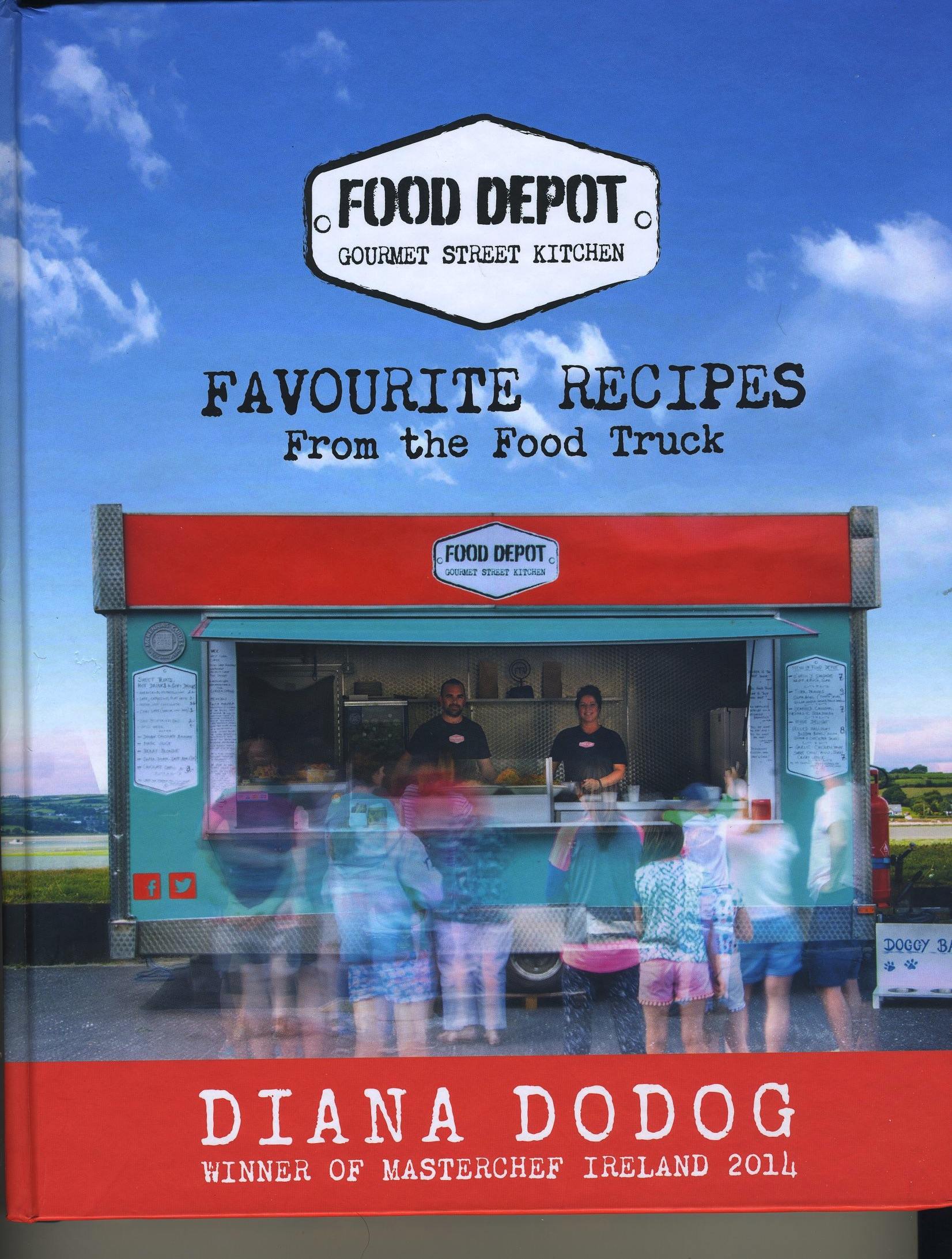 No better time than high summer (and the peak season holiday weeks) to seek out the best street food - and no better place to find it than the legendary Food Depot Gourmet Street Kitchen food truck that makes its home at West Cork Business Technology Park, Clonakilty on weekdays and then heads home to Courtmacsherry beach on Sundays.
No better time than high summer (and the peak season holiday weeks) to seek out the best street food - and no better place to find it than the legendary Food Depot Gourmet Street Kitchen food truck that makes its home at West Cork Business Technology Park, Clonakilty on weekdays and then heads home to Courtmacsherry beach on Sundays.
Run by Diana Dodog - who became a household name in 2014 when she won MasterChef Ireland - and her husband Mike O’Donovan, this West Cork mobile food kitchen has a huge following and (as we’ve been proud to acknowledge at our annual Awards - GCGuides Street Food of the Year 2018), their popularity is very well deserved.
Great taste is the key to success when it comes to street food and there’s no shortage of that at The Food Depot Gourmet Street Kitchen, where customers happily queue to bag the day’s treats from a wide repertoire of dishes which may be ethnically diverse but they’re all based squarely on the best of seasonal local produce.
Dishes like steaming West Cork chowder, O’Neills 3-meat chilli (beef brisket, cheek and mince), Cajun chicken wrap and Veggie Delight (Grilled Hallumi Buddha Bowl) have ‘em coming back from more - plus gorgeous desserts and home bakes, and terrific West Cork coffee.
And happily Diana has shared her terrific and very diverse recipes in an excellent hardback book, Food Depot Gourmet Street Kitchen - Favourite Recipes from the Food Truck (€21). Perfect for relaxed family cooking and casual entertaining, it’s available from the truck and online from fooddepotireland.com.
Some lovely seasonal recipes to try now from the book are given below - and you can see Diana Dodog in action at the incomparable 10-day West Cork Food Festival 2018 www.atasteofwestcork.com, as she will be collaborating with chef Martin Buckley at the excellent Lifeboat Inn in Courtmacsherry on Friday 7th September.
RECIPES from Food Depot Gourmet Street Kitchen:
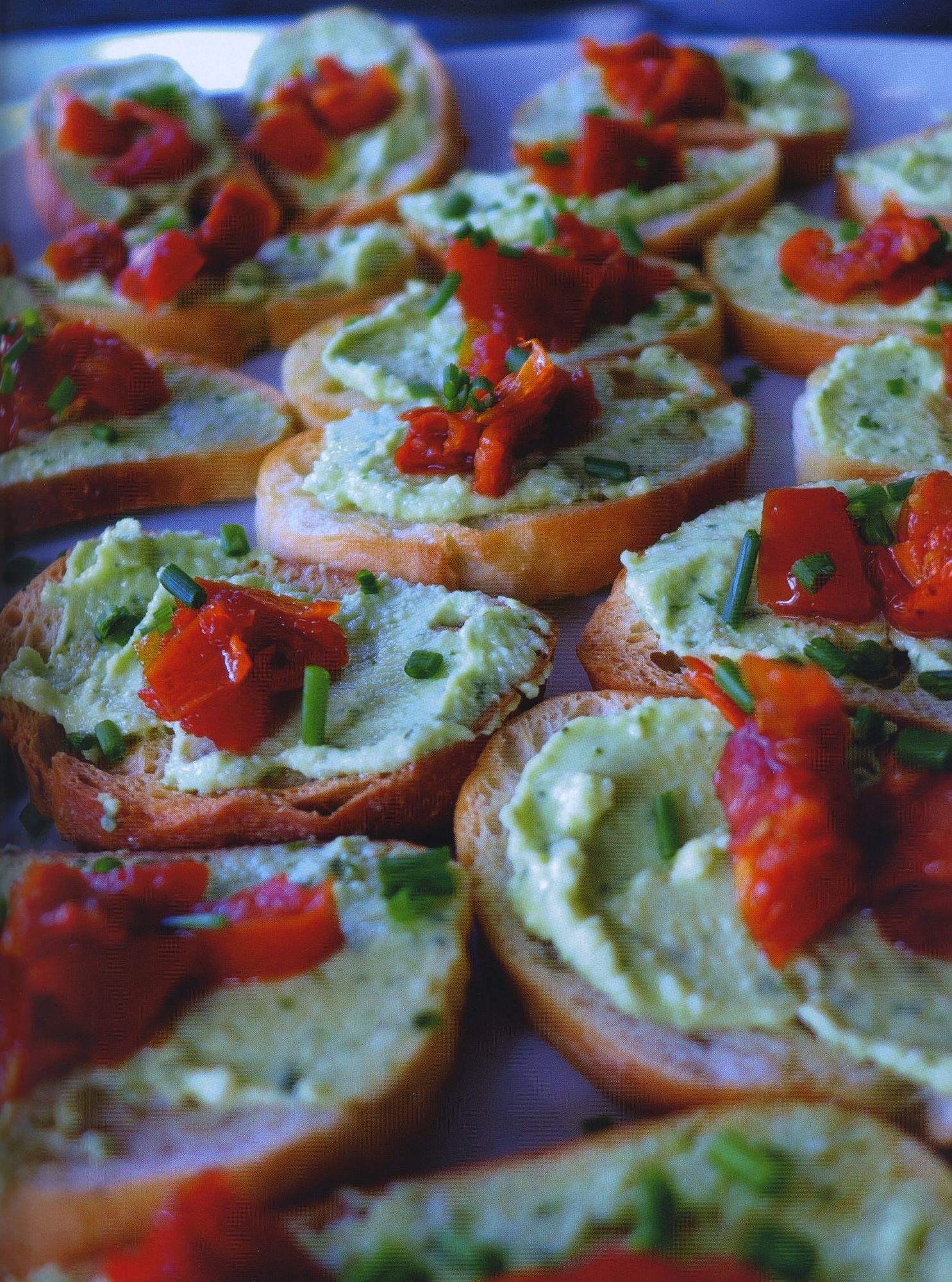 Pea & Mint Hummus
Pea & Mint Hummus
This recipe is a great summer addition. Perfect for those picnics in the park or dinners on the patio. Easy to transport, a light, fresh picnic hamper item. All your vegetarian friends will be happy to try something new and different. Plus it's quick to put together. It is a make ahead little dip, just get a nice loaf of sourdough and you are good to go!
1 tbsp olive oil
1 onion chopped
2 cups of fresh or frozen peas
3/4 cup water
2 tbsp tahini (toasted sesame paste)
3tbsp fresh mint chopped
2 tbsp sour cream
½ tsp black pepper
1 pinch of salt to taste
Heat olive oil in a deep pan, add onions and sauté for 3-4 minutes on medium heat, until translucent, add peas and water, season and cook for 5 min.
Drain a bit of the water off the peas and onions. Reserve it, in case you need to add a bit of liquid at the end for the right consistency. Add all remaining ingredients to the food processor. Pulse until you have a rough purée. Serve chilled!
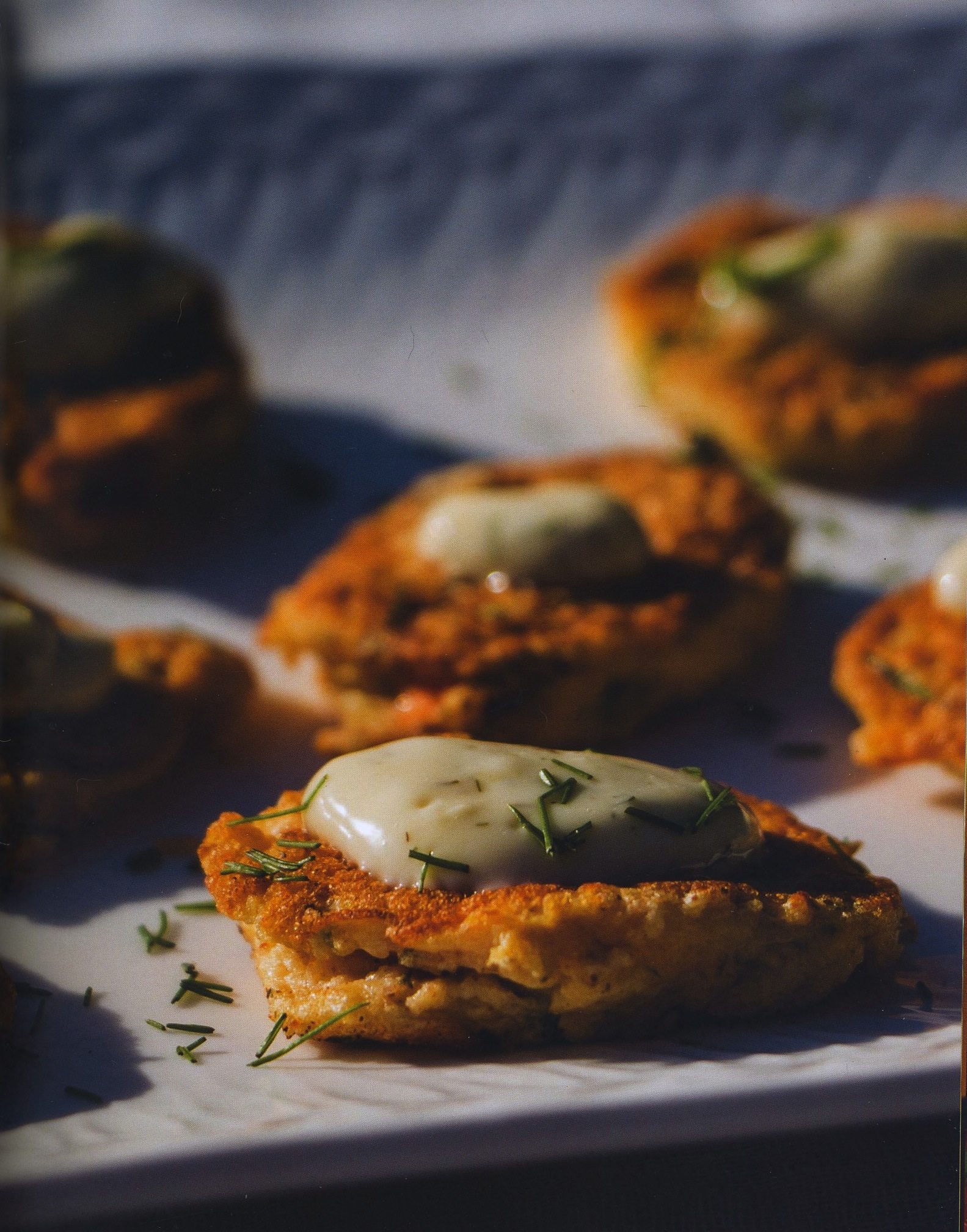
Crab Fritters
Fluffy, light and delicious. The ultimate starter, very quick and easy to put it together. My love of crab came about when I moved to Ireland. Sweet, delicate and extremely rich. Crab sounds like a lot of work, but just buy the white crab meat if you are not up for breaking down a whole one. Serve as nibbles or serve it with a green salad.
Crab Fritters:
500 g crab meat
1 whole egg
2 egg yolks (reserve the whites)
2 tbsp self-raising flour
2 tbsp fresh dill or chives finely chopped
Preserved Lemon Mayonnaise:
1 cup mayonnaise
3 tbsp finely diced preserved lemon peel
2 tbsp lemon juice
1 pinch of salt and pepper
To Cook and Serve
2 egg whites, beaten until stiff
knob of butter
salt and pepper to taste
1. Preserved Lemon Mayonnaise:
Place the mayo, preserved lemon peel and lemon juice in a small mixing bowl.
Stir to combine then season with a little sea salt and black pepper. Refrigerate until required.
2. Crab Fritters:
Drain any excess liquid off the crab meat then place in a medium-sized mixing bowl. In a separate bowl, place the whole egg, 2 egg yolks and the self-raising flour. Whisk until smooth, then pour on to the crab meat. Add the dill and mix together along with some sea salt and black pepper. Refrigerate until required.
3. To Cook and Serve
Preheat your frying pan to medium heat. Fold the beaten egg whites into the crab batter. Add a little butter to your cooking surface, then spoon out the fritter batter to your desired size. Turn after a minute or so and remove when golden on each side and cooked through. They will puff up and smell divine.
4. Serve immediately with a dollop of the preserved lemon mayo on top, a pinch of sea salt and a grind of black pepper.
Hungarian Garden Pea Soup
A light vegetable soup often served in the spring or summer as a starter, spiced with paprika and fresh parsley. It is my all time favourite soup and symbolises summertime, using all fresh vegetables from the garden. We would pod the peas in the morning with grandma sitting on the steps in front of our kitchen door while the sun heats up our bodies. All veggies are covered in soft warm soil, we wash them before taking all ingredients into the kitchen, ready for the pot. Nothing is more delicious for me!
400 g peas fresh or frozen
2 small onion finely diced
2 medium carrots diced
2 potatoes diced
1 large bunch of parsley finely chopped
2 pinches of salt and pepper
1 tbsp vegetable oil
2 tbsp smoked-cured pork belly finely diced
2 garlic cloves sliced
1.5 litres water
1 tbsp Hungarian paprika powder
In a large pot gently fry the pork belly in 1 tbsp oil, add onions and garlic. Stir around till it just starts to develop a light colour.
Pull the pan off the heat, add the Hungarian paprika powder, combine. (The reason we take the base off the heat is so the paprika won't burn.) Add water and put it back on medium heat.
Add carrots and potatoes or any other vegetables that you like to use, cover and cook on medium heat until all vegetables just cooked. Then add peas. They only need 2 min to cook.
Finally add the freshly chopped parsley, check for seasoning and serve.
Georgina Campbell's Cookery Feature -Dingle Dinners
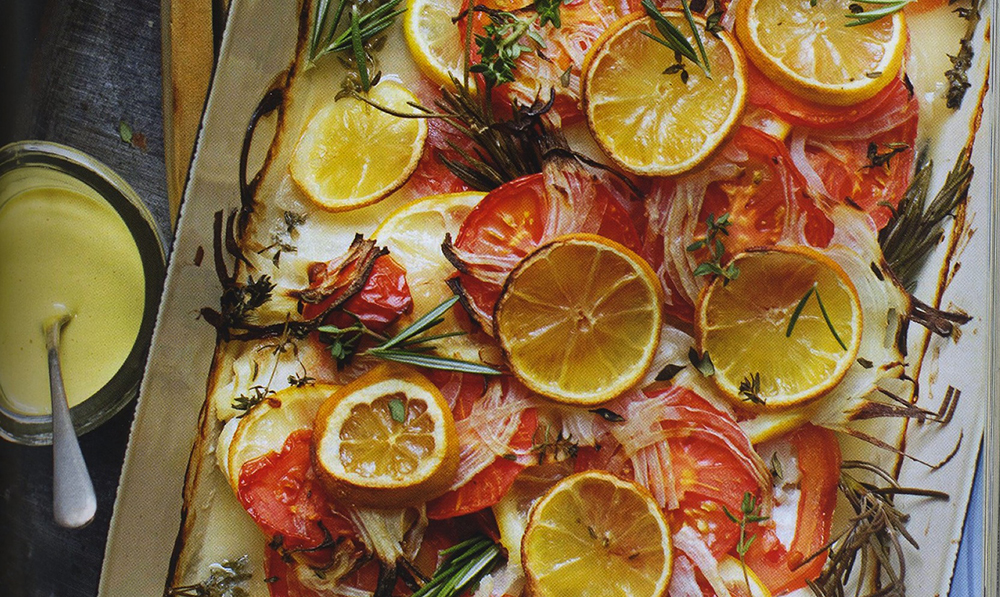
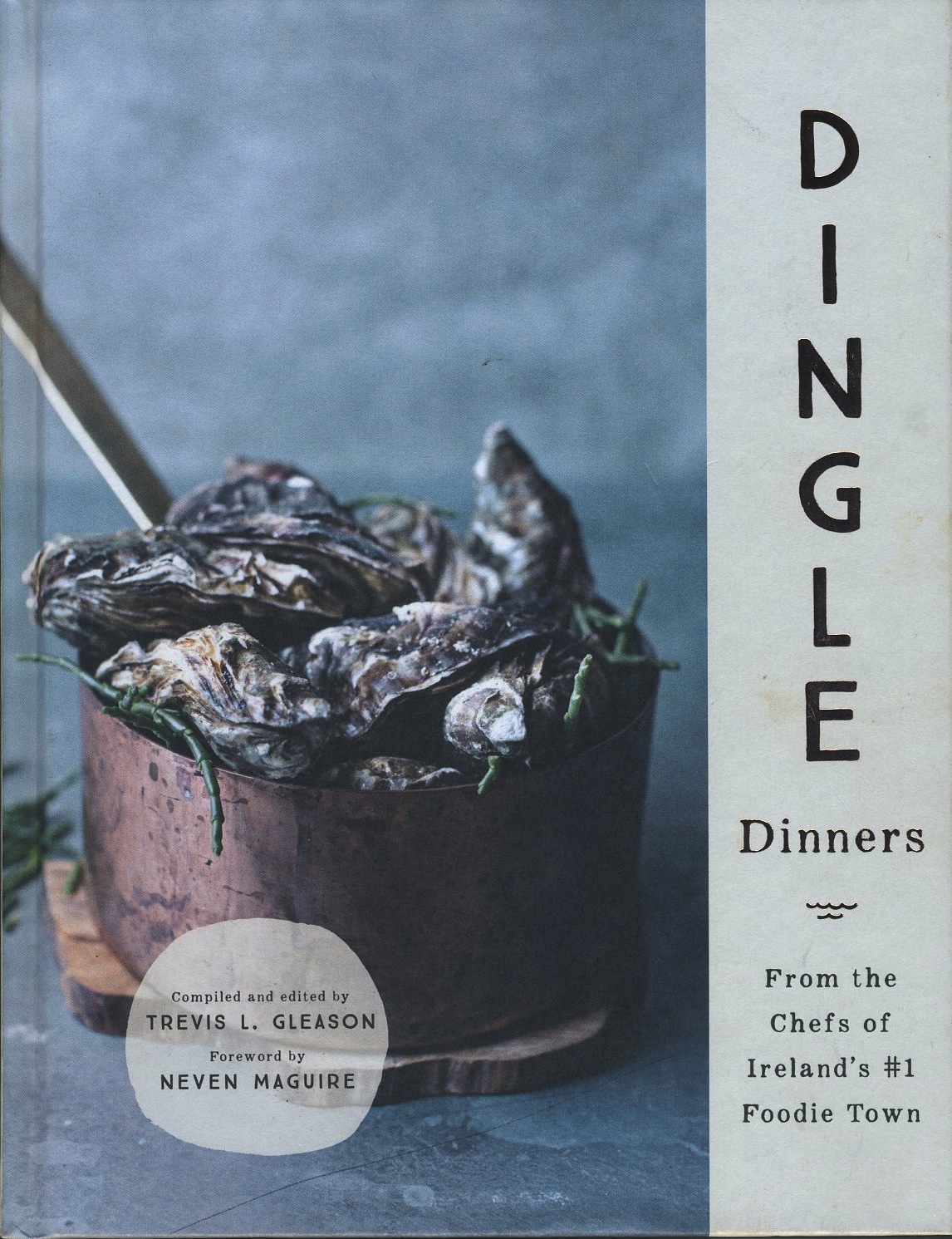 A memorable summer dinner at Dingle’s oldest pub, The Lord Baker’s, saw me coming away with copy of Trevis L. Gleason’s Dingle Dinners (The Collins Press, hardback; €25) tucked under my arm - a welcome addition to the luggage as, although published last year, I hadn’t got around to tracking down a copy. And now I know what I was missing. The starting point - What do chefs cook when they have friends and family around for dinner? - is just that and, although it’s a great cookbook with terrific down to earth do-able contributions from a couple of dozen of Dingle’s famously talented food (and drink) professionals, what the visitor is really getting is an insider’s guide to what makes this magical town’s culinary heart beat.
A memorable summer dinner at Dingle’s oldest pub, The Lord Baker’s, saw me coming away with copy of Trevis L. Gleason’s Dingle Dinners (The Collins Press, hardback; €25) tucked under my arm - a welcome addition to the luggage as, although published last year, I hadn’t got around to tracking down a copy. And now I know what I was missing. The starting point - What do chefs cook when they have friends and family around for dinner? - is just that and, although it’s a great cookbook with terrific down to earth do-able contributions from a couple of dozen of Dingle’s famously talented food (and drink) professionals, what the visitor is really getting is an insider’s guide to what makes this magical town’s culinary heart beat.
Trevis - originally from Seattle and living in Dingle with his wife Caryn and two Wheaten terriers since 2012 - is well known for his earlier book, Chef Interrupted, which tells with inspiring warmth and wit the story of life after MS diagnosis. His style is engaging and Dingle Dinners is a great read, with the town’s culinary characters breathing life into its unique culture - which, together with the stunning scenery, has such a bewitching effect on visitors that many, chefs included, end up staying far longer than originally planned.
For this book, the assembled characters are charged with giving recipes for a three-course dinner for six - an Autumn Dinner, a Sunday Lunch, A Fancy Family Feast, each has his or her theme, and it is good to see some of the town’s culinary pioneers like Stella Doyle (co-founder of the legendary Doyles) and Pat Moore (who established the town’s other early destination restaurant, Beginish, in the mid-80s) given special recognition alongside current players. The result is a lovely combination of personal styles, united by a love of place - and, of course, the town’s brewery and its distillery both have parts to play, so the ’twist’ in these recipe often involves a ‘tipple’ too…
***Coming soon - Dingle Food Festival Féile Bia Daingean Uí Chúis
and Blas na hEireann, The Irish Food Awards: Fri 5th - Sun 7th Oct 2018
http://www.dinglefood.com/
RECIPES FROM DINGLE DINNERS
[All recipes serve at least 6; American measures are also given in the book]
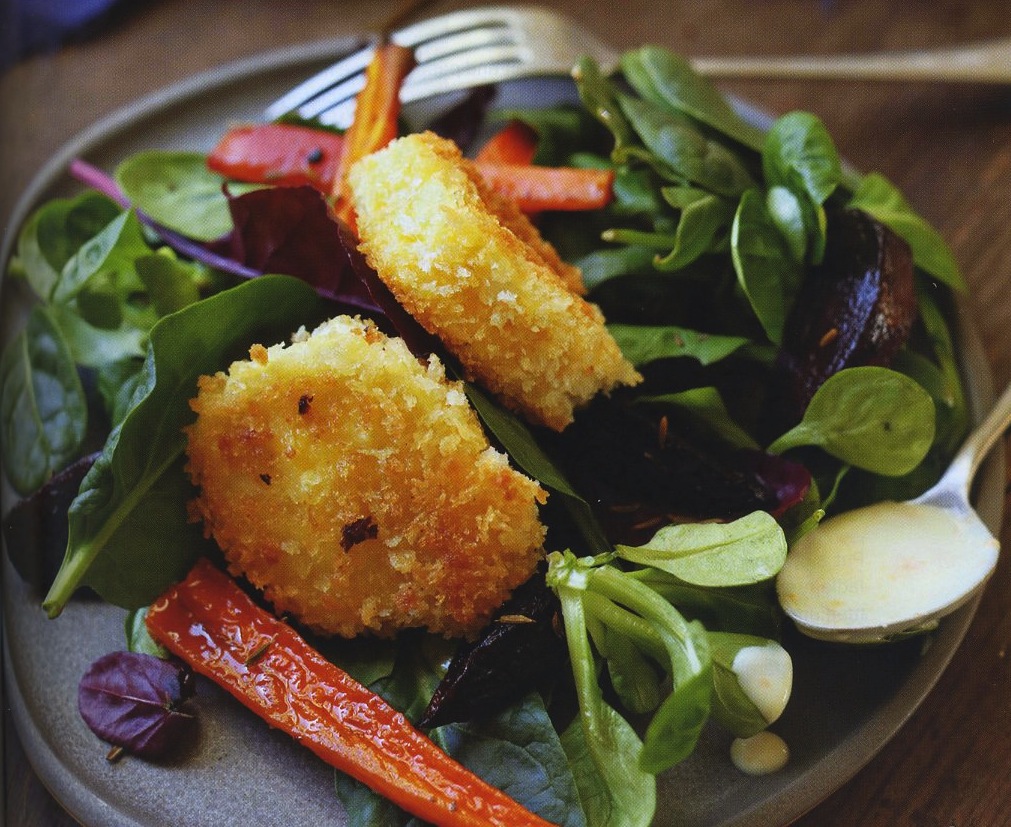 Mark Murphy runs the highly regarded Dingle Cookery School and is especially well known for his Traditional Irish Cooking and Catch & Cook courses. His Dingle Dinners menu includes this super recipe for CRISPY GOAT’S CHEESE SALAD WITH ORANGE AND CUMIN YOGURT DRESSING
Mark Murphy runs the highly regarded Dingle Cookery School and is especially well known for his Traditional Irish Cooking and Catch & Cook courses. His Dingle Dinners menu includes this super recipe for CRISPY GOAT’S CHEESE SALAD WITH ORANGE AND CUMIN YOGURT DRESSING
3-4 carrots, peeled and cut into even-sized lengths
3-4 beetroot, cut into even-sized wedges
2 garlic cloves, finely chopped
½ tsp cumin seeds
1 tsp coriander seeds
1 orange, zested and halved
1 large red bell pepper, cut into long strips
salt and freshly ground black pepper
selection of hearty salad leaves, such as radicchio, mustard leaves and mizuna
For the dressing:
60ml / 2floz natural yogurt
zest from the orange
1 tbsp lemon juice
salt and freshly ground black pepper
For the crispy goat's cheese
100g / 3½oz panko Japanese-style breadcrumbs
2 tsp thyme leaves, picked and very finely chopped
salt and freshly ground black pepper 2 eggs, beaten
l00g / 3½ oz plain flour
150g / 5¼oz goat's cheese, cut into six portions
oil, for frying
Preheat the oven to 180°C / 350°F / gas mark 4. Place a baking tray in the oven to heat it up. Bring two large pots of salted water to a boil. Add the carrots to one pot and the beetroot to the other. Return to a boil, reduce to a simmer and cook them for about 5 minutes. Strain the vegetables and place on the hot baking tray. Add the garlic, cumin, coriander and the juice of half an orange to the hot vegetables, season and roast for 15 minutes.
Drain the liquid from the tray into a bowl with juice of remaining orange half. Add the strips of red pepper to the tray and continue to roast for 5-10 more minutes.
Wash and dry the salad greens. Set aside.
To make the dressing, place yogurt in a small bowl, stir in some of the juices from the baking tray (1-2 tablespoons should be plenty), then add orange zest followed by the lemon juice. Season with some salt and pepper.
To make the crispy goat's cheese, season the breadcrumbs with thyme, salt and pepper. Put the flour, beaten egg and breadcrumbs in three separate bowls and keep them in that order.
Dip each piece of goat's cheese in the flour and then in the egg. Use the other hand to take it from the egg and add it to the breadcrumbs, pressing crumbs into the cheese to coat well. Repeat this process with the rest of the goat's cheese. Keep this aside until just before serving.
To serve, heat a large sauté pan over medium-high heat, add enough oil to coat the bottom of the pan. Carefully add the breaded goat's cheese and cook for about 2 minutes before turning it over. The breadcrumbs should be a golden colour.
Place the salad leaves in a large bowl, mix in just enough dressing and toss well. Divide the salad between six bowls.
In the same mixing bowl, add roasted vegetables and toss in a little dressing. Arrange in bowls with salad, place the warm goat's cheese on top of the salad and serve immediately.
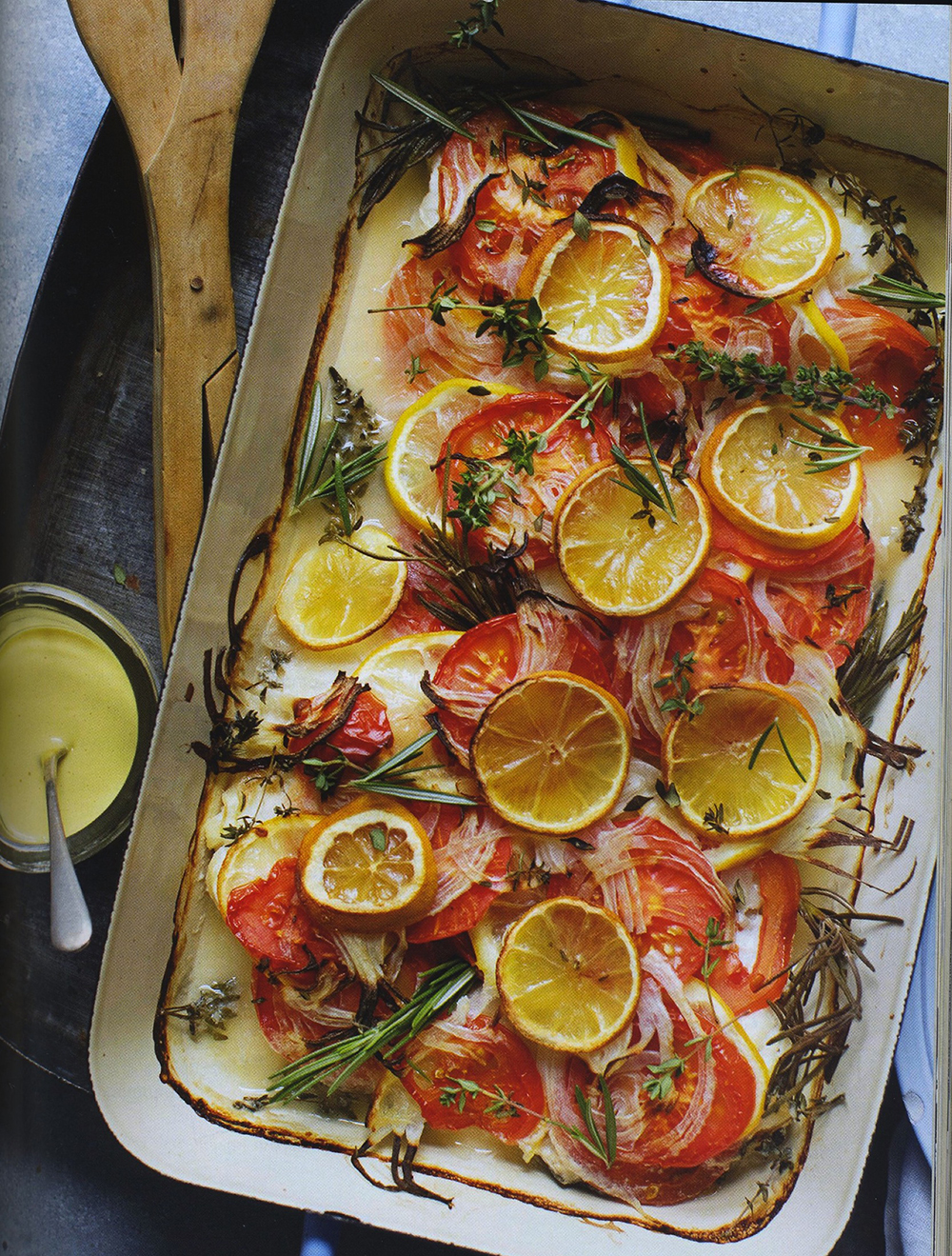 MOTHER'S BAKED COD PROVENCAL WITH AIOLI
MOTHER'S BAKED COD PROVENCAL WITH AIOLI
The title of this recipe from chef Jean-Marie Vaireaux of the wonderful ‘seafood only’ Out of the Blue http://www.outoftheblue.ie/ is a reminder that many chefs go back to the dishes remembered from childhood when cooking at home. Deliciously simple and perfect for this time of year - and some diners might also enjoy it with potatoes boiled in their jackets …
6 x 200g / 7oz cod fillets, skin on and thick near the head
bottle of dry white wine (Muscadet or Sancerre would be lovely)
3 large tomatoes, thinly sliced
2 medium white onions, thinly sliced
2 lemons, thinly sliced and pips removed
2 fresh bay leaves
2 sprigs of fresh thyme
1 sprig of fresh rosemary, snapped in two 2 cloves 3 tbsp olive oil
salt and freshly ground black pepper
2 tbsp chopped fresh parsley
crusty bread, to serve
For the aioli:
3 garlic cloves, finely chopped 2 egg yolks pinch of saffron threads 2 tbsp milk 250ml / 9fl oz extra virgin olive oil sea salt
Preheat the oven to 190°C / 375°F / gas mark 5 for at least 30 minutes.
In a large ovenproof dish, lay fillets of cod, skin side up. Pour wine over and around fish. Shingle alternating tomato, onion and lemon slices over each fillet (at least two of each per fillet). Place bay leaves, thyme, rosemary and cloves in the liquid around the fillets. Bake, uncovered, for 15 minutes.
To make the aioli, place the finely chopped garlic cloves, yolks, a pinch of sea salt, saffron, milk and 2 tablespoons of the olive oil in a large jug or high-sided container. Blitz with a hand-held blender to mix. With blender running, slowly drizzle in the remaining olive oil until you get a smooth, mayonnaise-like sauce. Season to taste with sea salt.
Garnish the baked fish with parsley and serve on the table in the baking dish with aioli and crusty bread.
The atmospheric Global Village that Martin Bealin runs with his wife is all about ‘eat local’ and this is the perfect time to sample the area’s superb salt grass (‘pré-salé) lamb. Global Village is supplied directly by a local farmer but you can buy mountain lamb, including the famed Blasket Islands’ Lamb, from esteemed local butcher Jerry Kennedy. Martin’s SLOW-ROAST SHOULDER OF SALT GRASS LAMB WITH MOORISH SPICES AND STUFFING can of course be made with other lamb, but the Kerry salt grass lamb is unique.
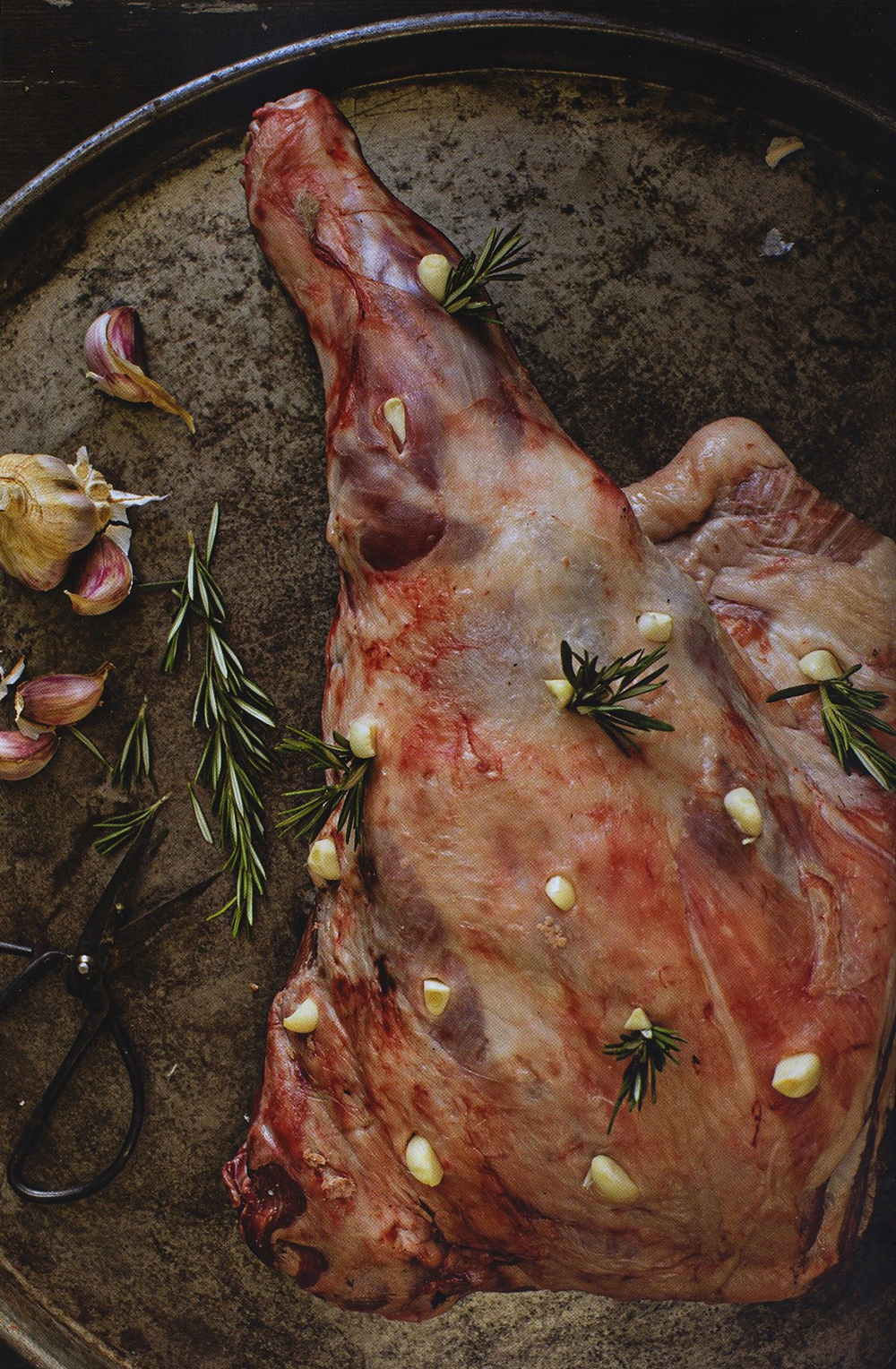 120ml / 4fl oz extra virgin olive oil
120ml / 4fl oz extra virgin olive oil
25g / ¾oz ras el hanout spice 2 garlic cloves, sliced
1 tbsp sea salt
1 tsp ground white pepper
1 shoulder of lamb - have your butcher bone the shoulder, but keep the bones for stock
reserved stems of parsley and coriander from the stuffing, finely chopped
2 garlic cloves, crushed
1 tsp coarse sea salt
For the stuffing:
4 tbsp olive oil
60g / 2oz butter
1 onion, finely chopped 2 garlic cloves, crushed
1 small handful parsley leaves, chopped (reserve the stems)
1 small handful coriander leaves, chopped (reserve the stems)
1 tsp fresh thyme leaves
360g / 12½oz fresh breadcrumbs
salt and freshly ground black pepper
60g / 2oz butter, melted -as needed
110g / 4oz dried apricots, quartered
60g / 2oz slivered almonds
60g / 2oz dry-cured chorizo, finely chopped
In a small saucepan, warm the oil, ras el hanout and sliced garlic over medium-low heat for about 15 minutes to infuse oil. Add salt and white pepper. Remove and allow to cool completely.
Rub the lamb with spiced oil. Make sure to get oil into every bit of the lamb. Marinate, covered in the refrigerator, overnight.
Remove marinated lamb from refrigerator and let it come up to room temperature for an hour or two.
For the stuffing, heat a heavy-bottomed pan over medium heat. Add olive oil and butter and heat until the butter stops foaming. Add onion with a pinch of salt and cook until soft. Add garlic and cook for 30 seconds, until fragrant.
Remove from heat and stir in herbs. Stir in breadcrumbs and season to taste.
Use the additional melted butter to make stuffing into something of a paste, rather than dry crumbs. Add apricots, almonds and chorizo. Set aside to cool.
Georgina Campbell Cookery Feature - Simply Delicious the Classic Collection
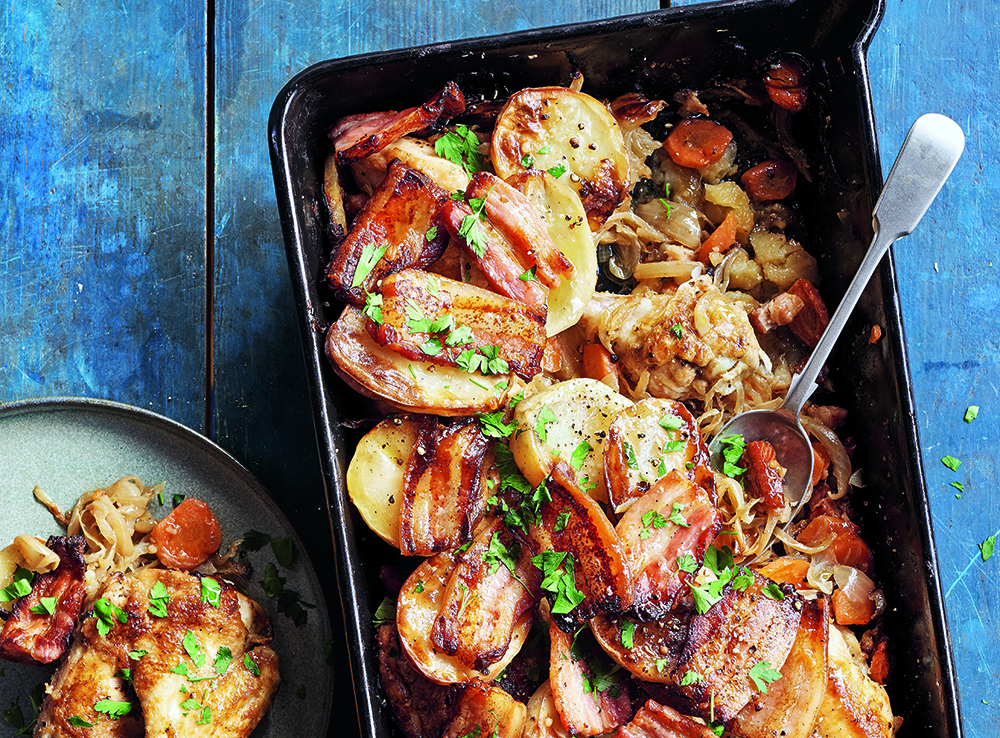
Anyone who remembers Darina Allen’s first RTÉ Simply Delicious programmes when they hit our TV screens in 1989 (on Monday 13th March to be precise) will recall what a breath of fresh air her message was.
It was all about the Ballymaloe philosophy - which was already becoming an internationally recognised beacon of wholesome common sense in the food world at the time - and Darina’s aptly-named cookery programmes sent that message into millions of Irish homes: deliciously nutritious food is easy to make - and the secret ingredient is our wonderful seasonal local produce.
It was a huge success and the first Simply Delicious book made Irish publishing history, topping the bestseller list for many months and selling more copies than any previously published cookbook in Ireland. Darina went on to write a further six Simply Delicious books to accompany the series and has since written many others including the comprehensive Ballymaloe Cookery Course and also Forgotten Skills of Cooking - which celebrates many of the techniques which have since seen renewed interest, especially in professional kitchens.
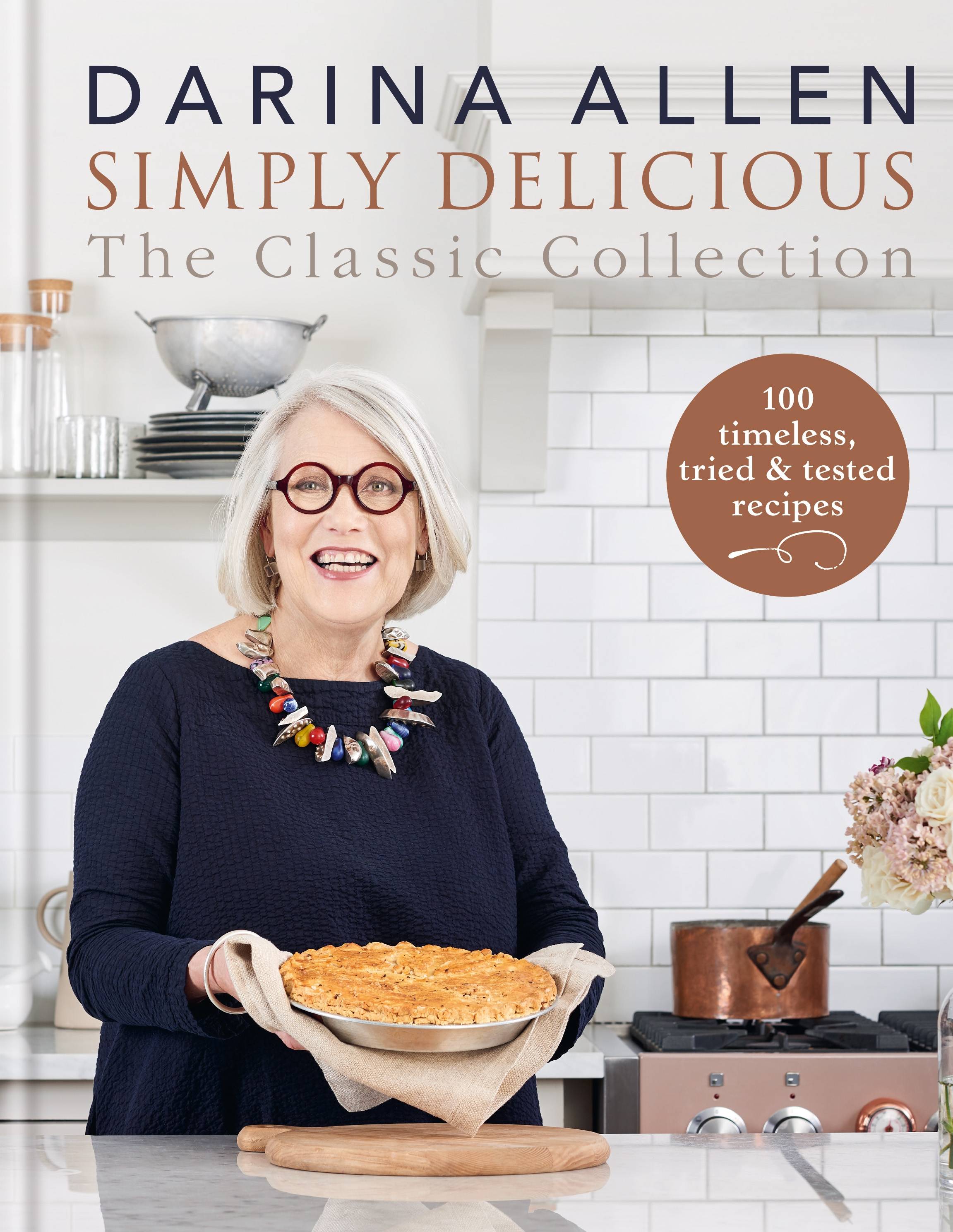 Coming up to the 30th anniversary of Simply Delicious, it’s great to see a special collection of 100 recipes from Simply Delicious 1 and 2 and Simply Delicious Vegetables published in a handsome hardback cookbook.
Coming up to the 30th anniversary of Simply Delicious, it’s great to see a special collection of 100 recipes from Simply Delicious 1 and 2 and Simply Delicious Vegetables published in a handsome hardback cookbook.
Some recipes have been tweaked a bit to update them, but Darina’s message is unchanged and has never been more relevant - and who could resist classic starters like Warm Salad with Cashel Blue Cheese or Ballymaloe Chicken Liver Pâté; comforting mains such as Ballymaloe Irish Stew and Ballycotton Fish Pie; and timeless desserts such a Chocolate Meringue Gateau? And Darina’s voice is there in every recipe, reminding us of the good foods that we have on our doorstep and the wonderful people who produce them.
Simply Delicious the Classic Collection by Darina Allen is published by Kyle Books with photography by Peter Cassidy. Hardback; €27
SAMPLE RECIPES:
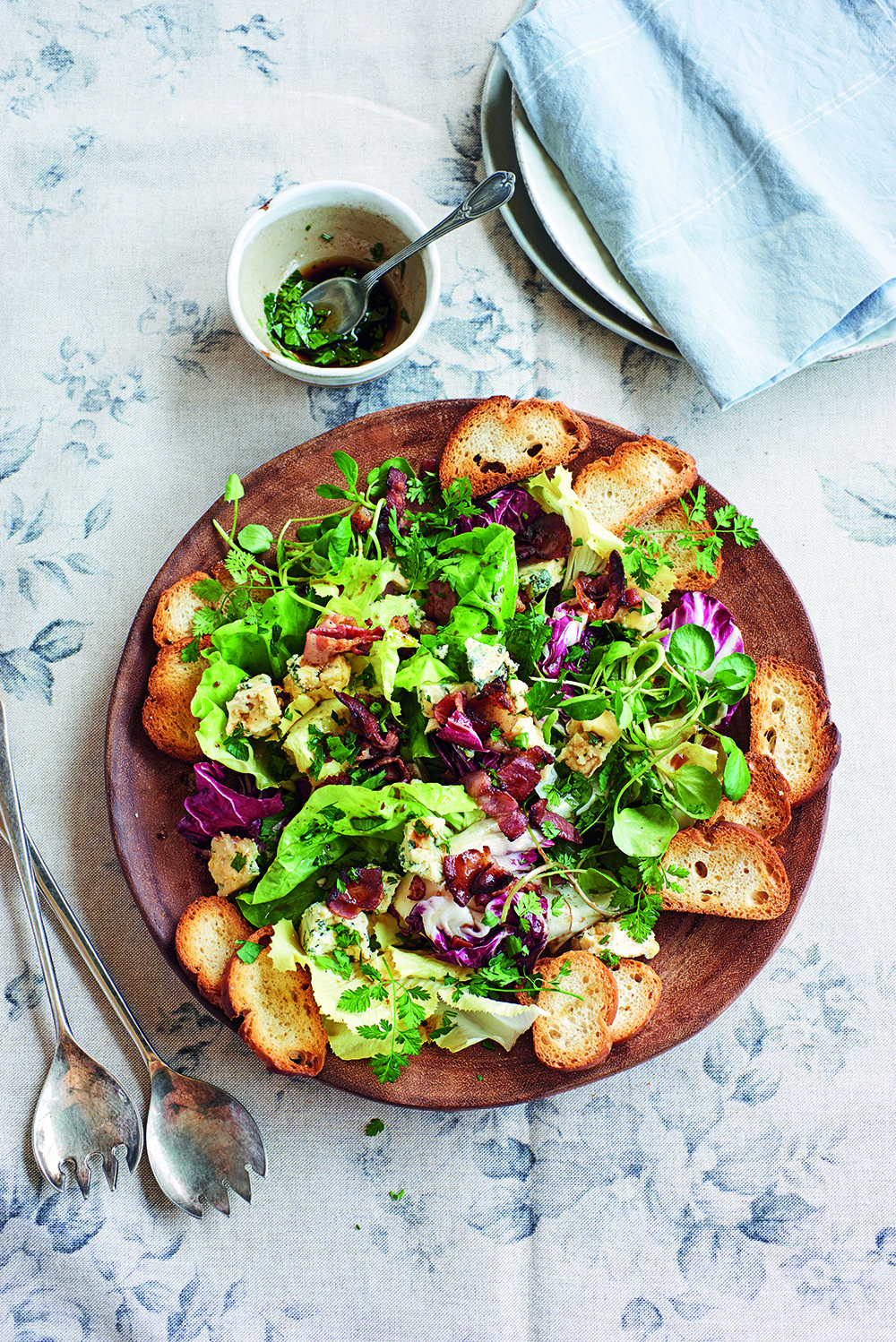
Some ripe, crumbly Cashel Blue cheese now made by Jane and Louis Grubb’s daughter Sarah would be wonderful for this salad. A few little cubes of ripe pear are delicious here too. We also love their Crozier Blue cheese.
Serves 4
a selection of organic salad leaves, such as watercress, radicchio, endive, rocket, oakleaf and butterhead
12 round croutons, 5mm thick, cut from a thin sourdough baguette
45g salted butter, softened
1 garlic clove, peeled
140g smoked streaky bacon, cut into 5mm lardons
extra virgin olive oil, for frying
50g Irish farmhouse blue cheese
1 heaped tablespoon of chervil sprigs or freshly chopped flat-leaf parsley
For the vinaigrette dressing:
1 tablespoon balsamic vinegar
3 tablespoons extra virgin olive oil
2 teaspoons freshly chopped chervil and 2 teaspoons freshly chopped tarragon or 4 teaspoons freshly chopped flat-leaf parsley
sea salt and freshly ground black pepper
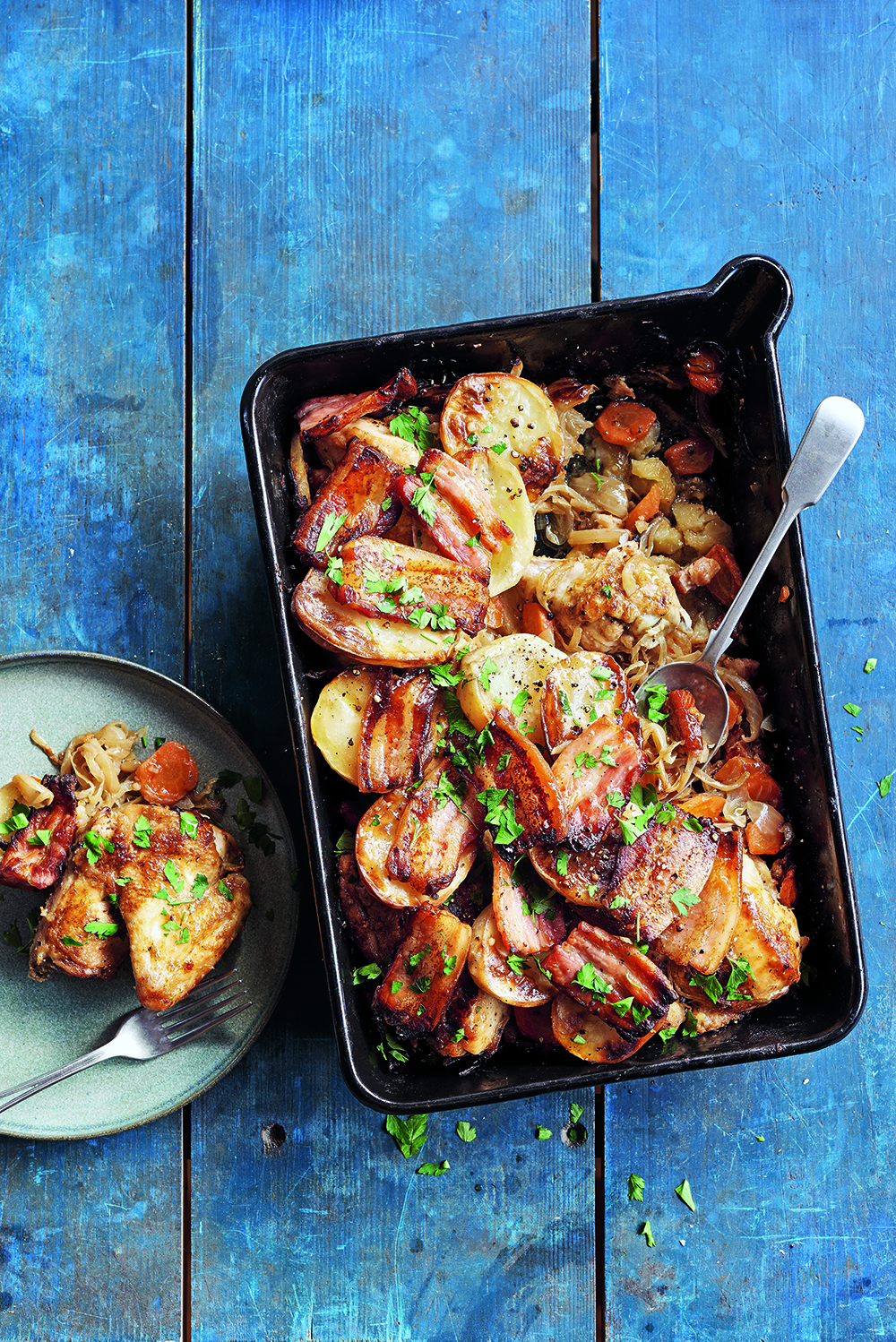
A whole meal in a dish, this was, and still is, a favourite family supper in our house. I often serve it in the big black roasting tin, on the table, family style.
Serves 8
1.575 kg organic, free-range chicken
560g fat streaky bacon in one piece
2 tablespoons sunflower oil
seasoned plain flour
400g onions, finely sliced or chopped
340g carrots, cut into 1cm slices
approx. 2.3kg large ‘old’ potatoes, such as Golden Wonders or Kerr's Pinks
1.1 litres homemade chicken stock, boiling
sea salt and freshly ground black pepper
1 tablespoon freshly chopped parsley, to garnish
Preheat the oven to 230°C/gas mark 8.
Joint the chicken into 8 pieces; separate the wing joints so they will cook evenly. Cut the rind off the bacon and cut 225g into lardons and the remainder into 5mm-thick slices. If salty, blanch, refresh and dry on kitchen paper. Set the slices aside.
Heat the oil in a wide frying pan and cook the lardons until the fat begins to run and they are pale golden; transfer to a plate. Toss the chicken joints in the seasoned flour, sauté in the bacon fat and oil until golden on both sides, remove from the pan and put with the bacon. Finally toss the onions and carrots in the bacon fat for 1–2 minutes.
Peel the potatoes and slice a little less than half into 5mm rounds. Arrange a layer of potato slices on the bottom of a deep 38cm square roasting tin. Season with salt and freshly ground pepper. Top with a layer of seasoned chicken joints. Cut the remaining potatoes into 4cm-thick slices lengthways and arrange cut-side up on top of the chicken (the whole top of the dish should be covered with potato slices). Season with salt and freshly ground pepper. Pour the boiling chicken stock into the roasting tin.
Bake for about 1 hour. After 30 minutes of cooking, top with the slices of bacon so they get deliciously crisp with the potatoes. Test after 1 hour – it may take a little longer. Cover loosely with parchment paper near the end of cooking if the top is getting too brown. The vegetables will have absorbed much of the stock, but the dish should still be moist and juicy underneath the crisp potatoes and bacon slices on top. Sprinkle with chopped parsley and serve.
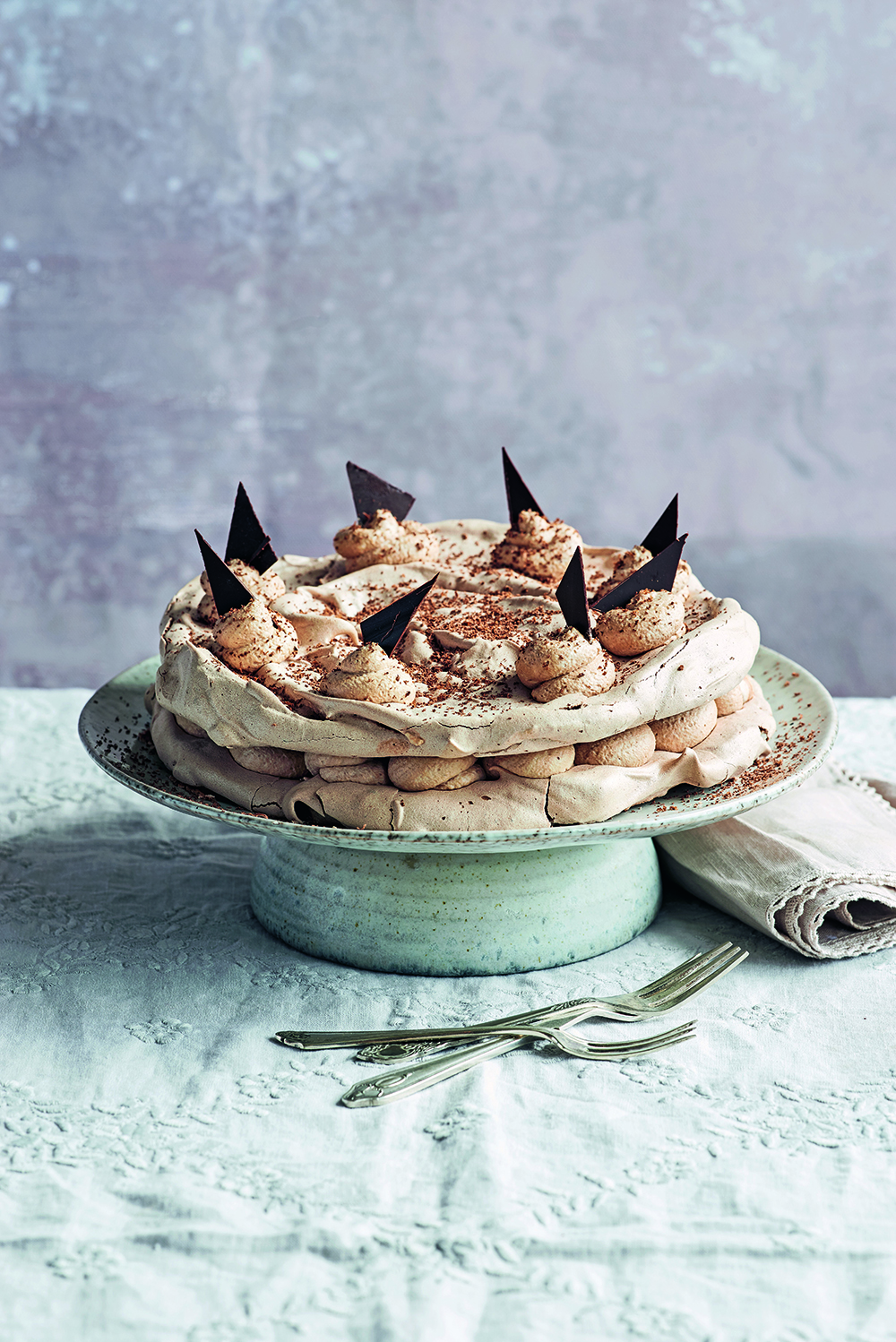
This recipe makes two layers of meringue but you can double the ingredients for a celebration cake or to make individual little meringues
Serves 6
2 organic, free-range egg whites
125g icing sugar
2 rounded teaspoons cocoa powder (I use Valrhona)
For the chocolate & rum cream:
30g best-quality dark chocolate
15g unsweetened chocolate
1 tablespoon Jamaican rum
1 tablespoon double cream
300ml softly whipped cream
For the chocolate wafers: 55g best-quality dark chocolate
Preheat the oven to 150°C/gas mark 2.
Mark 2 x 19cm circles on parchment paper. Check that the bowl is dry, spotlessly clean and free of grease.
Put the egg whites into the bowl and add 110g sieved icing sugar all at once; whisk for about 10 minutes until the mixture forms stiff, dry peaks. Sift together the cocoa and the remaining 15g sieved icing sugar and fold in very gently. Spread into circles with a palette knife and bake immediately in the oven for 45 minutes or until just crisp. Leave to cool completely then peel off the paper.
Meanwhile, very gently melt the chocolate with the rum and 1 tablespoon of cream, or in a bowl over simmering water. Cool and add 2 tablespoons of whipped cream into the chocolate. Mix well, then fold that into the remaining softly whipped cream; don’t stir too much or it may curdle.
To make the chocolate wafers, melt the chocolate in a bowl over barely simmering water. Stir until quite smooth. Spread on a non-stick baking mat or heavy baking tray. Put into a cold place until stiff enough to cut into square or diamond shapes.
Sandwich the two meringue discs together with most of the chocolate and rum cream and add rosettes on top. Decorate with the chocolate wafers and a sprinkling of cocoa.
Georgina Campbell Cookery Feature - Home Economics for Life
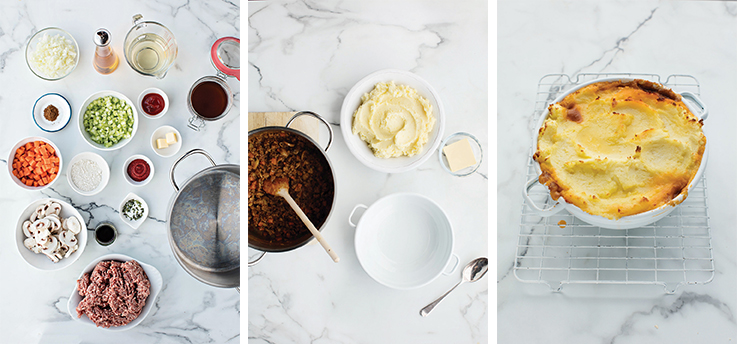

With its confidence inspiring step-by-step images it reminds me of those old staples of good home cooking, the Good Housekeeping series, which turned many a timorous beginner of yesteryear into a happy cook - and the idea that, by mastering just one of the 50 essential recipes each week, you’ll be competent in the kitchen within a year is inspired.
Like his wonderful mother, Vera, before him Neven is a natural teacher and it’s a great thing for the health and happiness of Ireland’s kitchen ingénues that this gifted chef so obviously enjoys passing on his knowledge and enabling others to learn how cook and feed themselves and their families - vital life skills that seem to have been bypassed by so many of the takeaway generation.
So, Neven’s promise is that you too can be a kitchen whiz - and not just have a lot of fun in the kitchen, but be ‘certified in Home Economics for Life’ as well. Go for it!
Neven Maguire’s Home Economics for Life (Gill Books, €22.99) is available from all good bookshops and online.
SAMPLE RECIPES: A Shepherd’s Pie, a Victoria Sponge cake and a (slow but rewarding) Sourdough loaf are just three of the classic dishes that will help to build up a repertoire of essential recipes that will make any beginner cook feel confident and competent in the kitchen.
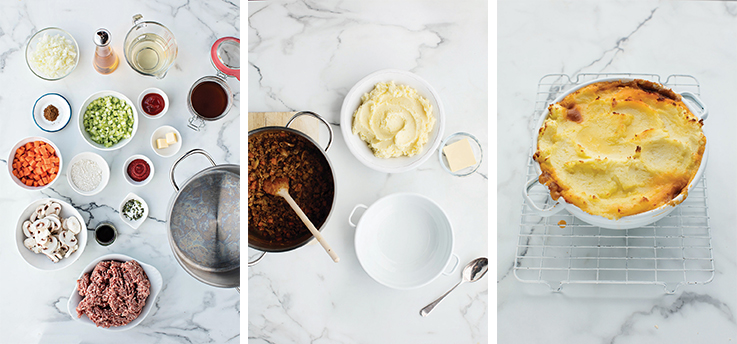 SHEPHERD’S PIE
SHEPHERD’S PIE
This has to be the ultimate comfort food that should only need to be eaten with a fork, preferably in a wide shallow bowl. Imagine settling down on the sofa with this, a mug of tea and a slice of thickly buttered bread for mopping up – life can’t get much better! It’s great to have one of these stashed in your freezer to help you to feed a large group at short notice. If you want to cook it from frozen, simply cover with tin foil and bake in the oven for 1 hour.
Serves 6–8
2 tbsp rapeseed oil
675g (1½lb) lean minced lamb
a knob of butter
2 onions, finely chopped
2 carrots, diced
3 celery sticks, diced
100g (4oz) button mushrooms, sliced
1 tsp chopped fresh thyme
½ tsp ground cinnamon
1 tbsp Worcestershire sauce
2 tsp tomato purée
2 tsp tomato ketchup
300ml (½ pint) white wine
25g (1oz) plain flour
300ml (½ pint) chicken or beef stock (from a cube is fine)
sea salt and freshly ground black pepper
FOR THE MASH
1kg (2¼lb) Rooster potatoes, peeled and cut into chunks
75g (3oz) mature Cheddar cheese, grated
50g (2oz) butter, plus a little extra
TO SERVE
buttered peas
Put a frying pan over a high heat and add a little of the oil. Season the minced lamb, then add it to the pan to fry in batches. Don’t cover the surface of the pan completely, as adding too much meat will reduce the temperature of the pan and the meat won’t brown. Avoid over-stirring the mince as it fries Leave it alone and allow it to develop a good brown colour before breaking it up with a wooden spoon and turning it over. Drain in a colander to remove any excess fat.
Wipe out the pan, then add the butter and allow it to melt over a medium heat. Add the vegetables and thyme and season with the cinnamon and some salt and pepper. Cook for 5–6 minutes, stirring occasionally, until the veg are starting to soften.
Tip in the browned lamb mince, stirring to combine, then stir in the Worcestershire sauce, tomato purée and ketchup. Pour in the wine and scrape up all the crusty brown bits stuck to the bottom of the pan, then allow the liquid to reduce by three-quarters.
Sprinkle over the flour and cook for 2–3 minutes, stirring. Gradually pour in the stock and bring to a gentle simmer. Cook for 1 hour, until meltingly tender. If the sauce becomes too thick, add a little more water.
During the last half an hour of cooking time, make the mash. Put the potatoes in a pan of cold salted water. Cover and bring to the boil, then reduce the heat and simmer for 15¬–20 minutes, until tender. Drain the potatoes and return to the pan over a low heat for 2–3 minutes to remove as much moisture as possible. Remove the pan from the heat, then mash with a potato masher until smooth. Beat in the cheese and butter and season to taste.
Preheat the grill.
Spoon the mince into a baking dish, then spoon the mash on top. Dot with a little more butter and grill until golden. Alternatively, leave to cool completely and store in the fridge for up to two days, then preheat the oven to 180°C (350°F/gas mark 4) and cook on the bottom shelf for 45 minutes, until bubbling and brown. Serve straight to the table with a dish of buttered peas alongside.
NEVEN’S TOP TIP
To make this recipe into a cottage pie, replace the lamb with beef. There are now different types of mince available in supermarkets and most butchers. As a general rule, the higher the price, the better quality the meat and the lower the fat content. If you’re lucky enough to have some leftover roast lamb or beef, it makes the best pie. Follow the instructions above but add the diced meat once the sauce has been made, as it has already been cooked, and use any leftover gravy instead of stock.
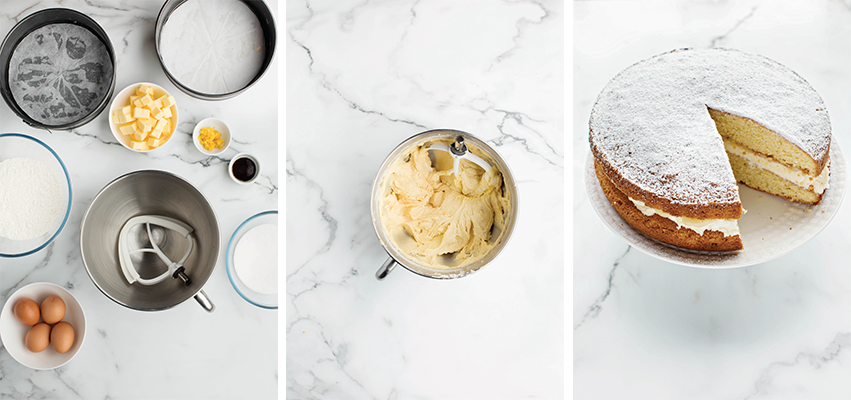
VICTORIA SPONGE WITH LEMON CURD
This is a slight twist on a classic Victoria sponge, but if you want to keep it traditional, then omit the lemon rind in the sponge and replace the lemon curd with your favourite strawberry jam.
SERVES 6–8
225g (8oz) butter, softened
200g (7oz) caster sugar
4 eggs
225g (8oz) self-raising flour
finely grated rind of 1 lemon
seeds of ½ vanilla pod or 1 tsp vanilla extract
¼ tsp baking powder
FOR THE BUTTERCREAM
200g (7oz) icing sugar, sifted
100g (4oz) butter, softened
seeds of ½ vanilla pod or 1 tsp vanilla extract
a drop of milk (if necessary)
FOR THE FILLING
7 tbsp shop-bought lemon curd
icing sugar, to dust
Preheat the oven to 180°C (350°F/gas mark 4).
Line 2 x 20cm (8in) loose-bottomed cake tins with
non-stick baking paper.
Put the butter and sugar into a large bowl and cream together. I find the best way to do this is to use a wooden spoon to push the mixture onto the side of the bowl until it’s mixed together, then beat it hard until the mixture turns from yellow to a paler shade. Alternatively, use a hand-held electric mixer or a freestanding electric mixer, which is
much easier and quicker.
Add two of the eggs to the butter mixture along with half of the flour and beat together until combined. Add the other two eggs and the rest of the flour along with the lemon zest, vanilla and baking powder and beat like mad to get a good amount of air into it.
Divide the batter between the prepared cake tins and bake in the oven for 25–30 minutes, until the cakes have shrunk slightly from the sides of the tin, spring back when touched in the centre and a skewer inserted into the centre of each one comes out clean. Once baked, remove from the oven and leave the cakes to cool completely in the tins.
While the cakes are cooling, make the buttercream. Cream together the icing sugar, butter and vanilla in a bowl until light and fluffy, adding a drop of milk to loosen it if necessary.
Once the cakes are completely cool, place one on a cake stand and spread the buttercream on top, followed by the lemon curd. Cover with the other cake and dust with icing sugar to serve.
NEVEN’S TOP TIP
To make this into a coffee cake, simply add 3 tablespoons of coffee essence to the batter with the vanilla and add another couple of teaspoons to the buttercream. Or try filling
the sponge with a chocolate hazelnut spread instead of the lemon curd.
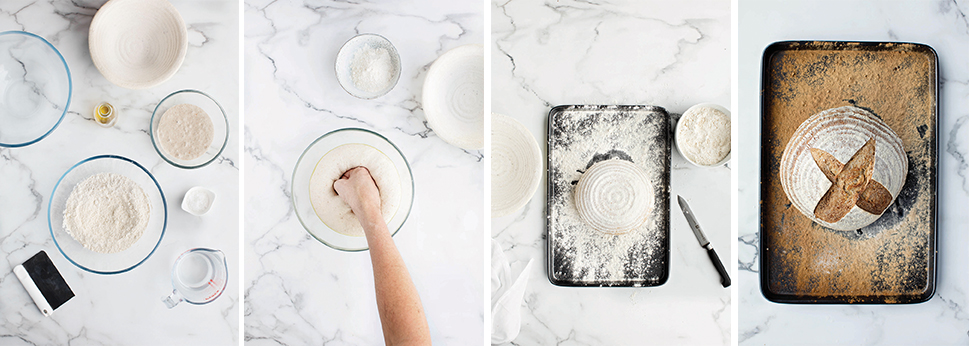
WHOLEMEAL SOURDOUGH
With a sourdough starter kept handy in the fridge, tasty, chewy bread can be yours on demand. It will take about a week to create, but with care and regular feeding it can last you a lifetime. I use rhubarb to help kick-start the fermentation, as it has plenty of natural yeast and always gives a successful result. On Day 5 of the process you will need to discard the leftover starter or pass it on to someone else to make their own. French bannetons – the woven, cloth-lined baskets traditionally used to prove bread – can be very expensive to buy, but a similar-sized wicker basket (approximately 24cm/9½in) lined with a linen tea towel also works well, as it allows for air circulation.
MAKES 1 LOAF
FOR THE STARTER:
50g (2oz) wholegrain rye flour
50g (2oz) strong white flour
150ml (¼ pint) warm water
25g (1oz) rhubarb, very thinly sliced (on a mandolin is perfect)
FOR THE DAILY FEED FOR DAYS 2 TO 4:
25g (1oz) wholegrain rye flour
25g (1oz) strong white flour
50ml (1½fl oz) warm water
FOR THE DAILY FEED FOR DAYS 5 AND 6:
125ml (4¼fl oz) warm water
75g (3oz) strong white flour
40g (1½oz) wholegrain rye flour
30g (1¼oz) wholemeal flour
FOR THE DOUGH:
375g (13oz) strong white flour, plus extra for dusting
250g (9oz) starter
1 tsp fine sea salt
120–175ml (4–6fl oz) warm water
olive oil, for kneading and greasing
DAY ONE
To make the starter, mix the flours in a bowl with your hands until combined. Put the water in a large Kilner jar or bowl with the rhubarb and use your hands to mix in the flours until it resembles a thick paste. Wrap this jar or bowl loosely in cling film and leave in a warm place for 24 hours.
DAY TWO
At around the same time the following day, mix the first batch of the daily feed, which is simply the flours and water, into your starter and leave somewhere warm, again loosely covered with cling film. If there is a bit of skin on top, just mix it in.
DAY THREE
Repeat as per Day 2.
DAY FOUR
By now you should start seeing active fermentation.
Repeat as per Day 2.
DAY FIVE
The starter should be bubbling away and smell tangy. Mix it to combine, then put 30g (1¼oz) of the starter into a larger bowl. Pick out any pieces of rhubarb and discard. Whisk in the water and stir in the flours until well combined. Cover loosely with
cling film and leave in a warm place for 24 hours. You don’t need the rest of the starter now, so you could gift it to friends and family if they’d like to have a go at making their own sourdough too or use it to make pancakes, pizzas or scones for a lovely tang.
DAY SIX
Repeat as per Day 5, again using only 30g (1 ¼ oz) of the starter.
DAY SEVEN
Now you can finally make your bread. To make the dough, combine the flour, starter and salt in a large bowl. Add the water a little at a time and mix with your hands to make a soft dough – you may not need all of the water.
Coat the work surface with a little olive oil, then tip the dough onto it and knead for 10–15 minutes, until smooth and elastic. Tip into a lightly oiled bowl and cover with cling film. Leave to rise in a warm place for 5 hours, until it has at least doubled in size.
Tip the dough back onto the work surface and knead again until smooth, knocking most of the air out. Roll into a ball and dust with flour. Put into a well-floured round banneton or proving basket (see the intro), then cover with a clean tea towel and place in a cool, not cold, place and leave to rise slowly for 8 hours.
Put a roasting tin half-filled with water on the bottom shelf of the oven and preheat to 220°C (425°F/gas mark 7). Dust a baking sheet generously with flour.
Gently tip the risen dough out of the basket onto the baking sheet. Using a small sharp knife, cut a cross into the top of the dough. Bake in the oven for 30 minutes, then reduce the oven temperature to 200°C (400°F/gas mark 6) and bake for another 15–20 minutes, until the loaf is golden brown, the outside crust is crisp and the bread sounds hollow when tapped on the base. Transfer the loaf to a wire rack and leave to cool for at least 1 hour before slicing and serving.
NEVEN’S TOP TIP
If you are using your starter often, you can leave it at room temperature, feeding it at least every three days and whenever you take some to make bread. Simply stir in some strong white flour and enough water to return it to the consistency of very wet dough, bearing in mind that you will need about 375g (13oz) of starter for each loaf of bread. Then leave it, covered, until it achieves that thick, bubbly, jelly-like stage. If you are making sourdough less often – say, once a month – then keep the starter covered in the fridge. This will slow down the activity and preserve it almost indefinitely, but you must let it come back to room temperature before use. If it ever seems inactive, give it a feed of strong white flour – the bacteria within it are living, so they need feeding
Georgina Campbell Cookery Feature - The Nordic Baking Book
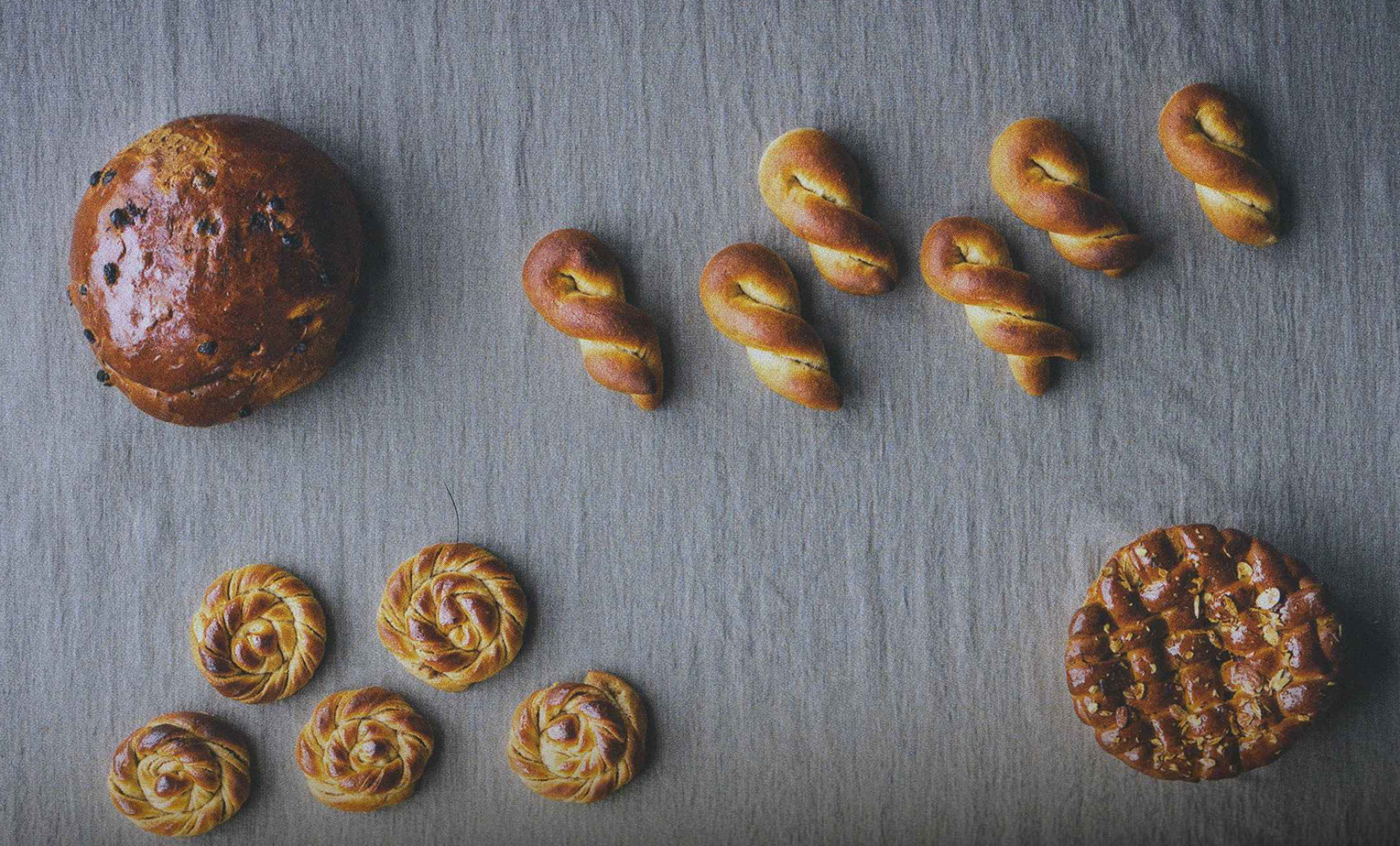
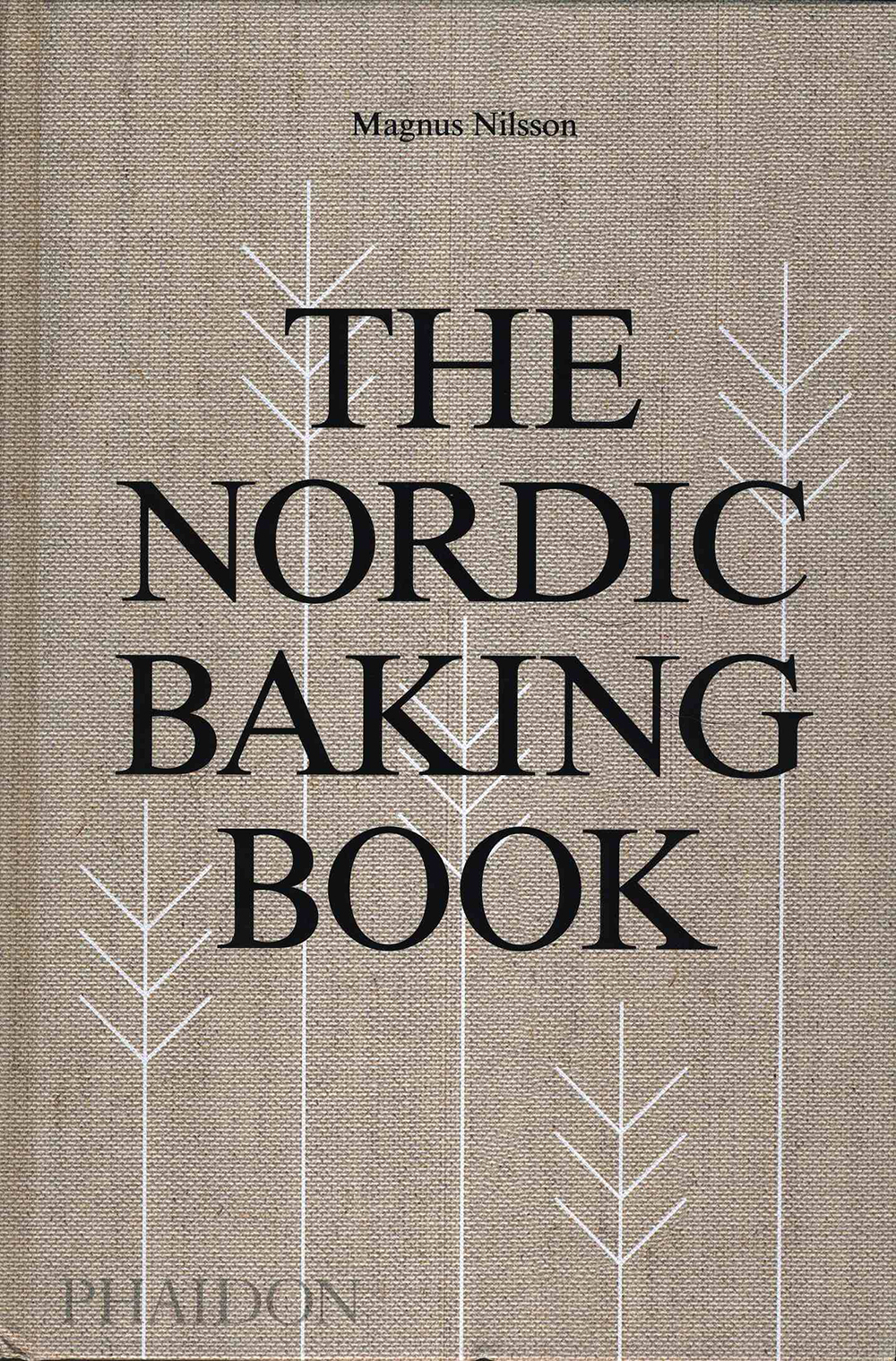 Traditional baking is always of special interest at this time of year, and there’s no better time to focus on specialities from the Nordic countries.
Traditional baking is always of special interest at this time of year, and there’s no better time to focus on specialities from the Nordic countries.
For the definitive reference, seek out the latest book by the acclaimed chef and photographer Magnus Nilsson of Fäviken Magasinet restaurant in Sweden, The Nordic Baking Book. Recently published by Phaidon, this handsome hardback includes over 450 recipes, 100 food and evocative landscape images (and a great deal of fascinating opinion and factual information) in its 576 pages. In its depth and detail, it reminds me a bit of Rory O’Connell’s books - there is the same determination to include everything that is needed rather than allow space restrictions to dictate short cuts. It would make the perfect gift for anyone with an interest in baking, in Nordic cuisine, or in food and culture generally - and, like all good books, it’s a bargain: this magnificent tome costs just €39.95 (£29.99).
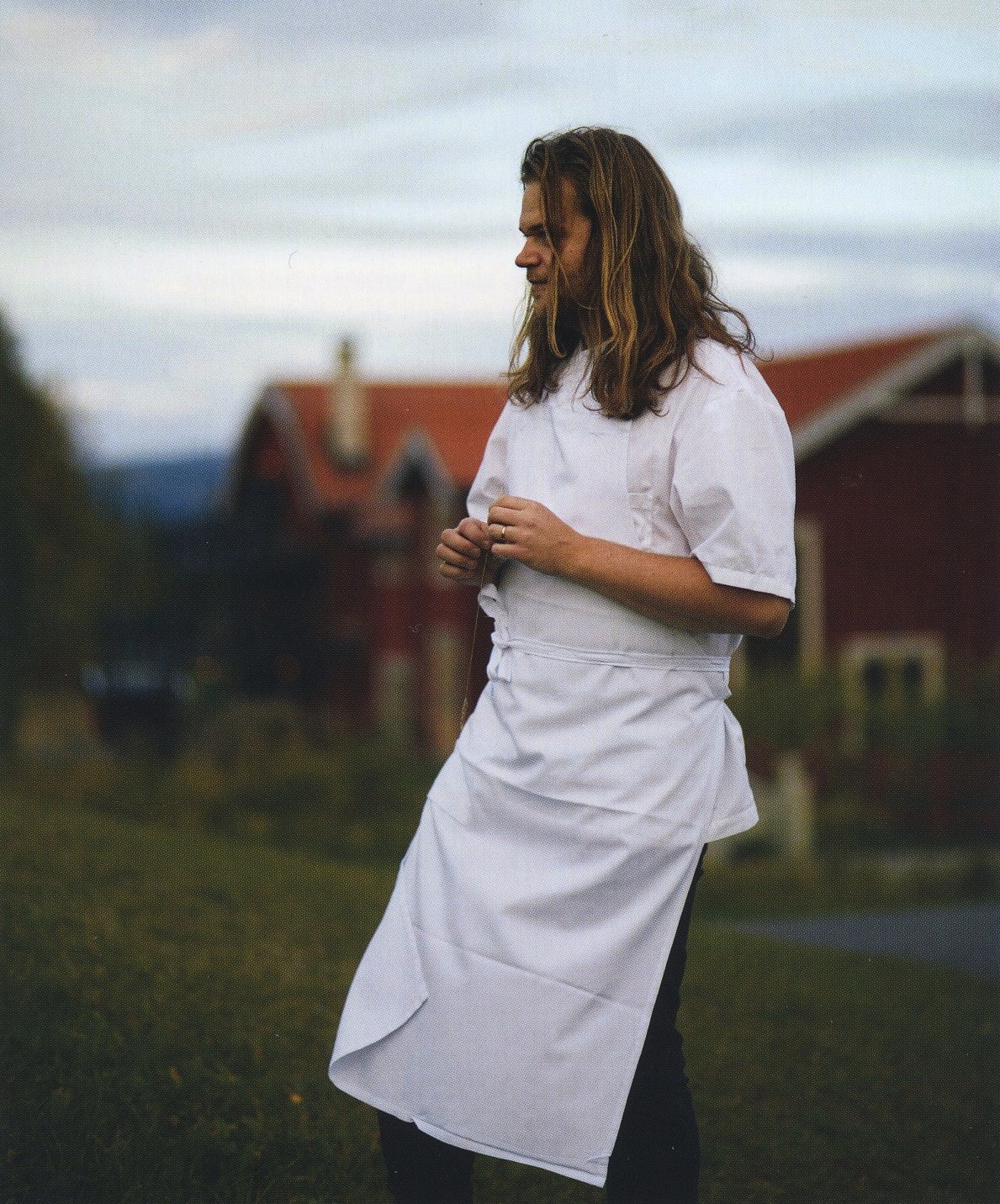 ‘I am more of a cook than a baker, which I think makes me well suited to write a book about baking’ states Magnus Nilsson - meaning that he doesn’t make assumptions. This, and his insatiable curiosity, make him a very good companion for readers sharing his travels throughout the Nordic countries - Denmark, the Faroe Islands, Finland, Iceland, Norway, and Sweden. While visiting bakeries and home cooks, talking to food experts, professional bakers and historians, and documenting the local baking traditions in this vast region, he also collected the hundreds of traditional and modern recipes that would be transformed into consistent references by hands-on bakers, including his wife Tove and Petrus Jakobsson of the famous Petrus Bakery in Stockholm.
‘I am more of a cook than a baker, which I think makes me well suited to write a book about baking’ states Magnus Nilsson - meaning that he doesn’t make assumptions. This, and his insatiable curiosity, make him a very good companion for readers sharing his travels throughout the Nordic countries - Denmark, the Faroe Islands, Finland, Iceland, Norway, and Sweden. While visiting bakeries and home cooks, talking to food experts, professional bakers and historians, and documenting the local baking traditions in this vast region, he also collected the hundreds of traditional and modern recipes that would be transformed into consistent references by hands-on bakers, including his wife Tove and Petrus Jakobsson of the famous Petrus Bakery in Stockholm.
He also found himself unexpectedly having to define baking for the book - and, far from limiting the scope to food baked in an oven, he decided to include all the other ‘need to know’ items to make it a comprehensive reference. Yet, thanks to a strong team including a much-respected editor, it isn’t a sprawling work - the content is well managed to give a real sense of the shared culinary culture (“the Swedes have fika, the Danes have pastries and the Finns need something sweet to go with their coffee”) with some fascinating background information about ingredients, and things you might not ever have thought about such as how meals relate to the length of daylight hours. And the recipes are varied, simple and easy-to-follow. There are all kinds of delicious breads, pastries, cakes, buns and flatbreads, both sweet and savoury - and as well photographs, there are detailed illustrations of traditional techniques such as step-by-steps for shaping cinnamon buns, making saffron braids and building a gingerbread house.
Christmas baking traditions are very strong in the Nordic countries and, while there is no dedicated section, recipe introductions frequently refer to the festive specialities, perhaps also explaining the occasion, or how they are likely to be paired with other foods or drinks.
SAMPLE RECIPES: The page references to related items and Basic Recipes have been left in the recipes below to show how cross-referencing is used in the book.
%20p285%20MR.jpg) NORWEGIAN CHRISTMAS BREAD
NORWEGIAN CHRISTMAS BREAD
Julekake (Norway)
Julekake is a sort of sweet and rich wheat bread, leavened with yeast. It is flavoured with cardamom and often filled with dried and candied fruits. Julekake is traditionally served for Christmas with different toppings, which can be either sweet or savoury. I have also seen a few recipes flavoured with saffron, a bit like the Swedish Saint Lucy's Day Saffron Buns (page 276).
Preparation time: 45 minutes
Rising time: 50 minutes
Cooking time: 30-40 minutes
Makes: 2 loaves
150 g/5 oz (1 stick plus 2½ tablespoons) butter
500 ml/17 fl oz (2 cups plus 2 tablespoons) milk
50 g/2 oz fresh yeast (pages 58-61)
650 g/1 lb 7 oz (4/2 cups) strong wheat flour, plus extra for dusting
140 g/4¾ oz (2/3 cup plus 1 tablespoon) sugar
½ teaspoon salt
2 teaspoons ground cardamom
150 g/5oz (1¼ cups) raisins or other dried or candied fruits
Egg Wash (page 73-4)
Melt the butter slowly in a medium pan. Pour in the milk and warm very gently to a temperature of about 37°C/98.6°F. Add the yeast and stir to dissolve.
Pour the mixture into the bowl of a stand mixer. Add the flour, sugar, salt and cardamon. Knead with the dough hook until the dough is shiny and smooth and comes away from the sides of the bowl. Cover the bowl with a clean dish towel and leave to rise for 30 minutes, or until almost doubled in size.
Line 2 baking sheets with baking (parchment) paper. Place the dough on a lightly floured work counter and add the dried fruits. Work the dough by hand until the fruits are evenly incorporated. Divide the dough in half and shape into 2 large round buns. Place them on the prepared baking sheets. Cover with a clean dish towel and leave to rise for about 20 minutes, or until doubled in size.
Preheat the oven to 175°C/345 F/ as mark 4.
Brush the buns lightly with the egg wash and bake for 30-40 minutes. They should have a nice golden colour to them when ready.
MAGNUS'S GLOGG (VERSION 1*)
Many old recipes for mulled wine in the Nordic state that you are supposed to make a kind of essence from the aromatics and hard liquor that you add to the sweetened wine. I prefer to mix everything together and keep it in a glass jar rather a bottle, aromatics macerating in the wine itself before being strained as you pour the glogg
into a pot to heat and drink it.
Choose a young red wine, not too tannic and not too oaky. I like to use a not-too expensive Burgundy or another pinot noir of that style. For the brandy,
do not use a too-oaky one, but rather a young fruity kind. Often a simpler and cheaper one from the bottom range of the brands is perfect.
Preparation and cooking time: 30 minutes
Macerating time: at least a week
Makes: 1 litre 34fl oz (4½ cups)
750 ml/25 fl oz (3 cups) young red wine
1 knob fresh ginger
1 vanilla bean
5 cardamom pods
20 cloves
2 cassia cinnamon sticks
10 black peppercorns
1 orange, sliced (rind and all)
1 lemon, sliced (rind and all)
100 ml/3½ fl oz (1/3 cup plus 1 tablespoon) sweet Madeira
150 g/5 oz (¼ cup) sugar
a dash of Cognac or Calvados
3 tablespoons honey, or to taste
Combine all of the ingredients, except the honey, in a sterilised, lidded glass jar. Seal tightly and leave to macerate for at least a week. Agitate the jar from time to time so that the sugar doesn't just sit at the bottom but dissolves into the wine.
When you are ready to drink the wine, strain it through a fine-mesh sieve straight into a pot. You don't have to use it all at once; you can strain just the amount you need and leave the rest to continue macerating. If the spices become too strong, then add a splash more red wine as you heat it, and perhaps some extra sugar. Heat the wine gently, adding honey until you think it is sweet enough.
[*Magnus’s Glogg Version 2 is an alcohol-free version, which he makes with blackcurrant cordial]
SCANIAN THICK AND CHEWY GINGERSNAPS
Skanepepparkaka (Sweden)
I love these gingersnaps spread with salty butter and mature hard cheese, for a snack with coffee on the side. They should be chewy, and for them to remain so, you need to store them in an airtight container.
Preparation and cooking time: I½ hours
Resting time: 2 days
Makes: about 25 gingersnaps
80g/3oz (¼ cup plus 2 tablespoons) sugar
210 g/7¼ oz (2/3 cup) golden syrup or molasses
75 / 2¾ oz (5 tablespoons) butter
I pinch of salt
1 teaspoon ground ginger
1 teaspoon ground cloves
1 teaspoon ground cinnamon
50m/2 fl oz (3½ tablespoons) milk
400g/14 oz (3¼ cups) weak (soft) wheat, plus extra for dusting
1 teaspoon baker's ammonia
1 teaspoon baking powder
Combine the sugar, golden syrup or molasses, butter and spices in a pan and melt over a medium heat, stirring continuously. Remove from the heat add the milk to the mixture. Stir continuously until it cools almost to room temperature. Add the egg and mix until fully incorporated.
Transfer the mixture to the bowl of a stand mixer. Sift the flour and leavening agents together into a bowl and beat until properly combined, but not any longer. Tip the dough out of the bowl wrap it in clingfilm (plastic wrap). Refrigerate 48 hours.
Preheat the oven to 200°C/400°F/Gas Mark 6 and line several baking sheets with baking (parchment) paper.
Unwrap the chilled dough and place it on a lightly floured work counter. Shape into a long log and cut into 25 slices. Shape each slice into a little ball, then place on the prepared baking sheets, flattening them gently with the palm of your hand.
Bake the gingersnaps for 12-15 minutes, until they are cooked, but not dry. Once they start to brown a little around the edges they are generally done. Remove from the oven and leave to cool.
Marmalade - the Bitter-Sweet Breakfast Treat

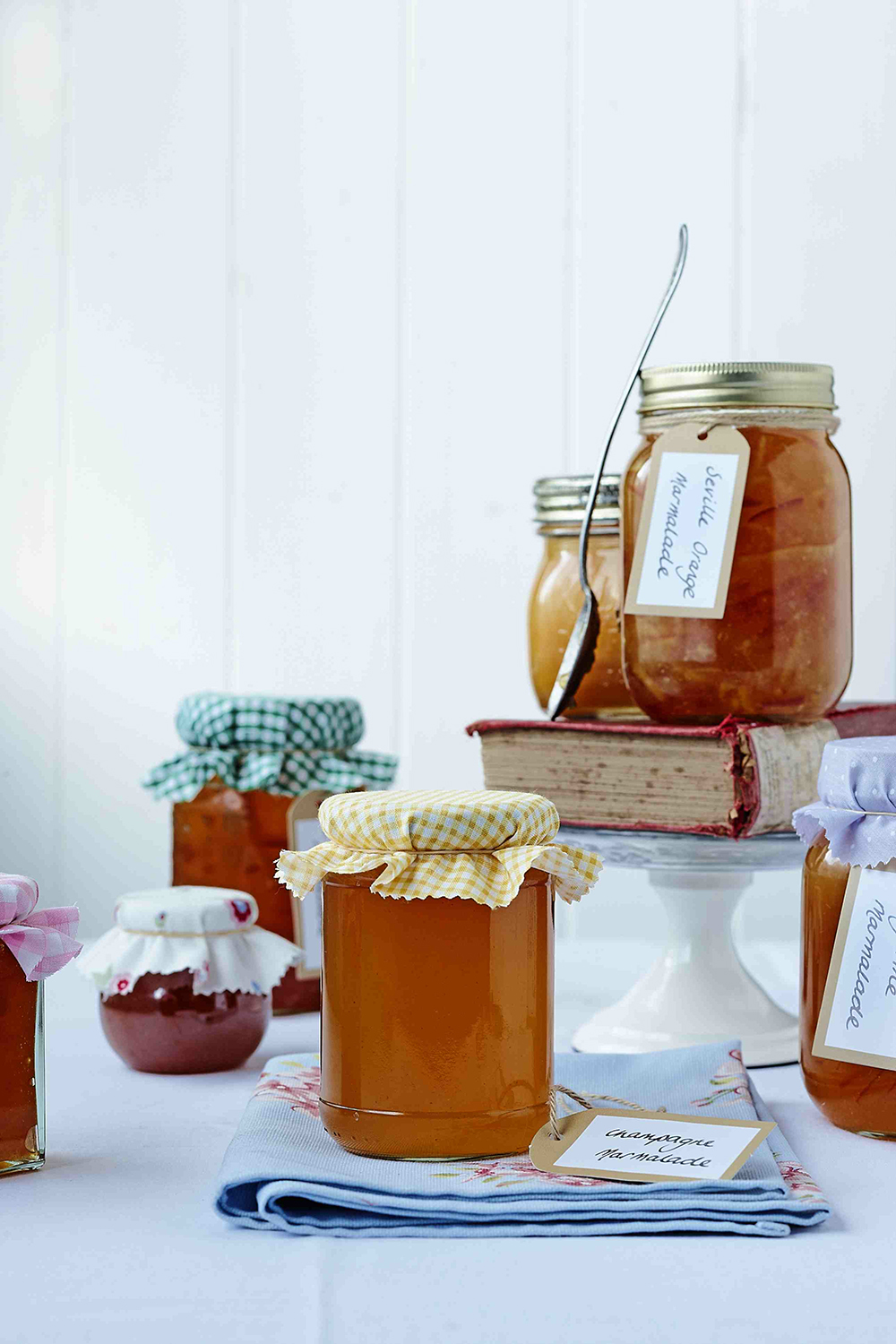 Now that most foods are available at any time of year, it’s hard to recall the excitement that the beginning of a new season used to generate.
Now that most foods are available at any time of year, it’s hard to recall the excitement that the beginning of a new season used to generate.
But there is still one exception to the rule that you can have whatever you like whenever you like: the season for Seville oranges and their other bitter relations is still very much a flash in the pan and that's the way it looks like staying. They’re usually only in the shops for about six weeks from late December, so don't leave them at the bottom of your list.
Interestingly, although the more common sweet orange was a much later arrival in Europe, the bitter orange - of which the best-known variety, the Seville, comes from Spain - was known to the Greeks and Romans. As far as we know they did not make marmalade with them however - that didn't come along until about 1700 in (of course) Dundee - and it’s been a favourite breakfast treat ever since. What could be more delicious than a slice of wholemeal or sourdough toast with butter and tangy homemade marmalade - or perhaps a marmalade muffin to go with your coffee?
Making your own marmalade is very satisfying and, once you do it, you'll be hooked for life - even the best of bought can't compare with the fresh tangy flavour of home-made marmalade and it isn't hard to make either. And, just as good freshly baked bread makes an impression out of all proportion to the effort involved, serving homemade marmalade - and preserves - can be a great little USP in hotels and guesthouses, or anywhere that serves breakfast.
And, cold and grey as it may be outside, the aroma of marmalade through the house has a wonderful way of evoking the warmth and colour our oranges have left behind. A lovely way to spend a wintry afternoon.
Even if you haven't the time to make marmalade at the moment, the oranges freeze well so get them before they disappear - and then make sure that you choose a recipe which involves cooking the oranges whole (see below). Freeze them in weighed batches, adding an extra orange or two per batch to allow for any loss of pectin during storage if they're likely to be in the freezer for a long time - or, if you leave them longer than anticipated, you can add a couple of sweet oranges or grapefruit at the time.
Hints for success:
- Cooking citrus fruit takes much longer than other fruits because of the thickness of the peel, so a lot more water is needed to allow for evaporation. By the end of the first cooking stage, the contents of the pan should be reduced by half and the peel must be very soft - once the sugar is added, the peel will not soften any more.
- Pectin and acid content is important to obtain a good set in all jam and marmalade making; lemon juice is added to Seville orange marmalade to supply the extra acid needed to get a good set and prevent crystallisation.
- When the sugar is added it must be dissolved over low heat before bringing the temperature up to the boil. Once dissolved, a fast rolling boil is needed to bring the marmalade up to setting point. To allow for safe fast boiling, the reduced pulp should not come more than halfway up the pan. (A big heavy-based pan that is suitable for preserves will be useful for plenty of other things too and is a good investment, but it’s also worth considering sharing one with friends.)
- The longer you boil, the darker the colour and more 'mature' the flavour, but over-boiling makes a half-set, syrupy preserve. If your marmalade has reached setting point and you prefer it darker, add a little treacle instead of boiling it for longer.
- Setting point is reached when a sugar thermometer reaches 222ºF/ 105ºC, or simply when a little jam cooled on a cold saucer wrinkles when pushed with a finger or spoon.
- To keep well, the marmalade must be poured into jars which are clean, dry and warm, then left until completely cold before covering. Store in a cool, dark place.
RECIPES:
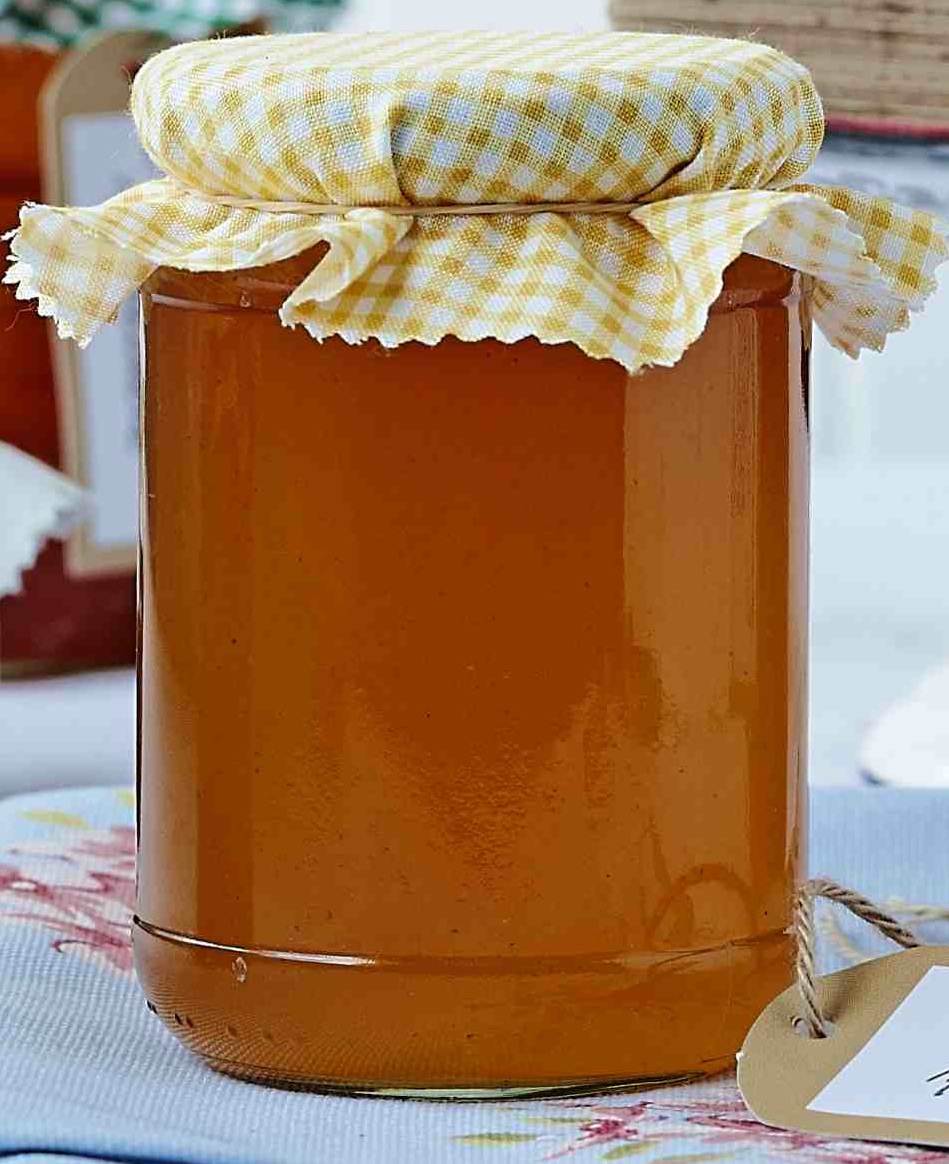 FAVOURITE MINCER MARMALADE
FAVOURITE MINCER MARMALADE
This has been my go-to recipe (and a favourite in my books) for as long as I can remember, as it is easy and convenient, whether made with fresh or frozen oranges - and the flavour is great. Quantities given make about 4.1 Kg/9 lb marmalade, but it’s worth doubling them if you have a suitable pan.
1.4 Kg/ 3 lb Seville, or other bitter oranges
3 litres/ 5 pints water
2.7 Kg/ 6 lb granulated sugar
2 large lemons.
Squeeze the lemons and reserve the juice. Scrub the oranges and pick the discs off the stalk ends, then put the whole oranges and lemon peel into a large, heavy-based pan and cover with 2.3 litres / 4 pints of the water. Cover, bring to the boil, reduce the heat and simmer for about 1½ hours, or until the peel is quite soft.
Lift the oranges and lemon peel out with a slotted spoon, reserving the liquid. Halve the oranges as soon as they are cool enough to handle and scoop out the flesh and pips into a small pan. Add the remaining l pint/600ml of water, bring to the boil and simmer for 10 minutes to extract the pectin from the pith and pips. Cut up the softened peel as coarsely or as finely as you like, or put it through the coarse blade of a mincer. (This looks messy at the time, but works out fine when cooked).
Put the prepared peel back into the pan containing the cooking liquid, then add the sugar, lemon juice and the strained juice from the pith and pips mixture.
Stir over low heat until dissolved (this will be quicker if the sugar has been warmed in a low oven beforehand), bring to the boil and boil fast for about 15-20 minutes until setting point is reached. (105ºC /222ºF on a sugar thermometer, or when a sample, spooned onto a cold plate and left a few minutes to cool, crinkles when pushed with a teaspoon).
Take the pan off the heat and allow to cool for 10-15 minutes, then stir well to distribute the fruit evenly and use a small jug to pour it into clean warm jars. Small waxed discs may be put on top of the marmalade immediately, but don't cover with cellophane or lids until absolutely cold, as condensation can cause mould during storage. Label and store in a cool, dark place.
SEVILLE ORANGE MARMALADE is made by the traditional method, where the orange peel is shredded before cooking, so it looks prettier than my usual short-cut version with minced peel.
1.4 Kg/3 lb Seville oranges (or any 'bitters')
Juice of 2 large lemons
3 litres /5 pints water
2.7 Kg/ 6 lb granulated sugar.
Scrub the oranges well and remove the small disc at the stalk end. Halve the fruit and squeeze the juice; put the pips into a large square of muslin. Quarter the peel and cut away any thick white pith; add it to the pips in the muslin and tie loosely so that it can hang in the pan with the water circulating through it to extract the pectin. Shred the peel finely. Place the peel, orange and lemon juice, the muslin bag of pith and pips and the water in a preserving pan. Bring to the boil and simmer gently for 1½-2 hours or until the peel is quite tender, then remove the bag of pith and pips and squeeze it well over the pan (eg by pressing between two dinner plates) to extract as much pectin as possible. Add the sugar and stir over low heat until it has completely dissolved.
Bring to the boil and boil fast for a set - about 15-20 minutes. When setting point (105ºC / 222ºF) is reached, a small sample spooned onto a cold plate and left a few minutes to cool will crinkle when pushed with a teaspoon.
Allow the marmalade to cool in the pan for 20 minutes, then stir so that the peel will be evenly distributed. Pour into warm, dry jars and cover with wax discs immediately but leave until absolutely cold before sealing, otherwise condensation might form and cause mould in storage. Store in a cool, dark place. Makes about 10 lb.
Variation: To make a darker ‘Vintage’ Marmalade replace a quarter of the white sugar with brown. Alternatively, 1 or 2 tablespoons black treacle could be added to the mixture above during the final boiling.
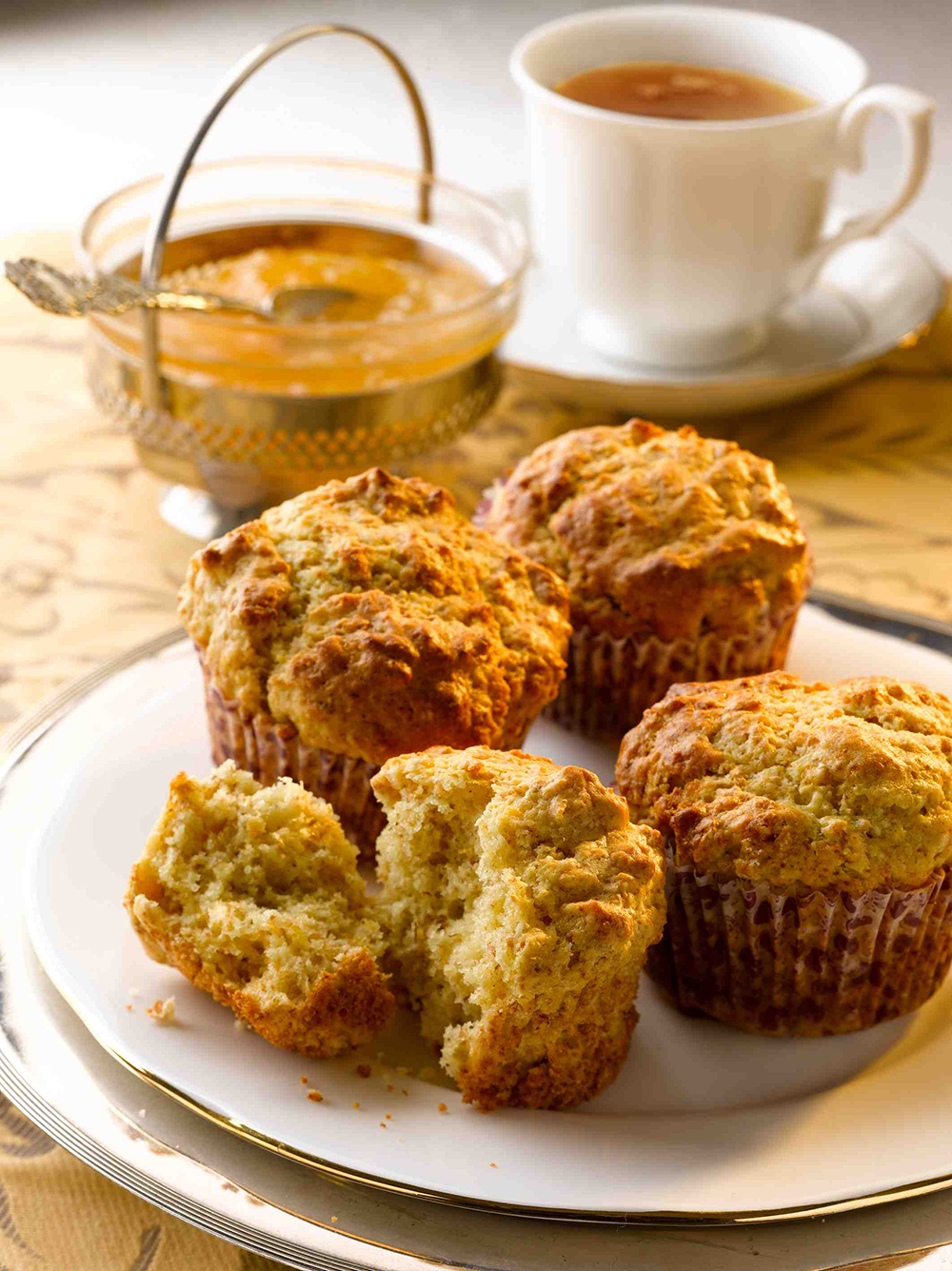 MARMALADE MUFFINS
MARMALADE MUFFINS
The trick to fluffy muffins is to fold the wet and dry ingredients together as briefly as possible until just combined; don’t worry if the mixture still looks a little lumpy. These muffins are best served on the day they are made, although they can be frozen. You could also try making them with lemon curd.
Makes 12
75g/ 3oz butter
225g/8 oz plain flour
1 tbsp baking powder
¼ tsp bread soda
Pinch of salt
100g / 4oz stone-ground wholemeal flour
120ml/ 4½ fl oz milk
5 tbsp natural yoghurt
2 eggs, beaten
Finely grated rind of 1 orange
100g/ 4oz marmalade
Preheat the oven to Gas Mark 4, 180ºC (350ºF).
Line a muffin tin with deep paper cases.
Melt the butter in a small pan or in the microwave. Remove from the heat.
Sift the plain flour, baking powder, bread soda and salt into a bowl, and then stir in the wholemeal flour.
Beat together the milk, yoghurt, eggs, warm melted butter and orange rind.
Make a well in the dried ingredients and stir in this mixture along with the marmalade.
Spoon the mixture out, dividing equally between the paper cases, and bake for 20-25 minutes until well risen and golden brown.
Leave to cool for five minutes, then serve warm with tea or coffee.
Irish Food Writers' Guild Food Awards Celebrate Indigenous Deliciousness!
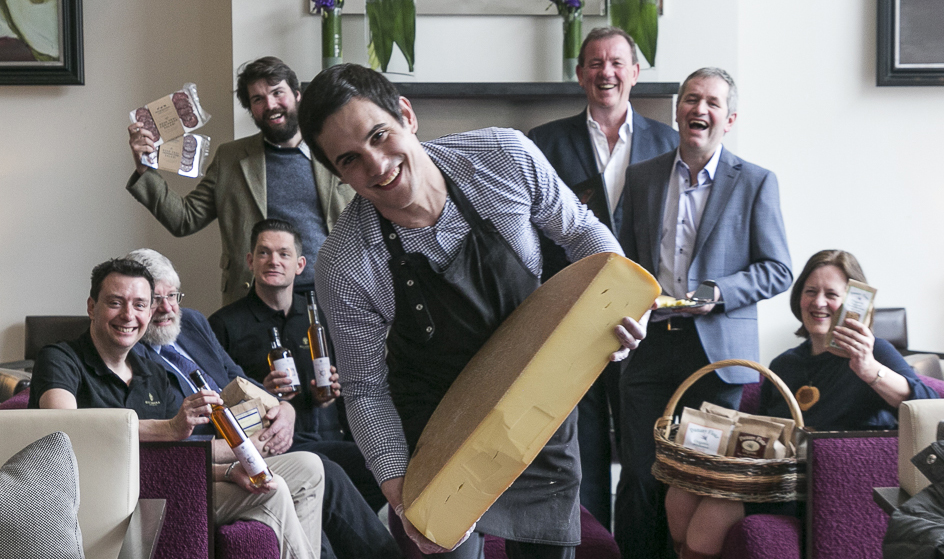
.jpg)
Now in their 25th year, the annual Irish Food Writers’ Guild Food Awards were held this month - and the main message from IFWG Chairperson, Kristin Jensen, was a call for more support for indigenous Irish food producers as the threat of Brexit looms:
“With the food industry gearing up for the impact of Brexit and the threat of UK tariffs a real possibility, it is incumbent on us all, government, industry and consumers, to protect and support our abundance of incredible food producers, who have played a significant role in helping to position Ireland as a food tourism destination.”
Supported by Bord Bia, the IFWG Food Awards celebrate indigenous food producers and organisations who help to build and maintain Ireland’s outstanding reputation in food and drink. This year, eight producers have been singled out for awards - including three from Northern Ireland, demonstrating the all-island approach that, as a nation, we take to food production, supply and quality standards.
This year’s winners include cheesemakers from both sides of the border; organic spelt berries from a farm in Louth; a rare apple ice wine made in Cork; a well-known Dublin coffee brand; a goat farm in Antrim; one of Cork’s oldest charitable organisations; and one of Ireland’s best-known butchers and food champions, who was born in Kildare and operates from Armagh.

“Each year, the IFWG singles out a select number of products and organisations that evoke pride in our national food identity and contribute to our rich and diverse food culture. Many of these are small businesses and, together with everyone in the food industry, they have major concerns over what is coming down the track following Brexit later this month. Therefore, I urge all sectors of society to embrace sourcing, buying and eating local, high-quality produce and ensuring that all our wonderful producers survive and continue to thrive as they face into a period of great uncertainty. I believe we owe it to them and to ourselves as a great food nation to continue flying the flag for the fantastic range of Irish produce that is available on our own doorstep,” said Kristin Jensen.
The winners of the 2019 IFWG Food Awards are:
Food Award: Hegarty Cheese for Teampall Gael Cheese (Co. Cork)
Founded by brothers Dan and John Hegarty, Teampall Gael cheese is a cloth-bound, one-year-old cheese made with milk from the family’s dairy farm and their own Friesian cows, making the cheese fully traceable from field to finished product.
The brothers make their cheese using traditional methods, milling and salting the curds by hand and wrapping the cheese in muslin and lard. The result is a Comté-style raw milk cheese with a sweet, delicate, nutty flavour and crumbly texture. Only summer’s milk is used in the production of this cheese.
Food Award: Mike Thomson for Young Buck Cheese (Co. Down)
Mike Thomson raised £80,000 through crowdfunding to start making Young Buck, Northern Ireland’s first raw-milk blue cheese. The milk for the cheese is sourced from a small farm 10 miles from Mike’s home in Co. Down. 600 litres of milk are collected daily to create just 27 wheels of Young Buck a week. The cheese is based on a Stilton recipe, with a strong, salty flavour and a characteristic knobbly crust. Website: www.mfcheese.com
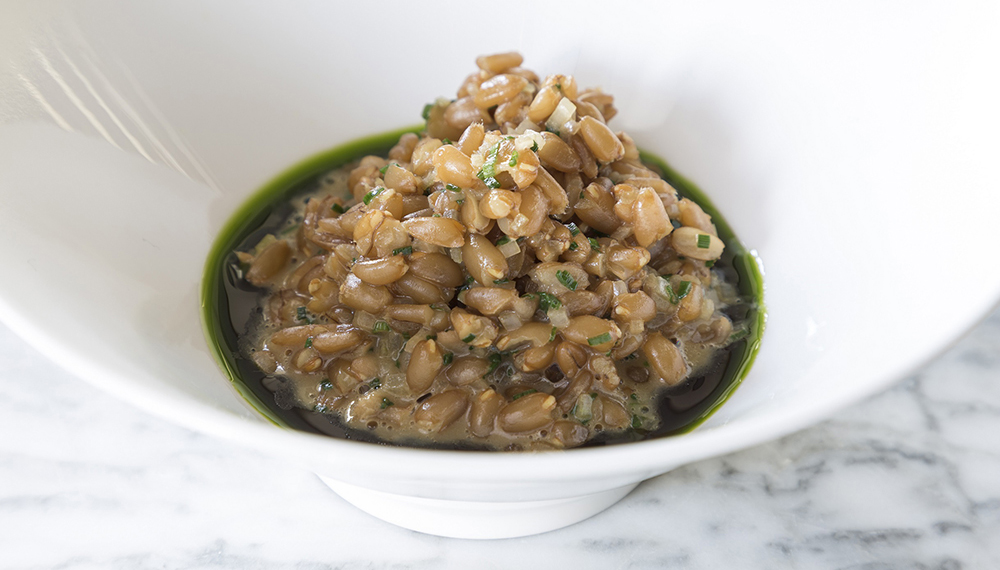
Food Award: Dunany Flour for Organic Spelt Berries (Co. Louth)
The Workman family’s Dunany Farm is a traditional fourth-generation enterprise, producing organic grains since 2006. Best known for their flours, the Workmans are innovative and experimental and recognised a gap in the market for growing spelt in Ireland. High in fibre and B vitamins and low in gluten, Dunany organic spelt berries are a unique and versatile Irish-grown wholegrain and a great alternative to imported grains. Website: www.dunanyflour.com
Irish Drink Award: Killahora Orchards for Rare Apple Ice Wine (Co. Cork)
Killahora Orchards is a family business founded on an estate dating back to 1837, where more than 130 varieties of apple and 40 perry pear varieties are grown. Always pushing the boundaries of what can be made with Irish fruit, the range includes craft cider, apple port, perry and their premier drink, for which they are being awarded, Rare Apple Ice Wine. It is made by slowly freezing apples and then thawing the pressed apple juice to create a richer must than you would get from regular pressing. It is then partially fermented to keep the natural sugars intact. It is recommended as a dessert wine but works equally well with pork and cheeses. Website: www.killahoraorchards.ie
Outstanding Organisation Award: 3fe (Co. Dublin)
Colin Harmon quit a career in finance in 2008 to devote himself to coffee. By 2009 he had won the Irish Barista Championships, placed 4th in the World Barista Championships and opened 3fe in the lobby of the Twisted Pepper nightclub in Dublin. He now supplies to more than 50 businesses and runs three cafés, a restaurant and roastery facility. 3fe is being awarded for the company’s commitment to sustainability in the areas of waste and energy use, purchasing principles, staff welfare and community. Website: www.3fe.com
Environmental Award: Broughgammon Farm (Co. Antrim)
The Broughgammon Farm rears male goats that would have otherwise been put down at birth to product delicious and healthy cabrito kid goat meat. The farm believes in a sustainable, local food chain and as such encourages back-to-basics, nose-to-tail, fork-to-field and seasonal eating. They now rear free-range rosé veal and seasonal wild game as well. Their Environmental Award is in recognition of their exceptional commitment to the environment, which goes above and beyond their ethical farming practices.Website: www.broughgammon.com
Community Food Award: Cork Penny Dinners (Co. Cork)
Cork Penny Dinners was founded during famine times in the 1840s and is one of Cork’s oldest charitable organisations. Their core service is to offer a nourishing hot meal in a safe environment to all those in need. Currently they serve up to 2,000 freshly made meals each week. The charity will soon have the opportunity to expand its services as it plans to move to James Street to offer educational opportunities; a full music programme; a clinic operated on a rotating, voluntary basis by 52 local GPs; classes in sewing, cooking and repair; and assistance in everyday administrative tasks.
Website: www.corkpennydinners.ie
Lifetime Achievement Award: Peter Hannan (Co. Armagh)
Peter Hannan grew up on a beef and sheep farm in Co. Kildare and founded Hannan Meats in 1991. Hannan Meats still serves its first five clients as well as some of the finest establishments in the UK, Ireland, France, Holland, Belgium and Switzerland. Provenance is one of the guiding principles of Peter’s business, and he works closely with a network of almost 150 of the best beef farmers in Northern Ireland and the Republic to produce the highest-quality meat. The Irish Food Writers’ Guild is proud to present Peter with a Lifetime Achievement Award in recognition of his continued work as one of Ireland’s most dedicated and highly respected food champions. Website: www.hannanmeats.com
The IFWG Food Awards are unique, as no one can enter themselves or their product into the awards and no company knows it has been nominated or shortlisted for an award. The Guild is the sole nominating and decision-making body. The exception to this is the Community Food Award, for which the Guild invites nominations every year from the general public as well as their own members.
Lunch menu devised by Andy McFadden of Glovers Alley and incorporating the 2019 award-winning produce. Paired with wines kindly sponsored by Liberty Wines.
• Broughgammon Farm Goat Shoulder, Waldorf Salad
• Dunany Organic Spelt Risotto
• Peter Hannan’s Salt-Aged Glenarm Beef Sirloin, Salt-Baked Celeriac, Hazelnuts and Truffle
• Killahora Orchards Rare Apple Ice Wine Granita, Sheep’s Yogurt Mousse, Honey and Lime
• 3fe Coffee Crémeux, Jivara Chocolate and Citrus
• Teampall Gael and Young Buck Cheese, Rhubarb and Apple Chutney
RECIPES:
Recipes created for the Irish Food Writers’ Guild Food Awards 2019 by executive chef Andy McFadden of Glovers Alley, 128 St Stephen’s Green, Dublin 2:
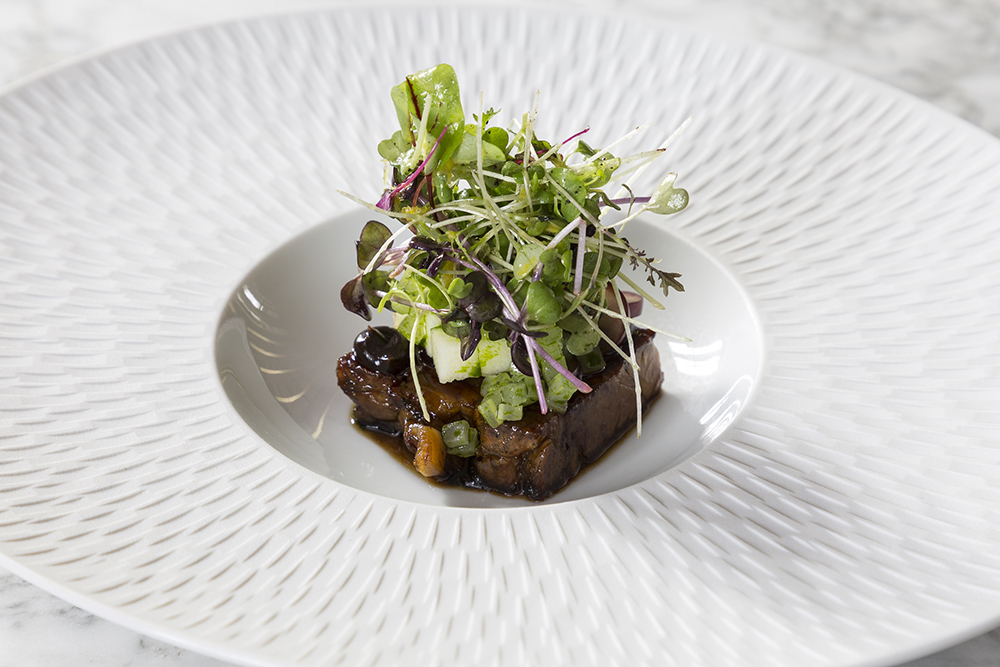 Broughgammon Farm Goat Shoulder, Waldorf Salad
Broughgammon Farm Goat Shoulder, Waldorf Salad
1 Broughgammon Farm goat shoulder
2 garlic cloves
2 bay leaves
a few sprigs of fresh rosemary
500ml water
125ml white wine
sea salt and freshly ground black pepper
Maldon sea salt, to serve
For the glaze:
60g goat fat, trimmed from the shoulder, or unsalted butter
45g treacle
For the spiced oil:
20g black mustard seeds
20g fennel seeds
50ml vegetable oil
1 garlic clove, peeled and left whole
For the Waldorf salad:
75g walnuts
1 celery heart, chopped
1 eating apple, e.g. Granny Smith, cored and cut into 1cm pieces
100g seedless black grapes, halved and toasted
micro leaves or baby salad leaves
Preheat the oven to 150°C.
Put the goat shoulder in a deep roasting tray. Scatter around the garlic, bay leaves and rosemary, then pour in the water and wine. Season the goat with salt and pepper, then loosely cover the roasting tray with foil. Roast in the oven for 2 hours. Remove the foil and roast for 1 hour more, until the goat is meltingly tender.
Remove the goat shoulder from the tray and press between two large baking sheets weighted down with a few tins of food. Refrigerate for at least 6 hours.
To make the spice mix, warm the mustard seeds in a dry pan over a gentle heat, shaking the pan constantly. The seeds will eventually puff slightly and crack. Once they reach this stage, remove from the heat and grind in a pestle and mortar. Tip back into the warm pan off the heat. Add the fennel seeds and allow them to warm in the residual heat of the pan. In a separate pan, warm the oil slightly with the garlic clove. Take the pan off the heat and add the spices to the oil.
To make the glaze, gently melt together the goat fat or butter and the treacle in a saucepan until combined.
To make the Waldorf salad, put all the ingredients in a bowl and toss gently to combine.
To serve, cut the pressed goat shoulder into neat squares and brush all over with the glaze. Finish the squares on a hot pan until heated through and nicely coloured. Put a square of goat shoulder on a serving plate. Spoon over the spiced oil and season with Maldon flaky sea salt. Finish with a small handful of the Waldorf salad on top.
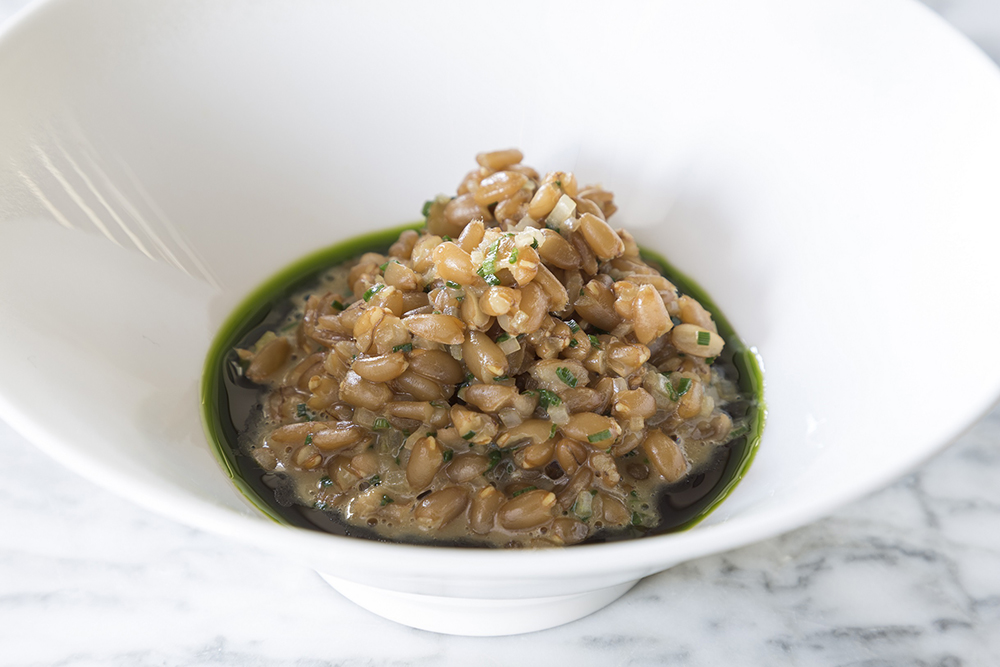 Dunany Organic Spelt Risotto
Dunany Organic Spelt Risotto
Serves 4
200g Dunany Organic Spelt Berries
25g dried porcini mushrooms
1½ tsp olive oil
2 shallots, finely chopped
2 garlic cloves, finely chopped
100ml white wine
1 litre hot vegetable stock
1 tbsp crème fraiche
handful of grated Parmesan cheese
finely snipped fresh chives
sea salt and freshly ground black pepper
parsley oil or fresh flat-leaf parsley, finely chopped, to serve
Cover the spelt with cold water. Put the dried mushrooms in a separate heatproof bowl and soak in 100ml of just-boiled water. Allow the spelt and mushrooms to soak for 20 minutes.
Heat the olive oil in a large frying pan over a medium heat. Add the shallots and garlic and cook for 2 minutes. Drain the spelt and add to the pan along with the wine. Simmer until almost all the wine has evaporated, stirring often.
Drain the porcini mushrooms over a bowl so that you can reserve the soaking liquid, then discard the mushrooms. Add the soaking liquid to the vegetable stock. Stir the stock into the spelt berries a ladleful at a time and simmer, stirring often, until all the liquid has been absorbed and the spelt is tender. This will take about 20 minutes in total.
Stir in the crème fraîche, Parmesan and chives, then season to taste with salt and pepper. Divide the risotto between warmed bowls and drizzle over the parsley oil or scatter over some chopped fresh parsley. Serve straight away.
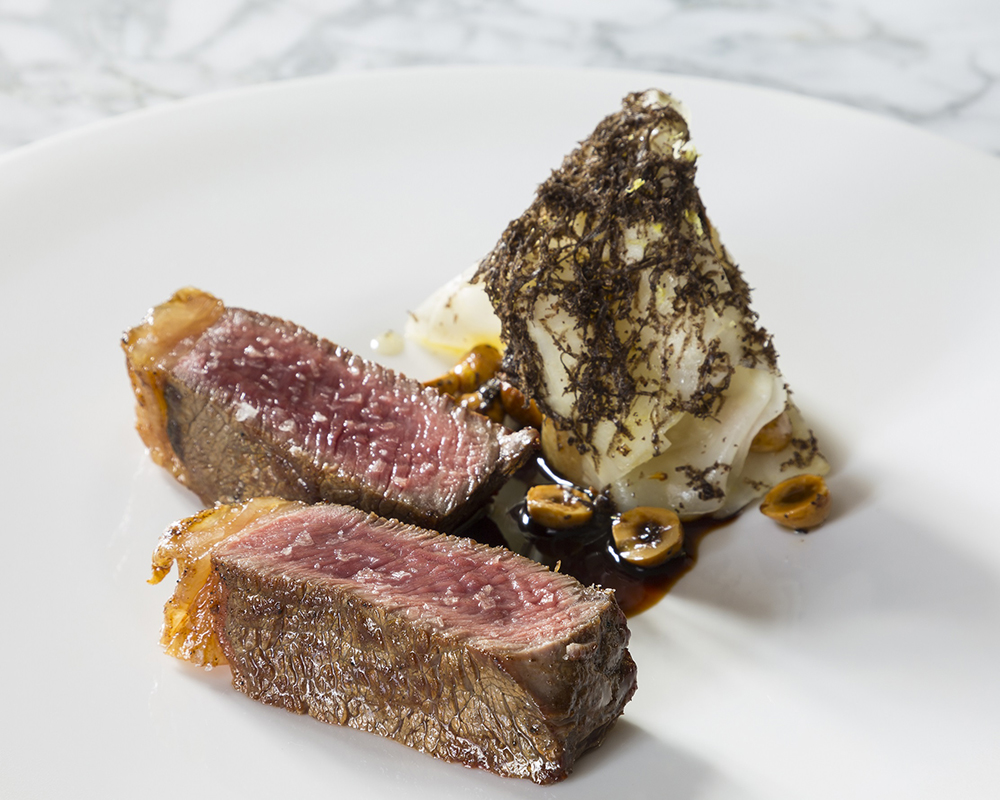 Peter Hannan’s Salt-Aged Glenarm Beef Sirloin with Salt-Baked Celeriac, Hazelnuts and Truffle
Peter Hannan’s Salt-Aged Glenarm Beef Sirloin with Salt-Baked Celeriac, Hazelnuts and Truffle
Serves 4
1kg thick slice of Peter Hannan’s Salt-Aged Glenarm Beef Sirloin
plenty of sea salt
soft butter, for cooking
100g hazelnuts, toasted and halved, to serve
Périgord black truffle, for slicing
For the salt-baked celeriac:
1 large celeriac
700g table salt
110g free-range egg whites
5 sprigs of fresh rosemary, finely chopped
Take the beef out of the fridge and put it on a tray without any covering or cling film. Allow it to sit at room temperature for at least 2 hours before you intend to start working with it so that it has a dry surface and is not too cold when cooked.
Preheat the oven to 190°C.
Place the celeriac in a roasting tray. Mix the table salt, egg whites and rosemary together in a large bowl until the mixture forms a paste. Cover the celeriac in a 2cm-thick layer of the salt paste, ensuring there are no gaps. Bake in the oven for 45 to 50 minutes. Remove from the oven, chip away the salt crust and scoop out the baked celeriac. Portion into nicely sized wedges and reserve until ready to plate.
A little while before you’re ready to start cooking, season the beef with plenty of salt. As it is a very big piece you will need more salt than you think. You will find that if you let the salt dissolve a little, the meat will brown more easily and uniformly.
Melt a large spoon of butter in a large frying pan over a medium-high heat. When the butter has lightly browned, add the beef and cook until the first side is perfectly caramelised. The meat and the pan need to be kept moving at all times so that no part of the pan warms up too much, causing the fat in that part to burn, and so that no part gets too cold and stops the meat from browning.
When the first side is perfect, repeat the process with the second side, adding a little more butter as you turn it. Let the meat rest somewhere warm but not hot, brush with some butter and leave it to rest.
While the meat is resting, pour the butter and fat that have rendered out of the beef through a fine mesh sieve into a container and clean the pan. When the meat is no longer hot to touch, fry it once more in the clean pan, brush it with butter and leave it to rest again. Repeat this process until the meat is cooked to your liking.
To finish the meat, reheat the frying pan and put back the fat strained from the pan earlier. Fry the beef on both sides once more and add some more butter. Let the new butter brown, then immediately lift the meat out and place on a preheated chopping board. Cut it into four strips straight away using a very sharp knife and serve with the salt-baked celeriac, toasted hazelnuts and some shaved truffle.
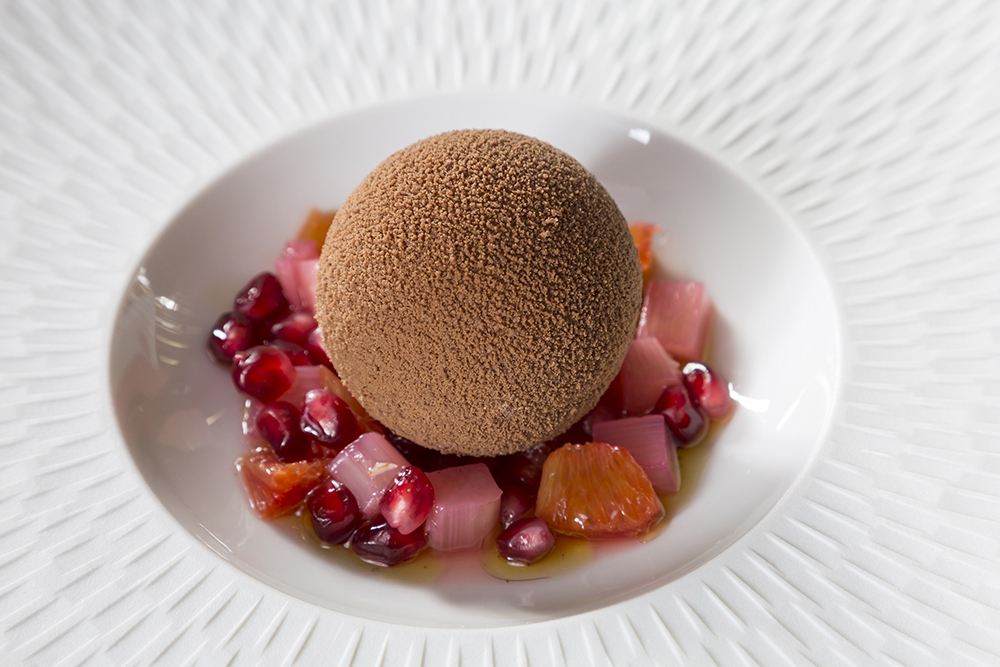 3fe Coffee Crèmeux with Citrus
3fe Coffee Crèmeux with Citrus
Serves 4 to 6
550ml double cream
9g ground 3fe coffee
1 vanilla pod, halved lengthways and seeds scraped out
3½ gelatine leaves, soaked
100g caster sugar
130g egg yolks (6 or 7 yolks)
1 blood orange
1 orange
seeds of 1 pomegranate
sugar syrup
zest of 1 lemon
zest of 1 lime
cocoa powder, for dusting
Infuse the cream with the coffee and half of the vanilla, then strain through a fine chinois.
Bloom the gelatine in a bowl of cold water.
Whisk the sugar and egg yolks to the ribbon stage. Fold this mixture into the infused cream, then add the soaked gelatine. Pass through a fine mesh sieve, pour into spherical silicone moulds and freeze.
Zest the oranges, then cut them into segments, catching the juice in a bowl. Put the segments in a separate bowl along with the pomegranate seeds. Reduce the juice over a high heat, then stir in a little sugar syrup along with the remaining vanilla and the lemon and lime zest.
To serve, spoon the citrus mixture into the centre of each bowl. Dust each crèmeux all over with cocoa powder, then place on top.
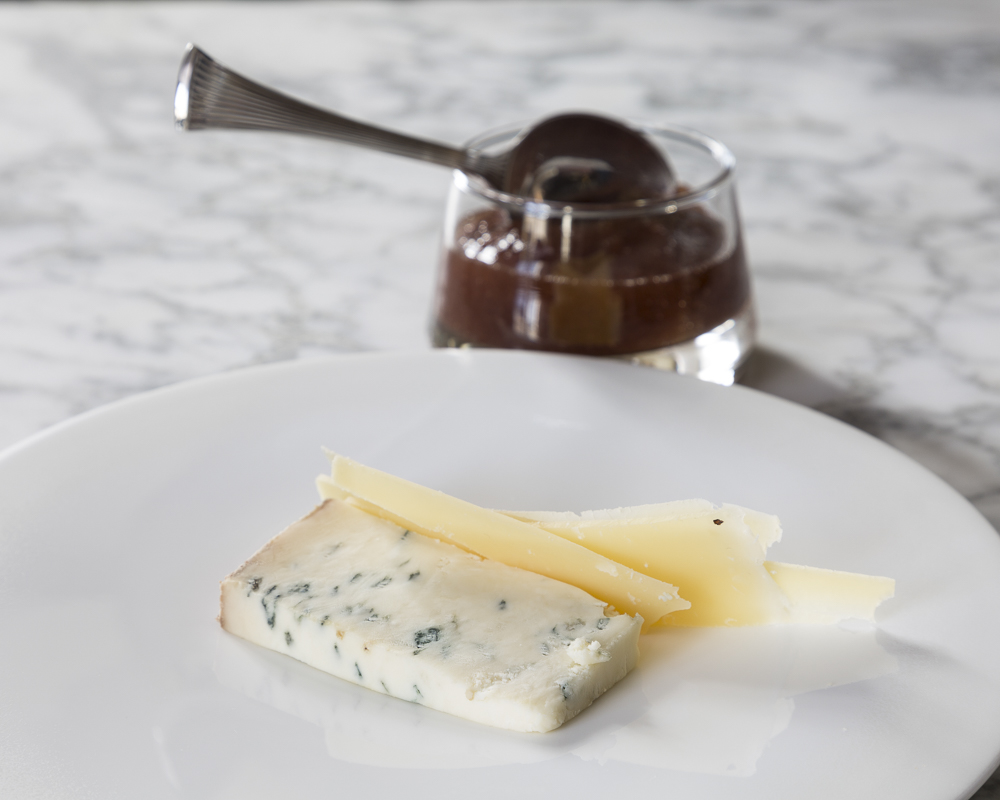 Teampall Gael and Young Buck Cheese with Rhubarb and Apple Chutney
Teampall Gael and Young Buck Cheese with Rhubarb and Apple Chutney
10 cloves
4 star anise
3 bay leaves
1 cinnamon stick
250g rhubarb, chopped
250g Bramley apple, peeled, cored and chopped
100g Demerara sugar
100ml balsamic vinegar
100ml water
zest of 1 orange
Teampall Gael cheese, to serve
Young Buck cheese, to serve
To make the chutney, wrap the cloves, star anise, bay leaves and cinnamon stick in a piece of muslin. Put the rhubarb, apple, sugar, balsamic vinegar, water and the muslin of spices in a pan on a medium heat. Cook until the sugar has dissolved. Increase the heat and cook until thick and syrupy and the rhubarb and apple have softened. Stir in the orange zest and allow to cool.
Serve the Teampall Gael and Young Buck cheese on a cheeseboard with the rhubarb and apple chutney alongside.
Easter Treat - Traditional Simnel Cake
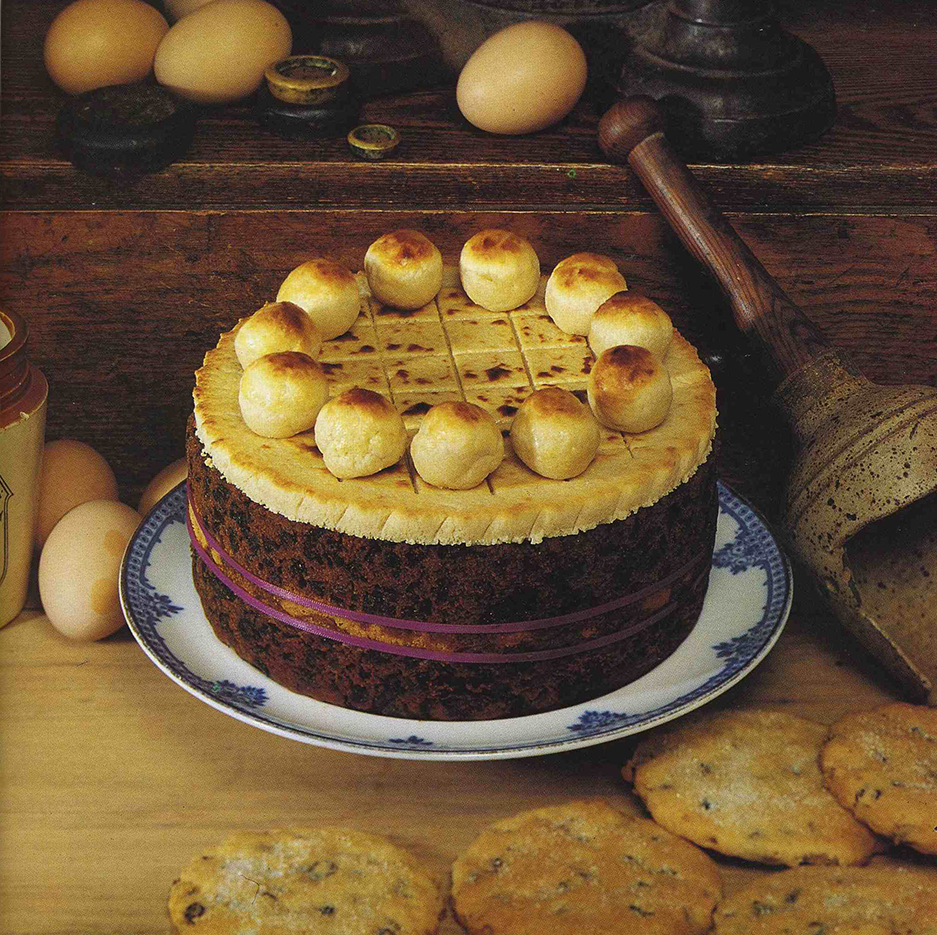
%20LR.jpg) Chocolate seems to have taken over everything at Easter, including cakes, and the traditional Simnel Cake has become an endangered species - but it’s one of my favourite cakes and anyone who likes almond paste (marzipan) will probably agree. A tradition well worth bringing back!
Chocolate seems to have taken over everything at Easter, including cakes, and the traditional Simnel Cake has become an endangered species - but it’s one of my favourite cakes and anyone who likes almond paste (marzipan) will probably agree. A tradition well worth bringing back!
Simnel Cake was originally associated with Mothering Sunday – quite the opposite of the ‘Mother’s Day’ that it has now become, it was a day when young girls in domestic service were allowed to go home and visit their families (and be ‘mothered’). The employer provided the ingredients, then the girl baked the cake herself, to take home and help feed the extra mouths of family members who would assemble for a get-together on that day. In recent times it has become an Easter speciality and is often decorated as below, with eleven marzipan balls to represent the twelve apostles, less Judas.
My mother was a great cook (and a cookery teacher). She passed on many family recipes to me and, as she was an especially good baker, many of them are bakes of various kinds. I am often asked if I’ve ever considered running a restaurant – the answer is ‘no way’ but, until they started popping up everywhere again, I was often tempted by the idea of a small bakery and old-fashioned tea rooms... This traditional Simnel Cake recipe is from my mother, and a family favourite – everyone loves the layer of gooey almond in the centre of the cake.
The name ‘simnel’ is thought to go back to the name of the fine flour used to bake the cake; today it is still important to use the best ingredients – choose good plump fruit, for example, and be careful about the dark brown sugar. The ‘dark soft brown sugar’ most usually available is just coloured white sugar, and this affects the texture and flavour. For best results use an unrefined molasses, which gives a lovely moist texture and rich flavour. Like most fruit cakes, this simnel cake keeps very well in an airtight tin.
For the marzipan:
8 oz/225g caster sugar
8 oz/225g icing sugar
l lb/450g ground almonds
2 eggs (or 4 yolks)
3 teaspoons lemon juice
l teaspoon almond essence
For the cake:
8 oz/225g plain flour
1/2 teaspoon salt
l saltspoon each nutmeg, cinnamon and allspice
6 oz/175g butter
6 oz/175g soft dark brown sugar (Barbados, preferably Billingtons unrefined)
3 eggs
l lb/450g currants
8-12 oz/225-350g sultanas
4 oz/100g chopped candied peel
Scant ¼ pint/150 ml milk
l level tablespoon black treacle.
A little apple jelly or apricot jam; ½ egg yolk beaten up with a little oil to glaze.
First make the marzipan: Mix the sugars and almonds together in a large bowl, make a hollow in the centre and drop in the lightly beaten eggs (or yolks), lemon juice and almond essence. Mix to a stiff paste, first with a wooden spoon then with hands dusted with icing sugar. Knead well until smooth and free from cracks. (Or do all this very quickly in a Kenwood Chef or similar, using the K beater.) If possible, leave the ball in a polythene bag in the fridge overnight, then leave to reach room temperature again before use; it will then be easier to handle.
For the cake:
Butter and line a deep 8"/20 cm round cake tin, preferably loose-based.
Preheat a slow oven, 300'F, 150'C, Gas mark 2.
Sift the flour, salt and spices together.
Cream the butter and sugar until light and fluffy, then add the lightly beaten eggs, a little at a time, including a spoonful of the sifted flour and beating well after each addition.
When the mixture is thoroughly beaten, lightly stir in the remaining flour and then the fruit. Add just enough of the milk to make a fairly stiff batter (like a Christmas cake) and the treacle.
Divide the marzipan unevenly in half and roll the smaller piece to the exact size of the inside of the cake tin.
Turn half of the cake mixture into the tin, level it out and cover with the circle of marzipan.
Cover with the rest of the mixture, smooth down with the back of a tablespoon and bake in the centre of the preheated oven for about 3½ hours, or until the top is springy to the touch and the cake is shrinking slightly from the tin. [A skewer should come out of the cake clean, but the marzipan in the centre makes this method less reliable than usual, so be careful not to put the skewer through it.]
Cool the cooked cake in the tin. When cold, turn out, remove papers and brush the top with a little warmed apple jelly or apricot jam, sieved if necessary, and place the second circle of marzipan on top, pressing down well.
Using a sharp knife, mark the top into squares ½ -1"/2-2.5 cm wide. Make eleven small balls from the marzipan trimmings and arrange these around the edge of the cake, then brush the marzipan lightly with beaten egg and put the cake into a hot oven or under the grill for a few minutes until toasted to a deep golden brown.
Alternatively, another traditional finish is to run a small pool of pastel coloured icing, preferably yellow, into the centre of the marzipan. In either case, it can also be decorated with a few tiny marzipan or foil-covered chocolate eggs and/or Easter chicks - children love these.
[From “Meals For All Seasons” Wolfhound Press 1992.]
Cookery Feature - Lamb - Not Just For Easter
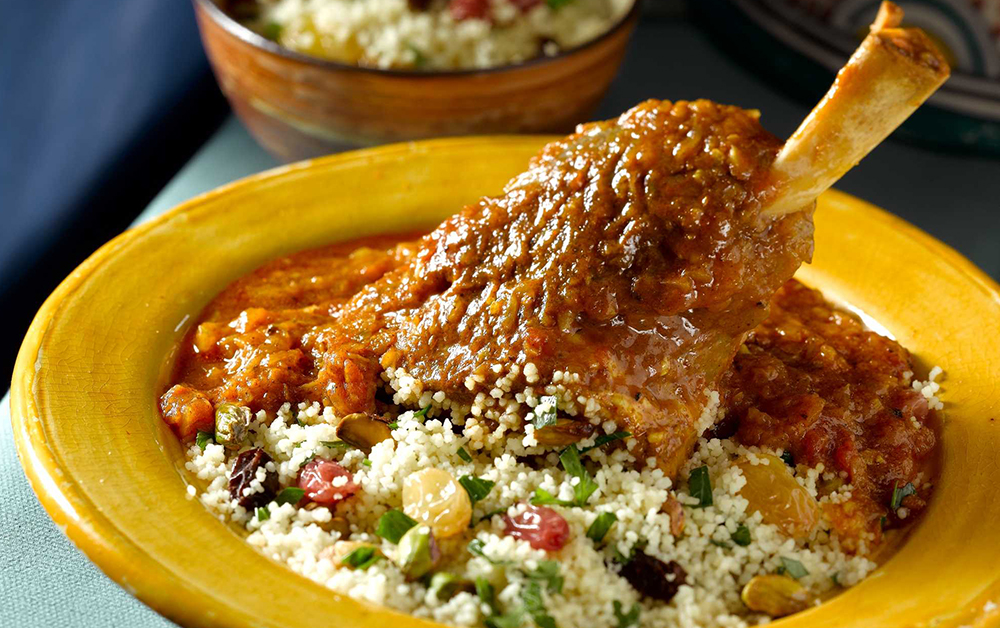
It’s synonymous with spring and - while I would be the first to agree that a flavoursome free range roast chicken is still one of the best dishes around -lamb has taken over from it as the favourite Easter meal in recent times.
New season Irish spring lamb is seen by many as the ultimate meaty treat and, if you’re cooking for a small number, it’s something to splash out on for a special occasion. It’s very tender and delicately flavoured but, even though the late Easter has given a few more weeks of growth this year, it is very small - and it also commands a premium price, so it’s not really a runner for a large family.
So what’s usually needed at this time of year, especially for a gathering of any size, will actually be hogget, which is a one year old lamb with plenty of meat on it and good-sized roasting joints.
Prized for its flavour and versatility, lamb suits most cooking methods and partners especially well with Middle Eastern and North African flavours as well as our traditional garlic, mint and rosemary, so cookbooks focusing on these regions are good places to look for ideas.
And lamb is not just for Easter, of course. These favourite recipes are very different, not too season-specific and great for a variety of occasions - a reminder of just how versatile lamb is - and all would be best suited to the more mature lamb (hogget), which has plenty of flavour and lots of good eating on it.
RECIPES:
_honey%20orange.jpg) Roast Leg of Lamb with Honey Orange Glaze, Port & Mint Dressing and Boulangère Potatoes
Roast Leg of Lamb with Honey Orange Glaze, Port & Mint Dressing and Boulangère Potatoes
This easy roast is perfect for Sunday lunch and would also be ideal for a family gathering over Easter. Shoulder of lamb, which is especially tender and sweet-flavoured and makes a lovely roast, could be used instead for a smaller group of about 6 people.
Serves 8-10
1 good-sized leg of lamb, trimmed
3 cloves garlic, sliced
Few sprigs of rosemary
2 onions, roughly chopped
1 head of garlic
2 cloves garlic, crushed to a paste with some salt
The rind of 1 orange
2 tbsp runny honey
2 tbsp olive oil
Glass of white wine
Port and Mint Dressing
4 tbsp redcurrant jelly
Juice of 1 orange
Dash of port
Few sprigs of mint
Preheat the oven at 200°C (400°F) Gas Mark 6.
Make about 10 incisions in the lamb with a sharp knife. Push a sliver of garlic and a sprig of rosemary into each hole. Place the lamb in a roasting tray with some chopped onions and a head of garlic cut in half. Mix together the crushed garlic, orange rind, honey and olive oil. Spread the mixture over the lamb. Place in the oven and roast for 30 minutes. Then add the glass of wine and a glass of water (this will stop the honey from burning). Reduce the oven temperature to 180°C (350°F) Gas Mark 4 and continue the cooking for another hour for pink lamb. Rest for 15 minutes before serving.
When the lamb is cooked, remove it from the roasting tray and strain the juices; keep the garlic to serve with the lamb. To the juices, add another dash of wine and a tablespoon of redcurrant jelly. Boil it up to make a jus, finish with a knob of butter and taste for seasoning.
To make the dressing, gently heat the redcurrant jelly, orange juice, port and mint. Add a little lemon juice if you think it is too sweet. Serve warm with the sliced lamb.
Boulangère Potatoes are very good with the roast lamb and can be cooked in the oven at the same time. Simply layer some thinly sliced potatoes in a baking dish with thinly sliced onions which have first been sautéed in a knob of butter. Add seasoning and a few more knobs of butter as you do the layers. Finish off with some chicken stock and a sprinkling of grated cheese. Bake for 40-50 minutes until the potatoes are tender and the topping is golden and crispy.
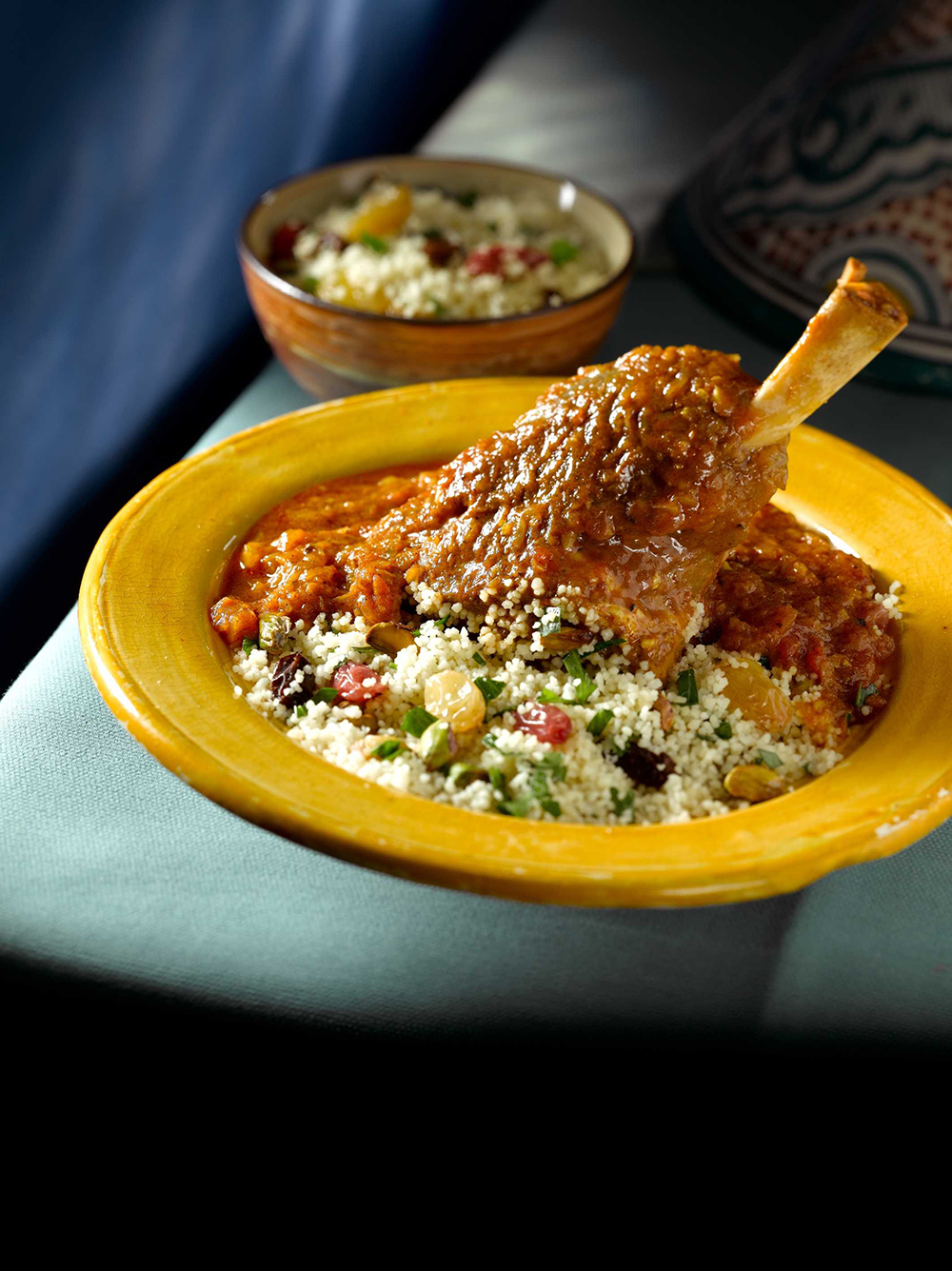 Moroccan Style Braised Lamb Shanks
Moroccan Style Braised Lamb Shanks
This aromatic version of one of the most popular lamb dishes is ideal for a busy day as it can be left to get on with its long slow cooking while you do other things for a couple of hours – making an easy and seriously delicious meal to come back to later. The lamb can be covered in clingfilm and marinated in the fridge for up to 24 hours beforehand if you wish, to allow the spices to penetrate the meat and making a more strongly flavoured and fragrant dish. The accompanying couscous can be jazzed up with pistachio nuts and dried fruits, such as sultanas and raisins and a little chopped fresh flat-leaf parsley.
Serves 4
1 tbsp paprika
1 tsp each ground coriander, cumin, cinnamon and turmeric
Sea salt and cracked black pepper
4 lamb shanks, well trimmed
2 tbsp olive oil
1 large onion, roughly chopped
2 garlic cloves, chopped
2½ cm piece peeled fresh root ginger, chopped
450ml chicken or lamb stock
2 x 400g cans chopped tomatoes
1 tbsp clear honey
Squeeze of lemon juice
Serve with a bowl of couscous
Preheat the oven to Gas Mark 3, 160ºC (325ºF).
Heat a large frying pan. Mix together the paprika, coriander, cumin, cinnamon, turmeric and one teaspoon of pepper in a large bowl. Add the lamb shanks and using your hands rub in the spices. Add a little of the olive oil to the heated pan and quickly brown off two of the spiced lamb shanks. Transfer to a casserole dish with a lid and repeat with the remaining lamb shanks.
Meanwhile, place the onion, garlic and ginger in a food processor or mini blender and pulse until finely minced. Add another tablespoon of the olive oil to the pan, then add the onion mixture and sauté for 3-4 minutes until well softened and coloured from the spices left in the bottom of the frying pan.
Pour a little of the stock into the pan, stirring to combine and then tip over the lamb shanks. Add the remaining stock with the tomatoes and honey, stirring gently until evenly combined. Cover with the lid and cook for 2-2½ hours until the lamb shanks are meltingly tender and the meat is ready to fall off the bone. Season to taste and add a squeeze of lemon juice to taste. Arrange the lamb shanks in wide-rimmed bowls with the couscous to serve.
 Spiced Meatballs With Chilli Tomato Sauce
Spiced Meatballs With Chilli Tomato Sauce
This is a handy recipe with Middle Eastern origins. If you don’t want to use passata (sieved tomatoes) simply replace with two cans of chopped tomatoes.
Serves 4
1 onion, roughly chopped
1 tsp ground cumin
½ tsp ground coriander
½ tsp ground cinnamon
1 tbsp chopped fresh flat-leaf parsley
450g lean minced lamb
50g pine nuts
Sea salt and freshly-ground black pepper
1 tbsp olive oil
For The Chilli Tomato Sauce
1 red chilli, seeded and finely chopped
2 garlic cloves, crushed
680g jar passata (sieved tomatoes)
1 tsp sugar
Serve with plain boiled rice
Place the chopped onion in a food processor and whizz to a fine purée. Tip into a bowl with the cumin, coriander, cinnamon, parsley, lamb and pine nuts. Season and work to a paste with your hands. Roll the paste into small walnut-sized balls; you should have about 20 in total. Chill for 15 minutes to firm up if time allows.
Preheat the oven to Gas Mark 6, 200ºC (400ºF). Toss the meatballs in the oil and place in an ovenproof dish. Bake for 15 minutes until lightly golden.
Meanwhile, place the chilli, garlic, passata and sugar in a jug. Season and mix well to combine. Pour over the meatballs and bake for another 30 minutes, turning the meatballs once until the sauce has slightly reduced and thickened. Serve hot with some rice, in warmed wide-rimmed bowls.
Cookery Feature - Myrtle Allen, The Legacy
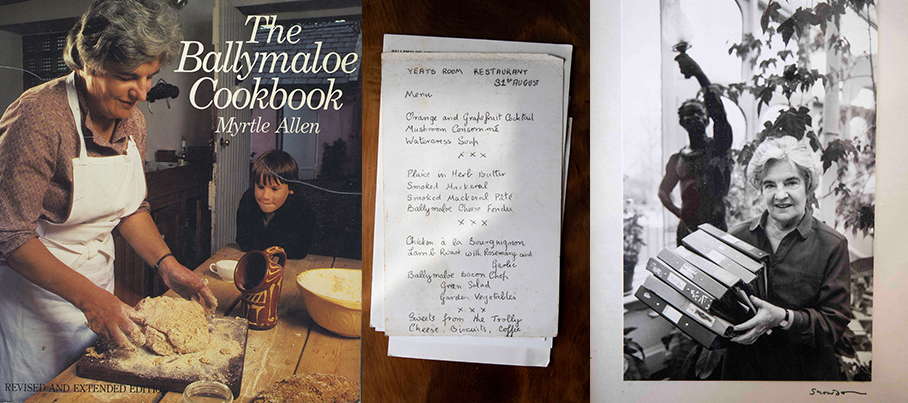
 Ireland’s greatest food hero, Myrtle Allen, died on June 13th 2018 at the age of 94. While she is sorely missed and we will remember her especially on her anniversary, it is wonderful to see the value that is now being placed on her lifetime’s work.
Ireland’s greatest food hero, Myrtle Allen, died on June 13th 2018 at the age of 94. While she is sorely missed and we will remember her especially on her anniversary, it is wonderful to see the value that is now being placed on her lifetime’s work.
To the equal delight of family, old friends, scholars and former colleagues, University College Cork (UCC) has acquired her papers (‘The Myrtle Allen Archive’) and established an annual Myrtle Allen Memorial Lecture in honour of this extraordinary pioneer of Irish food culture.
The inaugural Myrtle Allen Memorial Lecture took place at UCC on May 9th and the keynote speaker was the internationally acclaimed food writer, Claudia Roden, who has been a guest chef at Ballymaloe Cookery School on many occasions. She fell in love with Ireland and - enchanted, as so many have been - said she “would choose to live at Ballymaloe for ever”. Inspired by Myrtle over 35 years, she spoke of her kindness and belief in “the power of food - and especially national food and local dishes - to bring people together and make them feel loved and valued”.
Other speakers included UCC Food and Culinary Historian, Regina Sexton, who has been researching Myrtle’s work since 2013 (see below); the Michelin star chef, Ross Lewis, who worked closely with Myrtle while he was Commissioner General of Euro-Toques Ireland, which Myrtle established in 1986; and John McKenna of McKennas’ Guides. The event was also used to launch UCC’s unique Post-graduate Diploma in Irish Food Culture in Adult Continuing Education and the Department of Folklore and Ethnology.
The Myrtle Allen Archive spans over a century and Regina Sexton described it as “a treasure of insight into a woman whose ethos and approach to cooking and Irish produce would come to frame, structure and direct much of how we engage with contemporary Irish food culture”.
 Regina explained how, in 1975, “Myrtle Allen, an unassuming farmer’s wife with six children from the small village of Shanagarry, in east Cork, won a Michelin Star for her country house restaurant, The Yeats Room, in Ballymaloe House. She was the first Irish woman to receive the accolade and she remains one of just two women to hold the award in the Republic of Ireland (the other was the late Catherine Healy who, with her husband Nick, established a ground breaking restaurant in Co Meath). Myrtle’s work in the kitchen and her food activism defined her life and her achievements were recognised in her lifetime by gastronomic luminaries like Paul Bocuse, who was one of the most prominent chefs associated with the nouvelle cuisine movement and Claus Meyer and René Redzepi of the New Nordic Cuisine movement. Today a large and growing community of chefs, food producers and market-stall holders see Myrtle Allen as the force which redirected the course of Irish food culture over the last two generations.”
Regina explained how, in 1975, “Myrtle Allen, an unassuming farmer’s wife with six children from the small village of Shanagarry, in east Cork, won a Michelin Star for her country house restaurant, The Yeats Room, in Ballymaloe House. She was the first Irish woman to receive the accolade and she remains one of just two women to hold the award in the Republic of Ireland (the other was the late Catherine Healy who, with her husband Nick, established a ground breaking restaurant in Co Meath). Myrtle’s work in the kitchen and her food activism defined her life and her achievements were recognised in her lifetime by gastronomic luminaries like Paul Bocuse, who was one of the most prominent chefs associated with the nouvelle cuisine movement and Claus Meyer and René Redzepi of the New Nordic Cuisine movement. Today a large and growing community of chefs, food producers and market-stall holders see Myrtle Allen as the force which redirected the course of Irish food culture over the last two generations.”
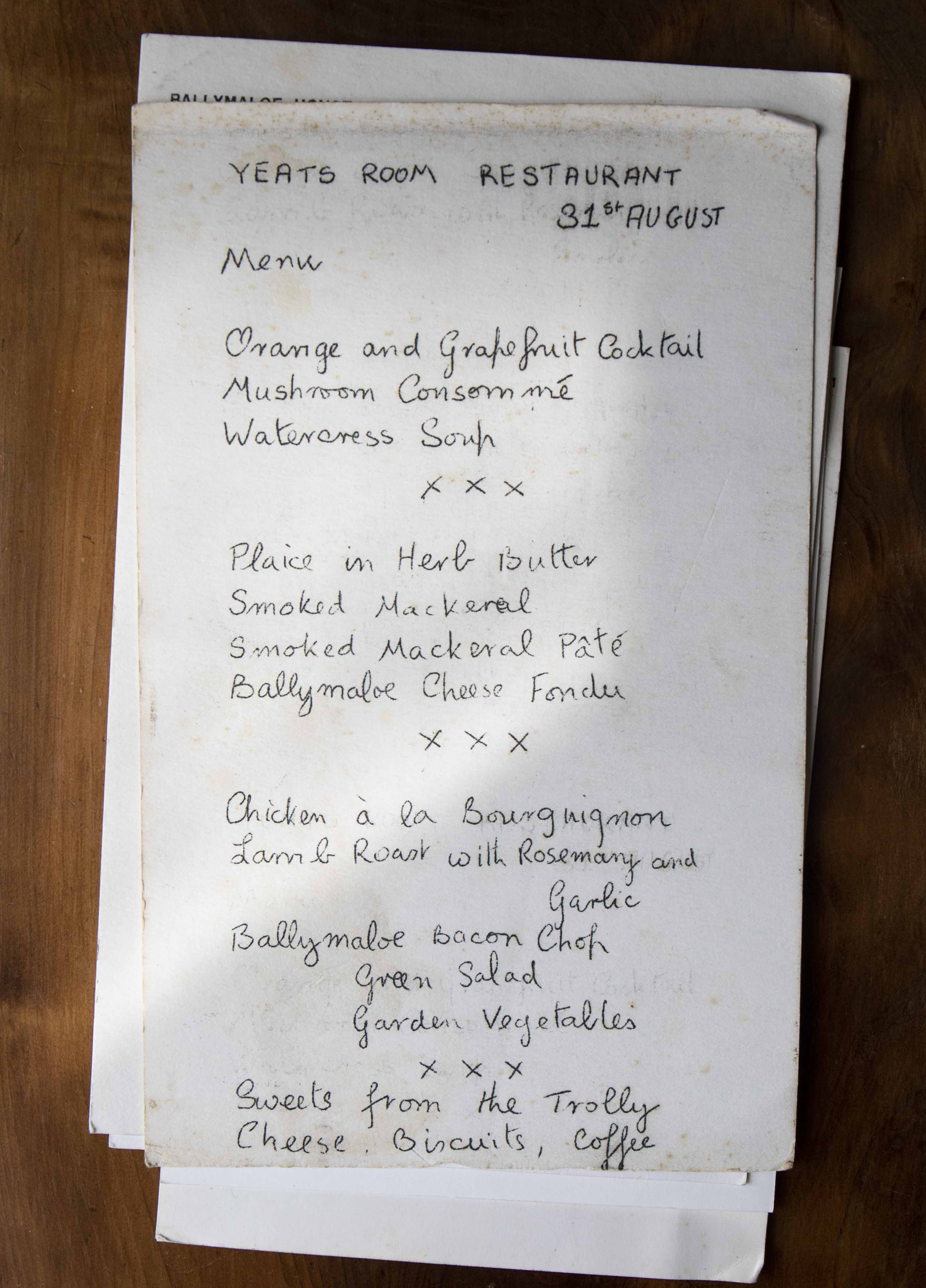 Fortunately for historians and students of Irish food culture, Myrtle Allen kept extensive records and the archive includes journals from the restaurant, daily menus, inherited hand-written family manuscript recipe books, correspondence with producers and chefs, restaurant and hotel reviews, and scrapbooks of traditional recipes send to her by readers of the Irish Farmers Journal. There are letters of advice to fledgling chefs, drafts and proofs of her 1977 book, The Ballymaloe Cookbook (which has been revised and re-issued on several occasions, most recently in 2014, and photographs and files that reflect her interest in history, local history, genealogy and travel. Box after box and cabinet after cabinet hold papers that document her remarkable relationship with food.
Fortunately for historians and students of Irish food culture, Myrtle Allen kept extensive records and the archive includes journals from the restaurant, daily menus, inherited hand-written family manuscript recipe books, correspondence with producers and chefs, restaurant and hotel reviews, and scrapbooks of traditional recipes send to her by readers of the Irish Farmers Journal. There are letters of advice to fledgling chefs, drafts and proofs of her 1977 book, The Ballymaloe Cookbook (which has been revised and re-issued on several occasions, most recently in 2014, and photographs and files that reflect her interest in history, local history, genealogy and travel. Box after box and cabinet after cabinet hold papers that document her remarkable relationship with food.
And, as Regina said, Myrtle did things differently. Her skills in the kitchen were largely self-taught and, not only did she write the restaurant menu each day, but very often that menu would not be finalised until hours, sometimes less than an hour, before service until she saw the catch that was landed from the near-by fishing village of Ballycotton or until she could buy what foraged hedgerow or shore foods the local children would bring to sell to her at the kitchen door. Myrtle chose to profile on those menus ingredients and dishes that fine dining restaurants viewed with little if any regard- hours-old mackerel, elderberries, mussels, oatmeal porridge with Jersey cow pouring cream and a soft dust of brown sugar.
Regina also pointed out that, in the 1960s, Myrtle’s approach was wildly out of step with current trends: “Writing in the Irish Farmers’ Journal, from 1962 until the early 1970s, her food columns in the Home Farm section of the paper were clearly at odds with cultural norms. At that time, as Ireland was undergoing rapid social, economic and cultural changes, Irish food and cooking was often eschewed and undervalued as the country deployed a modern approach to production and it took its gastronomic cues from outside trends and fashions.”
“What made her different,” said Regina, “Was that she wasn’t swayed by outside influences but rather she aimed to validate the internal, she looked inward and strove to elevate what was good home-produced food to such a high status that we could be confident in believing that Irish food was some of the best the world could produce. This approach was viewed as counter-productive, if not damaging to efforts at economic, social and agriculture improvement and development. A break with tradition and custom was presented in popular and populist narratives as one means to escape stagnant and backward lifestyles and what is interesting to observe is that we have now come full-circle in trying to recapture and understand our food heritage and this was something she did as a matter of course, it was ingrained in her guiding principles.”
* The Myrtle Allen Archive will be housed at the Boole Library in UCC to inspire and guide future scholarship. UCC has a long heritage in food research and education. In 2000 Myrtle Allen was awarded an honorary doctorate by UCC and it recently launched the Food Institute, which unites the food related activity at the university and connects those activities to the community.
RECIPES and cookery notes - the Myrtle Allen philosophy
This introduction to Ballymaloe House and the recipes that follow are taken from an early edition of my ‘Irish Country House Cooking, The Blue Book Cookery Book’, which was published in serial editions between 1995 and 2007.
 First time visitors to Ballymaloe are invariably charmed by the approach, through lush green fields with sheep grazing all around - the Allen family home may be Ireland’s most famous country house, but they have always described it as ‘a large family farmhouse’. And - although, with over thirty bedrooms, it is very large indeed - Ballymaloe remains true to that description over three decades after Myrtle and her husband, the late Ivan Allen, first welcomed guests to their home in 1964. The dining room - named The Yeats Room after their collection of Jack Yeats paintings - opened first, followed by rooms for accommodation in 1967, and family enterprises connected with Ballymaloe House now include not only the farmlands and gardens that supply the kitchen, but also a shop selling crafts, kitchenware and furniture, the Crawford Gallery Café in Cork city and Darina Allen’s internationally acclaimed cookery school nearby. Yet Ballymaloe is still most remarkable for its unspoilt charm: although now rightly receiving international recognition for a lifetime’s work “recapturing forgotten flavours, and preserving those that may soon die”, Myrtle continues to supervise everything, ably assisted by her children and their families, and their teamwork is indeed a sight to behold.
First time visitors to Ballymaloe are invariably charmed by the approach, through lush green fields with sheep grazing all around - the Allen family home may be Ireland’s most famous country house, but they have always described it as ‘a large family farmhouse’. And - although, with over thirty bedrooms, it is very large indeed - Ballymaloe remains true to that description over three decades after Myrtle and her husband, the late Ivan Allen, first welcomed guests to their home in 1964. The dining room - named The Yeats Room after their collection of Jack Yeats paintings - opened first, followed by rooms for accommodation in 1967, and family enterprises connected with Ballymaloe House now include not only the farmlands and gardens that supply the kitchen, but also a shop selling crafts, kitchenware and furniture, the Crawford Gallery Café in Cork city and Darina Allen’s internationally acclaimed cookery school nearby. Yet Ballymaloe is still most remarkable for its unspoilt charm: although now rightly receiving international recognition for a lifetime’s work “recapturing forgotten flavours, and preserving those that may soon die”, Myrtle continues to supervise everything, ably assisted by her children and their families, and their teamwork is indeed a sight to behold.
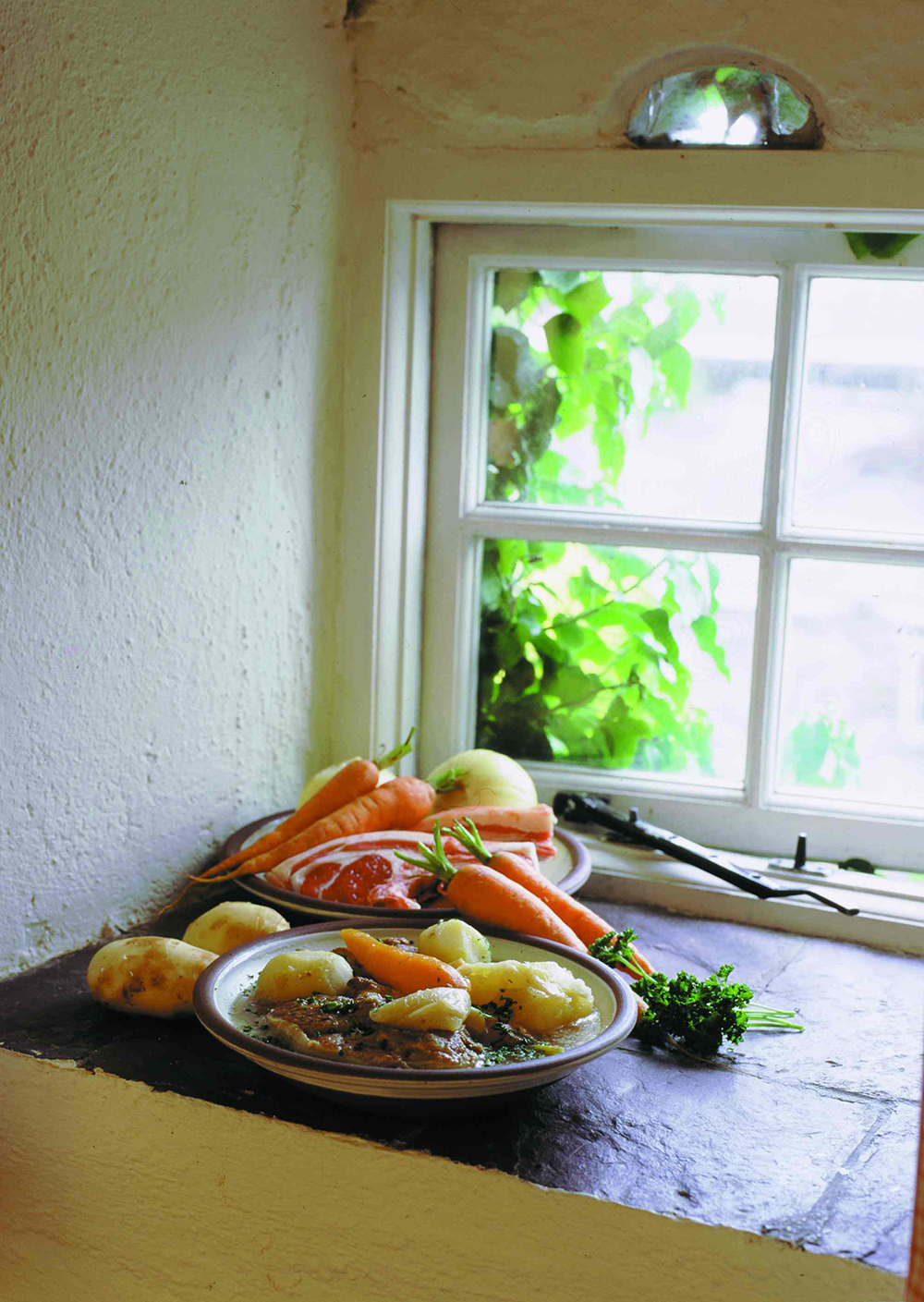 Ballymaloe Irish Stew
Ballymaloe Irish Stew
The charming road up to Ballymaloe house - for it is an unembellished road, rather than the manicured approach we think of as a 'driveway' - goes through lush green fields with sheep grazing all around Small wonder then that Myrtle Allen should have such an enduring relationship with the local butcher - and that lovely, simple dishes like this Ballymaloe Irish Stew should be a fundamental part of her repertoire. And, regarding the great debate as to whether or not an Irish Stew should have carrots in it, Mrs Allen concedes that the classic version probably doesn't - but says it is common practice to include them in the south.
Serves 4:
For the mutton or lamb stock (optional, see note):
2 lb/1.3 Kg mutton or lamb bones
Peelings from carrots and trimmings from other vegetables, such as onion tops
Sprigs of fresh herbs, such as thyme and marjoram
4 oz/100g mutton or lamb fat to make optional drippings OR 3 tbsp unsalted butter, lard or bacon fat, melted.
3 lb/1.3 Kg mutton neck chops or shoulder lamb chops, bone in
4 carrots (about 1/2 lb/225g total), quartered
4 onions (about ¾ lb total), quartered
½ tsp salt
¼ tsp black pepper
4-6 small potatoes (about 1 lb/450g total)
½ oz/15g butter
1 tbsp chopped parsley leaves
1 tbsp snipped fresh chives
1 pint/600 ml stock or water.
To make the stock: In a saucepan cover the bones, vegetable peelings and trimmings and herbs with cold water by 2"/5 cm. Bring to the boil, then lower the heat and simmer the mixture, partially covered, for about 2 hours. Strain and skim the fat. Reserve 2½ cups (1 pint/600 ml) of the stock for the stew.
To make the optional drippings, chop the fat into small pieces and fry it over moderately low heat in a heavy skillet until it is rendered. Reserve 3 tablespoons for the stew.
To make the stew, heat the 3 tablespoons reserved drippings in a heavy saucepan and brown the chops in it, in batches. (Do not crowd the meat.) Add the carrots, onions, salt (see note), pepper and the 1 pint/600 ml reserved stock. Peel the potatoes and put them on top. Simmer the stew gently for 11/2to 2 hours, or until the meat is tender. Transfer the meat and vegetables to individual bowls with a slotted spoon. Skim the fat from the cooking liquor, then taste and correct seasonings as necessary. Swirl in the butter, parsley and chives and ladle the sauce over the meat and vegetables.
[Note: Canned beef broth( if available) may be substituted for the lamb stock, in which case the ½ teaspoon salt should be omitted.]
.jpg) Ballymaloe Brown Bread
Ballymaloe Brown Bread
This is perhaps the most famous of Myrtle Allen’s much-loved recipes, and variations on it are made in many other kitchens throughout Ireland. The detail given is typical of Myrtle, who was a natural teacher.
'When making this bread, remember that yeast is a living fungus. In order to grow, it requires warmth, moisture and nourishment. The growing process produces carbon dioxide which makes the bread rise. Hot water will kill yeast. Have the ingredients and equipment at blood heat. The yeast will rise on sugar or treacle. We use treacle. The dough rises more rapidly with 110 g/4 oz yeast than with only 55 g/2 oz. The flour we use is wholemeal, stone ground. Different flours produce breads of different textures. The amount of natural moisture in flour varies according to atmospheric conditions. The quantity of water should be altered accordingly. The dough should be just too wet to knead. In fact it does not require kneading. The main ingredients, wholemeal flour, treacle and yeast, are highly nutritious.'
*Dried yeast may be used instead of baker's yeast. Follow the same method but use only half the weight as given for fresh yeast. Allow longer to rise
For four loaves (13cm x 20cm/ 5in x 8in approx.)
1½kg/3½lb wholemeal flour
1¼/l½ pt water at blood heat
1 tablesp. salt
1-2 well rounded teasp black treacle
2-4 oz fresh yeast
For one loaf (13cm x 20cm/5in x 8in approx.)
450g/1lb wholemeal flour
350ml/12fl oz water at blood heat
1 teasp. black treacle
1 teasp. salt
30g/1oz yeast
For one loaf (American measures)
(13cm x20 cm/5in x 8in approx.)
3¾ cups whole wheat flour
l½ cups (or more) warm water
1½ packages granular yeast
2 tablesp. molasses salt
Mix flour with salt and warm it (in the cool oven of an Aga or Esse or in the electric or gas oven when starting to heat). Mix treacle with some of the water in a small bowl and crumble in the yeast. Put the bowl in a warm position such as the back of the cooker.
Grease bread tins and put them to warm, also warm a clean tea-towel. Look to see if the yeast is rising. It will take 5 minutes approx. to do so and will have a frothy appearance on top.
Stir it well and mix it with remaining water into the flour to make a wettish dough. Put the mixture into the greased, warmed tins and put the tins back in the same position as used previously to raise the yeast. Put the tea-towel over the tins. In 20 minutes approx. the loaves will have risen by twice their original size.
Now bake them in a hot oven, 230°C/ 470°F/Regulo 8, for 45-50 minutes or until they look nicely browned and sound hollow when tapped.
[This is our version of The Grant Loaf (Doris Grant, Our Daily Bread, Faber and Faber). American measures as given by James Beard.]
Cookery Feature - Eggs for Anytime - Winning Ways with Eggs
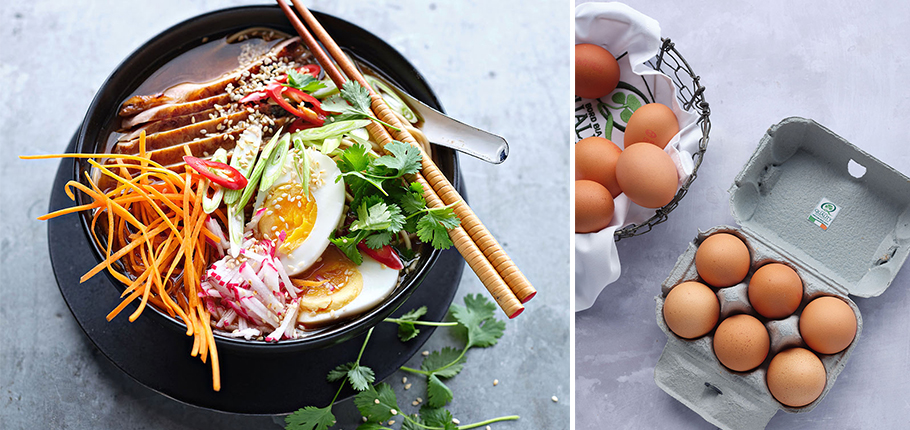
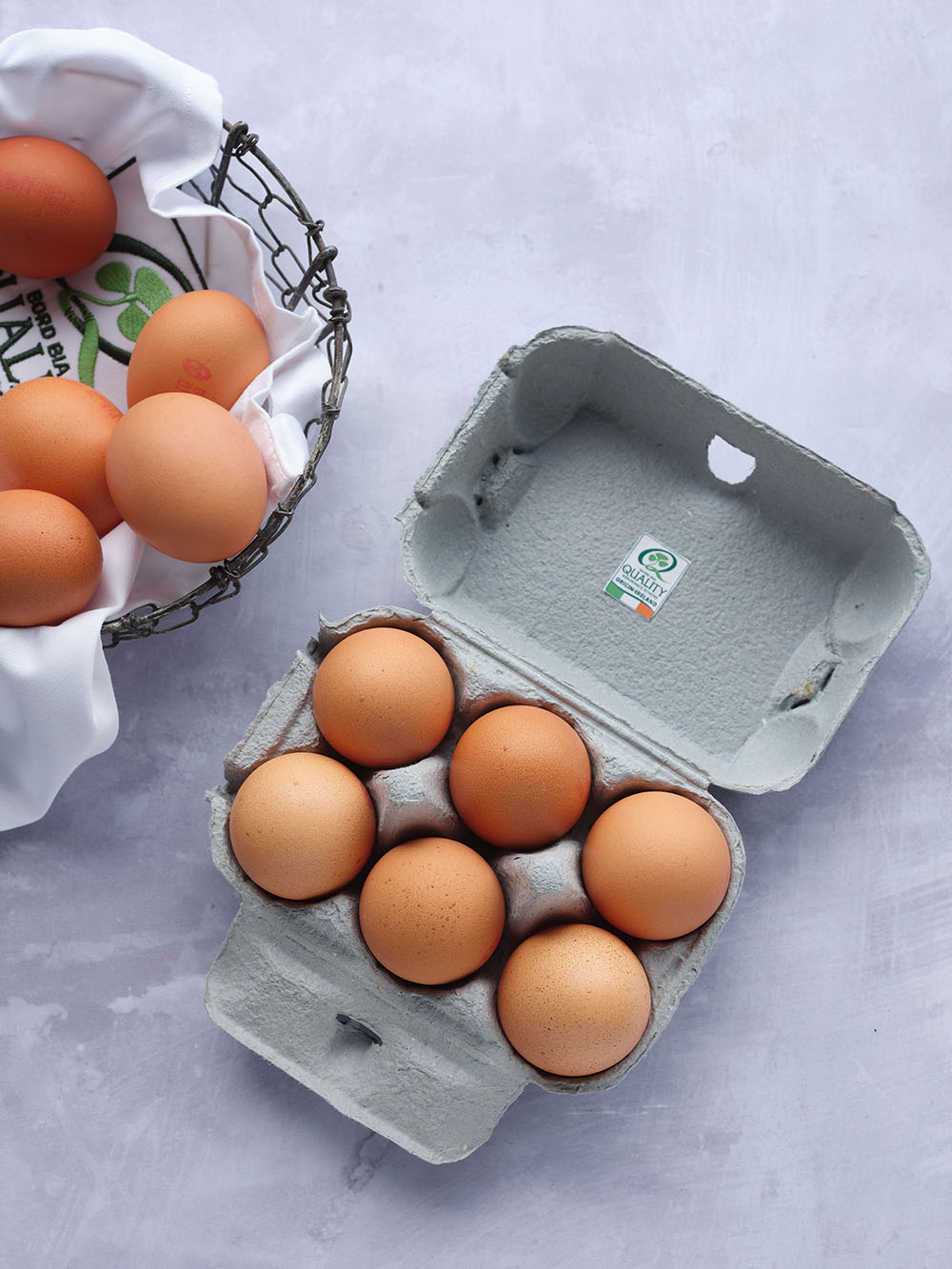 Not only do eggs come in the neatest and most beautiful of packaging, but ‘Nature’s convenience food’ is also one of the most versatile ingredients in any cook’s armoury – and highlighting that simple fact was the main aim of the recent Bord Bia/Irish Egg Association ‘Eggs For Anytime’ recipe competition, which asked chefs to share a dish based on Bord Bia Quality Assured Eggs that could feature on their restaurant menu, outside of the more usual breakfast and brunch offerings.
Not only do eggs come in the neatest and most beautiful of packaging, but ‘Nature’s convenience food’ is also one of the most versatile ingredients in any cook’s armoury – and highlighting that simple fact was the main aim of the recent Bord Bia/Irish Egg Association ‘Eggs For Anytime’ recipe competition, which asked chefs to share a dish based on Bord Bia Quality Assured Eggs that could feature on their restaurant menu, outside of the more usual breakfast and brunch offerings.
Jess Murphy, of the much-loved Kai Restaurant in Galway city, was the overall winner for her Kai Restaurant Pork Ramen With Eggs, and four regional awards went to Café Rua in Castlebar (Scotch egg with Kelly’s black pudding); Viewmount House in Longford (Six-minute egg and Jerusalem artichoke); Lemon Tree Restaurant in Letterkenny (Confit Irish duck leg, soft egg, potato mousse and crisp fried onions); and The Blue Haven Hotel in Kinsale (Shakshuka: eggs poached in a spicy tomato sauce).
On receiving the news, Jess Murphy – who uses Galway Free Range Eggs produced locally at Claregalway – said, “We take great pride in our high-quality produce, that is sourced locally and cooked inventively, so when it’s comes to choosing eggs we always ensure we use Bord Bia’s Quality Assured Eggs.”
The five winning ‘Eggs For Anytime’ recipes:
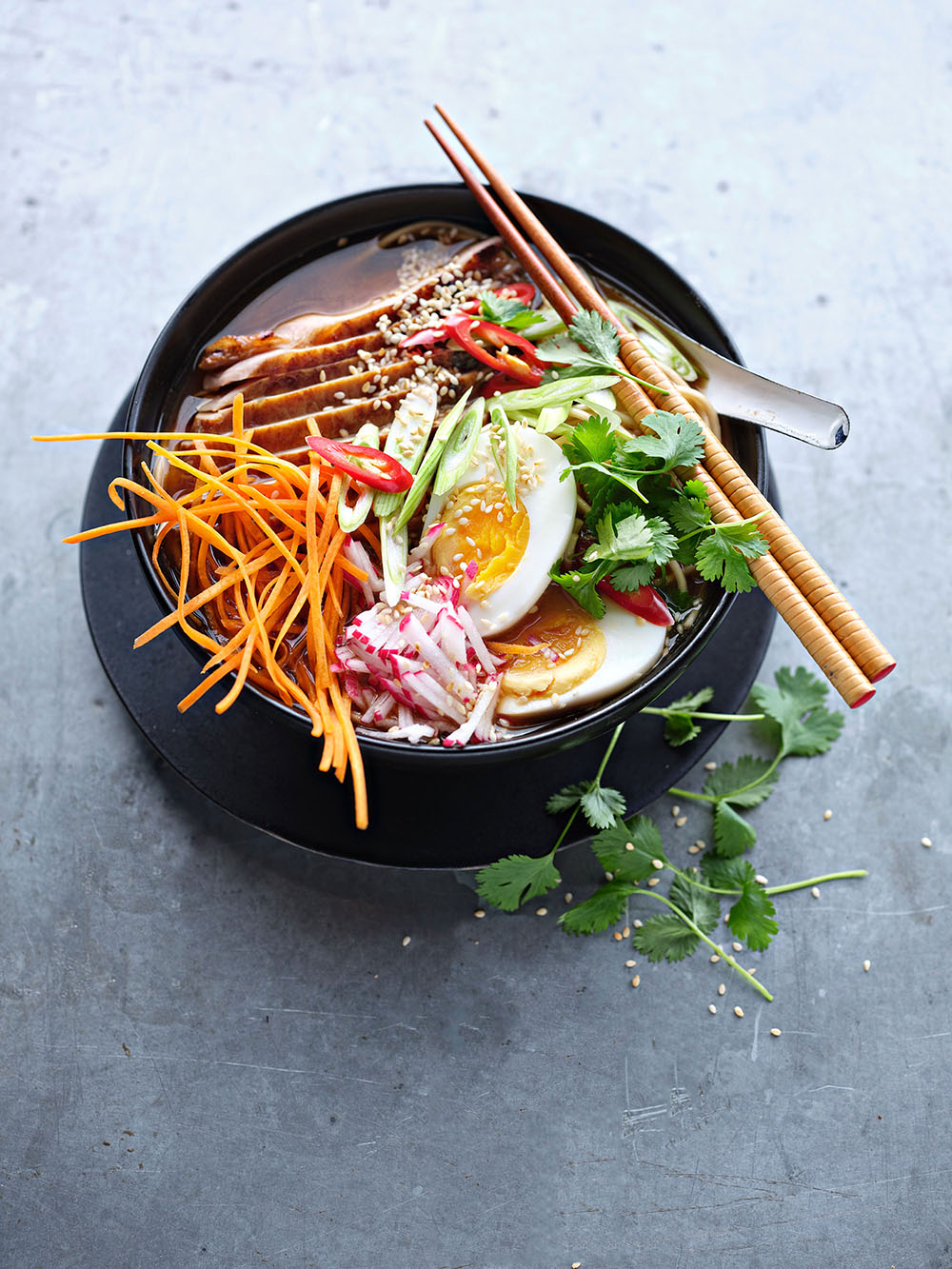 Overall Winner: KAI -STYLE RAMEN
Overall Winner: KAI -STYLE RAMEN
Jess Murphy: “Ramen is really just a hearty broth pimped up with noodles, toppings and garnishes, all served in a deep bowl. We cook our pork chops on the bone for flavour and to keep the meat from drying out. You will find kecap manis in any Asian supermarket. It is an Indonesian soy sauce, slightly thicker and sweeter than regular soy. A few spoons of soy mixed with a spoon of treacle will do in its place.” Serves 4
Ingredients
For the broth:
1,200ml chicken stock
3 garlic cloves, halved
A stick of lemongrass, crushed
4 ‘rounds’ of ginger, about the size of a chocolate coin, no need to peel
4 tbsp tamari
4 tbsp white miso paste
2 tsp dashi (or rice wine) vinegar
1 red chilli, finely sliced
2 tsp coconut sugar or regular brown sugar
For the ramen:
A couple of big pork chops (about 300g of meat when taken off the bone)
4 tbsp kecap manis
4 tbsp oyster sauce
4 hard-boiled eggs, peeled and halved
300g dried ramen noodles, or four servings according to packet recommendation
2 tsp sesame oil
To garnish:
Sliced green spring onions and whatever is fresh, seasonal and funky. Try a few radishes, some pak choi, a grated carrot or a sprinkle of sesame seeds
Method
1. Start with the pork chops. Put the kecap manis and oyster sauce in a zip lock plastic freezer bag with the chops, making sure the meat is well coated. Seal it and leave it in the fridge to marinade for at least a few hours and up to three days.
2. Preheat the oven to Gas Mark 4, 180°C (350°F).
3. On a lightly oiled, hot ovenproof griddle pan, fry the pork chop for a few minutes over a high heat on each side until browned. Transfer to the oven to finish cooking through for 10-15 minutes – this will depend on the thickness of the chops. When cooked to your liking, remove from the heat and allow to rest for five minutes. Take the meat off the bone, slice it on the diagonal and set aside.
4. In a stockpot or large saucepan, place the chicken stock, garlic, lemongrass, slices of ginger, tamari, miso paste, vinegar, chilli and sugar and bring to the boil. Reduce to simmer for five minutes. Taste the stock and adjust to your liking. If it is too salty add a little more sugar; add more tamari if you prefer it saltier.
5. Cook the noodles in a large pan of boiling water for 2-3 minutes until just tender, or according to the packet instructions. Drain and toss in the sesame oil to prevent them sticking together and divide between four bowls. You can fish out any large pieces of ginger, lemongrass or garlic if you prefer at this stage, then ladle the hot stock over the noodles.
6. Top each bowl with some of the sliced pork, spring onions and seasonal veggies if using, and crown it all off with the egg halves. Allow the veg to slightly wilt before serving.
 Munster Winner: BLUE HAVEN HOTEL SHAKSHUKA
Munster Winner: BLUE HAVEN HOTEL SHAKSHUKA
This light main dish of eggs poached in a spicy tomato sauce is a regular on menus at Kinsale’s Blue Haven Hotel, where the eggs are supplied by the family-run Greenfield Foods, a member of the Irish Organic Farmers and Growers Association. Serves 2
Ingredients
4 eggs
6 tomatoes
3 tbsp olive oil
1 red onion, finely diced
100ml red wine vinegar
100ml water
25g Demerara sugar
3 or 4 garlic cloves, peeled and sliced
Pinch of Chinese five spice powder
1 bay leaf
50g wilted spinach leaves
50g chickpeas, drained and rinsed
1 small crusty baguette, sliced
Sea salt and freshly ground black pepper
Method
1. Preheat an oven to Gas Mark 4, 180°C (350°F).
2. Quarter the tomatoes, removing the v-shaped core. Place the tomatoes on a roasting tray, drizzle with 2 tablespoons of the oil and season with cracked black pepper and a little salt. Place in the oven and roast for 20-25 minutes until cooked through and slightly roasted.
3. Heat the remaining tablespoon of oil in a small saucepan over a medium heat. Add the onion to the pan and sauté for 6-8 minutes until softened.
4. In a small separate saucepan mix the red wine vinegar with the water and sugar. Add the garlic, a little pinch of Chinese five spice and the bay leaf. Bring to the boil, dissolving the sugar, then set aside to infuse.
5. When the tomatoes are cooked, throw them into the pan with the onions. On a low heat, stir them in and start to break them up. Add the spice liquid to the tomatoes, mix and allow to cook, stirring now and again.
6. To serve: Line three heat proof bowls with the tomato chutney mix. Throw in a little wilted spinach and sprinkle over a few chickpeas. Make two pockets for the eggs in the chutney/spinach and crack two eggs into each dish.
7. Place in the oven for 7-8 minutes, or until the eggs are starting to bubble. While they are cooking, heat a griddle pan over a high heat, brush the baguette slices on each side with olive oil and toast on the heated griddle pan for 1-2 minutes on each side, or until charred, and serve alongside the shakshuka.
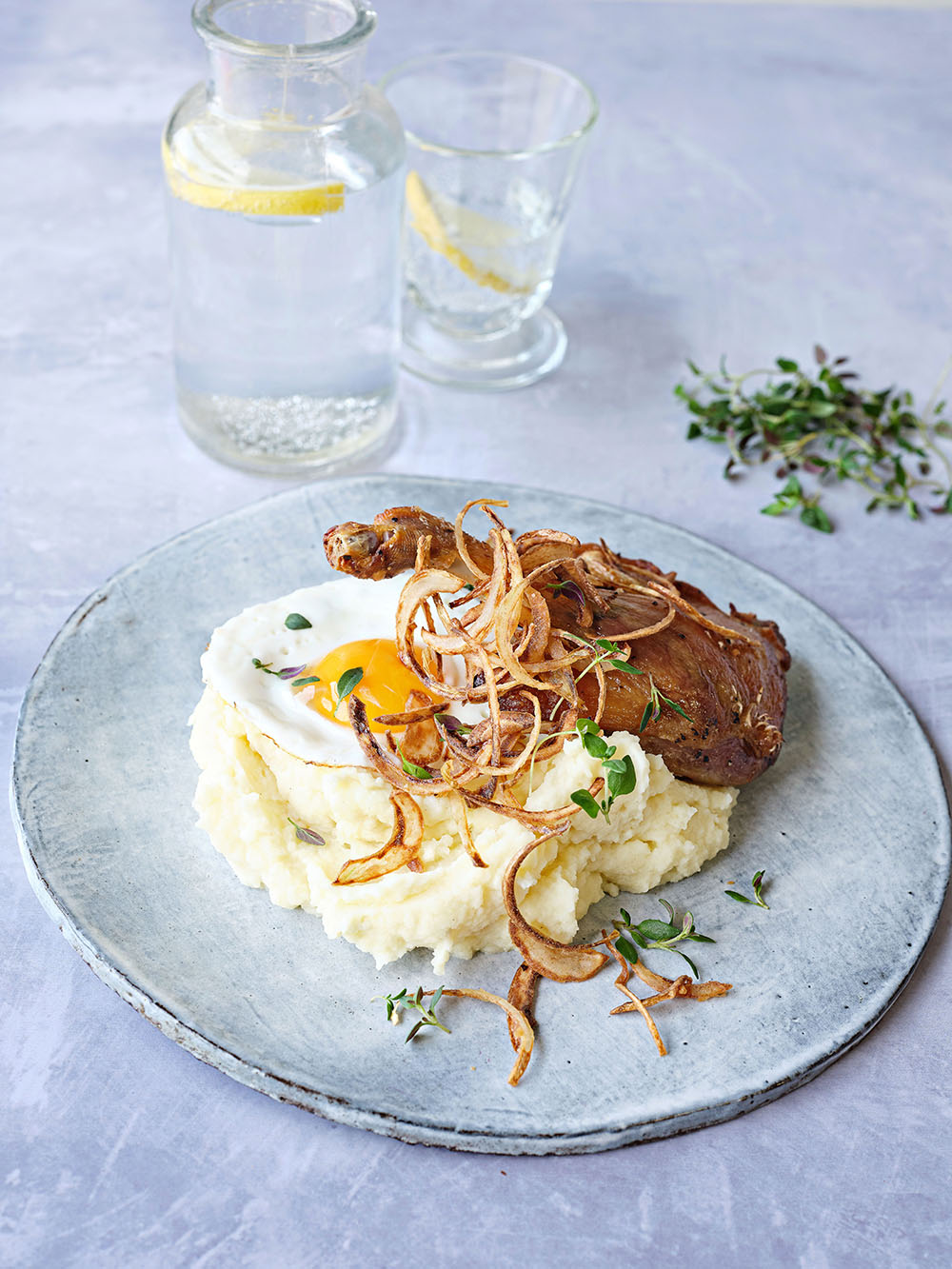 Ulster Winner: LEMON TREE CONFIT IRISH DUCK LEG WITH FRIED EGG AND CRISP FRIED ONIONS
Ulster Winner: LEMON TREE CONFIT IRISH DUCK LEG WITH FRIED EGG AND CRISP FRIED ONIONS
Owner-chef Christopher Molloy says this is a favourite dish at the family-owned Lemon Tree Restaurant in Letterkenny, where it is also made using chicken legs. Eggs are supplied to the Lemon Tree by the Patton family of Ballyshannon, who produce Castle Free Range Eggs and run the Castle Open Adventure Farm. Serves 2
Ingredients
2 Irish confit duck legs
300g mashed potato
150ml cream
50g butter
1 onion, thinly sliced
25g plain flour
3 tbsps olive oil
2 eggs
Sea salt and freshly ground black pepper
Method
1. Preheat the oven to Gas Mark 4, 180°C (350°F).
2. Place the duck legs onto a baking tray and into the preheated oven for 20-25 minutes
3. To make the potato mousse, beat the mashed potato, cream and butter together until soft and smooth.
4. Heat two inches of cooking oil to 180°C in the base of a medium saucepan. Toss the onion in the flour and season ensuring to separate the onion pieces and that they are evenly coated. Once the oil has come up to temperature gently fry the onion in batches, taking care not to overcrowd the pan. Fry for 2-3 minutes until golden and then remove with a slotted spoon to plate lined with kitchen paper.
5. Heat the olive oil in a large frying pan over a low to medium heat. Crack the eggs into the pan, one at a time and fry for 3-4 minutes on a gentle heat until cooked to your liking.
6. To serve: on each plate, place the potato mousse in the centre, top with a fried egg followed by a duck leg and the crispy onions.
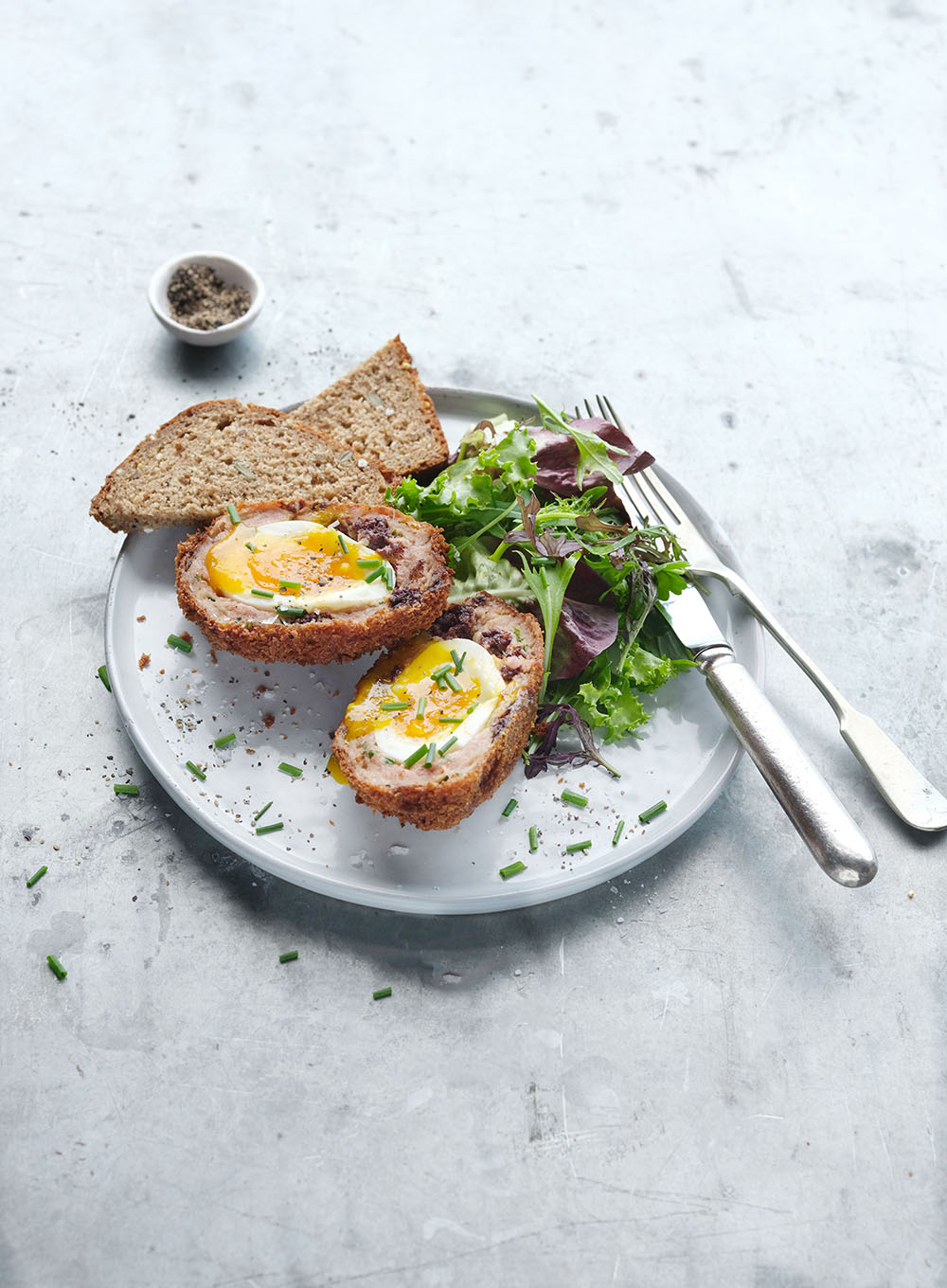 Connaught Winner: CAFÉ RUA KELLY’S SCOTCH EGG
Connaught Winner: CAFÉ RUA KELLY’S SCOTCH EGG
Cooking at the original Café Rua on New Antrim Street in Castlebar, Chef Javier Serrantes makes the house variation on ever-popular scotch eggs using Claremorris Free Range Eggs – and those other vital ingredients, black pudding and sausage meat from the famous Mayo butchers, Kelly’s of Newport. Serves 4
Ingredients
6 eggs
400g sausage meat – Kelly’s breakfast sausages
130g Kelly’s black pudding, crumbled
2 tbsps chopped mixed herbs (chives, sage, parsley and thyme, rosemary are all good)
1 tbsp Dijon mustard
Splash of milk
100g flour
100g breadcrumbs
Vegetable oil, to cook
4 slices brown bread
50g mixed leaves
Method
1. Put four of the eggs into a saucepan, cover with cold water and bring to the boil. Turn down the heat and simmer for five minutes, then put straight into a large bowl of iced water for at least 10 minutes.
2. Put the meat, pudding, herbs, and mustard into a bowl – you’ll need to add very little seasoning, as the sausage meat will already contain salt. Mix well with your hands. Divide into four.
3. Carefully peel the eggs.
4. Beat the two raw eggs together in a bowl with a splash of milk. Put the flour in a second bowl and season it with salt and pepper, then tip the breadcrumbs into a third bowl. Arrange in an assembly line.
5. Lightly flour an egg, pat out some meat mix on a lightly floured board and carefully encase the egg in it. Repeat the process for all the eggs. Dip each meat-covered egg in flour, then egg wash, then breadcrumbs.
6. Fill a deep saucepan pan a third full of vegetable oil, and heat to 170°C (or when a crumb of bread sizzles and turns golden, but does not burn, when dropped in it). Keep the heat under the oil moderate throughout cooking, so the crumbs achieve nice dark golden colour, yet the meat is cooked thoroughly. Cook the eggs, a couple at a time, for eight minutes, until crisp and golden, then drain on kitchen paper before serving.
7. Serve with mixed leaves and some brown bread.
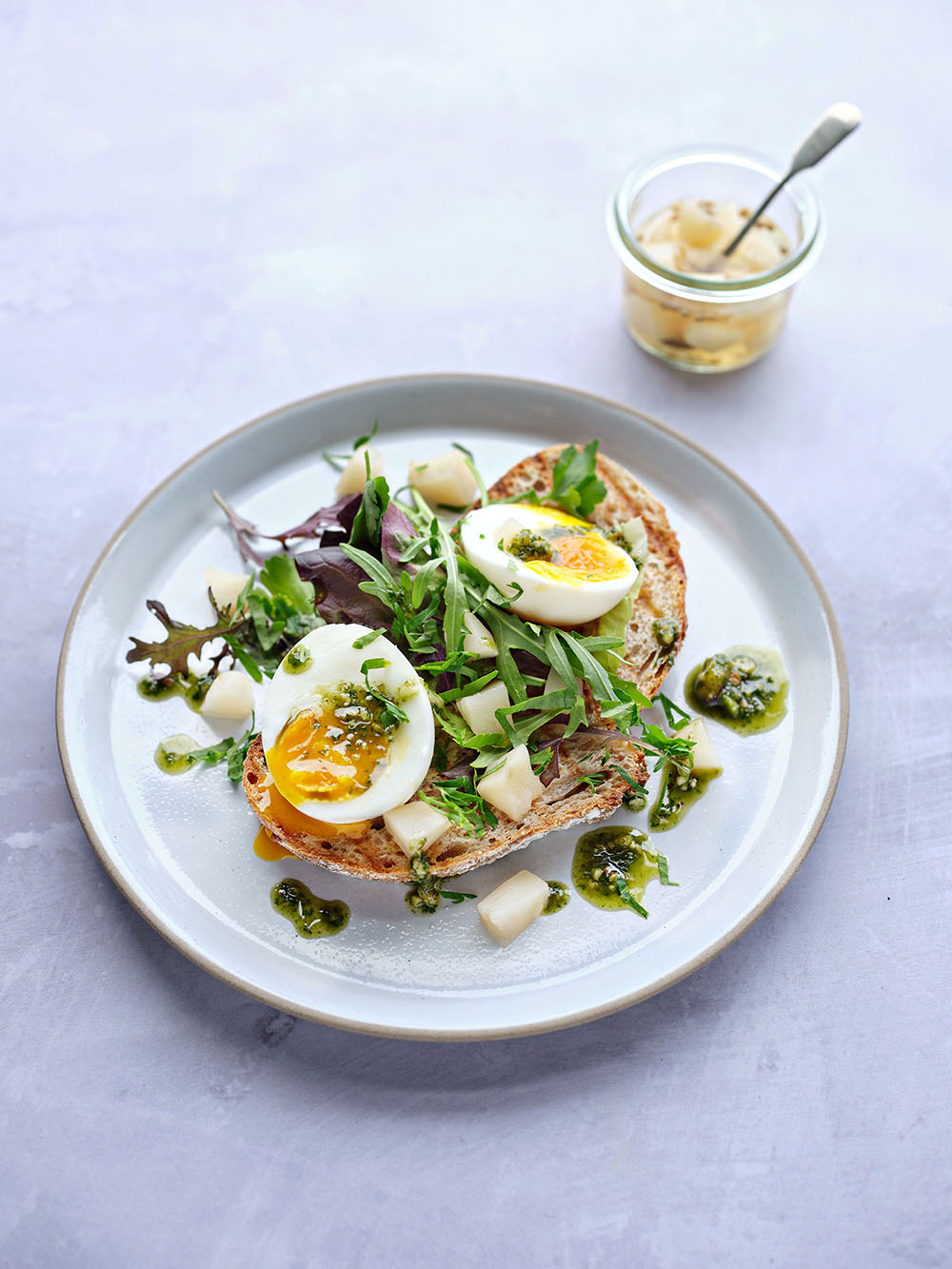 Leinster Winner: VIEWMOUNT HOUSE SIX-MINUTE EGG AND JERUSALEM ARTICHOKE
Leinster Winner: VIEWMOUNT HOUSE SIX-MINUTE EGG AND JERUSALEM ARTICHOKE
Eggs from the O'Halleran Family Farm at Kenagh, Co Longford feature in this delicious dish created by Head Chef Marcio Laan for the renowned VM Restaurant at Viewmount House. Serves 4
Ingredients
6 Jerusalem artichokes, peeled
1 tbsp dashi (or rice wine) vinegar
1 tsp caster sugar
1 tsp coriander seeds
4 eggs
4 slices wholemeal sourdough
1 tbsp olive oil
50g mixed leaves
2 tbsp basil pesto
Sea salt and freshly ground black pepper
Method
1. Bring a small saucepan of salted water to the boil over a high heat, reduce the heat slightly and place the artichokes into the water and gently simmer for 15-20 minutes, until cooked through. Remove from the water and dice into half centimetre pieces.
2. Place in a small bowl along with the vinegar, sugar, sea salt and coriander seeds and leave to pickle for at least two hours or overnight.
3. Bring a small saucepan of water to the boil and add the eggs for six minutes. Cool the eggs down in ice water to prevent further cooking, then peel them then they are cold.
4. Heat a griddle pan over a high heat, brush the sourdough on each side with the olive oil and toast on the heated griddle pan for 1-2 minutes on each side or until charred.
5. Place a slice of sourdough onto each plate. Top with some mixed leaves, an egg, the pickled Jerusalem artichokes and a drizzle of pesto.
Cookery Feature - The Garden Chef
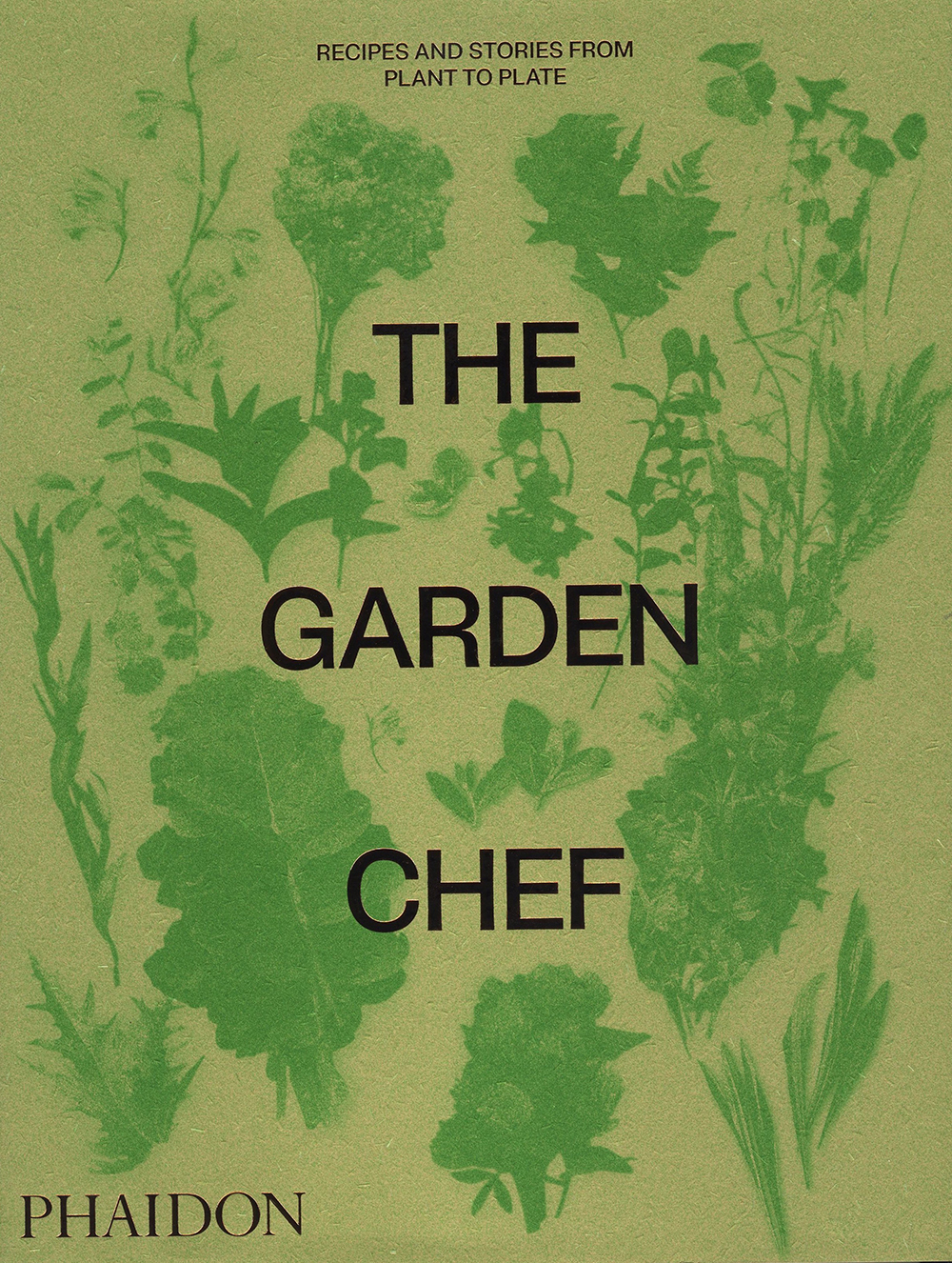
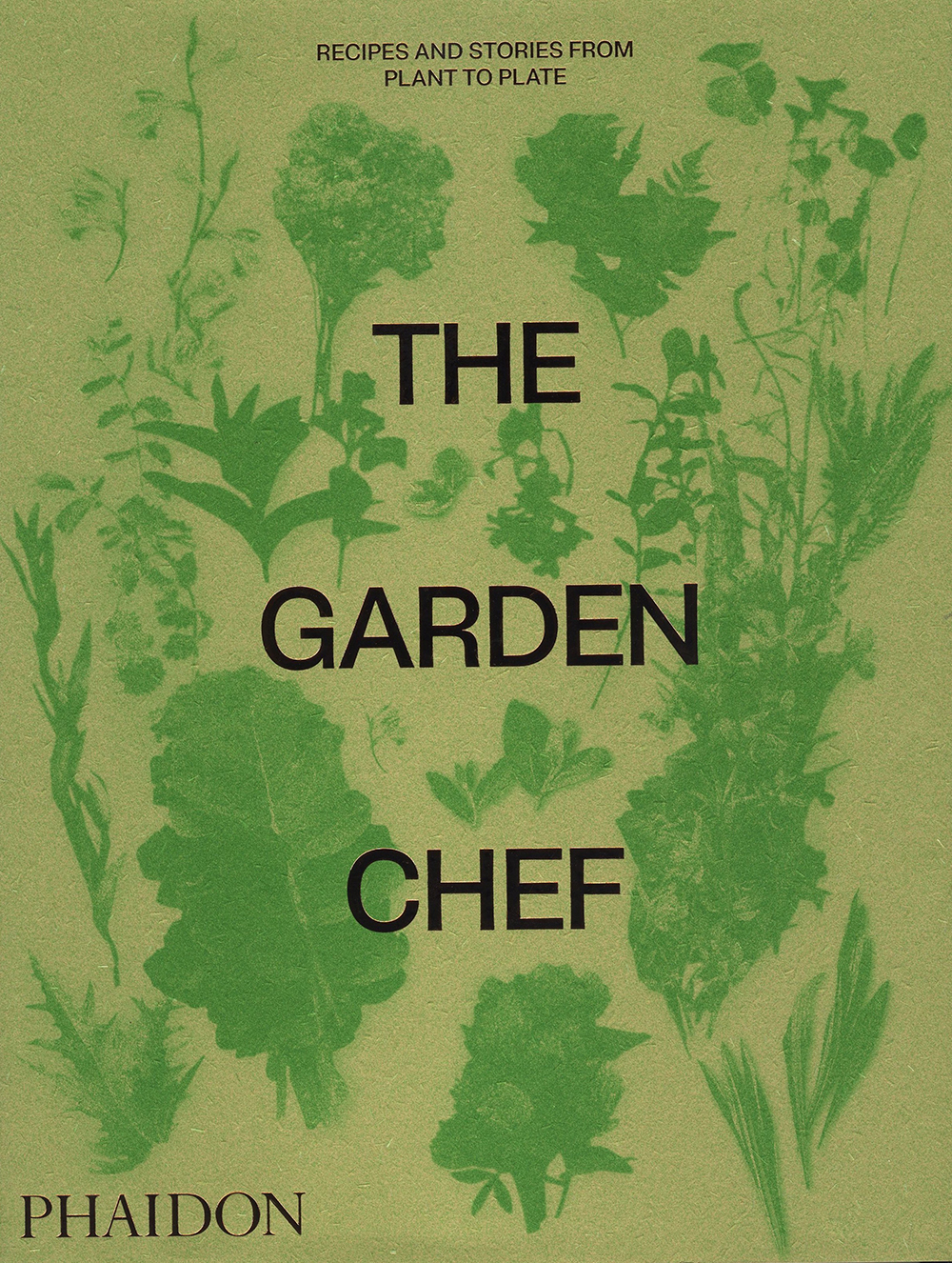 A modern retake on the days when many top chefs had the gardens - and probably the home farm too - of a large estate to call on when writing the day’s menu, the return of the kitchen garden is one of the most welcome developments in recent restaurant (and hotel) history.
A modern retake on the days when many top chefs had the gardens - and probably the home farm too - of a large estate to call on when writing the day’s menu, the return of the kitchen garden is one of the most welcome developments in recent restaurant (and hotel) history.
It’s happening all over the globe and The Garden Chef, Recipes & Stories from Plant to Plate (published by Phaidon, £29.95 /€35) celebrates the trend through the stories of 40 of the world’s top chefs who share the stories of their gardens and signature recipes based on ingredients used straight from the garden. Ireland is not represented, alas, but there are plenty of familiar names including Robin Gill, Skye Gyngell, Magnus Nilsson, Simon Rogan and Alice Waters, as well as many inspiring restaurants and gardens from chefs who may be less familiar.
The gardens vary enormously, from roof garden, polytunnels, allotments, walled gardens to cliffside vegetable patches, but they all tell unique stories, provide hints on choosing the best varieties for their growing conditions and highlight the importance of the garden for sustainability, and as a peaceful refuge away from the busy kitchen.
Shortly after publication, one of the featured restaurants, Mirazur, the Cote D'Azur restaurant from Argentinian-born chef Mauro Colagreco, was announced winner of The World's 50 Best Restaurant Awards and the citation for the number one spot on the list praises the restaurant’s “three levels of cascading vegetable gardens” in which Colagreco and his team cultivate “the sweetest produce.”
With an introduction by the widely respected US pioneer in plant-based cooking, Jeremy Fox (author of ‘On Vegetables’, and with a new restaurant Birdie G’s recently opened in Santa Monica), it’s the perfect summer cookbook for chefs everywhere - and a great read for anyone who’s interested in the Plant to Plate ethos.
Sample Recipe by Mauro Colagreco, of Mirazur:
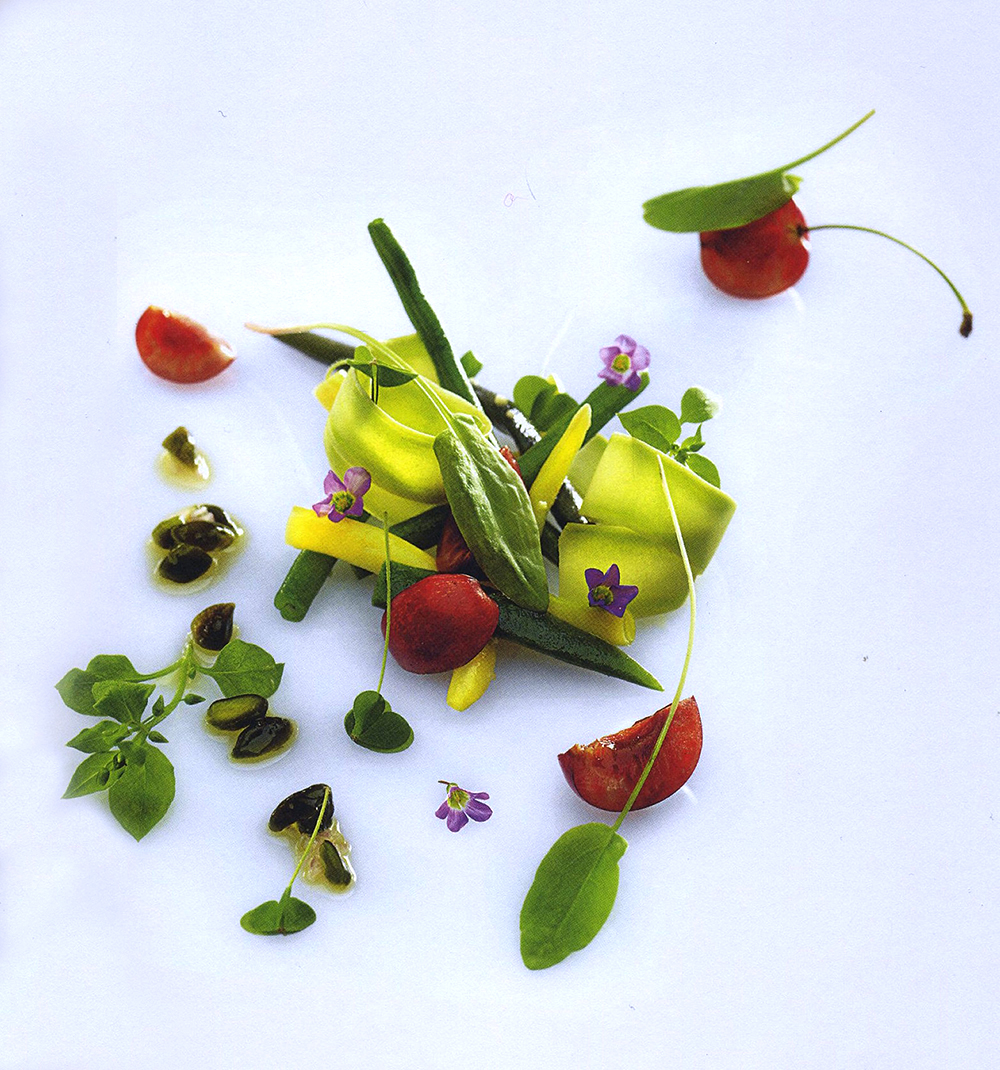
GREEN BEANS, CHERRIES, PISTACHIOS
“This is one of my oldest recipes and one of the most heartfelt dishes I have ever created. There are so many memories in this dish. It reminds me of my childhood when my mom used to cook green beans for dinner and put some pistachios on top to decorate the dish. I grow various varieties of green beans in my garden and get my cherries from an incredible producer just 20 minutes from Mirazur in la Vallee de Gorbio, a small town in the mountains. The idea for the dish came to me when I grew green beans for the first time in my garden: I remember having so many ideas for how I could use them. I wanted to share these memories with my customers in a unique dish.”
SERVES 4
Ingredients:
VINAIGRETTE
extra-virgin olive oil
white balsamic vinegar
50 ml pistachio oil?
VEGETABLES
200 g green beans
100 g lima (butter) beans
100 g yellow wax beans
1 Tromba d'Albenga squash
small piece of fresh ginger, peeled
olive oil, to taste
fleur de sel, to taste
salt
TO SERVE
1 shallot, finely diced
100 g cherries, pitted
oxalis
chickweed flowers
A red onion, finely diced
20 shelled pistachios
wild arugula (rocket) leaves
Method:
VINAIGRETTE Make a vinaigrette with some olive oil, white balsamic vinegar, and the pistachio oil.
VEGETABLES Blanch the three types of beans in a pan of salted boiling water for a couple of minutes. Drain, then refresh in a bowl of ice water.
Use a mandolin to cut the squash lengthwise into long, thick slices.
Drain the beans from the ice water, put them into a bowl, and flavour them with freshly grated ginger, olive oil, and fleur de sel.
TO SERVE Place the beans on plates in an arrangement that creates volume. Add the squash slices, shallot, cherries, oxalis, and chickweed flowers, and sprinkle the salad with the vinaigrette and fleurde sel. Finish with the diced red onion, 5 pistachios per plate, and the wild arugula (rocket) leaves.
Cookery Feature - From Tide To Table
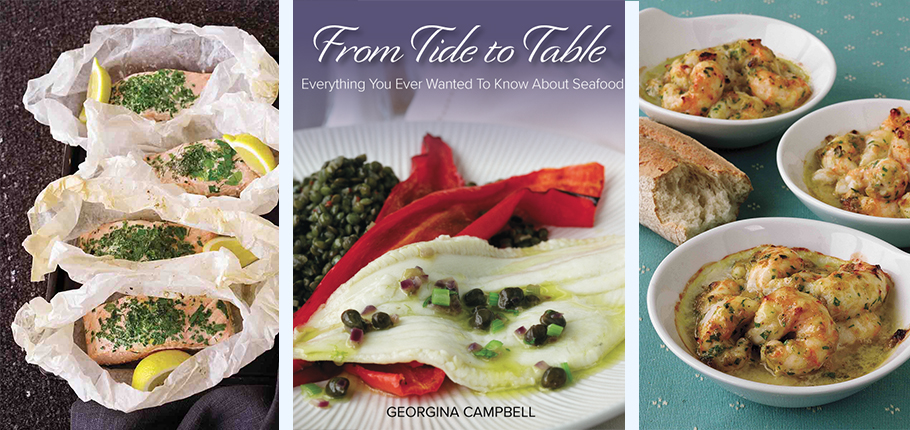
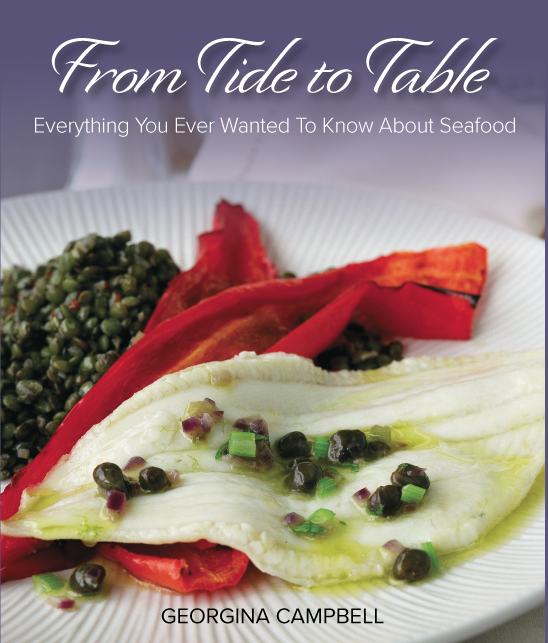 We’re delighted to announce the arrival of a new edition of Ireland’s original ‘seafood bible’, From Tide To Table - Everything You Ever Wanted To Know About Buying, Preparing & Cooking Fish and Seafood. A user-friendly book designed to help even the most reluctant of home cooks to feel comfortable cooking, and shopping for, fish and seafood, it is sure to become a favourite go-to reference on many a kitchen bookshelf.
We’re delighted to announce the arrival of a new edition of Ireland’s original ‘seafood bible’, From Tide To Table - Everything You Ever Wanted To Know About Buying, Preparing & Cooking Fish and Seafood. A user-friendly book designed to help even the most reluctant of home cooks to feel comfortable cooking, and shopping for, fish and seafood, it is sure to become a favourite go-to reference on many a kitchen bookshelf.
From nutritious easy-to-prepare family meals to classic seafood dishes that always impress, this seriously delicious ‘How To’ book is a complete guide to identifying, buying, preparing and cooking the wide variety of fish and seafood caught or harvested in Irish waters - and the recipes specially photographed by Paul Sherwood not only suit every mood and occasion, but they are more than the sum of their parts as they add up to create a versatile repertoire that can be adapted for other similar types of fish and seafood, as available.
Giving the lie to the idea that cooking fish is ‘tricky’, From Tide To Table gives home cooks the low-down on all the basic cooking methods, and - importantly - the sauces, side dishes and accompaniments (including sea vegetables) that pair best with fish and seafood.
This practical book also provides an insight into the wide range of fish and seafood available in Ireland and introduces some of the dedicated people who help to bring quality seafood to our tables and those who encourage us to learn more - through visits to specialist producers, for example, and foreshore foraging trips. Dishes featured include everything from wonderful chowders, great classics like prawn cocktail and grilled lobster or sole on the bone, to comfort food, family fare, international favourites and gorgeous seafood party platters.
Although of special interest to Irish cooks, the range of species covered will be familiar in other territories, and the principles of preparation and cooking are universal
Available in good book shops, selected fish retailers and online From Tide To Table is priced at EUR20/stg18/$20; p&p free in Ireland (North and South)
SAMPLE RECIPES:
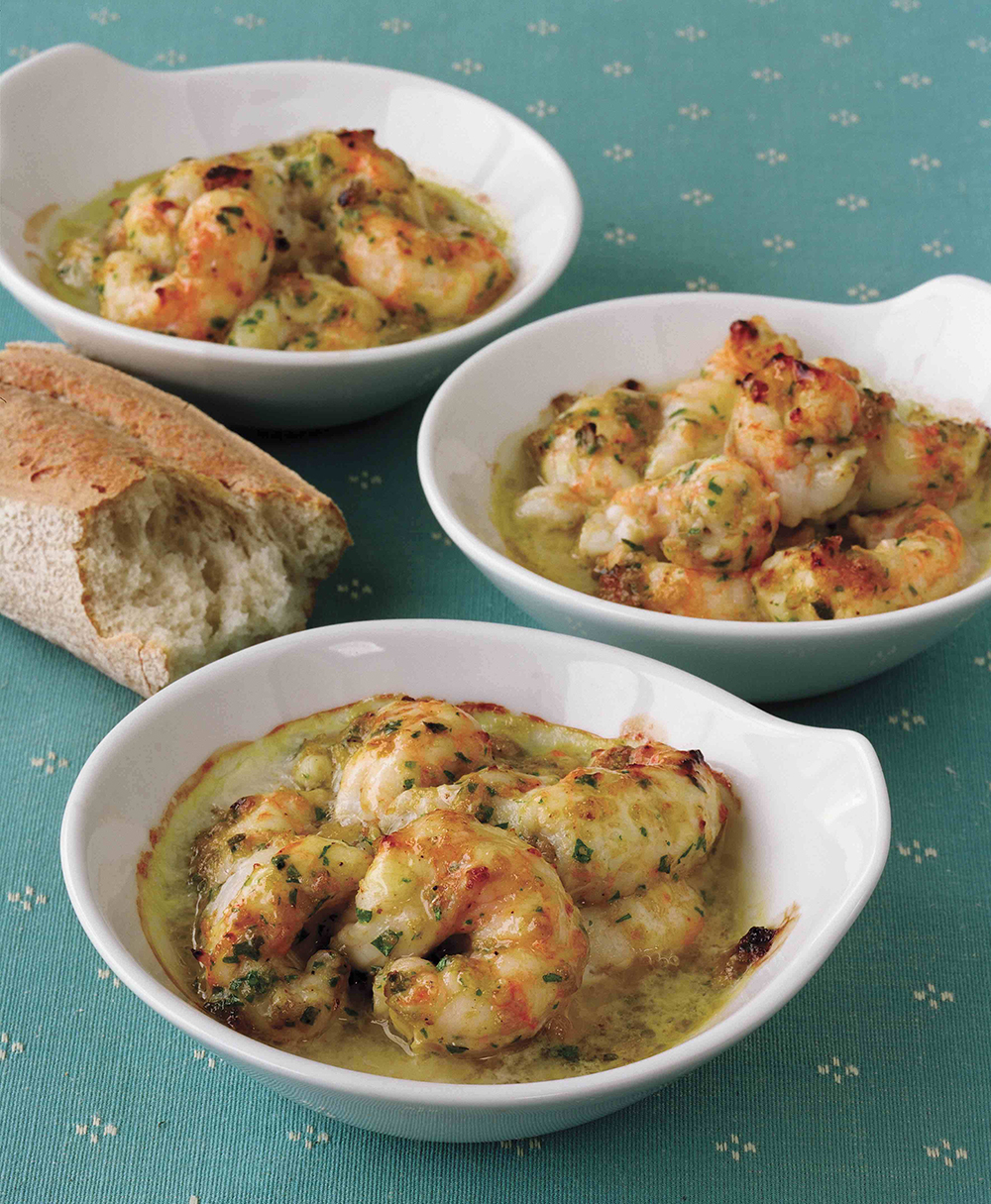 Aromatic Prawns
Aromatic Prawns
This clever recipe is ideal as a starter or light meal and will quickly become a favourite as it’s perfect for preparing in advance, to pop into the oven when you are ready to eat. The fragrant seeds and spices add a wonderful aromatic scented flavour to the prawns but will not overpower their own subtle taste. Make sure you have plenty of warm crusty bread to mop up all the delicious juices.
450g/1lb large raw peeled Dublin Bay prawns (langoustines), veins removed
butter, for greasing
good pinch each of dill seeds, mustard seeds and coriander seeds
1 small onion, finely chopped
1 garlic clove, finely chopped
2 tbsp chopped fresh flat-leaf parsley
good pinch each cayenne pepper, ground allspice and cloves
2 tbsp white wine vinegar
4 tbsp olive oil
salt and freshly ground black pepper
To Serve: warm crusty bread
SERVES 4
Preheat the oven to 190ºC/375ºF/Gas 4. Place the prawns in buttered individual ovenproof dishes or one shallow casserole dish.
Heat a small frying pan and toast the dill, mustard and coriander seeds for a couple of minutes until fragrant. Tip into a mini-blender or food processor. Blend to a fine powder and then add the onion, garlic and parsley with the rest of the ground spices.
Add the wine vinegar to the mixture and then pour in the oil, in a steady trickle, until the mixture emulsifies. Pour over the prawns, place in the oven and bake for 15 minutes. Serve straight to the table with a basket of crusty bread to hand around.
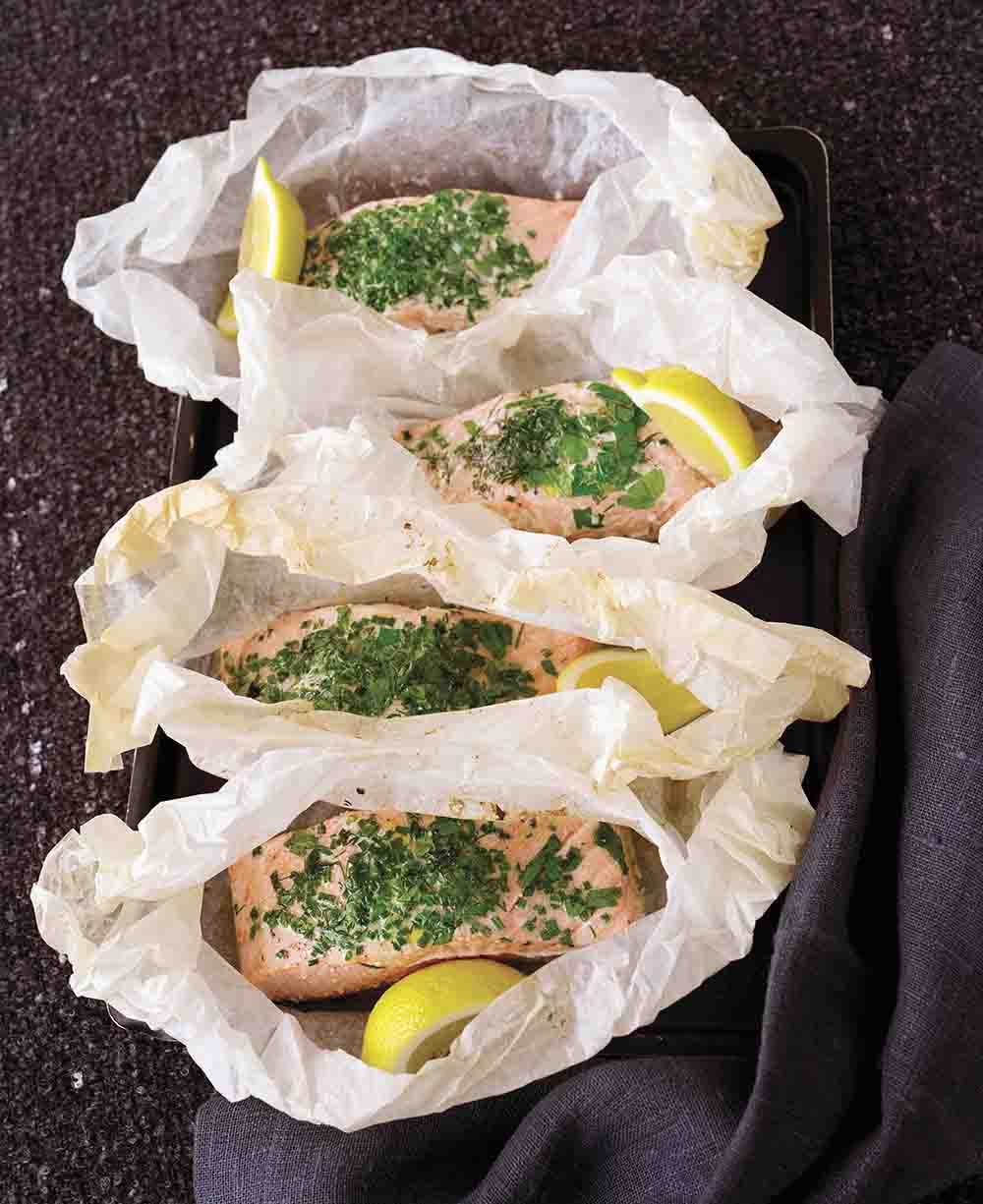 Salmon Parcels
Salmon Parcels
Salmon is Ireland’s favourite fish and one of its greatest attractions is how well it adapts to different cooking methods. This is a very healthy way to cook it, but it must not be overcooked. When the parcels are opened the salmon should still be pink inside when it is served: press the flesh gently – it should give slightly; if it is wobbly or jelly-like it is undercooked but don’t allow it to become firm, as it will then be overcooked and will have lost its succulent texture.
4 x 175g/6oz skinless salmon fillet, pin bones removed
handful of fresh herb sprigs, choose from dill, parsley, coriander, marjoram and chives
a few green peppercorns 4 tbsp dry white wine salt and freshly ground black pepper lemon wedges, to garnish
To Serve
basil crushed potatoes (see below)
SERVES 4
Preheat the oven to 190ºC/375ºF/Gas 5. Using a dinner plate as a size guide, cut out four circles of non-stick parchment paper. Place a piece of salmon on each one and gently scrunch up the sides.
Scatter the herbs over the salmon portions with the peppercorns and season to taste, then drizzle a tablespoon of the wine on each one. Wrap up to enclose and arrange on a baking sheet. Bake the salmon parcels for 8-10 minutes, or until the salmon is cooked through and tender.
Open the salmon parcels and garnish each one with a lemon wedge. Serve on warmed plates with the basil crushed new potatoes, if liked.
VARIATION
Instead of salmon, try using cod, trout, lemon sole, brill or even turbot.
Basil Crushed New Potatoes
These potatoes are a kind of textured mash, so don’t be tempted to make it too smooth. Pile them into a cooking ring (small metal circular mould) set on the serving plates for a really professional result.
675g/11/2lb new / baby potatoes, scraped or scrubbed
120ml/4fl oz extra virgin olive oil
handful fresh basil leaves
salt and freshly ground black pepper
Serves 4-6
Place the potatoes in a large pan of boiling water and bring to the boil. Cover and simmer for 12-15 minutes until tender, then drain well.
Tip the cooked potatoes into a large bowl. Add the olive oil and with the back of a fork, gently crush each potato until it just splits. Season, and then mix carefully until all the oil has been absorbed. Finely chop the basil and stir through the potatoes, then season to taste and serve at once.
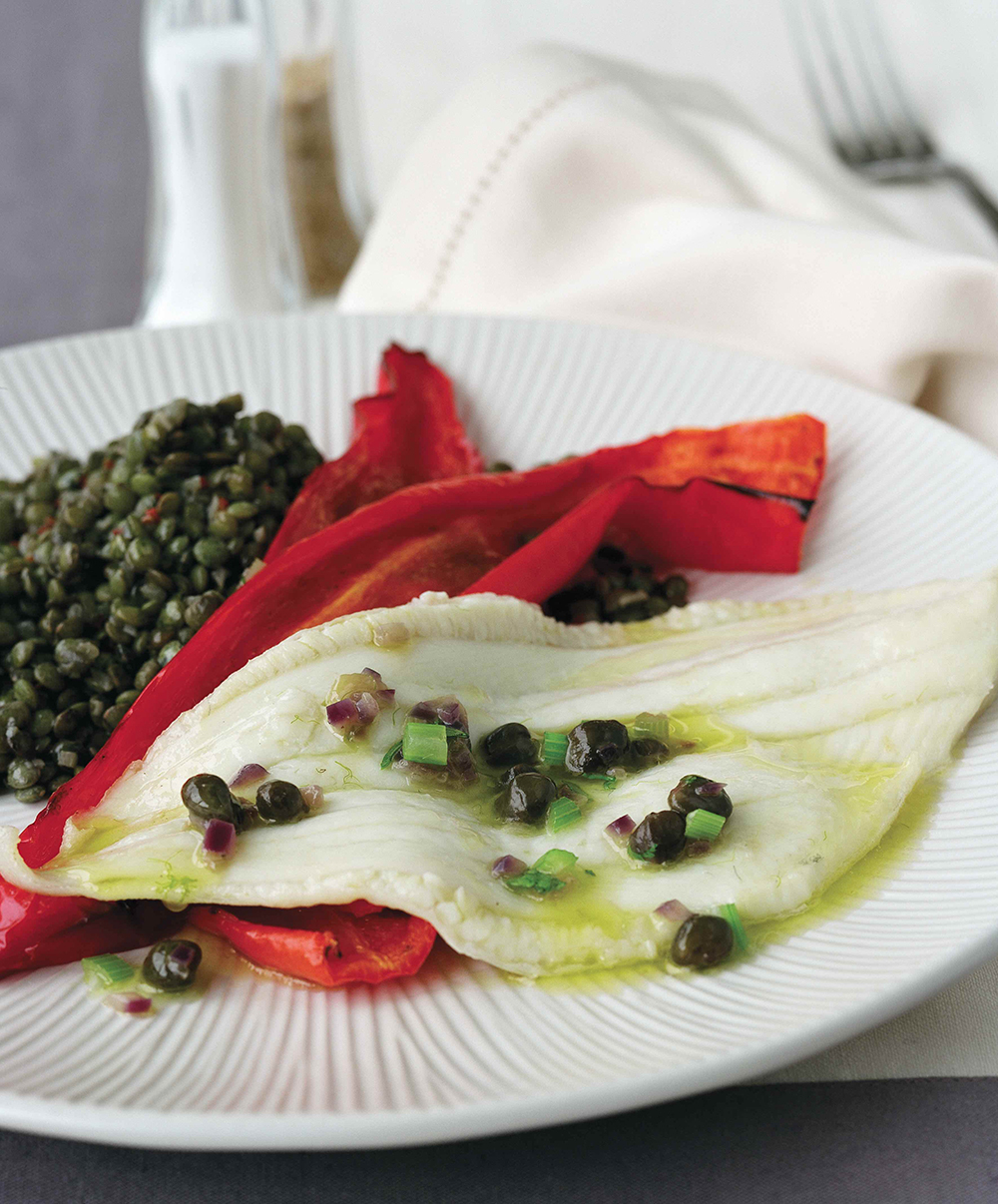 Grilled Plaice with Red Onion, Caper and Fennel Butter (cover image)
Grilled Plaice with Red Onion, Caper and Fennel Butter (cover image)
Beautifully located on Galway Bay, Michael O’Grady’s charming restaurant, O’Grady’s on the Pier, offers a varied seafood menu with views over the harbour and beach at Barna, County Galway. A typical dish is grilled fish, with an accompanying butter – very simple and straightforward, and really delicious. Alternatives to the butter that is given here include parsley & lemon butter and lime, chilli & coriander butter.
4 large plaice fillets
100g/4oz butter
1 small red onion, finely chopped
pinch of lemon rind
squeeze of lemon juice
a few capers
2 tbsp finely diced fresh fennel
salt and freshly ground black pepper
To Serve
braised puy lentils, roasted Piedmont peppers (see below)
SERVES 4
Preheat the grill.
To prepare the red onion, caper & fennel butter, place the butter in a pan with the red onion, lemon rind and juice, capers and fennel and warm together until just softening - there should still be a crunch.
Arrange the plaice fillets on a non-stick baking sheet and spoon over enough of the butter sauce to just coat. Place directly under the grill for about 4 minutes, without turning, until just cooked.
To serve, spoon the braised puy lentils onto warmed plates and arrange the roasted Piedmont peppers to the side. Warm through the remaining butter sauce and then carefully transfer the plaice fillets onto the plates, spooning the remaining butter sauce on top.
VARIATIONS
For a special occasion, use Dover sole; otherwise small brill or lemon sole would work well.
Braised Puy Lentils
These puy lentils are cooked with plenty of vegetable stock and have real layers of flavour. If you haven’t got the time to make homemade stock, a good quality stock cube will do the trick. They can be made well in advance and reheated as needed.
2 tbsp olive oil
2 garlic cloves, finely chopped
1 mild red chilli, seeded and finely chopped (optional)
225g/8oz puy lentils
900ml/1½ pints vegetable stock
salt and freshly ground black pepper
SERVES 4-6
Heat the olive oil in a heavy-based pan. Stir in the garlic and chilli, if using, and sauté briefly. Add the lentils and then pour in the stock. Bring to the boil, then reduce the heat and simmer for 15-20 minutes or until tender. Drain off any excess liquid and season to taste. Use as required.
Roasted Piedmont Peppers
Although the stalks of the peppers are not edible they do look attractive and help the peppers keep their shape. They are also delicious filled with some peeled, quartered and seeded plum tomatoes or even with a couple of anchovy fillets snipped inside before roasting.
4 large red peppers
2 tbsp olive oil plus extra for greasing
sea salt and freshly ground black pepper
fresh basil leaves, to garnish
Serves 4-6
Preheat to 180ºC/350ºF/Gas 4. Cut the peppers in half and remove the seeds but leave the stalks intact. Arrange the pepper halves in a lightly oiled baking tin.
Season the pepper halves and drizzle the olive oil on top. Roast for 15-20 minutes or until the peppers are completely tender and lightly charred around the edges.
Transfer the peppers to plates and spoon over all of the cooking juices. Garnish with the basil leaves and serve warm, or at room temperature.
Cookery Feature - Autumn Bakes from the Christmas Book List
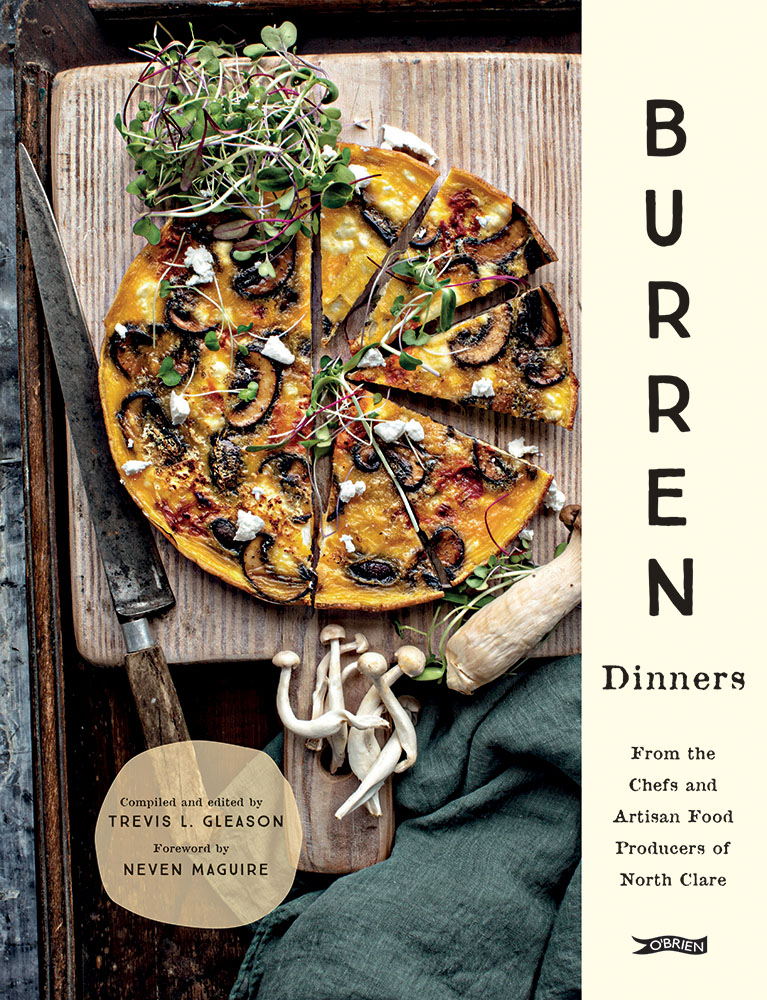
We’ve been diving into some of the best new Irish cookbooks in search of tasty autumn bakes this month - and the year’s Christmas crop includes some pretty gorgeous recipes.
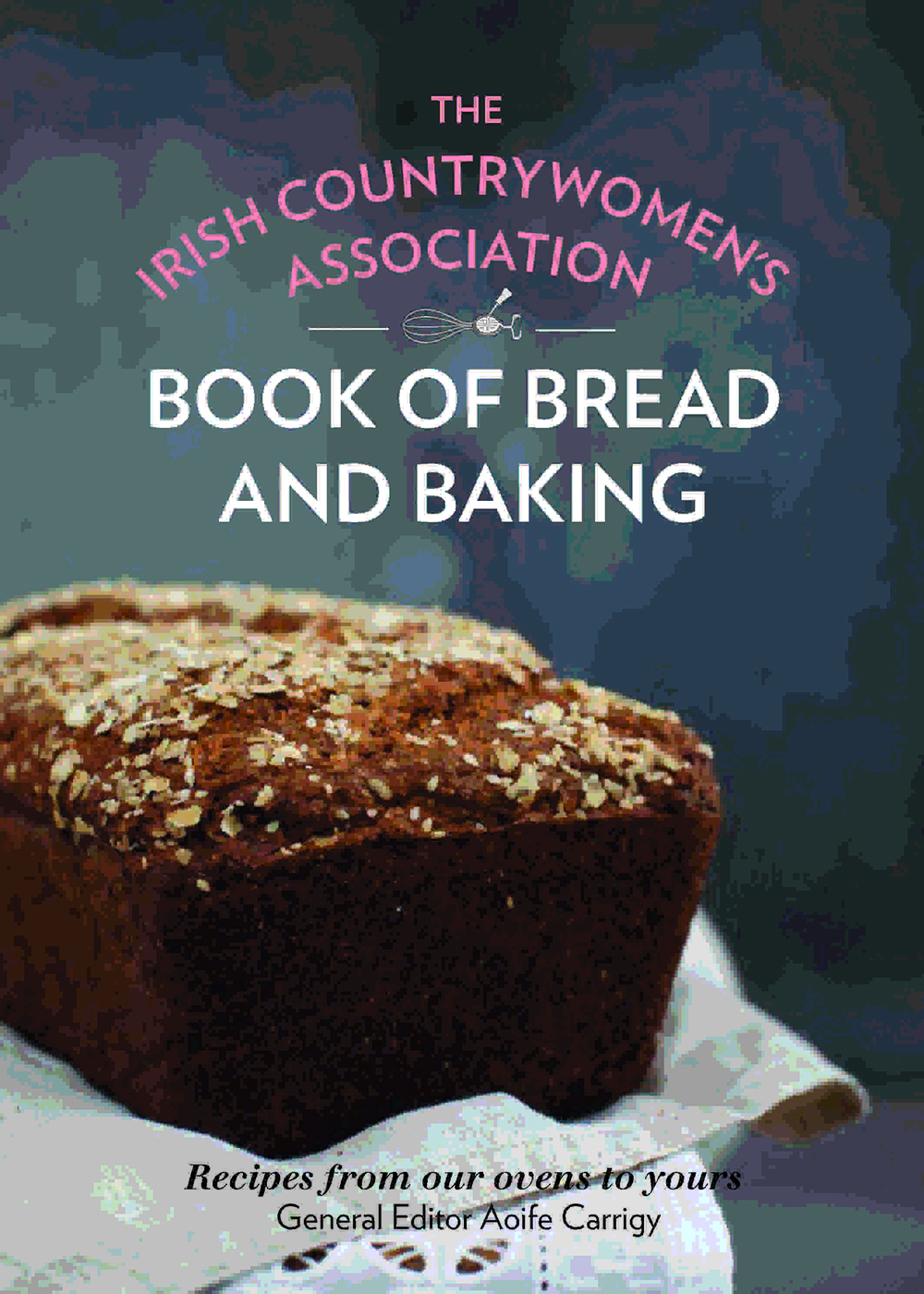 The Irish Countrywomen’s Association (ICA) was founded in 1910 with the aim to ‘improve the standard of life in rural Ireland through education and co-operative effort’; today this thriving organisation has 700 guilds throughout Ireland and this is their fifth cookbook. Edited by Aoife Carrigy, with photograhy by Leo Byrne, THE ICA BOOK OF BREAD AND BAKING (Gill Books, hardback, 208pp €22.99) focuses on the speciality they’re best known for - home baking. The main emphasis is on all kinds of breads, but there’s plenty else including cakes, biscuits, muffins and buns, traybakes, puddings and more…
The Irish Countrywomen’s Association (ICA) was founded in 1910 with the aim to ‘improve the standard of life in rural Ireland through education and co-operative effort’; today this thriving organisation has 700 guilds throughout Ireland and this is their fifth cookbook. Edited by Aoife Carrigy, with photograhy by Leo Byrne, THE ICA BOOK OF BREAD AND BAKING (Gill Books, hardback, 208pp €22.99) focuses on the speciality they’re best known for - home baking. The main emphasis is on all kinds of breads, but there’s plenty else including cakes, biscuits, muffins and buns, traybakes, puddings and more…
SAMPLE RECIPE: Bacon and Peanut Butter Muffins
From Marion Lyon, Maghera Guild, Cavan: “Indulgence isn’t just for those with a sweet tooth. These savoury muffins balance sweet and salty flavours and make a great choice for a mid-morning snack or lunch box addition along with some cheese and fruit.”
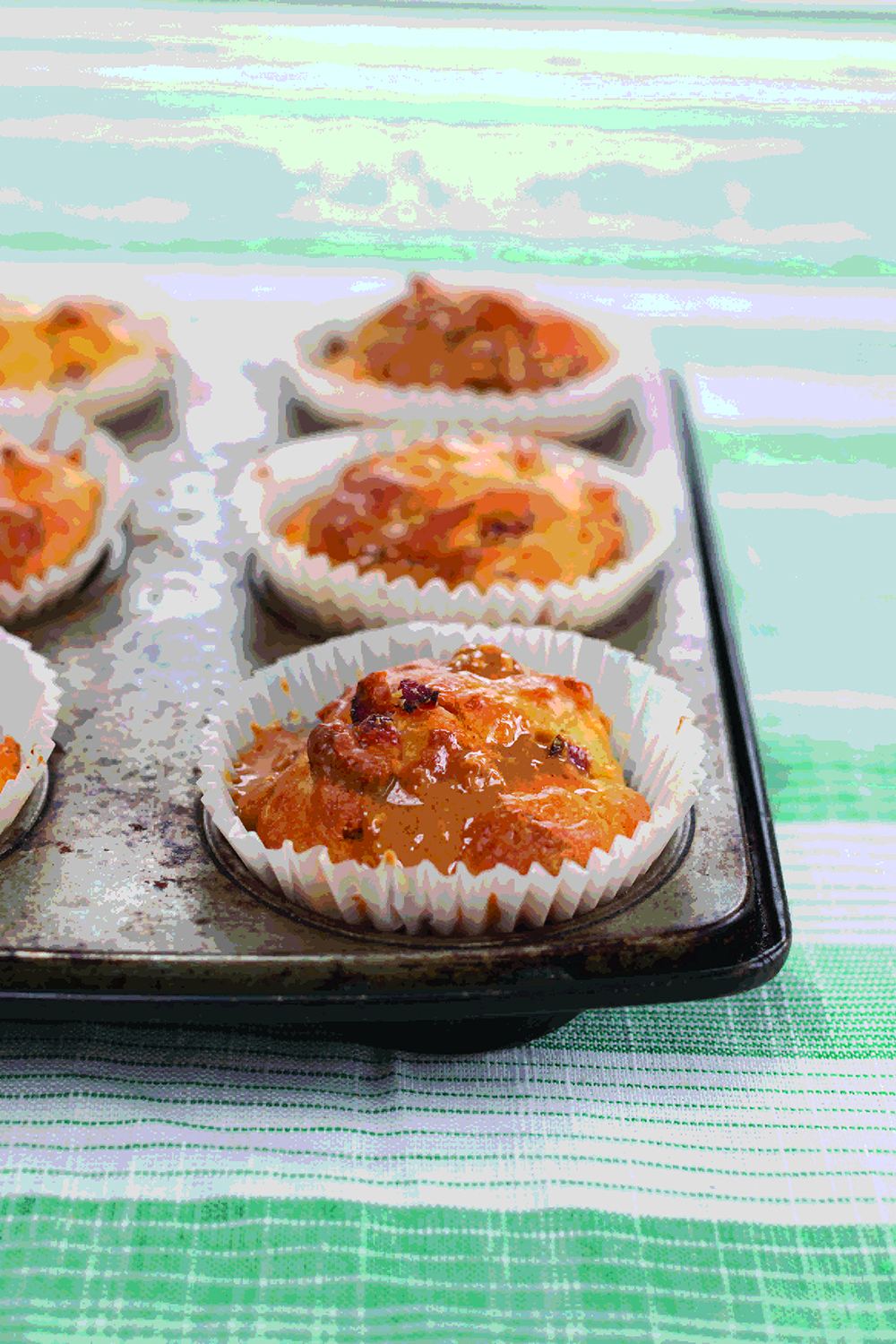 Makes 12 muffins
Makes 12 muffins
300g (10½oz) plain flour, sieved
2 tablespoons (30g/1oz) caster sugar
1 tablespoon baking powder
1 teaspoon salt
2 tablespoons (2½oz) bacon fat or butter
1 egg
275ml (½ pint) milk
3 uncooked bacon rashers, finely chopped
2 heaped tablespoons (2½oz) peanut butter
what you’ll need
12-cup muffin tin
paper muffin cases (optional)
wire rack
Preheat oven to 200ºC/400ºF/Gas 6. Lightly grease a 12- cup muffin tin or line with muffin cases.
Sieve the flour, sugar, baking powder and salt together in a mixing bowl.
Gently melt the bacon fat or butter. Meanwhile beat the egg in another large mixing bowl and whisk in the milk. Add the melted fat and chopped, uncooked bacon, and mix well. Stir in the flour mixture, but do not beat; the mixture should be just moistened.
Spoon out a little batter into each well of your muffin tin (or muffin case if using), then drop about a third of a teaspoon per muffin of peanut butter into each before topping up with batter to fill each well three-quarters full.
Bake in the preheated oven for 20–25 minutes or until risen and golden all over.
Remove from the oven and allow to cool in tin for a few minutes before transferring to wire rack to cool fully. These will keep for a day or two in an airtight container, or for a few months frozen if well-wrapped.
ICA Tip: For a sweet variation, reduce the salt to half a teaspoon, and replace the peanut butter and bacon with a cup of blueberries; you may not need quite as much milk to bind it so add half to start and then as much as you need after that.
 Simplicity has always been Darina Allen’s mantra and it’s the main theme of her 19th book, ONE POT FEEDS ALL (Kyle Cathie hardback, £20) . “One pot, one dish, one roasting tin. I can’t believe it’s taken me so long to write this book as it’s been bubbling away in my subconscious for years,” she says in her Introduction. Down to earth as ever, the 100 classic and contemporary recipes cover a wide range of styles, from Irish seasonal treats to international favourites - with no complicated techniques required.
Simplicity has always been Darina Allen’s mantra and it’s the main theme of her 19th book, ONE POT FEEDS ALL (Kyle Cathie hardback, £20) . “One pot, one dish, one roasting tin. I can’t believe it’s taken me so long to write this book as it’s been bubbling away in my subconscious for years,” she says in her Introduction. Down to earth as ever, the 100 classic and contemporary recipes cover a wide range of styles, from Irish seasonal treats to international favourites - with no complicated techniques required.
SAMPLE RECIPE: Apple and Blackberry Traybake with Sweet Geranium Sugar
You’ll find yourself reaching for this recipe over and over again. Here I use apple and blackberries with sweet geranium, but I also love it with green gooseberries and elderflower, or plums. I enjoy arranging the blackberries and apples in neat lines, but if you are super busy just sprinkle them over the top of the sponge base.
Serves 10-12
 8–12 lemon geranium leaves (Pelargonium graveolens)
8–12 lemon geranium leaves (Pelargonium graveolens)
3–4 cooking apples, such as Bramley Seedling or Grenadier
150g (5oz) blackberries
75g (3oz) caster sugar
crème fraiche or softly whipped cream, to serve
For the Sponge Base
225g (8oz) softened butter
175g (6oz) caster sugar
275g (9oz) self-raising flour
4 organic, free-range eggs
Preheat the oven to 160°C/Gas Mark 3.
Line the base of a 33 x 23 x 5cm cake tin, or a 25.5cm sauté pan or cast-iron frying pan with parchment paper, allowing it to hang over the sides. Arrange 6–8 sweet geranium leaves over the base – these give the sponge a haunting lemony flavour.
To make the sponge base, combine the butter, sugar and flour in the bowl of a food processor. Whizz for a second or two, then add the eggs and stop as soon as the mixture comes together. Spoon the mixture over the base of the tin as evenly as possible (over the sweet geranium leaves).
Peel the apples. Cut into thin slices and arrange on top of the sponge in three lines. Arrange a line of blackberries in between each row. Sprinkle 25g (1oz) of the caster sugar over the top and bake for about 50 minutes.
Meanwhile, whizz 2–4 sweet geranium leaves with the remaining 50g (2oz) caster sugar in a food processor. Spread over a baking tray and set aside at room temperature to dry out.
Once it is fully cooked, the centre of the cake should be firm to the touch and the edges slightly shrunk from the sides of the tin. Serve in the tin, sprinkled with the sweet geranium sugar. Alternatively, leave to rest in the tin for 4–5 minutes before turning out. Serve with crème fraiche or softly whipped cream.
 Following on the success of The Extra Virgin Kitchen and The Virtuous Tart, Sunday Independent columnist Susan Jane White’s third book CLEVER BATCH (Gill hardback, €24.99) is all about time management. Describing herself as ‘an undercaffeinated, financially cramped, time-pinched mum’, she sets about freeing up some time in her week by ‘creating nourishing dishes that can sit in your fridge all week, or hang out on your kitchen shelves’. Well planned shopping and batch cooking may not be a new idea, but she brings it to a new generation with her kickass style and a trademark healthy message - inspired by a serious immune disorder that she developed at 25, which marked the beginning of her nutritional pilgrimage and a career in wholefoods cooking.
Following on the success of The Extra Virgin Kitchen and The Virtuous Tart, Sunday Independent columnist Susan Jane White’s third book CLEVER BATCH (Gill hardback, €24.99) is all about time management. Describing herself as ‘an undercaffeinated, financially cramped, time-pinched mum’, she sets about freeing up some time in her week by ‘creating nourishing dishes that can sit in your fridge all week, or hang out on your kitchen shelves’. Well planned shopping and batch cooking may not be a new idea, but she brings it to a new generation with her kickass style and a trademark healthy message - inspired by a serious immune disorder that she developed at 25, which marked the beginning of her nutritional pilgrimage and a career in wholefoods cooking.
SAMPLE RECIPE: Chocolate Buckwheat Granola
The number of expensive granolas to choose from in our supermarkets is unprecedented in the history of Homo sapiens. Trust me, you can make a much better one for a fraction of the price at home. This one has three different grains, making it a complete protein by virtue of its amino acid permutation. That’s bench presser speak for ‘high-five’. Sporty teens will go mental for it. Find rice malt and barley malt syrup in savvy delis and health food stores nationwide.
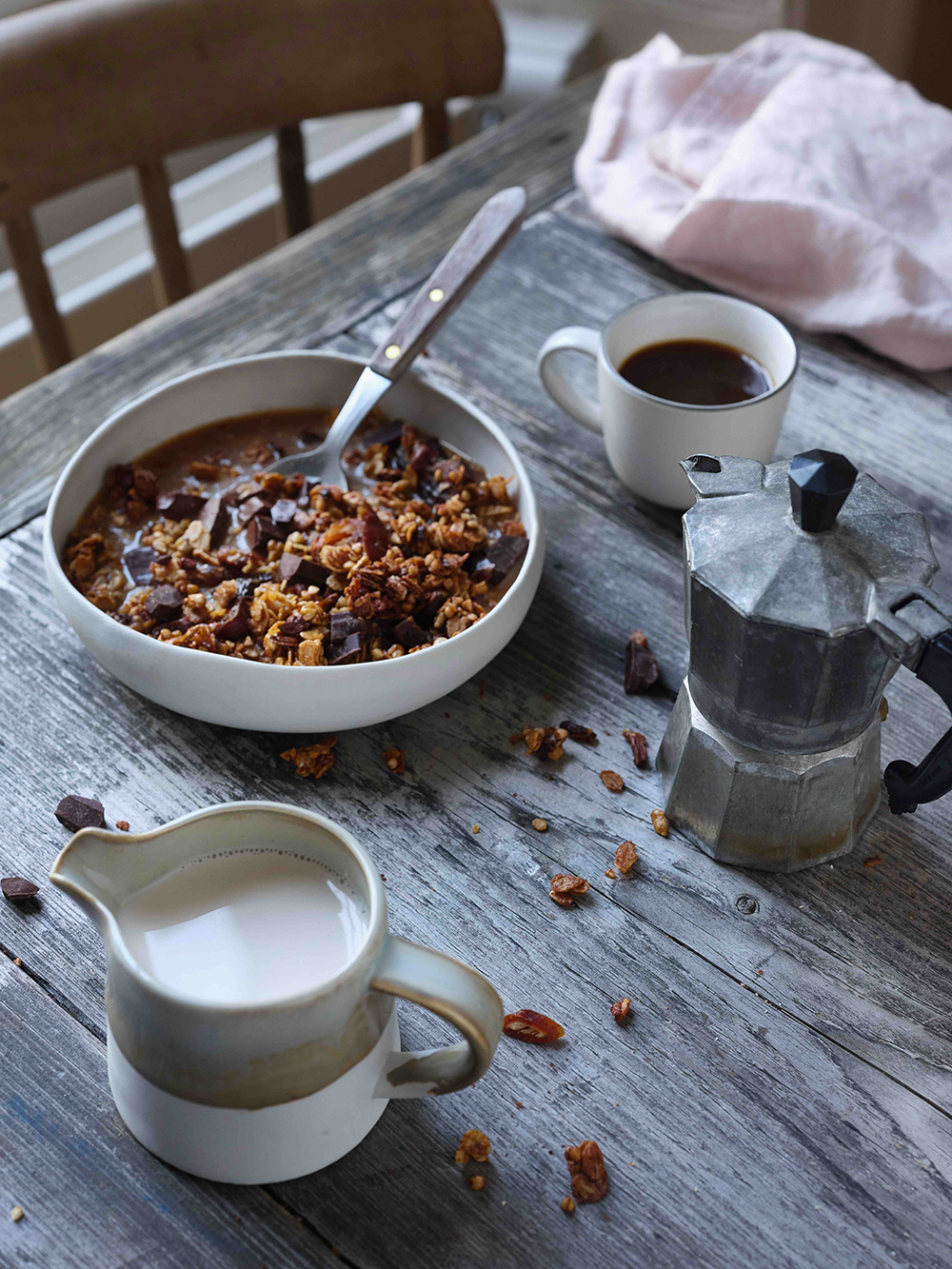 MAKES ENOUGH FOR 1 MASSIVE KILNER JAR
MAKES ENOUGH FOR 1 MASSIVE KILNER JAR
125ml extra virgin coconut oil or ghee
125ml rice malt syrup or barley malt syrup
1 teaspoon ground cinnamon
1 teaspoon vanilla bean paste or good-quality extract
150g oat flakes
150g barley flakes (or more oat flakes)
150g whole buckwheat groats (not flakes)
100–130g hazelnuts or pecans
4 tablespoons raw cacao nibs (optional)
Pinch of flaky sea salt
200g regular pitted dates, chopped
100g dark chocolate, such as Green & Blacks cooking chocolate, chopped into chunks
Fire up your oven to 160°C. Line your largest tray (or use two smaller trays) with non-stick baking paper.
In your biggest pot, melt your preferred fat, your syrup, cinnamon and vanilla over a timid heat. Turn off the heat.
Now tumble in all the remaining ingredients except the dates and dark chocolate. Scrape the contents of the pan out over your lined tray(s).
Bake in the oven for 25 minutes and not a minute longer. Allow the granola to cool completely before stirring through the chopped dates (Medjools are even more magnificent, but can bump up the price) and glorious chunks of chocolate. Store in a tall glass jar on the kitchen counter. Stunning stuff with ice-cold milk. Lasts for weeks on your kitchen shelf.
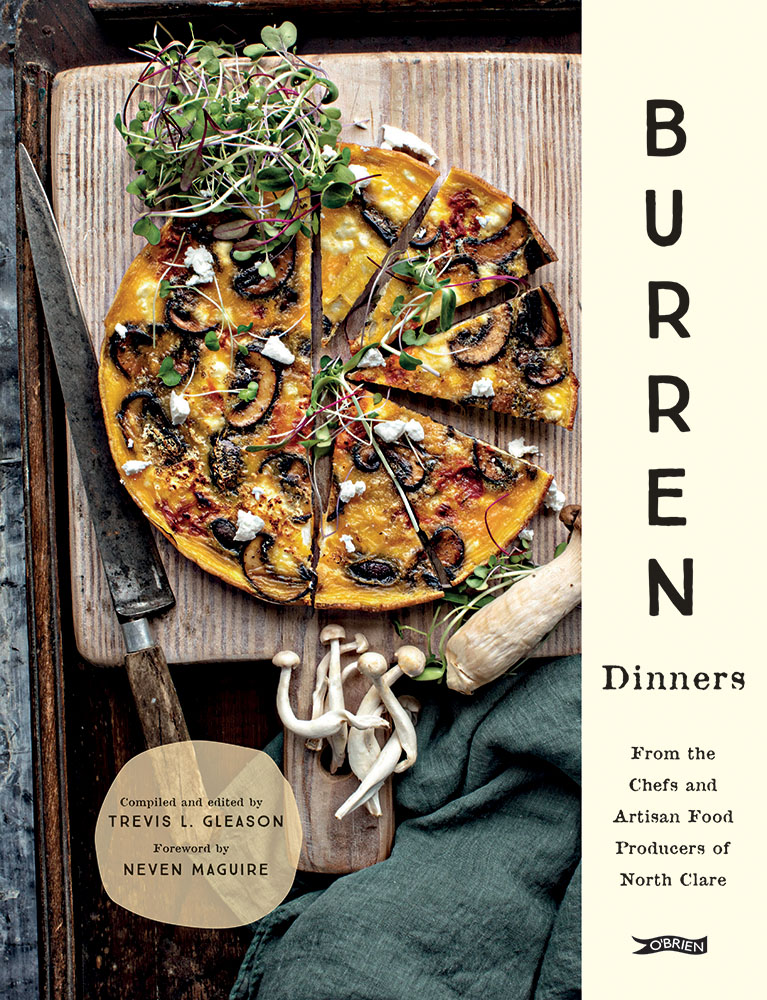 New from Trevis L. Gleason, author of the acclaimed Dingle Dinners, BURREN DINNERS (O’Brien Press hardback, €24.99) does for north Clare what Dingle Dinners did for north Kerry, by bringing together a collection of special recipes from the area’s chefs and artisan food producers that express its “rugged surroundings, local ingredients and generations-old passion for communal dining”.
New from Trevis L. Gleason, author of the acclaimed Dingle Dinners, BURREN DINNERS (O’Brien Press hardback, €24.99) does for north Clare what Dingle Dinners did for north Kerry, by bringing together a collection of special recipes from the area’s chefs and artisan food producers that express its “rugged surroundings, local ingredients and generations-old passion for communal dining”.
SAMPLE RECIPE: Pecan and Maple Baked Cheesecake by Vivian ‘Viv’ Kelly, The Burren Storehouse, Lisdoonvarna.
Serves 6
For the base
225 g/8 oz shortbread biscuits
30 g/1 oz/2 tbsp unsalted butter plus more for greasing
For the filling
625 g/22 oz cream cheese
225 g/8 oz/1 cup + 2 tbsp light brown sugar
½ tsp salt
3 eggs
120 ml/4 fl oz/½ cup cream
2 tsp vanilla extract
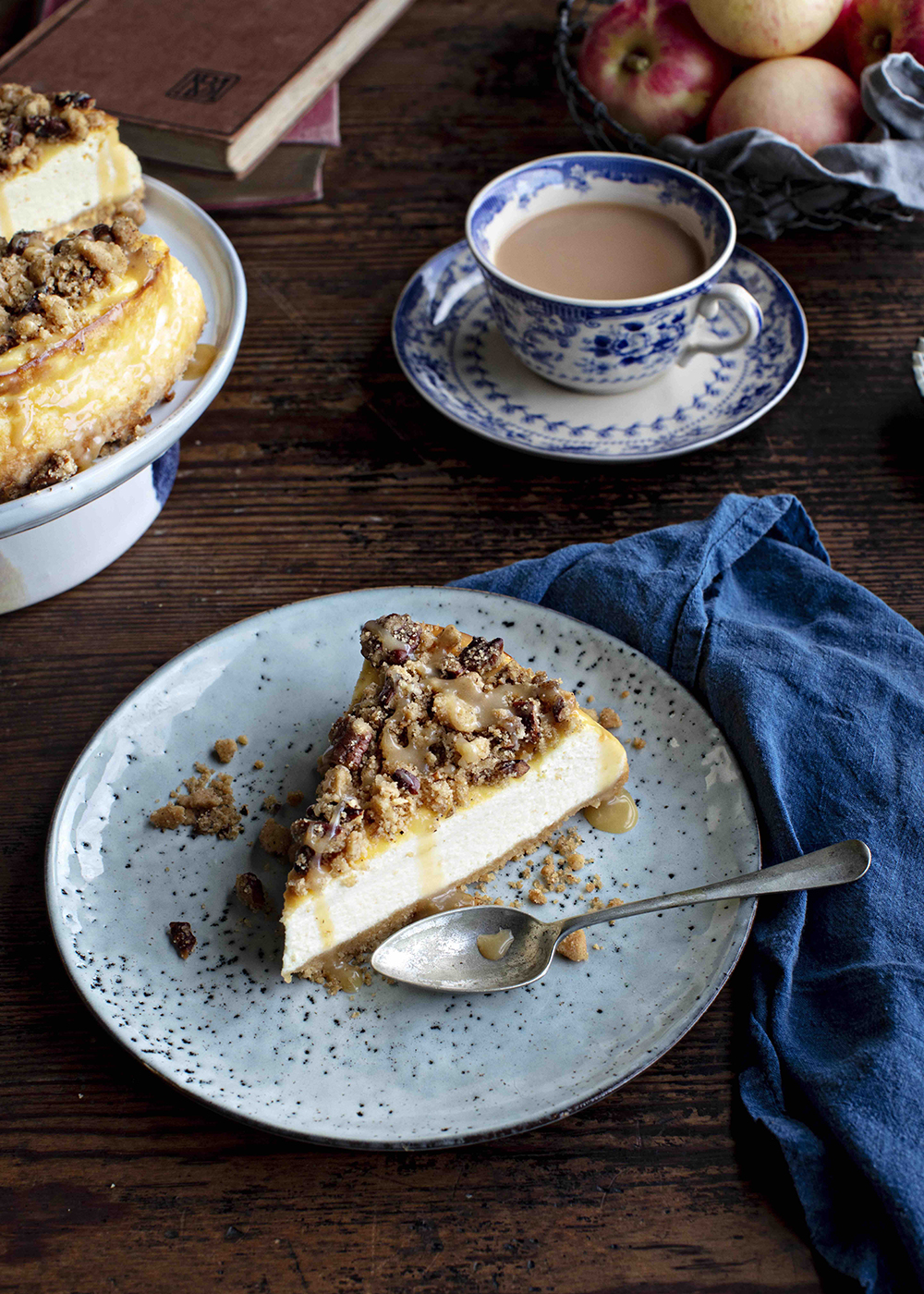 For the topping
For the topping
20 g/¾ oz/4 tsp butter
50 g/1¾ oz/ 1/3 cup pecans, roughly chopped
75 g/2 ½ oz shortbread biscuits, crumbled
25 g/¾ oz/2 tbsp light brown sugar
For the maple sauce
30 g/1 oz/2 tbsp butter
50 g/1¾ oz/¼ cup caster sugar
80 ml/3 fl oz/ 1/3 cup maple syrup
120 ml/4 fl oz/½ cup cream
Preheat oven to 140°C/280°F/Gas Mark 1. Butter a 23 cm/9-inch springform tin and line the bottom with greaseproof paper.
For the base, crush the shortbread into coarse crumbs, melt the butter and mix together in a bowl. Sprinkle the crumbs onto the base of the prepared tin.
To make the filling, beat the cream cheese, sugar and salt in a stand mixer until light. With the motor running on slow, beat in eggs, one at a time, scraping down in between. Fold in the cream and vanilla extract. Pour the mix over the biscuit base and smooth with the back of a spoon. Bake for 50 to 60 minutes until set.
Meanwhile, to make the topping, melt the butter in a saucepan over a low heat. Add the pecans and cook for 1 to 2 minutes until fragrant. Add the shortbread and sugar and cook for 2 to 3 minutes. Leave aside to cool.
Once the cheesecake has set, remove to a rack, cover with the topping and allow to cool.
To make the sauce, melt the butter, sugar, syrup and cream together in a saucepan over a medium–low heat. Increase heat to medium and bring to a boil. Cook until mixture has become a light caramel colour. Serve over the cheesecake.
Cookery Feature - Seafood For Christmas - and Beyond
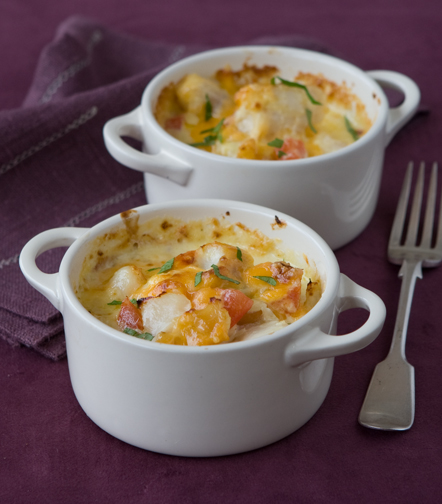
For most of us Christmas is all about tradition and Darina Allen’s column this month focuses on the creating a memorable meal with roast turkey and all the trimmings. But new traditions can be created too and it’s great to see the visionary Galway chef and seafood advocate, JP McMahon, encouraging everyone to do just that by including Irish seafood in our festive dining this year.
In an initiative to celebrate the especially high quality of our winter seafood (thanks to the colder water) and encourage people to experiment with different fish, shellfish and seaweed during the Christmas period, JP is running seafood specials each weekend in December in Tartare Café + Wine Bar winner of our ‘Taste The Island’ Innovation Award 2020’, sponsored by Fáilte Ireland), and Cava Bodega (https://www.eatgalway.ie/)
In Tartare, there are small plates like Dooncastle Oyster, Sea Lettuce, Trout Roe and Crab, Chervil Mayonnaise, Potato Crisp - while in Cava they’re serving seafood tapas such as Scallops, Black Pudding, Cauliflower, Lardo, Pistachio and Wild Mussels, Almonds, White Wine, Garlic. (And the ever-evolving tasting menus at JP’s fine dining Aniar Restaurant always keep Irish seafood, shellfish and seaweed centre stage too). To try at home, you’ll find some of JP’s favourite seafood recipes from Tartare here until the end of December.
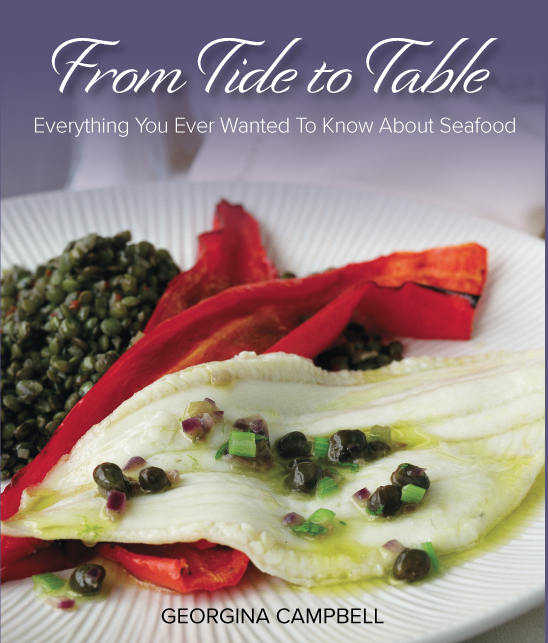 And, of course, on a more homely level our own recently published cookbook, From Tide To Table is choc-a-bloc with deliciously do-able fish and seafood recipes (including dozens of starters and light dishes), making this practical and inspiring cookbook the perfect kitchen companion for anyone who would like to include more seafood in their repertoire at Christmas – and at any time of year.
And, of course, on a more homely level our own recently published cookbook, From Tide To Table is choc-a-bloc with deliciously do-able fish and seafood recipes (including dozens of starters and light dishes), making this practical and inspiring cookbook the perfect kitchen companion for anyone who would like to include more seafood in their repertoire at Christmas – and at any time of year.
From Tide To Table, Everything You Ever Wanted to Know About Fish & Seafood, is available from bookshops & online
RECIPES (all taken from From Tide to Table):
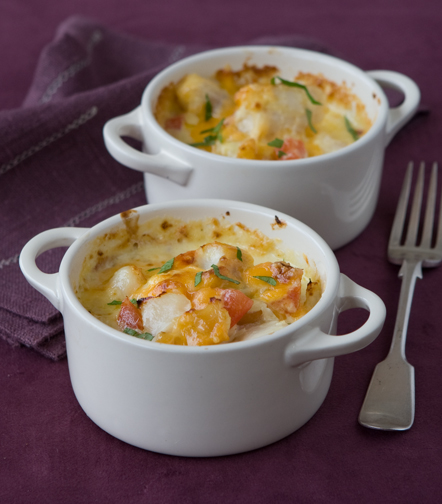 Smokies
Smokies
When a hot starter is called for, you really can’t beat this mouth-watering dish – which also makes a tasty light lunch or supper to serve with a side salad. Serves 4.
225g/8oz smoked haddock, cod or pollock (undyed if possible)
300ml/1/2 pint milk
a little finely chopped onion
pinch of freshly ground pepper
2 firm ripe tomatoes
300ml/1/2 pint cream
50g/2oz hard cheese, eg a mature red Cheddar, grated
chopped fresh flat-leaf parsley, to garnish
To Serve: freshly baked brown soda bread, or dillisk bread (see below)
Preheat the oven to 190ºC/375ºF/Gas 5. Put the smoked haddock into a pan with the milk and onion, season with pepper, then bring slowly to the boil. Remove the fish from the milk immediately. Discard the milk; skin the fish, remove any bones and break the flesh up into pieces.
Plunge the tomatoes briefly into boiling water to loosen the skins, then peel, scoop out and discard the seeds and chop the flesh. Divide half of the tomato between four ramekin dishes. Add the smoked haddock, then put the remaining tomato on top. Divide the cream among the dishes, scatter the grated cheese on top and bake for about 20 minutes until golden brown and bubbling. Garnish each dish with a little parsley and serve at once with freshly baked bread.
Dillisk Bread
This recipe came from one of Ireland’s most respected chefs, the late Gerry Galvin, who was well ahead of the curve with the use of seaweeds in Irish restaurants and served it at his famous west of Ireland fine dining destination, Drimcong House, in County Galway. The savoury flavour of the prolific Irish seaweed dillisk (aka dulse) defines this recipe but it has the natural sweetness of carrot too, making it a versatile bake that could even be served a tea bread. This bread is best eaten within two days.
Makes one 900g/2lb loaf
25g/1oz dried dillisk
100g/4oz butter, melted
1 large carrot, grated
4 eggs, lightly beaten
50g/2oz caster sugar
pinch of salt
250g/9oz plain white flour
1/2 tsp baking powder
Preheat the oven to 200C/400F/Gas 6. Soak the dillisk in a bowl of water for 5 minutes, then drain and pat dry with kitchen paper. Melt the butter in a small pan or in the microwave.
Brush the inside of a 900g/2lb loaf tin with a little of the melted butter. Place the remaining butter in a bowl with grated carrot, eggs, sugar, dillisk and salt. Mix lightly to combine.
Sift the flour and baking powder into a separate bowl and fold into the mixture butter and dillisk mixture. Transfer to the prepared loaf tin and smooth the top with a palette knife. Bake for 50 minutes, or until it is springy to the touch and a skewer inserted into the centre of the loaf comes out clean. Cool in the tin before turning out, then cut into slices to serve.
 Brandade and Smoked Fish Platter
Brandade and Smoked Fish Platter
This is an interesting combination dish to serve at a party and, if time is short, it can be simplified by including more pre-prepared items. The time needed to soak the salted fish for the brandade will vary but, as a rule, an hour or two should suffice if only lightly salted, or up to a day if it is very dried out. Alternatively, it is very easy to make your own. Simply put a fillet of cod or ling in a plastic bowl and completely cover with a thick layer of salt. Chill for 24 hours. After a day most of the salt will have turned into brine because so much water has been drawn out of the fish, which will now be sufficiently preserved to keep for up to a week. Serves 4-6
75g/3oz beetroot gravadlax, thinly sliced (purchased, or use recipe given in From Tide To Table)
75g/3oz gravadlax, thinly sliced (purchased, or use recipe given in From Tide To Table)
75g/3oz smoked salmon slices
100g/4oz smoked trout fillet
100g/4oz smoked mackerel fillet, skin removed
50g/2oz smoked eel fillet
100g/4oz hot smoked salmon fillet
1/2 loaf dillisk bread, sliced (see above)
For the Brandade
100g/4oz salt ling or cod, soaked (see introduction notes)
120ml/4fl oz olive oil
120ml/4fl oz cream
2 garlic cloves, peeled
To Serve: snipped fresh chives lemon wedges
To prepare the brandade: In a small pan, poach the soaked ling or cod with a little water for about 10 minutes, then drain and roughly flake the flesh, removing all of the skin and bones.
Meanwhile, bring the olive oil and cream to the boil in a pan. Place the ling or cod and the garlic in a blender or food processor and turn on. Gradually pour in the hot oil and cream mixture to build up a thick emulsion. Transfer to a serving bowl and set on a large platter. Garnish with the chives.
To serve: Arrange the beetroot gravadlax and gravadlax beside the brandade, along with the smoked salmon, smoked trout, smoked mackerel, smoked eel and hot smoked salmon. Add slices of the dillisk bread and lemon wedges before serving.
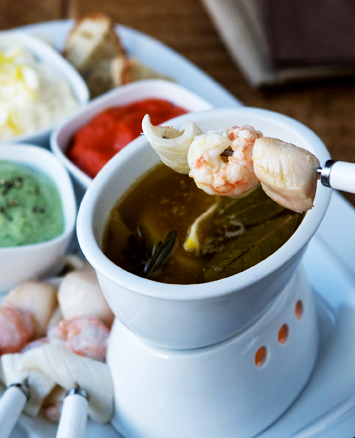 Seafood Fondue
Seafood Fondue
This is a fun way to eat seafood and a use for the fondue set that most of us have tucked away in the back of a cupboard - if not, funky fondue sets are available at reasonable prices and, although mainly intended for chocolate fondue, they are equally suitable for this recipe. As it cooks so quickly, fish is ideal for cooking at table - just scale up the quantities for a bigger party and experiment with your favourite selection of fish and seafood. Monkfish would work very well, as would salmon or tuna. Serves 4
12 prepared scallops
12 large raw peeled Dublin Bay prawns, preferably with veins removed
450g/1lb prepared squid, cut into bite-sized diamond pieces
For the Marinade
150ml/1/4 pint olive oil
150ml/1/4 pint white wine
2 garlic cloves, crushed
1 slice lemon, halved
2 bay leaves
1 fresh rosemary sprig
salt and freshly ground black pepper
To Serve: basil mayonnaise; lemon and dill mayonnaise; red pepper and chilli relish (see below)
To prepare the marinade, place the olive oil in a non-metallic bowl and stir in the wine, garlic, lemon, bay leaves and rosemary. Season to taste. Add the prepared seafood and set aside for 30 minutes to allow the flavours to develop.
Remove the seafood from the marinade with a slotted spoon and then thread a scallop, prawn and piece of squid onto each 10cm/4 inch wooden skewer. Arrange on a plate until needed - you should have 12 skewers in total.
Transfer the marinade to the fondue pan and simmer gently for 2 minutes, stirring frequently. Set the pan over the fondue burner at the table. Serve with the plate of prepared seafood for dipping and have bowls of the basil mayonnaise, lemon and dill mayonnaise and red pepper and chilli relish so that guests can help themselves.
Mayonnaise
This quick mayonnaise is made in a food processor and it will keep well in the fridge for up to one week. It only takes minutes to make and is far better than shop bought alternatives. Makes 300ml/1/2 Pint .
1 egg, at room temperature
2 tsp white wine vinegar
1/2 tsp salt
pinch of caster sugar
1 tsp Dijon mustard
120ml/4fl oz olive oil
120ml/4fl oz sunflower oil
Break the egg into the food processor and add the vinegar, salt, sugar, mustard and half of the olive oil. Secure the lid and whizz for 10 seconds. Leave to stand for a couple of seconds, then turn on again at medium speed and pour the remaining olive oil and sunflower oil through the feeder tube in a thin steady stream. This should take 25-30 seconds. Switch off the machine, take off the lid, scrape down the sides, and whizz again for 2-3 seconds. Transfer to a bowl or a jar, season to taste and cover with clingfilm. Chill until ready to use.
Variations: Lemon and Dill - stir the finely grated rind of 1 lemon and 2 tablespoons of chopped fresh dill into the mayonnaise; Basil - add a good handful of fresh basil leaves to the food processor with the egg and continue to make as described above.
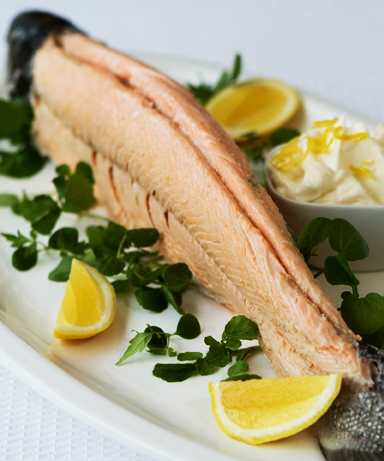 Whole Poached Salmon
Whole Poached Salmon
Salmon and celebrations tend to go hand in hand and no buffet table is complete without a magnificent dressed whole salmon as the centrepiece. This method of cooking salmon produces a moist perfectly cooked fish every time. The larger the fish the more liquid required and, therefore, the longer the liquid takes to heat up and cool down again. Any leftovers can be used in sandwiches. Sea trout can be used instead of the salmon when available, and an easy alternative hot salmon dish (to prepare ahead and cook at the last minutes) is Salmon Kiev – the recipe is given in From Tide To Table. Serves at least 8.
1.8kg/4lb salmon, gutted, scaled and cleaned (gills removed)
150ml/1/4 pint dry white wine
2 bay leaves
few slices lemon
1 small onion, sliced
few fresh parsley sprigs
few black peppercorns
1 stuffed olive, halved (optional)
salt and freshly ground black pepper
watercress sprigs and lemon wedges, to garnish
To Serve: lemon and dill mayonnaise (Stir the finely grated rind of 1 lemon and 2 tablespoons of chopped fresh dill into ½ pint/300ml mayonnaise).
Wash the salmon well under cold running water. Remove the head and tail if wished. To poach, place the salmon in a fish kettle. Pour over the white wine and just enough water to cover the fish. Add the bay leaves, lemon, onion, parsley and peppercorns. Cover the fish kettle with a lid. Bring the liquid slowly to the boil and simmer for 2 minutes. Turn off the heat and leave the salmon (still covered) in the liquid until it is quite cold.
When the salmon is completely cold, carefully remove the skin. Scrape away any brown flesh to reveal the pink underneath. If the head and tail are still on, remove the eyes, if liked, and fill the sockets with half a stuffed olive or fresh herb sprigs. Cut a 'v’ shape in the tail to neaten it. Cover and chill for at least 30 minutes.
Place the salmon on a large serving platter and garnish with watercress sprigs and lemon wedges to serve. Accompany with the lemon and dill mayonnaise.
VARIATION: Baked Whole Salmon
Place the salmon on a large piece of buttered foil and pour over the wine. Scatter the bay leaves, lemon, onion, parsley and peppercorns on top. Fold the foil loosely over the fish to enclose completely. Bake at 190ºC/375ºF/Gas 5 for 10 minutes per 450g/1lb until cooked through.
Rua Café & Deli - Irish Bread Award 2020
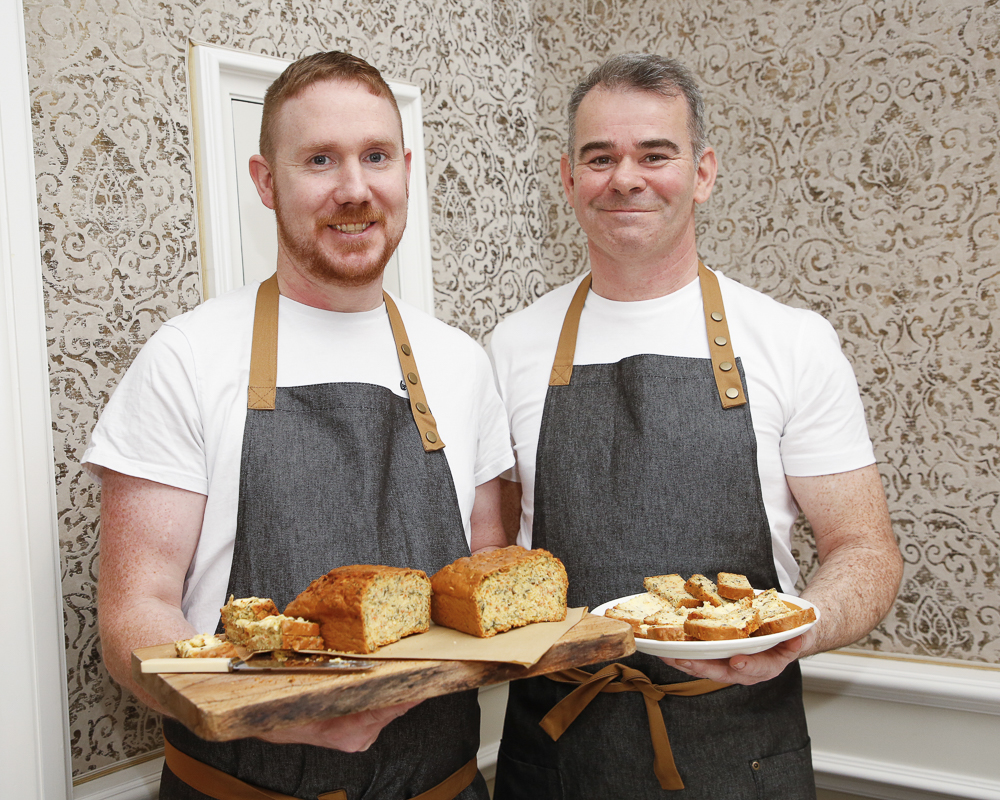
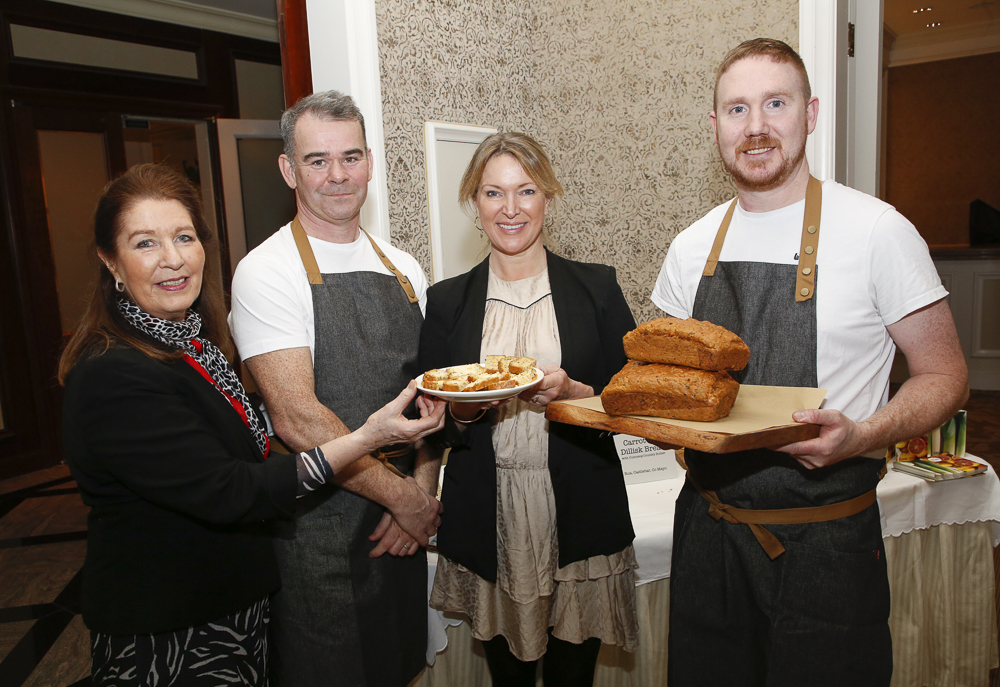
This unusual bread is from the McMahon family’s Rua Café and Deli in Castlebar, Co Mayo, and it was originally a Gerry Galvin recipe. “As a chef, restaurateur and poet, Gerry was always an inspiration to us at Rua”, explains Aran McMahon, who runs the Rua businesses with his sister Colleen. “After his untimely passing in 2013, we decided to make a version of his delicious Dillisk Soda Bread, which we had remembered enjoying at a family meal in Drimcong many years before. We still make the bread every week and sell it at our shop on Spencer Street every Friday where it is much loved by our customers.” A classically trained chef with a love of Irish traditions and a curious, inventive mind, Gerry Galvin was always ahead of the curve; this recipe is an unusual hybrid of different baking techniques, and he was one of the earliest chefs to use seaweed in modern Irish cooking.
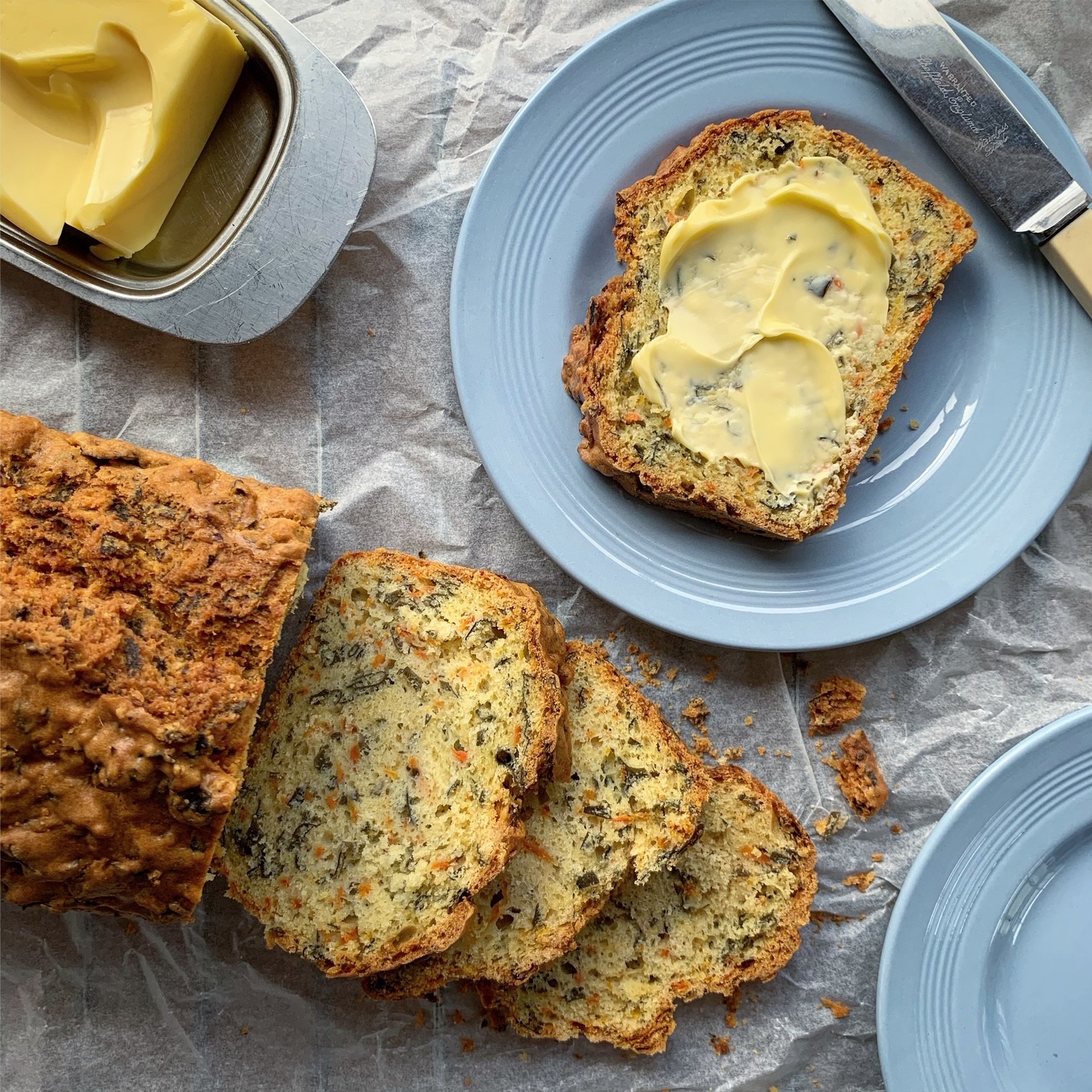 RECIPE: Rua’s Dillisk Soda Bread
RECIPE: Rua’s Dillisk Soda Bread
Makes one 2lb/900g loaf.
15g dried dillisk
4 eggs
50g sugar
60g melted butter
50 ml buttermilk
250g self raising flour
150g grated carrot
½ teaspoon of bread soda, sieved
Pinch of Achill Island Sea Salt (smoked)
Pre-heat a moderate oven, 160° C.
Soak the dillisk in water for 5 minutes, drain and squeeze dry. Check for any shells before finely chopping.
Whisk the eggs and sugar by hand in a mixing bowl. Next add the melted butter and buttermilk and whisk again until combined.
Add all of remaining ingredients and fold in lightly but thoroughly.
Put the mixture in a lined 2lb/900g loaf tin and bake in the preheated oven at 160º C for 45 minutes. Remove from the tin return to the oven for 5 minutes.
Allow to cool before slicing.
VARIATION: At Rua they also make a richer version of the dillisk loaf, with more butter but no bread soda or buttermilk: omit the bread soda and buttermilk, and increase the butter to 110g and the self raising flour to 250g. All other amounts remain the same.
Cookery Feature - The Best of Irish Cooking
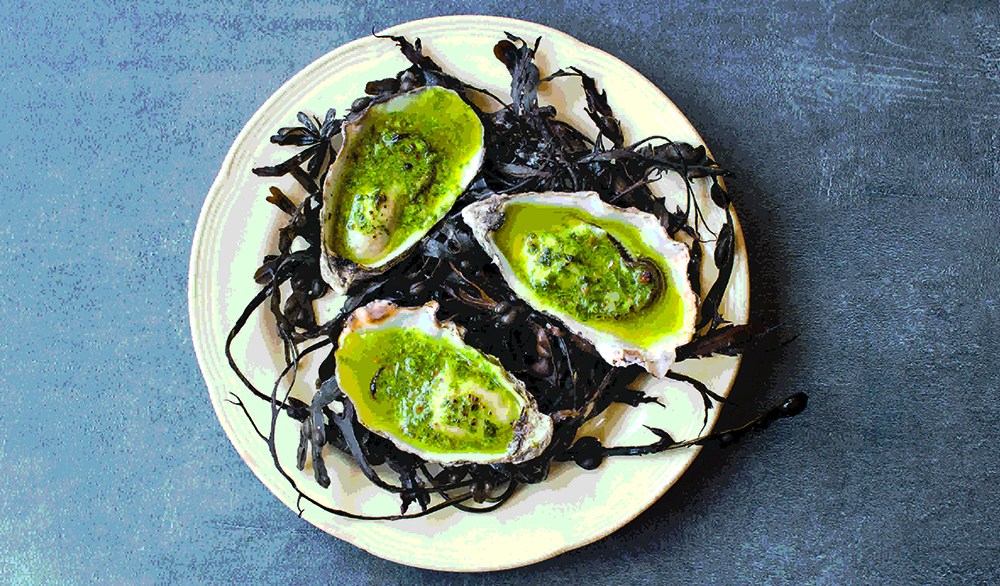
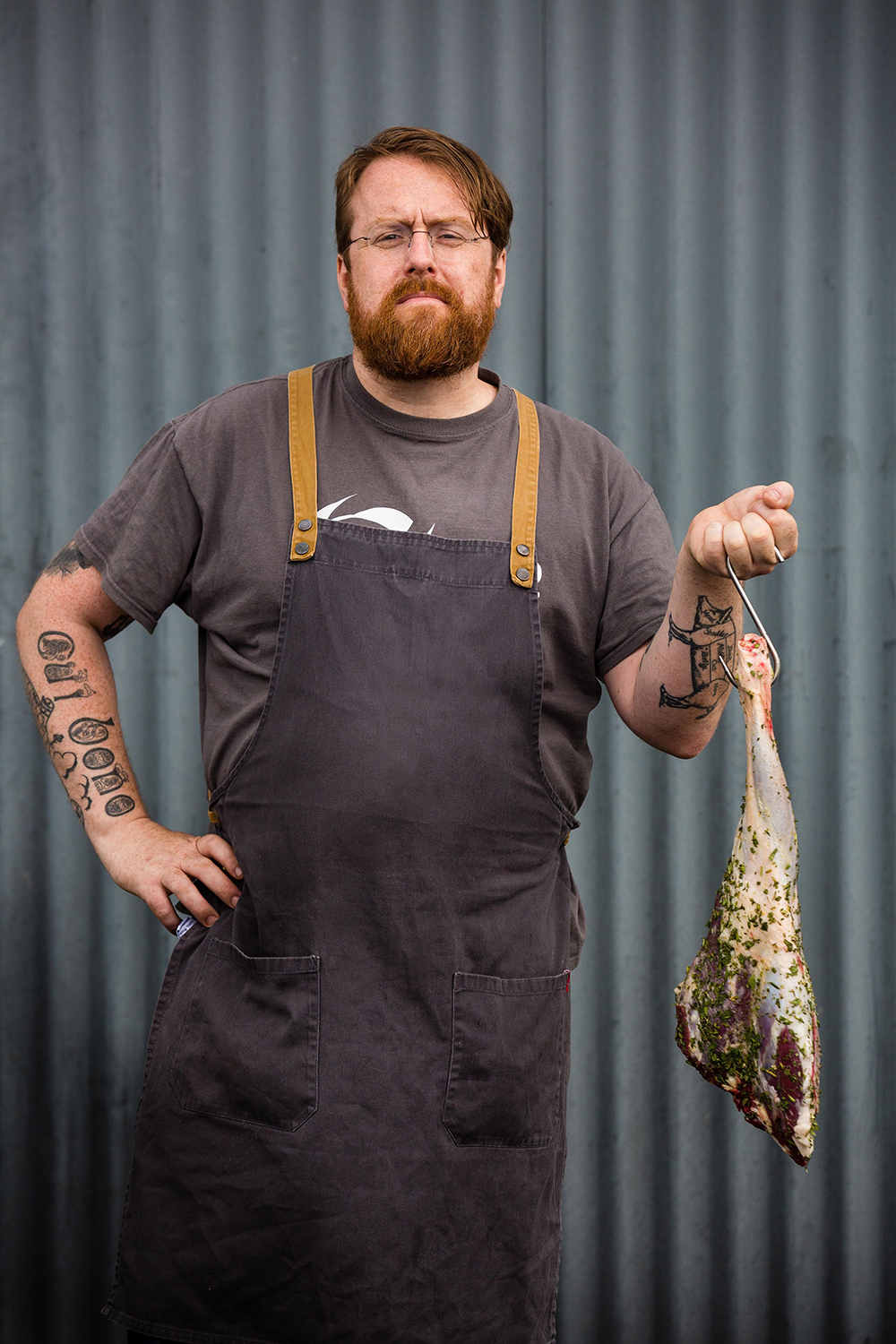 It takes confidence to call your book simply The Irish Cookbook, and fortunately that’s something the famous Galway chef, Irish food hero, Irish Time columnist and author, Jp McMahon, has in spades – fortunately for us, that is, as we are all the beneficiaries of his vision, intellectual curiosity and sheer determination to sell the Irish food story at home and abroad.
It takes confidence to call your book simply The Irish Cookbook, and fortunately that’s something the famous Galway chef, Irish food hero, Irish Time columnist and author, Jp McMahon, has in spades – fortunately for us, that is, as we are all the beneficiaries of his vision, intellectual curiosity and sheer determination to sell the Irish food story at home and abroad.
Jp mentioned in a recent interview that each generation needs a fresh introduction to Irish food (or words to that effect) and he has certainly provided that in The Irish Cookbook, which is simultaneously scholarly and accessibly down to earth. Acknowledging the past while celebrating the present and preparing for the future is very much his thing, not only in his Galway restaurants but especially through the astonishingly ambitious global food symposium, Food On The Edge, that he and his team have convened annually in Galway since 2015.
My own all-time favourite Irish cookbook is Florence Irwin’s The Cookin’ Woman (1949), which was a treasured gift from my late mother-in-law. The sheer bravery of the young home economics teacher, who travelled around rural Ulster with everything she needed – including an oven - to teach country people how to cook and eat better, is hard to grasp today, and the recipes are an enduring testament to her practicality.
Other wonderful classics which have imbued later generations with a love of, and respect for, Irish food include Maura Laverty’s Full and Plenty, Monica Sheridan’s The Art of Irish Cooking (1965), Theodora’s FitzGibbons’s A Taste of Ireland (1968) and Traditional Irish Food (1983), Myrtle Allen’s The Ballymaloe Cookbook (1984), Brid Mahon’s Land of Milk and Honey (1991), and these are just a few of the much-loved books that owe inspiration to Ireland and her produce. My own first book Good Food From Ireland (1991) was also a hymn to Ireland’s bounty and, although never a headline grabber, it was always ‘the special one’ for me. Yet many would still argue that we have no real food culture, no ‘cuisine’ as such.
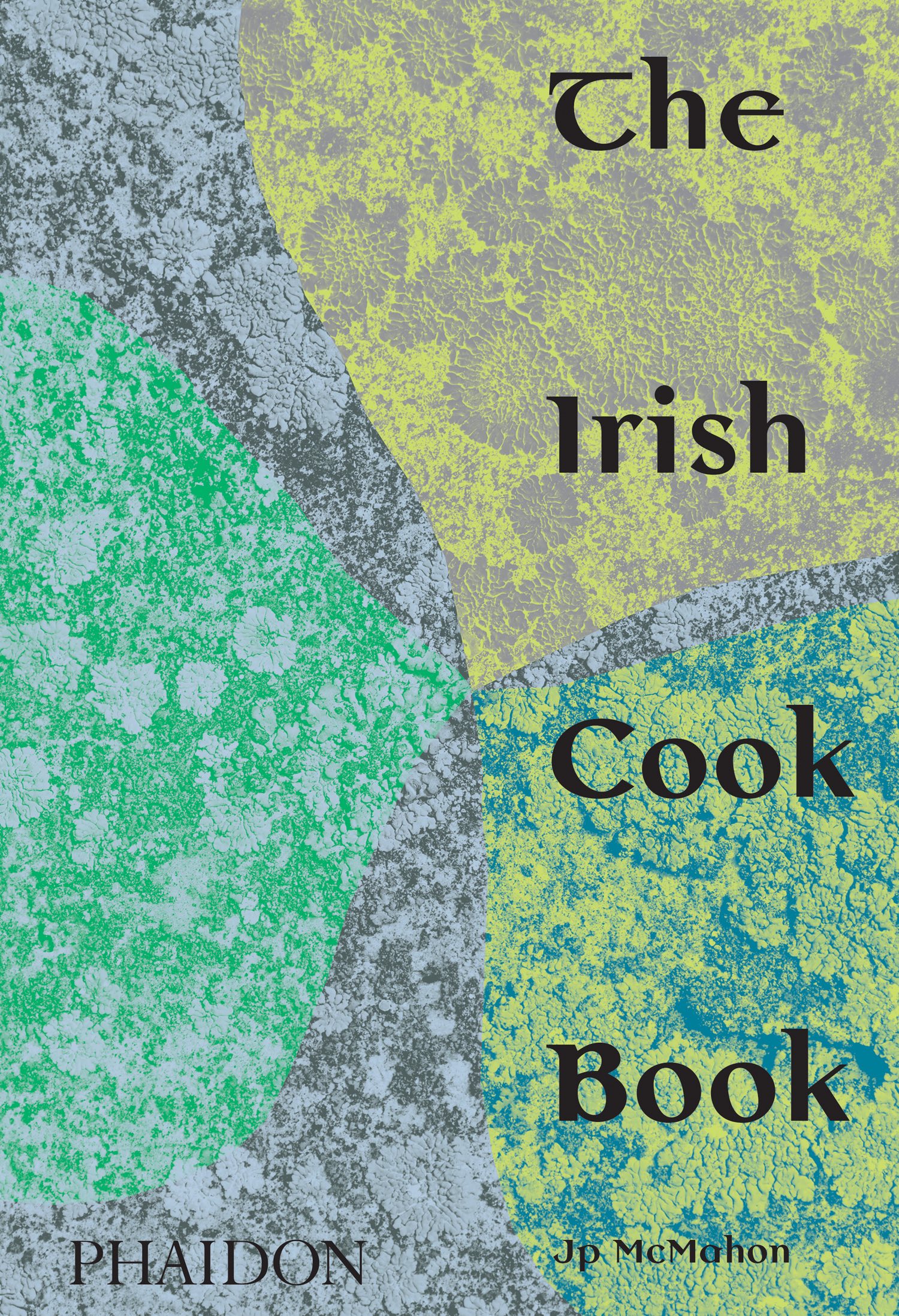 Well Jp McMahon will soon sort that out. To the doubters – and the young, who have yet to discover the Irish culinary joys that lie in store - I commend The Irish Cookbook. Weighing in at over 1.5kg this beautifully produced volume is perhaps a little heavy for reading in bed but I, for one, will be keeping it handy because it’s a seriously good read as well as a supremely practical cookbook.
Well Jp McMahon will soon sort that out. To the doubters – and the young, who have yet to discover the Irish culinary joys that lie in store - I commend The Irish Cookbook. Weighing in at over 1.5kg this beautifully produced volume is perhaps a little heavy for reading in bed but I, for one, will be keeping it handy because it’s a seriously good read as well as a supremely practical cookbook.
In Jp’s own words, from the introduction: “This book is not a history of Irish food. No book is definitive. Rather, it is a present understanding of the lay of the land, what food in Ireland was, how it was used, how it was not and, ultimately, what Irish food can be. I hope you enjoy this journey of discovery. To understand the new Irish cuisine that has come about in recent years, we need to look backwards as well as forwards, to understand what food this island has given to us. We need to celebrate this food in our imaginations as well as our bellies!”
The Irish Cookbook by Jp McMahon is published by Phaidon (£35). Photography & Styling: Anita Murphy and Zania Koppe
RECIPES:
The Irish Cookbook includes modern recipes – and some old ones with a modern interpretation – but respect for the traditional foods of Ireland is the foundation. The recipes below seem especially appropriate around the time when the world turns green for St Patrick’s Day, but books like this encourage a return to ‘good home cooking’ and I suspect that all of us will be glad of that in the times ahead.
Nettle Soup
“When I was young, I never knew you could eat nettles. Then I found a book called Wild and Free. It was published the year I was born: 1978. It detailed how the Irish people of the early Christian era enjoyed a nettle broth for sustenance. Indeed, nettles have been eaten in Ireland since the Bronze Age. Of course, this was long before the potato came to Ireland, so oats were used to thicken the soup. It was probably more of a gruel, a rough pottage, made simply from butter, oats, milk and nettles. Wild leeks and wild garlic (ramps) would also have been used. Most nettle soup nowadays is thickened with potato instead of oats. I find the addition of spinach leaves or wild sea beet helps the flavour of the soup because nettles can be quite astringent. Chopped bacon can be added for those who want to add substance to the dish.”
Preparation: 20 minutes
Cooking: 30 minutes
Serves 4
100 g/31⁄2 oz (7 tablespoons) butter
2 onions, diced
1 leek, chopped
a few sprigs of thyme and rosemary
200 g/7 oz (1 large) potato, diced
1 litre/34 fl oz (41⁄4 cups) vegetable stock (broth)
200 g/7 oz stinging nettles, washed, leaves picked
100 g/31⁄2 oz (31⁄2 cups) spinach, washed
25 g/1 oz wild garlic (ramps), optional
25 g/1 oz sea beet (optional)
100 ml/31⁄2 fl oz (scant 1⁄2 cup) double (heavy) cream
sea salt
Melt the butter in a large pan over a medium heat. When it starts to foam, add the diced onions and chopped leek. Season with a little sea salt. Add the thyme and rosemary. Cook for about 5–7 minutes until translucent.
Add the chopped potato. Fry for a further minute, then add the vegetable stock (broth). Bring to the boil and simmer for about 15 minutes until the potato is soft.
Add the nettles, spinach, wild garlic and sea beet (if using). Simmer for a minute and then blend with an immersion blender until smooth. Press through a fine sieve.
Add the cream and return to the heat until warm. Season to taste.
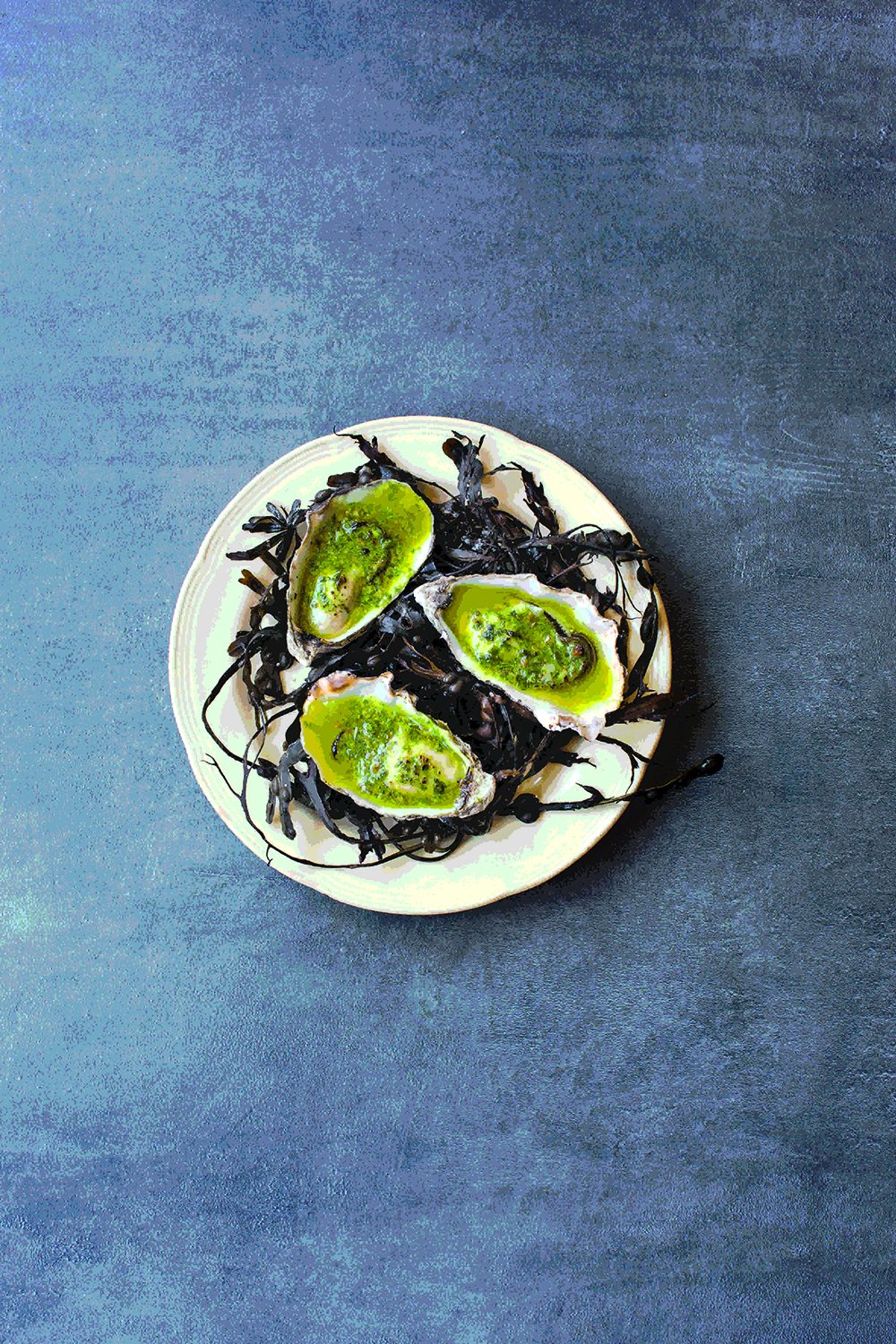 Oysters with Wild Garlic Butter
Oysters with Wild Garlic Butter
[Wild garlic is abundant in Ireland throughout the spring, and foraged widely. Enjoyed for its colour, flavour and provenance, it features in a number of Jp’s recipes in The Irish Cookbook. Pacific (gigas) oysters are most usual in hot oyster dishes and available all year, while the flat native oysters (Ostrea edulis) are seasonal and available only in the cooler months, with a ‘r’ in the name (Sep-Apr). GC]
Preparation: 15 minutes
Cooking: 2 minutes
Serves 4
8 oysters
brown soda bread, to serve
For the wild garlic butter
450 g/1 lb (4 sticks) butter, room temperature
75 g/2 3⁄4 oz (2⁄3cup) wild garlic (ramps)
apple cider vinegar, to taste
sea salt
Put the butter and wild garlic (ramps) into a food processor and blend together. Season with the vinegar and salt. Form into a cylinder by wrapping in a piece of cling film (plastic wrap) and refrigerate until required.
Preheat the grill (broiler). Shuck the oysters and detach from the shell. Place a knob (pat) of the butter into each oyster. Grill (broil) the oysters for about 2 minutes until the butter begins to bubble.
Serve with some brown soda bread.
Bacon and Cabbage with Parsley Sauce
This is a very famous Irish dish, and it was also the inspiration for the corned beef and cabbage so popular in the United States on St Patrick’s Day, with the salted pork being replaced by salted beef. This isn’t eaten together so much in Ireland, but we do eat corned beef, for which there is also a recipe in The Irish Cookbook.
Preparation: 25 minutes
Cooking: 2 hours 15 minutes
Serves 4
1 onion, peeled
a few whole cloves
1 × 1.5kg/3 1⁄4lb piece of bacon loin (shoulder butt or loin of pork), skin on
Parsley Sauce (see page 380), to serve
To crumb the bacon
25 g/1 oz (2 tablespoons) granulated sugar
50 g/2 oz (1 cup) fresh breadcrumbs thyme leaves
For the cabbage
1 white (green) cabbage, core removed and thinly sliced
75 g/23⁄4 oz (51⁄2 tablespoons) butter
250 ml/8 fl oz (1 cup) reserved bacon stock (broth)
freshly ground black pepper
3 tablespoons chopped parsley
Stud the onion with cloves and put into a large pan with the bacon, cover with water and bring to the boil over a high heat. Reduce the heat and simmer gently for
1 hour to 1 hour 30 minutes, topping up with water to cover if needed.
Strain through a sieve and reserve 250 ml/8 fl oz (1 cup) of the water. Pat the bacon dry with paper towels and remove the skin. Discard the onion.
Preheat the oven to 200°C/400°F/ Gas Mark 6.
Combine the sugar, breadcrumbs and thyme and pat evenly all over the bacon. Put into a roasting pan and bake in the preheated oven for 30–40 minutes until the top has caramelized.
Meanwhile, put the cabbage into a large pan with the reserved water and the butter. Simmer over a medium heat for 10 minutes until soft. Season with black pepper and add the chopped parsley.
Carve the bacon and serve with the cabbage and Parsley Sauce.
Parsley Sauce
Parsley sauce is a traditional accompaniment for bacon and cabbage. Essentially, it is a béchamel (white) sauce containing chopped parsley. There are many different variations in many Irish cookbooks, containing white pepper, mace, bay leaf and garlic as additional seasonings. Feel free to change the herbs as desired.
Preparation: 5 minutes
Cooking: 15 minutes
Serves 6–8
500 ml/17 fl oz (generous 2 cups) milk
50 g/2 oz (4 tablespoons) butter
50 g/2 oz (1/3cup) plain (all-purpose) flour
250 ml/8 fl oz (1 cup) bacon, ham or vegetable stock (broth)
a small handful of parsley, leaves picked and chopped
sea salt
Warm the milk in a small pan.
Melt the butter in a separate small pan over a low heat and stir in the flour. Cook for 2 minutes to form a paste. Slowly add the warm milk until it is all incorporated into the mixture.
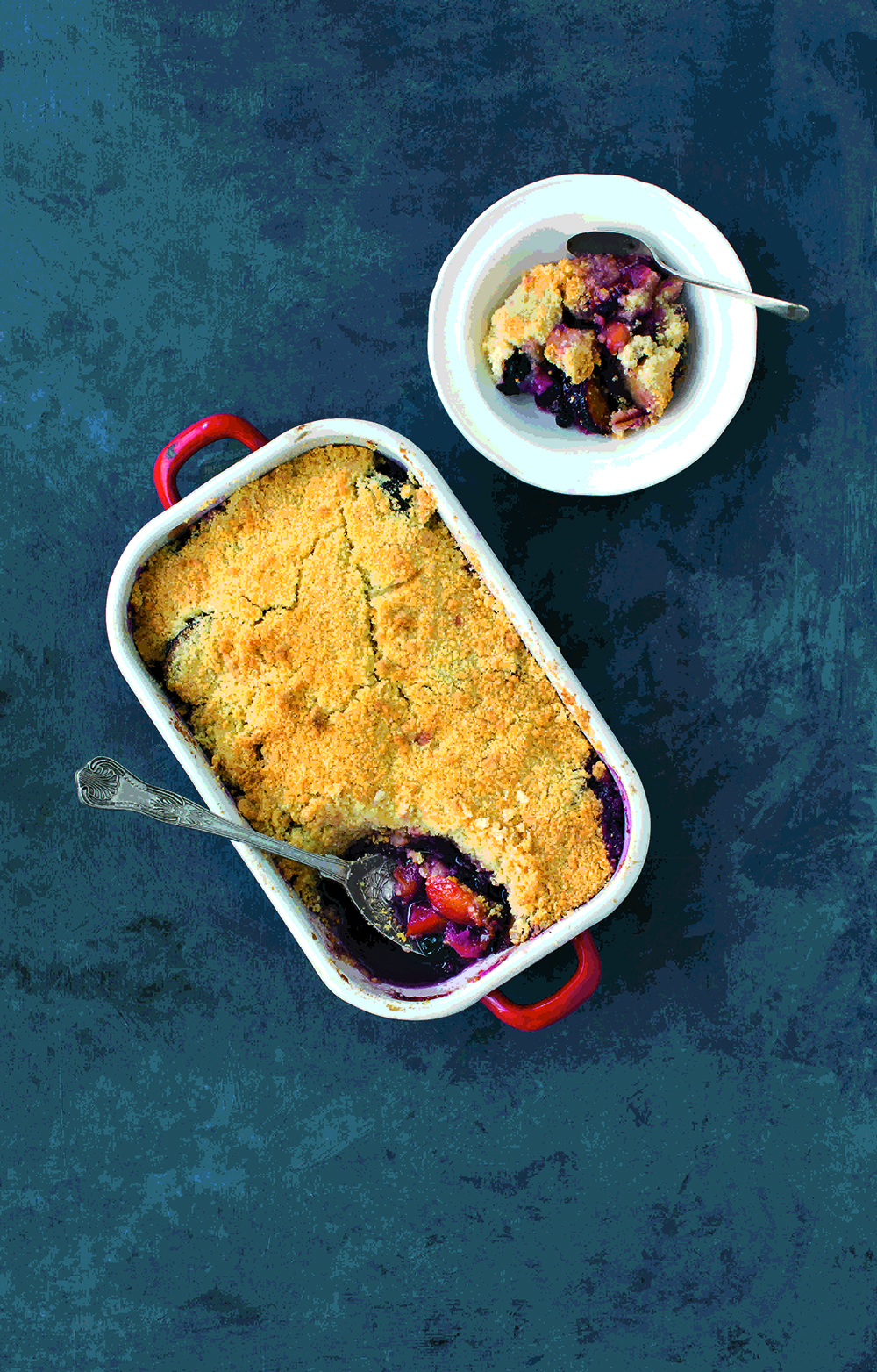 My Great-aunt Kay’s Fruit Crumble
My Great-aunt Kay’s Fruit Crumble
This is a fruit crumble (crisp) from my great-aunt Kay Clinch, who was born in the 1920s. It doesn’t specify the fruit, so use whatever is in season. The only change I made was to use butter instead of margarine. My aunty Anne made this crumble many times and testifies to its deliciousness!
Preparation: 15 minutes
Cooking: 35 minutes
Serves 4
500 g/1 lb 2 oz prepared fruit (about 4 cups) such as apple, rhubarb, plums or blackberries
100 g/31⁄2 oz (1⁄2 cup) caster (superfine) sugar
150 g/5 oz self-raising flour (11⁄4 cups all-purpose flour mixed with 13⁄4 teaspoons baking powder)
75 g/23⁄4 oz (51⁄2 tablespoons) butter
Preheat the oven to 180°C/350°F/ Gas Mark 4.
Coat the fruit with half the sugar and place in an ovenproof dish.
To make the crumble (crumb topping), rub the flour and butter together with your fingertips until the mixture resembles breadcrumbs. Fold in the rest of the sugar.
Cover the fruit with the crumble and bake in the preheated oven for 35 minutes until golden brown.
Irish Food Writers' Guild Awards - Menu & Recipes
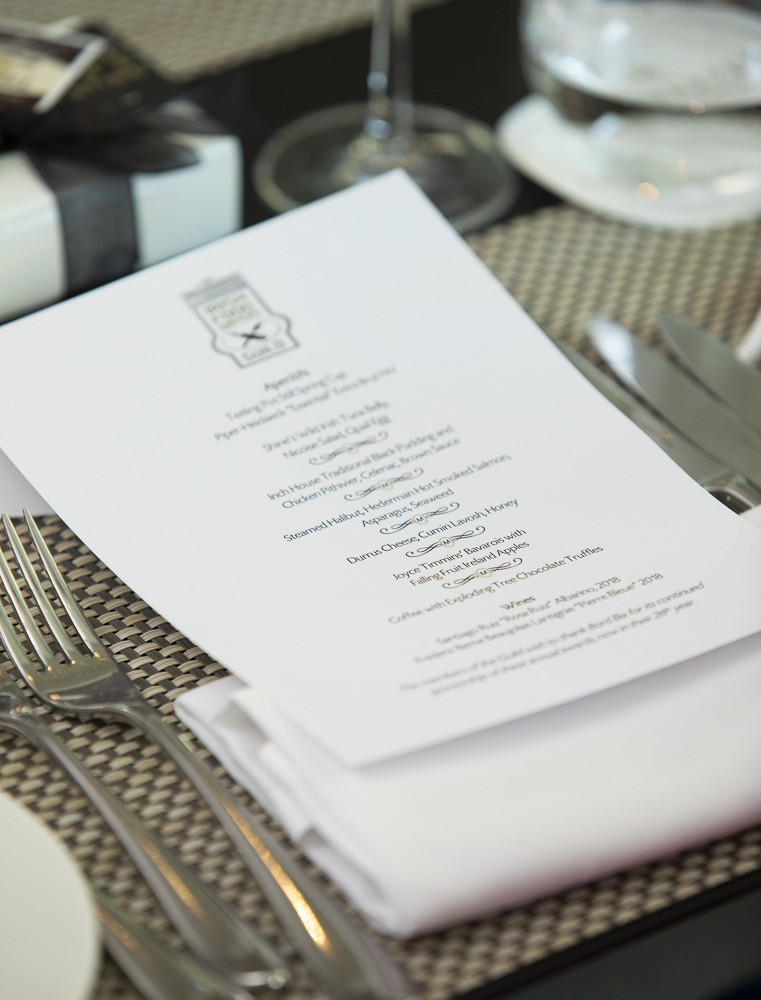
Lunch menu and all recipes devised by Gareth Mullins executive head chef at The Marker and incorporating the 2020 award-winning produce.
• Shine’s Wild Irish Tuna Belly, Nicoise Salad, Quail Egg
• Inch House Traditional Black Pudding and Chicken Pithivier, Celeriac, Brown Sauce
• Steamed Brill, Hederman Hot Smoked Salmon, Asparagus, Seaweed
• Joyce Timmins’ Bavarois with Falling Fruit Ireland Apples
• Durrus Cheese, Cumin Lavosh, Honey
• Coffee and Exploding Tree Chocolates
• Guests also enjoyed a Teeling Pot Still Spring Cup cocktail and a selection of wines and Champagne from Liberty Wines

Serves 1
40ml Teeling Single Pot Still Irish Whiskey
50ml white lemonade
ice cubes, to serve
For the rhubarb cordial:
600g rhubarb, chopped
200g granulated sugar
For the garnish:
1 Granny Smith apple slice
1 orange slice
1 pink grapefruit or lemon slice
fresh raspberries
fresh blueberries
fresh mint sprig
• To make the rhubarb cordial, place the chopped rhubarb in a saucepan. Add just enough water to cover the rhubarb and bring to the boil. Boil until the rhubarb is soft, then strain the mixture into a jug through a fine mesh sieve. Pour the strained juice back into the pan, then add the sugar and heat until the sugar dissolves. Bring to the boiling point, then skim, remove from the heat and set aside to cool.
• To make the spring cup, add ice to a highball glass. Add the whiskey and 25ml of the rhubarb cordial. Add a slice of apple, orange and pink grapefruit and one or two fresh raspberries and blueberries. Top up with white lemonade and stir gently with a bar spoon, taking care not to crush the fruit. Add a fresh sprig of mint to the top of the glass and serve.
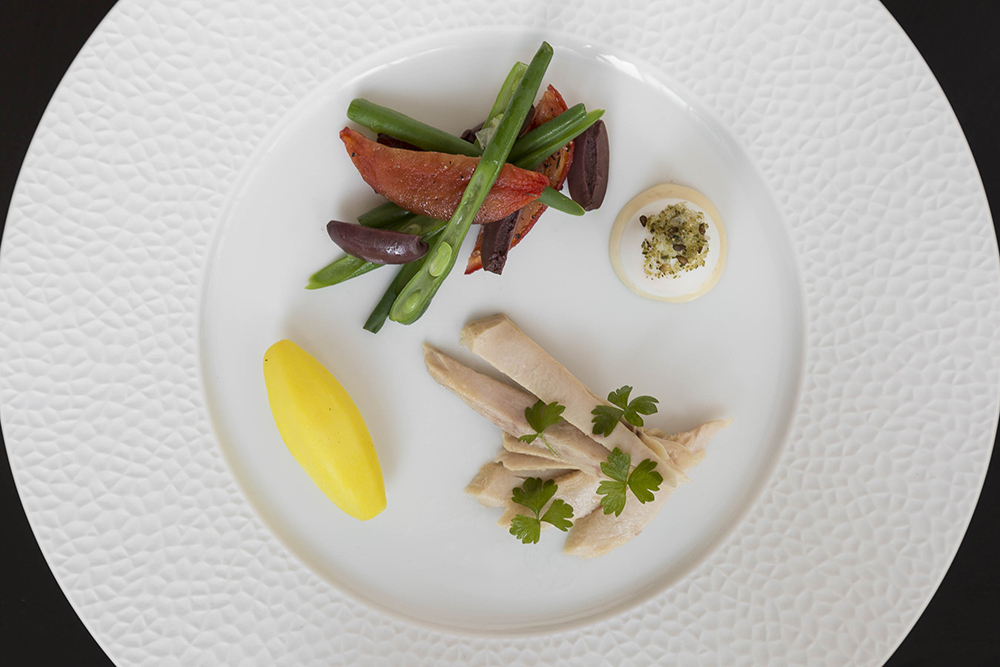 Shine’s Wild Irish Tuna Nicoise Salad, Quail Egg
Shine’s Wild Irish Tuna Nicoise Salad, Quail Egg
Serves 4
2 x 210g jars of Shine’s Wild Irish Tuna
4 new potatoes, peeled
100g fine green beans
4 quail eggs
pinch of celery salt
4 ripe plum tomatoes, peeled, deseeded and cut into strips
50g pitted black olives, halved
fresh flat-leaf parsley, to garnish
good-quality extra virgin olive oil, for drizzling
For the aioli:
1 egg yolk
¼ garlic clove, minced
1 tbsp Dijon mustard
1½ tsp white wine vinegar
100ml olive oil
• Carefully remove the tuna from the jars, trying not to break up the pieces too much, and place in a strainer. Reserve the oil for the aioli.
• To make the aioli, put the egg yolk, garlic, mustard and vinegar in a large bowl and whisk together. Gradually incorporate the oil that you drained off the tuna plus the extra 100ml, adding it in a slow, steady stream and whisking constantly until emulsified into a mayonnaise.
• Boil the new potatoes until tender, then drain and cut in halves or slices.
• Top and tail the green beans, then blanch briefly in boiling salted water. Drain, then rinse under cold water to stop them cooking further.
• Cook the quail eggs in boiling water for 3 minutes, then remove with a slotted spoon and refresh in iced water. Allow to cool, then carefully peel and cut a slice off the bottom of each one so that they will stand upright.
• To serve, add a small dollop of aioli to each plate, then nestle a quail egg on top and sprinkle with a pinch of celery salt. Arrange the green beans, tomatoes and olives together on one section of the plate, then add the potatoes alongside. Add a few strips of tuna on the last clear section of the plate, then garnish with a few leaves of parsley. Finally, drizzle over a good-quality olive oil to finish the dish.
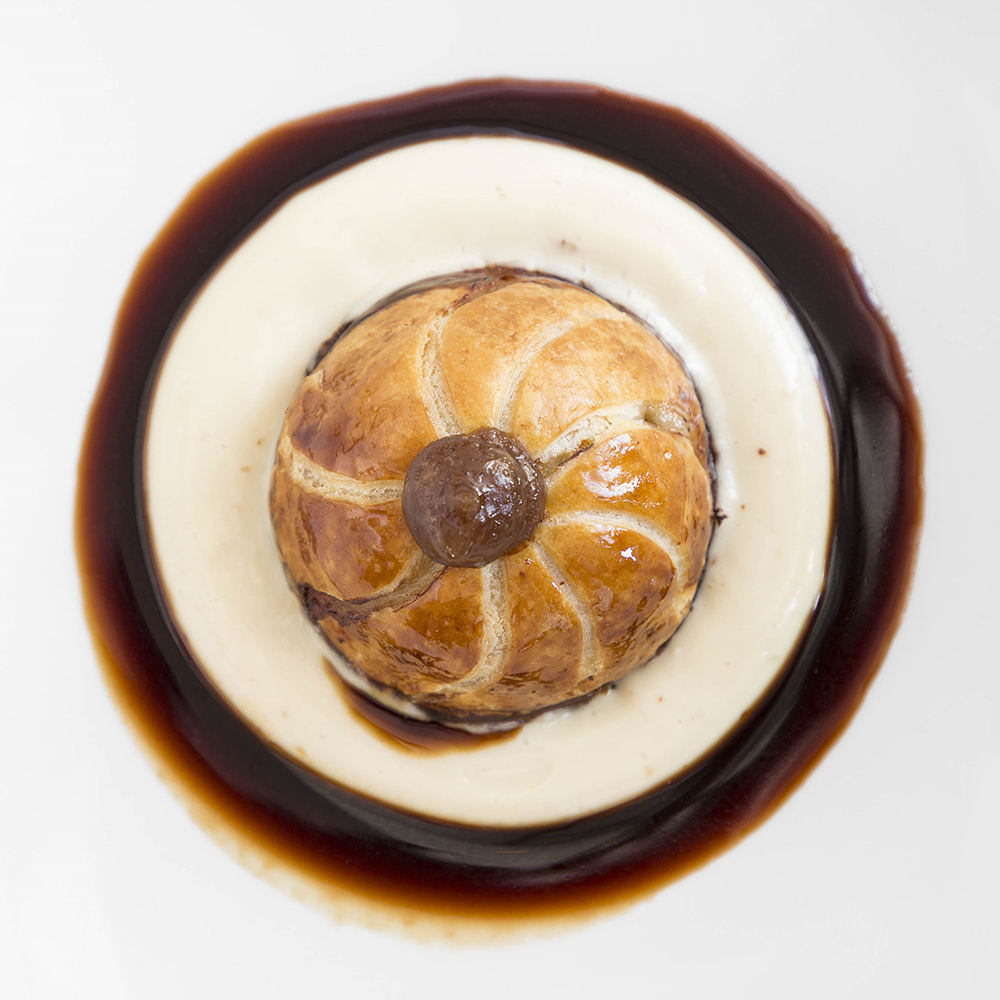 Inch House Traditional Black Pudding and Chicken Pithivier, Celeriac Purée, Brown Sauce
Inch House Traditional Black Pudding and Chicken Pithivier, Celeriac Purée, Brown Sauce
Serves 4
300g Inch House Traditional Black Pudding, diced into 5mm pieces
150g chicken thighs, finely diced
150g chicken fillet, finely diced
2 tbsp chopped fresh flat-leaf parsley
1 tbsp chopped fresh tarragon
400g ready-rolled all-butter puff pastry, cut into 8 x 12cm disks
2 egg yolks, lightly beaten
jus, to serve
For the brown sauce:
splash of olive oil
1 small onion, finely diced
3 garlic cloves, chopped
1 fresh red chilli, deseeded and chopped
100g raisins
100g pitted prunes
50g dark brown sugar
300ml tomato ketchup
50ml soy sauce
50ml sherry vinegar
1 tbsp fennel seeds
salt and pepper
For the celeriac purée:
200g celeriac, peeled and cubed
50g butter
50ml cream
• To make the brown sauce, heat the oil in a saucepan set over a medium heat. Add the onion and sauté for 2 minutes, until softened but not coloured. Add the garlic and chilli and sauté for 2 minutes, then add the raisins, prunes, brown sugar, ketchup, soy sauce, vinegar and fennel seeds and season well with salt and pepper. Bring to the boil, then reduce the heat and simmer for a few minutes to combine all the flavours. Place in a food processer and purée until smooth.
• To make the celeriac purée, place all the ingredients in a heavy-based saucepan and cover with a lid. Cook over a low heat until the celeriac is tender, then purée in a food processer until smooth.
• To make the pithivier, preheat the oven to 220°C. Line two large baking sheets with non-stick baking paper.
• Mix the black pudding and chicken together, then season well with salt and pepper. Stir in the chopped parsley and tarragon.
• Place four of the pastry discs on the lined baking sheets (two on each sheet) and top with a neat mound of the black pudding and chicken mix, leaving a 1cm border clear all around. Brush the clean pastry border with the beaten egg yolks, then cover with the second pastry disc. Press down the edge to seal the pastry discs together, then brush the top with the remaining egg wash. Pierce the top of the tart to allow the steam to escape, then score eight lines in the pastry, radiating out from the top like a pinwheel.
• Bake in the preheated oven for 15–18 minutes, until the pastry is golden and the core temperature is about 75°C.
• To serve, spoon a small circle of celeriac purée into the middle of a wide, shallow bowl, then add the pithivier and place a small spoonful of the brown sauce on top. Carefully pour the jus around the outer edge of the celeriac purée.
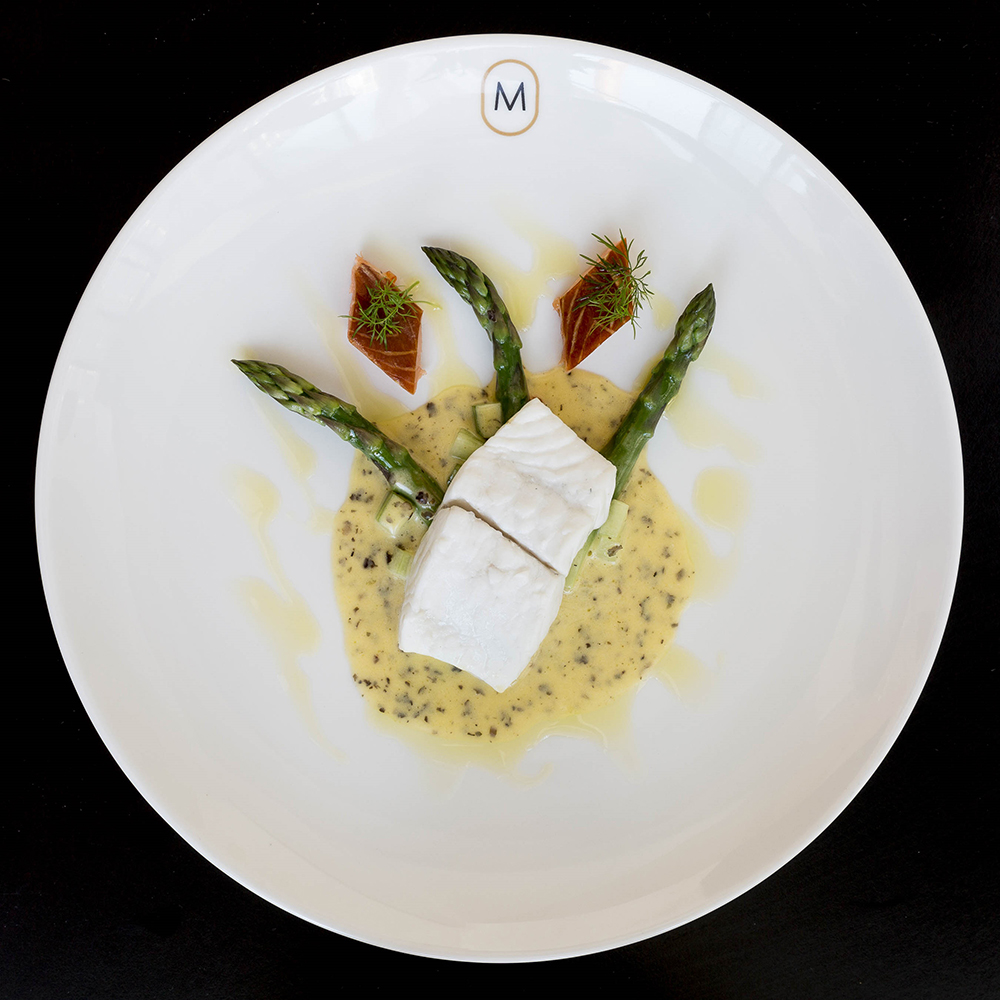 Steamed Fillet of Brill, Hederman Hot Smoked Salmon, Asparagus, Seaweed
Steamed Fillet of Brill, Hederman Hot Smoked Salmon, Asparagus, Seaweed
Serves 4
4 x 140g fillets of brill
12 spears of asparagus, peeled and woody ends snapped off
4 x 40g portions of Hederman Hot Smoked Salmon, each portion cut into two diamonds
fresh dill sprigs
For the beurre blanc:
2 shallots, finely chopped
60ml white wine
60ml white wine vinegar
60ml water
125g cold unsalted butter, cut into small cubes
½ cucumber, peeled, deseeded and finely diced
2 tbsp chopped dried dillisk
salt and freshly ground white pepper
• To make the beurre blanc, place the shallots, wine, vinegar and water in a saucepan set over a medium heat. Simmer until almost no liquid remains. Turn the heat down to low, then whisk in the butter one piece at a time, allowing each piece to melt and emulsify before adding the next. It’s a good idea to occasionally take the pan off the heat, then return it when it’s becoming too cool, so that the sauce doesn’t split. Once all the butter has been added, the sauce should be pale and have a thin, custard-like consistency. Stir in the cucumber and seaweed, then season to taste with salt and freshly ground white pepper. Keep warm.
• Steam the brill in a steamer basket for 4–6 minutes, then season with sea salt.
• Steam the asparagus spears for 3–4 minutes, then season.
• To serve, spoon the beurre blanc into the middle of a plate, then add the steamed brill on top. Add three asparagus spears to each plate, then two of the smoked salmon pieces. Garnish with small sprigs of fresh dill on top of each piece of salmon.
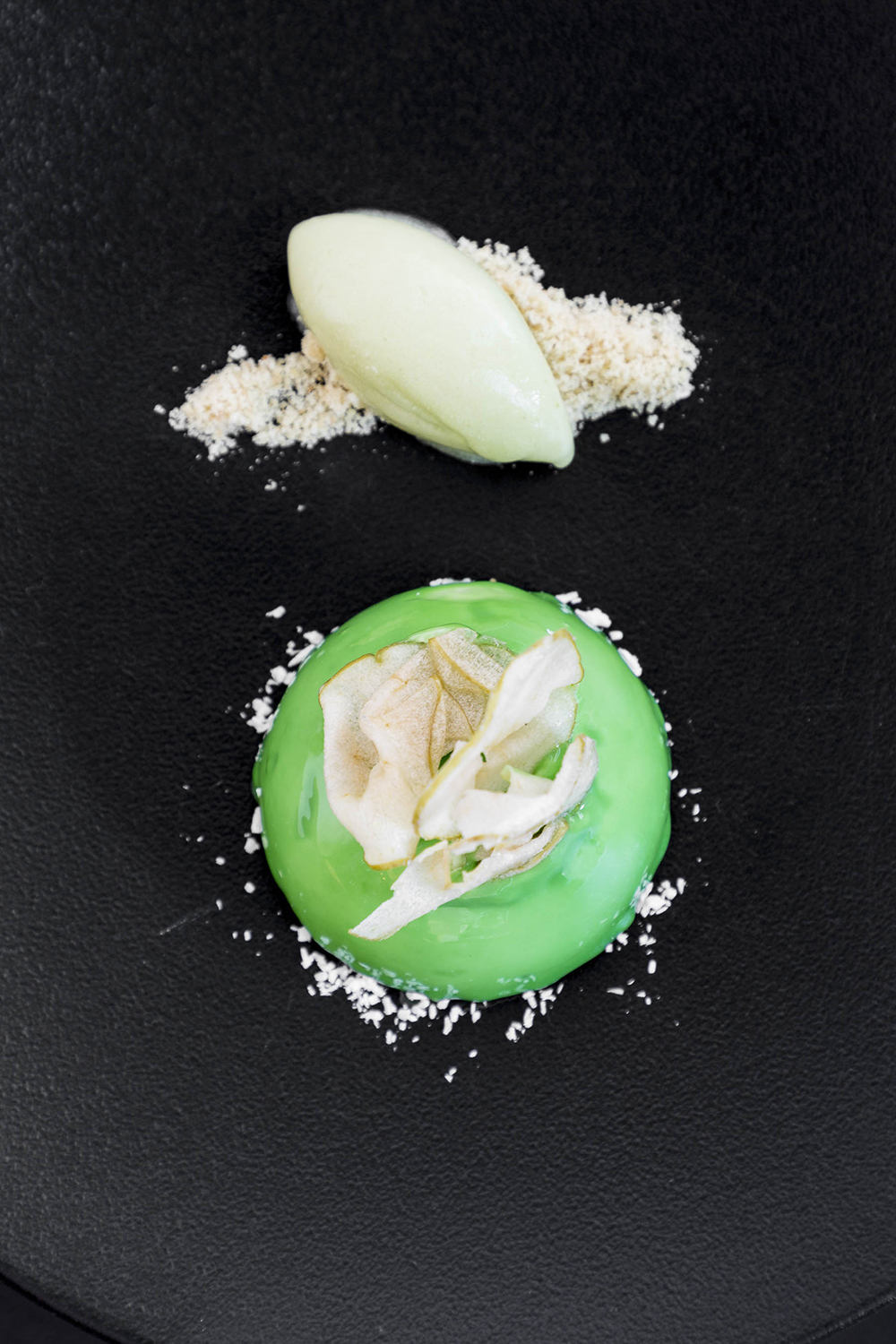 Joyce Timmins’s Apple Bavarois, Apple Ganache, Apple Sponge
Joyce Timmins’s Apple Bavarois, Apple Ganache, Apple Sponge
Serves 10
For the coconut dacquoise base:
100g icing sugar
40g coconut flour
30g plain flour
35g ground almonds
90g egg whites
50g caster sugar
pinch of salt
For the apple sponge:
50g eggs
40g ground almonds
40g icing sugar
20g apple purée
120g plain flour
30g egg whites
40g caster sugar
squeeze of lemon juice
For the apple syrup:
200ml apple juice
100ml water
For the apple ganache:
1 gelatine leaf
90g green apple purée
juice of ½ lime
65g white chocolate, melted
For the apple bavarois:
1 gelatine sheet
75g apple purée
2 eggs whites
30g caster sugar
90g fresh cream
To serve (optional):
apple sorbet
finely crumbled shortbread
• Preheat the oven to 180°C. Line two large baking trays with non-stick baking paper.
• To make the coconut dacquoise base, sieve the icing sugar, flours and ground almonds together into a bowl. In a separate large, clean, dry bowl, whip the egg whites, caster sugar and a pinch of salt together until soft peaks form. Fold in the dry ingredients, then spread out on one of the lined trays and bake in the preheated oven for 6 minutes.
• To make the apple sponge, put the eggs, ground almonds, icing sugar and apple purée in a food processor and blend to a smooth, frothy mixture, then stir in the flour. In a separate clean, dry bowl, whisk the egg whites and caster sugar together, then whisk in the lemon juice. Spread on the second lined baking tray and bake in the preheated oven for 15 minutes. Cool down fast to preserve its softness.
• To make the apple syrup, boil the apple juice and water together over a high heat until reduced and thick, then cool down fast. Once the apple sponge and the syrup have cooled, brush the syrup all over the sponge.
• To make the apple ganache, bloom the gelatine in a small bowl of cold water. Heat the apple purée and lime juice together in a small saucepan, then add the gelatine, stirring until it has dissolved. Stir in the melted white chocolate.
• To make the apple bavarois, bloom the gelatine in a small bowl of cold water. Warm the apple purée in a saucepan, then add the gelatine, stirring until it has dissolved. Remove from the heat and allow to cool. Whisk the egg whites in a clean, dry bowl, adding the sugar in three batches. In a separate bowl, whip the fresh cream to soft peaks. Fold the meringue into the cooled purée mix, then fold in the whipped cream.
• To assemble, you’ll need a 30cm springform cake tin for building up the cake in layers. First cut a 30cm circle from the coconut dacquoise so that it fits the base of the tin perfectly, then add the apple ganache and spread to cover in an even layer. Next add one-third of the apple bavarois. Cut the apple sponge into 2 x 30cm discs, then add one disc on top of the bavarois. Add another third of the bavarois, then the second disc of apple sponge. To finish, add the remaining third of the bavarois, then gently tap the tin on the countertop to ensure there are no air bubbles. Briefly dip a palette knife in hot water, then use it to smooth the top of the cake. Place the cake in the fridge overnight to set. The next day, use a hot towel or a kitchen blowtorch to warm the edge of the tin before you release the cake, then cut into slices.
• To serve, spoon a line of finely crumbled shortbread onto a plate, then add a quenelle of apple sorbet on top, if liked. Add a slice of the cake alongside and serve immediately.
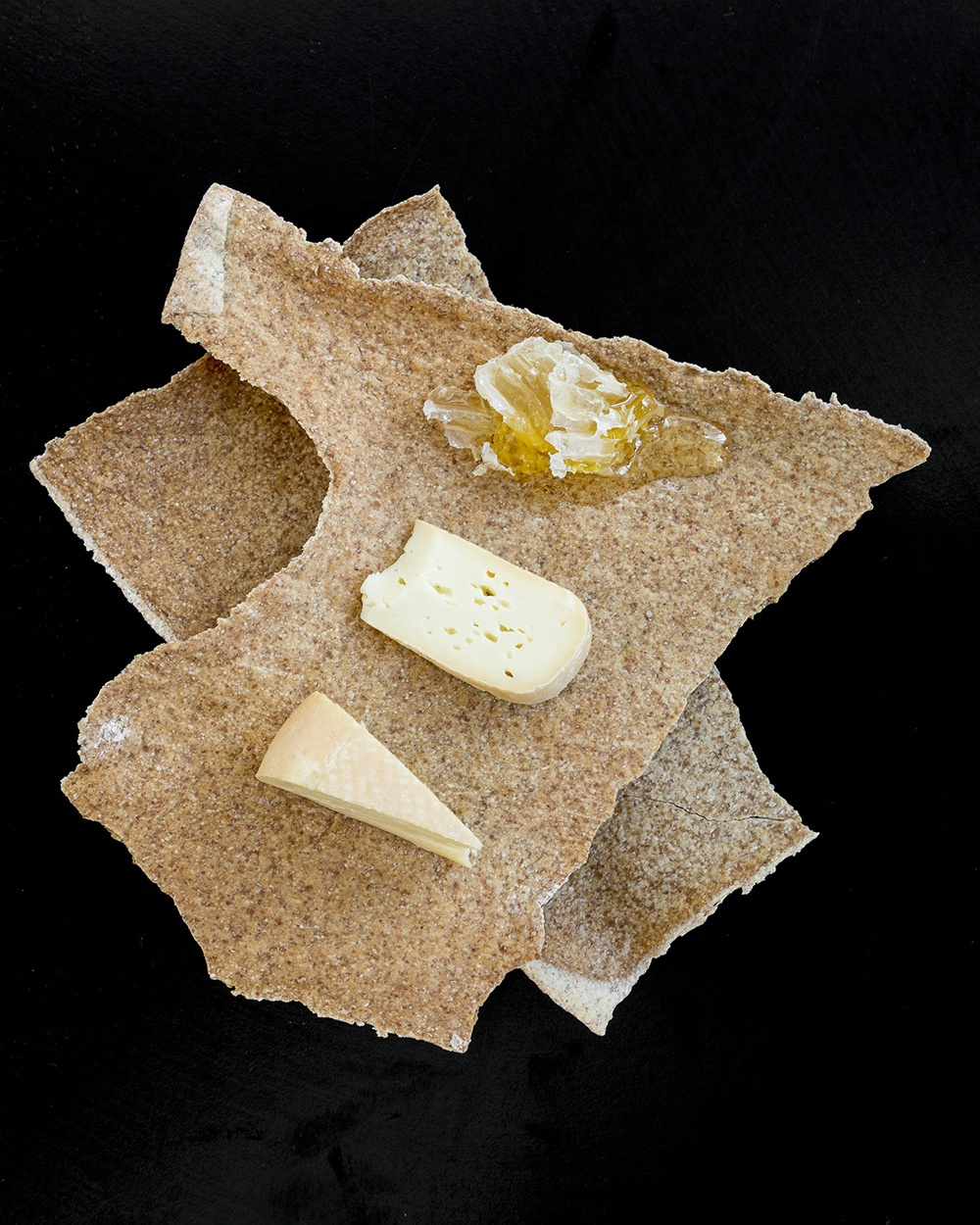 Durrus Cheese, Cumin Lavosh, Honey
Durrus Cheese, Cumin Lavosh, Honey
Serves 4
4 x 40g portions of Durrus cheese
drizzle of local honey or honeycomb
For the lavosh:
400g plain flour
2 tbsp cumin seeds, toasted and ground
good pinch of flaky sea salt
½ tsp freshly cracked black pepper
4 tbsp olive oil, plus extra for drizzling
200ml cold water
• Preheat the oven to 180°C. Line two large baking sheets with non-stick baking paper.
• To make the lavosh, mix together the flour, toasted cumin seeds, salt and pepper in a large mixing bowl, then pour in the olive oil. Stir with a fork, then continue stirring while slowly adding the cold water. You might not need all the water – use just enough to form a ball of dough.
• Roll out the dough into two large rectangles that are the same size as your baking sheets – you could even use a pasta machine to get it nice and thin. Place the dough onto the lined sheets, then drizzle with some olive oil and sprinkle with a little more sea salt and toasted cumin. Bake in the preheated oven for 15–20 minutes, until golden and crisp.
• Allow to cool on a wire rack, then break the crackers into large irregular pieces.
• To serve, place the small wedges of cheese directly on a piece of the lavosh, then add a drizzle of local honey or a piece of honeycomb.
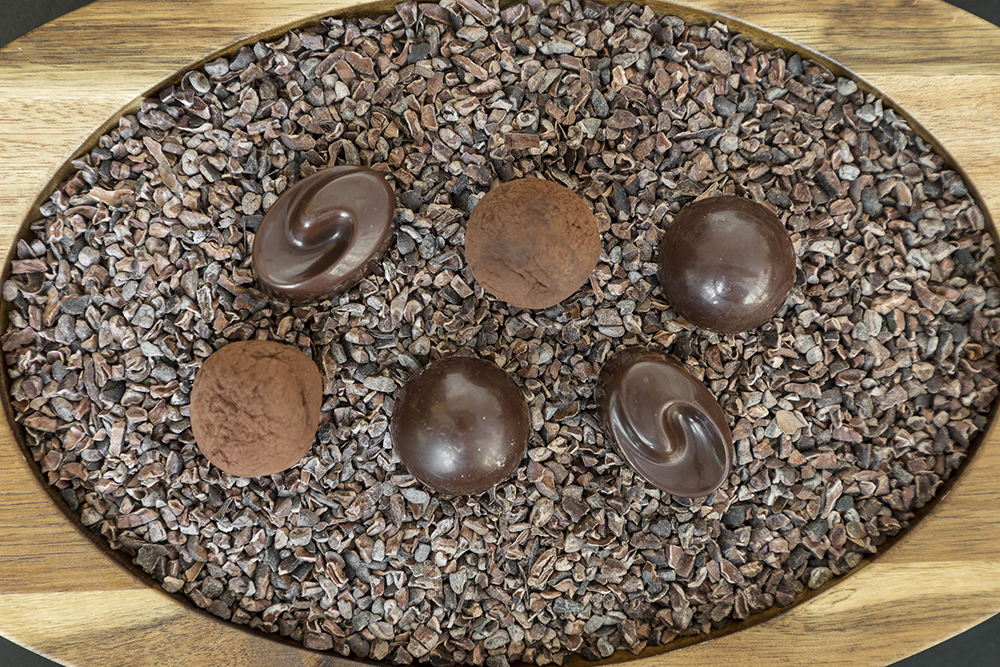 Exploding Tree Chocolate Truffles
Exploding Tree Chocolate Truffles
Makes 25–30
300ml double cream
knob of butter
300g Exploding Tree chocolate, at least 70% cocoa, finely chopped
pinch of salt
splash of whiskey
3 tbsp cocoa powder
• Pour the cream into a heavy-based pan set over a medium heat. Bring to a simmer – don’t let it boil – then add the butter.
• Put the chocolate in a heatproof bowl, then pour over the hot cream mixture, whisking until the chocolate melts. Add a pinch of salt, then stir in the whiskey. Once the ganache is smooth, pour into a clean bowl and place in the fridge to chill for 2 hours.
• Place the cocoa powder in a shallow bowl. Using a parisienne scoop briefly dipped in just-boiled water, scoop out balls of the firm chocolate, aiming for about 20g each, then roll in the cocoa powder.
All recipes created for the Irish Food Writers’ Guild Food Awards 2020 by executive chef Gareth Mullins of the Marker Hotel, Grand Canal Square, Docklands, Dublin 2.
Cookery Feature - A Taste of the Sea
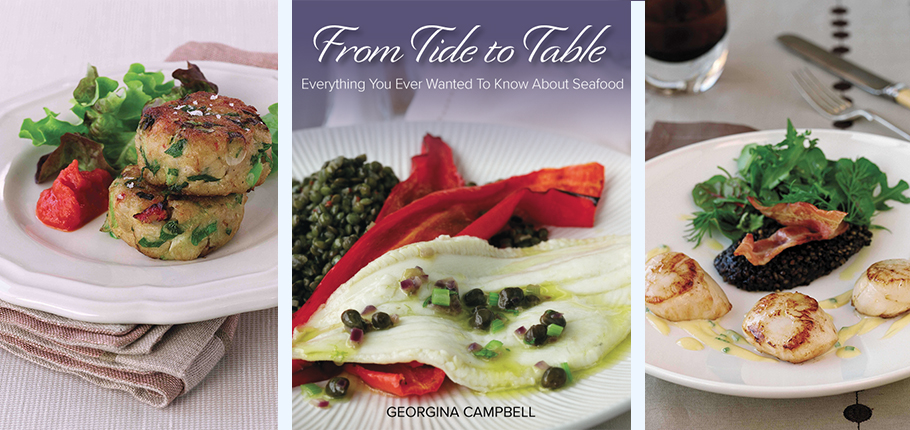
.jpg)
This includes fish and seafood suppliers, which is perfect for the season - as spring turns to early summer it’s natural to crave lighter, more colourful food and never more than this year. And, whatever about the serious issues we’re all facing, it’s reassuring to see how well nature has responded to the reduced pollution in recent weeks and - thanks also to the unusually good weather - the new season produce is coming along especially nicely. That means we can look forward to plenty of the fresh salads and vegetables that go so well with fish, including the temptations of crunchy foreshore vegetables like samphire, and - if we’re lucky - asparagus from Irish growers such as Drummond House in Co Louth.
There is huge demand for attractive, simple and easy to follow seafood recipes and the ones that follow should fit the bill very nicely. They’re all from the new edition of our little ‘seafood bible’ From Tide To Table. As well as giving easy recipes for cooking up a wide variety of delicious dishes for all tastes and occasions, it includes a wide range of side dishes (often a challenge for home cooks), profiles of some of our best producers, and basics like how to identify the fish and shellfish caught or produced in Irish waters and choose the best ones for your particular needs when shopping.
Most fishmongers shops are currently open as usual but getting to them is not always easy, so some of those offering fresh fish collection / delivery services around the country are listed below. Some speciality producers also deliver, eg Sally Barnes’s Woodcock Smokery; Frank Hederman’s Belvelly Smokehouse; the Cresswell family’s Ummera Smoked Products; Union Hall Smoked Fish; Birgitta Hedin Curtin’s Burren Smokehouse; and the Roberts family’s Connemara Smokehouse among others.
FRESH FISH HOME DELIVERIES
DUBLIN & East
Sustainable Seafood Ireland (SSI)
Established by chef Niall Sabongi as a wholesale business in 2013, you can now order from their excellent website where details are given of pickups at their HQ in Clonshaugh Dublin 17 and nationwide home delivery details. (email: market@sustainableseafood.ie)
Kish Fish
Shops in Bow Street, Coolock, Dunboyne (Avoca), Howth; home delivery ‘menu’ online - call 01 8543900 or email sales@kishfish.ie to place order and pay.
Doyles Premium Seafood, Tallaght
Online shop with delivery in Dublin area; includes less usual items, eg samphire, whelks.
Nicky’s Plaice, Howth
Long established fishmonger and fish smoker; delivery in north Dublin area, from €5.
Dorans, Howth
Fishmongers and restaurateurs. Online sales for delivery https://www.seafood2go.ie/, also takeaways from Octopussys restaurant (Octopussy orders: 086 260 1803)
Beshoffs, Howth
Fishmongers with small speciality foodstore, restaurant and tapas bar; fresh fish collection/delivery in Howth/Sutton area.
Reid’s Fish Market, Howth
Shop on Howth pier and online, with home delivery available.
Kirwan’s Fish Cart, Drogheda
Long established fishmongers with speciality foods & nearby restaurant; call ahead on 041 983 0622 to order a pick-up outside the door; deliveries in local area.
Nick’s Fish, Ashbourne
Fishmonger Nicholas Lynch offers a range of different packs (€45 incl delivery); email niall@nicksfish.ie / call 085 8511582
CORK/KERRY
K O’Connell Fish, English Market, Cork City.
Delivery in Cork area, order from list on website. Call 021 427 6380 / email freshfish@eircom.net. Minimum order €30.
Star Sea Foods Cork
Free deliveries in Cork area; minimum spend only €10.
Quinlans Kerry Fish Caherciveen and branches
Leading Kerry fishmongers and smokers, the Quinlan family have their own boats, a smokery and several restaurants. They normally operate a national order and delivery service and currently offer a call and collect service at their shops, see details on their website / FB page.
GALWAY
Gannet Fishmongers, Galway
Famous Galway fishmonger Stefan Griesbach operates Gannet Fishmongers and its online branch, EatMoreFish. Very well organised, plus Pantry section including a seaweed range
DONEGAL
Starcrest Seafoods, Laghey
Long established Donegal business Starcrest Seafoods recently established a dedicated home delivery website Port2Door https://port2door.ie/ servung the north-east, including parts of Northern Ireland (and also Athlone). Minimum order €35, free delivery.
KILKENNY
Goatsbridge Trout Farm Thomastown
Not all good fish comes from the sea and Ger and Mag Kirwan’s famed trout farm has an online shop selling their fresh and smoked trout products, some imaginative hampers and and Mag’s charity cookbook, Fishwives. Delivery from €5 (free on orders over €100).
NORTHERN IRELAND
Mourne Fish Box, Kilkeel
Father and daughter Harold Nicholson and Lisa McBride, of Mourne Seafoods Ltd, run an online operation selling boxes of freshly landed fish and seafood. Called mournefishbox.com, it supplies a variety of mixed boxes and also Carlingford Oysters, produced nearby. Prices from about £20, free delivery.
Recipes
All from From Tide To Table (Epicure Press, €20 from bookshops and online with free p&p)
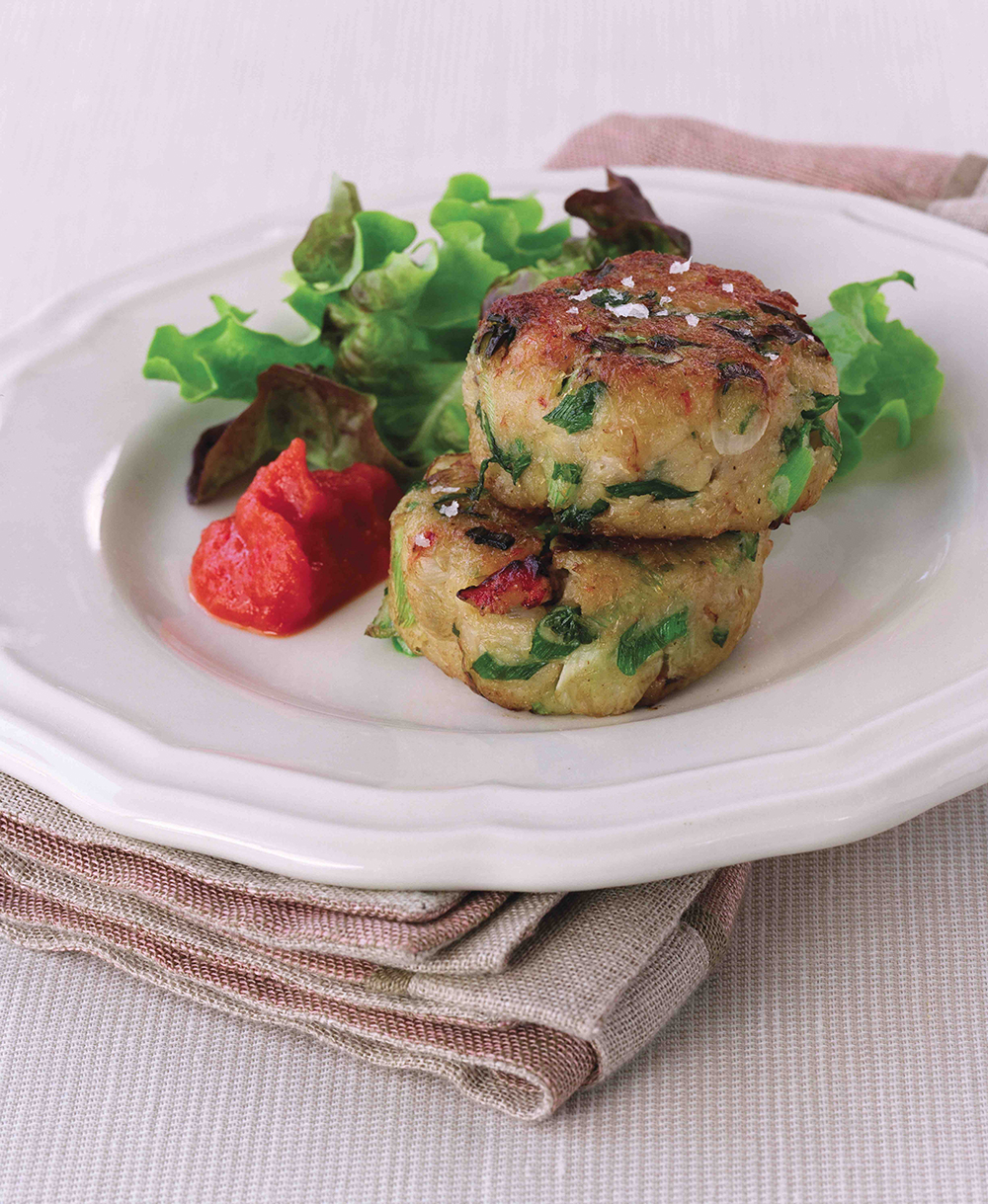 Crab Cakes with Coriander and Chilli
Crab Cakes with Coriander and Chilli
These crab cakes are really delicious and very easy to prepare. Use crab meat that is in largeish chunks and sourced the from a good fishmonger (or home cooked). For a variation with more traditional flavour, omit the chilli and use parsley instead of coriander. SERVES 4
225g/8oz white crab meat, thawed if frozen
50g/2oz spring onions, trimmed and finely chopped
50g/2oz mayonnaise
75g/3oz fresh white breadcrumbs
1 small egg, lightly beaten
1 tbsp chopped fresh coriander
1 small red chilli, seeded and finely chopped
2 tbsp sunflower oil salt and freshly ground black pepper
Serve with a lightly dressed green salad, red pepper and chilli relish (see below).
Place the crab meat in a bowl with the spring onions, mayonnaise, breadcrumbs, egg, coriander and chilli. Season to taste and mix gently until well combined. Divide the mixture into eight and then shape into crab cakes.
Heat the oil in a heavy-based frying pan. Add the crab cakes and cook for 3-4 minutes on each side until heated through and golden brown. Arrange the crab cakes on plates with some lightly dressed green salad and a good dollop of the red pepper and chilli relish to serve.
Red Pepper & Chilli Relish
Makes about 300ml/1/2 pint. Keeps in the fridge for up to a week.
Heat 2 tbsp olive oil in a heavy-based pan. Add 1 de-seeded chopped red pepper, 2 chopped red onions and 2 or 3 de-seeded chillies (to taste). Cook gently for 30 minutes until tender but not coloured, stirring regularly. Sprinkle 2 tsp sugar over the mixture and add 2 skinned and chopped tomatoes, then simmer for another 10 minutes until slightly reduced and thickened. Leave to cool and then blend in a food processor or with a hand-blender, to make a thick purée. Season to taste and place in a sterilised jar. Store in the fridge and use as required.
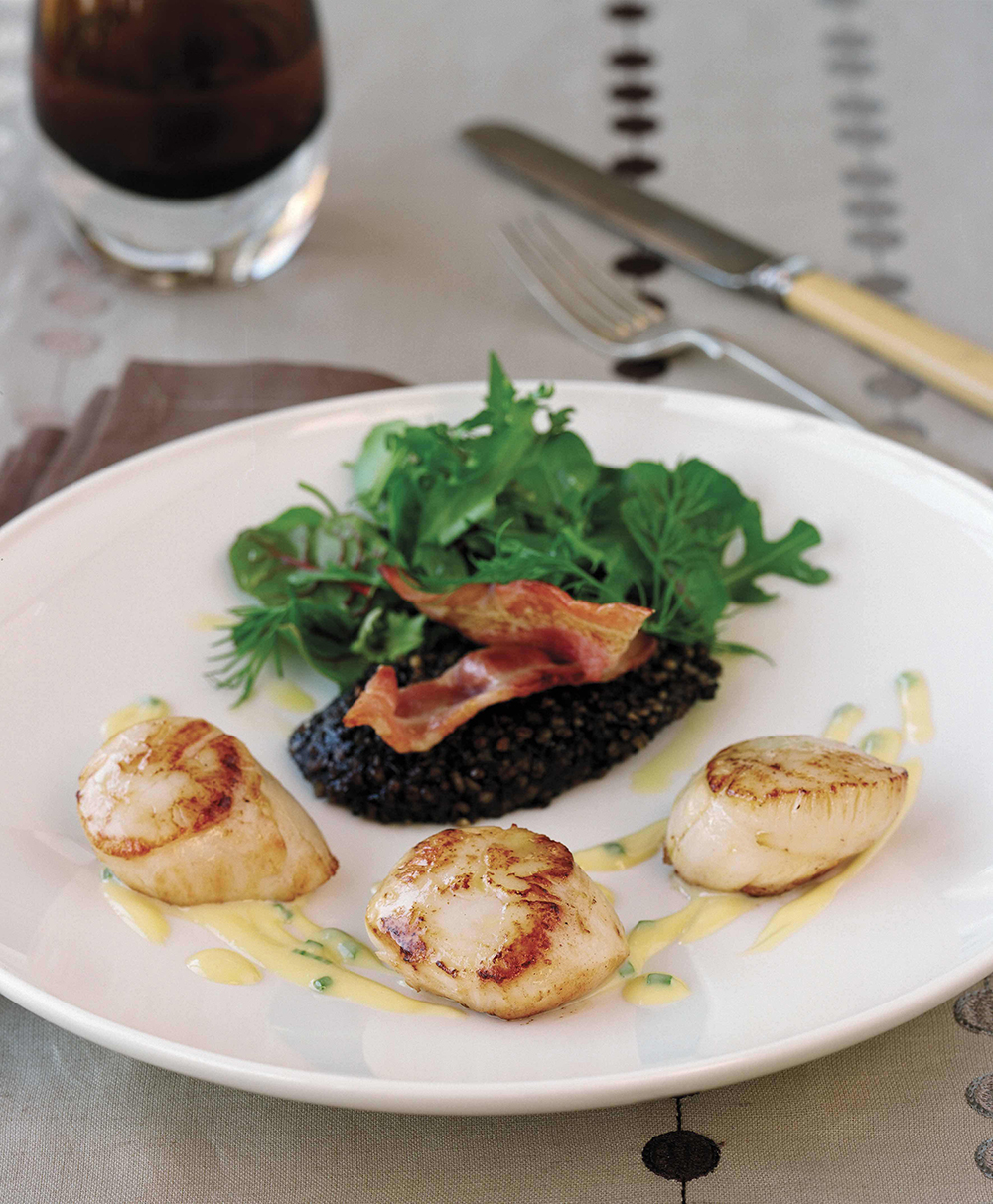 Seared Scallops with Black Pudding and Crispy Bacon
Seared Scallops with Black Pudding and Crispy Bacon
Grainy Clonakilty black pudding from West Cork has become a favourite accompaniment for scallops, and is delicious served with bacon and classic beurre blanc sauce. Take care when making the sauce to avoid it splitting - should feel warm, not hot when tested with your finger. SERVES 4
4 rindless streaky bacon rashers
4 slices black pudding, eg Clonakilty
12 large scallops
2 tbsp sunflower oil
1/2 lemon, pips removed
25g/1oz mixed baby leaf and herb salad
2 tsp extra-virgin olive oil
salt and freshly ground black pepper
Serve with warm beurre blanc sauce (see below)
Preheat the grill and arrange the bacon rashers and black pudding on the grill rack. Cook for 2-3 minutes, turning once until the rashers are crispy and the black pudding is cooked through.
Meanwhile, pat the scallops dry with some kitchen paper. Heat a large frying pan until it is quite hot. Add the sunflower oil, then add the scallops and sear over a high heat for 1 minute on each side until richly browned and crispy. Do this in batches if your frying pan is not very large. Transfer them to a plate, then add a squeeze of lemon juice and season to taste.
Place the baby salad leaf and herb salad in a bowl and season to taste. Drizzle over the extra-virgin olive oil, add a squeeze of lemon juice and gently toss the leaves to coat.
Arrange a mound of the dressed salad towards the back of each serving plate. Arrange the scallops around the dressed salad and pour a thin stream of the beurre blanc around the scallops. Place a piece of black pudding in the middle of each plate and top each one with a crispy rasher broken in two to serve.
Beurre Blanc: This is a simplified, stock-free version of the classic sauce. In a small heavy pan, boil 45ml/3 tbsp each of white wine vinegar and dry white wine with 2 finely chopped shallots. Add 1 tbsp double cream/crème fraîche if liked, and re-boil to a glaze. Gradually whisk in 225g/8oz very cold butter, cubed, to make a creamy sauce. Finally, bring just to a boil over high heat, whisking continuously. Strain if liked, season to taste and serve.
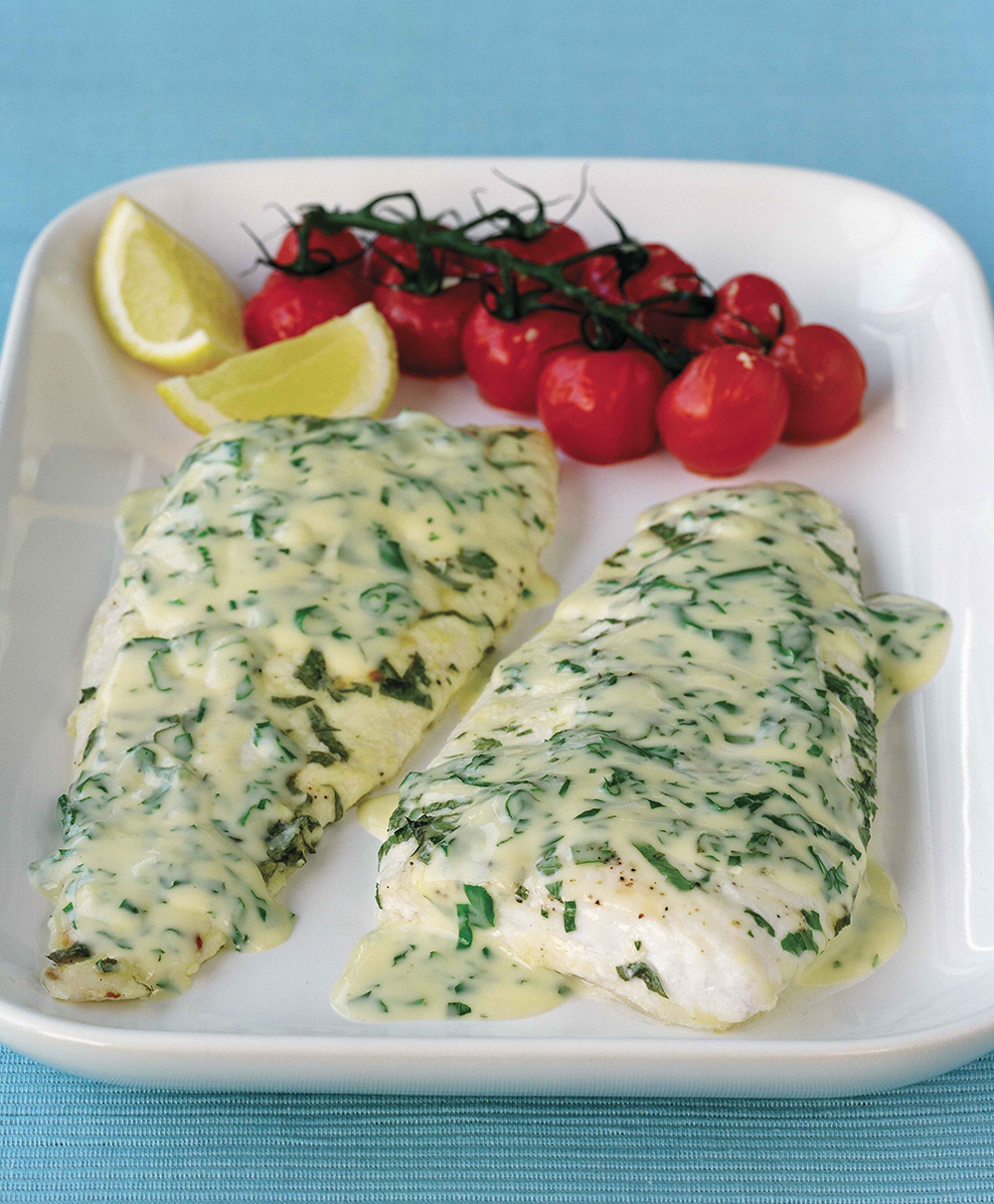 Brill in Tarragon and Soured Cream Sauce
Brill in Tarragon and Soured Cream Sauce
Brill is a fine fish and can be good value. It is similar to turbot (which is distinguished by little lumps on the skin) and, as with all flat fish, it is best to choose larger fish if possible, to get nice chunky fillets. This appealingly fuss-free dish is very tasty and it could be made equally successfully with other flat fish such as turbot or John Dory. SERVES 4
butter, for greasing
1.5kg/3lb large brill, filleted
175ml/6fl oz cream
1 tsp chopped fresh tarragon
2 tbsp chopped fresh flat-leaf parsley
2 tbsp fresh lemon juice
1 tsp sugar sea salt and freshly ground black pepper
Roasted vine cherry tomatoes to serve.
Preheat the oven to 200ºC/400ºF/Gas 6. Butter a dish large enough to fit the brill fillets. Place the cream in a bowl and stir in the tarragon, parsley, lemon juice and sugar. Season to taste.
Arrange the brill fillets in the buttered dish and spoon over the cream mixture to cover completely. Cover with foil, place in the oven and cook for 20-25 minutes or until just cooked through and tender.
Transfer the brill fillets onto warmed plates with the roasted vine cherry tomatoes and garnish with lemon wedges to serve.
Roasted Vine Cherry Tomatoes
If you have the oven on already, this is an excellent garnish for fish dishes - and, while keeping cherry tomatoes on the vine is attractive for presentation, regular cherry tomatoes would work equally well. For a more pronounced flavour, try adding a few unpeeled garlic cloves. SERVES 4
4 cherry tomato vines, each with 5-7 tomatoes
1 tbsp olive oil
sea salt and freshly ground black pepper
Preheat the oven to 200ºC/400ºF/Gas 6. Place the tomatoes in a small roasting tin and drizzle over the olive oil. Season to taste. Roast for 20 minutes until the tomatoes are tender and the skins have split. Serve at once.
Cookery Feature - Hooray for Irish Produce - Simply The Best!
.jpg)
When it comes to good food it’s all about the ingredients, and quality ingredients are all about great producers - so, as savvy chefs always tell us, the trick is to shop well, support local producers, and then treat their ingredients with respect.
But quality food is not something we can ever take for granted. Small producers made a huge contribution by raising the profile of Irish food and helping to ease the country back to prosperity after the 2008 crash, so it was a cruel irony that the Covid19 lockdown should suddenly snatch away their main routes to market due to the temporary collapse of the hospitality industry. Yet, as mindful consumers, every one of us can easily make a difference, now and into the future - as Darina Allen says in her column this month, we need to think about every single item that we choose to put into our shopping baskets. Perhaps it will cost a little more to shop local but it pays off in many ways, including the enjoyment of tastier food, pride of community and – in the long term – better health.
Looking at the wider Irish food and drink industry, Bord Bia’s recently published foodservice industry White Paper makes hard reading and the challenges are immense but, as Bord Bia Foodservice Specialist, Maureen Gahan, said, “While acknowledging the clear and ongoing damage to the Irish foodservice market… it is a hugely resilient industry and we have already seen a number of outlets transitioning their businesses to Take-Away and Home Delivery. Similarly, we have seen examples from our food and beverage producers that are pivoting their businesses to meet the new needs of their foodservice customers”.
Seeking to support those food and beverage producers and the hospitality sector, a number of initiatives have emerged that help both domestic shoppers and commercial enterprises to make a difference. The Eat For Ireland, app, for example, connects food shoppers (‘Cook It Yourself’) and diners (‘Cooked For You’) with independent food and drink producers, retailers, farmers’ market groups and hospitality outlets offering food for collection or delivery. Similarly, the popular Louth-based GastroGays food bloggers, Russell James Alford and Patrick Hanlon, were quick off the mark with a useful guide to Irish producers offering home deliveries. And, now that the farmers’ markets are trading again, they offer an interesting outing with rewarding exchanges with stallholders as well as access to unique produce – an especially welcome experience for all concerned after months of lockdown.
(Unfortunately Bord Bia’s very useful farmers’ market list is temporarily absent from their recently redesigned website, but it’s well worth keeping an eye open for its return.)
And, as with shopping, mindfulness will also pay off when it comes to recipes, which can easily be transformed from blandly ubiquitous references to memorable dining experiences with the application of a little local knowledge and the unique flavours that small producers can bring. Here are a few to try – very simple, yet oozing with character, and supporting local producers every inch of the way.
RECIPES
.jpg) CHARGRILLED VEGETABLE SALAD WITH MATURE IRISH GOUDA
CHARGRILLED VEGETABLE SALAD WITH MATURE IRISH GOUDA
You don’t have to be a vegetarian to enjoy this brilliant barbecue salad. All the main ingredients are grown in Ireland and you could up the ante with more local ingredients, eg by replacing olive oil with Irish rapeseed oil and traditional imported balsamic with excellent Irish alternatives from producers like Highbank Orchards or Llewellyn's
1 red pepper, deseeded and quartered
1 yellow pepper, deseeded and quartered
10-15 asparagus spears - try Louth producer, Drummond House
1 courgette, sliced diagonally into 1cm thick discs
1 tbsp olive oil, or Irish rapeseed oil such as Second Nature; Newgrange Gold; or Broighter Gold
15g rocket or flat leaf parsley, leaves chopped
10g fresh basil, leaves
Salt and freshly cracked black pepper
50g mature farmhouse Gouda shavings e.g. Coolea
Dressing:
2 tbsp extra virgin olive oil or Irish rapeseed oil, as above
½ tsp balsamic vinegar, eg Irish balsamic cider vinegar (see above)
Heat the barbecue until it is very hot.
Grill the peppers, skin side down until the outer skin is blackened and blistered. Place in a bowl, cover immediately with cling film and leave for 20 minutes (the cling film will trap the steam and loosen the skins). Peel the peppers, discarding the skin and slice lengthways into 3-4 long strips (the strips will be deliciously soft and sweet).
Snap off the hard woody ends from each asparagus spear (if necessary).
Brush the asparagus and courgettes with oil and season with salt and pepper. Grill for approximately 5-10 minutes, turning halfway through cooking until slightly charred on the outside. Cut the asparagus spears in half.
Combine all the warm vegetables in a bowl and toss in the oil and balsamic.
To serve, combine the chargrilled vegetables with the rocket, basil and shavings of the mature Coolea or other farmhouse Gouda-style cheese.
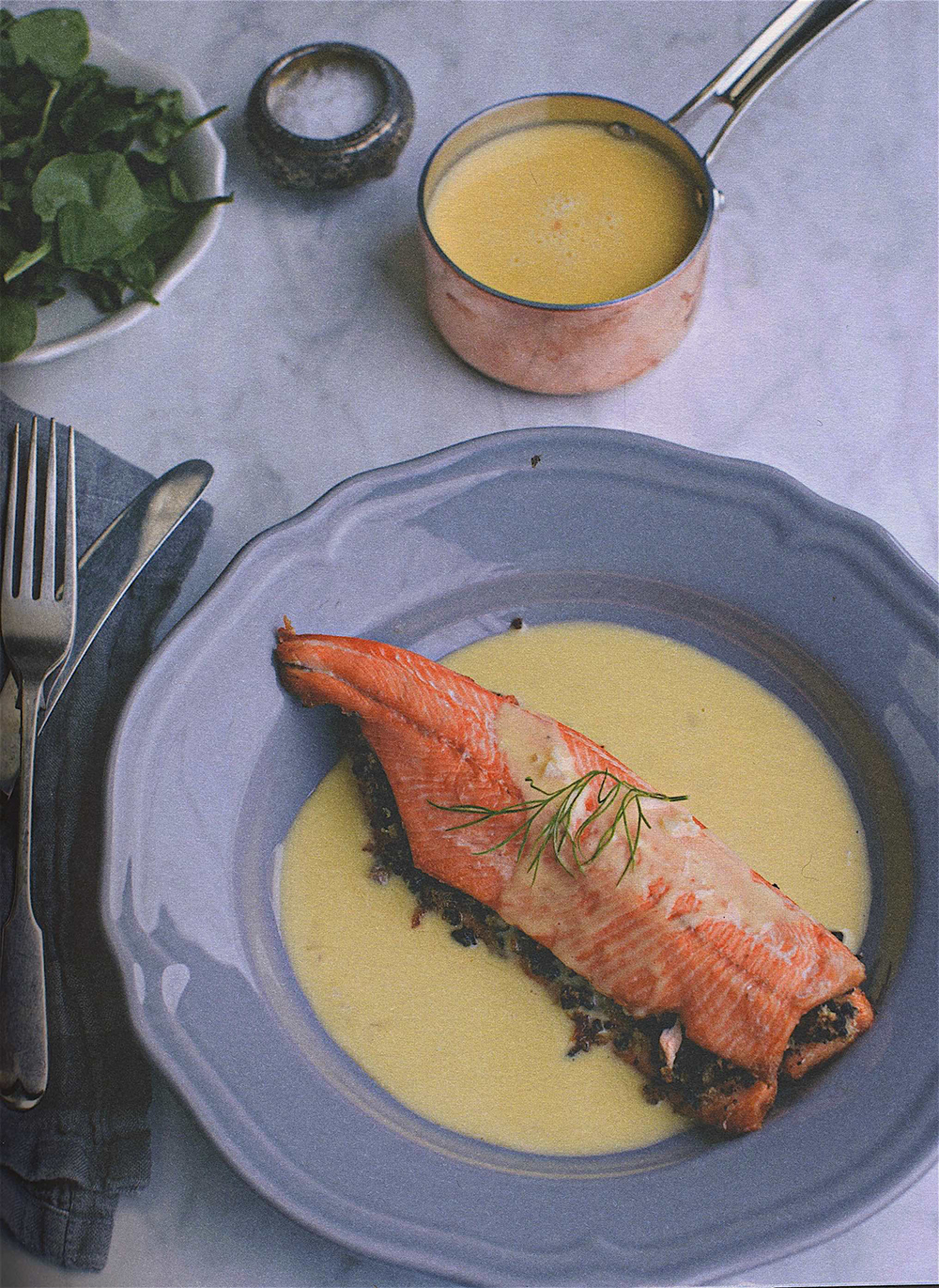 TROUT WITH INCH HOUSE BLACK PUDDING & BEURRE BLANC
TROUT WITH INCH HOUSE BLACK PUDDING & BEURRE BLANC
This unusual dish comes from the terrific ‘Fishwives’ recipe collection compiled by Mags Kirwan of Goatsbridge Trout, Thomastown, Co Kilkenny. The Inch House Black Pudding is hand made in Co Tipperary by Mairin Byrne and based on a traditional recipe handed down by her mother, Nora Egan, of the magnificent Inch House near Thurles, which offers excellent catered and self-catering accommodation for groups - and, as shown, in this lovely recipe, it associates very successfully with baked trout. [For details of more fish shops and producers around Ireland offering delivery, see last month’s feature.
Serves 2
4 small Goatsbridge trout fillets
50g/2oz butter, softened
Small bunch fresh basil, finely chopped
300g/12oz Inch House black pudding
125g/5oz breadcrumbs
2 shallots, finely diced
3 tbsp. white wine vinegar, or Irish cider vinegar eg Llewellyn's or The Apple Farm
300m/10.5fl oz cream
300g/2oz butter, cubed
1 lemon, quartered
Preheat the oven to 180°C/350°F/gas mark 4. Take two of the trout fillets and place, skin side down, on an oiled oven-proof dish or tray. Blend the butter and basil together and dot on top of the trout flesh; spread gently.
Crumble the black pudding into the breadcrumbs (use a food processor if you wish) and scatter over the buttered fillets. Place the other fillets on top, flesh side up, and bake for 15 minutes.
While the fish is cooking, make the beurre blanc sauce. Combine the shallots and white wine vinegar in a pan and bring to the boil over a medium heat. Simmer for three minutes until reduced by a third. Next, add the cream and slowly bring to the boil. Take off the heat and add a third of the butter while whisking constantly. Continue to add the butter, a small cube at a time, until the sauce thickens (stand over the sauce, as it can separate).
Serve immediately with the sauce, fresh lemon home- or locally-grown new potatoes and some new season greens.
.jpg) FARMHOUSE BAGUETTE WITH BLUE CHEESE & BACON
FARMHOUSE BAGUETTE WITH BLUE CHEESE & BACON
This quick and tasty snack for two shows that that simple can’t be beaten when the best ingredients are used. Try breads from quality bakers such as Tartine Organic Bakery, Dublin; Riot Rye Bakehouse, Tipperary; Arbutus Breads, Cork; Scarpello & Co, Donegal; or Seagull Bakery, Tramore… Bacon from picky producers like Northern Ireland leader Finnebrogue; McCarthys of Kanturk; or O’Neill’s Dry Cure Bacon, Wexford and cheeses like Tipperary favourite Cashel Blue or Bellingham Blue from Louth. And then wash it all down with a glass of something deliciously Irish such as natural juice from The Apple Farm near Cahir; Longueville House Cider or a craft beer from old hands like Eight Degrees Brewing both from North Cork, or perhaps Donegal pioneer Kinnegar Brewing.
1 artisan baguette or sourdough loaf
2 tbsp mayonnaise, eg Ballymaloe Mayo
2 handfuls of locally grown watercress or mixed baby leaves
175g / 6oz mature blue Irish cheese, cut in slices
6 slices of dry cured Irish streaky bacon, grilled and roughly cut
Halve and split the baguette, or cut four slices from the sourdough loaf.
Layer each base with mayonnaise, leaves, farmhouse blue cheese and streaky bacon.
Add the top, press down well and enjoy with a glass of Irish apple juice, cider or craft beer.
Cookery Feature - Simply Summer
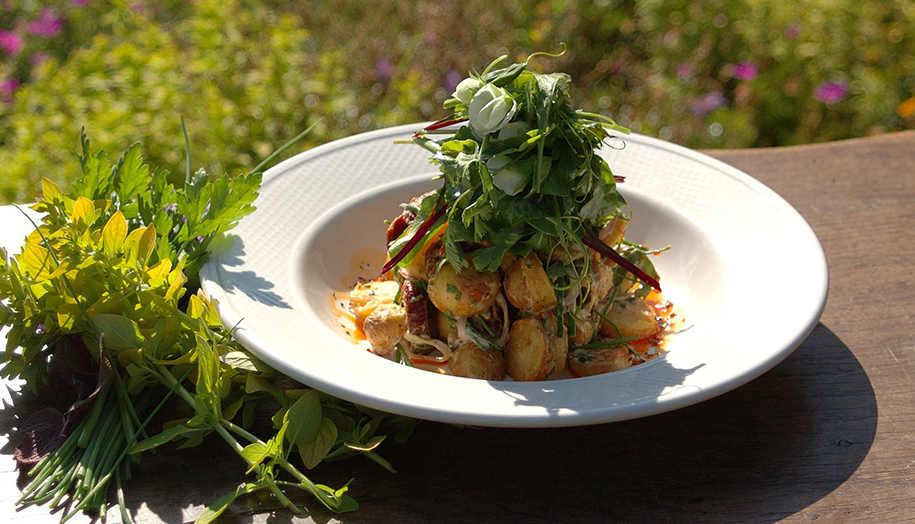
It’s all about the ingredients again this month - and why wouldn’t it be. High summer has brought an abundance of terrific Irish produce, so there’s no better time to keep it simple and spend less time in the kitchen - just let seasonal foods do the talking on the plate.
The secret, as always - unless you can produce your own - is to shop well. Seeking out the best local and Irish produce, and doing as little to it as possible, will always repay the careful cook with simple deliciousness - and, at this time, Irish producers need our support even more than usual.
The recipes below couldn’t be easier, and all depend on the quality of the ingredients for their success. A few favourite producers are suggested for the shopping list, and there are many more like them all over the country.
RECIPES
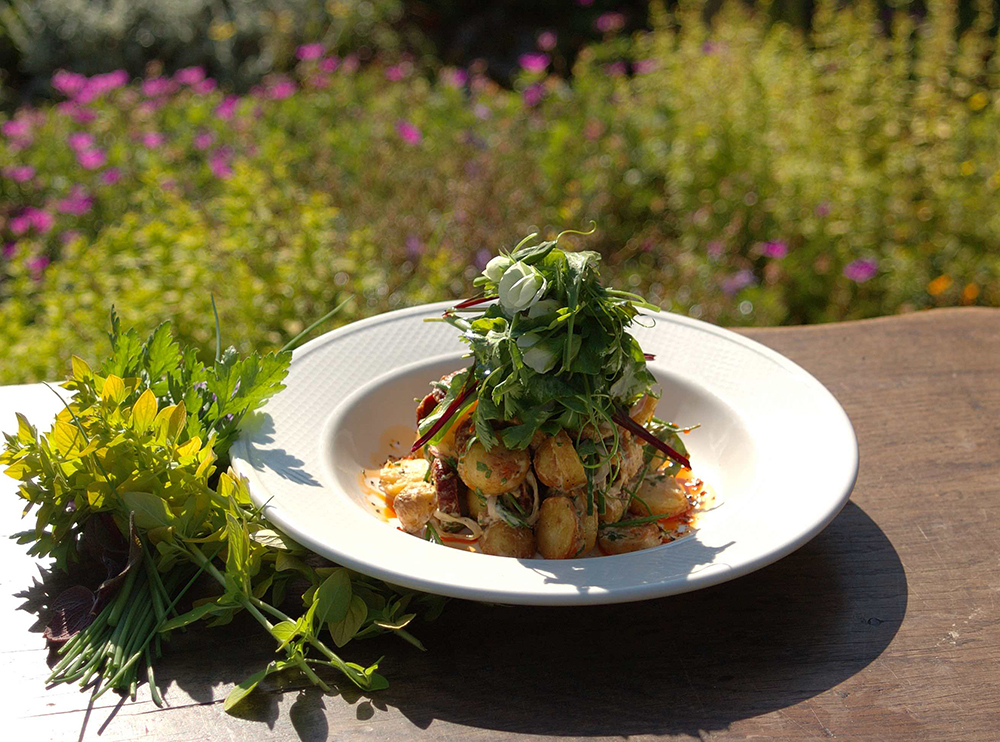 Ballyvolane House Warm New Potato and Gubbeen Chorizo Salad
Ballyvolane House Warm New Potato and Gubbeen Chorizo Salad
The Green family’s Ballyvolane House in Co Cork is a delightful Hidden Ireland property that is (normally) a stunning wedding venue, as well as being available now for whole-house rentals and B&B (and home to Bertha’s Revenge gin). The vegetables and herbs for this flavoursome salad would be grown in the beautiful old walled garden and, although the classic ingredients are given for the dressing, excellent alternatives are available from nearby counties. The bee-friendly Second Nature rapeseed oil from Drumeen Farm in Co Kilkenny, for example, is Ireland’s only organic rapeseed oil, while cider vinegars renowned for their quality are available from The Apple Farm near Cahir, and Highbank Orchards in Co Kilkenny - who also produce the delicious Highbank Organic Orchard Syrup, which is the discerning Irish cook’s go-to replacement for maple syrup. If you grow your own potatoes, it’s a pleasure to dig a few for a simple dish like this - if not, your local market or speciality food shop will have some that are grown not too far away.
Serves 4
600g small new potatoes
200g Gubbeen chorizo (or other good quality chorizo, preferably Irish eg On the Wild Side, made in Kerry, Killenure Dexter Gourmet Co Tipperary, or Forage & Cure, Dublin
One handful of flat leaf parsley roughly chopped
One handful of finely chopped scallions
Rocket or other fresh salad leaves, as available
Ballyvolane House Salad Dressing:
8 floz/ 240ml extra virgin olive oil
2fl oz/60ml white wine vinegar
2fl oz/60ml balsamic vinegar
2 tbsp /30ml maple syrup
To make the dressing: Combine all ingredients in a jug and whisk. Season to taste with salt and pepper and store in a screw-top jar.
Steam or boil the potatoes with a sprig of mint for about 10 minutes until tender. Set aside, allow to cool, and then slice in half.
Slice the chorizo and add to a heated frying pan. Cook for 5 minutes and then add the cooked potatoes and mix through until hot. Add the scallions and cook for a further minute to soften them.
Add the chopped parsley at the last minute, together with enough of the salad dressing to moisten the leaves. Season to taste and mix through gently, then pile up on shallow dishes with the dressed rocket or other salad leaves on top.
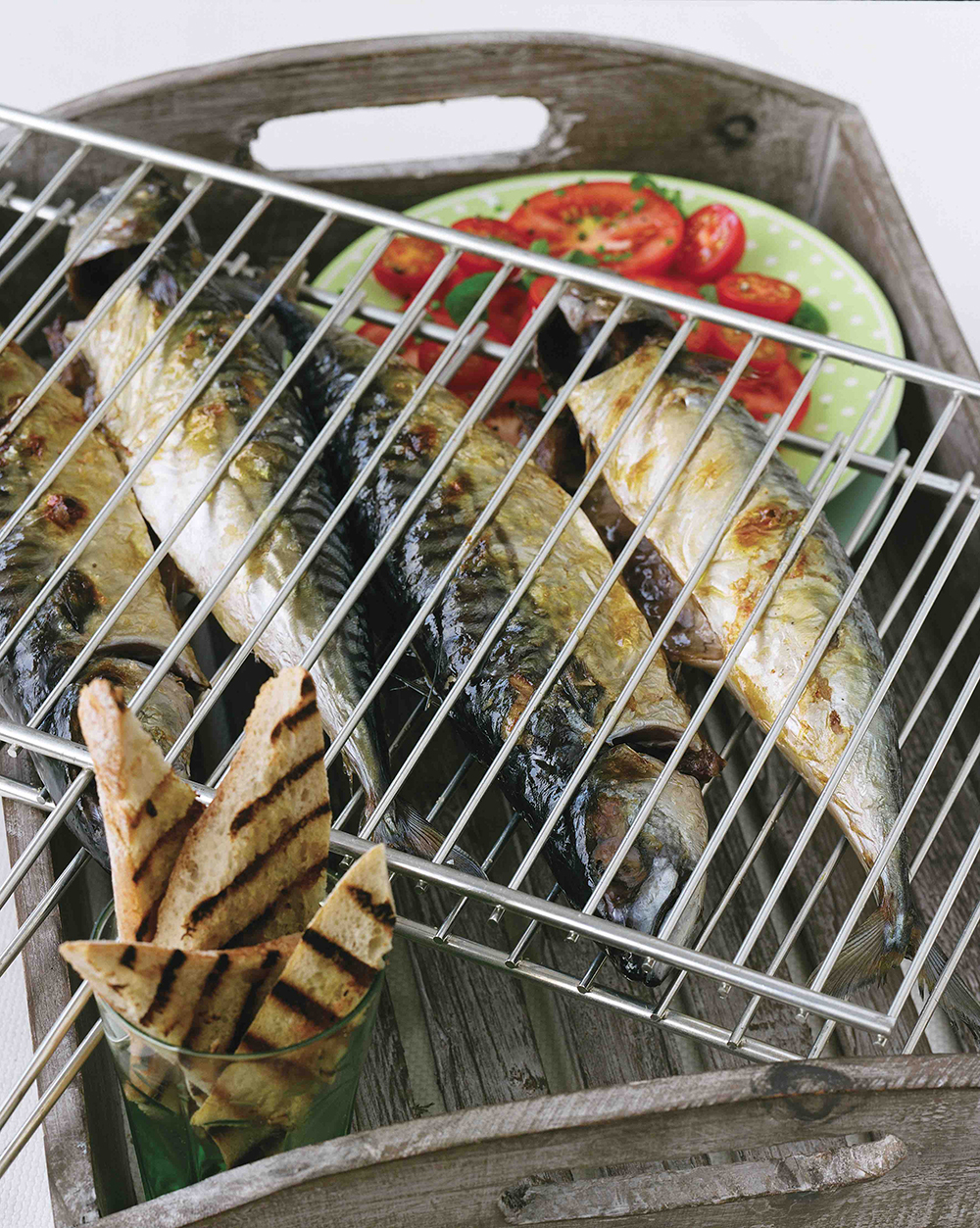 Grilled Mackerel with Three Tomato Salad and Bruschetta
Grilled Mackerel with Three Tomato Salad and Bruschetta
No fish says summer like a freshly caught mackerel fished from a pier or a day boat while on holiday …But there are plenty of excellent fishmongers around Ireland who sell the freshest of locally caught fish too - just a few of them were listed recently in our feature A Taste of the Sea and they will have plenty of other things to tempt you with as well while you’re there, perhaps including some samphire or other sea vegetables if you're lucky. A hinged wire rack is very handy for barbecueing fish, as it’s it easier to turn them over during cooking and helps to prevent them from sticking to the grill rack. Be careful not to overcook mackerel, as they can dry out quickly and lose their flavour. A tomato salad makes the perfect accompaniment, especially if you grow your own, or can get some from nearby growers. Using mixed tomatoes is attractive and the different varieties all have their own individual textures and flavours, but any variety of tomato will do of course. Garlic scapes are in season now and, if you have your own or can get hold of some from one of the commercial growers like Drummond House Garlic & Asparagus in Co Louth, or West Cork Garlic, a few chopped scapes would make a delicious addition to the salad - and they are brilliant in stir-fries too. This recipe is from the Summer Entertainig & Barbecues Chapter in From Tide to Table.
4 freshly-caught whole mackerel, gutted and cleaned
8 slices country-style / sourdough bread, cut on the diagonal
1 garlic clove, halved; olive oil, for drizzling
For the Three Tomato Salad
2 beef tomatoes, thinly sliced
4 ripe tomatoes, cut into wedges
100g (4oz) mixed cherry tomatoes, halved
1 shallot, thinly sliced and/or a few chopped garlic scapes
handful fresh basil leaves, shredded
6 tbsp salad dressing (the Ballyvolane dressing given above would work very well)
freshly ground black pepper
Serves 4
Preheat the grill or prepare a barbecue with medium-hot coals. Slash the mackerel through the thickest part and cook directly on a grill rack for 6-7 minutes on each side until cooked through and lightly charred.
Add the slices of bread to the grill rack for the last minute or two of cooking, turning them once. Rub with the cut side of the garlic clove and drizzle a little olive oil over each one. Keep warm.
Meanwhile, make the three tomato salad: Arrange the beef tomatoes in a single layer on the base of a large serving plate, then scatter over the tomato wedges and finish with a pile of the cherry tomatoes. Sprinkle over the shallots and basil and then drizzle the balsamic and honey dressing on top. Add a good grinding of pepper.
Serve the mackerel on plates with the bruschetta and hand the tomato salad around separately for guests to help themselves.
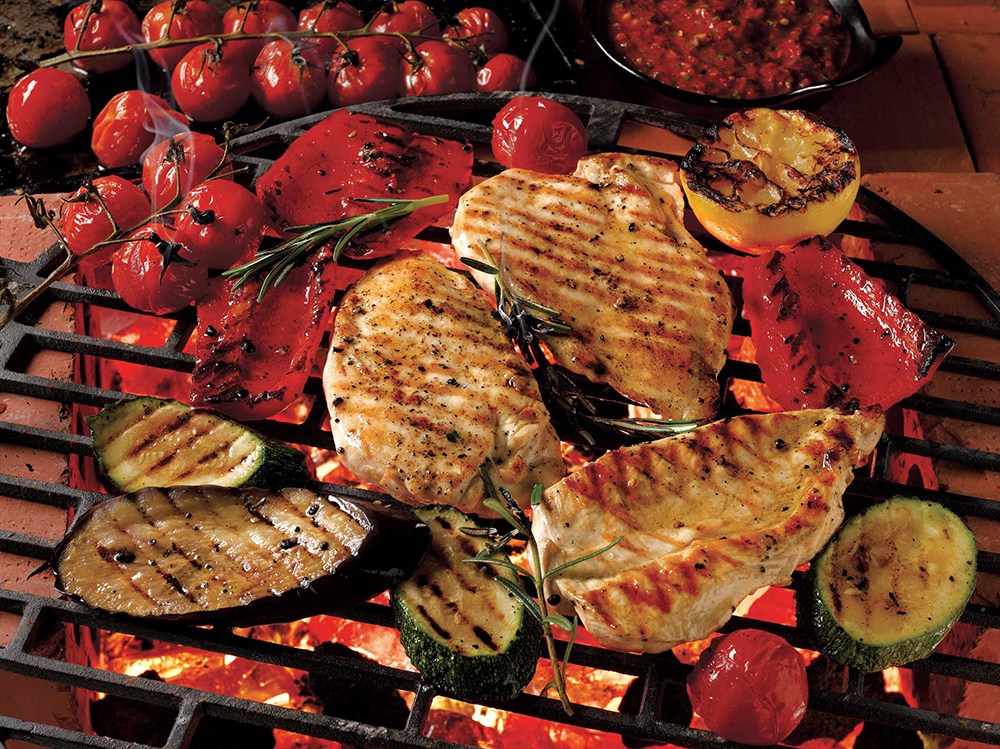 Barbecued Chicken with Harissa Dressing
Barbecued Chicken with Harissa Dressing
This is a really tasty chicken dish that can be on the table within half an hour and is equally successful if barbecued or cooked under the grill. You could use commercially produced Harissa, but it’s worth making your own for the freshness and flavour - and it is very easy to prepare. But key to the success of simple chicken dishes like this is the quality of the main ingredient and it’s always worth seeking out the best from producers such as Carlow Free Range; Kilkenny Free Range; Rings Family Farm, Co Kilkenny; The Friendly Farmer in Co Galway; or Coolanowle Organic Farm in Co Carlow - who now also have a butchers and shop with café and restaurant in Carlow Town.
Serves 4
4 chicken breasts, skin on
Juice of 1 lemon
1-2 tablespoons olive oil, or an Irish alternative (see Ballyvolane House dressing above)
Salt and black pepper
Harissa Dressing:
1 red pepper, roasted, skin removed and chopped
2-3 cloves garlic
3-4 chillies, roughly chopped
1 tsp ground cumin
1 tsp ground coriander
Handful of coriander leaves
4 tbsp olive oil, or an Irish alternative (see above)
Juice of a lemon
An hour or two ahead, if possible, place the chicken breasts in a shallow dish. Pour over the lemon juice, oil and seasoning.
Meanwhile, make the dressing: Put all the ingredients in a food processor and process to form a thick sauce. Use as required - any leftovers will keep in the fridge for at least a week.
When ready to eat, preheat the grill or barbecue; cook the chicken carefully until thoroughly cooked.
Serve with: new potatoes and seasonal vegetables or salad.
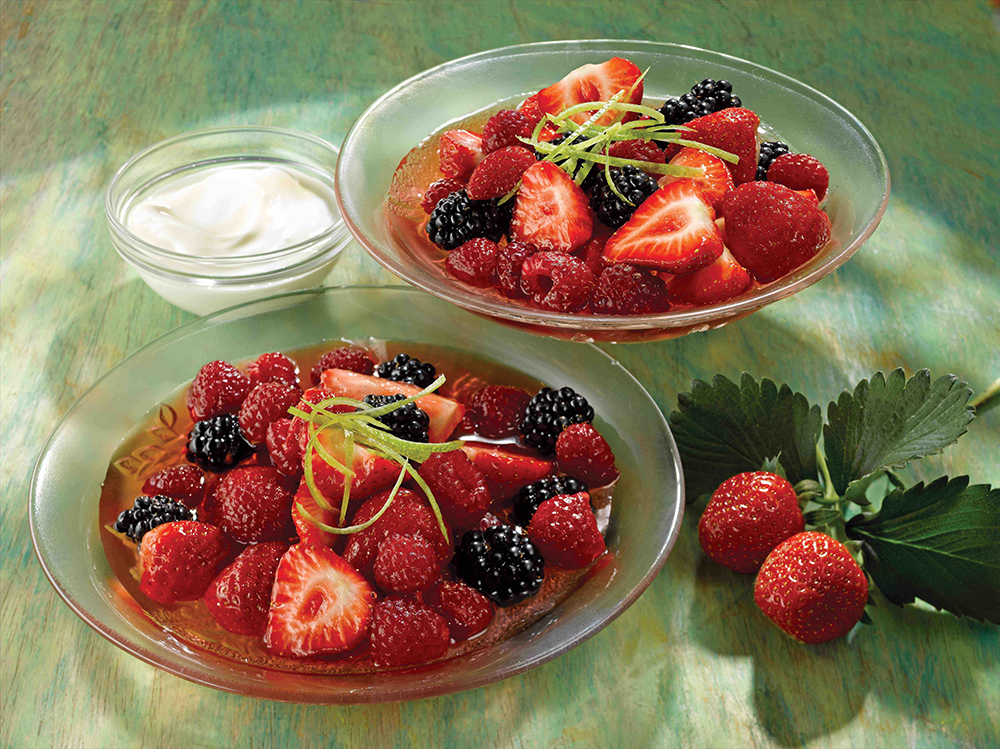 Organic Summer Berries in a Lemongrass Syrup with Organic Natural Yoghurt
Organic Summer Berries in a Lemongrass Syrup with Organic Natural Yoghurt
It’s surprising how much imported fruit there is in the shops, even at the peak of our growing season, so it’s worth checking the labels - The Fruit People list of some of the major growers, and markets and speciality shops also sell fruit from smaller producers. Keep an eye out for Irish blueberries from Derryvilla Farm in Co Offaly, which are in season in July and August. It is also fun to forage for their smaller cousins, wild bilberries, in peaty mountainous areas such as the Wicklow Hills - although you will be lucky to get them before the birds do. Home- or locally-grown summer berries at the peak of perfection really need no embellishment - a drizzle of Irish honey or a sprinkling of sugar (where are you Irish beet sugar, when we need you…), perhaps, along with a spoonful of fresh cream or a dollop of good Irish yogurt - favourite brands often found in my fridge include Clandeboye Estate, Co Down Glenisk Organic Co Offaly; Glenilen Farm West Cork; and Killowen Farm Co Wexford. A simple stock syrup (100g caster sugar to 150ml water) is useful to keep in the fridge for fruit salads and, for something slightly more exotic, the citrus tang of lemongrass enhances the flavour of many fruits - as in this classic Bord Bia recipe. Serves 6
4 lemon grass stalks, finely chopped
450g caster sugar
Juice and zest of 2 limes
300g Irish blueberries
300g Irish raspberries
300g Irish strawberries, hulled and quartered
Organic natural yoghurt
Put the lemongrass into a saucepan with the sugar and 1 litre of water; stir over moderate heat until the sugar dissolves, then bring to the boil. Reduce the heat and simmer for 2 minutes. Cool, cover and chill overnight for the flavours to infuse. Strain the syrup and add the lime juice and half the lime zest.
To serve, divide the fruit between six bowls, pour over some syrup and scatter with the remaining lime zest. Serve with a bowl of natural yoghurt. Store any leftover syrup in a screwtop jar in the fridge, for up to three weeks.
www.eatforireland.ie #ThisisIrishFood
Cookery Feature - Wild & Free
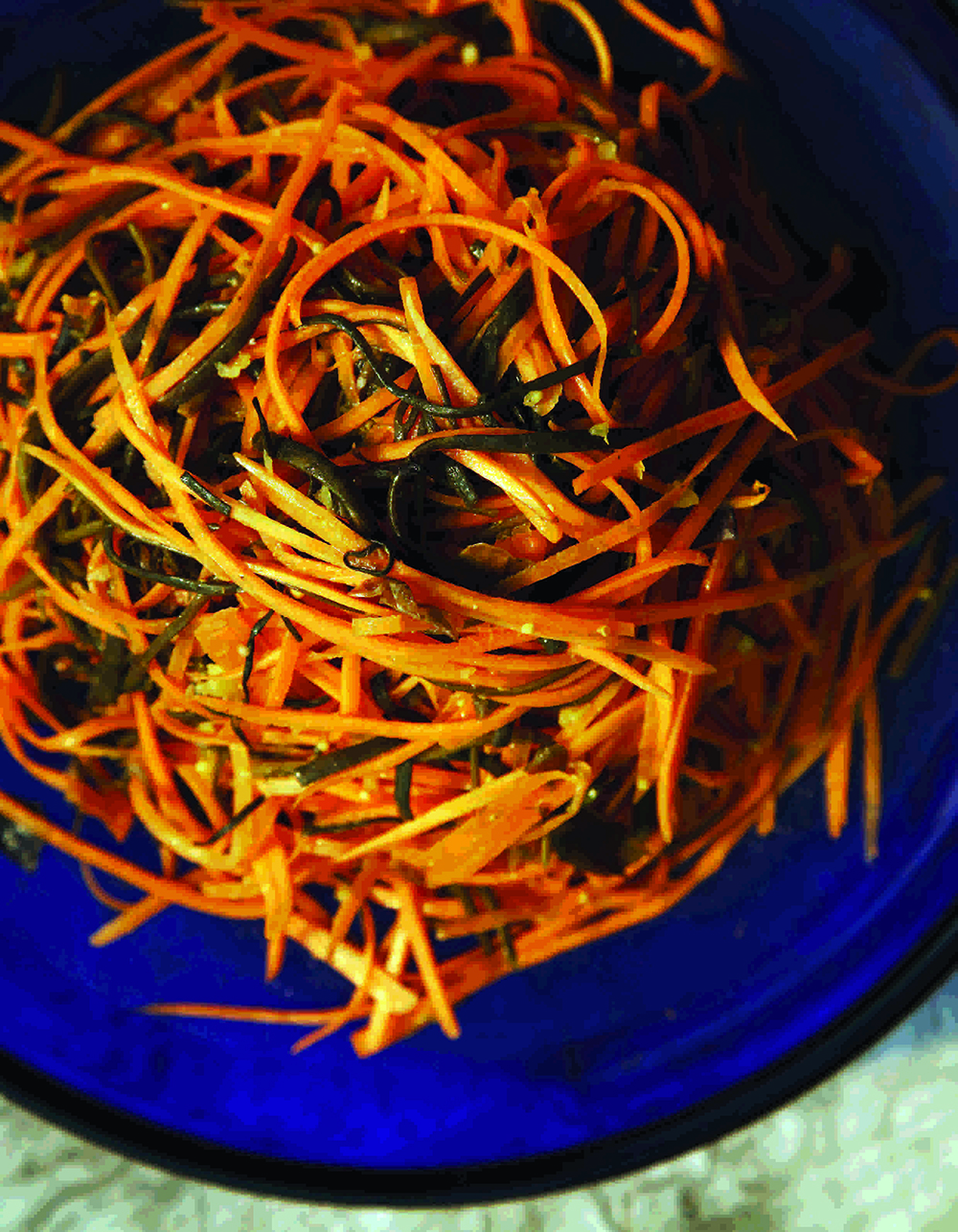
Thanks to this year’s travel restrictions, 2020 will go down as the year of the great Irish staycation. And that’s proving to be a silver lining of this challenging time as - just as we did in the recession, when foreign holidays were put on hold for different reasons - many of us have found ourselves exploring some of the quieter areas of Ireland, spending more time close to nature and enjoying the opportunity to forage for the plentiful free food that is to be found everywhere at this time of year. Interest in foraging has been growing dramatically recently and, for a lot of city people, having the opportunity to get stuck into it this summer will have triggered a lifelong enthusiasm.
Free food in the wild is not restricted to summer holidays, but there is something special about that ‘what shall we do today’ feeling and - whether it’s the mackerel caught from a pier on a sunny day, seaweeds cut carefully from the rocks, sea vegetables foraged along the shoreline, or berries and fungi found on moors and woodland - nothing tastes better.
 Shoreline vegetables grow anywhere they can get a hold in salty areas - would fit in anywhere in this Intro section between the sea and the land proper. Two of the most popular for culinary purposes are Sea Spinach – also known as Sea Beet – which has along season and is easily identifiable because it has shiny green leaves with fleshy stems and looks quite similar to garden spinach, and the delicate Samphire, a plant with finely branched tubular stems.
Shoreline vegetables grow anywhere they can get a hold in salty areas - would fit in anywhere in this Intro section between the sea and the land proper. Two of the most popular for culinary purposes are Sea Spinach – also known as Sea Beet – which has along season and is easily identifiable because it has shiny green leaves with fleshy stems and looks quite similar to garden spinach, and the delicate Samphire, a plant with finely branched tubular stems.
When foraging for sea spinach, choose tender young leaves, trim and wash well then use them whole ,or with the chard-like stems removed. Their salty tang and robust texture makes them a good accompaniment to bland, soft foods, such as eggs, and they can be cooked or used fresh in salads when very young and tender.
Samphire is at its best in July and August and pairs well with seafood so it’s often available in fish shops in season. It’s a bit like miniature asparagus and very quick and easy to prepare, to use as a side dish on its own or to mix through new potatoes - just select tender sprigs, wash well and steam for 3-5 minutes, then drain and toss in butter. Traditionally it is also pickled and marries well with cheeses.
RECIPES TO TRY:
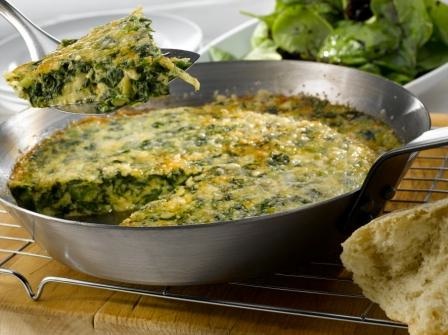 Green Frittata With Sea Spinach Salad
Green Frittata With Sea Spinach Salad
A quick and easy holiday meal that could be made with cultivated spinach or sea spinach, as available, or a mixture. The flavour and texture of sea spinach is more robust than the usual kind, so taste it raw to familiarise yourself with the taste and experiment with a single serving or try using less and mix it off with more familiar vegetables – or use it only in the frittata, or in the salad rather than both. Wash sea spinach leaves carefully, and trim before use. Season with pepper but don’t add salt, as the sea spinach is naturally salty.
Serves 4
2 tablespoons olive oil
1 bunch of scallions, chopped
Approx 400g baby sea spinach leaves or cultivated spinach leaves, well washed and drained
6 eggs
Good handful of grated hard cheese (mature flavour)
Knob of butter
Freshly ground black pepper to season
2 to 3 teaspoons balsamic vinegar
Pre-heat the grill.
Heat a tablespoon of the oil in a large non -stick pan, add the scallions and a third of the spinach.
Stir-fry for 2-3 minutes until the vegetables soften.
Tip into a colander and press down to squeeze out the excess moisture.
Beat the eggs and cheese and then add in the spinach mixture and stir well.
Reheat the pan, adding the knob of butter; pour in the egg mixture and cook, stirring gently, until well set on the base.
Finish cooking under the grill.
Slide onto a large plate for serving or cut into wedges and serve from the pan.
For the salad: Mix the remaining spinach with the olive oil and balsamic vinegar, season lightly and serve with the frittata and some crusty bread.
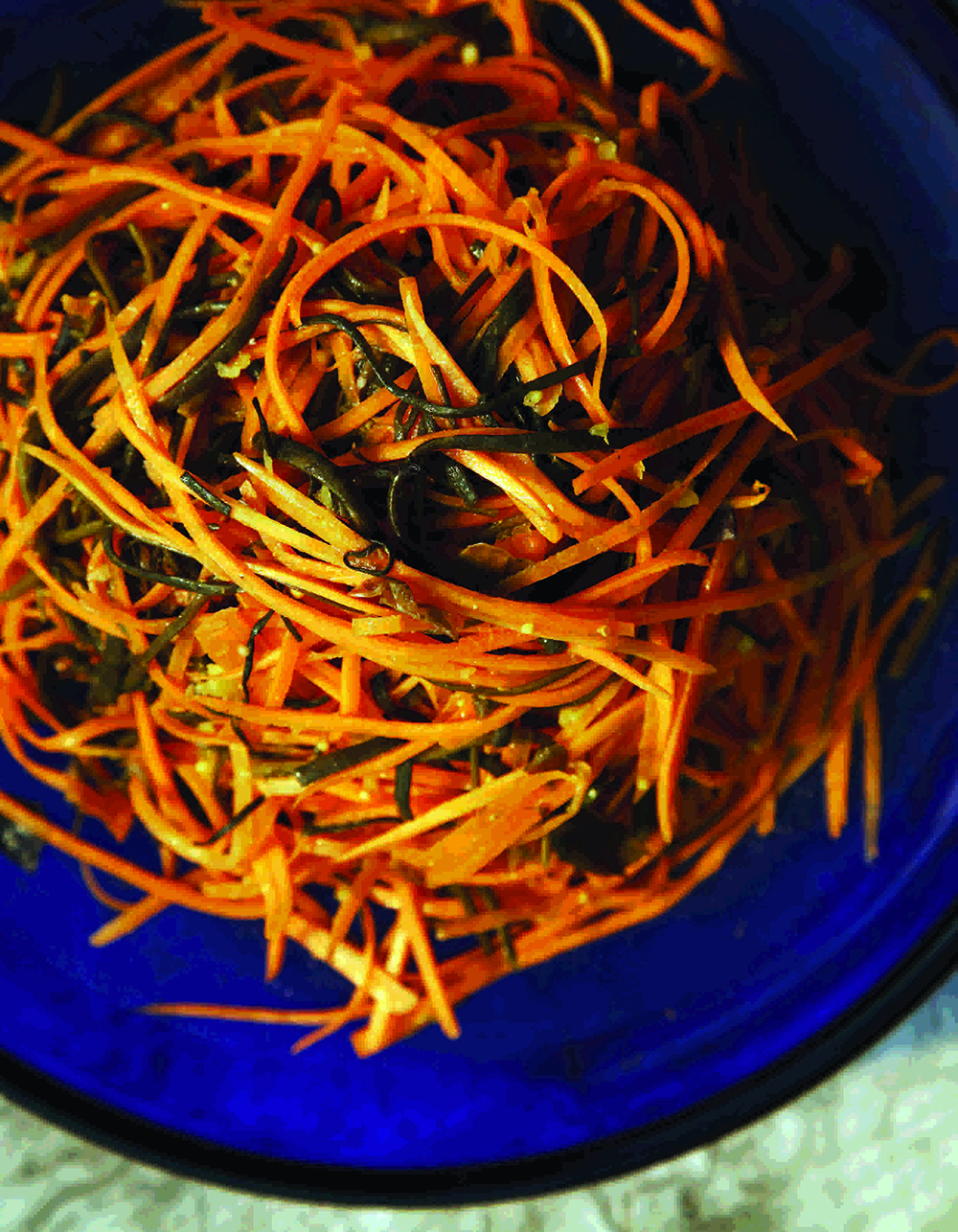 Carrot and Sea Spaghetti Salad
Carrot and Sea Spaghetti Salad
Sligo GP, Prannie Rhatigan’s Irish Seaweed Kitchen is the go-to guide to harvesting, preparing and cooking Irish seaweeds, which she describes as “... a living treasure by the shore, more valuable by far than any golden coins that may lie buried beside it in the sand.” In this recipe, willowy sea spaghetti and delicate carrot strips combine with a sweet garlicky dressing to create a colourful, easy to prepare salad that Prannie makes regularly for demonstrations and it never fails to delight even first time seaweed tasters. And sea spaghetti is very easy to recognise - the name says it all!
Serves 4-6
15g (½oz) dried sea spaghetti, or a handful of fresh sea spaghetti
2 tablespoons lemon juice
1 tablespoon wine vinegar
4-5 carrots, washed well, not peeled, and sliced into long, fine lengths with a potato peeler
Dressing:
3 tablespoons good quality olive oil
1½ tablespoons lemon juice
1 teaspoon coarse whole grain mustard and honey
1 tablespoon mixed seaweed
2 cloves garlic, crushed
A pinch of cayenne pepper
A pinch of grey sea salt
To prepare the sea spaghetti: Rinse dried sea spaghetti and soak in warm water for 1 hour or briefly steam until al dente. If using fresh sea spaghetti, rinse well and steam for 10 minutes until al dente. Rinse the seaweed again and then marinate in the lemon juice and wine vinegar for a few hours or overnight. Some strands can be left full length to decorate – chop the remainder into 2.5-5cm (1-2 inch) pieces.
To prepare the salad: Combine the dressing ingredients in a small jug or bowl. Pour the dressing over the carrots and sea spaghetti and allow to marinate for at least an hour.
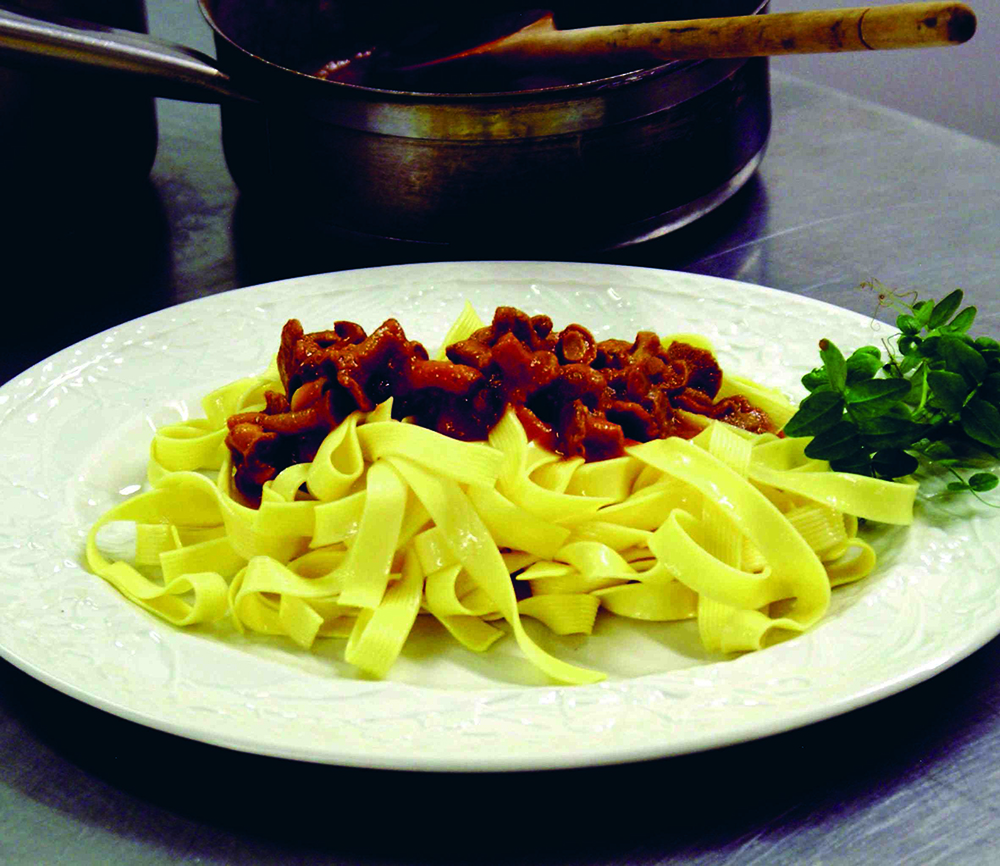 Wild Chanterelle Goulash
Wild Chanterelle Goulash
One of the most highly prized wild fungi, bright yellow chanterelles are in season from July to November and they’re easily spotted in clusters in woodland, notably in forests with birch, beech and mossy coniferous areas. They’re especially good in potato, egg and bacon dishes, and they keep for couple of days in the fridge or can be dried, or preserved in oil. This recipe is from The Strawberry Tree Restaurant at BrookLodge, which specialises in organic and wild foods and features in the very useful book “Wild Food, Nature’s Harvest: How to Gather, Cook & Preserve” by Evan Doyle, of BrookLodge, and the late food writer, Biddy White Lennon. They recommend using wild or organic ingredients wherever possible.
1kg wild chanterelles
2 onions, finely diced
2 red peppers, diced
100g streaky bacon or pancetta, diced
1 garlic clove, finely chopped
2 tbsp tomato purée
1 rounded tbsp sweet paprika powder
300ml vegetable or chicken stock
A splash of white wine vinegar
50ml organic cream
½ bunch parsley, chopped
Crème fraiche
Sea salt and black pepper
Organic rapeseed oil for frying
Brush the chanterelles or wash very quickly under running water and pat dry. Heat some oil in a pan and fry the mushrooms quickly, turn into a sieve set over a bowl and save the poured-off liquid.
Fry the diced onions over medium heat until golden, add the peppers, garlic and bacon and fry for another 5 minutes. Reduce the heat, put the tomato purée in and stir well, avoid burning the purée. Add the paprika powder and then deglaze it with the vinegar.
Pour the stock and the saved liquid from frying the chanterelles and cook it gently for 15−20 minutes. Add the cream, season with salt and pepper and blitz in a processor.
Strain through a sieve into a pot. Put the chanterelles back in the sauce and cook for a few more minutes.
To finish, fold in the chopped parsley and season to taste. Garnish with, or fold in, a dollop of crème fraiche
Serve as its original decreed, with bread dumplings, or maybe with pasta or rice instead. Makes a perfect flavourful supper with friends or even a TV snack - just spoon over a slice of fresh grilled bread, and enjoy.
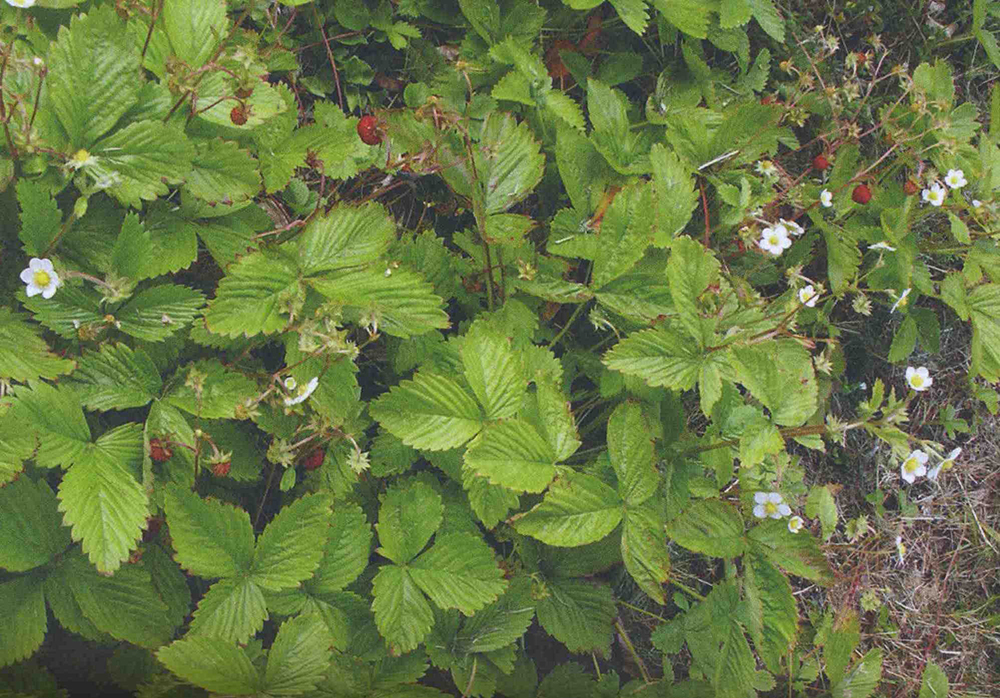 Wild Strawberry, Bilberry, Blackberry & Rose Water Jelly
Wild Strawberry, Bilberry, Blackberry & Rose Water Jelly
The small, but sweet and intensely aromatically flavoured, fruits of Fragaria Vssca, the wild woodland strawberry or fraises des bois are produced generously over a long season, from June to late September. They may well pop up in your garden, where they will settle and reproduce in the same way as cultivated strawberries, by runners thrown out in late season, which root where they land on soil. ‘Wild’, or Alpine, strawberries are also bred for cultivation have slightly larger fruits and similar, although less intense flavour. Bilberries (‘fraughan’, the smaller wild cousin of the blueberry) are in season now and there for the picking if the birds have missed a few - and the blackberries won’t be far behind. This recipe is also from ‘Wild Food’ where Evan and Biddy describe it as “an adult jelly of summer fruits that will transport you back! … We feel that the rose water adds to the deep perfume taste of this fabulous fruit, the wild strawberry.”
1 handful wild strawberries
2 handfuls wild bilberries
2 handfuls wild blackberries
750ml water
400g sugar
½ vanilla pod
5 leaves of gelatine
4–5 drops of rose water
250ml sparkling white wine
Place the water and sugar into a saucepan with the half vanilla pod, split. Bring slowly to boil to dissolve the sugar. Soak the gelatine leaves in a bowl of cold of water. Add gelatine into hot liquid and stir until you are sure the gelatine is fully dissolved through the liquid. Whisk the rose water drops into the liquid and add the white wine.
Use a large mould, just as your grandmother did, for placing in the centre of the table. Or, use individual dariole moulds or coffee cups or whatever shape you like. Place a layer of the wild strawberries in the bottom of mould and just cover with the jelly liquid. Allow this layer to set in fridge. Keep the remainder of the liquid jelly warm. When set, add another layer of berries, this time using all three types of berries (wild strawberries, wild bilberries and wild blackberries). Repeat layering process until the mould is full.
Allow to set in the fridge. To turn out, dip the jelly mould into hot water for a few seconds and turn out onto serving dish.
Cookery Feature - Time To Go Organic
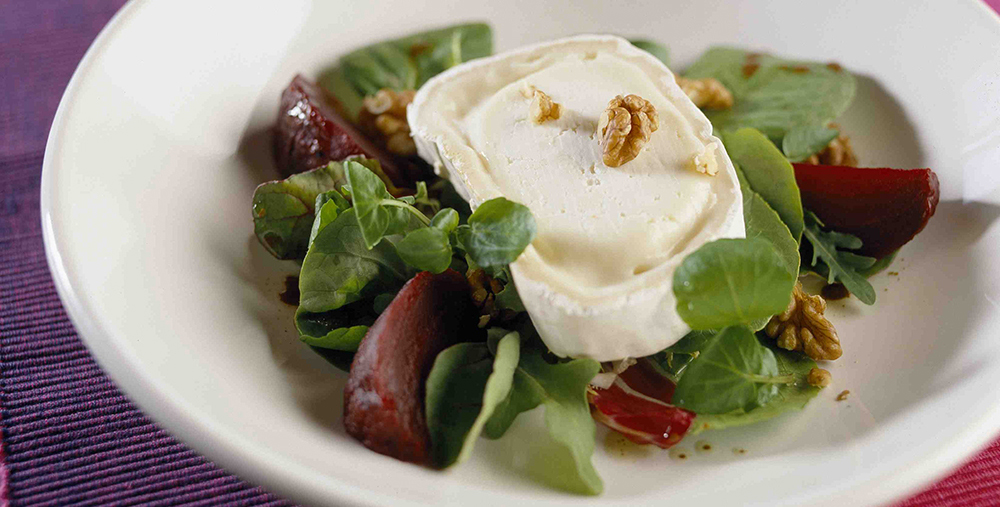
There’s never been a better time to make the case for organic food production and its potential in Ireland is massive. With Green issues including climate change at the top of the political agenda, plus concerns about the possible fall-out if there’s a no-deal Brexit and WTO rules are introduced, there’s a unique opportunity to do the right thing by the environment and build on Ireland’s reputation as a quality food producer at the same time. And perhaps we could even bite the bullet and go for the ultimate prize: Ireland as an organic food island…?
But, even if only working to increase production within our growing organic sector, the benefits for both Irish farmers and consumers would be beyond immense. The demand for organic food has always outstripped supply and it’s shameful that we continue to import vast quantities of premium foods that could easily be produced (and, in many cases, also processed) here instead, and then promoted and enjoyed as local produce.
.jpg) Thinking back on it, it’s amazing how farming has changed in little more than half a century - for anyone growing up more than 50 or 60 years ago, organic farming was more or less the norm; it didn’t need a label, it was just traditional farming. But cheap food policies and the intensive farming systems that went with them changed all that after World War Two. With the drive to increase yields dramatically and – crucially - to produce cheap food, the holistic traditional mixed farm was in the line of fire. But, now that we’re coming full cycle and acknowledging the damage that intensive production can bring, it’s time for traditional extensively produced food (mainly, but not necessarily, ‘organic’) to get the recognition - and command the price - that it deserves.
Thinking back on it, it’s amazing how farming has changed in little more than half a century - for anyone growing up more than 50 or 60 years ago, organic farming was more or less the norm; it didn’t need a label, it was just traditional farming. But cheap food policies and the intensive farming systems that went with them changed all that after World War Two. With the drive to increase yields dramatically and – crucially - to produce cheap food, the holistic traditional mixed farm was in the line of fire. But, now that we’re coming full cycle and acknowledging the damage that intensive production can bring, it’s time for traditional extensively produced food (mainly, but not necessarily, ‘organic’) to get the recognition - and command the price - that it deserves.
Organic food has certainly come in out of the culinary wilderness in recent years and, as an increasing number of mindful consumers see it as a mainstream alternative, it’s far from being the niche area that it was. After all, if we care about the quality and provenance of what we’re putting into our mouths - and, especially, our children’s mouths - it obviously makes sense to choose food that will protect our health rather than undermine it and cause problems in years to come. But ‘organic’ is perceived as ’expensive’, and something that’s harder to get across – given the massive emphasis on low prices in all of our main food shops – is that quality has a value. We need to educate the next generation of shoppers to recognise that cheap food is a false economy, and unsustainable.
There’s also the problem of a general sense of entitlement to cheap food, which has persisted since WW2 even though there’s no logic to it. It’s obvious that, to get quality and support our producers and the local economy, we must be prepared to spend more on food. When seen as an investment, lower health bills alone could well offset any extra food costs, with benefits such as reduced obesity levels putting less strain on the health system as well as improving the quality of life for many people. And we can also be more imaginative in the ingredients we choose, make savings by opting for less expensive cuts of high quality food - and, given those obesity problems, adopt the motto ‘eat less, but better’.
And early autumn, when fresh seasonal Irish produce is at its most abundant and next year’s crops are being planned, is the perfect time to think about it. However you look at it, the potential is huge. More people are producing food organically in Ireland now, but it could be far, far more - and, once economies of scale come into play, prices would become more attractive too, so that’s a win-win all round, especially when environmental benefits including the health of our soil and rivers are taken into account. Imaginative schools food programmes (often the result of initiatives by group such as GIY) are among the measures that are beginning to turn the tide and, once children get involved they aren’t shy in ‘educating’ their parents - so changes for the good in consumer habits could come much sooner than we think.
Find out more from the Irish Organic Association, The Organic Trust, and Bord Bia who will be hosting the National Organic Awards through a hybrid event, with both virtual and real life elements, this year on Wednesday October 21st 2020 at 3pm.
RECIPES:
 Soft Boiled Organic Eggs and Organic Smoked Salmon Bagels
Soft Boiled Organic Eggs and Organic Smoked Salmon Bagels
Irish Organic Salmon is farmed in the deep, strongly tidal waters off the West coast, notably Clare Island in Clew Bay, Co Mayo (one of the world’s first certified organic salmon farms) and is renowned for its flavour and muscular texture. It goes perfectly with organic eggs – which are now becoming more widely available, as more organic producers go into poultry and egg production. If preferred, the salmon in these bagels could be replaced with slices of cooked ham - or try wilted spinach for a vegetarian alternative. Serves 4
4 large organic eggs, eg Clonarn Clover, Connolly’s or Nest Box
2 bagels
butter, for spreading
200g/7oz packet organic smoked salmon slices
30 ml/2tbsp crème fraîche
1 tsp fresh chives, chopped
Sea salt and freshly cracked black pepper
Place the eggs in a small pan of water and boil for 5 minutes, then drain and plunge into a bowl of iced water. Set aside for 10 minutes as this will make them much easier to peel.
Preheat the grill to high.
Cut the bagels in half and arrange on a grill rack. Cook for 1-2 minutes until toasted, then spread with a little butter.
Place the toasted bagel halves on warmed plates and ruffle the smoked salmon slices on top. Add a dollop of crème fraîche.
Shell the eggs and cut each one in half, then arrange on top of the smoked salmon and crème fraîche.
Season to taste and sprinkle with the chives to serve.
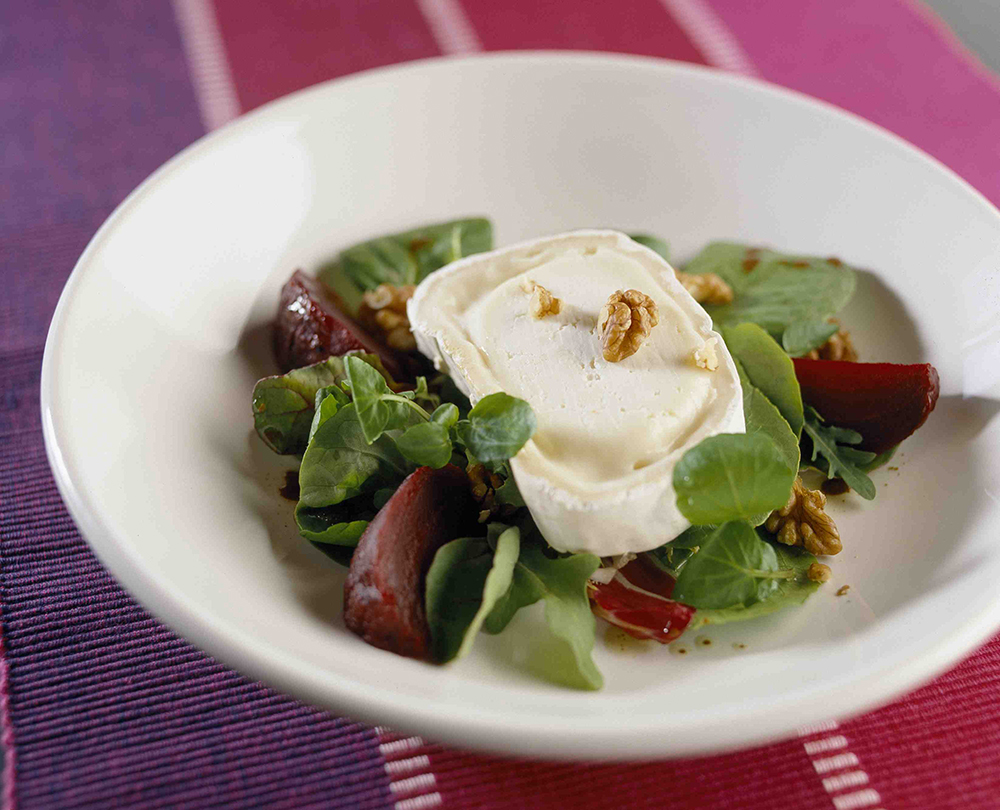 Beetroot, Goats' Cheese and Walnut Salad
Beetroot, Goats' Cheese and Walnut Salad
The simplicity of this pretty dish allows quality ingredients to speak for themselves: with its lovely delicate herbal flavours, naturally produced St Tola goats’ cheese from Co Clare contrasts well with sweet and deeply coloured beetroot to make a deliciously subtle starter or light lunch. Awareness of the health benefits of beetroot has seen its popularity soar and it’s widely grown by organic farmers such as the McNally Family Farm and Beechlawn Organic Farm who grow a wide range of top quality vegetables. Be careful to use fresh walnuts, as they spoil and take on a bitter flavour when stored for too long; look out for organic nuts, or by online at, for example, Green Earth Organics
Serves 2-4
A selection of seasonal salad leaves
115g/4½ oz St Tola or other soft organic goats' cheese
3 beetroots, cooked and peeled
10-15 fresh walnuts, coarsely chopped
Dressing:
15ml/1tbsp balsamic style vinegar eg Highbank Orchard
45m /3tbsp extra virgin olive oil/premium Irish rapeseed oil eg Second Nature
2.5m/½ tsp Dijon style mustard, eg Bunalun
Wash and dry the salad leaves.
Put a small handful of leaves onto each plate.
Slice the goats' cheese and beetroot into wedges and place 2-3 of each onto each plate. Sprinkle the walnuts over the salads.
Put all the ingredients for the dressing into a small bowl or screw-top jar and mix well to emulsify.
When ready to eat, sprinkle the dressing over the salads and served with freshly baked crusty bread.
 Greek-style Lamb Kebabs with Yoghurt Dressing
Greek-style Lamb Kebabs with Yoghurt Dressing
Organic lamb benefits from the extra herbs and floral flavours that a natural farming system encourages – especially the late season hill lamb raised in mountainous areas, such as Achill, Connemara, Kerry and West Waterford, which is in season now and available from local butchers, markets and, in some cases, from the farm or online. Further information from: Connemara Mountain Lamb; Achill Mountain Lamb; Ring of Kerry Quality Lamb; Comeragh Mountain Lamb The organic vegetables, herbs and yoghurt (eg Glenisk) for this recipe are all widely available, from farmers’ markets, specialist stores and good supermarkets. The kebabs would be equally delicious cooked on the barbecue or under the grill. Serves 4
750g/generous 1½ lb premium lamb, well trimmed and cubed
Olive or other good quality oil, eg organic Irish rapeseed oil
1 red and 1 green pepper, cut into chunks
1 red onion, cut into wedges
Salt and freshly-ground black pepper
Marinade:
250ml/9 fl oz natural yoghurt, eg Glenisk or Glenilen
2 garlic cloves, crushed
5 ml/1 tsp ground cumin
5 ml/1 tsp ground coriander
Grated rind and juice of 1 lemon
Yoghurt Dressing:
185ml/6½ fl oz natural yoghurt
15 ml/1 tbsp fresh coriander, chopped
15 ml/1 tbsp fresh mint, chopped
Grated rind of 1 lemon
2 garlic cloves, crushed
Combine the marinade ingredients in a large non-metallic dish.
Add the diced lamb and stir to coat well, then cover and place in the fridge for about 2 hours if possible.
Meanwhile soak 8 wooden skewers in water, to prevent them scorching. (If you are short of time use metal skewers.)
Preheat your barbecue or grill to high and brush lightly with oil.
Thread the lamb cubes, peppers and red onion onto the skewers, season and cook for 3-4 minutes on each side until lightly charred and cooked to your taste.
To make the Yoghurt Dressing: stir together all the ingredients and season to taste. Drizzle a little dressing over each lamb skewer and serve the rest on the side.
Serve with new season potatoes and salad.
Cookery Feature - Neven�s Midweek Meals
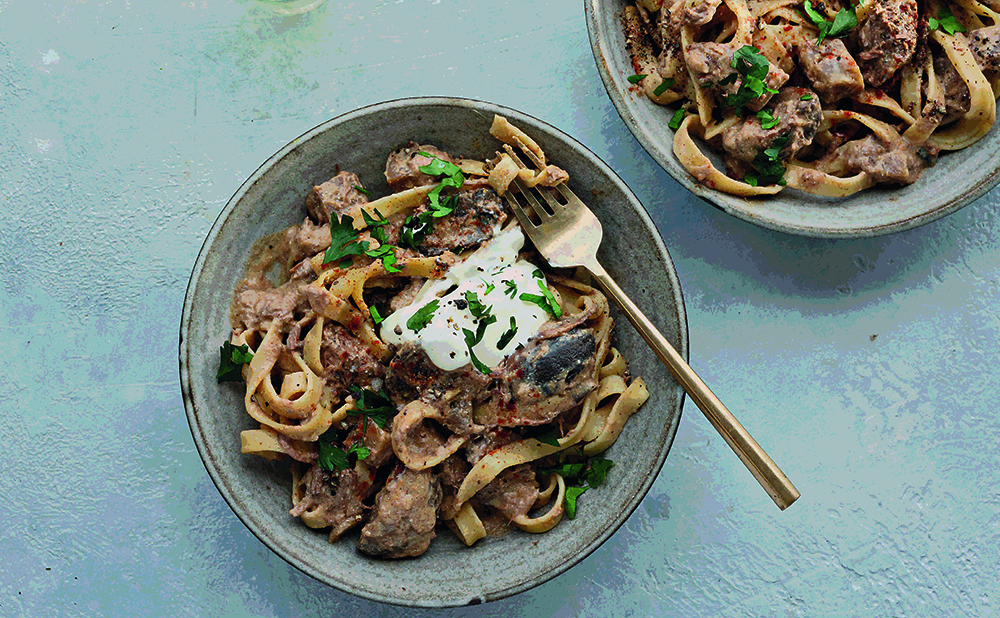
A new book from Ireland’s best-loved chef, Neven Maguire, is always welcome - and, once again, he’s right on the money with Neven Maguire’s Midweek Meals (Gill, hardback. €22.99).
MacNean House - the restaurant with rooms in Blacklion, Co Cavan, that Neven owns with his wife Amelda - is so popular that you need to book months in advance for weekend meals and breaks, and he is also a hands-on father to their twins, so he knows that getting dinner on the table Monday to Friday can be a daily challenge, even for the best of cooks.
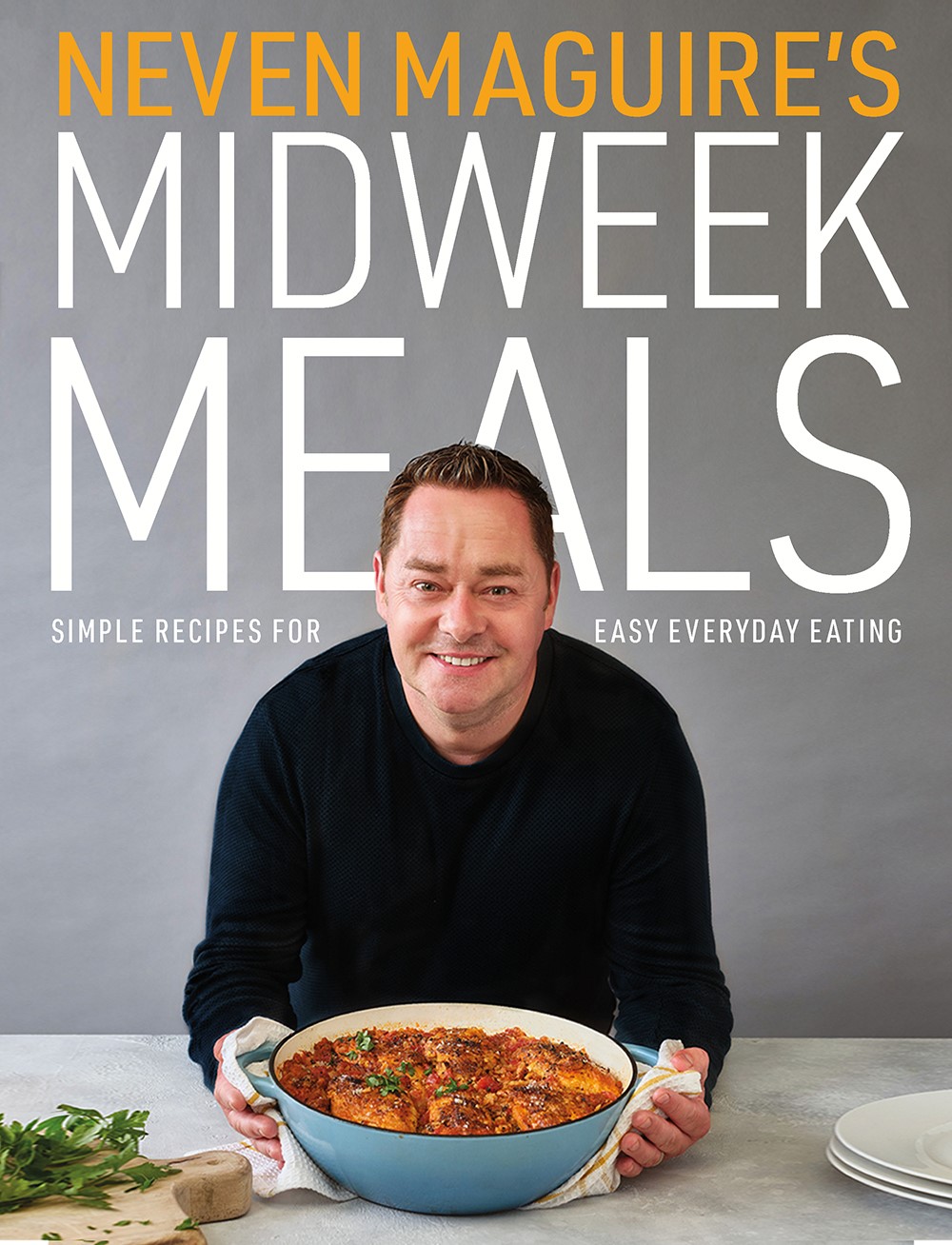 Many more people than usual have been responsible for putting meals on the table every day during the Covid-19 pandemic, so - always one to see where help is needed and step in with practical assistance - Neven decided to guide his Facebook followers with regular cooking videos from his home kitchen in Blacklion, all filmed by his wife Amelda. Similarly, Midweek Meals is just what is needed right now, with its dozens of straightforward recipes to help us all to get fresh and tasty family food on the table fast.
Many more people than usual have been responsible for putting meals on the table every day during the Covid-19 pandemic, so - always one to see where help is needed and step in with practical assistance - Neven decided to guide his Facebook followers with regular cooking videos from his home kitchen in Blacklion, all filmed by his wife Amelda. Similarly, Midweek Meals is just what is needed right now, with its dozens of straightforward recipes to help us all to get fresh and tasty family food on the table fast.
Neven has always believed strongly in the importance of family time around the kitchen table and, practical as always, these recipes - which are bright and fresh yet easy to prepare and based on everyday ingredients - make that easier to achieve. Some are quick to prepare in one go, others suit advance preparation and make good use of the slow cooker - which may well become your most-used appliance. Many of the dishes in Midweek Meals are upbeat variations of established favourites, sometimes replacing classic ingredients with a local alternative - as in the delicious pearl barley risotto, below, which is likely to earn a place in the regular repertoire in many a household.
Dedicated to Neven’s old friend and colleague, Marty Whelan, and produced by a great team led once again by Orla Broderick, who compiled the content, along with other regulars including copy editor Kristin Jensen and photographer Joanne Murphy, this is a solid reference that will become a go-to friend in many a kitchen.
RECIPES to try:
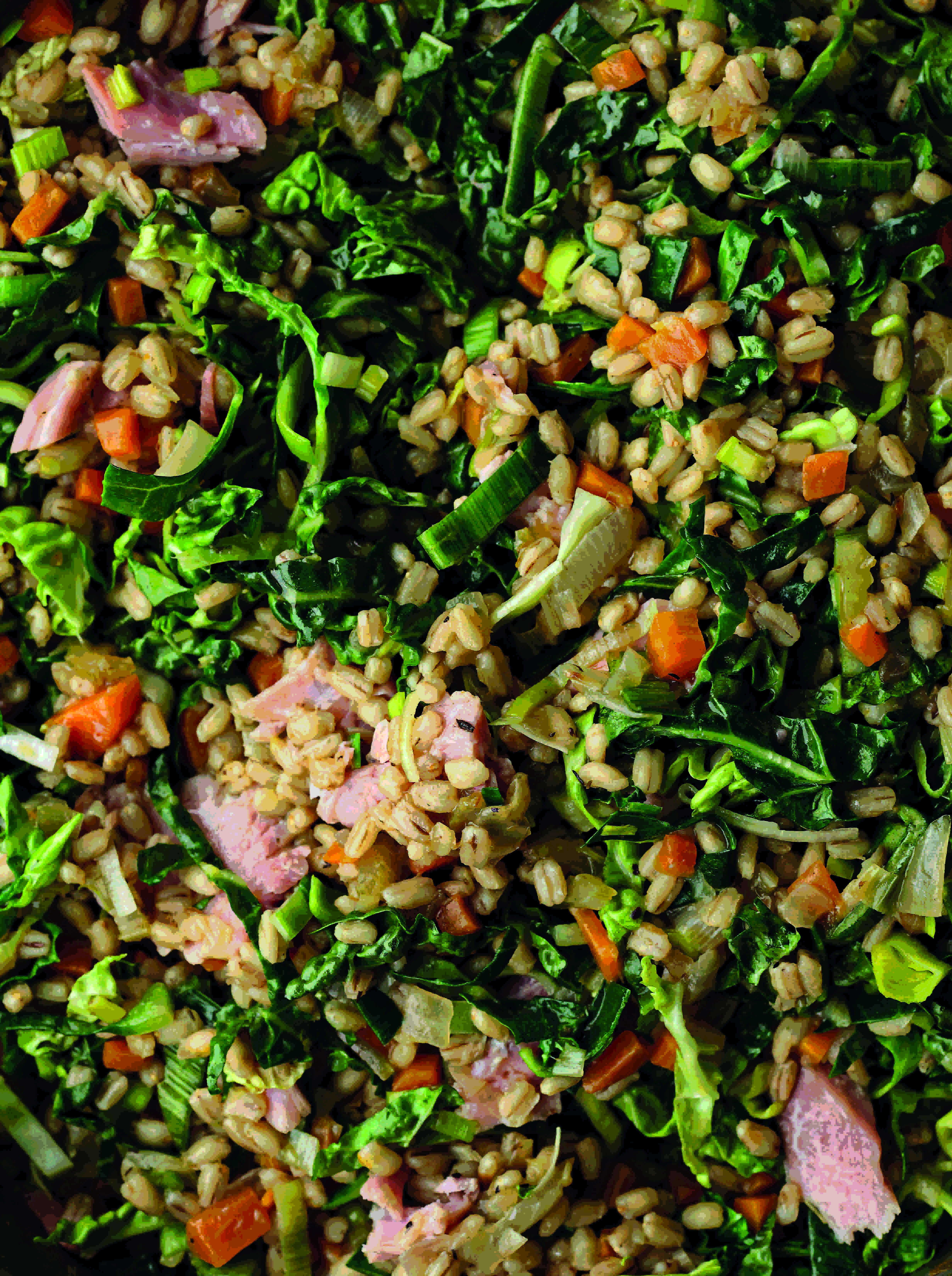 Pearl Barley Risotto with Bacon and Cabbage
Pearl Barley Risotto with Bacon and Cabbage
This dish (from the ‘Cupboard’s Bare’ chapter) uses pearl barley instead of rice for an interesting nutty texture. It’s much cheaper than traditional risotto rice and has the added bonus of being extremely good for you too. I’ve used a leftover bacon joint here, but you could also use a couple packets of ham chunks.
• Serves 4–6
• Loads of veg
• Preparation time 15 minutes
• Cooking time 1 hour
1 tbsp rapeseed oil
15g (½oz) butter
1 onion, diced
4 large carrots, diced
2 leeks, trimmed and sliced
2 celery sticks, diced
2 garlic cloves, finely chopped
1 tsp dried thyme
400g (14oz) pearl barley
1.5 litres (2½ pints) hot chicken stock (from a cube is fine)
1 heaped tbsp Dijon mustard, plus extra to serve
1 Savoy cabbage, cored and shredded
200g (7oz) cooked lean bacon joint or ham, chopped into small pieces
sea salt and freshly ground black pepper
Heat a large pan over a medium heat. Add the oil and butter, then add the onion, carrots, leeks and celery and sauté for 6–8 minutes, until softened. Stir in the garlic and thyme and cook for another 2–3 minutes, until fragrant.
Stir in the pearl barely and cook for 1 minute, until well combined. Pour in the hot stock, add the mustard and season to taste with a little salt and plenty of pepper. Bring to a simmer, then reduce the heat to low and cook for 35 minutes, stirring occasionally.
Add the cabbage and the bacon or ham and cook for another 5 minutes, until the cabbage is wilted and tender and the bacon is nicely warmed through.
Divide between plates and serve with a dollop of mustard on the side if liked.
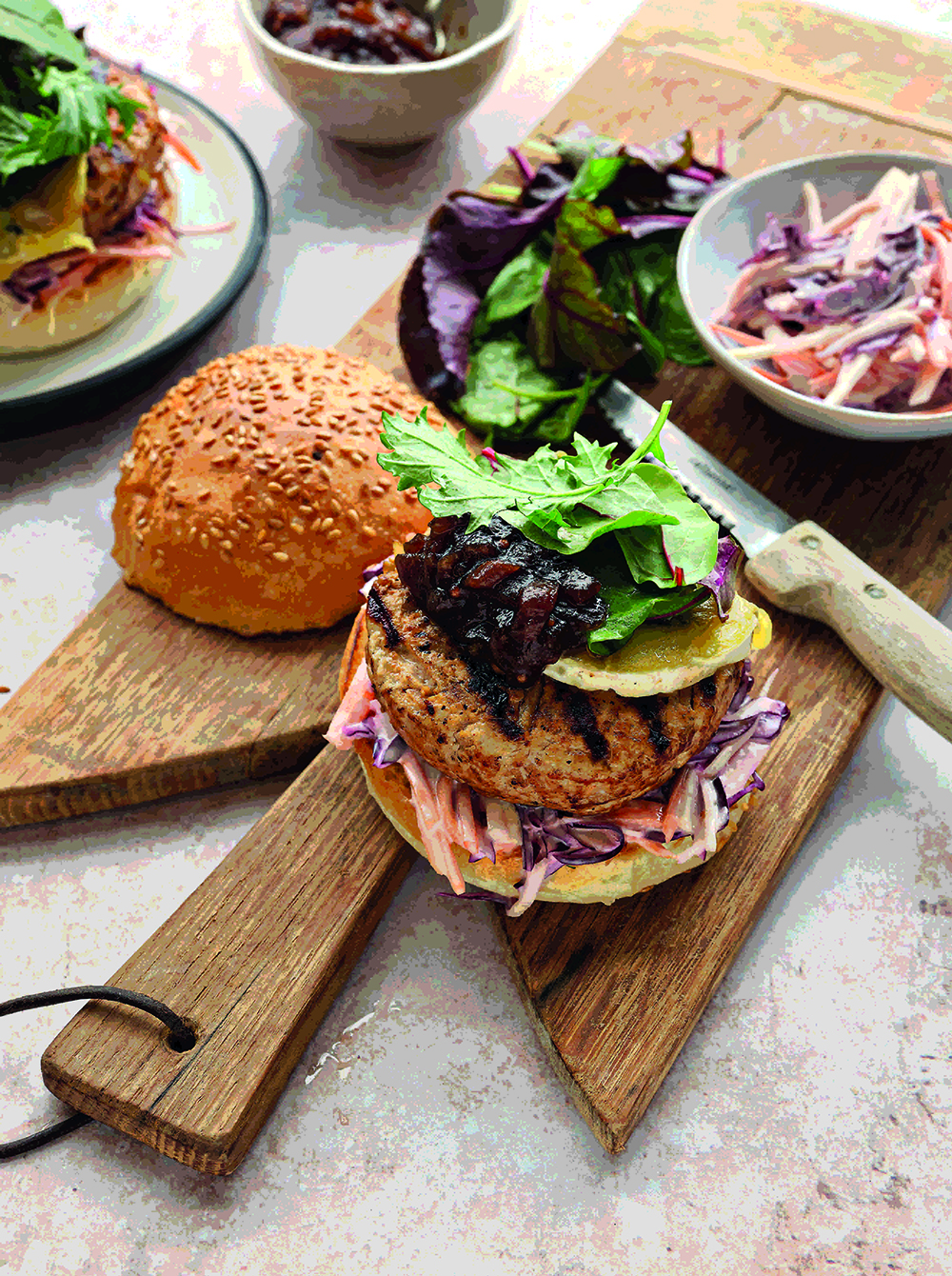 Pork and Apple Burgers with Wicklow Blue Cheese and Winter Coleslaw
Pork and Apple Burgers with Wicklow Blue Cheese and Winter Coleslaw
From the Spermarket Sweep section (‘for days when you have time to pick up a few ingredients on your way home’) this winter slaw is very versatile and can be served with all types of things. It’s best with the mayonnaise mixed in just before serving, but leftovers are still good if kept covered in the fridge for up to two days. The combination goes beautifully with the pork and blue cheese, spiked with a little sweetness from the apple.
• Makes 6
• Preparation time 15 minutes + 1 hour draining;
• Cooking time 20 minutes
• Loads of veg
• Freezer friendly (burgers)
2 red dessert apples
800g (1¾lb) lean minced pork
2 tsp paprika
1 tbsp rapeseed oil
150g (5oz) Wicklow Blue cheese, sliced
6 blaa or burger buns, split in half
4 tbsp caramelised red onion chutney
50g (2oz) baby salad leaves
sea salt and freshly ground black pepper
FOR THE WINTER COLESLAW
½ celeriac, peeled
¼ red cabbage, tough core removed
2 carrots, peeled
2 tsp caster sugar
5 tbsp mayonnaise
1 tbsp Dijon mustard
1 tbsp white wine vinegar
To make the winter slaw, use the grating attachment of a food processor or the coarse side of an ordinary box grater to grate the celeriac, red cabbage and carrots. Sprinkle over the sugar and 1 teaspoon of salt. Make sure it’s well mixed, then place into a colander set in the sink. Leave to drain for at least 1 hour to remove the excess liquid.
Meanwhile, cut the apple into quarters, remove the core and grate the flesh into a bowl with the minced pork and paprika. Season with salt and pepper and mix well with your hands. Shape into six round patties, flattening them slightly.
Heat a griddle pan over a medium-high heat. Brush the burgers with the oil and add to the hot pan. Reduce the heat to medium and cook for 5–6 minutes on each side, until lightly browned and cooked through. Turn off the heat, lay the cheese on top of the burgers and leave to rest.
Give the grated vegetables a good squeeze before placing in a large bowl. Mix the mayonnaise, mustard and vinegar in a small bowl, then fold into the grated vegetables until evenly coated. Season to taste with salt and pepper.
Toast the buns on a grill rack under a medium heat until lightly toasted. Add a little of the coleslaw, then cover with a burger topped with the blue cheese and finish with a dollop of the chuntey and a small mound of baby salad leaves. Place the burger bun tops to the side and serve the rest of the winter slaw alongside.
Pumpkin, Chorizo and Spinach Frittata
Pumpkins will keep for many months if correctly stored. They don’t like too much heat or the bitter cold, so the bottom shelf of a well-ventilated store cupboard is perfect. A small one is the right size for this recipe. Look out for the delicious blue-skinned Crown Prince, which has a wonderful flavour. Otherwise there are a number of small orange-coloured varieties readily available in farmers markets and most Asian supermarkets. Otherwise use butternut squash.
• Serves 6–8
• Preparation time 20 minutes. Cooking time 1 hour
• Loads of veg
• Freezer friendly
1kg (2¼lb) small pumpkin (such as Crown Prince – see the intro), peeled, seeded and chopped
4 raw chorizo sausages, cases removed and torn into pieces
1 tbsp rapeseed oil
250g (9oz) frozen spinach, thawed and squeezed dry
150g (5oz) soft rindless goat’s cheese, crumbled
100g (4oz) shop-bought red onion relish
8 large eggs
250ml (9fl oz) cream
sea salt and freshly ground black pepper
TO SERVE: slices of chargrilled sourdough bread (optional)
Preheat the oven to 220°C (425°F/gas mark 7). Place the pumpkin and chorizo in a 30cm (12in) deep ovenproof frying pan or similar-sized baking dish. Drizzle with the oil and season with salt and pepper. Roast in the preheated oven for 15 minutes, until the pumpkin is lightly golden and just tender. Remove from the oven.
Reduce the oven temperature to 200°C (400°F/gas mark 6).
Add the spinach, goat’s cheese and red onion relish to the pan and gently fold everything together.
Break the eggs into a bowl and add the cream, then season with salt and pepper. Using a fork, whisk gently to combine, then pour over the vegetable and cheese mixture in the pan.
Bake in the oven for 25–30 minutes, until puffed up and golden. Remove from the oven and leave to cool a little, then cut into slices and serve on plates with slices of chargrilled sourdough bread, if liked.
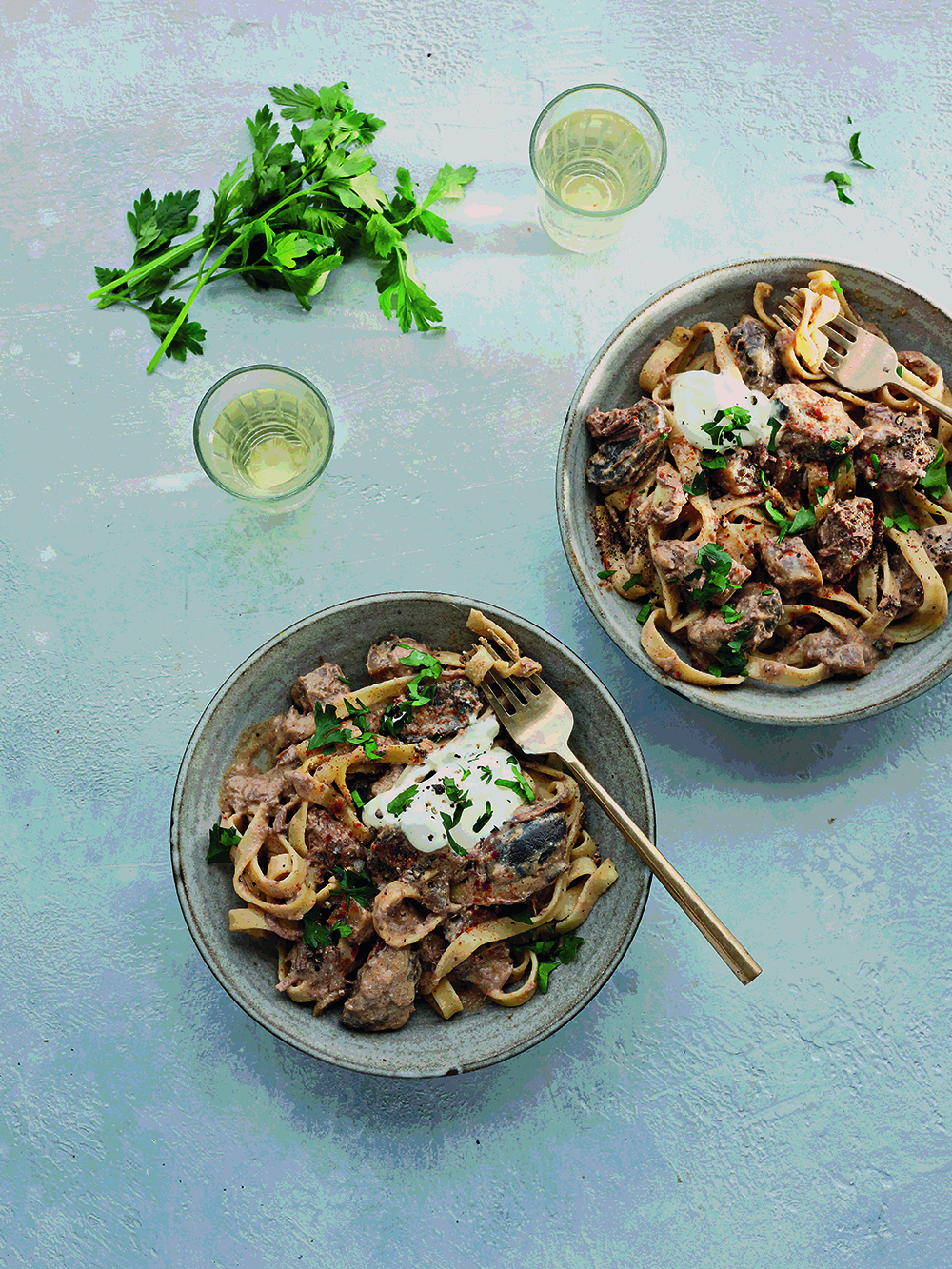 Beef and Celeriac with Chestnut Mushrooms and Soured Cream
Beef and Celeriac with Chestnut Mushrooms and Soured Cream
I love this ‘Slow and Low’ recipe! It’s hearty, rich and unbelievably flavourful. Plus the slow cooker does most of the work, making it a great recipe for busy weeknights. Chunks of beef with shallots, mushrooms and celeriac are simmered all day. Then, just before serving, freshly cooked egg tagliatelle, soured cream and Dijon mustard are added.
• Serves 4-6
• Preparation time 30 minutes
• Cooking time 6 ¼ hours
• Loads of veg
• Freezer friendly (beef)
25g (1oz) plain flour
1 tsp sweet paprika, plus a little extra to garnish
500g (1lb 2oz) stewing beef, cut into chunks
2 tbsp rapeseed oil
1 garlic clove, crushed
2 tsp tomato purée
knob of butter
2 banana shallots, finely chopped
200g (7oz) chestnut mushrooms, halved
1 tbsp white wine vinegar
4 tbsp white wine
1 small celeriac, peeled and finely diced
450ml (¾ pint) beef stock (from a cube is fine)
225g (8oz) fresh egg tagliatelle
200ml (7fl oz) soured cream, plus extra to garnish
1 tsp Dijon mustard
sea salt and freshly ground black pepper
TO GARNISH: torn fresh flat-leaf parsley (optional)
Preheat your slow cooker according to the manufacturer’s instructions.
Sprinkle the flour and paprika over the beef and season with salt and pepper. Toss to coat, shaking off any excess. If your slow cooker has a sauté option, you can use this; if not, use a large sauté pan on the hob over a medium heat. Heat 1 tablespoon of the oil, then working in batches, add the beef and quickly sear until golden brown on all sides, turning regularly with a tongs. Transfer to a plate while you continue to cook the remainder. Add the garlic and tomato purée to the last batch of beef, stirring to coat, then transfer to a plate until needed.
Once you’ve cooked all the beef, add the remaining tablespoon of oil with the butter, then add the shallots and mushrooms and sauté for a couple of minutes. Pour in the vinegar and allow it to bubble right down, then add the wine, scraping the bottom of the pan with a wooden spoon to remove any browned bits. Stir in the celeriac and stock. Place in the slow cooker (if you have used a separate pan), then add the seared beef and any meat juices and season to taste. Cover and cook on low for 6 hours.
When ready to serve, cook the tagliatelle for 2–3 minutes or according to the packet instructions. Stir into the slow cooker with the soured cream and mustard. Leave to rest for 5 minutes to allow the flavours to combine.
Divide between bowls and add a dollop of soured cream, then sprinkle with a little paprika and some parsley (if using) to serve.
Cookery Feature - Celebrating Kilkenny�s Festive Traditions
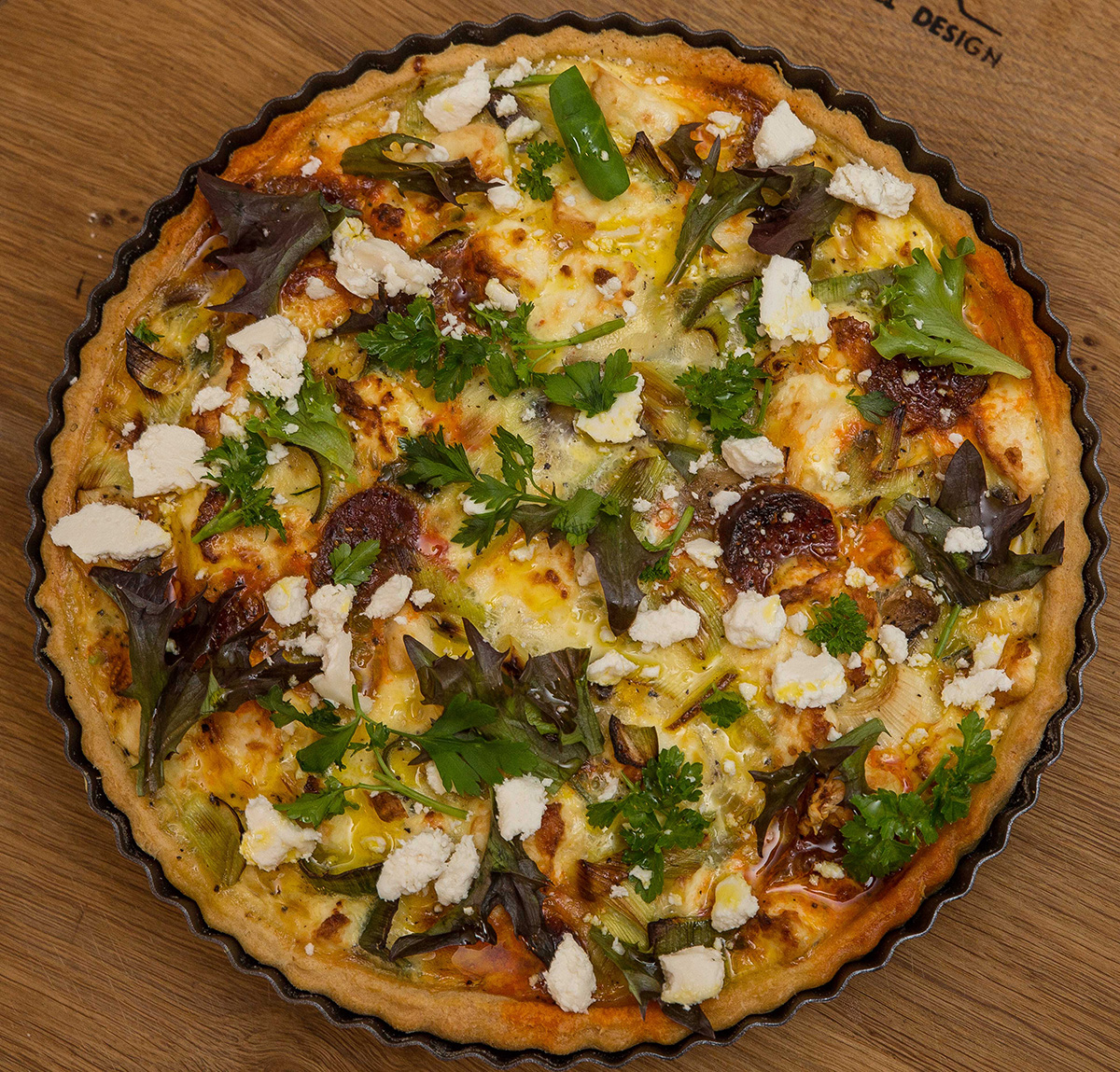
For all its challenges, many interesting projects came out of 2020 and creating a group cookery book, as Visit Kilkenny have done with their online Kilkenny Christmas Traditions collection of festive recipes, was one of the best for morale.
Keeping local people in food and hospitality connected and purposeful while working towards a common goal must have been a very enjoyable project for Visit Kilkenny and the result is a balanced collection of 30 pretty irresistible recipes for Christmas or New Year and other times. There’s Chestnut Parsnip & Bacon Soup, Spiced Roast Christmas Goose and Decadent Christmas Pudding, for example - and other versatile dishes, such as Courgette Fritters with Smoked Trout and Leek, Chorizo & Goat’s Cheese Tart, that will become go-to favourites over the festive period. Reflecting the range and diversity of the superb ingredients produced in Kilkenny, there’s a wide choice, including plenty for vegetarians, or that can easily be adapted to create vegetarian versions.
Contributors are equally diverse, including the Yew Restaurant at Lyrath Estate, The Lady Eleanor Restaurant at Butler House; Goatsbridge Trout Farm; Ryeland House Cookery School; Rive Gauche Restaurant; Lil’s Restaurant at Avalon Hotel; Fennelly’s of Callan; Arán Bakery and Edward Hayden's School of Cookery, to name just a few – and, after cooking up a few of their creations, planning a visit to Kilkenny as soon as possible is bound to be top of many a wish list list, to try them (and many others like them) on home ground.
KILKENNY RECIPES - some samples to try:
Courgette Fritters with Smoked Trout
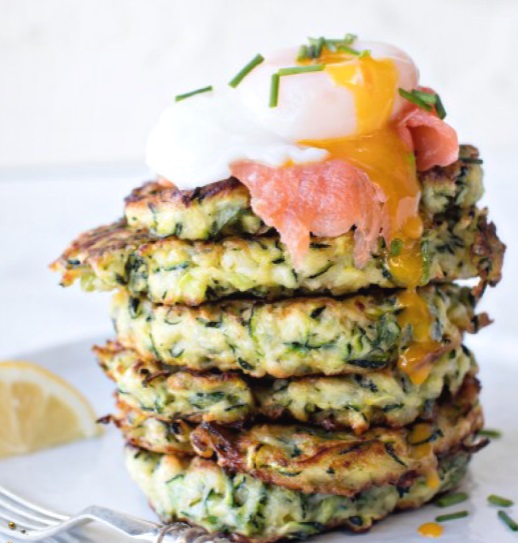 This smoked trout recipe from Goatsbridge Trout Farm is one of Joanne Donohue’s (AKA Fishwife Number 25) favourite quick fish recipes. It’s in the Starters section of the online Kilkenny recipe book but would also make a lovely brunch, light lunch or supper dish.
This smoked trout recipe from Goatsbridge Trout Farm is one of Joanne Donohue’s (AKA Fishwife Number 25) favourite quick fish recipes. It’s in the Starters section of the online Kilkenny recipe book but would also make a lovely brunch, light lunch or supper dish.
2 SERVINGS
20 MINUTES PREPARATION
10 MINUTES COOKJNG TIME
400g/6oz courgettes, grated
1 tsp of salt
I00g/40g flour
3 large eggs
50g/2oz spring onions sliced
Salt and pepper
2 tbsp vegetable oil
100g/4oz cold smoked trout
Chives, chopped, to garnish
Step 1. To make the courgette fritters, place the grated courgette in a colander or sieve, set over a bowl and sprinkle tightly with one teaspoon of salt. Allow to stand for ten minutes,. Using your hands, squeeze out as much liquid as possible and transfer to a large bowl; add the flour, one egg, and the spring onions. Season with salt and pepper and stir to combine.
Step 2. Heat the oil over medium-high heat. Once the oil is hot, scoop four tablespoons of the courgette mixture into the pan, pressing them lightly into rounds and spacing them at least two inches apart. Cook the courgette fritters for two to three minutes, then flip and cook for another two minutes until golden brown and cooked throughout Transfer to a paper towel and immediately sprinkle with salt.
Step 3. Meanwhile poach the two remaining eggs for approximately four minutes, until runny, or to your preference. To assemble, divide the fitters between the plates, top with the smoked trout, the poached egg and the chives. Season with salt and pepper.
Leek, Chorizo and Goat’s Cheese Tart
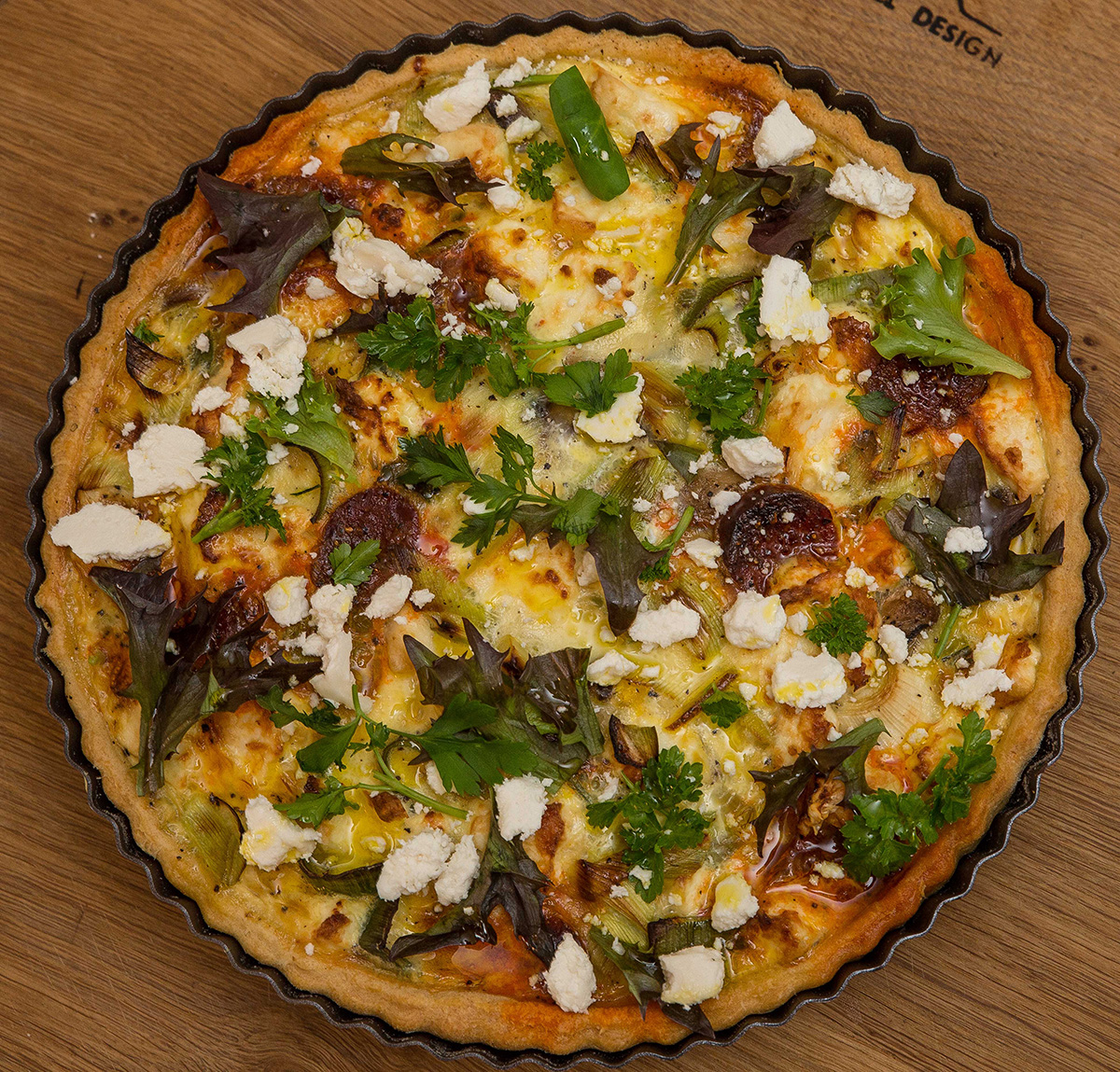 This substantial starter or main course recipe from The Edward Hayden School of Cookery is a favourite of Edward’s. The pastry recipe for this dish can be doubled and frozen in advance. Try experimenting with other varieties of filling also.
This substantial starter or main course recipe from The Edward Hayden School of Cookery is a favourite of Edward’s. The pastry recipe for this dish can be doubled and frozen in advance. Try experimenting with other varieties of filling also.
FOR THE SHORT CRUST PASTRY:
10oz/300g plain flour
5oz/150g hard ?butter
Pinch of salt
Ice cold water (6-8 tbsp approx.)
FOR THE FILLING:
2 leeks thinly sliced
8 mushrooms sliced
5oz/150g chorizo cut into slices
3 large free range eggs
7 fl oz/200ml milk
2fl oz/50m pouring cream
Seasoning
1oz/25g butter
5oz/150g goats cheese, crumbled
Step 1. Begin by making the savoury pastry. Sieve the plain flour into a large mixing bowl. Add in the pinch of salt. Cut the butter into pieces and add this to the flour and salt. Using the tips of your fingers rub the butter into the flour until the mixture resembles fine breadcrumbs. Next mix in the water, gradually, until the mixture all comes together into a ball. Knead lightly to achieve a smooth pastry and then wrap it in cling film and refrigerate for at least 1 hour but for longer if time will allow.
Step 2 Preheat the oven to 190C/350F/Gas Mark 4
Step 3. Roll out the pastry into a large circle and use it to line a 9int /23cm loose bottomed flan ring or a large ceramic quiche dish. Lightly blind bake the pastry for 10-12 minutes.
Step 4. Meanwhile wash and thinly slice the leeks. Heat the butter in a medium sized frying pan and add to the butter the leeks and mushrooms and cook on a gentle heat until they have softened down, This will probably take in the region of 5-6 minutes on a low heat. Season with salt and black pepper and transfer to a bowl and allow the mixture to cool down.
Step 5. At this stage you need to take a large mixing bowl and whisk the eggs, milk and cream together.
Step 6. When the leeks have cooled sufficiently spread them over the pastry lined mould. Neatly arrange the sliced chorizo on top. Pour the whisked egg custard on top of the creamy leek mixture end sprinkle with the goats cheese. Transfer the entire dish to the preheated oven,
Step 7. Bake for 25-30 minutes or until the pastry is cooked through and the egg custard has set sufficiently around the leeks.
Step 8. Remote from the oven end allow the tart to rest for at least 10-12 minutes before cutting and serving. Garnish with some chopped herbs and some additional crumbled goats cheese.
Boozy Christmas Trifle
 Christmas celebrations are not complete without a trifle and this recipe from the Lady Eleanor Restaurant @Butler House and Garden is guaranteed to be the crown jewel of the table. A swiss roll twist soaks up the sherry and adds a special decorative touch to this party-time classic and the custard is egg-free so there’s no risk of it curdling - although, if you have no fear of traditional egg custard, it would make an even more luxurious version.
Christmas celebrations are not complete without a trifle and this recipe from the Lady Eleanor Restaurant @Butler House and Garden is guaranteed to be the crown jewel of the table. A swiss roll twist soaks up the sherry and adds a special decorative touch to this party-time classic and the custard is egg-free so there’s no risk of it curdling - although, if you have no fear of traditional egg custard, it would make an even more luxurious version.
750g frozen summer fruit (raspberries, blackberries, red and black currants)
250g caster sugar
9 sheets leaf gelatin
75g custard powder
1.2 L milk
1 Swiss roll
4 tbsp sherry or cassis
300-450ml double cream
1 tsp vanilla extract
7 tbsp icing sugar
2 crushed amaretti biscuits, to serve
Whole fresh strawberries or raspberries for garnish
Step 1. Put 750g frozen summer fruit in a pan with 200g caster sugar and 1 litre water and bring to a gentle simmer.000
Step 2. Cook for 2 mins, then scoop out 6 tbsp fruit and 150ml juice. Now carry on cooking the fruit in the pan for 5 mins.
Step 3. Meanwhile, soak 9 sheets leaf gelatin in cold water to soften it. Blitz the cooked fruit with a hand blender or mash with a potato masher, then strain through a sieve into a large bowl and push through the pulp so just the skins and seeds are left.
Step 4. Squeeze excess water from the gelatin, add to the hot fruit syrup and stir to dissolve. Cool, then chill until on the point of almost setting.
Step 5. Make the custard according to pack instructions with 75g custard powder, 1.2 litres milk and 50g caster sugar to create a thick custard. Cover the surface with baking paper while it cools a little.
Step 6. Cut the Swiss roll into slices. Carefully arrange some of the slices, closely together, around the sides of a straight-sided glass bowl, with the cut, rolled sides facing outwards.
Step 7. For the filling, arrange the remaining slices in the base of the bowl Spoon over the reserved juice and berries, then 4 tbsp sherry or cassis.
Step 8. Pour over a thick layer of custard, pushing it against the side of the dish to seal in the cake below, leave to cool and set with a skin - this makes a barrier for the jelly,
Step 9. When the custard ts cold and set and the jelly is on the point of setting, spoon the jelly over the custard and chill until ready to complete.
Step 10. Whip 300- 450ml double cream with 1 tsp vanilla extract and 2 tbsp icing sugar until just holding its shape, then spoon round the bowl over the set jelly. Scatter with 2 crushed amaretti biscuits and strawberries or raspberries and chill until ready to serve.
Cookery Feature - Simple Seasonal Treats
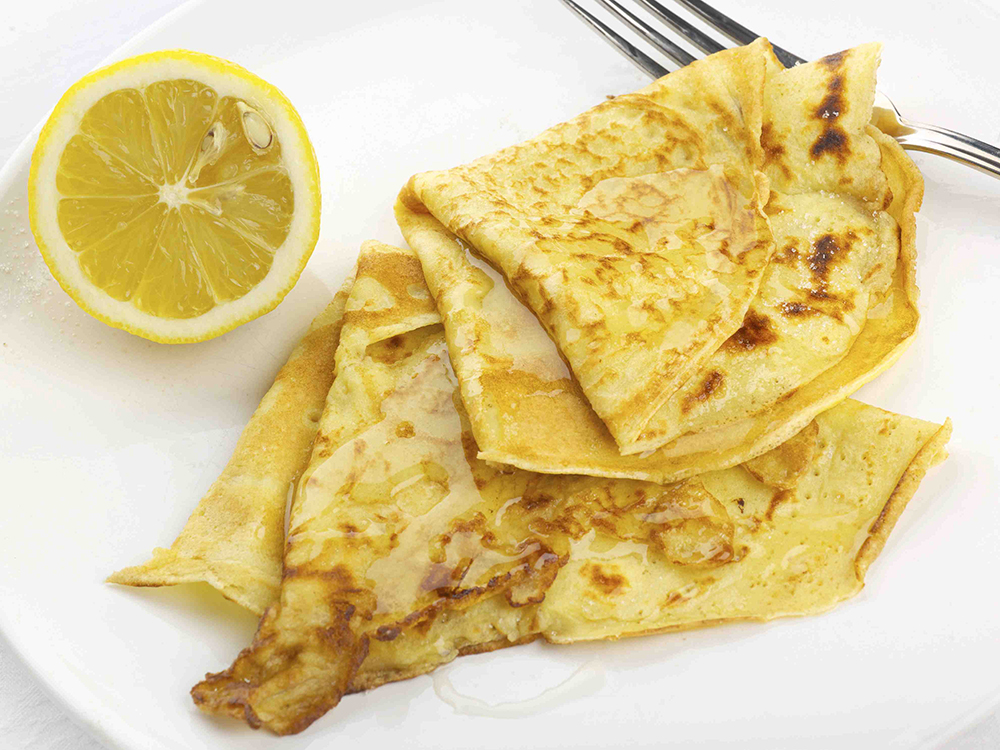
Delicious pancakes hot off the pan sum up Shrove Tuesday (16th February this year) for a lot of families - and making them is fun, so it’s just what we need right now.
 But the traditions behind what has become Pancake Day are worth remembering too. With the Lenten Fast about to start on the following day, Ash Wednesday, Shrove Tuesday was a festive day to enjoy foods that would not be permitted during Lent. Abstaining not only from meat, but also eggs and all dairy products was the norm - so making pancakes on Shrove Tuesday was originally a practical way of using up surplus eggs and milk that would otherwise go to waste.
But the traditions behind what has become Pancake Day are worth remembering too. With the Lenten Fast about to start on the following day, Ash Wednesday, Shrove Tuesday was a festive day to enjoy foods that would not be permitted during Lent. Abstaining not only from meat, but also eggs and all dairy products was the norm - so making pancakes on Shrove Tuesday was originally a practical way of using up surplus eggs and milk that would otherwise go to waste.
The rather dubious honour of tossing the first pancake went to the eldest unmarried daughter whose luck in having 'the pick of the boys' depended on tossing it neatly - otherwise, if she 'tossed the cake crooked' (when somebody jogged her elbow, for example!) she had no chance of marrying in the coming year. If successful, she cut the pancake into as many pieces as there were guests and handed them round. Similar to Halloween sometimes the mother's wedding ring was slipped into the batter used for the first pancake and the person who got the lucky slice would not only be first married but especially fortunate in their choice of husband or wife.
The old Irish tradition was for buttermilk pancakes, made with or without eggs according to availability and more like a drop scone than a modern pancake, but the universal pancake well-known in other countries is the one that now keeps the modern Pancake Tuesday tradition alive and well. And, although pancakes are extremely versatile - folded, rolled or stacked, served with sweet or savoury fillings… - and they freeze well too, there’s nothing to compare with the delicious simplicity of a sprinkling of caster sugar and a good squeeze of fresh lemon juice on a pancake hot off the pan. Lemons are available all year, of course, but can it be coincidence that they are at their peak season just when they’re needed for using up kitchen perishables like milk and eggs in this last treat before Lent?
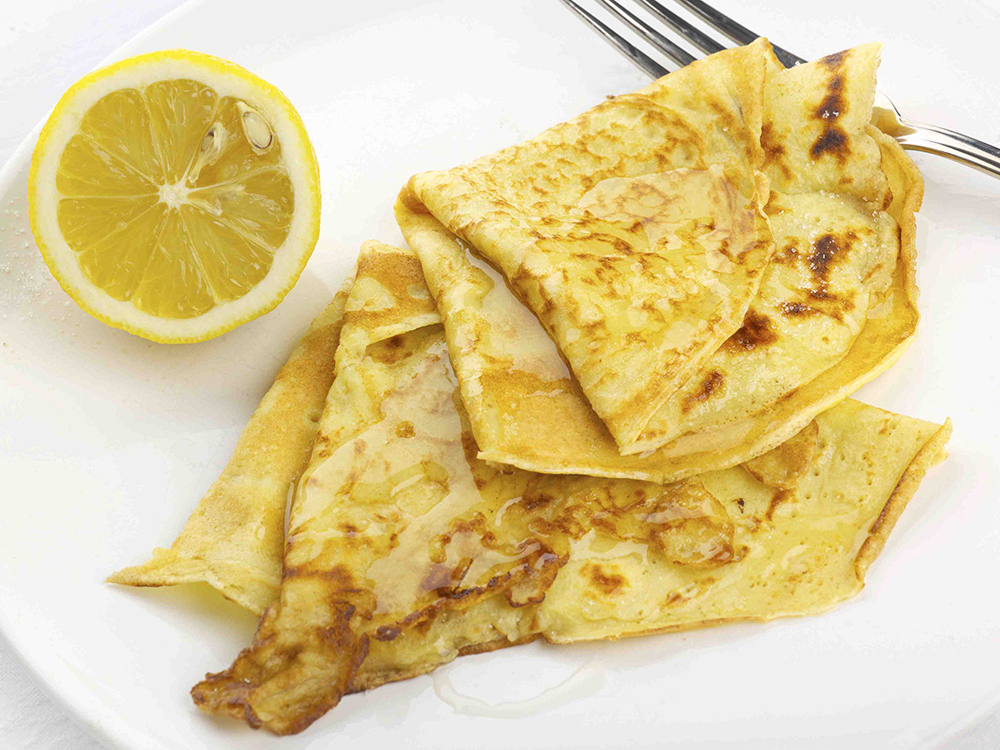
Pancakes with Lemon - How To Make Perfect Pancakes
• A good, heavy cast-iron pan is best, it must be preheated and very hot before any fat is added.
• The best fat is not oil (or butter, which burns too easily) but a hard block white cooking fat such as Frytex, which you quickly smear over the pan to make a thin film of hot fat just before adding the batter.
• Keep the batter in a jug beside the hob and use a ladle.
• The first pancake is always a disaster (but tastes just as delicious - cook's perk) but, once the pan is seasoned, it will work a treat and you very quickly learn to judge exactly the amount of batter needed to swirl around the pan and just reach the edges.
Basic Pancake Batter - makes about 8-10 pancakes.
l egg
4 oz/100g plain flour
½ pint/300ml milk
Pinch of salt.
1. Put all of the ingredients into a food processor or liquidiser in the order given and blend for a minute or so, until thoroughly mixed and smooth, with bubbles rising. Traditionally, a hand beaten batter is left to rest for an hour before use, but this is unnecessary when using a blender or food processor.
2. Before cooking, pour the prepared batter into a jug and have it ready beside the cooker, with a ladle. Also have all the necessary warmed plates, caster sugar and lemon juice ready to hand as, once you start making the pancakes, you have to keep up the momentum and there's no time for anything else.
3. To cook, heat a heavy frying pan, preferably cast-iron, over high heat. Smear lightly with white cooking fat, leave a moment until just smoking, then pour on a ladleful of batter. Quickly tilt the pan around - if you have judged the amount of batter correctly, it will just thinly cover the whole of the base of the pan.
4. Cook for about a minute, until the top is set and the bottom browned, then flip (or toss) over and cook the other side for about half a minute. Slide onto a warm plate, put the pan back onto the heat, sprinkle with caster sugar and lemon juice, roll up quickly and pass to the first taker. Re-grease the pan and continue in the same way until all the batter has been used up.
5. In polite households it may seem more appropriate to keep the pancakes warm and serve everyone at the same time -it is certainly more polite, but they never taste as good.
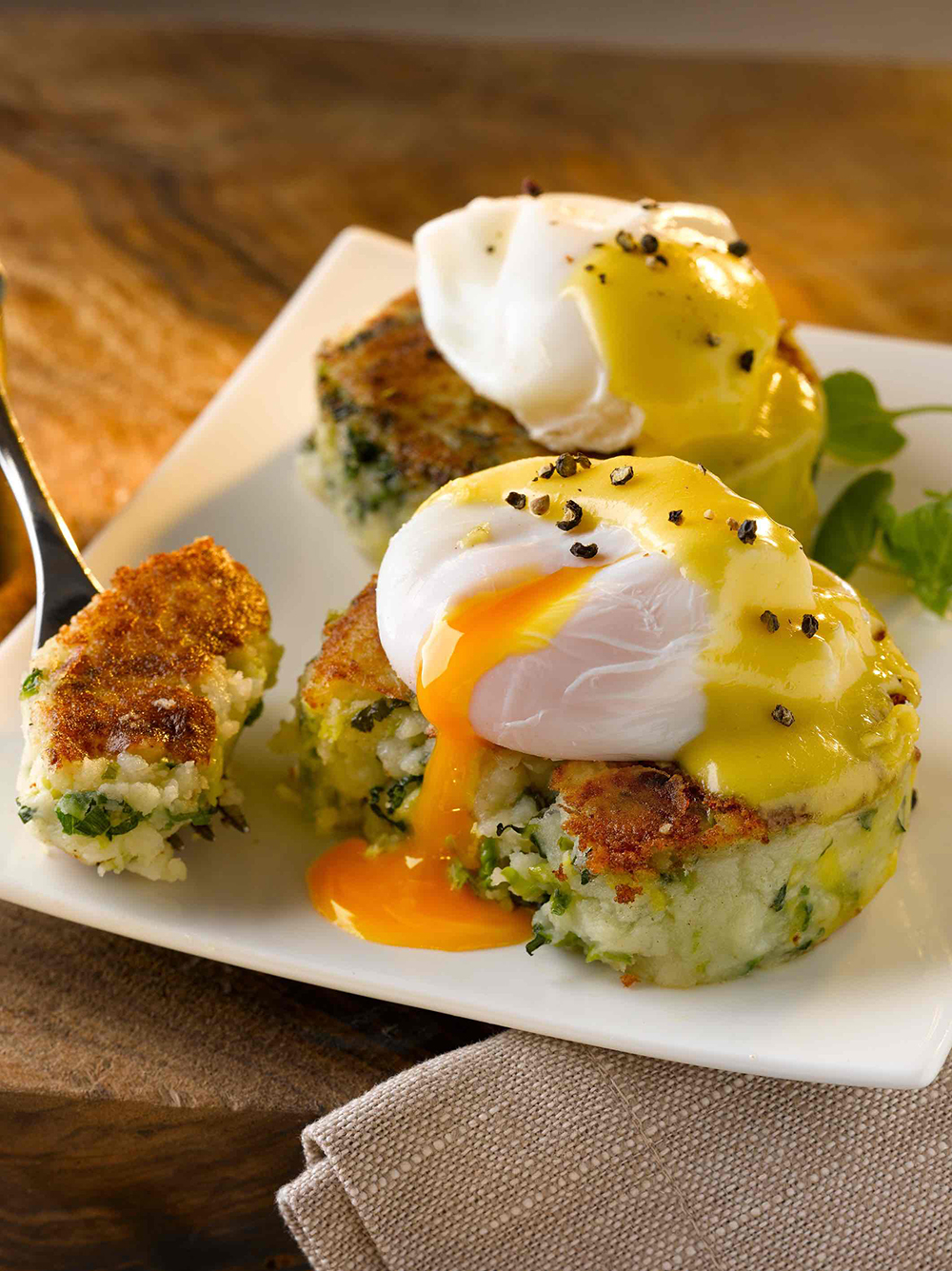 Colcannon Cakes with Poached Eggs and Hollandaise
Colcannon Cakes with Poached Eggs and Hollandaise
There are echoes of Hallowe’en in other treats made with dairy and eggs that would have been enjoyed in the days coming up to Ash Wednesday too, such as a simple version of this tasty little dish. The runny poached egg on top is irresistible on its own, but it would also be delicious served with a slice of baked ham or bacon if you have any leftover - or you could chop up the ham or bacon and add it to the colcannon mixture before shaping into patties. Serves 4
450g potatoes, peeled
40g butter
3 scallions, finely chopped
50g Savoy cabbage or curly kale, shredded
A little salt and freshly-cracked black pepper
A little plain flour, for dusting
Olive oil, for frying
1 tablespoon white wine vinegar
4 large eggs
FOR THE HOLLANDAISE SAUCE
2 teaspoons white wine or tarragon vinegar
2 large egg yolks
100g unsalted butter
1. Cook the potatoes in a covered pan of boiling salted water for 15-20 minutes until tender.
2. Meanwhile, heat a knob of the butter and one tablespoon of water in a heavy-based pan with a lid, over a high heat. When the butter has melted and formed an emulsion, add the scallions and cabbage or kale with a pinch of salt. Cover, shake vigorously and cook over a high heat for 1 minute. Shake the pan again and cook for another minute, then season with pepper.
3. Drain the potatoes and mash until smooth, then beat in the remaining butter. Fold in the cabbage mixture. Shape the mixture into four balls, dust with flour and press into neat patties.
4. Heat a thin film of olive oil in a heavy-based frying pan and add the patties, then cook for 3-4 minutes on each side until golden brown.
5. To make the poached eggs, bring a large pan of water to the boil. Add the vinegar and season with salt and keep at a very gentle simmer. Break the eggs into the water and simmer for 3-4 minutes until just cooked but still soft on the inside. Remove with a slotted spoon and drain well on kitchen paper, trimming away any very ragged edges.
6. To make the hollandaise sauce, place the vinegar and egg yolks in a food processor with a pinch of salt. Blend until just combined.
7. Gently heat the butter in a heavy-based pan until melted and just beginning to foam. Turn on the food processor and with the motor running at medium speed, pour in the melted butter in a thin, steady stream through the feeder tube. Continue to blitz for another 5 seconds and pour back into the pan but do not return to the heat. Allow the heat from the pan to finish thickening the sauce as you stir it gently for another minute before serving. Season to taste with salt.
8. To serve, place a colcannon cake on each warmed plate and place a poached egg on top of each one. Spoon over the hollandaise sauce and add a grinding of black pepper.
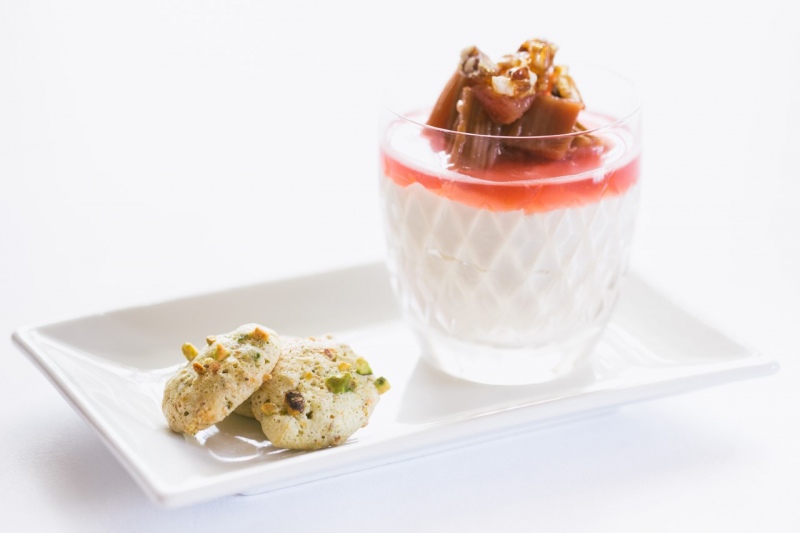 Lemon Posset, Poached Newforge Rhubarb And Pistachio & Orange Biscuits
Lemon Posset, Poached Newforge Rhubarb And Pistachio & Orange Biscuits
And how about this elegant and super delicious dessert from Newforge House, in Magheralin, Co Armagh, which might be just the ticket for that Valentine’s Day dinner - it’s pretty and more refreshing than the usual chocolate desserts. The lemon posset is another delicious way with eggs (and cream) and the lovely pink new season rhubarb is just coming into the shops this month. It’s ideal for entertaining, when that finally becomes possible again, but it can also be scaled down - and the elements are all delicious separately. And if a wonderful salt-aged Glenarm Shorthorn steak would be just the business for mains, consider the amazing Peter Hannan Meats which happens to be near Newforge at Moira - available direct (personal shoppers or online), or from James Whelan Butchers.
Serves 8
LEMON POSSET
900ml double cream
250g caster sugar
125ml lemon juice (c.4 lemons)
1. Place the double cream and the sugar into a large pan over a low heat and bring to the boil slowly. Turn down the heat and simmer gently for 5 minutes.
2. Add the lemon juice, mix well and bring back to the boil. Remove from the heat and allow to cool for 10 minutes.
3. Pour the lemon cream mixture into eight large serving glasses and refrigerate for three hours.
POACHED RHUBARB
Ingredients
550g rhubarb
150g caster sugar
60ml elderflower cordial
1 lemon, zested and juiced
1. Heat oven to 180C.
2. Rinse the rhubarb and shake off the excess water. Trim the ends and cut the rhubarb into little finger-sized pieces. Put the rhubarb in a shallow dish or baking sheet with sides that is big enough to hold the rhubarb in a single layer. Pour over the cordial, juice and zest, and sprinkle on the sugar.
3. Cover with foil and roast for 10 minutes. Remove the foil. The sugar should have dissolved, so give everything a little shake and roast for another 5 minutes or until tender and the juices are syrupy. Test with a sharp knife; the rhubarb should feel tender, not mushy, and still have kept its shape.
4. Once cool, gently transfer the rhubarb and cooking syrup to a lidded plastic container and store in the fridge for up to one week.
PISTACHIO & ORANGE MERINGUE BISCUITS
(Dairy & Gluten-Free)
150g shelled unsalted pistachios
175g caster sugar
3tbsp finely grated orange zest
50g plain gluten-free flour
3 large egg whites
1.Preheat the oven to 160C fan. Line 2 large baking sheets with non-stick liner.
2. In a food processor, blitz the pistachios into small chunks. Remove approx one-quarter of the chunks and leave to one side. Continue to blitz the remaining pistachios to a powder. Don’t worry if some little chunks remain.
3. Transfer the powdered pistachios to a bowl and stir in 115g of the sugar and the orange zest, then sift in the flour.
4. In a separate bowl, whisk the egg whites until soft peaks form. Gradually whisk in the remaining 60g sugar and whisk until glossy and stiff.
5. Fold the egg whites into the dry mix.
6. Place heaped teaspoonfuls of the meringue mix onto the prepared baking sheets spacing well apart. Sprinkle each biscuit with a pinch of the pistachio chunks before cooking. Bake for 10-15mins until quite puffy, and only slightly browned and set at the edges. The cookies should still be soft in the middle.
7. Leave the biscuits to cool on the tray for 10mins until removing with a pallet knife to cool on a wire rack.
8. Store in an airtight tin for up to 5 days. These biscuits freeze really well for up to 1 month and defrost rapidly as they are very light and airy.
Cookery Feature - Keep Well - and Celebrate Spring!
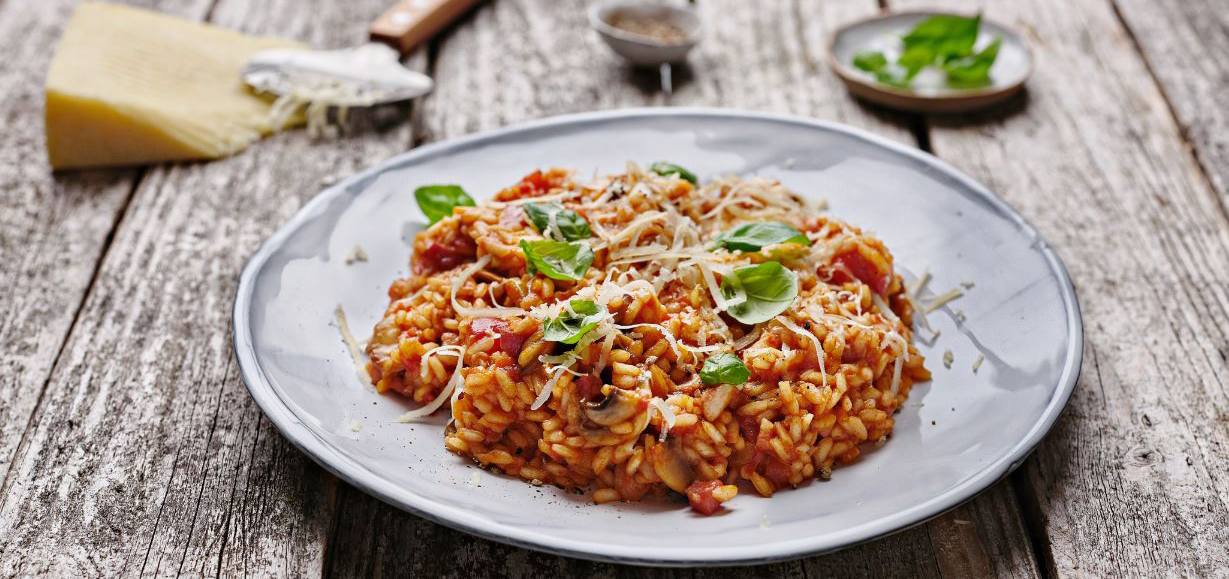
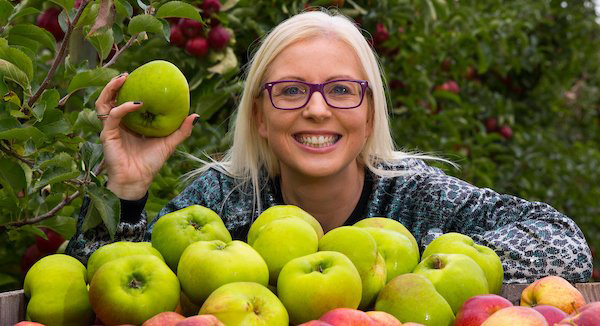
A year after Covid-19 first darkened our lives, things are beginning to look up at last - but we’re all getting really weary. So, now that we’re on the home straight and the prize is in sight, it’s more important than ever to focus on keeping well. The Healthy Ireland programme offers plenty of practical advice, including five key tips from dietitian Aoife Hearne on how to build a strong foundation for eating well by building healthy habits into our daily lives. This may be familiar ground but, for most of us, resolve is running low at this stage so a timely reminder and some encouragement could be just what’s needed. Put simply:
1. Move away from an “all-or-nothing” attitude to eating. Eating perfectly 100% of the time is not a realistic goal, so just work towards making healthier choices as much as possible.
2. Get back to basics by making a meal plan each week and writing a shopping list to match it, so you can ensure that that the majority of foods that make it on to your shopping list are fresh whole foods.
3. Make the healthy choices easy to do, eg leave fresh fruit on the counter in your kitchen so it’s visible and tempting.
4. Aim for a little and often approach to eating. Start with breakfast, to set you up for a successful day of eating well, and eat at regular times throughout the day.
5. Keep a food & mood diary. Aoife advises that this can really help you track what you eat and become more connected and engaged with the food you are eating, how much you are eating and why you are eating certain foods.
Aoife includes a lot of other good advice - and, of course, eating well is only part of the picture, with exercise, outdoor activities (time to get into gardening again!) and mindfulness among the many other factors that contribute to keeping well. But for me ‘good home cooking’ is always top of the list and the sure-fire recipes on the Bord Bia website are always worth checking out.
These quick and easy dishes (with my own tweaks) make satisfying wholesome comfort food to uplift the most trying day.
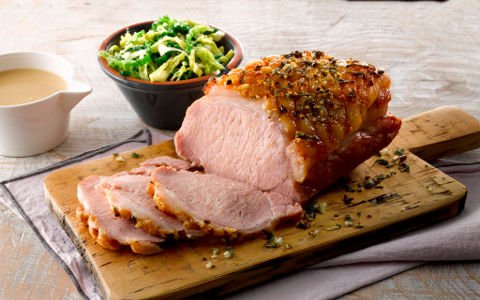 Cider Braised Loin of Bacon with Stir-fried Cabbage
Cider Braised Loin of Bacon with Stir-fried Cabbage
This fresh take on traditional Bacon & Cabbage would be perfect for Saint Patrick’s Day or a homely Sunday lunch. Pork and bacon is extremely versatile and buying well pays dividends in flavour, texture and longterm sustainability. I often use O’Neill’s Dry Cure Bacon from Co Wexford, which is widely available, for this kind of dish - and it’s delicious hot and cold, so try to resist scoffing the lot and leave some for a sandwich next day. One of Darina’s lovely rhubarb puddings would go very well with this as a seasonal partner on St Patrick’s Day…Takes about 1¾ hours. Serves 6.
800g loin of bacon
1 carrot, cleaned and chopped
1 stick of celery, cleaned and chopped
A dash of vinegar
10 juniper berries, crushed
2 cloves garlic, chopped
2 sage leaves, chopped
1 tbsp honey
250ml cider
2 tbsp crème fraiche
1 tbsp Dijon-style mustard
1 tbsp cornflour or potato starch, mixed with 1 tbsp. water - optional
Stir-fried cabbage
A knob of butter
1 small onion, sliced
2 cloves garlic, chopped
650g Savoy cabbage, or other green-leafed cabbage, shredded
Salt and freshly ground black pepper
Preheat the oven to Gas Mark 4, 180°C (350°F).
Place the loin of bacon in an ovenproof saucepan along with the carrot, celery and vinegar. Cover with cold water, bring to a boil and simmer for 30 minutes.
While the bacon is cooking, in a small bowl combine the ingredients for the topping - juniper berries, garlic, sage leaves and honey.
After 30 minutes remove the bacon from the saucepan and place on a plate or board. Score the fat and spread over the topping mixture. Discard the cooking liquid and vegetables and rinse the saucepan with cold water.
Return the bacon to the saucepan, add the cider and place, uncovered, in the preheated oven. Roast for a further 20 minutes basting from time to time. Remove the bacon from the saucepan and keep warm.
Add the crème fraiche to the juices and simmer to reduce for 5 minutes. Whisk in the mustard. If you like the sauce thicker, whisk in the cornflour and water mixture and allow to cook for a couple of minutes.
To prepare the stir-fried cabbage, melt the butter in a wok or large frying pan over a medium heat. Add the sliced onion and garlic and allow it to soften for a few minutes.
Add the shredded cabbage, season with a little salt and black pepper and stir-fry for 3-4 minutes until the cabbage is tender and slightly wilted.
Slice the bacon and serve with the cider sauce, stir-fried cabbage and mashed potatoes or champ.
Champ
2 tbsp butter
4 scallions, finely chopped
10-12 freshly cooked floury potatoes, cut into even-sized chunks
8 tbsp milk
To make champ, melt the butter in a small saucepan and gently sauté the scallions until softened. Pour in the milk and butter and bring to a simmer.
Mash the potatoes and then using a wooden spoon, beat in the milk mixture until you have achieved smooth, creamy mash. Taste and season well.
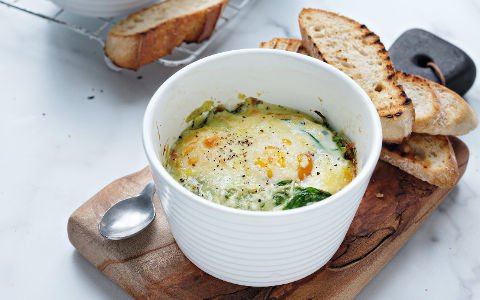 Baked Eggs with Creamy Spinach
Baked Eggs with Creamy Spinach
Eggs are nature’s convenience food, always to hand and so quick and easy to rustle up a tasty meal. These baked eggs take only 20 minutes to make and it’s a healthy and satisfying dish that can be dressed up or down - perhaps with additions such as baked tomatoes, or a side salad - for any time of the day. Serves 4.
8 medium eggs
A knob of butter
75g baby spinach, roughly chopped
2 tbsp. pesto
125ml cream
125g creamy goats’ cheese
Salt and freshly ground black pepper
30g finely grated cheese
To serve: Crusty bread
Heat oven to Gas Mark 6, 200°C (400°F).
Grease 4 x 12cm round ovenproof dishes.
Mix together the spinach, pesto, cream, goats’ cheese and seasoning. Spoon this mixture into the dishes. Break two eggs into each dish.
Sprinkle the cheese over the top.
Bake in the oven for 10 minutes until the whites are set and the yolks are still runny.
Serve immediately with crusty bread.
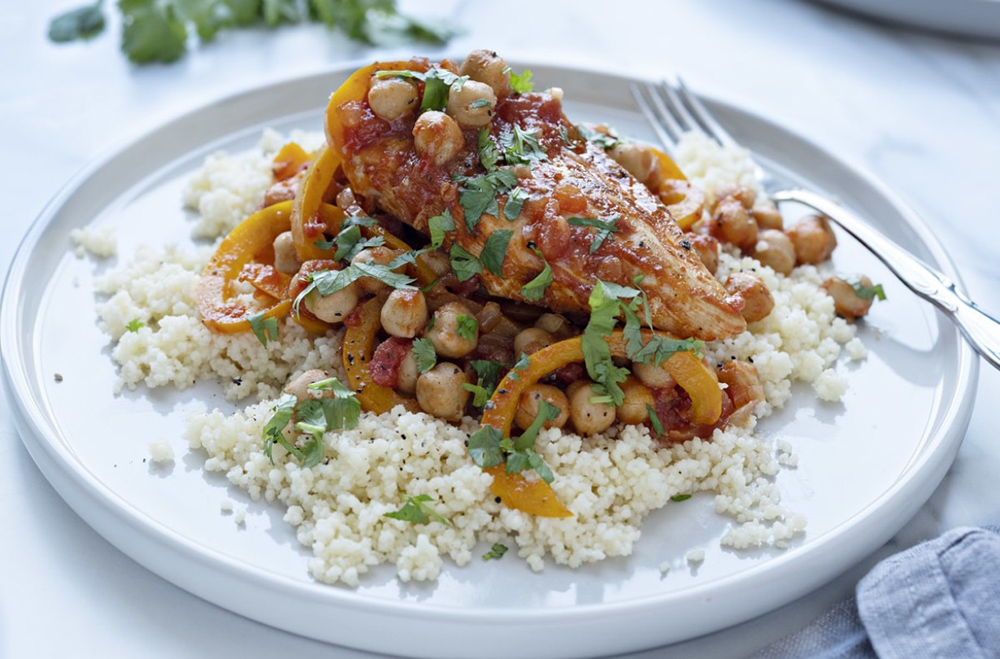 Chicken Fillets with Tomato Sauce and Chickpeas
Chicken Fillets with Tomato Sauce and Chickpeas
While chicken fillets are the most popular standby for busy cooks, alternatives such as chicken legs or part-boned breasts are equally good and better value. The chickpeas are a healthy addition and the current recommendation is to include more pulses in our daily meals so this is right on trend. Couscous is a natural partner for chickpeas but you could also serve this with mashed potatoes to soak up the delicious sauce.
Takes about 45 minutes. Serves 4.
4 chicken fillets, or similar
2 tbsp. rapeseed or olive oil
1 medium onion, peeled and diced
1 yellow pepper, cut in strips
1 x 400g tin of chopped tomatoes
1 tsp. sugar
400g tin of chickpeas, rinsed and drained
Handful of coriander leaves, chopped
Marinade
2 garlic cloves, finely chopped
Rind and juice of 1 lemon
1 tsp. ground cumin
1 tsp. smoked paprika
Salt and freshly ground black pepper
To serve: A green salad and couscous or mashed potatoes.
To make the marinade: In a medium bowl combine the garlic, lemon rind and juice, cumin, paprika and black pepper. Add the chicken and stir to coat.
To cook: Heat the oil in a large pan over a medium heat. Add the onion and cook for 4-5 minutes until softened.
Then add the pepper and cook for a couple of minutes. Remove them to a plate while you brown the chicken.
Add a little more oil to the pan and increase the heat. Add in the chicken fillets. Brown on both sides.
Add back in the onion and pepper mixture along with the tinned tomatoes and sugar. Season with a little salt and black pepper.
Bring to the boil then reduce the heat and allow to simmer for 15 minutes, stirring occasionally.
Add in the chickpeas and allow to cook for another few minutes.
To serve, sprinkle over the chopped coriander and serve with a green salad and couscous which has been flavoured with lemon juice, garlic, chopped scallions and lots of coriander.
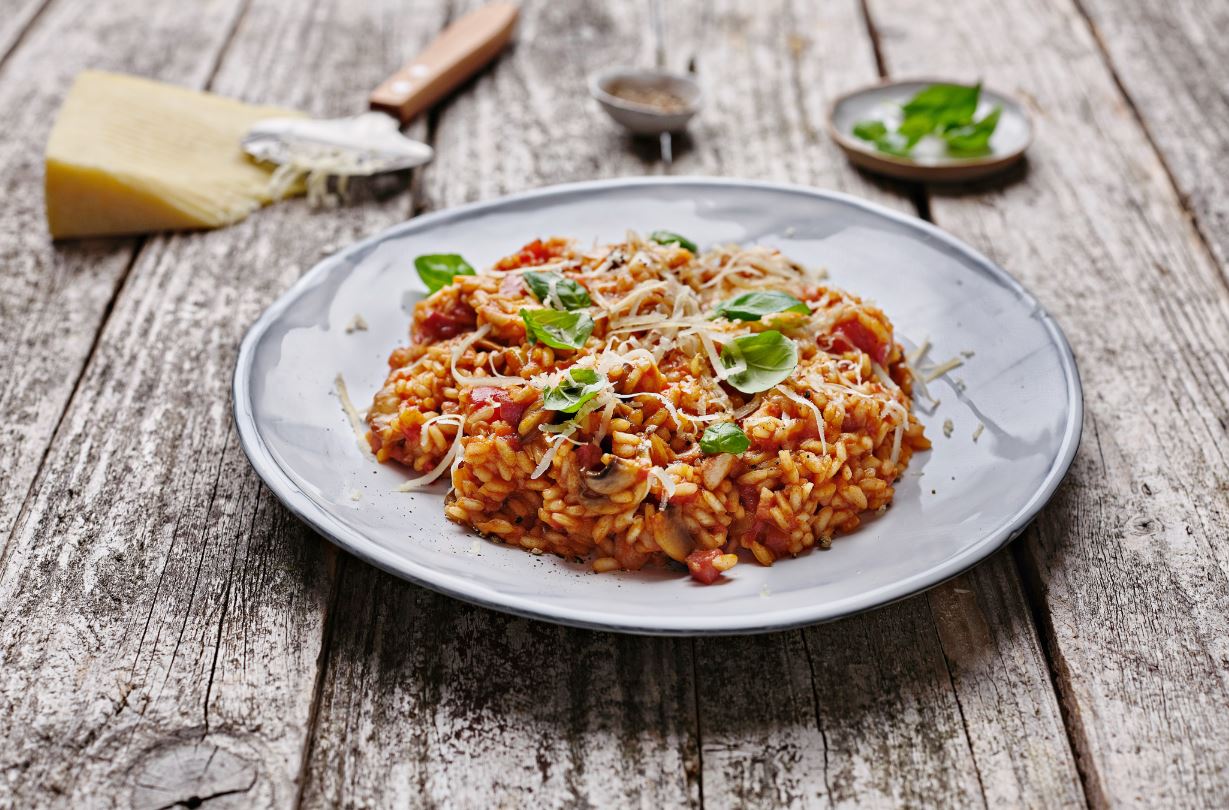 Bacon and Mushroom Risotto
Bacon and Mushroom Risotto
Everyone loves risotto and this is a great recipe for trying out flavour variations (using lemon, garlic or chilli oil, for example), but you could also go one further and use Irish-grown barley instead of the rice - inexpensive and so delicious! Takes about 25 minutes. Serves 4
200g smoked bacon lardons
1 tbsp rapeseed or olive oil
1 onion, finely chopped
150g button mushrooms, cleaned and sliced
2 garlic cloves, peeled and crushed
300g risotto rice
400g tin chopped tomatoes
600mls warm chicken stock, homemade if possible
Basil leaves (or other preferred herb) to taste, chopped
2 tbsp mature cheddar cheese, finely grated
Heat the oil in a wide, shallow saucepan over a gentle heat. Add the bacon and onion and cook for about 5 minutes until the onion has softened. Then add the mushrooms, garlic and rice and stir well to combine.
Add the tin of tomatoes, stir and bring to a simmer. Gradually add the stock, a ladleful at a time. As the stock is absorbed add more and stir regularly for about 15 minutes,until all the stock is used and the rice is cooked. Taste and season with a little salt and pepper.
Turn off the heat, stir through the cheese and sprinkle over the basil leaves. Serve straight away with a green salad.
Cookery Feature - Sensational Cooking with Great European Products
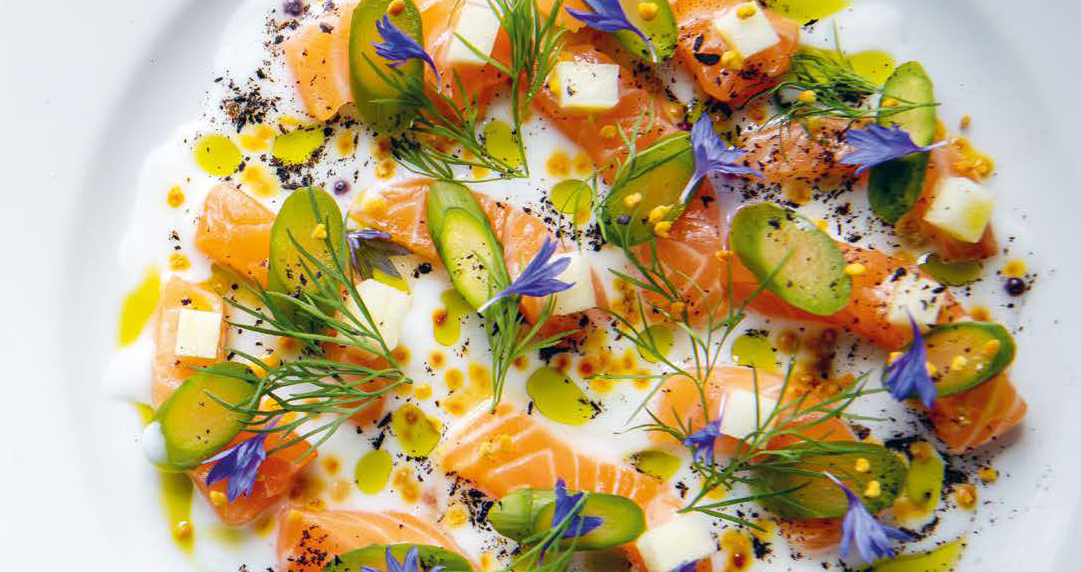
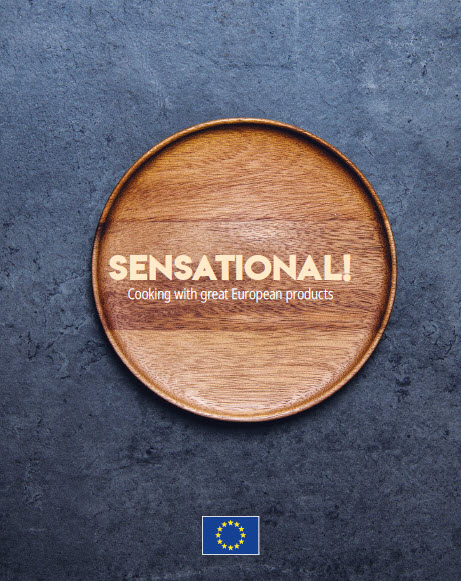 By chance the other day, I happened on an impressive EU cookbook Sensational! Cooking with Great European Products. It outlines the history, purpose and value of the PDO (Protected Designation of Origin) and PGI (Protected Geographical Indication) labels, and illustrates the point with some lovely recipes by talented chefs (not necessarily the most famous, which is no harm), created around unique products with geograph¬ical indications from their own country. In Ireland’s case Grainne O’Keefe, chef at Dublin’s Clanbrassil House, uses Clare Island Salmon (PDO) from Co Mayo and Oriel Sea Salt from Co Louth in a pleasingly simple and very beautiful dish (see below).
By chance the other day, I happened on an impressive EU cookbook Sensational! Cooking with Great European Products. It outlines the history, purpose and value of the PDO (Protected Designation of Origin) and PGI (Protected Geographical Indication) labels, and illustrates the point with some lovely recipes by talented chefs (not necessarily the most famous, which is no harm), created around unique products with geograph¬ical indications from their own country. In Ireland’s case Grainne O’Keefe, chef at Dublin’s Clanbrassil House, uses Clare Island Salmon (PDO) from Co Mayo and Oriel Sea Salt from Co Louth in a pleasingly simple and very beautiful dish (see below).
For full explanation of the labels an extract is given after the recipe below, but key points include the importance of protecting culinary traditions and diversity; protecting products from imitation; and that these internationally respected labels enable producers to command a fair price - while other benefits include assisting in the responsible development of food tourism.
At a time when interest in food is at an all time high and many far less significant books get vast amounts of publicity, it’s surprising that a quality publication with a vital message - and published on behalf of us all - seems to have become available rather than be launched with the fanfare it deserves.
The EU does a lot of good deeds by stealth but its citizens need to know about them and this is another reminder, perhaps, that far better communications and PR are essential to keep us informed and engaged. In Ireland we’re lucky to have keen media interest in all things EU, but that may not be the case everywhere - and, even here, most of us would be hard pushed to name our own MEPs… Surely a ‘Sensational!’ press release should have gone out to all relevant media throughout the bloc, and to countless others too, especially schools and colleges. Maybe it just bypassed me but there’s no obvious sign of a press release anywhere and - although free, and easy for anyone to access once you know where it is - ‘Sensational!’ seems to be more of a ‘best kept secret’ than a ‘must-read’.
Finding a list of our protected products is also a challenge - an online search is more likely to come up with something on Wikipedia than an official site. However the criteria and application process are easier to find, also the current list of applicants - which, unexpectedly, includes a high proportion from China, due to a recent agreement ‘protecting around 200 iconic European and Chinese agri-food names against imitation and usurpation’.
What is certain though, is that we have too few protected products in Ireland. When searching online for our current list I found a 2003 Irish Times article by Darina Allen highlighting our reluctance to engage…Sounds familiar? Yet it is in everyone’s interest to raise awareness and encourage applications to protect our special Irish food and drink products. This cookbook, once discovered, may well help to engage more producers, chefs and keen home cooks. I would have liked to see a map of all of the EU states, in addition to the individual member country faintly outlined at the top of each recipe, and a lighter, warmer touch in the editing department would have added to its appeal. However, allowance must be given for the number of languages offered - perhaps the informational sections need to be edited by a native of each country, who has a real feel for the local situation and understands the subtleties. But it’s a handsome, and very welcome, piece of work all the same - and, while a hard copy version doesn’t seem to be available at the moment, it’s free to download.
CLARE ISLAND SALMON
-IRELAND-
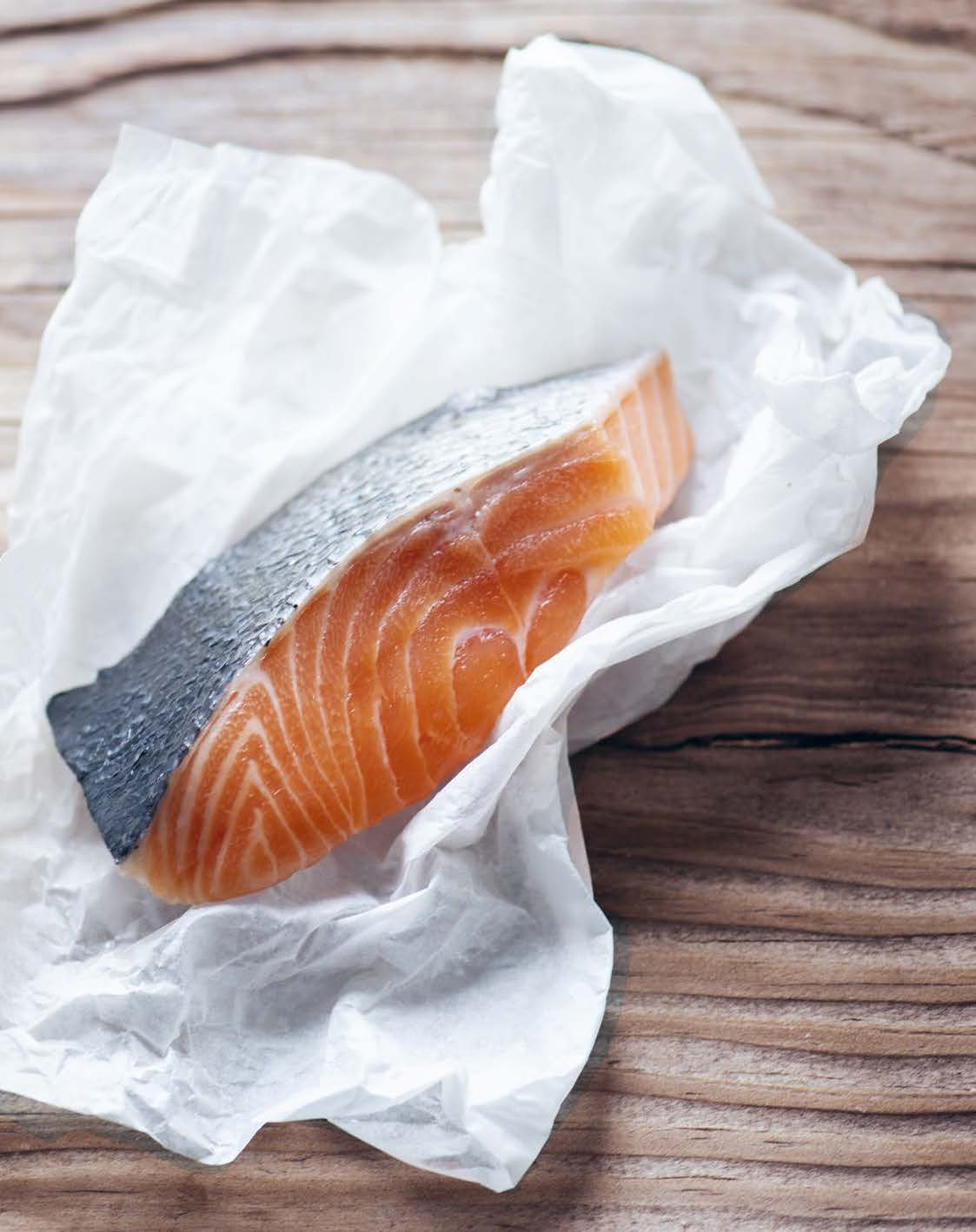 Each spring, one of the largest planned migrations takes place along the coasts of Ireland. Thousands of salmon are transferred into cages off the coast of Clare Island, where they spend the next 2 years being cared for.
Each spring, one of the largest planned migrations takes place along the coasts of Ireland. Thousands of salmon are transferred into cages off the coast of Clare Island, where they spend the next 2 years being cared for.
The fish receive a special diet featuring exclusively natural products and are protected against storms and predators. The production area around Clare Island has several specific hydrographic features that generate strong currents. This prevents the development of parasites, and therefore avoids the need for many chemical treatments. The harvesting of Clare Island salmon is very similar to organic farming in that respect. After 2 years the salmon are strong and large enough for consumption. This salmon has firm flesh with a low fat content, and slightly resembles wild salmon in terms of morphology. The salmon is preferably eaten warm, for example grilled with vinegar sauce and asparagus, but it is also possible to prepare a delicious cold marinated version, as in the recipe featured below. Clare Island salmon has enjoyed PGI status since 1999. In her recipe, Chef Grainne O’Keefe uses Oriel Sea Salt, a product with a PDO. This is the only non-oxidised mineral sea salt in the world.
GRAINNE O’KEEFE, CHEF AT CLANBRASSIL HOUSE:
 ‘Growing up, I was never exposed to fine dining. I had never tasted foie gras or truffles. But I did know from a young age that I wanted to work with food. I used to watch a lot of cooking shows and borrowed cookbooks from the library. I was fascinated by how chefs worked. There was no doubt in my mind that I would become a chef.’
‘Growing up, I was never exposed to fine dining. I had never tasted foie gras or truffles. But I did know from a young age that I wanted to work with food. I used to watch a lot of cooking shows and borrowed cookbooks from the library. I was fascinated by how chefs worked. There was no doubt in my mind that I would become a chef.’
The young Grainne O’Keefe is now chef at Clanbrassil House. She is hailed as one of Ireland’s most promising chefs. In the restaurant, the charcoal grill is the centrepiece of the kitchen. All the main courses, some of the starters, and even desserts are prepared on the grill.
‘I love cooking salmon on the grill,’ Grainne says. ‘There is something deeply satisfying about cutting into a perfectly cooked salmon. I spend a lot of time experimenting with the barbecue, slow-smoking products like sweetcorn, preparing monkfish with miso and so on. The Oriel Sea Salt is an ideal finishing touch, the finale of a grilled dish. You can use it with both vegetables and meat or, as in this case, with fish.’
Clanbrassil House – www.clanbrassilhouse.com
CLARE ISLAND SALMON WITH BONITO VINEGAR, SORREL, APPLE, DILL AND BEE POLLEN
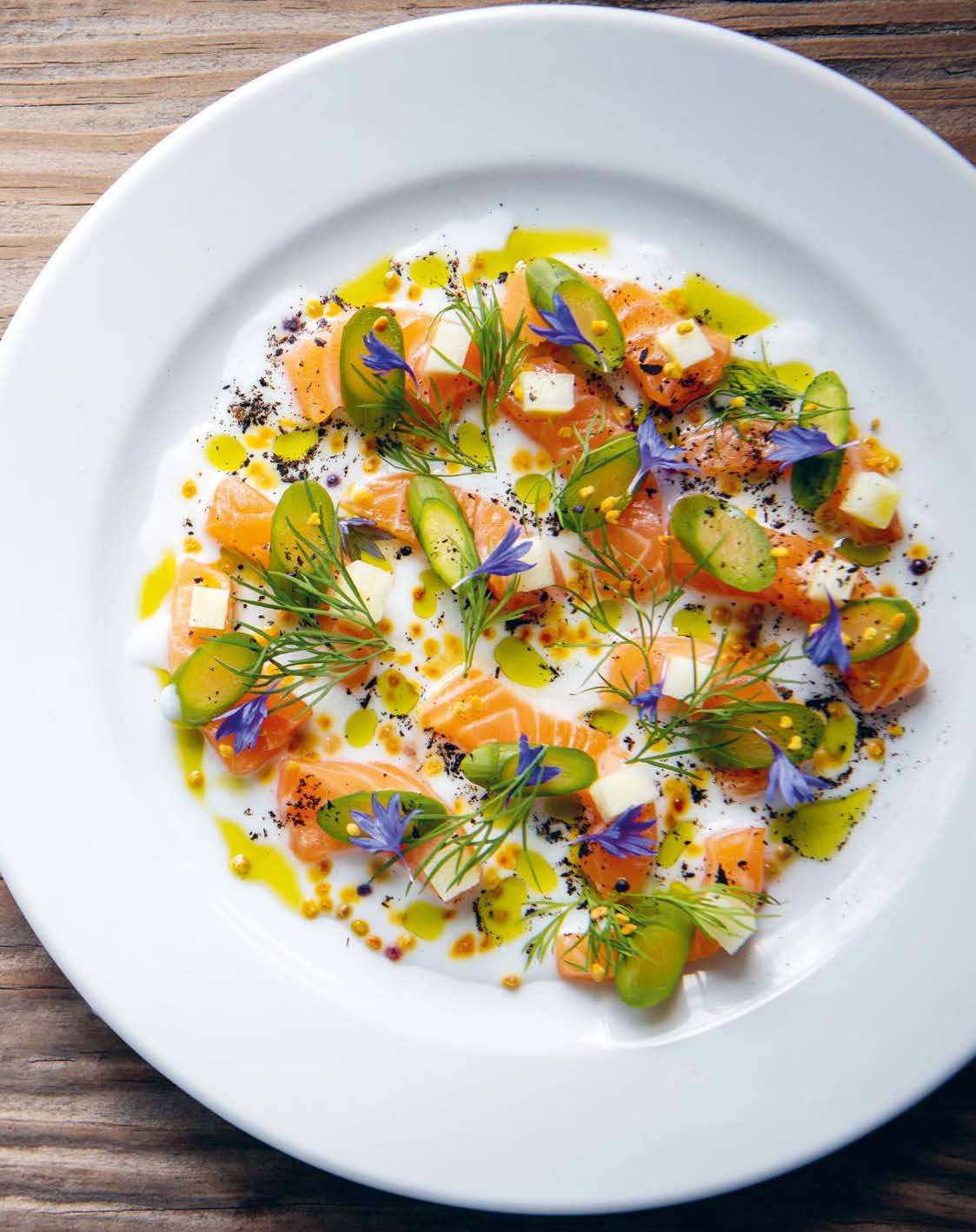 INGREDIENTS (1 portion)
INGREDIENTS (1 portion)
1 spear green asparagus
250g Clare Island salmon
50ml bonito vinegar (or any type of rice vinegar)
10ml lemon juice
Oriel Sea Salt
black pepper
50g sorrel (or spinach)
1 apple (Granny Smith)
50 gdill
10ml buttermilk
2g black sesame seeds
5g bee pollen (optional)
1 cube horseradish, grated
Rub the asparagus with salt and let it sit overnight.
Remove the skin and bones from the Clare Island salmon.
Thinly slice the salmon and mix in a bowl with the vinegar, 5 ml lemon juice, sea salt and black pepper. Allow to rest for 10 minutes.
Mix the sorrel, apple, dill and 5 ml lemon juice in a blender and press the mixture through a fine sieve.
Dress the salmon on a plate and garnish with the apple-sorrel mixture, buttermilk, sesame seeds, asparagus and bee pollen.
Complete the dish with freshly grated horseradish.
ABOUT WHY WE HAVE A EUROPEAN DESIGNATION OF ORIGIN LABEL
Europe has an immensely rich and diverse culinary history and heritage. The reason for this, of course, is not just because Europe is such a vast continent. It is also thanks to the traditions that are passed down from generation to generation. Europe also has an unprecedented geographical diversity; from the fells of Finnish Lapland to the desert lands in Murcia and from the Alpine highlands to the Irish Sea. All these different terroirs give rise to a large and diverse culinary culture. People from all over the world travel to Europe, not just to admire its many artistic and cultural treasures but also to savour the local cuisine.
From Danish cheese to French plums, from Bulgarian sausage to Portuguese vegetables, many of these products are registered as geographical indications (GIs). This European Union quality scheme protects the names of specific products due to their unique characteristics, linked to their geographical origin as well as traditional know-how. It reflects the diversity of Europe and its rich and varied culinary heritage. Chefs appreciate these unique characteristics which reflect the place where the products are made and the age-old production techniques used. They are increasingly popular with consumers not only in Europe but also in other parts of the world.
By 1992, the European Union had already decided to protect several products names. This decision stemmed from the desire to better preserve culinary heritage and to offer farmers and producers a fairer income. European products that are awarded a quality label always feature unique characteristics. These are typical for the region in which they are grown or prepared and, most of all, they are of excellent quality. In 2012, the quality schemes were introduced that establish and safeguard this designation of origin or traditional method of production:
PDO (Protected Designation of Origin): products in this category have a clear and undisputed link with the location where they are produced. This means that all aspects of the production process, the preparation and processing, must take place in the specific region to which the protection applies.
PGI (Protected Geographical Indication): this label explains the connection between the region and the name of the product. Contrary to products with a PDO label, it requires one part of the entire process (at least one step) to take place within the area to which the geographical designation applies.
In this book, renowned European chefs have suggested how unique products with geographical indications from their country can be in-corporated in a dish. They also share their love and passion for the products they grew up with and which have made them so successful. The products from their local regions, which exemplify craftsmanship and excellence. We absolutely need to make sure that these products continue to enjoy their protected designation of origin. It is the only way to preserve and guarantee their quality, both now and in the future.
Cookery Feature - Best of Basics at the IFWG Awards

With beef, butter and potatoes among the winners of the 2021 Irish Food Writers’ Guild (IFWG) Food Awards, food staples certainly took centre stage - but, as IFWG Chair, Kristin Jensen, said when announcing the awards on 15th April, “In a year in which there has been a newfound appreciation for the simple pleasures in life, it is perhaps no coincidence that the winners reflect the basic foundations of Irish food.” So, yes, it was back to basics - but wow, what wonderful basics we have to choose from here in Ireland.
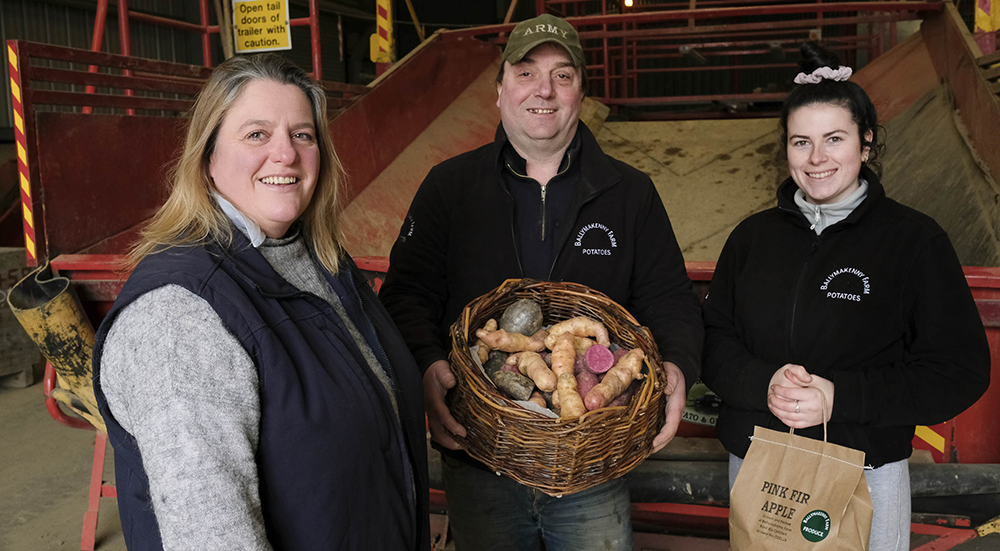
Irish spuds topped with a generous knob of creamy, hand-rolled butter and served with traditional spiced beef are the makings of a fine feast and are the cornerstone of many an Irish meal. The kind of produce we take for granted in this country, these oft-considered store cupboard ‘basics’ have each been singled out for a 2021 Irish Food Award, and for good reason.
In a year that saw food companies pivot and move online to survive and, in many cases, thrive, a ‘virtual’ farmer’s market that connects customers to a network of indigenous producers received the Outstanding Organisation Award. The Guild’s 2021 Community Food Award went to a group that has launched a two-year programme that aims to teach crucial skills associated with food and commensality to school-going children.
The Guild awarded its Irish Drink Award to a gem of a Kinsale crafted mead flavoured with tart Irish blackberry and juicy cherry. One of Ireland’s leading cheesemakers was awarded the Guild’s Lifetime Achievement Award, while the 2021 Environmental Award went to a Kildare business producing organic porridge oats, stoneground flour and semolina, which witnessed a recent resurgence in popularity with people returning to or trying out home baking for the first time during lockdown.
Now in their 27th year, the IFWG Food Awards - kindly supported by Bord Bia - celebrate local producers and food heroes who have brought joy to the lives, livelihoods and tables of so many, before and especially during COVID-19, but whose commitment to producing great food and drink will endure long after the pandemic.

The winners of the 2021 Irish Food Writers’ Guild Food Awards are:
1. Food Award: Abernethy Butter, Co. Down.
2. Food Award: Ballymakenny Farm Irish Heritage and Specialty Potatoes, Co. Louth.
3. Food Award: Tom Durcan’s Spiced Beef, Co. Cork.
4. Irish Drink Award: Kinsale Mead Wild Red Mead – Merlot Barrel Aged, Co. Cork.
5. Outstanding Organisation Award: NeighbourFood, Co. Cork.
6. Environmental Award: Ballymore Organics, Co. Kildare.
7. Community Food Award: The Green-Schools Food & Biodiversity Theme.
8. Lifetime Achievement Award: Marion Roeleveld, Killeen Farmhouse Cheese, Co. Galway.
.jpg)
Celebration
For the first time in its long history, the traditional IFWG Food Awards ceremony and lunch featuring all the winning produce was cancelled this year. However, if there was ever a time to champion and celebrate local producers it’s right now and citations, interviews with the winners and recipes have been lovingly catalogued in this beautiful IFWG Food Awards e-zine.
RECIPES FEATURING IFWG Food Awards winning products (more recipes are included in the Guild’s celebration ezine, see link above):
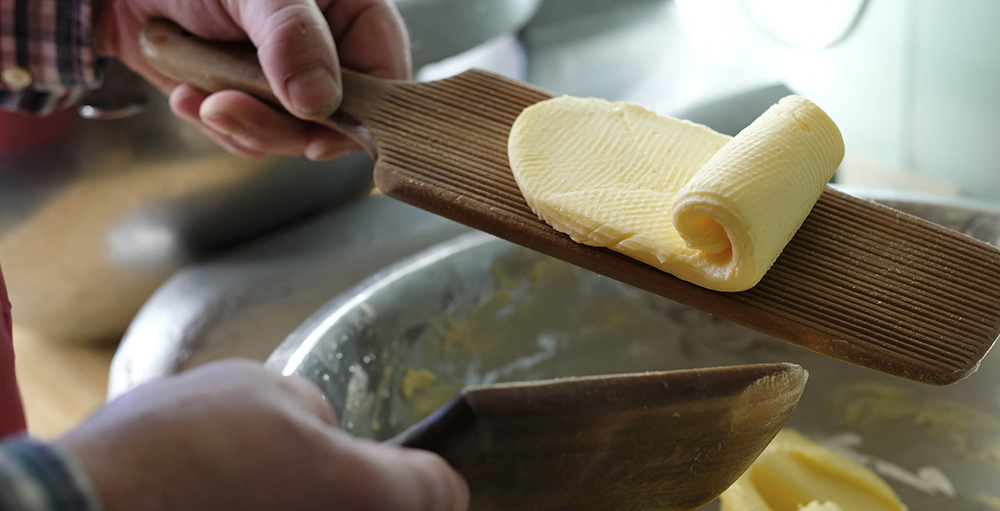
Potted crab with Abernethy Smoked Butter
Abernethy Smoked Butter is handmade in Co. Down with a secret blend
of spices to give it a barbecue flavour. In this recipe, the rich, smoky butter
and spicy ingredients are mixed with the soft crab meat to create a light
but tasty starter.
SERVES 2 TO 4
100g Smoked Abernethy Butter
A pinch of cayenne pepper
A dash of Tabasco
100g white crab meat
Sea salt and freshly ground
black pepper
Toast, to serve
Melt the butter gently in a saucepan and set aside. Add a pinch of cayenne pepper and two or three dashes of Tabasco – don’t add too much or it will overpower the delicate flavour of the crab.
Season the crab meat with salt and pepper and mix with 1 tablespoon
of the melted butter. Divide the crab between two to four ramekins and pour
over the remaining melted butter.
Chill in the fridge until the butter has set and hardened. Remove from the
fridge and leave at room temperature for 1 hour before serving with toast.
Recipe by Abernethy Butter
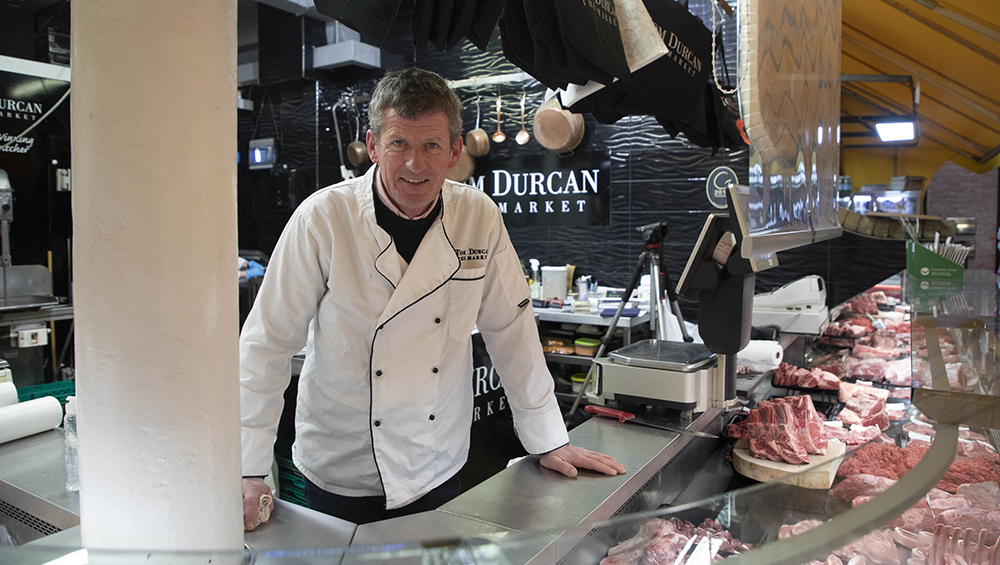
Spiced beef blaa
This recipe comes from Guild member Domini Kemp’s café Hatch & Sons
in Dublin, where it’s long been an all year favourite on their menu, but it’s also an excellent way to use up leftovers at Christmastime.
Waterford blaa
Rapeseed mayonnaise
Tom Durcan’s spiced beef, thinly sliced
Coolea cheese, thinly sliced
Onion relish
This isn’t a recipe per se, just assembly! Spread a warm blaa with rapeseed mayo, then pile on some thinly sliced spiced beef and Coolea cheese and top with a spoonful of onion relish. Sandwich together and tuck in.
Recipe by Domini Kemp
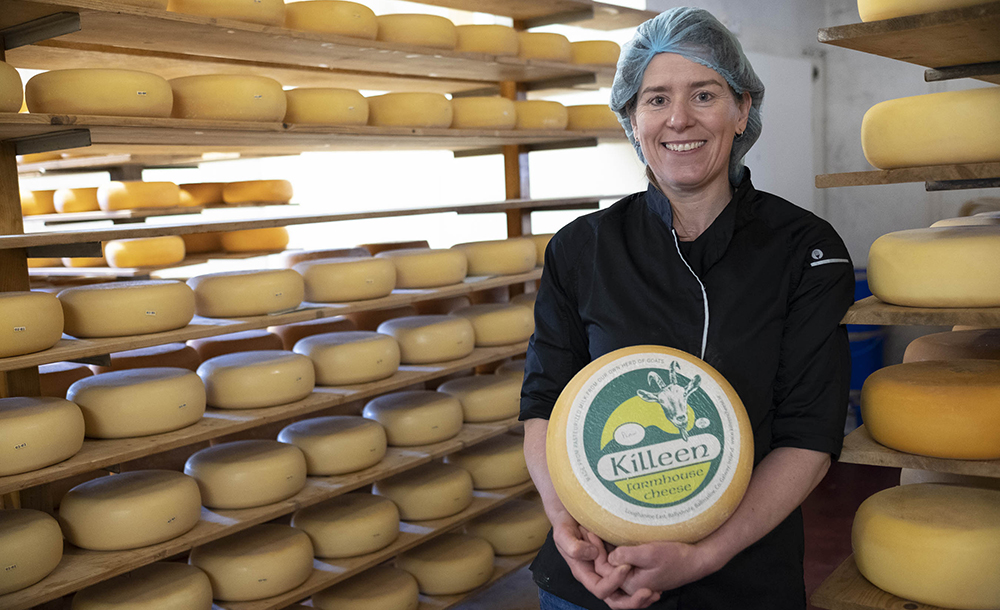
Risotto with mushrooms, asparagus and mature Killeen goats’ cheese
Cheesemaker Marion Roeleveld says this is pure comfort food, perfect on a cold evening. She loves the combination of the mushrooms and the earthy taste of mature Killeen.
SERVES 4
Handful of dried porcini or mixed mushrooms
1 bunch of asparagus
1.2 litres vegetable stock
2 tbsp olive oil
1 onion, finely chopped
350g Arborio rice
1 glass of dry white wine
100g mature Killeen goats’ cheese (e.g. Dunnes Stores Simply Better Five-Months Matured Killeen Goats’ Cheese), grated
25g butter
Sea salt and freshly ground black pepper
Place the dried mushrooms in a small heatproof bowl and cover with just-boiled water from the kettle. Allow to soak for 10 minutes.
Snap the woody stalks off the asparagus spears and discard, then cut the spears into 2.5cm-long pieces. Boil the asparagus for 5 minutes, then drain and set aside.
Heat the stock in a small saucepan almost to the boiling point, then reduce the heat and leave it simmering.
Heat the olive oil in a large heavy-based pan over a medium heat. Add the onion and cook gently for 5 minutes, stirring. Don’t let the onion brown.
Add the rice and give it a stir, then add the wine, reduce the heat to medium-low and keep stirring until the wine has been absorbed into the rice. Strain the liquid from the soaked mushrooms and stir it in, then chop up the soaked mushrooms and add them too.
Add the hot stock one ladle at a time, stirring until the rice has absorbed all the liquid. Keep adding more stock one ladle at a time and stirring until the rice is cooked but still has a little bite. The whole process should take 25 to 30 minutes. Just before the end, stir in the cooked asparagus.
When the risotto is cooked, take the pan off the heat and stir through half the grated cheese and all the butter. Taste and adjust the seasoning if needed.
To serve, divide the risotto between warmed shallow bowls and scatter the rest of the cheese over the top.
Recipe by Marion Roeleveld
Cookery Feature - Outdoor Dining - Be Inspired by GROW HQ

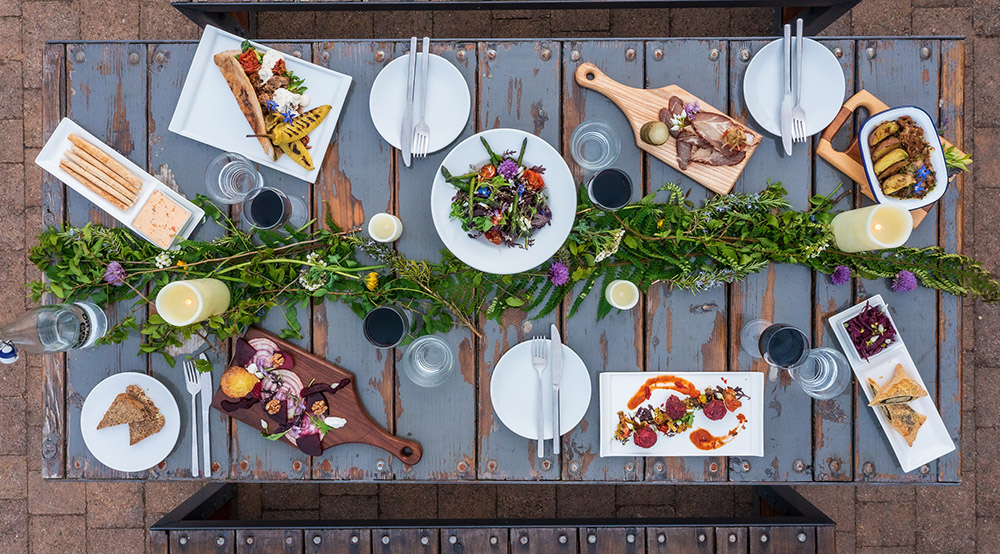
Nowhere is there more excitement about the grand reopening than at GROW HQ, the beautiful GIY headquarters and café just across the road from the University Hospital on the Dumore Road in Waterford, which re-opens on 7th June and is perfectly set up for atmospheric outdoor dining.
At GROW HQ, head chef JB Dubois and his talented kitchen team transform the seasonal harvest (and other organic, chemical free, free-range ingredients sourced locally) into delicious plant-based, but not entirely vegetarian, meals. A fantastic place, it’s always well worth visiting for a delicious bite to eat and a good browse – and, this summer, dining will be on the charming terrace overlooking the vegetable gardens and underneath the HQ stretch tent. With just 112 steps from plot to plate, low-food-mile meals don’t get any better than this…
The GROW HQ ethos is simple: GROW, COOK, EAT. Each day JB Dubois creates a scrumptious menu (see sample below), including a variety of delicious sourdough sandwiches (from €9) along with quiches (€11.50) and summer salads (€10), a daily selection of homemade scones, flapjacks, cakes, pastries, and desserts plus daily specials and tasty sides. Customers are also encouraged to ‘create a plate’ of their liking from the extensive hot and cold seasonal Mezze menu which includes triple cooked chips, a veggie patch salad, a chilli and honey cheese, black-bean hummus, slow-cooked Waterford lamb, root veg falafels with ferments garlic and cucumber dip to name but a few.
The menu and seasonal specials - which all change frequently depending on harvests from the GROW HQ garden and inspiration from the kitchen team - can be viewed on @GROW_HQ on social media. It is hoped that as the summer progresses GROW HQ will also host a variety of engagement opportunities for their customers, from outdoor adventures with little GIY’ers to biodiversity walks and talks to fantastic food experience evenings and more. Do visit this summer if you can – and, meanwhile, JB Dubois has shared some of his delicious recipes for us to make at home.
GROW HQ RECIPES
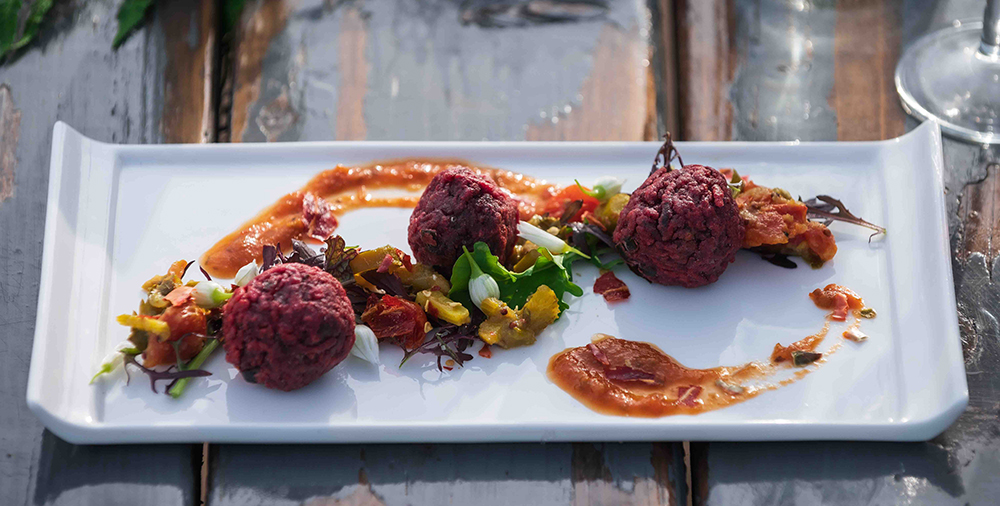
Beetroot Falafel with Yoghurt Dip
Ingredients:
400g finely grated beetroot
50 to 100g organic gram flour (depending on the water content of the beetroots) and little more for coating the falafels
sea salt
50 ml rapeseed oil
½ tsp coriander seeds
1 tsp sesame seeds
1 cloves of garlic
chopped fennel leaves
Method: Toast the sesame and coriander seeds in a small dry frying pan on medium heat for 1 to 2 minutes, add the oil and add the chopped garlic and let cool.
Massage the grated beetroot with the salt for 2 minutes until you feel the beetroot soften under your fingers. Incorporate the spiced oil, then the gram flour and the chopped fennel leaves.
Shape the falafel, roll them in the remaining gluten free flour and deep-fry in hot oil at 150 for few minutes until crispy.
Yoghurt Dip
100g yoghurt
a pinch of salt
Add any flavour you would like, eg chopped chilli, garlic, herbs or lemon zest and poppy seeds.
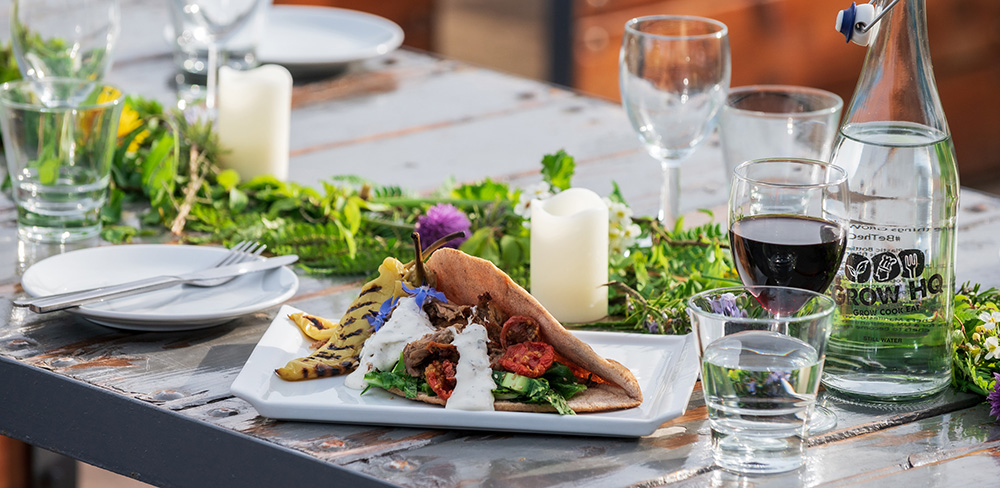
Homemade Flat Bread
These flat breads are cooked in a pizza oven or a dry frying pan and they are perfect to use as wraps or as homemade pizza bases, or even to dip in a warming soup. Makes 8.
Ingredients
300g strong flour
1 pinch sea salt
225g yoghurt
1 tablespoon Irish rapeseed oil (add garlic, coriander or cumin to taste)
Method: Knead all the ingredients together for 5 to 7 minutes until the dough is firm.
Put the dough in a large mixing bowl and place in a warm place for at least 2 hours.
Knead the dough for 2 to 3 minutes.
Cut the dough in 8 equal parts and flatten them.
Cook the flat breads in a hot pizza oven, for 2 minutes on each side. OR, alternatively cook each flat bread on medium heat in a dry frying pan for 3 minutes on each side until golden brown.
Leave to rest under a clean cloth until cool.
Use as wraps, pizza bases or to dip in soups.
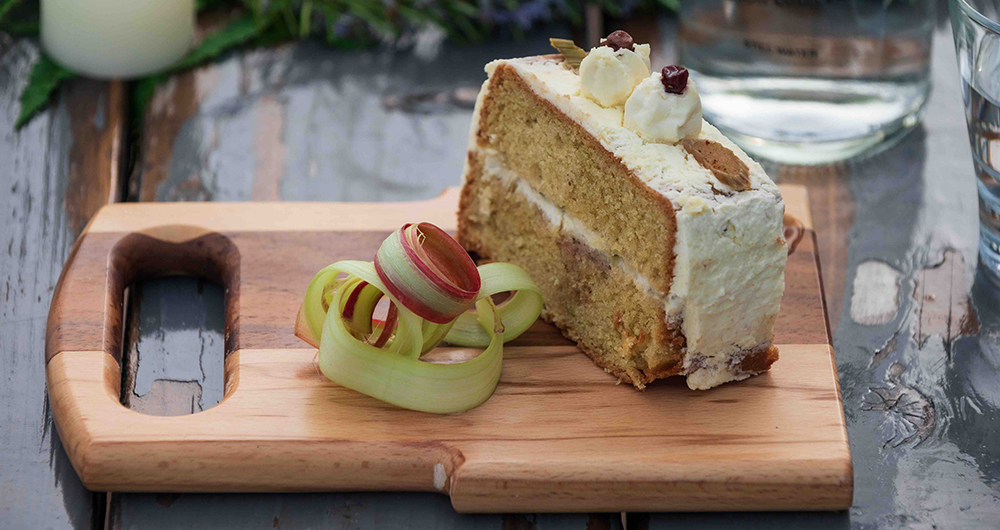
Irish Rapeseed Oil Sponge
This is just one of the many more-ish cakes served at GROW HQ - you can garnish the sponge with fresh cream, stewed rhubarb, fresh seasonal fruit or something more exotic, such as Chilean guava berries.
Ingredients
250ml buttermilk
6 hen eggs
175ml organic Irish rapeseed oil
350g golden caster sugar
500g plain flour
12g baking powder
6g baking soda
a little butter to grease the cake tin.
Method
Preheat your oven at 180
Mix the baking powder & baking soda through the plain flour.
In a separate bowl, using an electric whisk, foam the eggs with the sugar.
Fold in the buttermilk and the rapeseed oil.
Fold in the flour mixture.
Pour the cake batter in a greased cake tin.
Place on the middle shelf of the oven for 10 minutes
Turn the oven down to 160°C and bake for a further 20 to 25 minutes.
Leave to cool on a rack until cold before serving.
SAMPLE GROW HQ LUNCH MENU
HQ SOUP €5.50
a warm hug in a bowl with a choice of sourdough, brown or gluten-free bread
HQ SOUP / HALF TOASTED SOURDOUGH COMBO €9.25
choose sourdough sandwich with a side of seasonal slaw
HQ TOASTED SOURDOUGH SANDWICH €9|€12 with homemade chips & salad
award-winning sandwiches on seagull bakery sourdough:
• CLASSIC - crowe’s farm dry cured ham, HQ chives salsa verde,
smoked knockanore cheese & HQ leaves.
• WEEKLY –black bean hummus, confit tomatoes, chard & HQ leaves.
HQ BLAA €9 | €12 with homemade chips & salad
crowe’s farm free range pulled pork, HQ rainbow chard, jostaberry & mint chutney
& HQ leaves. #pureblaa
ORGANIC 3 EGG OMELETTE €11.50
ardsallagh goat's cheese & HQ chard with grilled crowe’s farm smoked bacon and your choice of toasted sourdough or oregano sauteed potatoes
HQ SUMMER SALAD €10
green asparagus, poppy seed roast baby carrots, pickled cucumbers,
cashel blue cheese, chives flower vinaigrette & HQ leaves.
VEG PATCH QUICHE €11.50
homemade pastry of organic flour & free-range eggs
confit tomatoes, courgette chutney, ardsallagh goat's cheese, oregano & flax seeds.
COLD MEZZE
+ HQ Veg Patch Salad €3
+ our daily slaw €3
+ seagull bakery sourdough bread plate with Irish organic rapeseed oil, hummus &flavoured butter €3
+ selection of dips with garlic blaa crostini €4.50
HQ chilli & honey cheese, black bean hummus, moroccan style rhubarb relish.
+ beetroot & candied hazelnut salad with ardsallagh goat's cheese €5
+ HQ spicy kale kimchy & organic sesame seeds €2.50
+ Sprouting puy lentil salad with confit garlic & rainbow chard €3
+ spring cabbage salad, sunflower seeds, fennel dressing & HQ Istanbulli cheese €4
+ cannellini bean & confit tomato salad with richard's wild rocket €3.50
HOT MEZZE
+ triple cooked HQ chips with herb salt €3
• just-picked HQ cooked veggies €3.50 (or wilted greens with seeds)
• HQ root vegetable falafels with fermented garlic & cucumber dip €5
• roast baby beetroots with organic walnut crumble & cashel blue cheese €4
• HQ sausage roll, spiced HQ sauerkraut & relish €5.50
• chana masala, chickpea & roast vegetable curry €5.50
• slaw cooked waterford lamb with dauphinoise potatoes €7.50
• potato & smoked knockanore cheese hash with HQ kale & rosemary oil €4
pssssst… ask us about our home-made HQ seasonal ketchups & chutneys
Cookery Feature - Why Not Try Watercress?
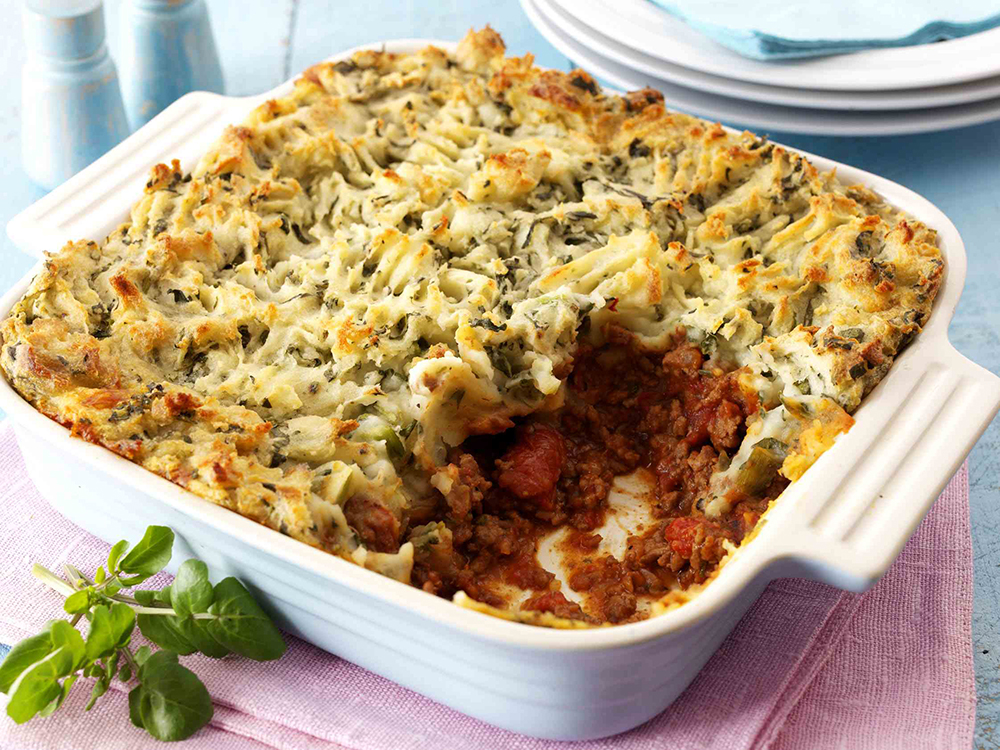
 With water generally abundant in Ireland I’ve often wondered why the wonderfully peppery ‘superfood’ watercress is so hard to come by, as it’s a versatile ingredient that gives a piquant extra dimension to salads and many other dishes. You may spot it occasionally in small greengrocers or in supermarkets (most likely UK ones, such as M&S), but the best solution might be to forage for it (a new activity for your staycation, perhaps) or to grow the similar American Land Cress (Barbarea verna) at home.
With water generally abundant in Ireland I’ve often wondered why the wonderfully peppery ‘superfood’ watercress is so hard to come by, as it’s a versatile ingredient that gives a piquant extra dimension to salads and many other dishes. You may spot it occasionally in small greengrocers or in supermarkets (most likely UK ones, such as M&S), but the best solution might be to forage for it (a new activity for your staycation, perhaps) or to grow the similar American Land Cress (Barbarea verna) at home.
There are a few commercial growers, such as McCormack Family Farms in Co Meath, who supply land cress to foodservice customers (and mixed leaf bags to supermarkets). Mr Middleton offers watercress seeds and advice (ie give it plenty of water) and so do some other specialist suppliers. Watercress seeds are probably best used for microgreens, while the less demanding land cress - which I have grown successfully myself - is a more practical alternative for ordinary garden soil and the seeds are quite easily available, including from the exciting new SOLAS Eco Garden Shop at Portarlington.
True watercress (Nasturtium officinale) is a fast-growing semi-aquatic perennial plant and one of the oldest known leaf vegetables consumed by human beings. Watercress belongs to the cabbage (brassica) family, and is related to the more familiar little cress and mustard plants— which, like the nasturtiums that grow so freely in our gardens, are all known for their peppery flavour.
Watercress grows in streams all over Ireland from spring through to autumn and, providing it is clean running water with no effluent running into it from grazing animals (which introduces serious risks, including liver fluke parasite), it is safe to pick. The darker leaves have best flavour and it’s easy to use, just wash well, trim, and shake dry before using as a salad green or as a recipe ingredient.
As Darina Allen points out in her invaluable book, Forgotten Skills of Cooking (Kyle Cathie), watercress “…formed part of the diet of hermits and holy men, who valued its special properties, which we now know include significant amounts of iron, calcium, folic acid, vitamins A and C.
Watercress is brilliant for detox – the mustard oils boost and regulate the liver’s enzymes. Its beta carotene and vitamin A are good for healthy skin and eyes, and watercress is naturally low in calories and fat. Gram for gram, watercress has more iron than spinach, more vitamin C than oranges and more calcium than full cream milk…” Legend has it that it was watercress that enabled St Brendan to live the ripe old age of 180! And Hippocrates, the father of medicine, chose the location of his first hospital so he could use only the freshest watercress to treat his patients.
Although it’s valued by many Irish chefs for the freshness and piquancy that it brings to all sorts of dishes, watercress is much more widely used in the UK, where there is even a dedicated watercress website, https://www.watercress.co.uk/
giving information on health benefits and everything to do with this remarkable plant, plus a great range of recipes including those below. Could this is be a crop with potential for development in Ireland?
RECIPES:
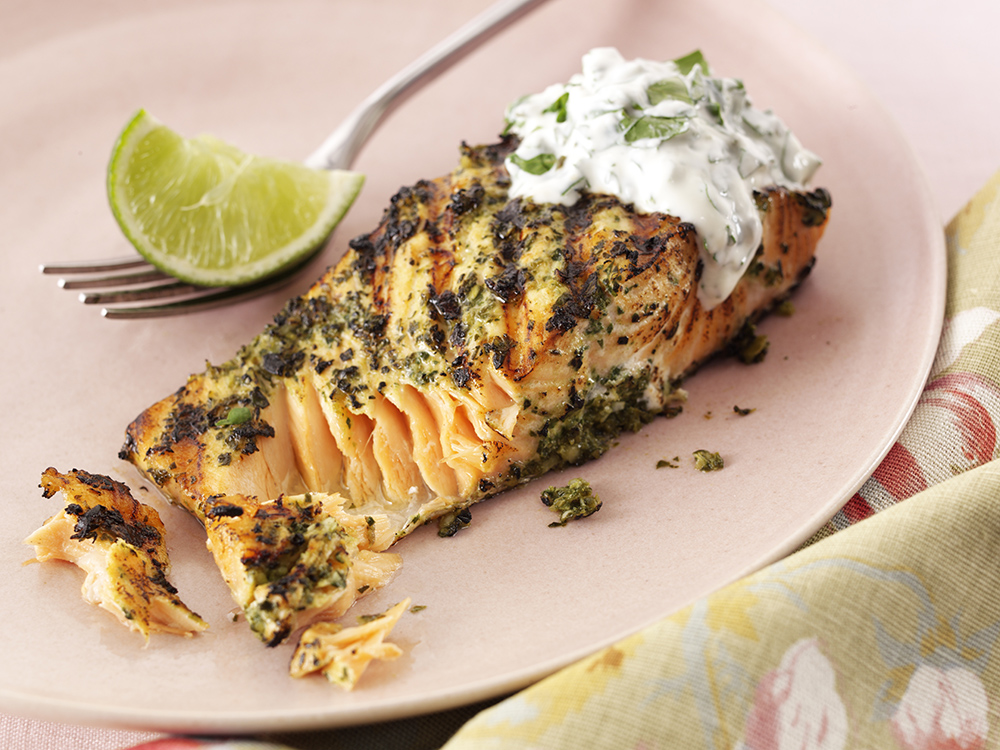 Thai Grilled Watercress Salmon
Thai Grilled Watercress Salmon
Fish – especially oily fish such as salmon – works well with watercress, and it also partners well with light oriental flavours as in this summery main dish. Serves 4.
100g watercress, roughly chopped
18 mint leaves
½ teaspoon salt
2 cloves garlic, crushed
2 green chillies, seeds removed
3 tbsp fresh lime juice
1 tbsp caster sugar
1 tbsp chopped fresh ginger
1 tbsp fish sauce (Nam Pla)
4 x 175g salmon fillets
Watercress Raiita:
200ml Greek yogurt
100g watercress finely chopped
1 small clove garlic, finely chopped salt and freshly ground black pepper to taste
1 Place the watercress, mint, salt, garlic and chillies in a food processor and whizz until finely chopped. Add the lime juice caster sugar, ginger and fish sauce and process to make a paste. Place the salmon in a glass dish or plate, spoon over the paste and toss until evenly coated. Cover and leave to marinate in the fridge, for at least 20 minutes.
2 Whilst the salmon marinates, make the raiita: mix the yogurt, watercress and garlic together with seasoning to taste. Spoon into a bowl and chill until required.
3 Cook the salmon on a hot griddle or barbecue for 4-5mins on each side. Serve with the watercress raiita on the side.
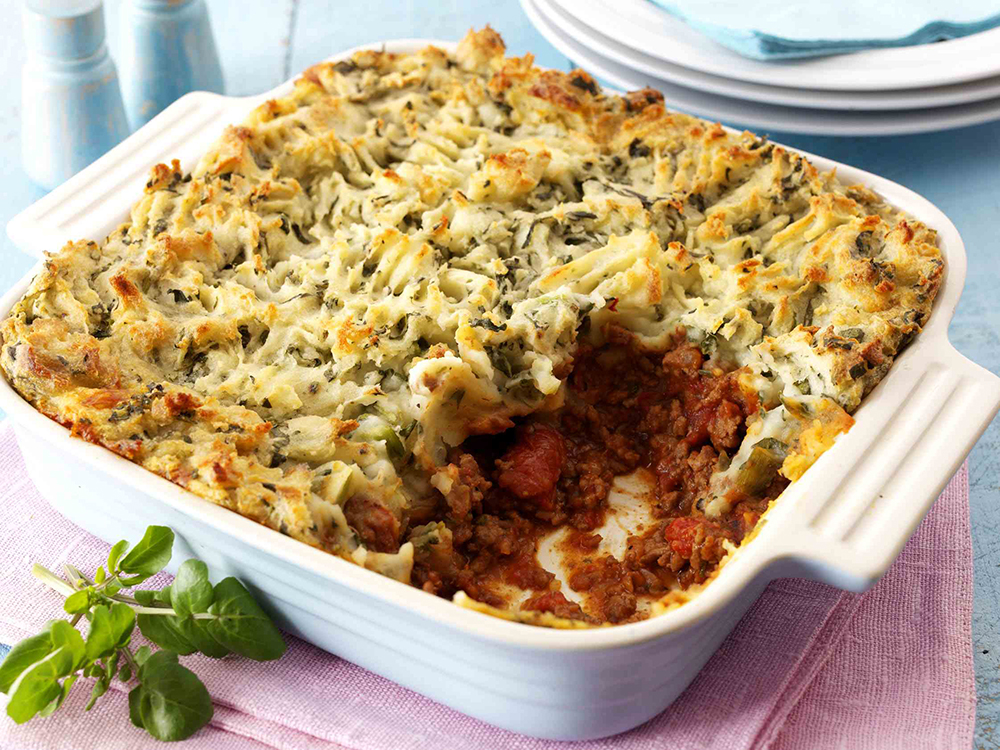 Shepherd’s Pie with Watercress Champ
Shepherd’s Pie with Watercress Champ
Comfort food at its best, this could make a lovely family dinner on a self catering staycation. It’s from chef Antony Worrall Thompson, who is a huge fan of watercress. This kind of pie was normally made with the leftovers of the Sunday joint whatever that happened to be, but it’s flexible and, says Antony, “I often serve a variation on the classic using cauliflower cheese instead of mashed potato which is lower in carbohydrate. However, there’s really no comparison for the real thing - just serve a big dollop and enjoy!”
Serves 6
1 tbsp vegetable oil
500g/1lb 2oz lean minced lamb
1 large onion, chopped
1 tbsp plain flour
400g/14oz can chopped tomatoes
300m/l/½ pints lamb, beef or chicken stock
2 fresh bay leaves
1 tsp dried thyme
1 tsp anchovy essence (optional)
2 tsp Worcestershire sauce
For the Mashed Potatoes
700g/1½ lb floury potatoes such as Maris Piper, peeled and cut into chunks
150ml/¼ pint milk
4 spring onions
50g/ 2oz unsalted butter
1 egg yolk
200g/ watercress, roughly chopped
salt and freshly ground black pepper to taste
Preheat the oven to 180ºC/Fan 160º/Gas 4. Heat the oil in a heavy based pan, add the mince and cook over a fairly high heat until evenly browned, breaking up any lumps with a wooden spoon. Add the onion and cook for 5 minutes until softened but not browned, stirring occasionally.
Add the flour and cook stirring for 1 minute. Then stir in the chopped tomatoes, stock, bay leaves, thyme and anchovy essence, Worcestershire sauce and a good pinch of pepper. Bring to the boil, stirring occasionally, then reduce the heat, cover and simmer for 25 minutes or until the lamb is tender and sauce thickened and rich. Season to taste
Whilst the lamb cooks, cook the potatoes in boiling salted water for 15-20 minutes, or until tender. Drain the potatoes, then return to the pan and mash until smooth. Cook the spring onions in the milk for 3-4 minutes then tip into the mash with the butter, egg yolk and watercress and stir through with a fork, until it is nice and fluffy. Season to taste.
Spoon the lamb mixture into a 3-pint/1.75 litre pie dish, discarding the bay leaves. Spoon the fluffy watercress mash on top and fluff up with a fork. Bake for 25-30 minutes, or until bubbling and golden brown. Serve hot with green vegetables.
Cook’s tip: If you are running short on time, after smoothing the hot mash on top of the mince you can skip the baking stage and just brown it under a medium hot grill for 5 minutes until crisp.
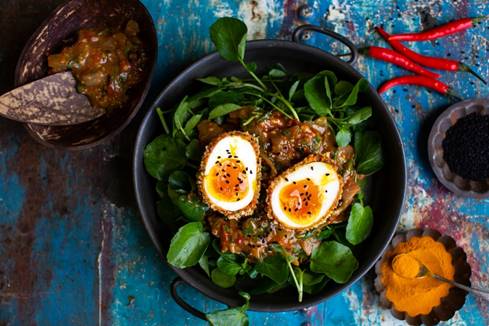 Panch Phora Crispy Egg, Burnt Chilli Salsa & Watercress Salad
Panch Phora Crispy Egg, Burnt Chilli Salsa & Watercress Salad
A feisty main course salad recipe from chef Suze Morrison, who is based in Dorset - one of the UK’s top watercress-producing counties.
Serves 4
5 eggs (room temperature)
50g plain flour
80g panko breadcrumbs (briefly pulsed to a smaller crumb)
2 tbsp panch phora (see below)
pinch salt
½ tsp turmeric
oil for deep frying
150g watercress
Panch Phora: ½ tsp each of: mustard seeds, nigella seeds, cumin seeds, fennel seeds + ¼ tsp fenugreek seeds
Burnt Chilli Salsa:
200g tomatoes, halved
3 red chillies
4 cloves garlic, skin on
1 onion, peeled and cut into chunks
2 tbsp olive oil
1 tsp brown sugar
2 tbsp lime juice
½ bunch coriander, roughly chopped
salt & cracked black pepper to season
Begin with the Panch Phora. Lightly toast the seeds in a dry pan until fragrant. Pour into a jar and set aside.
Bring a small pan of water to a rolling boil and cook 4 of the eggs in it for 4½ minutes. Run under cold water and peel. Be careful, they are delicate.
Roll the eggs in the flour then beat the remaining egg. Mix 2 tbsp of the Panch Phora mixture into the breadcrumbs with the salt and turmeric.
With a clean hand take one egg at a time and roll in the breadcrumb mix. Remove, roll back in the beaten egg and roll for a second time in the breadcrumb mix. This method of ‘double pane’ ensures you have a good thick crust on your egg.
Pop in the fridge while you make the salsa.
Heat the grill to high and pile the tomatoes, chillies, garlic and onion onto a tray, drizzle with the oil and grill until charred, you want a good blackening for flavour.
Remove the stems from the chillies and the skin from the garlic then pound all the ingredients in a pestle & mortar to a chunky paste. You can use a food processor, but this will chop rather than pound the ingredients together.
Add the sugar, lime juice & coriander and taste, season with salt & pepper to your liking.
Heat the oil for deep frying to 180C. Carefully add the eggs and fry for 2-3 minutes or until golden and crisp. Drain and sprinkle with a little salt.
When ready, divide the watercress between 4 plates. Top with the salsa and a crispy egg. Watch that yolk oooooze!
Cookery Feature - Mountain Lamb for Autumn Treats
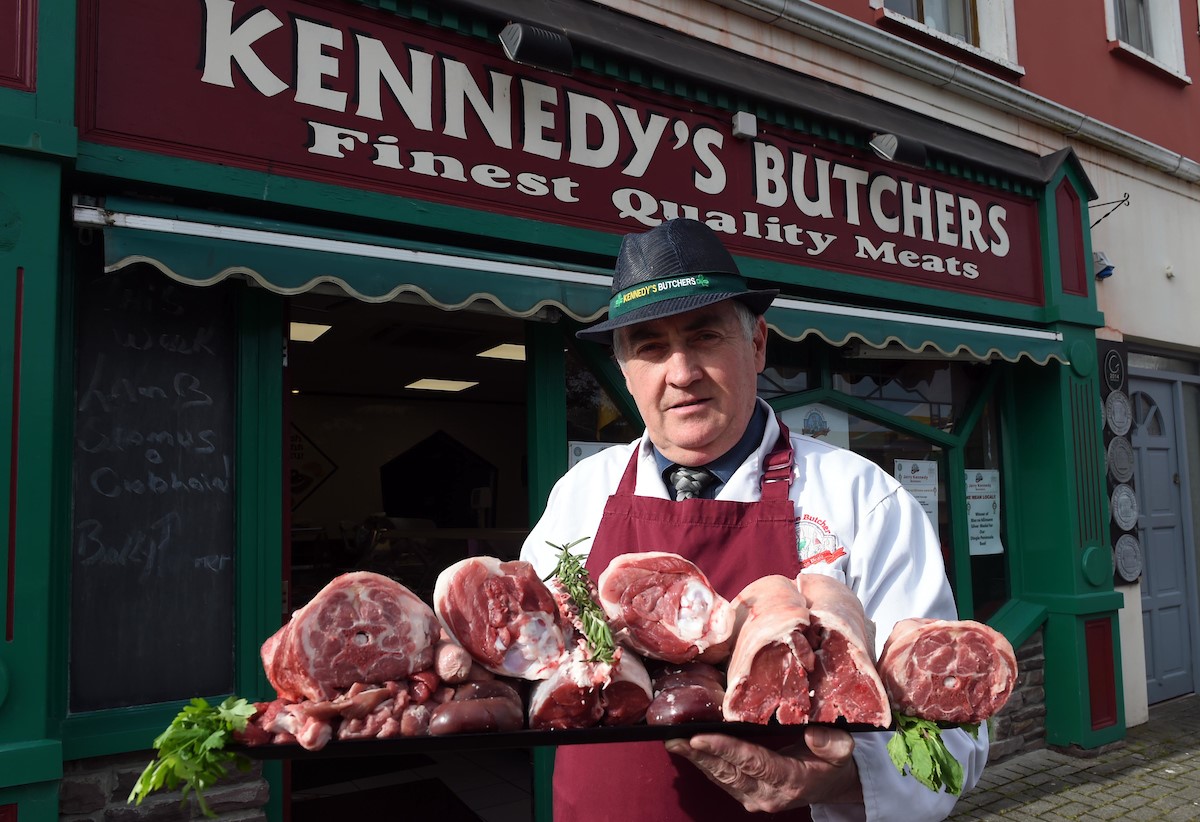
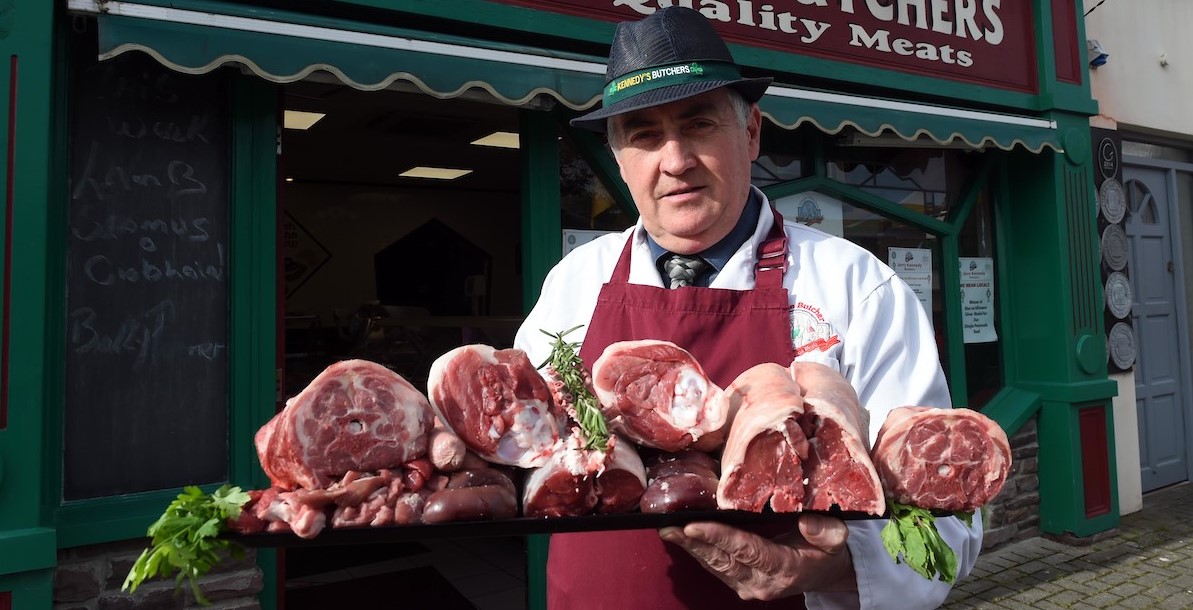
While lamb is an all-year product, it’s generally associated with spring – especially Easter. But there’s a completely different and more characterful variety that comes into season later in the year: mountain lamb.
It is a smaller, leaner animal, with more muscle and the distinctive flavour of the heathers and mountain herbs it has been reared on. Produced naturally in the wild and likely to be organic by definition, it comes from the hills and mountains of rugged areas in the West of Ireland, like Mayo, Connemara (famous for their Blackface Mountain Sheep), Kerry and the Comeragh Mountains in County Waterford - and is one of Ireland's most interesting speciality foods.
The lambing season is later in mountainous areas, so this special meat follows on from the larger lowland lamb, coming onto the market during the late summer and autumn, usually from August or September until November or December. The delicious meat is increasingly appreciated by a discerning market, both domestic and international, and with growing recognition - Connemara Hill Lamb has the European PGI/Protected Geographical Indication status, for example.
Mountain lamb has the potential to transform the prospects for hill farmers, for whom this gourmet product should command a premium price – and better still, for both producer and consumer, is when added-value comes into the equation.
You can find these unique foods online and from butchers such as McGeough’s of Connemara, Calvey’s of Achill and Jerry Kennedy in Dingle. Speciality retailers, such as Waterford’s Ardkeen Quality Food Store are also stockists, and mountain lamb is available in some supermarkets too, eg Dunnes Stores Simply Better range.
Although the premium prices deter many, some chefs love nothing better than to promote such a unique seasonal local product and in recent years, until the pandemic caused a temporary halt, Cork's Market Lane restaurant group had gained a well-earned USP for being the only restaurants in Ireland to celebrate the arrival of prized Blasket Island Lamb each autumn. This year it’s back again at all of the group’s restaurants (Market Lane, Elbow Lane, ORSO, and Castle Restaurant Blackrock) where executive chef Stephen Kehoe’s specially created Blasket Lamb dishes will be served for two weeks from mid-October. He says it is ‘arguably the most delicious lamb in the country‘ and that’s s down to the habitat on the small Blasket island of Beginish, where the lambs born in summer graze in a sea-sprayed marshy meadow which gives the lamb its highly valued pré-salé flavour. With no forced fattening, the lamb is leaner, ‘creating a near-perfect fat to meat ratio’ says award-winning Dingle Butcher, Jerry Kennedy (pictured above), who looks after the lamb when it comes off the island. "This is the perfect example of produce that is not only free-range, but contains no additives, colourants or preservatives and is vaccination free."
RECIPES TO TRY:
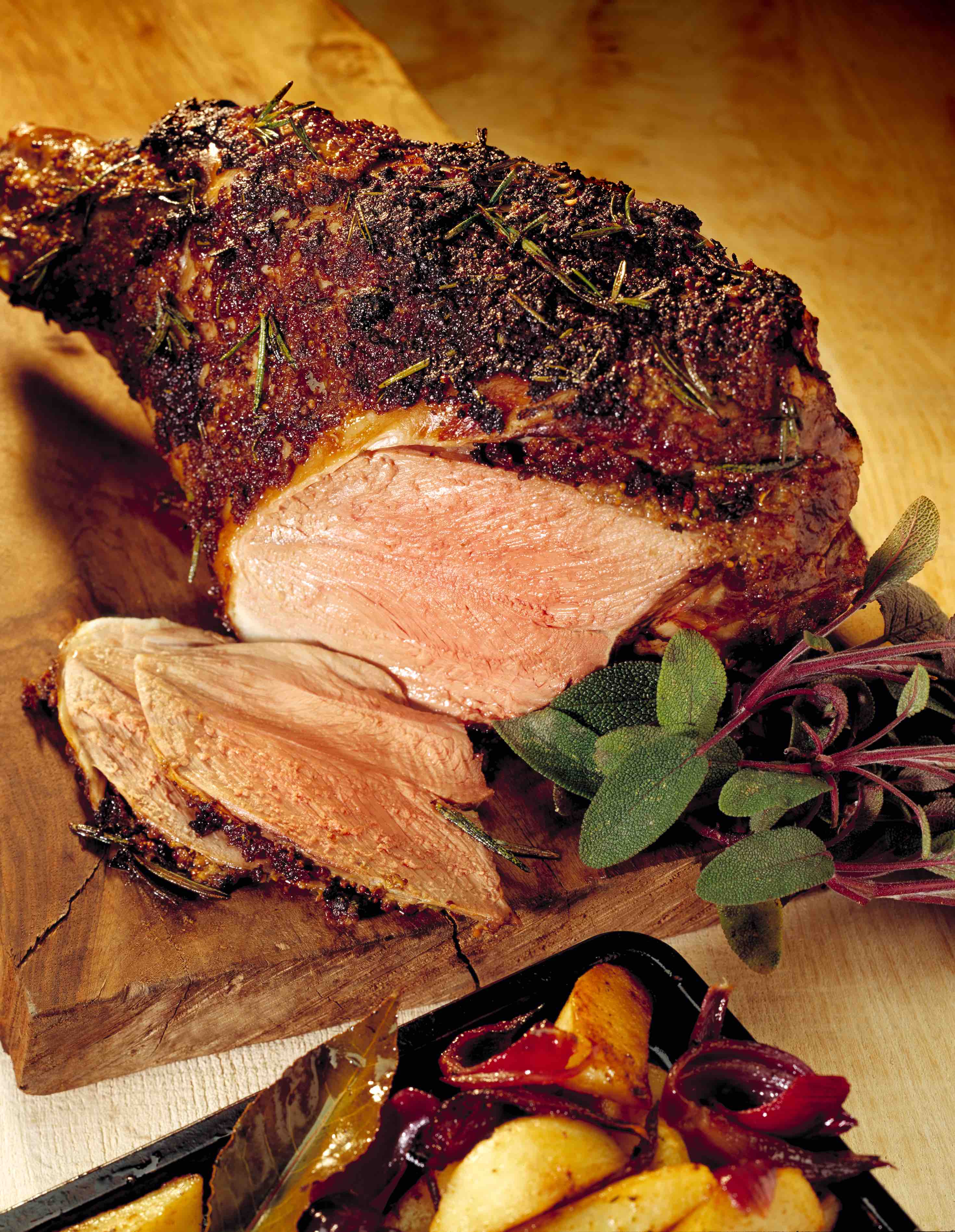 Leg of Lamb Roasted with Mustard and Rosemary
Leg of Lamb Roasted with Mustard and Rosemary
Serve with roast potatoes and some simple seasonal vegetables and
you will have a memorable meal for family and friends.
1 leg of lamb, well trimmed
Topping
2 tbsp mustard
2 tbsp soy sauce
1 clove garlic, crushed
1 tsp chopped rosemary leaves
2 cm root ginger, peeled and grated (optional)
1 tbsp olive oil
Preheat the oven to 220°C/200°C fan (430°F), Gas Mark 7.
Weigh the meat and allow 20 minutes per 450g/lb cooking time, plus an extra 20 minutes, for it to be cooked medium.
Place the lamb in a roasting tin. Mix the mustard, soy sauce, garlic, rosemary and grated ginger together and then gradually stir in the olive oil to make a paste. Spread this mixture over the lamb.
Put into the oven and roast for 20 minutes, then reduce the heat to 180°C/170ºC fan (350°F) Gas Mark 4 for the remaining time. Remove from the oven, wrap the lamb loosely in foil and allow to rest for 15 minutes before carving.
Serve with gravy made with the thickened juices and vegetable stock; seasonal vegetables; and potatoes and red onions roasted alongside the lamb – peel and quarter some potatoes and red onions and mix with a little olive oil, bay leaves and seasoning, then cook with the lamb for the last 50 minutes.
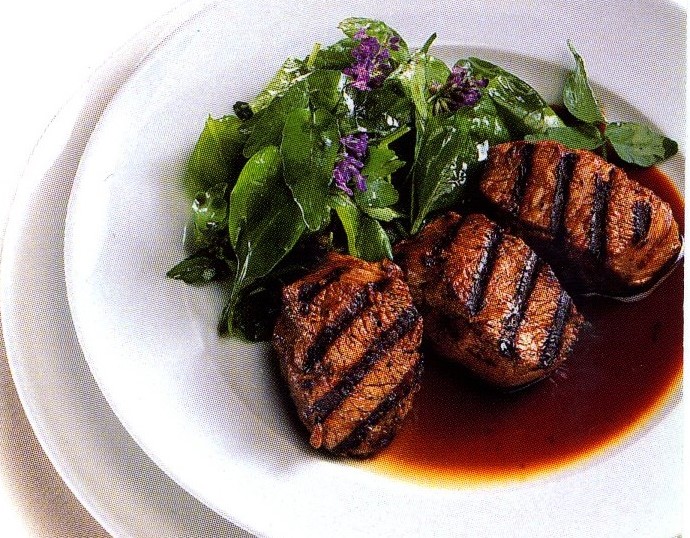 Grilled Mountain Lamb in a Salad
Grilled Mountain Lamb in a Salad
A simple treat for 2-3 people.
1 rack of lamb, or six fillet lamb ’steaks’
2 tbsp oil
2 cloves garlic, crushed
2 tbsp chopped fresh herbs
Salt and black pepper
Mixed salad leaves or seasonal vegetables
To prepare the lamb if using a rack, remove the fillet/eye of the meat from the bone and trim off all the fat. Discard the fat, but keep the bones and trimmings and make stock for lamb gravy. Cut the lamb fillet into six small steaks. Place in a shallow dish. Mix the oil, garlic, herbs and seasoning together. Spoon half this mixture over the lamb. Heat the griddle pan or grill until very hot. Cook the lamb steaks according to your preference.
To serve: Mix the salad leaves or lightly cooked vegetables with remaining oil and herb mixture. Place on the serving plates with the lamb steaks and serve with the cooking juices or a little lamb gravy.
Cookery Feature - And For Mains�
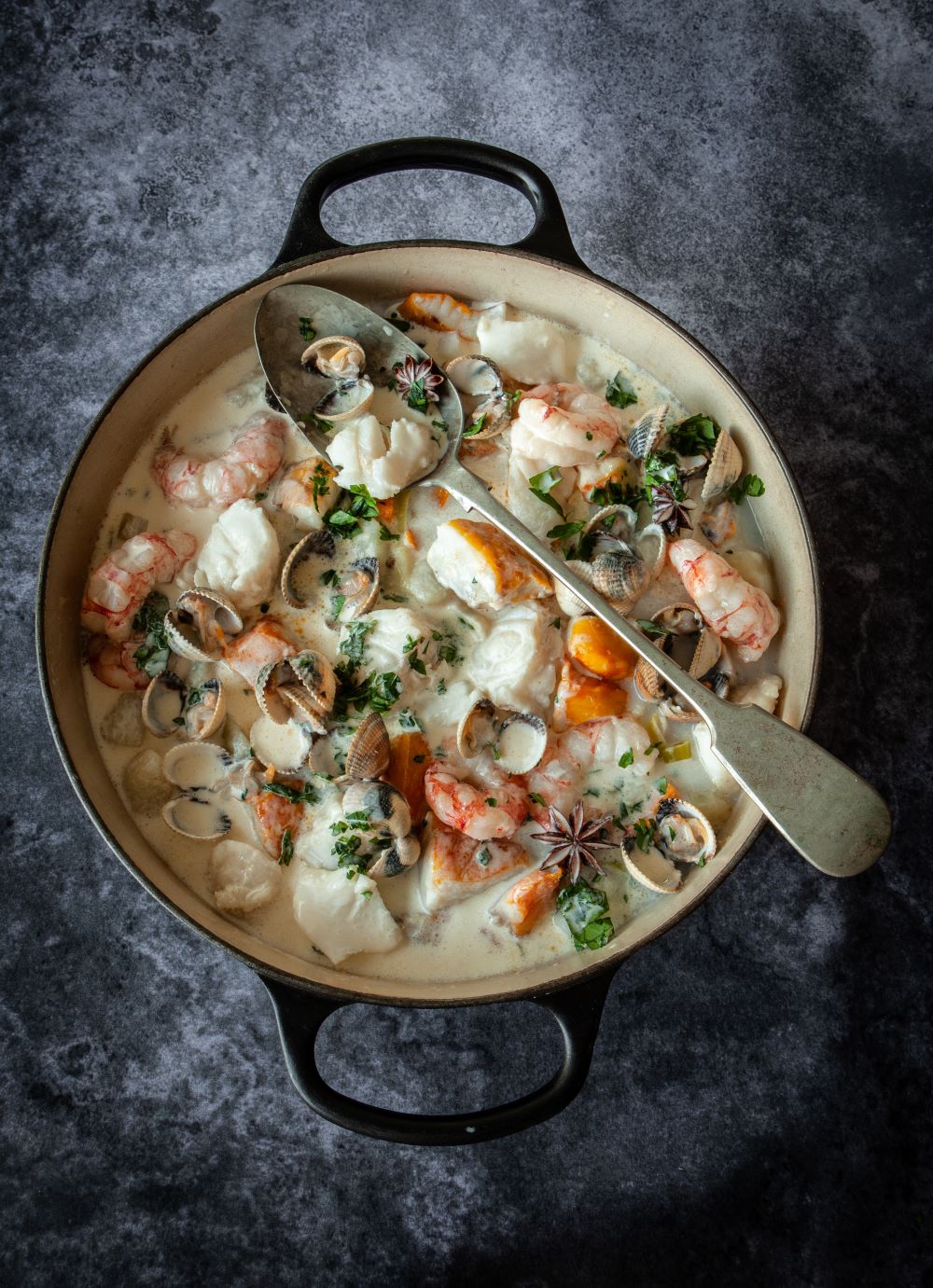
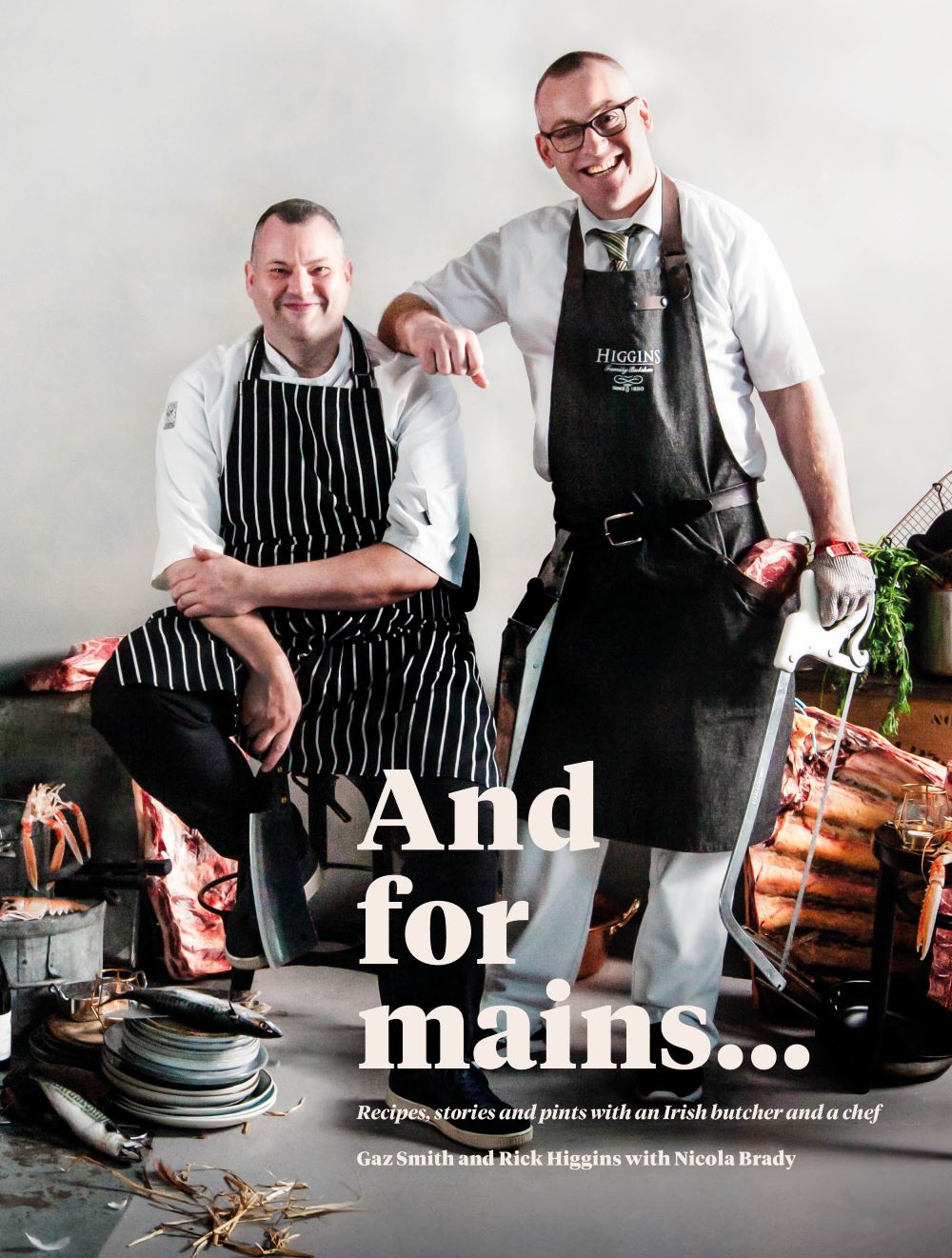 The first thing to say about And For Mains… is that it’s hugely entertaining. It’s not often that I sit down and read a cookbook right through from cover to cover, but that’s what I did with this terrific first cookbook from Gareth (Gaz) Smith, chef and owner of Dublin restaurants Michael's and Little Mike's, and his friend and business partner, fourth-generation butcher Rick Higgins of Higgins Family Butchers in Sutton.
The first thing to say about And For Mains… is that it’s hugely entertaining. It’s not often that I sit down and read a cookbook right through from cover to cover, but that’s what I did with this terrific first cookbook from Gareth (Gaz) Smith, chef and owner of Dublin restaurants Michael's and Little Mike's, and his friend and business partner, fourth-generation butcher Rick Higgins of Higgins Family Butchers in Sutton.
There’s serious intent and no shortage of things to learn, but it comes with stories, banter and fun – including a couple of spoof recipes (it will give you a chuckle when you find them) among the sixty or so wide ranging dishes that, as Gaz puts it, make it a book ‘filled with the kind of things that I love to make’. And, unless you are vegetarian or vegan, you will love to make them too. In fact there’s even something for non-meat eaters, as the terrific áßsalads and side dishes (and maybe the pints that are a recurring feature…) would delight anyone.
Almost everyone in Ireland loves nothing better than a good steak and if you follow Rick’s instructions on How to cook a steak (including the mysteries of the famous Reverse-seared rib of beef) that’s problem solved – sales of digital meat probe thermometers will soar and home cooks will understand better why a good butcher is key to success to this, and so many other cookery conundrums. Rick also gives a butchery masterclass – four tutorials for budding home butchers, and maybe apprentices in the making too. Similarly, Gaz’s love of his restaurants and the enthusiasm of his staff could well inspire many a young person to work in an industry that’s taking a lot of knocks at the moment. The image of the Michael’s crew on page 262 is the face of modern Ireland – and it’s a happy one, comfortable in its diversity.
Journalist Nicola Brady worked on the book with Gaz and Rick and for the most part she keeps a low profile and lets them have their own (unique) voices, but she contributed a couple of excellent chapters under her own byline including a fascinating (and reassuring) account of a visit to the family-run abattoir, O’Gorman Meats of Co Kildare, that supplies Higgins – and an equally illuminating crab fishing trip out of Howth to Lambay.
Photography, by food and lifestyle photographer Katie Quinn and portrait photographer John Murray, plays a key role in making the book come to life - and so does recent Chairperson of the Irish Food Writers’ Guild Kristin Jensen who, incredible as it may seem, joined the team as publisher, editor and proofreader just weeks before it went to print, unexpectedly making this the first project for her new boutique Irish publishing house Nine Bean Rows.
Completing And For Mains… as a pandemic project was an extraordinary achievement and far from the only one undertaken by Gaz and Rick during this challenging time. Among other well-earned accolades, they were 2021 ‘Best Collaborations’ Award Winners in our own recent Irish Food & Hospitality Awards.
And For Mains is available at Michaels Mount Merrion, Little Mikes and Higgins Family Butcher, Sutton; price €40. For online and corporate orders, see https://andformains.ie/
RECIPES TO TRY:
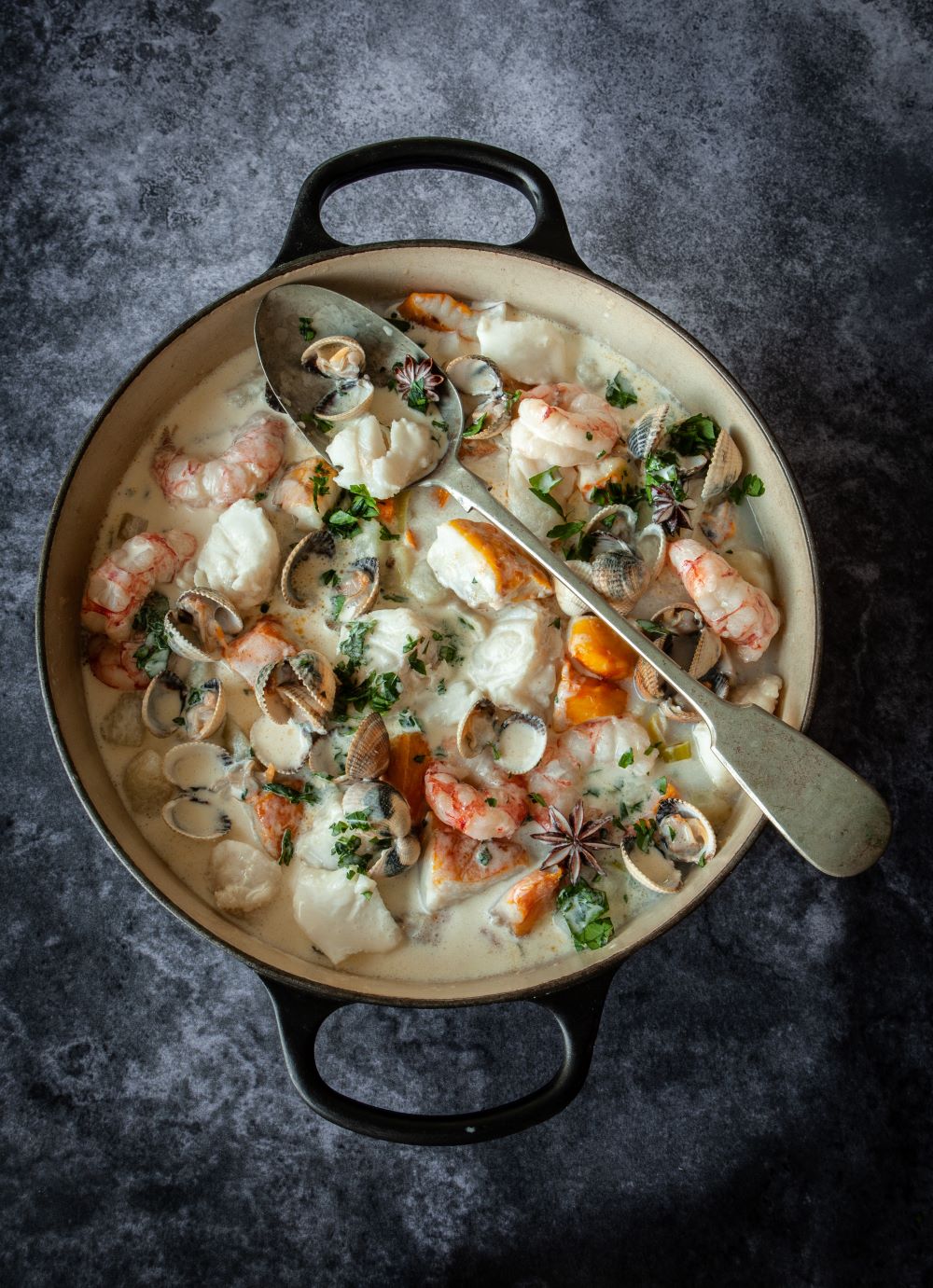 SEAFOOD CHOWDER
SEAFOOD CHOWDER
Gaz says
If I see chowder on a menu, I almost always go for it. And almost single every time, I’m disappointed. A chowder is one of those things that should be so good, but so many people f**k it up. It’s either grey, thick and clumpy or bland and grainy.
The thing is, it’s really easy to get it right. Ours is based on a good fish stock – the only thickener comes from the starch in the potatoes. A really good fish stock is amazing, but don’t worry if you only have a premade one. I’d rather you make this with a stock cube than not at all. Either way, the key is to chuck the fish in for only the last few minutes. That’s how long it takes to cook – if you leave it all sitting in the pot for hours, you’ve ruined the fish.
Our little curveball comes from coriander seeds and star anise, which works so well. It gives a little bit of a different note and makes the whole dish a smidge more fragrant.
Chef’s tip
You can use whatever fish you like, but make sure you use the naturally smoked fish, not that stinky, slimy, orange-dyed gack.
Serves 4 as a starter
Olive oil
1 medium onion, finely diced
100g carrots, peeled and finely diced
100g celery, finely diced
200g potatoes, peeled and cut into 1.5cm cubes
4 garlic cloves, sliced
4 star anise
1 tablespoon coriander seeds
1.2 litres good-quality fish stock (or from a cube is fine)
2 big pinches of fine sea salt
100g leeks, finely diced
150g smoked fish, cubed
100g cockles
100g mussels
100g fresh prawns
80g meaty white fish, diced
200ml pouring cream
Zest and juice of 1 lemon, plus extra juice to finish if you like
A good pinch of finely chopped fresh flat-leaf parsley
A good pinch of finely chopped fresh dill
A good pinch of finely chopped fresh coriander
To serve: Crusty bread
• Get a nice big pot and heat a good glug of oil in it over a low heat. Add your onion, carrots, celery, spuds, garlic, star anise and coriander seeds and sauté for 5 minutes, stirring often.
• Add your fish stock along with two big pinches of salt and bring to a simmer. Cook for 15 minutes, until the veg are slightly softened and the stock is starting to thicken (you can thank the starch in the potatoes for that). Add your leeks and let the whole lot simmer gently for 15 minutes more.
• Raise the temperature to a high heat. Once your base is bubbling, throw in all your seafood and cook for 3 minutes. Turn down the heat to medium, then pour in the cream and cook for a further 2 minutes.
• Take your chowder off the heat, add the lemon zest and juice along with all the chopped herbs and stir to combine. You can also finish off each portion with an extra squeeze of lemon if you like.
• Serve hot with crusty bread.
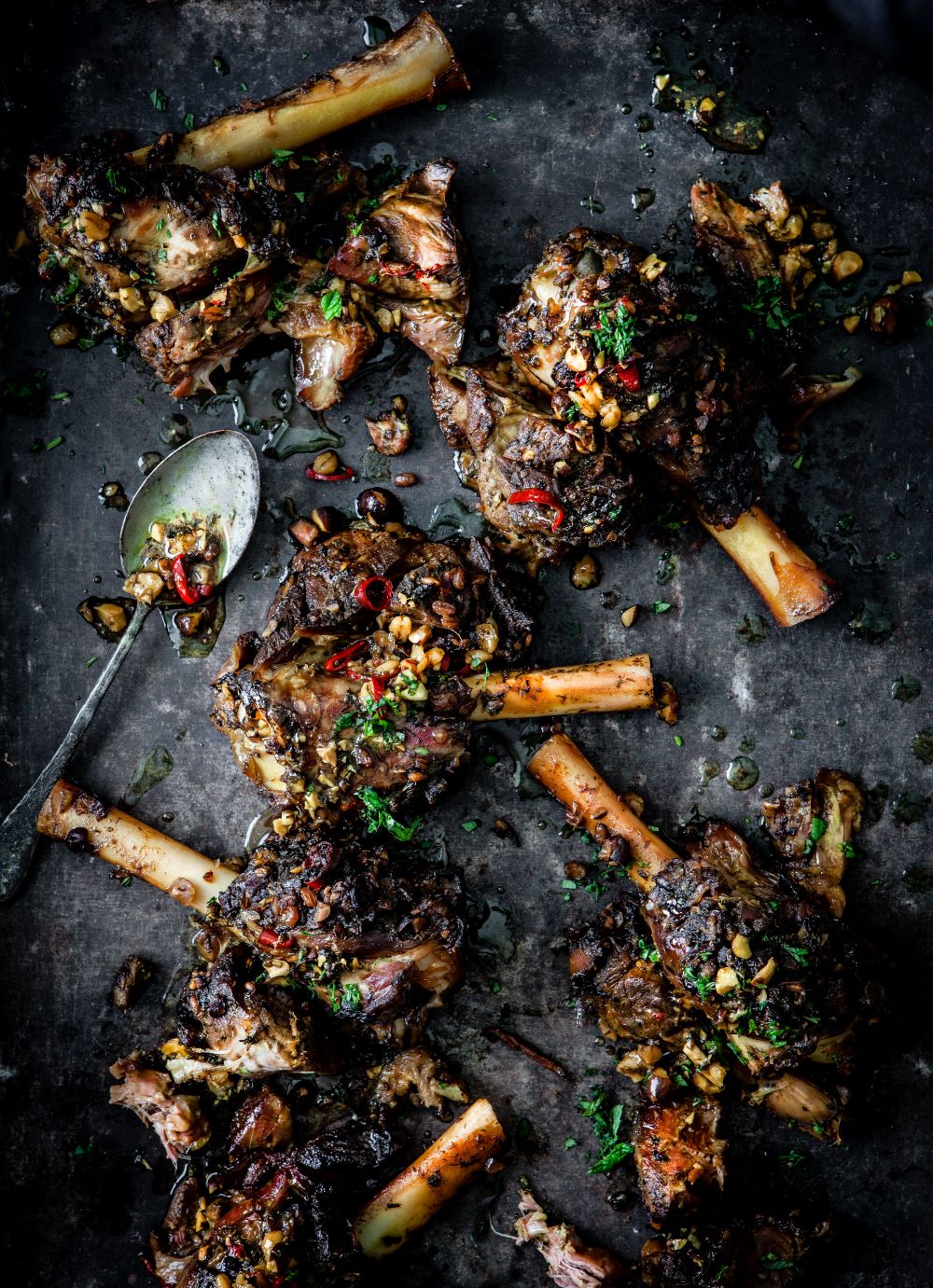 LAMB SHANKS WITH DILL, TURMERIC AND CHILLI
LAMB SHANKS WITH DILL, TURMERIC AND CHILLI
Gaz says
Lamb shanks have fallen out of fashion a little over the last few years, but I don’t know why. They’re super forgiving, lovely and tasty and they’re foolproof to cook too. It’s also a handy way to cook lamb for just one or two people without the faff of roasting a whole shoulder or leg. Just adjust the marinade accordingly.
Chef’s tip
When you’re getting the lamb shanks, ask for the hind legs. These have a much better fat and flavour content. Serves 2
2 hind lamb shanks (see the chef’s tip)
300ml beef stock
For the marinade
4 garlic cloves, minced
2 medium-heat fresh long red chillies, thinly sliced (reserve some for garnish)
1 x 5cm cube of ginger, peeled and finely grated
80ml vegetable oil
2 tablespoons ground turmeric
2 heaped tablespoons chopped fresh dill
2 tablespoons fenugreek seeds
2 tablespoons crushed hazelnuts
1 tablespoon finely chopped fresh mint
4 good pinches of fine sea salt
2 good cracks of freshly ground black pepper
To garnish
Juice of 1 lemon
1 tablespoon chopped fresh dill
1 tablespoon finely chopped fresh mint
A handful of pistachios, shelled and roughly chopped
• Preheat the oven to 200°C.
• Put all the marinade ingredients into a mixing bowl and combine together well. You can also put this in a blender if you prefer.
• Lightly score the skin of the lamb shanks using a small sharp knife in a criss-cross pattern, spaced 2.5cm apart. Rub the marinade all over the lamb, muttering, ‘It puts the turmeric on its skin or else it gets the hose again’ as you do.
• Place the lamb shanks in a baking dish, casserole or a dish that you can cover tightly with tin foil. You need them to be well covered as they cook. Add the beef stock to the bottom of the dish or casserole and cover securely with the foil and/or a lid.
• Roast the shanks in the oven for 1 hour, then reduce the temperature to 160°C and cook for a further 2 hours. If you want to nip off to the pub for a while, turn the oven down to 110°C and cook for 3 hours.
• When you’re ready to serve, give the lamb a final dressing with the lemon juice and scatter the dill, mint, pistachios and reserved chilli on top.
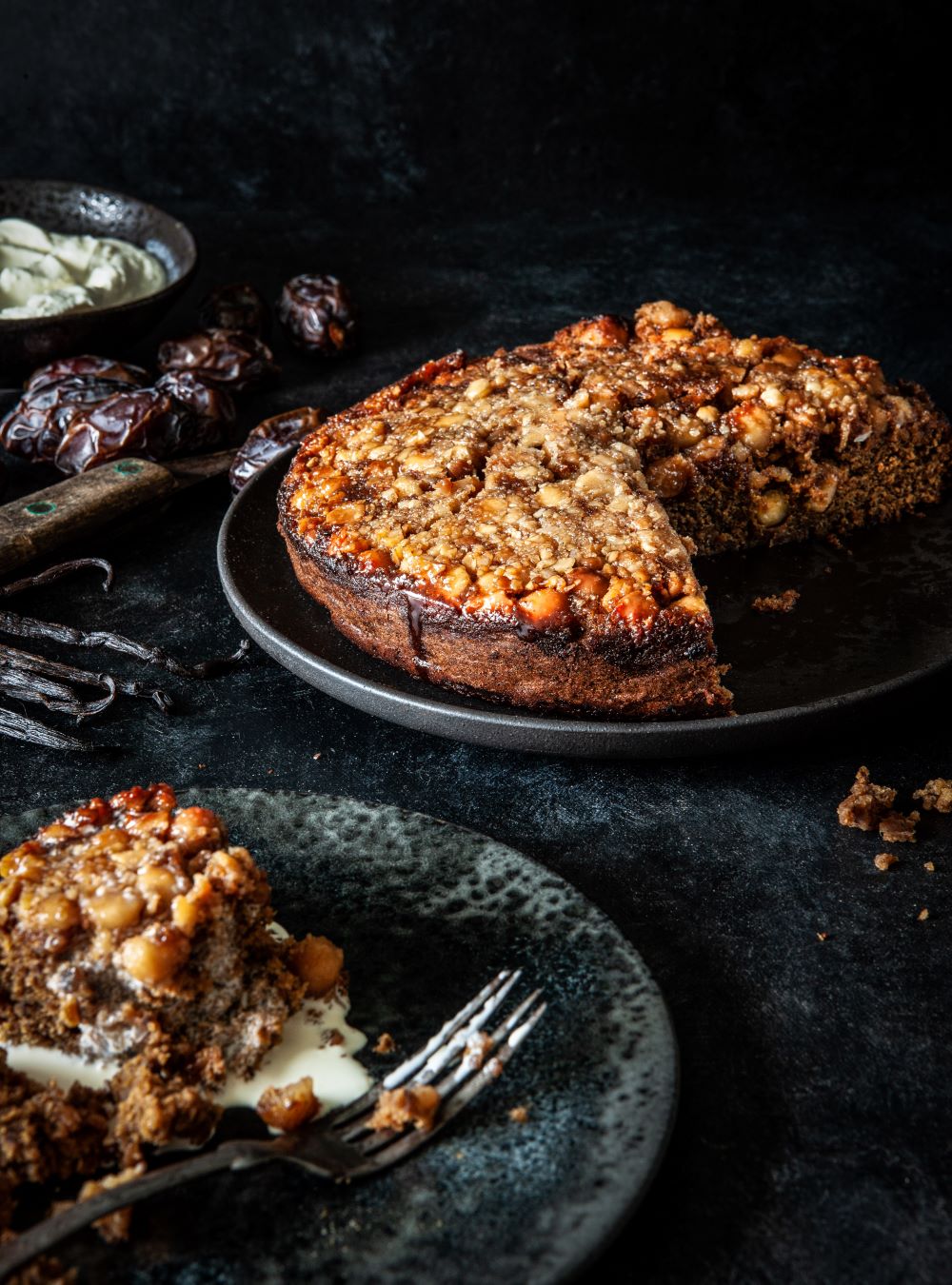 DATE, MAPLE AND MACADAMIA CAKE
DATE, MAPLE AND MACADAMIA CAKE
Gaz says
When I sit down in a restaurant I always pretend to the waiter that I’m not going to have a dessert, which is why I can order two starters instead. Then, when it’s time for dessert, I just hope that he’s graceful enough to pretend that our earlier conversation didn’t happen. Because I’m damn well getting a dessert. And then a cheese course. Maybe another main too.
This is my idea of a perfect dessert. It’s basically a sticky toffee pudding with some macadamia nuts thrown in the mix. There’s no cheffy wankery to – we’re not trying to break the mould here. It’s just about using ingredients that work really f***ing well together.
This is amazing served warm with ice cream or even cold as a cake with an afternoon coffee. If it survives that long, that is. Serves 8
100g macadamia nuts
1 vanilla pod, cut in half lengthways
225g whole Medjool dates, pitted
175ml boiling water
175g self-raising flour, plus extra for dusting
1 teaspoon baking powder
85g butter, softened, plus extra for greasing
140g demerara sugar
2 tablespoons black treacle
2 eggs, beaten
100ml milk
120ml maple syrup
1 teaspoon caster sugar
To serve
Whipped cream or ice cream
• Toast the macadamia nuts in a dry frying pan over a medium heat until they’re lightly golden. Scatter them on a clean tea towel with the sides bunched over or decant into a large ziplock bag and bash them all up with a rolling pin.
• Scrape the seeds from inside the vanilla pod and set aside.
• Put the dates, boiling water and scraped-out vanilla pod into a medium saucepan. Wrap the top of the saucepan with cling film and cover with a lid to create a very tight seal, being careful that the cling film won’t melt over a direct heat. It’s key not to let the water evaporate – the tighter the seal, the nicer your cake will be. If too much water escapes, your cake will end up dry and crappy. Gently simmer for 15–20 minutes, then set aside for 20 minutes to cool.
• Preheat the oven to 180°C. Grease and line a 23cm springform cake tin with non-stick baking paper.
• Sift the flour and baking powder into a big mixing bowl.
• Cream the butter and demerara sugar together in a stand mixer on a medium speed for 4–5 minutes, until it’s light and fluffy.
• Remove the vanilla pod from the dates and discard. Add the treacle to the dates and blitz with a stick blender for 30 seconds, until you’re left with a thick paste.
• Add one-third of the beaten eggs and all the vanilla seeds into the butter and sugar mixture, followed by one-third of the milk and one-third of the flour. Beat well, then repeat the egg–milk–flour process twice more, using a third of the ingredients each time, scraping down the sides of the bowl with a spatula. Add the dates and combine until you’re left with a coarse, somewhat lumpy batter.
• Scatter the toasted macadamia nuts over the base of your lined tin, drizzle with half the maple syrup and sprinkle with the teaspoon of sugar. Spoon the batter over the nuts and spread it out evenly.
• Bake in the oven for 25–30 minutes, until the cake is golden brown on top and a little jiggly to touch in the middle. You want it to be ever so slightly gooey inside. Poke a few holes in the cake and drizzle with the remaining maple syrup.
• Allow the cake to cool slightly before removing from the tin and cutting into slices. Serve with whipped cream or ice cream.
Cookery Feature - A Taste of Spain in Ireland
 (1).jpg)
%20(2).jpg) With all the ‘will we won’t we’ nerves this year, there’s been something comforting about considering alternatives to the traditional celebrations - and looking forward to cooking something unusual after the festive season. Thinking about other cuisines at a time of constraint is liberating, allowing you to travel freely in your head, where there are none of the restrictions that real life journeys currently entail – and re-live happy experiences abroad, or perhaps in atmospheric restaurants that evoke a foreign culture authentically through food.
With all the ‘will we won’t we’ nerves this year, there’s been something comforting about considering alternatives to the traditional celebrations - and looking forward to cooking something unusual after the festive season. Thinking about other cuisines at a time of constraint is liberating, allowing you to travel freely in your head, where there are none of the restrictions that real life journeys currently entail – and re-live happy experiences abroad, or perhaps in atmospheric restaurants that evoke a foreign culture authentically through food.
So where better, or more authentic, to begin than with a book from Jp McMahon’s ever popular restaurant Cava Bodega in Galway, a city that still thrills to its 16th century links with the Spanish Armada. Jp has always been mad about all things Spanish, especially the food, and - although he now presides over the EATGalway restaurant group (which includes the fine dining star, Aniar) and is famed for all sorts of other projects, notably his wondeful annual Food On The Edge international chef symposium – it started with Spain and Cava Bodega has been an ongoing favourite with diners since opening in 2008.
.jpg) In 2014, Jp launched the first edition of his celebration of Irish food and culture, Cava Bodega Tapas, A Taste of Spain in Ireland. Fast forward to 2021 and he has just launched the fourth edition of this much loved book. Offering 110 recipes (including 12 new to this edition) it’s much more than just a recipe book, as it has evolved in tandem with the restaurant and not only features dishes that diners at Cava Bodega have enjoyed over the years but also reflects changes in our own food culture. True to form, while Spanish ingredients used for authenticity where no local Irish equivalent exists, seasonal, local ingredients are used wherever possible.
In 2014, Jp launched the first edition of his celebration of Irish food and culture, Cava Bodega Tapas, A Taste of Spain in Ireland. Fast forward to 2021 and he has just launched the fourth edition of this much loved book. Offering 110 recipes (including 12 new to this edition) it’s much more than just a recipe book, as it has evolved in tandem with the restaurant and not only features dishes that diners at Cava Bodega have enjoyed over the years but also reflects changes in our own food culture. True to form, while Spanish ingredients used for authenticity where no local Irish equivalent exists, seasonal, local ingredients are used wherever possible.
New additions include pinchos like romesco with apple and almond and scallop
and baby fennel with saffron aioli, fish dishes including clams with Salsa
Verde and meat dishes such as a chicken and chorizo skewer with Dillisk crispy
onions and truffle mayonnaise - but many will head straight for the desserts, and the decadent Basque cheesecake… There’s also an introduction to Spanish wines, with a
focus on natural, organic and biodynamic wines, which is fascinating as well as helpful.
Cava Bodega Tapas, A Taste of Spain In Ireland, Fourth Edition, €30, is available from Cava Bodega, Middle Street, Galway; Tartare Cafe + Wine Bar, Lower Dominick Street, Galway; Aniar, Lower Dominick Street, Galway; Charlie Byrne's Bookshop, Middle Street, Galway; and online
ALL RECIPES FROM Cava Bodega Tapas: A Taste of Spain in Ireland by Jp McMahon (4th Edition)
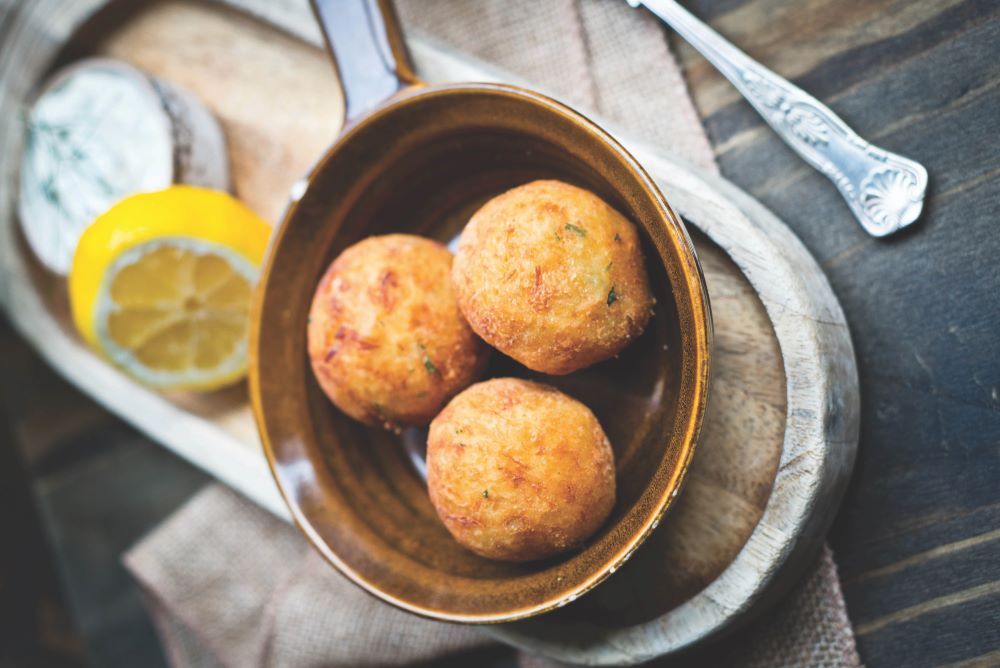 SALTED COD CAKES, LEMON AIOLI (serves 4)
SALTED COD CAKES, LEMON AIOLI (serves 4)
Ingredients
800g potatoes
1 small onion, diced
handful of flat leaf parsley, chopped
flour, for dusting
1 lemon, to garnish
olive oil
Salted Cod
500g cod fillet
sea salt
Lemon aioli
2 egg yolks
1 lemon, juiced
1 tsp Dijon mustard
250ml rapeseed oil
sea salt
Method
1. For the salted cod: Cover the cod liberally in salt (ensure to salt both sides of the fish) and leave in the fridge for 7 days. On the seventh day, remove the cod from the salt and rinse thoroughly. Place the cod in a suitable container and cover with water for 12 hours. During this period, you can leave the cod at room temperature and change the water after 6 hours. After the cod is desalinated, discard the water and place the cod on an oven tray and bake in a 180°C oven for 12 minutes. Remove and allow the cod to cool. When the cod is cold enough to handle, flake the fish, ensuring to remove any bones.
2. Peel the potatoes and place in a pot. Cover with water and bring to the boil, then simmer until a knife can pass through the potato. Do not overcook the potatoes as they will take in too much water. The best thing to do is to remove the potatoes from the heat the minute a knife can pass into the middle of the potato. Strain the potatoes and allow to cool and dry in the sieve.
3. Mash the potatoes. At Cava, we prefer to pass them through a moulin (mouli-légumes/vegetable mill), this gets rid of any tough elements from the inside of the potato. You can pick up a hand moulin from any good kitchen supply store.
4. Fry the onion in a little oil on a low-medium heat. You don’t want the onion to brown, only to become soft and translucent. This should take about 10 minutes on a low heat.
5. In a large bowl, mix together the cod, potato, parsley, and onion. Shape into balls (about the size of a golf ball) and allow to rest in the fridge for 2 to 3 hours.
6. To make the aioli: Place the egg yolks, lemon juice and mustard in a large bowl. Whisk and then begin to add the oil very slowly and gradually. Keep whisking until the oil and eggs have emulsified. Season to taste.
7. Heat your deep fat dryer to 175°C. Roll the cod cakes in flour and gently lower the cod cakes into the oil. Fry until golden brown.
8. To serve: Dry the cod cakes on some absorbent paper. Place the aioli in a ramekin and serve the cod cakes beside them. Garnish with some lemon.
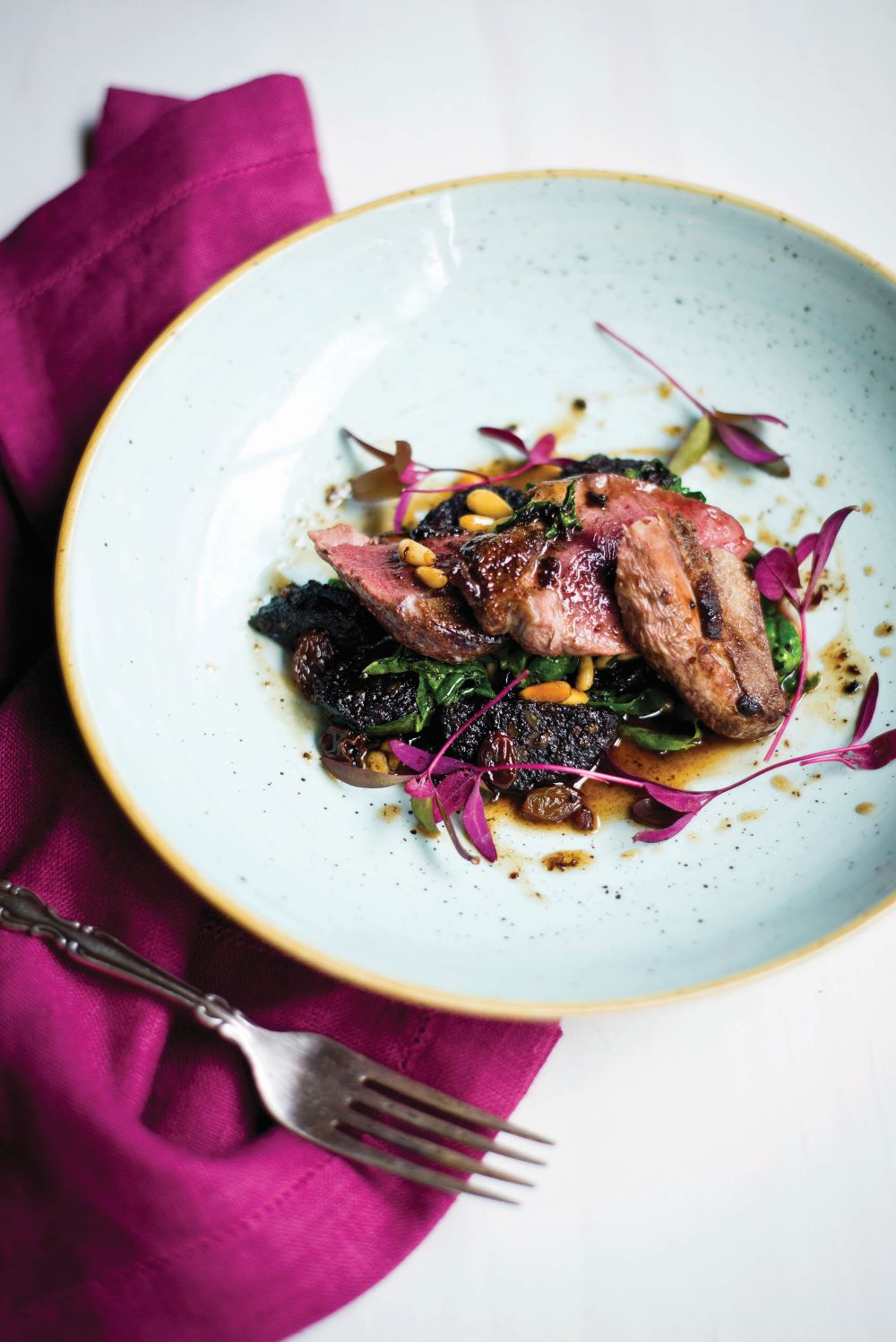 WILD DUCK, BLACK PUDDING, SULTANAS, PINE NUTS, CAVELO NERO (serves 4)
WILD DUCK, BLACK PUDDING, SULTANAS, PINE NUTS, CAVELO NERO (serves 4)
If wild duck is unavailable, farmed duck breats from a producer such as Skeaghanore West Cork Farm; Thornhill Duck, Co Cavan; Rings Farm, Co Kilkenny; or Silverhill Duck, Co Monaghan can be used instead. [GC]
Ingredients
150g black pudding, roughly diced
50g pine nuts, toasted
50g sultanas
100g butter, cubed
a few sage leaves, finely sliced
200ml PX sherry
a small bunch of cavelo nero, stalks removed, cut into squares
4 medium mallard breasts, scored
olive oil
sea salt
Method
1. In a large frying pan, warm some oil. Add the black pudding and pan fry until crispy. Then add the pine nuts and the sultanas. Toss together with 50g of the butter. Add the sage leaves and the sherry and reduce to a thin glaze. At the last moment, add the cavelo nero and toss the lot together.
2. For the duck: Season the duck with salt and allow to come up to room temperature. Heat some olive oil in a suitable pan. When hot, add the duck skin side down and sear until the skin is nice and crispy. Turn the duck over and fry for another minute. Then add the remaining butter and baste. Cook until the butter is brown and foaming. Remove from the heat and check the duck. I find medium-rare is best. If you’re happy with the temperature of the duck, set it aside in a warm area and allow to rest.
3. To serve: Spoon the black pudding mixture into the centre of a shallow bowl. Carve the duck and divide over the four dishes.
.jpg) BEEF CHEEKS, TETILLA, CHICORY, ALMONDS (serves 4)
BEEF CHEEKS, TETILLA, CHICORY, ALMONDS (serves 4)
An ingredient that is more familiar to chefs than home cooks, beef cheek is a tough muscle due to the animal's constant chewing - but it tenderises beautifully through long slow cooking, producing a melt-in-the mouth texture and great flavour. [GC]
Ingredients
1 red chicory, quartered
25g butter
handful almonds, roasted
olive oil
sea salt
Beef cheeks
2 large beef cheeks
1 carrot, peeled
1 onion, chopped
2 celery stalks, chopped
a small handful of flat-leaf parsley
500ml stout
sea salt
Cheese sauce
75g Tetilla cheese rind (you can use a soft cheese rind such as Durrus instead)
350ml vegetable oil
2 eggs
sea salt
Method
1. To cook the beef cheeks: Trim the beef cheeks of all sinew. Season liberally with sea salt and place in an oven proof container. Place the vegetables and parsley around the cheek and cover with the stout. If the cheeks are not covered completely top up with a little water. Place in a 160ºC oven for 3 – 4 hours until completely tender. You will know when they’re done as a knife will pass easily through them. Remove the cheeks and strain the sauce. Reduce the sauce by half or until it coats the back of a spoon.
2. For the cheese sauce: Place the rind in the vegetable oil and leave in the fridge for 1 week. Taste the oil after a week. If it still needs more flavour leave it for longer. Remove the rind before using. Drop the two eggs into boiling water for 3 minutes. Remove immediately after the 3 minutes and place in ice water. Crack the eggs open into a jug. Season with some sea salt. With the aid of a hand blender, blend the oil and the eggs together. This is like a mayonnaise, so be sure to add the oil in gradually. If the sauce gets too thick you can let it down with a little water. Place in a small plastic bottle or a piping bag.
3. Pan fry the chicory quarters in a little butter and oil until soft and wilted. Add the almonds and season.
4. To serve: Slice the beef cheeks and warm in a pot with the sauce. Place the chicory and almond mix on the base and the cheeks on top. Arrange a few dots of the cheese sauce around the beef. Finish with a little grated almond if you wish.
%20(1).jpg) CREMA CATALANA (serves 6)
CREMA CATALANA (serves 6)
Crema Catalana owes its origins to the French classic Crème Brûlée (literally, burnt cream). Sometime in the nineteenth century, Catalan chefs adopted this French dessert (which is made with vanilla) and prepared it instead with lemon, orange, and cinnamon. Traditionally, this dessert was eaten on Saint Joseph’s Day (19th March) although nowadays it is consumed at all times of year. It goes well with Cava Bodega’s almond biscuits.
Ingredients
1 litre cream
2 cinnamon sticks
zest of 1 orange
zest of 1 lemon
6 egg yolks
90g caster sugar
50g brown sugar, for caramelising
2 gelatine leaves
Method
1. Bring the cream to the boil with cinnamon sticks and zest.
2. Upon reaching boiling point remove cream from the stove. Set aside and allow flavours to infuse for 5 minutes.
3. In a separate bowl, add the caster sugar to eggs and whisk until creamed.
4. Pour the warm cream slowly over the eggs. Do not over whisk as you don’t want too much air in the mixture.
5. Set the mixture over a pot of boiling water (bain-marie) and gently warm the mixture until it coats the back of a wooden spoon. This will take about 30 to 40 minutes. Be sure the water does not come into contact with the bowl, or the mixture will curdle.
6. Bloom the gelatine leaves and add to the custard mixture. Strain mixture though a fine sieve and pour into 6 suitable round dishes.
7. Allow to chill for 4 hours in the fridge.
Cookery Feature - Making More Of Oats
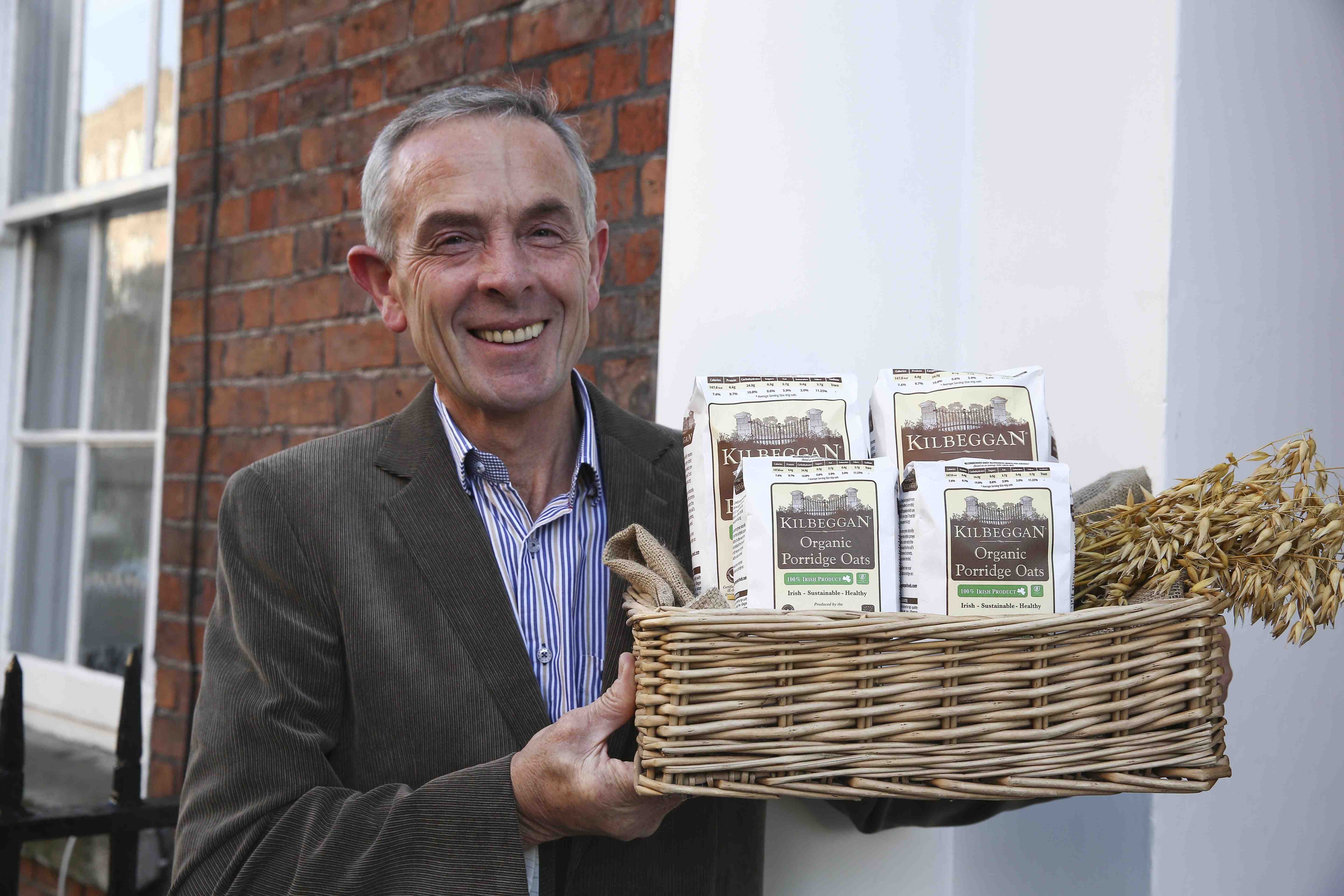
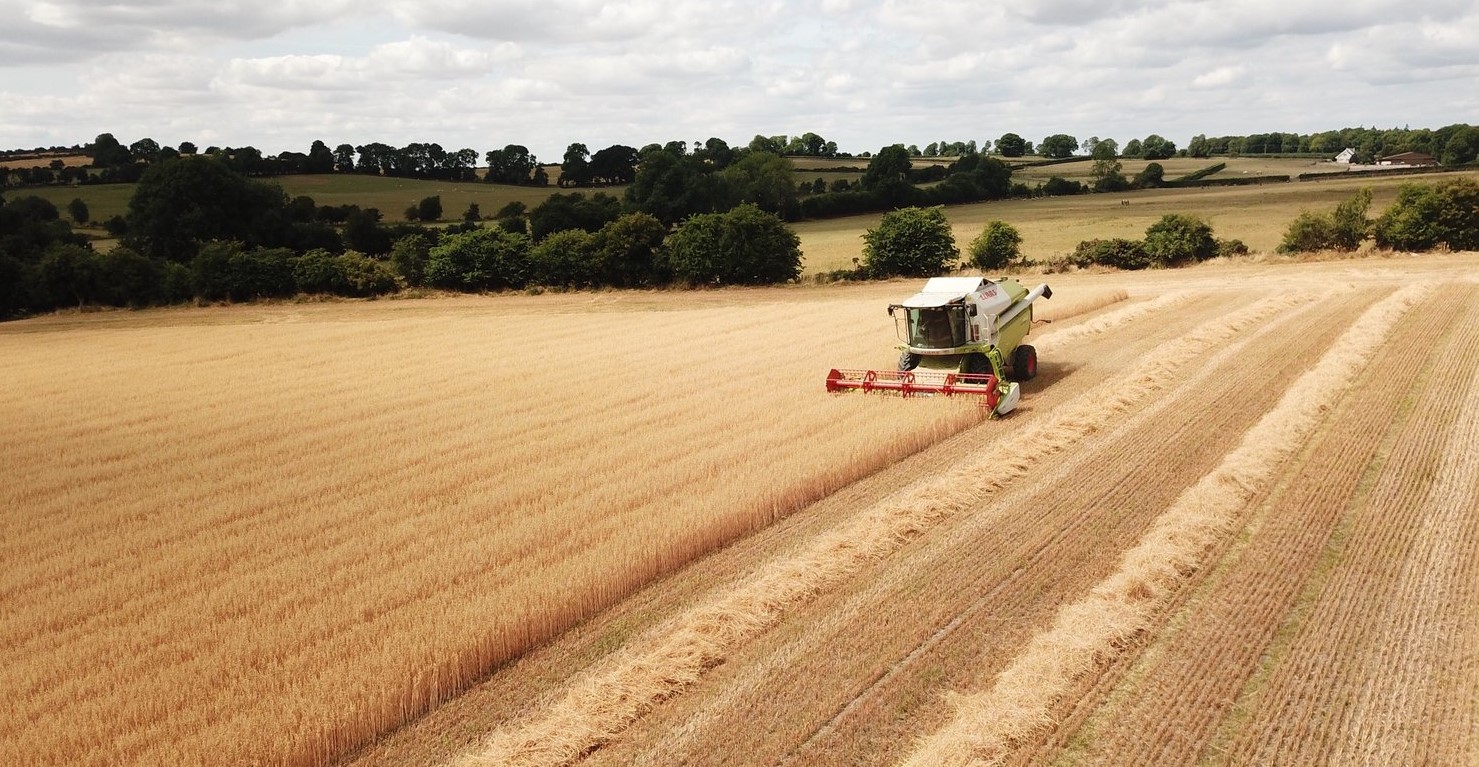
New year, new start - as good resolutions go, you couldn’t do better than resolve to eat more Irish oats. And it couldn’t be easier, or more reasonably priced, so there’s no excuse. The health benefits of oats - including lowering cholesterol - are now well understood and, while it’s an all year product with many uses (see Recipes, below) porridge is the favourite comfort dish to start the day in the colder months. It’s the perfect health breakfast, providing warmth and slow-release energy throughout the morning – ideal for school children, and just about anyone really, especially if taken with a glass of fresh orange juice because the vitamin C in the juice helps the body to absorb the iron in oats. And – good news for dieters - breakfast eaters are less likely to be overweight, as it is less tempting to snack on high calorie foods mid-morning or over-eat at lunchtime.
There are plenty of delicious oats to choose from, with Flahavans the go-to brand for most Irish shoppers. This 7th generation family-run mill has been operating in Kilmacthomas, Co Waterford for over 200 years, making it one of Ireland's longest-running family businesses - and one that has always been operated sustainably. All of their standard oats are produced in Ireland, and they actively encourage more Irish organic oat production to meet the growing demand. Over a million servings of Flahavan's porridge are consumed nationwide each week, apparently, and it is available in a variety of options including Progress, Organic and Real Fruit Porridge ranges and the convenient Quick Oats range. Ever innovative, they also offer a growing range of other oat products, including biscuits, snacks and oat milk drinks.
Macroom Oatmeal is another brand with a long history - it was established in 1832 and the current producer of their famous stone-ground oatmeal, Donal Creedon, is a descendant of the original owners. It has a great following and has been championed by the Allen family at Ballymaloe House for many years. Some other thriving Irish brands are run by growers who have supplied Flahavans as well as producing their own ranges. Pat Lalor, for example, whose Ballard Organic Farm in Westmeath has been owned and operated by the Lalor family since 1844, now produces the very successful Kilbeggan Organic Porridge - and some growers are now also milling. The Scully family at The Merry Mill in Co Laois, for example, produce organic and gluten-free oatlets and oat flour, all of which is grown and stoneground on site - as are the stoneground flour and porridge oats (among other grains) grown and milled and James Kelly of Ballymore Organics in Ballymore Eustace, Co Kildare. Other small producers, many of them organic, are becoming better known all the time and it’s encouraging to see the sector growing and thriving - something that recent moves towards supporting sustainable farming should help.
EASY PEASY PORRIDGE
We cook our porridge overnight and it couldn’t be easier: one cup of oats to three of water and a pinch of salt; leave overnight in a slow cooker or the slow oven of a range type cooker. If slow cooking doesn’t suit you, this quick 3-MINUTE PORRIDGE for 2 can be prepared on the hob or in the microwave. [Tip: Cooking time can be reduced by soaking the oats in the water overnight.]
Conventional Method: In a saucepan, stir 1 cup oatles (or similar) and a good pinch of salt into 2.5 cupfuls cold water/milk or mix of both. Bring to the boil and cook briskly for 3 minutes or until thick and creamy. Flavour if desired and serve.
Microwave Method: In a deep bowl, stir 1 cup oatles (or similar) into 2 cups of water. Place in microwave, but do not cover; cook on High for 2.5 - 3 minutes. The cooking time will depend on the power of the microwave (2.5 mins for 800w or 3 mins for 650w). Leave to stand for 1 minute, stir and serve.
But oats are not just for breakfast… Oats are the key ingredient in so much of our much-loved baking repertoire (breads and scones, cookies, flapjacks, the list goes on…) but they’re really versatile in general cooking and they work especially well in recipes that suit the Irish climate, including many of our traditional dishes.
RECIPES TO TRY:
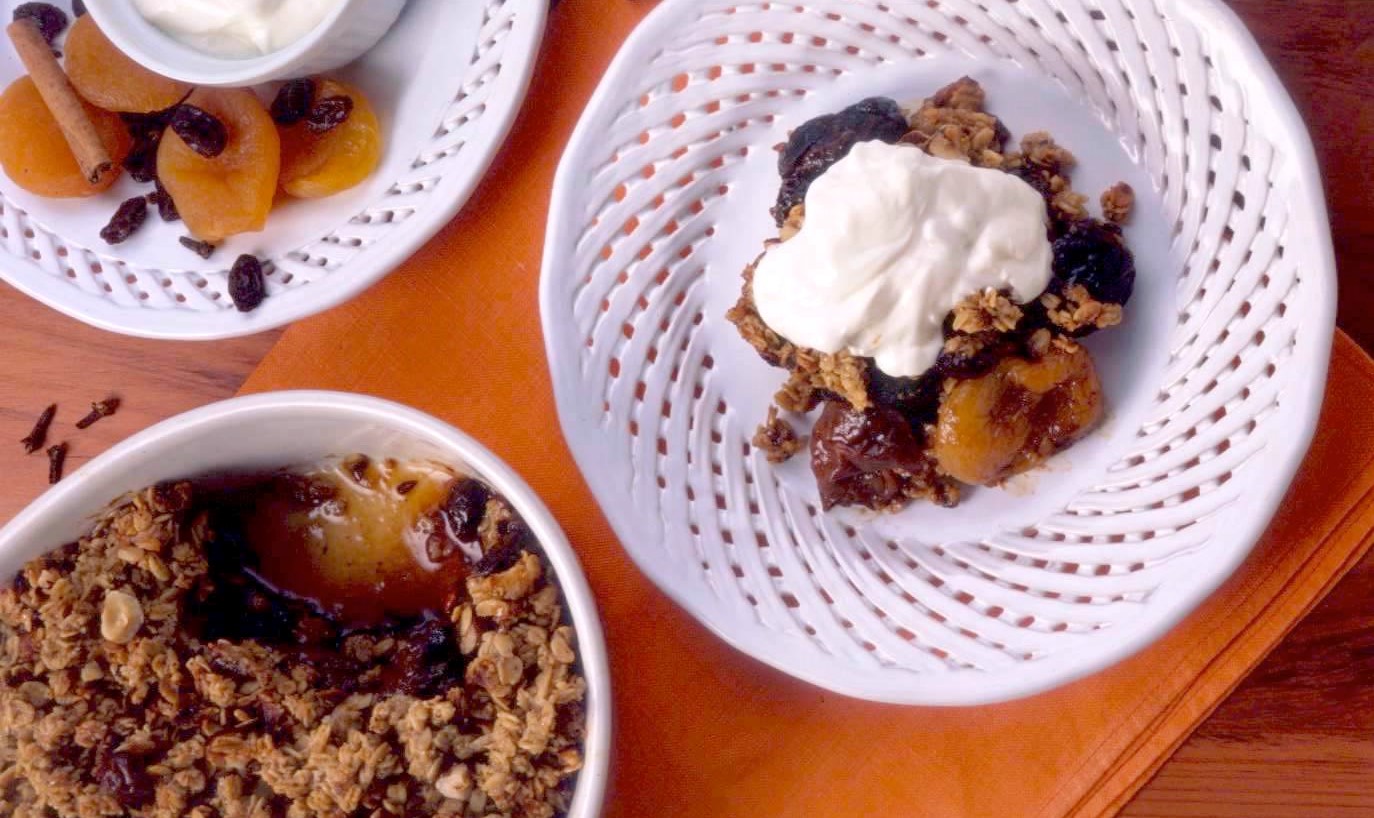
DRIED FRUIT & HAZELNUT CRUMBLE
Dried fruit and nuts are complementary ingredients that make a natural partnership with oatmeal - as in this hot pudding that's as delicious as it is wholesome. This recipe goes back to the 1990s, when the Health Promotion Unit at the Department of Health and Children asked members of the Irish Food Writers’ Guild to contribute a recipe to their Healthy Food magazine, which was a great combination of healthy eating and exercise guidelines, news and favourite dishes. Time to bring it back, perhaps. Serves 4-6
9oz/250g mixed dried fruit salad, e.g. pears, peaches, apples, prunes.
2oz/50g sugar, or to taste
Natural apple juice or water, as required
1 inch/5cm piece cinnamon stick
Grated rind and juice of 1 small lemon
Crumble Topping:
7oz/200g oat flakes
Pinch of salt
3oz/75g butter, melted
3oz/75g Demerara sugar
1 level tsp. mixed spice (optional)
2oz/50g hazelnuts
A few tbsp. water
The day before cooking, put the fruit into a pan with the cinnamon stick, sugar and enough apple juice or water to cover. Bring to the boil, then remove from the heat, add the finely grated lemon rind and the juice, cover and leave to soak overnight. (If you don’t have time for overnight soaking, use this microwave short-cut: in a Pyrex jug bring all to the to boil on High, then reduce to Low and microwave for 15-20 minutes or until fruit is plump and juicy).
Preheat a fairly hot oven 200°C/400°F/Gas Mark 6.
Butter a shallow baking dish.
To make the topping, put all except the last two ingredients into a mixing bowl and mix well. Mix a little water into the crumble mixture, so that it clings together slightly, then mix in the roughly chopped nuts.
Remove the cinnamon stick from the fruit, check prunes, etc., for stones, then arrange dried fruit on the base of the dish, with the juices.
Large pieces, e.g. half pears or peaches, may be cut to bite size if you like.
Scatter the topping over the fruit and bake in the pre-heated oven for 30-40 minutes, or until well-browned and crunchy on top.
Serve hot with chilled natural yogurt, whipped cream or ice cream.
NOTE: A mixture of oatmeal and wholemeal flour (or all wholemeal flour) may also be used. If using pre-soaked ‘ready to eat' dried fruit, less water is absorbed, judge liquids by appearance - the fruit base should be nice and juicy.
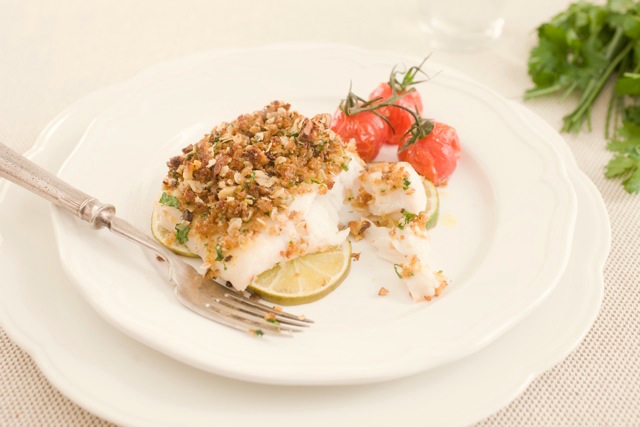
HERB AND OAT CRUSTED HAKE FILLETS
A crispy crust can be the making of a succulent fish dish and this simple recipe, which was developed by Neven Maguire for Flahavan’s Progress Oatlets, is a good one to try. You could also use cod, salmon, haddock or monkfish instead of the hake. Serves 4
4 fillets of hake, skin on
75g (2½ oz) melted butter
a litlle each of grated nutmeg and orange zest
4 slices wholemeal bread
3 tbsp chopped fresh mixed herbs (eg. parsley, chives, thyme)
25g (1 oz) walnuts, toasted and chopped
75g (2½ oz) oatlets
1 egg yolk, beaten
2 limes, sliced (or lemons)
4 small vines of cherry tomatoes (4-5 tomatoes per vine)
Fresh seasonal vegetables or salad to serve.
Melt butter in a saucepan, grate in some nutmeg and add the orange zest.
In a blender, blitz the brown bread to make breadcrumbs.
Mix the breadcrumbs, herbs, walnuts, oats and butter mixture in a bowl to make the herb and oat crust.
Coat the flesh side of the hake with the beaten egg yolk.
Put the herb crust on top of the egg yolk and press into the fish.
Make a bed of lime slices on a parchment lined baking tray.
Place the coated fish (skin side down) on the bed of lime slices.
Bake at 200?C (400°F/Gas mark 6) for 15-20 minutes, with the cherry tomatoes.
When the fish is cooked through and the tomatoes are lightly charred, serve with the lightly cooked seasonal vegetables, or salad.
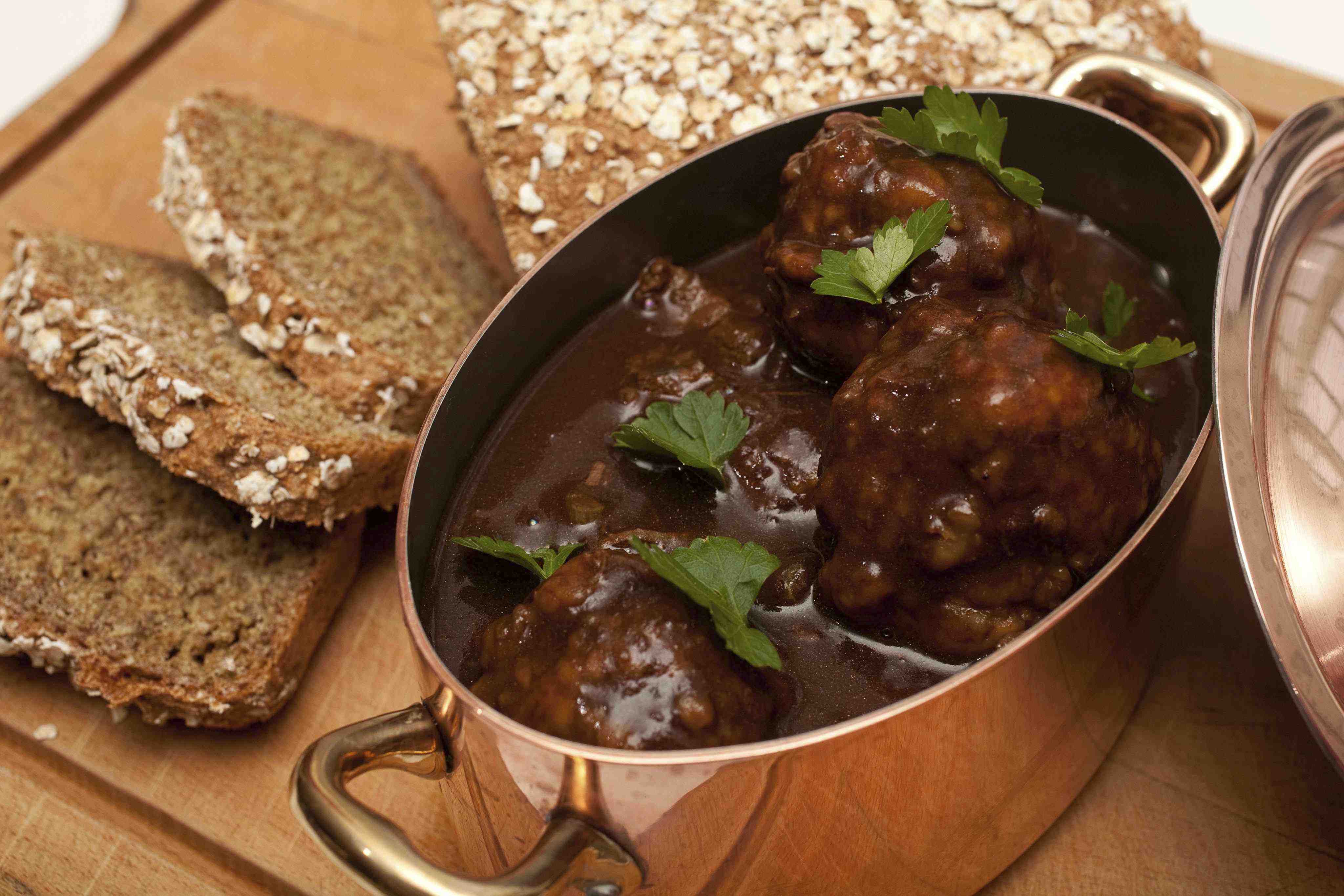
TRADITIONAL BEEF CASSEROLE WITH OAT DUMPLINGS
A nourishing family meal, especially in the cold winter months, this comforting stew will look after itself for an hour or two during the long slow cooking som it is very little trouble to make. It was developed for Flahavans by Kevin Dundon who has a soft spot for the dumplings - which are best made at least 30 minutes before needed and kept in the fridge until required.
[Note: Instructions are for cooking this stew on the hob but, if a flame-proof lidded casserole such as Le Creuset is used, it could also be transferred to a moderate oven approx 160C/140C fan/gas 3, if preferred, after the initial mixing and cooking of ingredients on the hob. GC] Serves 6
Casserole:
700g/ 1lb 8oz lean stewing beef, cut it into small chunks
1 medium onion, sliced
2 carrots, peeled and diced
½ turnip, chopped into small dice
1 parsnip, peeled and chopped
2 sticks celery, diced
25g/1oz/2½ tablespoons plain flour
1 large teaspoon tomato purée
850ml/1½ pints beef stock
Herb Dumplings:
200g/7oz self raising flour
2oz/50g oatlets
50g/ 2oz suet
Pinch of salt
½ medium onion, very finely diced
2 teaspoons freshly chopped parsley
3½ floz/75ml soured milk (approx)
Optional: a little grated cheddar cheese (max 50g/2oz)
Heat a little oil in a large saucepan or flameproof casserole.
Add the chunks of beef, and fry quickly until coloured or sealed all over.
Prepare the vegetables cutting them all into bite size dice similar to the beef.
Add the prepared vegetables (carrots, celery, parsnip, onion, turnip) and mix them in well with the sealed beef; cook for 3-4 minutes until all the vegetables are sealed and glazed in the same way as the beef.
Next add the tomato purée and sprinkle the flour on top of the mixture.
Mix in the flour (to thicken the saucet) ensuring that all the vegetables and meat are covered and coated lightly. Stir over low heat to cook the flour, then stir in the stock and mix well to prevent lumps of flour. Allow the mixture to come to the boil and then reduce the heat to a gentle simmer and cook for 1½-2 hours until the meat and vegetables are tender and the sauce is a nice consistency.
Meanwhile, make the Dumplings:
Mix the flour, oats, suet, salt, finely diced onion and fresh parsley together. Mix well. Gradually stir in enough of the soured milk to make a mixture similar to a soft dough (like a scone). Knead the dough very gently, just until it comes together, and then cut out the dumplings using a cup or a scone cutter. They should be no thicker that ¾ inch/2cm. You may also like to mix in a little grated cheddar cheese in with the dumplings (no more than 50g/ 2oz).
To finish the dish:
About ½ an hour before the stew is ready, add the dumplings. They will take about 25-30 minutes to cook in the stew, which can also be finished in a moderate oven, if you wish, in a casserole dish with a lid.
Cookery Feature - Tacos - A Taste of Mexico in Ireland
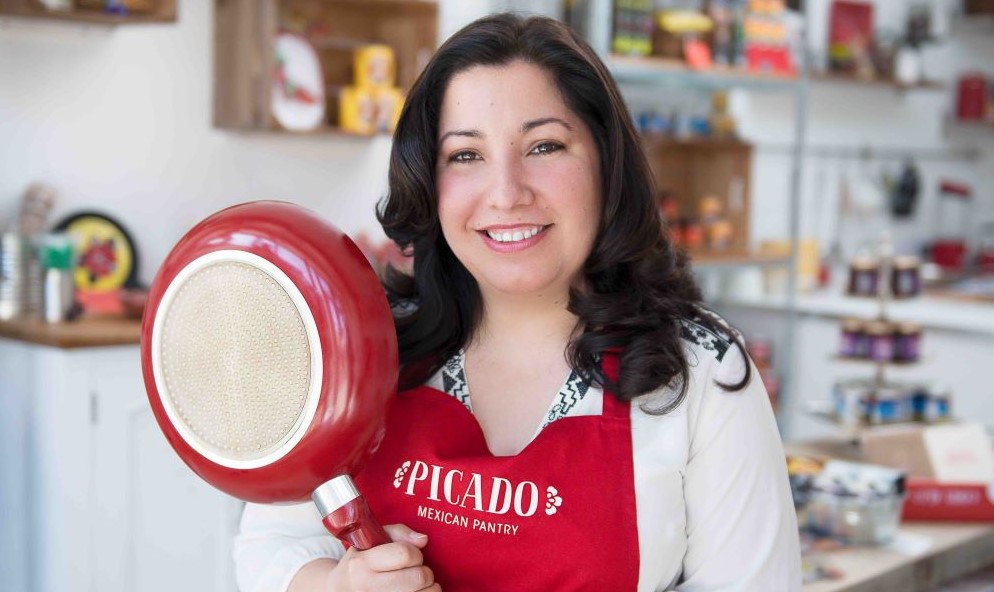
Authentic Mexican food may be in fairly short supply in Ireland but – as the founder of Ireland’s first Mexican boutique grocer and cookery school, Picado Mexican in Dublin, and now author of the first cookbook to be published in Ireland by a Mexican-Irish writer - Lily Ramirez-Foran is on a mission to change all that by showcasing Mexican food beyond its clichés and misconceptions. Lily has been living and cooking in Ireland for 20 years with her Irish husband and business partner, Alan – and her first book, Tacos, is also the first book in the new Blasta Books series, recently launched by the well known Louth-based freelance editor and food writer, Kristin Jensen.
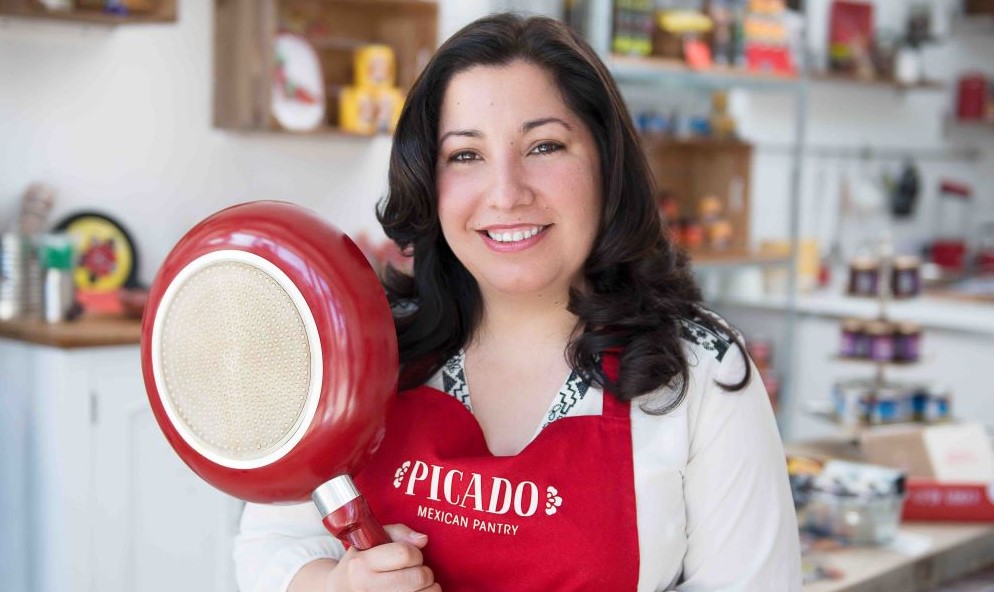
Kristin is also on a mission, in her case to offer an alternative to traditional mainstream cookbooks (‘Blasta Books are to cookbooks what street food is to restaurants, they give people a fun, accessible and affordable way to eat exciting food’) and to prioritise new, previously unpublished voices in Ireland. Described as ‘little books with big voices’, the plan is to publish four books annually (72-page A5 hardcover, all illustrated by Dublin artist Nicky Hooper) and, while each is a standalone cookbook, as a quarterly series they will also provide a more inclusive snapshot of Ireland’s modern and diverse food culture.
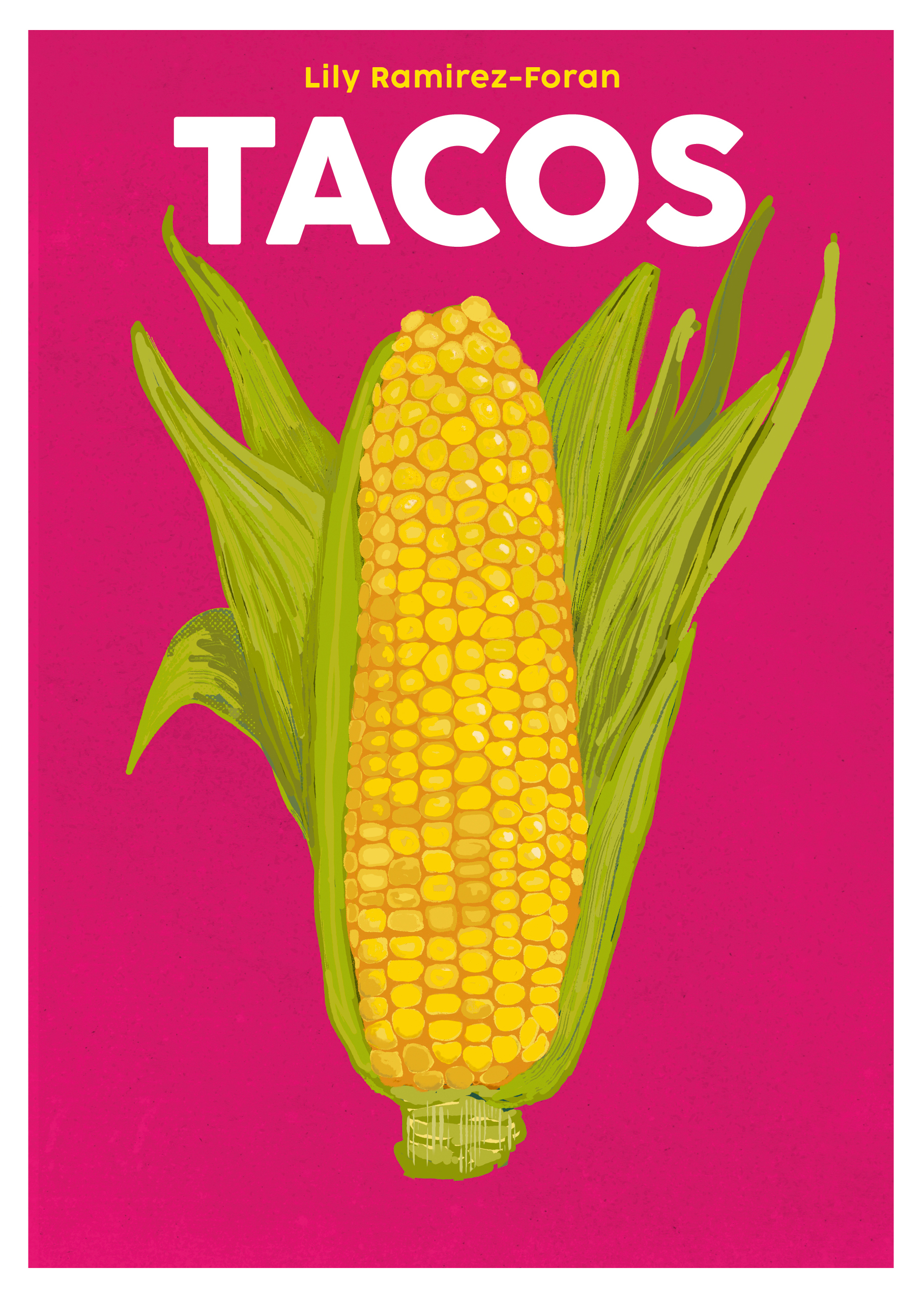
To illustrate the point about diversity and the need for an alternative to traditional cookbook publishing, the next three books in the Blasta Books pipeline are Hot Fat by Russell Alford and Patrick Hanlon; The United Nations of Cookies by Jess Murphy and Eoin Cluskey; and Wok by Kwanghi Chan. The diversity is exciting but what may come as a surprise, given that all of those authors are very well known in Irish food circles, is that none has a cookbook to their name as yet. So, plenty to look forward to and, meanwhile, Lily Ramirez-Foran’s Tacos is available online and from bookshops now and it’s laying a great foundation for the series.
As many will already know from her classes and frequent radio and TV and appearances, Lily loves nothing better than sharing how fun, vibrant and convivial Mexican food is and how easy it is to make at home. So what better way to do that than with tacos? These are the authentic flavours of Mexico, from real corn tortillas to smoky chillies, matched with the best of Irish produce. Lily is direct and very engaging and there is something for everyone here, whether you’re a carnivore, vegetarian or vegan – and there is an extra feel good factor too, as 1% of the net profits from all sales of books and merchandise from now until the end of 2022 will go to UNHCR, the UN Refugee Agency.
Tacos (€15) is published by Blasta Books (blastabooks.com). Buy from good booksops or online from Blasta Books
SAMPLE RECIPES
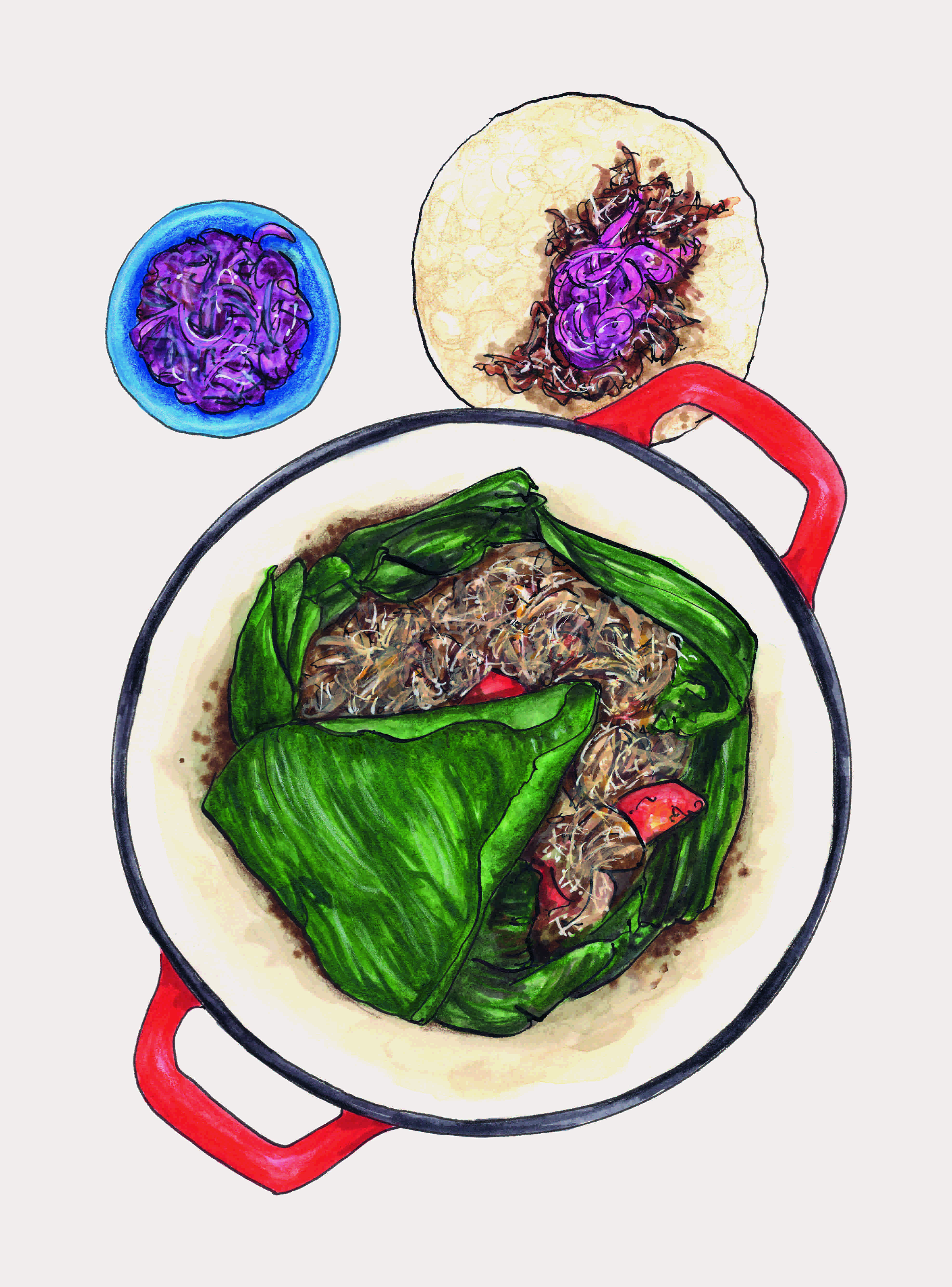 Pork pibil tacos
Pork pibil tacos
Serves 4–6
I always think of pork pibil as the dish that conquered Irish hearts: first the hearts of my Irish family, and later on the hearts of every person who came to Picado’s tortilla class and fell in love with its simplicity and wonderful flavours. I normally make mine in a pressure cooker, which, together with a blender, is an essential item in every Mexican kitchen. However, I wanted to create a slow-roasted version of the dish. I dare you not to fall in love with this recipe too.
1kg pork shoulder, skin left on, cut into three chunks
350g ripe tomatoes, cut into quarters
1 small onion, peeled and cut into quarters
5 large garlic cloves, peeled and left whole
1 x 7cm Mexican cinnamon stick
½ tsp black peppercorns
50g Mexican achiote paste
75ml apple cider vinegar
juice of 1 large orange
1½ tsp flaky sea salt
80ml water
FOR THE TACOS:
16 corn tortillas, warmed
de árbol salsa roja
red onion pickle
Preheat the oven to 150°C.
Place the pieces of pork in a large heavy-based casserole, skin facing up so it doesn’t stick. Add the tomato and onion quarters, wedging them in between the pieces of meat and on the top. Set aside.
Place the whole garlic cloves in a hot, dry frying pan over a high heat, turning them every minute or so – the aim is to have lovely golden garlic with plenty of charred bits and a sweet smell. This will take about 6 minutes. Halfway through, add the cinnamon stick to the same pan and toast it for 2–3 minutes before adding the peppercorns and toasting for 1 minute more, until they are fragrant. The kitchen should smell beautiful by now.
Transfer everything from the pan to a blender followed by the achiote paste, apple cider vinegar, orange juice, salt and 40ml of the water. Blend until smooth, then pour the sauce over the meat in the casserole. Use the remaining 40ml of water to rinse any leftover sauce out of the blender and pour this into the casserole too.
Cover with a piece of parchment paper cut to fit your casserole and cover the casserole with its lid. Transfer to the oven and roast for 3½ hours.
Take the casserole out of the oven and uncover the meat. Everything should be soft so, using two forks, shred the meat and crush the tomatoes and onions, making sure to mix everything together – there should be enough sauce to coat everything well. I normally just carry the casserole to the table and let the meat rest and soak up all the flavours of the sauce while I get everything else together.
Set the table and bring over bowls of the de árbol salsa roja and red onion pickle to add a little heat. To assemble your tacos, add some pork to a warm corn tortilla, then spoon over some of the salsa and red onion pickle.
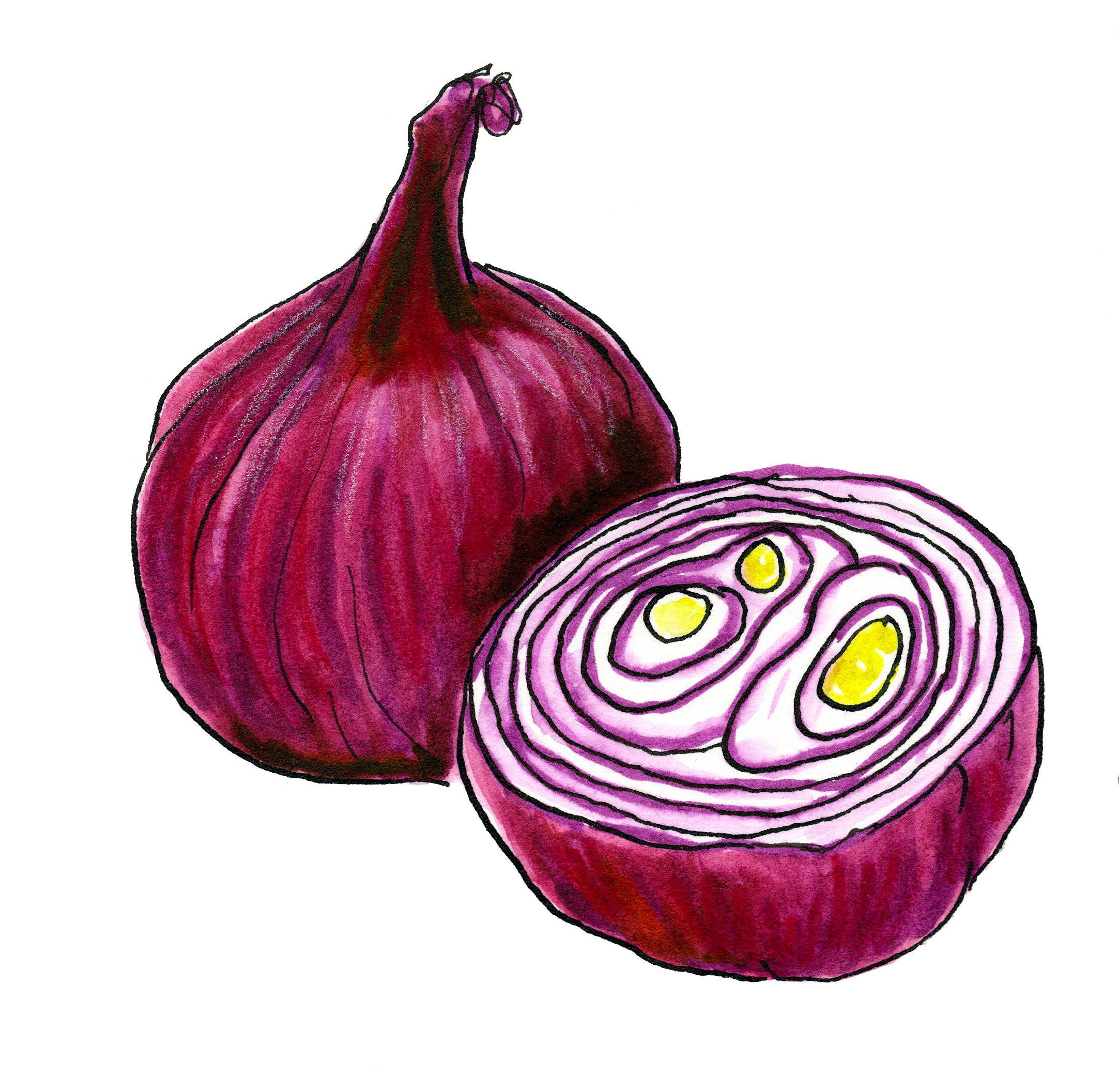 Red onion pickle
Red onion pickle
Serves 4–6
Hand on heart, this is the quickest and easiest pickle you’ll ever make. It’s traditionally served with pork pibil tacos or any other pibil-style dishes. The acidity of the pickle combined with the sweetness of the onion cuts through the fattiness of the pork – it’s a match made in heaven. If you are worried about heat, use only a quarter of a habanero chilli or leave it out altogether, it tastes good with or without it. This pickle is also delicious in cheese sandwiches or with a steak.
2 small red onions, peeled
½ small red habanero chilli (optional)
60ml extra virgin olive oil
60ml apple cider vinegar
¼ tsp dried Mexican oregano
½ tsp flaky sea salt
½ tsp freshly ground black pepper
Cut the onions in half lengthways from tip to root and slice them thinly, making sure every slice is the same thickness. Cutting the onion lengthways instead of around the ‘equator’ like you might usually do may feel a little unnatural, but if you are doing this by hand with a knife (as opposed to using a Japanese mandolin, like I do), you’ll notice that it’s easier to get slices that are a consistent thickness, which is of paramount importance for this recipe. If you have variations in thickness, you’ll find that the slices pickle at different times so you will have some soft slices and some that are still crunchy. But every food processor comes with a slicing disc that will do all this for you.
Thinly slice the habanero chilli (if using), making sure to wash your hands well with plenty of cold water and soap both before and after touching the chilli. I don’t bother deseeding the chilli (no self-respecting Mexican would!), but if it makes you feel better, go ahead and deseed it – just be warned that doing so doesn’t get rid of the heat.
Boil your kettle and put the sliced onions and chilli in a medium-sized heatproof glass bowl (or something non-reactive). Pour the boiling water over the onions and chilli until they are all covered. Soak for 2–3 minutes – this partly cooks the onions and takes out some of their harshness. Set aside while you get the pickle going.
Combine the oil, vinegar, oregano, salt and pepper in a glass jug and mix with a small whisk or fork until well combined. Taste and check the seasoning – it should be sharp and well-seasoned, so add a little more salt and pepper if needed.
By now your onions should be almost translucent and the water should look a little cloudy. This is a sign that the onions are ready, so carefully strain the contents of the bowl, making sure to get rid of as much water as possible. Return the onions and chilli to the warm bowl – this is super important! Don’t use a clean bowl. You need the same bowl that you soaked the onions in, as it’s hot and that will help with the pickling.
Give the pickling liquid one final whisk and immediately pour it over the hot onions and chilli. The heat of the bowl and the heat of the onions will help the liquid to emulsify and it will kickstart the pickling process. Mix everything well with something non-reactive, like a rubber spatula or a wooden spoon, making sure everything is coated with the pickling liquid. My grandmother always warned us not to work with vinegar and metal utensils, as they may react chemically. A lot of the metals are now okay to use, but I keep the tradition just in case!
Set aside, uncovered, at room temperature for 1½–2 hours, stirring every half hour or so. As the onions pickle, you’ll see them getting pinker and softer. I don’t cover the bowl until its contents are completely cold. If you cover it while it’s pickling, it might sweat and the condensation will drop back into the pickle, adding unnecessary moisture to the recipe, or worse, creating an environment where bacteria could grow.
If I have leftovers, which rarely happens, I store them covered with a cheesecloth or a thin tea towel in the coolest part of the kitchen (not in the fridge) for two days max. The fabric cover allows the pickle to breathe and prevents cross-contamination. I never bother bottling this pickle in sterilised jars as it’s so easy to make a fresh batch and it tastes better.
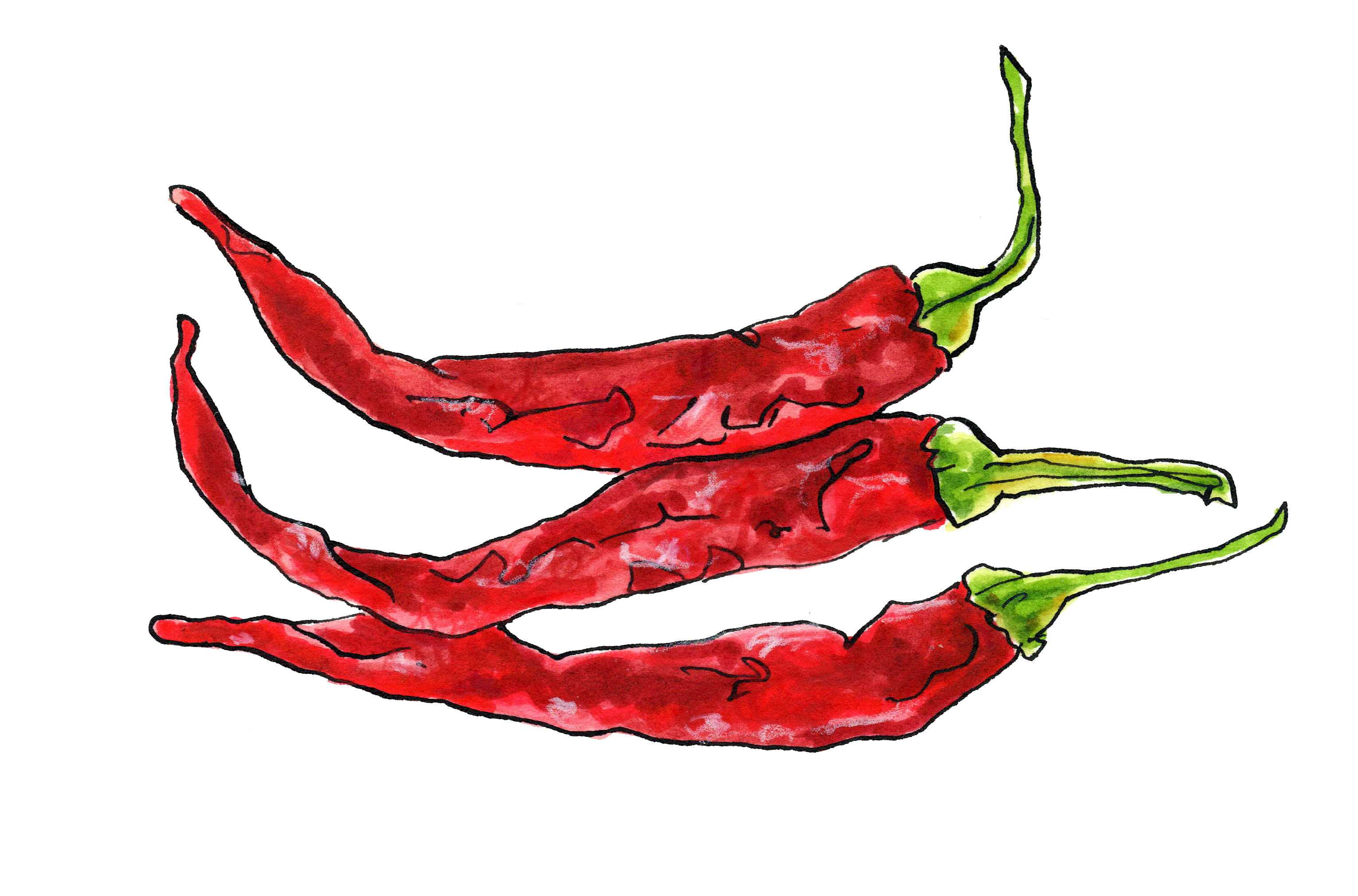 De árobl salsa roja
De árobl salsa roja
Serves 4–6
This is the salsa we make at home when we want something tasty that goes with loads of things. It’s great on eggs, steamed potatoes or with tortilla chips. You can make it as hot or as mild as you want by adjusting the amount of chilli in it – using 5 grams of dried de árbol chillies makes a medium-hot salsa (well, it’s medium-hot to me anyway!). The secret is to cook it in a small pan with a tight-fitting lid; trust me on that.
2 tsp olive oil
450g medium-sized ripe vine tomatoes
5g dried de árbol chillies
2 spring onions, ends trimmed
1 large garlic clove, peeled and left whole
1 vegetable stock cube
1 small bunch of fresh coriander
flaky sea salt, to taste
Heat the oil in a small non-stick frying pan (one with a tight-fitting lid) over a high heat. Add the tomatoes, chillies, spring onions and garlic. You might need to cut the spring onions in half so that they fit in the pan, but everything else goes in whole. As soon as it starts to sizzle, cover the pan with its lid and lower the heat to medium.
Set a timer for 20 minutes and resist the temptation to lift the lid during this time. This is super important, as the condensation that builds up inside the pan goes into the lid and then drops back into the tomatoes, showering them with moisture and giving your salsa the right consistency.
Once the timer goes, your tomatoes should have burst a little and be fully cooked. Transfer the contents of the pan, including every bit of juice and oil, into a blender or food processor. Add the stock cube and the coriander (stems and all) and blend everything together until you have a smooth, creamy salsa. Check for seasoning and adjust as necessary. I never add salt to this salsa until I taste it first, as some stock cubes can be quite salty.
This salsa lasts for a week in the fridge, covered. I don’t particularly like freezing tomato-based salsas, as the texture is never right afterwards, so if you have leftovers, think of creative ways to use it in your meals. It’s so good, you won’t have a problem!
Recipes from Blasta Books #1: Tacos by Lily Ramirez-Foran €15, published by Blasta Books blastabooks.com
Cookery Feature - Easter Gathering
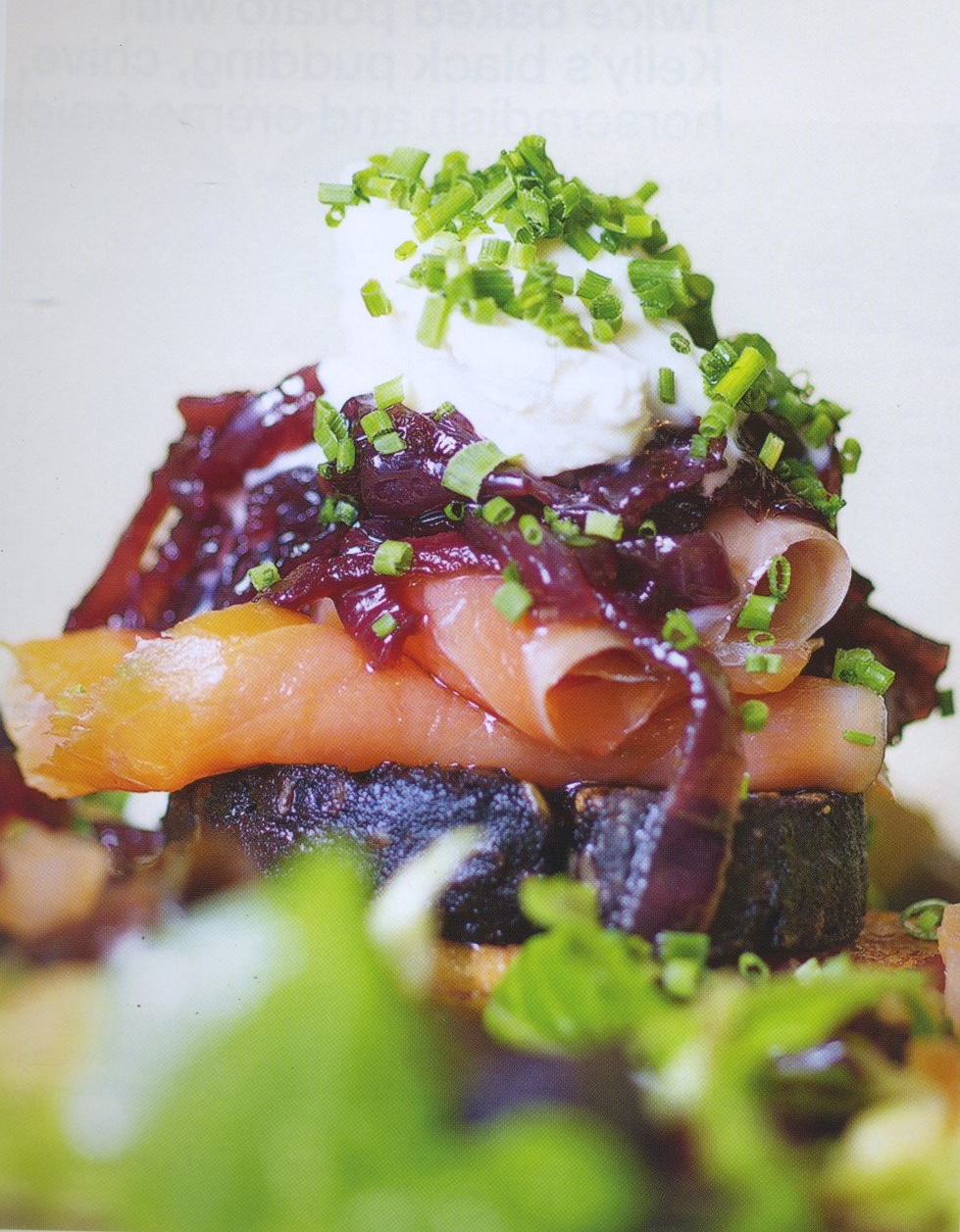
Even though international events mean that celebrations are touched with sadness this year, Easter is always a great time to get together around the table with family and friends if at all possible - and there is something very comforting about sharing traditional food and favourite recipes.
A very late Easter brings more choice of local foods to enjoy for a special meal, as the season is more advanced. I generally prefer to wait until later in the season to buy lamb for roasting - when the joints are bigger, more flavoursome (and better value) - but if you’re cooking for a small number this might be the year to push out the boat. Irish spring lamb would certainly be a treat centrepiece for any meal, and there will be more early vegetables than usual to enjoy with it as well. For a larger gathering, new season lamb may not be a practical choice, as it will still be small and priced accordingly, but good butchers will have hogget (one year old) which would be ideal where a bigger joint is needed to serve a hungry family, and perfect for the tried and trusted main course below. These recipes combine to make a traditional menu of old favourites that are not too demanding on the cook - and it’s not just for Easter of course.
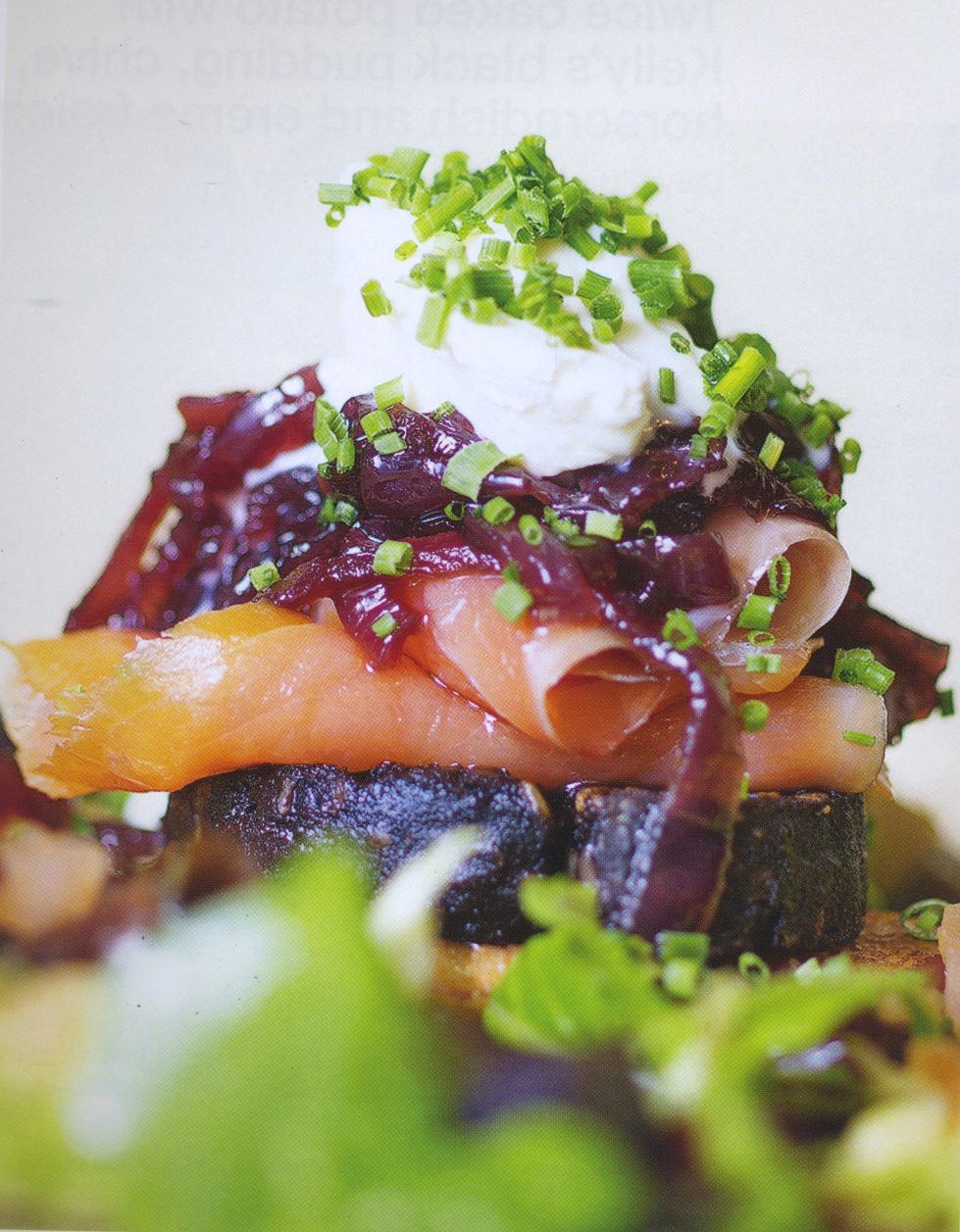 Achill Island organic smoked salmon with Kelly's black pudding, red onion marmalade and crème fraiche, with warm boxty
Achill Island organic smoked salmon with Kelly's black pudding, red onion marmalade and crème fraiche, with warm boxty
A lovely starter from Frankie Mallon, of the popular Westport restaurant An Port Mór, who contributed the recipe to the Kelly’s of Newport book, The Proof is in the Pudding (€15 from Mayo Books). Boxty is made in-house at An Port Mor (and can be made at home of course, see below), but it is also produced by a number of businesses including Dromod Boxty and widely available to buy.
4 pieces of boxty (recipe below)
400g smoked salmon
400g black pudding
400g of red onion marmalade
100ml crème fraiche
50g chopped chives
mixed salad leaves
Place the boxty in the centre of a serving dish. Pan fry the black pudding for 2 minutes on each side and place on top of the boxty.
Place the smoked salmon on the black pudding. Warm the red onion marmalade in a small pan and place a tablespoon on top of the smoked salmon.
Mix the crème fraiche with the chopped chives and spoon on top of the red onion marmalade. Dress the salad leaves with a little vinaigrette and arrange around the plate and serve.
Boxty
A potato speciality of North-West Ireland, there are several varieties - boxty bread or cakes (‘boxty on the griddle’), boxty pancakes (‘boxty on the pan’) and boxty dumplings. This recipe for ‘boxty on the pan’ is from my cookbook, The Best of Irish Breads & Baking. The quantities are just a starting point as, like so many traditional Irish dishes, the recipe is endlessly variable - the milk and flour can be adjusted depending on how thin you like your pancake and cooked mashed potato can also be included, but enough milk must always be added to form a dropping consistency. This quantity will make more than enough for the smoked salmon starter above but any left over can be used another time - delicious with free range rashers for breakfast.
Makes about 4 pancakes, depending on the size of pan used.
l lb/450g potatoes
About ¼ pint/150ml milk
2-3 oz/50-75g flour
Salt to taste.
Peel and chop the potatoes, then process in a blender or food processor until the potato is thoroughly liquidised. Add flour and enough milk to give a dropping consistency. Season to taste with salt.
Heat a little butter or dripping on a griddle or cast-iron frying pan. Pour about a quarter of the mixture onto the pan - if the consistency is correct it will spread evenly over the pan. Cook over moderate heat for about 5 minutes on each side, depending on the thickness of the cake.
 Roast Leg of Lamb with Honey Orange Glaze, Redcurrant & Mint Dressing and Boulangère Potatoes
Roast Leg of Lamb with Honey Orange Glaze, Redcurrant & Mint Dressing and Boulangère Potatoes
Based on a popular Bord Bia recipe, this easy roast would be ideal for a family gathering over Easter and is also perfect for Sunday lunch at any time of year. To serve a large number it would not be new season lamb of course, but hogget (last season’s lamb), which can be bought from good butchers and may be available online (from Achill Mountain Lamb, for example). Shoulder of lamb, which is especially tender and sweet-flavoured and makes a lovely roast, could be used instead for a smaller group of about 6 people.
Serves 8-10
1 good-sized leg of lamb, trimmed
3 cloves garlic, sliced
Few sprigs of rosemary
2 onions, roughly chopped
1 head of garlic
2 cloves garlic, crushed to a paste with some salt
Rind of 1 orange
2 tbsp runny honey
2 tbsp olive oil
Glass of white wine (or cider)
Redcurrant & Mint Dressing
4 tbsp redcurrant jelly
Juice of 1 orange
Dash of port or red wine (optional)
Few sprigs of mint
Preheat the oven at 200°C (400°F) Gas Mark 6.
Make about 10 incisions in the lamb with a sharp knife. Push a sliver of garlic and a sprig of rosemary into each hole. Place the lamb in a roasting tray with some chopped onions and a head of garlic cut in half. Mix together the crushed garlic, orange rind, honey and olive oil. Spread the mixture over the lamb. Place in the oven and roast for 30 minutes. Then add the glass of wine (or cider) and a glass of water (this will stop the honey from burning). Reduce the oven temperature to 180°C (350°F) Gas Mark 4 and continue the cooking for another hour for pink lamb. Rest for 15 minutes before serving.
When the lamb is cooked, remove it from the roasting tray and strain the juices; keep the garlic to serve with the lamb. To the juices, add another dash of wine and a tablespoon of redcurrant jelly. Boil it up to make a jus, finish with a knob of butter and taste for seasoning.
To make the dressing, gently heat the redcurrant jelly, orange juice, wine (if using) and mint. Add a little lemon juice if you think it is too sweet. Serve warm with the sliced lamb.
Boulangère Potatoes are very good with the roast lamb and can be cooked in the oven at the same time. Simply layer some thinly sliced potatoes in a baking dish with thinly sliced onions which have first been sautéed in a knob of butter. Add seasoning and a few more knobs of butter as you do the layers. Finish off with some chicken stock and a sprinkling of grated cheese. Bake for 40-50 minutes until the potatoes are tender and the topping is golden and crispy.
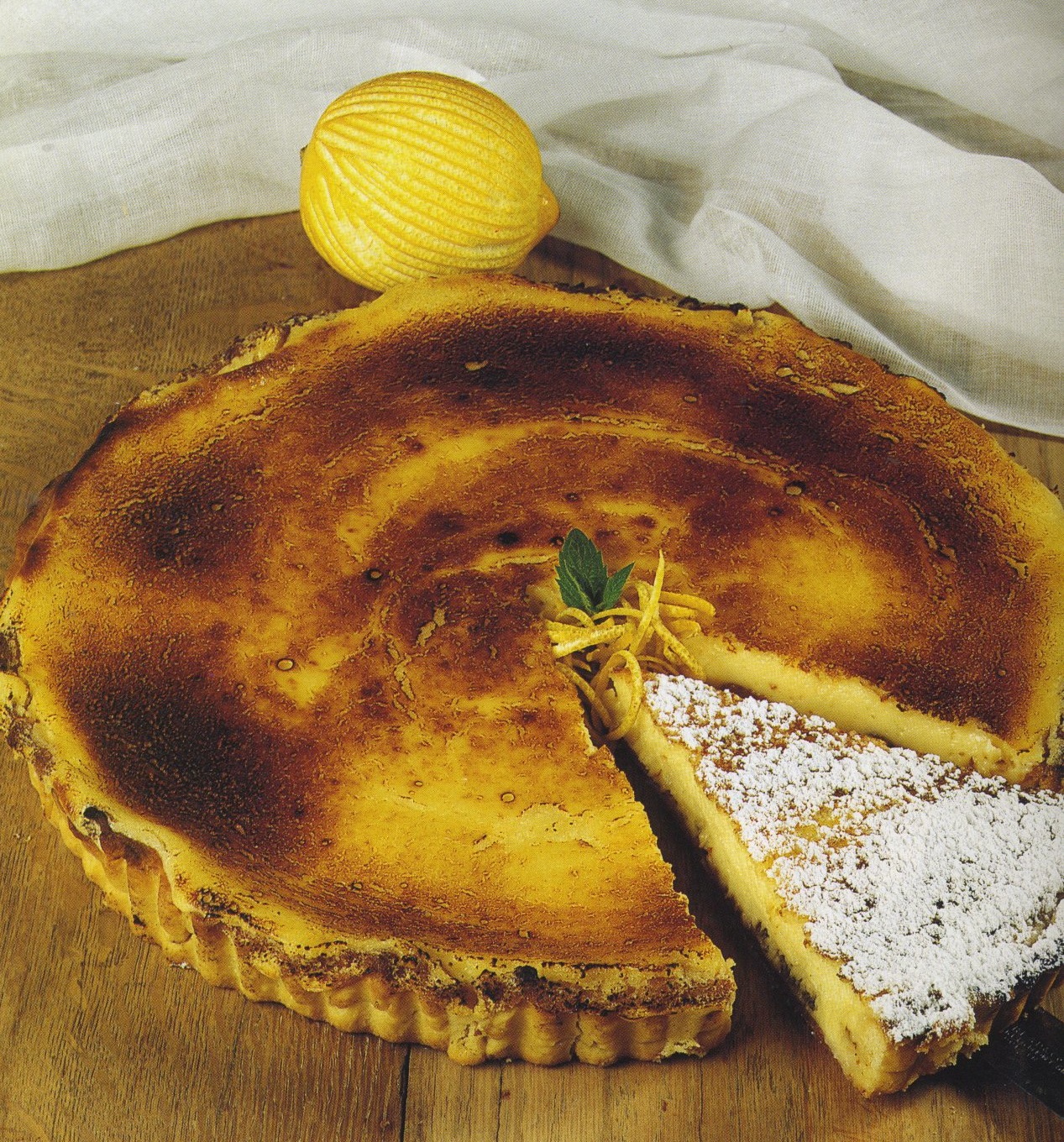 Tangy Lemon Tart (Tarte au Citron)
Tangy Lemon Tart (Tarte au Citron)
This recipe from ‘Meals For All Seasons’ makes a lovely dinner party dessert at any time of year but, with its golden colour and zingy flavour, it is perfect for Easter or any springtime gathering. Although rich, this is an easy version as the shell does not need to be pre-baked before filling and the filling is simple to make. Like other tarts, it is best eaten on the day of making, but it can be prepared ahead and gently re-warmed.
Serves 8-10
Pastry:
7oz/200g plain flour
Pinch of salt
4oz/l00g butter, preferably unsalted, at room temperature
2 level tablespoons caster sugar
1 small egg, lightly beaten
A little very cold water, if necessary
Filling:
2 large, juicy lemons
2 large eggs or 4 yolks
4 oz/l00g caster sugar
2 oz/50g ground almonds
4 oz/l00g butter, preferably unsalted, well softened
¼ pint/150 ml double cream
Icing sugar for dusting.
Sift the flour and salt into a mixing bowl or processor, cut in the butter and rub in/process to make a mixture like fine breadcrumbs. Using a fork if making by hand, work in the sugar, the lightly beaten egg and, if necessary, a little very cold water to make a smooth dough.
Roll into a ball, wrap in clingfilm and chill for an hour before use, if possible.
When ready to cook, roll fairly thinly and use to line a 10"/25 cm loose-bottomed tin. Prick the base lightly with a fork and leave in the fridge while you prepare the filling.
Preheat a very moderate oven, 325°F, 170°C, Gas mark 3.
Grate the zest from one of the lemons; squeeze the juice from both and strain. Using an electric mixer if possible, whisk together the eggs and sugar until very light and fluffy, add the ground almonds, the softened butter, the cream, lemon juice and zest.
Whisk together gently until the mixture is smooth and creamy, but take care not to overbeat as it may curdle. Pour into the pastry case and bake in the preheated oven for about 40 minutes, or until the filling is set and a light golden brown.
Serve warm or cold, dusted with icing sugar.
If you have some berries from last summer left in the freezer this is the ideal time to use them up, as a berry compote pairs nicely with this - along with some chilled and slightly sweetened whipped cream on the side.
And to round off your meal? What else but some gorgeous Irish handmade chocolates (one of the newer speciality producers is Praliné, in Athlone) or an Irish Easter egg with your coffee.
Cookery Feature - Hot Fat

Where has the joy in food gone? This is the question that the Meath based food and travel writers Russell Alford and Patrick Hanlon, aka GastroGays, have been asking themselves of late. The joy in the crunch, the sizzle, the dip and the dunk; the joy in every delicious bite? Looking at all the wellness, weight loss, get fit and healthy eating books that have topped the bestseller lists over the last few years, you'd be forgiven for thinking that meals have become all about denial. What happened to enjoying some of life's most delicious morsels in moderation?
 In Hot Fat, their debut cookbook, fried food aficionados Russell and Patrick want to bring readers into a world of delicious possibilities. And it's not all beige! They've taken familiar favourites, chipper classics and the flavours we can't get enough of these days and have created the ultimate version of every recipe, from onion rings to oysters, donuts to corn dogs, prawn toast to the perfect potato crisps.
In Hot Fat, their debut cookbook, fried food aficionados Russell and Patrick want to bring readers into a world of delicious possibilities. And it's not all beige! They've taken familiar favourites, chipper classics and the flavours we can't get enough of these days and have created the ultimate version of every recipe, from onion rings to oysters, donuts to corn dogs, prawn toast to the perfect potato crisps.
'Hot Fat is ultimately about pure, unadulterated, edible joy,' the authors say. 'We were very conscious to avoid attaching any negative connotations or emotional charge to any of the recipes or ingredients, so you won't find phrases like "guilty", "dirty", "cheat" or even "fakeaway" in the pages of our book.'
Russell and Patrick are quick to point out that this is not an everyday cookbook, of course. This is food for fun, for celebrating and for special occasions, for those times when you want to lean into the most delicious possibilities the kitchen can afford.
*** Blasta Books #2: Hot Fat by Russell Alford and Patrick Hanlon (72pp A5 hardback, €15) is the second in a series of four new cookbooks published by Blasta Books. Widely available, or buy online here. Until the end of 2022, 1% of the net profits from all sales of Blasta books and merchandise will go to UNHCR, the UN Refugee Agency.
RECIPES
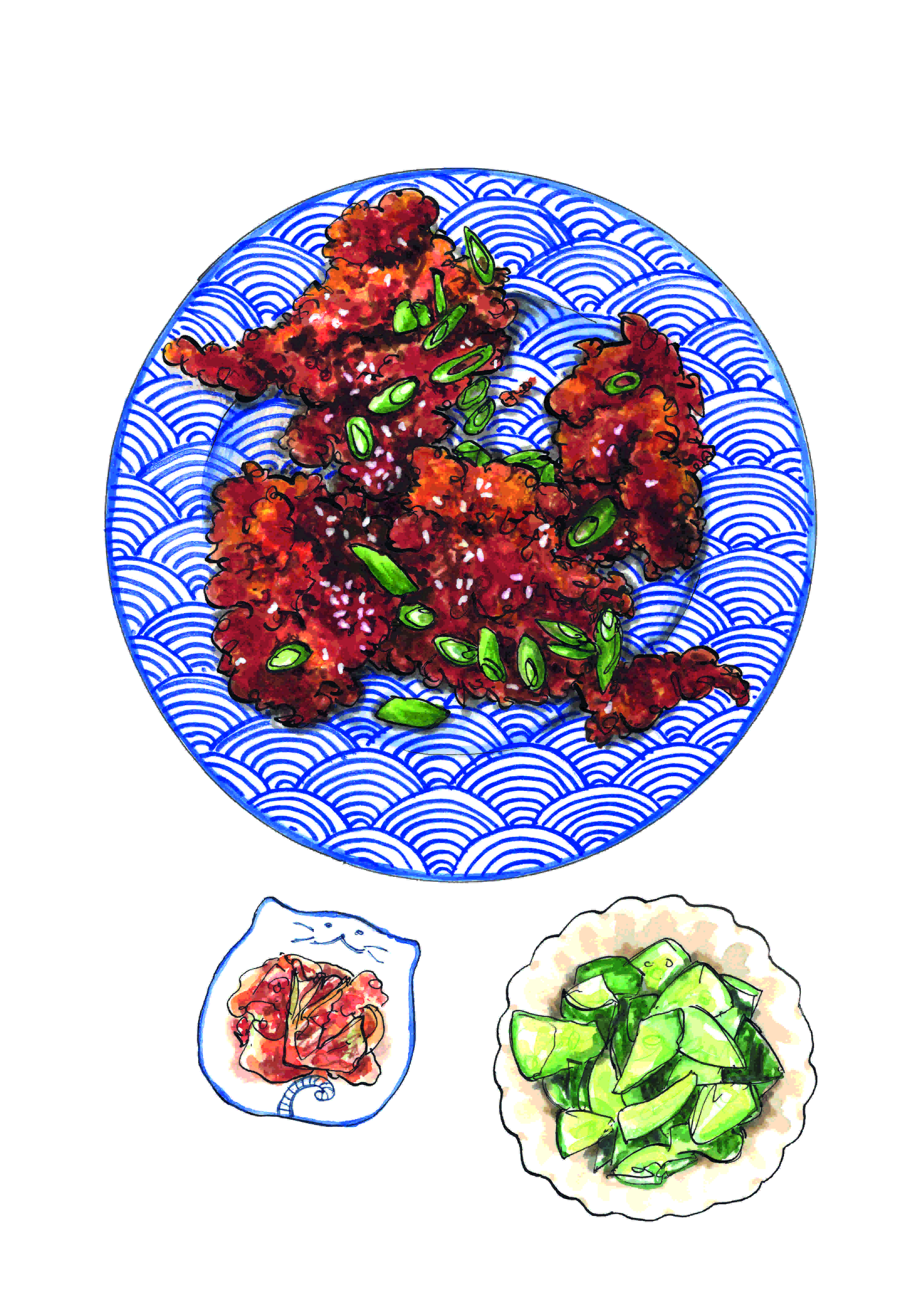 Korean fried chicken
Korean fried chicken
Serves a greedy 2
We make no apologies for the fact that we’re led almost exclusively by our tastebuds when we travel, pinpointing bucket list bites and food and drink experiences we *need* to discover, squeezed into every second of exploring. A recent two-week trip to South Korea was happily spent between Seoul and Busan chowing down on Korean fried chicken several times daily to find the best. Sofie and Garret of Chimac in Dublin gave us their own blueprint for the best-found fried chicken in Seoul (and if you're in Dublin, we really recommend trying their versions!).
What makes KFC different? A couple of things: crucially, a blend of flours and starches and it’s double fried, the combination of which results in a shatteringly crisp coating that is then smothered in a fiery, punchy, sticky, crimson-coloured sauce that still retains its crisp as you eat. Talk about finger-lickin’ good! This is next level – napkins at the ready.
6–8 boneless, skinless chicken thighs
300ml buttermilk
2 tsp gochugaru or paprika
sunflower or vegetable oil, for deep-frying
FOR THE COATING:
60g plain flour
60g rice flour
60g potato starch or cornflour
1 tsp baking powder
sea salt and freshly ground black pepper
FOR THE SAUCE:
4 tbsp rice wine vinegar or Shaoxing rice wine
2 tbsp gochujang
2 tbsp sriracha
2 tbsp tomato ketchup
2 tbsp caster sugar
1 tbsp sesame oil
1 tbsp aekjeot or nam pla fish sauce
1 tbsp gochugaru
1 tbsp honey
1 tbsp butter
TO GARNISH:
sesame seeds
spring onions, sliced into thin lengths or on an angle
thinly sliced or chopped fresh red or green chilli
Cut each chicken thigh into two or three pieces to make bite-sized chunks and season with salt. Whisk the buttermilk and gochugaru or paprika together in a large bowl or baking dish. Submerge all the chicken in the buttermilk, cover with cling film and marinate in the fridge for a good 4–6 hours (leaving it overnight is fine too).
When it’s time to cook, remove the buttermilk-brined chicken from the fridge about 30 minutes before frying. Heat the oil in your deep-fryer to 150°C.
Combine all the coating ingredients in one bowl. (If you’ve run out of baking powder, use 60g self-raising flour instead of the plain flour.)
Working quickly and without shaking off too much of the buttermilk, dredge the chicken pieces in the flour mix, ensuring a generous and even coating. Working in batches, add each piece directly into the fryer and cook for about 5 minutes, until cooked through and light golden. Remove from the fryer and set aside on a wire rack set over a baking tray lined with kitchen paper while you cook the rest of the chicken.
When all the pieces have had their first fry and have been drained, crank up the temperature of the oil to 190°C.
Meanwhile, put all the sauce ingredients in a saucepan set over a medium heat and bring to the boil, then drop down to the lowest heat setting and give it a stir every so often just to keep it warm and pourable.
Fry all the chicken for a second time for 90 seconds to 2 minutes, until it looks incredibly crisp and has darkened in colour. Depending on the size of your fryer basket, you may need to do this in two batches.
Place the chicken into a large heatproof bowl and pour over all the sauce, tossing to coat each piece. The chicken will soak up the sauce but still retain its crispness.
Plate up with a generous sprinkle of sesame seeds, sliced spring onions and fresh chilli on top. Alternatively, serve in a steamed bao or as a burger. Kimchi or some sharp pickles are the ideal supporting side act or you can go all out on the whole banchan experience of a table laden with small side dishes.
From Blasta Books #2: Hot Fat by Russell Alford and Patrick Hanlon
€15, published by Blasta Bookshttps://blastabooks.com/
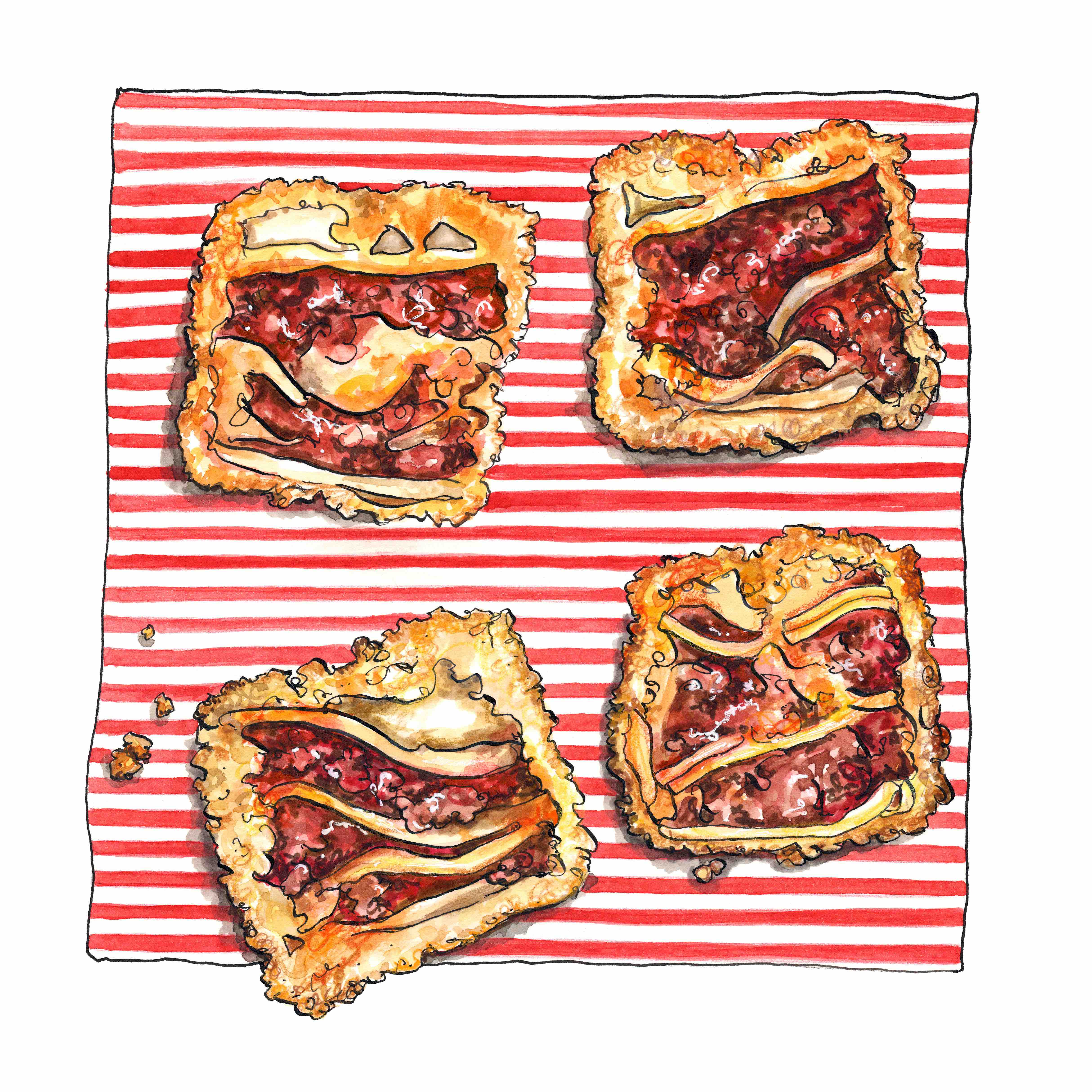 Lasagne bites recipe
Lasagne bites recipe
Makes 6–8
You may think we’ve gone down a weird path with this one, but hear us out! Cookbooks can have this compulsion to instruct you to make everything from scratch, but sometimes convenience needs to be encouraged to get the job done. So be kind to yourself and take the easy route here. Pop into the supermarket and get your paws on the best ready-made lasagne you can find, then you’re going to create culinary magic by portioning it up and deep-frying it. Think mac ’n’ cheese bites, but better. Think oozy, creamy, rich lasagne but hand-held and crunchy. The ideal little bar snack, indulgent treat or crowd-pleasing canapé, we bet you never thought lasagne could be this lavish!
1 ready-made beef lasagne (about 400g)
sunflower or vegetable oil, for deep-frying
2 tbsp plain flour
1 large egg
1 tbsp milk
50g panko breadcrumbs (or fine dried breadcrumbs)
10g freshly grated Parmesan, Grana Padano or Pecorino cheese
flaky sea salt and freshly cracked black pepper
Get your pre-made lasagne from the supermarket. Remove the cling film or other wrapping, but with the lasagne still in its foil tray, use a sharp knife to cut it into roughly 4cm squares, as if it’s a sort of traybake. A 400g lasagne will yield around six nuggets, while a larger one may get you eight to 10. Cover the tray with a sheet of cling film and place in the freezer for about 90 minutes to 2 hours to solidify a bit.
Heat the oil in your deep-fryer to 160°C.
Prepare your pané station: put your flour in one bowl. In another, whisk the egg and milk together. In a third, combine the breadcrumbs with the cheese and some freshly cracked black pepper. (You would sprinkle, grate or twist these over a finished pasta dish, right? So why not include them in the coating?)
Take the now semi-frozen lasagne out of the freezer and carefully remove the pre-cut cubes. One by one, place each lasagne bite into the flour, then into the egg, covering all six sides. Smother in the breadcrumbs and cheese, then return it into the egg, and again into the breadcrumbs. The double coating ensures there shouldn’t be any leaks.
Working in batches, gently lower into the fryer, shaking the basket slightly to ensure it doesn’t stick. Fry for 8–10 minutes, depending on the thickness of your lasagne. If a little protrudes out of the top, don’t worry. You’ll have to turn them around about every 2 minutes to ensure even coverage.
Remove from the fryer and place on a wire rack set over a baking tray lined with kitchen paper to absorb any excess oil. Leave to stand for about 2 minutes, as they will still be molten inside! Season with a little flaky sea salt and black pepper on top before serving.
From Blasta Books #2: Hot Fat by Russell Alford and Patrick Hanlon
€15, published by Blasta Books https://blastabooks.com/
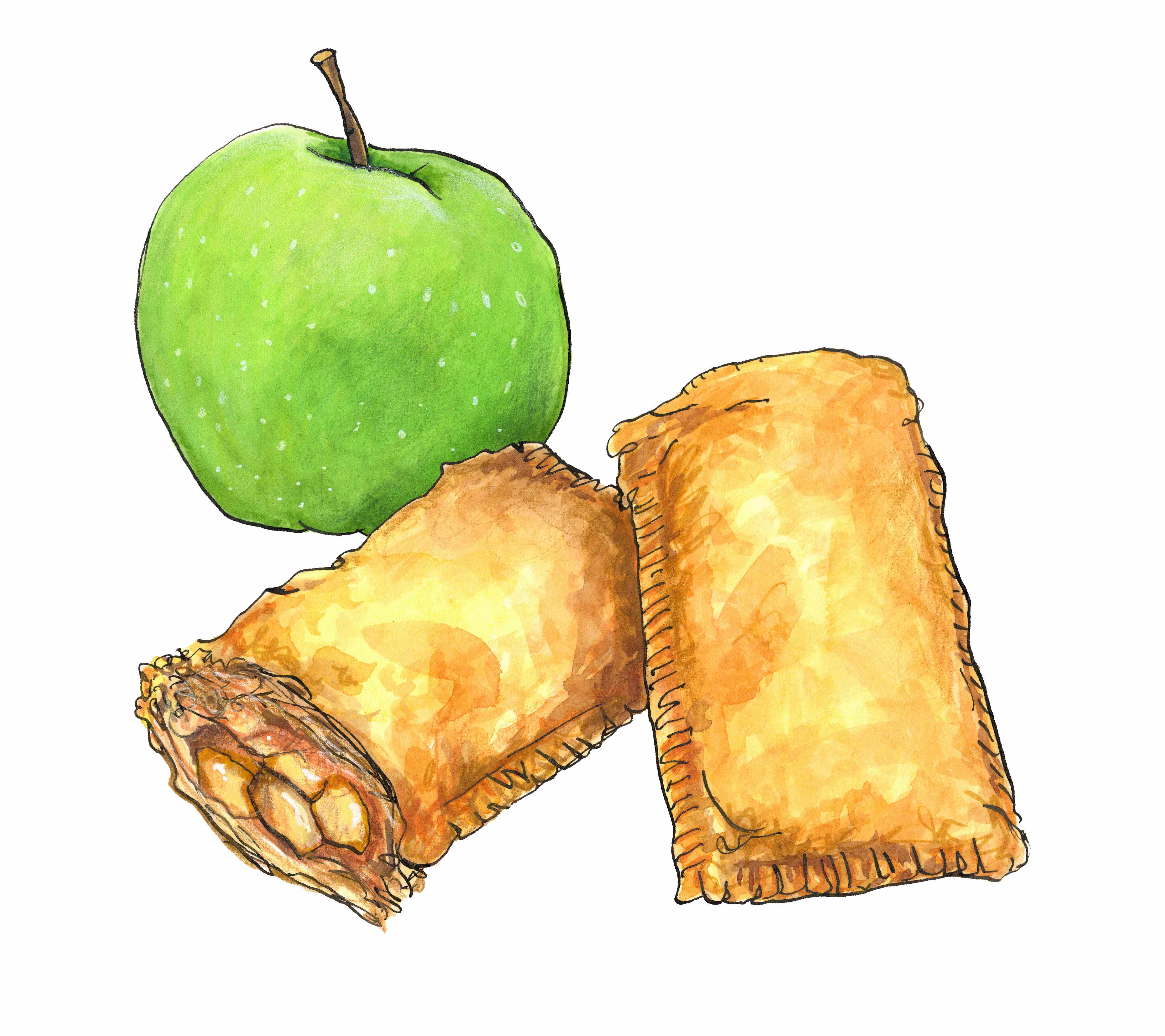 Apple hand pies recipe
Apple hand pies recipe
Makes 6
Hand-held desserts, what a concept! This crunchy, crisp, hand-held pie sings with its sweet spiced filling and is super easy to put together. You can play around with your choice of fruit (rhubarb, plum, cherries), but good old green apple is the ultimate classic.
3 medium green apples, peeled, cored and cut into small cubes
50g light brown sugar
juice of ½ lemon
1 tbsp cornflour
1 tbsp ground cinnamon
½ tsp ground nutmeg or mace
¼ tsp ground cardamom
fresh sunflower or vegetable oil, for deep-frying
icing sugar, for dusting
1 sheet of pre-rolled puff pastry (all-butter if possible)
FOR THE CINNAMON SUGAR TOPPING:
80g granulated sugar
1 heaped tsp ground cinnamon
Add the cubed apples, brown sugar, lemon juice, cornflour and spices to a saucepan with a drop of water and cook down on a medium-low heat for 20 minutes, stirring every so often to avoid it sticking or burning. You don’t want it to turn to mush – you still want a little bit of texture and structure from the apples. Set aside to cool.
Heat the oil in your deep-fryer or a high-sided pan to 170°C. As this is a sweet recipe, we recommend using fresh oil rather than using a fryer full of oil that has been anointed with all manner of spicy chicken, onion rings and frites.
Sift a bit of icing sugar over a clean work surface and roll out the sheet of puff pastry to an even thickness (about 3mm), then cut into six rectangles about 10cm x 15cm.
In each rectangle, dollop 3 teaspoons of the filling along the long side, off centre, as you’re going to seal it by folding over the other half. Take a small pastry brush and dab a little water around the edges of the open pastry. Fold the empty side over the filling, then crimp with the tines of a fork to seal.
Working with a maximum of two pies at a time (depending on the size of your fryer), carefully place the pies in the hot oil and cook for 8 minutes.
Meanwhile, to make the topping, mix the sugar and cinnamon together in a wide, shallow dish or pasta bowl.
Remove the pies from the fryer and shake the basket to allow the excess oil to drain for a few seconds, then dredge the pie(s) in the cinnamon sugar while still hot. Set on a wire rack and enjoy after a couple of minutes – resist the temptation to dive right in, as the molten middle will make itself known!
From Blasta Books #2: Hot Fat by Russell Alford and Patrick Hanlon
€15, published by Blasta Books https://blastabooks.com/
Cookery Feature - The United Nations of Cookies
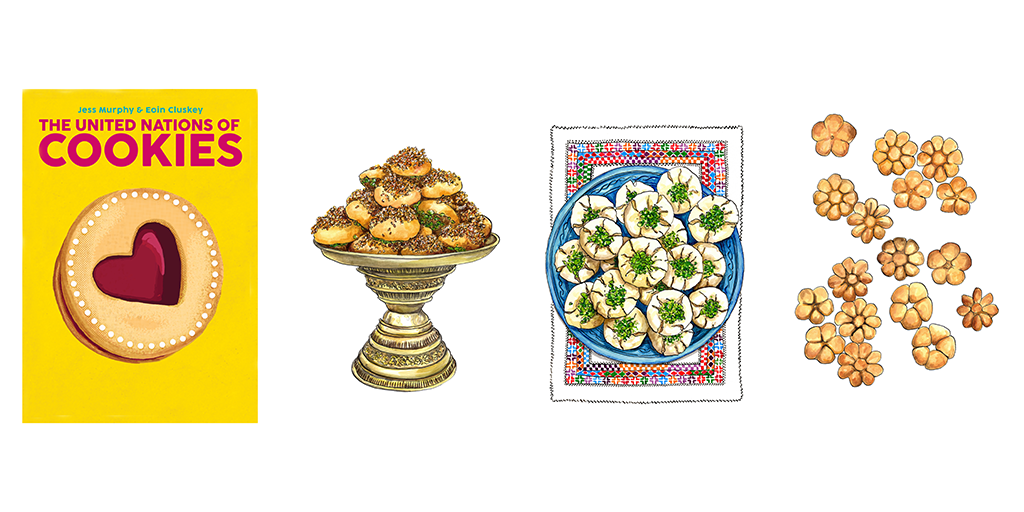
 When publisher Kristin Jensen’s brilliantly conceived Blasta Books hit the Irish publishing scene with a hugely successful Kickstarter campaign in May 2021, it was immediately obvious that something very different was afoot in the world of Irish cookbooks. Now, after the publication of three of the quartet of titles planned for 2022 – and the fourth, Wok, due out on November 3rd - their impact is astonishing. Well-deserved accolades for these ‘little books with big voices’ (and the bigger ones under sister imprint Nine Bean Rows) keep rolling in and details of the four titles planned for 2023 have already been announced.
When publisher Kristin Jensen’s brilliantly conceived Blasta Books hit the Irish publishing scene with a hugely successful Kickstarter campaign in May 2021, it was immediately obvious that something very different was afoot in the world of Irish cookbooks. Now, after the publication of three of the quartet of titles planned for 2022 – and the fourth, Wok, due out on November 3rd - their impact is astonishing. Well-deserved accolades for these ‘little books with big voices’ (and the bigger ones under sister imprint Nine Bean Rows) keep rolling in and details of the four titles planned for 2023 have already been announced.
These little books tell a lot of stories and celebrating diversity is key to the Blasta Books philosophy. This is expressed in many ways, including the donation of a percentage of profits from sales of books and merchandise to UNHCR, the UN Refugee Agency – and this is taken much further in the most recent title, The United Nations of Cookies. As Kristin Jensen puts it, “Cultures and cuisines have many differences, but one thing they all have in common is cookies. No matter the country, cookies evoke fond childhood memories and feature in many holidays and celebrations. But there’s more to Blasta Books #3 than just a sweet treat.”
 For this is a book on a mission and co-authors Jess Murphy (of Kai restaurant in Galway) and Eoin Cluskey (of Dublin bakery Bread 41) are donating all author proceeds to UNHCR. Jess Murphy is an official High-Profile Supporter of the UNHCR, with whom she works to raise awareness and to advocate for refugees. She has worked with refugees around Ireland, as well as immigrants who have made Ireland their home, to collect and share the 25 recipes in the book. All were all tested at Bread 41 and baker Eoin Cluskey shares the philosophy, saying, “We can rekindle … childhood nostalgia, that simplicity and joy of food, while addressing the challenges our world faces and the need to come together. At its core, food is universal and ever evolving. This book is a love letter to how it brings us all together.’
For this is a book on a mission and co-authors Jess Murphy (of Kai restaurant in Galway) and Eoin Cluskey (of Dublin bakery Bread 41) are donating all author proceeds to UNHCR. Jess Murphy is an official High-Profile Supporter of the UNHCR, with whom she works to raise awareness and to advocate for refugees. She has worked with refugees around Ireland, as well as immigrants who have made Ireland their home, to collect and share the 25 recipes in the book. All were all tested at Bread 41 and baker Eoin Cluskey shares the philosophy, saying, “We can rekindle … childhood nostalgia, that simplicity and joy of food, while addressing the challenges our world faces and the need to come together. At its core, food is universal and ever evolving. This book is a love letter to how it brings us all together.’
The stories are powerful and the cookies delicious – this book is a one-off.
Blasta Books #3: The United Nations of Cookies by Jess Murphy and Eoin Cluskey (€15) is illustrated by Dublin artist Nicky Hooper and published by Blasta Books (blastabooks.com, price €15. All author proceeds will be donated to UNHCR.
RECIPES:
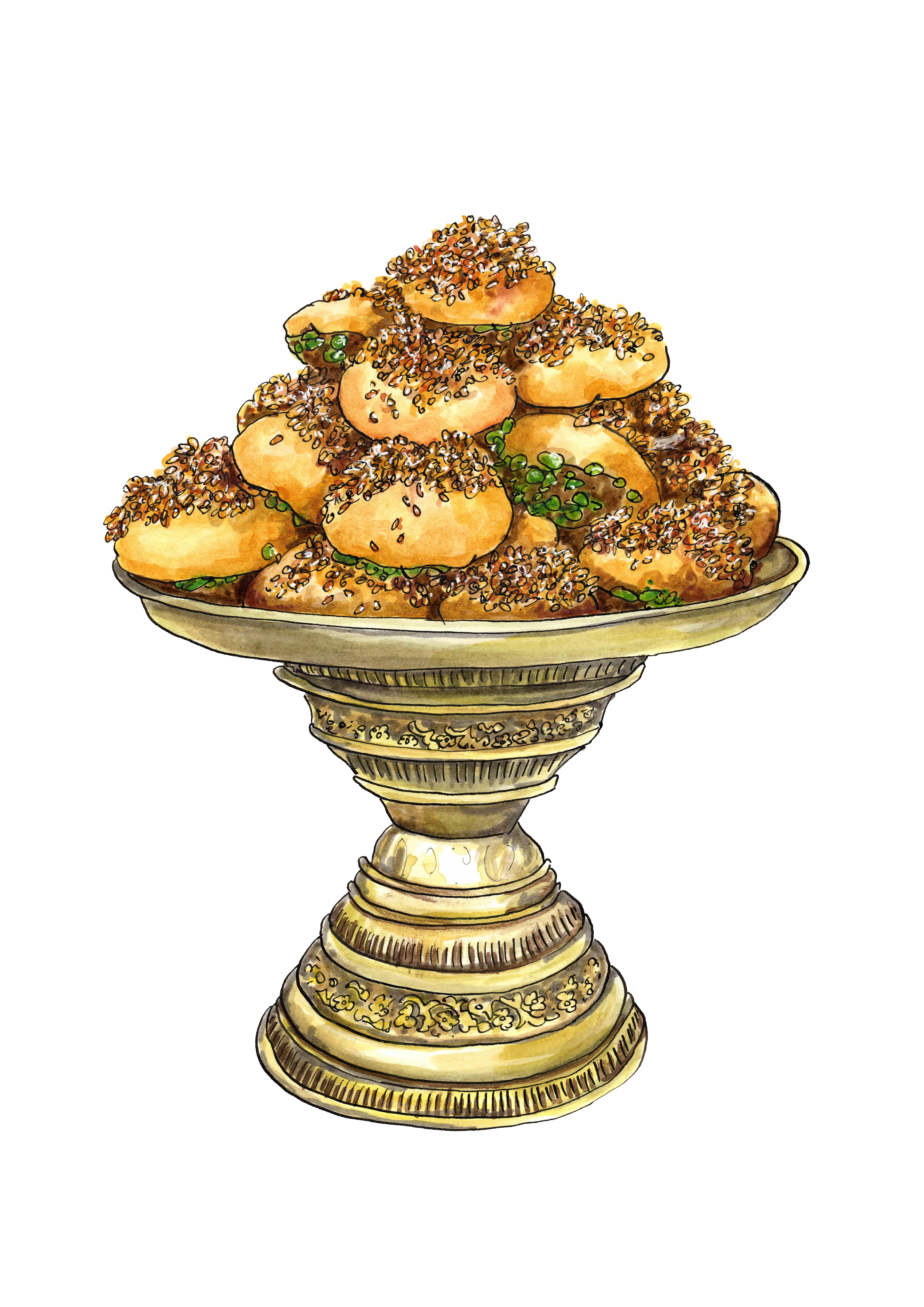 Syrian sesame and pistachio cookies (barazek)
Syrian sesame and pistachio cookies (barazek)
Makes 18
In 2019, Jess Murphy travelled to Lebanon, where she met with the Al Jamous family, who had been selected for resettlement to Ireland. The family are from Da’el near Daraa in southern Syria, which was the centre of the unrest that led to the beginning of the war in Syria in 2011. Sami, his wife Haifa and their three children – Mohamad Habib (16 years old), Mahmoud (14 years old) and Maria (11 years old) – fled to Lebanon in 2013. They were living in a one-bedroom apartment in Bir Hassan, in southern Beirut. Sami, who worked as a florist in Beirut, was looking forward to the opportunity to find peace and for their children to get a good education. ‘Sami had said, all I want is the kids to ride a bicycle up and down the street,’ Jess says. ‘When I visited them in Birr a year or so later, they were on their bikes in their school uniforms. Haifa was baking and their faces had completely changed. They were so happy.’
‘These biscuits are one of the most traditional Syrian sweets,’ say Haifa and Sami. ‘We have so many special memories of preparing these biscuits with our families.’
110g unsalted butter, softened
80g icing sugar
1 egg
1 tsp vanilla extract
190g plain flour
½ tsp baking powder
a small pinch of fine sea salt
TO DECORATE:
50g sesame seeds
1 tbsp runny honey
50g pistachios, finely chopped
Cream the butter and icing sugar together until pale and fluffy. Add the egg and vanilla and mix again until well combined.
Sift the flour, baking powder and salt together, then gradually fold into the butter and sugar mixture, being careful not to overmix. Cover the bowl with cling film and chill the dough in the fridge overnight.
Preheat the oven to 180°C fan. Line two large baking trays with non-stick baking paper.
Mix the sesame seeds and honey together in a small bowl and set aside. Put the pistachios in a separate bowl or on a plate.
Break off 1 tablespoon portions of the dough and roll into balls. Press one side into the pistachios and the other side into the sesame and honey mix.
Space the barazek 2cm apart on the lined trays. Bake in the oven for 15–20 minutes, until golden brown.
Remove from the oven and allow to cool on the trays for 10 minutes, then transfer to a wire rack to cool completely. Serve with mint tea.
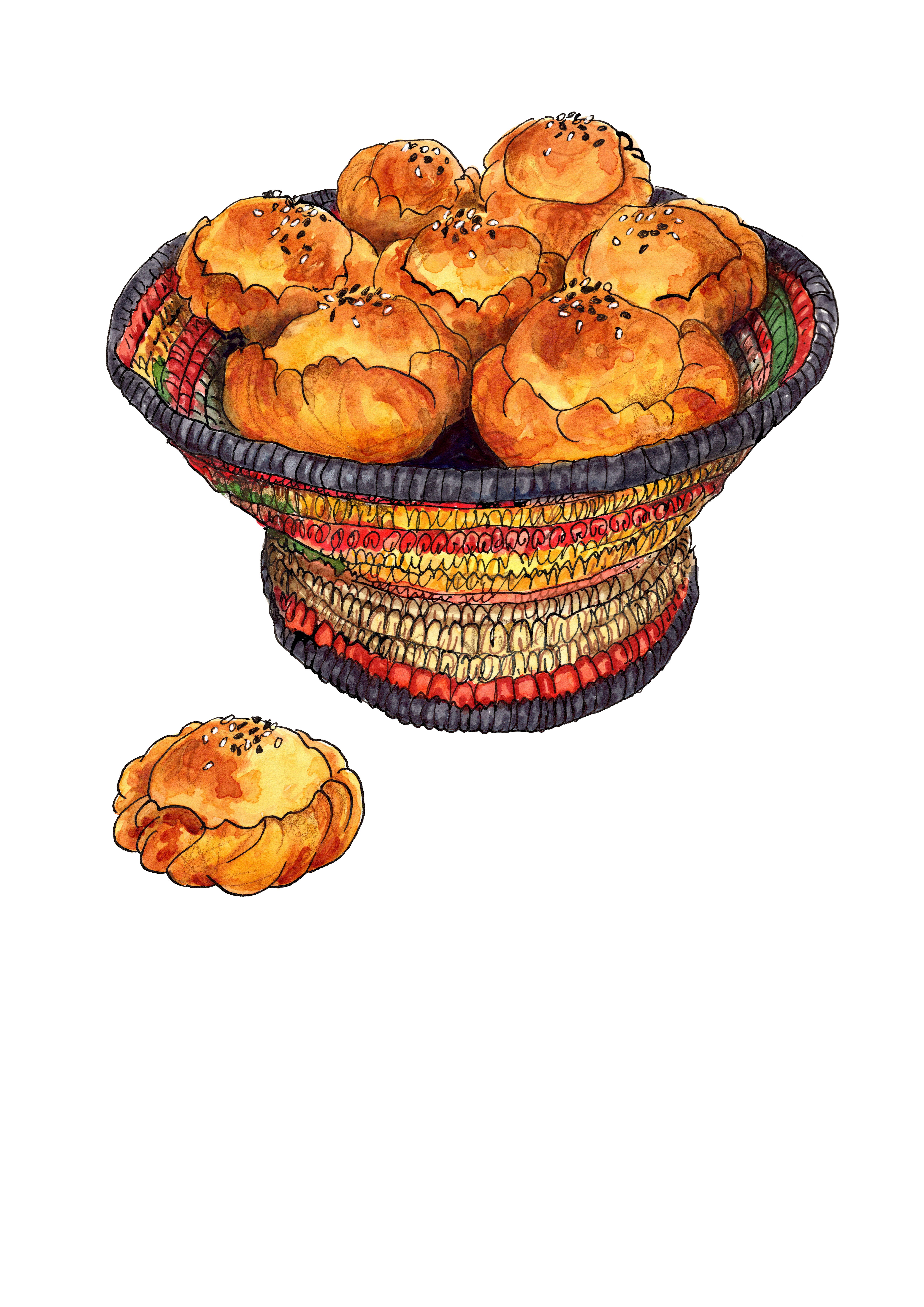 Yemeni festive cookies (ka’ak al-Eid)
Yemeni festive cookies (ka’ak al-Eid)
Makes 2 dozen
Sara Althabhaney is a forensic science student in GMIT in Galway. She fled the war in Yemen when she was 13 with her mother, sister and brother, seeking safety in Ireland, where they were granted asylum. While food plays an important role in communities around the world, this is even more so for people forced to flee to other countries. ‘Having that little bit of home is such a big thing,’ Sara says. ‘Being able to create certain food is very close to your heart.’
Ka’ak al-Eid are like a cross between brioche and a biscuit and they aren’t very sweet. They are traditionally served to guests and only during the Eid (feast) at the end of the fasting month of Ramadhan, Eid al-Adha and at the end of Hajj, the pilgrimage to Mecca, though some families might now serve them on other special occasions. ‘These cookies remind me of my childhood in Yemen,’ Sara says. ‘As kids, we liked to dip the ka’ak in sweet, fragrant, milky tea.’
150ml lukewarm milk
½ tsp fast action dried yeast
800g plain flour
2 tbsp icing sugar
½ tsp fine sea salt
270g butter, diced and softened
2 eggs
2 egg whites
TO DECORATE:
2 egg yolks
1 tbsp milk
nigella seeds
sesame seeds
Put the warm milk in a measuring jug and stir in the yeast. Leave for 10 minutes to let the yeast foam up.
Mix together the flour, sugar and salt in a large bowl. Add the butter and either using a stand mixer fitted with the paddle attachment or your fingertips, work in the butter until the mixture resembles coarse breadcrumbs. Add the milk and yeast mixture along with the two whole eggs and the two egg whites.
If you’re using a stand mixer, switch to the dough hook attachment and knead on a medium speed just until everything comes together into a smooth dough or knead by hand, but either way, take care not to overknead. Cover the bowl with a clean tea towel and leave to rise for 30 minutes in a warm, draught-free place.
Preheat the oven to 190°C fan. Line two baking trays with non-stick baking paper.
Pinch off 50–60g portions of the dough (roughly the size of a large egg) and roll into a ball between the palms of your hands, then flatten each ball into a disc. You can leave them as flat discs, but if you want to create a decorative edge, then flatten all around the edge even more so that they look almost like ravioli, with a bump in the middle.
Using your thumb and forefinger, pinch the edge and twist it towards you to create the decorative edge, repeating this all the way around the disc to create overlapping twists. Place on the lined trays, spaced a little bit apart.
Whisk the egg yolks and milk together, then brush the tops of the cookies with this egg wash. Sprinkle over a small pinch of nigella and sesame seeds on top of each one.
Bake in the oven for 20–25 minutes, until golden brown. Allow to cool on a wire rack, then eat with strong, sweet, milky Yemeni cardamom tea.
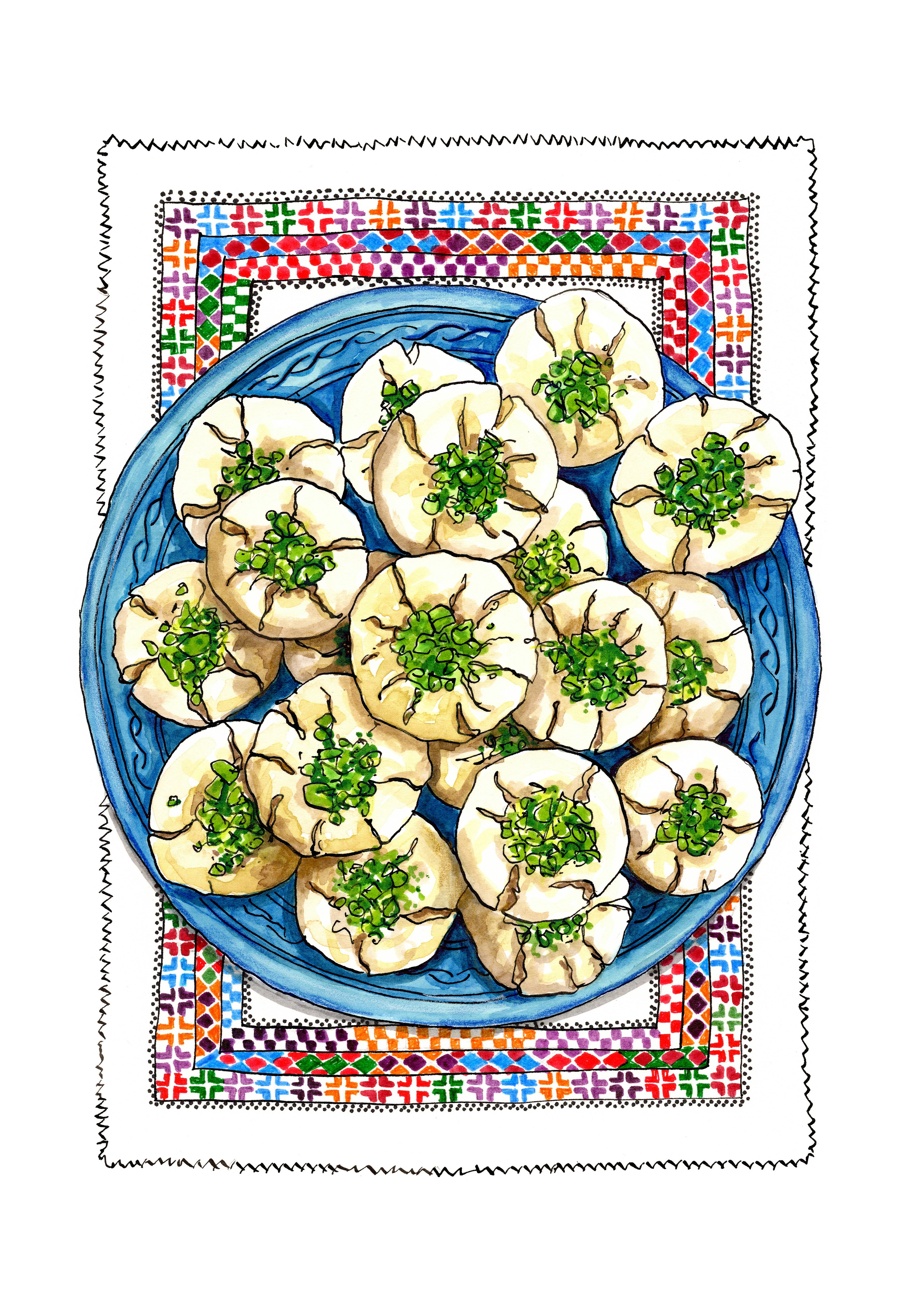 Afghani shortbread (nankhatai)
Afghani shortbread (nankhatai)
Makes 20
Khatira Hassanpour grew up in Iran, but her family fled in 1984 during the Soviet invasion of Afghanistan. Four decades later, the subsequent waves of violence and displacement from Afghanistan continue in what is now the longest protracted refugee situation covered under UNHCR’s mandate. Today, Iran is host to over 3 million Afghans.
Khatira, a translator by profession, now lives in Galway with her husband and two children. Like Afghan refugees in Iran, she preserves the taste of home with food such as nankhatai, a type of shortbread biscuit. Khatira says, ‘These cookies are very popular in Afghanistan. They remind me of my parents, as we ate them all the time when we were children, especially on New Year’s Eve. My mom still makes them at home.’
250ml sunflower or vegetable oil, gently warmed
120g icing sugar
1 tsp ground cardamom
1 tsp vanilla extract
300g plain flour
50g pistachios, very finely chopped
Put the warm oil and icing sugar in a large bowl and mix until well combined and smooth. Add the cardamom and vanilla and mix again. Add the flour and mix with a wooden spoon or gently knead with your hands until the mixture comes together into a soft, smooth dough. Place the dough in a bowl, cover with cling film and chill in the fridge for 1 hour to firm up.
Preheat the oven to 150°C fan. Line two baking trays with non-stick baking paper.
Using a tablespoon, scoop out small balls of the dough, roll them into neat balls between the palms of your hands and place on the lined baking trays, spaced a little bit apart. Press each dough ball lightly with your finger to put a little dent in the top (to sprinkle the pistachios into after baking).
Bake in the oven for 20 minutes. Remove from the oven and add a pinch of chopped pistachios into the indent you made in each cookie. Allow to cool for 10 minutes on the trays, then transfer to a wire rack to cool completely.
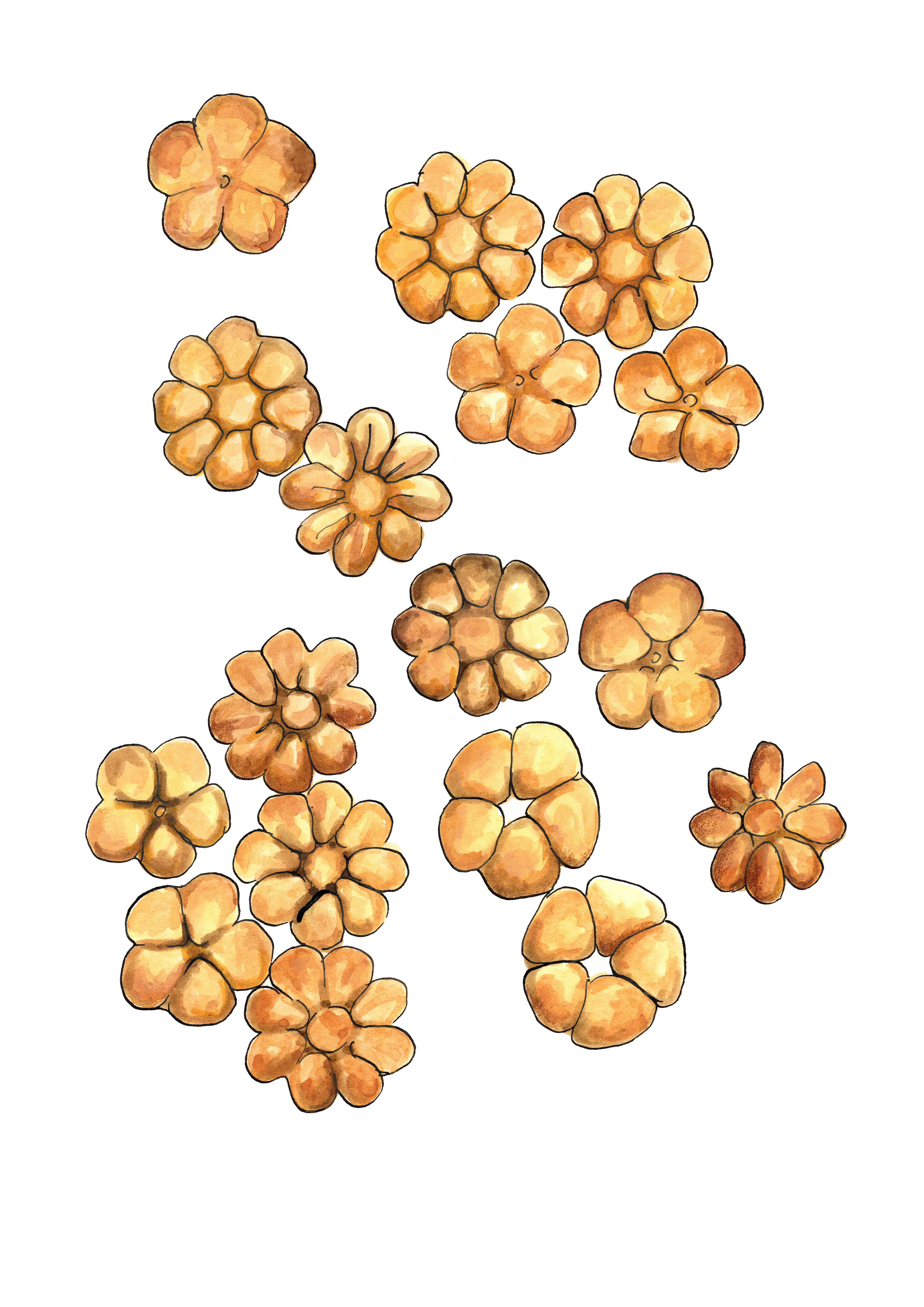 Somalian biscuits (biskud)
Somalian biscuits (biskud)
Makes 8 dozen
Ifrah Ahmed was born in Somalia and fled the outbreak of war in 2006 at the age of 17. She escaped traffickers and was granted asylum in Ireland. Since settling in Ireland, she has devoted her life to helping eradicate female genital mutilation (FGM) and to providing integration support to newly arrived youth migrants and refugees from Africa in Ireland. Ifrah has been supporting the UNHCR since 2014 and is now a High-Profile Supporter.
Ifrah says, ‘In Somalia, old women have these biscuits with coffee in the morning. For everyone else, biskud are most often eaten at weddings, Eid, celebrations or as a special treat. You often get a small box of biskud and other sweets to take home with you from a wedding. During Ramadan, you look forward to having these biscuits to break your fast – when I was younger, we’d go to our neighbours’ house during Eid and they’d give us these. The traditional shape is a long rectangle with lines on top. In Somalia you can get a special attachment to make this cookie shape by pressing the dough through a meat grinder, but a cookie press fitted with any shape you like is just fine too – flowers are also popular.’
190g unsalted butter, softened
200g caster sugar
2 large eggs
1 tsp vanilla extract
500g plain flour
1½ tsp baking powder
½ tsp ground cardamom
Preheat the oven to 180°C fan.
Cream the butter and sugar together until light and fluffy. Add the eggs one at a time, beating well after each addition until fully incorporated and smooth, scraping down the sides of the bowl. Stir in the vanilla.
In a separate bowl, sift the flour, baking powder and ground cardamom together and stir to combine, then add to the wet ingredients and mix just until it all comes together into a dough.
Transfer the dough into a cookie press fitted with whatever shape you like. Push out the cookies directly onto two unlined baking trays.
Bake in the oven for about 15 minutes, until they are light golden brown on top. Leave to cool for a few minutes on the trays before moving onto a wire rack to cool completely. Store in a large glass jar or airtight container and serve with coffee.
Cookery Feature - Soup
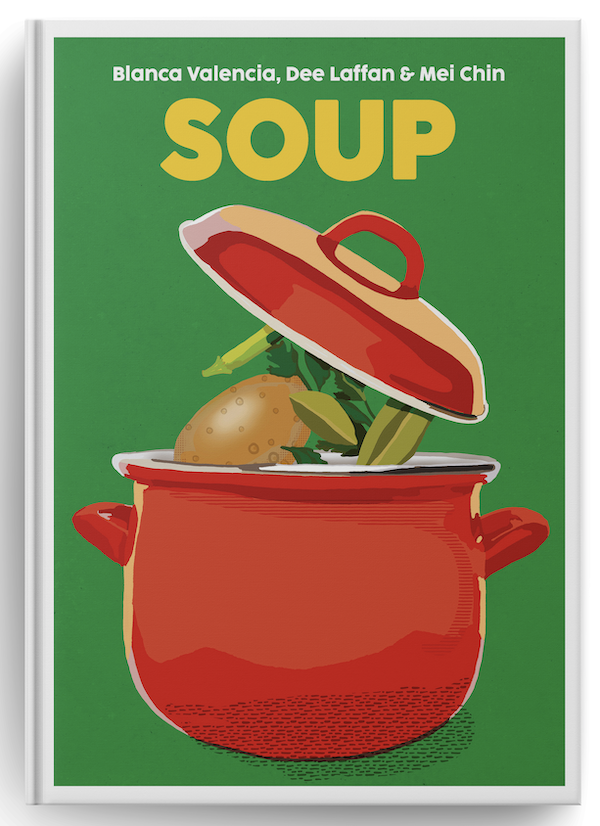
,%20Mei%20Chin%20(centre),%20Blanca%20Valencia%20(right)_photographer%20credit%20Melanie%20Mullan.JPG)
The story of how Soup came about tells you all you need to know about the philosophy behind the book. Authors Blanca Valencia, Dee Laffan and Mei Chin - co-hosts of the popular Spice Bags podcast – realised when recording an episode on the topic of soup, that while they are all from completely different backgrounds, cultures and upbringings, soup is a common ground. But why soup? The answer, they say, is that soup connects us all. ‘Everyone is passionately opinionated about their soups. We can argue through the night about blended soups, cold soups, greens in our soups, clear soups and, ultimately, why our favourite soup is the very best. The soups we make say we miss our mothers, we want to travel, that the seasons are changing or that we are truly, deeply hungover. Soups define the stock from which we come.’ As to the recipes, they reflect both the individual cultures, memories and tastes of the authors, and Irish food today.
 Blasta Books: Described by publisher Kristin Jensen as ‘…the voices, faces and food of modern Ireland’ each of the Blasta Books series is a hardcover, 72-page A5 cookbook illustrated by Dublin artist Nicky Hooper. They are standalone books, but as a quarterly series they also provide a more inclusive snapshot of Ireland’s modern and diverse food culture, from tacos to tapas, spice bags to sushi. Buy online from blastabooks.com, either individually or as a series bundle, or in good bookshops and independent retailers around Ireland.
Blasta Books: Described by publisher Kristin Jensen as ‘…the voices, faces and food of modern Ireland’ each of the Blasta Books series is a hardcover, 72-page A5 cookbook illustrated by Dublin artist Nicky Hooper. They are standalone books, but as a quarterly series they also provide a more inclusive snapshot of Ireland’s modern and diverse food culture, from tacos to tapas, spice bags to sushi. Buy online from blastabooks.com, either individually or as a series bundle, or in good bookshops and independent retailers around Ireland.
Blasta Books #5: Soup by Blanca Valencia, Dee Laffan and Mei Chin (€15) is published by Blasta Books (blastabooks.com)
SAMPLE RECIPES
 EVEREST GARLIC SOUP
EVEREST GARLIC SOUP
Serves 4
In 2017 I trekked to Everest Base Camp, which was an incredible, transformational experience. Food is a vital part of your journey – you burn about 5,000 calories a day trekking at high altitudes, so you need to replenish often. All meals started with soup, which we were served in the tea lodges along the route. Garlic soup is important because it helps you avoid altitude sickness. While I had never tried it before, it became a comfort food that I longed for. Often served with a thinner consistency, this creamy version was my favourite that soothes me to this day. – Dee Laffan
100g unsalted butter
2 brown onions, chopped
5–6 garlic cloves, coarsely chopped
4 medium Orla potatoes (or any waxy yellow potato), peeled and chopped
fine sea salt and freshly ground black pepper
To serve:
Nepalese roti, Indian chapati or flatbreads
Melt the butter in a saucepan over a medium heat. Add the onions, reduce the heat slightly and sweat for 8–10 minutes, until softened. Stir in half the garlic and all the potatoes and season with salt and pepper. Cook for 2 minutes, then cover with water and simmer until the potatoes are tender.
Meanwhile, sprinkle some sea salt on the remaining garlic on a chopping board. With the back of a sharp knife, push down and drag the garlic over and over, crushing it to a smooth paste.
Remove the soup from the heat and liquidise using a hand-held blender or food processor. If the soup is too thick, add more water – it should have a lighter, thin soup consistency. Stir the garlic paste into the soup, then taste and adjust the seasoning.
Serve with roti, chapati or flatbreads.
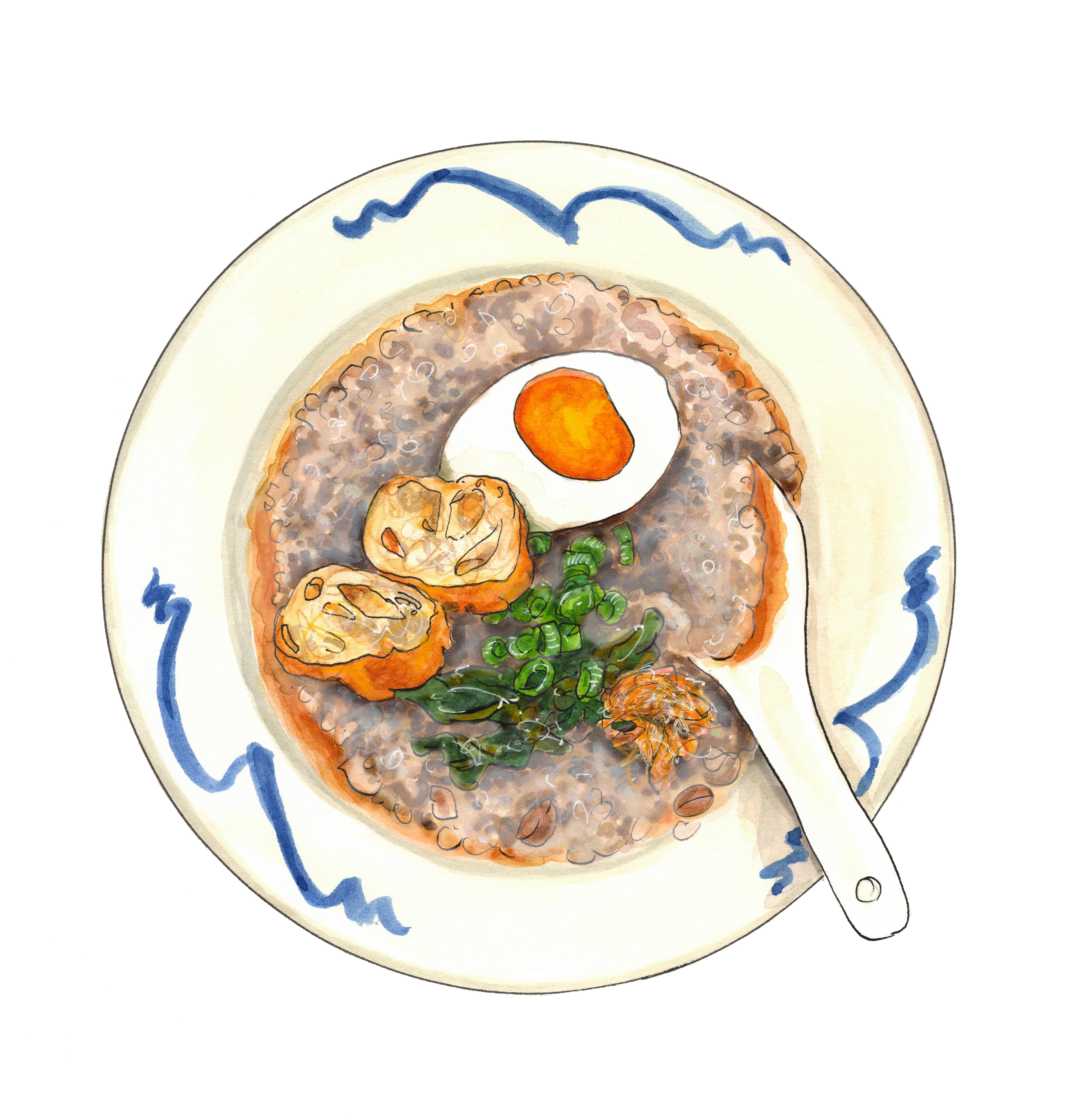 HUO JI ZHOU (Chinese turkey congee with dried shrimp)
HUO JI ZHOU (Chinese turkey congee with dried shrimp)
Serves 4–6
As a child in Connecticut, I turned my nose up at my Cantonese father’s day-after-Thanksgiving turkey zhou (stewed breakfast rice porridge). Only as an adult did I come to terms with my Chinese side, which includes having a cupboard that smells like dried fish, and embrace turkey zhou. It follows a day of gluttony, is soothing and savoury, but it also has the mild funk of a bird the day after. Moreover, this zhou is part of my heritage. I am an American-born Chinese, and this is Thanksgiving turkey steeped with rice.
Turkey zhou should be ivory (not white) and spiked with brine from dried seafood, salted egg, pickles and pork floss. Traditionally, zhou is served with youtiao (think salty churros). If these aren’t available, shop-bought Yorkshire puddings are a wonderful accompaniment. – Mei Chin
20g raw peanuts (optional)
225g jasmine rice
2 tbsp vegetable oil
2 tsp fine sea salt
250–500g leftover cooked turkey and bones
15 dried shrimp, chopped
3 spring onions, halved
3 slices of fresh ginger, thinly sliced on the bias
2 litres water
ground white pepper
To serve:
a drizzle of sesame oil
thinly sliced spring onions
youtiao (Chinese savoury pastry) or Yorkshire puddings
salted duck eggs
Chinese zha cai (pickled mustard leaves)
Chinese rousong (pork floss)
If you’re using the raw peanuts, the first thing you need to do is soak them in a small bowl of cold water for 24 hours, then drain.
Rinse the rice three times, until the water runs clear, then drain and mix it with the vegetable oil and salt. Put in a pot with the turkey and bones, chopped dried shrimp, spring onions, ginger and the drained peanuts (if using) and cover with the water. Bring to the boil over a high heat, then cover the pot with a lid, reduce the heat to low and simmer for 1¾ hours. Stir occasionally and add water when the rice starts to stick to the bottom of the pot.
Remove the pot from the heat. Add another 250ml water, then cover with a lid and let the congee steep for an additional hour.
To serve, reheat the congee until it’s piping hot. Add ground white pepper to taste and top with the garnishes.
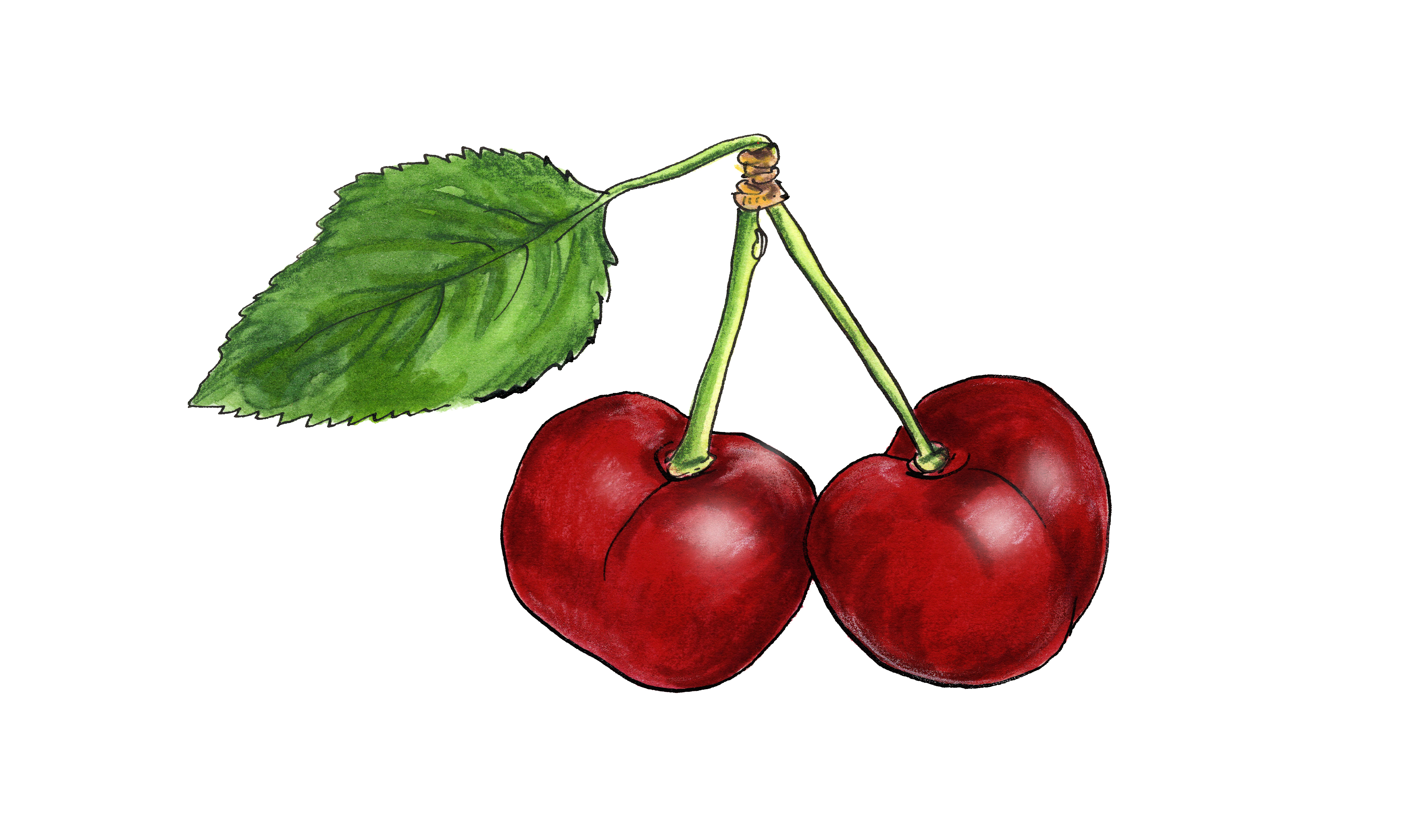 CHERRY GAZPACHO
CHERRY GAZPACHO
Serves 6–8
During my childhood summer vacations in Andalusia, gazpacho was only a boring tomato drink. It wasn’t until I watched Pedro Almodóvar’s movie Women on the Verge of a Nervous Breakdown, where the protagonist artfully drinks bright-red gazpacho (laced with Valium!) out of a glass,wears a red jacket and talks on a red phone, that its glamorous possibilities unfolded. However, it was Spanish chef Dani Garcia’s fruit gazpachos that cemented this dish in my culinary repertoire. Let me warn you, though, that nothing kills a gazpacho buzz more than lousy olive oil and subpar vinegar. I will not let anything but early harvest extra virgin olive oil (preferably the Picual varietal) come near my gazpacho, and neither should you. Also, no black pepper, please! It detracts from its delicacy. – Blanca Valencia
1kg ripe tomatoes, coarsely chopped (or if out of season, use cherry tomatoes)
400g pitted cherries, coarsely chopped, plus extra or chopped strawberries to garnish
100g day-old crusty bread, sliced and soaked in water for 1 hour
½ small onion, chopped
? green pepper, sliced
1 small garlic clove, sliced
100ml early harvest extra virgin olive oil
4 tsp sherry vinegar
fine sea salt
Blend all the ingredients except the olive oil, vinegar and salt until smooth. You might need to do this in batches. Sieve through a medium-mesh strainer and discard the solids. Season with the olive oil, vinegar and salt, mixing it well. Chill overnight to allow the flavours to develop.
Serve chilled in a bowl or glass garnished with a sliced strawberry or chopped cherries. Gazpacho freezes very well and can last for a couple of months in the freezer.
Blasta Books #5: Soup by Blanca Valencia, Dee Laffan and Mei Chin (€15) is published by Blasta Books (blastabooks.com)
Cookery Feature - 2023 IFWG FOOD AWARDS - RECIPES FROM SUESEY STREET
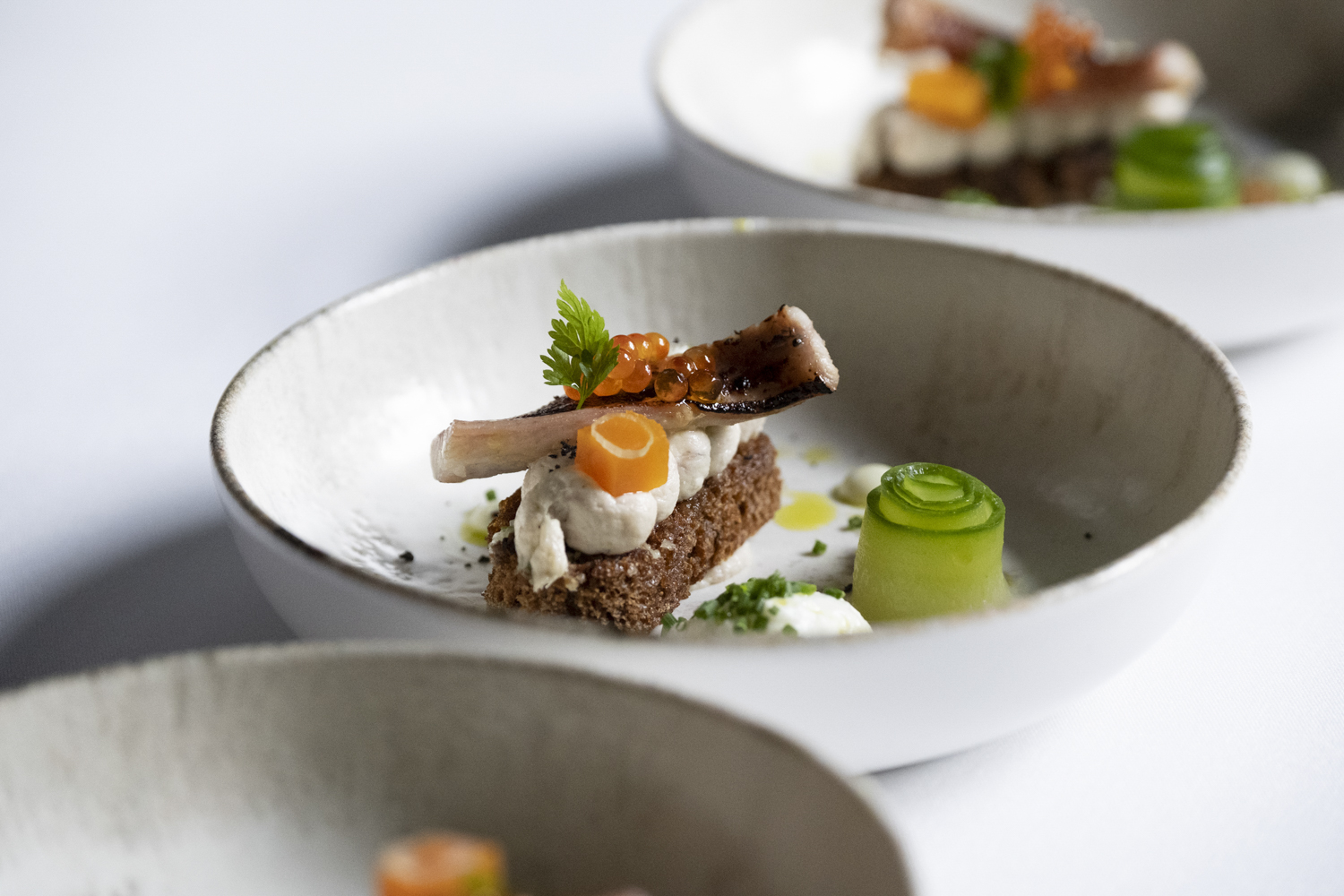
The Irish Food Writers’ Guild recently celebrated 30 years of their annual IFWG Food Awards with an event at Dublin’s Suesey Street, where the award winners’ products were used to create a stunning lunch menu for invited guests. Head chef Deniss Laskeno’s menu is given below along with the recipes, scaled down to serve four.
MENU
DRINKS RECEPTION
• Beoir Chorcha Dhuibhne, Beal Bán Ballylisk Triple Rose | Balsamic caviar | Pan de Cristal
• Aran Island Cranberry & Honey Goats' Cheese | Balsamic Bramley Apple Chutney
• Smoked Lough Neagh Eel | Velvet Cloud Sheep’s Milk Yoghurt Mousse | Dill
MAIN COURSE
• The Wooded Pig Coppa-Wrapped Monkfish | Broad Beans | Peas | Charred baby leeks | Morels
DESSERT
• Lemon Cheese Cream with Velvet Cloud Sheep’s Milk Yogurt Granita | Shortbread | Mango Ginger Gel
• Selection of Sheridans' Cheese, Crackers & Chutney
RECIPES
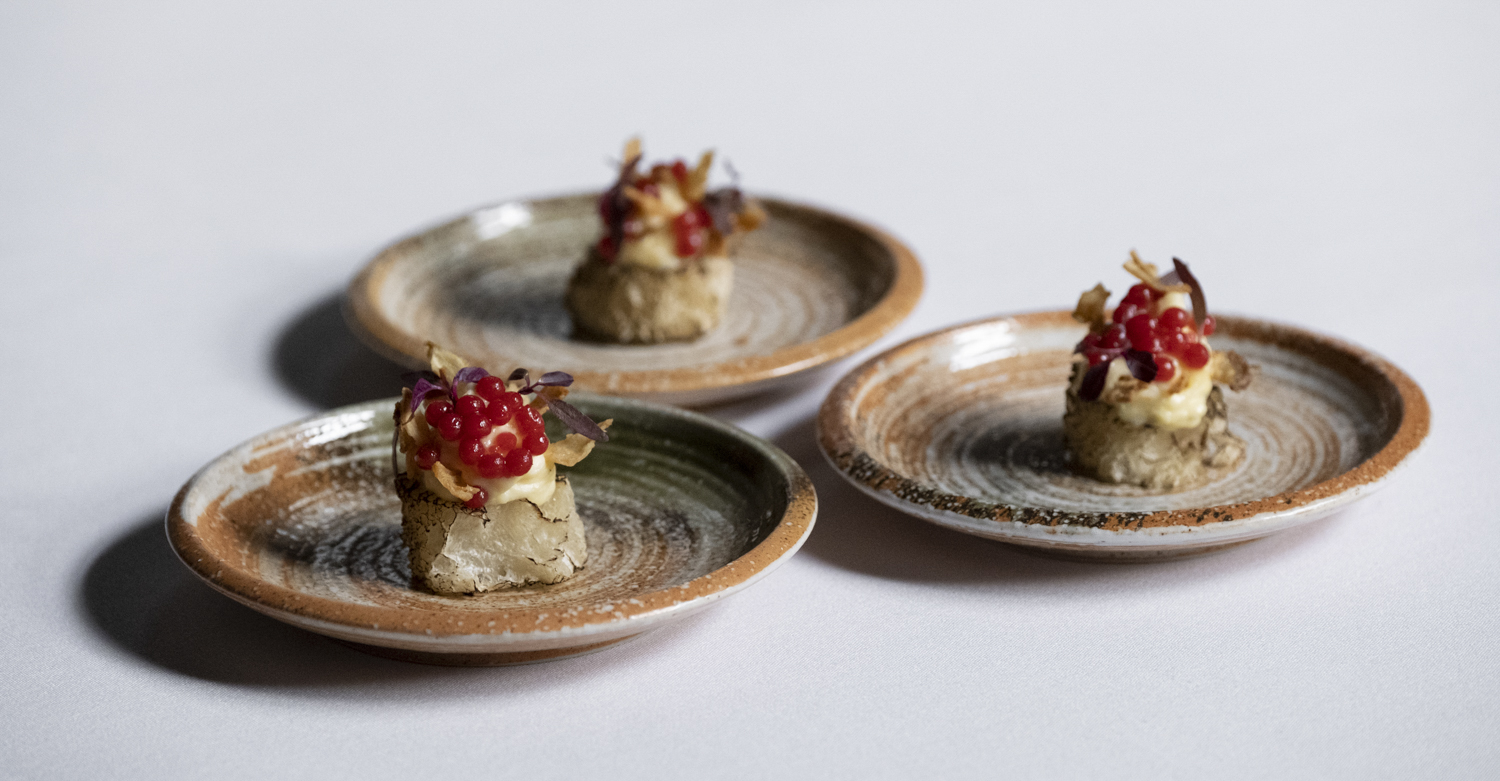
BALLYLISK TRIPLE ROSE | BALSAMIC CAVIAR | PAN DE CRISTAL
Serves 4
60g Ballyisk Triple Rose
1. Trim the cheese wheel on all sides to remove any hard or dry areas.
2. Cut the cheese into small pieces and place them in a piping bag.
3. Bring the cheese in the piping bag to room temperature by placing it in a warm spot in your kitchen or holding it in your hands for a few minutes. Gently knead the piping bag to soften the cheese and make it easier to pipe.
4. Once the cheese is soft and pliable, cut off the tip of the piping bag to the desired size and begin piping.
5. You can use the piping nozzles to add a decorative touch to crackers or bread, or to fill small pastry shells or canapés.
Balsamic caviar
• Vegetable oil, enough to fill a container for dipping
• 200g balsamic vinegar
• 50g sugar
• 1.1g agar agar
1. Start by preparing the oil. Fill a container with vegetable oil and place it in the freezer until it reaches a temperature of 4°C.
2. In a small saucepan over medium heat, reduce the balsamic vinegar by half. This should take around 10-15 minutes.
3. Once the balsamic vinegar has been reduced, add the sugar and agar agar to the saucepan. Stir well to combine.
4. Bring the mixture to a simmer and cook for 5 minutes, stirring occasionally.
5. Remove the saucepan from the heat and let it cool down for 5 minutes.
6. Once the mixture has cooled down, transfer it into a syringe or a squeeze bottle.
7. Take the container with the chilled vegetable oil out of the freezer. Slowly drip the balsamic mixture into the cold oil, forming small spheres.
8. Allow the spheres to rest in the oil for about 30 seconds, then use a slotted spoon to remove them from the oil.
9. Place the spheres onto a paper towel to drain the excess oil.
10. Repeat the process with the remaining balsamic mixture until you have created the desired amount of spheres.
11. Serve the balsamic caviar immediately as a garnish or a topping for salads, meats, or desserts.
Pan de Cristal (traditional Catalan ‘Glass Bread’)
Makes 4 medium (5” x 7”) breads.
Polish ingredients
• 100g bread flour (T665)
• 100ml warm water
• 2g active dry yeast
• 5g sugar
Bread ingredients
• 400g bread flour (T665)
• 250ml warm water
• 5g active dry yeast
• 15g olive oil
• 10g salt
• 10g sugar
1.The day before you want to make the bread, make the polish: mix all the polish ingredients until there are no lumps, cover and place in the fridge to cold-proof for 24 hours.
2. Next day, combine polish and the remaining bread ingredients in a large bowl. Mix well using a dough hook in a mixer on high speed for 20 minutes or until the mixing bowl is clean and dough is not falling off the hook.
3. Transfer the dough to a greased bowl, cover and let it proof for 45 minutes.
4. After the first proof, knead the dough for 10 seconds and let it rest for another 45 minutes.
5. Repeat the kneading and resting process twice more, for a total of three proofs.
6. Oil your hands, shape the dough into 4 medium 5” x 7” loaves and place on a well-floured French baking cloth. Proof for a further 30 minutes on the cloth.
7. Preheat the oven to 200°C and place a baking tray in the oven to heat up.
8. Transfer the dough onto the hot baking tray and place the tray in the oven.
9. Add a few ice cubes to the bottom of the oven to create steam for the first 10 minutes of baking.
10. After 10 minutes, reduce the oven temperature to 160°C and bake for another 15 minutes or until the bread is golden brown.
11. Remove from the oven, flip the loaves upside down and let cool before slicing and serving.
To assemble: Cut pan de cristal bread into 1cm slices and use a small cutting ring to cut desired canapé sizes out of the slices. Pipe Ballyisk Triple Rose on top of the bread and garnish with balsamic caviar and air-dried shallot segments.
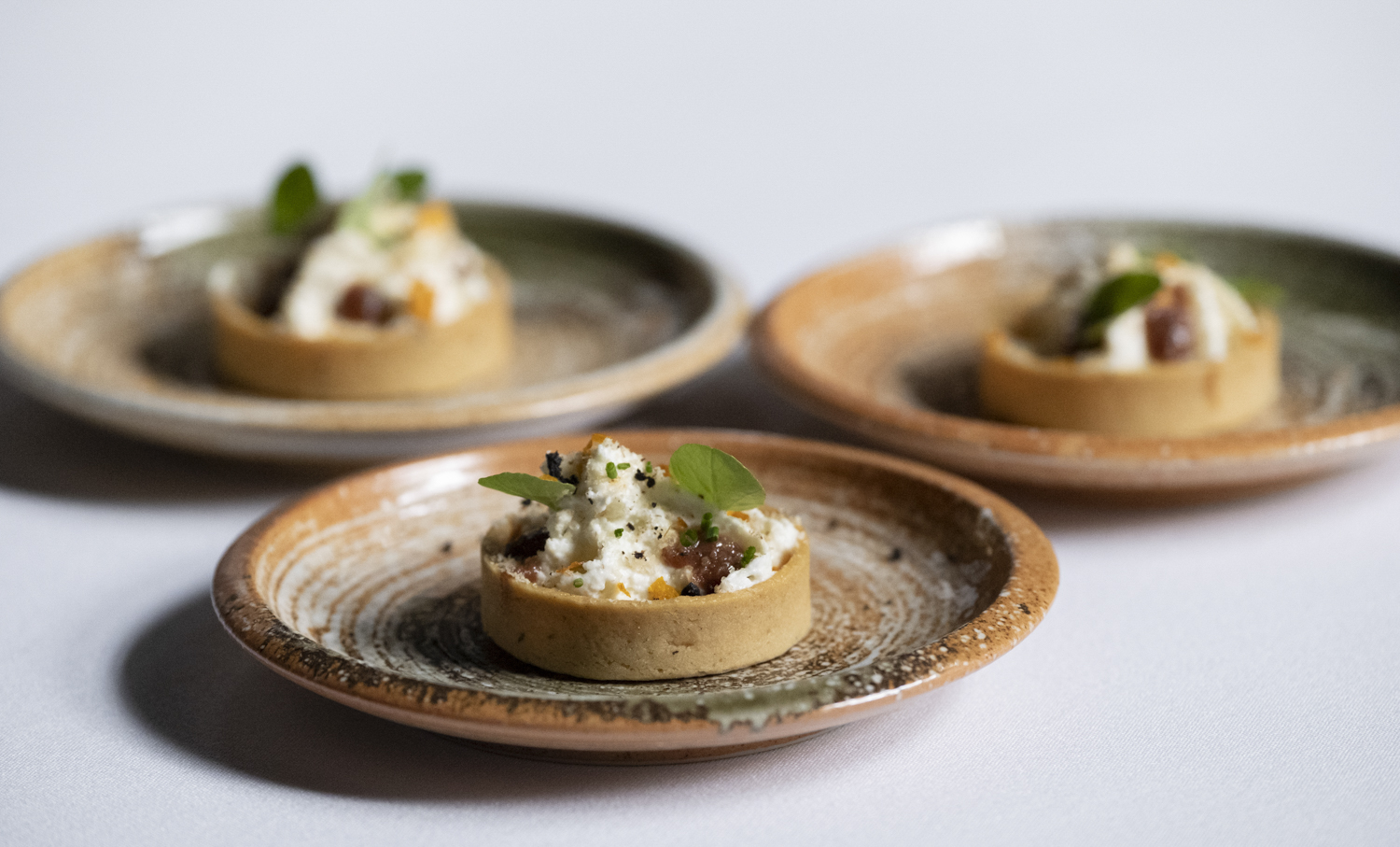
ARAN ISLAND HONEY & CRANBERRY GOATS’ CHEESE | BALSAMIC BRAMLEY APPLE CHUTNEY
Makes 12
•100g Aran Island Honey & Cranberry Goats’ Cheese
• 50g double cream
• Pinch of salt
• 50g Ballyisk Balsamic Bramley Apple Chutney
• 1 large sweet potato
• Vegetable oil for frying
1. In a mixing bowl, whisk together the Aran Island Honey & Cranberry Goats’ Cheese, double cream and pinch of salt until smooth.
2. Transfer the mixture into a siphon and charge it with 2 cartridges.
3. In a blender, blitz the Balsamic Bramley Apple Chutney until it becomes smooth. Put into piping bag.
4. Peel the sweet potato and slice into thin, skinny chips using a mandolin or sharp peeler.
5. Heat vegetable oil in a deep pan over medium heat until it reaches 150°C.
6. Fry the sweet potato chips in small batches until golden brown and crispy. Remove from the pan and place them on a paper towel to drain any excess oil.
Tartlet Shortcrust Pastry
• 250g plain flour
• 125g butter, diced and kept cool in the fridge
• Pinch of salt
• 1-3 tbsp milk or water
1. Sift the plain flour into a large bowl or the largest bowl of a food processor. Add the diced butter and either rub in with your fingertips, or, if using a food processor, pulse until until the mixture resembles fine breadcrumbs. Add the salt and mix again.
2. Gradually add the liquid by starting with 1 tbsp milk or water, then adding a little more until the mixture comes together to form a dough.
3. Tip the mixture onto a surface and gently bring it together with your hands, then shape into a disc.
4. Wrap in cling film and chill for at least 20 minutes before using.
5. Roll the dough as thin as possible on a lightly floured surface and line 12 pastry moulds or a 12-hole tart tin. Dock with a fork and chill for 1-2 hours.
6. Preheat oven to 180°C. Bake for 20-25 minutes until the pastry is golden brown.
7. Allow to cool and gently remove from the tins.
To assemble: pipe Aran Island Honey & Cranberry Goats’ Cheese into the tartlet. Dot the chutney on top and crumble sweet potato chips over the canapés.
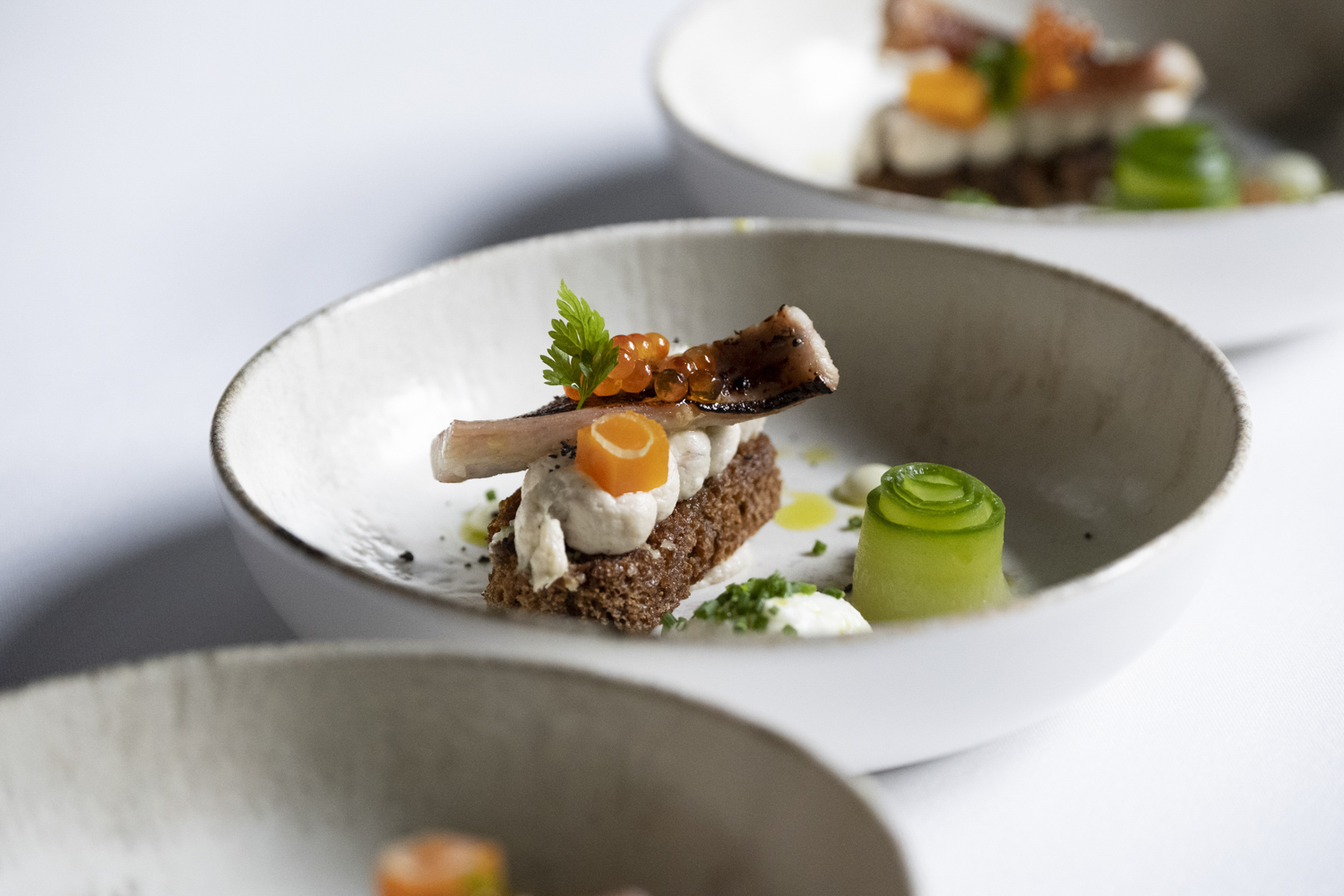
SMOKED LOUGH NEAGH EEL | VELVET CLOUD SHEEP’S YOGHURT MOUSSE | DILL
Serves 4
• 100g Smoked Lough Neagh Eel
• 2-3 tbsp wasabi yuzu
1. Trim the eel and portion it into thumb-sized portions. Brush with wasabi yuzu and lightly char with blow torch.
Smoked Eel Rillettes
• 100g smoked eel, or excess trimmings reserved
• 50g Velvet Cloud Sheep’s Milk Yogurt
• 10g fresh dill, chopped
• 10g salt
• 10g olive oil
2. Finely chop the reserved eel trimmings and set aside.
3. In a food processor, combine the sheep’s milk yogurt, chopped dill, salt, and olive oil.
4. Pulse the mixture until it is well blended and smooth.
5. Add the reserved eel trimmings and pulse a few more times until they are incorporated into the mixture.
6. Transfer the smoked eel rillettes to a bowl and refrigerate for at least 30 minutes to allow the flavours to meld together.
Garlic Oil
• 1 head of garlic
• Chive trimmings
• 10-20g each fresh parsley and dill
• ½ cup of neutral oil (such as vegetable or canola oil)
1. Preheat oven to 180°C.
2. Remove any loose outer layers of skin from the garlic. Place it in a baking dish and roast in the preheated oven for 20 minutes.
3. Once the garlic is done roasting, remove it from the oven and let it cool until you can handle it.
4. Cut off the stem of the garlic and squeeze out the garlic cloves into a blender.
5. Add chive trimmings and fresh herbs such as parsley and dill (if available) to the blender.
6. Pour oil into the blender.
7. Blitz the mixture until smooth.
8. Pass the mixture through a fine sieve to remove any solids.
9. Transfer the garlic oil to a clean jar or bottle, and store in the refrigerator for up to 2 weeks.
Sheep’s Milk Yogurt Mousse
• 100g Velvet Cloud Sheep’s Milk Yogurt
• 5g salt
• 1g white pepper
1. In a mixing bowl, combine the sheep’s milk yogurt, salt, and white pepper.
2. Mix the ingredients well until the mixture is smooth and uniform in texture.
3. Transfer the mixture into a siphon or whipped cream dispenser.
4. Charge the siphon with 2 whipped cream chargers according to the manufacturer's instructions.
5. Shake the siphon vigorously for a few seconds to distribute the gas throughout the mixture.
6. Chill the siphon in the refrigerator for at least 30 minutes or until the mixture has set.
Rye Bread
• 16g active dry yeast
• 600ml warm water
• 150ml molasses
• 1 teaspoon caraway seeds
• 1 tablespoon salt
• 4 tablespoons vegetable oil
• 35g cocoa powder
• 240g rye flour
• 600g bread flour
1. Dissolve the yeast in the warm water with the molasses. Put yeast mixture into a large metal bowl. Add the caraway seeds, salt, vegetable oil, cocoa powder, rye flour and then 240g of the bread flour, mixing into the yeast mixture.
2. Add more bread flour, a cup at a time, until the dough is not so sticky, and it is too hard to mix it with the spoon. At that point, spread a half cupful of flour onto a large, clean, flat surface and put the dough onto the surface.
3. Knead additional bread flour into the dough until it reaches the right consistency. Knead for 5-7 minutes, or until the dough is smooth and elastic.
4. Spread some vegetable oil around a large bowl and place the dough in it, turning it so it gets coated in the oil.
5. Cover the bowl with plastic wrap or a damp cloth. Let rise at room temperature until it has doubled in size, 1 to 1 1/2 hours.
6. Gently press down on the risen dough so some of its air is released. Turn the dough out onto a lightly floured surface, knead the dough a few turns and then divide it by cutting it in half with a sharp knife.
7. Shape each half into a loaf. Place loaves into an oiled 8x4-inch loaf tin. Let the bread rise again, this time not doubling in volume, but rising by about half.
8. Pre-heat oven to 180°C. Bake for 40-50 minutes, or until done. The bread should sound hollow when tapped.
Sweet Dill Pickled Cucumber
• 2 medium-sized cucumbers
• 100g white vinegar
• 100g water
• 100g granulated sugar
• 100g fresh dill
• 10g salt
1. Wash and thinly slice the cucumbers using a mandolin or peeler.
2. In a small pot, mix together the vinegar, water, and sugar. Bring the mixture to a boil over medium-high heat, stirring occasionally to dissolve the sugar.
3. Once the sugar has dissolved and the mixture has come to a boil, remove the pot from the heat and add in the fresh dill. Stir well.
4. Place the sliced cucumbers into a clean jar or container that can be sealed. Pour the hot pickling mixture over the cucumbers, making sure they are completely submerged.
5. Let the pickled cucumbers cool to room temperature before sealing the container and refrigerating for at least 30 minutes before serving.
6. The pickled cucumber can be stored in the refrigerator for up to 2 weeks.
To assemble: cut rye bread to desired shape. Lightly toast on the pan. Place toasted bread in a bowl and season with salt, chives and garlic oil. Toss to coat. Pipe some smoked eel rillettes on the bread. Place smoked eel on top and garnish with sea trout caviar and sweet dill pickled cucumber.
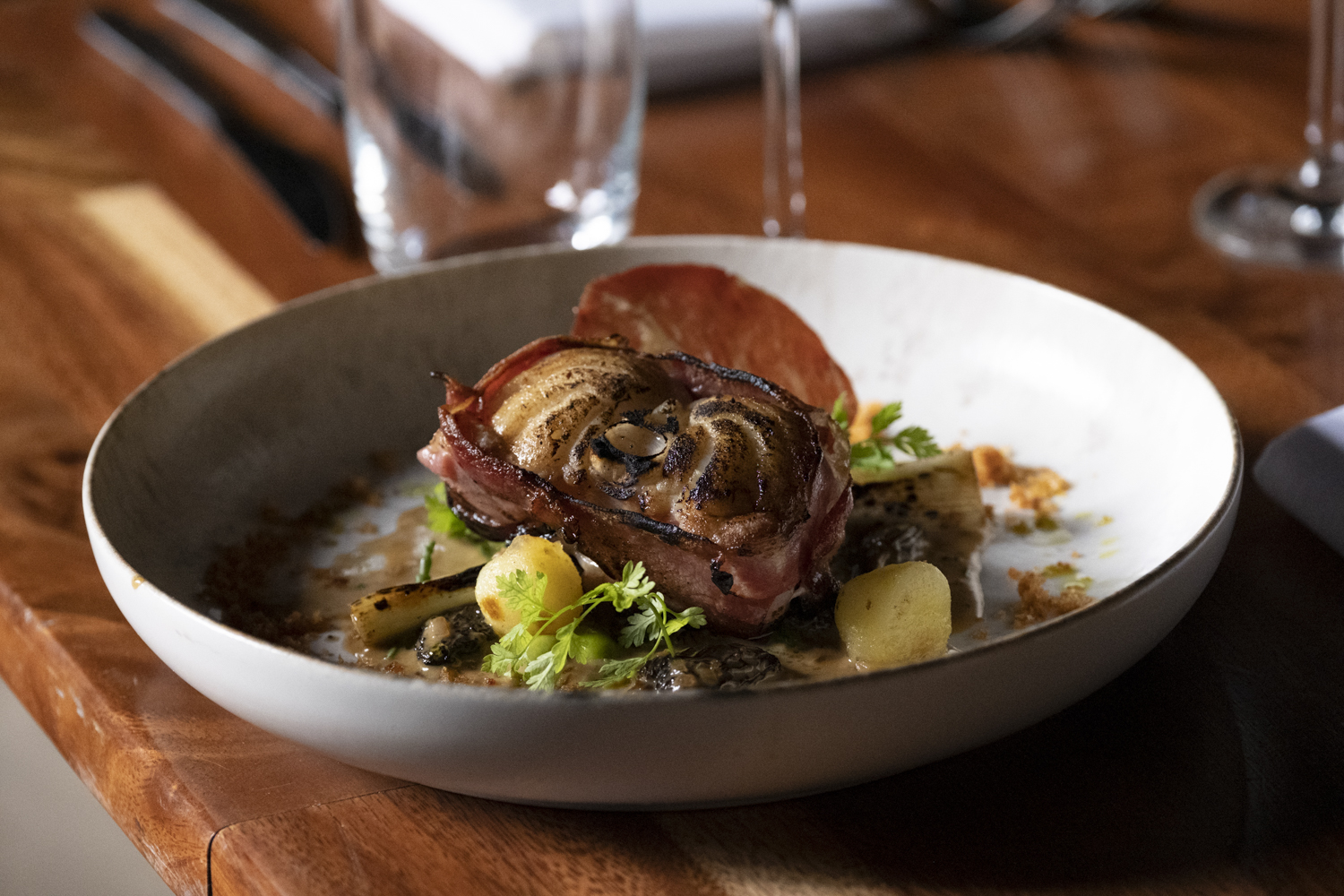
THE WOODED PIG COPPA-WRAPPED MONKFISH | BROAD BEANS | PEAS | CHARRED BABY LEEKS | MORELS
Serves 4
• 800g monkfish
• 100g-120g The Wooded Pig Coppa
Brine Ingredients
• 60g granulated sugar
• 30g salt
• 15g light brown sugar
• 1 litre water
• 2g ground black pepper
• 1g garlic powder
• 10g Worcestershire sauce
•1 fresh bay leaf
1. To get your monkfish ready for brining, trim the tail, hold the skin with a towel in your hand, and pull it from the flesh like you would remove your socks.
2. Place all ingredients for brine in a large pot and bring to the boil.
3. Remove from the heat and allow to cool completely.
4. Submerge monkfish in brine and leave in fridge for 24 hours.
5. After removing monkfish from the brine, wash in ice cold water for a few minutes. Pat dry and place in the fridge to air-dry for 2-5 hours.
6. Wipe down the workstation with a damp cloth to keep the surface slightly wet. This will help the cling film to stick to the table, preventing it from sliding around as you work.
7. Place a layer of cling film onto the working surface, ensuring that it covers the surface completely. Lay an even layer of coppa on top of the cling film, making sure that it is at least twice as wide as the thickness of your fillet. This will ensure that the coppa evenly covers the entire fillet.
8. Using the clingfilm, carefully roll the coppa and fillet into a tight roulade, being sure to squeeze out any excess air as you go. Once you have rolled it to your liking, tie off both ends tightly.
9. Steam at 63°C for 7 minutes. Once it has been cooked, place it into a bowl of ice water to stop the cooking process. When it has cooled, cut into four portions.
Morel Sauce
• 100g fresh morels
• 10g butter
• 10g garlic, finely diced
• 10g shallots
• 100ml Madeira
• 10g salt
• 2g black pepper
• 100ml double cream
1. Start by cleaning the morels with a soft brush to remove any dirt or debris. Cut off the bottom part of the stems if they are tough and discard.
2. Heat a saucepan over medium heat and melt the butter. Add the diced garlic and shallots and sauté until softened and fragrant.
3. Deglaze the pan with Madeira and bring to a boil, stirring occasionally.
4. Add the cleaned morels to the pan and stir to coat them in the sauce. Season with salt and black pepper.
5. Pour in the double cream and reduce the heat to low. Simmer the sauce for about 5-7 minutes, stirring occasionally, until it has thickened and reduced by half.
6. Once the sauce has thickened, remove the pan from the heat and let it cool for a few minutes.
7. Transfer the morel sauce to a blender and blend until smooth. If the sauce is too thick, you can add a little water or more cream to thin to your desired consistency.
Vegetables
• 150g peas, blanched and refreshed
• 150g broad beans, blanched and refreshed
• 12 baby leeks, trimmed, blanched and refreshed
• A little white wine
• Half of a lemon
• Butter
• Olive oil
1. Preheat the oven to 180°C.
2. Pan fry the monkfish portions to a golden colour on a hot pan, ensuring a delightful sear on all sides.
3. Carefully transfer monkfish to an oven tray and add a drizzle of lemon, a splash of white wine, and a dollop of butter on top of each piece.
4. Place the monkfish in the oven and cook for 7-10 minutes, depending on the size of the fish. We aim to reach a temperature of 73°C, probing the fish close to the bone to ensure the entire piece is cooked to perfection.
5. Reheat the broad beans and peas in a sizzling sauté pan over medium high heat with a touch of butter or olive oil and season them with salt.
6. We prefer to char our baby leeks over an open flame, but feel free to use your preferred method of cooking.
To assemble: place morel sauce on the plate and lay vegetables on top. Finish with the coppa-wrapped monkfish and delicate, fresh microgreen leaves.
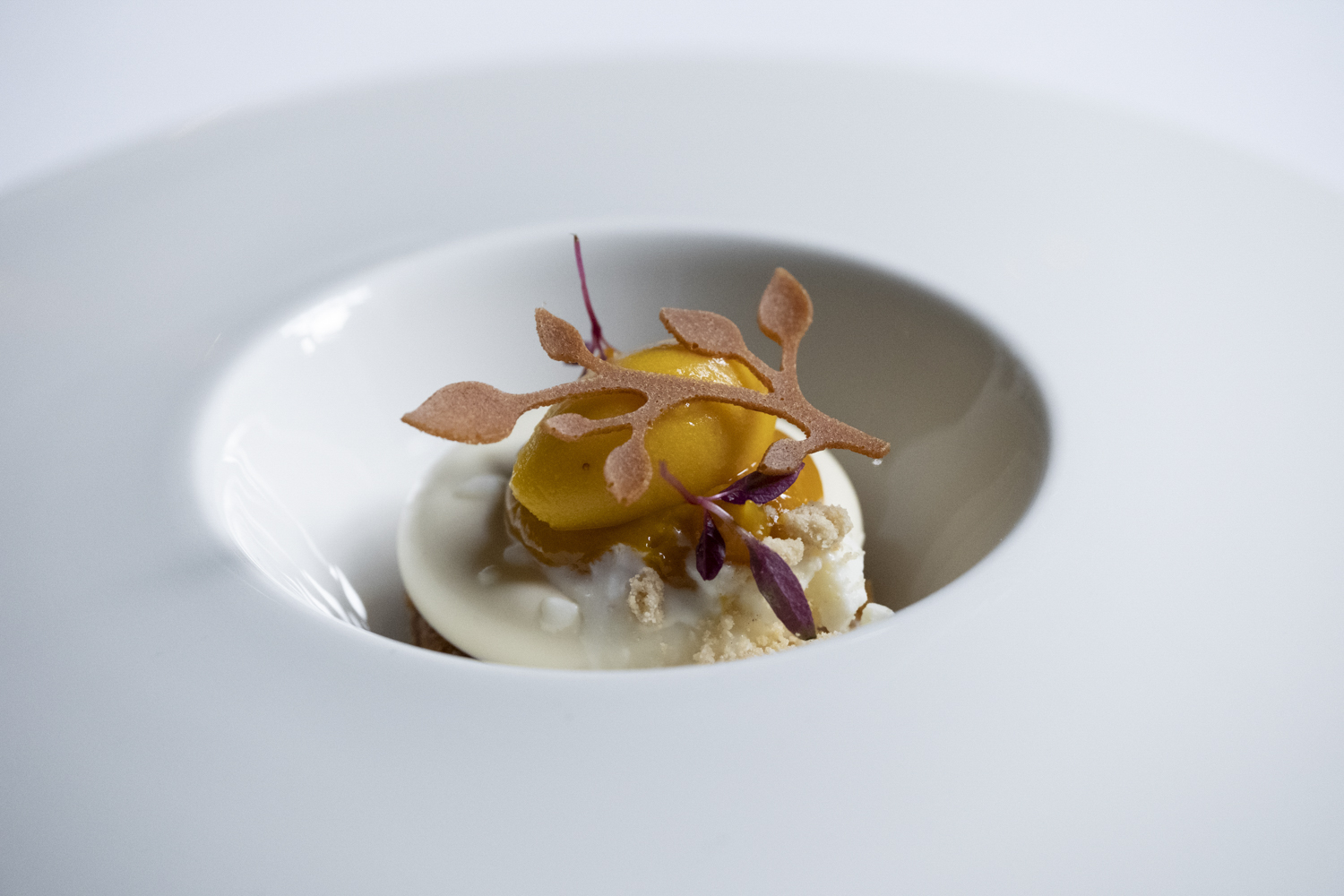
LEMON CHEESE CREAM WITH VELVET CLOUD SHEEP’S MILK GRANITA | SHORTBREAD | MANGO GINGER GEL
Serves 4
• 75g icing sugar
• 150g Ballylisk Triple Rose
• 130g cream cheese
• 60ml lemon juice
• Zest of 1/2 lemon
• ½ vanilla pod
• 2 gelatine sheets
• 150g double cream
• 80g white chocolate
1. Combine icing sugar, Ballylisk Triple Rose, cream cheese, lemon zest and juice in a bowl.
2. Bloom the gelatine sheets in cold water for 5-10 minutes.
3. Bring cream to the boil and pour it over chocolate. Add gelatine while it is still warm and mix.
4. Add cheese mixture, stir well and pour into 4 moulds.
Carrot Base
• 200g gluten free flour
• 10g bicarbonate of soda
• 1 tbsp mixed spices
• 1 tbsp cinnamon
• 140g eggs - approx 3 medium eggs
• 200g caster sugar
• 140g sunflower oil
• 200g cranberries, blitzed into smaller pieces
• 400g finely grated carrots
• 120ml lemon juice
• 100ml dark rum
• 1 tbsp vanilla extract
1. Preheat oven to 170°C. Oil and line a 23 x 23cm square tin with baking parchment.
2. Sift flour, bicarbonate of soda and spices into a bowl.
3. Place eggs and sugar in a stand mixer bowl. Mix on high speed until pale.
4. Add oil and mix at a slower speed until combined. Add cranberries, carrots, lemon juice, rum and vanilla.
5. Finish by folding in dry ingredients.
6. Spread into tin and bake for 12 minutes.
Mango Ginger Gel
• 20g sugar
• 2g agar agar
• 200g mango purée
• 20g lemon juice
• v1 teaspoon fresh ginger, grated on microplane
1. Combine sugar with agar agar in a small saucepan, add in mango pureé and lemon juice.
2. Bring to a boil while constantly stirring. Boil for 2 minutes.
3. Pour on a tray, cool down completely and blitz.
Shortbread Crumble
• 150g gluten free flour
• 100g butter
• 50g sugar
• 1 teaspoon vanilla
• ½ teaspoon cinnamon
1. Preheat oven to 170°C.
2. Butter and line a baking tin with baking parchment.
3. Add all ingredients to a stand mixer bowl and beat until combined. Spread on baking tin.
4. Bake for 15-20 minutes until golden.
Velvet Cloud Sheep’s Milk Granita
• 300ml Velvet Cloud Sheep’s Milk Yogurt
• 100g icing sugar
• 50ml lime juice
• 1 tsp honey
1. Whisk all ingredients together. Spread on a tray and put in the freezer.
2. Every 10-15 minutes, take out of the freezer and use a spoon to scrape it into small shards.
To assemble: cut carrot base into desired shape. Top with lemon cheese cream, granita, shortbread crumble and mango ginger gel.
Cookery Feature - PARADISO PLATES
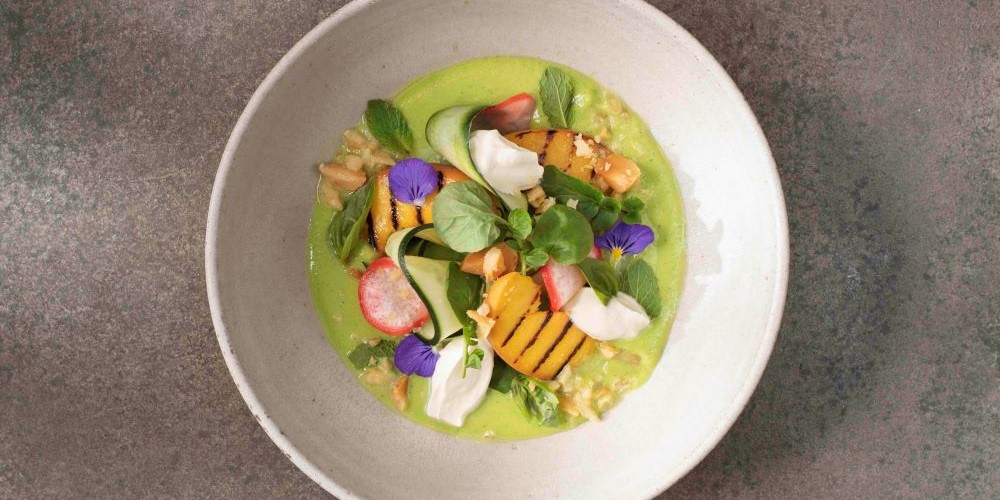
.jpg) Ground breaking, inspirational, ever-evolving, respectful of the vegetable kingdom (both plants and producers), responsible, sustainable, bold, beautiful, deeply-flavoured, different and oh-so-enjoyable - these are the kind of thoughts that crowd the mind when the acclaimed chef Denis Cotter or his wonderful restaurant Paradiso are mentioned. And how lucky are we to have accumulated so many memories since they hit the Cork restaurant scene in 1993.
Ground breaking, inspirational, ever-evolving, respectful of the vegetable kingdom (both plants and producers), responsible, sustainable, bold, beautiful, deeply-flavoured, different and oh-so-enjoyable - these are the kind of thoughts that crowd the mind when the acclaimed chef Denis Cotter or his wonderful restaurant Paradiso are mentioned. And how lucky are we to have accumulated so many memories since they hit the Cork restaurant scene in 1993.
So, a new book from Denis is always hugely welcome– this is his fifth, the last was 12 years ago – but this one is very special. As pandemic projects go, it’s pretty epic - and the forward-looking tone may be a surprise after three decades in business, when a little nostalgia might be expected. But standing still, or even slowing down, is not in the script at Paradiso, where it’s all about evolution.
Anyone who remembers Café Paradiso, as it was then, in the mid-‘90s will recall the excitement. Leaving early and making only the briefest of stops on the way, we used to sweep down to Cork from Dublin with hope and a happy hunger in our hearts, on a mission to get to Paradiso in time for a late week lunch.
It was light years ahead of its time, turning out gorgeous deeply flavoursome vegetarian food that was totally itself, without any of the deference to meat cookery that was the norm in vegetarian meals at the time – and has become so much more prevalent of late with the introduction of fakery on an industrial scale in the commercial plant-based processed food market.
But, going far beyond a stated ambition to create food that could stand up for itself when compared to the ‘normal’ dining experience, Denis Cotter’s vision was also way ahead of the curve when it came to sustainability and working with the seasons and local producers, especially Ultan Walsh and Lucy Stewart of Gortnanain Farm near Kinsale – an enduring partnership that has attracted much well-earned praise for Paradiso, most famously a ‘Big Plate’ Collaboration of the Year award at the inaugural World Restaurant Awards in 2019 that has helped to bring their philosophy to a much wider audience.
.jpg) For the most part though, Denis Cotter has just been getting on quietly exercising his originality with a changing but equally inspired team. And, as Cork-born actor Cillian Murphy - a fan since Café Paradiso opened in 1993 – said in his Foreword, ‘…while the atmosphere, the warmth and the welcome have never changed at Café P, the food has developed, advanced and evolved to make it one of the greatest places to eat in the world’.
For the most part though, Denis Cotter has just been getting on quietly exercising his originality with a changing but equally inspired team. And, as Cork-born actor Cillian Murphy - a fan since Café Paradiso opened in 1993 – said in his Foreword, ‘…while the atmosphere, the warmth and the welcome have never changed at Café P, the food has developed, advanced and evolved to make it one of the greatest places to eat in the world’.
For the hands-on cook and anyone with an interest in the mechanics of running a restaurant (or creating stunning dishes for an anxiety-free dinner party), Paradiso is fascinating at a different level, as Denis reveals the working pattern of the day and the secrets of success in a busy kitchen. Recently – and here you get a sense of the forward-looking momentum - this has included a change of direction from à la carte menus to a range of plates (mainly small or starter size), that can be served alone or in menus of a series of courses - a very practical development that allows for a huge amount of flexibility in service.
Key to kitchen management is the morning prep work, which provides the ready-made pieces of the jigsaw that make everything possible during service. This is all covered in an extensive Core Elements section, with recipes for myriad essential elements that contribute to creating the deep umami flavours and complementary textures that make this vegetarian cooking so exciting, including ‘Crunchy Stuff’, Pickles and Sauces (ambient and hot), Dressings oils and butters, Pulses and Dairy Alternatives – the latter a reminder that many dishes are vegan friendly and, while dairy still features (notably the best of local cheeses), alternatives are now being used more.
Home cooks will relish Paradiso as a fascinating, practical celebration of vegetable-based cooking and a terrific read, and – importantly – chefs, and budding chefs, will find it a source of great inspiration. Bringing together its past, its present and its future in one seriously relevant package, this timely book encapsulates the essence of Paradiso.
Paradiso: Recipes & Reflections by Denis Cotter, a 216-page hardback cookbook featuring a collection of over 160 recipes with beautiful photography by Ruth Calder-Potts, on sale at ninebeanrowsbooks.com and at Paradiso in Cork City, €39. Also in bookshops from September 2023.
A SEASONAL TASTE OF PARADISO - SAMPLE RECIPES TO TRY:
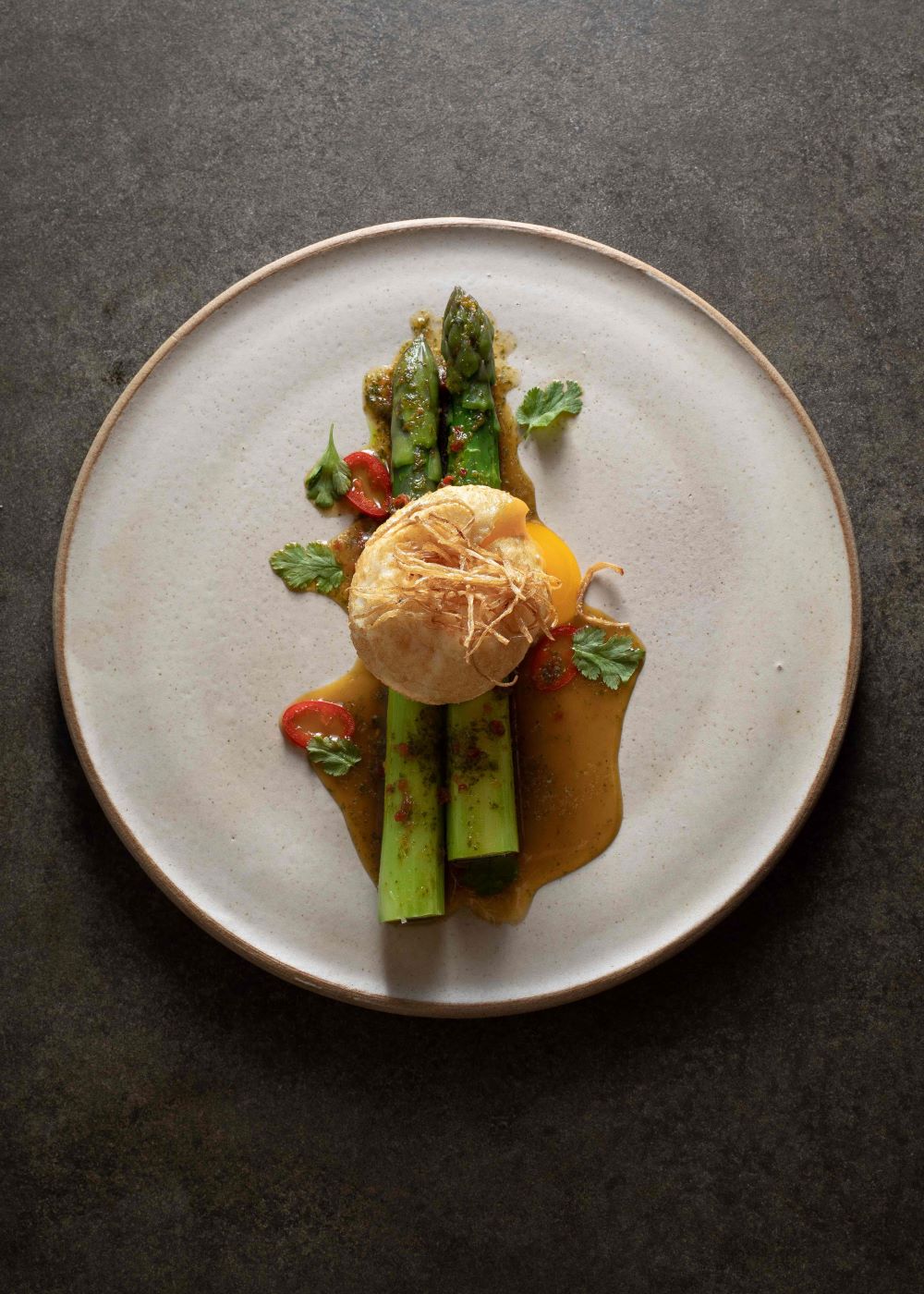 Asparagus, deep-fried egg, coriander, chilli, lime, crisped shallots Serves 4
Asparagus, deep-fried egg, coriander, chilli, lime, crisped shallots Serves 4
20g caster sugar
100ml lime juice
zest of 1 lime
1 fresh red chilli, deseeded
1 tablespoon grated fresh ginger
2 teaspoons soy sauce
12 fat asparagus spears
Deep-fried egg:
4 eggs, at room temperature
1 tablespoon garam masala
To finish:
crisped shallots
1 fresh red chilli, deseeded and thinly sliced
coriander leaves
Dissolve the sugar in the lime juice, then blend this with the lime zest, chilli, ginger and soy sauce.
Bring a pot of water to a boil and carefully lower in the eggs. Simmer for 3 minutes 40 seconds, then remove the eggs to a bowl of iced and salted water to stop the cooking. Leave for 20 minutes to cool. Shatter the eggshells by tapping them all over with the back of a spoon, then carefully peel and discard the shell.
Snap the ends off the asparagus spears. Bring a pot of salted water to a boil and drop in the asparagus to blanch for 3–4 minutes, until just tender. Remove and drain on kitchen paper.
At the same time, heat the oil in a deep-fryer to 200°C. Fry the eggs, two at a time, for 1 minute, until they are beginning to colour and crisp. (Accurate timing and some practice are vital to get perfect deep-fried eggs!) Remove to dry on kitchen paper, then roll the eggs in a light dusting of garam masala.
To serve, place the asparagus spears close together on plates with a deep-fried egg on top. Spoon over some of the dressing followed by a sprinkling of crisped shallots, sliced chilli and coriander leaves.
Crisped shallots (from Core Elements section) Makes 8–12 portions as a garnish
2–3 large banana shallots, thinly sliced and separated
Heat some vegetable oil in a deep-fryer to 160°C. Working in batches, add a handful of shallot slices to the fryer and cook, stirring constantly, until they begin to turn golden. Remove the cooked slices, scatter on a tray lined with kitchen paper and sprinkle with a little salt. Repeat with the remaining shallot slices.
The cooked slices will crisp as they cool but if they are not fully crisp when cooled, place them in an oven at 50°C fan for 1 hour to dry out. Keeps for a week or two in a dry airtight container lined with kitchen paper.
Paradiso: Recipes and Reflections by Denis Cotter is published by Nine Bean Rows (€39)
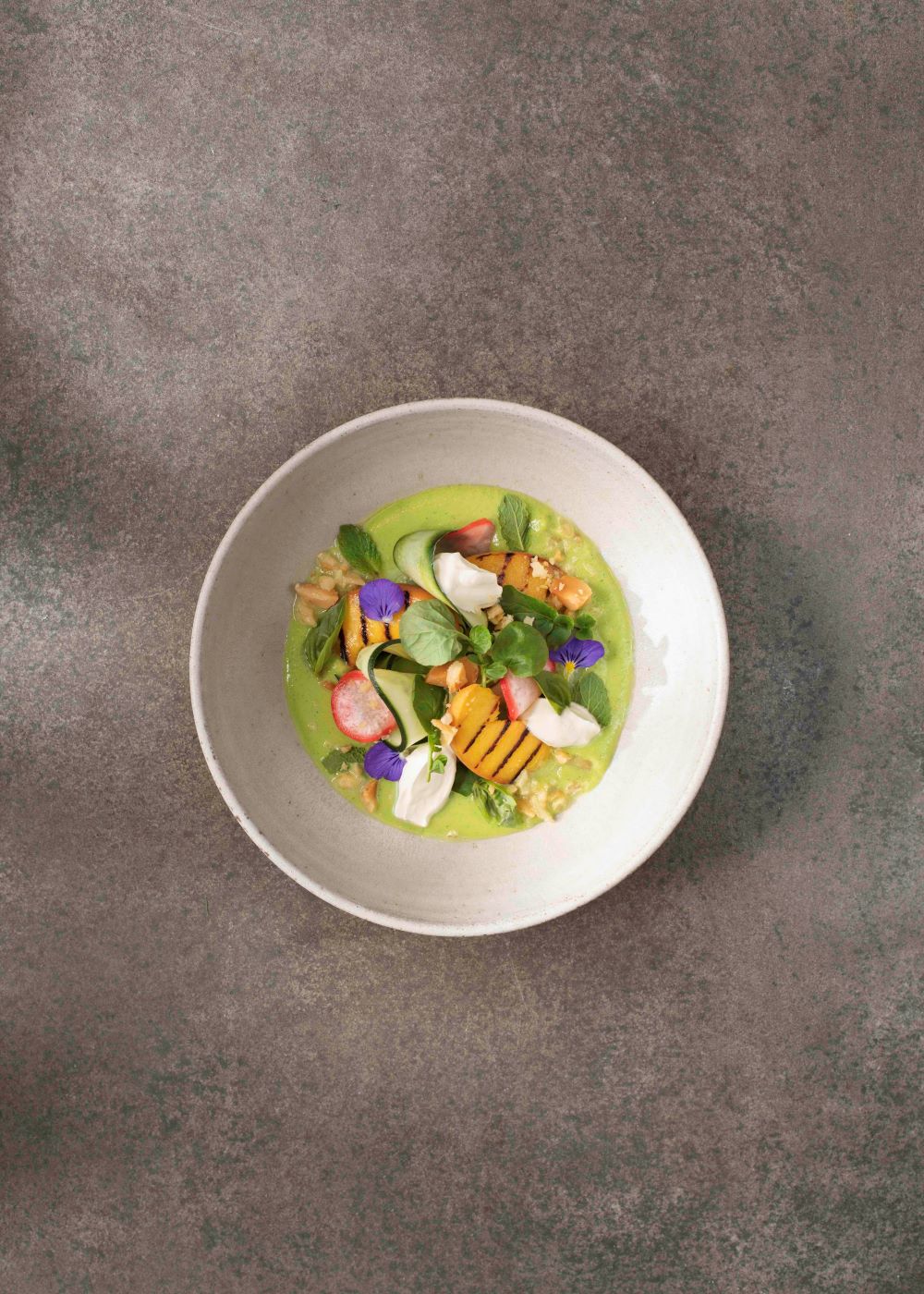 Grilled peach, cucumber, pickled radish, sheep’s milk labneh, mint, watercress, macadamia Serves 4
Grilled peach, cucumber, pickled radish, sheep’s milk labneh, mint, watercress, macadamia Serves 4
Sheep’s milk labneh:
250g sheep’s milk yogurt
Cucumber purée:
1 medium cucumber, peeled and deseeded
½ ripe avocado
1 spring onion, chopped
1 small garlic clove, chopped
50ml olive oil
juice of ½ lime
Grilled peach salad:
1 cucumber
2 peaches
50g watercress
a handful of fresh mint and/or basil leaves
12 macadamia nuts, lightly toasted and halved
To finish:
12 pickled radish slices
To make the labneh, strain the yogurt by placing it in muslin or cheesecloth put in a strainer set over a bowl and leaving it in the fridge overnight. Discard the liquid and lightly whisk the remaining labneh.
To make the cucumber purée, blend everything together in a food processor until very smooth. Add a little water if required. Pass the purée through a sieve. Season with salt and chill the purée for at least 1 hour. Before serving, check the seasoning again and add more salt and lime if necessary.
To make the grilled peach salad, use a peeler to get long, wide strips of cucumber. Toss these in a little salt and leave for 10 minutes, then rinse and drain. Cut the peaches in half, remove the stones and cut each half into three wedges. Brush the cut sides lightly with olive oil and grill on a heavy-based frying pan or griddle until blackened.
To finish, spoon some cucumber purée into a shallow bowl. Arrange all the salad ingredients in the centre, garnish with the pickled radish slices and add little spoonfuls of labneh.
Pickled radish (from Core Elements section)
This is a quick pickle that needs to be used the same day. Used pickling liquid can be used once or twice more. Makes 6–10 portions
8–10 fresh radishes
60g caster sugar
125ml white wine vinegar
25ml water
1cm piece of fresh ginger, peeled and sliced
2 lime leaves
¼ tablespoon salt
½ teaspoon yellow mustard seeds
Trim the radishes, slice them into 3mm-thick rounds and place in a heatproof bowl.
Bring the rest of the ingredients to a boil in a small pot and pour enough of the hot liquid over the sliced radishes to cover them. Leave for 5 minutes, then remove the radishes from the liquid and leave to cool to room temperature before serving.
Paradiso: Recipes and Reflections by Denis Cotter is published by Nine Bean Rows (€39)
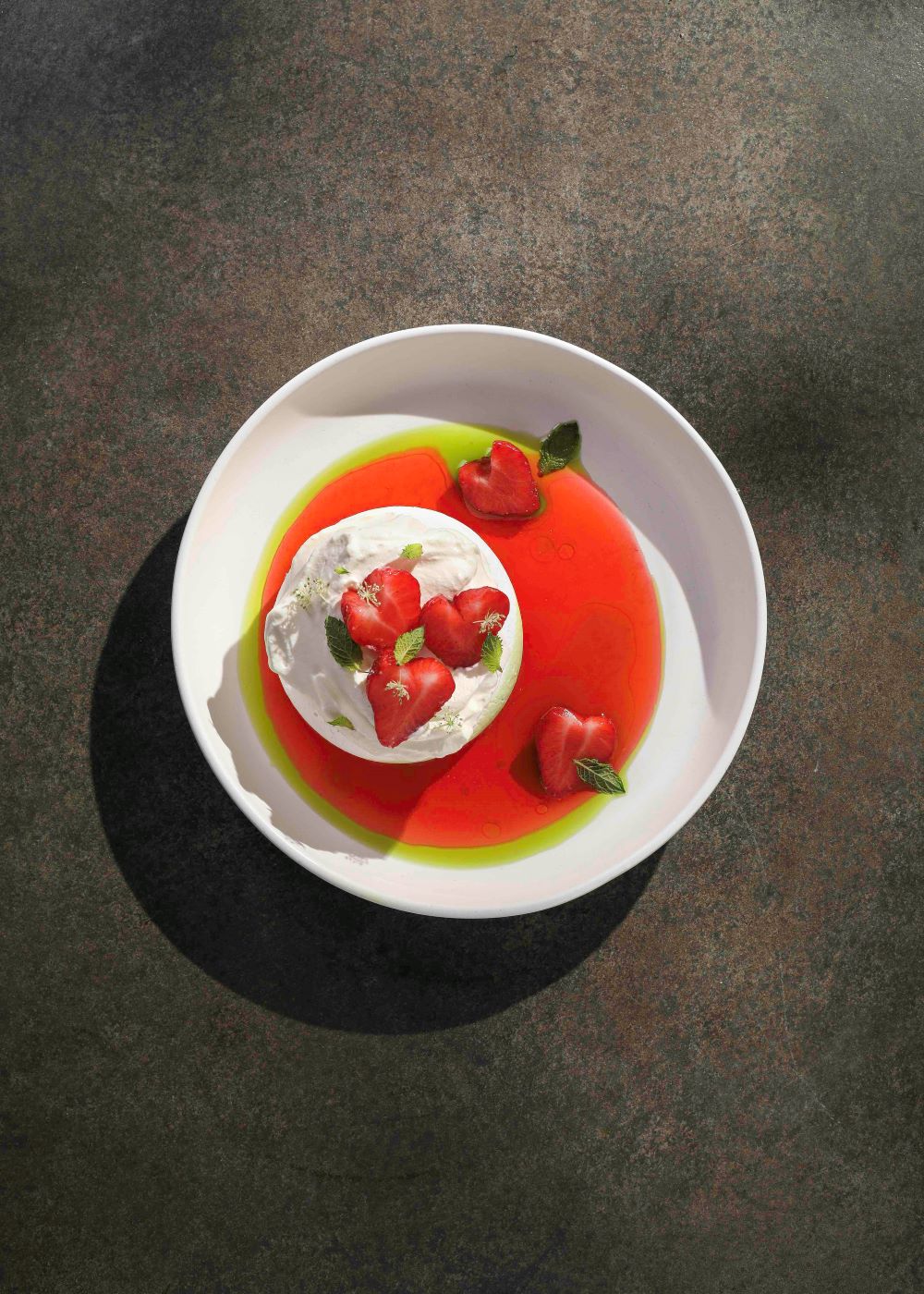 Strawberry & elderflower pavlova Serves 6
Strawberry & elderflower pavlova Serves 6
Pavlovas:
120g egg whites
220g caster sugar, divided
1 teaspoon cornflour
1 teaspoon white wine vinegar
Strawberry consommé:
300g strawberries, chopped
60g caster sugar
Elderflower cream:
200ml cream
20g caster sugar
1 teaspoon elderflower cordial
To finish:
18–20 strawberries, halved or quartered
basil oil (see below)
edible flowers
To make the pavlovas, preheat the oven to 130°C fan.
Whip the egg whites to soft peaks, then slowly add 170g of the sugar, beating in 1 tablespoon or so every 30 seconds at first, then 2 tablespoons at a time until all 170g has been used.
Mix together the remaining 50g sugar and the cornflour. Add this to the whipping meringue, 2 tablespoons at a time. Scrape down the sides of the bowl, add the vinegar and continue whipping for 5 minutes. Put the meringue in a piping bag.
Line an oven tray with parchment. Lightly oil a 7cm metal ring and place it on the parchment. Pipe some meringue into the ring, filling it and swirling the top to get a flat-ish top. Lift off the ring, wipe it clean, oil it again and repeat to make six pavlovas in total.
Place the tray in the oven and bake for 12 minutes, then lower the heat to 80ºC fan and bake for 12 minutes more. Turn off the heat and leave for another 12 minutes. Finally, open the oven door and leave for 12 minutes. Remove the pavlovas from the oven and leave to cool completely. Use a palette knife to carefully remove the pavlovas from the tray.
To make the strawberry consommé, put the strawberries and sugar in a metal bowl and seal the top. Place over a pot of boiling water for 40 minutes to soften the fruit. Transfer the fruit mix to a sieve lined with cheesecloth and strain over a bowl for 2 hours, retaining the liquid.
To make the elderflower cream, whip the cream with the sugar, adding the elderflower cordial at the end.
To serve, place a pavlova on each plate with the flatter side up. Top with elderflower cream and halved or quartered strawberries, then pour a thin pool of strawberry consommé around the pavlova. Add a small amount of basil oil around the edge of the consommé, then scatter over a few mint leaves and edible flowers.
Basil oil (from Core Elements section) Makes 200ml
100g fresh basil
200ml olive oil
Blanch the basil in boiling water for a few seconds, then immediately remove it and cool it in iced water. Leave on kitchen paper to dry, then blend with the olive oil. Leave for 1 hour before straining out the solids. Keeps for three or four days. For coriander oil, simply replace the basil with fresh coriander and proceed as above.
Paradiso: Recipes and Reflections by Denis Cotter is published by Nine Bean Rows (€39)
Cookery Feature - Taste Causeway
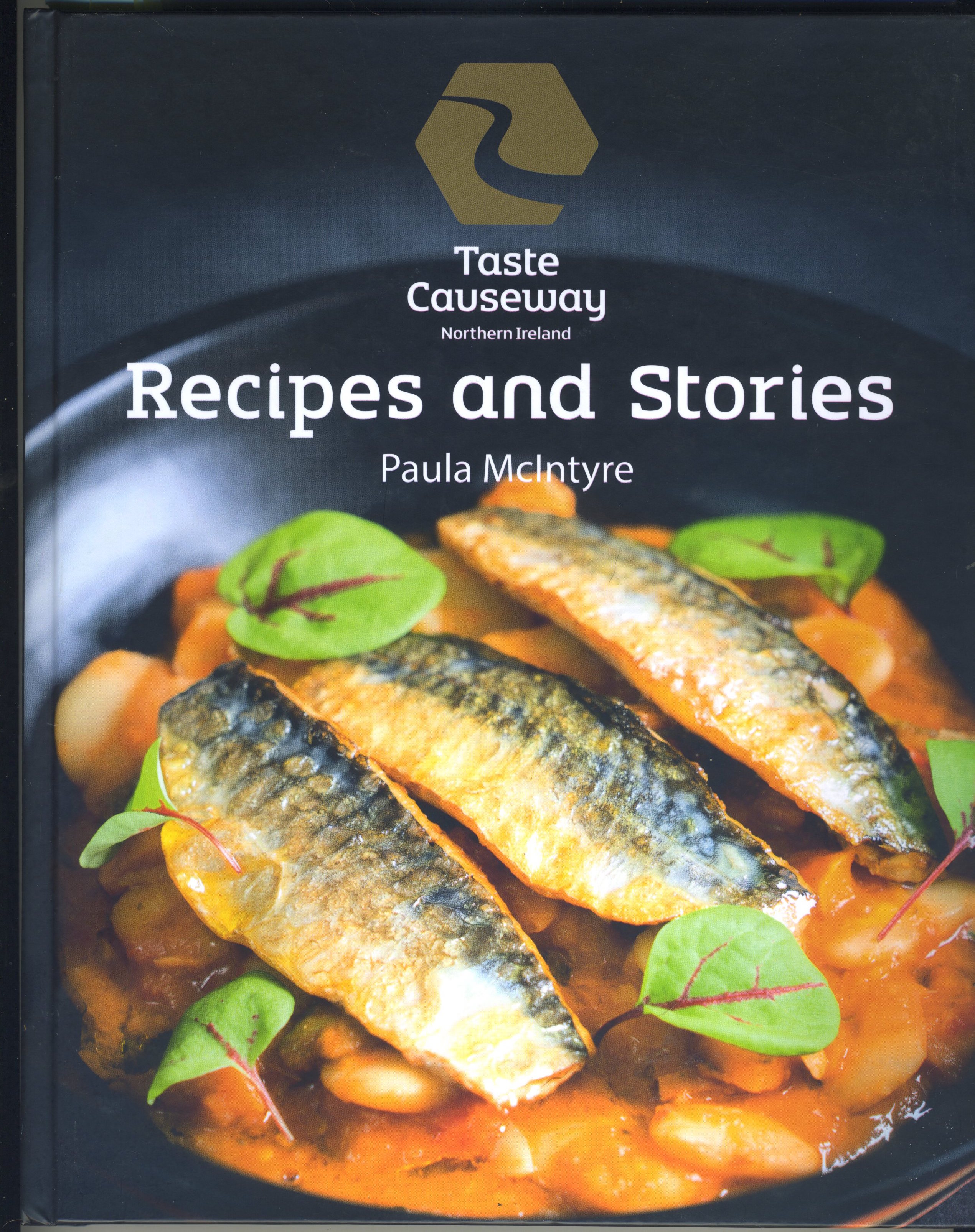
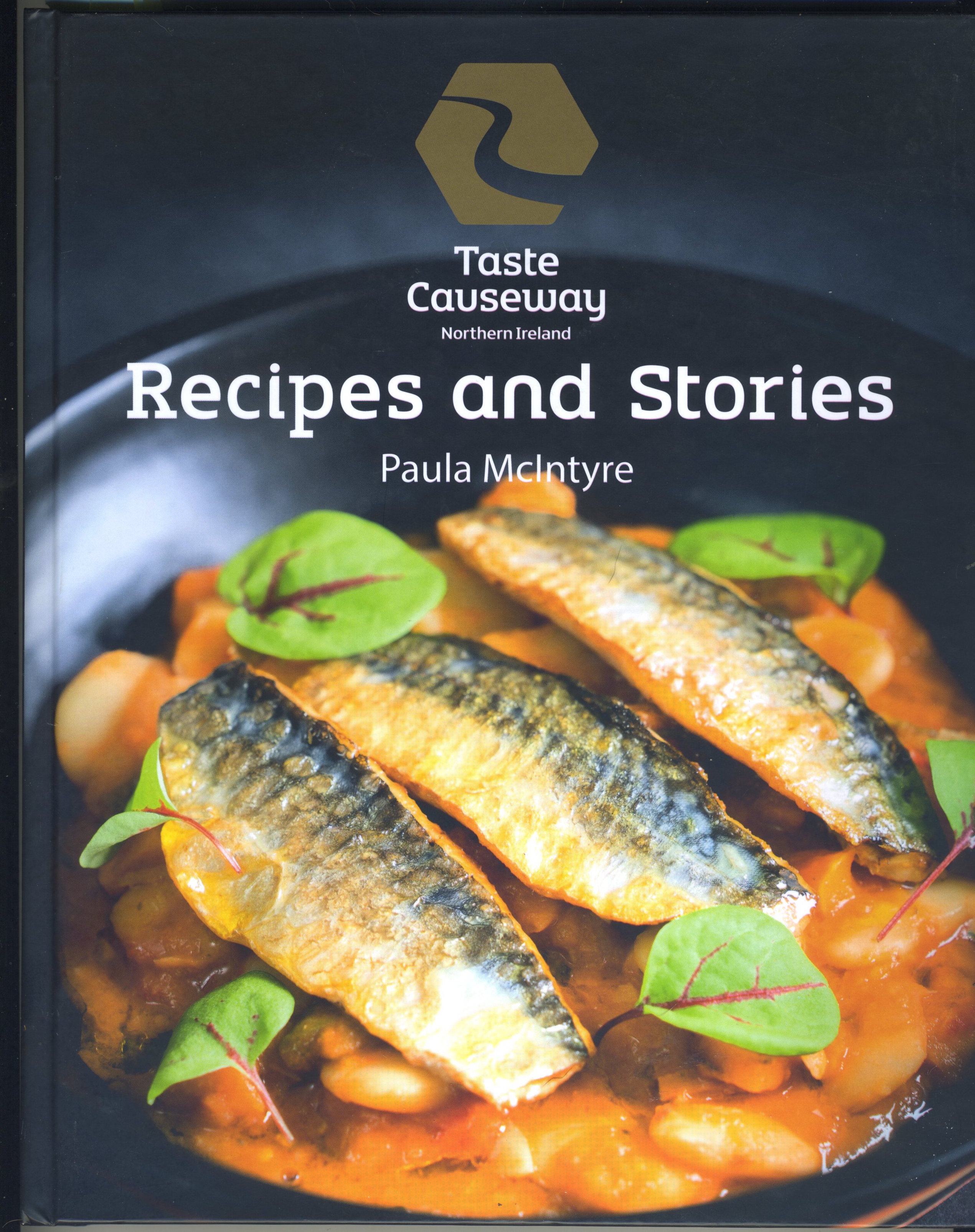 A great sense of post-pandemic reconnection came out of a very enjoyable trip around Donegal and some of the more northerly parts of Northern Ireland recently, inspiring me to take another deep dive into Paula McIntyre’s most recent book, Taste Causeway – Recipes and Stories. And what a lovely read it is.
A great sense of post-pandemic reconnection came out of a very enjoyable trip around Donegal and some of the more northerly parts of Northern Ireland recently, inspiring me to take another deep dive into Paula McIntyre’s most recent book, Taste Causeway – Recipes and Stories. And what a lovely read it is.
As much a travel guide as a cookbook (so a map or two would be a nice addition) it conveys a tangible sense of place and an intimate connection with the locations she so warmly describes, along with the people who share Paula’s enthusiasm for the superb produce of the area and her commitment to promoting it. Scenery is, of course, the Causeway Coast and Glens’ main claim to fame, so the area’s diverse range of outstanding foods and drinks may come as a surprise to some visitors. The two in combination – along with the rightly famed Northern Irish hospitality – are a powerful mix and this book, which includes a good sprinkling of places to stay and eat as well as producers, is sure to inspire a host of first-time visitors to come and see it for themselves.
The diversity of produce and businesses featured within a relatively small area is remarkable. The contents are arranged alphabetically by name of business rather than location or what they do, so there’s a constant element of surprise – Causeway Coast Foodie Tours, for example, is sandwiched between Causeway Coffee and the fishing boat Causeway Lass, all of which have delicious related recipes.
One or two of the forty or so businesses featured have sadly fallen by the wayside during the pandemic, but happily almost all are thriving – and very well worth exploring.
*Taste Causeway – Recipes and Stories by Paula McIntyre. Hardback, 160pp, colour photography throughout; price £25. Buy online from Taste Causeway Northern Ireland. Also available from some of the member businesses featured.
SAMPLE RECPES TO TRY
 Broughgammon Farm veal scallopine with Islander Kelp salsa verde grilled leeks
Broughgammon Farm veal scallopine with Islander Kelp salsa verde grilled leeks
The main ingredients in this recipe combine the produce of two of the region’s most visionary producers - the Cole family’s Broughgammon Farm near Ballycastle, and Kate Burns’s Islander Kelp, across the sound at Rathlin Island. It’s all about sustainability - of community as well as produce. If you don’t eat veal for ethical reasons, Broughgammon veal will make you think again - and a recipe for their goat meat is also included in this book. And as for Islander Kelp and the idea of farming seaweed, its time has well and truly come. GC
Veal
4 Broughgammon Farm veal escalopes - about 125g each
50g plain flour
1 Glenballyeamon egg
150g fresh white breadcrumbs or panko crumbs
4 tablespoons Broighter Gold rapeseed oil
25g butter
Grilled leeks
2 medium leeks
1 tablespoon Broighter Gold rapeseed oil
25g butter, melted
4 tablespoons Islander Kelp salsa verde
Veal
Place the flour and breadcrumbs in separate bowls.
Whisk the egg and milk in another bowl.
Dip a veal escalope into the flour, shake off the excess and then dip in the egg mixture to coat.
Add to the crumbs and ensure its completely covered.
Repeat with other escalopes.
Heat half the oil in a frying pan with half the butter.
When foaming add 2 pieces of the veal and cook for 2 minutes each side.
Transfer to a tray and keep warm in the oven.
Repeat with the remaining veal.
Grilled leeks
Split the leeks lengthwise and wash thoroughly.
Place in a large pan of simmering salted water and cook until just cooked through. Drain and pat dry.
Brush with the oil.
Heat' a ridged pan until smoking hot and add the leeks. Cook to scorch marks on them.
Mix one tablespoon of the kelp with the butter and brush all over the grilled leeks.
Place the veal on a plate with some leeks on the side and spoon over the remaining kelp salsa verde.
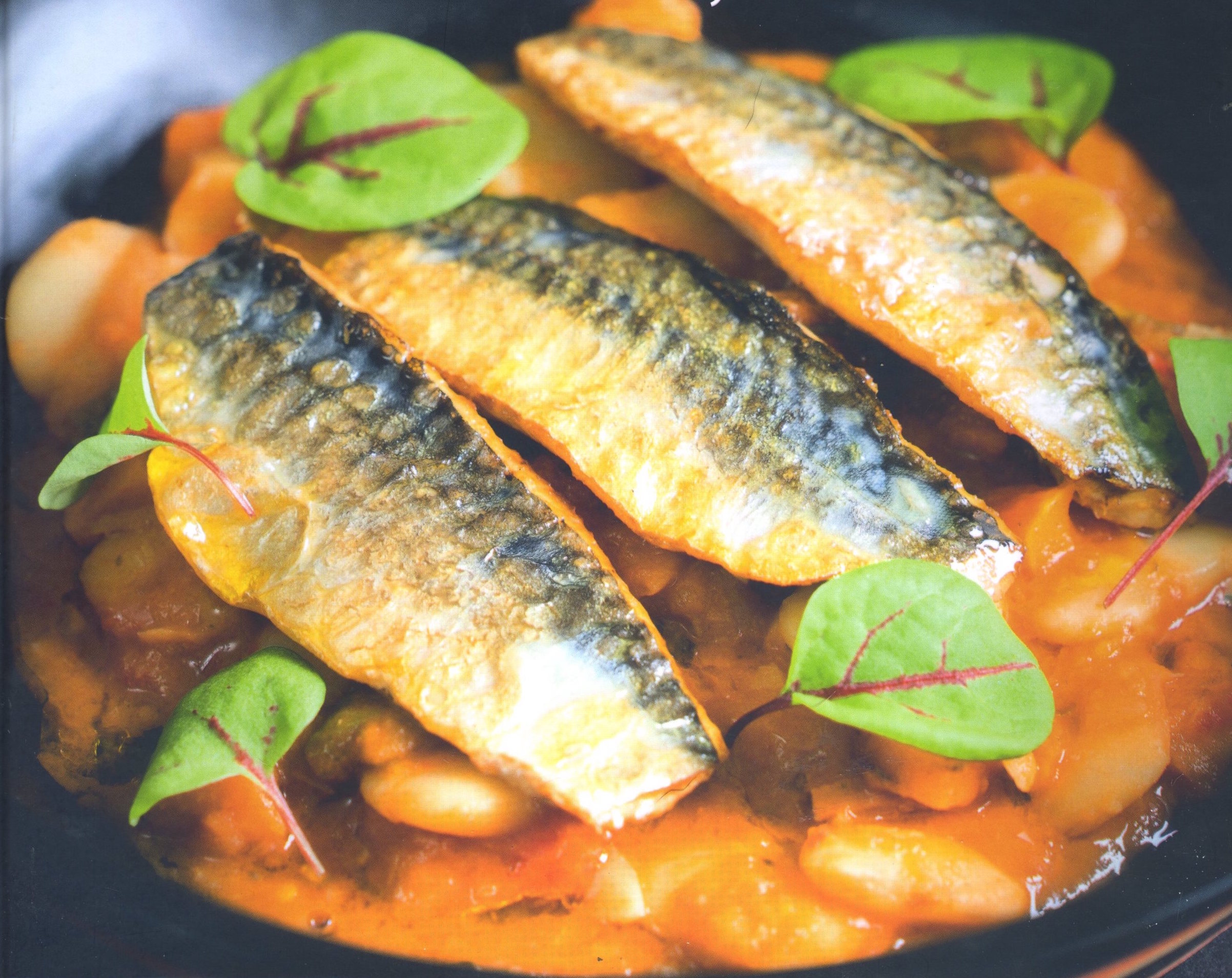 Mackerel, butterbean and chorizo stew, lemon oil
Mackerel, butterbean and chorizo stew, lemon oil
This is from Wendy Gallagher of Causeway Coast Foodie Tours, whose experiences include a ‘Catch and Sea’ outing, to give people a taste of fishing and eating ‘fresher-the-fresh fish. The group set off from Portstewart harbour at first light aboard local fisherman Peter Boston’s boat, the Boy Matthew. After a real hands-on trip they finish up at Warke’s Deli where owner Jacqi Warke cooks the fish and serves it in a dish ‘made entirely of this place’. The way Paula describes it makes you want to race up to Portstewart and sign on, right now. GC
Butterbean and chorizo stew
250g dried butterbeans, soaked in cold water overnight
75g Corndale Farm chorizo, chopped
2 tablespoons Broighter Gold rapeseed oil
2 red onions, peeled and chopped
1 stick celery, chopped
400ml passata or chopped tinned plum tomatoes
250ml chicken stock 1 bay leaf (optional)
Mackerel
8 mackerel fillets
Sea salt
Broighter Gold lemon oil for cooking
Butterbean and chorizo stew
Rinse the soaked butterbeans. Cook the chorizo in the oil gently, in a casserole pot, to release the fat.
Add the onions and celery and place a lid on top. Gently cook for 10 minutes, stirring occasionally so
it doesn't stick.
Add the butterbeans, passata, stock and bay and bring to a simmer.
Put a lid on top and simmer gently for about an hour, stirring every now and then.
Add water if it starts to dry out.
When beans are tender, check seasoning.
Mackerel
Brush the fillets with the oil and season with salt.
Take a couple of non stick frying pans (if you don't have any line the bottom of regular pans with
parchment paper) and heat over medium high heat.
Place mackerel skin side down into the pan.
Cook for about 2 minutes or until skin is crisp and flip over.
Cook for 30 seconds on the other side or until the mackerel has a little give but feels quite firm.
Spoon the stew into bowls, top with the mackerel and then garnish with some herbs and a little extra slick of the lemon oil.
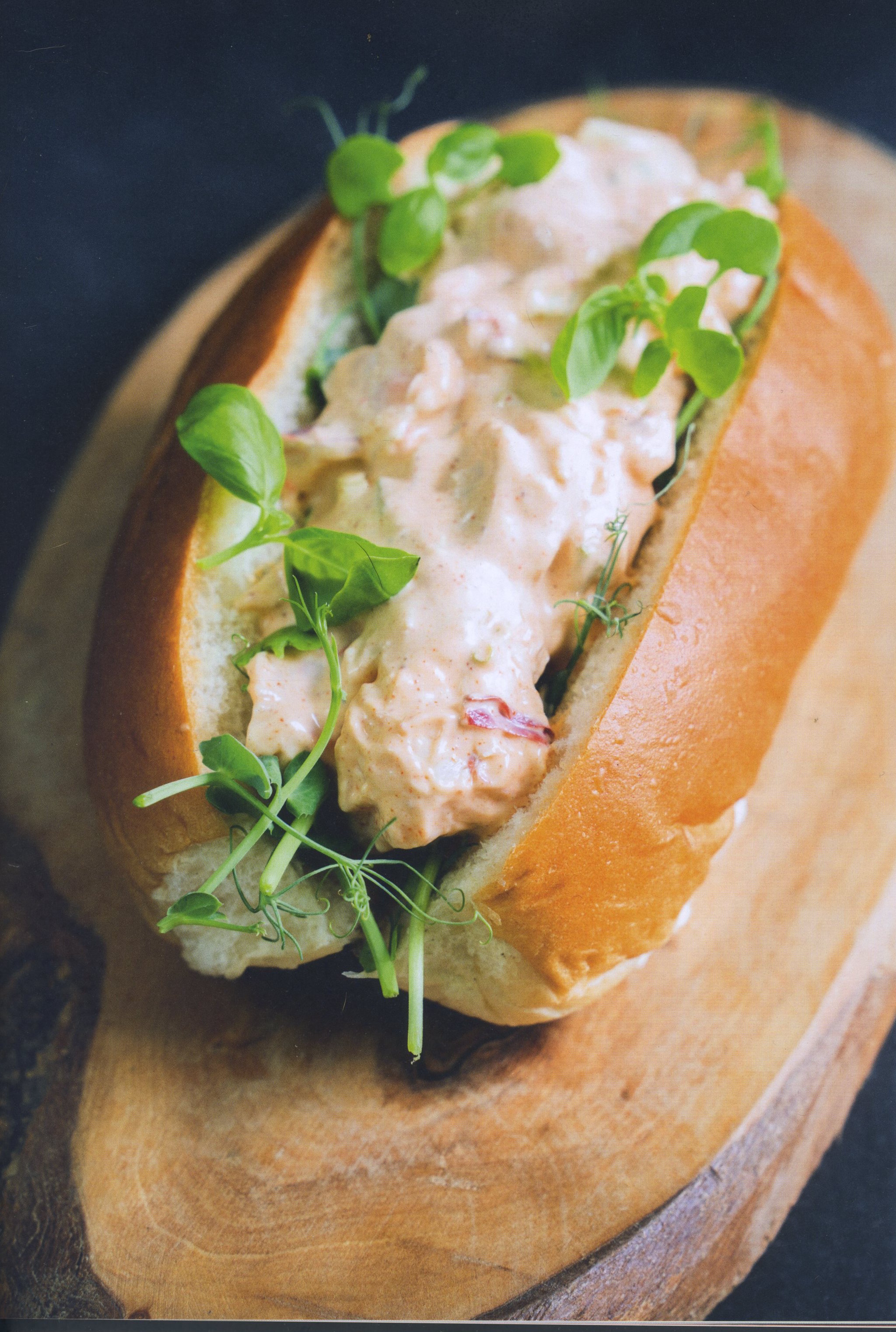 Native Seafood lobster roll
Native Seafood lobster roll
Also all about sustainability, Rebekah and Stevie McCarry’s Native Seafood at Portstewart (and now also at Lir, Coleraine) is not a long-established business, but boy is their ‘clean, simple and exciting’ local seafood having an impact. Paula tells their story and explains their philosophy in detail and it is nothing short of extraordinary - a must-read if ever there was one. This is one of the trademark dishes that earned them a huge following from day one. GC
1kg live lobster
Seasalt
1 stick celery, finely chopped
1 teaspoon harissa paste
1 teaspoon chipotle chilli paste
4 tablespoons mayonnaise
Pinch paprika
Pinch cayenne pepper
1 baby gem lettuce
4 brioche hotdog buns
Soft butter
Place live lobster in the freezer (in accordance with animal welfare guidance) for 30 minutes prior to cooking.
Bring a big pan of water to the boil and season so you can taste the salt in the water - roughly a handful of salt.
Add the lobster and cook for 7 minutes. Remove and place in iced water to stop the cooking process.
Remove the main body of the lobster, the tail and then the claws.
Crack the claws with a rolling pin and remove the meat using the stem of a teaspoon. Crack the lobster tail and remove the meat in a piece.
Chop the meat from the tails and the claws into 2cm sized pieces.
Mix the celery, harissa, chipotle, mayonnaise, paprika and cayenne in a bowl and check seasoning.
Fold in the lobster meat.
Split and toast the buns and butter.
Separate the lettuce into leaves, wash and pat dry.
Shred the lettuce and place in each bun. Top with the lobster meat mixture and serve.
Cookery Feature - Created in Cavan

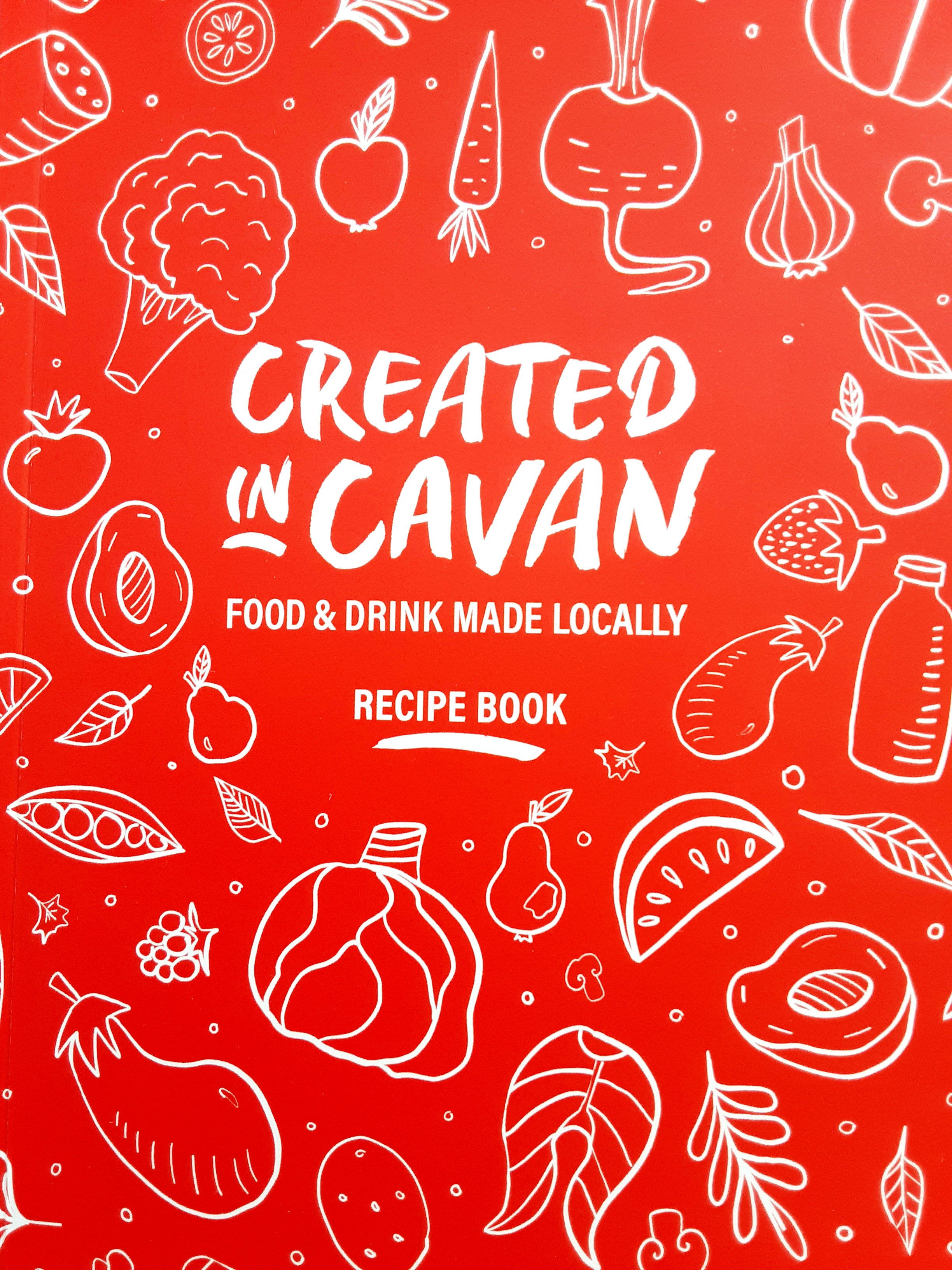 You can’t beat a collaborative local cookbook for creating a real sense of place and this new book from members of the Created in Cavan Food Network does that very well.
You can’t beat a collaborative local cookbook for creating a real sense of place and this new book from members of the Created in Cavan Food Network does that very well.
Bringing Cavan’s food, drink and hospitality community together, the aim was to raise the visibility of the county’s outstanding offering, in Ireland and internationally, and to raise funds for several charities - Cavan Autism Parents Support CLG, Breffni Blues Special Olympics Club and Cuan Cancer Support Centre.
As Chairperson Norbert Neylon - chef-patron of The Oak Room Restaurant in Cavan Town – says in the Foreword, “The Created in Cavan brand means consumers, locals and visitors alike can be sure of County Cavan as an authentic source and destination of high-quality local food and drink with memorable heartfelt visitor experiences.”
Not that we should need to be reminded, as Cavan is a place that punches way above its weight when comes to food, drink and hospitality, and it’s improving all the time. Just look at the roll call of famous Cavan chefs among the contributors, for example. Neven Maguire, Gearoid Lynch and Norbert Neylon were all Euro-Toques Young Chef of the Year winners in their day, which is pretty remarkable for a start. Then there’s Richard Corrigan, of course, who has brought his huge talent and energy to the county in recent years, and entrepreneurial younger chefs like Shane Smith and Adrian Martin, along with many others like Fergus Murphy of the charming Murphs Gastro Pub at Derragarra, who keep raising the bar.
Accommodation providers are well represented too – Virginia Park Lodge, Cavan Crystal Hotel, MacNean House,The Keepers Arms at Bawnboy, The Olde Post Inn at Cloverhill and Hawthorn B&B at Belturbet give an idea of the range of offering – and of course, the foundation for everything they do, the food and drink producers.
Supported by Cavan County Council and the Department of Agriculture, Food and Marine, the Created in Cavan Recipe Book is available to buy locally from: Connolly Bros, Candlelight Book Shop, Chapter One – Cavan; Dinkins Bakery, Cavan and Cootehill, Breffni Arms Arva, Sushi Mania, Cavan Crystal Hotel, Oak Room Restaurant, Cavan Tourist Office, Keepers Arms Bawnboy, Hawthorn Lodge B&B and more. For further information & stockists, visit the Created in Cavan website https://www.createdincavan.ie/
SAMPLE RECIPES TO TRY:
 AIR FRYER HONEY CHILLI CHICKEN
AIR FRYER HONEY CHILLI CHICKEN
One of several recipes in the book from well known Cavan chef and TV presenter Chef Adrian Martin
“One for your next Friday night Fakeaway. I’m using the Ninja Foodi MAX Dual Zone Air Fryer with Smart Cook System.”
Ingredients
3-4 chicken fillets cut into pieces
2-3 tablespoon soya sauce
100g cornflour
100g self raising flour
For the Sauce
3 cloves of garlic chopped
½ red pepper sliced
½ green pepper sliced
1 banana shallot sliced
1 tablespoon rice wine vinegar
2 tablespoons sweet chilli sauce
2 tablespoons honey
Juice of half a lemon
To Serve
Rice
Sliced spring onions and chillies
Method
1. Stir the chicken in a bowl with the soya sauce.
2. Mix the two flours together.
3. Coat the chicken in the flour and then into the air fryer with some spray oil at 200ºC for 15 minutes.
4. In a frying pan, sweat the shallot, garlic and peppers in some oil until softened.
5. Add the rest of the sauce ingredients and reduce the heat to simmer lightly.
6. Add the chicken to the sauce to coat it and make it sticky. The cornflour on the chicken will thicken this nicely.
7. Serve it up on some cooked rice and sprinkle with the spring onions and
chillies.
 NEVEN MAGUIRE’S CHEESECAKE WITH RASPBERRIES AND WHITE CHOCOLATE
NEVEN MAGUIRE’S CHEESECAKE WITH RASPBERRIES AND WHITE CHOCOLATE
One of the recipes contributed by Neven Maguire, MacNean House & Restaurant: “In the restaurant we serve this cheesecake with a jammie dodger and sometimes a nice quenelle of raspberry sorbet or raspberry ripple ice cream. The cheesecake itself is really light, I like to decorate the plate with dried raspberries and baby Maltesers, both of which are available from good catering suppliers.”
Serves 8
Ingredients
400g (14oz) cream cheese
Finely grated rind and juice of ½ lemon
1 vanilla pod, split in half and seeds scraped out
200g (7oz) white chocolate, broken into squares
200ml (7floz) cream
2 tablespoons Coole Swan
8 shortbread biscuits, finely broken up
White chocolate curls, to decorate
Dried raspberries, to decorate
Baby Maltesers to decorate
Spun sugar, to decorate
Fresh mint sprigs, to decorate
8 Jammie dodgers, to serve
For the Poached Raspberries
300ml (1/2 pint) red wine
2 tablespoon crème de cassis
75g (3oz) caster sugar
1 cinnamon stick
1 star anise
½ vanilla pod, split in half and seeds scraped out
400g (14oz) raspberries, plus extra to decorate
Method
1. Using an electric mixer, beat the cream cheese, Coole Swan, lemon rind and juice and the vanilla seeds for about 5 minutes, until smooth and light.
2. Melt the white chocolate in a heatproof bowl set over a pan of simmering water. Remove from the heat and set aside to cool a little. Meanwhile, place the cream in a separate bowl and whip until stiff.
3. Fold the melted chocolate into the cream cheese mixture and then carefully fold in the whipped cream. Transfer to a piping bag fitted with a 1cm (½ in) plain nozzle and place in the fridge until needed.
4. To poach the raspberries, place the red wine and cr.me de cassis in a pan with the sugar, cinnamon stick, star anise and vanilla pod and seeds and bring to the boil. Reduce the heat and simmer for 15 minutes, until reduced by half and slightly thickened. Place the raspberries in a heatproof bowl and pour over the wine mixture through a fine sieve, discarding the cinnamon stick, star anise and vanilla pod. Stir to combine and leave to cool.
5. To assemble the cheesecake, divide the poached raspberries among martini glasses and crumble the shortbread biscuits on top. Pipe the cheesecake mixture right up to the rim of the glasses and decorate with raspberries, white chocolate curls, dried raspberries, baby Maltesers, spun sugar and mint sprigs.
To serve: arrange the cheesecakes on plates with a Jammie dodger.
COOK AHEAD: The poached raspberries will keep in the fridge for up to 5 days. All the other elements can be prepared 24 hours in advance and assembled just before serving.
Cookery Feature - Seafood for Festive Occasions
.jpg)
The perfect antidote to the traditional festive foods and too much chocolate, fish and seafood brings contrasting flavours and – even when we’re talking comfort food - a special sea-fresh lightness to the festive table that is very welcome. The wonderful chowder given below could well become your new culinary best friend, for any time of year, while the other recipes make great starters or light meals – and the classic prawn cocktail is the perfect special occasion starter, just right with a glass of bubbly… All are from my own cookbook ‘From Tide To Table, Everything You Ever Wanted to Know About Seafood’, with photography by Paul Sherwood.
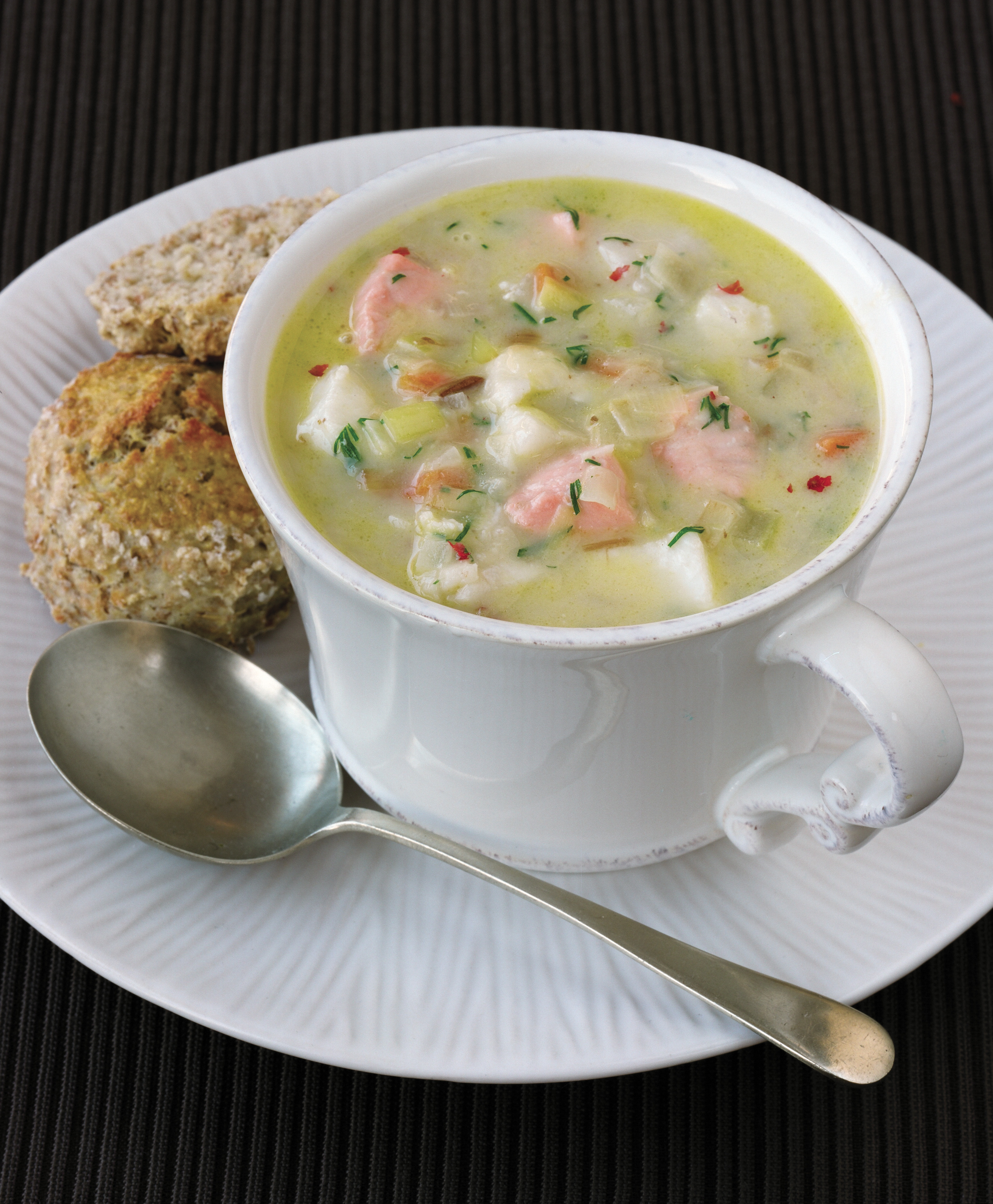 Greencastle Chowder
Greencastle Chowder
What could be more welcome after a bracing Christmas or New Year walk than a lovely steaming bowl of seafood chowder? There are as many chowder recipes as there are days in the year, but this one has an impeccable pedigree. It’s from Tricia Kealy’s famous little Kealy’s Seafood Bar in Greencastle, Co Donegal and it’s been the most popular dish on their menu ‘for ever’- Tricia doesn’t like to think how many gallons of this delicious chowder they’ve made over the years! It was originally introduced by her late husband, James Kealy, and his ‘wee scones’ (see recipe below) still make the perfect accompaniment today. Using a good stock is the secret of all soup making so a recipe for fresh fish stock is given below, but fresh or frozen stock can also be purchased from fishmongers, speciality food shops and some good supermarkets.
Serves 4-6
1.2 litres/2 pints fish stock (see note above)
100g/4oz skinless salmon fillet, cubed
100g/4oz skinless haddock fillet, cubed
50g/2oz butter
1 onion, chopped
2 carrots, chopped
1 leek, chopped
3 celery sticks, chopped
1 tsp chopped fresh dill
1 tsp crushed pink peppercorns
50g/2oz plain flour
salt and freshly ground black pepper
Angostura bitters
a little milk (optional)
pouring cream and chopped fresh parsley, to garnish
To Serve: freshly baked baby brown scones (see recipe below)
Bring the fish stock to a gentle simmer in a large pan and add the salmon and haddock. Cook for a couple of minutes until tender, then transfer to a plate with a slotted spoon. Set aside until needed.
Melt the butter in a separate large pan over a medium heat. Sweat the onion, carrots, leek and celery for about 10 minutes or until they are softened but not coloured. Add the dill and pink peppercorns and cook for a further 5 minutes.
Stir the flour into the vegetable mixture and cook for 5 minutes, stirring constantly. Gradually pour in the fish stock, stirring until smooth after each addition: add a dash of Angostura bitters, then bring to the boil and simmer for 15 minutes until all of the vegetables are completely tender and the liquid is slightly reduced. Season to taste.
Just before serving, a little milk can be added to thin out to the desired consistency. Add the cooked salmon and haddock to the chowder and allow to warm through. Ladle into warmed bowls and garnish with a little cream and some parsley. Arrange on plates with some brown baby scones to serve.
Fish Stock
Lemon sole, brill and plaice bones make a wonderful, almost sweet fish stock. It is fine to include heads and bones and skin of most types of fish, but avoid salmon, red mullet and oil-rich fish. When the stock is made, you can reduce it further and then freeze it in ice cube trays (freezing it this way means you can defrost as little or as much as you need at a time).
250g/9oz fish trimmings
3 leeks, chopped
1 bulb fennel, chopped
3 carrots, chopped
large handful fresh parsley, roughly chopped
175ml/6fl oz dry white wine
Makes about 1.2 litres/2 pints
Rinse the fish bones and trimmings of any blood, which would make the stock look cloudy and taste bitter. Place into a large heavy-bottomed stockpot with the leeks, fennel, carrots and parsley. Pour in the white wine, then add enough cold water to cover the fish and vegetables, (but no more than 1.2 litres/2 pints). Place on a high heat and bring to a simmer. After 5 minutes, remove the scum that forms on the surface with a spoon and discard. Reduce the heat and simmer, covered, for about 25 minutes, skimming as necessary. At the end of cooking time, remove the stock from the heat and strain, discarding the fish trimmings and the vegetables. Cool and store in the fridge for up to 3 days or freeze.
James’s Wee Brown Scones
Although seafood takes centre stage at Kealy’s Seafood Bar, the baking is exceptional too. These scones are unusually light and often enhanced by a scattering of cheese on top - hard to resist. As they are virtually fat-free they are best eaten warm from the oven, or at least on the day of baking, but they can also be frozen for warming up whenever they’re needed over the holiday period and would be very handy to serve with any of the seafood dishes given below.
Makes 12-14
1lb/450g plain flour plus extra for dusting
1lb/450g wheaten flour
1 tsp bread soda
1 tsp salt
725ml/11/3 pints approx buttermilk (or use a mixture of soured cream and milk)
1-2 tbsp treacle, slightly warmed and mixed with the buttermilk
sunflower oil, for greasing
egg wash - 2 egg yolks mixed with 2 tbsp water (optional)
50g/2oz Cheddar cheese, finely grated
Preheat the oven to 240ºC/465ºF/Gas 9.
Sift the plain flour, soda and salt into a bowl, add the wheaten flour and mix well. Make a well in the centre, pour in most of the buttermilk and treacle mixture, then mix well with a wooden spoon, adding remaining liquid as needed to make a soft, moist dough. Be careful not to over mix.
Dust the worktop with flour, turn out the dough, dust the top with flour and press out evenly to a thickness of 4cm/1½ inches. Cut or stamp out individual scones with a 5cm/2 inch fluted cutter, place on an oiled and floured baking sheet and brush the tops with the egg wash and/or scatter with the grated cheese. Bake for about 12 minutes, until well risen and golden-brown.
 Crab Cakes with Coriander and Chilli
Crab Cakes with Coriander and Chilli
These crab cakes are really delicious and very easy to prepare for a quick light meal. Crab meat is best sourced from a good fishmonger, if possible - or, if you have access to fresh crabs in season, you can of course cook them yourself. Either way, try to use white meat that is in large-ish chunks rather than lots of little pieces. For a more traditional flavour, you can omit the chilli and use parsley instead of coriander.
SERVES 4
225g/8oz white crab meat, thawed if frozen
50g/2oz scallions, trimmed and finely chopped
50g/2oz mayonnaise
75g/3oz fresh /frozen white breadcrumbs
1 small egg, lightly beaten
1 tbsp chopped fresh coriander
1 small red chilli, seeded and finely chopped
2 tbsp sunflower oil
salt and freshly ground black pepper
To serve: lightly dressed green salad and red pepper and chilli relish (recipe below)
Place the crab meat in a bowl with the scallions, mayonnaise, breadcrumbs, egg, coriander and chilli. Season to taste and mix gently until well combined. Divide the mixture into eight and then shape into crab cakes.
Heat the oil in a heavy-based frying pan. Add the crab cakes and cook for 3-4 minutes on each side until heated through and golden brown. Arrange the crab cakes on plates with some lightly dressed green salad and a good dollop of the red pepper and chilli relish to serve.
Red Pepper & Chilli Relish
The natural sweetness of the red onion gives this versatile relish a wonderful mellow flavour. It’s great with barbecued fish, crab cakes, or salmon burgers, and it will keep in the fridge for up to a week.
2 tbsp olive oil
1 red pepper, halved seeded and chopped
2 red onions, chopped
3 red chillies (or to taste), seeded
2 tsp sugar
2 tomatoes, skinned and chopped
Makes about 300ml/1/2 pint
Heat the olive oil in a heavy-based pan. Add the red pepper, red onions and chillies and cook over a low heat for 30 minutes until the vegetables are completely tender but not coloured, stirring regularly.
Sprinkle the sugar over the vegetable mixture and add the tomatoes, then simmer for another 10 minutes until slightly reduced and thickened. Leave to cool and then blend in a food processor or with a hand-blender, to make a thick purée. Season to taste and place in a sterilised jar. Store in the fridge and use as required.
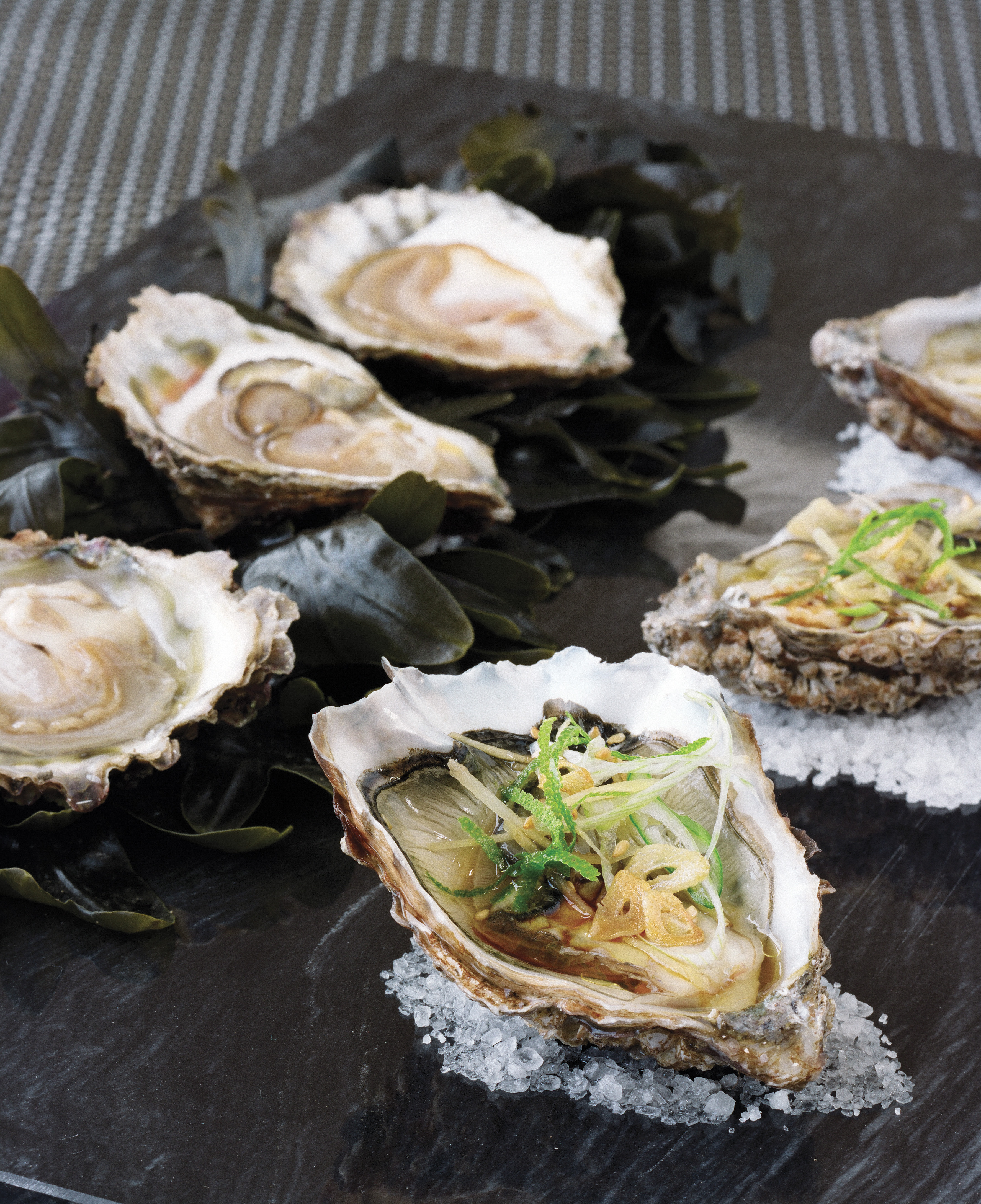 Galway Bay Oysters Sashimi-Style
Galway Bay Oysters Sashimi-Style
This recipe from Kevin Dundon of Dunbrody Country House Hotel & Cookery School, Co Wexford is a great way to introduce oysters to your guests when entertaining. Opening oysters is not too difficult (see below) and an oyster knife is a good investment if you would like to serve oysters regularly. Oysters are mainly seen as a winter treat because the Native flat oysters (Ostrea edulis) - which are especially associated with the West coast, notably Co Galway - are only in season when there’s an ‘r’ in the month, from September to April. But the Irish Rock Oysters (Crassostrea gigas) used here, also known as Pacific or Portuguese oysters, are available throughout the year from fish shops and supermarkets. They’re more accessibly priced and well suited to cooking or serving warm. (Oysters are also online, from producers, which is ideal for gifting. For further information on oysters, including a list of producers with map, see the Bord Bia website)
Serves 4
12 Pacific/Gigas oysters
1 tbsp sesame seeds
about 225g/8oz coarse rock salt
6 tbsp dark soy sauce
finely grated rind and juice of 1 lime
1 tbsp shredded root ginger
1 spring onion, finely shredded
4 tbsp sesame oil
2 garlic cloves, thinly sliced
Scrub the oyster shells then place one, wrapped in a clean tea towel on a firm surface with the flattest shell uppermost and the hinge pointing towards you. Gripping the oyster firmly, insert an oyster knife (or other short, strong knife) into the gap in the hinge and twist to snap the shells apart.
Slide the blade of the knife along the inside of the upper shell to sever the muscle that keeps the shells together. Lift the lid off the top shell, being careful not to spill any of the juices. Carefully clean away any bits of broken shell and finally run the knife under the oyster to loosen it from the shell. Repeat until all the oysters are opened, then arrange on a tray and place in the fridge until you are ready to serve.
Heat a frying pan over a medium to low heat and add the sesame seeds. Cook for 3-4 minutes, stirring regularly until they are lightly toasted. Tip out of the pan onto a plate and set aside until needed.
To serve, arrange three oysters on a bed of rock salt on each serving plate. In a bowl, mix together the soy sauce with the lime rind and juice, then spoon over the oysters. Scatter the ginger, spring onions and reserved toasted sesame seeds on top. Leave to stand for 5 minutes to allow the flavours to develop. Meanwhile, heat the sesame oil in the frying pan and sauté the garlic until it is golden and the sesame oil is nearly smoking. Drizzle over the oysters and serve immediately.
VARIATION
It is best to serve native oysters in the classic way: Put crushed ice on to the plates and then, if possible, small mounds of seaweed as it sets the oysters off so well. Arrange the opened oysters on top and have lemon wedges on hand. It is worth noting that about 15 minutes on ice is enough to chill the oyster without overdoing it.
.jpg) Classic Prawn Cocktail
Classic Prawn Cocktail
Prawn cocktail has enjoyed a big comeback in recent years and it’s not hard to see why the ‘70s favourite is popular again. Made properly with fresh ingredients, it can make an elegant yet simple (and very more-ish) starter - and it also makes an excellent sandwich filling. Although there are many versions, and shrimps are often used, Dublin Bay prawns (Nephrops Norvegicus, or langoustine) are the ultimate luxury ingredient.
Serves 4
20 large cooked peeled Dublin Bay prawns
FOR THE COCKTAIL SAUCE
6 tbsp mayonnaise (homemade, or best quality commercial eg Ballymaloe)
3 tbsp tomato ketchup
1 tbsp brandy
dash of Tabasco sauce
25g/1oz wild rocket (optional)
1 Little Gem lettuce, trimmed and finely shredded
salt and freshly ground black pepper
To make the cocktail sauce, whisk together the mayonnaise, ketchup, brandy and Tabasco sauce in a bowl. Season to taste.
To serve, lightly mix together the shredded lettuce and rocket (if using), then divide among serving glasses. Arrange the prawns on top and then drizzle over the cocktail sauce.
VARIATION
This cocktail sauce can be used with many other types of seafood such as lobster, white crab meat, poached salmon or trout.
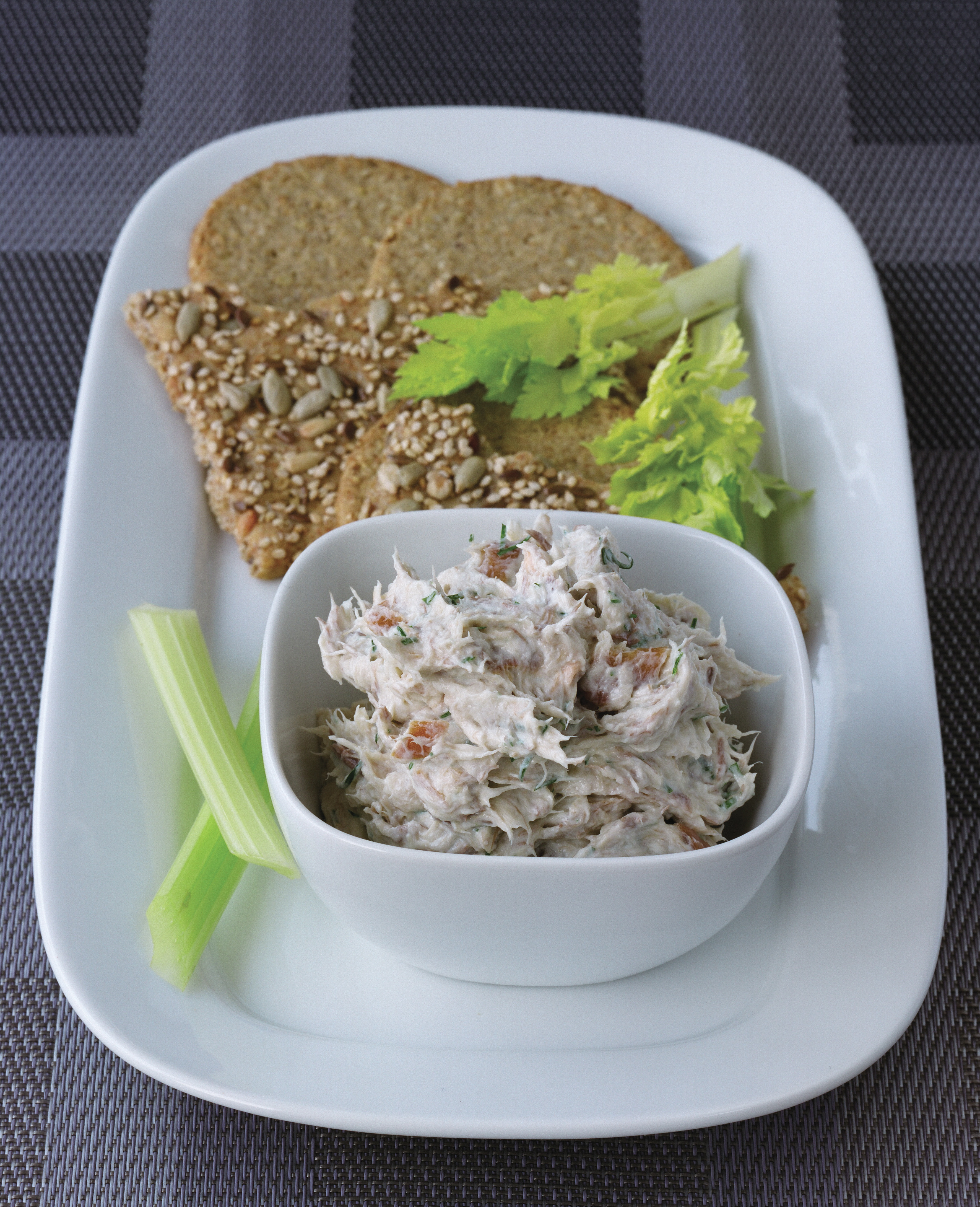 Smoked Mackerel Paté
Smoked Mackerel Paté
This paté is great as a starter, or for serving on canapés when entertaining. It also is a quick and easy snack served on hot toast.
Serves 4
450g/1lb smoked mackerel fillets
75g/3oz cream cheese
75g/3oz crème fraîche
1-2 tbsp creamed horseradish
dash of Tabasco sauce
juice of 1/2 lemon
salt and freshly ground black pepper
To Serve: selection of crackers and celery sticks
Remove the skin from the mackerel fillets and discard any bones, then break up the flesh into a bowl. Add the cream cheese, crème fraîche, one tablespoon of the horseradish, the Tabasco and lemon juice. Mix thoroughly until well combined, then taste and add the remaining horseradish, if liked. Season to taste and transfer to a serving bowl.
Set the bowl of smoked mackerel paté on a platter and add a selection of crackers and celery sticks to serve.
VARIATION
Use smoked trout or hot smoked salmon instead of smoked mackerel.
*This feature was recently published by the Irish Examiner
https://www.irishexaminer.com/
Cookery Feature - Wasted
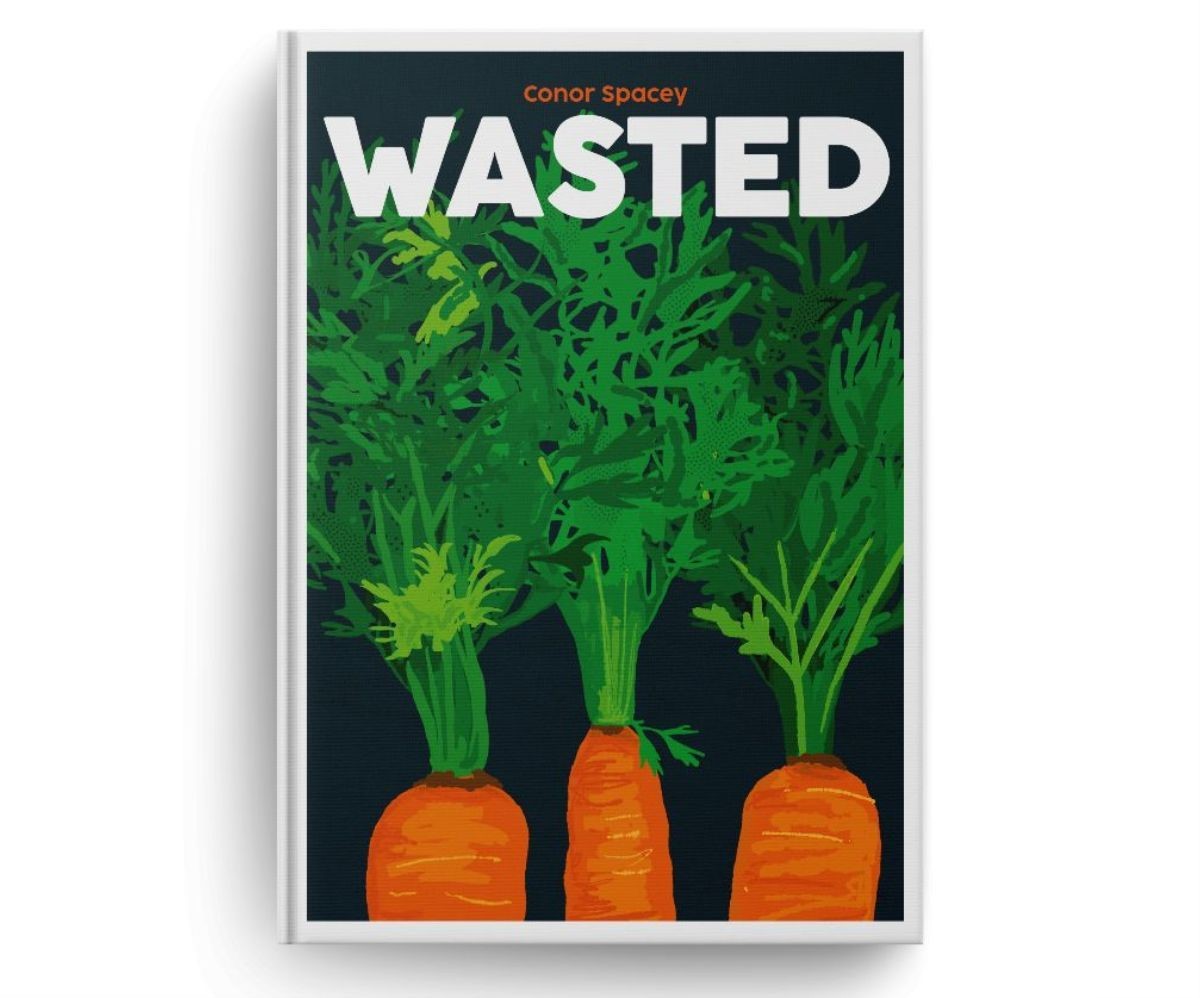
With concern for sustainability gearing up at an unprecedented rate, reducing waste will have topped many a New Year resolutions list this year – and, with reducing food waste in particular identified as one of the top three climate solutions, that’s an area especially worth focusing on, as we can all help to do something about it in our everyday lives.
 Renowned for his deliciously practical locally-focused and mainly plant-based work on waste reduction - with, amongst many other entities, FoodSpace, GIY and The Chefs’ Manifesto - nobody knows better than chef Conor Spacey (‘Author, Misfit, Disruptor’ according to his Instagram profile) how to help us all to prevent food waste and save money by improving our efficiency in multiple ways – notably by shopping/sourcing more carefully, storing food better and being more imaginative about how we use it every day, whether in professional kitchens or at home.
Renowned for his deliciously practical locally-focused and mainly plant-based work on waste reduction - with, amongst many other entities, FoodSpace, GIY and The Chefs’ Manifesto - nobody knows better than chef Conor Spacey (‘Author, Misfit, Disruptor’ according to his Instagram profile) how to help us all to prevent food waste and save money by improving our efficiency in multiple ways – notably by shopping/sourcing more carefully, storing food better and being more imaginative about how we use it every day, whether in professional kitchens or at home.
So the arrival last year of his cookbook, WASTED (Blasta Books hardback, €15 https://blastabooks.com/products/blasta-books-7-wasted and bookshops/speciality food shops) was a seriously important moment in our journey towards sustainability – and all the more so because it is presented with such a light touch. And, with the emphasis on deliciousness rather than do-goodery, Blasta Books summarise it perfectly: “WASTED is a capsule collection of recipes that have come from identifying some of the most wasted food items in our homes. This book will help you to stop wasting food and turn perfectly good ingredients into delicious dishes. And the key word here is delicious. The book's ulterior motive may be to get us to think differently about ingredients and waste, but the driver for all these plant-based recipes is flavour. Wasted will change your mindset and reconnect you to real food, from the root to the tip.”
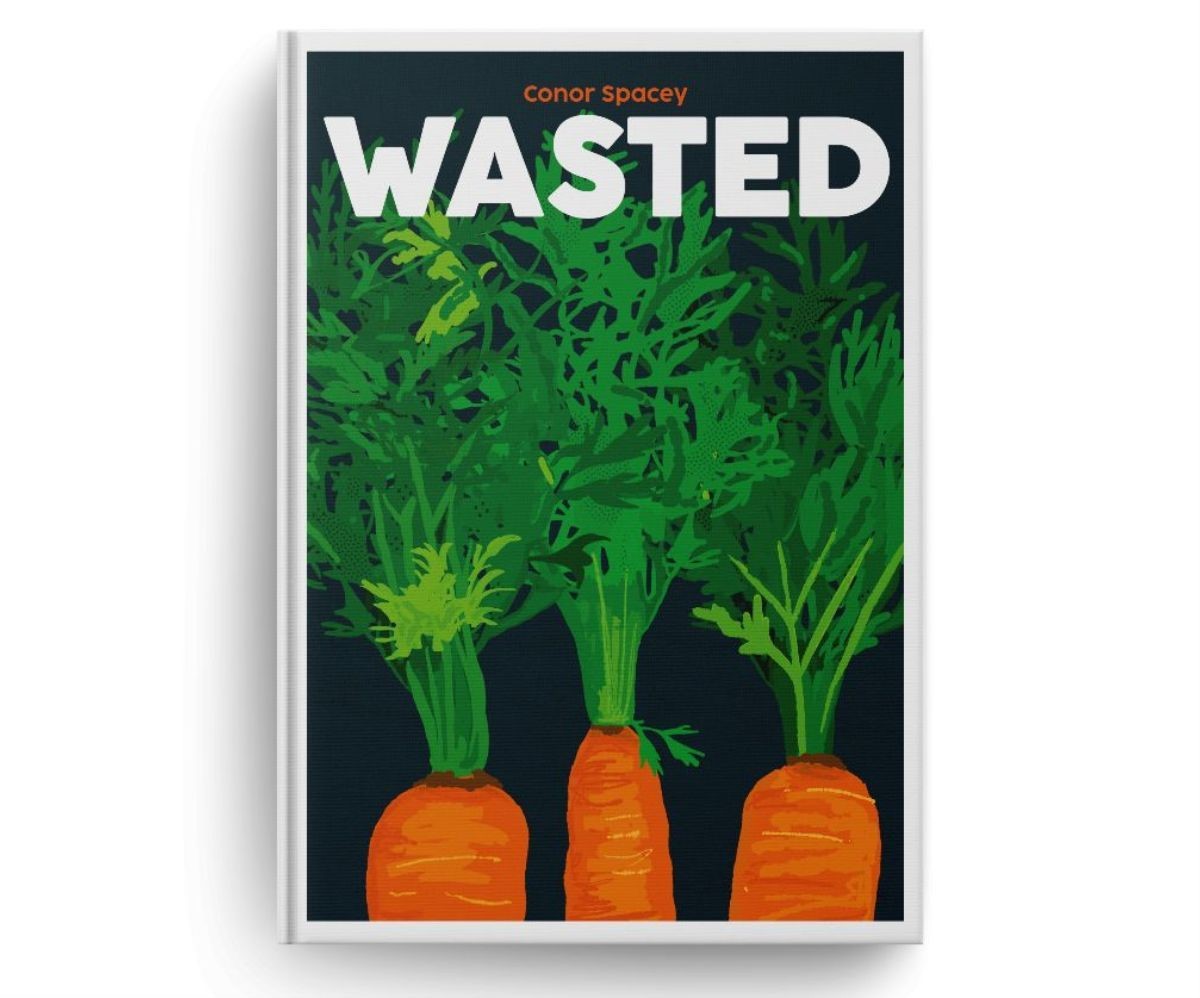 From the engaging introduction where we hear about a young Irish lad’s introduction to finding work and living in London - and his growing fascination with the restaurant industry and the amount of waste it entails - it’s an approachable and very persuasive book, combining a natural understanding of the home kitchen with the orderly hands-on practicality of the professional chef. There’s advice a-plenty on everything from Storage (‘How you store your food can lead to waste before you even get a chance to eat or cook with the ingredients you’ve bought’) to How to Regrow Food (something which has fascinated me for some time) and a number of ‘Five Ways With…’sections, on stale bread, whey, broccoli stalks, fermentation and cheese, along with loads of very do-able recipes based on the premise that “…waste is not, and should never be, an option”.
From the engaging introduction where we hear about a young Irish lad’s introduction to finding work and living in London - and his growing fascination with the restaurant industry and the amount of waste it entails - it’s an approachable and very persuasive book, combining a natural understanding of the home kitchen with the orderly hands-on practicality of the professional chef. There’s advice a-plenty on everything from Storage (‘How you store your food can lead to waste before you even get a chance to eat or cook with the ingredients you’ve bought’) to How to Regrow Food (something which has fascinated me for some time) and a number of ‘Five Ways With…’sections, on stale bread, whey, broccoli stalks, fermentation and cheese, along with loads of very do-able recipes based on the premise that “…waste is not, and should never be, an option”.
So, we meet the ‘Closed loop recipe’: “This where you really start to think about everything: every ingredient, every vegetable, every part… These three recipes are an example of how to identify every part and incorporate them into fantastic dishes. Throughout WASTED, you’ll also find that parts of one dish lead to another dish:
• Roasted carrots with carrot skin dukkah, carrot top pesto and labneh (see recipe below)
• Pumpkin noodles with roasted pumpkin seeds and pumpkin skin lardons
• Salt-baked beetroot and leaf salad with goat cheese & pickled beet stalk
RECIPES TO TRY (NB: The book is vegetarian but meat, fish or poultry can be added to many of the recipes.)
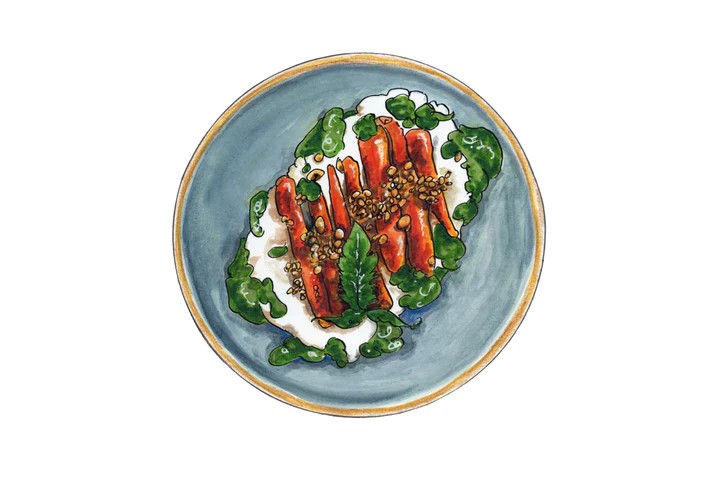 ROASTED CARROTS WITH CARROT SKIN DUKKAH, CARROT TOP PESTO AND LABNEH
ROASTED CARROTS WITH CARROT SKIN DUKKAH, CARROT TOP PESTO AND LABNEH
I love to work with just one or two ingredients, and this dish is one of my favourites – so much so that it inspired the cover of this book. I like to think of vegetables the same way you would if it was piece of meat: butcher it into parts and ensure you use everything. This dish is a great example of that. More and more supermarkets are starting to sell bunches of whole carrots, including their tops. This gives you more for your money, as the tops are delicious in salads, pasta or turned into pesto. This dish works well as a light lunch or served family-style on a platter as a side for dinner. Serves 2 as a main or 4 as a side.
1 bunch of carrots with the tops still on
a drizzle of rapeseed oil
fine sea salt and freshly ground black pepper
FOR THE CARROT SKIN DUKKAH:
50g nuts (use any nuts that you have – a great way to use up the ends of packets)
1 tbsp cumin seeds
1 tbsp coriander seeds
1 tbsp fennel seeds
1 tbsp sesame seeds
FOR THE CARROT TOP PESTO:
4 spring onions
1 garlic clove, peeled and left whole
1 small bunch of fresh mint or basil, leaves picked
50g nuts (any kind)
½ lemon, zest and juice
3 tbsp rapeseed oil
FOR THE LABNEH:
400g natural yogurt (I love Velvet Cloud sheep milk yogurt)
¼ tsp fine sea salt
First, make the labneh (allow up to 48 hours). Stir the yogurt and salt together, then put a clean piece of cheesecloth or muslin into a strainer and set this over a bowl. Pour in the yogurt and tie the cloth into a knot. Put the bowl in the fridge for 24–48 hours, depending on how thick you like your labneh. I usually give it 48 hours so that it has a cheese-like consistency. Scrape the labneh out into an airtight container and store it in the fridge for up to three weeks. (Don’t throw away the whey that has drained out of the yogurt! Use it to make the Whey hey hey bread.)
To make the pesto, cut the tops off the bunch of carrots. Remove the thick stalks from the leafy carrot tops and chop them separately. Bring a pot of salted water to the boil. Have a bowl of iced water ready. Once the water is boiling, add the carrot tops and chopped stems and cook for 3 minutes, until bright green and tender. Drain, then immediately transfer the carrot tops and stems to the bowl of iced water to stop the cooking process and keep the vibrant colour.
Remove the carrot tops and stems from the cold water, squeeze out any excess liquid and spread them out on a chopping board to dry slightly.
Put the spring onions, garlic, fresh herbs, nuts and the lemon zest and juice into a food processor and blend to a chunky paste. Add the rapeseed oil a little at a time until it’s all combined. Season to taste with salt and pepper. Store the pesto in a sealed jar in the fridge for up to four weeks. It will separate slightly and naturally form a layer of oil on top, so just give it a stir before using.
To make the dukkah, preheat the oven to 140°C (120°C fan).
Peel the carrots, then spread out the skins on a baking tray (you should probably have around 20g of carrot skins). Cook in the preheated oven for 30 minutes, turning twice during the cooking time, until the skins are dried and crisp. Allow to cool completely – the skins will crisp up even more as they cool – then put the dried skins in a blender and blitz on a high speed until they’re all finely chopped. Tip out into a bowl and set aside.
Increase the oven temperature to 200°C (180°C fan).
Mix the nuts and seeds together in a bowl, then spread them out on another baking tray and cook for 8–10 minutes, until nicely toasted. Allow to cool completely, then transfer to the blender and pulse two or three times – you want them to be chopped but not smooth.
Tip out into the bowl with the carrot skins and stir everything together with a wooden spoon. You can store the dukkah in a sealed container for up to four weeks at this point.
Increase the oven temperature again, this time to 210°C (190°C fan).
If you’re using small or baby carrots, you can leave them whole. If you’re using larger carrots, cut them at an angle so that they’re the size of your finger. Put the carrots in a bowl, drizzle with rapeseed oil and season with salt and pepper. Toss to coat them well, then spread them out on a baking tray and roast in the oven for 15 minutes, until they start to colour and still have a slight bite.
To serve, roll the roasted carrots in some of the dukkah. Put them on a serving plate with a big spoonful of labneh on top, then drizzle over some of the pesto.
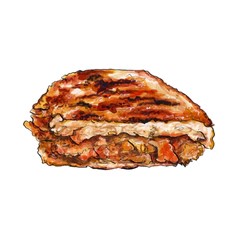 CHEESY KIMCHI TOASTIE WITH BLOODY MARY MAYO
CHEESY KIMCHI TOASTIE WITH BLOODY MARY MAYO
This is my ultimate quick and easy brunch, lunch (I’m never sure what the difference is) or hangover cure. Of course, that’s assuming that you’re organised and have the components already made and ready to go as part of your no-waste kitchen. I haven’t reinvented the wheel here – this recipe is based on the classic Welsh rarebit. It was one of the first dishes I learned as a commis chef many moons ago in London. As for the mayo, there is no vodka in it, but it does have the same spicy kick as a great Bloody Mary. Depending on your mood or how bad your hangover is, you can use your favourite shop-bought mayo or you can make it from scratch in minutes.
With your jar of kimchi and your cheesy bits already at hand, you just need to head out to your local bakery for a fresh loaf of sourdough – and a strong coffee for the trip back. The rest is simple. Makes 1
120ml Guinness or milk
25g butter, plus extra softened butter for spreading
25g plain flour
140g cheese ends (you can use any odds and ends here – I normally have a mix of soft and hard cheeses), roughly chopped or grated
1 tbsp Worcestershire sauce
1 tsp prepared English mustard
1 egg yolk
2 thick slices of sourdough bread
a little kimchi, chopped so it’s not too chunky
FOR THE BLOODY MARY MAYO:
2 egg yolks (freeze the whites for another use)
1 tsp English mustard
a pinch of fine sea salt
500ml rapeseed oil (or any neutral oil)
1–2 tbsp white wine vinegar
juice of ½ lemon
brine from your jar of kimchi
First, make the mayo. If you’re making it from scratch (or see the intro), using a stand mixer, blender or hand blender, whisk the egg yolks until creamy, then whisk in the mustard and salt. Very slowly – literally drop by drop – add half of the oil while continuously whisking or blending until thickened. Whisk in 1 tablespoon of vinegar to loosen the mixture slightly and give it a paler colour. Continue to add the remaining oil in a slow, steady stream, still whisking continuously. Season with another pinch of salt, a squeeze of lemon juice and another tablespoon of vinegar if needed. You now have a basic plain mayo that you can store in a sterilised jar in the fridge for up to one week. To make it into a Bloody Mary mayo, simply stir in some of the fantastic brine from the jar of kimchi. My ratio is two spoons of mayo to one spoon of kimchi brine.
To make the toasties, get two small saucepans. Put the Guinness or milk in one pan and slowly warm it over a medium heat.
Melt the butter in the second saucepan, then add the flour, stir to combine and cook for about 1 minute. Gradually whisk in the warm Guinness or milk to create a smooth sauce, then add your cheese mixture. Stir with a wooden spoon until all the cheese has completely melted and you have a thick paste, then stir in the Worcestershire sauce and mustard until evenly combined. Take the pan off the heat and allow to cool slightly, then stir in the egg yolk. (You can keep this in a covered tub in your fridge at this point, ready to go for a snack of cheese on toast.)
Now it’s time to bring it all together. I love copious amounts of mayo spread evenly over one side of each slice of bread, then the cheesy spread, then the kimchi. Sandwich it together, then spread some softened butter on the outside of both pieces of bread.
Put the sandwich in a warm frying pan over a medium heat (or you can use a sandwich toaster) and gently toast until the bread is golden, then carefully turn it over and toast the other side. Reduce the heat and cook each side for 1–2 minutes longer, until the centre is warm. Dig in with a strong coffee, a lunch cocktail or a good beer to set yourself up for the rest of the day.
From Blasta Books 7: WASTED by @spacey_chef
Illustration by @nickyhooper
Cookery & Food Tourism Feature - Taste the Causeway Coast
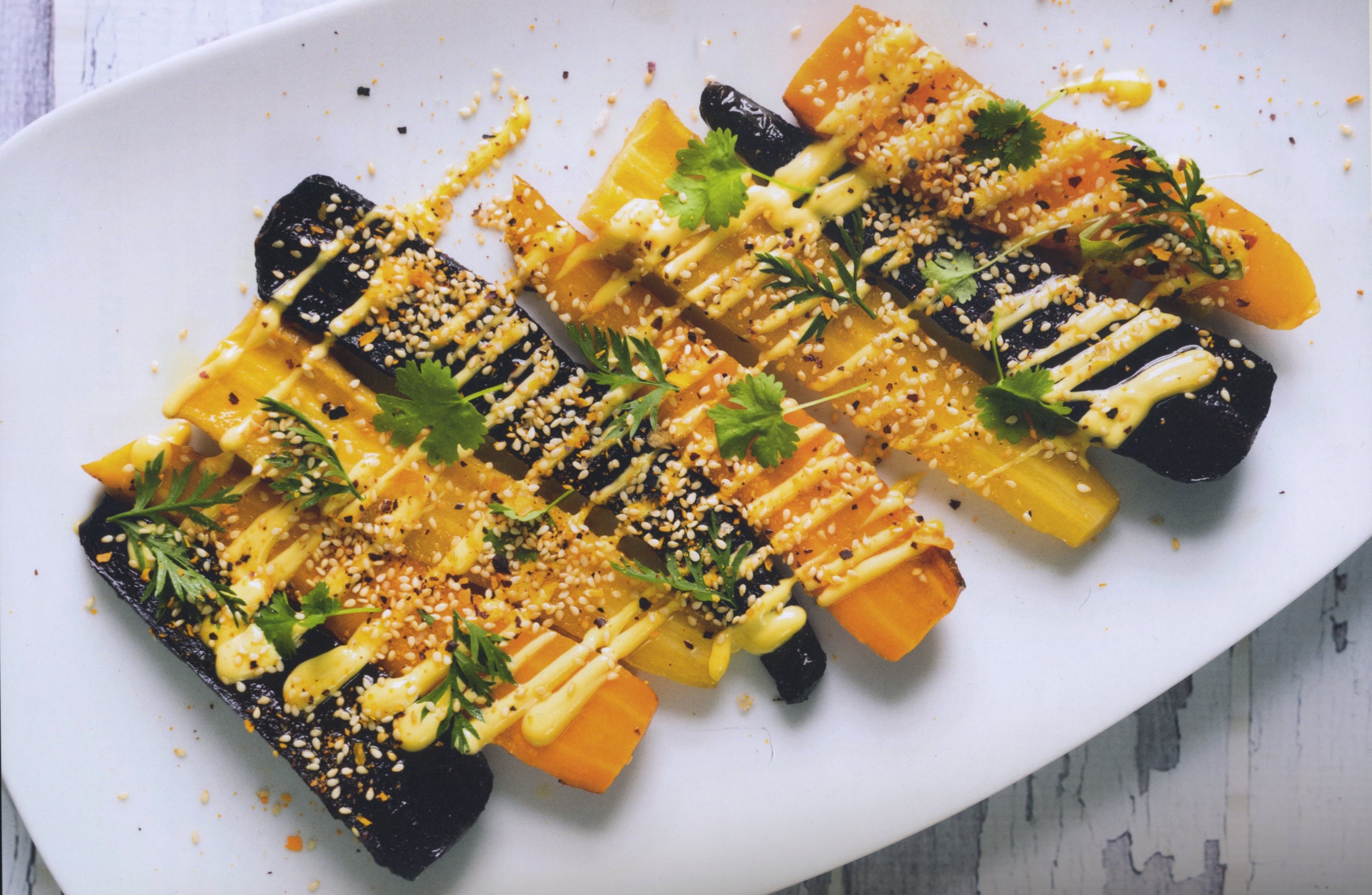
Celebrating the seriously good things in food and hospitality that North Antrim and nearby areas have to offer was the theme at a ‘Giant Taste of Causeway Coast and Glens’ event that I was fortunate enough to attend recently. And, with its heartening - and meaningful - ’Celebrate, collaborate and inspire’ theme, and a terrific range of businesses and supportive entities involved, including Slow Food (of which local heroine Paula McIntyre is a board member), it was a real eye-opener. The changes that the region has seen over the last few years are remarkable by any standards, and it’s now providing a template for the development of sustainable food and hospitality that other regions should find very helpful. The enthusiasm and drive of the (growing) Taste Causeway group is infectious and it's interesting to see neighbouring areas keen to participate, including Donegal with their Food Coast Donegal initiative.
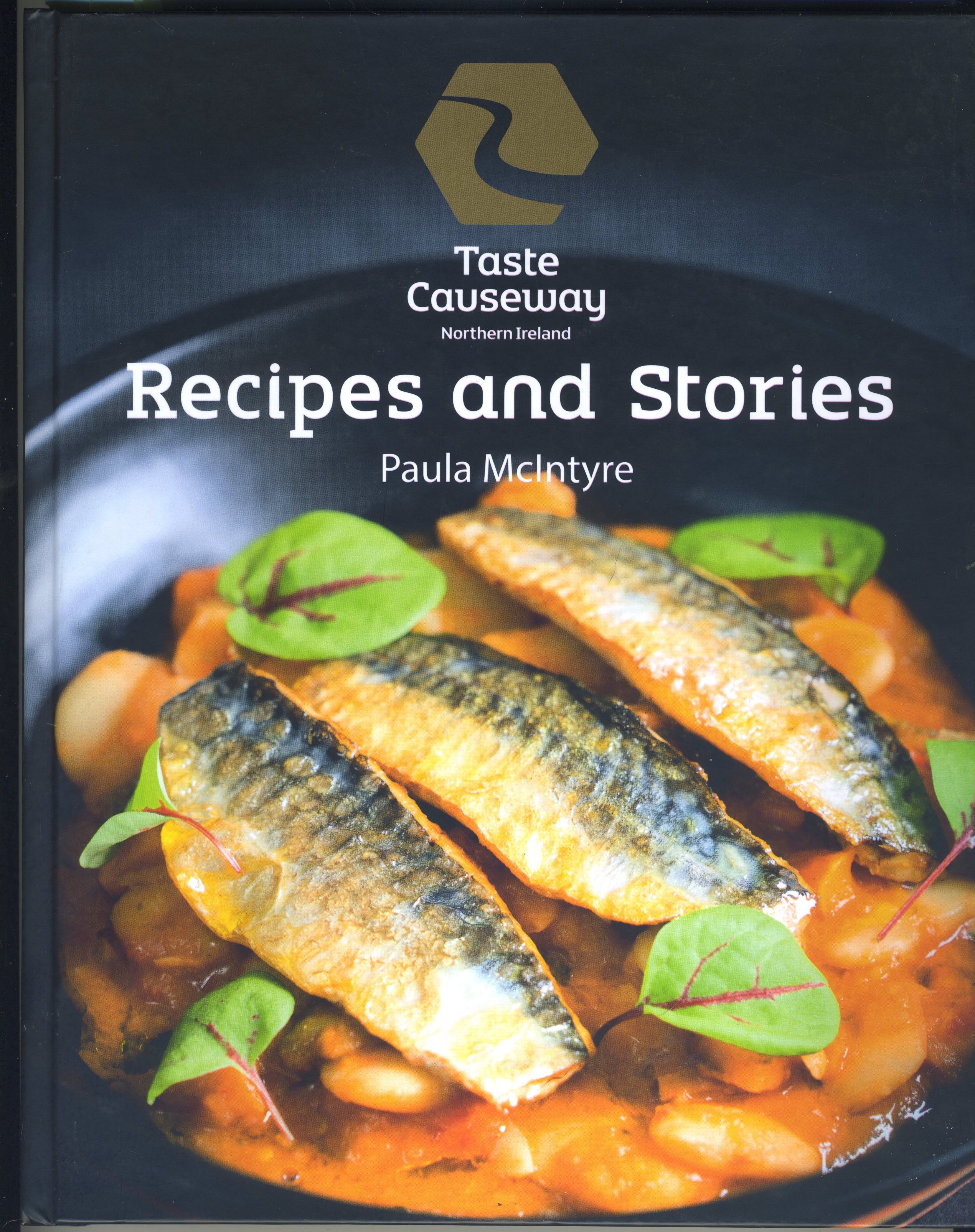 Paula McIntyre’s fascinating cookbook, Taste Causeway - Recipes and Stories is a great introduction to Taste Causeway, and well worth seeking out - not just for its great recipes (of which there are plenty, from producers and hospitality destinations along the way) but also to get a flavour of what's going on up there. Reasons to visit, in fact. Paula is one of the driving forces behind Taste Causeway and a great example of ‘ask a busy person’ when it comes to getting things done – amongst many other things she’s the incoming Chair of the Irish Food Writers’ Guild and, with her popular ‘media chef’ hat on, also happens to be heading Stateside in the coming weeks, to make a new TV series. As you do.
Paula McIntyre’s fascinating cookbook, Taste Causeway - Recipes and Stories is a great introduction to Taste Causeway, and well worth seeking out - not just for its great recipes (of which there are plenty, from producers and hospitality destinations along the way) but also to get a flavour of what's going on up there. Reasons to visit, in fact. Paula is one of the driving forces behind Taste Causeway and a great example of ‘ask a busy person’ when it comes to getting things done – amongst many other things she’s the incoming Chair of the Irish Food Writers’ Guild and, with her popular ‘media chef’ hat on, also happens to be heading Stateside in the coming weeks, to make a new TV series. As you do.
One or two of the forty or so businesses featured in the cookbook have sadly fallen by the wayside due to the pandemic and other recent challenges, but happily almost all are thriving – and, excitingly, there are plenty more coming on stream. Most recently, for example, the much-missed French Rooms in Bushmills is starting a new chapter as the latest addition to Derry’s famous Browns Bonds Hill Collection, Bushmills Townhouse - joining established businesses including The Bushmills Inn, Tartine at the Distillers Arms and indeed the Old Bushmills Distillery itself, to make this small town one of the most rewarding destinations in Ireland.
- *Taste Causeway – Recipes and Stories by Paula McIntyre. Hardback, 160pp, colour photography throughout; price £25. Buy online from Taste Causeway Northern Ireland Also available from some of the member businesses featured
- Read more about the recent ‘Giant Taste of Causeway Coast and Glens’ event here: https://ireland-guide.com/blogs/2024/04/03/an-inspiring-taste-of-the-causeway-coast-and-glens/
A few recipes to try from Taste Causeway – Recipes and Stories:
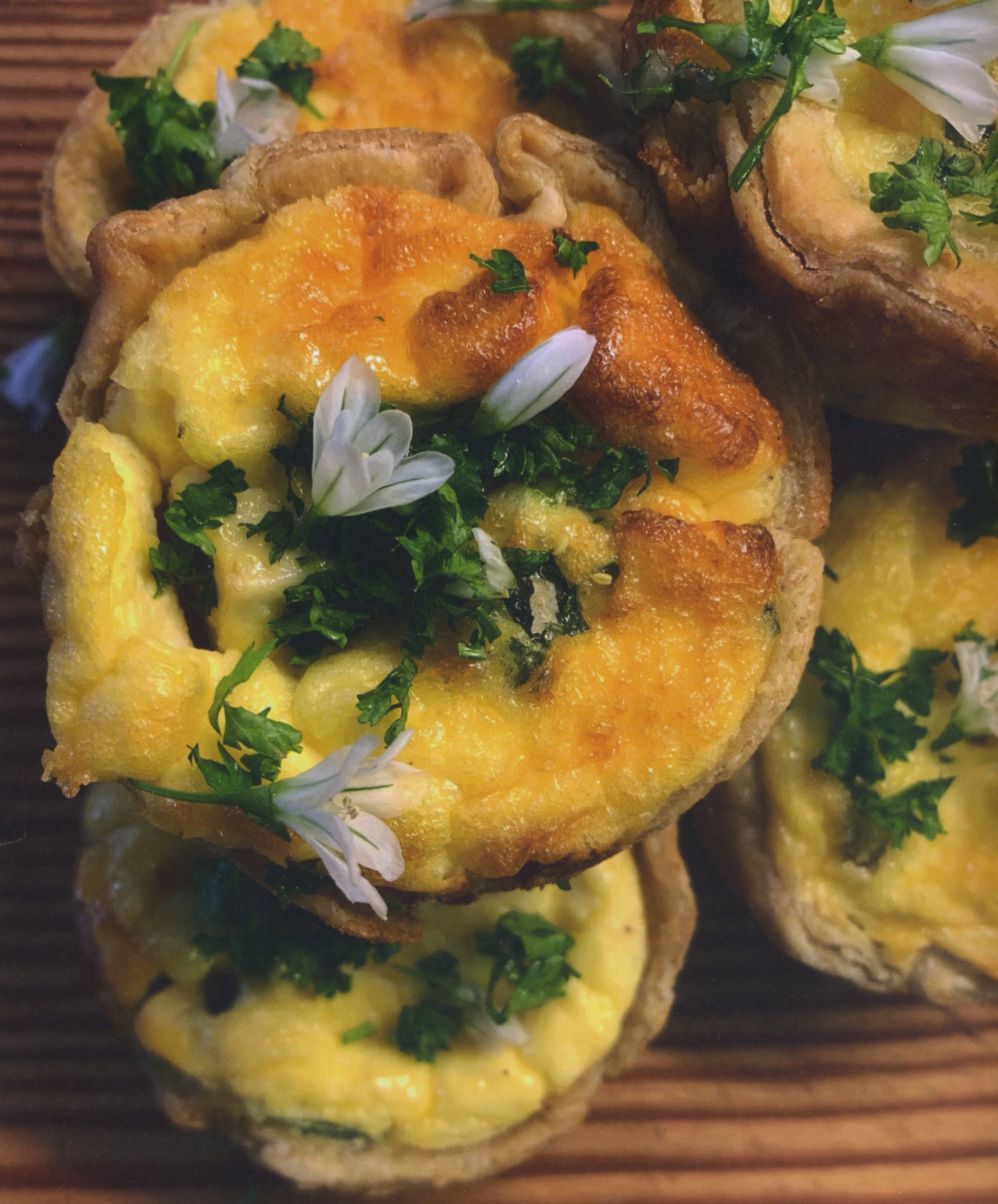 URSA MINOR’S SAVOURY TARTLETS WITH ROASTED JERUSALEM ARTICHOKE AND THREE CORNERED LEEK
URSA MINOR’S SAVOURY TARTLETS WITH ROASTED JERUSALEM ARTICHOKE AND THREE CORNERED LEEK
Small but mighty, Dara and Ciara O'hArtghaile’s Ursa Minor (‘little bear’ star constellation) Slow Food bakery and café is one of the most interesting food destinations anywhere in Ireland and, like several other businesses in the area, also home to an Economusée where you can see artisans at work (Bakehouse Tours). Baking workshops are available too, and a Baking School is in the making across the road. While most famous for their ever-evolving sourdough breads, they do all kinds of seasonal bakes and a delicious savoury tartlet such as this is sure to be on the menu.
Pastry - makes 12
200g plain flour
50g whole meal or spelt flour
Pinch salt
125g unsalted butter
l egg
2-3tbsp ice cold water
Filling
225g double cream
75g Greek style yoghurt
3 eggs
Salt and pepper
Tartlets
Handful of chopped three cornered leek or scallions
12 roasted Jerusalem artichoke
St.Tola feta style goat's cheese
Fresh parsley, chopped
Pastry: Pop water into the freezer to ensure it's cold while you get the rest ready. Mix the dry ingredients.
Place the butter between two pieces of greaseproof paper and bash quickly with a rolling pin, so that it remains cold but becomes pliable.
Cover with the flour then tear into chunks and start flicking it together with the flour until the largest chunks you have are about the size of cornflakes -the larger the butter chunks, the flakier the pastry.
Make a well then add the egg and water and bring together quickly on your worktop, shape into a rectangle.
Wrap in greaseproof paper and chill for at least one hour in fridge.
Grease a 12-hole muffin tin, roll pastry out to 3mm thick then use a pastry cutter to cut out and gently shape into the tin. Pop in freezer while you prepare the filling.
Filling: Whisk together until thoroughly mixed.
Tartlets: Take the tin out of the freezer and place a few pieces of chopped artichoke, cheese and a large pinch each of chopped parsley and three cornered leek (or wild garlic, which is similar).
Pour over the cream mixture to fill about two thirds of the tartlet.
Bake at 200°C for 20 minutes - they will puff up and be jiggly when they come out but will set.
Top with more chopped parsley. Enjoy with some chutney and green salad, or as part of a picnic.
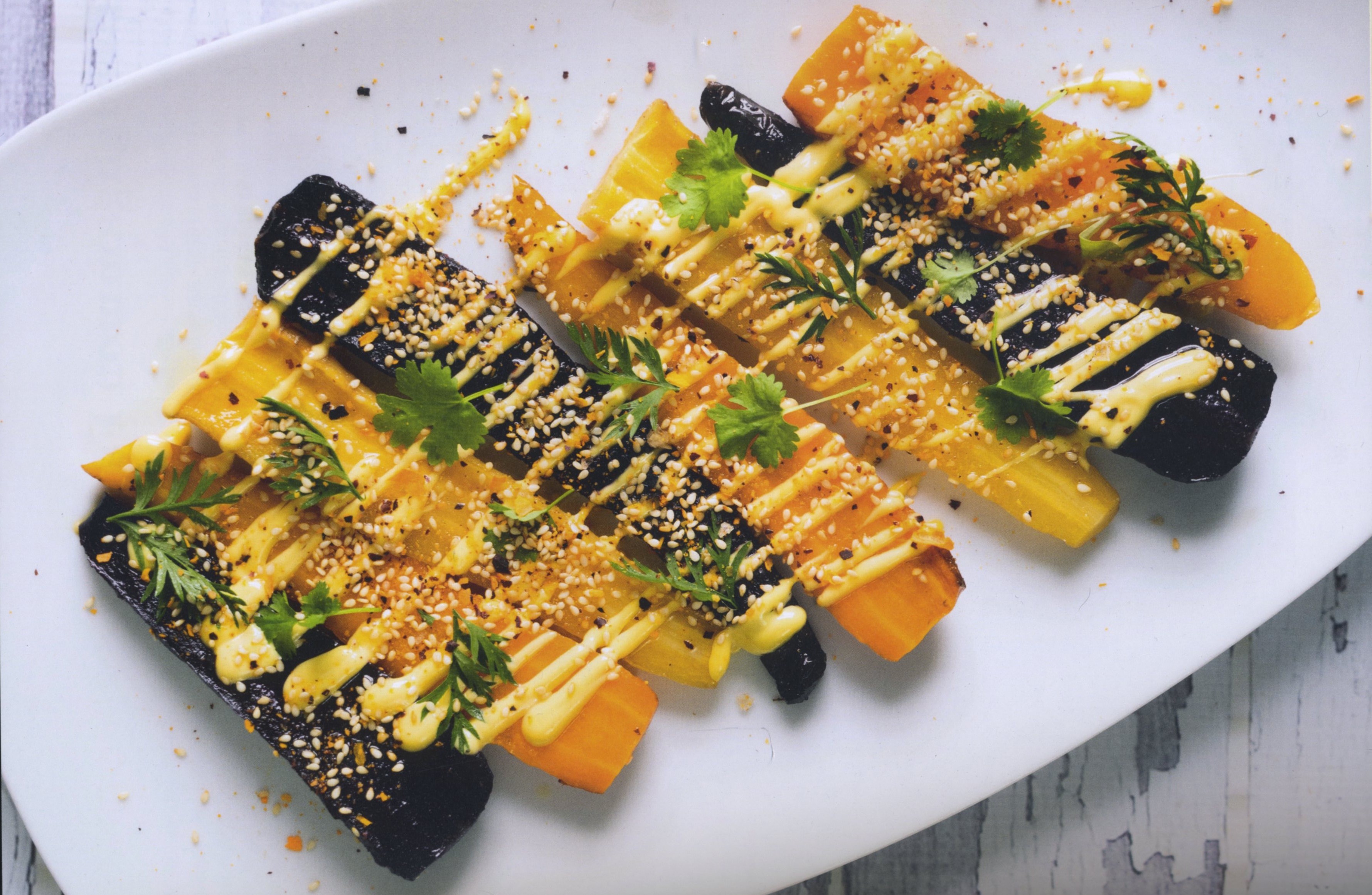 BROIGHTER GOLD HERITAGE CARROTS ROASTED WITH AIOLI AND CARROT FURIKAKE
BROIGHTER GOLD HERITAGE CARROTS ROASTED WITH AIOLI AND CARROT FURIKAKE
Sixth generation farmer Richard Kane and his enterprising wife Leona established Broighter Gold Rapeseed Oil
at their farm near Limavady in 2011. Now one of Ireland and the UK's most innovative and highly respected rapeseed oil producers, they are members of the Économusée network and have been welcoming visitors to their Economusée & Food Trail since 2012. In 2020 they ‘added growing carrots to the mix of craziness on the farm’. It’s a fascinating story and they’re getting a name for their heritage varieties - ask about it when you visit.
Ingredients
3 purple carrots
3 orange carrots
3 golden carrots
50 ml Broighter Gold rapeseed oil
1teaspoon seasalt
Few sprigs thyme and rosemary
Aioli
2 egg yolks
1 clove garlic, finely grated
1 tablespoon cider vinegar
150ml Broighter Gold lemon oil
Salt to taste
Carrot Furikake
1 large orange carrot
2 tablespoons toasted sesame seeds & 1 teaspoon smoked paprika
2 teaspoons North Coast Smokehouse smoked dulse https://www.northcoastsmokehouse.com/
Carrots
Set oven to 180°C. Scrub carrots and cut in half lengthwise.
Place in a bowl and add the oil, salt, thyme and rosemary. Toss well to coat, then place on a baking tray lined with parchment paper. Cover with more parchment paper and crimp the edges to seal.
Place in oven for about 45 minutes or until cooked through.
Aioli
Blend the egg yolks, garlic and vinegar for a minuti then slowly add the oil, blending all the time.
Season with salt to taste.
Carrot Furikake
Peel the carrot into ribbons and place on a baking tray lined with parchment paper.
Set oven to 100°C and put tray in oven. Cook until crisp - could take an hour.
Cool and then place in a bag and bash with a rolling pin.
Mix in the toasted sesame, dulse and paprika.
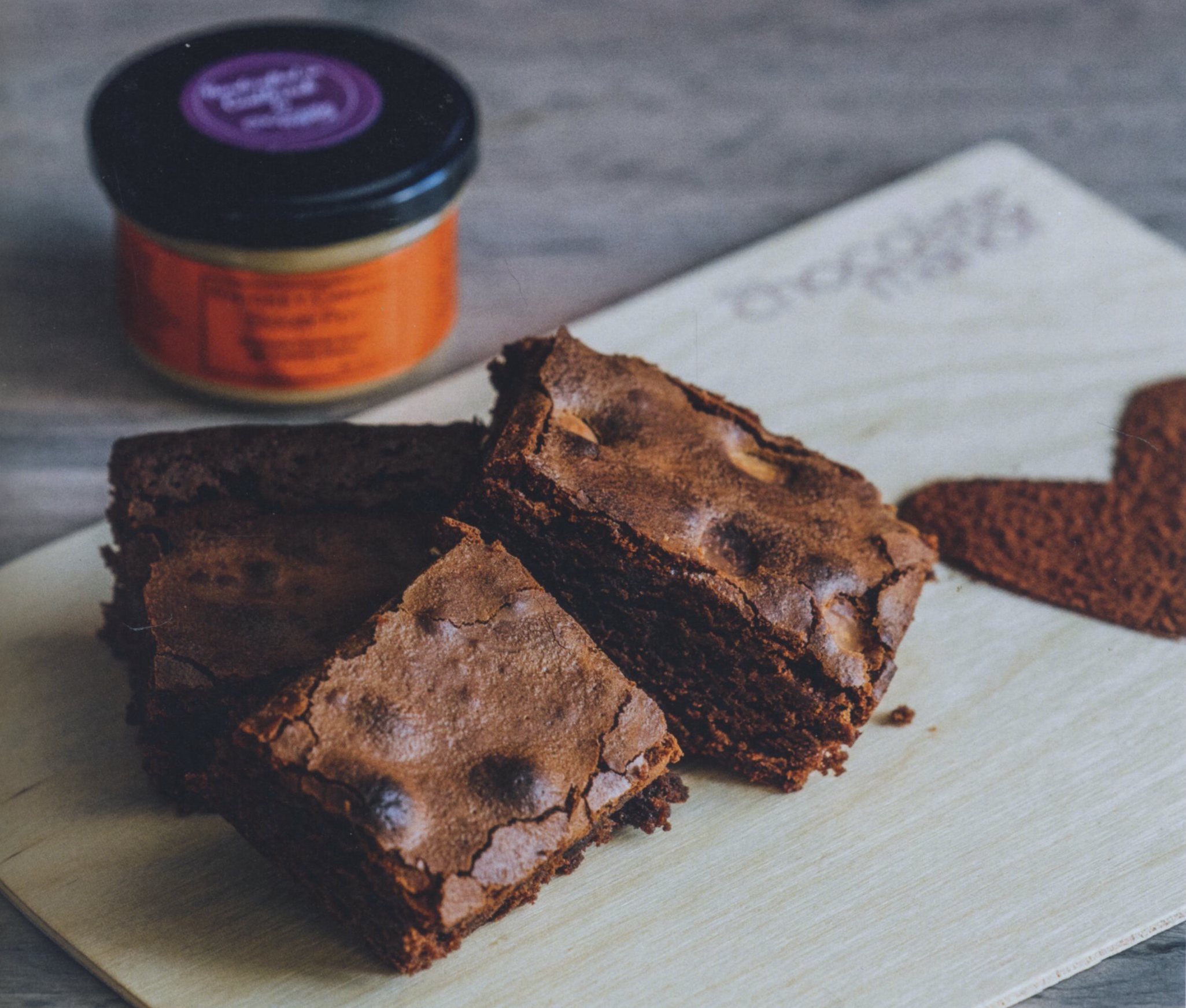 THE CHOCOLATE MANOR’S CHOCOLATE BROWNIES WITH BUSHMILLS WHISKEY CARAMEL SAUCE
THE CHOCOLATE MANOR’S CHOCOLATE BROWNIES WITH BUSHMILLS WHISKEY CARAMEL SAUCE
Geri Martin, owner and Chief Chocolatier at The Chocolate Manor in Castlerock is a founding member of Taste Causeway group and – having started in her own kitchen - now operates from a modern premises which includes a Chocolate Shop and Artisan Food Emporium, selling their own and other Taste Causeway products. Their Taste Causeway Chocolate Experience (an interactive workshop, where visitors create luxury chocolate truffles filled with local produce) was awarded Tourism NI Food and Drink Experience of the Year in 2022.
100g butter softened
200g milk chocolate — we love our brownies made with milk chocolate!
250g golden caster sugar
l00g plain flour
30g cocoa
1 teaspoon baking powder
4 eggs
Optional: 50g caramel chocolate buttons
Jar of Chocolate Manor Whiskey Boozy Pot
Heat the oven to 180°C/fan 160°C/gas 4
Line a brownie tin/tray with baking parchment.
Melt the butter and chocolate together in a microwave - do this slowly to avoid burning the chocolate. Allow the mixture to cool to room temperature.
Meanwhile, whisk the eggs and sugar together until the mixture is light and fluffy.
Take the chocolate mixture and fold gently into the egg mixture.
Sift over the flour, baking powder and cocoa.
Fold the mixture gently until it creates a gooey and fudgy batter.
Pour into the baking tray and smooth out to even the mixture.
Bake for 25-30 minutes, or until the top is cracked but the middle is just set.
Cool completely, then lift out of the tin and cut.
Spoon some of the Chocolate Manor Boozy Pot into a microwaveable dish and heat for 20 second bursts until it becomes a delicious runny sauce. Pour over your brownies and enjoy!
Cookery & Food Tourism Feature - Wonderful Waterford
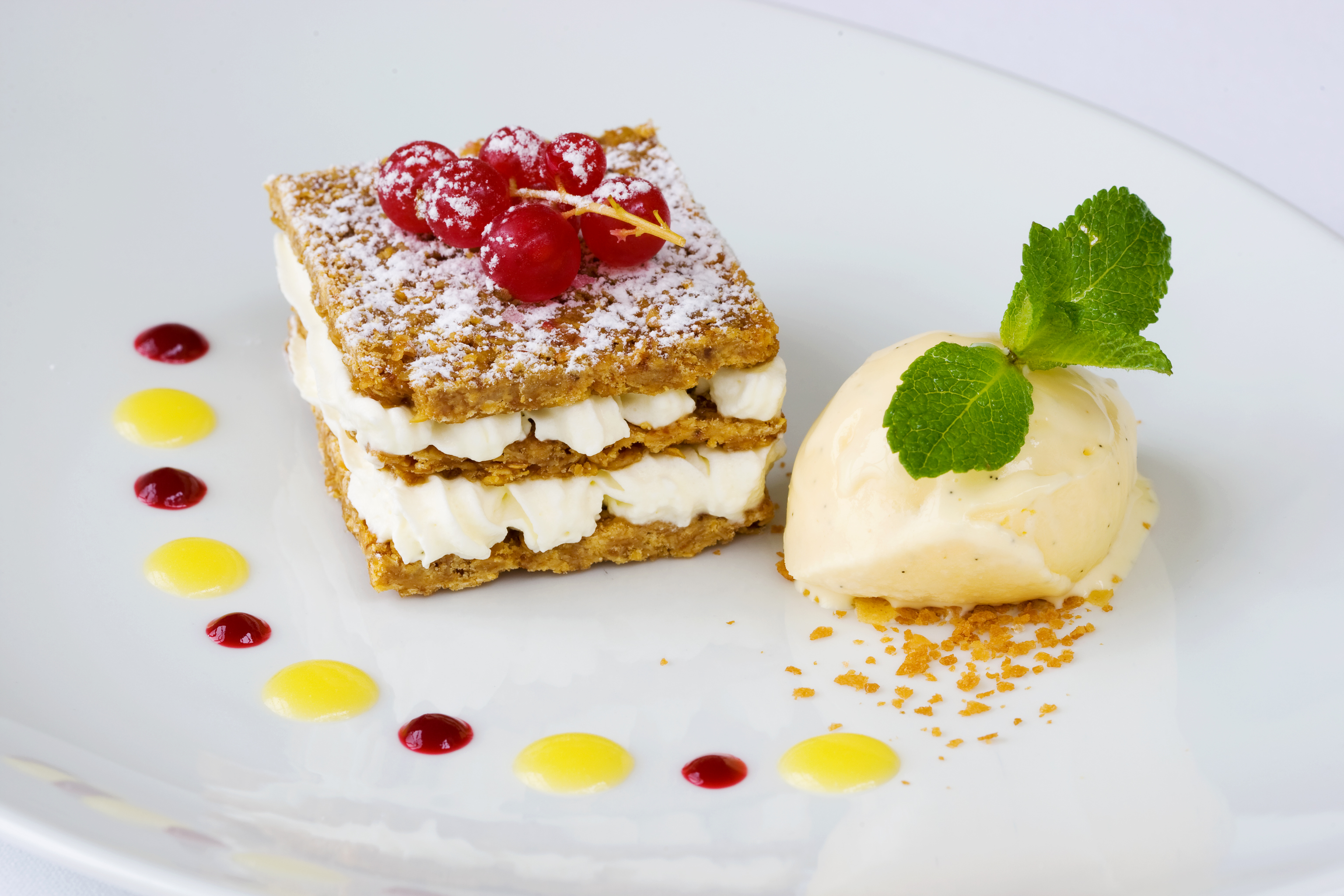
Now growing into its role as a major player in Irish food and tourism, Waterford was in fine fettle at the recent Waterford Festival of Food in Dungarvan – long gone are the times when visitors looked for the famous signposts to Killarney, these days they have too many reasons to stay put and explore this lovely region and Ireland’s oldest city, founded by Vikings in 914AD.
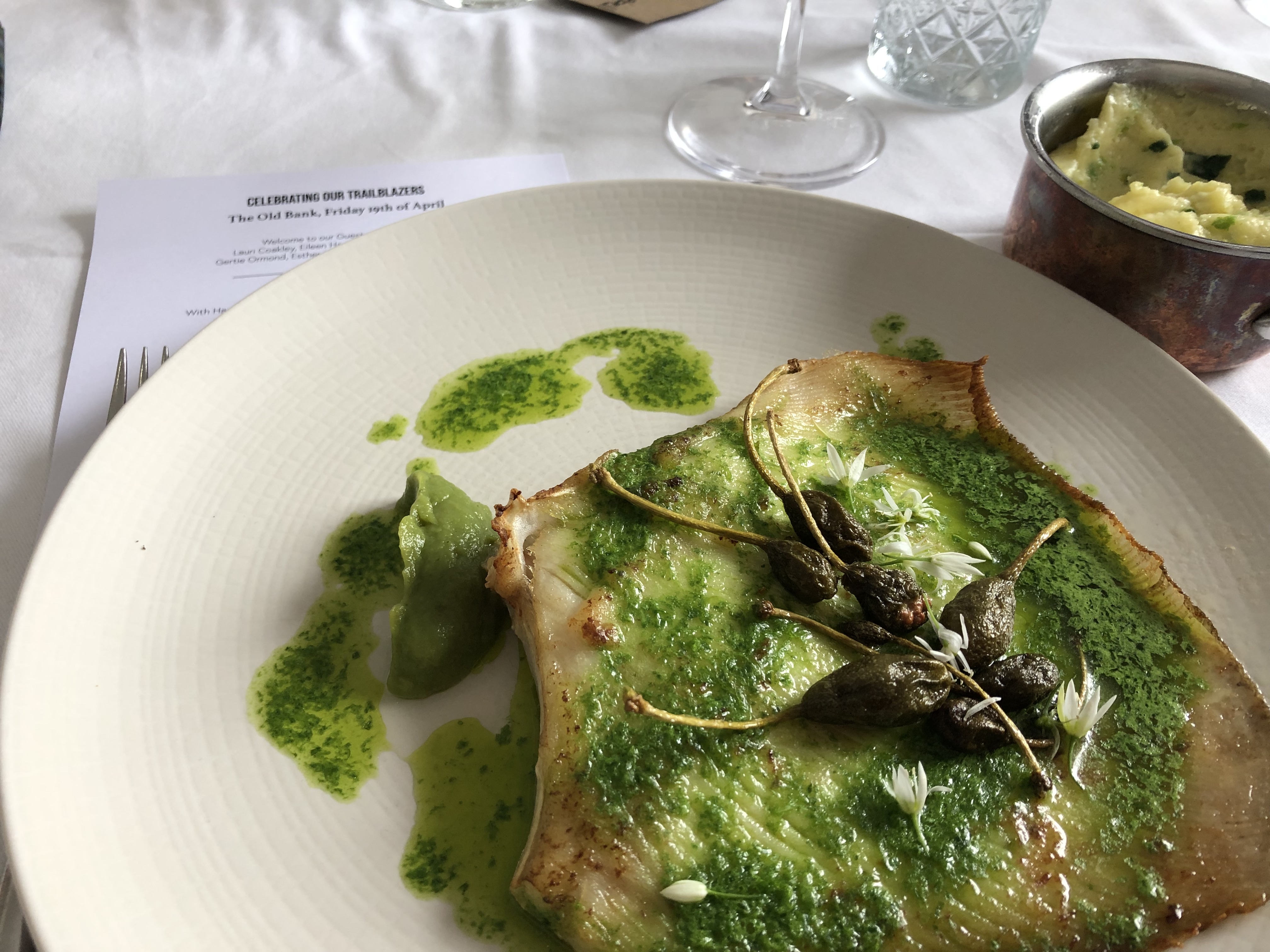

And, hot on the heels of the recent food festival, a series of enticing announcements has already followed – there’s the Taste Waterford Mountain Splendour Food Tour (selected dates); the 4-day Waterford Slow Travel Experience Itinerary; the Dive into Waterford Photographic Competition; and – coming very soon, 27th May-3rd June 2024 – the Blackwater Valley Opera Festival, which will be taking place throughout the Blackwater Valley in Waterford and Cork. The energy and community co-operation in the area is infectious and it’s a great destination for short breaks and staycations, as well as a joy for visitors to discover.
The experiences promised are are wide-ranging and holistic, but good cooking is at the heart of the Waterford success story, so here are a few related recipes to try:
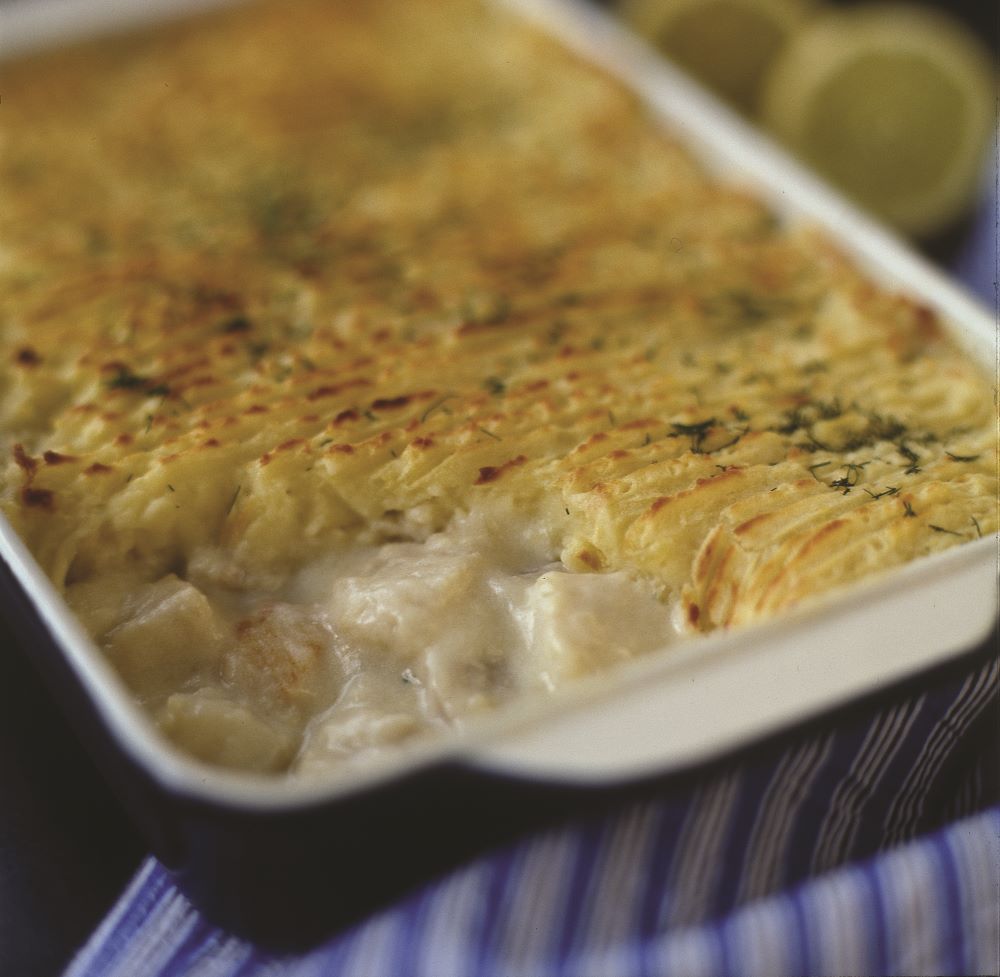 Helvick Fish Pie
Helvick Fish Pie
Eunice Power - TV chef, director of the Waterford Food Festival, owner of the super little Dungarvan restaurant …And Chips, ambassador for Irish food and ingredients and much more, has been energetically promoting the region for decades. Amongst her many other activities – which have included running a B&B and a cookery school – she also wrote a delightfully down to earth cookbook for Waterford Stanley, ‘Cook with Stanley’, which is well worth picking up if you spot a copy. This collection of wholesome recipes includes a delicious fish pie, which is “a useful dish to prepare ahead and chill, ready for reheating later in the day. The fish used can be varied to suit the occasion and the season, using a whitefish or salmon as the basis for the mixed fish, and adding mussels, prawns or whatever is available at your local fishmongers”. Serves 4:
1¾lb/800g mixed fish
12 fl oz/350ml milk
1 bay leaf
1 oz/25g butter
1 oz/25g flour
2 fl oz/50ml white wine
2 fl oz/50ml chicken stock
Salt & pepper
3 sprigs chopped fresh dill
3 lb / 1.3kg potatoes
Butter & milk, as required
Cut the fish into similar-sized portions, if necessary, and poach in the milk with the bay leaf, until the fish is opaque. Strain the milk off the fish and reserve for the sauce. Flake the fish off the skin, check for bones and place in a pie dish.
To make a white sauce, melt the butter and add the flour to make a roux; cook over gentle heat for 1-2 minutes, then blend in the wine and chicken stock, stirring with a whisk over moderate heat until the sauce becomes thick, then add the reserved milk as required and stir to make a thick, smooth sauce. Season to taste and add the chopped dill.
Pour the sauce over the fish and allow to cool. Preheat a moderate oven, 350’F/180’C. Steam the potatoes until cooked, then peel and mash with the milk and butter until light and fluffy. Season to taste. Smooth the mashed potatoes over the fish and sauce in the pie dish and place in the preheated oven for 15 minutes, until nicely browned. Serve with a crisp green salad.
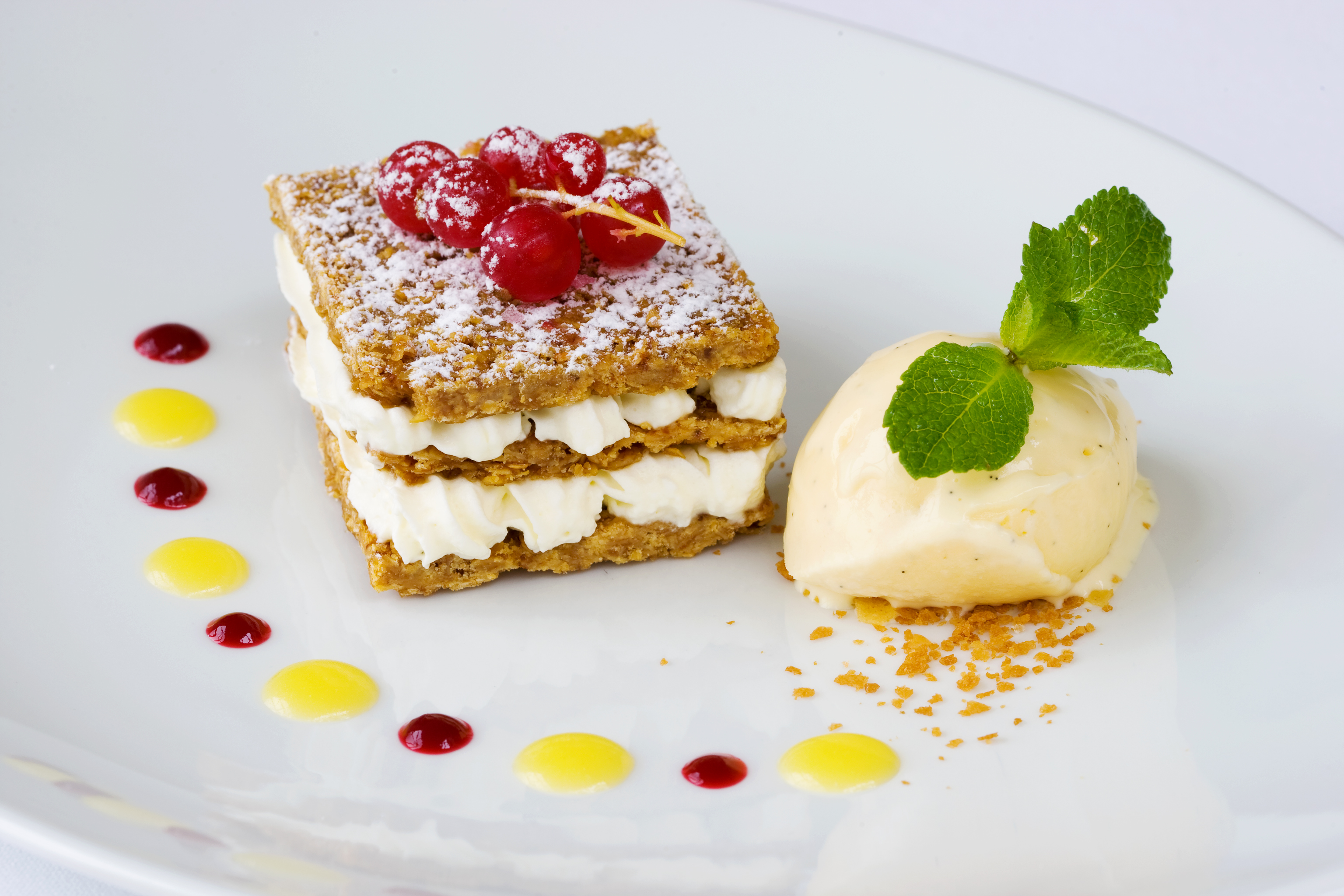 Mille Feuilles Flapjacks With Lemon Cream
Mille Feuilles Flapjacks With Lemon Cream
Established in 1785, Flahavan’s of Kilmacthomas, Co Waterford is Ireland’s oldest family-run food business yet, now in its 7th generation, it has never stopped looking forward. Although the much-loved porridge oats remain the core product, their constantly evolving range is innovative and they’re very community focused and environmentally aware too – a current initiative, for example, associates their Organic Oats with Waterford city’s GIY enterprise, in a competition to Win a GROWbox for Bees, and Flahavan’s sponsored several highly relevant events at the recent Waterford Festival of Food, including the Kids Bake Off competition. They’ve received many well-deserved accolades over the years, including one of our own Irish Breakfast Awards and a special Environmental Award from the Irish `Food Writers’ Guild - when Derry Clarke (currently Culinary Director at The Club at Goffs ) created this timeless dessert recipe to mark the event. Serves 4
200ml (7fl oz) cream
finely grated rind of 1 lemon
2 tbsp lemon curd
4 redcurrant sprigs
icing sugar, to dust
For the flapjacks:
175g (6oz) butter, plus extra for greasing
175g (6oz) light muscovado sugar
175g (6oz) golden syrup
350g (12oz) rolled oats
Serving & decoration suggestions:
• finely crushed praline, vanilla ice cream, fresh mint sprigs
• lemon curd coulis and raspberry coulis
First make the flapjacks: Preheat the oven to 150ºC (300ºF), Gas mark 2. Grease a shallow tin measuring about 28 x 18 x 4cm (11 x 7in). Melt the butter, sugar and golden syrup in a heavy-based pan over a low heat and then pour it into the rolled oats. Mix well and turn the mixture into the prepared tin to a 5mm (¼ in) thickness and press down well. Bake for about 40 minutes until golden brown.
Leave to cool for about 5 minutes, then mark into 5 x 4cm (2 x 1½in) rectangles with a sharp knife and loosen around the edges. When firm, remove from the tin and cool on a wire rack, then snap into the marked out rectangles. These can be stored in an airtight container for up to 3 days.
To make the lemon cream: Whip the cream, lemon curd and lemon rind in a bowl until soft peaks form. Spoon into a piping bag fitted with a 5mm (¼ in) fluted nozzle.
To assemble the dessert: Place four of the flapjacks on a flat surface and pipe over a layer of the lemon cream; cover with another flapjack followed by another layer of lemon cream. Finish each one with a flapjack and add a sprig of redcurrants, then give a light dusting of icing sugar.
To serve: Using a palette knife, transfer to serving plates and add a sprinkling of praline to the side of each one and top with a scoop of the vanilla ice cream decorated with a mint sprig. Alternate tiny spoonfuls of the lemon curd coulis and the raspberry coulis to serve.
 Mushroom Soup in a Blaa
Mushroom Soup in a Blaa
Esther Barron of Barron’s Bakery & Coffee House in Cappoquin was one of the legendary ladies honoured at Waterford Food Festival’s lovely ‘Celebrating Our Trailblazers’ lunch at The Old Bank (see above), and this recipe is from their super book ‘Our Daily Bread’ (hardback ‘with a cover the soft feel of a loaf of bread’), which is available on their website. “This is an easy recipe and quantities of ingredients don't have to be exact, so you can avoid using the weighing scales. You can serve this in a crusty roll, such as one of Barron's traditional blaas*,” explains Esther. “The bread taken out of the roll to make space for the soup is used as breadcrumbs to thicken the soup. The cut-off tops can be buttered or dipped in olive oil.” *The Waterford ‘blaa’ is a local speciality bread roll with EU protected Geographical Indication - PGI - designation for regional foods and ingredients. Serves 4
2 handfuls mushrooms, chopped
1 large onion, finely chopped
1 clove garlic, finely chopped
Knob of butter
500ml water or stock
1 handful breadcrumbs
Chopped parsley
½ teaspoon chopped chilli or chilli flakes (optional)
Splash of milk or cream (optional).
In a saucepan with the lid on cook the onions, garlic and mushrooms in the butter until the onion is soft. Add the stock, which can be chicken, beef or vegetable, or water, with a dash of soya sauce. Gently simmer for 10 minutes.
Cut the tops off four rolls. Remove most of the inside, leaving a thick enough crust to hold the soup. Brush the inside with melted butter and place in the oven for 10 minutes at 180°C, 350°F, GAS 4 to crisp up a little.
In the meantime, make breadcrumbs from the insides of the rolls.
To finish the soup add the breadcrumbs and cook for a further 5 minutes until the soup thickens and becomes deliciously creamy. Add a splash of milk or cream to finish if you fancy it, and top with chopped parsley and/or chilli in winter.
Spoon the soup gently into the rolls and serve.
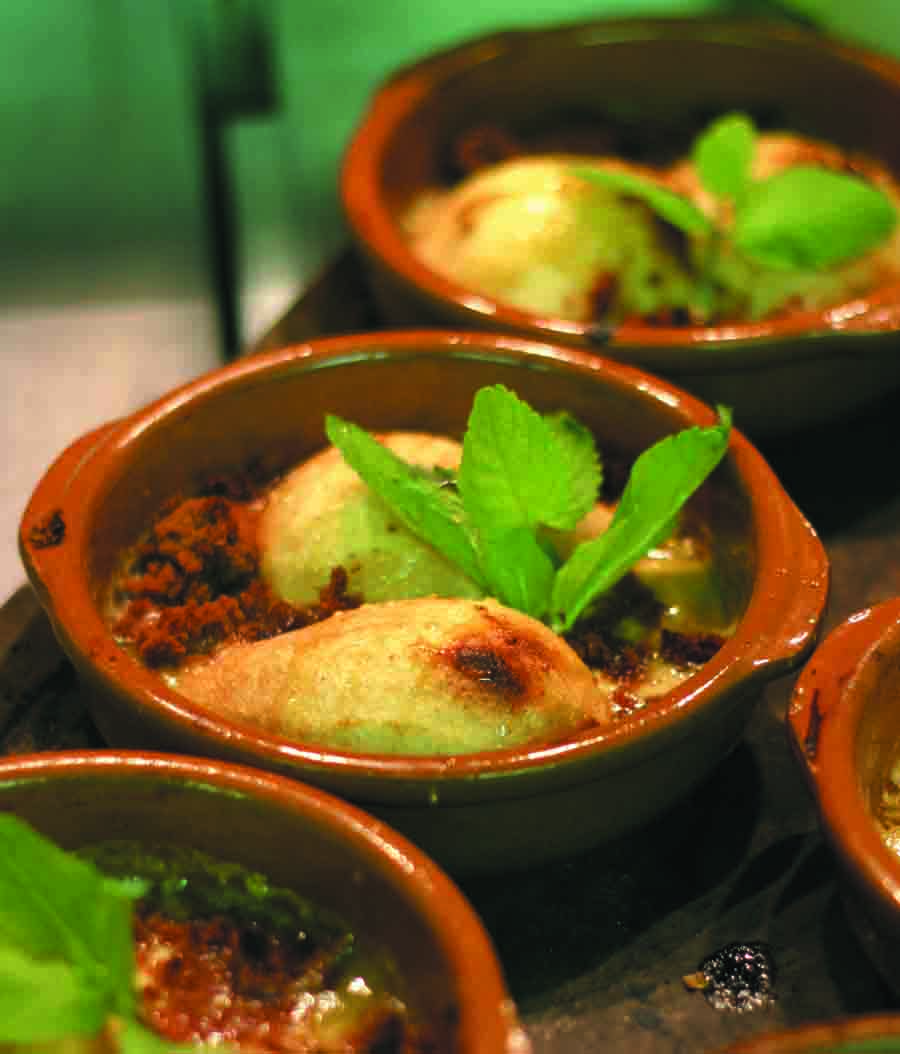 Baked Pears with Gingerbread and Cream
Baked Pears with Gingerbread and Cream
Paul Flynn’s arrival back in his hometown of Dungarvan in1997, to open The Tannery with his wife Máire, was a watershed moment for the town, and for the region. When working on the 1990s Waterford Good Food Tree guide I received a letter from Jean Duffy (of Waterford LEADER partnership), saying ‘I had a phone call from Paul Flynn (La Stampa) who is opening a restaurant in Dungarvan in a week or so…’ And the rest, of course, is history. A great Irish chef whose reputation is built as much on his caring selection of the best seasonal local ingredients as on his impressive skills in the kitchen, he may now be a household name for his TV work, cookery school and the Irish Times columns – now published as a single work in the acclaimed cookbook Butter Boy - but it’s easy to forget that overnight success was a long time coming and, although now recognised as a great man with the words, Butter Boy is his fifth book. The first was ‘An Adventure with Irish Food’, followed by ‘Second Helpings’ (Collins Press) which included cartoons by the inimitable Ken Buggy, then of Buggy’s Glecairn Inn, nearby at Lismore (and illustrator of West Waterford’s Good Food Tree). It has all the great man’s hallmarks - a really lovely read and lots of refreshingly simple dishes, such as luscious this dessert of Baked Pears with Gingerbread and Cream which, Paul says, ‘will still be scrumptious without the gingerbread, but I just think that final flourish lifts it to another crunchy level’ Serves 4
A small knob of butter
4 large pears (firm but ripe)
300ml /1/2 pint cream
50g/ 2oz caster sugar
2 drops vanilla extract
pinch of ground cinnamon
pinch of ground nutmeg
1 teaspoon freshly grated root ginger
4 slices of gingerbread, crumbled (optional but nice)
sprigs of fresh mint to decorate.
Preheat the oven to 190’C/375’F/gas mark 5.
Lightly butter a large shallow baking dish, or four individual ones. Peel the pears and cut in half lengthways, then carefully remove the cores. Arrange on the buttered dish in a single layer, cut side down.
Mix the cream, sugar, vanilla, cinnamon, nutmeg and root ginger until well combined. Pour over the pears then bake for 20 minutes, or until the pears are almost tender and the cream is well reduced.
Remove the pears from the oven and sprinkle the crumbled gingerbread on top (if using).
Bake for another 5 minutes until well heated through. The pears should now be completely tender and the cream thick and bubbly. Leave to cool slightly and decorate with sprigs of mint before serving straight to the table.
COOKERY FEATURE - SUMMER SEAFOOD
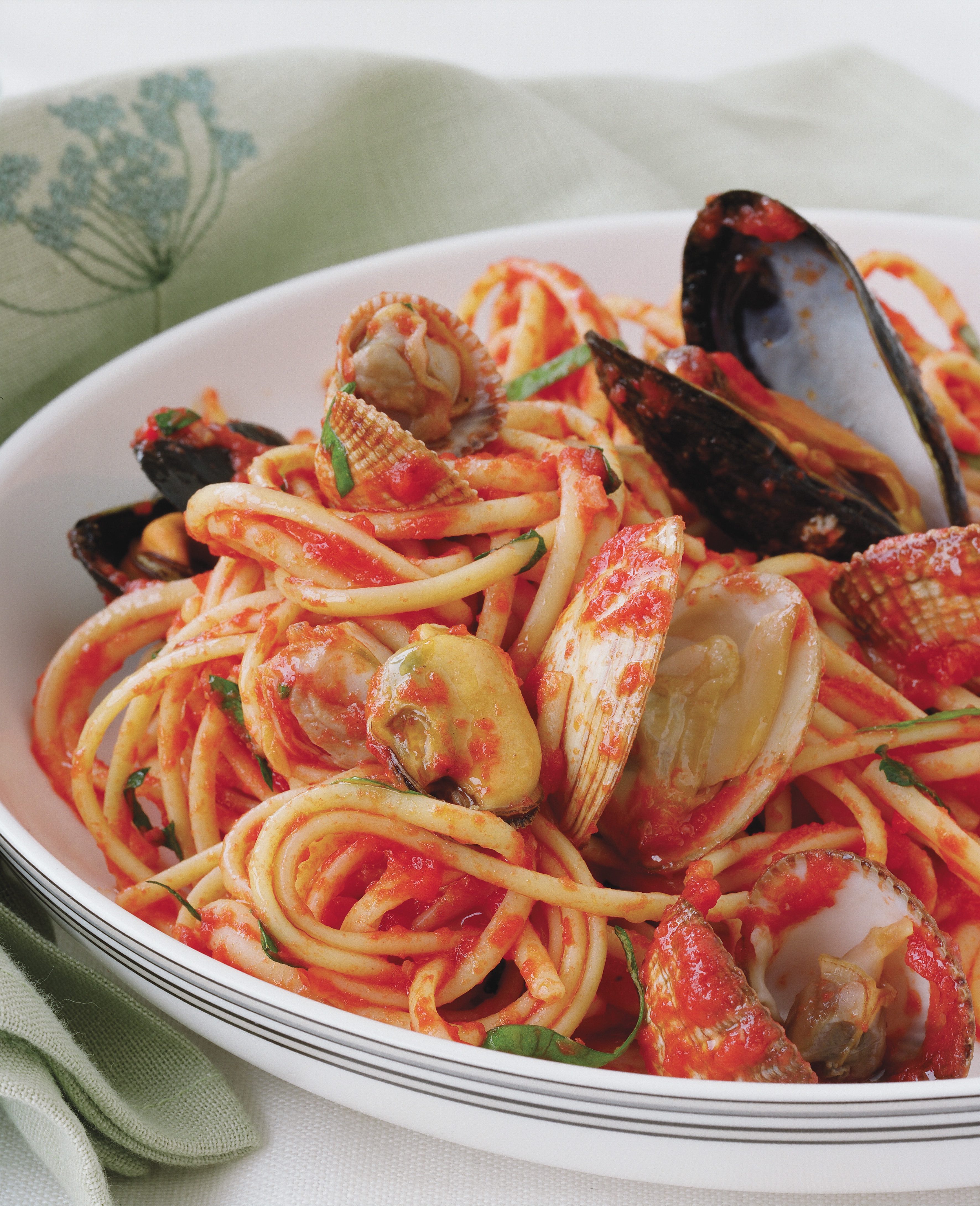
Light, colourful, tasty, quickly cooked and at its best in summer, Irish seafood is perfect for barbecues and casual entertaining.
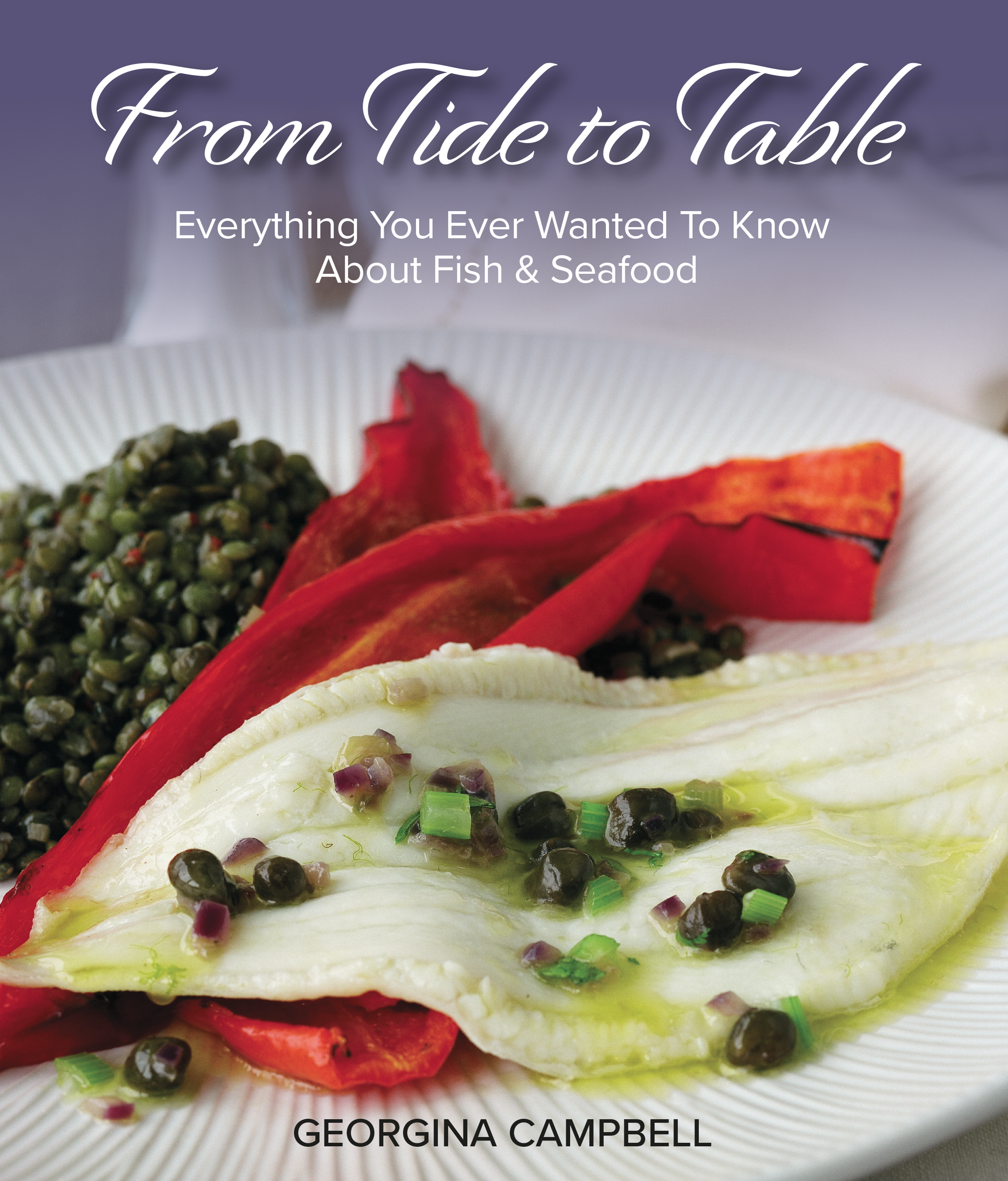 These favourite recipes are from From Tide To Table – All You Need To Know About Buying, Preparing & Cooking Seafood, with photography by Paul Sherwood which was originally published in association with Bord Iascaigh Mhara and has become a go-to reference for all things fish and seafood.
These favourite recipes are from From Tide To Table – All You Need To Know About Buying, Preparing & Cooking Seafood, with photography by Paul Sherwood which was originally published in association with Bord Iascaigh Mhara and has become a go-to reference for all things fish and seafood.
A complete user-friendly guide to buying, preparing and cooking the wide variety of fish and seafood caught or harvested in Irish waters, From Tide To Table gives home cooks the low-down on all the basic cooking methods, and the sauces, side dishes and accompaniments (including sea vegetables) that pair best with fish and seafood. Dishes featured include ideas for every occasion - wonderful chowders, great classics like prawn cocktail and grilled sole on the bone, comfort food, family fare and gorgeous seafood party platters.
* Available from good bookshops (ISBN: 978-1-903164-358), and online from https://www.ireland-guide.com/shop/product.php?item_id=13918&cat_id=836 From Tide To Table – All You Need To Know About Buying, Preparing & Cooking Seafood is priced at €20 (p&p free in Ireland).
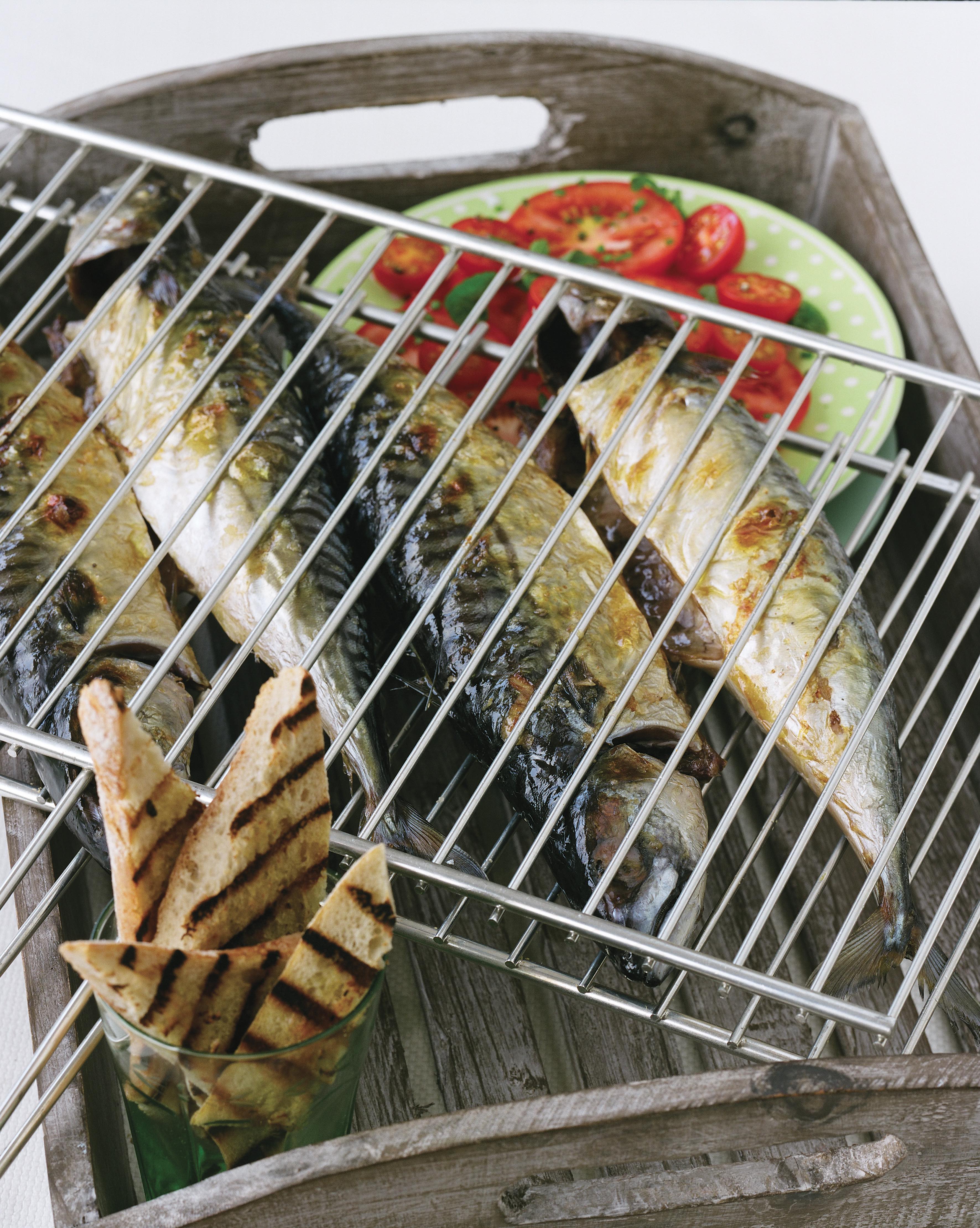 Grilled Mackerel with Three Tomato Salad and Bruschetta
Grilled Mackerel with Three Tomato Salad and Bruschetta
If cooking mackerel on the barbecue try using a hinged wire rack, which makes it easier to turn the fish over during cooking and helps to prevent them from sticking to the grill. Be careful not to overcook the mackerel, as they dry out easily. This mixed tomato salad is visually striking and the different varieties of tomatoes have their own individual textures and flavours. Serves 4
4 whole mackerel, gutted and cleaned
8 slices sourdough / country-style bread, cut on the diagonal
1 garlic clove, halved olive oil, for drizzling
For The Three Tomato Salad
2 beef tomatoes, thinly sliced
4 ripe tomatoes, cut into wedges
100g (4oz) sunagold or baby plum cherry tomatoes, halved
1 shallot, thinly sliced
handful fresh basil leaves, shredded
6 tbsp balsamic and honey dressing (see below)
freshly ground black pepper
Preheat the grill or prepare a barbecue with medium-hot coals. Slash the mackerel through the thickest part and cook directly on a grill rack for 6-7 minutes on each side until cooked through and lightly charred.
Add the sliced bread to the grill rack for the last minute or two of cooking, turning once. Rub with the cut side of the garlic clove and drizzle a little olive oil over each one. Keep warm.
Meanwhile, make the three tomato salad: Arrange the beef tomatoes in a single layer on the base of a large serving plate, then scatter over the tomato wedges and finish with a pile of the cherry tomatoes. Sprinkle over the shallots and basil and then drizzle the balsamic and honey dressing on top. Add a good grinding of pepper.
Serve the mackerel on plates with the bruschetta and hand the tomato salad around separately so that your guests can help themselves.
Balsamic And Honey Dressing
A variation of classic French vinaigrette that works well with the mackerel recipe above. You can adapt it to your own personal taste by using red or white wine vinegar, or experiment with different oils (some variations are suggested in From Tide To Table). This makes enough to dress a good-sized green or mixed salad
1 tbsp balsamic vinegar
½ teaspoon honey
4 tbsp extra virgin olive oil
1 small garlic clove, crushed
salt and freshly ground black pepper
Place the vinegar in a screw-topped jar and add the honey and a good pinch of salt, then shake until the salt has dissolved. Add the oil to the jar with the garlic and shake again until a thick emulsion forms. Season to taste and chill until needed.
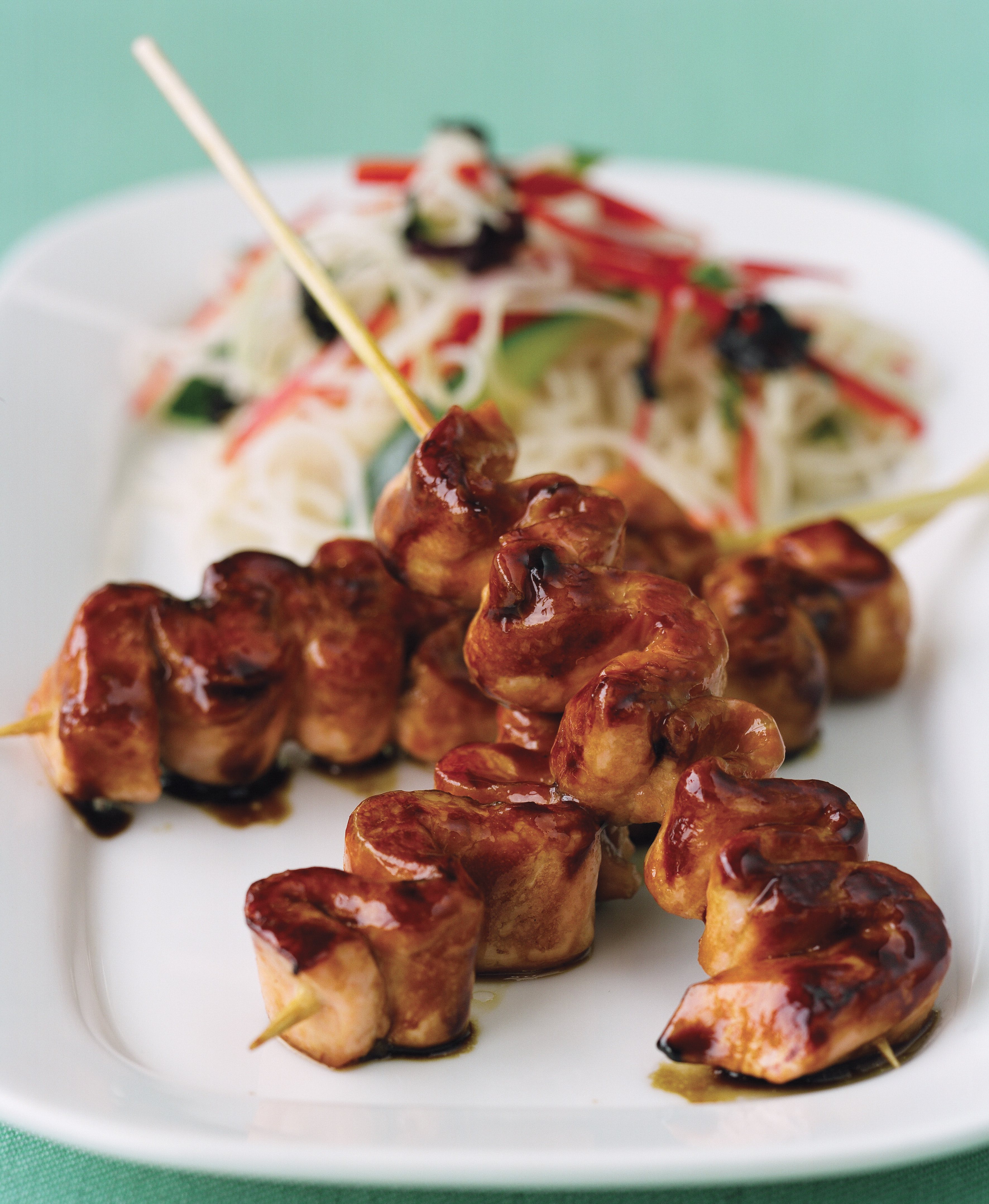 Salmon Teriyaki Sticks with Asian Noodle Salad
Salmon Teriyaki Sticks with Asian Noodle Salad
This is a great way of cooking salmon and, as the skewers are only brushed with honey just before serving, there is no danger of them sticking to the pan and burning before the salmon is cooked. Remember to soak the bamboo skewers if you are using the grill, so they won’t catch light whilst cooking. Serves 4
675g/1½ lb skinless salmon fillet, pin bones removed
4 tbsp dark soy sauce
2 tsp caster sugar
2 tbsp mirin (Japanese rice wine) or dry sherry
2 tbsp sunflower oil plus extra for brushing
2 tsp Dijon mustard
juice of ½ lemon
4 tbsp runny honey
To Serve: Asian noodle salad (see below)
Soak twelve bamboo skewers in cold water for at least 30 minutes. Cut the salmon into long, thin strips no more than 2.5cm/1 inch wide and about 5mm / ¼ inch thick.
Place the soy sauce in a shallow non-metallic dish. Stir in the caster sugar, mirin or sherry, sunflower oil, mustard and lemon juice until well combined and the sugar has dissolved. Add the salmon strips, stirring to coat, and set aside for 15 minutes to allow the flavours to develop.
Preheat the grill or prepare a barbecue with medium-hot coals. Thread the marinated salmon onto the soaked bamboo skewers in a zig-zag fashion. Brush with a little extra oil and cook for 1-2 minutes on each side until just tender and lightly charred.
Heat the honey in a small pan or in the microwave. Remove the salmon teriyaki sticks from the grill and brush with the warm honey. Arrange three sticks on each plate with the Asian noodle salad to serve.
Asian Noodle Salad
This salad is packed with great textures and flavours. You can experiment by using different types of noodles but glass noodles work well as they soak up the sauce a treat. They also provide a contrast in texture to the crunch of the pepper, spring onions and cucumber.
225g/8oz Thai glass noodles
1 tsp sesame oil
1 large red pepper, halved, seeded and finely sliced
6 spring onions, finely shredded
1/2 cucumber, peeled, seeded and finely sliced
handful fresh coriander leaves, roughly chopped
For the Dressing (Serves 4-6)
4 tbsp Thai fish sauce (nam pla)
4 tbsp fresh lime juice
1/2 tsp dried chilli flakes
11/2 tsp sugar & 1 crushed garlic clove
Cook or soak the noodles according to packet instructions. Drain well and then toss with the sesame oil. Fold in the red pepper, spring onions and cucumber.
To make the dressing, place the Thai fish sauce in a small bowl with the lime juice, chilli flakes, sugar and garlic. Whisk until well combined and then add to the noodles, stirring until evenly combined.
If time allows, cover with clingfilm and leave for about 2 hours to absorb all the flavours. Just before serving, fold in the fresh coriander.
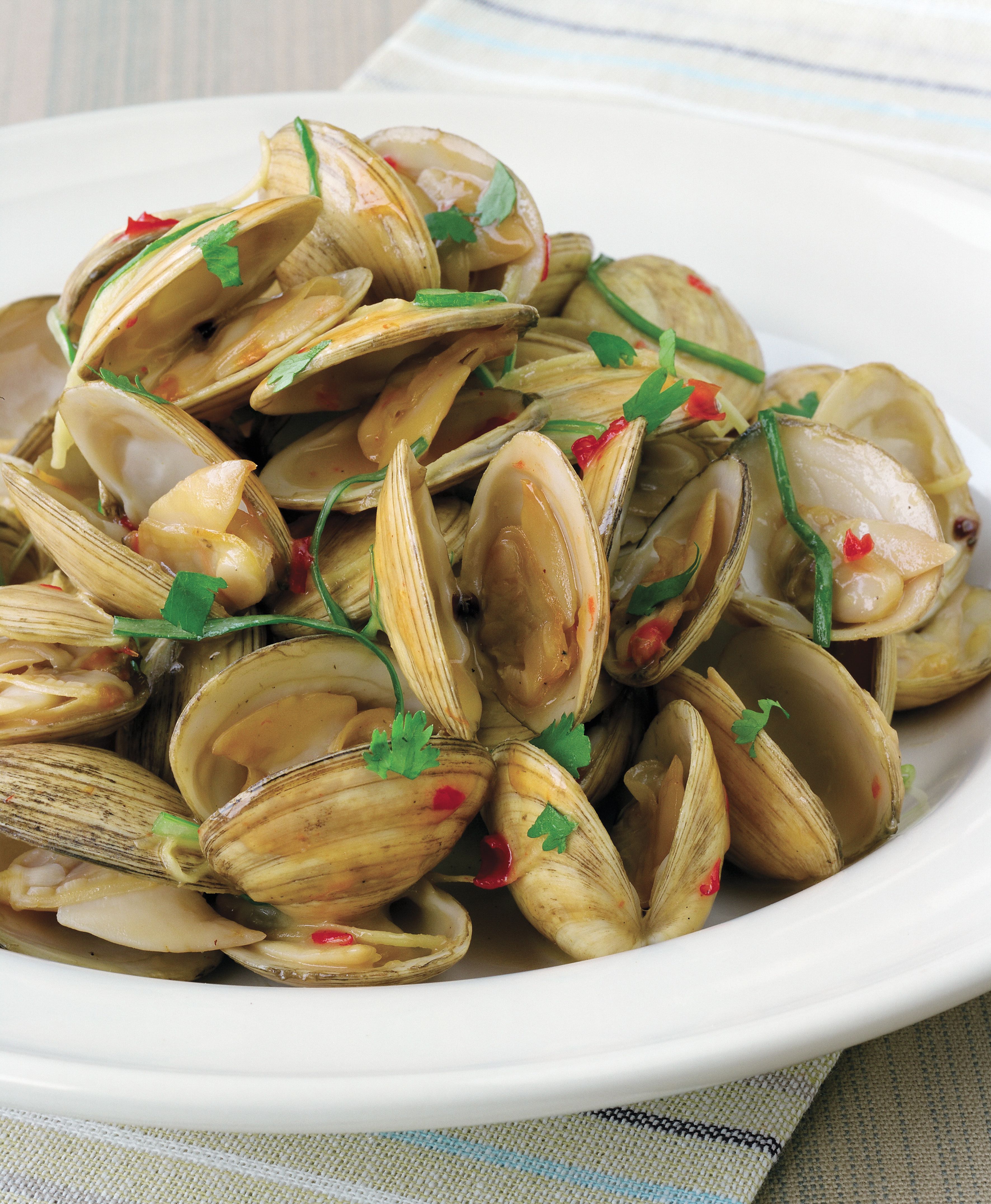 Wok-Fried Clams with Spring Onions, Chilli & Ginger Butter
Wok-Fried Clams with Spring Onions, Chilli & Ginger Butter
This recipe is from Martin Shanahan, of the famed Fishy Fishy restaurant in Kinsale, County Cork. He suggests using 'carpetshell’ clams (or 'palourdes’, as they are known in France) as they are so tender and sweet. This really does them justice and it is a very popular way of cooking clams in the restaurant. Serves 4
1 kg/2½ lb fresh clams, washed
60g/2¼ oz butter
2 tbsp sweet chilli sauce
2 tbsp shredded fresh root ginger
2 spring onions, finely chopped
2 tbsp chopped fresh coriander plus extra to garnish
Rinse the clams quickly in cold running water. Place in a pan with a tight fitting lid and steam for 2 minutes until opened; discard any that do not open.
Heat a wok or large frying pan until almost smoking. Add the butter, sweet chilli sauce, ginger, spring onions and coriander, and use a spoon to mix together quickly.
Tip the steamed clams into the wok, and toss a couple of times, so that all the sauce coats the clams. Transfer to warmed bowls, garnish with a little more coriander and serve at once.
Variation: Substitute the clams with mussels and steam initially for 2-3 minutes.
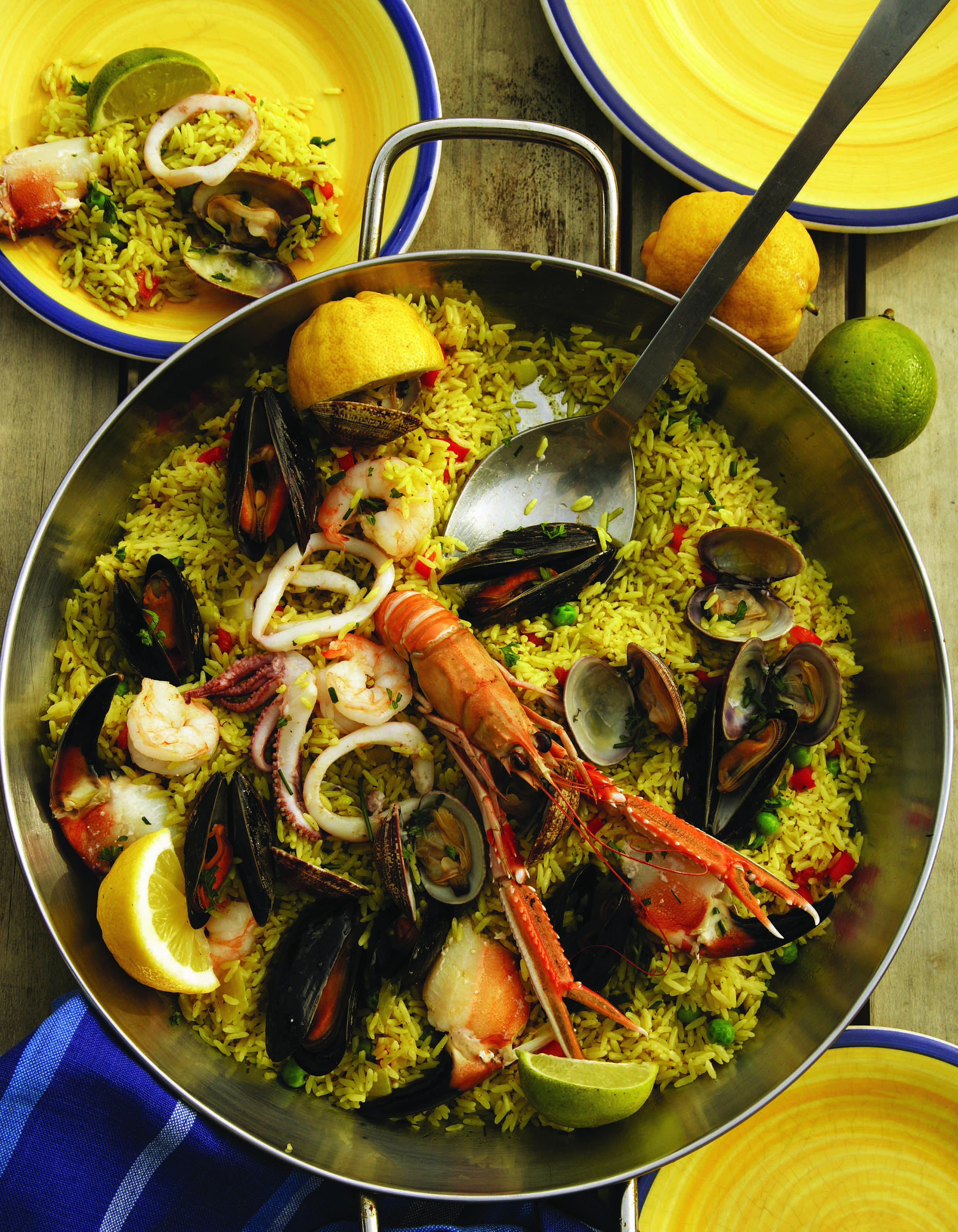 Seafood Paella
Seafood Paella
From a recipe ‘collected in Spain by Donegal medics Paul and Bella Stewart’, this is a more-ish variation on a great classic dish as given in Prannie Rhatigan’s Irish Seaweed Kitchen. “Alaria and sea spaghetti add the final layer of sea flavours to this dish”, she says. “Great for a special occasion and even more idyllic if you can cook it outdoors...” Serves 4
Seaweed Used: Sea Spaghetti, Alaria
2-4 tbsp olive oil
1-2 tbsp butter
1 medium onion, chopped finely
4-6 cloves garlic, sliced finely
450g/1lb long grain rice, white
4-5 teaspoons sea spaghetti, dried and ground
2-3 tsp turmeric, or 1 tsp crushed saffron
1 litre/1¾ pints vegetable stock
125g/4½ oz garden peas
1 red pepper, diced
Selection of Fish
2 medium squid, cut into strips
24 mussels, 6 per person, scrubbed and beards removed
24 clams, rinsed under running tap water, or a mix of shellfish and crab claws in season
To Serve:
parsley, chopped
1 tsp Alaria, dried and ground
2 organic lemons and/ or limes, quartered
Heat half the olive oil and half the butter in a large frying/ paella pan
over moderate heat, add the onion and fry gently for about 2 minutes.
Add the garlic and cook for a further 2 minutes. Remove with a slotted
spoon and set aside.
Add the rice, sea spaghetti and turmeric, if using and mix well. If using saffron add with the stock. Return the onion and garlic to the pan and add the vegetable stock. Reduce the heat and cook slowly for 10-15 minutes, adding the peas and red pepper towards the end of the cooking time.
When the rice is almost cooked, place the remaining butter and oil into a separate pan over moderate heat. When hot, add the squid and cook for 2-3 minutes. Remove with a slotted spoon and add to the rice dish.
Add the prepared mussels to the pan and cook until they open, then transfer to the rice dish.
Cook the clams and add to the cooked rice dish. Mix gently.
COOK’S TIPS:
- Arrange the quartered lemons and sprinkle with parsley and Alaria.
- Serve from the paella pan in the centre of the table and leave extra Alaria and parsley in small dishes for sprinkling.
- Dried seaweed can be prepared in several ways - in a hot or slow oven, in a dehydrator, in a pan or under a grill. For the slow method, place in a cool oven 105.F/40.C or dehydrator and leave overnight. When all moisture has been expelled and the seaweed is crisp, crush and use as required. Store excess in a sealed container.
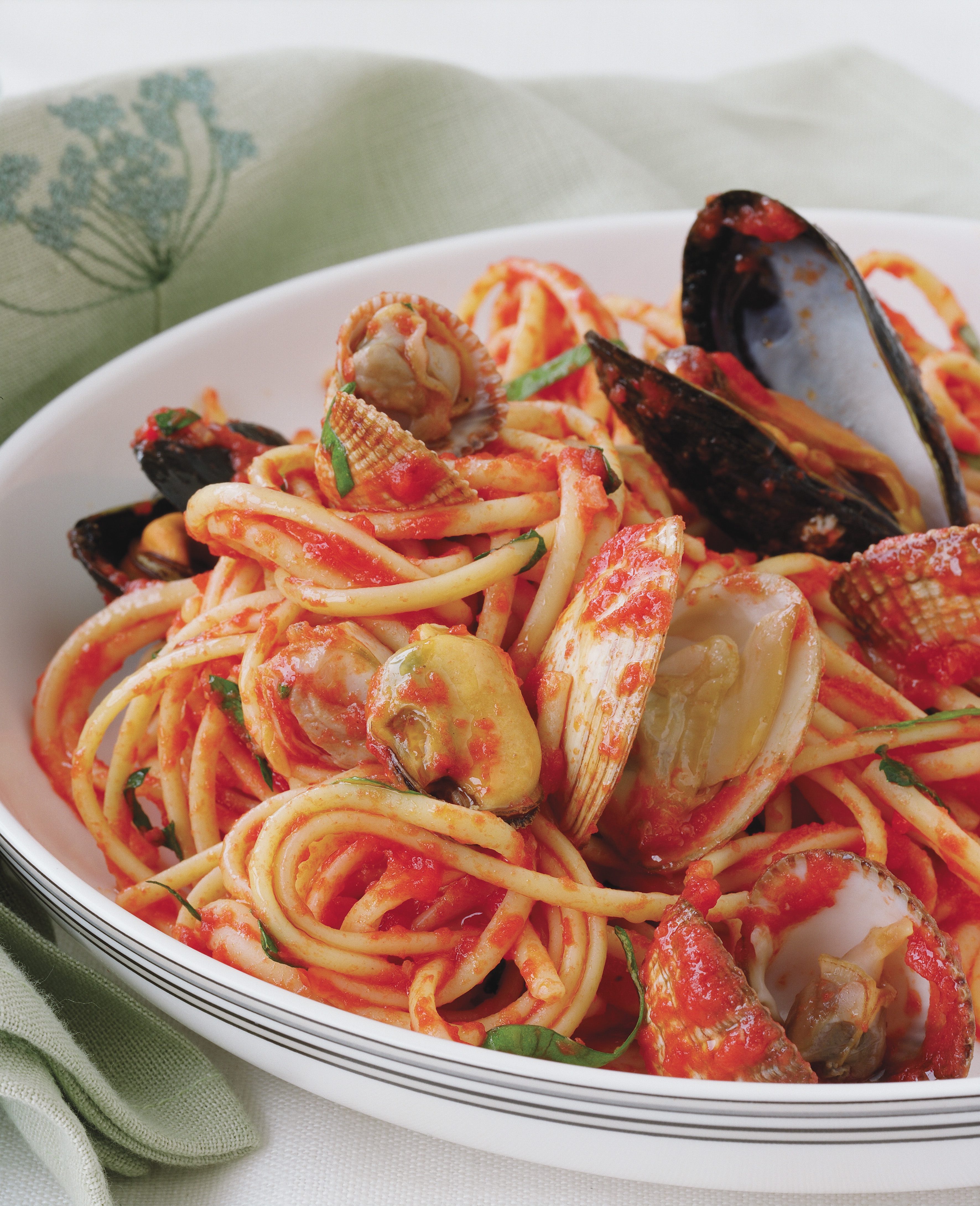 Summer Seafood Linguine Marinara
Summer Seafood Linguine Marinara
The best way to treat fresh seafood is simply and this recipe is perfect for lazy summer evenings when you just want something light. An important part of this dish is getting the pasta just right, so the slightly firm texture of the pasta contrasts with the soft shellfish. Serves 4
1.75kg/4lb mussels, clams and cockles, cleaned
4 tbsp dry white wine
350g/12oz linguine
4 tbsp olive oil
2 garlic cloves, very finely chopped
1 red chilli, seeded and finely chopped
300ml/1/2 pint passata rustica (crushed tomatoes)
2 tbsp torn fresh basil
2 tbsp chopped fresh flat-leaf parsley
salt and freshly ground black pepper
Place the mussels, clams and cockles in a pan with a lid and pour over the wine. Cover tightly and cook over a high heat for a few minutes, shaking the pan occasionally until all the shellfish have opened - discard any that do not. Strain through a sieve, reserving 150ml/¼ pint of the cooking liquor, and leaving behind any grit.
Meanwhile, twirl the linguine into a pan of boiling salted water; stir once and then cook for 10-12 minutes until al dente, or according to instructions on the packet. (Use the bite test to check; fresh pasta will take less time than dried.)
Heat the oil in a heavy-based frying pan and add the garlic and chilli, then sauté for about 20 seconds. Pour in the passata and add the reserved cooking liquor. Bring to a gentle simmer and then stir in the cooked shellfish with basil and parsley. Season to taste and allow to just warm through.
Rinse the pasta under cold running water and drain well. Return to the pan, then pour in the seafood sauce and fold together until well combined. Divide among warmed pasta bowls and serve at once.
*** Priced at €20 (p&p free in Ireland) From Tide To Table – All You Need To Know About Buying, Preparing & Cooking Seafood is currently available from good bookshops, ISBN: 978-1-903164-358 and online from https://www.ireland-guide.com/shop/product.php?item_id=13918&cat_id=836
Cookery Feature - Seed to Supper
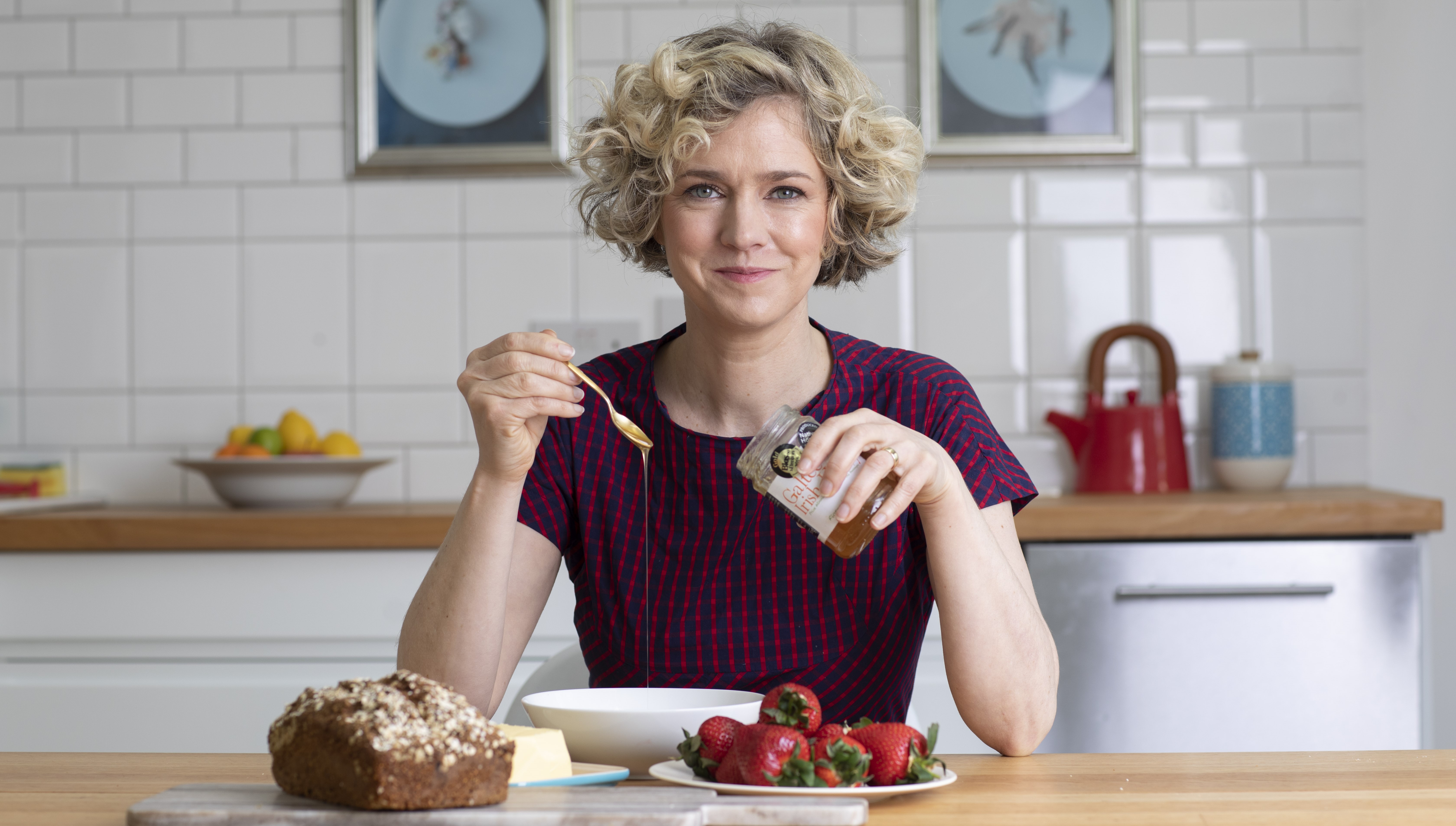
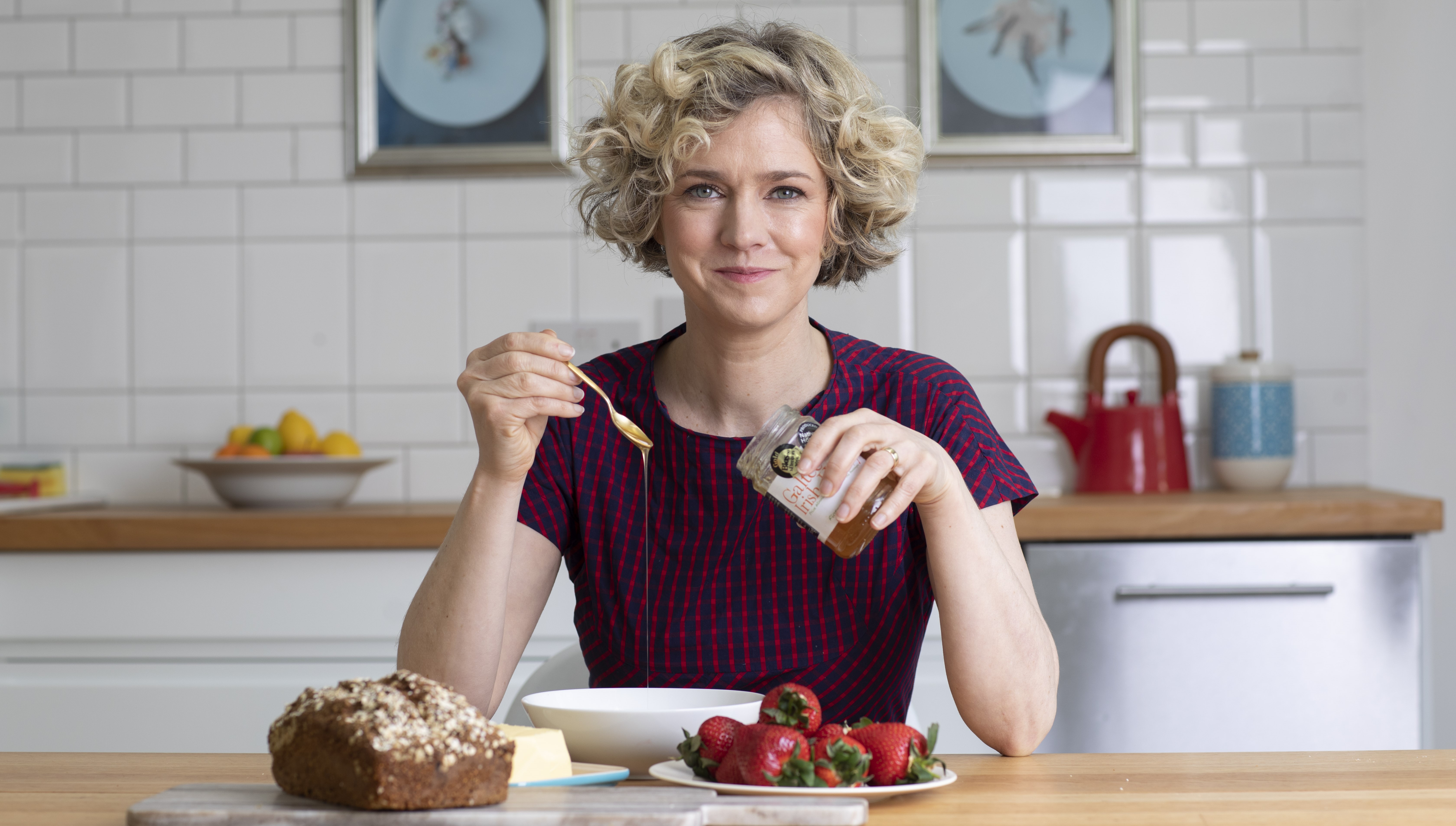
Well known from her previous Dublin food businesses, The Cake Café and Slice, and for establishing the social enterprise Our Table, supporting people living in direct provision, the wonderful Michelle Darmody also has a following as a food writer - notably for her weekly column in The Examiner – and is nothing less than inspiring in her role as a sustainable food education expert.
Appearing bang on cue at the start of the new school year, her first book Seed to Supper: The Journey of Your Food from the Ground Up is published by boutique publishing house Nine Bean Rows, and brilliantly illustrated by Ruth Graham who – as publisher Kristin Jensen said at the launch - “somehow gave the bare words a life of their own”.
%20Seed%20to%20Supper,%20The%20Journey%20Of%20Your%20Food%20From%20The%20Ground%20Up%20by%20Michelle%20Darmody%20(2).jpg) Jam-packed with bite-size information, DIY activities, interesting anecdotes and fascinating facts to help 9 to 12-year-olds learn, grow, cook and eat their way to a better planet. Michelle takes young readers through every stage of food’s journey from its start as a seed in the soil to the table via the kitchen and everything – and everywhere! – in between.
Jam-packed with bite-size information, DIY activities, interesting anecdotes and fascinating facts to help 9 to 12-year-olds learn, grow, cook and eat their way to a better planet. Michelle takes young readers through every stage of food’s journey from its start as a seed in the soil to the table via the kitchen and everything – and everywhere! – in between.
Young readers will learn how to grow, buy, and cook food while also learning how what we eat affects the world we live in and how people eat and share food at dinner tables around the globe. Featured recipes take inspiration from all cultures and help promote connectivity through food,
with favourites including a universally loved and easy Magic Tomato Sauce, a Big Pot of Chilli, Rice Paper Rolls, a vibrant Kale, Golden Raisin and Parmesan Salad, and a gorgeous Apple and Blackberry Crumble (see recipe below).
Seed to Supper is a fun and engaging read, it’s packed with DIY activities from growing a seedling and building a bug house to being a food miles detective to see how far food has travelled to get onto your plate.
Michelle describes Seed to Supper as a true labour of love, saying, “I love food. I love eating it, cooking it, learning about how it grows and seeing where it comes from. I have put this love into writing Seed to Supper. It is the culmination of five years of research for a PhD and many years of experience working in food and education. It’s full of information that will help kids in the garden, in the kitchen, or around a table. It also talks about how food connects people, no matter what part of the world they come from. I hope it will also encourage early conversations about food marketing to children, the environmental impact of food waste and what the future of food
could look like.”
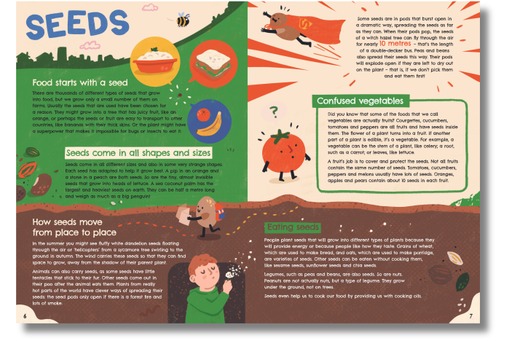 A must-have book for every family home this autumn.
A must-have book for every family home this autumn.
Seed to Supper: The Journey of Your Food from the Ground Up by Dr Michelle Darmody,is a fully illustrated 128pp hardback, RRP, €20; available from all good bookshops and many independent retailers around the country and online at https://ninebeanrowsbooks.com/
SEASONAL SAMPLE RECIPE: Apple and blackberry crumble
This delicious crumble uses blackberries that you can pick from the hedgerows at the end of the summer, but you can use another type of berry instead.
Serves 4
420g cooking apples (such as Bramley apples)
l00g fresh blackberries
1 dessertspoon maple syrup
¼ teaspoon ground cinnamon
juice of ½ orange
For the crumble topping:
55g cold butter
85g plain flour
40g brown sugar
50g porridge oats
1 Preheat your oven to 200C (80°C fan).
2 First, make the crumble topping. Cut the butter into small cubes.
3 Mix the flour and sugar together in a large bowl, then add the cubes of butter. Start to rub the butter, flour and sugar between your palms. The aim is to combine them all so the mixture looks like breadcrumbs. It will take a minute or two. You shouldn't see any big chunks of butter when you're done.
4 Stir in the porridge oats and set the bowl aside.
5 Peel the apples, cut them in half and cut the cores out of the centres. Cut the apples into large dice.
6 Use a baking dish that can go into a hot oven and that the crumble ingredients will fit into. Put half of the apples and half of the blackberries in the dish. Pour over the maple syrup and sprinkle with half of the cinnamon.
7 Add the rest of the apples and blackberries. Pour over the orange juice.
8 Sprinkle the crumble over the top so that the apples and blackberries are all covered. Press it down lightly, then sprinkle on the rest of the cinnamon.
9 Bake in the preheated oven for about 30 minutes. Push a butter knife into the centre to make sure all \the apple chunks are soft.
10 Let the crumble cool for about 15 minutes before serving. This is nice with custard, cream or ice cream.
Cookery Feature - Christmas Books for Cooks
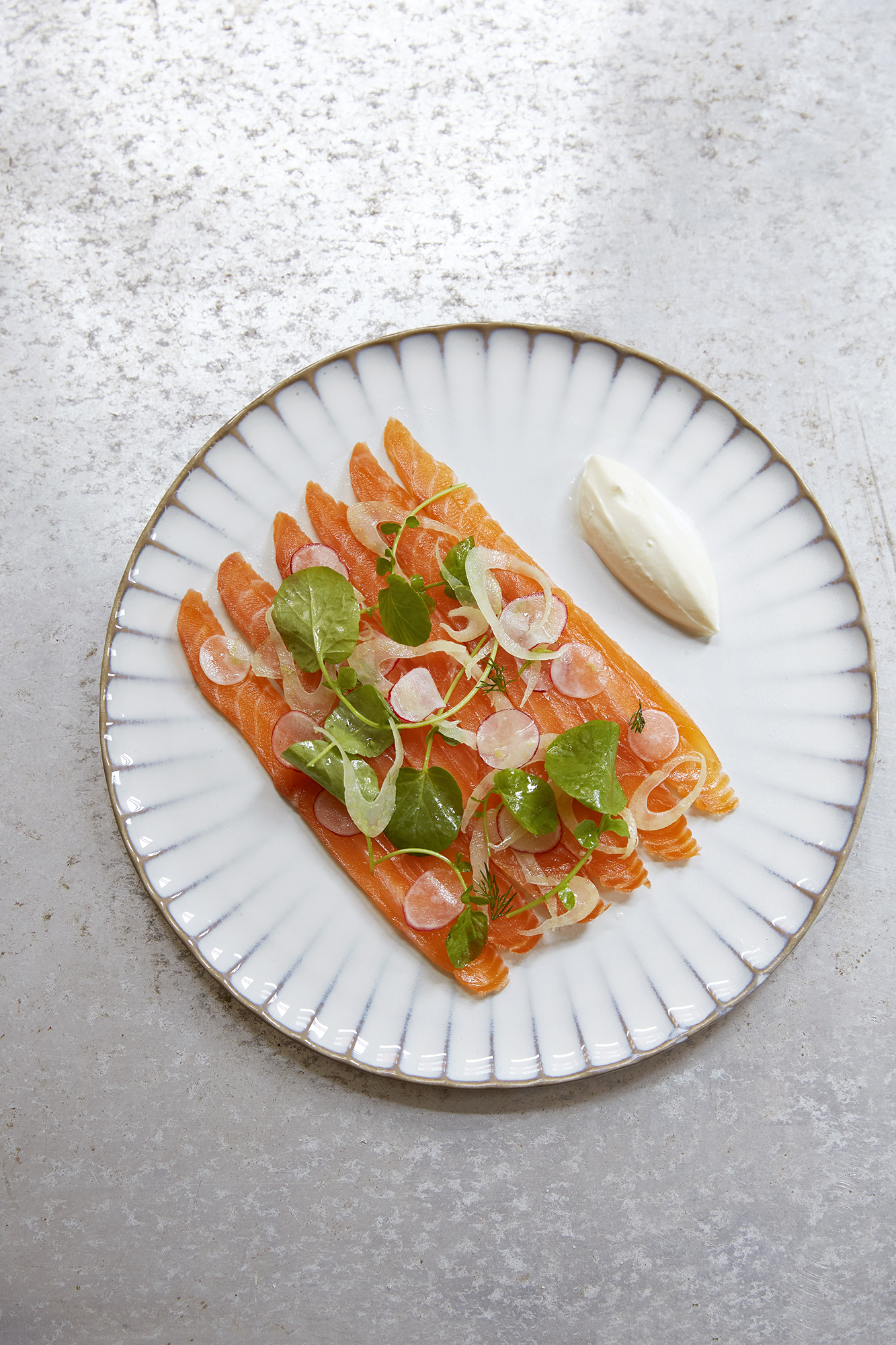
What cook or would-be-cook doesn’t love a food book for Christmas? And luckily there’s no shortage of seriously interesting Irish published books to choose from, with a bumper crop this year including everything from food culture and history, to how to ‘elevate the everyday’. Just a few to think about here for starters but, if time allows, there’s nothing to beat a good browse in your local bookshop. You’re sure to come away with more than you meant to, but that’s okay…
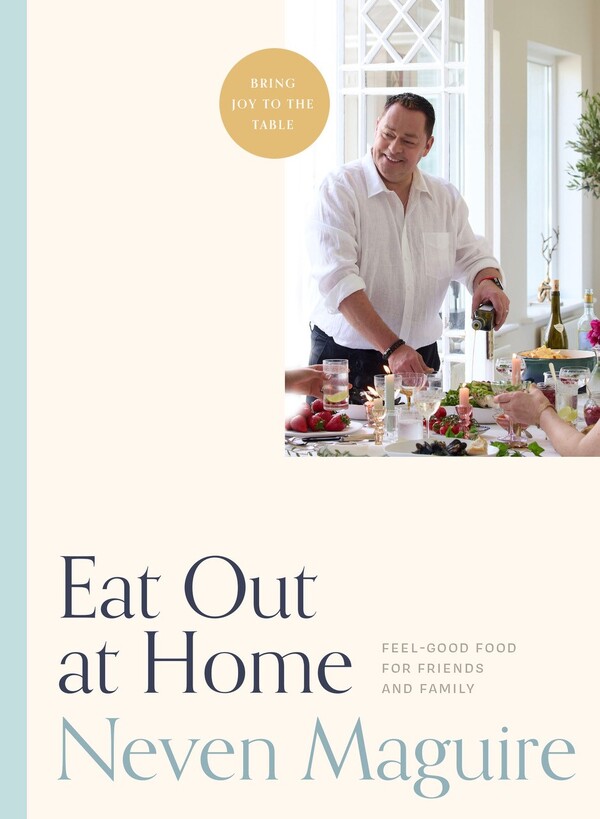 Neven Maguire must have lost count of the number of books he has to his name at this stage, but every one’s a gem and there’s no knowing how many people have him to thank for feeling confident in the kitchen. His latest, Eat Out At Home (Gill Books, hardback, €24.99), brings together some favourite dishes from his acclaimed MacNean House restaurant, along with recipes from his travels - but the central theme is relaxation and enjoyment, so there are plenty of hearty flavours plus guidelines and tips to help home cooks to entertain with ease.
Neven Maguire must have lost count of the number of books he has to his name at this stage, but every one’s a gem and there’s no knowing how many people have him to thank for feeling confident in the kitchen. His latest, Eat Out At Home (Gill Books, hardback, €24.99), brings together some favourite dishes from his acclaimed MacNean House restaurant, along with recipes from his travels - but the central theme is relaxation and enjoyment, so there are plenty of hearty flavours plus guidelines and tips to help home cooks to entertain with ease.
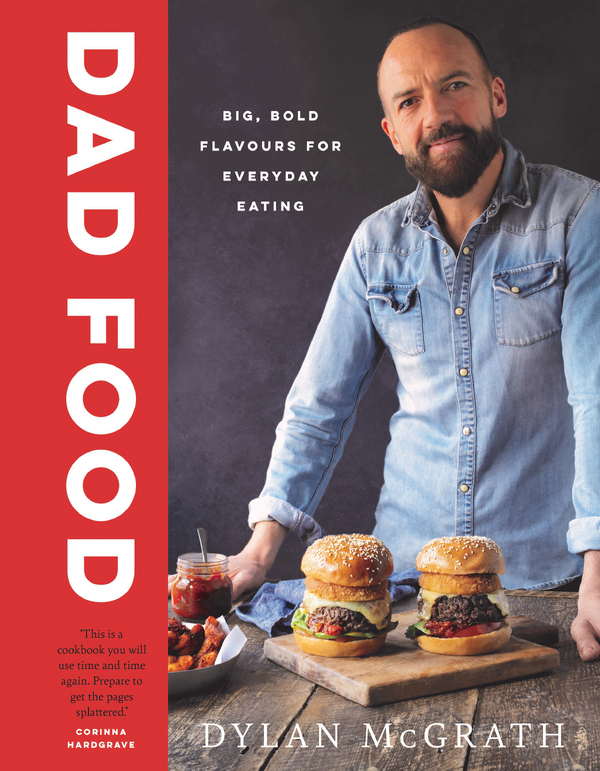 From a chef who’s behind dozens of tomes to another famous chef-restaurateur Dylan McGrath, who’s just brought out his inaugural cookbook - Dad Food (Gill Books, hardback €24.99) which also aims to banish the fear of cooking through sharing the recipes that every man should have up his sleeve. Promising ‘big bold flavours for everyday eating’ Dylan gives a masterclass in the kit and the techniques that will guarantee great results along with accessible ingredients, and foolproof recipes – including every dad’s favourite: the BBQ.
From a chef who’s behind dozens of tomes to another famous chef-restaurateur Dylan McGrath, who’s just brought out his inaugural cookbook - Dad Food (Gill Books, hardback €24.99) which also aims to banish the fear of cooking through sharing the recipes that every man should have up his sleeve. Promising ‘big bold flavours for everyday eating’ Dylan gives a masterclass in the kit and the techniques that will guarantee great results along with accessible ingredients, and foolproof recipes – including every dad’s favourite: the BBQ.
 And there’s also a much-anticipated first book from Belfast legend Niall McKenna, the celebrated chef-owner of James St and Waterman House, What’s It All About? (W&G Baird hardback, £25 + p&p) Summarised as ‘140 Recipes | 20 Years | 5 Restaurants | 1 Question’ Niall sees it as love letter to Belfast, with recipes collected from the five restaurants that he and his wife Joanne have operated over the last two decades set alongside some of their artwork and iconic Belfast landmarks (see Gin-Cured Salmon recipe below). Not surprisingly, everything centres on the producers and local suppliers that Niall has showcased so warmly in the restaurants and his famous Waterman Cookery School. His friend the chef Paul Rankin, who Niall credits as being hugely influential in his career, describes Niall as ‘a shining light, always there, always cheery, always the hardest worker’, heralding the cookbook as a ‘gift to all of us who love food and hospitality’. I couldn’t have put it better myself.
And there’s also a much-anticipated first book from Belfast legend Niall McKenna, the celebrated chef-owner of James St and Waterman House, What’s It All About? (W&G Baird hardback, £25 + p&p) Summarised as ‘140 Recipes | 20 Years | 5 Restaurants | 1 Question’ Niall sees it as love letter to Belfast, with recipes collected from the five restaurants that he and his wife Joanne have operated over the last two decades set alongside some of their artwork and iconic Belfast landmarks (see Gin-Cured Salmon recipe below). Not surprisingly, everything centres on the producers and local suppliers that Niall has showcased so warmly in the restaurants and his famous Waterman Cookery School. His friend the chef Paul Rankin, who Niall credits as being hugely influential in his career, describes Niall as ‘a shining light, always there, always cheery, always the hardest worker’, heralding the cookbook as a ‘gift to all of us who love food and hospitality’. I couldn’t have put it better myself.
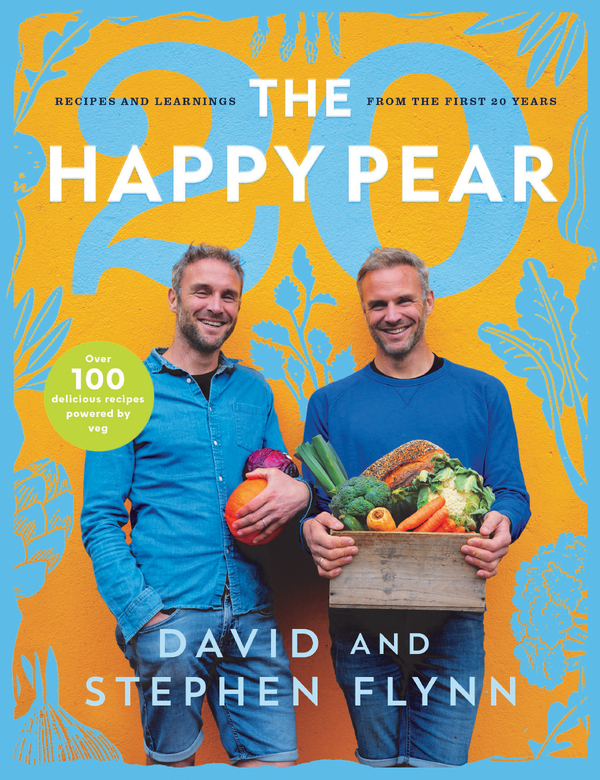 And so to David and Stephen Flynn’s celebration of 20 years ‘bringing joy through good food’ in the local community and beyond,The Happy Pear 20: Recipes From the First 20 Years (Gill Books hardback €24.99) is their latest collection of versatile and comforting plant-based recipes. Inspired by the dishes that are most requested in the café and the food that they (and their kids) eat at home, their recipes all use familiar ingredient to deliver on flavour and nutrition – encouraging us all to embrace plant power with tried and tested recipes, designed to make eating more veg as easy, and tasty, as possible.
And so to David and Stephen Flynn’s celebration of 20 years ‘bringing joy through good food’ in the local community and beyond,The Happy Pear 20: Recipes From the First 20 Years (Gill Books hardback €24.99) is their latest collection of versatile and comforting plant-based recipes. Inspired by the dishes that are most requested in the café and the food that they (and their kids) eat at home, their recipes all use familiar ingredient to deliver on flavour and nutrition – encouraging us all to embrace plant power with tried and tested recipes, designed to make eating more veg as easy, and tasty, as possible.
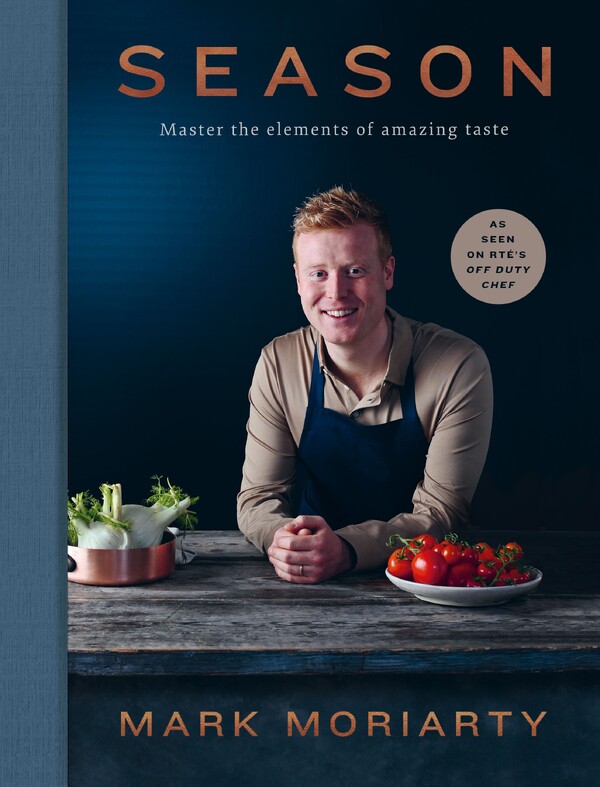 TV chef Mark Moriarty needs no introduction and his first cookbook, Flavour, was a bestseller and winner of the Cookbook of the Year at the An Post Book Awards. Now he’s back with Season (Gill Books hardback €24.99) a hundred new recipes designed to elevate everyday cooking throughout the seasons – and that includes Christmas dinner, with Mark’s brined turkey crown and honey-and-soy-glazed ham… But, subtitled ‘Master the elements of amazing taste’, Season is equally focused on passing on Mark’s chef tips on how best to use seasoning - sea salt, black pepper, butter, olive oil, lemons, tabasco, soy sauce - to get the best from every dish.
TV chef Mark Moriarty needs no introduction and his first cookbook, Flavour, was a bestseller and winner of the Cookbook of the Year at the An Post Book Awards. Now he’s back with Season (Gill Books hardback €24.99) a hundred new recipes designed to elevate everyday cooking throughout the seasons – and that includes Christmas dinner, with Mark’s brined turkey crown and honey-and-soy-glazed ham… But, subtitled ‘Master the elements of amazing taste’, Season is equally focused on passing on Mark’s chef tips on how best to use seasoning - sea salt, black pepper, butter, olive oil, lemons, tabasco, soy sauce - to get the best from every dish.
And then there are the gems from that Aladdin’s cave of cookbooks that Kristin Jensen is collecting in her rapidly expanding publishing family Nine Bean Rows and Blasta Books (the ‘little books with big voices’). New titles include The Old Spot Cookbook (a wonderful collection of recipes and more from the much-loved Dublin gastropub - see cocktails below) Graham Herterich’s Cook (a companion volume to his hugely successful Bake; see Lasagne, coleslaw & ehips recipe below) and the latest Blasta Books title SOCAFRO (see No-Churn Lemon-Lime Ice Cream recipe below). They’re available in bookshops and speciality stores, but it’s worth spending some time on the website as there’s a lot to choose from, back titles to catch up on and offers to avail of; there are discounts for multiple purchases, for example, and the new series of four Blasta Books has just been announced for 2025 – what a super Christmas present that would make, with a new book to be delivered each quarter.
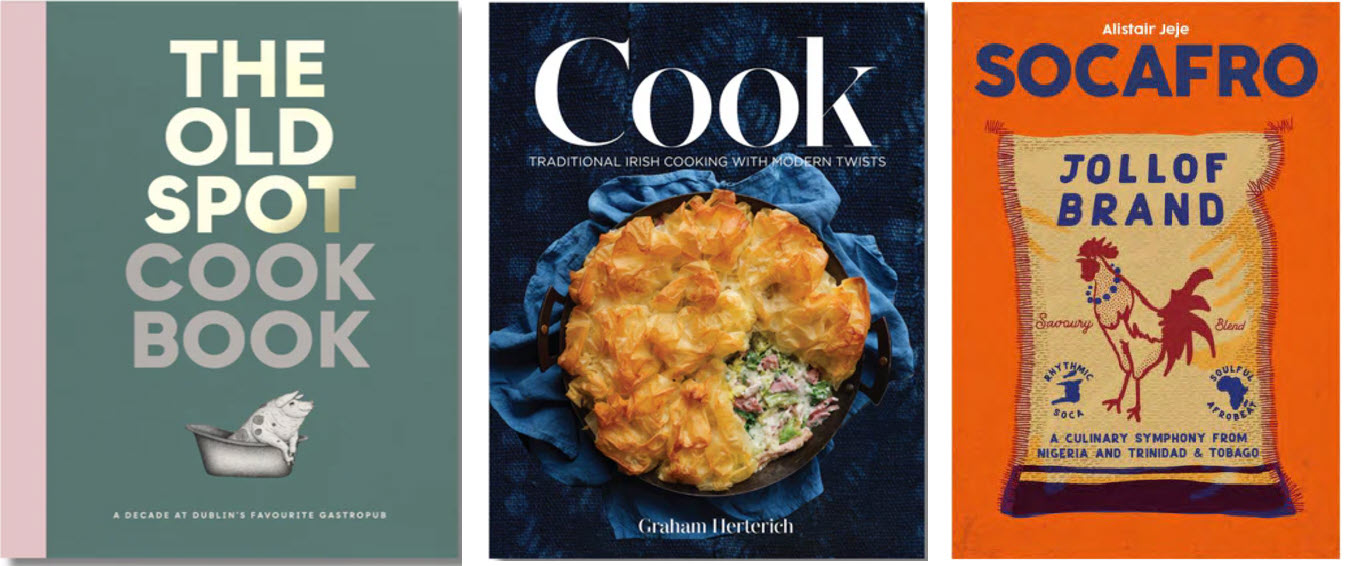
 But not all food books are designed around recipes, and some of the best are notable for being a great read. Take Máirtín Mac Con Iomaire and Dorothy Cashman’s Irish Food History: A Companion (Royal Irish Academy, hardback €45; https://www.books.ie/) for example. With a foreword from Professor James Kelly and thirty-two different expert contributors, it ‘offers you the chance to explore the rich tapestry of Ireland’s history with food in these twenty-eight urgent and compelling chapters – and brings the reader on a gastronomic odyssey from earliest times and the start of the hunter-gatherer community, all the way to the abundant world of modern Irish cooking, safe in the hands of the world’s most highly regarded food historians’. Now wouldn’t that be something to ease the most jaded of revellers through the Christmas…
But not all food books are designed around recipes, and some of the best are notable for being a great read. Take Máirtín Mac Con Iomaire and Dorothy Cashman’s Irish Food History: A Companion (Royal Irish Academy, hardback €45; https://www.books.ie/) for example. With a foreword from Professor James Kelly and thirty-two different expert contributors, it ‘offers you the chance to explore the rich tapestry of Ireland’s history with food in these twenty-eight urgent and compelling chapters – and brings the reader on a gastronomic odyssey from earliest times and the start of the hunter-gatherer community, all the way to the abundant world of modern Irish cooking, safe in the hands of the world’s most highly regarded food historians’. Now wouldn’t that be something to ease the most jaded of revellers through the Christmas…
 In a similar vein the latest book from Galway chef, restaurateur, author, playwright, educator and visionary, Jp McMahon, An Irish Food Story: 100 Foods That Made Us www.aniarrestaurant.ie and www.ninebeanrows.com aims to answer that thorny old question ‘What is Irish food?’ With his decades of practical experience and several Irish food books already under his belt – including The Irish Cookbook (2020) and An Alphabet of Aniar: Notes for a New Irish Cuisine (2023) – Jp is very well qualified to provide answers, which he does by “chronicling the evolution of our tastes and culinary desires, from the first settlers who arrived on the island 10,000 years ago, to the people who call Ireland home today…” There’s plenty of food for thought between these covers when it come to our food culture, and it will give those of us old enough to remember some of the relatively recent absurdities seen in Irish shops and on our tables plenty of chuckles along the way too.
In a similar vein the latest book from Galway chef, restaurateur, author, playwright, educator and visionary, Jp McMahon, An Irish Food Story: 100 Foods That Made Us www.aniarrestaurant.ie and www.ninebeanrows.com aims to answer that thorny old question ‘What is Irish food?’ With his decades of practical experience and several Irish food books already under his belt – including The Irish Cookbook (2020) and An Alphabet of Aniar: Notes for a New Irish Cuisine (2023) – Jp is very well qualified to provide answers, which he does by “chronicling the evolution of our tastes and culinary desires, from the first settlers who arrived on the island 10,000 years ago, to the people who call Ireland home today…” There’s plenty of food for thought between these covers when it come to our food culture, and it will give those of us old enough to remember some of the relatively recent absurdities seen in Irish shops and on our tables plenty of chuckles along the way too.
And let us not forget a couple of super books reviewed earlier in the year – Ali Dunworth’s entertaining A Compendium of Irish Pints, The Culture, Customs and Craic makes the perfect stocking filler / gift under €20, and, for children, Michelle Darmody’s Seed to Supper would be hard to beat.
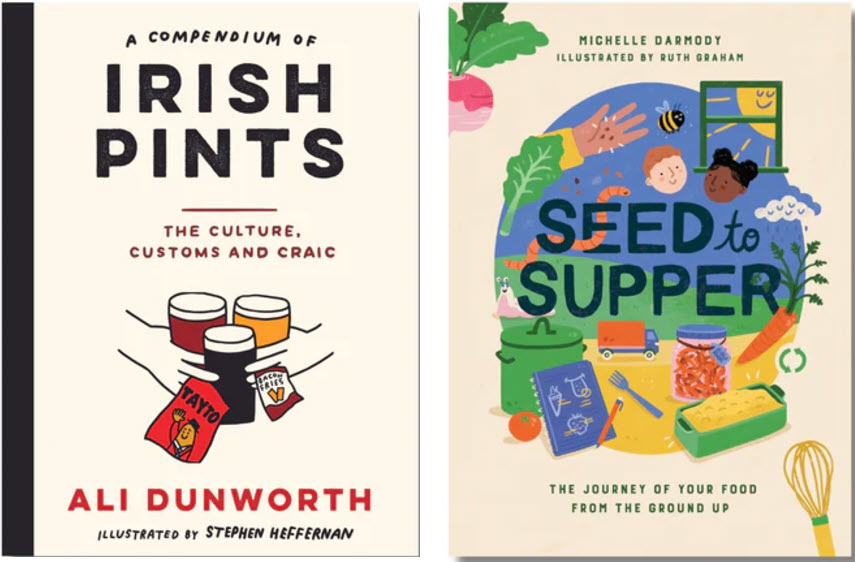
SHOPPING: your local bookshop is the best first stop (and there is nowhere better to browse) but if inconvenient, or when shopping from abroad, these are among the best major booksellers:
Gill Books https://www.gillbooks.ie/food-drink
Dubray Books https://www.dubraybooks.ie/category/food-and-drink
Stores Dublin (9), Wicklow (Bray) Cork, Waterford, Galway
Easons – online https://www.easons.com/Books & store locator map https://www.easons.com/about/stores
Hodges Figgis, Dawson St Dublin and online https://www.hodgesfiggis.ie/
SOME RECIPES TO TRY, which might come in very handy over the festive season…
 THE OLD SPOT COOKBOOK
THE OLD SPOT COOKBOOK
If you’d like to make our signature cocktail ‘The Old Spot’ at home, simply muddle some fresh blood orange into your gin of choice. If you love it (you will) and would like to make lots more of these (we do), then you could infuse your own blood orange gin (details given in book) or pick up one of the many brands that sell it. The apple and rosemary notes make this a great match with our Andarl Farm free range pork chops with cider jus (recipe in book).
Makes 1
2 slices of blood orange
25ml gin
25ml lychee liqueur
40ml apple juice
25ml lime juice
15ml rosemary sugar syrup
ice cubes, for shaking and serving
To Garnish:
crushed ice
1 sprig of fresh rosemary
1 fresh or dehydrated lime wheel
a small straw
To make the rosemary sugar syrup: dissolve 200g granulated or caster sugar 200ml in hot water and add a few sprigs of rosemary; cool, cover & refrigerate 24 hrs to infuse. If not using within 1 week, strain into a sterilised bottle.)
1 In the base of a cocktail shaker, muddle the slices of blood orange with the
gin. (If you’re using a blood orange-infused gin, then skip the muddling
step and simply add the flavoured gin in the next step.)
2 Add the lychee liqueur, apple and lime juice and sugar syrup to the shaker,
shake well over ice and strain into a tumbler over ice, then top up with
crushed ice.
3 Garnish with fresh rosemary, a wheel of lime and a small straw.
The Green Door
This is the cocktail that got The Old Spot shortlisted for the Best Cocktail Experience
at the Irish Restaurant Awards 2022. It makes a gorgeous pairing with our
bluefin tuna starter (recipe in book).
Makes 1
2 slices of cucumber
½ thumb-sized piece of fresh ginger, sliced
25ml sugar syrup (as above, without the rosemary)
40ml Method & Madness gin
25ml lemon juice
20ml Martini dry vermouth
ice cubes, for shaking
To Garnish: 1 strip of fresh cucumber, freshly ground black pepper
1 For the fresh cucumber strip, peel a full length of cucumber all the way
down, roll it into a spiral and spear with a cocktail stick to keep it in place.
2 Grind some black pepper onto a saucer and dip the rim or side of a chilled
coupe glass into the pepper to garnish (or you can simply sprinkle the
finished cocktail with black pepper before serving).
3 In the base of a cocktail shaker, muddle the slices of cucumber and ginger
with the sugar syrup.
4 Add the gin, lemon juice and vermouth, shake well over ice and strain into
a chilled coupe glass.
5 Lean the rolled cucumber inside the glass to serve.
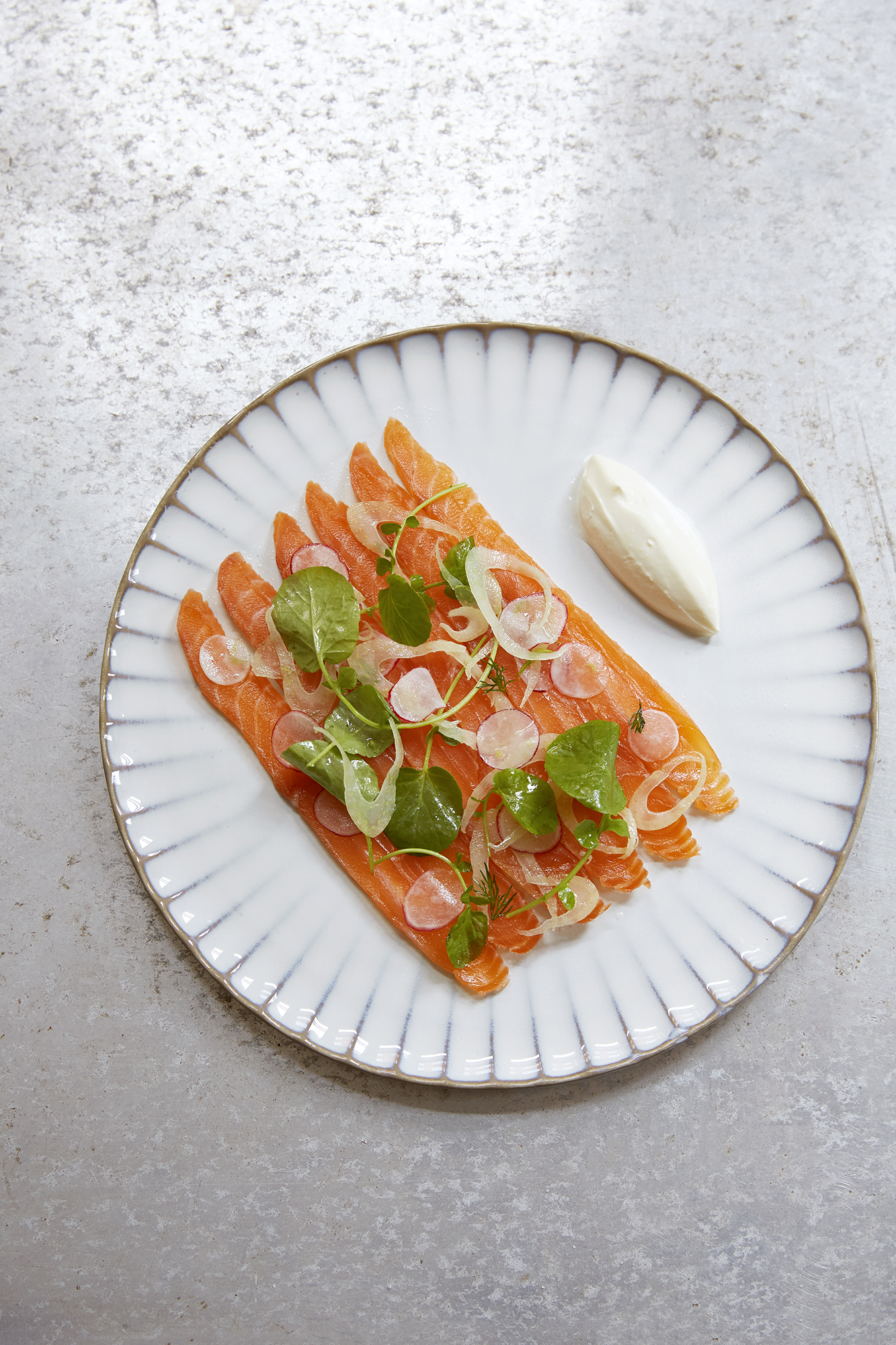 WHAT’S IT ALL ABOUT? BY NIALL MCKENNA
WHAT’S IT ALL ABOUT? BY NIALL MCKENNA
Gin-Cured Salmon
From This is served in James Street South and Waterman.
When I make this recipe, I cure a whole side of salmon; I know it seems like a lot, but it will keep in the fridge for up to 10 days. Belfast gins, Shortcross and Jawbox are my favourites, and either will work well for this curing process.
Serves 8-10
Ingredients
1 x 500g side of salmon trimmed, skinned with bloodline removed
75g sea salt
100g caster sugar
The zest of 1/2 lime
75ml gin
For the pickled vegetables
10 breakfast radishes
4 medium banana shallots
100ml pickling liquor (see below)
To serve: 100g cre?me fraiche
Method
Loosely line a deep baking tray with a large piece of cling film. The tray must be able to fit into the fridge.
Place the salmon onto the cling film, sprinkle with salt, sugar, and lime zest and drizzle with gin. Wrap the salmon tightly in the cling film to create a parcel, ensuring the gin won’t escape during curing. Place the salmon in the fridge for 24 hours and turn the parcel twice so the salmon cures evenly.
Use a Japanese mandolin to thinly slice the radishes and shallots for the pickled vegetables. Place into a container and pour over the pickling liquor. Cover with a lid and refrigerate for 2–3 hours.
To serve, unwrap the salmon, remove the cure with a brush and pat dry; slice the salmon thinly, arrange it onto plates and serve with pickled vegetables and a quenelle of creme fraiche.
*To make the pickling liquor: Bring to the boil in a pot: 250ml each white wine and water, 180g sugar, 2 each of bay leaves, star anise and peeled garlic cloves, 1 tsp table salt, 1 small red chilli (de-seeded & finely sliced), 4 black peppercorns and 1 whole clove. Boil 2-3 minutes until sugar dissolves. Cool. Pour into a sterile jar & store in the fridge.
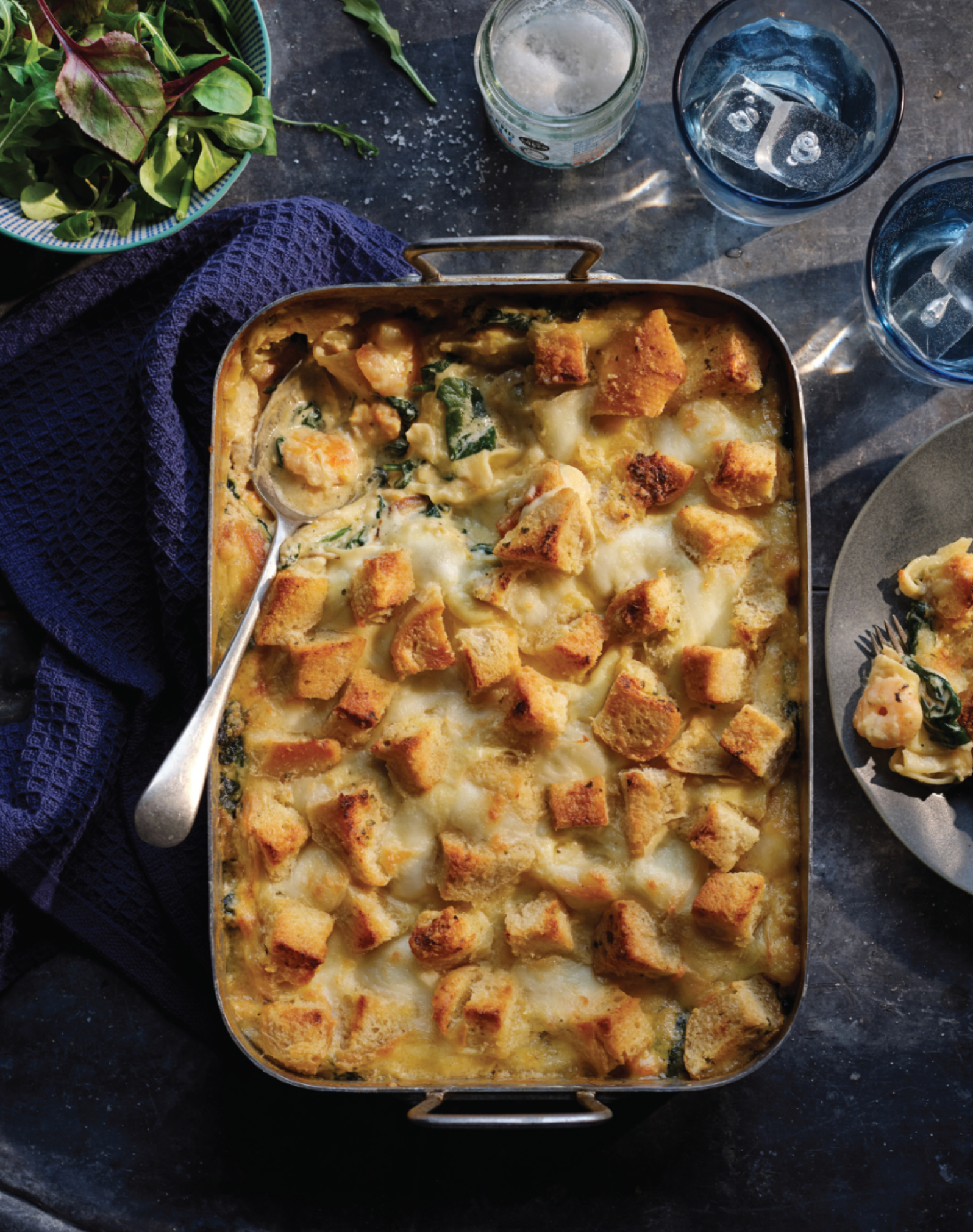 COOK BY GRAHAM HERTERICH
COOK BY GRAHAM HERTERICH
Lasagne, coleslaw & chips
In the inaugural issue of Scoop magazine, my friend Marcus O'Laoire described lasagne, coleslaw and chips as an Irish holy trinity of food and I completely agree. I really don't think we could have made this Italian classic any more Irish than by turning it into a double carb hit with a side of cabbage. I have made so many lasagnes over the years - first when helping Mum when she had her catering business and then in my work as a chef - then truth be told, I went off it for a long time. But my love for this combination is well and truly back.
Serves 4
20cm square baking dish
6-9 dried lasagna sheets
75g grated cheese (eg Cheddar & mozzarella)
For the beef ragu:
2 tbsp vegetable oil
1 medium onion, finely diced
125g bacon lardons
4 garlic cloves, finely chopped
500g beef mince
2 carrots, finely diced
2 celery sticks, finely diced
glass of red wine (optional)
tbsp tomato puree
1 x 400g tin of chopped tomatoes
2 bay leaves
1 tsp dried oregano
salt and freshly ground black pepper
To make the beef ragu, heat the oil in a large frying pan over a medium heat. Add the onion and cook for 8 minutes, stirring occasionally, until softened, then add the bacon lardons and cook for another 5 minutes. Add the garlic and cook for 2 minutes more.
Turn up the heat and add the beef mince. Break it up with a spoon but don't overmix or break it up too much - try to keep some texture. Allow it to get some colour before stirring it to brown all over. This will take 8-10 minutes.
Add the carrots and celery and cook for 2 minutes, then pour in the red wine (if using) and let it evaporate completely. Add the tomato puree and cook for another 2 minutes.
Stir in the tin of chopped tomatoes, then half-fill the tin with water, swirl it around to catch all the remaining tomato stuck to the sides and add it to the pan. Add the bay leaves and oregano and season with salt and pepper. Bring to a boil, then reduce the heat and simmer gently for 45 minutes, adding a dash of water if it starts to look too dry.
While the ragu simmers, make a cheese sauce: Melt 75g butter in a heavy-based pan, cook 75g flour in it for 1 minute, stirring. Whisk in about 250ml milk, cook for 2 minutes and add 500ml milk (total 750ml). Stirring occasionally, simmer 5-8 minutes until nicely thickened. Stir in 150g grated cheese and 1½ tsp mustard for the last 2 minutes. Remove from the heat.
Preheat the oven to 180°C fan.
Grease a 20cm square baking dish and spread one quarter of the cheese sauce over the base, top with 2-3 lasagne sheets and then half of the beef ragu, followed by one quarter of the cheese sauce and another layer of pasta sheets. Layer again with the remaining beef ragu, another quarter of the cheese sauce and the rest of the pasta sheets lasagna sheets. Finally, top with the rest of the cheese sauce and scatter the grated cheese on top,
Cook in the preheated oven for 40-45 minutes, or until golden brown and cooked through. Leave to stand for about 10 minutes before cutting into slices and serving with chips and coleslaw.
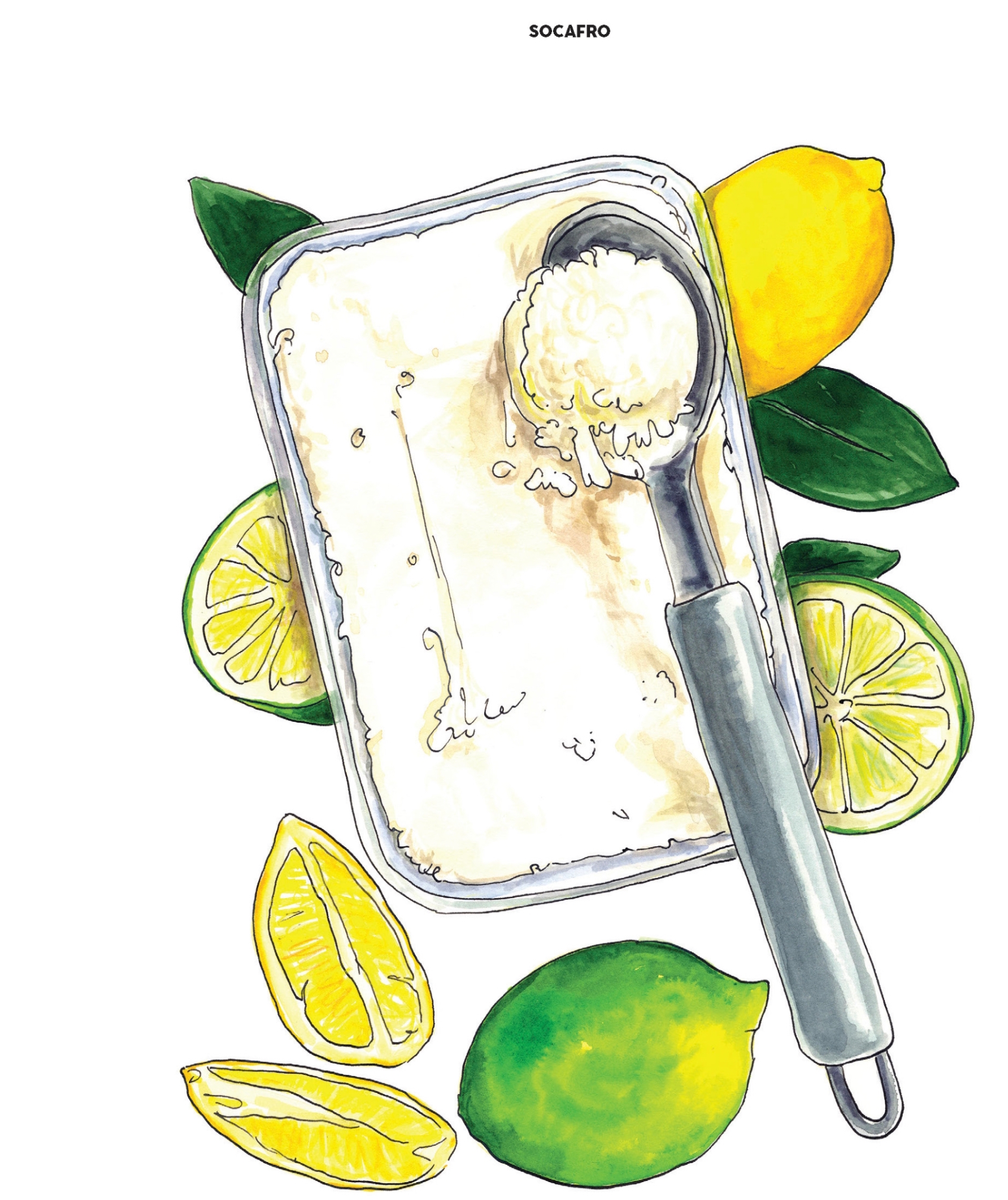 SOCAFRO NO-CHURN LEMON-LIME ICE CREAM
SOCAFRO NO-CHURN LEMON-LIME ICE CREAM
All these ingredients - lemons, limes, condensed milk, Angostura bitters - are things we use in a lot of our drinks in the Caribbean, so I wanted to see how they worked together in an ice cream. And let me tell you, they work great! It's sweet, it's sharp, it's sour - very refreshing and perfect for summer. You don't even need an ice cream maker for this and it still turns out smooth and creamy because of the condensed milk. It's a no-churn no-brainer.
Makes 1 litre
2 lemons quartered
2 limes quartered
500ml water
2 x 400g tins of condensed milk
500ml double cream
3 dashes of Angostura bitters
1 tsp ground nutmeg
a handful of ice
Put the lemons, limes and water into a high-speed food processor and blitz them, skins and all, until smooth. Pour into a jug through a fine mesh sieve to strain out the solids.
Put the strained lemon-lime mixture back in the blender food processor with the rest of the ingredients and blend again until creamy and smooth.
Pour into a 1-litre airtight freezer-proof container and cover.
Freeze overnight- it will be softly frozen, not rock hard.
Cookery Feature - Out with the Old - Store Cupboard Recipes to Relish
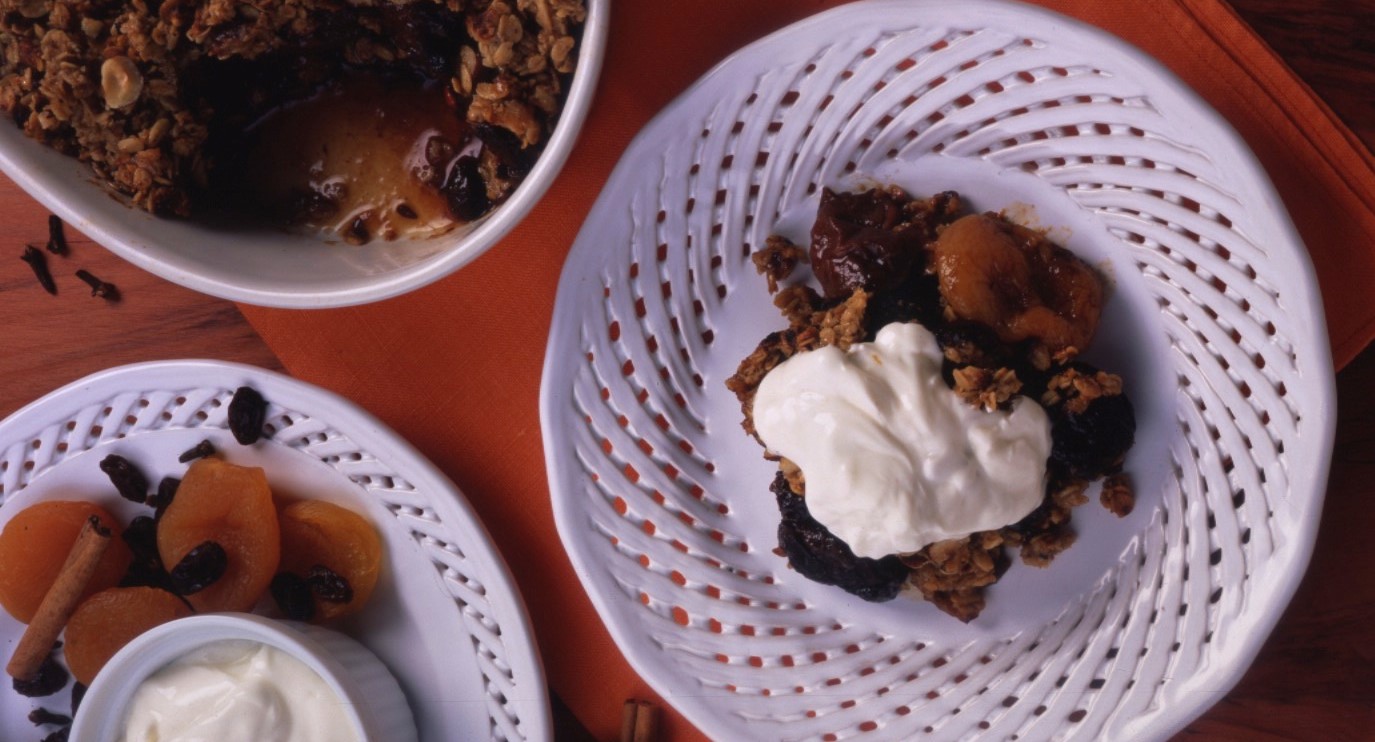
There’s something very cathartic about the post-Christmas/New Year period. Once the decorations have been cleared away and the house cleaned up, it’s time to go through the food – check all those bits and pieces in the fridge and freezer, clear out the cupboards and think of new ways to use everything up. There’s always plenty more to do, but my storage is all a lot less cluttered now and – like the seasonal changeover in the wardrobe – it not only makes you feel better but also reminds you of the useful things that you don’t use enough. It’s satisfying to know that nothing’s going to waste and to happen on tasty new combinations of ingredients outside the familiar repertoire. Some will be one-offs while others may become new favourites and dried basics like grains and pulses, in particular, can keep things ticking over nicely for a long time if you can’t get to the shops, as in a prolonged cold spell. The recipes below are favourites based on simple foods we all have to hand – pearl barley, oats, pasta – all are cheap, nutritious and easy to cook, and there are so many more like them.
If you’re looking for ideas, keep an eye open for a useful cookbook that’s coming out soon. The latest in the Blasta Books (https://blastabooks.com/) series, Larder, is by Orla McAndrew, a busy working mum of three who understands better than most that time is a precious commodity. Her secret weapon is not convenience foods or the local takeaway but a well-stocked larder and, as well as giving loads of tips on zero waste organisation, she shares 100 quick and easy recipes.
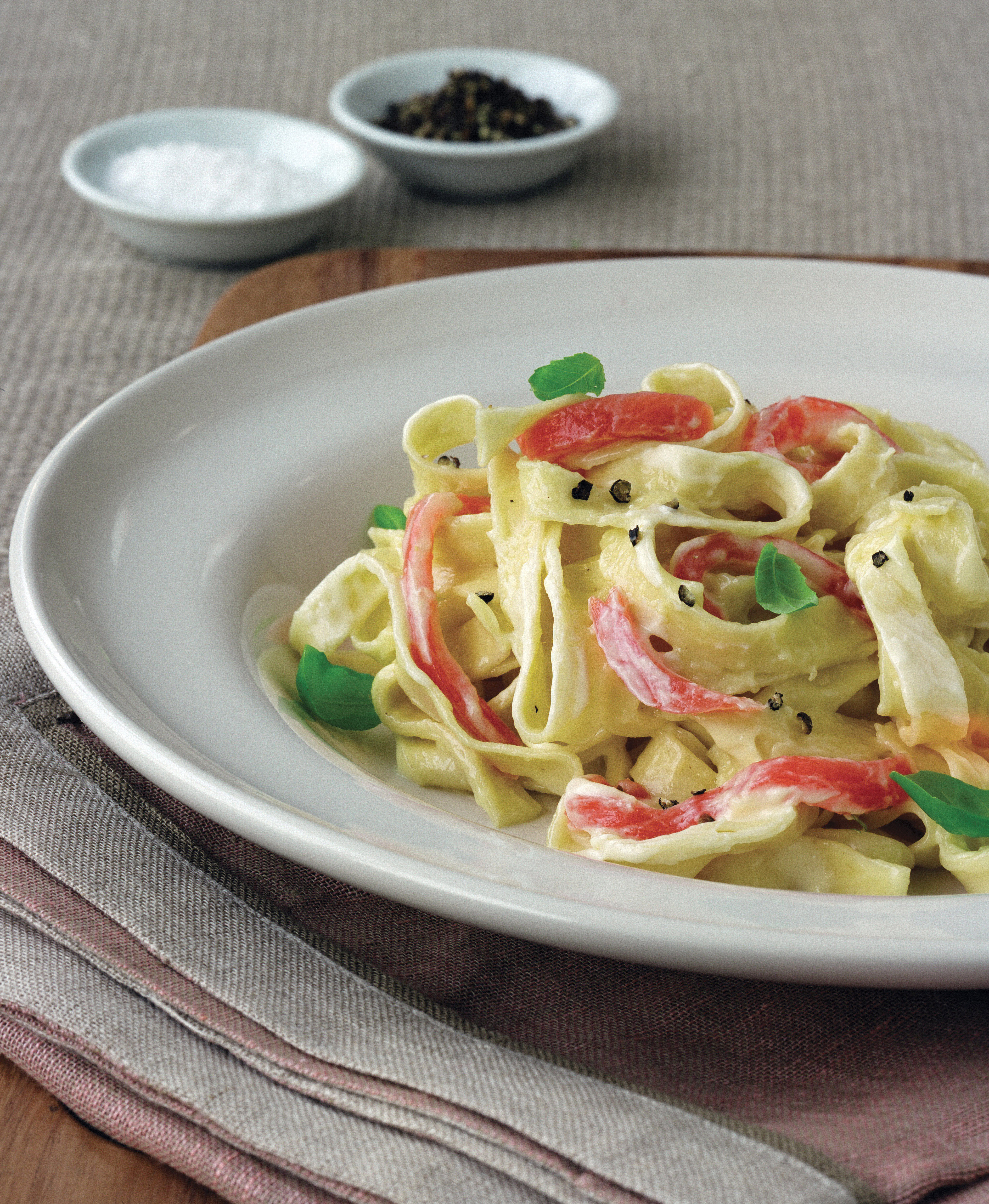 Smoked Salmon Tagliatelle with Parmesan Cream
Smoked Salmon Tagliatelle with Parmesan Cream
This is a brilliant dish at any time - so quick and easy, and very versatile. It was perfect for using up the smoked salmon trimmings at Christmas (we were lucky enough to receive a gift of a lovely big side of Sheen Falls salmon from Kenmare, which was great for sharing) but other smoked fish could be used as well. The pasta can be varied too of course (penne is very handy), also the cream (crème fraiche or sour cream maybe), the cheese (try grating any other hard cheese that you have to hand) and the herb (even fresh parsley will do). It’s one of the stylishly straightforward dishes in my book From Tide To Table, Everything You Ever Wanted To Know About Fish & Seafood (https://www.ireland-guide.com/shop) and is go-to favourite for busy days. There may be a general rule that you should never add Parmesan to a fish-based pasta dish, but this super-quick recipe is an exception to the rule.
Serves 4-6
Ingredients
350g/12oz tagliatelle
225g/8oz sliced smoked salmon
4 tbsp torn fresh basil plus extra to garnish
300ml/1/2 pint double cream
6 tbsp freshly grated Parmesan
sea salt and freshly ground black pepper
Method
Cook the tagliatelle in a big pan of boiling salted water - the bigger the pan the less chance of sticking - giving it a stir occasionally. This can take between 8-13 minutes from boiling - check with the packet instructions, they all vary.
Cut the smoked salmon into strips and mix with the basil. Pour the cream into a pan and bring to the boil, then boil for 1 minute until thickening; stir in 4 tablespoons of the Parmesan and season with pepper.
Drain the pasta and toss with the Parmesan cream, finally fold in the smoked salmon and basil mixture until nicely combined. Divide among warmed wide rimmed bowls and garnish with the basil to serve.
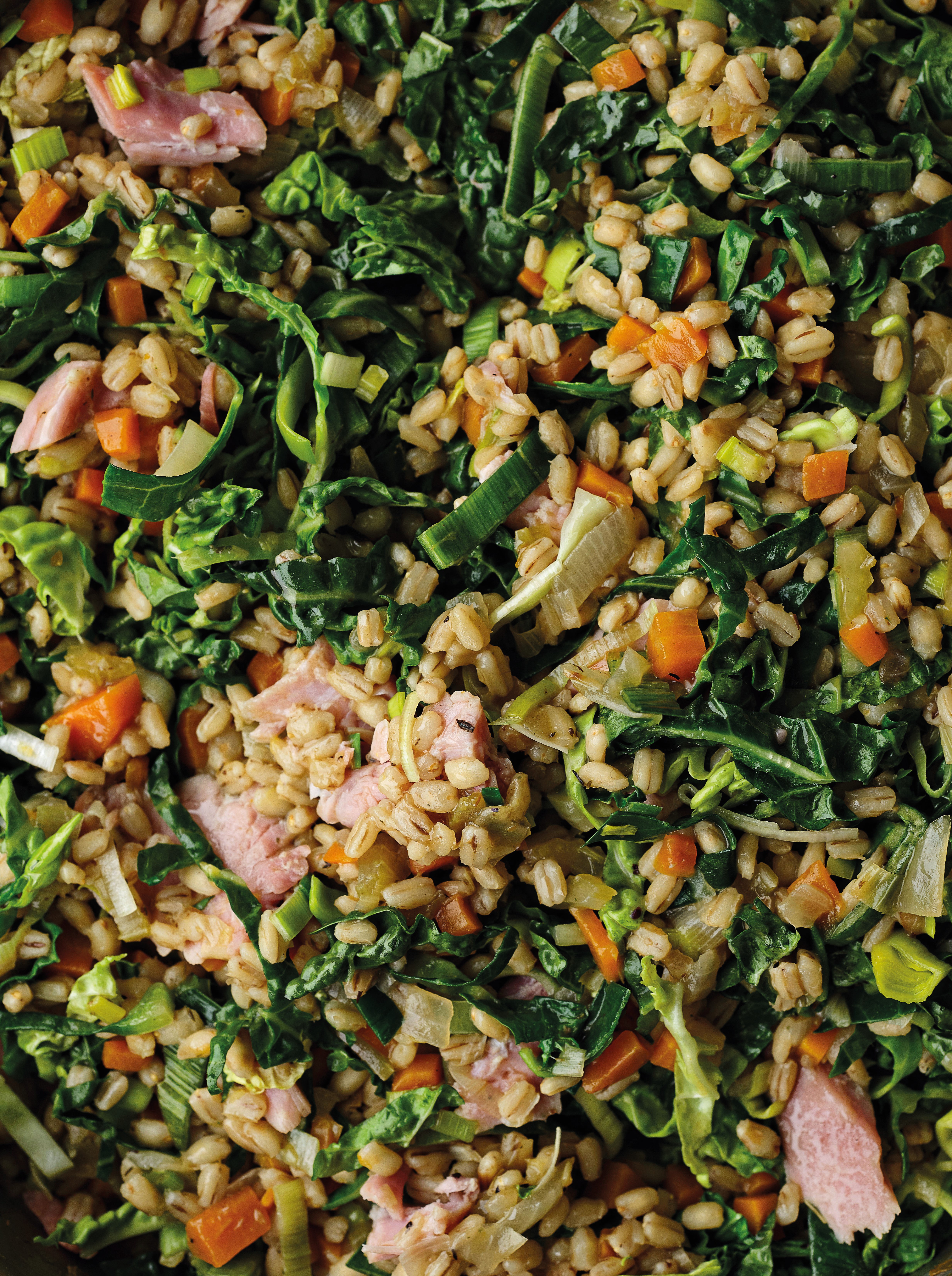 Pearl Barley Risotto with Bacon and Cabbage
Pearl Barley Risotto with Bacon and Cabbage
A handy dish from Neven Maguire’s Midweek Meals this ‘risotto; uses pearl barley instead of rice and has an interesting nutty texture. It’s much cheaper than traditional risotto rice and is not only produced in Ireland (always a plus) but has the bonus of being extremely good for you too. It’s great for using up leftovers from a ham or bacon join, but you could also use a couple of packets of ham chunks. Although it takes about an hour to cook, it’s quick and easy to prepare and the vegetables (which can be varied) are gorgeous.
Serves 4–6
Ingredients
1 tbsp rapeseed oil
15g (½oz) butter
1 onion, diced
4 large carrots, diced
2 leeks, trimmed and sliced
2 celery sticks, diced
2 garlic cloves, finely chopped
1 tsp dried thyme
400g (14oz) pearl barley
1.5 litres (2½ pints) hot chicken stock (from a cube is fine)
1 heaped tbsp Dijon mustard, plus extra to serve
1 Savoy cabbage, cored and shredded
200g (7oz) cooked lean bacon joint or ham, chopped into small pieces
sea salt and freshly ground black pepper
Method
Heat a large pan over a medium heat. Add the oil and butter, then add the onion, carrots, leeks and celery and sauté for 6–8 minutes, until softened. Stir in the garlic and thyme and cook for another 2–3 minutes, until fragrant.
Stir in the pearl barely and cook for 1 minute, until well combined. Pour in the hot stock, add the mustard and season to taste with a little salt and plenty of pepper. Bring to a simmer, then reduce the heat to low and cook for 35 minutes, stirring occasionally.
Add the cabbage and the bacon or ham and cook for another 5 minutes, until the cabbage is wilted and tender and the bacon is nicely warmed through.
Divide between plates and serve with a dollop of mustard on the side if liked.
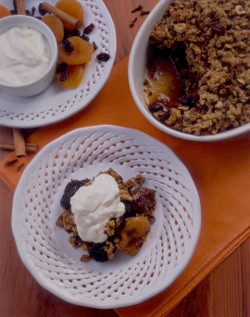 Dried Fruit, Oat & Hazelnut Crumble
Dried Fruit, Oat & Hazelnut Crumble
Checking on dried fruit and nuts in store cupboards regularly can be easy to forget but it’s important to keep them in rotation and avoid waste – and this is an ideal time of year to use them up in hot puddings. Dried fruit and nuts are complementary ingredients that make a naturally nutritious partnership with oatmeal. All are favourites in my kitchen and especially the oats, which are in daily use for overnight porridge – the day hasn’t started around here until we’ve had our bowl of Flahavan’s And this hot pudding is another favourite - it’s as delicious as it is wholesome, and versatile too. The recipe goes back to the 1990s, when the Health Promotion Unit at the Department of Health and Children asked members of the Irish Food Writers’ Guild to contribute a recipe to their Healthy Food magazine, which was a great combination of healthy eating and exercise guidelines, news and favourite dishes. Time to bring it back, perhaps. Serves 4-6
Ingredients
9oz/250g mixed dried fruit salad, if available, or other dried fruit, eg apricots, figs, prunes, apples etc
2oz/50g honey or sugar, or to taste
Natural apple juice or water, as required
1 inch/5cm piece cinnamon stick
Grated rind and juice of 1 small lemon
Crumble Topping:
7oz/200g oatflakes
Pinch of salt
3oz/75g butter, melted
3oz/75g Demerara sugar
1 level tsp. mixed spice (optional)
2oz/50g hazelnuts
A few tbsp. water
Method
The day before cooking, put the fruit into a pan with the cinnamon stick, sugar and enough apple juice or water to cover. Bring to the boil, then remove from the heat, add the finely grated lemon rind and the juice, cover and leave to soak overnight. (If you don’t have time for overnight soaking, use this microwave short-cut: in a Pyrex jug bring all to the to boil on High, then reduce to Low and microwave for 15-20 minutes or until fruit is plump and juicy).
Preheat a fairly hot oven 200°C/400°F/Gas Mark 6.
Butter a shallow baking dish.
To make the topping, put all except the last two ingredients into a mixing bowl and mix well. Mix a little water into the crumble mixture, so that it clings together slightly, then mix in the roughly chopped nuts.
Remove the cinnamon stick from the fruit, check prunes, etc., for stones, then arrange dried fruit on the base of the dish, with the juices.
Large pieces, e.g. half pears or peaches, may be cut to bite size if you like.
Scatter the topping over the fruit and bake in the pre-heated oven for 30-40 minutes, or until well-browned and crunchy on top.
Serve hot with chilled natural yogurt, whipped cream or ice cream.
NOTE: A mixture of oatmeal and wholemeal flour (or all wholemeal flour) may also be used. If using pre-soaked ‘ready to eat' dried fruit, less water is absorbed, judge liquids by appearance - the fruit base should be nice and juicy.
Cookery Feature - King of Fish & The Black Stuff - Inspired by Tradition
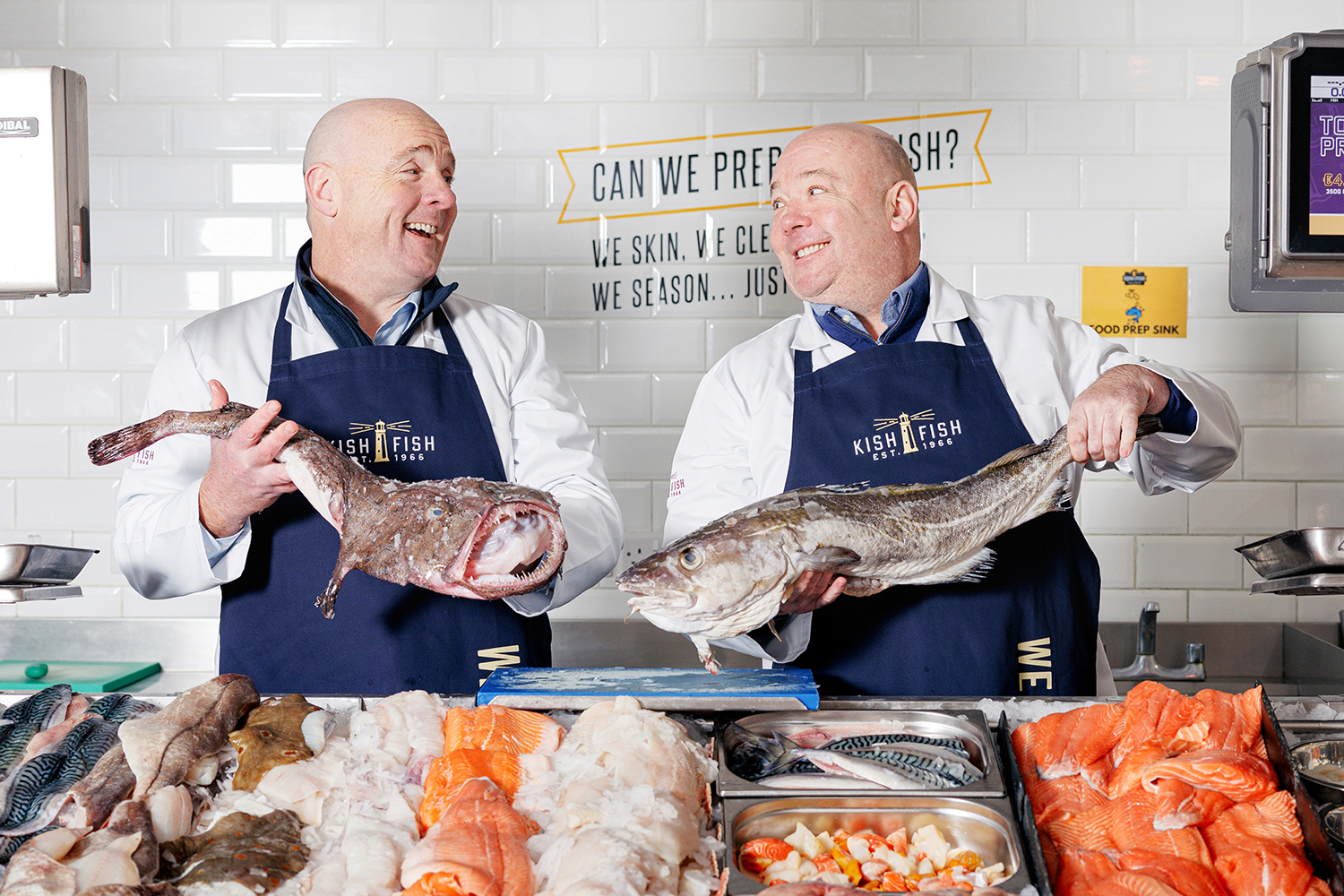
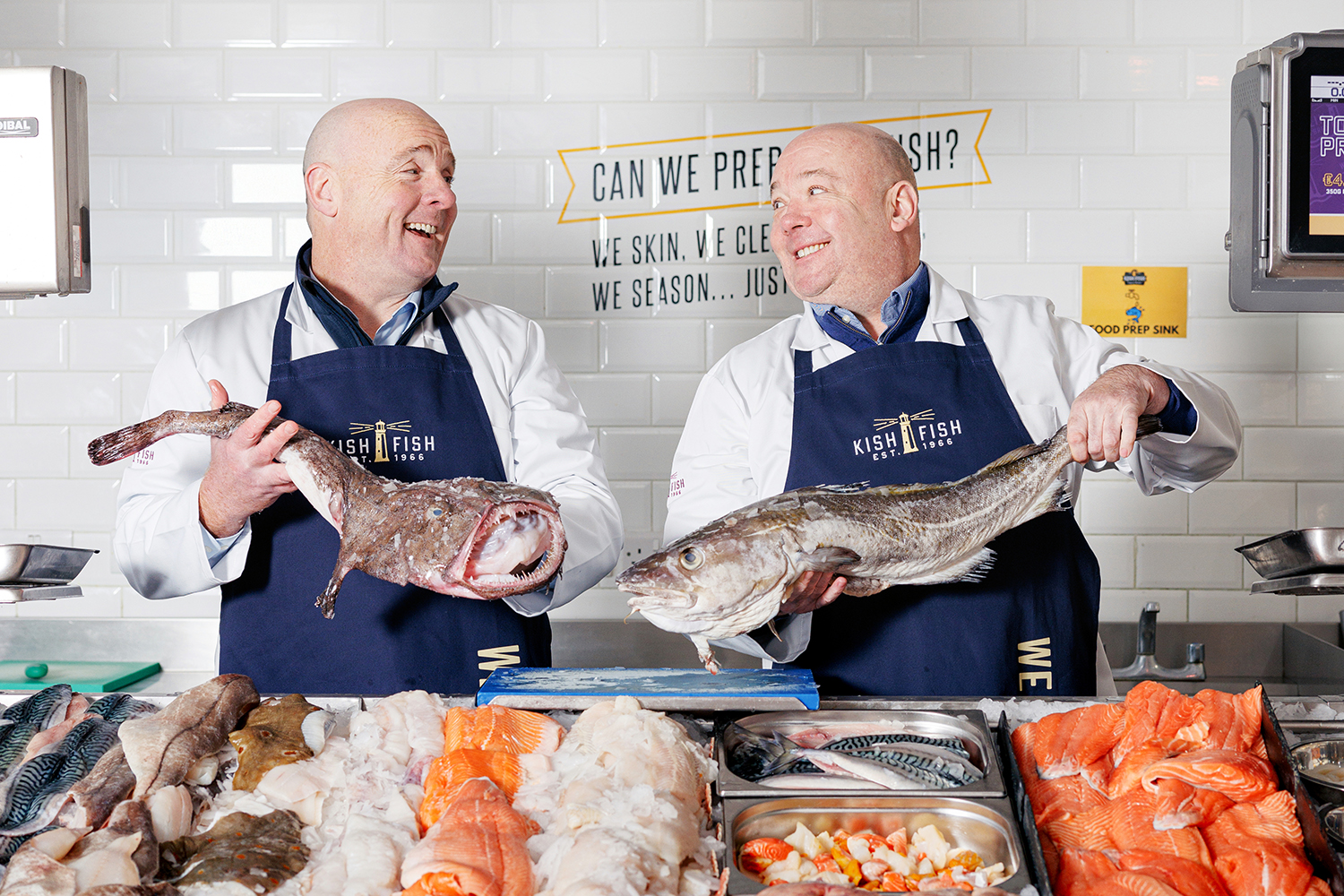 A very interesting (and enjoyable) event took place recently at Kish Fish on the West Pier in Howth. Named after a nearby lighthouse, the business dates back 1966 when Tadgh O’Meara - father of the current owners, Tadgh & Damian - had a stand at the old Dublin Fish Market. Nearly six decades on it’s a thriving business employing 150, and – in addition to their core wholesale trade - they have four fish shops (Howth, Coolock, Bow Street, and Avoca Dunboyne), a Production Kitchen (ready-to-cook meals and sauces), a Smokehouse, their Kish Café. in Howth, and the Baily Bites food truck… The reason for the event (which included a smokehouse tour and sustainability details) was to launch a light rebrand and a unique and seriously delicious new product, Guinness™ Smoked Salmon By Kish Fish, which has been in development for two and a half years and is proving to be well worth the wait.
A very interesting (and enjoyable) event took place recently at Kish Fish on the West Pier in Howth. Named after a nearby lighthouse, the business dates back 1966 when Tadgh O’Meara - father of the current owners, Tadgh & Damian - had a stand at the old Dublin Fish Market. Nearly six decades on it’s a thriving business employing 150, and – in addition to their core wholesale trade - they have four fish shops (Howth, Coolock, Bow Street, and Avoca Dunboyne), a Production Kitchen (ready-to-cook meals and sauces), a Smokehouse, their Kish Café. in Howth, and the Baily Bites food truck… The reason for the event (which included a smokehouse tour and sustainability details) was to launch a light rebrand and a unique and seriously delicious new product, Guinness™ Smoked Salmon By Kish Fish, which has been in development for two and a half years and is proving to be well worth the wait.
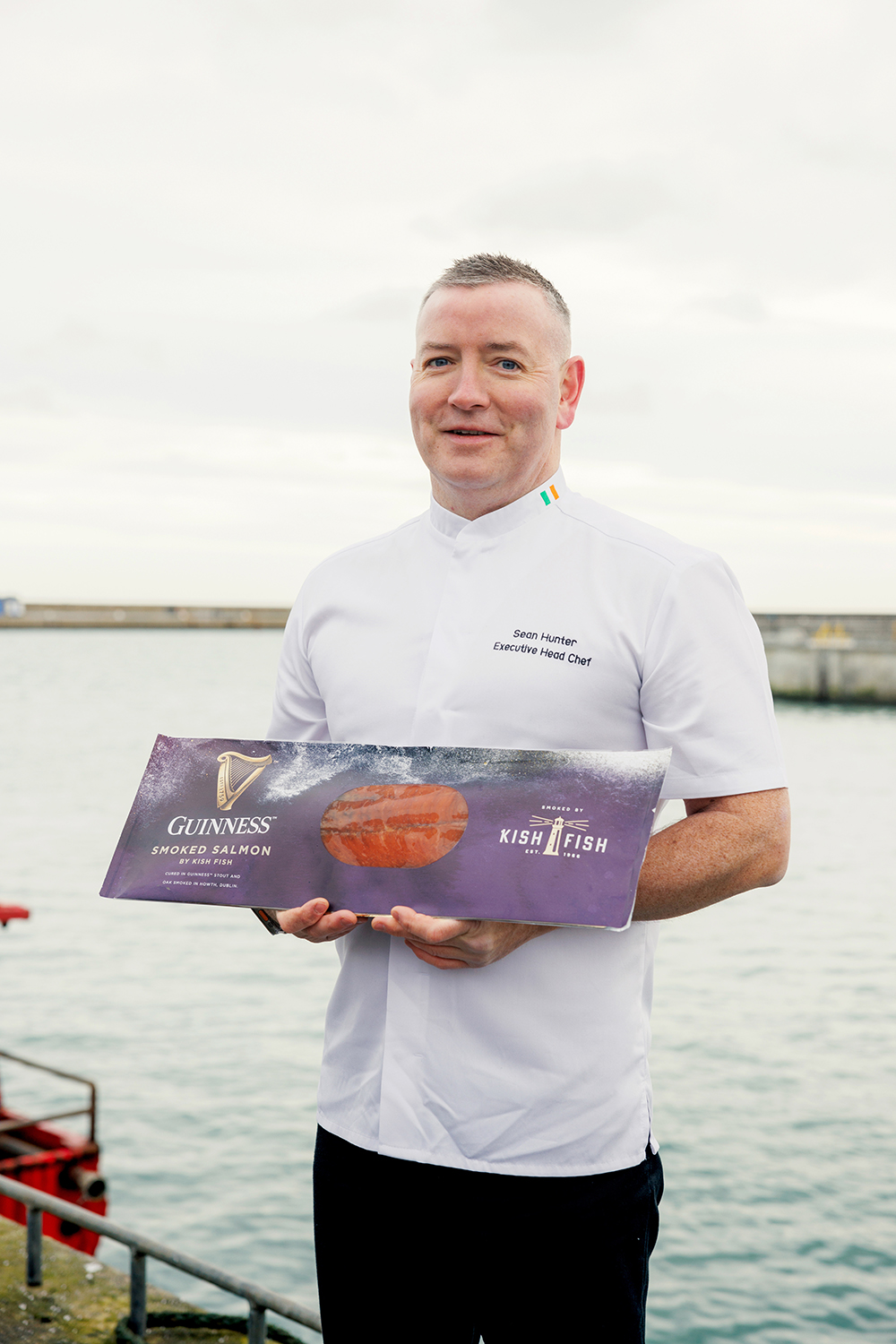 The shared values of the family-owned fish business and the massive enterprise that is Guinness – notably respect for heritage, consistent quality and sustainability - are proudly acknowledged as the raison d’etre of the new product, and the idea actually originated in The Guinness Storehouse, which is one of Kish Fish’s largest customers. Their executive chef, Sean Hunter (see right) had started curing Salmon in GUINNESS™ and smoking it himself in small quantities for tourists to enjoy as part of the visitor experience at St. James's Gate, and the recognition of the product’s potential and mass appeal led to the partnership with Kish Fish – and the really delicious product that is now included in the company's food service range and available in the Kish Fish shops.
The shared values of the family-owned fish business and the massive enterprise that is Guinness – notably respect for heritage, consistent quality and sustainability - are proudly acknowledged as the raison d’etre of the new product, and the idea actually originated in The Guinness Storehouse, which is one of Kish Fish’s largest customers. Their executive chef, Sean Hunter (see right) had started curing Salmon in GUINNESS™ and smoking it himself in small quantities for tourists to enjoy as part of the visitor experience at St. James's Gate, and the recognition of the product’s potential and mass appeal led to the partnership with Kish Fish – and the really delicious product that is now included in the company's food service range and available in the Kish Fish shops.
With smoked salmon mainly seen as a premium convenience product for use in cold dishes, it is unusual for a new rendition to be chef-led and with versatility to the fore. Yes, it is super-delicious eaten straight from the pack, but it has many other uses and everyone involved with it is keen to emphasise that “it’s not just another smoked salmon, it’s a totally new product”. Which is true. And, as they say themselves, “It’s a product that promises to be a sure-fire hit with Irish diners, international visitors and home cooks alike.” Interestingly, many people have suggested that smoked salmon and Guinness might not be natural combination – so the best way to decide on that is to try it.
*Available from Kish Fish’s four retail fish shops - Howth, Coolock, Bow Street, and Avoca Dunboyne - in individual 150g (€8.99), 400g (€17.99), and pre-sliced 1kg (€43.99) sized packs.
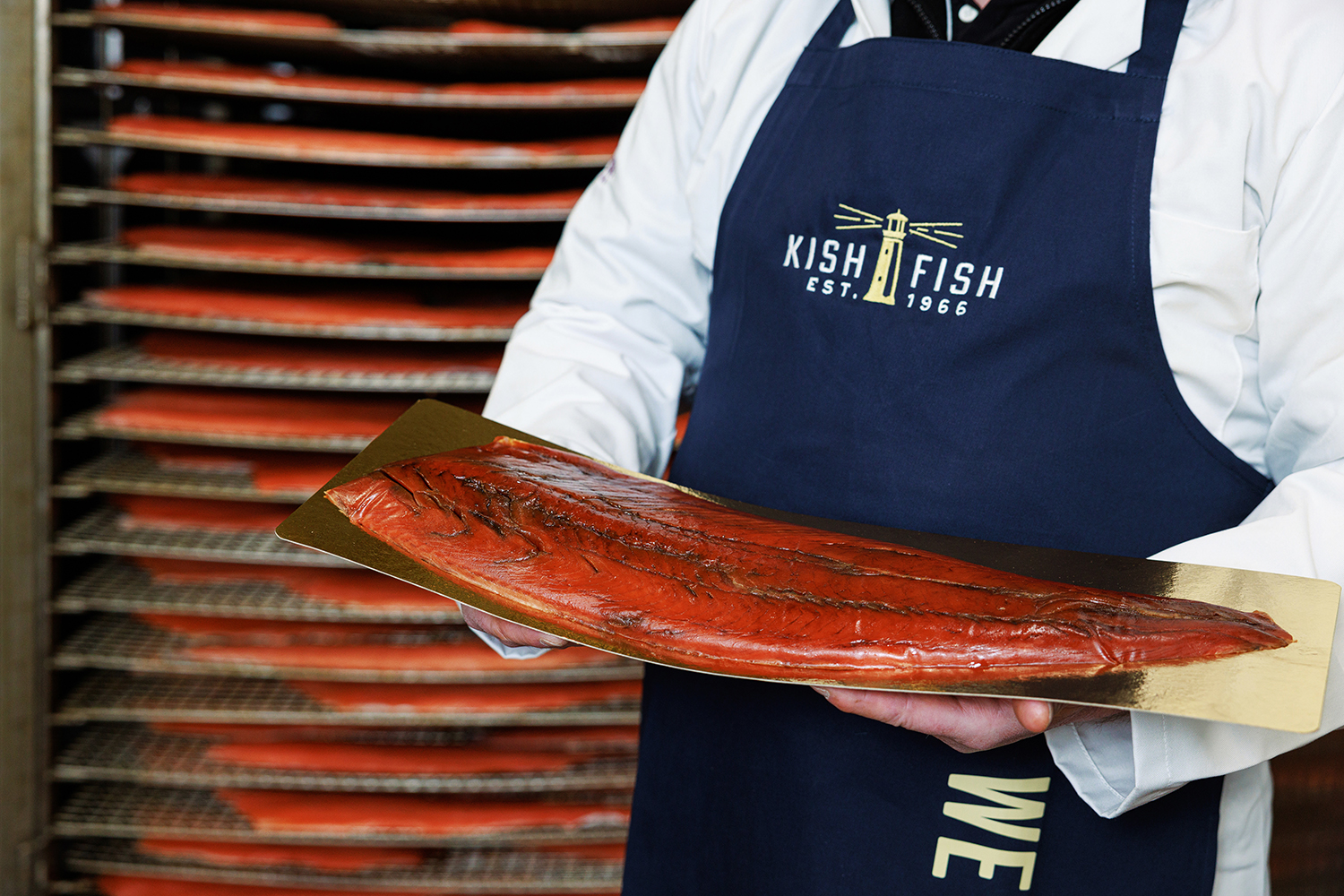
RECIPES from The Guinness Storehouse
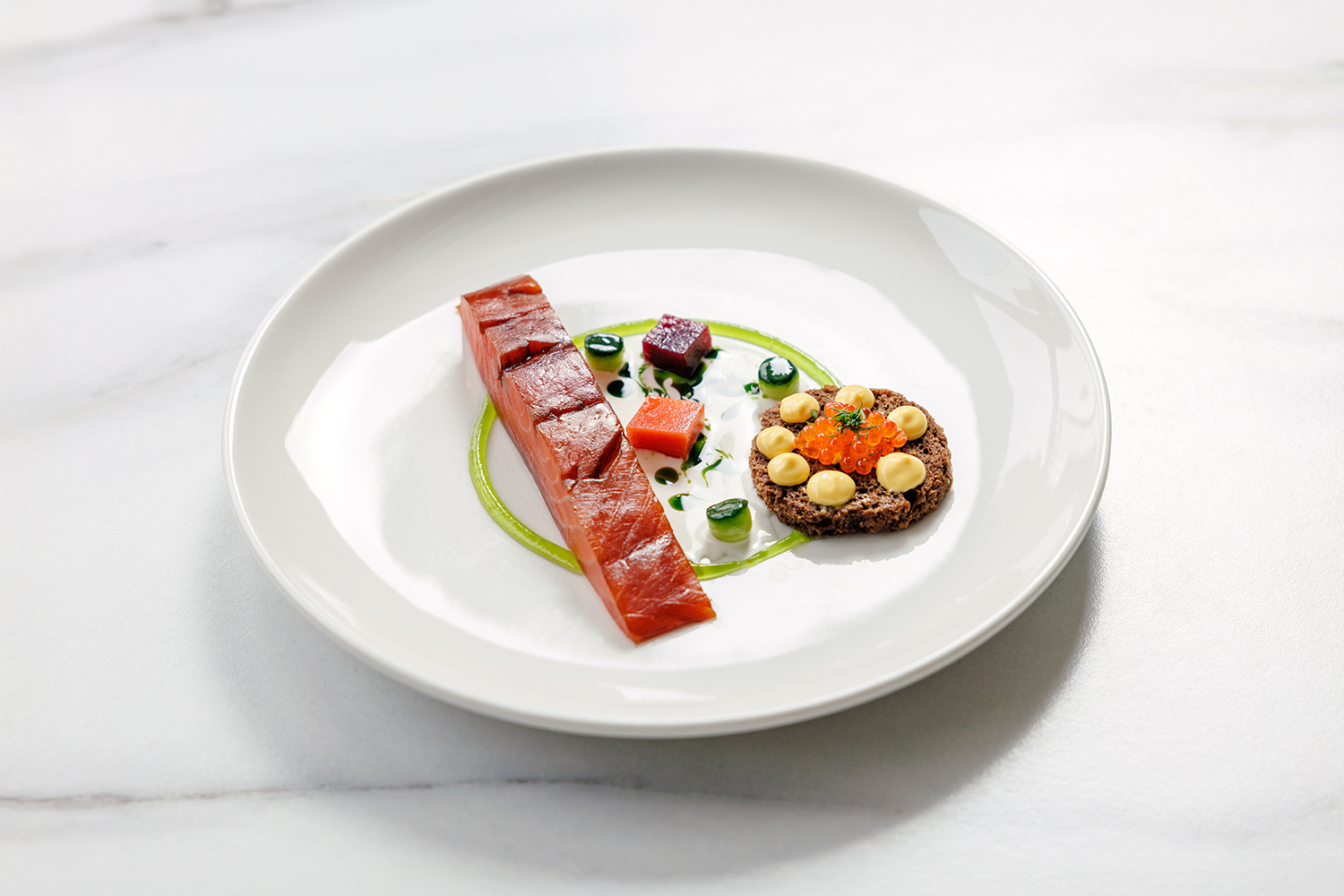 Guinness™ Smoked Salmon By Kish Fish Starter Plate
Guinness™ Smoked Salmon By Kish Fish Starter Plate
This is one of the most popular dishes served by Executive Chef Sean Hunter and his team at The Guinness Storehouse and it’s easy to see why. Bringing together several much-loved themes in traditional Irish cooking, Sean transforms them into a beautiful and thoroughly modern starter composed of Guinness™ Smoked Salmon By Kish, Guinness™ Brown Soda Bread, Saffron Aioli, refreshing Pickled Vegetables and a pretty Apple Gel. Everything is prepared from scratch at The Guinness Storehouse but home cooks might want to take one or two well-judged short cuts – a quick Saffron Aoili, for example, can be made by flavouring a quality product such as Ballymaloe Mayo with a few strands of pre-soaked saffron and a little crushed garlic. Agar agar may not be in every Irish pantry but this versatile setting agent is a handy product to have in stock and it’s available from some supermarkets and speciality food stores such as Asia Market
COMPONENTS OF THE STARTER PLATE: Guinness™ Smoked Salmon By Kish; Pickled Vegetables; Apple Gel. Garnish: Trout roe (Goatsbridge, Co Kilkenny) and fresh dill. To serve: Guinness™ Brown Soda Bread & Saffron Aioli
Pickled Vegetables: Diced carrot, beetroot, kohlrabi / apple
Pickling Liquor Ingredients
1/1 sugar / vinegar (1 part each)
Double amount of water
Thumb of ginger
Whole peppercorns (about 6)
Mustard seeds
Fennel seeds
1 x star anise
Method: Bring the liquids and aromats to the boil in a pot then, in separate containers, pour the liquor over the diced carrot, beetroot, kohlrabi and/or apple - don't mix the vegetables/fruit as they release their flavours and colour, so need to be pickled separately. Allow them to cool in the pickle and store in it until required. When ready to plate, strain the vegetables and reserve the pickling liquor to use again. It is important to draw excess liquid away before plating, so place the drained vegetables and fruit on heavy kitchen roll to absorb it.
Apple Gel
Ingredients
2.5g agar agar
200ml apple juice
Lime juice
Seasoning (salt, sugar)
Method: Blitz all ingredients together and bring to the boil. Allow to cool and set, then re-blitz.
Plating: As in the photo, place the salmon straight down 2cm from the centre of the plate (so 2cm off centre). Add 5 dots of Apple Gel asymmetrically to the right of the salmon (or create your own style - practise first on an empty plate), then dot 3 pieces of pickled vegetables around the apple gel. Sean’s team bake the Guinness bread mix in tall ring cutters lined with greaseproof paper to give a perfect circular slice of soda bread, which looks cool and is a great talking point. Then they add about 5 dots of saffron aioli around the edge and finish with the Goatsbridge trout roe and chives in the centre
 Guinness™ Smoked Salmon By Kish Fish Sambon
Guinness™ Smoked Salmon By Kish Fish Sambon
Avoiding waste is a big thing at both Kish Fish and The Guinness Storehouse, and this recipe was devised by Executive Chef Sean Hunter to make the best use of their salmon trimmings. A clever fishy variation on the familiar jambons (ham & cheese pastries), this simple finger food is easy to make and seriously tasty. It’s good to see the gorgeous Armagh cheese Ballylisk Brie used at The Guinness Storehouse and Sean suggests freezing it before grating, to firm it up – a handy hint for other cheeses too. Alternatively it can be chopped - the aim is for even distribution.
Ingredients:
30g flour
30g butter
250ml milk
60g Ballylisk Brie
100g Guinness™ Smoked Salmon by Kish Fish, chopped
Handful of parsley, chopped
1 sheet pre-made puff pastry
Egg wash (2 egg yolks/1 whole egg whisked with a little water or milk)
Method:
Place a heavy based baking tray in the oven and preheat to 200°C.
Add the flour and butter to a small pot. Warm your milk. Cook out the flour for 1 minute before whisking in the milk. Bring the sauce to the boil until it thickens.
Turn off the heat and add in the grated Brie. Allow to chill slightly.
Mix the cured salmon through the cheese sauce with the parsley. Adjust seasoning to taste with salt and pepper.
Lay out the puff pastry sheet on baking parchment, cut into 4 squares.
Place a large spoonful of the cheese and salmon mix into the centre of each square, then fold the 4 corners into the centre to create the ‘jambon’ shape.
Brush egg wash evenly over the pastry to glaze it.
Bake for 25-30 minutes until golden brown.
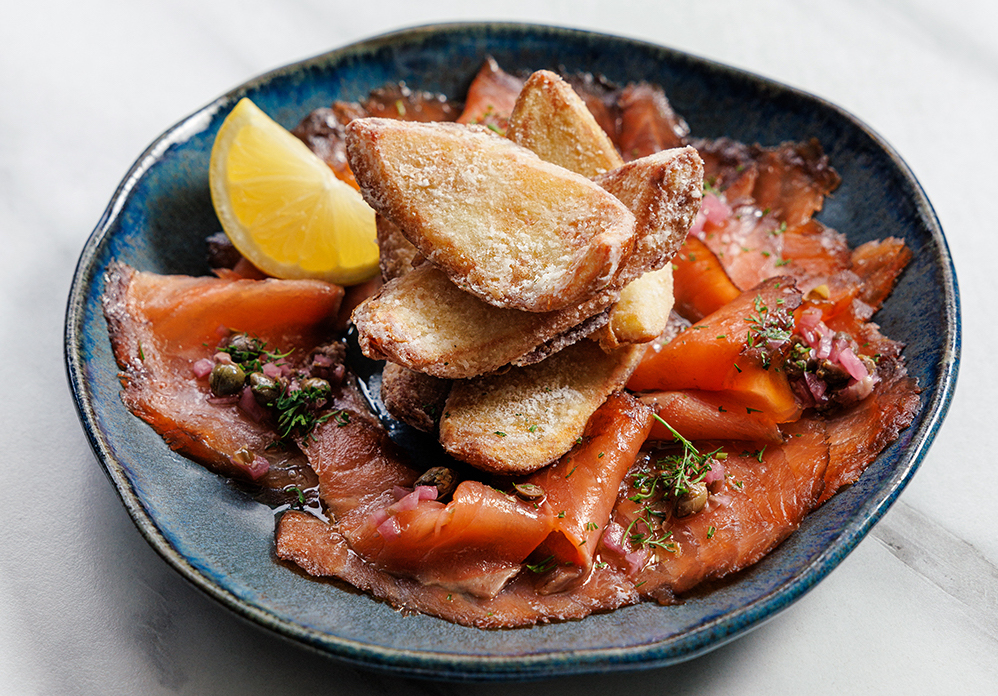 Guinness™ Smoked Salmon By Kish Fish with ‘Dead Easy’ Potato Skins and Red Onion & Caper Salsa
Guinness™ Smoked Salmon By Kish Fish with ‘Dead Easy’ Potato Skins and Red Onion & Caper Salsa
At the launch of Guinness™ Smoked Salmon By Kish Fish, a guest asked The Guinness Storehouse’s Executive Chef Sean Hunter to suggest a really easy way to use the product in something hot for cooking at home – and this more-ish dish was his response. There is no need to be too fussy about the salmon slices (leftover fish from another dish would be fine) and it’s interesting to see that Sean suggests potato starch for coating the potato wedges. This naturally gluten-free ingredient is easy to use for thickening sauces, coating fried foods, baking etc. It's a very good replacement for imported products such as cornflour, and deserves to be more widely known. Irish potato starch is produced at Meade Farm, Co Meath, and suppliers include Down To Earth on Dublin’s South Great George Street, who offer online sales: https://downtoearth.ie/products/meade-farm-potato-starch-250g
[A variation, to avoid frying, might be to brush the potato wedges with oil and crispen them in the oven. GC]
Red Onion & Caper Salsa
1 red onion finely diced
Small handful of washed capers, chopped finely
Zest and juice of 1 lime
25g chopped dill
80ml good quality olive oil
Salt and pepper
To serve: Slices of Guinness™ Smoked Salmon By Kish Fish
Lemon wedges; crème fraiche for dipping
To make the Salsa: Place all of the ingredients for the salsa into a bowl and mix them thoroughly.
‘Dead Easy’ Potato Skins
Method: Wrap potatoes in foil, cut an ‘X’ across the top to allow the steam to escape. Bake at 160°C for 35-40 minutes until soft.
Remove the potatoes from the foil, let them cool and cut into quarters.
Scoop out the centre a bit, leaving about 3cm of potato to the skin - and essentially creating thick potato wedges. Coat entirely in potato starch then fry until golden and crispy.
To serve, lay slices of Guinness™ Smoked Salmon By Kish Fish on your plate, stack up the potato skins in the middle, and then spoon the salsa around. Serve with lemon wedges and crème fraiche for dipping the potato skins.
Cookery Feature - Simply Seafood - Be Inspired by Chowder
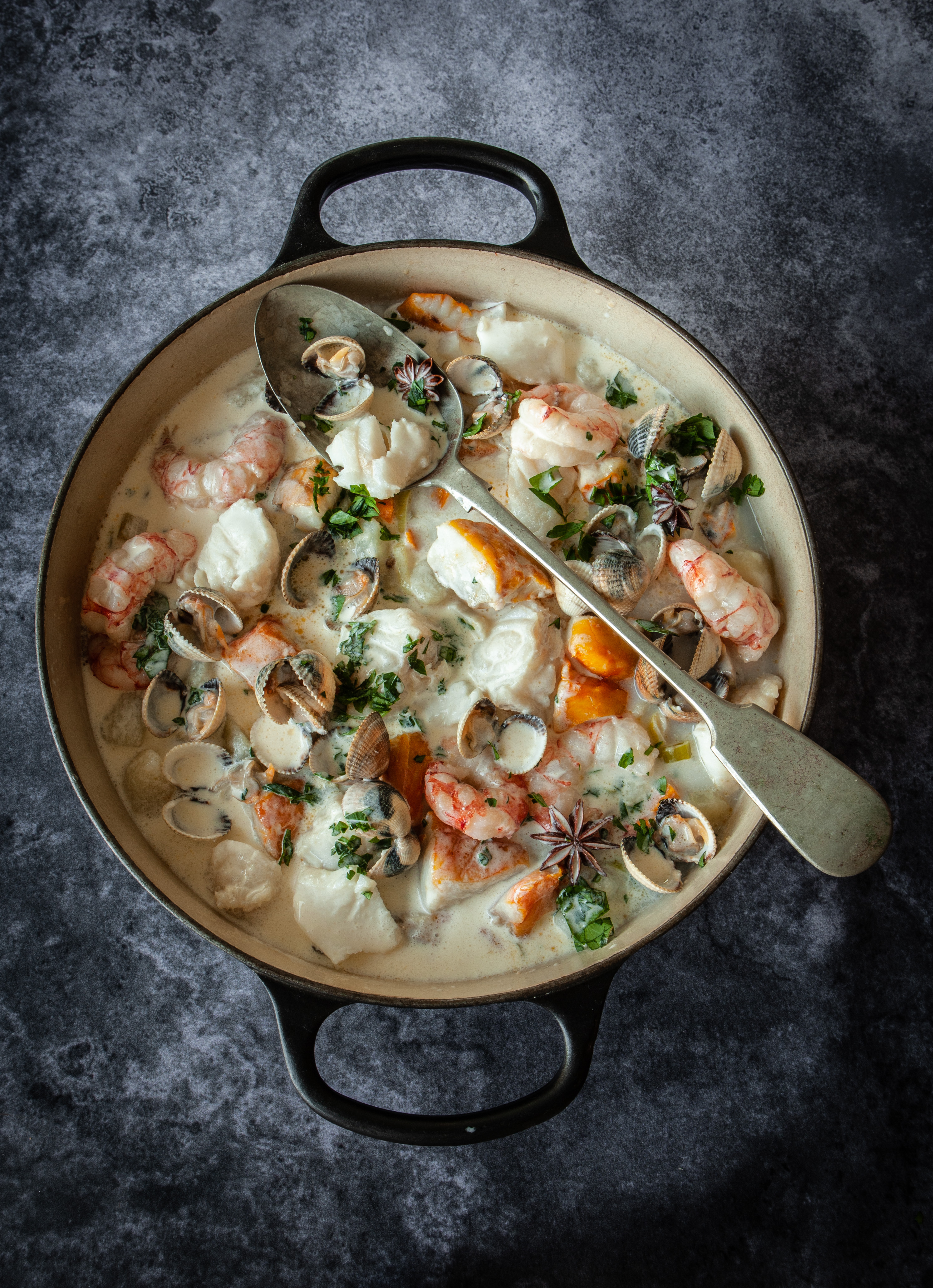
There’s much talk of food tourism these days, and of the ambitious menus presented by high-end chefs, at eye-watering prices. But, impressive as some of these culinary creations are for special occasions – and no doubt a satisfying experience for those who enjoy food tourism as a hobby, or even a way of life – excellence at a more accessible level is in many ways even more admirable. Take the humble seafood chowder, for example. A staple on so many menus and the mainstay of thousands of visitors and holidaymakers travelling around the country every year, this wholesome meal in a soup bowl served simply with soda bread and butter is so varied in that it has inspired numerous competitions over the years, both here and abroad.
Versions at some casual dining destinations are famous enough to merit a visit for this speciality alone - Coyne's Gastropub, in the Connemara Gaeltacht for example (Tigh Chadhain’s Fresh Seafood Chowder: thick and plentiful with good chunks of fresh local fish and a homemade brown scone), and Kealy’s Seafood Bar in Greencastle Co Donegal (see recipe below). Other outstanding recent chowders that will linger long in the mind include places as diverse as Wineport Lodge Glasson, Co Westmeath (Seafood Chowder €16, maybe with Pernod & tarragon, always with homemade Guinness bread), for example; Sea Church in Ballycotton, East Cork (Fred’s Mediterranean Seafood Chowder €13.50: Creamy tomato based with smoky bacon, saffron, white wine, potatoes, mix fish, prawns & mussels served with stout brown bread); and Wild Garlic in Bantry (West Cork creamy seafood chowder €9, with in-house treacle soda bread). These, and many others we encounter on our travels, are a reminder of just how memorable this delicious bowl of goodness can be – and how the highlight of a meal can be something simple. At its best, a bowl of chowder is a wholesome and lip-smackingly wonderful taste of the sea that will set you up for your day’s activities, at a modest price and almost invariably with the additional pleasure of an equally unique brown bread freshly baked in the house style.
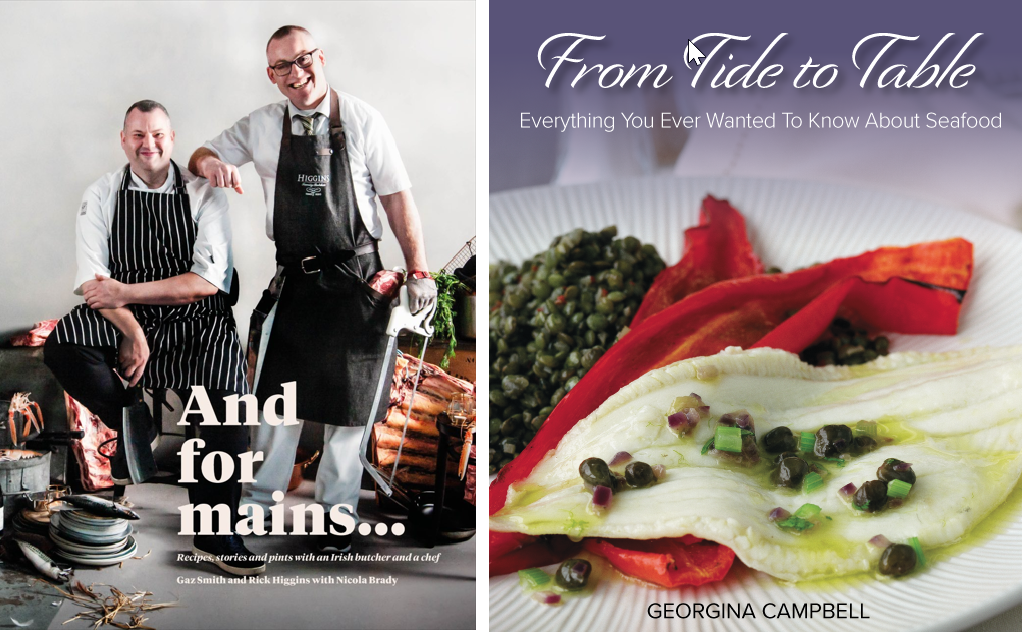 So what’s not to like…? Well, as Gaz Smith of Big Mike’s in Blackrock Co Dublin says in the cookbook ‘And for Mains…’ “If I see chowder on a menu, I almost always go for it. And almost every single time, I’m disappointed. A chowder is one of those things that should be so good, but so many people f**k it up. It’s either grey, thick and clumpy or bland and grainy. The thing is, it’s really easy to get it right.” Gaz’s version is given below, along with a quite different, much simpler, one from my very practical fish and seafood cookery book ‘From Tide To Table – Everything You Ever Wanted to Know About Seafood’ which has become a bit of a classic and is now also available in the four Kish Fish shops in Dublin and Meath.
So what’s not to like…? Well, as Gaz Smith of Big Mike’s in Blackrock Co Dublin says in the cookbook ‘And for Mains…’ “If I see chowder on a menu, I almost always go for it. And almost every single time, I’m disappointed. A chowder is one of those things that should be so good, but so many people f**k it up. It’s either grey, thick and clumpy or bland and grainy. The thing is, it’s really easy to get it right.” Gaz’s version is given below, along with a quite different, much simpler, one from my very practical fish and seafood cookery book ‘From Tide To Table – Everything You Ever Wanted to Know About Seafood’ which has become a bit of a classic and is now also available in the four Kish Fish shops in Dublin and Meath.
RECIPES TO TRY:
 Greencastle Chowder
Greencastle Chowder
This recipe is featured in ‘From Tide To Table – Everything You Ever Wanted to Know About Seafood’ (see details above) and comes from Tricia Kealy who, with her husband the late James Kealy, opened the famous Kealy’s Seafood Bar in the rugged fishing port of Greencastle, Co Donegal in 1989. A small place with a big heart, this surprising little pub-cum-restaurant is on the harbour front - and near the Lough Foyle Ferry, connecting County Donegal and Magilligan Point in County Derry. This is the most popular dish on their menu and Tricia wouldn’t like to think how many gallons of chowder they have made over the years! A simple and delicious recipe, it’s a fitting tribute to James - and his ‘wee scones’ (see below) are the perfect accompaniment.
Serves 4-6
1.2 litres/2 pints fish stock
100g/4oz skinless salmon fillet, cubed
100g/4oz skinless haddock fillet, cubed
50g/2oz butter
1 onion, chopped
2 carrots, chopped
1 leek, chopped
3 celery sticks, chopped
1 tsp chopped fresh dill
1 tsp crushed pink peppercorns
50g/2oz plain flour
a little milk (optional)
salt and freshly ground black pepper
pouring cream and chopped fresh parsley, to garnish
freshly baked baby brown scones, to serve (see below)
Bring the fish stock to a gentle simmer in a large pan and add the salmon and haddock. Cook for a couple of minutes until tender, then transfer to a plate with a slotted spoon. Set aside until needed.
Melt the butter in a separate large pan over a medium heat. Sweat the onion, carrots, leek and celery for about 10 minuets or until they are softened but not coloured. Add the dill and pink peppercorns and cook for a further 5 minutes.
Stir the flour into the vegetable mixture and cook for 5 minutes, stirring constantly. Gradually pour in the fish stock, stirring until smooth after each addition, then bring to the boil and simmer for 15 minutes until all of the vegetables are completely tender and the liquid is slightly reduced. Season to taste.
Just before serving a little milk can be added to thin out to desired consistency. Add the cooked salmon and haddock to the chowder and allow to warm through. Ladle into warmed bowls and garnish with a little cream and some parsley. Arrange on plates with some brown baby scones to serve.
James's Wee Scones
Although seafood takes centre stage at Kealys Seafood Bar, the baking is special too. James's Wee Scones are unusually light and often enhanced by a scattering of cheese on top - hard to resist, especially with their lovely chowder. As these scones are virtually fat-free, they must be eaten very fresh - warm from the oven if possible, but definitely on the day of baking.
1 lb/450g plain flour
1 lb/450g wheaten flour
1 tsp bread soda
1 tsp salt
24 fl oz/725 ml buttermilk or soured cream & milk
Preheat a hot oven, 200'C/425'F/gas mark 6. Sift plain flour, soda and salt into a bowl, add wheaten flour and mix well. Make a well in the centre, pour in almost all liquid and mix well with a wooden spoon, adding remaining liquid as needed to make a soft, moist dough. (Do not overmix). Dust worktop with flour, turn out dough, dust top with flour and press out evenly to thickness of 1½"/3.8 cm. Cut individual scones with a 2"/5 cm fluted cutter, place on oiled and floured baking tray and brush tops with eggwash (2 egg yolks mixed with 2 tbsp water) and/or scatter with grated cheese. Bake for about 12 minutes until well-risen and golden-brown.
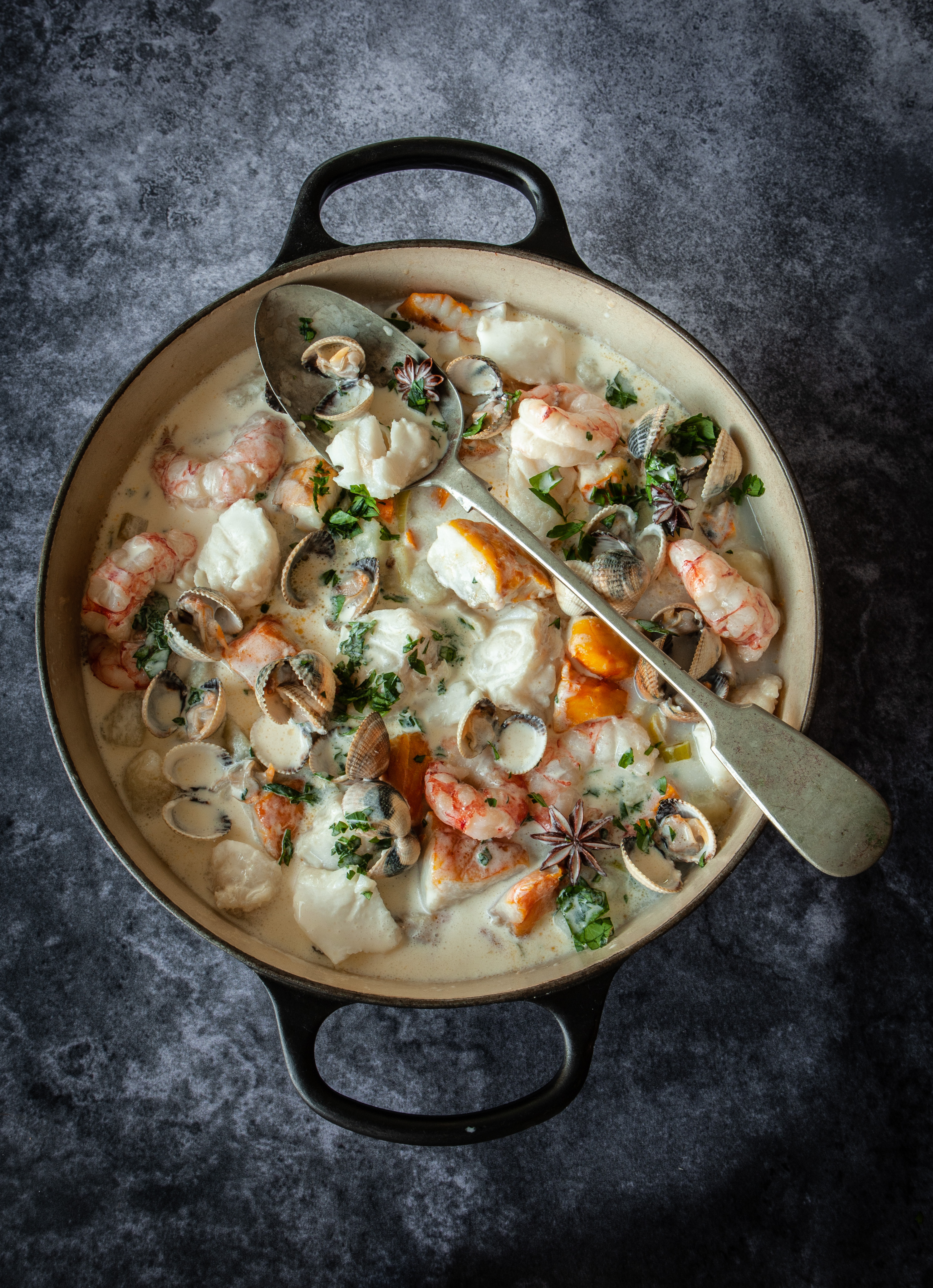 Gaz Smith’s Seafood Chowder
Gaz Smith’s Seafood Chowder
This recipe from Gareth (Gaz) Smith, chef and owner of Dublin restaurant Big Mike's, is from the cookbook And For Mains…, by Gaz and his friend and business partner, fourth-generation butcher Rick Higgins of Higgins Family Butchers in Sutton, Co Dublin. Gaz explains: “Our chowder is based on a good fish stock – the only thickener comes from the starch in the potatoes. A really good fish stock is amazing, but don’t worry if you only have a premade one. I’d rather you make this with a stock cube than not at all. Either way, the key is to chuck the fish in for only the last few minutes. That’s how long it takes to cook – if you leave it all sitting in the pot for hours, you’ve ruined the fish. Our little curveball comes from coriander seeds and star anise, which works so well. It gives a little bit of a different note and makes the whole dish a smidge more fragrant.”
And For Mains is available from bookshops, Higgins Family Butcher, Sutton and online from the publishers Nine Bean Rows price €30.
Chef’s tip: You can use whatever fish you like, but make sure you use the naturally smoked fish, not that stinky, slimy, orange-dyed gack.
Serves 4
Olive oil
1 medium onion, finely diced
100g peeled finely diced carrots
100g finely diced celery
200g potatoes, peeled and cut into 1.5cm cubes
4 garlic cloves, sliced
4 star anise
1 tablespoon coriander seeds
1.2 litres good-quality fish stock (or from a cube is fine)
2 big pinches of fine sea salt
100g leeks, finely diced
150g naturally smoked fish, cubed
100g each of cockles, mussels, fresh prawns
80g meaty white fish, diced
200ml pouring cream
Zest and juice of 1 lemon, plus extra juice to finish if you like
A good pinch each of finely chopped: fresh flat-leaf parsley,
fresh dill, fresh coriander
To serve: Crusty bread
• Get a nice big pot and heat a good glug of oil in it over a low heat. Add your onion, carrots, celery, spuds, garlic, star anise and coriander seeds and sauté for 5 minutes, stirring often.
• Add your fish stock along with two big pinches of salt and bring to a simmer. Cook for 15 minutes, until the veg are slightly softened and the stock is starting to thicken (you can thank the starch in the potatoes for that). Add your leeks and let the whole lot simmer gently for 15 minutes more.
• Raise the temperature to a high heat. Once your base is bubbling, throw in all your seafood and cook for 3 minutes. Turn down the heat to medium, then pour in the cream and cook for a further 2 minutes.
• Take your chowder off the heat, add the lemon zest and juice along with all the chopped herbs and stir to combine. You can also finish off each portion with an extra squeeze of lemon if you like.
• Serve hot with crusty bread.
Cookery Feature - Special Summer Flavours



RECIPES and adaptations, from ‘At home in Renvyle’ to try:

This is the original recipe, which was presented as a ‘tower’, but the image is of the simpler 2025 version enjoyed on our visit this summer – and you will find a similar version on the current dinner menu, which leads off with a starter of Connemara Crabmeat, Fennel Salad Leaves, Mango Mayonnaise and Crispy Breadcrumbs. The original recipe introduction notes that: “Contrasting tastes here are fresh and appetising for a lunch main course as well as starter. For more simple presentation, substitute won ton sheets with thinly sliced toasted bread or Melba toast. The mango salsa is good with curries and pork dishes.” [For more summer seafood recipes, see From Tide To Table / Everything You Ever Wanted to Know About Fish & Seafood. Available online, from bookshops, or from Kish Fish shops.]
Ingredients
400g crabmeat
1 sweet apple, diced
1 spring onion, finely chopped
1 lemon zest & juice
1 lime zest & juice
Mix all together and store in the fridge for 4 hours
4 wonton pastry sheets: Deep fry in oil until crispy
Mango Salsa
1 mango, diced
1 spring onion, diced
Half small red onion, finely
chopped
Half chilli, finely chopped
tablespoon white wine vinegar
tablespoons water 1 tablespoon sugar
In a pot, simmer vinegar, water, sugar and chilli for 4 minutes. Chill and add the mango and spring onion.
Garnish: Mixed salad leaves; flat leaf parsley
To assemble: Place a mound of crabmeat on the centre of the plate and place wonton on top. Pour salsa around the crab. Place salad leaves around the edge of the plate. Drizzle salad leaves with olive oil.
 Connemara Lamb with Herb and Mustard Crust Herb and Apricot Stuffing, Ratatouille and Rosemary Gravy
Connemara Lamb with Herb and Mustard Crust Herb and Apricot Stuffing, Ratatouille and Rosemary Gravy
Irish mountain lamb is another treat to savour at this time of year. Later than lowland lamb, which is available from about Easter, it’s a smaller, leaner product, with more muscle and the distinctive flavour of the heathers and mountain herbs it has been reared on. Produced naturally in the wild and likely to be organic by definition, it comes from the hills and mountains of rugged areas like Connemara, Kerry, Mayo and the Comeragh Mountains in West Waterford, and is one of Ireland's most interesting speciality foods. Coming into season now and available throughout the autumn, Connemara Hill Lamb was awarded European PGI status in 2007 and, as noted in Tim's recipes introduction, “it is known worldwide for its sweetness, tenderness and a hint of wild herbs…and the recipe is not difficult, but the lamb needs to be watched so it is not over-done. Tim’s stuffing is delicious and moist and the Ratatouille is a good seasonal accompaniment, or traditional vegetables - roast potatoes, peas, carrots - work well too. Garnishes suggested in the book (deep fried parsnip, pesto) are optional.
2 racks lamb, trimmed
Salt & pepper to taste
Rosemary
2 teaspoons Dijon mustard
1 teaspoon mixed fresh herbs - parsley, thyme, mint
1 dessertspoon breadcrumbs
Herb & Apricot Stuffing: 75-100g butter, 2 diced shallots, 75g mixed fresh herbs - parsley, thyme, mint - 50g chopped dried apricots, l00g fresh white breadcrumbs
Pre-heat the oven to 200°C/400°F/Gas 6.
Make the stuffing: Melt the butter in a pot, add the herbs, chopped apricots and shallots. Cook for about 3 minutes, add the breadcrumbs and keep warm.
To cook the lamb: Heat a large griddle pan and season the lamb with salt and pepper. Seal the lamb on both sides, add a little rosemary and place in a roasting tin in the preheated oven for 18 minutes or until cooked as you like it.
To finish the lamb: Coat the outside surface with a mixture of mustard, the remaining crumb; and the herbs. Finish under a hot grill for 2 minutes to crisp and brown.
Ratatouille:
Half an aubergine
1 red pepper, de-seeded
1 courgette
6 mushrooms
1 clove garlic
1 tablespoon olive oil
2 tomatoes, skinned, de-seeded and chopped
To cook: Dice all ingredients finely and cook in oil for 5 minutes. Keep warm.
Rosemary gravy
1 glass red wine
Small sprig of rosemary
1 teaspoon redcurrant jelly
25g butter
Heat a saucepan, add the red wine and chopped rosemary. Reduce by one third, then add the redcurrant jelly and add in the butter a little at a time.
To serve: Cut the racks of lamb in half. Place the ratatouille on the centre of the plate and set the lamb on top, garnished with the deep fried parsnips and flat leaf parsley.
Pour the gravy onto the base with the pesto. Place the stuffing beside the ratatouille. Serve immediately with extra seasonal vegetables.
 Courgettes with Almonds
Courgettes with Almonds
This recipe in ‘At home in Renvyle’ caught my eye - reminding me of another very enjoyable recent visit, to Peter Ward’s renowned Country Choice in Nenagh, Co Tipperary, which happened to coincide with the retirement of ‘King of the Butchers’ Denis Quirke. Peter – who was to speak at the retirement party next door at The Pepper Mill - was people watching from a pavement table outside his shop. Spotting us heading in to buy some cheese, he went ‘to put the kettle on’ and (so much for just a cuppa…) emerged a few minutes later with a magnificent cheese & charcuterie board from the deli, plus some interesting accompaniments – which included a speciality that they make with marrows. “Nobody will buy marrows these days, you have to disguise them in something tasty like this, where they look like courgettes…” `So, I will get that recipe from Peter at some stage, but for the moment this – from ‘At home in Renvyle’ - is their way “to make the best of courgettes when in season. The fried courgettes make a good contrast in texture and taste to the cream and browned almonds. This is a perfect accompaniment to roast lamb or duck and makes an interesting change with turkey. Vegetarians will enjoy this as a substantial main course, served with salad.”
500g courgettes
40g plain flour
4 dessertspoons olive oil
20g butter
120ml cream
40g sliced almonds
2 tablespoons chopped chives
Salt and pepper
10ml lemon juice
600g parsnips
70g butter
2 large onions, sliced
2 medium eggs
100ml cream
5 slices brown bread
2 tablespoons honey
50g sesame seeds
Salt and pepper
Trim the ends of the courgettes and cut into 2cm strips. Dip in flour. Heat the oil and butter in a pan and add the courgettes in small amounts at a time. Cook until golden brown. Drain on kitchen paper. Keep warm. Add the almonds to the pan, cook until brown, stir in the cream and lemon juice. Season to taste and heat gently. Place the courgettes in a serving dish. Garnish with cream, almonds and chopped chives on top.
Preheat oven to 200°C/400F/Gas 6.
Wash and peel the parsnips, cut into thin slices. Boil in salted water for
15 minutes and drain.
Melt butter in a pot, add onion and fry until lightly browned.
Blend the onions, parsnips, eggs, cream and honey in a food processor
and season.
Butter an ovenproof dish, cover the base with the sliced bread and spoon in
the parsnip mix. Sprinkle with sesame seeds. Bake in oven for 25-30 minutes until golden brown.
 Rhubarb and Ginger Crumble with Pistachio Ice-Cream
Rhubarb and Ginger Crumble with Pistachio Ice-Cream
Endlessly versatile in all manner of sweet and savoury dishes, rhubarb is probably Ireland’s most prolific kitchen garden produce and deserves a place on every summer menu. In ‘At home in Renvyle’ “…it has wonderful summer flavours and a few levels of crunch with the toasted nuts and topping contrasting with a delicious creamy rhubarb filling.”
Pistachio Ice-cream (Best made 24 hours in advance)
50g pistachio nuts, skinned
3 tablespoons pulverised pistachios (or pistachio paste)
600ml crème anglaise (vanilla custard, see below)
1 tablespoon icing sugar
First make the vanilla custard: Blend 6 egg yolks with120g caster sugar; mix with 500ml hot milk (preferably heated with seeds scraped from a vanilla pod, alternatively flavour with a little vanilla extract); heat very gently, stirring, until it thickens. Strain if wished. Cool & chill.
Toast the pistachio nuts until brown; when cool, add to the crème anglaise (Or mix in the pistachio paste, if using). Freeze in a plastic tub.
Rhubarb Filling:
200g rhubarb
l00g granulated sugar
25g butter
3 tablespoons maple syrup, or similar (eg Highbank Orchard Syrup https://highbankorchards.com/shop/highbank-orchard-syrup )
Cut rhubarb into cubes and cook gently in a saucepan with the sugar, butter and maple syrup for 10 minutes. Divide between 4 ramekin dishes.
Crumble Topping:
50g plain flour
25g each butter and brown sugar
25g pistachio nuts, toasted and chopped
Pinch ground ginger.
Pre heat oven to 200°C/400°F/ Gas 6.
Mix the flour, butter, sugar and pistachios and ginger in a food processor. Pour on top of the rhubarb and bake in a hot oven for 20 minutes.
Serve warm with the ice-cream.
Show me all Article


